| schema location: | ..\schema\railML.xsd |
| attributeFormDefault: | |
| elementFormDefault: | qualified |
| targetNamespace: | https://www.railml.org/schemas/2021 |
| Elements |
| railml |
| schema location: | ..\schema\infrastructure.xsd |
| attributeFormDefault: | |
| elementFormDefault: | qualified |
| targetNamespace: | https://www.railml.org/schemas/2021 |
| schema location: | ..\schema\rollingstock.xsd |
| attributeFormDefault: | |
| elementFormDefault: | qualified |
| targetNamespace: | https://www.railml.org/schemas/2021 |
| schema location: | ..\schema\timetable.xsd |
| attributeFormDefault: | |
| elementFormDefault: | qualified |
| targetNamespace: | https://www.railml.org/schemas/2021 |
| schema location: | ..\schema\infrastructureTypes.xsd |
| attributeFormDefault: | |
| elementFormDefault: | qualified |
| targetNamespace: | https://www.railml.org/schemas/2021 |
| schema location: | ..\..\ProgramData\Altova\Common2022\Schemas\schema\files\W3C_2001\xml.xsd |
| attributeFormDefault: | |
| elementFormDefault: | |
| targetNamespace: | http://www.w3.org/XML/1998/namespace |
| Attributes | Attr. groups |
| base | specialAttrs |
| id | |
| lang | |
| space |
| schema location: | ..\schema\rollingstockTypes.xsd |
| attributeFormDefault: | |
| elementFormDefault: | qualified |
| targetNamespace: | https://www.railml.org/schemas/2021 |
| schema location: | ..\schema\timetableTypes.xsd |
| attributeFormDefault: | |
| elementFormDefault: | qualified |
| targetNamespace: | https://www.railml.org/schemas/2021 |
| schema location: | ..\schema\railwayUnits.xsd |
| attributeFormDefault: | |
| elementFormDefault: | qualified |
| targetNamespace: | https://www.railml.org/schemas/2021 |
| schema location: | ..\schema\railwayBaseTypes.xsd |
| attributeFormDefault: | |
| elementFormDefault: | qualified |
| targetNamespace: | https://www.railml.org/schemas/2021 |
| schema location: | ..\schema\physicalUnits.xsd |
| attributeFormDefault: | |
| elementFormDefault: | qualified |
| targetNamespace: | https://www.railml.org/schemas/2021 |
| schema location: | ..\schema\genericRailML.xsd |
| attributeFormDefault: | |
| elementFormDefault: | qualified |
| targetNamespace: | https://www.railml.org/schemas/2021 |
| schema location: | https://dublincore.org/schemas/xmls/qdc/2008/02/11/dc.xsd |
| attributeFormDefault: | unqualified |
| elementFormDefault: | qualified |
| targetNamespace: | http://purl.org/dc/elements/1.1/ |
| Elements | Groups | Complex types |
| any | elementsGroup | elementContainer |
| contributor | SimpleLiteral | |
| coverage | ||
| creator | ||
| date | ||
| description | ||
| format | ||
| identifier | ||
| language | ||
| publisher | ||
| relation | ||
| rights | ||
| source | ||
| subject | ||
| title | ||
| type |
element railml
| diagram |  | ||||||||||||||||||||||||||||||||||||||||||||||||||||||||||||||||||||||||||||||||||||||||||||||||||||||||||||||||||||||||||||||||||||||||||||||||||||||||||||||||||||||||||||||||||||||||||||||||||||||||||||||||||||||||||||||||||||||||||||||||||||||||||||||||||||||||||||||||||||||||||||||||||||||||||||||||||||||||||||||||||||||||||||||||||||||||||||||||||||||||||||||||||||||||||||||||||||||||||||||||||||||||||||||||||||||||||||||||||||||||||||||||||||||||||||||||||||||||||||||||||||||||||||||||||||||||||||||||||||||||||||||||||||||||||||||||||||||||||||||||||||||||||||||||||||||||||||||||||
| namespace | https://www.railml.org/schemas/2021 | ||||||||||||||||||||||||||||||||||||||||||||||||||||||||||||||||||||||||||||||||||||||||||||||||||||||||||||||||||||||||||||||||||||||||||||||||||||||||||||||||||||||||||||||||||||||||||||||||||||||||||||||||||||||||||||||||||||||||||||||||||||||||||||||||||||||||||||||||||||||||||||||||||||||||||||||||||||||||||||||||||||||||||||||||||||||||||||||||||||||||||||||||||||||||||||||||||||||||||||||||||||||||||||||||||||||||||||||||||||||||||||||||||||||||||||||||||||||||||||||||||||||||||||||||||||||||||||||||||||||||||||||||||||||||||||||||||||||||||||||||||||||||||||||||||||||||||||||||||
| properties |
| ||||||||||||||||||||||||||||||||||||||||||||||||||||||||||||||||||||||||||||||||||||||||||||||||||||||||||||||||||||||||||||||||||||||||||||||||||||||||||||||||||||||||||||||||||||||||||||||||||||||||||||||||||||||||||||||||||||||||||||||||||||||||||||||||||||||||||||||||||||||||||||||||||||||||||||||||||||||||||||||||||||||||||||||||||||||||||||||||||||||||||||||||||||||||||||||||||||||||||||||||||||||||||||||||||||||||||||||||||||||||||||||||||||||||||||||||||||||||||||||||||||||||||||||||||||||||||||||||||||||||||||||||||||||||||||||||||||||||||||||||||||||||||||||||||||||||||||||||||
| children | rail:metadata rail:infrastructure rail:infrastructureVisualizations rail:rollingstock rail:timetable | ||||||||||||||||||||||||||||||||||||||||||||||||||||||||||||||||||||||||||||||||||||||||||||||||||||||||||||||||||||||||||||||||||||||||||||||||||||||||||||||||||||||||||||||||||||||||||||||||||||||||||||||||||||||||||||||||||||||||||||||||||||||||||||||||||||||||||||||||||||||||||||||||||||||||||||||||||||||||||||||||||||||||||||||||||||||||||||||||||||||||||||||||||||||||||||||||||||||||||||||||||||||||||||||||||||||||||||||||||||||||||||||||||||||||||||||||||||||||||||||||||||||||||||||||||||||||||||||||||||||||||||||||||||||||||||||||||||||||||||||||||||||||||||||||||||||||||||||||||
| attributes |
| ||||||||||||||||||||||||||||||||||||||||||||||||||||||||||||||||||||||||||||||||||||||||||||||||||||||||||||||||||||||||||||||||||||||||||||||||||||||||||||||||||||||||||||||||||||||||||||||||||||||||||||||||||||||||||||||||||||||||||||||||||||||||||||||||||||||||||||||||||||||||||||||||||||||||||||||||||||||||||||||||||||||||||||||||||||||||||||||||||||||||||||||||||||||||||||||||||||||||||||||||||||||||||||||||||||||||||||||||||||||||||||||||||||||||||||||||||||||||||||||||||||||||||||||||||||||||||||||||||||||||||||||||||||||||||||||||||||||||||||||||||||||||||||||||||||||||||||||||||
| identity constraints |
| ||||||||||||||||||||||||||||||||||||||||||||||||||||||||||||||||||||||||||||||||||||||||||||||||||||||||||||||||||||||||||||||||||||||||||||||||||||||||||||||||||||||||||||||||||||||||||||||||||||||||||||||||||||||||||||||||||||||||||||||||||||||||||||||||||||||||||||||||||||||||||||||||||||||||||||||||||||||||||||||||||||||||||||||||||||||||||||||||||||||||||||||||||||||||||||||||||||||||||||||||||||||||||||||||||||||||||||||||||||||||||||||||||||||||||||||||||||||||||||||||||||||||||||||||||||||||||||||||||||||||||||||||||||||||||||||||||||||||||||||||||||||||||||||||||||||||||||||||||
| source | <xs:element name="railml"> <xs:complexType> <xs:annotation> <xs:documentation>See https://wiki2.railml.org/wiki/CO:railml</xs:documentation> </xs:annotation> <xs:sequence> <xs:element name="metadata" type="rail:tMetadata" minOccurs="0"> <xs:annotation> <xs:documentation>See https://wiki2.railml.org/wiki/CO:metadata</xs:documentation> </xs:annotation> </xs:element> <xs:element ref="rail:infrastructure" minOccurs="0"> <xs:annotation> <xs:documentation>"subschema Infrastructure (IS)" can be outsourced in extra file and imported with xi:include mechanism</xs:documentation> </xs:annotation> </xs:element> <xs:element ref="rail:infrastructureVisualizations" minOccurs="0"> <xs:annotation> <xs:documentation>use this branch to model explicit visualizations of infrastructure data</xs:documentation> </xs:annotation> </xs:element> <xs:element ref="rail:rollingstock" minOccurs="0"> <xs:annotation> <xs:documentation>"subschema Rollingstock (RS)" can be outsourced in extra file and imported with xi:include mechanism</xs:documentation> </xs:annotation> </xs:element> <xs:element ref="rail:timetable" minOccurs="0"> <xs:annotation> <xs:documentation>"subschema Timetable (TT)" can be outsourced in extra file and imported with xi:include mechanism</xs:documentation> </xs:annotation> </xs:element> </xs:sequence> <xs:attribute name="version" type="rail:tRailMLVersion"> <xs:annotation> <xs:documentation>supported railML version should be declared for software compatibility reasons, valid for all subschemas, don't mix railML versions between subschemas in one XML file</xs:documentation> </xs:annotation> </xs:attribute> </xs:complexType> <!-- infrastructureManager identity in metadata --> <xs:key name="infrastructureManagerKey"> <xs:selector xpath="./rail:metadata/rail:organizationalUnits/rail:infrastructureManager"/> <xs:field xpath="@id"/> </xs:key> <!-- infrastructureManager reference in infrastructure subschema --> <xs:keyref name="infrastructureManager-ownerKeyref" refer="rail:infrastructureManagerKey"> <xs:selector xpath=".//rail:infraAttributes/rail:owner"/> <xs:field xpath="@infrastructureManagerRef"/> </xs:keyref> <xs:keyref name="infrastructureManager-ownerChangeKeyref" refer="rail:infrastructureManagerKey"> <xs:selector xpath=".//rail:ownerChange"/> <xs:field xpath="@infrastructureManagerRef"/> </xs:keyref> <xs:keyref name="infrastructureManager-lineKeyref" refer="rail:infrastructureManagerKey"> <xs:selector xpath=".//rail:line"/> <xs:field xpath="@infrastructureManagerRef"/> </xs:keyref> <!-- vehicleManufacturer identity in metadata --> <xs:key name="vehicleManufacturerKey"> <xs:selector xpath="./rail:metadata/rail:organizationalUnits/rail:vehicleManufacturer"/> <xs:field xpath="@id"/> </xs:key> <!-- vehicleManufacturer reference in rollingstock subschema --> <xs:keyref name="vehicleManufacturer-manufacturerKeyref" refer="rail:vehicleManufacturerKey"> <xs:selector xpath=".//rail:classification/rail:manufacturer"/> <xs:field xpath="@vehicleManufacturerRef"/> </xs:keyref> <!-- vehicleOwner identity in metadata --> <xs:key name="vehicleOwnerKey"> <xs:selector xpath="./rail:metadata/rail:organizationalUnits/rail:vehicleOwner"/> <xs:field xpath="@id"/> </xs:key> <!-- vehicleOwner reference in rollingstock subschema --> <xs:keyref name="vehicleOwner-ownerKeyref" refer="rail:vehicleOwnerKey"> <xs:selector xpath=".//rail:classification/rail:owner"/> <xs:field xpath="@vehicleOwnerRef"/> </xs:keyref> <!-- vehicleOperator identity in metadata --> <xs:key name="vehicleOperatorKey"> <xs:selector xpath="./rail:metadata/rail:organizationalUnits/rail:vehicleOperator"/> <xs:field xpath="@id"/> </xs:key> <!-- vehicleOperator reference in rollingstock subschema --> <xs:keyref name="vehicleOperator-operatorKeyref" refer="rail:vehicleOperatorKey"> <xs:selector xpath=".//rail:classification/rail:operator"/> <xs:field xpath="@vehicleOperatorRef"/> </xs:keyref> <!-- vehicleOperator reference in timetable subschema --> <xs:keyref name="vehicleOperator-vehicleOperatorKeyref" refer="rail:vehicleOperatorKey"> <xs:selector xpath=".//rail:organizationalUnitBinding/rail:vehicleOperator"/> <xs:field xpath="@ref"/> </xs:keyref> <!-- customer identity in metadata --> <xs:key name="customerKey"> <xs:selector xpath="./rail:metadata/rail:organizationalUnits/rail:customer"/> <xs:field xpath="@id"/> </xs:key> <!-- customer reference in timetable subschema --> <xs:keyref name="customer-customerKeyref" refer="rail:customerKey"> <xs:selector xpath=".//rail:organizationalUnitBinding/rail:customer"/> <xs:field xpath="@ref"/> </xs:keyref> <!-- railwayUndertaking identity in metadata --> <xs:key name="railwayUndertakingKey"> <xs:selector xpath="./rail:metadata/rail:organizationalUnits/rail:railwayUndertaking"/> <xs:field xpath="@id"/> </xs:key> <!-- railwayUndertaking reference in timetable subschema --> <xs:keyref name="railwayUndertaking-railwayUndertakingKeyref" refer="rail:railwayUndertakingKey"> <xs:selector xpath=".//rail:organizationalUnitBinding/rail:railwayUndertaking"/> <xs:field xpath="@ref"/> </xs:keyref> <!-- operationalUndertaking identity in metadata --> <xs:key name="operationalUndertakingKey"> <xs:selector xpath="./rail:metadata/rail:organizationalUnits/rail:operationalUndertaking"/> <xs:field xpath="@id"/> </xs:key> <!-- operationalUndertaking reference in timetable subschema --> <xs:keyref name="operationalUndertaking-operationalUndertakingKeyref" refer="rail:operationalUndertakingKey"> <xs:selector xpath=".//rail:organizationalUnitBinding/rail:operationalUndertaking"/> <xs:field xpath="@ref"/> </xs:keyref> <!-- concessionaire identity in metadata --> <xs:key name="concessionaireKey"> <xs:selector xpath="./rail:metadata/rail:organizationalUnits/rail:concessionaire"/> <xs:field xpath="@id"/> </xs:key> <!-- concessionaire reference in timetable subschema --> <xs:keyref name="concessionaire-concessionaireKeyref" refer="rail:concessionaireKey"> <xs:selector xpath=".//rail:organizationalUnitBinding/rail:concessionaire"/> <xs:field xpath="@ref"/> </xs:keyref> <!-- contractor identity in metadata --> <xs:key name="contractorKey"> <xs:selector xpath="./rail:metadata/rail:organizationalUnits/rail:contractor"/> <xs:field xpath="@id"/> </xs:key> <!-- contractor reference in timetable subschema --> <xs:keyref name="contractor-contractorKeyref" refer="rail:contractorKey"> <xs:selector xpath=".//rail:organizationalUnitBinding/rail:contractor"/> <xs:field xpath="@ref"/> </xs:keyref> <!-- any organization unit identity in metadata --> <xs:key name="organizationalUnitKey"> <xs:selector xpath="./rail:metadata/rail:organizationalUnits/*"/> <xs:field xpath="@id"/> </xs:key> <!-- organization unit reference in timetable subschema --> <xs:keyref name="category-organizationalUnitKeyref" refer="rail:organizationalUnitKey"> <xs:selector xpath=".//rail:categories/rail:category"/> <xs:field xpath="@organizationalUnitRef"/> </xs:keyref> <!-- ocp idendity in infrastructure subschema --> <xs:key name="ocpKey"> <xs:selector xpath=".//rail:operationControlPoints/rail:ocp"/> <xs:field xpath="@id"/> </xs:key> <!-- ocp reference in infrastructure subschema --> <xs:keyref name="ocp-macroscopicNodeKeyref" refer="rail:ocpKey"> <xs:selector xpath=".//rail:macroscopicNode"/> <xs:field xpath="@ocpRef"/> </xs:keyref> <xs:keyref name="ocp-switchKeyref" refer="rail:ocpKey"> <xs:selector xpath=".//rail:switch"/> <xs:field xpath="@ocpStationRef"/> </xs:keyref> <xs:keyref name="ocp-crossSectionKeyref" refer="rail:ocpKey"> <xs:selector xpath=".//rail:crossSections/rail:crossSection"/> <xs:field xpath="@ocpRef"/> </xs:keyref> <xs:keyref name="ocp-levelCrossingKeyref" refer="rail:ocpKey"> <xs:selector xpath=".//rail:levelCrossings/rail:levelCrossing"/> <xs:field xpath="@ocpStationRef"/> </xs:keyref> <xs:keyref name="ocp-signalKeyref" refer="rail:ocpKey"> <xs:selector xpath=".//rail:signals/rail:signal"/> <xs:field xpath="@ocpStationRef"/> </xs:keyref> <xs:keyref name="ocp-trainDetectorKeyref" refer="rail:ocpKey"> <xs:selector xpath=".//rail:trainDetectionElements/rail:trainDetector"/> <xs:field xpath="@ocpStationRef"/> </xs:keyref> <xs:keyref name="ocp-trackCircuitBorderKeyref" refer="rail:ocpKey"> <xs:selector xpath=".//rail:trainDetectionElements/rail:trackCircuitBorder"/> <xs:field xpath="@ocpStationRef"/> </xs:keyref> <xs:keyref name="ocp-platformEdgeKeyref" refer="rail:ocpKey"> <xs:selector xpath=".//rail:platformEdges/rail:platformEdge"/> <xs:field xpath="@ocpRef"/> </xs:keyref> <xs:keyref name="ocp-serviceSectionKeyref" refer="rail:ocpKey"> <xs:selector xpath=".//rail:serviceSections/rail:serviceSection"/> <xs:field xpath="@ocpRef"/> </xs:keyref> <xs:keyref name="ocp-stopPostKeyref" refer="rail:ocpKey"> <xs:selector xpath=".//rail:stopPosts/rail:stopPost"/> <xs:field xpath="@ocpRef"/> </xs:keyref> <xs:keyref name="ocp-locallyControlledAreaKeyref" refer="rail:ocpKey"> <xs:selector xpath=".//rail:trackGroups/rail:locallyControlledArea"/> <xs:field xpath="@ocpStationRef"/> </xs:keyref> <xs:keyref name="ocp-stateKeyref" refer="rail:ocpKey"> <xs:selector xpath=".//rail:states/rail:state/rail:*"/> <xs:field xpath="@ocpRef"/> </xs:keyref> <xs:keyref name="ocp-signal-signalBoxKeyref" refer="rail:ocpKey"> <xs:selector xpath=".//rail:signals/rail:signal"/> <xs:field xpath="@signalBoxOcpRef"/> <!-- Deprecated --> </xs:keyref> <xs:keyref name="ocp-signal-stationKeyref" refer="rail:ocpKey"> <xs:selector xpath=".//rail:signals/rail:signal"/> <xs:field xpath="@stationOcpRef"/> <!-- Deprecated --> </xs:keyref> <xs:keyref name="ocp-locallyControlledArea-shortKeyref" refer="rail:ocpKey"> <xs:selector xpath=".//rail:trackGroups/rail:locallyControlledArea"/> <xs:field xpath="@ocpRef"/> <!-- Deprecated --> </xs:keyref> <!-- ocp reference in timetable subschema --> <xs:keyref name="ocp-distributionKeyref" refer="rail:ocpKey"> <xs:selector xpath=".//rail:distribution/rail:referenceOcp"/> <xs:field xpath="@ocpRef"/> </xs:keyref> <xs:keyref name="ocp-ocpTTKeyref" refer="rail:ocpKey"> <xs:selector xpath=".//rail:ocpsTT/rail:ocpTT"/> <xs:field xpath="@ocpRef"/> </xs:keyref> <xs:keyref name="ocp-connectionKeyref" refer="rail:ocpKey"> <xs:selector xpath=".//rail:ocpTT/rail:connections/rail:connection"/> <xs:field xpath="@ocpRef"/> </xs:keyref> <xs:keyref name="ocp-blockPartStartKeyref" refer="rail:ocpKey"> <xs:selector xpath=".//rail:blockParts/rail:blockPart"/> <xs:field xpath="@startOcpRef"/> </xs:keyref> <xs:keyref name="ocp-blockPartEndKeyref" refer="rail:ocpKey"> <xs:selector xpath=".//rail:blockParts/rail:blockPart"/> <xs:field xpath="@endOcpRef"/> </xs:keyref> <xs:keyref name="ocp-trainPartOrigin" refer="rail:ocpKey"> <xs:selector xpath=".//rail:origin"/> <xs:field xpath="@ocpRef"/> </xs:keyref> <xs:keyref name="ocp-trainPartDestination" refer="rail:ocpKey"> <xs:selector xpath=".//rail:destination"/> <xs:field xpath="@ocpRef"/> </xs:keyref> <!-- track idendity in infrastructure subschema --> <xs:key name="trackKey"> <xs:selector xpath=".//rail:tracks/rail:track"/> <xs:field xpath="@id"/> </xs:key> <!-- track reference in infrastructure subschema --> <xs:keyref name="track-lineKeyref" refer="rail:trackKey"> <xs:selector xpath=".//rail:trackGroups/rail:line/rail:trackRef"/> <xs:field xpath="@ref"/> </xs:keyref> <xs:keyref name="track-locallyControlledAreaKeyref" refer="rail:trackKey"> <xs:selector xpath=".//rail:trackGroups/rail:locallyControlledArea/rail:trackRef"/> <xs:field xpath="@ref"/> </xs:keyref> <xs:keyref name="track-ocpKeyref" refer="rail:trackKey"> <xs:selector xpath=".//rail:operationControlPoints/rail:ocp/rail:propEquipment/rail:trackRef"/> <xs:field xpath="@ref"/> </xs:keyref> <!-- track reference in timetable subschema --> <xs:keyref name="track-ocpTTKeyref" refer="rail:trackKey"> <xs:selector xpath=".//rail:ocpsTT/rail:ocpTT"/> <xs:field xpath="@trackRef"/> </xs:keyref> <xs:keyref name="track-sectionTTKeyref" refer="rail:trackKey"> <xs:selector xpath=".//rail:ocpTT/rail:sectionTT/rail:trackRef"/> <xs:field xpath="@ref"/> </xs:keyref> <xs:keyref name="track-alternativeSectionTTKeyref" refer="rail:trackKey"> <xs:selector xpath=".//rail:ocpTT/rail:alternativeSectionsTT/rail:alternativeSectionTT/rail:trackRef"/> <xs:field xpath="@ref"/> </xs:keyref> <!-- line idendity in infrastructure subschema --> <xs:key name="lineKey"> <xs:selector xpath=".//rail:trackGroups/rail:line"/> <xs:field xpath="@id"/> </xs:key> <!-- line reference in infrastructure subschema --> <xs:keyref name="line-signalLineKeyref" refer="rail:lineKey"> <xs:selector xpath=".//rail:signal/rail:line"/> <xs:field xpath="@ref"/> </xs:keyref> <xs:keyref name="line-signalMilepostKeyref" refer="rail:lineKey"> <xs:selector xpath=".//rail:signal/rail:milepost"/> <xs:field xpath="@lineRef"/> </xs:keyref> <!-- line reference in timetable subschema --> <xs:keyref name="line-sectionTTKeyref" refer="rail:lineKey"> <xs:selector xpath=".//rail:ocpTT/rail:sectionTT"/> <xs:field xpath="@lineRef"/> </xs:keyref> <xs:keyref name="line-alternativeSectionTTKeyref" refer="rail:lineKey"> <xs:selector xpath=".//rail:ocpTT/rail:alternativeSectionsTT/rail:alternativeSectionTT"/> <xs:field xpath="@lineRef"/> </xs:keyref> <!-- vehicle idendity in rollingstock subschema --> <xs:key name="vehicleKey"> <xs:selector xpath=".//rail:vehicles/rail:vehicle"/> <xs:field xpath="@id"/> </xs:key> <!-- vehicle reference in rollingstock subschema --> <xs:keyref name="vehicle-vehicleFamilyKeyref" refer="rail:vehicleKey"> <xs:selector xpath=".//rail:vehicles/rail:vehicle"/> <xs:field xpath="@vehicleFamilyRef"/> </xs:keyref> <xs:keyref name="vehicle-trainOrderKeyref" refer="rail:vehicleKey"> <xs:selector xpath=".//rail:trainOrder/rail:vehicleRef"/> <xs:field xpath="@vehicleRef"/> </xs:keyref> <!-- vehicle reference in timetable subschema --> <xs:keyref name="vehicle-bookingKeyref" refer="rail:vehicleKey"> <xs:selector xpath=".//rail:reservationInfo/rail:booking"/> <xs:field xpath="@vehicleRef"/> </xs:keyref> <xs:keyref name="vehicle-rosteringKeyref" refer="rail:vehicleKey"> <xs:selector xpath=".//rail:rosterings/rail:rostering"/> <xs:field xpath="@vehicleRef"/> </xs:keyref> <xs:keyref name="vehicle-blockPartKeyref" refer="rail:vehicleKey"> <xs:selector xpath=".//rail:blockParts/rail:blockPart"/> <xs:field xpath="@vehicleRef"/> </xs:keyref> <!-- formation idendity in rollingstock subschema --> <xs:key name="formationKey"> <xs:selector xpath=".//rail:formations/rail:formation"/> <xs:field xpath="@id"/> </xs:key> <!-- formation reference in timetable subschema --> <xs:keyref name="formation-formationTTKeyref" refer="rail:formationKey"> <xs:selector xpath=".//rail:formationTT"/> <xs:field xpath="@formationRef"/> </xs:keyref> <xs:keyref name="formation-rosteringKeyref" refer="rail:formationKey"> <xs:selector xpath=".//rail:rosterings/rail:rostering"/> <xs:field xpath="@formationRef"/> </xs:keyref> <xs:keyref name="formation-blockPartKeyref" refer="rail:formationKey"> <xs:selector xpath=".//rail:blockParts/rail:blockPart"/> <xs:field xpath="@formationRef"/> </xs:keyref> <!-- category idendity in timetable subschema --> <xs:key name="categoryKey"> <xs:selector xpath=".//rail:categories/rail:category"/> <xs:field xpath="@id"/> </xs:key> <!-- category reference in timetable subschema --> <xs:keyref name="category-patternTrainPartKeyref" refer="rail:categoryKey"> <xs:selector xpath=".//rail:patternTrainParts/rail:patternTrainPart"/> <xs:field xpath="@categoryRef"/> </xs:keyref> <xs:keyref name="category-trainPartKeyref" refer="rail:categoryKey"> <xs:selector xpath=".//rail:trainParts/rail:trainPart"/> <xs:field xpath="@categoryRef"/> </xs:keyref> <xs:keyref name="category-trainPartSequenceKeyref" refer="rail:categoryKey"> <xs:selector xpath=".//rail:trainPartSequence"/> <xs:field xpath="@categoryRef"/> </xs:keyref> <xs:keyref name="category-categoryParentRef" refer="rail:categoryKey"> <xs:selector xpath=".//rail:categories/rail:category"/> <xs:field xpath="@parentRef"/> </xs:keyref> <!-- category reference in rollingstock subschema --> <xs:keyref name="category-formationKeyref" refer="rail:categoryKey"> <xs:selector xpath=".//rail:formations/rail:formation/rail:categoryRef"/> <xs:field xpath="@ref"/> </xs:keyref> <!-- speed profile idendity in infrastructure subschema --> <xs:key name="speedProfileKey"> <xs:selector xpath=".//rail:speedProfiles/rail:speedProfile"/> <xs:field xpath="@id"/> </xs:key> <!-- speed profile reference in timetable subschema --> <xs:keyref name="speedProfile-trainPartSequenceKeyref" refer="rail:speedProfileKey"> <xs:selector xpath=".//rail:trainPartSequence/rail:speedProfileRef"/> <xs:field xpath="@ref"/> </xs:keyref> <!-- stop post idendity in infrastructure subschema --> <xs:key name="stopPostKey"> <xs:selector xpath=".//rail:stopPosts/rail:stopPost"/> <xs:field xpath="@id"/> </xs:key> <!-- stop post reference in timetable subschema --> <xs:keyref name="stopPost-stopDescriptionKeyref" refer="rail:stopPostKey"> <xs:selector xpath=".//rail:ocpsTT/rail:ocpTT/rail:stopDescription"/> <xs:field xpath="@stopPostRef"/> </xs:keyref> <!-- platform edge identity in infrastructure subschema --> <xs:key name="platformEdgeKey"> <xs:selector xpath=".//rail:platformEdges/rail:platformEdge"/> <xs:field xpath="@id"/> </xs:key> <!-- platform edge reference in infrastructure subschema --> <xs:keyref name="platformEdge-platformEdgeKeyref" refer="rail:platformEdgeKey"> <xs:selector xpath=".//rail:platformEdges/rail:platformEdge"/> <xs:field xpath="@parentPlatformEdgeRef"/> </xs:keyref> <xs:keyref name="platformEdge-stopPostKeyref" refer="rail:platformEdgeKey"> <xs:selector xpath=".//rail:stopPosts/rail:stopPost"/> <xs:field xpath="@platformEdgeRef"/> </xs:keyref> <!-- platform edge reference in timetable subschema --> <xs:keyref name="platformEdge-stopDescriptionKeyref" refer="rail:platformEdgeKey"> <xs:selector xpath=".//rail:stopDescription/rail:platformEdgeRef"/> <xs:field xpath="@ref"/> </xs:keyref> <!-- service section identity in infrastructure subschema --> <xs:key name="serviceSectionKey"> <xs:selector xpath=".//rail:serviceSections/rail:serviceSection"/> <xs:field xpath="@id"/> </xs:key> <!-- service section reference in infrastructure subschema --> <xs:keyref name="serviceSection-serviceSectionKeyref" refer="rail:serviceSectionKey"> <xs:selector xpath=".//rail:serviceSections/rail:serviceSection"/> <xs:field xpath="@parentServiceSectionRef"/> </xs:keyref> <!-- service section reference in timetable subschema --> <xs:keyref name="serviceSection-stopDescriptionKeyref" refer="rail:serviceSectionKey"> <xs:selector xpath=".//rail:stopDescription/rail:serviceSectionRef"/> <xs:field xpath="@ref"/> </xs:keyref> <!-- operating period identity in timetable subschema --> <xs:key name="operatingPeriodKey"> <xs:selector xpath=".//rail:operatingPeriods/rail:operatingPeriod"/> <xs:field xpath="@id"/> </xs:key> <!-- operating period reference in timetable subschema --> <xs:keyref name="operatingPeriod-trainPartKeyref" refer="rail:operatingPeriodKey"> <xs:selector xpath=".//rail:trainParts/rail:trainPart/rail:operatingPeriodRef"/> <xs:field xpath="@ref"/> </xs:keyref> <xs:keyref name="operatingPeriod-stopDescriptionKeyref" refer="rail:operatingPeriodKey"> <xs:selector xpath=".//rail:ocpsTT/rail:ocpTT/rail:stopDescription"/> <xs:field xpath="@operatingPeriodRef"/> </xs:keyref> <xs:keyref name="operatingPeriod-blockPartKeyref" refer="rail:operatingPeriodKey"> <xs:selector xpath=".//rail:blockParts/rail:blockPart"/> <xs:field xpath="@operatingPeriodRef"/> </xs:keyref> <xs:keyref name="operatingPeriod-circulationKeyref" refer="rail:operatingPeriodKey"> <xs:selector xpath=".//rail:circulations/rail:circulation"/> <xs:field xpath="@operatingPeriodRef"/> </xs:keyref> <xs:keyref name="operatingPeriod-circulationNextKeyref" refer="rail:operatingPeriodKey"> <xs:selector xpath=".//rail:circulations/rail:circulation"/> <xs:field xpath="@nextOperatingPeriodRef"/> </xs:keyref> <xs:keyref name="operatingPeriod-annotationKeyref" refer="rail:operatingPeriodKey"> <xs:selector xpath=".//rail:annotationRef"/> <xs:field xpath="@operatingPeriodRef"/> </xs:keyref> <!-- operating period reference in infrastructure subschema --> <xs:keyref name="operatingPeriod-stateKeyref" refer="rail:operatingPeriodKey"> <xs:selector xpath=".//rail:states/rail:state"/> <xs:field xpath="@operatingPeriodRef"/> </xs:keyref> <xs:keyref name="operatingPeriod-speedProfileKeyref" refer="rail:operatingPeriodKey"> <xs:selector xpath=".//rail:speedProfiles/rail:speedProfile"/> <xs:field xpath="@operatingPeriodRef"/> </xs:keyref> <!-- project identity in common schema --> <xs:key name="projectKey"> <xs:selector xpath="./rail:metadata/rail:projects/rail:project"/> <xs:field xpath="@id"/> </xs:key> <!-- project reference in common schema --> <xs:keyref name="project-revisionKeyref" refer="rail:projectKey"> <xs:selector xpath="./rail:metadata/rail:projects/rail:project/rail:revision"/> <xs:field xpath="@initialProjectRef"/> </xs:keyref> <!-- genericArea identity in infrastructure schema --> <xs:key name="genericAreaKey"> <xs:selector xpath="./rail:infrastructure/rail:genericAreas/rail:genericArea"/> <xs:field xpath="@id"/> </xs:key> <!-- genericArea reference in common schema --> <xs:keyref name="genericArea-projectKeyref" refer="rail:genericAreaKey"> <xs:selector xpath="./rail:metadata/rail:projects/rail:project/rail:projectArea"/> <xs:field xpath="@ref"/> </xs:keyref> </xs:element> |
attribute railml/@version
| type | rail:tRailMLVersion | ||||||
| facets |
| ||||||
| annotation |
| ||||||
| source | <xs:attribute name="version" type="rail:tRailMLVersion"> <xs:annotation> <xs:documentation>supported railML version should be declared for software compatibility reasons, valid for all subschemas, don't mix railML versions between subschemas in one XML file</xs:documentation> </xs:annotation> </xs:attribute> |
element railml/metadata
| diagram |  | ||||||
| namespace | https://www.railml.org/schemas/2021 | ||||||
| type | rail:tMetadata | ||||||
| properties |
| ||||||
| children | any rail:organizationalUnits rail:projects | ||||||
| annotation |
| ||||||
| source | <xs:element name="metadata" type="rail:tMetadata" minOccurs="0"> <xs:annotation> <xs:documentation>See https://wiki2.railml.org/wiki/CO:metadata</xs:documentation> </xs:annotation> </xs:element> |
element infrastructure
| diagram |  | ||||||||||||||||||||||||||||||||||||||||||||||||||||||||||||||||||||||||||||||||||||||||||||||||||||||||||||||||||||||||||||||||||||||||||||||||||||||||||||||||||||||||||||||||||||||||||||||||||||||||||||
| namespace | https://www.railml.org/schemas/2021 | ||||||||||||||||||||||||||||||||||||||||||||||||||||||||||||||||||||||||||||||||||||||||||||||||||||||||||||||||||||||||||||||||||||||||||||||||||||||||||||||||||||||||||||||||||||||||||||||||||||||||||||
| type | extension of rail:tInfrastructure | ||||||||||||||||||||||||||||||||||||||||||||||||||||||||||||||||||||||||||||||||||||||||||||||||||||||||||||||||||||||||||||||||||||||||||||||||||||||||||||||||||||||||||||||||||||||||||||||||||||||||||||
| properties |
| ||||||||||||||||||||||||||||||||||||||||||||||||||||||||||||||||||||||||||||||||||||||||||||||||||||||||||||||||||||||||||||||||||||||||||||||||||||||||||||||||||||||||||||||||||||||||||||||||||||||||||||
| children | rail:additionalName rail:metadata rail:infraAttrGroups rail:tracks rail:trackGroups rail:operationControlPoints rail:controllers rail:speedProfiles rail:states rail:routes rail:operatingRules rail:genericAreas | ||||||||||||||||||||||||||||||||||||||||||||||||||||||||||||||||||||||||||||||||||||||||||||||||||||||||||||||||||||||||||||||||||||||||||||||||||||||||||||||||||||||||||||||||||||||||||||||||||||||||||||
| used by |
| ||||||||||||||||||||||||||||||||||||||||||||||||||||||||||||||||||||||||||||||||||||||||||||||||||||||||||||||||||||||||||||||||||||||||||||||||||||||||||||||||||||||||||||||||||||||||||||||||||||||||||||
| attributes |
| ||||||||||||||||||||||||||||||||||||||||||||||||||||||||||||||||||||||||||||||||||||||||||||||||||||||||||||||||||||||||||||||||||||||||||||||||||||||||||||||||||||||||||||||||||||||||||||||||||||||||||||
| identity constraints |
| ||||||||||||||||||||||||||||||||||||||||||||||||||||||||||||||||||||||||||||||||||||||||||||||||||||||||||||||||||||||||||||||||||||||||||||||||||||||||||||||||||||||||||||||||||||||||||||||||||||||||||||
| annotation |
| ||||||||||||||||||||||||||||||||||||||||||||||||||||||||||||||||||||||||||||||||||||||||||||||||||||||||||||||||||||||||||||||||||||||||||||||||||||||||||||||||||||||||||||||||||||||||||||||||||||||||||||
| source | <xs:element name="infrastructure"> <xs:annotation> <xs:documentation>See https://wiki2.railml.org/wiki/IS:infrastructure</xs:documentation> </xs:annotation> <xs:complexType> <xs:complexContent> <xs:extension base="rail:tInfrastructure"> <xs:sequence> <xs:element name="infraAttrGroups" type="rail:eInfraAttrGroup" minOccurs="0"> <xs:annotation> <xs:documentation>See https://wiki2.railml.org/wiki/IS:infraAttrGroups</xs:documentation> <xs:documentation>Groups pre-defined infrastructure attributes, which are referenced at the appropriate tracks. </xs:documentation> </xs:annotation> </xs:element> <xs:element name="tracks" type="rail:eTracks" minOccurs="0"> <xs:annotation> <xs:documentation>See https://wiki2.railml.org/wiki/IS:tracks</xs:documentation> <xs:documentation>Groups track elements.</xs:documentation> </xs:annotation> </xs:element> <xs:element name="trackGroups" type="rail:eTrackGroups" minOccurs="0"> <xs:annotation> <xs:documentation>A container that allows the definition of logically grouped tracks under various criteria.</xs:documentation> <xs:documentation>See https://wiki2.railml.org/wiki/IS:trackGroups</xs:documentation> </xs:annotation> </xs:element> <xs:element name="operationControlPoints" type="rail:eOperationControlPoints" minOccurs="0"> <xs:annotation> <xs:documentation>Groups ocp for journey time measurement points in the general sense (such as stations, stops, line changes, signals, etc.).</xs:documentation> <xs:documentation>See https://wiki2.railml.org/wiki/IS:operationControlPoints</xs:documentation> </xs:annotation> </xs:element> <xs:element name="controllers" type="rail:eControllers" minOccurs="0"> <xs:annotation> <xs:documentation>Groups controller elements.</xs:documentation> <xs:documentation>See https://wiki2.railml.org/wiki/IS:controllers</xs:documentation> </xs:annotation> </xs:element> <xs:element name="speedProfiles" type="rail:eSpeedProfiles" minOccurs="0"> <xs:annotation> <xs:documentation>Groups speedProfile elements.</xs:documentation> <xs:documentation>See https://wiki2.railml.org/wiki/IS:speedProfiles</xs:documentation> </xs:annotation> </xs:element> <xs:element name="states" type="rail:tStates" minOccurs="0"> <xs:annotation> <xs:documentation>Container to define disabled/enabled status of infrastructure.</xs:documentation> <xs:documentation>See https://wiki2.railml.org/wiki/IS:states</xs:documentation> </xs:annotation> </xs:element> <xs:element name="routes" type="rail:eRoutes" minOccurs="0"> <xs:annotation> <xs:documentation>Groups route elements.</xs:documentation> <xs:documentation>See https://wiki2.railml.org/wiki/IS:routes</xs:documentation> </xs:annotation> </xs:element> <xs:element name="operatingRules" type="rail:eOperatingRules" minOccurs="0"> <xs:annotation> <xs:documentation>Groups operatingRule elements.</xs:documentation> <xs:documentation>See https://wiki2.railml.org/wiki/IS:operatingRules</xs:documentation> </xs:annotation> </xs:element> <xs:element name="genericAreas" type="rail:eGenericAreas" minOccurs="0"> <xs:annotation> <xs:documentation>Container element for generic areas, that are linked from different elements for different purposes</xs:documentation> <xs:documentation>See https://wiki2.railml.org/wiki/IS:genericAreas</xs:documentation> </xs:annotation> </xs:element> </xs:sequence> </xs:extension> </xs:complexContent> </xs:complexType> <xs:key name="infraAttributesKey"> <xs:selector xpath=".//rail:infraAttrGroups/rail:infraAttributes"/> <xs:field xpath="@id"/> </xs:key> <xs:keyref name="infraAttributes-trackKeyref" refer="rail:infraAttributesKey"> <xs:selector xpath=".//rail:tracks/rail:track"/> <xs:field xpath="@infraAttrGroupRef"/> </xs:keyref> <xs:keyref name="infraAttributes-infraAttrGroupRefKeyref" refer="rail:infraAttributesKey"> <xs:selector xpath=".//rail:infraAttrGroupRefs/rail:infraAttrGroupRef"/> <xs:field xpath="@ref"/> </xs:keyref> <xs:key name="connectionKey"> <xs:selector xpath=".//rail:connection"/> <xs:field xpath="@id"/> </xs:key> <xs:keyref name="connection-connectionKeyref" refer="rail:connectionKey"> <xs:selector xpath=".//rail:connection"/> <xs:field xpath="@ref"/> </xs:keyref> <xs:key name="speedChangeKey"> <xs:selector xpath=".//rail:speedChanges/rail:speedChange"/> <xs:field xpath="@id"/> </xs:key> <xs:keyref name="speedChange-signalSpeedRefKeyref" refer="rail:speedChangeKey"> <xs:selector xpath=".//rail:signal/rail:speed/rail:speedChangeRef"/> <xs:field xpath="@ref"/> </xs:keyref> <xs:key name="levelCrossingKey"> <xs:selector xpath=".//rail:levelCrossings/rail:levelCrossing"/> <xs:field xpath="@id"/> </xs:key> <xs:keyref name="levelCrossing-signalLevelCrossingKeyref" refer="rail:levelCrossingKey"> <xs:selector xpath=".//rail:signal/rail:levelCrossing"/> <xs:field xpath="@ref"/> </xs:keyref> <xs:key name="trackConditionKey"> <xs:selector xpath=".//rail:trackConditions/rail:trackCondition"/> <xs:field xpath="@id"/> </xs:key> <xs:keyref name="trackCondition-signalTrainRadioKeyref" refer="rail:trackConditionKey"> <xs:selector xpath=".//rail:signal/rail:trainRadio"/> <xs:field xpath="@trackConditionRef"/> </xs:keyref> <xs:keyref name="trackCondition-signalCatenaryKeyref" refer="rail:trackConditionKey"> <xs:selector xpath=".//rail:signal/rail:catenary"/> <xs:field xpath="@trackConditionRef"/> </xs:keyref> <xs:keyref name="trackCondition-signalBrakingKeyref" refer="rail:trackConditionKey"> <xs:selector xpath=".//rail:signal/rail:braking"/> <xs:field xpath="@trackConditionRef"/> </xs:keyref> <xs:key name="mileageChangeKey"> <xs:selector xpath=".//rail:mileageChanges/rail:mileageChange"/> <xs:field xpath="@id"/> </xs:key> <xs:keyref name="mileageChange-signalMilepostKeyref" refer="rail:mileageChangeKey"> <xs:selector xpath=".//rail:signal/rail:milepost"/> <xs:field xpath="@mileageChangeRef"/> </xs:keyref> <xs:key name="signalKey"> <xs:selector xpath=".//rail:signals/rail:signal"/> <xs:field xpath="@id"/> </xs:key> <xs:keyref name="signal-signalRefKeyref" refer="rail:signalKey"> <xs:selector xpath=".//rail:stopPost/rail:signalRef"/> <xs:field xpath="@ref"/> </xs:keyref> <xs:keyref name="signal-signalGroupKeyref" refer="rail:signalKey"> <xs:selector xpath=".//rail:signalGroups/rail:signalGroup/rail:signalRef"/> <xs:field xpath="@ref"/> </xs:keyref> <xs:key name="baliseKey"> <xs:selector xpath=".//rail:balises/rail:balise"/> <xs:field xpath="@id"/> </xs:key> <xs:keyref name="balise-baliseGroupKeyref" refer="rail:baliseKey"> <xs:selector xpath=".//rail:baliseGroup/rail:baliseRef"/> <xs:field xpath="@ref"/> </xs:keyref> <xs:key name="baliseGroupKey"> <xs:selector xpath=".//rail:balises/rail:baliseGroup"/> <xs:field xpath="@id"/> </xs:key> <xs:keyref name="baliseGroup-signalKeyref" refer="rail:baliseGroupKey"> <xs:selector xpath=".//rail:signals/rail:signal/rail:baliseGroupRef"/> <xs:field xpath="@ref"/> </xs:keyref> <xs:key name="trainProtectionElementKey"> <xs:selector xpath=".//rail:trainProtectionElements/rail:trainProtectionElement"/> <xs:field xpath="@id"/> </xs:key> <xs:keyref name="trainProtectionElement-trainProtectionElementGroupKeyref" refer="rail:trainProtectionElementKey"> <xs:selector xpath=".//rail:trainProtectionElementGroup/rail:trainProtectionElementRef"/> <xs:field xpath="@ref"/> </xs:keyref> <xs:key name="trainProtectionElementGroupKey"> <xs:selector xpath=".//rail:trainProtectionElements/rail:trainProtectionElementGroup"/> <xs:field xpath="@id"/> </xs:key> <xs:keyref name="trainProtectionElementGroup-signalKeyref" refer="rail:trainProtectionElementGroupKey"> <xs:selector xpath=".//rail:signals/rail:signal/rail:trainProtectionElementGroupRef"/> <xs:field xpath="@ref"/> </xs:keyref> <xs:key name="controllerKey"> <xs:selector xpath=".//rail:controllers/rail:controller"/> <xs:field xpath="@id"/> </xs:key> <xs:keyref name="controller-switchKeyref" refer="rail:controllerKey"> <xs:selector xpath=".//rail:switch"/> <xs:field xpath="@controllerRef"/> </xs:keyref> <xs:keyref name="controller-levelCrossingKeyref" refer="rail:controllerKey"> <xs:selector xpath=".//rail:levelCrossings/rail:levelCrossing"/> <xs:field xpath="@controllerRef"/> </xs:keyref> <xs:keyref name="controller-signalKeyref" refer="rail:controllerKey"> <xs:selector xpath=".//rail:signals/rail:signal"/> <xs:field xpath="@controllerRef"/> </xs:keyref> <xs:keyref name="controller-trainDetectorKeyref" refer="rail:controllerKey"> <xs:selector xpath=".//rail:trainDetectionElements/rail:trainDetector"/> <xs:field xpath="@controllerRef"/> </xs:keyref> <xs:keyref name="controller-trackCircuitBorderKeyref" refer="rail:controllerKey"> <xs:selector xpath=".//rail:trainDetectionElements/rail:trackCircuitBorder"/> <xs:field xpath="@controllerRef"/> </xs:keyref> <xs:keyref name="controller-locallyControlledAreaKeyref" refer="rail:controllerKey"> <xs:selector xpath=".//rail:trackGroups/rail:locallyControlledArea"/> <xs:field xpath="@controllerRef"/> </xs:keyref> </xs:element> |
element infrastructure/infraAttrGroups
| diagram |  | ||||||
| namespace | https://www.railml.org/schemas/2021 | ||||||
| type | rail:eInfraAttrGroup | ||||||
| properties |
| ||||||
| children | rail:infraAttributes | ||||||
| annotation |
| ||||||
| source | <xs:element name="infraAttrGroups" type="rail:eInfraAttrGroup" minOccurs="0"> <xs:annotation> <xs:documentation>See https://wiki2.railml.org/wiki/IS:infraAttrGroups</xs:documentation> <xs:documentation>Groups pre-defined infrastructure attributes, which are referenced at the appropriate tracks. </xs:documentation> </xs:annotation> </xs:element> |
element infrastructure/tracks
| diagram |  | ||||||
| namespace | https://www.railml.org/schemas/2021 | ||||||
| type | rail:eTracks | ||||||
| properties |
| ||||||
| children | rail:track | ||||||
| annotation |
| ||||||
| source | <xs:element name="tracks" type="rail:eTracks" minOccurs="0"> <xs:annotation> <xs:documentation>See https://wiki2.railml.org/wiki/IS:tracks</xs:documentation> <xs:documentation>Groups track elements.</xs:documentation> </xs:annotation> </xs:element> |
element infrastructure/trackGroups
| diagram |  | ||||||
| namespace | https://www.railml.org/schemas/2021 | ||||||
| type | rail:eTrackGroups | ||||||
| properties |
| ||||||
| children | rail:line rail:locallyControlledArea | ||||||
| annotation |
| ||||||
| source | <xs:element name="trackGroups" type="rail:eTrackGroups" minOccurs="0"> <xs:annotation> <xs:documentation>A container that allows the definition of logically grouped tracks under various criteria.</xs:documentation> <xs:documentation>See https://wiki2.railml.org/wiki/IS:trackGroups</xs:documentation> </xs:annotation> </xs:element> |
element infrastructure/operationControlPoints
| diagram | 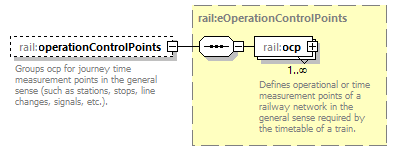 | ||||||
| namespace | https://www.railml.org/schemas/2021 | ||||||
| type | rail:eOperationControlPoints | ||||||
| properties |
| ||||||
| children | rail:ocp | ||||||
| annotation |
| ||||||
| source | <xs:element name="operationControlPoints" type="rail:eOperationControlPoints" minOccurs="0"> <xs:annotation> <xs:documentation>Groups ocp for journey time measurement points in the general sense (such as stations, stops, line changes, signals, etc.).</xs:documentation> <xs:documentation>See https://wiki2.railml.org/wiki/IS:operationControlPoints</xs:documentation> </xs:annotation> </xs:element> |
element infrastructure/controllers
| diagram |  | ||||||
| namespace | https://www.railml.org/schemas/2021 | ||||||
| type | rail:eControllers | ||||||
| properties |
| ||||||
| children | rail:controller | ||||||
| annotation |
| ||||||
| source | <xs:element name="controllers" type="rail:eControllers" minOccurs="0"> <xs:annotation> <xs:documentation>Groups controller elements.</xs:documentation> <xs:documentation>See https://wiki2.railml.org/wiki/IS:controllers</xs:documentation> </xs:annotation> </xs:element> |
element infrastructure/speedProfiles
| diagram |  | ||||||
| namespace | https://www.railml.org/schemas/2021 | ||||||
| type | rail:eSpeedProfiles | ||||||
| properties |
| ||||||
| children | rail:speedProfile | ||||||
| annotation |
| ||||||
| source | <xs:element name="speedProfiles" type="rail:eSpeedProfiles" minOccurs="0"> <xs:annotation> <xs:documentation>Groups speedProfile elements.</xs:documentation> <xs:documentation>See https://wiki2.railml.org/wiki/IS:speedProfiles</xs:documentation> </xs:annotation> </xs:element> |
element infrastructure/states
| diagram |  | ||||||
| namespace | https://www.railml.org/schemas/2021 | ||||||
| type | rail:tStates | ||||||
| properties |
| ||||||
| children | rail:state | ||||||
| annotation |
| ||||||
| source | <xs:element name="states" type="rail:tStates" minOccurs="0"> <xs:annotation> <xs:documentation>Container to define disabled/enabled status of infrastructure.</xs:documentation> <xs:documentation>See https://wiki2.railml.org/wiki/IS:states</xs:documentation> </xs:annotation> </xs:element> |
element infrastructure/routes
| diagram |  | ||||||
| namespace | https://www.railml.org/schemas/2021 | ||||||
| type | rail:eRoutes | ||||||
| properties |
| ||||||
| children | rail:route | ||||||
| annotation |
| ||||||
| source | <xs:element name="routes" type="rail:eRoutes" minOccurs="0"> <xs:annotation> <xs:documentation>Groups route elements.</xs:documentation> <xs:documentation>See https://wiki2.railml.org/wiki/IS:routes</xs:documentation> </xs:annotation> </xs:element> |
element infrastructure/operatingRules
| diagram |  | ||||||
| namespace | https://www.railml.org/schemas/2021 | ||||||
| type | rail:eOperatingRules | ||||||
| properties |
| ||||||
| children | rail:operatingRule | ||||||
| annotation |
| ||||||
| source | <xs:element name="operatingRules" type="rail:eOperatingRules" minOccurs="0"> <xs:annotation> <xs:documentation>Groups operatingRule elements.</xs:documentation> <xs:documentation>See https://wiki2.railml.org/wiki/IS:operatingRules</xs:documentation> </xs:annotation> </xs:element> |
element infrastructure/genericAreas
| diagram | 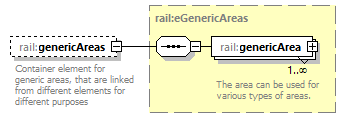 | ||||||
| namespace | https://www.railml.org/schemas/2021 | ||||||
| type | rail:eGenericAreas | ||||||
| properties |
| ||||||
| children | rail:genericArea | ||||||
| annotation |
| ||||||
| source | <xs:element name="genericAreas" type="rail:eGenericAreas" minOccurs="0"> <xs:annotation> <xs:documentation>Container element for generic areas, that are linked from different elements for different purposes</xs:documentation> <xs:documentation>See https://wiki2.railml.org/wiki/IS:genericAreas</xs:documentation> </xs:annotation> </xs:element> |
element infrastructureVisualizations
| diagram |  | ||||||||||||||
| namespace | https://www.railml.org/schemas/2021 | ||||||||||||||
| properties |
| ||||||||||||||
| children | rail:visualization | ||||||||||||||
| used by |
| ||||||||||||||
| attributes |
| ||||||||||||||
| annotation |
| ||||||||||||||
| source | <xs:element name="infrastructureVisualizations"> <xs:annotation> <xs:documentation>See https://wiki2.railml.org/wiki/IS:infrastructureVisualizations</xs:documentation> </xs:annotation> <xs:complexType> <xs:sequence> <xs:element name="visualization" type="rail:eInfrastructureVisualization" minOccurs="0" maxOccurs="unbounded"> <xs:annotation> <xs:documentation>container elements for all infrastructure visualizations</xs:documentation> <xs:documentation>See https://wiki2.railml.org/wiki/IS:visualization</xs:documentation> </xs:annotation> </xs:element> </xs:sequence> <xs:attribute ref="xml:base"/> </xs:complexType> </xs:element> |
element infrastructureVisualizations/visualization
| diagram |  | ||||||||||||||||||||||||
| namespace | https://www.railml.org/schemas/2021 | ||||||||||||||||||||||||
| type | rail:eInfrastructureVisualization | ||||||||||||||||||||||||
| properties |
| ||||||||||||||||||||||||
| children | rail:lineVis rail:ocpVis rail:objectVis | ||||||||||||||||||||||||
| attributes |
| ||||||||||||||||||||||||
| annotation |
| ||||||||||||||||||||||||
| source | <xs:element name="visualization" type="rail:eInfrastructureVisualization" minOccurs="0" maxOccurs="unbounded"> <xs:annotation> <xs:documentation>container elements for all infrastructure visualizations</xs:documentation> <xs:documentation>See https://wiki2.railml.org/wiki/IS:visualization</xs:documentation> </xs:annotation> </xs:element> |
complexType eAttributes
| diagram |  | ||
| namespace | https://www.railml.org/schemas/2021 | ||
| children | rail:attribute | ||
| used by |
| ||
| source | <xs:complexType name="eAttributes"> <xs:sequence> <xs:element name="attribute" type="rail:tAttribute" minOccurs="0" maxOccurs="unbounded"> <xs:annotation> <xs:documentation>Defines a global feature of the considered infrastructure.</xs:documentation> <xs:documentation>See https://wiki2.railml.org/wiki/IS:attribute</xs:documentation> </xs:annotation> </xs:element> </xs:sequence> </xs:complexType> |
element eAttributes/attribute
| diagram |  | ||||||||||||||||||
| namespace | https://www.railml.org/schemas/2021 | ||||||||||||||||||
| type | rail:tAttribute | ||||||||||||||||||
| properties |
| ||||||||||||||||||
| attributes |
| ||||||||||||||||||
| annotation |
| ||||||||||||||||||
| source | <xs:element name="attribute" type="rail:tAttribute" minOccurs="0" maxOccurs="unbounded"> <xs:annotation> <xs:documentation>Defines a global feature of the considered infrastructure.</xs:documentation> <xs:documentation>See https://wiki2.railml.org/wiki/IS:attribute</xs:documentation> </xs:annotation> </xs:element> |
complexType eAxleWeightChanges
| diagram |  | ||
| namespace | https://www.railml.org/schemas/2021 | ||
| children | rail:axleWeightChange | ||
| used by |
| ||
| source | <xs:complexType name="eAxleWeightChanges"> <xs:sequence> <xs:element name="axleWeightChange" type="rail:tAxleWeightChange" minOccurs="0" maxOccurs="unbounded"> <xs:annotation> <xs:documentation>Defines a point in which the maximum allowed axle load changes.</xs:documentation> <xs:documentation>See https://wiki2.railml.org/wiki/IS:axleWeightChange</xs:documentation> </xs:annotation> </xs:element> </xs:sequence> </xs:complexType> |
element eAxleWeightChanges/axleWeightChange
| diagram |  | ||||||||||||||||||||||||||||||||||||||||||||||||||||||||||||||||||||||||||||||||||||||||||
| namespace | https://www.railml.org/schemas/2021 | ||||||||||||||||||||||||||||||||||||||||||||||||||||||||||||||||||||||||||||||||||||||||||
| type | rail:tAxleWeightChange | ||||||||||||||||||||||||||||||||||||||||||||||||||||||||||||||||||||||||||||||||||||||||||
| properties |
| ||||||||||||||||||||||||||||||||||||||||||||||||||||||||||||||||||||||||||||||||||||||||||
| children | rail:additionalName rail:geoCoord rail:states | ||||||||||||||||||||||||||||||||||||||||||||||||||||||||||||||||||||||||||||||||||||||||||
| attributes |
| ||||||||||||||||||||||||||||||||||||||||||||||||||||||||||||||||||||||||||||||||||||||||||
| annotation |
| ||||||||||||||||||||||||||||||||||||||||||||||||||||||||||||||||||||||||||||||||||||||||||
| source | <xs:element name="axleWeightChange" type="rail:tAxleWeightChange" minOccurs="0" maxOccurs="unbounded"> <xs:annotation> <xs:documentation>Defines a point in which the maximum allowed axle load changes.</xs:documentation> <xs:documentation>See https://wiki2.railml.org/wiki/IS:axleWeightChange</xs:documentation> </xs:annotation> </xs:element> |
complexType eBalises
| diagram | 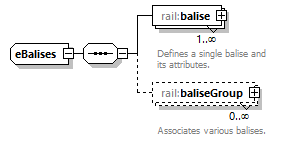 | ||
| namespace | https://www.railml.org/schemas/2021 | ||
| children | rail:balise rail:baliseGroup | ||
| used by |
| ||
| source | <xs:complexType name="eBalises"> <xs:sequence> <xs:element name="balise" type="rail:tBalise" maxOccurs="unbounded"> <xs:annotation> <xs:documentation>Defines a single balise and its attributes.</xs:documentation> <xs:documentation>See https://wiki2.railml.org/wiki/IS:balise</xs:documentation> </xs:annotation> </xs:element> <xs:element name="baliseGroup" type="rail:tBaliseGroup" minOccurs="0" maxOccurs="unbounded"> <xs:annotation> <xs:documentation>Associates various balises.</xs:documentation> <xs:documentation>See https://wiki2.railml.org/wiki/IS:baliseGroup</xs:documentation> </xs:annotation> </xs:element> </xs:sequence> </xs:complexType> |
element eBalises/balise
| diagram |  | ||||||||||||||||||||||||||||||||||||||||||||||||||||||||||||||||||||||||||||||||||||||||||||||||||||||||||||||||||||||||||||||||||
| namespace | https://www.railml.org/schemas/2021 | ||||||||||||||||||||||||||||||||||||||||||||||||||||||||||||||||||||||||||||||||||||||||||||||||||||||||||||||||||||||||||||||||||
| type | rail:tBalise | ||||||||||||||||||||||||||||||||||||||||||||||||||||||||||||||||||||||||||||||||||||||||||||||||||||||||||||||||||||||||||||||||||
| properties |
| ||||||||||||||||||||||||||||||||||||||||||||||||||||||||||||||||||||||||||||||||||||||||||||||||||||||||||||||||||||||||||||||||||
| children | rail:additionalName rail:geoCoord rail:states | ||||||||||||||||||||||||||||||||||||||||||||||||||||||||||||||||||||||||||||||||||||||||||||||||||||||||||||||||||||||||||||||||||
| attributes |
| ||||||||||||||||||||||||||||||||||||||||||||||||||||||||||||||||||||||||||||||||||||||||||||||||||||||||||||||||||||||||||||||||||
| annotation |
| ||||||||||||||||||||||||||||||||||||||||||||||||||||||||||||||||||||||||||||||||||||||||||||||||||||||||||||||||||||||||||||||||||
| source | <xs:element name="balise" type="rail:tBalise" maxOccurs="unbounded"> <xs:annotation> <xs:documentation>Defines a single balise and its attributes.</xs:documentation> <xs:documentation>See https://wiki2.railml.org/wiki/IS:balise</xs:documentation> </xs:annotation> </xs:element> |
element eBalises/baliseGroup
| diagram | 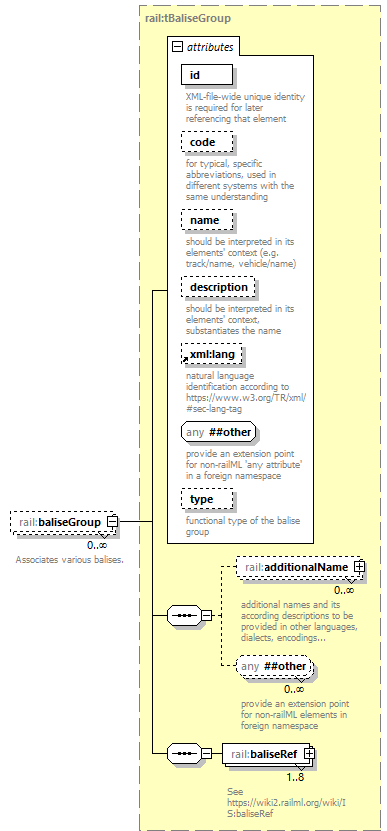 | ||||||||||||||||||||||||||||||||||||||||||||||||||||||
| namespace | https://www.railml.org/schemas/2021 | ||||||||||||||||||||||||||||||||||||||||||||||||||||||
| type | rail:tBaliseGroup | ||||||||||||||||||||||||||||||||||||||||||||||||||||||
| properties |
| ||||||||||||||||||||||||||||||||||||||||||||||||||||||
| children | rail:additionalName rail:baliseRef | ||||||||||||||||||||||||||||||||||||||||||||||||||||||
| attributes |
| ||||||||||||||||||||||||||||||||||||||||||||||||||||||
| annotation |
| ||||||||||||||||||||||||||||||||||||||||||||||||||||||
| source | <xs:element name="baliseGroup" type="rail:tBaliseGroup" minOccurs="0" maxOccurs="unbounded"> <xs:annotation> <xs:documentation>Associates various balises.</xs:documentation> <xs:documentation>See https://wiki2.railml.org/wiki/IS:baliseGroup</xs:documentation> </xs:annotation> </xs:element> |
complexType eBorder
| diagram |  | ||
| namespace | https://www.railml.org/schemas/2021 | ||
| children | rail:border | ||
| used by |
| ||
| source | <xs:complexType name="eBorder"> <xs:sequence> <xs:element name="border" type="rail:tBorder" minOccurs="0" maxOccurs="unbounded"> <xs:annotation> <xs:documentation>Defines delimitations of defined areas such as fare zones, countries, etc.</xs:documentation> <xs:documentation>See https://wiki2.railml.org/wiki/IS:border</xs:documentation> </xs:annotation> </xs:element> </xs:sequence> </xs:complexType> |
element eBorder/border
| diagram |  | ||||||||||||||||||||||||||||||||||||||||||||||||||||||||||||||||||||||||||||||||||||
| namespace | https://www.railml.org/schemas/2021 | ||||||||||||||||||||||||||||||||||||||||||||||||||||||||||||||||||||||||||||||||||||
| type | rail:tBorder | ||||||||||||||||||||||||||||||||||||||||||||||||||||||||||||||||||||||||||||||||||||
| properties |
| ||||||||||||||||||||||||||||||||||||||||||||||||||||||||||||||||||||||||||||||||||||
| children | rail:additionalName rail:geoCoord rail:states | ||||||||||||||||||||||||||||||||||||||||||||||||||||||||||||||||||||||||||||||||||||
| attributes |
| ||||||||||||||||||||||||||||||||||||||||||||||||||||||||||||||||||||||||||||||||||||
| annotation |
| ||||||||||||||||||||||||||||||||||||||||||||||||||||||||||||||||||||||||||||||||||||
| source | <xs:element name="border" type="rail:tBorder" minOccurs="0" maxOccurs="unbounded"> <xs:annotation> <xs:documentation>Defines delimitations of defined areas such as fare zones, countries, etc.</xs:documentation> <xs:documentation>See https://wiki2.railml.org/wiki/IS:border</xs:documentation> </xs:annotation> </xs:element> |
complexType eBridge
| diagram |  | ||||||||||||||||||||||||||||||||||||||||||||||||||||||||||||||||||||||||||||||||||||||||||||||||||
| namespace | https://www.railml.org/schemas/2021 | ||||||||||||||||||||||||||||||||||||||||||||||||||||||||||||||||||||||||||||||||||||||||||||||||||
| type | extension of rail:tBridge | ||||||||||||||||||||||||||||||||||||||||||||||||||||||||||||||||||||||||||||||||||||||||||||||||||
| properties |
| ||||||||||||||||||||||||||||||||||||||||||||||||||||||||||||||||||||||||||||||||||||||||||||||||||
| children | rail:additionalName rail:geoCoord rail:states rail:crossedElements | ||||||||||||||||||||||||||||||||||||||||||||||||||||||||||||||||||||||||||||||||||||||||||||||||||
| used by |
| ||||||||||||||||||||||||||||||||||||||||||||||||||||||||||||||||||||||||||||||||||||||||||||||||||
| attributes |
| ||||||||||||||||||||||||||||||||||||||||||||||||||||||||||||||||||||||||||||||||||||||||||||||||||
| source | <xs:complexType name="eBridge"> <xs:complexContent> <xs:extension base="rail:tBridge"> <xs:sequence> <xs:element name="crossedElements" type="rail:eCrossedElements" minOccurs="0"> <xs:annotation> <xs:documentation>Lists the elements that are crossed by this bridge.</xs:documentation> <xs:documentation>See https://wiki2.railml.org/wiki/IS:crossedElements_brigde</xs:documentation> </xs:annotation> </xs:element> </xs:sequence> </xs:extension> </xs:complexContent> </xs:complexType> |
element eBridge/crossedElements
| diagram | 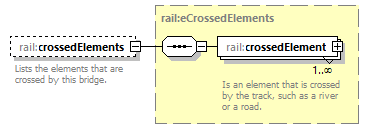 | ||||||
| namespace | https://www.railml.org/schemas/2021 | ||||||
| type | rail:eCrossedElements | ||||||
| properties |
| ||||||
| children | rail:crossedElement | ||||||
| annotation |
| ||||||
| source | <xs:element name="crossedElements" type="rail:eCrossedElements" minOccurs="0"> <xs:annotation> <xs:documentation>Lists the elements that are crossed by this bridge.</xs:documentation> <xs:documentation>See https://wiki2.railml.org/wiki/IS:crossedElements_brigde</xs:documentation> </xs:annotation> </xs:element> |
complexType eBridges
| diagram |  | ||
| namespace | https://www.railml.org/schemas/2021 | ||
| children | rail:brigde | ||
| used by |
| ||
| source | <xs:complexType name="eBridges"> <xs:sequence> <xs:element name="brigde" type="rail:eBridge" minOccurs="0" maxOccurs="unbounded"> <xs:annotation> <xs:documentation>Defines a structure carrying a track over a depression or obstacle as an infrastructure element and its attributes.</xs:documentation> <xs:documentation>See https://wiki2.railml.org/wiki/IS:brigde</xs:documentation> </xs:annotation> </xs:element> </xs:sequence> </xs:complexType> |
element eBridges/brigde
| diagram |  | ||||||||||||||||||||||||||||||||||||||||||||||||||||||||||||||||||||||||||||||||||||||||||||||||||
| namespace | https://www.railml.org/schemas/2021 | ||||||||||||||||||||||||||||||||||||||||||||||||||||||||||||||||||||||||||||||||||||||||||||||||||
| type | rail:eBridge | ||||||||||||||||||||||||||||||||||||||||||||||||||||||||||||||||||||||||||||||||||||||||||||||||||
| properties |
| ||||||||||||||||||||||||||||||||||||||||||||||||||||||||||||||||||||||||||||||||||||||||||||||||||
| children | rail:additionalName rail:geoCoord rail:states rail:crossedElements | ||||||||||||||||||||||||||||||||||||||||||||||||||||||||||||||||||||||||||||||||||||||||||||||||||
| attributes |
| ||||||||||||||||||||||||||||||||||||||||||||||||||||||||||||||||||||||||||||||||||||||||||||||||||
| annotation |
| ||||||||||||||||||||||||||||||||||||||||||||||||||||||||||||||||||||||||||||||||||||||||||||||||||
| source | <xs:element name="brigde" type="rail:eBridge" minOccurs="0" maxOccurs="unbounded"> <xs:annotation> <xs:documentation>Defines a structure carrying a track over a depression or obstacle as an infrastructure element and its attributes.</xs:documentation> <xs:documentation>See https://wiki2.railml.org/wiki/IS:brigde</xs:documentation> </xs:annotation> </xs:element> |
complexType eClearanceGaugeChanges
| diagram |  | ||
| namespace | https://www.railml.org/schemas/2021 | ||
| children | rail:clearanceGaugeChange | ||
| used by |
| ||
| source | <xs:complexType name="eClearanceGaugeChanges"> <xs:sequence> <xs:element name="clearanceGaugeChange" type="rail:tClearanceGaugeChange" minOccurs="0" maxOccurs="unbounded"> <xs:annotation> <xs:documentation>Defines a point in which the minimum clearance outline (also called loading gauge) changes.</xs:documentation> <xs:documentation>See https://wiki2.railml.org/wiki/IS:clearanceGaugeChange</xs:documentation> </xs:annotation> </xs:element> </xs:sequence> </xs:complexType> |
element eClearanceGaugeChanges/clearanceGaugeChange
| diagram |  | ||||||||||||||||||||||||||||||||||||||||||||||||||||||||||||||||||||||||||||||
| namespace | https://www.railml.org/schemas/2021 | ||||||||||||||||||||||||||||||||||||||||||||||||||||||||||||||||||||||||||||||
| type | rail:tClearanceGaugeChange | ||||||||||||||||||||||||||||||||||||||||||||||||||||||||||||||||||||||||||||||
| properties |
| ||||||||||||||||||||||||||||||||||||||||||||||||||||||||||||||||||||||||||||||
| children | rail:additionalName rail:geoCoord rail:states rail:clearanceGauge | ||||||||||||||||||||||||||||||||||||||||||||||||||||||||||||||||||||||||||||||
| attributes |
| ||||||||||||||||||||||||||||||||||||||||||||||||||||||||||||||||||||||||||||||
| annotation |
| ||||||||||||||||||||||||||||||||||||||||||||||||||||||||||||||||||||||||||||||
| source | <xs:element name="clearanceGaugeChange" type="rail:tClearanceGaugeChange" minOccurs="0" maxOccurs="unbounded"> <xs:annotation> <xs:documentation>Defines a point in which the minimum clearance outline (also called loading gauge) changes.</xs:documentation> <xs:documentation>See https://wiki2.railml.org/wiki/IS:clearanceGaugeChange</xs:documentation> </xs:annotation> </xs:element> |
complexType eConnections
| diagram | 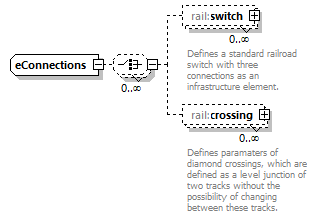 | ||
| namespace | https://www.railml.org/schemas/2021 | ||
| children | rail:switch rail:crossing | ||
| used by |
| ||
| source | <xs:complexType name="eConnections"> <xs:choice minOccurs="0" maxOccurs="unbounded"> <xs:element name="switch" type="rail:eSwitch" minOccurs="0" maxOccurs="unbounded"> <xs:annotation> <xs:documentation>Defines a standard railroad switch with three connections as an infrastructure element.</xs:documentation> <xs:documentation>See https://wiki2.railml.org/wiki/IS:switch</xs:documentation> </xs:annotation> </xs:element> <xs:element name="crossing" type="rail:eCrossing" minOccurs="0" maxOccurs="unbounded"> <xs:annotation> <xs:documentation>Defines paramaters of diamond crossings, which are defined as a level junction of two tracks without the possibility of changing between these tracks.</xs:documentation> <xs:documentation>See https://wiki2.railml.org/wiki/IS:crossing</xs:documentation> </xs:annotation> </xs:element> </xs:choice> </xs:complexType> |
element eConnections/switch
| diagram |  | ||||||||||||||||||||||||||||||||||||||||||||||||||||||||||||||||||||||||||||||||||||||||||||||||||||||||||||||||||||||||||||||||||||||||||||||||||||||
| namespace | https://www.railml.org/schemas/2021 | ||||||||||||||||||||||||||||||||||||||||||||||||||||||||||||||||||||||||||||||||||||||||||||||||||||||||||||||||||||||||||||||||||||||||||||||||||||||
| type | rail:eSwitch | ||||||||||||||||||||||||||||||||||||||||||||||||||||||||||||||||||||||||||||||||||||||||||||||||||||||||||||||||||||||||||||||||||||||||||||||||||||||
| properties |
| ||||||||||||||||||||||||||||||||||||||||||||||||||||||||||||||||||||||||||||||||||||||||||||||||||||||||||||||||||||||||||||||||||||||||||||||||||||||
| children | rail:additionalName rail:geoCoord rail:states rail:connection | ||||||||||||||||||||||||||||||||||||||||||||||||||||||||||||||||||||||||||||||||||||||||||||||||||||||||||||||||||||||||||||||||||||||||||||||||||||||
| attributes |
| ||||||||||||||||||||||||||||||||||||||||||||||||||||||||||||||||||||||||||||||||||||||||||||||||||||||||||||||||||||||||||||||||||||||||||||||||||||||
| annotation |
| ||||||||||||||||||||||||||||||||||||||||||||||||||||||||||||||||||||||||||||||||||||||||||||||||||||||||||||||||||||||||||||||||||||||||||||||||||||||
| source | <xs:element name="switch" type="rail:eSwitch" minOccurs="0" maxOccurs="unbounded"> <xs:annotation> <xs:documentation>Defines a standard railroad switch with three connections as an infrastructure element.</xs:documentation> <xs:documentation>See https://wiki2.railml.org/wiki/IS:switch</xs:documentation> </xs:annotation> </xs:element> |
element eConnections/crossing
| diagram |  | ||||||||||||||||||||||||||||||||||||||||||||||||||||||||||||||||||||||||||||||||||||||||||||||||||||||||||||||||||||||||||||||||||||||||||||||||||||||
| namespace | https://www.railml.org/schemas/2021 | ||||||||||||||||||||||||||||||||||||||||||||||||||||||||||||||||||||||||||||||||||||||||||||||||||||||||||||||||||||||||||||||||||||||||||||||||||||||
| type | rail:eCrossing | ||||||||||||||||||||||||||||||||||||||||||||||||||||||||||||||||||||||||||||||||||||||||||||||||||||||||||||||||||||||||||||||||||||||||||||||||||||||
| properties |
| ||||||||||||||||||||||||||||||||||||||||||||||||||||||||||||||||||||||||||||||||||||||||||||||||||||||||||||||||||||||||||||||||||||||||||||||||||||||
| children | rail:additionalName rail:geoCoord rail:states rail:connection | ||||||||||||||||||||||||||||||||||||||||||||||||||||||||||||||||||||||||||||||||||||||||||||||||||||||||||||||||||||||||||||||||||||||||||||||||||||||
| attributes |
| ||||||||||||||||||||||||||||||||||||||||||||||||||||||||||||||||||||||||||||||||||||||||||||||||||||||||||||||||||||||||||||||||||||||||||||||||||||||
| annotation |
| ||||||||||||||||||||||||||||||||||||||||||||||||||||||||||||||||||||||||||||||||||||||||||||||||||||||||||||||||||||||||||||||||||||||||||||||||||||||
| source | <xs:element name="crossing" type="rail:eCrossing" minOccurs="0" maxOccurs="unbounded"> <xs:annotation> <xs:documentation>Defines paramaters of diamond crossings, which are defined as a level junction of two tracks without the possibility of changing between these tracks.</xs:documentation> <xs:documentation>See https://wiki2.railml.org/wiki/IS:crossing</xs:documentation> </xs:annotation> </xs:element> |
complexType eControllers
| diagram |  | ||
| namespace | https://www.railml.org/schemas/2021 | ||
| children | rail:controller | ||
| used by |
| ||
| source | <xs:complexType name="eControllers"> <xs:sequence> <xs:element name="controller" type="rail:tController" minOccurs="0" maxOccurs="unbounded"> <xs:annotation> <xs:documentation>Defines a facility that controlles some track-side facilities, e.g. an interlocking.</xs:documentation> <xs:documentation>See https://wiki2.railml.org/wiki/IS:controller</xs:documentation> </xs:annotation> </xs:element> </xs:sequence> </xs:complexType> |
element eControllers/controller
| diagram |  | ||||||||||||||||||||||||||||||||||||||||||||||||||||||||||||||||||||||||||||||||||||||||||||||||||||||||||||||
| namespace | https://www.railml.org/schemas/2021 | ||||||||||||||||||||||||||||||||||||||||||||||||||||||||||||||||||||||||||||||||||||||||||||||||||||||||||||||
| type | rail:tController | ||||||||||||||||||||||||||||||||||||||||||||||||||||||||||||||||||||||||||||||||||||||||||||||||||||||||||||||
| properties |
| ||||||||||||||||||||||||||||||||||||||||||||||||||||||||||||||||||||||||||||||||||||||||||||||||||||||||||||||
| children | rail:additionalName rail:states rail:ocpRef rail:trackVacancyDetectionArea rail:localOperationArea rail:workZone | ||||||||||||||||||||||||||||||||||||||||||||||||||||||||||||||||||||||||||||||||||||||||||||||||||||||||||||||
| attributes |
| ||||||||||||||||||||||||||||||||||||||||||||||||||||||||||||||||||||||||||||||||||||||||||||||||||||||||||||||
| annotation |
| ||||||||||||||||||||||||||||||||||||||||||||||||||||||||||||||||||||||||||||||||||||||||||||||||||||||||||||||
| source | <xs:element name="controller" type="rail:tController" minOccurs="0" maxOccurs="unbounded"> <xs:annotation> <xs:documentation>Defines a facility that controlles some track-side facilities, e.g. an interlocking.</xs:documentation> <xs:documentation>See https://wiki2.railml.org/wiki/IS:controller</xs:documentation> </xs:annotation> </xs:element> |
complexType eCrossedElements
| diagram |  | ||
| namespace | https://www.railml.org/schemas/2021 | ||
| children | rail:crossedElement | ||
| used by |
| ||
| source | <xs:complexType name="eCrossedElements"> <xs:sequence> <xs:element name="crossedElement" type="rail:tCrossedElement" maxOccurs="unbounded"> <xs:annotation> <xs:documentation>Is an element that is crossed by the track, such as a river or a road.</xs:documentation> <xs:documentation>See https://wiki2.railml.org/wiki/IS:crossedElement</xs:documentation> </xs:annotation> </xs:element> </xs:sequence> </xs:complexType> |
element eCrossedElements/crossedElement
| diagram |  | ||||||||||||||||||||||||||||||||||||||||||||||||||||||||||||||||
| namespace | https://www.railml.org/schemas/2021 | ||||||||||||||||||||||||||||||||||||||||||||||||||||||||||||||||
| type | rail:tCrossedElement | ||||||||||||||||||||||||||||||||||||||||||||||||||||||||||||||||
| properties |
| ||||||||||||||||||||||||||||||||||||||||||||||||||||||||||||||||
| children | rail:additionalName | ||||||||||||||||||||||||||||||||||||||||||||||||||||||||||||||||
| attributes |
| ||||||||||||||||||||||||||||||||||||||||||||||||||||||||||||||||
| annotation |
| ||||||||||||||||||||||||||||||||||||||||||||||||||||||||||||||||
| source | <xs:element name="crossedElement" type="rail:tCrossedElement" maxOccurs="unbounded"> <xs:annotation> <xs:documentation>Is an element that is crossed by the track, such as a river or a road.</xs:documentation> <xs:documentation>See https://wiki2.railml.org/wiki/IS:crossedElement</xs:documentation> </xs:annotation> </xs:element> |
complexType eCrossing
| diagram |  | ||||||||||||||||||||||||||||||||||||||||||||||||||||||||||||||||||||||||||||||||||||||||||||||||||||||||||||||||||||||||||||||||||||||||||||||||||||||
| namespace | https://www.railml.org/schemas/2021 | ||||||||||||||||||||||||||||||||||||||||||||||||||||||||||||||||||||||||||||||||||||||||||||||||||||||||||||||||||||||||||||||||||||||||||||||||||||||
| type | extension of rail:tCrossing | ||||||||||||||||||||||||||||||||||||||||||||||||||||||||||||||||||||||||||||||||||||||||||||||||||||||||||||||||||||||||||||||||||||||||||||||||||||||
| properties |
| ||||||||||||||||||||||||||||||||||||||||||||||||||||||||||||||||||||||||||||||||||||||||||||||||||||||||||||||||||||||||||||||||||||||||||||||||||||||
| children | rail:additionalName rail:geoCoord rail:states rail:connection | ||||||||||||||||||||||||||||||||||||||||||||||||||||||||||||||||||||||||||||||||||||||||||||||||||||||||||||||||||||||||||||||||||||||||||||||||||||||
| used by |
| ||||||||||||||||||||||||||||||||||||||||||||||||||||||||||||||||||||||||||||||||||||||||||||||||||||||||||||||||||||||||||||||||||||||||||||||||||||||
| attributes |
| ||||||||||||||||||||||||||||||||||||||||||||||||||||||||||||||||||||||||||||||||||||||||||||||||||||||||||||||||||||||||||||||||||||||||||||||||||||||
| source | <xs:complexType name="eCrossing"> <xs:complexContent> <xs:extension base="rail:tCrossing"> <xs:sequence> <xs:element name="connection" type="rail:tSwitchConnectionData" maxOccurs="3"> <xs:annotation> <xs:documentation>Is a topologic element that represents one of the track pairs connected by a certain crossing.</xs:documentation> <xs:documentation>See https://wiki2.railml.org/wiki/IS:connection_crossing</xs:documentation> </xs:annotation> </xs:element> </xs:sequence> </xs:extension> </xs:complexContent> </xs:complexType> |
element eCrossing/connection
| diagram |  | ||||||||||||||||||||||||||||||||||||||||||||||||||||||||
| namespace | https://www.railml.org/schemas/2021 | ||||||||||||||||||||||||||||||||||||||||||||||||||||||||
| type | rail:tSwitchConnectionData | ||||||||||||||||||||||||||||||||||||||||||||||||||||||||
| properties |
| ||||||||||||||||||||||||||||||||||||||||||||||||||||||||
| attributes |
| ||||||||||||||||||||||||||||||||||||||||||||||||||||||||
| annotation |
| ||||||||||||||||||||||||||||||||||||||||||||||||||||||||
| source | <xs:element name="connection" type="rail:tSwitchConnectionData" maxOccurs="3"> <xs:annotation> <xs:documentation>Is a topologic element that represents one of the track pairs connected by a certain crossing.</xs:documentation> <xs:documentation>See https://wiki2.railml.org/wiki/IS:connection_crossing</xs:documentation> </xs:annotation> </xs:element> |
complexType eCrossSections
| diagram |  | ||
| namespace | https://www.railml.org/schemas/2021 | ||
| children | rail:crossSection | ||
| used by |
| ||
| source | <xs:complexType name="eCrossSections"> <xs:sequence> <xs:element name="crossSection" type="rail:tCrossSection" minOccurs="0" maxOccurs="unbounded"> <xs:annotation> <xs:documentation>Defines parameters of crossSections. This element provides a link from a track to one or more ocps, that are located along itself.</xs:documentation> <xs:documentation>See https://wiki2.railml.org/wiki/IS:crossSection</xs:documentation> </xs:annotation> </xs:element> </xs:sequence> </xs:complexType> |
element eCrossSections/crossSection
| diagram |  | ||||||||||||||||||||||||||||||||||||||||||||||||||||||||||||||||||||||||||||||||||||||||||||||||||||||||||
| namespace | https://www.railml.org/schemas/2021 | ||||||||||||||||||||||||||||||||||||||||||||||||||||||||||||||||||||||||||||||||||||||||||||||||||||||||||
| type | rail:tCrossSection | ||||||||||||||||||||||||||||||||||||||||||||||||||||||||||||||||||||||||||||||||||||||||||||||||||||||||||
| properties |
| ||||||||||||||||||||||||||||||||||||||||||||||||||||||||||||||||||||||||||||||||||||||||||||||||||||||||||
| children | rail:additionalName rail:geoCoord rail:states | ||||||||||||||||||||||||||||||||||||||||||||||||||||||||||||||||||||||||||||||||||||||||||||||||||||||||||
| attributes |
| ||||||||||||||||||||||||||||||||||||||||||||||||||||||||||||||||||||||||||||||||||||||||||||||||||||||||||
| annotation |
| ||||||||||||||||||||||||||||||||||||||||||||||||||||||||||||||||||||||||||||||||||||||||||||||||||||||||||
| source | <xs:element name="crossSection" type="rail:tCrossSection" minOccurs="0" maxOccurs="unbounded"> <xs:annotation> <xs:documentation>Defines parameters of crossSections. This element provides a link from a track to one or more ocps, that are located along itself.</xs:documentation> <xs:documentation>See https://wiki2.railml.org/wiki/IS:crossSection</xs:documentation> </xs:annotation> </xs:element> |
complexType eDerailers
| diagram |  | ||
| namespace | https://www.railml.org/schemas/2021 | ||
| children | rail:derailer | ||
| used by |
| ||
| source | <xs:complexType name="eDerailers"> <xs:sequence> <xs:element name="derailer" type="rail:tDerailer" minOccurs="0" maxOccurs="unbounded"> <xs:annotation> <xs:documentation>Defines a device used to prevent fouling of a rail track by unauthorized movements of trains or unattended rolling stock.</xs:documentation> <xs:documentation>See https://wiki2.railml.org/wiki/IS:derailer</xs:documentation> </xs:annotation> </xs:element> </xs:sequence> </xs:complexType> |
element eDerailers/derailer
| diagram |  | ||||||||||||||||||||||||||||||||||||||||||||||||||||||||||||||||||||||||||||||||||||||||||||||||||||||||||||||||||||||
| namespace | https://www.railml.org/schemas/2021 | ||||||||||||||||||||||||||||||||||||||||||||||||||||||||||||||||||||||||||||||||||||||||||||||||||||||||||||||||||||||
| type | rail:tDerailer | ||||||||||||||||||||||||||||||||||||||||||||||||||||||||||||||||||||||||||||||||||||||||||||||||||||||||||||||||||||||
| properties |
| ||||||||||||||||||||||||||||||||||||||||||||||||||||||||||||||||||||||||||||||||||||||||||||||||||||||||||||||||||||||
| children | rail:additionalName rail:geoCoord rail:states | ||||||||||||||||||||||||||||||||||||||||||||||||||||||||||||||||||||||||||||||||||||||||||||||||||||||||||||||||||||||
| attributes |
| ||||||||||||||||||||||||||||||||||||||||||||||||||||||||||||||||||||||||||||||||||||||||||||||||||||||||||||||||||||||
| annotation |
| ||||||||||||||||||||||||||||||||||||||||||||||||||||||||||||||||||||||||||||||||||||||||||||||||||||||||||||||||||||||
| source | <xs:element name="derailer" type="rail:tDerailer" minOccurs="0" maxOccurs="unbounded"> <xs:annotation> <xs:documentation>Defines a device used to prevent fouling of a rail track by unauthorized movements of trains or unattended rolling stock.</xs:documentation> <xs:documentation>See https://wiki2.railml.org/wiki/IS:derailer</xs:documentation> </xs:annotation> </xs:element> |
complexType eElectrificationChanges
| diagram |  | ||
| namespace | https://www.railml.org/schemas/2021 | ||
| children | rail:electrificationChange | ||
| used by |
| ||
| source | <xs:complexType name="eElectrificationChanges"> <xs:sequence> <xs:element name="electrificationChange" type="rail:tElectrificationChange" minOccurs="0" maxOccurs="unbounded"> <xs:annotation> <xs:documentation>Defines a point in which at least one attribute of the electrification changes. Optional, as not all tracks are electrified.</xs:documentation> <xs:documentation>See https://wiki2.railml.org/wiki/IS:electrificationChange</xs:documentation> </xs:annotation> </xs:element> </xs:sequence> </xs:complexType> |
element eElectrificationChanges/electrificationChange
| diagram |  | ||||||||||||||||||||||||||||||||||||||||||||||||||||||||||||||||||||||||||||||||||||||||||||||||||||||||||||
| namespace | https://www.railml.org/schemas/2021 | ||||||||||||||||||||||||||||||||||||||||||||||||||||||||||||||||||||||||||||||||||||||||||||||||||||||||||||
| type | rail:tElectrificationChange | ||||||||||||||||||||||||||||||||||||||||||||||||||||||||||||||||||||||||||||||||||||||||||||||||||||||||||||
| properties |
| ||||||||||||||||||||||||||||||||||||||||||||||||||||||||||||||||||||||||||||||||||||||||||||||||||||||||||||
| children | rail:additionalName rail:geoCoord rail:states rail:maxTrainCurrent | ||||||||||||||||||||||||||||||||||||||||||||||||||||||||||||||||||||||||||||||||||||||||||||||||||||||||||||
| attributes |
| ||||||||||||||||||||||||||||||||||||||||||||||||||||||||||||||||||||||||||||||||||||||||||||||||||||||||||||
| annotation |
| ||||||||||||||||||||||||||||||||||||||||||||||||||||||||||||||||||||||||||||||||||||||||||||||||||||||||||||
| source | <xs:element name="electrificationChange" type="rail:tElectrificationChange" minOccurs="0" maxOccurs="unbounded"> <xs:annotation> <xs:documentation>Defines a point in which at least one attribute of the electrification changes. Optional, as not all tracks are electrified.</xs:documentation> <xs:documentation>See https://wiki2.railml.org/wiki/IS:electrificationChange</xs:documentation> </xs:annotation> </xs:element> |
complexType eGaugeChanges
| diagram |  | ||
| namespace | https://www.railml.org/schemas/2021 | ||
| children | rail:gaugeChange | ||
| used by |
| ||
| source | <xs:complexType name="eGaugeChanges"> <xs:sequence> <xs:element name="gaugeChange" type="rail:tGaugeChange" minOccurs="0" maxOccurs="unbounded"> <xs:annotation> <xs:documentation>Defines a point in which the distance between the rails changes.</xs:documentation> <xs:documentation>See https://wiki2.railml.org/wiki/IS:gaugeChange</xs:documentation> </xs:annotation> </xs:element> </xs:sequence> </xs:complexType> |
element eGaugeChanges/gaugeChange
| diagram |  | ||||||||||||||||||||||||||||||||||||||||||||||||||||||||||||||||||||||||||||||||||||
| namespace | https://www.railml.org/schemas/2021 | ||||||||||||||||||||||||||||||||||||||||||||||||||||||||||||||||||||||||||||||||||||
| type | rail:tGaugeChange | ||||||||||||||||||||||||||||||||||||||||||||||||||||||||||||||||||||||||||||||||||||
| properties |
| ||||||||||||||||||||||||||||||||||||||||||||||||||||||||||||||||||||||||||||||||||||
| children | rail:additionalName rail:geoCoord rail:states | ||||||||||||||||||||||||||||||||||||||||||||||||||||||||||||||||||||||||||||||||||||
| attributes |
| ||||||||||||||||||||||||||||||||||||||||||||||||||||||||||||||||||||||||||||||||||||
| annotation |
| ||||||||||||||||||||||||||||||||||||||||||||||||||||||||||||||||||||||||||||||||||||
| source | <xs:element name="gaugeChange" type="rail:tGaugeChange" minOccurs="0" maxOccurs="unbounded"> <xs:annotation> <xs:documentation>Defines a point in which the distance between the rails changes.</xs:documentation> <xs:documentation>See https://wiki2.railml.org/wiki/IS:gaugeChange</xs:documentation> </xs:annotation> </xs:element> |
complexType eGeneralInfraAttribute
| diagram |  | ||
| namespace | https://www.railml.org/schemas/2021 | ||
| children | rail:attributes | ||
| used by |
| ||
| source | <xs:complexType name="eGeneralInfraAttribute"> <xs:sequence> <xs:element name="attributes" type="rail:eAttributes" minOccurs="0"> <xs:annotation> <xs:documentation>Groups attribute elements.</xs:documentation> <xs:documentation>See https://wiki2.railml.org/wiki/IS:attributes</xs:documentation> </xs:annotation> </xs:element> <xs:any namespace="##other" processContents="strict" minOccurs="0" maxOccurs="unbounded"/> </xs:sequence> </xs:complexType> |
element eGeneralInfraAttribute/attributes
| diagram | 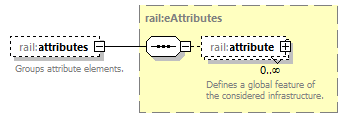 | ||||||
| namespace | https://www.railml.org/schemas/2021 | ||||||
| type | rail:eAttributes | ||||||
| properties |
| ||||||
| children | rail:attribute | ||||||
| annotation |
| ||||||
| source | <xs:element name="attributes" type="rail:eAttributes" minOccurs="0"> <xs:annotation> <xs:documentation>Groups attribute elements.</xs:documentation> <xs:documentation>See https://wiki2.railml.org/wiki/IS:attributes</xs:documentation> </xs:annotation> </xs:element> |
complexType eGeneralInfraAttributes
| diagram |  | ||
| namespace | https://www.railml.org/schemas/2021 | ||
| children | rail:generalInfraAttribute | ||
| used by |
| ||
| source | <xs:complexType name="eGeneralInfraAttributes"> <xs:sequence> <xs:element name="generalInfraAttribute" type="rail:eGeneralInfraAttribute" minOccurs="0" maxOccurs="unbounded"> <xs:annotation> <xs:documentation>defines pre-defined infrastructure attributes, which are not covered by the other child elements of infraAttributes.</xs:documentation> <xs:documentation>See https://wiki2.railml.org/wiki/IS:generalInfraAttribute</xs:documentation> </xs:annotation> </xs:element> </xs:sequence> </xs:complexType> |
element eGeneralInfraAttributes/generalInfraAttribute
| diagram | 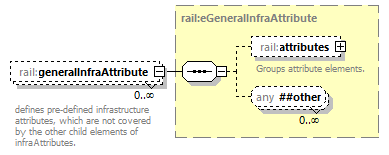 | ||||||
| namespace | https://www.railml.org/schemas/2021 | ||||||
| type | rail:eGeneralInfraAttribute | ||||||
| properties |
| ||||||
| children | rail:attributes | ||||||
| annotation |
| ||||||
| source | <xs:element name="generalInfraAttribute" type="rail:eGeneralInfraAttribute" minOccurs="0" maxOccurs="unbounded"> <xs:annotation> <xs:documentation>defines pre-defined infrastructure attributes, which are not covered by the other child elements of infraAttributes.</xs:documentation> <xs:documentation>See https://wiki2.railml.org/wiki/IS:generalInfraAttribute</xs:documentation> </xs:annotation> </xs:element> |
complexType eGenericAreas
| diagram |  | ||
| namespace | https://www.railml.org/schemas/2021 | ||
| children | rail:genericArea | ||
| used by |
| ||
| annotation |
| ||
| source | <xs:complexType name="eGenericAreas"> <xs:annotation> <xs:documentation>Container type for generic areas.</xs:documentation> </xs:annotation> <xs:sequence> <xs:element name="genericArea" type="rail:tGenericArea" maxOccurs="unbounded"> <xs:annotation> <xs:documentation>The area can be used for various types of areas.</xs:documentation> <xs:documentation>See https://wiki2.railml.org/wiki/IS:genericArea</xs:documentation> </xs:annotation> </xs:element> </xs:sequence> </xs:complexType> |
element eGenericAreas/genericArea
| diagram | 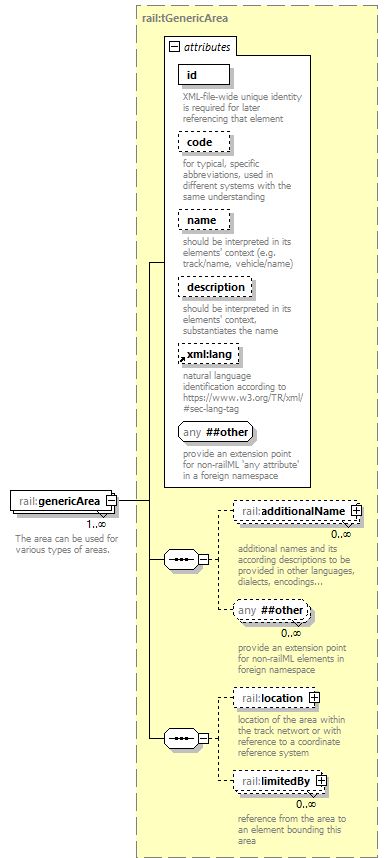 | ||||||||||||||||||||||||||||||||||||||||||||||
| namespace | https://www.railml.org/schemas/2021 | ||||||||||||||||||||||||||||||||||||||||||||||
| type | rail:tGenericArea | ||||||||||||||||||||||||||||||||||||||||||||||
| properties |
| ||||||||||||||||||||||||||||||||||||||||||||||
| children | rail:additionalName rail:location rail:limitedBy | ||||||||||||||||||||||||||||||||||||||||||||||
| attributes |
| ||||||||||||||||||||||||||||||||||||||||||||||
| annotation |
| ||||||||||||||||||||||||||||||||||||||||||||||
| source | <xs:element name="genericArea" type="rail:tGenericArea" maxOccurs="unbounded"> <xs:annotation> <xs:documentation>The area can be used for various types of areas.</xs:documentation> <xs:documentation>See https://wiki2.railml.org/wiki/IS:genericArea</xs:documentation> </xs:annotation> </xs:element> |
complexType eGeoMappings
| diagram |  | ||
| namespace | https://www.railml.org/schemas/2021 | ||
| children | rail:geoMapping | ||
| used by |
| ||
| source | <xs:complexType name="eGeoMappings"> <xs:sequence> <xs:element name="geoMapping" type="rail:tPlacedElement" minOccurs="0" maxOccurs="unbounded"> <xs:annotation> <xs:documentation>Maps a logical position along a track (as defined by its attribute pos) to geographic coordinates in geoCoord.</xs:documentation> <xs:documentation>See https://wiki2.railml.org/wiki/IS:geoMapping</xs:documentation> </xs:annotation> </xs:element> </xs:sequence> </xs:complexType> |
element eGeoMappings/geoMapping
| diagram |  | ||||||||||||||||||||||||||||||||||||||||||||||||||||||||||||||||||||||
| namespace | https://www.railml.org/schemas/2021 | ||||||||||||||||||||||||||||||||||||||||||||||||||||||||||||||||||||||
| type | rail:tPlacedElement | ||||||||||||||||||||||||||||||||||||||||||||||||||||||||||||||||||||||
| properties |
| ||||||||||||||||||||||||||||||||||||||||||||||||||||||||||||||||||||||
| children | rail:additionalName rail:geoCoord rail:states | ||||||||||||||||||||||||||||||||||||||||||||||||||||||||||||||||||||||
| attributes |
| ||||||||||||||||||||||||||||||||||||||||||||||||||||||||||||||||||||||
| annotation |
| ||||||||||||||||||||||||||||||||||||||||||||||||||||||||||||||||||||||
| source | <xs:element name="geoMapping" type="rail:tPlacedElement" minOccurs="0" maxOccurs="unbounded"> <xs:annotation> <xs:documentation>Maps a logical position along a track (as defined by its attribute pos) to geographic coordinates in geoCoord.</xs:documentation> <xs:documentation>See https://wiki2.railml.org/wiki/IS:geoMapping</xs:documentation> </xs:annotation> </xs:element> |
complexType eGradientChanges
| diagram |  | ||
| namespace | https://www.railml.org/schemas/2021 | ||
| children | rail:gradientChange | ||
| used by |
| ||
| source | <xs:complexType name="eGradientChanges"> <xs:sequence> <xs:element name="gradientChange" type="rail:tGradientChange" minOccurs="0" maxOccurs="unbounded"> <xs:annotation> <xs:documentation>Defines in which position the gradient on a track changes.</xs:documentation> <xs:documentation>See https://wiki2.railml.org/wiki/IS:gradientChange</xs:documentation> </xs:annotation> </xs:element> </xs:sequence> </xs:complexType> |
element eGradientChanges/gradientChange
| diagram |  | ||||||||||||||||||||||||||||||||||||||||||||||||||||||||||||||||||||||||||||||||||||||||||||||||
| namespace | https://www.railml.org/schemas/2021 | ||||||||||||||||||||||||||||||||||||||||||||||||||||||||||||||||||||||||||||||||||||||||||||||||
| type | rail:tGradientChange | ||||||||||||||||||||||||||||||||||||||||||||||||||||||||||||||||||||||||||||||||||||||||||||||||
| properties |
| ||||||||||||||||||||||||||||||||||||||||||||||||||||||||||||||||||||||||||||||||||||||||||||||||
| children | rail:additionalName rail:geoCoord rail:states | ||||||||||||||||||||||||||||||||||||||||||||||||||||||||||||||||||||||||||||||||||||||||||||||||
| attributes |
| ||||||||||||||||||||||||||||||||||||||||||||||||||||||||||||||||||||||||||||||||||||||||||||||||
| annotation |
| ||||||||||||||||||||||||||||||||||||||||||||||||||||||||||||||||||||||||||||||||||||||||||||||||
| source | <xs:element name="gradientChange" type="rail:tGradientChange" minOccurs="0" maxOccurs="unbounded"> <xs:annotation> <xs:documentation>Defines in which position the gradient on a track changes.</xs:documentation> <xs:documentation>See https://wiki2.railml.org/wiki/IS:gradientChange</xs:documentation> </xs:annotation> </xs:element> |
complexType eImpairmentSections
| diagram |  | ||
| namespace | https://www.railml.org/schemas/2021 | ||
| children | rail:impairmentSection | ||
| used by |
| ||
| source | <xs:complexType name="eImpairmentSections"> <xs:sequence> <xs:element name="impairmentSection" type="rail:tImpairmentSection" maxOccurs="unbounded"> <xs:annotation> <xs:documentation>Defines a track section with deteriorations affecting railway operation.</xs:documentation> <xs:documentation>See https://wiki2.railml.org/wiki/IS:impairmentSection</xs:documentation> </xs:annotation> </xs:element> </xs:sequence> </xs:complexType> |
element eImpairmentSections/impairmentSection
| diagram | 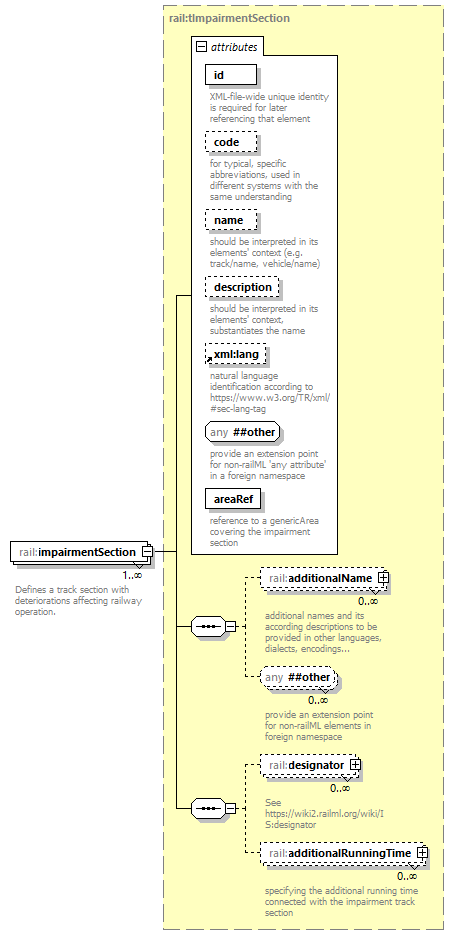 | ||||||||||||||||||||||||||||||||||||||||||||||||||||||
| namespace | https://www.railml.org/schemas/2021 | ||||||||||||||||||||||||||||||||||||||||||||||||||||||
| type | rail:tImpairmentSection | ||||||||||||||||||||||||||||||||||||||||||||||||||||||
| properties |
| ||||||||||||||||||||||||||||||||||||||||||||||||||||||
| children | rail:additionalName rail:designator rail:additionalRunningTime | ||||||||||||||||||||||||||||||||||||||||||||||||||||||
| attributes |
| ||||||||||||||||||||||||||||||||||||||||||||||||||||||
| annotation |
| ||||||||||||||||||||||||||||||||||||||||||||||||||||||
| source | <xs:element name="impairmentSection" type="rail:tImpairmentSection" maxOccurs="unbounded"> <xs:annotation> <xs:documentation>Defines a track section with deteriorations affecting railway operation.</xs:documentation> <xs:documentation>See https://wiki2.railml.org/wiki/IS:impairmentSection</xs:documentation> </xs:annotation> </xs:element> |
complexType eInfraAttr
| diagram |  | ||||||||||||||||||||||||||||||||||||||||||||||
| namespace | https://www.railml.org/schemas/2021 | ||||||||||||||||||||||||||||||||||||||||||||||
| type | extension of rail:tElementWithIDAndNameWithoutAny | ||||||||||||||||||||||||||||||||||||||||||||||
| properties |
| ||||||||||||||||||||||||||||||||||||||||||||||
| children | rail:owner rail:operationMode rail:trainProtection rail:electrification rail:powerTransmission rail:axleWeight rail:gauge rail:clearanceGauge rail:speeds rail:epsgCode rail:trainRadio rail:generalInfraAttributes | ||||||||||||||||||||||||||||||||||||||||||||||
| used by |
| ||||||||||||||||||||||||||||||||||||||||||||||
| attributes |
| ||||||||||||||||||||||||||||||||||||||||||||||
| source | <xs:complexType name="eInfraAttr"> <xs:complexContent> <xs:extension base="rail:tElementWithIDAndNameWithoutAny"> <xs:all> <xs:element name="owner" type="rail:tOwner" minOccurs="0"> <xs:annotation> <xs:documentation>Defines the infrastructure manager (IM) of all tracks where the current infraAttributes are used per reference.</xs:documentation> <xs:documentation>See https://wiki2.railml.org/wiki/IS:owner</xs:documentation> </xs:annotation> </xs:element> <xs:element name="operationMode" type="rail:tOperationMode" minOccurs="0"> <xs:annotation> <xs:documentation>Defines the operational system that is used at all tracks where the current infraAttributes are used per reference.</xs:documentation> <xs:documentation>See https://wiki2.railml.org/wiki/IS:operationMode</xs:documentation> </xs:annotation> </xs:element> <xs:element name="trainProtection" type="rail:tTrainProtection" minOccurs="0"> <xs:annotation> <xs:documentation>Defines the train protection system that is used at all tracks where the current infraAttributes are used per reference.</xs:documentation> <xs:documentation>See https://wiki2.railml.org/wiki/IS:trainProtection</xs:documentation> </xs:annotation> </xs:element> <xs:element name="electrification" type="rail:tElectrification" minOccurs="0"> <xs:annotation> <xs:documentation>Defines the electrification system that is used at all tracks where the current infraAttributes are used per reference.</xs:documentation> <xs:documentation>See https://wiki2.railml.org/wiki/IS:electrification</xs:documentation> </xs:annotation> </xs:element> <xs:element name="powerTransmission" type="rail:tPowerTransmission" minOccurs="0"> <xs:annotation> <xs:documentation>Defines the kind of railway in means of power transmission of all tracks where the current infraAttributes are used per reference.</xs:documentation> <xs:documentation>See https://wiki2.railml.org/wiki/IS:powerTransmission</xs:documentation> </xs:annotation> </xs:element> <xs:element name="axleWeight" type="rail:tAxleWeight" minOccurs="0"> <xs:annotation> <xs:documentation>Defines the maximum load per axle in tons for all tracks where the current infraAttributes are used per reference.</xs:documentation> <xs:documentation>See https://wiki2.railml.org/wiki/IS:axleWeight</xs:documentation> </xs:annotation> </xs:element> <xs:element name="gauge" type="rail:tGauge" minOccurs="0"> <xs:annotation> <xs:documentation>Defines the distance of both rails of all tracks where the current infraAttributes are used per reference.</xs:documentation> <xs:documentation>See https://wiki2.railml.org/wiki/IS:gauge</xs:documentation> </xs:annotation> </xs:element> <xs:element name="clearanceGauge" type="rail:tClearanceGaugeType" minOccurs="0"> <xs:annotation> <xs:documentation>Defines the clearance gauge of all tracks where the current infraAttributes are used per reference.</xs:documentation> <xs:documentation>See https://wiki2.railml.org/wiki/IS:clearanceGauge_infraAttributes</xs:documentation> </xs:annotation> </xs:element> <xs:element name="speeds" type="rail:eSpeeds" minOccurs="0"> <xs:annotation> <xs:documentation>Groups speed elements at all tracks where the current infraAttributes are used per reference.</xs:documentation> <xs:documentation>See https://wiki2.railml.org/wiki/IS:speeds</xs:documentation> </xs:annotation> </xs:element> <xs:element name="epsgCode" type="rail:tEpsgCode" minOccurs="0"> <xs:annotation> <xs:documentation>Defines the coordinate reference system for coordinates in geoCoord of all tracks where the current infraAttributes are used per reference.</xs:documentation> <xs:documentation>See https://wiki2.railml.org/wiki/IS:epsgCode</xs:documentation> </xs:annotation> </xs:element> <xs:element name="trainRadio" type="rail:tTrainRadioAttributes" minOccurs="0"> <xs:annotation> <xs:documentation>Defines the train radio system that is used at all tracks where the current infraAttributes are used per reference.</xs:documentation> <xs:documentation>See https://wiki2.railml.org/wiki/IS:trainRadio_infraAttributes</xs:documentation> </xs:annotation> </xs:element> <xs:element name="generalInfraAttributes" type="rail:eGeneralInfraAttributes" minOccurs="0"> <xs:annotation> <xs:documentation>Groups generalInfraAttribute elements at all tracks where the current infraAttributes are used per reference.</xs:documentation> <xs:documentation>See https://wiki2.railml.org/wiki/IS:generalInfraAttributes</xs:documentation> </xs:annotation> </xs:element> </xs:all> </xs:extension> </xs:complexContent> </xs:complexType> |
element eInfraAttr/owner
| diagram | 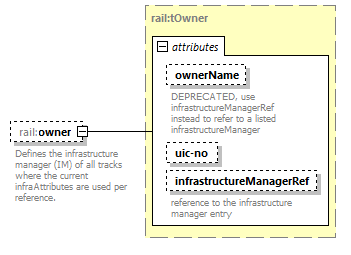 | ||||||||||||||||||||||||||||
| namespace | https://www.railml.org/schemas/2021 | ||||||||||||||||||||||||||||
| type | rail:tOwner | ||||||||||||||||||||||||||||
| properties |
| ||||||||||||||||||||||||||||
| attributes |
| ||||||||||||||||||||||||||||
| annotation |
| ||||||||||||||||||||||||||||
| source | <xs:element name="owner" type="rail:tOwner" minOccurs="0"> <xs:annotation> <xs:documentation>Defines the infrastructure manager (IM) of all tracks where the current infraAttributes are used per reference.</xs:documentation> <xs:documentation>See https://wiki2.railml.org/wiki/IS:owner</xs:documentation> </xs:annotation> </xs:element> |
element eInfraAttr/operationMode
| diagram |  | ||||||||||||||||||||||||
| namespace | https://www.railml.org/schemas/2021 | ||||||||||||||||||||||||
| type | rail:tOperationMode | ||||||||||||||||||||||||
| properties |
| ||||||||||||||||||||||||
| attributes |
| ||||||||||||||||||||||||
| annotation |
| ||||||||||||||||||||||||
| source | <xs:element name="operationMode" type="rail:tOperationMode" minOccurs="0"> <xs:annotation> <xs:documentation>Defines the operational system that is used at all tracks where the current infraAttributes are used per reference.</xs:documentation> <xs:documentation>See https://wiki2.railml.org/wiki/IS:operationMode</xs:documentation> </xs:annotation> </xs:element> |
element eInfraAttr/trainProtection
| diagram |  | ||||||||||||||||||||||||||||
| namespace | https://www.railml.org/schemas/2021 | ||||||||||||||||||||||||||||
| type | rail:tTrainProtection | ||||||||||||||||||||||||||||
| properties |
| ||||||||||||||||||||||||||||
| attributes |
| ||||||||||||||||||||||||||||
| annotation |
| ||||||||||||||||||||||||||||
| source | <xs:element name="trainProtection" type="rail:tTrainProtection" minOccurs="0"> <xs:annotation> <xs:documentation>Defines the train protection system that is used at all tracks where the current infraAttributes are used per reference.</xs:documentation> <xs:documentation>See https://wiki2.railml.org/wiki/IS:trainProtection</xs:documentation> </xs:annotation> </xs:element> |
element eInfraAttr/electrification
| diagram |  | ||||||||||||||||||||||||
| namespace | https://www.railml.org/schemas/2021 | ||||||||||||||||||||||||
| type | rail:tElectrification | ||||||||||||||||||||||||
| properties |
| ||||||||||||||||||||||||
| children | rail:maxTrainCurrent | ||||||||||||||||||||||||
| attributes |
| ||||||||||||||||||||||||
| annotation |
| ||||||||||||||||||||||||
| source | <xs:element name="electrification" type="rail:tElectrification" minOccurs="0"> <xs:annotation> <xs:documentation>Defines the electrification system that is used at all tracks where the current infraAttributes are used per reference.</xs:documentation> <xs:documentation>See https://wiki2.railml.org/wiki/IS:electrification</xs:documentation> </xs:annotation> </xs:element> |
element eInfraAttr/powerTransmission
| diagram |  | ||||||||||||||||||
| namespace | https://www.railml.org/schemas/2021 | ||||||||||||||||||
| type | rail:tPowerTransmission | ||||||||||||||||||
| properties |
| ||||||||||||||||||
| attributes |
| ||||||||||||||||||
| annotation |
| ||||||||||||||||||
| source | <xs:element name="powerTransmission" type="rail:tPowerTransmission" minOccurs="0"> <xs:annotation> <xs:documentation>Defines the kind of railway in means of power transmission of all tracks where the current infraAttributes are used per reference.</xs:documentation> <xs:documentation>See https://wiki2.railml.org/wiki/IS:powerTransmission</xs:documentation> </xs:annotation> </xs:element> |
element eInfraAttr/axleWeight
| diagram |  | ||||||||||||||||||
| namespace | https://www.railml.org/schemas/2021 | ||||||||||||||||||
| type | rail:tAxleWeight | ||||||||||||||||||
| properties |
| ||||||||||||||||||
| attributes |
| ||||||||||||||||||
| annotation |
| ||||||||||||||||||
| source | <xs:element name="axleWeight" type="rail:tAxleWeight" minOccurs="0"> <xs:annotation> <xs:documentation>Defines the maximum load per axle in tons for all tracks where the current infraAttributes are used per reference.</xs:documentation> <xs:documentation>See https://wiki2.railml.org/wiki/IS:axleWeight</xs:documentation> </xs:annotation> </xs:element> |
element eInfraAttr/gauge
| diagram |  | ||||||||||||
| namespace | https://www.railml.org/schemas/2021 | ||||||||||||
| type | rail:tGauge | ||||||||||||
| properties |
| ||||||||||||
| attributes |
| ||||||||||||
| annotation |
| ||||||||||||
| source | <xs:element name="gauge" type="rail:tGauge" minOccurs="0"> <xs:annotation> <xs:documentation>Defines the distance of both rails of all tracks where the current infraAttributes are used per reference.</xs:documentation> <xs:documentation>See https://wiki2.railml.org/wiki/IS:gauge</xs:documentation> </xs:annotation> </xs:element> |
element eInfraAttr/clearanceGauge
| diagram |  | ||||||||||||||||
| namespace | https://www.railml.org/schemas/2021 | ||||||||||||||||
| type | rail:tClearanceGaugeType | ||||||||||||||||
| properties |
| ||||||||||||||||
| attributes |
| ||||||||||||||||
| annotation |
| ||||||||||||||||
| source | <xs:element name="clearanceGauge" type="rail:tClearanceGaugeType" minOccurs="0"> <xs:annotation> <xs:documentation>Defines the clearance gauge of all tracks where the current infraAttributes are used per reference.</xs:documentation> <xs:documentation>See https://wiki2.railml.org/wiki/IS:clearanceGauge_infraAttributes</xs:documentation> </xs:annotation> </xs:element> |
element eInfraAttr/speeds
| diagram | 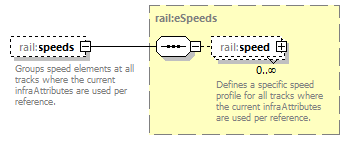 | ||||||
| namespace | https://www.railml.org/schemas/2021 | ||||||
| type | rail:eSpeeds | ||||||
| properties |
| ||||||
| children | rail:speed | ||||||
| annotation |
| ||||||
| source | <xs:element name="speeds" type="rail:eSpeeds" minOccurs="0"> <xs:annotation> <xs:documentation>Groups speed elements at all tracks where the current infraAttributes are used per reference.</xs:documentation> <xs:documentation>See https://wiki2.railml.org/wiki/IS:speeds</xs:documentation> </xs:annotation> </xs:element> |
element eInfraAttr/epsgCode
| diagram | 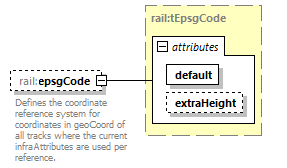 | ||||||||||||||||||
| namespace | https://www.railml.org/schemas/2021 | ||||||||||||||||||
| type | rail:tEpsgCode | ||||||||||||||||||
| properties |
| ||||||||||||||||||
| attributes |
| ||||||||||||||||||
| annotation |
| ||||||||||||||||||
| source | <xs:element name="epsgCode" type="rail:tEpsgCode" minOccurs="0"> <xs:annotation> <xs:documentation>Defines the coordinate reference system for coordinates in geoCoord of all tracks where the current infraAttributes are used per reference.</xs:documentation> <xs:documentation>See https://wiki2.railml.org/wiki/IS:epsgCode</xs:documentation> </xs:annotation> </xs:element> |
element eInfraAttr/trainRadio
| diagram |  | ||||||||||||||||||||||||||||||||||||||||||||||||||||||||||||||
| namespace | https://www.railml.org/schemas/2021 | ||||||||||||||||||||||||||||||||||||||||||||||||||||||||||||||
| type | rail:tTrainRadioAttributes | ||||||||||||||||||||||||||||||||||||||||||||||||||||||||||||||
| properties |
| ||||||||||||||||||||||||||||||||||||||||||||||||||||||||||||||
| attributes |
| ||||||||||||||||||||||||||||||||||||||||||||||||||||||||||||||
| annotation |
| ||||||||||||||||||||||||||||||||||||||||||||||||||||||||||||||
| source | <xs:element name="trainRadio" type="rail:tTrainRadioAttributes" minOccurs="0"> <xs:annotation> <xs:documentation>Defines the train radio system that is used at all tracks where the current infraAttributes are used per reference.</xs:documentation> <xs:documentation>See https://wiki2.railml.org/wiki/IS:trainRadio_infraAttributes</xs:documentation> </xs:annotation> </xs:element> |
element eInfraAttr/generalInfraAttributes
| diagram |  | ||||||
| namespace | https://www.railml.org/schemas/2021 | ||||||
| type | rail:eGeneralInfraAttributes | ||||||
| properties |
| ||||||
| children | rail:generalInfraAttribute | ||||||
| annotation |
| ||||||
| source | <xs:element name="generalInfraAttributes" type="rail:eGeneralInfraAttributes" minOccurs="0"> <xs:annotation> <xs:documentation>Groups generalInfraAttribute elements at all tracks where the current infraAttributes are used per reference.</xs:documentation> <xs:documentation>See https://wiki2.railml.org/wiki/IS:generalInfraAttributes</xs:documentation> </xs:annotation> </xs:element> |
complexType eInfraAttrGroup
| diagram |  | ||
| namespace | https://www.railml.org/schemas/2021 | ||
| children | rail:infraAttributes | ||
| used by |
| ||
| source | <xs:complexType name="eInfraAttrGroup"> <xs:sequence> <xs:element name="infraAttributes" type="rail:eInfraAttr" minOccurs="0" maxOccurs="unbounded"> <xs:annotation> <xs:documentation>Describes the properties of an infrastructure group, such as owner, operation mode, etc.</xs:documentation> <xs:documentation>See https://wiki2.railml.org/wiki/IS:infraAttributes</xs:documentation> </xs:annotation> </xs:element> </xs:sequence> </xs:complexType> |
element eInfraAttrGroup/infraAttributes
| diagram |  | ||||||||||||||||||||||||||||||||||||||||||||||
| namespace | https://www.railml.org/schemas/2021 | ||||||||||||||||||||||||||||||||||||||||||||||
| type | rail:eInfraAttr | ||||||||||||||||||||||||||||||||||||||||||||||
| properties |
| ||||||||||||||||||||||||||||||||||||||||||||||
| children | rail:owner rail:operationMode rail:trainProtection rail:electrification rail:powerTransmission rail:axleWeight rail:gauge rail:clearanceGauge rail:speeds rail:epsgCode rail:trainRadio rail:generalInfraAttributes | ||||||||||||||||||||||||||||||||||||||||||||||
| attributes |
| ||||||||||||||||||||||||||||||||||||||||||||||
| annotation |
| ||||||||||||||||||||||||||||||||||||||||||||||
| source | <xs:element name="infraAttributes" type="rail:eInfraAttr" minOccurs="0" maxOccurs="unbounded"> <xs:annotation> <xs:documentation>Describes the properties of an infrastructure group, such as owner, operation mode, etc.</xs:documentation> <xs:documentation>See https://wiki2.railml.org/wiki/IS:infraAttributes</xs:documentation> </xs:annotation> </xs:element> |
complexType eInfraAttrGroupRefs
| diagram |  | ||
| namespace | https://www.railml.org/schemas/2021 | ||
| children | rail:infraAttrGroupRef | ||
| used by |
| ||
| source | <xs:complexType name="eInfraAttrGroupRefs"> <xs:sequence> <xs:element name="infraAttrGroupRef" type="rail:tElementWithReference" minOccurs="0" maxOccurs="unbounded"> <xs:annotation> <xs:documentation>Refers to the properties of an infrastructure group, such as owner, operation mode, etc. as well as general attributes.</xs:documentation> <xs:documentation>See https://wiki2.railml.org/wiki/IS:infraAttributes</xs:documentation> </xs:annotation> </xs:element> </xs:sequence> </xs:complexType> |
element eInfraAttrGroupRefs/infraAttrGroupRef
| diagram | 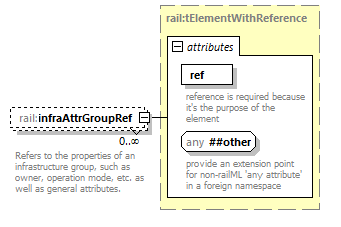 | ||||||||||||||
| namespace | https://www.railml.org/schemas/2021 | ||||||||||||||
| type | rail:tElementWithReference | ||||||||||||||
| properties |
| ||||||||||||||
| attributes |
| ||||||||||||||
| annotation |
| ||||||||||||||
| source | <xs:element name="infraAttrGroupRef" type="rail:tElementWithReference" minOccurs="0" maxOccurs="unbounded"> <xs:annotation> <xs:documentation>Refers to the properties of an infrastructure group, such as owner, operation mode, etc. as well as general attributes.</xs:documentation> <xs:documentation>See https://wiki2.railml.org/wiki/IS:infraAttributes</xs:documentation> </xs:annotation> </xs:element> |
complexType eInfrastructureVisualization
| diagram | 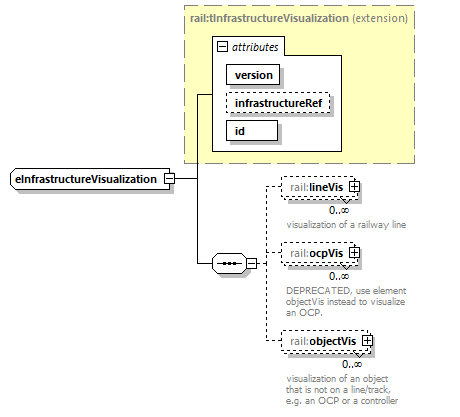 | ||||||||||||||||||||||||
| namespace | https://www.railml.org/schemas/2021 | ||||||||||||||||||||||||
| type | extension of rail:tInfrastructureVisualization | ||||||||||||||||||||||||
| properties |
| ||||||||||||||||||||||||
| children | rail:lineVis rail:ocpVis rail:objectVis | ||||||||||||||||||||||||
| used by |
| ||||||||||||||||||||||||
| attributes |
| ||||||||||||||||||||||||
| source | <xs:complexType name="eInfrastructureVisualization"> <xs:complexContent> <xs:extension base="rail:tInfrastructureVisualization"> <xs:sequence> <xs:element name="lineVis" type="rail:eLineVis" minOccurs="0" maxOccurs="unbounded"> <xs:annotation> <xs:documentation>visualization of a railway line</xs:documentation> <xs:documentation>See https://wiki2.railml.org/wiki/IS:lineVis</xs:documentation> </xs:annotation> </xs:element> <xs:element name="ocpVis" type="rail:eOcpVis" minOccurs="0" maxOccurs="unbounded"> <xs:annotation> <xs:documentation>DEPRECATED, use element objectVis instead to visualize an OCP.</xs:documentation> <xs:documentation>See https://wiki2.railml.org/wiki/IS:ocpVis</xs:documentation> </xs:annotation> </xs:element> <xs:element name="objectVis" type="rail:eOcpVis" minOccurs="0" maxOccurs="unbounded"> <xs:annotation> <xs:documentation>visualization of an object that is not on a line/track, e.g. an OCP or a controller</xs:documentation> <xs:documentation>See https://wiki2.railml.org/wiki/IS:objectVis</xs:documentation> </xs:annotation> </xs:element> </xs:sequence> </xs:extension> </xs:complexContent> </xs:complexType> |
element eInfrastructureVisualization/lineVis
| diagram |  | ||||||||||||||
| namespace | https://www.railml.org/schemas/2021 | ||||||||||||||
| type | rail:eLineVis | ||||||||||||||
| properties |
| ||||||||||||||
| children | rail:trackVis | ||||||||||||||
| attributes |
| ||||||||||||||
| annotation |
| ||||||||||||||
| source | <xs:element name="lineVis" type="rail:eLineVis" minOccurs="0" maxOccurs="unbounded"> <xs:annotation> <xs:documentation>visualization of a railway line</xs:documentation> <xs:documentation>See https://wiki2.railml.org/wiki/IS:lineVis</xs:documentation> </xs:annotation> </xs:element> |
element eInfrastructureVisualization/ocpVis
| diagram |  | ||||||||||||||
| namespace | https://www.railml.org/schemas/2021 | ||||||||||||||
| type | rail:eOcpVis | ||||||||||||||
| properties |
| ||||||||||||||
| children | rail:position rail:size | ||||||||||||||
| attributes |
| ||||||||||||||
| annotation |
| ||||||||||||||
| source | <xs:element name="ocpVis" type="rail:eOcpVis" minOccurs="0" maxOccurs="unbounded"> <xs:annotation> <xs:documentation>DEPRECATED, use element objectVis instead to visualize an OCP.</xs:documentation> <xs:documentation>See https://wiki2.railml.org/wiki/IS:ocpVis</xs:documentation> </xs:annotation> </xs:element> |
element eInfrastructureVisualization/objectVis
| diagram |  | ||||||||||||||
| namespace | https://www.railml.org/schemas/2021 | ||||||||||||||
| type | rail:eOcpVis | ||||||||||||||
| properties |
| ||||||||||||||
| children | rail:position rail:size | ||||||||||||||
| attributes |
| ||||||||||||||
| annotation |
| ||||||||||||||
| source | <xs:element name="objectVis" type="rail:eOcpVis" minOccurs="0" maxOccurs="unbounded"> <xs:annotation> <xs:documentation>visualization of an object that is not on a line/track, e.g. an OCP or a controller</xs:documentation> <xs:documentation>See https://wiki2.railml.org/wiki/IS:objectVis</xs:documentation> </xs:annotation> </xs:element> |
complexType eLevelCrossing
| diagram |  | ||||||||||||||||||||||||||||||||||||||||||||||||||||||||||||||||||||||||||||||||||||||||||||||||||||||||||||||||||||||||||||||
| namespace | https://www.railml.org/schemas/2021 | ||||||||||||||||||||||||||||||||||||||||||||||||||||||||||||||||||||||||||||||||||||||||||||||||||||||||||||||||||||||||||||||
| type | extension of rail:tLevelCrossing | ||||||||||||||||||||||||||||||||||||||||||||||||||||||||||||||||||||||||||||||||||||||||||||||||||||||||||||||||||||||||||||||
| properties |
| ||||||||||||||||||||||||||||||||||||||||||||||||||||||||||||||||||||||||||||||||||||||||||||||||||||||||||||||||||||||||||||||
| children | rail:additionalName rail:geoCoord rail:states rail:crossedElements | ||||||||||||||||||||||||||||||||||||||||||||||||||||||||||||||||||||||||||||||||||||||||||||||||||||||||||||||||||||||||||||||
| used by |
| ||||||||||||||||||||||||||||||||||||||||||||||||||||||||||||||||||||||||||||||||||||||||||||||||||||||||||||||||||||||||||||||
| attributes |
| ||||||||||||||||||||||||||||||||||||||||||||||||||||||||||||||||||||||||||||||||||||||||||||||||||||||||||||||||||||||||||||||
| source | <xs:complexType name="eLevelCrossing"> <xs:complexContent> <xs:extension base="rail:tLevelCrossing"> <xs:sequence> <xs:element name="crossedElements" type="rail:eCrossedElements" minOccurs="0"> <xs:annotation> <xs:documentation>Lists the elements that are crossed by this level crossing.</xs:documentation> <xs:documentation>See https://wiki2.railml.org/wiki/IS:crossedElements_levelCrossing</xs:documentation> </xs:annotation> </xs:element> </xs:sequence> </xs:extension> </xs:complexContent> </xs:complexType> |
element eLevelCrossing/crossedElements
| diagram |  | ||||||
| namespace | https://www.railml.org/schemas/2021 | ||||||
| type | rail:eCrossedElements | ||||||
| properties |
| ||||||
| children | rail:crossedElement | ||||||
| annotation |
| ||||||
| source | <xs:element name="crossedElements" type="rail:eCrossedElements" minOccurs="0"> <xs:annotation> <xs:documentation>Lists the elements that are crossed by this level crossing.</xs:documentation> <xs:documentation>See https://wiki2.railml.org/wiki/IS:crossedElements_levelCrossing</xs:documentation> </xs:annotation> </xs:element> |
complexType eLevelCrossings
| diagram |  | ||
| namespace | https://www.railml.org/schemas/2021 | ||
| children | rail:levelCrossing | ||
| used by |
| ||
| source | <xs:complexType name="eLevelCrossings"> <xs:sequence> <xs:element name="levelCrossing" type="rail:eLevelCrossing" minOccurs="0" maxOccurs="unbounded"> <xs:annotation> <xs:documentation>Defines an intersection of a railway track with a non railway track (e.g. road, path).</xs:documentation> <xs:documentation>See https://wiki2.railml.org/wiki/IS:levelCrossing_levelCrossings</xs:documentation> </xs:annotation> </xs:element> </xs:sequence> </xs:complexType> |
element eLevelCrossings/levelCrossing
| diagram |  | ||||||||||||||||||||||||||||||||||||||||||||||||||||||||||||||||||||||||||||||||||||||||||||||||||||||||||||||||||||||||||||||
| namespace | https://www.railml.org/schemas/2021 | ||||||||||||||||||||||||||||||||||||||||||||||||||||||||||||||||||||||||||||||||||||||||||||||||||||||||||||||||||||||||||||||
| type | rail:eLevelCrossing | ||||||||||||||||||||||||||||||||||||||||||||||||||||||||||||||||||||||||||||||||||||||||||||||||||||||||||||||||||||||||||||||
| properties |
| ||||||||||||||||||||||||||||||||||||||||||||||||||||||||||||||||||||||||||||||||||||||||||||||||||||||||||||||||||||||||||||||
| children | rail:additionalName rail:geoCoord rail:states rail:crossedElements | ||||||||||||||||||||||||||||||||||||||||||||||||||||||||||||||||||||||||||||||||||||||||||||||||||||||||||||||||||||||||||||||
| attributes |
| ||||||||||||||||||||||||||||||||||||||||||||||||||||||||||||||||||||||||||||||||||||||||||||||||||||||||||||||||||||||||||||||
| annotation |
| ||||||||||||||||||||||||||||||||||||||||||||||||||||||||||||||||||||||||||||||||||||||||||||||||||||||||||||||||||||||||||||||
| source | <xs:element name="levelCrossing" type="rail:eLevelCrossing" minOccurs="0" maxOccurs="unbounded"> <xs:annotation> <xs:documentation>Defines an intersection of a railway track with a non railway track (e.g. road, path).</xs:documentation> <xs:documentation>See https://wiki2.railml.org/wiki/IS:levelCrossing_levelCrossings</xs:documentation> </xs:annotation> </xs:element> |
complexType eLine
| diagram |  | ||||||||||||||||||||||||||||||||||||||||||||||||||||||||||||||||||||||||||||||
| namespace | https://www.railml.org/schemas/2021 | ||||||||||||||||||||||||||||||||||||||||||||||||||||||||||||||||||||||||||||||
| type | extension of rail:tLine | ||||||||||||||||||||||||||||||||||||||||||||||||||||||||||||||||||||||||||||||
| properties |
| ||||||||||||||||||||||||||||||||||||||||||||||||||||||||||||||||||||||||||||||
| children | rail:additionalName rail:states rail:lineDescr rail:trackRef | ||||||||||||||||||||||||||||||||||||||||||||||||||||||||||||||||||||||||||||||
| used by |
| ||||||||||||||||||||||||||||||||||||||||||||||||||||||||||||||||||||||||||||||
| attributes |
| ||||||||||||||||||||||||||||||||||||||||||||||||||||||||||||||||||||||||||||||
| source | <xs:complexType name="eLine"> <xs:complexContent> <xs:extension base="rail:tLine"> <xs:sequence> <xs:element name="lineDescr" type="xs:string" minOccurs="0" maxOccurs="unbounded"> <xs:annotation> <xs:documentation>DEPRECATED with railML version 2.4</xs:documentation> <xs:documentation>See https://wiki2.railml.org/wiki/IS:lineDescr</xs:documentation> </xs:annotation> </xs:element> <xs:element name="trackRef" type="rail:tTrackRefInGroup" maxOccurs="unbounded"> <xs:annotation> <xs:documentation>References the tracks which are to be grouped by line.</xs:documentation> <xs:documentation>See https://wiki2.railml.org/wiki/IS:trackRef_line</xs:documentation> </xs:annotation> </xs:element> </xs:sequence> </xs:extension> </xs:complexContent> </xs:complexType> |
element eLine/lineDescr
| diagram |  | ||||||
| namespace | https://www.railml.org/schemas/2021 | ||||||
| type | xs:string | ||||||
| properties |
| ||||||
| annotation |
| ||||||
| source | <xs:element name="lineDescr" type="xs:string" minOccurs="0" maxOccurs="unbounded"> <xs:annotation> <xs:documentation>DEPRECATED with railML version 2.4</xs:documentation> <xs:documentation>See https://wiki2.railml.org/wiki/IS:lineDescr</xs:documentation> </xs:annotation> </xs:element> |
element eLine/trackRef
| diagram |  | ||||||||||||||||||||
| namespace | https://www.railml.org/schemas/2021 | ||||||||||||||||||||
| type | rail:tTrackRefInGroup | ||||||||||||||||||||
| properties |
| ||||||||||||||||||||
| attributes |
| ||||||||||||||||||||
| annotation |
| ||||||||||||||||||||
| source | <xs:element name="trackRef" type="rail:tTrackRefInGroup" maxOccurs="unbounded"> <xs:annotation> <xs:documentation>References the tracks which are to be grouped by line.</xs:documentation> <xs:documentation>See https://wiki2.railml.org/wiki/IS:trackRef_line</xs:documentation> </xs:annotation> </xs:element> |
complexType eLineVis
| diagram |  | ||||||||||||||
| namespace | https://www.railml.org/schemas/2021 | ||||||||||||||
| type | extension of rail:tElementWithReference | ||||||||||||||
| properties |
| ||||||||||||||
| children | rail:trackVis | ||||||||||||||
| used by |
| ||||||||||||||
| attributes |
| ||||||||||||||
| source | <xs:complexType name="eLineVis"> <xs:complexContent> <xs:extension base="rail:tElementWithReference"> <xs:sequence> <xs:element name="trackVis" type="rail:eTrackVis" minOccurs="0" maxOccurs="unbounded"> <xs:annotation> <xs:documentation>visualization of a railway track</xs:documentation> <xs:documentation>See https://wiki2.railml.org/wiki/IS:trackVis</xs:documentation> </xs:annotation> </xs:element> </xs:sequence> </xs:extension> </xs:complexContent> </xs:complexType> |
element eLineVis/trackVis
| diagram | 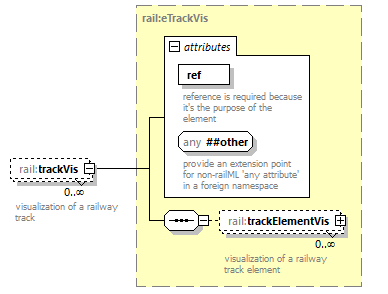 | ||||||||||||||
| namespace | https://www.railml.org/schemas/2021 | ||||||||||||||
| type | rail:eTrackVis | ||||||||||||||
| properties |
| ||||||||||||||
| children | rail:trackElementVis | ||||||||||||||
| attributes |
| ||||||||||||||
| annotation |
| ||||||||||||||
| source | <xs:element name="trackVis" type="rail:eTrackVis" minOccurs="0" maxOccurs="unbounded"> <xs:annotation> <xs:documentation>visualization of a railway track</xs:documentation> <xs:documentation>See https://wiki2.railml.org/wiki/IS:trackVis</xs:documentation> </xs:annotation> </xs:element> |
complexType eLocallyControlledArea
| diagram |  | ||||||||||||||||||||||||||||||||||||||||||||||||||||||||||||||||||||||
| namespace | https://www.railml.org/schemas/2021 | ||||||||||||||||||||||||||||||||||||||||||||||||||||||||||||||||||||||
| type | extension of rail:tLocallyControlledArea | ||||||||||||||||||||||||||||||||||||||||||||||||||||||||||||||||||||||
| properties |
| ||||||||||||||||||||||||||||||||||||||||||||||||||||||||||||||||||||||
| children | rail:additionalName rail:states rail:trackRef rail:controllerRef | ||||||||||||||||||||||||||||||||||||||||||||||||||||||||||||||||||||||
| used by |
| ||||||||||||||||||||||||||||||||||||||||||||||||||||||||||||||||||||||
| attributes |
| ||||||||||||||||||||||||||||||||||||||||||||||||||||||||||||||||||||||
| source | <xs:complexType name="eLocallyControlledArea"> <xs:complexContent> <xs:extension base="rail:tLocallyControlledArea"> <xs:annotation> <xs:documentation>DEPRECATED, please use controller/localOperationArea instead</xs:documentation> </xs:annotation> <xs:sequence> <xs:element name="trackRef" type="rail:tTrackRefInGroup" maxOccurs="unbounded"> <xs:annotation> <xs:documentation>See https://wiki2.railml.org/wiki/IS:trackRef_locallyControlledArea</xs:documentation> </xs:annotation> </xs:element> <xs:element name="controllerRef" type="rail:tElementRefInGroup" minOccurs="0" maxOccurs="unbounded"> <xs:annotation> <xs:documentation>Reference from locally controlled area to a controller.</xs:documentation> <xs:documentation>See https://wiki2.railml.org/wiki/IS:controllerRef_locallyControlledArea</xs:documentation> </xs:annotation> </xs:element> </xs:sequence> </xs:extension> </xs:complexContent> </xs:complexType> |
element eLocallyControlledArea/trackRef
| diagram |  | ||||||||||||||||||||
| namespace | https://www.railml.org/schemas/2021 | ||||||||||||||||||||
| type | rail:tTrackRefInGroup | ||||||||||||||||||||
| properties |
| ||||||||||||||||||||
| attributes |
| ||||||||||||||||||||
| annotation |
| ||||||||||||||||||||
| source | <xs:element name="trackRef" type="rail:tTrackRefInGroup" maxOccurs="unbounded"> <xs:annotation> <xs:documentation>See https://wiki2.railml.org/wiki/IS:trackRef_locallyControlledArea</xs:documentation> </xs:annotation> </xs:element> |
element eLocallyControlledArea/controllerRef
| diagram |  | ||||||||||||||||||||
| namespace | https://www.railml.org/schemas/2021 | ||||||||||||||||||||
| type | rail:tElementRefInGroup | ||||||||||||||||||||
| properties |
| ||||||||||||||||||||
| attributes |
| ||||||||||||||||||||
| annotation |
| ||||||||||||||||||||
| source | <xs:element name="controllerRef" type="rail:tElementRefInGroup" minOccurs="0" maxOccurs="unbounded"> <xs:annotation> <xs:documentation>Reference from locally controlled area to a controller.</xs:documentation> <xs:documentation>See https://wiki2.railml.org/wiki/IS:controllerRef_locallyControlledArea</xs:documentation> </xs:annotation> </xs:element> |
complexType eLocks
| diagram |  | ||
| namespace | https://www.railml.org/schemas/2021 | ||
| children | rail:lock | ||
| used by |
| ||
| source | <xs:complexType name="eLocks"> <xs:sequence> <xs:element name="lock" type="rail:tLock" maxOccurs="unbounded"> <xs:annotation> <xs:documentation>Defines a physical railway infrastructure element used for logical locking connections between switches, derailers, level crossings or other signalling components.</xs:documentation> <xs:documentation>See https://wiki2.railml.org/wiki/IS:lock</xs:documentation> </xs:annotation> </xs:element> </xs:sequence> </xs:complexType> |
element eLocks/lock
| diagram |  | ||||||||||||||||||||||||||||||||||||||||||||||||||||||||||||||||||||||||||||||||||||||||||||||||||||||||||||||||||||
| namespace | https://www.railml.org/schemas/2021 | ||||||||||||||||||||||||||||||||||||||||||||||||||||||||||||||||||||||||||||||||||||||||||||||||||||||||||||||||||||
| type | rail:tLock | ||||||||||||||||||||||||||||||||||||||||||||||||||||||||||||||||||||||||||||||||||||||||||||||||||||||||||||||||||||
| properties |
| ||||||||||||||||||||||||||||||||||||||||||||||||||||||||||||||||||||||||||||||||||||||||||||||||||||||||||||||||||||
| children | rail:additionalName rail:geoCoord rail:states rail:lockedElement | ||||||||||||||||||||||||||||||||||||||||||||||||||||||||||||||||||||||||||||||||||||||||||||||||||||||||||||||||||||
| attributes |
| ||||||||||||||||||||||||||||||||||||||||||||||||||||||||||||||||||||||||||||||||||||||||||||||||||||||||||||||||||||
| annotation |
| ||||||||||||||||||||||||||||||||||||||||||||||||||||||||||||||||||||||||||||||||||||||||||||||||||||||||||||||||||||
| source | <xs:element name="lock" type="rail:tLock" maxOccurs="unbounded"> <xs:annotation> <xs:documentation>Defines a physical railway infrastructure element used for logical locking connections between switches, derailers, level crossings or other signalling components.</xs:documentation> <xs:documentation>See https://wiki2.railml.org/wiki/IS:lock</xs:documentation> </xs:annotation> </xs:element> |
complexType eMileageChanges
| diagram |  | ||
| namespace | https://www.railml.org/schemas/2021 | ||
| children | rail:mileageChange | ||
| used by |
| ||
| source | <xs:complexType name="eMileageChanges"> <xs:sequence> <xs:element name="mileageChange" type="rail:tMileageChange" minOccurs="0" maxOccurs="unbounded"> <xs:annotation> <xs:documentation>Defines the position of a track where metering of mileage changes.</xs:documentation> <xs:documentation>See https://wiki2.railml.org/wiki/IS:mileageChange</xs:documentation> </xs:annotation> </xs:element> </xs:sequence> </xs:complexType> |
element eMileageChanges/mileageChange
| diagram | 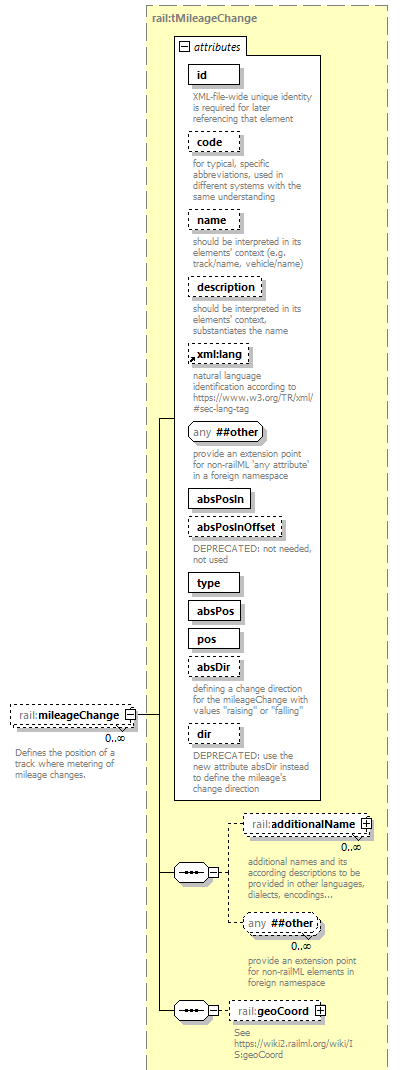 | ||||||||||||||||||||||||||||||||||||||||||||||||||||||||||||||||||||||||||||||||||||||||||||||
| namespace | https://www.railml.org/schemas/2021 | ||||||||||||||||||||||||||||||||||||||||||||||||||||||||||||||||||||||||||||||||||||||||||||||
| type | rail:tMileageChange | ||||||||||||||||||||||||||||||||||||||||||||||||||||||||||||||||||||||||||||||||||||||||||||||
| properties |
| ||||||||||||||||||||||||||||||||||||||||||||||||||||||||||||||||||||||||||||||||||||||||||||||
| children | rail:additionalName rail:geoCoord | ||||||||||||||||||||||||||||||||||||||||||||||||||||||||||||||||||||||||||||||||||||||||||||||
| attributes |
| ||||||||||||||||||||||||||||||||||||||||||||||||||||||||||||||||||||||||||||||||||||||||||||||
| annotation |
| ||||||||||||||||||||||||||||||||||||||||||||||||||||||||||||||||||||||||||||||||||||||||||||||
| source | <xs:element name="mileageChange" type="rail:tMileageChange" minOccurs="0" maxOccurs="unbounded"> <xs:annotation> <xs:documentation>Defines the position of a track where metering of mileage changes.</xs:documentation> <xs:documentation>See https://wiki2.railml.org/wiki/IS:mileageChange</xs:documentation> </xs:annotation> </xs:element> |
complexType eOcp
| diagram |  | ||||||||||||||||||||||||||||||||||||||||||||||||||||||||||||||||||||||||||||||||||||
| namespace | https://www.railml.org/schemas/2021 | ||||||||||||||||||||||||||||||||||||||||||||||||||||||||||||||||||||||||||||||||||||
| type | extension of rail:tOperationControlPoint | ||||||||||||||||||||||||||||||||||||||||||||||||||||||||||||||||||||||||||||||||||||
| properties |
| ||||||||||||||||||||||||||||||||||||||||||||||||||||||||||||||||||||||||||||||||||||
| children | rail:additionalName rail:controllerRef rail:propOperational rail:propService rail:propEquipment rail:propPassengerInfo rail:propOther rail:tsi rail:area rail:geoCoord rail:designator | ||||||||||||||||||||||||||||||||||||||||||||||||||||||||||||||||||||||||||||||||||||
| used by |
| ||||||||||||||||||||||||||||||||||||||||||||||||||||||||||||||||||||||||||||||||||||
| attributes |
| ||||||||||||||||||||||||||||||||||||||||||||||||||||||||||||||||||||||||||||||||||||
| source | <xs:complexType name="eOcp"> <xs:complexContent> <xs:extension base="rail:tOperationControlPoint"> <xs:sequence> <xs:element name="propOperational" type="rail:eOcpPropOperational" minOccurs="0"> <xs:annotation> <xs:documentation>Contains attributes which further refine the operational properties of an ocp.</xs:documentation> <xs:documentation>See https://wiki2.railml.org/wiki/IS:propOperational</xs:documentation> </xs:annotation> </xs:element> <xs:element name="propService" type="rail:tOcpPropService" minOccurs="0"> <xs:annotation> <xs:documentation>Contains attributes which further refine the service properties of an ocp.</xs:documentation> <xs:documentation>See https://wiki2.railml.org/wiki/IS:propService</xs:documentation> </xs:annotation> </xs:element> <xs:element name="propEquipment" type="rail:eOcpPropEquipment" minOccurs="0"> <xs:annotation> <xs:documentation>Encapsulates two variants to define the (technical) equipment of an ocp.</xs:documentation> <xs:documentation>See https://wiki2.railml.org/wiki/IS:propEquipment</xs:documentation> </xs:annotation> </xs:element> <xs:element name="propPassengerInfo" type="rail:eOcpPropPassengerInfo" minOccurs="0"> <xs:annotation> <xs:documentation>Contains properties for passenger information systems.</xs:documentation> <xs:documentation>See https://wiki2.railml.org/wiki/IS:propPassengerInfo_ocp</xs:documentation> </xs:annotation> </xs:element> <xs:element name="propOther" type="rail:eOcpPropOther" minOccurs="0"> <xs:annotation> <xs:documentation>Contains any other properties of an OCP</xs:documentation> <xs:documentation>See https://wiki2.railml.org/wiki/IS:propOther</xs:documentation> </xs:annotation> </xs:element> <xs:element name="tsi" type="rail:tOcpTsi" minOccurs="0"> <xs:annotation> <xs:documentation>DEPRECATED. Use register entry "PrimaryLocationCode" instead.</xs:documentation> <xs:documentation>See https://wiki2.railml.org/wiki/IS:tsi</xs:documentation> </xs:annotation> </xs:element> <xs:element name="area" type="rail:tOcpArea" minOccurs="0"> <xs:annotation> <xs:documentation>Specifies the region, an operation control point is responsible for.</xs:documentation> <xs:documentation>See https://wiki2.railml.org/wiki/IS:area</xs:documentation> </xs:annotation> </xs:element> <xs:element name="geoCoord" type="rail:tGeoCoord" minOccurs="0"> <xs:annotation> <xs:documentation>Provides the definition of a geographical position (e. g. longitude, latitude, altitude).</xs:documentation> <xs:documentation>See https://wiki2.railml.org/wiki/IS:geoCoord</xs:documentation> </xs:annotation> </xs:element> <xs:element name="designator" type="rail:tDesignator" minOccurs="0" maxOccurs="unbounded"> <xs:annotation> <xs:documentation>Allows to enumerate more than one external primary key for one ocp. Such, it defines the mapping from one to another register.</xs:documentation> <xs:documentation>See https://wiki2.railml.org/wiki/IS:designator</xs:documentation> </xs:annotation> </xs:element> </xs:sequence> </xs:extension> </xs:complexContent> </xs:complexType> |
element eOcp/propOperational
| diagram | 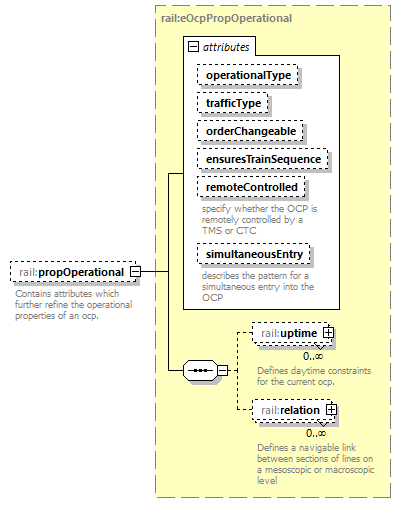 | ||||||||||||||||||||||||||||||||||||||||||||||
| namespace | https://www.railml.org/schemas/2021 | ||||||||||||||||||||||||||||||||||||||||||||||
| type | rail:eOcpPropOperational | ||||||||||||||||||||||||||||||||||||||||||||||
| properties |
| ||||||||||||||||||||||||||||||||||||||||||||||
| children | rail:uptime rail:relation | ||||||||||||||||||||||||||||||||||||||||||||||
| attributes |
| ||||||||||||||||||||||||||||||||||||||||||||||
| annotation |
| ||||||||||||||||||||||||||||||||||||||||||||||
| source | <xs:element name="propOperational" type="rail:eOcpPropOperational" minOccurs="0"> <xs:annotation> <xs:documentation>Contains attributes which further refine the operational properties of an ocp.</xs:documentation> <xs:documentation>See https://wiki2.railml.org/wiki/IS:propOperational</xs:documentation> </xs:annotation> </xs:element> |
element eOcp/propService
| diagram |  | ||||||||||||||||||||||||||||||||||||||||||||||||||||||||||||||||||
| namespace | https://www.railml.org/schemas/2021 | ||||||||||||||||||||||||||||||||||||||||||||||||||||||||||||||||||
| type | rail:tOcpPropService | ||||||||||||||||||||||||||||||||||||||||||||||||||||||||||||||||||
| properties |
| ||||||||||||||||||||||||||||||||||||||||||||||||||||||||||||||||||
| attributes |
| ||||||||||||||||||||||||||||||||||||||||||||||||||||||||||||||||||
| annotation |
| ||||||||||||||||||||||||||||||||||||||||||||||||||||||||||||||||||
| source | <xs:element name="propService" type="rail:tOcpPropService" minOccurs="0"> <xs:annotation> <xs:documentation>Contains attributes which further refine the service properties of an ocp.</xs:documentation> <xs:documentation>See https://wiki2.railml.org/wiki/IS:propService</xs:documentation> </xs:annotation> </xs:element> |
element eOcp/propEquipment
| diagram |  | ||||||
| namespace | https://www.railml.org/schemas/2021 | ||||||
| type | rail:eOcpPropEquipment | ||||||
| properties |
| ||||||
| children | rail:summary rail:trackRef | ||||||
| annotation |
| ||||||
| source | <xs:element name="propEquipment" type="rail:eOcpPropEquipment" minOccurs="0"> <xs:annotation> <xs:documentation>Encapsulates two variants to define the (technical) equipment of an ocp.</xs:documentation> <xs:documentation>See https://wiki2.railml.org/wiki/IS:propEquipment</xs:documentation> </xs:annotation> </xs:element> |
element eOcp/propPassengerInfo
| diagram |  | ||||||
| namespace | https://www.railml.org/schemas/2021 | ||||||
| type | rail:eOcpPropPassengerInfo | ||||||
| properties |
| ||||||
| children | rail:informationArea rail:mediaResources | ||||||
| annotation |
| ||||||
| source | <xs:element name="propPassengerInfo" type="rail:eOcpPropPassengerInfo" minOccurs="0"> <xs:annotation> <xs:documentation>Contains properties for passenger information systems.</xs:documentation> <xs:documentation>See https://wiki2.railml.org/wiki/IS:propPassengerInfo_ocp</xs:documentation> </xs:annotation> </xs:element> |
element eOcp/propOther
| diagram | 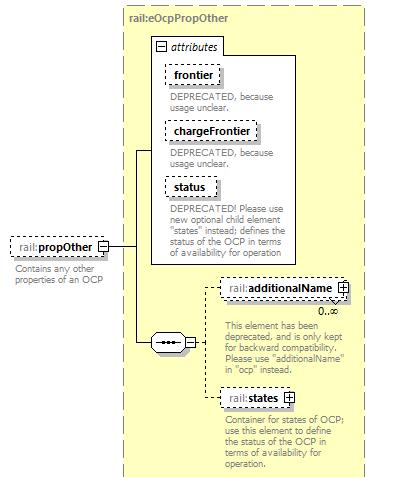 | ||||||||||||||||||||||||||||||
| namespace | https://www.railml.org/schemas/2021 | ||||||||||||||||||||||||||||||
| type | rail:eOcpPropOther | ||||||||||||||||||||||||||||||
| properties |
| ||||||||||||||||||||||||||||||
| children | rail:additionalName rail:states | ||||||||||||||||||||||||||||||
| attributes |
| ||||||||||||||||||||||||||||||
| annotation |
| ||||||||||||||||||||||||||||||
| source | <xs:element name="propOther" type="rail:eOcpPropOther" minOccurs="0"> <xs:annotation> <xs:documentation>Contains any other properties of an OCP</xs:documentation> <xs:documentation>See https://wiki2.railml.org/wiki/IS:propOther</xs:documentation> </xs:annotation> </xs:element> |
element eOcp/tsi
| diagram |  | ||||||||||||||||||||||||
| namespace | https://www.railml.org/schemas/2021 | ||||||||||||||||||||||||
| type | rail:tOcpTsi | ||||||||||||||||||||||||
| properties |
| ||||||||||||||||||||||||
| attributes |
| ||||||||||||||||||||||||
| annotation |
| ||||||||||||||||||||||||
| source | <xs:element name="tsi" type="rail:tOcpTsi" minOccurs="0"> <xs:annotation> <xs:documentation>DEPRECATED. Use register entry "PrimaryLocationCode" instead.</xs:documentation> <xs:documentation>See https://wiki2.railml.org/wiki/IS:tsi</xs:documentation> </xs:annotation> </xs:element> |
element eOcp/area
| diagram |  | ||||||||||||||||||||||||
| namespace | https://www.railml.org/schemas/2021 | ||||||||||||||||||||||||
| type | rail:tOcpArea | ||||||||||||||||||||||||
| properties |
| ||||||||||||||||||||||||
| attributes |
| ||||||||||||||||||||||||
| annotation |
| ||||||||||||||||||||||||
| source | <xs:element name="area" type="rail:tOcpArea" minOccurs="0"> <xs:annotation> <xs:documentation>Specifies the region, an operation control point is responsible for.</xs:documentation> <xs:documentation>See https://wiki2.railml.org/wiki/IS:area</xs:documentation> </xs:annotation> </xs:element> |
element eOcp/geoCoord
| diagram | 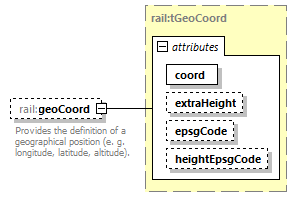 | ||||||||||||||||||||||||||||||
| namespace | https://www.railml.org/schemas/2021 | ||||||||||||||||||||||||||||||
| type | rail:tGeoCoord | ||||||||||||||||||||||||||||||
| properties |
| ||||||||||||||||||||||||||||||
| attributes |
| ||||||||||||||||||||||||||||||
| annotation |
| ||||||||||||||||||||||||||||||
| source | <xs:element name="geoCoord" type="rail:tGeoCoord" minOccurs="0"> <xs:annotation> <xs:documentation>Provides the definition of a geographical position (e. g. longitude, latitude, altitude).</xs:documentation> <xs:documentation>See https://wiki2.railml.org/wiki/IS:geoCoord</xs:documentation> </xs:annotation> </xs:element> |
element eOcp/designator
| diagram |  | ||||||||||||||||||||||||||||||||||||
| namespace | https://www.railml.org/schemas/2021 | ||||||||||||||||||||||||||||||||||||
| type | rail:tDesignator | ||||||||||||||||||||||||||||||||||||
| properties |
| ||||||||||||||||||||||||||||||||||||
| attributes |
| ||||||||||||||||||||||||||||||||||||
| annotation |
| ||||||||||||||||||||||||||||||||||||
| source | <xs:element name="designator" type="rail:tDesignator" minOccurs="0" maxOccurs="unbounded"> <xs:annotation> <xs:documentation>Allows to enumerate more than one external primary key for one ocp. Such, it defines the mapping from one to another register.</xs:documentation> <xs:documentation>See https://wiki2.railml.org/wiki/IS:designator</xs:documentation> </xs:annotation> </xs:element> |
complexType eOcpPropEquipment
| diagram |  | ||
| namespace | https://www.railml.org/schemas/2021 | ||
| children | rail:summary rail:trackRef | ||
| used by |
| ||
| source | <xs:complexType name="eOcpPropEquipment"> <xs:choice> <xs:element name="summary" type="rail:tOcpPropEquipmentSummary"> <xs:annotation> <xs:documentation>Contains attributes which roughly summarize the technical equipment of an ocp.</xs:documentation> <xs:documentation>See https://wiki2.railml.org/wiki/IS:summary</xs:documentation> </xs:annotation> </xs:element> <xs:element name="trackRef" type="rail:tTrackRefInGroup" maxOccurs="unbounded"> <xs:annotation> <xs:documentation>References the tracks which are to be grouped by propEquipment.</xs:documentation> <xs:documentation>See https://wiki2.railml.org/wiki/IS:trackRef_propEquipment</xs:documentation> </xs:annotation> </xs:element> </xs:choice> </xs:complexType> |
element eOcpPropEquipment/summary
| diagram |  | ||||||||||||||||||||||||||||||||||||
| namespace | https://www.railml.org/schemas/2021 | ||||||||||||||||||||||||||||||||||||
| type | rail:tOcpPropEquipmentSummary | ||||||||||||||||||||||||||||||||||||
| properties |
| ||||||||||||||||||||||||||||||||||||
| attributes |
| ||||||||||||||||||||||||||||||||||||
| annotation |
| ||||||||||||||||||||||||||||||||||||
| source | <xs:element name="summary" type="rail:tOcpPropEquipmentSummary"> <xs:annotation> <xs:documentation>Contains attributes which roughly summarize the technical equipment of an ocp.</xs:documentation> <xs:documentation>See https://wiki2.railml.org/wiki/IS:summary</xs:documentation> </xs:annotation> </xs:element> |
element eOcpPropEquipment/trackRef
| diagram |  | ||||||||||||||||||||
| namespace | https://www.railml.org/schemas/2021 | ||||||||||||||||||||
| type | rail:tTrackRefInGroup | ||||||||||||||||||||
| properties |
| ||||||||||||||||||||
| attributes |
| ||||||||||||||||||||
| annotation |
| ||||||||||||||||||||
| source | <xs:element name="trackRef" type="rail:tTrackRefInGroup" maxOccurs="unbounded"> <xs:annotation> <xs:documentation>References the tracks which are to be grouped by propEquipment.</xs:documentation> <xs:documentation>See https://wiki2.railml.org/wiki/IS:trackRef_propEquipment</xs:documentation> </xs:annotation> </xs:element> |
complexType eOcpPropOperational
| diagram |  | ||||||||||||||||||||||||||||||||||||||||||||||
| namespace | https://www.railml.org/schemas/2021 | ||||||||||||||||||||||||||||||||||||||||||||||
| type | extension of rail:tOcpPropOperational | ||||||||||||||||||||||||||||||||||||||||||||||
| properties |
| ||||||||||||||||||||||||||||||||||||||||||||||
| children | rail:uptime rail:relation | ||||||||||||||||||||||||||||||||||||||||||||||
| used by |
| ||||||||||||||||||||||||||||||||||||||||||||||
| attributes |
| ||||||||||||||||||||||||||||||||||||||||||||||
| source | <xs:complexType name="eOcpPropOperational"> <xs:complexContent> <xs:extension base="rail:tOcpPropOperational"> <xs:sequence> <xs:element name="uptime" type="rail:tOcpUptime" minOccurs="0" maxOccurs="unbounded"> <xs:annotation> <xs:documentation>Defines daytime constraints for the current ocp.</xs:documentation> <xs:documentation>See https://wiki2.railml.org/wiki/IS:uptime</xs:documentation> </xs:annotation> </xs:element> <xs:element name="relation" type="rail:tOcpRelation" minOccurs="0" maxOccurs="unbounded"> <xs:annotation> <xs:documentation>Defines a navigable link between sections of lines on a mesoscopic or macroscopic level</xs:documentation> <xs:documentation>See https://wiki2.railml.org/wiki/IS:relation</xs:documentation> </xs:annotation> </xs:element> </xs:sequence> </xs:extension> </xs:complexContent> </xs:complexType> |
element eOcpPropOperational/uptime
| diagram |  | ||||||||||||||||||||||||||||||||||||||||||||
| namespace | https://www.railml.org/schemas/2021 | ||||||||||||||||||||||||||||||||||||||||||||
| type | rail:tOcpUptime | ||||||||||||||||||||||||||||||||||||||||||||
| properties |
| ||||||||||||||||||||||||||||||||||||||||||||
| attributes |
| ||||||||||||||||||||||||||||||||||||||||||||
| annotation |
| ||||||||||||||||||||||||||||||||||||||||||||
| source | <xs:element name="uptime" type="rail:tOcpUptime" minOccurs="0" maxOccurs="unbounded"> <xs:annotation> <xs:documentation>Defines daytime constraints for the current ocp.</xs:documentation> <xs:documentation>See https://wiki2.railml.org/wiki/IS:uptime</xs:documentation> </xs:annotation> </xs:element> |
element eOcpPropOperational/relation
| diagram |  | ||||||||||||||||||||||
| namespace | https://www.railml.org/schemas/2021 | ||||||||||||||||||||||
| type | rail:tOcpRelation | ||||||||||||||||||||||
| properties |
| ||||||||||||||||||||||
| children | rail:from rail:to rail:averageDelayTime | ||||||||||||||||||||||
| attributes |
| ||||||||||||||||||||||
| annotation |
| ||||||||||||||||||||||
| source | <xs:element name="relation" type="rail:tOcpRelation" minOccurs="0" maxOccurs="unbounded"> <xs:annotation> <xs:documentation>Defines a navigable link between sections of lines on a mesoscopic or macroscopic level</xs:documentation> <xs:documentation>See https://wiki2.railml.org/wiki/IS:relation</xs:documentation> </xs:annotation> </xs:element> |
complexType eOcpPropOther
| diagram |  | ||||||||||||||||||||||||||||||
| namespace | https://www.railml.org/schemas/2021 | ||||||||||||||||||||||||||||||
| type | extension of rail:tOcpPropOther | ||||||||||||||||||||||||||||||
| properties |
| ||||||||||||||||||||||||||||||
| children | rail:additionalName rail:states | ||||||||||||||||||||||||||||||
| used by |
| ||||||||||||||||||||||||||||||
| attributes |
| ||||||||||||||||||||||||||||||
| source | <xs:complexType name="eOcpPropOther"> <xs:complexContent> <xs:extension base="rail:tOcpPropOther"> <xs:sequence> <xs:element name="additionalName" type="rail:tOcpAdditionalName" minOccurs="0" maxOccurs="unbounded"> <xs:annotation> <xs:documentation>This element has been deprecated, and is only kept for backward compatibility. Please use "additionalName" in "ocp" instead.</xs:documentation> <xs:documentation>See https://wiki2.railml.org/wiki/IS:additionalName_propOther</xs:documentation> </xs:annotation> </xs:element> <xs:element name="states" type="rail:tStates" minOccurs="0"> <xs:annotation> <xs:documentation>Container for states of OCP; use this element to define the status of the OCP in terms of availability for operation.</xs:documentation> <xs:documentation>See https://wiki2.railml.org/wiki/IS:states</xs:documentation> </xs:annotation> </xs:element> </xs:sequence> </xs:extension> </xs:complexContent> </xs:complexType> |
element eOcpPropOther/additionalName
| diagram |  | ||||||||||||||||||||||||||||||
| namespace | https://www.railml.org/schemas/2021 | ||||||||||||||||||||||||||||||
| type | rail:tOcpAdditionalName | ||||||||||||||||||||||||||||||
| properties |
| ||||||||||||||||||||||||||||||
| attributes |
| ||||||||||||||||||||||||||||||
| annotation |
| ||||||||||||||||||||||||||||||
| source | <xs:element name="additionalName" type="rail:tOcpAdditionalName" minOccurs="0" maxOccurs="unbounded"> <xs:annotation> <xs:documentation>This element has been deprecated, and is only kept for backward compatibility. Please use "additionalName" in "ocp" instead.</xs:documentation> <xs:documentation>See https://wiki2.railml.org/wiki/IS:additionalName_propOther</xs:documentation> </xs:annotation> </xs:element> |
element eOcpPropOther/states
| diagram | 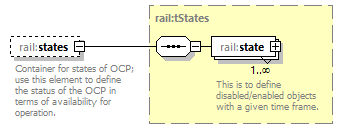 | ||||||
| namespace | https://www.railml.org/schemas/2021 | ||||||
| type | rail:tStates | ||||||
| properties |
| ||||||
| children | rail:state | ||||||
| annotation |
| ||||||
| source | <xs:element name="states" type="rail:tStates" minOccurs="0"> <xs:annotation> <xs:documentation>Container for states of OCP; use this element to define the status of the OCP in terms of availability for operation.</xs:documentation> <xs:documentation>See https://wiki2.railml.org/wiki/IS:states</xs:documentation> </xs:annotation> </xs:element> |
complexType eOcpPropPassengerInfo
| diagram |  | ||
| namespace | https://www.railml.org/schemas/2021 | ||
| children | rail:informationArea rail:mediaResources | ||
| used by |
| ||
| source | <xs:complexType name="eOcpPropPassengerInfo"> <xs:sequence> <xs:element name="informationArea" type="rail:tInformationArea" minOccurs="0" maxOccurs="unbounded"> <xs:annotation> <xs:documentation>An area (linked with an OCP) to be referred to by timetable when describing the passenger info behaviour.</xs:documentation> <xs:documentation>Information areas can be used for describing how passenger information is triggered to be shown to the passenger when travelling from and to an OCP.</xs:documentation> <xs:documentation>See https://wiki2.railml.org/wiki/IS:informationArea</xs:documentation> </xs:annotation> </xs:element> <xs:element name="mediaResources" type="rail:tMediaResources" minOccurs="0"> <xs:annotation> <xs:documentation>Container for media resources connected with the infrastructure element such as announcement or special text fragments. Theses fragments are usually used to replace placeholders in announcements or special texts.</xs:documentation> <xs:documentation>See https://wiki2.railml.org/wiki/IS:mediaResources</xs:documentation> </xs:annotation> </xs:element> </xs:sequence> </xs:complexType> |
element eOcpPropPassengerInfo/informationArea
| diagram |  | ||||||||||||||
| namespace | https://www.railml.org/schemas/2021 | ||||||||||||||
| type | rail:tInformationArea | ||||||||||||||
| properties |
| ||||||||||||||
| attributes |
| ||||||||||||||
| annotation |
| ||||||||||||||
| source | <xs:element name="informationArea" type="rail:tInformationArea" minOccurs="0" maxOccurs="unbounded"> <xs:annotation> <xs:documentation>An area (linked with an OCP) to be referred to by timetable when describing the passenger info behaviour.</xs:documentation> <xs:documentation>Information areas can be used for describing how passenger information is triggered to be shown to the passenger when travelling from and to an OCP.</xs:documentation> <xs:documentation>See https://wiki2.railml.org/wiki/IS:informationArea</xs:documentation> </xs:annotation> </xs:element> |
element eOcpPropPassengerInfo/mediaResources
| diagram | 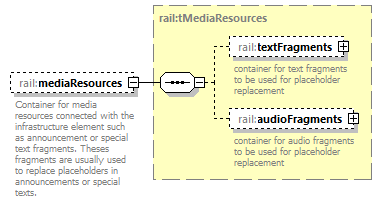 | ||||||
| namespace | https://www.railml.org/schemas/2021 | ||||||
| type | rail:tMediaResources | ||||||
| properties |
| ||||||
| children | rail:textFragments rail:audioFragments | ||||||
| annotation |
| ||||||
| source | <xs:element name="mediaResources" type="rail:tMediaResources" minOccurs="0"> <xs:annotation> <xs:documentation>Container for media resources connected with the infrastructure element such as announcement or special text fragments. Theses fragments are usually used to replace placeholders in announcements or special texts.</xs:documentation> <xs:documentation>See https://wiki2.railml.org/wiki/IS:mediaResources</xs:documentation> </xs:annotation> </xs:element> |
complexType eOcpVis
| diagram | 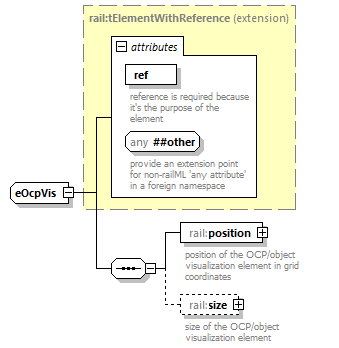 | ||||||||||||||
| namespace | https://www.railml.org/schemas/2021 | ||||||||||||||
| type | extension of rail:tElementWithReference | ||||||||||||||
| properties |
| ||||||||||||||
| children | rail:position rail:size | ||||||||||||||
| used by |
| ||||||||||||||
| attributes |
| ||||||||||||||
| source | <xs:complexType name="eOcpVis"> <xs:complexContent> <xs:extension base="rail:tElementWithReference"> <xs:sequence> <xs:element name="position" type="rail:tPoint"> <xs:annotation> <xs:documentation>position of the OCP/object visualization element in grid coordinates</xs:documentation> <xs:documentation>See https://wiki2.railml.org/wiki/IS:position_ocpVis</xs:documentation> </xs:annotation> </xs:element> <xs:element name="size" type="rail:tSize" minOccurs="0"> <xs:annotation> <xs:documentation>size of the OCP/object visualization element</xs:documentation> <xs:documentation>See https://wiki2.railml.org/wiki/IS:size</xs:documentation> </xs:annotation> </xs:element> </xs:sequence> </xs:extension> </xs:complexContent> </xs:complexType> |
element eOcpVis/position
| diagram |  | ||||||||||||||||||
| namespace | https://www.railml.org/schemas/2021 | ||||||||||||||||||
| type | rail:tPoint | ||||||||||||||||||
| properties |
| ||||||||||||||||||
| attributes |
| ||||||||||||||||||
| annotation |
| ||||||||||||||||||
| source | <xs:element name="position" type="rail:tPoint"> <xs:annotation> <xs:documentation>position of the OCP/object visualization element in grid coordinates</xs:documentation> <xs:documentation>See https://wiki2.railml.org/wiki/IS:position_ocpVis</xs:documentation> </xs:annotation> </xs:element> |
element eOcpVis/size
| diagram |  | ||||||||||||||||||
| namespace | https://www.railml.org/schemas/2021 | ||||||||||||||||||
| type | rail:tSize | ||||||||||||||||||
| properties |
| ||||||||||||||||||
| attributes |
| ||||||||||||||||||
| annotation |
| ||||||||||||||||||
| source | <xs:element name="size" type="rail:tSize" minOccurs="0"> <xs:annotation> <xs:documentation>size of the OCP/object visualization element</xs:documentation> <xs:documentation>See https://wiki2.railml.org/wiki/IS:size</xs:documentation> </xs:annotation> </xs:element> |
complexType eOcsElements
| diagram |  | ||
| namespace | https://www.railml.org/schemas/2021 | ||
| children | rail:signals rail:trainDetectionElements rail:balises rail:trainProtectionElements rail:stopPosts rail:derailers rail:trainRadioChanges rail:locks | ||
| used by |
| ||
| source | <xs:complexType name="eOcsElements"> <xs:sequence> <xs:element name="signals" type="rail:eSignals" minOccurs="0"> <xs:annotation> <xs:documentation>Groups all signal elements.</xs:documentation> <xs:documentation>See https://wiki2.railml.org/wiki/IS:signals</xs:documentation> </xs:annotation> </xs:element> <xs:element name="trainDetectionElements" type="rail:eTrainDetectionElements" minOccurs="0"> <xs:annotation> <xs:documentation>Groups various track-side sensor elements.</xs:documentation> <xs:documentation>See https://wiki2.railml.org/wiki/IS:trainDetectionElements</xs:documentation> </xs:annotation> </xs:element> <xs:element name="balises" type="rail:eBalises" minOccurs="0"> <xs:annotation> <xs:documentation>Groups all balise and balise group elements.</xs:documentation> <xs:documentation>See https://wiki2.railml.org/wiki/IS:balises</xs:documentation> </xs:annotation> </xs:element> <xs:element name="trainProtectionElements" type="rail:eTrainProtectionElements" minOccurs="0"> <xs:annotation> <xs:documentation>Groups all train protection elements.</xs:documentation> <xs:documentation>See https://wiki2.railml.org/wiki/IS:trainProtectionElements</xs:documentation> </xs:annotation> </xs:element> <xs:element name="stopPosts" type="rail:eStopPosts" minOccurs="0"> <xs:annotation> <xs:documentation>Groups stopPost elements.</xs:documentation> <xs:documentation>See https://wiki2.railml.org/wiki/IS:stopPosts</xs:documentation> </xs:annotation> </xs:element> <xs:element name="derailers" type="rail:eDerailers" minOccurs="0"> <xs:annotation> <xs:documentation>Groups derailer elements.</xs:documentation> <xs:documentation>See https://wiki2.railml.org/wiki/IS:derailers</xs:documentation> </xs:annotation> </xs:element> <xs:element name="trainRadioChanges" type="rail:eTrainRadioChanges" minOccurs="0"> <xs:annotation> <xs:documentation>Groups trainRadioChange elements.</xs:documentation> <xs:documentation>See https://wiki2.railml.org/wiki/IS:trainRadioChanges</xs:documentation> </xs:annotation> </xs:element> <xs:element name="locks" type="rail:eLocks" minOccurs="0"> <xs:annotation> <xs:documentation>Groups lock elements.</xs:documentation> <xs:documentation>See https://wiki2.railml.org/wiki/IS:locks</xs:documentation> </xs:annotation> </xs:element> <xs:any namespace="##other" processContents="strict" minOccurs="0" maxOccurs="unbounded"> <xs:annotation> <xs:documentation>Provide an extension point for non-railML elements in foreign namespace.</xs:documentation> </xs:annotation> </xs:any> </xs:sequence> </xs:complexType> |
element eOcsElements/signals
| diagram |  | ||||||
| namespace | https://www.railml.org/schemas/2021 | ||||||
| type | rail:eSignals | ||||||
| properties |
| ||||||
| children | rail:signal rail:signalGroups | ||||||
| annotation |
| ||||||
| source | <xs:element name="signals" type="rail:eSignals" minOccurs="0"> <xs:annotation> <xs:documentation>Groups all signal elements.</xs:documentation> <xs:documentation>See https://wiki2.railml.org/wiki/IS:signals</xs:documentation> </xs:annotation> </xs:element> |
element eOcsElements/trainDetectionElements
| diagram |  | ||||||
| namespace | https://www.railml.org/schemas/2021 | ||||||
| type | rail:eTrainDetectionElements | ||||||
| properties |
| ||||||
| children | rail:trainDetector rail:trackCircuitBorder | ||||||
| annotation |
| ||||||
| source | <xs:element name="trainDetectionElements" type="rail:eTrainDetectionElements" minOccurs="0"> <xs:annotation> <xs:documentation>Groups various track-side sensor elements.</xs:documentation> <xs:documentation>See https://wiki2.railml.org/wiki/IS:trainDetectionElements</xs:documentation> </xs:annotation> </xs:element> |
element eOcsElements/balises
| diagram |  | ||||||
| namespace | https://www.railml.org/schemas/2021 | ||||||
| type | rail:eBalises | ||||||
| properties |
| ||||||
| children | rail:balise rail:baliseGroup | ||||||
| annotation |
| ||||||
| source | <xs:element name="balises" type="rail:eBalises" minOccurs="0"> <xs:annotation> <xs:documentation>Groups all balise and balise group elements.</xs:documentation> <xs:documentation>See https://wiki2.railml.org/wiki/IS:balises</xs:documentation> </xs:annotation> </xs:element> |
element eOcsElements/trainProtectionElements
| diagram |  | ||||||
| namespace | https://www.railml.org/schemas/2021 | ||||||
| type | rail:eTrainProtectionElements | ||||||
| properties |
| ||||||
| children | rail:trainProtectionElement rail:trainProtectionElementGroup | ||||||
| annotation |
| ||||||
| source | <xs:element name="trainProtectionElements" type="rail:eTrainProtectionElements" minOccurs="0"> <xs:annotation> <xs:documentation>Groups all train protection elements.</xs:documentation> <xs:documentation>See https://wiki2.railml.org/wiki/IS:trainProtectionElements</xs:documentation> </xs:annotation> </xs:element> |
element eOcsElements/stopPosts
| diagram |  | ||||||
| namespace | https://www.railml.org/schemas/2021 | ||||||
| type | rail:eStopPosts | ||||||
| properties |
| ||||||
| children | rail:stopPost | ||||||
| annotation |
| ||||||
| source | <xs:element name="stopPosts" type="rail:eStopPosts" minOccurs="0"> <xs:annotation> <xs:documentation>Groups stopPost elements.</xs:documentation> <xs:documentation>See https://wiki2.railml.org/wiki/IS:stopPosts</xs:documentation> </xs:annotation> </xs:element> |
element eOcsElements/derailers
| diagram |  | ||||||
| namespace | https://www.railml.org/schemas/2021 | ||||||
| type | rail:eDerailers | ||||||
| properties |
| ||||||
| children | rail:derailer | ||||||
| annotation |
| ||||||
| source | <xs:element name="derailers" type="rail:eDerailers" minOccurs="0"> <xs:annotation> <xs:documentation>Groups derailer elements.</xs:documentation> <xs:documentation>See https://wiki2.railml.org/wiki/IS:derailers</xs:documentation> </xs:annotation> </xs:element> |
element eOcsElements/trainRadioChanges
| diagram |  | ||||||
| namespace | https://www.railml.org/schemas/2021 | ||||||
| type | rail:eTrainRadioChanges | ||||||
| properties |
| ||||||
| children | rail:trainRadioChange | ||||||
| annotation |
| ||||||
| source | <xs:element name="trainRadioChanges" type="rail:eTrainRadioChanges" minOccurs="0"> <xs:annotation> <xs:documentation>Groups trainRadioChange elements.</xs:documentation> <xs:documentation>See https://wiki2.railml.org/wiki/IS:trainRadioChanges</xs:documentation> </xs:annotation> </xs:element> |
element eOcsElements/locks
| diagram |  | ||||||
| namespace | https://www.railml.org/schemas/2021 | ||||||
| type | rail:eLocks | ||||||
| properties |
| ||||||
| children | rail:lock | ||||||
| annotation |
| ||||||
| source | <xs:element name="locks" type="rail:eLocks" minOccurs="0"> <xs:annotation> <xs:documentation>Groups lock elements.</xs:documentation> <xs:documentation>See https://wiki2.railml.org/wiki/IS:locks</xs:documentation> </xs:annotation> </xs:element> |
complexType eOperatingRules
| diagram |  | ||
| namespace | https://www.railml.org/schemas/2021 | ||
| children | rail:operatingRule | ||
| used by |
| ||
| annotation |
| ||
| source | <xs:complexType name="eOperatingRules"> <xs:annotation> <xs:documentation>Only special operating rules that differ from the generic rule book and apply for specific physical objects are mapped. The generic rule book shall not be mapped here.</xs:documentation> </xs:annotation> <xs:sequence> <xs:element name="operatingRule" type="rail:tOperatingRule" maxOccurs="unbounded"> <xs:annotation> <xs:documentation>Defines a special order of operation that deviates from the general order.</xs:documentation> <xs:documentation>See https://wiki2.railml.org/wiki/IS:operatingRule</xs:documentation> </xs:annotation> </xs:element> </xs:sequence> </xs:complexType> |
element eOperatingRules/operatingRule
| diagram |  | ||||||||||||||||||||||||||||||||||||||||||||||
| namespace | https://www.railml.org/schemas/2021 | ||||||||||||||||||||||||||||||||||||||||||||||
| type | rail:tOperatingRule | ||||||||||||||||||||||||||||||||||||||||||||||
| properties |
| ||||||||||||||||||||||||||||||||||||||||||||||
| children | rail:additionalName rail:childRule rail:objectRef | ||||||||||||||||||||||||||||||||||||||||||||||
| attributes |
| ||||||||||||||||||||||||||||||||||||||||||||||
| annotation |
| ||||||||||||||||||||||||||||||||||||||||||||||
| source | <xs:element name="operatingRule" type="rail:tOperatingRule" maxOccurs="unbounded"> <xs:annotation> <xs:documentation>Defines a special order of operation that deviates from the general order.</xs:documentation> <xs:documentation>See https://wiki2.railml.org/wiki/IS:operatingRule</xs:documentation> </xs:annotation> </xs:element> |
complexType eOperationControlPoints
| diagram |  | ||
| namespace | https://www.railml.org/schemas/2021 | ||
| children | rail:ocp | ||
| used by |
| ||
| source | <xs:complexType name="eOperationControlPoints"> <xs:sequence> <xs:element name="ocp" type="rail:eOcp" maxOccurs="unbounded"> <xs:annotation> <xs:documentation>Defines operational or time measurement points of a railway network in the general sense required by the timetable of a train.</xs:documentation> <xs:documentation>See https://wiki2.railml.org/wiki/IS:ocp</xs:documentation> </xs:annotation> </xs:element> </xs:sequence> </xs:complexType> |
element eOperationControlPoints/ocp
| diagram |  | ||||||||||||||||||||||||||||||||||||||||||||||||||||||||||||||||||||||||||||||||||||
| namespace | https://www.railml.org/schemas/2021 | ||||||||||||||||||||||||||||||||||||||||||||||||||||||||||||||||||||||||||||||||||||
| type | rail:eOcp | ||||||||||||||||||||||||||||||||||||||||||||||||||||||||||||||||||||||||||||||||||||
| properties |
| ||||||||||||||||||||||||||||||||||||||||||||||||||||||||||||||||||||||||||||||||||||
| children | rail:additionalName rail:controllerRef rail:propOperational rail:propService rail:propEquipment rail:propPassengerInfo rail:propOther rail:tsi rail:area rail:geoCoord rail:designator | ||||||||||||||||||||||||||||||||||||||||||||||||||||||||||||||||||||||||||||||||||||
| attributes |
| ||||||||||||||||||||||||||||||||||||||||||||||||||||||||||||||||||||||||||||||||||||
| annotation |
| ||||||||||||||||||||||||||||||||||||||||||||||||||||||||||||||||||||||||||||||||||||
| source | <xs:element name="ocp" type="rail:eOcp" maxOccurs="unbounded"> <xs:annotation> <xs:documentation>Defines operational or time measurement points of a railway network in the general sense required by the timetable of a train.</xs:documentation> <xs:documentation>See https://wiki2.railml.org/wiki/IS:ocp</xs:documentation> </xs:annotation> </xs:element> |
complexType eOperationModeChanges
| diagram |  | ||
| namespace | https://www.railml.org/schemas/2021 | ||
| children | rail:operationModeChange | ||
| used by |
| ||
| source | <xs:complexType name="eOperationModeChanges"> <xs:sequence> <xs:element name="operationModeChange" type="rail:tOperationModeChange" minOccurs="0" maxOccurs="unbounded"> <xs:annotation> <xs:documentation>Defines a point in which the operation mode (executive / legislative) of an operation control point changes.</xs:documentation> <xs:documentation>See https://wiki2.railml.org/wiki/IS:operationModeChange</xs:documentation> </xs:annotation> </xs:element> </xs:sequence> </xs:complexType> |
element eOperationModeChanges/operationModeChange
| diagram |  | ||||||||||||||||||||||||||||||||||||||||||||||||||||||||||||||||||||||||||||||||||||||||||||||||
| namespace | https://www.railml.org/schemas/2021 | ||||||||||||||||||||||||||||||||||||||||||||||||||||||||||||||||||||||||||||||||||||||||||||||||
| type | rail:tOperationModeChange | ||||||||||||||||||||||||||||||||||||||||||||||||||||||||||||||||||||||||||||||||||||||||||||||||
| properties |
| ||||||||||||||||||||||||||||||||||||||||||||||||||||||||||||||||||||||||||||||||||||||||||||||||
| children | rail:additionalName rail:geoCoord rail:states | ||||||||||||||||||||||||||||||||||||||||||||||||||||||||||||||||||||||||||||||||||||||||||||||||
| attributes |
| ||||||||||||||||||||||||||||||||||||||||||||||||||||||||||||||||||||||||||||||||||||||||||||||||
| annotation |
| ||||||||||||||||||||||||||||||||||||||||||||||||||||||||||||||||||||||||||||||||||||||||||||||||
| source | <xs:element name="operationModeChange" type="rail:tOperationModeChange" minOccurs="0" maxOccurs="unbounded"> <xs:annotation> <xs:documentation>Defines a point in which the operation mode (executive / legislative) of an operation control point changes.</xs:documentation> <xs:documentation>See https://wiki2.railml.org/wiki/IS:operationModeChange</xs:documentation> </xs:annotation> </xs:element> |
complexType eOwnerChanges
| diagram |  | ||
| namespace | https://www.railml.org/schemas/2021 | ||
| children | rail:ownerChange | ||
| used by |
| ||
| source | <xs:complexType name="eOwnerChanges"> <xs:sequence> <xs:element name="ownerChange" type="rail:tOwnerChange" minOccurs="0" maxOccurs="unbounded"> <xs:annotation> <xs:documentation>Defines a point in which the ownership of an infrastructure element changes.</xs:documentation> <xs:documentation>See https://wiki2.railml.org/wiki/IS:ownerChange</xs:documentation> </xs:annotation> </xs:element> </xs:sequence> </xs:complexType> |
element eOwnerChanges/ownerChange
| diagram |  | ||||||||||||||||||||||||||||||||||||||||||||||||||||||||||||||||||||||||||||||||||||||||||||||||||||
| namespace | https://www.railml.org/schemas/2021 | ||||||||||||||||||||||||||||||||||||||||||||||||||||||||||||||||||||||||||||||||||||||||||||||||||||
| type | rail:tOwnerChange | ||||||||||||||||||||||||||||||||||||||||||||||||||||||||||||||||||||||||||||||||||||||||||||||||||||
| properties |
| ||||||||||||||||||||||||||||||||||||||||||||||||||||||||||||||||||||||||||||||||||||||||||||||||||||
| children | rail:additionalName rail:geoCoord rail:states | ||||||||||||||||||||||||||||||||||||||||||||||||||||||||||||||||||||||||||||||||||||||||||||||||||||
| attributes |
| ||||||||||||||||||||||||||||||||||||||||||||||||||||||||||||||||||||||||||||||||||||||||||||||||||||
| annotation |
| ||||||||||||||||||||||||||||||||||||||||||||||||||||||||||||||||||||||||||||||||||||||||||||||||||||
| source | <xs:element name="ownerChange" type="rail:tOwnerChange" minOccurs="0" maxOccurs="unbounded"> <xs:annotation> <xs:documentation>Defines a point in which the ownership of an infrastructure element changes.</xs:documentation> <xs:documentation>See https://wiki2.railml.org/wiki/IS:ownerChange</xs:documentation> </xs:annotation> </xs:element> |
complexType ePlatformEdges
| diagram | 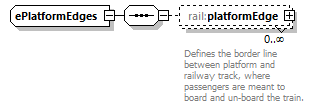 | ||
| namespace | https://www.railml.org/schemas/2021 | ||
| children | rail:platformEdge | ||
| used by |
| ||
| source | <xs:complexType name="ePlatformEdges"> <xs:sequence> <xs:element name="platformEdge" type="rail:tPlatformEdge" minOccurs="0" maxOccurs="unbounded"> <xs:annotation> <xs:documentation>Defines the border line between platform and railway track, where passengers are meant to board and un-board the train.</xs:documentation> <xs:documentation>See https://wiki2.railml.org/wiki/IS:platformEdge</xs:documentation> </xs:annotation> </xs:element> </xs:sequence> </xs:complexType> |
element ePlatformEdges/platformEdge
| diagram |  | ||||||||||||||||||||||||||||||||||||||||||||||||||||||||||||||||||||||||||||||||||||||||||||||||||||||||||||||||||||||
| namespace | https://www.railml.org/schemas/2021 | ||||||||||||||||||||||||||||||||||||||||||||||||||||||||||||||||||||||||||||||||||||||||||||||||||||||||||||||||||||||
| type | rail:tPlatformEdge | ||||||||||||||||||||||||||||||||||||||||||||||||||||||||||||||||||||||||||||||||||||||||||||||||||||||||||||||||||||||
| properties |
| ||||||||||||||||||||||||||||||||||||||||||||||||||||||||||||||||||||||||||||||||||||||||||||||||||||||||||||||||||||||
| children | rail:additionalName rail:geoCoord rail:states rail:propPassengerInfo | ||||||||||||||||||||||||||||||||||||||||||||||||||||||||||||||||||||||||||||||||||||||||||||||||||||||||||||||||||||||
| attributes |
| ||||||||||||||||||||||||||||||||||||||||||||||||||||||||||||||||||||||||||||||||||||||||||||||||||||||||||||||||||||||
| annotation |
| ||||||||||||||||||||||||||||||||||||||||||||||||||||||||||||||||||||||||||||||||||||||||||||||||||||||||||||||||||||||
| source | <xs:element name="platformEdge" type="rail:tPlatformEdge" minOccurs="0" maxOccurs="unbounded"> <xs:annotation> <xs:documentation>Defines the border line between platform and railway track, where passengers are meant to board and un-board the train.</xs:documentation> <xs:documentation>See https://wiki2.railml.org/wiki/IS:platformEdge</xs:documentation> </xs:annotation> </xs:element> |
complexType ePowerTransmissionChanges
| diagram |  | ||
| namespace | https://www.railml.org/schemas/2021 | ||
| children | rail:powerTransmissionChange | ||
| used by |
| ||
| source | <xs:complexType name="ePowerTransmissionChanges"> <xs:sequence> <xs:element name="powerTransmissionChange" type="rail:tPowerTransmissionChange" minOccurs="0" maxOccurs="unbounded"> <xs:annotation> <xs:documentation>Defines a point in which the method of power from the traction vehicle to the track changes.</xs:documentation> <xs:documentation>See https://wiki2.railml.org/wiki/IS:powerTransmissionChange</xs:documentation> </xs:annotation> </xs:element> </xs:sequence> </xs:complexType> |
element ePowerTransmissionChanges/powerTransmissionChange
| diagram | 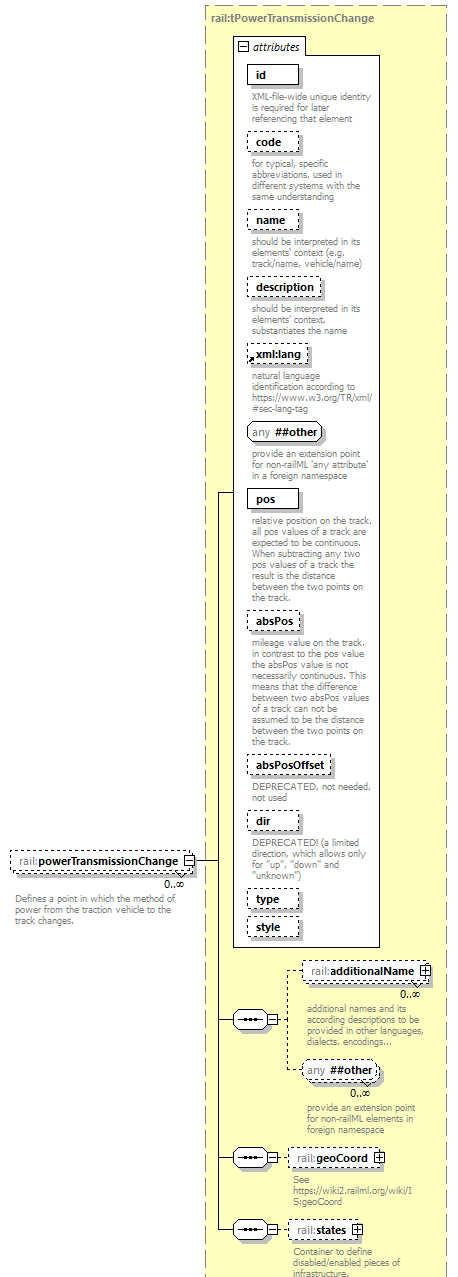 | ||||||||||||||||||||||||||||||||||||||||||||||||||||||||||||||||||||||||||||||||||||||||||
| namespace | https://www.railml.org/schemas/2021 | ||||||||||||||||||||||||||||||||||||||||||||||||||||||||||||||||||||||||||||||||||||||||||
| type | rail:tPowerTransmissionChange | ||||||||||||||||||||||||||||||||||||||||||||||||||||||||||||||||||||||||||||||||||||||||||
| properties |
| ||||||||||||||||||||||||||||||||||||||||||||||||||||||||||||||||||||||||||||||||||||||||||
| children | rail:additionalName rail:geoCoord rail:states | ||||||||||||||||||||||||||||||||||||||||||||||||||||||||||||||||||||||||||||||||||||||||||
| attributes |
| ||||||||||||||||||||||||||||||||||||||||||||||||||||||||||||||||||||||||||||||||||||||||||
| annotation |
| ||||||||||||||||||||||||||||||||||||||||||||||||||||||||||||||||||||||||||||||||||||||||||
| source | <xs:element name="powerTransmissionChange" type="rail:tPowerTransmissionChange" minOccurs="0" maxOccurs="unbounded"> <xs:annotation> <xs:documentation>Defines a point in which the method of power from the traction vehicle to the track changes.</xs:documentation> <xs:documentation>See https://wiki2.railml.org/wiki/IS:powerTransmissionChange</xs:documentation> </xs:annotation> </xs:element> |
complexType eRadiusChanges
| diagram |  | ||
| namespace | https://www.railml.org/schemas/2021 | ||
| children | rail:radiusChange | ||
| used by |
| ||
| source | <xs:complexType name="eRadiusChanges"> <xs:sequence> <xs:element name="radiusChange" type="rail:tRadiusChange" minOccurs="0" maxOccurs="unbounded"> <xs:annotation> <xs:documentation>Defines a change of the radius and and/or superelevation on a track.</xs:documentation> <xs:documentation>See https://wiki2.railml.org/wiki/IS:radiusChange</xs:documentation> </xs:annotation> </xs:element> </xs:sequence> </xs:complexType> |
element eRadiusChanges/radiusChange
| diagram |  | ||||||||||||||||||||||||||||||||||||||||||||||||||||||||||||||||||||||||||||||||||||||||||||||||||||||
| namespace | https://www.railml.org/schemas/2021 | ||||||||||||||||||||||||||||||||||||||||||||||||||||||||||||||||||||||||||||||||||||||||||||||||||||||
| type | rail:tRadiusChange | ||||||||||||||||||||||||||||||||||||||||||||||||||||||||||||||||||||||||||||||||||||||||||||||||||||||
| properties |
| ||||||||||||||||||||||||||||||||||||||||||||||||||||||||||||||||||||||||||||||||||||||||||||||||||||||
| children | rail:additionalName rail:geoCoord rail:states | ||||||||||||||||||||||||||||||||||||||||||||||||||||||||||||||||||||||||||||||||||||||||||||||||||||||
| attributes |
| ||||||||||||||||||||||||||||||||||||||||||||||||||||||||||||||||||||||||||||||||||||||||||||||||||||||
| annotation |
| ||||||||||||||||||||||||||||||||||||||||||||||||||||||||||||||||||||||||||||||||||||||||||||||||||||||
| source | <xs:element name="radiusChange" type="rail:tRadiusChange" minOccurs="0" maxOccurs="unbounded"> <xs:annotation> <xs:documentation>Defines a change of the radius and and/or superelevation on a track.</xs:documentation> <xs:documentation>See https://wiki2.railml.org/wiki/IS:radiusChange</xs:documentation> </xs:annotation> </xs:element> |
complexType eRoutes
| diagram |  | ||||
| namespace | https://www.railml.org/schemas/2021 | ||||
| children | rail:route | ||||
| used by |
| ||||
| annotation |
| ||||
| source | <xs:complexType name="eRoutes"> <xs:annotation> <xs:documentation>Container for routes as a subelement of infrastructure.</xs:documentation> <xs:documentation>See https://wiki2.railml.org/wiki/IS:infrastructure</xs:documentation> </xs:annotation> <xs:sequence> <xs:element name="route" type="rail:tRoute" maxOccurs="unbounded"> <xs:annotation> <xs:documentation>Defines a predetermined path for a traffic movement. It is a central element to ensure traffic safety in railway networks.</xs:documentation> <xs:documentation>See https://wiki2.railml.org/wiki/IS:route</xs:documentation> </xs:annotation> </xs:element> </xs:sequence> </xs:complexType> |
element eRoutes/route
| diagram |  | ||||||||||||||||||||||||||||||||||||||||||||||||||||||||||||||||||||||||||||||||||||||||||||||||||||||||||||||||||||||||||||||||||||||
| namespace | https://www.railml.org/schemas/2021 | ||||||||||||||||||||||||||||||||||||||||||||||||||||||||||||||||||||||||||||||||||||||||||||||||||||||||||||||||||||||||||||||||||||||
| type | rail:tRoute | ||||||||||||||||||||||||||||||||||||||||||||||||||||||||||||||||||||||||||||||||||||||||||||||||||||||||||||||||||||||||||||||||||||||
| properties |
| ||||||||||||||||||||||||||||||||||||||||||||||||||||||||||||||||||||||||||||||||||||||||||||||||||||||||||||||||||||||||||||||||||||||
| children | rail:additionalName rail:switchAndPosition rail:overlapSwitchAndPosition rail:releaseGroup rail:states | ||||||||||||||||||||||||||||||||||||||||||||||||||||||||||||||||||||||||||||||||||||||||||||||||||||||||||||||||||||||||||||||||||||||
| attributes |
| ||||||||||||||||||||||||||||||||||||||||||||||||||||||||||||||||||||||||||||||||||||||||||||||||||||||||||||||||||||||||||||||||||||||
| annotation |
| ||||||||||||||||||||||||||||||||||||||||||||||||||||||||||||||||||||||||||||||||||||||||||||||||||||||||||||||||||||||||||||||||||||||
| source | <xs:element name="route" type="rail:tRoute" maxOccurs="unbounded"> <xs:annotation> <xs:documentation>Defines a predetermined path for a traffic movement. It is a central element to ensure traffic safety in railway networks.</xs:documentation> <xs:documentation>See https://wiki2.railml.org/wiki/IS:route</xs:documentation> </xs:annotation> </xs:element> |
complexType eServiceSections
| diagram |  | ||
| namespace | https://www.railml.org/schemas/2021 | ||
| children | rail:serviceSection | ||
| used by |
| ||
| source | <xs:complexType name="eServiceSections"> <xs:sequence> <xs:element name="serviceSection" type="rail:tServiceSection" minOccurs="0" maxOccurs="unbounded"> <xs:annotation> <xs:documentation>Defines the border line between a railway service area and a railway track, where the service for the train takes place.</xs:documentation> <xs:documentation>See https://wiki2.railml.org/wiki/IS:serviceSection</xs:documentation> </xs:annotation> </xs:element> </xs:sequence> </xs:complexType> |
element eServiceSections/serviceSection
| diagram |  | ||||||||||||||||||||||||||||||||||||||||||||||||||||||||||||||||||||||||||||||||||||||||||||||||||||||||||||||||||||||||||||||||||||||||||||||||||||||||||||||||||||||||||||||||||||||
| namespace | https://www.railml.org/schemas/2021 | ||||||||||||||||||||||||||||||||||||||||||||||||||||||||||||||||||||||||||||||||||||||||||||||||||||||||||||||||||||||||||||||||||||||||||||||||||||||||||||||||||||||||||||||||||||||
| type | rail:tServiceSection | ||||||||||||||||||||||||||||||||||||||||||||||||||||||||||||||||||||||||||||||||||||||||||||||||||||||||||||||||||||||||||||||||||||||||||||||||||||||||||||||||||||||||||||||||||||||
| properties |
| ||||||||||||||||||||||||||||||||||||||||||||||||||||||||||||||||||||||||||||||||||||||||||||||||||||||||||||||||||||||||||||||||||||||||||||||||||||||||||||||||||||||||||||||||||||||
| children | rail:additionalName rail:geoCoord rail:states | ||||||||||||||||||||||||||||||||||||||||||||||||||||||||||||||||||||||||||||||||||||||||||||||||||||||||||||||||||||||||||||||||||||||||||||||||||||||||||||||||||||||||||||||||||||||
| attributes |
| ||||||||||||||||||||||||||||||||||||||||||||||||||||||||||||||||||||||||||||||||||||||||||||||||||||||||||||||||||||||||||||||||||||||||||||||||||||||||||||||||||||||||||||||||||||||
| annotation |
| ||||||||||||||||||||||||||||||||||||||||||||||||||||||||||||||||||||||||||||||||||||||||||||||||||||||||||||||||||||||||||||||||||||||||||||||||||||||||||||||||||||||||||||||||||||||
| source | <xs:element name="serviceSection" type="rail:tServiceSection" minOccurs="0" maxOccurs="unbounded"> <xs:annotation> <xs:documentation>Defines the border line between a railway service area and a railway track, where the service for the train takes place.</xs:documentation> <xs:documentation>See https://wiki2.railml.org/wiki/IS:serviceSection</xs:documentation> </xs:annotation> </xs:element> |
complexType eSignalGroup
| diagram |  | ||||||||||||||||||||||||||||||||||||||||||||||||||||
| namespace | https://www.railml.org/schemas/2021 | ||||||||||||||||||||||||||||||||||||||||||||||||||||
| type | extension of rail:tSignalGroup | ||||||||||||||||||||||||||||||||||||||||||||||||||||
| properties |
| ||||||||||||||||||||||||||||||||||||||||||||||||||||
| children | rail:additionalName rail:signalRef | ||||||||||||||||||||||||||||||||||||||||||||||||||||
| used by |
| ||||||||||||||||||||||||||||||||||||||||||||||||||||
| attributes |
| ||||||||||||||||||||||||||||||||||||||||||||||||||||
| source | <xs:complexType name="eSignalGroup"> <xs:complexContent> <xs:extension base="rail:tSignalGroup"> <xs:sequence> <xs:element name="signalRef" type="rail:tSignalRefInGroup" minOccurs="0" maxOccurs="unbounded"> <xs:annotation> <xs:documentation>References signals that are grouped together to one signalGroup.</xs:documentation> <xs:documentation>See https://wiki2.railml.org/wiki/IS:signalRef_signalGroup</xs:documentation> </xs:annotation> </xs:element> </xs:sequence> </xs:extension> </xs:complexContent> </xs:complexType> |
element eSignalGroup/signalRef
| diagram | 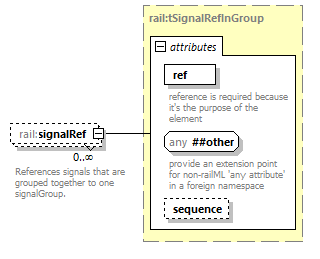 | ||||||||||||||||||||
| namespace | https://www.railml.org/schemas/2021 | ||||||||||||||||||||
| type | rail:tSignalRefInGroup | ||||||||||||||||||||
| properties |
| ||||||||||||||||||||
| attributes |
| ||||||||||||||||||||
| annotation |
| ||||||||||||||||||||
| source | <xs:element name="signalRef" type="rail:tSignalRefInGroup" minOccurs="0" maxOccurs="unbounded"> <xs:annotation> <xs:documentation>References signals that are grouped together to one signalGroup.</xs:documentation> <xs:documentation>See https://wiki2.railml.org/wiki/IS:signalRef_signalGroup</xs:documentation> </xs:annotation> </xs:element> |
complexType eSignalGroups
| diagram |  | ||
| namespace | https://www.railml.org/schemas/2021 | ||
| children | rail:signalGroup | ||
| used by |
| ||
| source | <xs:complexType name="eSignalGroups"> <xs:sequence> <xs:element name="signalGroup" type="rail:eSignalGroup" minOccurs="0" maxOccurs="unbounded"> <xs:annotation> <xs:documentation>Associates various signals in one group.</xs:documentation> <xs:documentation>See https://wiki2.railml.org/wiki/IS:signalGroup</xs:documentation> </xs:annotation> </xs:element> </xs:sequence> </xs:complexType> |
element eSignalGroups/signalGroup
| diagram |  | ||||||||||||||||||||||||||||||||||||||||||||||||||||
| namespace | https://www.railml.org/schemas/2021 | ||||||||||||||||||||||||||||||||||||||||||||||||||||
| type | rail:eSignalGroup | ||||||||||||||||||||||||||||||||||||||||||||||||||||
| properties |
| ||||||||||||||||||||||||||||||||||||||||||||||||||||
| children | rail:additionalName rail:signalRef | ||||||||||||||||||||||||||||||||||||||||||||||||||||
| attributes |
| ||||||||||||||||||||||||||||||||||||||||||||||||||||
| annotation |
| ||||||||||||||||||||||||||||||||||||||||||||||||||||
| source | <xs:element name="signalGroup" type="rail:eSignalGroup" minOccurs="0" maxOccurs="unbounded"> <xs:annotation> <xs:documentation>Associates various signals in one group.</xs:documentation> <xs:documentation>See https://wiki2.railml.org/wiki/IS:signalGroup</xs:documentation> </xs:annotation> </xs:element> |
complexType eSignals
| diagram |  | ||
| namespace | https://www.railml.org/schemas/2021 | ||
| children | rail:signal rail:signalGroups | ||
| used by |
| ||
| source | <xs:complexType name="eSignals"> <xs:choice minOccurs="0" maxOccurs="unbounded"> <xs:element name="signal" type="rail:tSignal"> <xs:annotation> <xs:documentation>Defines various hardware parameters of a signal or a panel. A panel is a signal that cannot be switched. </xs:documentation> <xs:documentation>See https://wiki2.railml.org/wiki/IS:signal</xs:documentation> </xs:annotation> </xs:element> <xs:element name="signalGroups" type="rail:eSignalGroups"> <xs:annotation> <xs:documentation>Groups signalGroup elements.</xs:documentation> <xs:documentation>See https://wiki2.railml.org/wiki/IS:signalGroups</xs:documentation> </xs:annotation> </xs:element> </xs:choice> </xs:complexType> |
element eSignals/signal
| diagram |  | ||||||||||||||||||||||||||||||||||||||||||||||||||||||||||||||||||||||||||||||||||||||||||||||||||||||||||||||||||||||||||||||||||||||||||||||||||||||||||||||||||||||||||||||||||||||||||||||||||||||||||||||||||||||||||||||||||||||
| namespace | https://www.railml.org/schemas/2021 | ||||||||||||||||||||||||||||||||||||||||||||||||||||||||||||||||||||||||||||||||||||||||||||||||||||||||||||||||||||||||||||||||||||||||||||||||||||||||||||||||||||||||||||||||||||||||||||||||||||||||||||||||||||||||||||||||||||||
| type | rail:tSignal | ||||||||||||||||||||||||||||||||||||||||||||||||||||||||||||||||||||||||||||||||||||||||||||||||||||||||||||||||||||||||||||||||||||||||||||||||||||||||||||||||||||||||||||||||||||||||||||||||||||||||||||||||||||||||||||||||||||||
| properties |
| ||||||||||||||||||||||||||||||||||||||||||||||||||||||||||||||||||||||||||||||||||||||||||||||||||||||||||||||||||||||||||||||||||||||||||||||||||||||||||||||||||||||||||||||||||||||||||||||||||||||||||||||||||||||||||||||||||||||
| children | rail:additionalName rail:geoCoord rail:states rail:speed rail:etcs rail:levelCrossing rail:trainRadio rail:catenary rail:line rail:milepost rail:braking rail:trainProtectionElementGroupRef rail:baliseGroupRef | ||||||||||||||||||||||||||||||||||||||||||||||||||||||||||||||||||||||||||||||||||||||||||||||||||||||||||||||||||||||||||||||||||||||||||||||||||||||||||||||||||||||||||||||||||||||||||||||||||||||||||||||||||||||||||||||||||||||
| attributes |
| ||||||||||||||||||||||||||||||||||||||||||||||||||||||||||||||||||||||||||||||||||||||||||||||||||||||||||||||||||||||||||||||||||||||||||||||||||||||||||||||||||||||||||||||||||||||||||||||||||||||||||||||||||||||||||||||||||||||
| annotation |
| ||||||||||||||||||||||||||||||||||||||||||||||||||||||||||||||||||||||||||||||||||||||||||||||||||||||||||||||||||||||||||||||||||||||||||||||||||||||||||||||||||||||||||||||||||||||||||||||||||||||||||||||||||||||||||||||||||||||
| source | <xs:element name="signal" type="rail:tSignal"> <xs:annotation> <xs:documentation>Defines various hardware parameters of a signal or a panel. A panel is a signal that cannot be switched. </xs:documentation> <xs:documentation>See https://wiki2.railml.org/wiki/IS:signal</xs:documentation> </xs:annotation> </xs:element> |
element eSignals/signalGroups
| diagram |  | ||||
| namespace | https://www.railml.org/schemas/2021 | ||||
| type | rail:eSignalGroups | ||||
| properties |
| ||||
| children | rail:signalGroup | ||||
| annotation |
| ||||
| source | <xs:element name="signalGroups" type="rail:eSignalGroups"> <xs:annotation> <xs:documentation>Groups signalGroup elements.</xs:documentation> <xs:documentation>See https://wiki2.railml.org/wiki/IS:signalGroups</xs:documentation> </xs:annotation> </xs:element> |
complexType eSpeedChanges
| diagram |  | ||
| namespace | https://www.railml.org/schemas/2021 | ||
| children | rail:speedChange | ||
| used by |
| ||
| source | <xs:complexType name="eSpeedChanges"> <xs:sequence> <xs:element name="speedChange" type="rail:tSpeedChange" minOccurs="0" maxOccurs="unbounded"> <xs:annotation> <xs:documentation>Defines a track element in which position the maximum allowed velocity on a track changes.</xs:documentation> <xs:documentation>See https://wiki2.railml.org/wiki/IS:speedChange</xs:documentation> </xs:annotation> </xs:element> </xs:sequence> </xs:complexType> |
element eSpeedChanges/speedChange
| diagram |  | ||||||||||||||||||||||||||||||||||||||||||||||||||||||||||||||||||||||||||||||||||||||||||||||||||||||||||||||||||||||||||||||||||||||||||||||
| namespace | https://www.railml.org/schemas/2021 | ||||||||||||||||||||||||||||||||||||||||||||||||||||||||||||||||||||||||||||||||||||||||||||||||||||||||||||||||||||||||||||||||||||||||||||||
| type | rail:tSpeedChange | ||||||||||||||||||||||||||||||||||||||||||||||||||||||||||||||||||||||||||||||||||||||||||||||||||||||||||||||||||||||||||||||||||||||||||||||
| properties |
| ||||||||||||||||||||||||||||||||||||||||||||||||||||||||||||||||||||||||||||||||||||||||||||||||||||||||||||||||||||||||||||||||||||||||||||||
| children | rail:additionalName rail:geoCoord rail:states | ||||||||||||||||||||||||||||||||||||||||||||||||||||||||||||||||||||||||||||||||||||||||||||||||||||||||||||||||||||||||||||||||||||||||||||||
| attributes |
| ||||||||||||||||||||||||||||||||||||||||||||||||||||||||||||||||||||||||||||||||||||||||||||||||||||||||||||||||||||||||||||||||||||||||||||||
| annotation |
| ||||||||||||||||||||||||||||||||||||||||||||||||||||||||||||||||||||||||||||||||||||||||||||||||||||||||||||||||||||||||||||||||||||||||||||||
| source | <xs:element name="speedChange" type="rail:tSpeedChange" minOccurs="0" maxOccurs="unbounded"> <xs:annotation> <xs:documentation>Defines a track element in which position the maximum allowed velocity on a track changes.</xs:documentation> <xs:documentation>See https://wiki2.railml.org/wiki/IS:speedChange</xs:documentation> </xs:annotation> </xs:element> |
complexType eSpeedProfiles
| diagram |  | ||
| namespace | https://www.railml.org/schemas/2021 | ||
| children | rail:speedProfile | ||
| used by |
| ||
| source | <xs:complexType name="eSpeedProfiles"> <xs:sequence> <xs:element name="speedProfile" type="rail:tSpeedProfile" minOccurs="0" maxOccurs="unbounded"> <xs:annotation> <xs:documentation>Defines constraints that are valid for certrain speed restrictions.</xs:documentation> <xs:documentation>See https://wiki2.railml.org/wiki/IS:speedProfile</xs:documentation> </xs:annotation> </xs:element> </xs:sequence> </xs:complexType> |
element eSpeedProfiles/speedProfile
| diagram |  | ||||||||||||||||||||||||||||||||||||||||||||||||||||||||||||||||||||||||||||||||||||||||||||||||||||||||||||||||||||||||||||||||||||||
| namespace | https://www.railml.org/schemas/2021 | ||||||||||||||||||||||||||||||||||||||||||||||||||||||||||||||||||||||||||||||||||||||||||||||||||||||||||||||||||||||||||||||||||||||
| type | rail:tSpeedProfile | ||||||||||||||||||||||||||||||||||||||||||||||||||||||||||||||||||||||||||||||||||||||||||||||||||||||||||||||||||||||||||||||||||||||
| properties |
| ||||||||||||||||||||||||||||||||||||||||||||||||||||||||||||||||||||||||||||||||||||||||||||||||||||||||||||||||||||||||||||||||||||||
| children | rail:additionalName rail:tilting rail:braking rail:path | ||||||||||||||||||||||||||||||||||||||||||||||||||||||||||||||||||||||||||||||||||||||||||||||||||||||||||||||||||||||||||||||||||||||
| attributes |
| ||||||||||||||||||||||||||||||||||||||||||||||||||||||||||||||||||||||||||||||||||||||||||||||||||||||||||||||||||||||||||||||||||||||
| annotation |
| ||||||||||||||||||||||||||||||||||||||||||||||||||||||||||||||||||||||||||||||||||||||||||||||||||||||||||||||||||||||||||||||||||||||
| source | <xs:element name="speedProfile" type="rail:tSpeedProfile" minOccurs="0" maxOccurs="unbounded"> <xs:annotation> <xs:documentation>Defines constraints that are valid for certrain speed restrictions.</xs:documentation> <xs:documentation>See https://wiki2.railml.org/wiki/IS:speedProfile</xs:documentation> </xs:annotation> </xs:element> |
complexType eSpeeds
| diagram |  | ||
| namespace | https://www.railml.org/schemas/2021 | ||
| children | rail:speed | ||
| used by |
| ||
| source | <xs:complexType name="eSpeeds"> <xs:sequence> <xs:element name="speed" type="rail:tSpeedInfo" minOccurs="0" maxOccurs="unbounded"> <xs:annotation> <xs:documentation>Defines a specific speed profile for all tracks where the current infraAttributes are used per reference.</xs:documentation> <xs:documentation>See https://wiki2.railml.org/wiki/IS:speed_speeds</xs:documentation> </xs:annotation> </xs:element> </xs:sequence> </xs:complexType> |
element eSpeeds/speed
| diagram |  | ||||||||||||||||||||||||||||||||||||||||||||
| namespace | https://www.railml.org/schemas/2021 | ||||||||||||||||||||||||||||||||||||||||||||
| type | rail:tSpeedInfo | ||||||||||||||||||||||||||||||||||||||||||||
| properties |
| ||||||||||||||||||||||||||||||||||||||||||||
| attributes |
| ||||||||||||||||||||||||||||||||||||||||||||
| annotation |
| ||||||||||||||||||||||||||||||||||||||||||||
| source | <xs:element name="speed" type="rail:tSpeedInfo" minOccurs="0" maxOccurs="unbounded"> <xs:annotation> <xs:documentation>Defines a specific speed profile for all tracks where the current infraAttributes are used per reference.</xs:documentation> <xs:documentation>See https://wiki2.railml.org/wiki/IS:speed_speeds</xs:documentation> </xs:annotation> </xs:element> |
complexType eStopPosts
| diagram |  | ||
| namespace | https://www.railml.org/schemas/2021 | ||
| children | rail:stopPost | ||
| used by |
| ||
| source | <xs:complexType name="eStopPosts"> <xs:sequence> <xs:element name="stopPost" type="rail:tStopPost" minOccurs="0" maxOccurs="unbounded"> <xs:annotation> <xs:documentation>Marks a position on a track where a train, which fulfills certain criteria, needs to halt in order to change passengers or because of other operational rules.</xs:documentation> <xs:documentation>See https://wiki2.railml.org/wiki/IS:stopPost</xs:documentation> </xs:annotation> </xs:element> </xs:sequence> </xs:complexType> |
element eStopPosts/stopPost
| diagram |  | ||||||||||||||||||||||||||||||||||||||||||||||||||||||||||||||||||||||||||||||||||||||||||||||||||||||||||||||||||||||||||||||||||||||||||||||||||||||
| namespace | https://www.railml.org/schemas/2021 | ||||||||||||||||||||||||||||||||||||||||||||||||||||||||||||||||||||||||||||||||||||||||||||||||||||||||||||||||||||||||||||||||||||||||||||||||||||||
| type | rail:tStopPost | ||||||||||||||||||||||||||||||||||||||||||||||||||||||||||||||||||||||||||||||||||||||||||||||||||||||||||||||||||||||||||||||||||||||||||||||||||||||
| properties |
| ||||||||||||||||||||||||||||||||||||||||||||||||||||||||||||||||||||||||||||||||||||||||||||||||||||||||||||||||||||||||||||||||||||||||||||||||||||||
| children | rail:additionalName rail:geoCoord rail:states rail:validForMovements rail:signalRef | ||||||||||||||||||||||||||||||||||||||||||||||||||||||||||||||||||||||||||||||||||||||||||||||||||||||||||||||||||||||||||||||||||||||||||||||||||||||
| attributes |
| ||||||||||||||||||||||||||||||||||||||||||||||||||||||||||||||||||||||||||||||||||||||||||||||||||||||||||||||||||||||||||||||||||||||||||||||||||||||
| annotation |
| ||||||||||||||||||||||||||||||||||||||||||||||||||||||||||||||||||||||||||||||||||||||||||||||||||||||||||||||||||||||||||||||||||||||||||||||||||||||
| source | <xs:element name="stopPost" type="rail:tStopPost" minOccurs="0" maxOccurs="unbounded"> <xs:annotation> <xs:documentation>Marks a position on a track where a train, which fulfills certain criteria, needs to halt in order to change passengers or because of other operational rules.</xs:documentation> <xs:documentation>See https://wiki2.railml.org/wiki/IS:stopPost</xs:documentation> </xs:annotation> </xs:element> |
complexType eSwitch
| diagram |  | ||||||||||||||||||||||||||||||||||||||||||||||||||||||||||||||||||||||||||||||||||||||||||||||||||||||||||||||||||||||||||||||||||||||||||||||||||||||
| namespace | https://www.railml.org/schemas/2021 | ||||||||||||||||||||||||||||||||||||||||||||||||||||||||||||||||||||||||||||||||||||||||||||||||||||||||||||||||||||||||||||||||||||||||||||||||||||||
| type | extension of rail:tSwitch | ||||||||||||||||||||||||||||||||||||||||||||||||||||||||||||||||||||||||||||||||||||||||||||||||||||||||||||||||||||||||||||||||||||||||||||||||||||||
| properties |
| ||||||||||||||||||||||||||||||||||||||||||||||||||||||||||||||||||||||||||||||||||||||||||||||||||||||||||||||||||||||||||||||||||||||||||||||||||||||
| children | rail:additionalName rail:geoCoord rail:states rail:connection | ||||||||||||||||||||||||||||||||||||||||||||||||||||||||||||||||||||||||||||||||||||||||||||||||||||||||||||||||||||||||||||||||||||||||||||||||||||||
| used by |
| ||||||||||||||||||||||||||||||||||||||||||||||||||||||||||||||||||||||||||||||||||||||||||||||||||||||||||||||||||||||||||||||||||||||||||||||||||||||
| attributes |
| ||||||||||||||||||||||||||||||||||||||||||||||||||||||||||||||||||||||||||||||||||||||||||||||||||||||||||||||||||||||||||||||||||||||||||||||||||||||
| source | <xs:complexType name="eSwitch"> <xs:complexContent> <xs:extension base="rail:tSwitch"> <xs:sequence> <xs:element name="connection" type="rail:tSwitchConnectionData" maxOccurs="3"> <xs:annotation> <xs:documentation>Is a topologic element that represents one of the track pairs connected by a certain switch.</xs:documentation> <xs:documentation>See https://wiki2.railml.org/wiki/IS:connection_switch</xs:documentation> </xs:annotation> </xs:element> </xs:sequence> </xs:extension> </xs:complexContent> </xs:complexType> |
element eSwitch/connection
| diagram |  | ||||||||||||||||||||||||||||||||||||||||||||||||||||||||
| namespace | https://www.railml.org/schemas/2021 | ||||||||||||||||||||||||||||||||||||||||||||||||||||||||
| type | rail:tSwitchConnectionData | ||||||||||||||||||||||||||||||||||||||||||||||||||||||||
| properties |
| ||||||||||||||||||||||||||||||||||||||||||||||||||||||||
| attributes |
| ||||||||||||||||||||||||||||||||||||||||||||||||||||||||
| annotation |
| ||||||||||||||||||||||||||||||||||||||||||||||||||||||||
| source | <xs:element name="connection" type="rail:tSwitchConnectionData" maxOccurs="3"> <xs:annotation> <xs:documentation>Is a topologic element that represents one of the track pairs connected by a certain switch.</xs:documentation> <xs:documentation>See https://wiki2.railml.org/wiki/IS:connection_switch</xs:documentation> </xs:annotation> </xs:element> |
complexType eTrack
| diagram |  | ||||||||||||||||||||||||||||||||||||||||||||||||||||||||||||||||||||||
| namespace | https://www.railml.org/schemas/2021 | ||||||||||||||||||||||||||||||||||||||||||||||||||||||||||||||||||||||
| type | extension of rail:tTrack | ||||||||||||||||||||||||||||||||||||||||||||||||||||||||||||||||||||||
| properties |
| ||||||||||||||||||||||||||||||||||||||||||||||||||||||||||||||||||||||
| children | rail:additionalName rail:states rail:trackDescr rail:trackTopology rail:trackElements rail:ocsElements rail:infraAttrGroupRefs rail:impairmentSections rail:propPassengerInfo | ||||||||||||||||||||||||||||||||||||||||||||||||||||||||||||||||||||||
| used by |
| ||||||||||||||||||||||||||||||||||||||||||||||||||||||||||||||||||||||
| attributes |
| ||||||||||||||||||||||||||||||||||||||||||||||||||||||||||||||||||||||
| source | <xs:complexType name="eTrack"> <xs:complexContent> <xs:extension base="rail:tTrack"> <xs:sequence> <xs:element name="trackDescr" type="xs:string" minOccurs="0" maxOccurs="unbounded"> <xs:annotation> <xs:documentation>DEPRECATED with railML version 2.4</xs:documentation> <xs:documentation>See https://wiki2.railml.org/wiki/IS:trackDescr</xs:documentation> </xs:annotation> </xs:element> <xs:element name="trackTopology" type="rail:eTrackTopology"> <xs:annotation> <xs:documentation>Describes the track being part of the drivable railway network as mathematical graph.</xs:documentation> <xs:documentation>See https://wiki2.railml.org/wiki/IS:trackTopology</xs:documentation> </xs:annotation> </xs:element> <xs:element name="trackElements" type="rail:eTrackElements" minOccurs="0"> <xs:annotation> <xs:documentation>Groups features and functional infrastructure elements that can be found along the track, such as bridges or ownership changes.</xs:documentation> <xs:documentation>See https://wiki2.railml.org/wiki/IS:trackElements</xs:documentation> </xs:annotation> </xs:element> <xs:element name="ocsElements" type="rail:eOcsElements" minOccurs="0"> <xs:annotation> <xs:documentation>Groups operation and control system elements.</xs:documentation> <xs:documentation>See https://wiki2.railml.org/wiki/IS:ocsElements</xs:documentation> </xs:annotation> </xs:element> <xs:element name="infraAttrGroupRefs" type="rail:eInfraAttrGroupRefs" minOccurs="0"> <xs:annotation> <xs:documentation>Groups infraAttrGroupRef elements.</xs:documentation> <xs:documentation>See https://wiki2.railml.org/wiki/IS:infraAttrGroupRefs</xs:documentation> </xs:annotation> </xs:element> <xs:element name="impairmentSections" type="rail:eImpairmentSections" minOccurs="0"> <xs:annotation> <xs:documentation>Contains impairmentSection elements.</xs:documentation> <xs:documentation>See https://wiki2.railml.org/wiki/IS:impairmentSections</xs:documentation> </xs:annotation> </xs:element> <xs:element name="propPassengerInfo" type="rail:tPropPassengerInfo" minOccurs="0"> <xs:annotation> <xs:documentation>This is a container element for providng passenger information related data for the enclosing track. For example this could be used to refer to text or sound based resources regarding the tracks name.</xs:documentation> <xs:documentation>See https://wiki2.railml.org/wiki/IS:propPassengerInfo_track</xs:documentation> </xs:annotation> </xs:element> <xs:any namespace="##other" processContents="strict" minOccurs="0" maxOccurs="unbounded"> <xs:annotation> <xs:documentation>This element has been deprecated, and is only kept for backward compatibility. Please use the first any-element in the the sequence instead.</xs:documentation> </xs:annotation> </xs:any> </xs:sequence> </xs:extension> </xs:complexContent> </xs:complexType> |
element eTrack/trackDescr
| diagram |  | ||||||
| namespace | https://www.railml.org/schemas/2021 | ||||||
| type | xs:string | ||||||
| properties |
| ||||||
| annotation |
| ||||||
| source | <xs:element name="trackDescr" type="xs:string" minOccurs="0" maxOccurs="unbounded"> <xs:annotation> <xs:documentation>DEPRECATED with railML version 2.4</xs:documentation> <xs:documentation>See https://wiki2.railml.org/wiki/IS:trackDescr</xs:documentation> </xs:annotation> </xs:element> |
element eTrack/trackTopology
| diagram |  | ||||
| namespace | https://www.railml.org/schemas/2021 | ||||
| type | rail:eTrackTopology | ||||
| properties |
| ||||
| children | rail:trackBegin rail:trackEnd rail:mileageChanges rail:connections rail:crossSections rail:borders | ||||
| annotation |
| ||||
| source | <xs:element name="trackTopology" type="rail:eTrackTopology"> <xs:annotation> <xs:documentation>Describes the track being part of the drivable railway network as mathematical graph.</xs:documentation> <xs:documentation>See https://wiki2.railml.org/wiki/IS:trackTopology</xs:documentation> </xs:annotation> </xs:element> |
element eTrack/trackElements
| diagram |  | ||||||
| namespace | https://www.railml.org/schemas/2021 | ||||||
| type | rail:eTrackElements | ||||||
| properties |
| ||||||
| children | rail:speedChanges rail:gradientChanges rail:radiusChanges rail:tunnels rail:bridges rail:levelCrossings rail:ownerChanges rail:operationModeChanges rail:trainProtectionChanges rail:electrificationChanges rail:powerTransmissionChanges rail:axleWeightChanges rail:gaugeChanges rail:clearanceGaugeChanges rail:geoMappings rail:trackConditions rail:platformEdges rail:serviceSections | ||||||
| annotation |
| ||||||
| source | <xs:element name="trackElements" type="rail:eTrackElements" minOccurs="0"> <xs:annotation> <xs:documentation>Groups features and functional infrastructure elements that can be found along the track, such as bridges or ownership changes.</xs:documentation> <xs:documentation>See https://wiki2.railml.org/wiki/IS:trackElements</xs:documentation> </xs:annotation> </xs:element> |
element eTrack/ocsElements
| diagram |  | ||||||
| namespace | https://www.railml.org/schemas/2021 | ||||||
| type | rail:eOcsElements | ||||||
| properties |
| ||||||
| children | rail:signals rail:trainDetectionElements rail:balises rail:trainProtectionElements rail:stopPosts rail:derailers rail:trainRadioChanges rail:locks | ||||||
| annotation |
| ||||||
| source | <xs:element name="ocsElements" type="rail:eOcsElements" minOccurs="0"> <xs:annotation> <xs:documentation>Groups operation and control system elements.</xs:documentation> <xs:documentation>See https://wiki2.railml.org/wiki/IS:ocsElements</xs:documentation> </xs:annotation> </xs:element> |
element eTrack/infraAttrGroupRefs
| diagram | 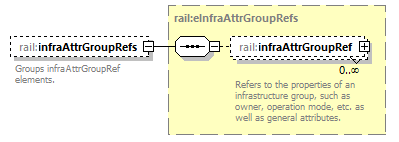 | ||||||
| namespace | https://www.railml.org/schemas/2021 | ||||||
| type | rail:eInfraAttrGroupRefs | ||||||
| properties |
| ||||||
| children | rail:infraAttrGroupRef | ||||||
| annotation |
| ||||||
| source | <xs:element name="infraAttrGroupRefs" type="rail:eInfraAttrGroupRefs" minOccurs="0"> <xs:annotation> <xs:documentation>Groups infraAttrGroupRef elements.</xs:documentation> <xs:documentation>See https://wiki2.railml.org/wiki/IS:infraAttrGroupRefs</xs:documentation> </xs:annotation> </xs:element> |
element eTrack/impairmentSections
| diagram |  | ||||||
| namespace | https://www.railml.org/schemas/2021 | ||||||
| type | rail:eImpairmentSections | ||||||
| properties |
| ||||||
| children | rail:impairmentSection | ||||||
| annotation |
| ||||||
| source | <xs:element name="impairmentSections" type="rail:eImpairmentSections" minOccurs="0"> <xs:annotation> <xs:documentation>Contains impairmentSection elements.</xs:documentation> <xs:documentation>See https://wiki2.railml.org/wiki/IS:impairmentSections</xs:documentation> </xs:annotation> </xs:element> |
element eTrack/propPassengerInfo
| diagram |  | ||||||
| namespace | https://www.railml.org/schemas/2021 | ||||||
| type | rail:tPropPassengerInfo | ||||||
| properties |
| ||||||
| children | rail:mediaResources | ||||||
| annotation |
| ||||||
| source | <xs:element name="propPassengerInfo" type="rail:tPropPassengerInfo" minOccurs="0"> <xs:annotation> <xs:documentation>This is a container element for providng passenger information related data for the enclosing track. For example this could be used to refer to text or sound based resources regarding the tracks name.</xs:documentation> <xs:documentation>See https://wiki2.railml.org/wiki/IS:propPassengerInfo_track</xs:documentation> </xs:annotation> </xs:element> |
complexType eTrackBegin
| diagram |  | ||||||||||||||||||||||||||||||||||||||||||||
| namespace | https://www.railml.org/schemas/2021 | ||||||||||||||||||||||||||||||||||||||||||||
| type | extension of rail:eTrackNode | ||||||||||||||||||||||||||||||||||||||||||||
| properties |
| ||||||||||||||||||||||||||||||||||||||||||||
| children | rail:geoCoord rail:connection rail:bufferStop rail:openEnd rail:macroscopicNode | ||||||||||||||||||||||||||||||||||||||||||||
| used by |
| ||||||||||||||||||||||||||||||||||||||||||||
| attributes |
| ||||||||||||||||||||||||||||||||||||||||||||
| source | <xs:complexType name="eTrackBegin"> <xs:complexContent> <xs:extension base="rail:eTrackNode"> <xs:attribute name="absDir" type="rail:tMileageDirection"> <xs:annotation> <xs:documentation>Defines whether the mileage increases ("raising") or decreases ("falling") along the <track> from this trackBegin.</xs:documentation> </xs:annotation> </xs:attribute> </xs:extension> </xs:complexContent> </xs:complexType> |
attribute eTrackBegin/@absDir
| type | rail:tMileageDirection | |||||||||
| facets |
| |||||||||
| annotation |
| |||||||||
| source | <xs:attribute name="absDir" type="rail:tMileageDirection"> <xs:annotation> <xs:documentation>Defines whether the mileage increases ("raising") or decreases ("falling") along the <track> from this trackBegin.</xs:documentation> </xs:annotation> </xs:attribute> |
complexType eTrackConditions
| diagram |  | ||
| namespace | https://www.railml.org/schemas/2021 | ||
| children | rail:trackCondition | ||
| used by |
| ||
| source | <xs:complexType name="eTrackConditions"> <xs:sequence> <xs:element name="trackCondition" type="rail:tTrackCondition" minOccurs="0" maxOccurs="unbounded"> <xs:annotation> <xs:documentation>Defines characteristics of the track along a specified length of the track.</xs:documentation> <xs:documentation>See https://wiki2.railml.org/wiki/IS:trackCondition</xs:documentation> </xs:annotation> </xs:element> </xs:sequence> </xs:complexType> |
element eTrackConditions/trackCondition
| diagram |  | ||||||||||||||||||||||||||||||||||||||||||||||||||||||||||||||||||||||||||||||||||||||||||
| namespace | https://www.railml.org/schemas/2021 | ||||||||||||||||||||||||||||||||||||||||||||||||||||||||||||||||||||||||||||||||||||||||||
| type | rail:tTrackCondition | ||||||||||||||||||||||||||||||||||||||||||||||||||||||||||||||||||||||||||||||||||||||||||
| properties |
| ||||||||||||||||||||||||||||||||||||||||||||||||||||||||||||||||||||||||||||||||||||||||||
| children | rail:additionalName rail:geoCoord rail:states | ||||||||||||||||||||||||||||||||||||||||||||||||||||||||||||||||||||||||||||||||||||||||||
| attributes |
| ||||||||||||||||||||||||||||||||||||||||||||||||||||||||||||||||||||||||||||||||||||||||||
| annotation |
| ||||||||||||||||||||||||||||||||||||||||||||||||||||||||||||||||||||||||||||||||||||||||||
| source | <xs:element name="trackCondition" type="rail:tTrackCondition" minOccurs="0" maxOccurs="unbounded"> <xs:annotation> <xs:documentation>Defines characteristics of the track along a specified length of the track.</xs:documentation> <xs:documentation>See https://wiki2.railml.org/wiki/IS:trackCondition</xs:documentation> </xs:annotation> </xs:element> |
complexType eTrackElements
| diagram |  | ||
| namespace | https://www.railml.org/schemas/2021 | ||
| children | rail:speedChanges rail:gradientChanges rail:radiusChanges rail:tunnels rail:bridges rail:levelCrossings rail:ownerChanges rail:operationModeChanges rail:trainProtectionChanges rail:electrificationChanges rail:powerTransmissionChanges rail:axleWeightChanges rail:gaugeChanges rail:clearanceGaugeChanges rail:geoMappings rail:trackConditions rail:platformEdges rail:serviceSections | ||
| used by |
| ||
| source | <xs:complexType name="eTrackElements"> <xs:sequence> <xs:element name="speedChanges" type="rail:eSpeedChanges" minOccurs="0"> <xs:annotation> <xs:documentation>Groups speedChange elements.</xs:documentation> <xs:documentation>See https://wiki2.railml.org/wiki/IS:speedChanges</xs:documentation> </xs:annotation> </xs:element> <xs:element name="gradientChanges" type="rail:eGradientChanges" minOccurs="0"> <xs:annotation> <xs:documentation>Groups gradientChange elements.</xs:documentation> <xs:documentation>See https://wiki2.railml.org/wiki/IS:gradientChanges</xs:documentation> </xs:annotation> </xs:element> <xs:element name="radiusChanges" type="rail:eRadiusChanges" minOccurs="0"> <xs:annotation> <xs:documentation>Groups radiusChange elements.</xs:documentation> <xs:documentation>See https://wiki2.railml.org/wiki/IS:radiusChanges</xs:documentation> </xs:annotation> </xs:element> <xs:element name="tunnels" type="rail:eTunnels" minOccurs="0"> <xs:annotation> <xs:documentation>Groups tunnel elements.</xs:documentation> <xs:documentation>See https://wiki2.railml.org/wiki/IS:tunnels</xs:documentation> </xs:annotation> </xs:element> <xs:element name="bridges" type="rail:eBridges" minOccurs="0"> <xs:annotation> <xs:documentation>Groups bridge elements.</xs:documentation> <xs:documentation>See https://wiki2.railml.org/wiki/IS:bridges</xs:documentation> </xs:annotation> </xs:element> <xs:element name="levelCrossings" type="rail:eLevelCrossings" minOccurs="0"> <xs:annotation> <xs:documentation>Groups levelCrossing elements.</xs:documentation> <xs:documentation>See https://wiki2.railml.org/wiki/IS:levelCrossings</xs:documentation> </xs:annotation> </xs:element> <xs:element name="ownerChanges" type="rail:eOwnerChanges" minOccurs="0"> <xs:annotation> <xs:documentation>Groups ownerChange elements.</xs:documentation> <xs:documentation>See https://wiki2.railml.org/wiki/IS:ownerChanges</xs:documentation> </xs:annotation> </xs:element> <xs:element name="operationModeChanges" type="rail:eOperationModeChanges" minOccurs="0"> <xs:annotation> <xs:documentation>Groups operationModeChange elements.</xs:documentation> <xs:documentation>See https://wiki2.railml.org/wiki/IS:operationModeChanges</xs:documentation> </xs:annotation> </xs:element> <xs:element name="trainProtectionChanges" type="rail:eTrainProtectionChanges" minOccurs="0"> <xs:annotation> <xs:documentation>Groups trainProtectionChange elements.</xs:documentation> <xs:documentation>See https://wiki2.railml.org/wiki/IS:trainProtectionChanges</xs:documentation> </xs:annotation> </xs:element> <xs:element name="electrificationChanges" type="rail:eElectrificationChanges" minOccurs="0"> <xs:annotation> <xs:documentation>Groups electrificationChange elements.</xs:documentation> <xs:documentation>See https://wiki2.railml.org/wiki/IS:electrificationChanges</xs:documentation> </xs:annotation> </xs:element> <xs:element name="powerTransmissionChanges" type="rail:ePowerTransmissionChanges" minOccurs="0"> <xs:annotation> <xs:documentation>Groups powerTransmissionChange elements.</xs:documentation> <xs:documentation>See https://wiki2.railml.org/wiki/IS:powerTransmissionChanges</xs:documentation> </xs:annotation> </xs:element> <xs:element name="axleWeightChanges" type="rail:eAxleWeightChanges" minOccurs="0"> <xs:annotation> <xs:documentation>Groups axleWeightChange elements.</xs:documentation> <xs:documentation>See https://wiki2.railml.org/wiki/IS:axleWeightChanges</xs:documentation> </xs:annotation> </xs:element> <xs:element name="gaugeChanges" type="rail:eGaugeChanges" minOccurs="0"> <xs:annotation> <xs:documentation>Groups gaugeChange elements.</xs:documentation> <xs:documentation>See https://wiki2.railml.org/wiki/IS:gaugeChanges</xs:documentation> </xs:annotation> </xs:element> <xs:element name="clearanceGaugeChanges" type="rail:eClearanceGaugeChanges" minOccurs="0"> <xs:annotation> <xs:documentation>Groups clearanceGaugeChange elements.</xs:documentation> <xs:documentation>See https://wiki2.railml.org/wiki/IS:clearanceGaugeChanges</xs:documentation> </xs:annotation> </xs:element> <xs:element name="geoMappings" type="rail:eGeoMappings" minOccurs="0"> <xs:annotation> <xs:documentation>Groups geoMapping elements.</xs:documentation> <xs:documentation>See https://wiki2.railml.org/wiki/IS:geoMappings</xs:documentation> </xs:annotation> </xs:element> <xs:element name="trackConditions" type="rail:eTrackConditions" minOccurs="0"> <xs:annotation> <xs:documentation>Groups trackCondition elements.</xs:documentation> <xs:documentation>See https://wiki2.railml.org/wiki/IS:trackConditions</xs:documentation> </xs:annotation> </xs:element> <xs:element name="platformEdges" type="rail:ePlatformEdges" minOccurs="0"> <xs:annotation> <xs:documentation>Groups platformEdge elements.</xs:documentation> <xs:documentation>See https://wiki2.railml.org/wiki/IS:platformEdges</xs:documentation> </xs:annotation> </xs:element> <xs:element name="serviceSections" type="rail:eServiceSections" minOccurs="0"> <xs:annotation> <xs:documentation>Groups serviceSection elements.</xs:documentation> <xs:documentation>See https://wiki2.railml.org/wiki/IS:serviceSections</xs:documentation> </xs:annotation> </xs:element> <xs:any namespace="##other" processContents="strict" minOccurs="0" maxOccurs="unbounded"> <xs:annotation> <xs:documentation>Provide an extension point for non-railML elements in foreign namespace.</xs:documentation> </xs:annotation> </xs:any> </xs:sequence> </xs:complexType> |
element eTrackElements/speedChanges
| diagram | 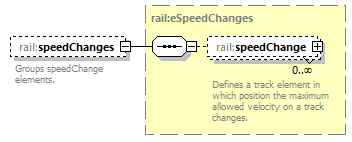 | ||||||
| namespace | https://www.railml.org/schemas/2021 | ||||||
| type | rail:eSpeedChanges | ||||||
| properties |
| ||||||
| children | rail:speedChange | ||||||
| annotation |
| ||||||
| source | <xs:element name="speedChanges" type="rail:eSpeedChanges" minOccurs="0"> <xs:annotation> <xs:documentation>Groups speedChange elements.</xs:documentation> <xs:documentation>See https://wiki2.railml.org/wiki/IS:speedChanges</xs:documentation> </xs:annotation> </xs:element> |
element eTrackElements/gradientChanges
| diagram |  | ||||||
| namespace | https://www.railml.org/schemas/2021 | ||||||
| type | rail:eGradientChanges | ||||||
| properties |
| ||||||
| children | rail:gradientChange | ||||||
| annotation |
| ||||||
| source | <xs:element name="gradientChanges" type="rail:eGradientChanges" minOccurs="0"> <xs:annotation> <xs:documentation>Groups gradientChange elements.</xs:documentation> <xs:documentation>See https://wiki2.railml.org/wiki/IS:gradientChanges</xs:documentation> </xs:annotation> </xs:element> |
element eTrackElements/radiusChanges
| diagram |  | ||||||
| namespace | https://www.railml.org/schemas/2021 | ||||||
| type | rail:eRadiusChanges | ||||||
| properties |
| ||||||
| children | rail:radiusChange | ||||||
| annotation |
| ||||||
| source | <xs:element name="radiusChanges" type="rail:eRadiusChanges" minOccurs="0"> <xs:annotation> <xs:documentation>Groups radiusChange elements.</xs:documentation> <xs:documentation>See https://wiki2.railml.org/wiki/IS:radiusChanges</xs:documentation> </xs:annotation> </xs:element> |
element eTrackElements/tunnels
| diagram |  | ||||||
| namespace | https://www.railml.org/schemas/2021 | ||||||
| type | rail:eTunnels | ||||||
| properties |
| ||||||
| children | rail:tunnel | ||||||
| annotation |
| ||||||
| source | <xs:element name="tunnels" type="rail:eTunnels" minOccurs="0"> <xs:annotation> <xs:documentation>Groups tunnel elements.</xs:documentation> <xs:documentation>See https://wiki2.railml.org/wiki/IS:tunnels</xs:documentation> </xs:annotation> </xs:element> |
element eTrackElements/bridges
| diagram |  | ||||||
| namespace | https://www.railml.org/schemas/2021 | ||||||
| type | rail:eBridges | ||||||
| properties |
| ||||||
| children | rail:brigde | ||||||
| annotation |
| ||||||
| source | <xs:element name="bridges" type="rail:eBridges" minOccurs="0"> <xs:annotation> <xs:documentation>Groups bridge elements.</xs:documentation> <xs:documentation>See https://wiki2.railml.org/wiki/IS:bridges</xs:documentation> </xs:annotation> </xs:element> |
element eTrackElements/levelCrossings
| diagram | 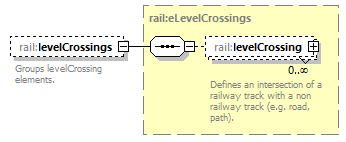 | ||||||
| namespace | https://www.railml.org/schemas/2021 | ||||||
| type | rail:eLevelCrossings | ||||||
| properties |
| ||||||
| children | rail:levelCrossing | ||||||
| annotation |
| ||||||
| source | <xs:element name="levelCrossings" type="rail:eLevelCrossings" minOccurs="0"> <xs:annotation> <xs:documentation>Groups levelCrossing elements.</xs:documentation> <xs:documentation>See https://wiki2.railml.org/wiki/IS:levelCrossings</xs:documentation> </xs:annotation> </xs:element> |
element eTrackElements/ownerChanges
| diagram | 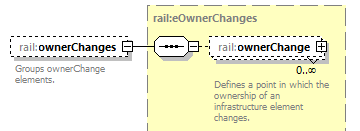 | ||||||
| namespace | https://www.railml.org/schemas/2021 | ||||||
| type | rail:eOwnerChanges | ||||||
| properties |
| ||||||
| children | rail:ownerChange | ||||||
| annotation |
| ||||||
| source | <xs:element name="ownerChanges" type="rail:eOwnerChanges" minOccurs="0"> <xs:annotation> <xs:documentation>Groups ownerChange elements.</xs:documentation> <xs:documentation>See https://wiki2.railml.org/wiki/IS:ownerChanges</xs:documentation> </xs:annotation> </xs:element> |
element eTrackElements/operationModeChanges
| diagram |  | ||||||
| namespace | https://www.railml.org/schemas/2021 | ||||||
| type | rail:eOperationModeChanges | ||||||
| properties |
| ||||||
| children | rail:operationModeChange | ||||||
| annotation |
| ||||||
| source | <xs:element name="operationModeChanges" type="rail:eOperationModeChanges" minOccurs="0"> <xs:annotation> <xs:documentation>Groups operationModeChange elements.</xs:documentation> <xs:documentation>See https://wiki2.railml.org/wiki/IS:operationModeChanges</xs:documentation> </xs:annotation> </xs:element> |
element eTrackElements/trainProtectionChanges
| diagram |  | ||||||
| namespace | https://www.railml.org/schemas/2021 | ||||||
| type | rail:eTrainProtectionChanges | ||||||
| properties |
| ||||||
| children | rail:trainProtectionChange | ||||||
| annotation |
| ||||||
| source | <xs:element name="trainProtectionChanges" type="rail:eTrainProtectionChanges" minOccurs="0"> <xs:annotation> <xs:documentation>Groups trainProtectionChange elements.</xs:documentation> <xs:documentation>See https://wiki2.railml.org/wiki/IS:trainProtectionChanges</xs:documentation> </xs:annotation> </xs:element> |
element eTrackElements/electrificationChanges
| diagram |  | ||||||
| namespace | https://www.railml.org/schemas/2021 | ||||||
| type | rail:eElectrificationChanges | ||||||
| properties |
| ||||||
| children | rail:electrificationChange | ||||||
| annotation |
| ||||||
| source | <xs:element name="electrificationChanges" type="rail:eElectrificationChanges" minOccurs="0"> <xs:annotation> <xs:documentation>Groups electrificationChange elements.</xs:documentation> <xs:documentation>See https://wiki2.railml.org/wiki/IS:electrificationChanges</xs:documentation> </xs:annotation> </xs:element> |
element eTrackElements/powerTransmissionChanges
| diagram |  | ||||||
| namespace | https://www.railml.org/schemas/2021 | ||||||
| type | rail:ePowerTransmissionChanges | ||||||
| properties |
| ||||||
| children | rail:powerTransmissionChange | ||||||
| annotation |
| ||||||
| source | <xs:element name="powerTransmissionChanges" type="rail:ePowerTransmissionChanges" minOccurs="0"> <xs:annotation> <xs:documentation>Groups powerTransmissionChange elements.</xs:documentation> <xs:documentation>See https://wiki2.railml.org/wiki/IS:powerTransmissionChanges</xs:documentation> </xs:annotation> </xs:element> |
element eTrackElements/axleWeightChanges
| diagram |  | ||||||
| namespace | https://www.railml.org/schemas/2021 | ||||||
| type | rail:eAxleWeightChanges | ||||||
| properties |
| ||||||
| children | rail:axleWeightChange | ||||||
| annotation |
| ||||||
| source | <xs:element name="axleWeightChanges" type="rail:eAxleWeightChanges" minOccurs="0"> <xs:annotation> <xs:documentation>Groups axleWeightChange elements.</xs:documentation> <xs:documentation>See https://wiki2.railml.org/wiki/IS:axleWeightChanges</xs:documentation> </xs:annotation> </xs:element> |
element eTrackElements/gaugeChanges
| diagram |  | ||||||
| namespace | https://www.railml.org/schemas/2021 | ||||||
| type | rail:eGaugeChanges | ||||||
| properties |
| ||||||
| children | rail:gaugeChange | ||||||
| annotation |
| ||||||
| source | <xs:element name="gaugeChanges" type="rail:eGaugeChanges" minOccurs="0"> <xs:annotation> <xs:documentation>Groups gaugeChange elements.</xs:documentation> <xs:documentation>See https://wiki2.railml.org/wiki/IS:gaugeChanges</xs:documentation> </xs:annotation> </xs:element> |
element eTrackElements/clearanceGaugeChanges
| diagram |  | ||||||
| namespace | https://www.railml.org/schemas/2021 | ||||||
| type | rail:eClearanceGaugeChanges | ||||||
| properties |
| ||||||
| children | rail:clearanceGaugeChange | ||||||
| annotation |
| ||||||
| source | <xs:element name="clearanceGaugeChanges" type="rail:eClearanceGaugeChanges" minOccurs="0"> <xs:annotation> <xs:documentation>Groups clearanceGaugeChange elements.</xs:documentation> <xs:documentation>See https://wiki2.railml.org/wiki/IS:clearanceGaugeChanges</xs:documentation> </xs:annotation> </xs:element> |
element eTrackElements/geoMappings
| diagram |  | ||||||
| namespace | https://www.railml.org/schemas/2021 | ||||||
| type | rail:eGeoMappings | ||||||
| properties |
| ||||||
| children | rail:geoMapping | ||||||
| annotation |
| ||||||
| source | <xs:element name="geoMappings" type="rail:eGeoMappings" minOccurs="0"> <xs:annotation> <xs:documentation>Groups geoMapping elements.</xs:documentation> <xs:documentation>See https://wiki2.railml.org/wiki/IS:geoMappings</xs:documentation> </xs:annotation> </xs:element> |
element eTrackElements/trackConditions
| diagram |  | ||||||
| namespace | https://www.railml.org/schemas/2021 | ||||||
| type | rail:eTrackConditions | ||||||
| properties |
| ||||||
| children | rail:trackCondition | ||||||
| annotation |
| ||||||
| source | <xs:element name="trackConditions" type="rail:eTrackConditions" minOccurs="0"> <xs:annotation> <xs:documentation>Groups trackCondition elements.</xs:documentation> <xs:documentation>See https://wiki2.railml.org/wiki/IS:trackConditions</xs:documentation> </xs:annotation> </xs:element> |
element eTrackElements/platformEdges
| diagram |  | ||||||
| namespace | https://www.railml.org/schemas/2021 | ||||||
| type | rail:ePlatformEdges | ||||||
| properties |
| ||||||
| children | rail:platformEdge | ||||||
| annotation |
| ||||||
| source | <xs:element name="platformEdges" type="rail:ePlatformEdges" minOccurs="0"> <xs:annotation> <xs:documentation>Groups platformEdge elements.</xs:documentation> <xs:documentation>See https://wiki2.railml.org/wiki/IS:platformEdges</xs:documentation> </xs:annotation> </xs:element> |
element eTrackElements/serviceSections
| diagram |  | ||||||
| namespace | https://www.railml.org/schemas/2021 | ||||||
| type | rail:eServiceSections | ||||||
| properties |
| ||||||
| children | rail:serviceSection | ||||||
| annotation |
| ||||||
| source | <xs:element name="serviceSections" type="rail:eServiceSections" minOccurs="0"> <xs:annotation> <xs:documentation>Groups serviceSection elements.</xs:documentation> <xs:documentation>See https://wiki2.railml.org/wiki/IS:serviceSections</xs:documentation> </xs:annotation> </xs:element> |
complexType eTrackElementVis
| diagram |  | ||||||||||||||
| namespace | https://www.railml.org/schemas/2021 | ||||||||||||||
| type | extension of rail:tElementWithReference | ||||||||||||||
| properties |
| ||||||||||||||
| children | rail:position | ||||||||||||||
| used by |
| ||||||||||||||
| attributes |
| ||||||||||||||
| source | <xs:complexType name="eTrackElementVis"> <xs:complexContent> <xs:extension base="rail:tElementWithReference"> <xs:sequence> <xs:element name="position" type="rail:tPoint"> <xs:annotation> <xs:documentation>position of the visualized track element in grid coordinates</xs:documentation> <xs:documentation>See https://wiki2.railml.org/wiki/IS:position_trackElementVis</xs:documentation> </xs:annotation> </xs:element> </xs:sequence> </xs:extension> </xs:complexContent> </xs:complexType> |
element eTrackElementVis/position
| diagram |  | ||||||||||||||||||
| namespace | https://www.railml.org/schemas/2021 | ||||||||||||||||||
| type | rail:tPoint | ||||||||||||||||||
| properties |
| ||||||||||||||||||
| attributes |
| ||||||||||||||||||
| annotation |
| ||||||||||||||||||
| source | <xs:element name="position" type="rail:tPoint"> <xs:annotation> <xs:documentation>position of the visualized track element in grid coordinates</xs:documentation> <xs:documentation>See https://wiki2.railml.org/wiki/IS:position_trackElementVis</xs:documentation> </xs:annotation> </xs:element> |
complexType eTrackEnd
| diagram | 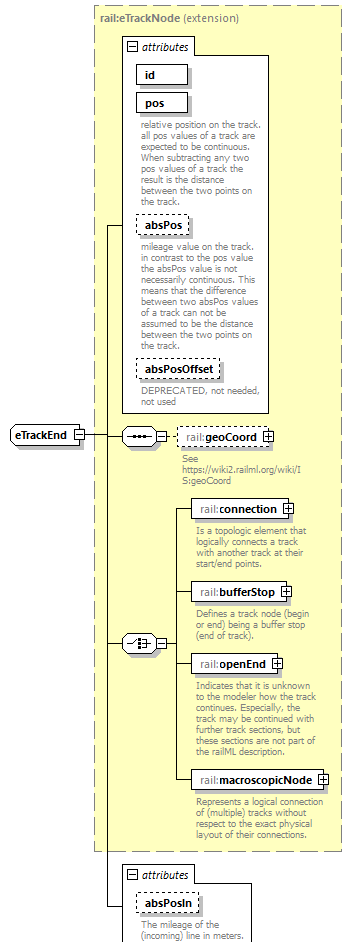 | ||||||||||||||||||||||||||||||||||||||||||||
| namespace | https://www.railml.org/schemas/2021 | ||||||||||||||||||||||||||||||||||||||||||||
| type | extension of rail:eTrackNode | ||||||||||||||||||||||||||||||||||||||||||||
| properties |
| ||||||||||||||||||||||||||||||||||||||||||||
| children | rail:geoCoord rail:connection rail:bufferStop rail:openEnd rail:macroscopicNode | ||||||||||||||||||||||||||||||||||||||||||||
| used by |
| ||||||||||||||||||||||||||||||||||||||||||||
| attributes |
| ||||||||||||||||||||||||||||||||||||||||||||
| source | <xs:complexType name="eTrackEnd"> <xs:complexContent> <xs:extension base="rail:eTrackNode"> <xs:attribute name="absPosIn" type="rail:tLengthM"> <xs:annotation> <xs:documentation>The mileage of the (incoming) line in meters.</xs:documentation> </xs:annotation> </xs:attribute> </xs:extension> </xs:complexContent> </xs:complexType> |
attribute eTrackEnd/@absPosIn
| type | rail:tLengthM | ||||||
| facets |
| ||||||
| annotation |
| ||||||
| source | <xs:attribute name="absPosIn" type="rail:tLengthM"> <xs:annotation> <xs:documentation>The mileage of the (incoming) line in meters.</xs:documentation> </xs:annotation> </xs:attribute> |
complexType eTrackGroups
| diagram |  | ||
| namespace | https://www.railml.org/schemas/2021 | ||
| children | rail:line rail:locallyControlledArea | ||
| used by |
| ||
| source | <xs:complexType name="eTrackGroups"> <xs:sequence> <xs:element name="line" type="rail:eLine" minOccurs="0" maxOccurs="unbounded"> <xs:annotation> <xs:documentation>Groups all tracks belonging to a railway line, meaning a connection between two operational points with its own mileage.</xs:documentation> <xs:documentation>See https://wiki2.railml.org/wiki/IS:line_trackGroups</xs:documentation> </xs:annotation> </xs:element> <xs:element name="locallyControlledArea" type="rail:eLocallyControlledArea" minOccurs="0" maxOccurs="unbounded"> <xs:annotation> <xs:documentation>DEPRECATED. Use controller/localOperationArea instead.</xs:documentation> <xs:documentation>See https://wiki2.railml.org/wiki/IS:locallyControlledArea</xs:documentation> </xs:annotation> </xs:element> <xs:any namespace="##other" processContents="strict" minOccurs="0" maxOccurs="unbounded"> <xs:annotation> <xs:documentation>Provide an extension point for non-railML elements in foreign namespace.</xs:documentation> </xs:annotation> </xs:any> </xs:sequence> </xs:complexType> |
element eTrackGroups/line
| diagram |  | ||||||||||||||||||||||||||||||||||||||||||||||||||||||||||||||||||||||||||||||
| namespace | https://www.railml.org/schemas/2021 | ||||||||||||||||||||||||||||||||||||||||||||||||||||||||||||||||||||||||||||||
| type | rail:eLine | ||||||||||||||||||||||||||||||||||||||||||||||||||||||||||||||||||||||||||||||
| properties |
| ||||||||||||||||||||||||||||||||||||||||||||||||||||||||||||||||||||||||||||||
| children | rail:additionalName rail:states rail:lineDescr rail:trackRef | ||||||||||||||||||||||||||||||||||||||||||||||||||||||||||||||||||||||||||||||
| attributes |
| ||||||||||||||||||||||||||||||||||||||||||||||||||||||||||||||||||||||||||||||
| annotation |
| ||||||||||||||||||||||||||||||||||||||||||||||||||||||||||||||||||||||||||||||
| source | <xs:element name="line" type="rail:eLine" minOccurs="0" maxOccurs="unbounded"> <xs:annotation> <xs:documentation>Groups all tracks belonging to a railway line, meaning a connection between two operational points with its own mileage.</xs:documentation> <xs:documentation>See https://wiki2.railml.org/wiki/IS:line_trackGroups</xs:documentation> </xs:annotation> </xs:element> |
element eTrackGroups/locallyControlledArea
| diagram | 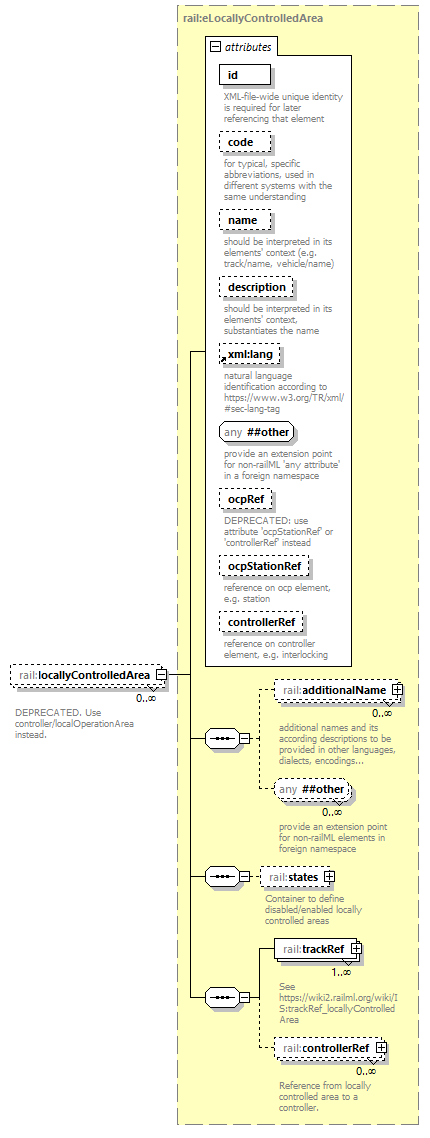 | ||||||||||||||||||||||||||||||||||||||||||||||||||||||||||||||||||||||
| namespace | https://www.railml.org/schemas/2021 | ||||||||||||||||||||||||||||||||||||||||||||||||||||||||||||||||||||||
| type | rail:eLocallyControlledArea | ||||||||||||||||||||||||||||||||||||||||||||||||||||||||||||||||||||||
| properties |
| ||||||||||||||||||||||||||||||||||||||||||||||||||||||||||||||||||||||
| children | rail:additionalName rail:states rail:trackRef rail:controllerRef | ||||||||||||||||||||||||||||||||||||||||||||||||||||||||||||||||||||||
| attributes |
| ||||||||||||||||||||||||||||||||||||||||||||||||||||||||||||||||||||||
| annotation |
| ||||||||||||||||||||||||||||||||||||||||||||||||||||||||||||||||||||||
| source | <xs:element name="locallyControlledArea" type="rail:eLocallyControlledArea" minOccurs="0" maxOccurs="unbounded"> <xs:annotation> <xs:documentation>DEPRECATED. Use controller/localOperationArea instead.</xs:documentation> <xs:documentation>See https://wiki2.railml.org/wiki/IS:locallyControlledArea</xs:documentation> </xs:annotation> </xs:element> |
complexType eTrackNode
| diagram | 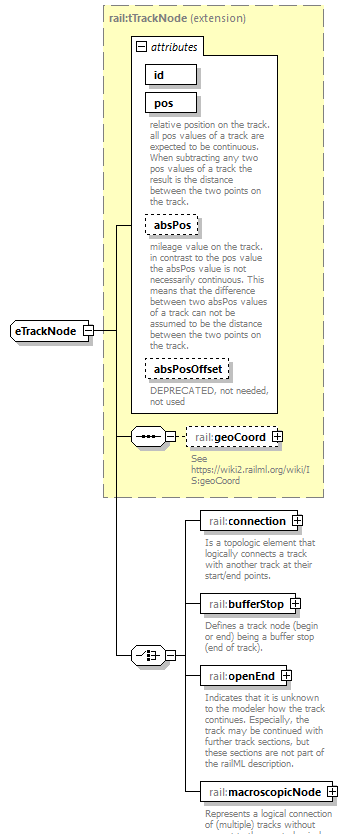 | ||||||||||||||||||||||||||||||||||||
| namespace | https://www.railml.org/schemas/2021 | ||||||||||||||||||||||||||||||||||||
| type | extension of rail:tTrackNode | ||||||||||||||||||||||||||||||||||||
| properties |
| ||||||||||||||||||||||||||||||||||||
| children | rail:geoCoord rail:connection rail:bufferStop rail:openEnd rail:macroscopicNode | ||||||||||||||||||||||||||||||||||||
| used by |
| ||||||||||||||||||||||||||||||||||||
| attributes |
| ||||||||||||||||||||||||||||||||||||
| source | <xs:complexType name="eTrackNode"> <xs:complexContent> <xs:extension base="rail:tTrackNode"> <xs:choice> <xs:element name="connection" type="rail:tConnectionData"> <xs:annotation> <xs:documentation>Is a topologic element that logically connects a track with another track at their start/end points.</xs:documentation> <xs:documentation>See https://wiki2.railml.org/wiki/IS:connection_trackBegin and https://wiki2.railml.org/wiki/IS:connection_trackEnd</xs:documentation> </xs:annotation> </xs:element> <xs:element name="bufferStop" type="rail:tBufferStop"> <xs:annotation> <xs:documentation>Defines a track node (begin or end) being a buffer stop (end of track).</xs:documentation> <xs:documentation>See https://wiki2.railml.org/wiki/IS:bufferStop</xs:documentation> </xs:annotation> </xs:element> <xs:element name="openEnd" type="rail:tOpenEnd"> <xs:annotation> <xs:documentation>Indicates that it is unknown to the modeler how the track continues. Especially, the track may be continued with further track sections, but these sections are not part of the railML description.</xs:documentation> <xs:documentation>See https://wiki2.railml.org/wiki/IS:openEnd</xs:documentation> </xs:annotation> </xs:element> <xs:element name="macroscopicNode" type="rail:tMacroscopicNode"> <xs:annotation> <xs:documentation>Represents a logical connection of (multiple) tracks without respect to the exact physical layout of their connections.</xs:documentation> <xs:documentation>See https://wiki2.railml.org/wiki/IS:macroscopicNode</xs:documentation> </xs:annotation> </xs:element> </xs:choice> </xs:extension> </xs:complexContent> </xs:complexType> |
element eTrackNode/connection
| diagram |  | ||||||||||||||||||
| namespace | https://www.railml.org/schemas/2021 | ||||||||||||||||||
| type | rail:tConnectionData | ||||||||||||||||||
| properties |
| ||||||||||||||||||
| attributes |
| ||||||||||||||||||
| annotation |
| ||||||||||||||||||
| source | <xs:element name="connection" type="rail:tConnectionData"> <xs:annotation> <xs:documentation>Is a topologic element that logically connects a track with another track at their start/end points.</xs:documentation> <xs:documentation>See https://wiki2.railml.org/wiki/IS:connection_trackBegin and https://wiki2.railml.org/wiki/IS:connection_trackEnd</xs:documentation> </xs:annotation> </xs:element> |
element eTrackNode/bufferStop
| diagram |  | ||||||||||||||||||||||||||||||||||||||||||||||
| namespace | https://www.railml.org/schemas/2021 | ||||||||||||||||||||||||||||||||||||||||||||||
| type | rail:tBufferStop | ||||||||||||||||||||||||||||||||||||||||||||||
| properties |
| ||||||||||||||||||||||||||||||||||||||||||||||
| children | rail:additionalName | ||||||||||||||||||||||||||||||||||||||||||||||
| attributes |
| ||||||||||||||||||||||||||||||||||||||||||||||
| annotation |
| ||||||||||||||||||||||||||||||||||||||||||||||
| source | <xs:element name="bufferStop" type="rail:tBufferStop"> <xs:annotation> <xs:documentation>Defines a track node (begin or end) being a buffer stop (end of track).</xs:documentation> <xs:documentation>See https://wiki2.railml.org/wiki/IS:bufferStop</xs:documentation> </xs:annotation> </xs:element> |
element eTrackNode/openEnd
| diagram | 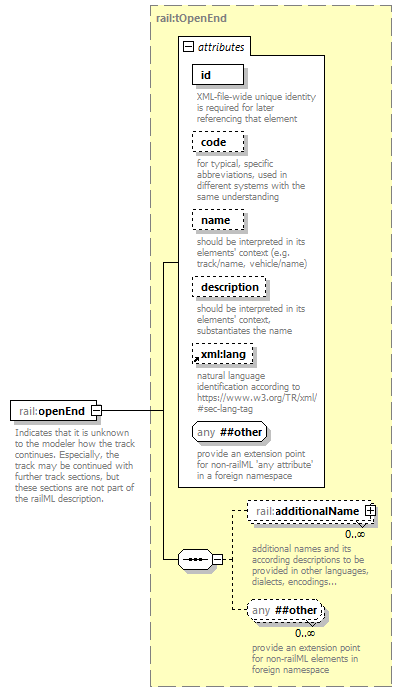 | ||||||||||||||||||||||||||||||||||||||||||||||
| namespace | https://www.railml.org/schemas/2021 | ||||||||||||||||||||||||||||||||||||||||||||||
| type | rail:tOpenEnd | ||||||||||||||||||||||||||||||||||||||||||||||
| properties |
| ||||||||||||||||||||||||||||||||||||||||||||||
| children | rail:additionalName | ||||||||||||||||||||||||||||||||||||||||||||||
| attributes |
| ||||||||||||||||||||||||||||||||||||||||||||||
| annotation |
| ||||||||||||||||||||||||||||||||||||||||||||||
| source | <xs:element name="openEnd" type="rail:tOpenEnd"> <xs:annotation> <xs:documentation>Indicates that it is unknown to the modeler how the track continues. Especially, the track may be continued with further track sections, but these sections are not part of the railML description.</xs:documentation> <xs:documentation>See https://wiki2.railml.org/wiki/IS:openEnd</xs:documentation> </xs:annotation> </xs:element> |
element eTrackNode/macroscopicNode
| diagram |  | ||||||||||||||||||
| namespace | https://www.railml.org/schemas/2021 | ||||||||||||||||||
| type | rail:tMacroscopicNode | ||||||||||||||||||
| properties |
| ||||||||||||||||||
| attributes |
| ||||||||||||||||||
| annotation |
| ||||||||||||||||||
| source | <xs:element name="macroscopicNode" type="rail:tMacroscopicNode"> <xs:annotation> <xs:documentation>Represents a logical connection of (multiple) tracks without respect to the exact physical layout of their connections.</xs:documentation> <xs:documentation>See https://wiki2.railml.org/wiki/IS:macroscopicNode</xs:documentation> </xs:annotation> </xs:element> |
complexType eTracks
| diagram |  | ||
| namespace | https://www.railml.org/schemas/2021 | ||
| children | rail:track | ||
| used by |
| ||
| source | <xs:complexType name="eTracks"> <xs:sequence> <xs:element name="track" type="rail:eTrack" minOccurs="0" maxOccurs="unbounded"> <xs:annotation> <xs:documentation>Represents one of possibly multiple rail pairs that make up a line.</xs:documentation> <xs:documentation>See https://wiki2.railml.org/wiki/IS:track</xs:documentation> </xs:annotation> </xs:element> </xs:sequence> </xs:complexType> |
element eTracks/track
| diagram |  | ||||||||||||||||||||||||||||||||||||||||||||||||||||||||||||||||||||||
| namespace | https://www.railml.org/schemas/2021 | ||||||||||||||||||||||||||||||||||||||||||||||||||||||||||||||||||||||
| type | rail:eTrack | ||||||||||||||||||||||||||||||||||||||||||||||||||||||||||||||||||||||
| properties |
| ||||||||||||||||||||||||||||||||||||||||||||||||||||||||||||||||||||||
| children | rail:additionalName rail:states rail:trackDescr rail:trackTopology rail:trackElements rail:ocsElements rail:infraAttrGroupRefs rail:impairmentSections rail:propPassengerInfo | ||||||||||||||||||||||||||||||||||||||||||||||||||||||||||||||||||||||
| attributes |
| ||||||||||||||||||||||||||||||||||||||||||||||||||||||||||||||||||||||
| annotation |
| ||||||||||||||||||||||||||||||||||||||||||||||||||||||||||||||||||||||
| source | <xs:element name="track" type="rail:eTrack" minOccurs="0" maxOccurs="unbounded"> <xs:annotation> <xs:documentation>Represents one of possibly multiple rail pairs that make up a line.</xs:documentation> <xs:documentation>See https://wiki2.railml.org/wiki/IS:track</xs:documentation> </xs:annotation> </xs:element> |
complexType eTrackTopology
| diagram | 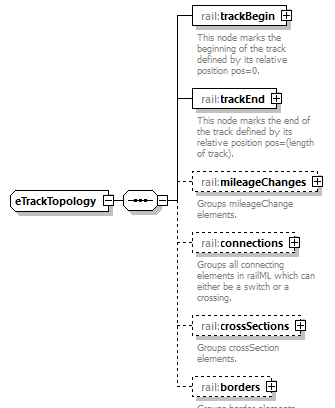 | ||
| namespace | https://www.railml.org/schemas/2021 | ||
| children | rail:trackBegin rail:trackEnd rail:mileageChanges rail:connections rail:crossSections rail:borders | ||
| used by |
| ||
| source | <xs:complexType name="eTrackTopology"> <xs:sequence> <xs:element name="trackBegin" type="rail:eTrackBegin"> <xs:annotation> <xs:documentation>This node marks the beginning of the track defined by its relative position pos=0.</xs:documentation> <xs:documentation>See https://wiki2.railml.org/wiki/IS:trackBegin</xs:documentation> </xs:annotation> </xs:element> <xs:element name="trackEnd" type="rail:eTrackEnd"> <xs:annotation> <xs:documentation>This node marks the end of the track defined by its relative position pos=(length of track).</xs:documentation> <xs:documentation>See https://wiki2.railml.org/wiki/IS:trackEnd</xs:documentation> </xs:annotation> </xs:element> <xs:element name="mileageChanges" type="rail:eMileageChanges" minOccurs="0"> <xs:annotation> <xs:documentation>Groups mileageChange elements.</xs:documentation> <xs:documentation>See https://wiki2.railml.org/wiki/IS:mileageChanges</xs:documentation> </xs:annotation> </xs:element> <xs:element name="connections" type="rail:eConnections" minOccurs="0"> <xs:annotation> <xs:documentation>Groups all connecting elements in railML which can either be a switch or a crossing.</xs:documentation> <xs:documentation>See https://wiki2.railml.org/wiki/IS:connections</xs:documentation> </xs:annotation> </xs:element> <xs:element name="crossSections" type="rail:eCrossSections" minOccurs="0"> <xs:annotation> <xs:documentation>Groups crossSection elements.</xs:documentation> <xs:documentation>See https://wiki2.railml.org/wiki/IS:crossSections</xs:documentation> </xs:annotation> </xs:element> <xs:element name="borders" type="rail:eBorder" minOccurs="0"> <xs:annotation> <xs:documentation>Groups border elements.</xs:documentation> <xs:documentation>See https://wiki2.railml.org/wiki/IS:borders</xs:documentation> </xs:annotation> </xs:element> </xs:sequence> </xs:complexType> |
element eTrackTopology/trackBegin
| diagram | 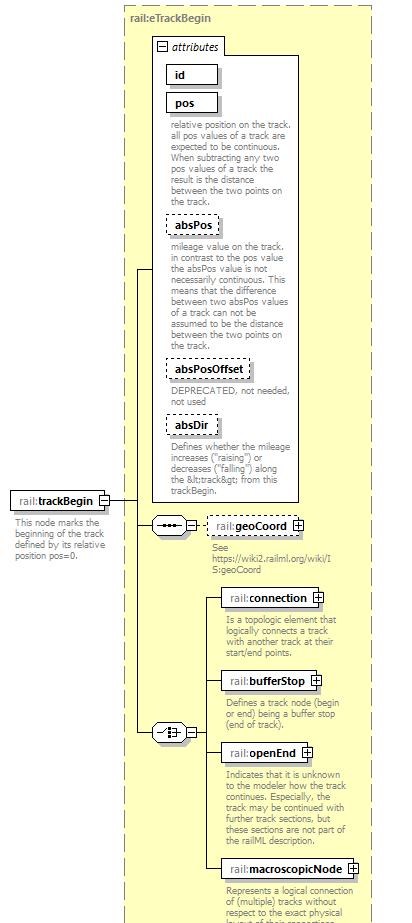 | ||||||||||||||||||||||||||||||||||||||||||||
| namespace | https://www.railml.org/schemas/2021 | ||||||||||||||||||||||||||||||||||||||||||||
| type | rail:eTrackBegin | ||||||||||||||||||||||||||||||||||||||||||||
| properties |
| ||||||||||||||||||||||||||||||||||||||||||||
| children | rail:geoCoord rail:connection rail:bufferStop rail:openEnd rail:macroscopicNode | ||||||||||||||||||||||||||||||||||||||||||||
| attributes |
| ||||||||||||||||||||||||||||||||||||||||||||
| annotation |
| ||||||||||||||||||||||||||||||||||||||||||||
| source | <xs:element name="trackBegin" type="rail:eTrackBegin"> <xs:annotation> <xs:documentation>This node marks the beginning of the track defined by its relative position pos=0.</xs:documentation> <xs:documentation>See https://wiki2.railml.org/wiki/IS:trackBegin</xs:documentation> </xs:annotation> </xs:element> |
element eTrackTopology/trackEnd
| diagram |  | ||||||||||||||||||||||||||||||||||||||||||||
| namespace | https://www.railml.org/schemas/2021 | ||||||||||||||||||||||||||||||||||||||||||||
| type | rail:eTrackEnd | ||||||||||||||||||||||||||||||||||||||||||||
| properties |
| ||||||||||||||||||||||||||||||||||||||||||||
| children | rail:geoCoord rail:connection rail:bufferStop rail:openEnd rail:macroscopicNode | ||||||||||||||||||||||||||||||||||||||||||||
| attributes |
| ||||||||||||||||||||||||||||||||||||||||||||
| annotation |
| ||||||||||||||||||||||||||||||||||||||||||||
| source | <xs:element name="trackEnd" type="rail:eTrackEnd"> <xs:annotation> <xs:documentation>This node marks the end of the track defined by its relative position pos=(length of track).</xs:documentation> <xs:documentation>See https://wiki2.railml.org/wiki/IS:trackEnd</xs:documentation> </xs:annotation> </xs:element> |
element eTrackTopology/mileageChanges
| diagram | 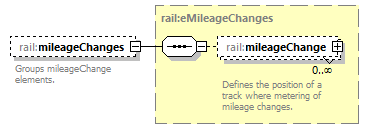 | ||||||
| namespace | https://www.railml.org/schemas/2021 | ||||||
| type | rail:eMileageChanges | ||||||
| properties |
| ||||||
| children | rail:mileageChange | ||||||
| annotation |
| ||||||
| source | <xs:element name="mileageChanges" type="rail:eMileageChanges" minOccurs="0"> <xs:annotation> <xs:documentation>Groups mileageChange elements.</xs:documentation> <xs:documentation>See https://wiki2.railml.org/wiki/IS:mileageChanges</xs:documentation> </xs:annotation> </xs:element> |
element eTrackTopology/connections
| diagram |  | ||||||
| namespace | https://www.railml.org/schemas/2021 | ||||||
| type | rail:eConnections | ||||||
| properties |
| ||||||
| children | rail:switch rail:crossing | ||||||
| annotation |
| ||||||
| source | <xs:element name="connections" type="rail:eConnections" minOccurs="0"> <xs:annotation> <xs:documentation>Groups all connecting elements in railML which can either be a switch or a crossing.</xs:documentation> <xs:documentation>See https://wiki2.railml.org/wiki/IS:connections</xs:documentation> </xs:annotation> </xs:element> |
element eTrackTopology/crossSections
| diagram |  | ||||||
| namespace | https://www.railml.org/schemas/2021 | ||||||
| type | rail:eCrossSections | ||||||
| properties |
| ||||||
| children | rail:crossSection | ||||||
| annotation |
| ||||||
| source | <xs:element name="crossSections" type="rail:eCrossSections" minOccurs="0"> <xs:annotation> <xs:documentation>Groups crossSection elements.</xs:documentation> <xs:documentation>See https://wiki2.railml.org/wiki/IS:crossSections</xs:documentation> </xs:annotation> </xs:element> |
element eTrackTopology/borders
| diagram |  | ||||||
| namespace | https://www.railml.org/schemas/2021 | ||||||
| type | rail:eBorder | ||||||
| properties |
| ||||||
| children | rail:border | ||||||
| annotation |
| ||||||
| source | <xs:element name="borders" type="rail:eBorder" minOccurs="0"> <xs:annotation> <xs:documentation>Groups border elements.</xs:documentation> <xs:documentation>See https://wiki2.railml.org/wiki/IS:borders</xs:documentation> </xs:annotation> </xs:element> |
complexType eTrackVis
| diagram |  | ||||||||||||||
| namespace | https://www.railml.org/schemas/2021 | ||||||||||||||
| type | extension of rail:tElementWithReference | ||||||||||||||
| properties |
| ||||||||||||||
| children | rail:trackElementVis | ||||||||||||||
| used by |
| ||||||||||||||
| attributes |
| ||||||||||||||
| source | <xs:complexType name="eTrackVis"> <xs:complexContent> <xs:extension base="rail:tElementWithReference"> <xs:sequence> <xs:element name="trackElementVis" type="rail:eTrackElementVis" minOccurs="0" maxOccurs="unbounded"> <xs:annotation> <xs:documentation>visualization of a railway track element</xs:documentation> <xs:documentation>See https://wiki2.railml.org/wiki/IS:trackElementVis</xs:documentation> </xs:annotation> </xs:element> </xs:sequence> </xs:extension> </xs:complexContent> </xs:complexType> |
element eTrackVis/trackElementVis
| diagram |  | ||||||||||||||
| namespace | https://www.railml.org/schemas/2021 | ||||||||||||||
| type | rail:eTrackElementVis | ||||||||||||||
| properties |
| ||||||||||||||
| children | rail:position | ||||||||||||||
| attributes |
| ||||||||||||||
| annotation |
| ||||||||||||||
| source | <xs:element name="trackElementVis" type="rail:eTrackElementVis" minOccurs="0" maxOccurs="unbounded"> <xs:annotation> <xs:documentation>visualization of a railway track element</xs:documentation> <xs:documentation>See https://wiki2.railml.org/wiki/IS:trackElementVis</xs:documentation> </xs:annotation> </xs:element> |
complexType eTrainDetectionElements
| diagram |  | ||
| namespace | https://www.railml.org/schemas/2021 | ||
| children | rail:trainDetector rail:trackCircuitBorder | ||
| used by |
| ||
| source | <xs:complexType name="eTrainDetectionElements"> <xs:choice minOccurs="0" maxOccurs="unbounded"> <xs:element name="trainDetector" type="rail:tTrainDetector"> <xs:annotation> <xs:documentation>Defines equipment for the discovery of the presence of a train, such as axle counters.</xs:documentation> <xs:documentation>See https://wiki2.railml.org/wiki/IS:trainDetector</xs:documentation> </xs:annotation> </xs:element> <xs:element name="trackCircuitBorder" type="rail:tTrackCircuitBorder"> <xs:annotation> <xs:documentation>Defines insulated rail joints.</xs:documentation> <xs:documentation>See https://wiki2.railml.org/wiki/IS:trackCircuitBorder</xs:documentation> </xs:annotation> </xs:element> </xs:choice> </xs:complexType> |
element eTrainDetectionElements/trainDetector
| diagram |  | ||||||||||||||||||||||||||||||||||||||||||||||||||||||||||||||||||||||||||||||||||||||||||||||||||||||||||||||||||||||||||||||||||||||||||
| namespace | https://www.railml.org/schemas/2021 | ||||||||||||||||||||||||||||||||||||||||||||||||||||||||||||||||||||||||||||||||||||||||||||||||||||||||||||||||||||||||||||||||||||||||||
| type | rail:tTrainDetector | ||||||||||||||||||||||||||||||||||||||||||||||||||||||||||||||||||||||||||||||||||||||||||||||||||||||||||||||||||||||||||||||||||||||||||
| properties |
| ||||||||||||||||||||||||||||||||||||||||||||||||||||||||||||||||||||||||||||||||||||||||||||||||||||||||||||||||||||||||||||||||||||||||||
| children | rail:additionalName rail:geoCoord rail:states | ||||||||||||||||||||||||||||||||||||||||||||||||||||||||||||||||||||||||||||||||||||||||||||||||||||||||||||||||||||||||||||||||||||||||||
| attributes |
| ||||||||||||||||||||||||||||||||||||||||||||||||||||||||||||||||||||||||||||||||||||||||||||||||||||||||||||||||||||||||||||||||||||||||||
| annotation |
| ||||||||||||||||||||||||||||||||||||||||||||||||||||||||||||||||||||||||||||||||||||||||||||||||||||||||||||||||||||||||||||||||||||||||||
| source | <xs:element name="trainDetector" type="rail:tTrainDetector"> <xs:annotation> <xs:documentation>Defines equipment for the discovery of the presence of a train, such as axle counters.</xs:documentation> <xs:documentation>See https://wiki2.railml.org/wiki/IS:trainDetector</xs:documentation> </xs:annotation> </xs:element> |
element eTrainDetectionElements/trackCircuitBorder
| diagram |  | ||||||||||||||||||||||||||||||||||||||||||||||||||||||||||||||||||||||||||||||||||||||||||||||||||||
| namespace | https://www.railml.org/schemas/2021 | ||||||||||||||||||||||||||||||||||||||||||||||||||||||||||||||||||||||||||||||||||||||||||||||||||||
| type | rail:tTrackCircuitBorder | ||||||||||||||||||||||||||||||||||||||||||||||||||||||||||||||||||||||||||||||||||||||||||||||||||||
| properties |
| ||||||||||||||||||||||||||||||||||||||||||||||||||||||||||||||||||||||||||||||||||||||||||||||||||||
| children | rail:additionalName rail:geoCoord rail:states | ||||||||||||||||||||||||||||||||||||||||||||||||||||||||||||||||||||||||||||||||||||||||||||||||||||
| attributes |
| ||||||||||||||||||||||||||||||||||||||||||||||||||||||||||||||||||||||||||||||||||||||||||||||||||||
| annotation |
| ||||||||||||||||||||||||||||||||||||||||||||||||||||||||||||||||||||||||||||||||||||||||||||||||||||
| source | <xs:element name="trackCircuitBorder" type="rail:tTrackCircuitBorder"> <xs:annotation> <xs:documentation>Defines insulated rail joints.</xs:documentation> <xs:documentation>See https://wiki2.railml.org/wiki/IS:trackCircuitBorder</xs:documentation> </xs:annotation> </xs:element> |
complexType eTrainProtectionChanges
| diagram |  | ||
| namespace | https://www.railml.org/schemas/2021 | ||
| children | rail:trainProtectionChange | ||
| used by |
| ||
| source | <xs:complexType name="eTrainProtectionChanges"> <xs:sequence> <xs:element name="trainProtectionChange" type="rail:tTrainProtectionChange" minOccurs="0" maxOccurs="unbounded"> <xs:annotation> <xs:documentation>Defines a point in which the mode of train protection changes.</xs:documentation> <xs:documentation>See https://wiki2.railml.org/wiki/IS:trainProtectionChange</xs:documentation> </xs:annotation> </xs:element> </xs:sequence> </xs:complexType> |
element eTrainProtectionChanges/trainProtectionChange
| diagram |  | ||||||||||||||||||||||||||||||||||||||||||||||||||||||||||||||||||||||||||||||||||||||||||||||||||||
| namespace | https://www.railml.org/schemas/2021 | ||||||||||||||||||||||||||||||||||||||||||||||||||||||||||||||||||||||||||||||||||||||||||||||||||||
| type | rail:tTrainProtectionChange | ||||||||||||||||||||||||||||||||||||||||||||||||||||||||||||||||||||||||||||||||||||||||||||||||||||
| properties |
| ||||||||||||||||||||||||||||||||||||||||||||||||||||||||||||||||||||||||||||||||||||||||||||||||||||
| children | rail:additionalName rail:geoCoord rail:states | ||||||||||||||||||||||||||||||||||||||||||||||||||||||||||||||||||||||||||||||||||||||||||||||||||||
| attributes |
| ||||||||||||||||||||||||||||||||||||||||||||||||||||||||||||||||||||||||||||||||||||||||||||||||||||
| annotation |
| ||||||||||||||||||||||||||||||||||||||||||||||||||||||||||||||||||||||||||||||||||||||||||||||||||||
| source | <xs:element name="trainProtectionChange" type="rail:tTrainProtectionChange" minOccurs="0" maxOccurs="unbounded"> <xs:annotation> <xs:documentation>Defines a point in which the mode of train protection changes.</xs:documentation> <xs:documentation>See https://wiki2.railml.org/wiki/IS:trainProtectionChange</xs:documentation> </xs:annotation> </xs:element> |
complexType eTrainProtectionElements
| diagram |  | ||
| namespace | https://www.railml.org/schemas/2021 | ||
| children | rail:trainProtectionElement rail:trainProtectionElementGroup | ||
| used by |
| ||
| source | <xs:complexType name="eTrainProtectionElements"> <xs:sequence> <xs:element name="trainProtectionElement" type="rail:tTrainProtectionElement" minOccurs="0" maxOccurs="unbounded"> <xs:annotation> <xs:documentation>Defines track-side elements for train protection, e.g. magnets.</xs:documentation> <xs:documentation>See https://wiki2.railml.org/wiki/IS:trainProtectionElement</xs:documentation> </xs:annotation> </xs:element> <xs:element name="trainProtectionElementGroup" type="rail:tTrainProtectionElementGroup" minOccurs="0" maxOccurs="unbounded"> <xs:annotation> <xs:documentation>Associates various train protection elements.</xs:documentation> <xs:documentation>See https://wiki2.railml.org/wiki/IS:trainProtectionElementGroup</xs:documentation> </xs:annotation> </xs:element> </xs:sequence> </xs:complexType> |
element eTrainProtectionElements/trainProtectionElement
| diagram |  | ||||||||||||||||||||||||||||||||||||||||||||||||||||||||||||||||||||||||||||||||||||||||||||||||||||||||||||||||||
| namespace | https://www.railml.org/schemas/2021 | ||||||||||||||||||||||||||||||||||||||||||||||||||||||||||||||||||||||||||||||||||||||||||||||||||||||||||||||||||
| type | rail:tTrainProtectionElement | ||||||||||||||||||||||||||||||||||||||||||||||||||||||||||||||||||||||||||||||||||||||||||||||||||||||||||||||||||
| properties |
| ||||||||||||||||||||||||||||||||||||||||||||||||||||||||||||||||||||||||||||||||||||||||||||||||||||||||||||||||||
| children | rail:additionalName rail:geoCoord rail:states | ||||||||||||||||||||||||||||||||||||||||||||||||||||||||||||||||||||||||||||||||||||||||||||||||||||||||||||||||||
| attributes |
| ||||||||||||||||||||||||||||||||||||||||||||||||||||||||||||||||||||||||||||||||||||||||||||||||||||||||||||||||||
| annotation |
| ||||||||||||||||||||||||||||||||||||||||||||||||||||||||||||||||||||||||||||||||||||||||||||||||||||||||||||||||||
| source | <xs:element name="trainProtectionElement" type="rail:tTrainProtectionElement" minOccurs="0" maxOccurs="unbounded"> <xs:annotation> <xs:documentation>Defines track-side elements for train protection, e.g. magnets.</xs:documentation> <xs:documentation>See https://wiki2.railml.org/wiki/IS:trainProtectionElement</xs:documentation> </xs:annotation> </xs:element> |
element eTrainProtectionElements/trainProtectionElementGroup
| diagram |  | ||||||||||||||||||||||||||||||||||||||||||||||
| namespace | https://www.railml.org/schemas/2021 | ||||||||||||||||||||||||||||||||||||||||||||||
| type | rail:tTrainProtectionElementGroup | ||||||||||||||||||||||||||||||||||||||||||||||
| properties |
| ||||||||||||||||||||||||||||||||||||||||||||||
| children | rail:additionalName rail:trainProtectionElementRef | ||||||||||||||||||||||||||||||||||||||||||||||
| attributes |
| ||||||||||||||||||||||||||||||||||||||||||||||
| annotation |
| ||||||||||||||||||||||||||||||||||||||||||||||
| source | <xs:element name="trainProtectionElementGroup" type="rail:tTrainProtectionElementGroup" minOccurs="0" maxOccurs="unbounded"> <xs:annotation> <xs:documentation>Associates various train protection elements.</xs:documentation> <xs:documentation>See https://wiki2.railml.org/wiki/IS:trainProtectionElementGroup</xs:documentation> </xs:annotation> </xs:element> |
complexType eTrainRadioChanges
| diagram |  | ||
| namespace | https://www.railml.org/schemas/2021 | ||
| children | rail:trainRadioChange | ||
| used by |
| ||
| source | <xs:complexType name="eTrainRadioChanges"> <xs:sequence> <xs:element name="trainRadioChange" type="rail:tTrainRadioChange" maxOccurs="unbounded"> <xs:annotation> <xs:documentation>Defines a point in which the train radio equipment on the infrastructure side changes.</xs:documentation> <xs:documentation>See https://wiki2.railml.org/wiki/IS:trainRadioChange</xs:documentation> </xs:annotation> </xs:element> </xs:sequence> </xs:complexType> |
element eTrainRadioChanges/trainRadioChange
| diagram |  | ||||||||||||||||||||||||||||||||||||||||||||||||||||||||||||||||||||||||||||||||||||||||||||||||||||||||||||||||||||||||||||||||||||||
| namespace | https://www.railml.org/schemas/2021 | ||||||||||||||||||||||||||||||||||||||||||||||||||||||||||||||||||||||||||||||||||||||||||||||||||||||||||||||||||||||||||||||||||||||
| type | rail:tTrainRadioChange | ||||||||||||||||||||||||||||||||||||||||||||||||||||||||||||||||||||||||||||||||||||||||||||||||||||||||||||||||||||||||||||||||||||||
| properties |
| ||||||||||||||||||||||||||||||||||||||||||||||||||||||||||||||||||||||||||||||||||||||||||||||||||||||||||||||||||||||||||||||||||||||
| children | rail:additionalName rail:geoCoord rail:states | ||||||||||||||||||||||||||||||||||||||||||||||||||||||||||||||||||||||||||||||||||||||||||||||||||||||||||||||||||||||||||||||||||||||
| attributes |
| ||||||||||||||||||||||||||||||||||||||||||||||||||||||||||||||||||||||||||||||||||||||||||||||||||||||||||||||||||||||||||||||||||||||
| annotation |
| ||||||||||||||||||||||||||||||||||||||||||||||||||||||||||||||||||||||||||||||||||||||||||||||||||||||||||||||||||||||||||||||||||||||
| source | <xs:element name="trainRadioChange" type="rail:tTrainRadioChange" maxOccurs="unbounded"> <xs:annotation> <xs:documentation>Defines a point in which the train radio equipment on the infrastructure side changes.</xs:documentation> <xs:documentation>See https://wiki2.railml.org/wiki/IS:trainRadioChange</xs:documentation> </xs:annotation> </xs:element> |
complexType eTunnel
| diagram |  | ||||||||||||||||||||||||||||||||||||||||||||||||||||||||||||||||||||||||||||||||||||||||||||||||||||||||||||||||||||||||||||
| namespace | https://www.railml.org/schemas/2021 | ||||||||||||||||||||||||||||||||||||||||||||||||||||||||||||||||||||||||||||||||||||||||||||||||||||||||||||||||||||||||||||
| type | extension of rail:tTunnel | ||||||||||||||||||||||||||||||||||||||||||||||||||||||||||||||||||||||||||||||||||||||||||||||||||||||||||||||||||||||||||||
| properties |
| ||||||||||||||||||||||||||||||||||||||||||||||||||||||||||||||||||||||||||||||||||||||||||||||||||||||||||||||||||||||||||||
| children | rail:additionalName rail:geoCoord rail:states rail:crossedElements | ||||||||||||||||||||||||||||||||||||||||||||||||||||||||||||||||||||||||||||||||||||||||||||||||||||||||||||||||||||||||||||
| used by |
| ||||||||||||||||||||||||||||||||||||||||||||||||||||||||||||||||||||||||||||||||||||||||||||||||||||||||||||||||||||||||||||
| attributes |
| ||||||||||||||||||||||||||||||||||||||||||||||||||||||||||||||||||||||||||||||||||||||||||||||||||||||||||||||||||||||||||||
| source | <xs:complexType name="eTunnel"> <xs:complexContent> <xs:extension base="rail:tTunnel"> <xs:sequence> <xs:element name="crossedElements" type="rail:eCrossedElements" minOccurs="0"> <xs:annotation> <xs:documentation>Lists the elements that are crossed by this tunnel.</xs:documentation> <xs:documentation>See https://wiki2.railml.org/wiki/IS:crossedElements_tunnel</xs:documentation> </xs:annotation> </xs:element> </xs:sequence> </xs:extension> </xs:complexContent> </xs:complexType> |
element eTunnel/crossedElements
| diagram |  | ||||||
| namespace | https://www.railml.org/schemas/2021 | ||||||
| type | rail:eCrossedElements | ||||||
| properties |
| ||||||
| children | rail:crossedElement | ||||||
| annotation |
| ||||||
| source | <xs:element name="crossedElements" type="rail:eCrossedElements" minOccurs="0"> <xs:annotation> <xs:documentation>Lists the elements that are crossed by this tunnel.</xs:documentation> <xs:documentation>See https://wiki2.railml.org/wiki/IS:crossedElements_tunnel</xs:documentation> </xs:annotation> </xs:element> |
complexType eTunnels
| diagram |  | ||
| namespace | https://www.railml.org/schemas/2021 | ||
| children | rail:tunnel | ||
| used by |
| ||
| source | <xs:complexType name="eTunnels"> <xs:sequence> <xs:element name="tunnel" type="rail:eTunnel" minOccurs="0" maxOccurs="unbounded"> <xs:annotation> <xs:documentation>Defines a horizontal passageway through or under an obstruction as an infrastructure element and its attributes.</xs:documentation> <xs:documentation>See https://wiki2.railml.org/wiki/IS:tunnel</xs:documentation> </xs:annotation> </xs:element> </xs:sequence> </xs:complexType> |
element eTunnels/tunnel
| diagram |  | ||||||||||||||||||||||||||||||||||||||||||||||||||||||||||||||||||||||||||||||||||||||||||||||||||||||||||||||||||||||||||||
| namespace | https://www.railml.org/schemas/2021 | ||||||||||||||||||||||||||||||||||||||||||||||||||||||||||||||||||||||||||||||||||||||||||||||||||||||||||||||||||||||||||||
| type | rail:eTunnel | ||||||||||||||||||||||||||||||||||||||||||||||||||||||||||||||||||||||||||||||||||||||||||||||||||||||||||||||||||||||||||||
| properties |
| ||||||||||||||||||||||||||||||||||||||||||||||||||||||||||||||||||||||||||||||||||||||||||||||||||||||||||||||||||||||||||||
| children | rail:additionalName rail:geoCoord rail:states rail:crossedElements | ||||||||||||||||||||||||||||||||||||||||||||||||||||||||||||||||||||||||||||||||||||||||||||||||||||||||||||||||||||||||||||
| attributes |
| ||||||||||||||||||||||||||||||||||||||||||||||||||||||||||||||||||||||||||||||||||||||||||||||||||||||||||||||||||||||||||||
| annotation |
| ||||||||||||||||||||||||||||||||||||||||||||||||||||||||||||||||||||||||||||||||||||||||||||||||||||||||||||||||||||||||||||
| source | <xs:element name="tunnel" type="rail:eTunnel" minOccurs="0" maxOccurs="unbounded"> <xs:annotation> <xs:documentation>Defines a horizontal passageway through or under an obstruction as an infrastructure element and its attributes.</xs:documentation> <xs:documentation>See https://wiki2.railml.org/wiki/IS:tunnel</xs:documentation> </xs:annotation> </xs:element> |
element rollingstock
| diagram |  | ||||||||||||||||||||||||||||||||||||||||||||||||||||||||||||||||||||||||||||||
| namespace | https://www.railml.org/schemas/2021 | ||||||||||||||||||||||||||||||||||||||||||||||||||||||||||||||||||||||||||||||
| type | extension of rail:tRollingstock | ||||||||||||||||||||||||||||||||||||||||||||||||||||||||||||||||||||||||||||||
| properties |
| ||||||||||||||||||||||||||||||||||||||||||||||||||||||||||||||||||||||||||||||
| children | rail:additionalName rail:metadata rail:vehicles rail:formations | ||||||||||||||||||||||||||||||||||||||||||||||||||||||||||||||||||||||||||||||
| used by |
| ||||||||||||||||||||||||||||||||||||||||||||||||||||||||||||||||||||||||||||||
| attributes |
| ||||||||||||||||||||||||||||||||||||||||||||||||||||||||||||||||||||||||||||||
| identity constraints |
| ||||||||||||||||||||||||||||||||||||||||||||||||||||||||||||||||||||||||||||||
| annotation |
| ||||||||||||||||||||||||||||||||||||||||||||||||||||||||||||||||||||||||||||||
| source | <xs:element name="rollingstock"> <xs:annotation> <xs:documentation>container for rolling stock data of single vehicles and train formations</xs:documentation> <xs:documentation>See https://wiki2.railml.org/wiki/RS:rollingstock</xs:documentation> </xs:annotation> <xs:complexType> <xs:complexContent> <xs:extension base="rail:tRollingstock"> <xs:sequence> <xs:element name="vehicles" type="rail:eVehicles" minOccurs="0"> <xs:annotation> <xs:documentation>container for single vehicle data or vehicle family data</xs:documentation> <xs:documentation>See https://wiki2.railml.org/wiki/RS:vehicles</xs:documentation> </xs:annotation> </xs:element> <xs:element name="formations" type="rail:eFormations" minOccurs="0"> <xs:annotation> <xs:documentation>container for complete train formations or sets of vehicles</xs:documentation> <xs:documentation>See https://wiki2.railml.org/wiki/RS:formations</xs:documentation> </xs:annotation> </xs:element> </xs:sequence> </xs:extension> </xs:complexContent> </xs:complexType> <xs:key name="etcsKey"> <xs:selector xpath=".//rail:vehicles/rail:vehicle/rail:engine/rail:monitoring/rail:etcs"/> <xs:field xpath="@id"/> </xs:key> <xs:key name="specificTransmissionModuleKey"> <xs:selector xpath=".//rail:vehicles/rail:vehicle/rail:engine/rail:monitoring/rail:etcs/rail:specificTransmissionModule"/> <xs:field xpath="@id"/> </xs:key> <xs:key name="nationalSystemKey"> <xs:selector xpath=".//rail:vehicles/rail:vehicle/rail:engine/rail:monitoring/rail:nationalSystem"/> <xs:field xpath="@id"/> </xs:key> <xs:keyref name="nationalSystem-specificTransmissionModuleKeyref" refer="rail:nationalSystemKey"> <xs:selector xpath=".//rail:etcs/rail:specificTransmissionModule"/> <xs:field xpath="@nationalSystemRef"/> </xs:keyref> <xs:key name="trainRadioKey"> <xs:selector xpath=".//rail:vehicles/rail:vehicle/rail:engine/rail:monitoring/rail:trainRadio"/> <xs:field xpath="@id"/> </xs:key> <xs:key name="otherEquipmentKey"> <xs:selector xpath=".//rail:vehicles/rail:vehicle/rail:engine/rail:monitoring/rail:otherEquipment"/> <xs:field xpath="@id"/> </xs:key> <xs:key name="energyStorageKey"> <xs:selector xpath=".//rail:vehicles/rail:vehicle/rail:engine/rail:energyStorage"/> <xs:field xpath="@id"/> </xs:key> <xs:key name="propulsionKey"> <xs:selector xpath=".//rail:vehicles/rail:vehicle/rail:engine/rail:propulsion"/> <xs:field xpath="@id"/> </xs:key> </xs:element> |
element rollingstock/vehicles
| diagram |  | ||||||
| namespace | https://www.railml.org/schemas/2021 | ||||||
| type | rail:eVehicles | ||||||
| properties |
| ||||||
| children | rail:vehicle | ||||||
| annotation |
| ||||||
| source | <xs:element name="vehicles" type="rail:eVehicles" minOccurs="0"> <xs:annotation> <xs:documentation>container for single vehicle data or vehicle family data</xs:documentation> <xs:documentation>See https://wiki2.railml.org/wiki/RS:vehicles</xs:documentation> </xs:annotation> </xs:element> |
element rollingstock/formations
| diagram |  | ||||||
| namespace | https://www.railml.org/schemas/2021 | ||||||
| type | rail:eFormations | ||||||
| properties |
| ||||||
| children | rail:formation | ||||||
| annotation |
| ||||||
| source | <xs:element name="formations" type="rail:eFormations" minOccurs="0"> <xs:annotation> <xs:documentation>container for complete train formations or sets of vehicles</xs:documentation> <xs:documentation>See https://wiki2.railml.org/wiki/RS:formations</xs:documentation> </xs:annotation> </xs:element> |
complexType eAuxiliarySupply
| diagram |  | ||||||||||||||||||||||||||||||||||||||||||||||||||||||
| namespace | https://www.railml.org/schemas/2021 | ||||||||||||||||||||||||||||||||||||||||||||||||||||||
| type | extension of rail:tAuxiliarySupply | ||||||||||||||||||||||||||||||||||||||||||||||||||||||
| properties |
| ||||||||||||||||||||||||||||||||||||||||||||||||||||||
| children | rail:dedicatedSupplySystem | ||||||||||||||||||||||||||||||||||||||||||||||||||||||
| used by |
| ||||||||||||||||||||||||||||||||||||||||||||||||||||||
| attributes |
| ||||||||||||||||||||||||||||||||||||||||||||||||||||||
| source | <xs:complexType name="eAuxiliarySupply"> <xs:complexContent> <xs:extension base="rail:tAuxiliarySupply"> <xs:sequence> <xs:element name="dedicatedSupplySystem" type="rail:tAuxiliarySupplySystem" minOccurs="0" maxOccurs="unbounded"> <xs:annotation> <xs:documentation>list of available supply systems for auxiliaries</xs:documentation> <xs:documentation>See https://wiki2.railml.org/wiki/RS:dedicatedSupplySystem_auxiliarySupply</xs:documentation> </xs:annotation> </xs:element> </xs:sequence> </xs:extension> </xs:complexContent> </xs:complexType> |
element eAuxiliarySupply/dedicatedSupplySystem
| diagram |  | ||||||||||||||||||||||||||||||
| namespace | https://www.railml.org/schemas/2021 | ||||||||||||||||||||||||||||||
| type | rail:tAuxiliarySupplySystem | ||||||||||||||||||||||||||||||
| properties |
| ||||||||||||||||||||||||||||||
| attributes |
| ||||||||||||||||||||||||||||||
| annotation |
| ||||||||||||||||||||||||||||||
| source | <xs:element name="dedicatedSupplySystem" type="rail:tAuxiliarySupplySystem" minOccurs="0" maxOccurs="unbounded"> <xs:annotation> <xs:documentation>list of available supply systems for auxiliaries</xs:documentation> <xs:documentation>See https://wiki2.railml.org/wiki/RS:dedicatedSupplySystem_auxiliarySupply</xs:documentation> </xs:annotation> </xs:element> |
complexType eClassification
| diagram | 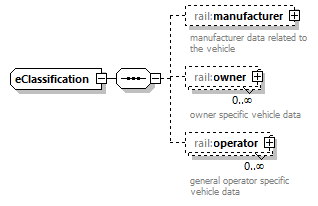 | ||
| namespace | https://www.railml.org/schemas/2021 | ||
| children | rail:manufacturer rail:owner rail:operator | ||
| used by |
| ||
| source | <xs:complexType name="eClassification"> <xs:sequence> <xs:element name="manufacturer" type="rail:tManufacturer" minOccurs="0"> <xs:annotation> <xs:documentation>manufacturer data related to the vehicle</xs:documentation> <xs:documentation>See https://wiki2.railml.org/wiki/RS:manufacturer</xs:documentation> </xs:annotation> </xs:element> <xs:element name="owner" type="rail:tOwnerRS" minOccurs="0" maxOccurs="unbounded"> <xs:annotation> <xs:documentation>owner specific vehicle data</xs:documentation> <xs:documentation>See https://wiki2.railml.org/wiki/RS:owner</xs:documentation> </xs:annotation> </xs:element> <xs:element name="operator" type="rail:eOperator" minOccurs="0" maxOccurs="unbounded"> <xs:annotation> <xs:documentation>general operator specific vehicle data</xs:documentation> <xs:documentation>See https://wiki2.railml.org/wiki/RS:operator</xs:documentation> </xs:annotation> </xs:element> </xs:sequence> </xs:complexType> |
element eClassification/manufacturer
| diagram |  | ||||||||||||||||||||||||||||||||||||||
| namespace | https://www.railml.org/schemas/2021 | ||||||||||||||||||||||||||||||||||||||
| type | rail:tManufacturer | ||||||||||||||||||||||||||||||||||||||
| properties |
| ||||||||||||||||||||||||||||||||||||||
| attributes |
| ||||||||||||||||||||||||||||||||||||||
| annotation |
| ||||||||||||||||||||||||||||||||||||||
| source | <xs:element name="manufacturer" type="rail:tManufacturer" minOccurs="0"> <xs:annotation> <xs:documentation>manufacturer data related to the vehicle</xs:documentation> <xs:documentation>See https://wiki2.railml.org/wiki/RS:manufacturer</xs:documentation> </xs:annotation> </xs:element> |
element eClassification/owner
| diagram | 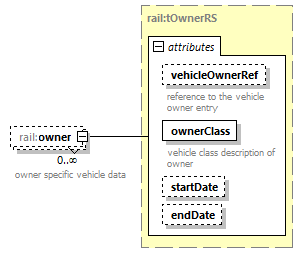 | ||||||||||||||||||||||||||||||||||
| namespace | https://www.railml.org/schemas/2021 | ||||||||||||||||||||||||||||||||||
| type | rail:tOwnerRS | ||||||||||||||||||||||||||||||||||
| properties |
| ||||||||||||||||||||||||||||||||||
| attributes |
| ||||||||||||||||||||||||||||||||||
| annotation |
| ||||||||||||||||||||||||||||||||||
| source | <xs:element name="owner" type="rail:tOwnerRS" minOccurs="0" maxOccurs="unbounded"> <xs:annotation> <xs:documentation>owner specific vehicle data</xs:documentation> <xs:documentation>See https://wiki2.railml.org/wiki/RS:owner</xs:documentation> </xs:annotation> </xs:element> |
element eClassification/operator
| diagram | 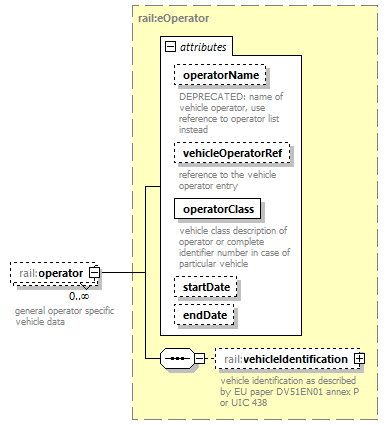 | ||||||||||||||||||||||||||||||||||||||||||
| namespace | https://www.railml.org/schemas/2021 | ||||||||||||||||||||||||||||||||||||||||||
| type | rail:eOperator | ||||||||||||||||||||||||||||||||||||||||||
| properties |
| ||||||||||||||||||||||||||||||||||||||||||
| children | rail:vehicleIdentification | ||||||||||||||||||||||||||||||||||||||||||
| attributes |
| ||||||||||||||||||||||||||||||||||||||||||
| annotation |
| ||||||||||||||||||||||||||||||||||||||||||
| source | <xs:element name="operator" type="rail:eOperator" minOccurs="0" maxOccurs="unbounded"> <xs:annotation> <xs:documentation>general operator specific vehicle data</xs:documentation> <xs:documentation>See https://wiki2.railml.org/wiki/RS:operator</xs:documentation> </xs:annotation> </xs:element> |
complexType eCouplers
| diagram |  | ||
| namespace | https://www.railml.org/schemas/2021 | ||
| children | rail:mechanicalCoupler rail:pneumaticCoupler rail:electricalCoupler | ||
| used by |
| ||
| source | <xs:complexType name="eCouplers"> <xs:sequence> <xs:element name="mechanicalCoupler" type="rail:eMechanicalCoupler" minOccurs="0" maxOccurs="unbounded"> <xs:annotation> <xs:documentation>container for available mechanical couplers between wagons</xs:documentation> <xs:documentation>See https://wiki2.railml.org/wiki/RS:mechanicalCoupler</xs:documentation> </xs:annotation> </xs:element> <xs:element name="pneumaticCoupler" type="rail:ePneumaticCoupler" minOccurs="0" maxOccurs="unbounded"> <xs:annotation> <xs:documentation>container for available pneumatic couplers between wagons</xs:documentation> <xs:documentation>See https://wiki2.railml.org/wiki/RS:pneumaticCoupler</xs:documentation> </xs:annotation> </xs:element> <xs:element name="electricalCoupler" type="rail:eElectricalCoupler" minOccurs="0" maxOccurs="unbounded"> <xs:annotation> <xs:documentation>container for available electrical couplers between wagons</xs:documentation> <xs:documentation>See https://wiki2.railml.org/wiki/RS:electricalCoupler</xs:documentation> </xs:annotation> </xs:element> </xs:sequence> </xs:complexType> |
element eCouplers/mechanicalCoupler
| diagram | 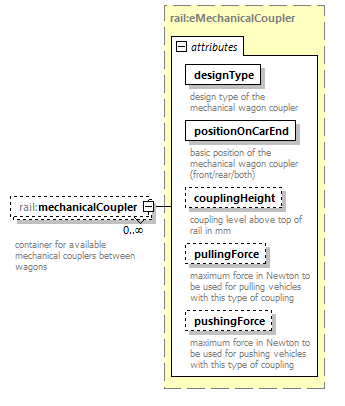 | ||||||||||||||||||||||||||||||||||||||||||||||
| namespace | https://www.railml.org/schemas/2021 | ||||||||||||||||||||||||||||||||||||||||||||||
| type | rail:eMechanicalCoupler | ||||||||||||||||||||||||||||||||||||||||||||||
| properties |
| ||||||||||||||||||||||||||||||||||||||||||||||
| attributes |
| ||||||||||||||||||||||||||||||||||||||||||||||
| annotation |
| ||||||||||||||||||||||||||||||||||||||||||||||
| source | <xs:element name="mechanicalCoupler" type="rail:eMechanicalCoupler" minOccurs="0" maxOccurs="unbounded"> <xs:annotation> <xs:documentation>container for available mechanical couplers between wagons</xs:documentation> <xs:documentation>See https://wiki2.railml.org/wiki/RS:mechanicalCoupler</xs:documentation> </xs:annotation> </xs:element> |
element eCouplers/pneumaticCoupler
| diagram |  | ||||||||||||||||||||||||||||||
| namespace | https://www.railml.org/schemas/2021 | ||||||||||||||||||||||||||||||
| type | rail:ePneumaticCoupler | ||||||||||||||||||||||||||||||
| properties |
| ||||||||||||||||||||||||||||||
| attributes |
| ||||||||||||||||||||||||||||||
| annotation |
| ||||||||||||||||||||||||||||||
| source | <xs:element name="pneumaticCoupler" type="rail:ePneumaticCoupler" minOccurs="0" maxOccurs="unbounded"> <xs:annotation> <xs:documentation>container for available pneumatic couplers between wagons</xs:documentation> <xs:documentation>See https://wiki2.railml.org/wiki/RS:pneumaticCoupler</xs:documentation> </xs:annotation> </xs:element> |
element eCouplers/electricalCoupler
| diagram |  | ||||||||||||||||||||||||||||||||||||||
| namespace | https://www.railml.org/schemas/2021 | ||||||||||||||||||||||||||||||||||||||
| type | rail:eElectricalCoupler | ||||||||||||||||||||||||||||||||||||||
| properties |
| ||||||||||||||||||||||||||||||||||||||
| attributes |
| ||||||||||||||||||||||||||||||||||||||
| annotation |
| ||||||||||||||||||||||||||||||||||||||
| source | <xs:element name="electricalCoupler" type="rail:eElectricalCoupler" minOccurs="0" maxOccurs="unbounded"> <xs:annotation> <xs:documentation>container for available electrical couplers between wagons</xs:documentation> <xs:documentation>See https://wiki2.railml.org/wiki/RS:electricalCoupler</xs:documentation> </xs:annotation> </xs:element> |
complexType eCurvingLimitation
| diagram |  | ||||||||||||||||||||||||||||||
| namespace | https://www.railml.org/schemas/2021 | ||||||||||||||||||||||||||||||
| type | extension of rail:tCurvingLimitationType | ||||||||||||||||||||||||||||||
| properties |
| ||||||||||||||||||||||||||||||
| used by |
| ||||||||||||||||||||||||||||||
| attributes |
| ||||||||||||||||||||||||||||||
| source | <xs:complexType name="eCurvingLimitation"> <xs:complexContent> <xs:extension base="rail:tCurvingLimitationType"> <xs:annotation> <xs:documentation>See https://wiki2.railml.org/wiki/RS:curvingLimitation</xs:documentation> </xs:annotation> </xs:extension> </xs:complexContent> </xs:complexType> |
complexType eDoors
| diagram |  | ||||||||||||||||||||||||||||||||||||||||||||||||||||||||||||||||||||||
| namespace | https://www.railml.org/schemas/2021 | ||||||||||||||||||||||||||||||||||||||||||||||||||||||||||||||||||||||
| type | extension of rail:tDoors | ||||||||||||||||||||||||||||||||||||||||||||||||||||||||||||||||||||||
| properties |
| ||||||||||||||||||||||||||||||||||||||||||||||||||||||||||||||||||||||
| children | rail:passengerFlowSpeed | ||||||||||||||||||||||||||||||||||||||||||||||||||||||||||||||||||||||
| used by |
| ||||||||||||||||||||||||||||||||||||||||||||||||||||||||||||||||||||||
| attributes |
| ||||||||||||||||||||||||||||||||||||||||||||||||||||||||||||||||||||||
| source | <xs:complexType name="eDoors"> <xs:complexContent> <xs:extension base="rail:tDoors"> <xs:sequence> <xs:element name="passengerFlowSpeed" type="rail:tPassengerFlowSpeed" minOccurs="0" maxOccurs="unbounded"> <xs:annotation> <xs:documentation>data about speed of passenger flow</xs:documentation> <xs:documentation>See https://wiki2.railml.org/wiki/RS:passengerFlowSpeed</xs:documentation> </xs:annotation> </xs:element> </xs:sequence> </xs:extension> </xs:complexContent> </xs:complexType> |
element eDoors/passengerFlowSpeed
| diagram |  | ||||||||||||||||||||||
| namespace | https://www.railml.org/schemas/2021 | ||||||||||||||||||||||
| type | rail:tPassengerFlowSpeed | ||||||||||||||||||||||
| properties |
| ||||||||||||||||||||||
| attributes |
| ||||||||||||||||||||||
| annotation |
| ||||||||||||||||||||||
| source | <xs:element name="passengerFlowSpeed" type="rail:tPassengerFlowSpeed" minOccurs="0" maxOccurs="unbounded"> <xs:annotation> <xs:documentation>data about speed of passenger flow</xs:documentation> <xs:documentation>See https://wiki2.railml.org/wiki/RS:passengerFlowSpeed</xs:documentation> </xs:annotation> </xs:element> |
complexType eElectricalCoupler
| diagram |  | ||||||||||||||||||||||||||||||||||||||
| namespace | https://www.railml.org/schemas/2021 | ||||||||||||||||||||||||||||||||||||||
| type | extension of rail:tElectricalWagonCouplerType | ||||||||||||||||||||||||||||||||||||||
| properties |
| ||||||||||||||||||||||||||||||||||||||
| used by |
| ||||||||||||||||||||||||||||||||||||||
| attributes |
| ||||||||||||||||||||||||||||||||||||||
| source | <xs:complexType name="eElectricalCoupler"> <xs:complexContent> <xs:extension base="rail:tElectricalWagonCouplerType"> <xs:annotation> <xs:documentation>See https://wiki2.railml.org/wiki/RS:electricalCoupler</xs:documentation> </xs:annotation> </xs:extension> </xs:complexContent> </xs:complexType> |
complexType eEngine
| diagram | 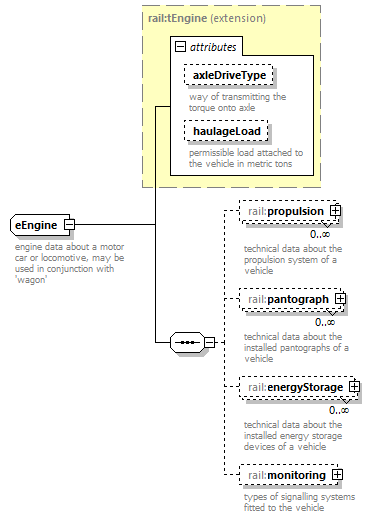 | ||||||||||||||||||||||
| namespace | https://www.railml.org/schemas/2021 | ||||||||||||||||||||||
| type | extension of rail:tEngine | ||||||||||||||||||||||
| properties |
| ||||||||||||||||||||||
| children | rail:propulsion rail:pantograph rail:energyStorage rail:monitoring | ||||||||||||||||||||||
| used by |
| ||||||||||||||||||||||
| attributes |
| ||||||||||||||||||||||
| annotation |
| ||||||||||||||||||||||
| source | <xs:complexType name="eEngine"> <xs:annotation> <xs:documentation>engine data about a motor car or locomotive, may be used in conjunction with 'wagon'</xs:documentation> <xs:documentation>See https://wiki2.railml.org/wiki/RS:engine</xs:documentation> </xs:annotation> <xs:complexContent> <xs:extension base="rail:tEngine"> <xs:sequence> <xs:element name="propulsion" type="rail:ePropulsion" minOccurs="0" maxOccurs="unbounded"> <xs:annotation> <xs:documentation>technical data about the propulsion system of a vehicle</xs:documentation> <xs:documentation>See https://wiki2.railml.org/wiki/RS:propulsion</xs:documentation> </xs:annotation> </xs:element> <xs:element name="pantograph" type="rail:ePantograph" minOccurs="0" maxOccurs="unbounded"> <xs:annotation> <xs:documentation>technical data about the installed pantographs of a vehicle</xs:documentation> <xs:documentation>See https://wiki2.railml.org/wiki/RS:pantograph</xs:documentation> </xs:annotation> </xs:element> <xs:element name="energyStorage" type="rail:eStorage" minOccurs="0" maxOccurs="unbounded"> <xs:annotation> <xs:documentation>technical data about the installed energy storage devices of a vehicle</xs:documentation> <xs:documentation>See https://wiki2.railml.org/wiki/RS:energyStorage</xs:documentation> </xs:annotation> </xs:element> <xs:element name="monitoring" type="rail:eMonitoring" minOccurs="0"> <xs:annotation> <xs:documentation>types of signalling systems fitted to the vehicle</xs:documentation> <xs:documentation>See https://wiki2.railml.org/wiki/RS:monitoring</xs:documentation> </xs:annotation> </xs:element> </xs:sequence> </xs:extension> </xs:complexContent> </xs:complexType> |
element eEngine/propulsion
| diagram |  | ||||||||||||||||||||||||||||||||||||||||||||||||||||||||||||||||||||||||||||||||||||||||||||||||||||||||||||||||||||||||||||||||||||||||||||||||||||||||||||||||||||||||||||||||||||||||||||||||||||||||||||||||||||||||||||||||||||||||||||||
| namespace | https://www.railml.org/schemas/2021 | ||||||||||||||||||||||||||||||||||||||||||||||||||||||||||||||||||||||||||||||||||||||||||||||||||||||||||||||||||||||||||||||||||||||||||||||||||||||||||||||||||||||||||||||||||||||||||||||||||||||||||||||||||||||||||||||||||||||||||||||
| type | rail:ePropulsion | ||||||||||||||||||||||||||||||||||||||||||||||||||||||||||||||||||||||||||||||||||||||||||||||||||||||||||||||||||||||||||||||||||||||||||||||||||||||||||||||||||||||||||||||||||||||||||||||||||||||||||||||||||||||||||||||||||||||||||||||
| properties |
| ||||||||||||||||||||||||||||||||||||||||||||||||||||||||||||||||||||||||||||||||||||||||||||||||||||||||||||||||||||||||||||||||||||||||||||||||||||||||||||||||||||||||||||||||||||||||||||||||||||||||||||||||||||||||||||||||||||||||||||||
| children | rail:additionalName rail:transformer rail:fourQuadrantChopper rail:link rail:tractionInverter rail:tractionMotor rail:diesel rail:gear rail:auxiliarySupply rail:tractiveEffort rail:brakeEffort rail:tractiveCurrent rail:brakeCurrent rail:tractiveCurrentLimitation rail:brakeCurrentLimitation rail:tractiveVehicleEfficiency rail:brakeVehicleEfficiency rail:rackTraction | ||||||||||||||||||||||||||||||||||||||||||||||||||||||||||||||||||||||||||||||||||||||||||||||||||||||||||||||||||||||||||||||||||||||||||||||||||||||||||||||||||||||||||||||||||||||||||||||||||||||||||||||||||||||||||||||||||||||||||||||
| attributes |
| ||||||||||||||||||||||||||||||||||||||||||||||||||||||||||||||||||||||||||||||||||||||||||||||||||||||||||||||||||||||||||||||||||||||||||||||||||||||||||||||||||||||||||||||||||||||||||||||||||||||||||||||||||||||||||||||||||||||||||||||
| annotation |
| ||||||||||||||||||||||||||||||||||||||||||||||||||||||||||||||||||||||||||||||||||||||||||||||||||||||||||||||||||||||||||||||||||||||||||||||||||||||||||||||||||||||||||||||||||||||||||||||||||||||||||||||||||||||||||||||||||||||||||||||
| source | <xs:element name="propulsion" type="rail:ePropulsion" minOccurs="0" maxOccurs="unbounded"> <xs:annotation> <xs:documentation>technical data about the propulsion system of a vehicle</xs:documentation> <xs:documentation>See https://wiki2.railml.org/wiki/RS:propulsion</xs:documentation> </xs:annotation> </xs:element> |
element eEngine/pantograph
| diagram |  | ||||||||||||||||||||||||||||||||||||||||||||||||||||||||||||||||||||||
| namespace | https://www.railml.org/schemas/2021 | ||||||||||||||||||||||||||||||||||||||||||||||||||||||||||||||||||||||
| type | rail:ePantograph | ||||||||||||||||||||||||||||||||||||||||||||||||||||||||||||||||||||||
| properties |
| ||||||||||||||||||||||||||||||||||||||||||||||||||||||||||||||||||||||
| children | rail:dedicatedSupplySystem | ||||||||||||||||||||||||||||||||||||||||||||||||||||||||||||||||||||||
| attributes |
| ||||||||||||||||||||||||||||||||||||||||||||||||||||||||||||||||||||||
| annotation |
| ||||||||||||||||||||||||||||||||||||||||||||||||||||||||||||||||||||||
| source | <xs:element name="pantograph" type="rail:ePantograph" minOccurs="0" maxOccurs="unbounded"> <xs:annotation> <xs:documentation>technical data about the installed pantographs of a vehicle</xs:documentation> <xs:documentation>See https://wiki2.railml.org/wiki/RS:pantograph</xs:documentation> </xs:annotation> </xs:element> |
element eEngine/energyStorage
| diagram |  | ||||||||||||||||||||||||||||||||||||||||||||||||||||||||||||||||||||||||||||||||||||||||||||||||||||||||||||||
| namespace | https://www.railml.org/schemas/2021 | ||||||||||||||||||||||||||||||||||||||||||||||||||||||||||||||||||||||||||||||||||||||||||||||||||||||||||||||
| type | rail:eStorage | ||||||||||||||||||||||||||||||||||||||||||||||||||||||||||||||||||||||||||||||||||||||||||||||||||||||||||||||
| properties |
| ||||||||||||||||||||||||||||||||||||||||||||||||||||||||||||||||||||||||||||||||||||||||||||||||||||||||||||||
| children | rail:additionalName rail:efficiency | ||||||||||||||||||||||||||||||||||||||||||||||||||||||||||||||||||||||||||||||||||||||||||||||||||||||||||||||
| attributes |
| ||||||||||||||||||||||||||||||||||||||||||||||||||||||||||||||||||||||||||||||||||||||||||||||||||||||||||||||
| annotation |
| ||||||||||||||||||||||||||||||||||||||||||||||||||||||||||||||||||||||||||||||||||||||||||||||||||||||||||||||
| source | <xs:element name="energyStorage" type="rail:eStorage" minOccurs="0" maxOccurs="unbounded"> <xs:annotation> <xs:documentation>technical data about the installed energy storage devices of a vehicle</xs:documentation> <xs:documentation>See https://wiki2.railml.org/wiki/RS:energyStorage</xs:documentation> </xs:annotation> </xs:element> |
element eEngine/monitoring
| diagram |  | ||||||
| namespace | https://www.railml.org/schemas/2021 | ||||||
| type | rail:eMonitoring | ||||||
| properties |
| ||||||
| children | rail:etcs rail:nationalSystem rail:trainRadio rail:otherEquipment | ||||||
| annotation |
| ||||||
| source | <xs:element name="monitoring" type="rail:eMonitoring" minOccurs="0"> <xs:annotation> <xs:documentation>types of signalling systems fitted to the vehicle</xs:documentation> <xs:documentation>See https://wiki2.railml.org/wiki/RS:monitoring</xs:documentation> </xs:annotation> </xs:element> |
complexType eETCS
| diagram |  | ||||||||||||||||||||||||||||||||||||||||||||||||||||||||||||||||||||||||||||||||||||||||||||||||||||||
| namespace | https://www.railml.org/schemas/2021 | ||||||||||||||||||||||||||||||||||||||||||||||||||||||||||||||||||||||||||||||||||||||||||||||||||||||
| type | extension of rail:tETCS | ||||||||||||||||||||||||||||||||||||||||||||||||||||||||||||||||||||||||||||||||||||||||||||||||||||||
| properties |
| ||||||||||||||||||||||||||||||||||||||||||||||||||||||||||||||||||||||||||||||||||||||||||||||||||||||
| children | rail:additionalName rail:specificTransmissionModule | ||||||||||||||||||||||||||||||||||||||||||||||||||||||||||||||||||||||||||||||||||||||||||||||||||||||
| used by |
| ||||||||||||||||||||||||||||||||||||||||||||||||||||||||||||||||||||||||||||||||||||||||||||||||||||||
| attributes |
| ||||||||||||||||||||||||||||||||||||||||||||||||||||||||||||||||||||||||||||||||||||||||||||||||||||||
| annotation |
| ||||||||||||||||||||||||||||||||||||||||||||||||||||||||||||||||||||||||||||||||||||||||||||||||||||||
| source | <xs:complexType name="eETCS"> <xs:annotation> <xs:documentation>data about installed ETCS system</xs:documentation> <xs:documentation>See https://wiki2.railml.org/wiki/RS:etcs</xs:documentation> </xs:annotation> <xs:complexContent> <xs:extension base="rail:tETCS"> <xs:sequence> <xs:element name="specificTransmissionModule" type="rail:tSpecificTransmissionModule" minOccurs="0"> <xs:annotation> <xs:documentation>data for special transmission modules of ETCS equipment</xs:documentation> <xs:documentation>See https://wiki2.railml.org/wiki/RS:specificTransmissionModule</xs:documentation> </xs:annotation> </xs:element> </xs:sequence> </xs:extension> </xs:complexContent> </xs:complexType> |
element eETCS/specificTransmissionModule
| diagram |  | ||||||||||||||||||||||||||||||||||||||||||||||||||||||||||||||||||||
| namespace | https://www.railml.org/schemas/2021 | ||||||||||||||||||||||||||||||||||||||||||||||||||||||||||||||||||||
| type | rail:tSpecificTransmissionModule | ||||||||||||||||||||||||||||||||||||||||||||||||||||||||||||||||||||
| properties |
| ||||||||||||||||||||||||||||||||||||||||||||||||||||||||||||||||||||
| children | rail:additionalName | ||||||||||||||||||||||||||||||||||||||||||||||||||||||||||||||||||||
| attributes |
| ||||||||||||||||||||||||||||||||||||||||||||||||||||||||||||||||||||
| annotation |
| ||||||||||||||||||||||||||||||||||||||||||||||||||||||||||||||||||||
| source | <xs:element name="specificTransmissionModule" type="rail:tSpecificTransmissionModule" minOccurs="0"> <xs:annotation> <xs:documentation>data for special transmission modules of ETCS equipment</xs:documentation> <xs:documentation>See https://wiki2.railml.org/wiki/RS:specificTransmissionModule</xs:documentation> </xs:annotation> </xs:element> |
complexType eFormation
| diagram |  | ||||||||||||||||||||||||||||||||||||||||||||||||||||||||||||||||||||||||||||||||||||||||||||||||||||||||||||||||||||||
| namespace | https://www.railml.org/schemas/2021 | ||||||||||||||||||||||||||||||||||||||||||||||||||||||||||||||||||||||||||||||||||||||||||||||||||||||||||||||||||||||
| type | extension of rail:tFormation | ||||||||||||||||||||||||||||||||||||||||||||||||||||||||||||||||||||||||||||||||||||||||||||||||||||||||||||||||||||||
| properties |
| ||||||||||||||||||||||||||||||||||||||||||||||||||||||||||||||||||||||||||||||||||||||||||||||||||||||||||||||||||||||
| children | rail:additionalName rail:states rail:trainOrder rail:categoryRef rail:trainEngine rail:trainBrakes rail:trainBrakeOperation rail:trainResistance rail:speedProfileRef rail:technicalStopActivity | ||||||||||||||||||||||||||||||||||||||||||||||||||||||||||||||||||||||||||||||||||||||||||||||||||||||||||||||||||||||
| used by |
| ||||||||||||||||||||||||||||||||||||||||||||||||||||||||||||||||||||||||||||||||||||||||||||||||||||||||||||||||||||||
| attributes |
| ||||||||||||||||||||||||||||||||||||||||||||||||||||||||||||||||||||||||||||||||||||||||||||||||||||||||||||||||||||||
| annotation |
| ||||||||||||||||||||||||||||||||||||||||||||||||||||||||||||||||||||||||||||||||||||||||||||||||||||||||||||||||||||||
| source | <xs:complexType name="eFormation"> <xs:annotation> <xs:documentation>data for train composition or vehicle formation</xs:documentation> <xs:documentation>See https://wiki2.railml.org/wiki/RS:formation</xs:documentation> </xs:annotation> <xs:complexContent> <xs:extension base="rail:tFormation"> <xs:sequence> <xs:annotation> <xs:documentation>contain formation data</xs:documentation> </xs:annotation> <xs:element name="trainOrder" type="rail:eTrainOrder" minOccurs="0"> <xs:annotation> <xs:documentation>car order for a formation</xs:documentation> <xs:documentation>See https://wiki2.railml.org/wiki/RS:trainOrder</xs:documentation> </xs:annotation> </xs:element> <xs:element name="categoryRef" type="rail:tElementWithReference" minOccurs="0" maxOccurs="unbounded"> <xs:annotation> <xs:documentation>reference to train categories in TimeTable part, e.g. ltd. Express, the formation can run as in service</xs:documentation> <xs:documentation>See https://wiki2.railml.org/wiki/RS:categoryRef</xs:documentation> </xs:annotation> </xs:element> <xs:element name="trainEngine" type="rail:tTrainEngine" minOccurs="0"> <xs:annotation> <xs:documentation>acceleration value for whole formation</xs:documentation> <xs:documentation>See https://wiki2.railml.org/wiki/RS:trainEngine</xs:documentation> </xs:annotation> </xs:element> <xs:element name="trainBrakes" type="rail:tBasicBrakeType" minOccurs="0"> <xs:annotation> <xs:documentation>for whole formation deceleration</xs:documentation> <xs:documentation>See https://wiki2.railml.org/wiki/RS:trainBrakes</xs:documentation> </xs:annotation> </xs:element> <xs:element name="trainBrakeOperation" type="rail:tBasicBrakeOperation" minOccurs="0" maxOccurs="unbounded"> <xs:annotation> <xs:documentation>operational braking rules according to specific supervision regime for entire formation</xs:documentation> <xs:documentation>See https://wiki2.railml.org/wiki/RS:trainBrakeOperation</xs:documentation> </xs:annotation> </xs:element> <xs:element name="trainResistance" type="rail:tTrainResistance" minOccurs="0"> <xs:annotation> <xs:documentation>mechanical train resistance vs. speed</xs:documentation> <xs:documentation>See https://wiki2.railml.org/wiki/RS:trainResistance</xs:documentation> </xs:annotation> </xs:element> <xs:element name="speedProfileRef" type="rail:tSpeedProfileRefRS" minOccurs="0" maxOccurs="unbounded"> <xs:annotation> <xs:documentation>reference to permissible speed profiles for entire formation</xs:documentation> <xs:documentation>See https://wiki2.railml.org/wiki/RS:speedProfileRef</xs:documentation> </xs:annotation> </xs:element> <xs:element name="technicalStopActivity" type="rail:tTechnicalStopActivity" minOccurs="0" maxOccurs="unbounded"> <xs:annotation> <xs:documentation>list of stop activities with their related technical times</xs:documentation> <xs:documentation>See https://wiki2.railml.org/wiki/RS:technicalStopActivity</xs:documentation> </xs:annotation> </xs:element> </xs:sequence> </xs:extension> </xs:complexContent> </xs:complexType> |
element eFormation/trainOrder
| diagram |  | ||||||
| namespace | https://www.railml.org/schemas/2021 | ||||||
| type | rail:eTrainOrder | ||||||
| properties |
| ||||||
| children | rail:vehicleRef | ||||||
| annotation |
| ||||||
| source | <xs:element name="trainOrder" type="rail:eTrainOrder" minOccurs="0"> <xs:annotation> <xs:documentation>car order for a formation</xs:documentation> <xs:documentation>See https://wiki2.railml.org/wiki/RS:trainOrder</xs:documentation> </xs:annotation> </xs:element> |
element eFormation/categoryRef
| diagram | 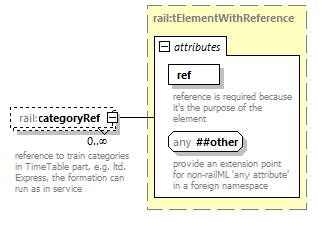 | ||||||||||||||
| namespace | https://www.railml.org/schemas/2021 | ||||||||||||||
| type | rail:tElementWithReference | ||||||||||||||
| properties |
| ||||||||||||||
| attributes |
| ||||||||||||||
| annotation |
| ||||||||||||||
| source | <xs:element name="categoryRef" type="rail:tElementWithReference" minOccurs="0" maxOccurs="unbounded"> <xs:annotation> <xs:documentation>reference to train categories in TimeTable part, e.g. ltd. Express, the formation can run as in service</xs:documentation> <xs:documentation>See https://wiki2.railml.org/wiki/RS:categoryRef</xs:documentation> </xs:annotation> </xs:element> |
element eFormation/trainEngine
| diagram |  | ||||||||||||||||||||||||||||||
| namespace | https://www.railml.org/schemas/2021 | ||||||||||||||||||||||||||||||
| type | rail:tTrainEngine | ||||||||||||||||||||||||||||||
| properties |
| ||||||||||||||||||||||||||||||
| attributes |
| ||||||||||||||||||||||||||||||
| annotation |
| ||||||||||||||||||||||||||||||
| source | <xs:element name="trainEngine" type="rail:tTrainEngine" minOccurs="0"> <xs:annotation> <xs:documentation>acceleration value for whole formation</xs:documentation> <xs:documentation>See https://wiki2.railml.org/wiki/RS:trainEngine</xs:documentation> </xs:annotation> </xs:element> |
element eFormation/trainBrakes
| diagram |  | ||||||||||||||||||||||||||||||||||||||||||||||||||||||||||||||||||||||
| namespace | https://www.railml.org/schemas/2021 | ||||||||||||||||||||||||||||||||||||||||||||||||||||||||||||||||||||||
| type | rail:tBasicBrakeType | ||||||||||||||||||||||||||||||||||||||||||||||||||||||||||||||||||||||
| properties |
| ||||||||||||||||||||||||||||||||||||||||||||||||||||||||||||||||||||||
| children | rail:auxiliaryBrakes | ||||||||||||||||||||||||||||||||||||||||||||||||||||||||||||||||||||||
| attributes |
| ||||||||||||||||||||||||||||||||||||||||||||||||||||||||||||||||||||||
| annotation |
| ||||||||||||||||||||||||||||||||||||||||||||||||||||||||||||||||||||||
| source | <xs:element name="trainBrakes" type="rail:tBasicBrakeType" minOccurs="0"> <xs:annotation> <xs:documentation>for whole formation deceleration</xs:documentation> <xs:documentation>See https://wiki2.railml.org/wiki/RS:trainBrakes</xs:documentation> </xs:annotation> </xs:element> |
element eFormation/trainBrakeOperation
| diagram | 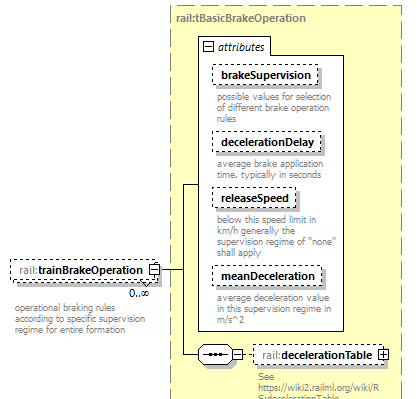 | ||||||||||||||||||||||||||||||||||||||
| namespace | https://www.railml.org/schemas/2021 | ||||||||||||||||||||||||||||||||||||||
| type | rail:tBasicBrakeOperation | ||||||||||||||||||||||||||||||||||||||
| properties |
| ||||||||||||||||||||||||||||||||||||||
| children | rail:decelerationTable | ||||||||||||||||||||||||||||||||||||||
| attributes |
| ||||||||||||||||||||||||||||||||||||||
| annotation |
| ||||||||||||||||||||||||||||||||||||||
| source | <xs:element name="trainBrakeOperation" type="rail:tBasicBrakeOperation" minOccurs="0" maxOccurs="unbounded"> <xs:annotation> <xs:documentation>operational braking rules according to specific supervision regime for entire formation</xs:documentation> <xs:documentation>See https://wiki2.railml.org/wiki/RS:trainBrakeOperation</xs:documentation> </xs:annotation> </xs:element> |
element eFormation/trainResistance
| diagram |  | ||||||||||||||||||||||||||||||||||||||||||||||||||||||
| namespace | https://www.railml.org/schemas/2021 | ||||||||||||||||||||||||||||||||||||||||||||||||||||||
| type | rail:tTrainResistance | ||||||||||||||||||||||||||||||||||||||||||||||||||||||
| properties |
| ||||||||||||||||||||||||||||||||||||||||||||||||||||||
| children | rail:valueTable rail:segmentTable | ||||||||||||||||||||||||||||||||||||||||||||||||||||||
| attributes |
| ||||||||||||||||||||||||||||||||||||||||||||||||||||||
| annotation |
| ||||||||||||||||||||||||||||||||||||||||||||||||||||||
| source | <xs:element name="trainResistance" type="rail:tTrainResistance" minOccurs="0"> <xs:annotation> <xs:documentation>mechanical train resistance vs. speed</xs:documentation> <xs:documentation>See https://wiki2.railml.org/wiki/RS:trainResistance</xs:documentation> </xs:annotation> </xs:element> |
element eFormation/speedProfileRef
| diagram | 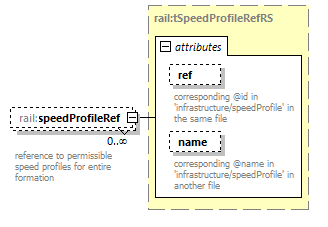 | ||||||||||||||||||||||
| namespace | https://www.railml.org/schemas/2021 | ||||||||||||||||||||||
| type | rail:tSpeedProfileRefRS | ||||||||||||||||||||||
| properties |
| ||||||||||||||||||||||
| attributes |
| ||||||||||||||||||||||
| annotation |
| ||||||||||||||||||||||
| source | <xs:element name="speedProfileRef" type="rail:tSpeedProfileRefRS" minOccurs="0" maxOccurs="unbounded"> <xs:annotation> <xs:documentation>reference to permissible speed profiles for entire formation</xs:documentation> <xs:documentation>See https://wiki2.railml.org/wiki/RS:speedProfileRef</xs:documentation> </xs:annotation> </xs:element> |
element eFormation/technicalStopActivity
| diagram | 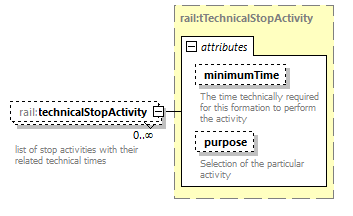 | ||||||||||||||||||||||
| namespace | https://www.railml.org/schemas/2021 | ||||||||||||||||||||||
| type | rail:tTechnicalStopActivity | ||||||||||||||||||||||
| properties |
| ||||||||||||||||||||||
| attributes |
| ||||||||||||||||||||||
| annotation |
| ||||||||||||||||||||||
| source | <xs:element name="technicalStopActivity" type="rail:tTechnicalStopActivity" minOccurs="0" maxOccurs="unbounded"> <xs:annotation> <xs:documentation>list of stop activities with their related technical times</xs:documentation> <xs:documentation>See https://wiki2.railml.org/wiki/RS:technicalStopActivity</xs:documentation> </xs:annotation> </xs:element> |
complexType eFormations
| diagram |  | ||
| namespace | https://www.railml.org/schemas/2021 | ||
| children | rail:formation | ||
| used by |
| ||
| source | <xs:complexType name="eFormations"> <xs:sequence> <xs:annotation> <xs:documentation>contain formation data</xs:documentation> <xs:documentation>See https://wiki2.railml.org/wiki/RS:formations</xs:documentation> </xs:annotation> <xs:element name="formation" type="rail:eFormation" maxOccurs="unbounded"> <xs:annotation> <xs:documentation>data for train composition or vehicle formation</xs:documentation> <xs:documentation>See https://wiki2.railml.org/wiki/RS:formation</xs:documentation> </xs:annotation> </xs:element> </xs:sequence> </xs:complexType> |
element eFormations/formation
| diagram |  | ||||||||||||||||||||||||||||||||||||||||||||||||||||||||||||||||||||||||||||||||||||||||||||||||||||||||||||||||||||||
| namespace | https://www.railml.org/schemas/2021 | ||||||||||||||||||||||||||||||||||||||||||||||||||||||||||||||||||||||||||||||||||||||||||||||||||||||||||||||||||||||
| type | rail:eFormation | ||||||||||||||||||||||||||||||||||||||||||||||||||||||||||||||||||||||||||||||||||||||||||||||||||||||||||||||||||||||
| properties |
| ||||||||||||||||||||||||||||||||||||||||||||||||||||||||||||||||||||||||||||||||||||||||||||||||||||||||||||||||||||||
| children | rail:additionalName rail:states rail:trainOrder rail:categoryRef rail:trainEngine rail:trainBrakes rail:trainBrakeOperation rail:trainResistance rail:speedProfileRef rail:technicalStopActivity | ||||||||||||||||||||||||||||||||||||||||||||||||||||||||||||||||||||||||||||||||||||||||||||||||||||||||||||||||||||||
| attributes |
| ||||||||||||||||||||||||||||||||||||||||||||||||||||||||||||||||||||||||||||||||||||||||||||||||||||||||||||||||||||||
| annotation |
| ||||||||||||||||||||||||||||||||||||||||||||||||||||||||||||||||||||||||||||||||||||||||||||||||||||||||||||||||||||||
| source | <xs:element name="formation" type="rail:eFormation" maxOccurs="unbounded"> <xs:annotation> <xs:documentation>data for train composition or vehicle formation</xs:documentation> <xs:documentation>See https://wiki2.railml.org/wiki/RS:formation</xs:documentation> </xs:annotation> </xs:element> |
complexType eFourQuadrantChopper
| diagram | 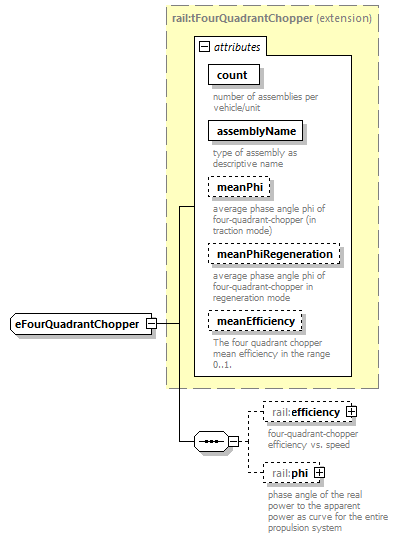 | ||||||||||||||||||||||||||||||||||||||||||||||
| namespace | https://www.railml.org/schemas/2021 | ||||||||||||||||||||||||||||||||||||||||||||||
| type | extension of rail:tFourQuadrantChopper | ||||||||||||||||||||||||||||||||||||||||||||||
| properties |
| ||||||||||||||||||||||||||||||||||||||||||||||
| children | rail:efficiency rail:phi | ||||||||||||||||||||||||||||||||||||||||||||||
| used by |
| ||||||||||||||||||||||||||||||||||||||||||||||
| attributes |
| ||||||||||||||||||||||||||||||||||||||||||||||
| source | <xs:complexType name="eFourQuadrantChopper"> <xs:complexContent> <xs:extension base="rail:tFourQuadrantChopper"> <xs:sequence> <xs:element name="efficiency" type="rail:tEfficiencyCurve" minOccurs="0"> <xs:annotation> <xs:documentation>four-quadrant-chopper efficiency vs. speed</xs:documentation> <xs:documentation>See https://wiki2.railml.org/wiki/RS:efficiency_fourQuadrantChopper</xs:documentation> </xs:annotation> </xs:element> <xs:element name="phi" type="rail:tCurve" minOccurs="0"> <xs:annotation> <xs:documentation>phase angle of the real power to the apparent power as curve for the entire propulsion system</xs:documentation> <xs:documentation>See https://wiki2.railml.org/wiki/RS:phi</xs:documentation> </xs:annotation> </xs:element> </xs:sequence> </xs:extension> </xs:complexContent> </xs:complexType> |
element eFourQuadrantChopper/efficiency
| diagram |  | ||||||
| namespace | https://www.railml.org/schemas/2021 | ||||||
| type | rail:tEfficiencyCurve | ||||||
| properties |
| ||||||
| children | rail:valueTable rail:segmentTable | ||||||
| annotation |
| ||||||
| source | <xs:element name="efficiency" type="rail:tEfficiencyCurve" minOccurs="0"> <xs:annotation> <xs:documentation>four-quadrant-chopper efficiency vs. speed</xs:documentation> <xs:documentation>See https://wiki2.railml.org/wiki/RS:efficiency_fourQuadrantChopper</xs:documentation> </xs:annotation> </xs:element> |
element eFourQuadrantChopper/phi
| diagram |  | ||||||
| namespace | https://www.railml.org/schemas/2021 | ||||||
| type | rail:tCurve | ||||||
| properties |
| ||||||
| children | rail:valueTable rail:segmentTable | ||||||
| annotation |
| ||||||
| source | <xs:element name="phi" type="rail:tCurve" minOccurs="0"> <xs:annotation> <xs:documentation>phase angle of the real power to the apparent power as curve for the entire propulsion system</xs:documentation> <xs:documentation>See https://wiki2.railml.org/wiki/RS:phi</xs:documentation> </xs:annotation> </xs:element> |
complexType eGear
| diagram | 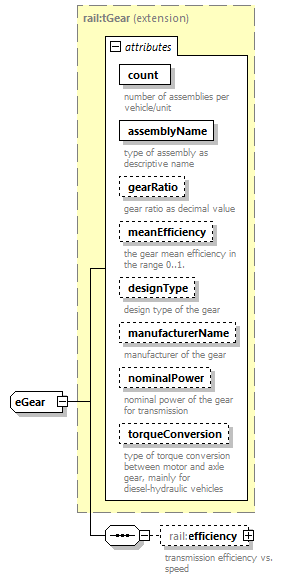 | ||||||||||||||||||||||||||||||||||||||||||||||||||||||||||||||||||||||
| namespace | https://www.railml.org/schemas/2021 | ||||||||||||||||||||||||||||||||||||||||||||||||||||||||||||||||||||||
| type | extension of rail:tGear | ||||||||||||||||||||||||||||||||||||||||||||||||||||||||||||||||||||||
| properties |
| ||||||||||||||||||||||||||||||||||||||||||||||||||||||||||||||||||||||
| children | rail:efficiency | ||||||||||||||||||||||||||||||||||||||||||||||||||||||||||||||||||||||
| used by |
| ||||||||||||||||||||||||||||||||||||||||||||||||||||||||||||||||||||||
| attributes |
| ||||||||||||||||||||||||||||||||||||||||||||||||||||||||||||||||||||||
| source | <xs:complexType name="eGear"> <xs:complexContent> <xs:extension base="rail:tGear"> <xs:sequence> <xs:element name="efficiency" type="rail:tEfficiencyCurve" minOccurs="0"> <xs:annotation> <xs:documentation>transmission efficiency vs. speed</xs:documentation> <xs:documentation>See https://wiki2.railml.org/wiki/RS:efficiency_gear</xs:documentation> </xs:annotation> </xs:element> </xs:sequence> </xs:extension> </xs:complexContent> </xs:complexType> |
element eGear/efficiency
| diagram | 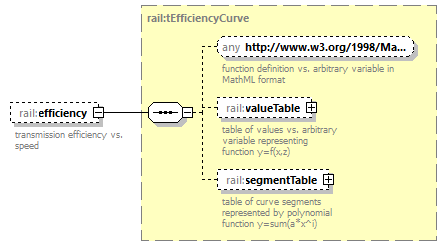 | ||||||
| namespace | https://www.railml.org/schemas/2021 | ||||||
| type | rail:tEfficiencyCurve | ||||||
| properties |
| ||||||
| children | rail:valueTable rail:segmentTable | ||||||
| annotation |
| ||||||
| source | <xs:element name="efficiency" type="rail:tEfficiencyCurve" minOccurs="0"> <xs:annotation> <xs:documentation>transmission efficiency vs. speed</xs:documentation> <xs:documentation>See https://wiki2.railml.org/wiki/RS:efficiency_gear</xs:documentation> </xs:annotation> </xs:element> |
complexType eGoods
| diagram | 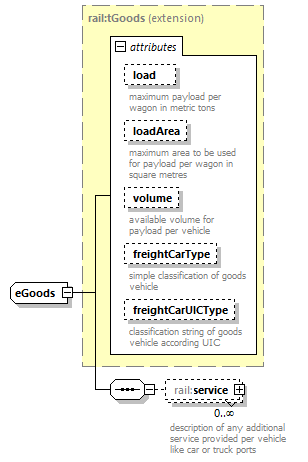 | ||||||||||||||||||||||||||||||||||||||||||||||
| namespace | https://www.railml.org/schemas/2021 | ||||||||||||||||||||||||||||||||||||||||||||||
| type | extension of rail:tGoods | ||||||||||||||||||||||||||||||||||||||||||||||
| properties |
| ||||||||||||||||||||||||||||||||||||||||||||||
| children | rail:service | ||||||||||||||||||||||||||||||||||||||||||||||
| used by |
| ||||||||||||||||||||||||||||||||||||||||||||||
| attributes |
| ||||||||||||||||||||||||||||||||||||||||||||||
| source | <xs:complexType name="eGoods"> <xs:complexContent> <xs:extension base="rail:tGoods"> <xs:sequence> <xs:element name="service" type="rail:tService" minOccurs="0" maxOccurs="unbounded"> <xs:annotation> <xs:documentation>description of any additional service provided per vehicle like car or truck ports</xs:documentation> <xs:documentation>See https://wiki2.railml.org/wiki/RS:service_goods</xs:documentation> </xs:annotation> </xs:element> </xs:sequence> </xs:extension> </xs:complexContent> </xs:complexType> |
element eGoods/service
| diagram | 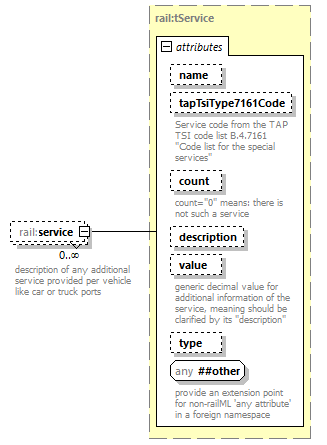 | ||||||||||||||||||||||||||||||||||||||||||||||||||||
| namespace | https://www.railml.org/schemas/2021 | ||||||||||||||||||||||||||||||||||||||||||||||||||||
| type | rail:tService | ||||||||||||||||||||||||||||||||||||||||||||||||||||
| properties |
| ||||||||||||||||||||||||||||||||||||||||||||||||||||
| attributes |
| ||||||||||||||||||||||||||||||||||||||||||||||||||||
| annotation |
| ||||||||||||||||||||||||||||||||||||||||||||||||||||
| source | <xs:element name="service" type="rail:tService" minOccurs="0" maxOccurs="unbounded"> <xs:annotation> <xs:documentation>description of any additional service provided per vehicle like car or truck ports</xs:documentation> <xs:documentation>See https://wiki2.railml.org/wiki/RS:service_goods</xs:documentation> </xs:annotation> </xs:element> |
complexType eLoadLimit
| diagram |  | ||||||||||||||
| namespace | https://www.railml.org/schemas/2021 | ||||||||||||||
| type | extension of rail:tLoadLimitType | ||||||||||||||
| properties |
| ||||||||||||||
| children | rail:railNetwork rail:lineClassification | ||||||||||||||
| used by |
| ||||||||||||||
| attributes |
| ||||||||||||||
| source | <xs:complexType name="eLoadLimit"> <xs:complexContent> <xs:extension base="rail:tLoadLimitType"> <xs:annotation> <xs:documentation>See https://wiki2.railml.org/wiki/RS:loadLimit</xs:documentation> </xs:annotation> <xs:sequence> <xs:element name="railNetwork" type="rail:tRailNetwork" maxOccurs="unbounded"> <xs:annotation> <xs:documentation>relation to particular rail networks the limit is applicable</xs:documentation> <xs:documentation>See https://wiki2.railml.org/wiki/RS:railNetwork</xs:documentation> </xs:annotation> </xs:element> <xs:element name="lineClassification" type="rail:tLineClassification" maxOccurs="unbounded"> <xs:annotation> <xs:documentation>load limit with respect to line classification (permissible axle load and meter load)</xs:documentation> <xs:documentation>See https://wiki2.railml.org/wiki/RS:lineClassification</xs:documentation> </xs:annotation> </xs:element> </xs:sequence> </xs:extension> </xs:complexContent> </xs:complexType> |
element eLoadLimit/railNetwork
| diagram | 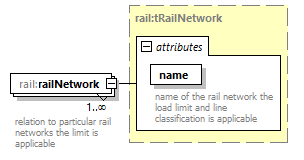 | ||||||||||||||
| namespace | https://www.railml.org/schemas/2021 | ||||||||||||||
| type | rail:tRailNetwork | ||||||||||||||
| properties |
| ||||||||||||||
| attributes |
| ||||||||||||||
| annotation |
| ||||||||||||||
| source | <xs:element name="railNetwork" type="rail:tRailNetwork" maxOccurs="unbounded"> <xs:annotation> <xs:documentation>relation to particular rail networks the limit is applicable</xs:documentation> <xs:documentation>See https://wiki2.railml.org/wiki/RS:railNetwork</xs:documentation> </xs:annotation> </xs:element> |
element eLoadLimit/lineClassification
| diagram | 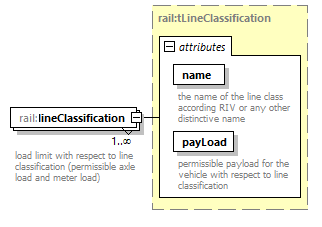 | ||||||||||||||||||||||
| namespace | https://www.railml.org/schemas/2021 | ||||||||||||||||||||||
| type | rail:tLineClassification | ||||||||||||||||||||||
| properties |
| ||||||||||||||||||||||
| attributes |
| ||||||||||||||||||||||
| annotation |
| ||||||||||||||||||||||
| source | <xs:element name="lineClassification" type="rail:tLineClassification" maxOccurs="unbounded"> <xs:annotation> <xs:documentation>load limit with respect to line classification (permissible axle load and meter load)</xs:documentation> <xs:documentation>See https://wiki2.railml.org/wiki/RS:lineClassification</xs:documentation> </xs:annotation> </xs:element> |
complexType eLoadLimitMatrix
| diagram |  | ||||||||||||||
| namespace | https://www.railml.org/schemas/2021 | ||||||||||||||
| type | extension of rail:tLoadLimitMatrixType | ||||||||||||||
| properties |
| ||||||||||||||
| children | rail:loadLimit | ||||||||||||||
| used by |
| ||||||||||||||
| attributes |
| ||||||||||||||
| source | <xs:complexType name="eLoadLimitMatrix"> <xs:complexContent> <xs:extension base="rail:tLoadLimitMatrixType"> <xs:annotation> <xs:documentation>See https://wiki2.railml.org/wiki/RS:loadLimitMatrix</xs:documentation> </xs:annotation> <xs:sequence> <xs:element name="loadLimit" type="rail:eLoadLimit" maxOccurs="unbounded"> <xs:annotation> <xs:documentation>container for possible load limits</xs:documentation> <xs:documentation>See https://wiki2.railml.org/wiki/RS:loadLimit</xs:documentation> </xs:annotation> </xs:element> </xs:sequence> </xs:extension> </xs:complexContent> </xs:complexType> |
element eLoadLimitMatrix/loadLimit
| diagram |  | ||||||||||||||
| namespace | https://www.railml.org/schemas/2021 | ||||||||||||||
| type | rail:eLoadLimit | ||||||||||||||
| properties |
| ||||||||||||||
| children | rail:railNetwork rail:lineClassification | ||||||||||||||
| attributes |
| ||||||||||||||
| annotation |
| ||||||||||||||
| source | <xs:element name="loadLimit" type="rail:eLoadLimit" maxOccurs="unbounded"> <xs:annotation> <xs:documentation>container for possible load limits</xs:documentation> <xs:documentation>See https://wiki2.railml.org/wiki/RS:loadLimit</xs:documentation> </xs:annotation> </xs:element> |
complexType eMaintenanceIntervals
| diagram |  | ||
| namespace | https://www.railml.org/schemas/2021 | ||
| children | rail:maintenanceInterval | ||
| used by |
| ||
| source | <xs:complexType name="eMaintenanceIntervals"> <xs:sequence> <xs:element name="maintenanceInterval" type="rail:tMaintenanceInterval" minOccurs="0"> <xs:annotation> <xs:documentation>See https://wiki2.railml.org/wiki/RS:maintenanceInterval</xs:documentation> </xs:annotation> </xs:element> </xs:sequence> </xs:complexType> |
element eMaintenanceIntervals/maintenanceInterval
| diagram | 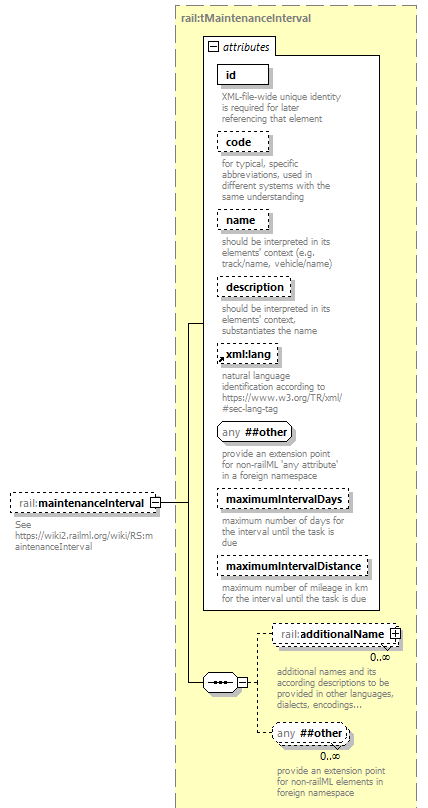 | ||||||||||||||||||||||||||||||||||||||||||||||||||||||||||||||
| namespace | https://www.railml.org/schemas/2021 | ||||||||||||||||||||||||||||||||||||||||||||||||||||||||||||||
| type | rail:tMaintenanceInterval | ||||||||||||||||||||||||||||||||||||||||||||||||||||||||||||||
| properties |
| ||||||||||||||||||||||||||||||||||||||||||||||||||||||||||||||
| children | rail:additionalName | ||||||||||||||||||||||||||||||||||||||||||||||||||||||||||||||
| attributes |
| ||||||||||||||||||||||||||||||||||||||||||||||||||||||||||||||
| annotation |
| ||||||||||||||||||||||||||||||||||||||||||||||||||||||||||||||
| source | <xs:element name="maintenanceInterval" type="rail:tMaintenanceInterval" minOccurs="0"> <xs:annotation> <xs:documentation>See https://wiki2.railml.org/wiki/RS:maintenanceInterval</xs:documentation> </xs:annotation> </xs:element> |
complexType eMechanicalCoupler
| diagram |  | ||||||||||||||||||||||||||||||||||||||||||||||
| namespace | https://www.railml.org/schemas/2021 | ||||||||||||||||||||||||||||||||||||||||||||||
| type | extension of rail:tMechanicalWagonCouplerType | ||||||||||||||||||||||||||||||||||||||||||||||
| properties |
| ||||||||||||||||||||||||||||||||||||||||||||||
| used by |
| ||||||||||||||||||||||||||||||||||||||||||||||
| attributes |
| ||||||||||||||||||||||||||||||||||||||||||||||
| source | <xs:complexType name="eMechanicalCoupler"> <xs:complexContent> <xs:extension base="rail:tMechanicalWagonCouplerType"> <xs:annotation> <xs:documentation>See https://wiki2.railml.org/wiki/RS:mechanicalCoupler</xs:documentation> </xs:annotation> </xs:extension> </xs:complexContent> </xs:complexType> |
complexType eMonitoring
| diagram |  | ||
| namespace | https://www.railml.org/schemas/2021 | ||
| type | extension of rail:tMonitoring | ||
| properties |
| ||
| children | rail:etcs rail:nationalSystem rail:trainRadio rail:otherEquipment | ||
| used by |
| ||
| source | <xs:complexType name="eMonitoring"> <xs:complexContent> <xs:extension base="rail:tMonitoring"> <xs:sequence> <xs:element name="etcs" type="rail:eETCS" minOccurs="0"> <xs:annotation> <xs:documentation>capabilities with respect to European Train Control System</xs:documentation> <xs:documentation>See https://wiki2.railml.org/wiki/RS:etcs</xs:documentation> </xs:annotation> </xs:element> <xs:element name="nationalSystem" type="rail:tNationalSystem" minOccurs="0" maxOccurs="unbounded"> <xs:annotation> <xs:documentation>list of installed national train protection/control systems</xs:documentation> <xs:documentation>See https://wiki2.railml.org/wiki/RS:nationalSystem</xs:documentation> </xs:annotation> </xs:element> <xs:element name="trainRadio" type="rail:eTrainRadio" minOccurs="0" maxOccurs="unbounded"> <xs:annotation> <xs:documentation>list of installed train radio systems for communication</xs:documentation> <xs:documentation>See https://wiki2.railml.org/wiki/RS:trainRadio</xs:documentation> </xs:annotation> </xs:element> <xs:element name="otherEquipment" type="rail:tOtherEquipment" minOccurs="0" maxOccurs="unbounded"> <xs:annotation> <xs:documentation>list of other (non-safety) installed train equipment</xs:documentation> <xs:documentation>See https://wiki2.railml.org/wiki/RS:otherEquipment</xs:documentation> </xs:annotation> </xs:element> </xs:sequence> </xs:extension> </xs:complexContent> </xs:complexType> |
element eMonitoring/etcs
| diagram | 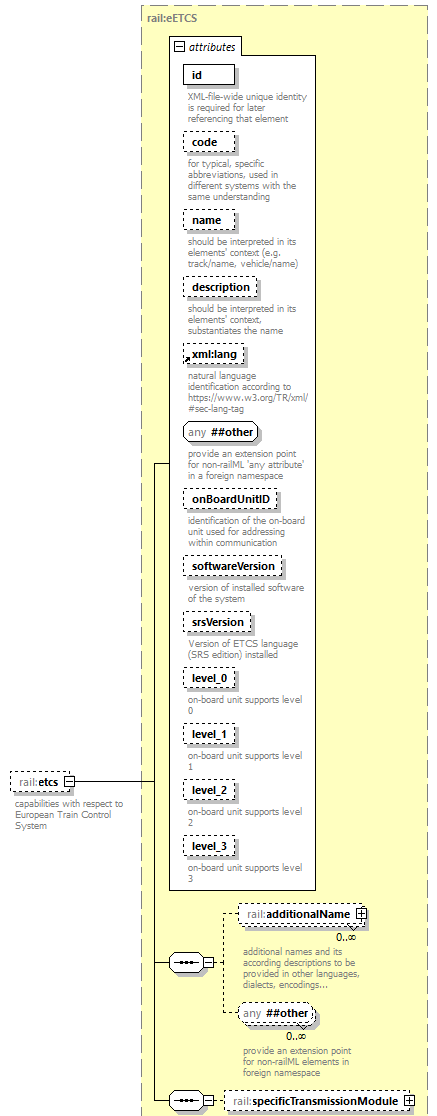 | ||||||||||||||||||||||||||||||||||||||||||||||||||||||||||||||||||||||||||||||||||||||||||||||||||||||
| namespace | https://www.railml.org/schemas/2021 | ||||||||||||||||||||||||||||||||||||||||||||||||||||||||||||||||||||||||||||||||||||||||||||||||||||||
| type | rail:eETCS | ||||||||||||||||||||||||||||||||||||||||||||||||||||||||||||||||||||||||||||||||||||||||||||||||||||||
| properties |
| ||||||||||||||||||||||||||||||||||||||||||||||||||||||||||||||||||||||||||||||||||||||||||||||||||||||
| children | rail:additionalName rail:specificTransmissionModule | ||||||||||||||||||||||||||||||||||||||||||||||||||||||||||||||||||||||||||||||||||||||||||||||||||||||
| attributes |
| ||||||||||||||||||||||||||||||||||||||||||||||||||||||||||||||||||||||||||||||||||||||||||||||||||||||
| annotation |
| ||||||||||||||||||||||||||||||||||||||||||||||||||||||||||||||||||||||||||||||||||||||||||||||||||||||
| source | <xs:element name="etcs" type="rail:eETCS" minOccurs="0"> <xs:annotation> <xs:documentation>capabilities with respect to European Train Control System</xs:documentation> <xs:documentation>See https://wiki2.railml.org/wiki/RS:etcs</xs:documentation> </xs:annotation> </xs:element> |
element eMonitoring/nationalSystem
| diagram |  | ||||||||||||||||||||||||||||||||||||||||||||||||||||||||||||||||||||||||||||||||||||||||
| namespace | https://www.railml.org/schemas/2021 | ||||||||||||||||||||||||||||||||||||||||||||||||||||||||||||||||||||||||||||||||||||||||
| type | rail:tNationalSystem | ||||||||||||||||||||||||||||||||||||||||||||||||||||||||||||||||||||||||||||||||||||||||
| properties |
| ||||||||||||||||||||||||||||||||||||||||||||||||||||||||||||||||||||||||||||||||||||||||
| children | rail:additionalName | ||||||||||||||||||||||||||||||||||||||||||||||||||||||||||||||||||||||||||||||||||||||||
| attributes |
| ||||||||||||||||||||||||||||||||||||||||||||||||||||||||||||||||||||||||||||||||||||||||
| annotation |
| ||||||||||||||||||||||||||||||||||||||||||||||||||||||||||||||||||||||||||||||||||||||||
| source | <xs:element name="nationalSystem" type="rail:tNationalSystem" minOccurs="0" maxOccurs="unbounded"> <xs:annotation> <xs:documentation>list of installed national train protection/control systems</xs:documentation> <xs:documentation>See https://wiki2.railml.org/wiki/RS:nationalSystem</xs:documentation> </xs:annotation> </xs:element> |
element eMonitoring/trainRadio
| diagram |  | ||||||||||||||||||||||||||||||||||||||||||||||||||||||||||||||||||||
| namespace | https://www.railml.org/schemas/2021 | ||||||||||||||||||||||||||||||||||||||||||||||||||||||||||||||||||||
| type | rail:eTrainRadio | ||||||||||||||||||||||||||||||||||||||||||||||||||||||||||||||||||||
| properties |
| ||||||||||||||||||||||||||||||||||||||||||||||||||||||||||||||||||||
| children | rail:additionalName rail:radioSystem | ||||||||||||||||||||||||||||||||||||||||||||||||||||||||||||||||||||
| attributes |
| ||||||||||||||||||||||||||||||||||||||||||||||||||||||||||||||||||||
| annotation |
| ||||||||||||||||||||||||||||||||||||||||||||||||||||||||||||||||||||
| source | <xs:element name="trainRadio" type="rail:eTrainRadio" minOccurs="0" maxOccurs="unbounded"> <xs:annotation> <xs:documentation>list of installed train radio systems for communication</xs:documentation> <xs:documentation>See https://wiki2.railml.org/wiki/RS:trainRadio</xs:documentation> </xs:annotation> </xs:element> |
element eMonitoring/otherEquipment
| diagram | 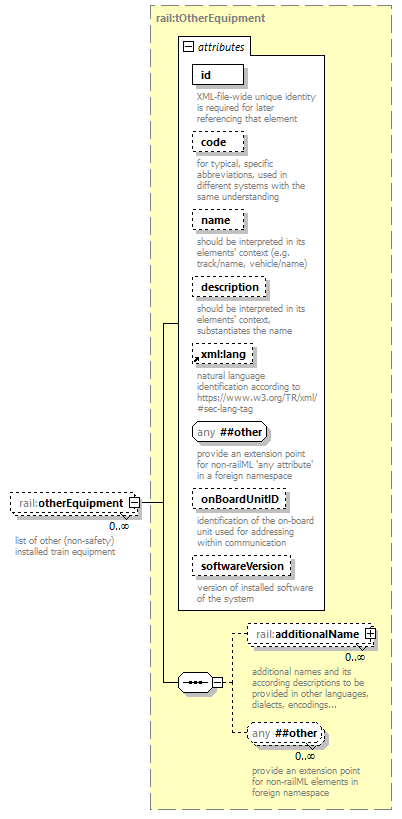 | ||||||||||||||||||||||||||||||||||||||||||||||||||||||||||||||
| namespace | https://www.railml.org/schemas/2021 | ||||||||||||||||||||||||||||||||||||||||||||||||||||||||||||||
| type | rail:tOtherEquipment | ||||||||||||||||||||||||||||||||||||||||||||||||||||||||||||||
| properties |
| ||||||||||||||||||||||||||||||||||||||||||||||||||||||||||||||
| children | rail:additionalName | ||||||||||||||||||||||||||||||||||||||||||||||||||||||||||||||
| attributes |
| ||||||||||||||||||||||||||||||||||||||||||||||||||||||||||||||
| annotation |
| ||||||||||||||||||||||||||||||||||||||||||||||||||||||||||||||
| source | <xs:element name="otherEquipment" type="rail:tOtherEquipment" minOccurs="0" maxOccurs="unbounded"> <xs:annotation> <xs:documentation>list of other (non-safety) installed train equipment</xs:documentation> <xs:documentation>See https://wiki2.railml.org/wiki/RS:otherEquipment</xs:documentation> </xs:annotation> </xs:element> |
complexType eOperator
| diagram |  | ||||||||||||||||||||||||||||||||||||||||||
| namespace | https://www.railml.org/schemas/2021 | ||||||||||||||||||||||||||||||||||||||||||
| type | extension of rail:tOperator | ||||||||||||||||||||||||||||||||||||||||||
| properties |
| ||||||||||||||||||||||||||||||||||||||||||
| children | rail:vehicleIdentification | ||||||||||||||||||||||||||||||||||||||||||
| used by |
| ||||||||||||||||||||||||||||||||||||||||||
| attributes |
| ||||||||||||||||||||||||||||||||||||||||||
| source | <xs:complexType name="eOperator"> <xs:complexContent> <xs:extension base="rail:tOperator"> <xs:sequence> <xs:element name="vehicleIdentification" type="rail:tVehicleIdentification" minOccurs="0"> <xs:annotation> <xs:documentation>vehicle identification as described by EU paper DV51EN01 annex P or UIC 438</xs:documentation> <xs:documentation>See https://wiki2.railml.org/wiki/RS:vehicleIdentification</xs:documentation> </xs:annotation> </xs:element> </xs:sequence> </xs:extension> </xs:complexContent> </xs:complexType> |
element eOperator/vehicleIdentification
| diagram |  | ||||||||||||||||||||||||||||||
| namespace | https://www.railml.org/schemas/2021 | ||||||||||||||||||||||||||||||
| type | rail:tVehicleIdentification | ||||||||||||||||||||||||||||||
| properties |
| ||||||||||||||||||||||||||||||
| attributes |
| ||||||||||||||||||||||||||||||
| annotation |
| ||||||||||||||||||||||||||||||
| source | <xs:element name="vehicleIdentification" type="rail:tVehicleIdentification" minOccurs="0"> <xs:annotation> <xs:documentation>vehicle identification as described by EU paper DV51EN01 annex P or UIC 438</xs:documentation> <xs:documentation>See https://wiki2.railml.org/wiki/RS:vehicleIdentification</xs:documentation> </xs:annotation> </xs:element> |
complexType ePantograph
| diagram |  | ||||||||||||||||||||||||||||||||||||||||||||||||||||||||||||||||||||||
| namespace | https://www.railml.org/schemas/2021 | ||||||||||||||||||||||||||||||||||||||||||||||||||||||||||||||||||||||
| type | extension of rail:tPantograph | ||||||||||||||||||||||||||||||||||||||||||||||||||||||||||||||||||||||
| properties |
| ||||||||||||||||||||||||||||||||||||||||||||||||||||||||||||||||||||||
| children | rail:dedicatedSupplySystem | ||||||||||||||||||||||||||||||||||||||||||||||||||||||||||||||||||||||
| used by |
| ||||||||||||||||||||||||||||||||||||||||||||||||||||||||||||||||||||||
| attributes |
| ||||||||||||||||||||||||||||||||||||||||||||||||||||||||||||||||||||||
| annotation |
| ||||||||||||||||||||||||||||||||||||||||||||||||||||||||||||||||||||||
| source | <xs:complexType name="ePantograph"> <xs:annotation> <xs:documentation>technical data about the installed pantographs of a vehicle</xs:documentation> <xs:documentation>See https://wiki2.railml.org/wiki/RS:pantograph</xs:documentation> </xs:annotation> <xs:complexContent> <xs:extension base="rail:tPantograph"> <xs:sequence> <xs:element name="dedicatedSupplySystem" type="rail:tElectrificationSystem" minOccurs="0" maxOccurs="unbounded"> <xs:annotation> <xs:documentation>technical data of the supply system the pantograph is used for</xs:documentation> <xs:documentation>See https://wiki2.railml.org/wiki/RS:dedicatedSupplySystem_pantograph</xs:documentation> </xs:annotation> </xs:element> </xs:sequence> </xs:extension> </xs:complexContent> </xs:complexType> |
element ePantograph/dedicatedSupplySystem
| diagram |  | ||||||||||||||||||||||
| namespace | https://www.railml.org/schemas/2021 | ||||||||||||||||||||||
| type | rail:tElectrificationSystem | ||||||||||||||||||||||
| properties |
| ||||||||||||||||||||||
| attributes |
| ||||||||||||||||||||||
| annotation |
| ||||||||||||||||||||||
| source | <xs:element name="dedicatedSupplySystem" type="rail:tElectrificationSystem" minOccurs="0" maxOccurs="unbounded"> <xs:annotation> <xs:documentation>technical data of the supply system the pantograph is used for</xs:documentation> <xs:documentation>See https://wiki2.railml.org/wiki/RS:dedicatedSupplySystem_pantograph</xs:documentation> </xs:annotation> </xs:element> |
complexType ePassenger
| diagram | 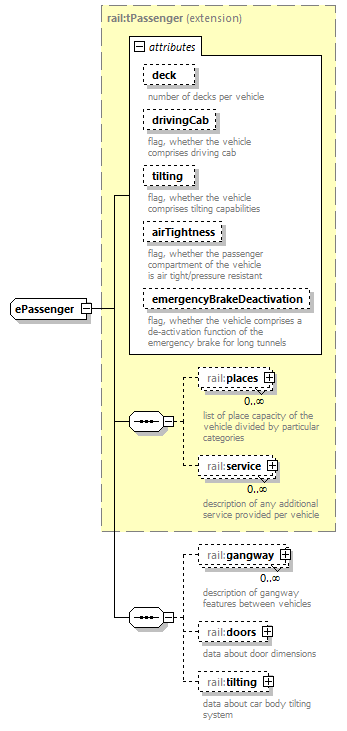 | ||||||||||||||||||||||||||||||||||||||||||||||
| namespace | https://www.railml.org/schemas/2021 | ||||||||||||||||||||||||||||||||||||||||||||||
| type | extension of rail:tPassenger | ||||||||||||||||||||||||||||||||||||||||||||||
| properties |
| ||||||||||||||||||||||||||||||||||||||||||||||
| children | rail:places rail:service rail:gangway rail:doors rail:tilting | ||||||||||||||||||||||||||||||||||||||||||||||
| used by |
| ||||||||||||||||||||||||||||||||||||||||||||||
| attributes |
| ||||||||||||||||||||||||||||||||||||||||||||||
| source | <xs:complexType name="ePassenger"> <xs:complexContent> <xs:extension base="rail:tPassenger"> <xs:sequence> <xs:element name="gangway" type="rail:tGangway" minOccurs="0" maxOccurs="unbounded"> <xs:annotation> <xs:documentation>description of gangway features between vehicles</xs:documentation> <xs:documentation>See https://wiki2.railml.org/wiki/RS:gangway</xs:documentation> </xs:annotation> </xs:element> <xs:element name="doors" type="rail:eDoors" minOccurs="0"> <xs:annotation> <xs:documentation>data about door dimensions</xs:documentation> <xs:documentation>See https://wiki2.railml.org/wiki/RS:doors</xs:documentation> </xs:annotation> </xs:element> <xs:element name="tilting" type="rail:tTilting" minOccurs="0"> <xs:annotation> <xs:documentation>data about car body tilting system</xs:documentation> <xs:documentation>See https://wiki2.railml.org/wiki/RS:tilting</xs:documentation> </xs:annotation> </xs:element> </xs:sequence> </xs:extension> </xs:complexContent> </xs:complexType> |
element ePassenger/gangway
| diagram | 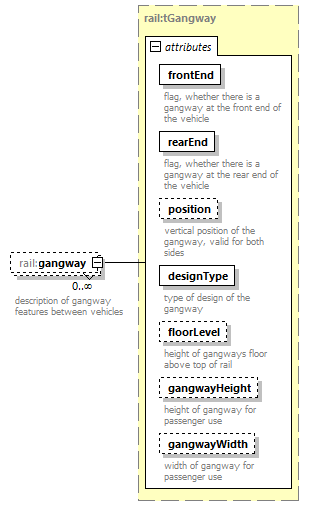 | ||||||||||||||||||||||||||||||||||||||||||||||||||||||||||||||
| namespace | https://www.railml.org/schemas/2021 | ||||||||||||||||||||||||||||||||||||||||||||||||||||||||||||||
| type | rail:tGangway | ||||||||||||||||||||||||||||||||||||||||||||||||||||||||||||||
| properties |
| ||||||||||||||||||||||||||||||||||||||||||||||||||||||||||||||
| attributes |
| ||||||||||||||||||||||||||||||||||||||||||||||||||||||||||||||
| annotation |
| ||||||||||||||||||||||||||||||||||||||||||||||||||||||||||||||
| source | <xs:element name="gangway" type="rail:tGangway" minOccurs="0" maxOccurs="unbounded"> <xs:annotation> <xs:documentation>description of gangway features between vehicles</xs:documentation> <xs:documentation>See https://wiki2.railml.org/wiki/RS:gangway</xs:documentation> </xs:annotation> </xs:element> |
element ePassenger/doors
| diagram |  | ||||||||||||||||||||||||||||||||||||||||||||||||||||||||||||||||||||||
| namespace | https://www.railml.org/schemas/2021 | ||||||||||||||||||||||||||||||||||||||||||||||||||||||||||||||||||||||
| type | rail:eDoors | ||||||||||||||||||||||||||||||||||||||||||||||||||||||||||||||||||||||
| properties |
| ||||||||||||||||||||||||||||||||||||||||||||||||||||||||||||||||||||||
| children | rail:passengerFlowSpeed | ||||||||||||||||||||||||||||||||||||||||||||||||||||||||||||||||||||||
| attributes |
| ||||||||||||||||||||||||||||||||||||||||||||||||||||||||||||||||||||||
| annotation |
| ||||||||||||||||||||||||||||||||||||||||||||||||||||||||||||||||||||||
| source | <xs:element name="doors" type="rail:eDoors" minOccurs="0"> <xs:annotation> <xs:documentation>data about door dimensions</xs:documentation> <xs:documentation>See https://wiki2.railml.org/wiki/RS:doors</xs:documentation> </xs:annotation> </xs:element> |
element ePassenger/tilting
| diagram |  | ||||||||||||||||||||||||||||||
| namespace | https://www.railml.org/schemas/2021 | ||||||||||||||||||||||||||||||
| type | rail:tTilting | ||||||||||||||||||||||||||||||
| properties |
| ||||||||||||||||||||||||||||||
| attributes |
| ||||||||||||||||||||||||||||||
| annotation |
| ||||||||||||||||||||||||||||||
| source | <xs:element name="tilting" type="rail:tTilting" minOccurs="0"> <xs:annotation> <xs:documentation>data about car body tilting system</xs:documentation> <xs:documentation>See https://wiki2.railml.org/wiki/RS:tilting</xs:documentation> </xs:annotation> </xs:element> |
complexType ePneumaticCoupler
| diagram | 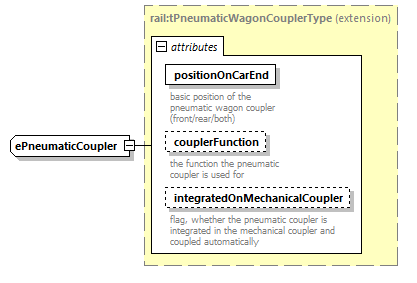 | ||||||||||||||||||||||||||||||
| namespace | https://www.railml.org/schemas/2021 | ||||||||||||||||||||||||||||||
| type | extension of rail:tPneumaticWagonCouplerType | ||||||||||||||||||||||||||||||
| properties |
| ||||||||||||||||||||||||||||||
| used by |
| ||||||||||||||||||||||||||||||
| attributes |
| ||||||||||||||||||||||||||||||
| source | <xs:complexType name="ePneumaticCoupler"> <xs:complexContent> <xs:extension base="rail:tPneumaticWagonCouplerType"> <xs:annotation> <xs:documentation>See https://wiki2.railml.org/wiki/RS:pneumaticCoupler</xs:documentation> </xs:annotation> </xs:extension> </xs:complexContent> </xs:complexType> |
complexType ePropulsion
| diagram |  | ||||||||||||||||||||||||||||||||||||||||||||||||||||||||||||||||||||||||||||||||||||||||||||||||||||||||||||||||||||||||||||||||||||||||||||||||||||||||||||||||||||||||||||||||||||||||||||||||||||||||||||||||||||||||||||||||||||||||||||||
| namespace | https://www.railml.org/schemas/2021 | ||||||||||||||||||||||||||||||||||||||||||||||||||||||||||||||||||||||||||||||||||||||||||||||||||||||||||||||||||||||||||||||||||||||||||||||||||||||||||||||||||||||||||||||||||||||||||||||||||||||||||||||||||||||||||||||||||||||||||||||
| type | extension of rail:tPropulsion | ||||||||||||||||||||||||||||||||||||||||||||||||||||||||||||||||||||||||||||||||||||||||||||||||||||||||||||||||||||||||||||||||||||||||||||||||||||||||||||||||||||||||||||||||||||||||||||||||||||||||||||||||||||||||||||||||||||||||||||||
| properties |
| ||||||||||||||||||||||||||||||||||||||||||||||||||||||||||||||||||||||||||||||||||||||||||||||||||||||||||||||||||||||||||||||||||||||||||||||||||||||||||||||||||||||||||||||||||||||||||||||||||||||||||||||||||||||||||||||||||||||||||||||
| children | rail:additionalName rail:transformer rail:fourQuadrantChopper rail:link rail:tractionInverter rail:tractionMotor rail:diesel rail:gear rail:auxiliarySupply rail:tractiveEffort rail:brakeEffort rail:tractiveCurrent rail:brakeCurrent rail:tractiveCurrentLimitation rail:brakeCurrentLimitation rail:tractiveVehicleEfficiency rail:brakeVehicleEfficiency rail:rackTraction | ||||||||||||||||||||||||||||||||||||||||||||||||||||||||||||||||||||||||||||||||||||||||||||||||||||||||||||||||||||||||||||||||||||||||||||||||||||||||||||||||||||||||||||||||||||||||||||||||||||||||||||||||||||||||||||||||||||||||||||||
| used by |
| ||||||||||||||||||||||||||||||||||||||||||||||||||||||||||||||||||||||||||||||||||||||||||||||||||||||||||||||||||||||||||||||||||||||||||||||||||||||||||||||||||||||||||||||||||||||||||||||||||||||||||||||||||||||||||||||||||||||||||||||
| attributes |
| ||||||||||||||||||||||||||||||||||||||||||||||||||||||||||||||||||||||||||||||||||||||||||||||||||||||||||||||||||||||||||||||||||||||||||||||||||||||||||||||||||||||||||||||||||||||||||||||||||||||||||||||||||||||||||||||||||||||||||||||
| annotation |
| ||||||||||||||||||||||||||||||||||||||||||||||||||||||||||||||||||||||||||||||||||||||||||||||||||||||||||||||||||||||||||||||||||||||||||||||||||||||||||||||||||||||||||||||||||||||||||||||||||||||||||||||||||||||||||||||||||||||||||||||
| source | <xs:complexType name="ePropulsion"> <xs:annotation> <xs:documentation>technical data about the propulsion system of a vehicle</xs:documentation> <xs:documentation>See https://wiki2.railml.org/wiki/RS:propulsion</xs:documentation> </xs:annotation> <xs:complexContent> <xs:extension base="rail:tPropulsion"> <xs:sequence> <xs:element name="transformer" type="rail:eTransformer" minOccurs="0"> <xs:annotation> <xs:documentation>technical data of main transformer</xs:documentation> <xs:documentation>See https://wiki2.railml.org/wiki/RS:transformer</xs:documentation> </xs:annotation> </xs:element> <xs:element name="fourQuadrantChopper" type="rail:eFourQuadrantChopper" minOccurs="0"> <xs:annotation> <xs:documentation>technical data of inverter between OHL/transformer and link circuit</xs:documentation> <xs:documentation>See https://wiki2.railml.org/wiki/RS:fourQuadrantChopper</xs:documentation> </xs:annotation> </xs:element> <xs:element name="link" type="rail:tLink" minOccurs="0"> <xs:annotation> <xs:documentation>nominal values of link circuit between input inverter and motor inverter</xs:documentation> <xs:documentation>See https://wiki2.railml.org/wiki/RS:link</xs:documentation> </xs:annotation> </xs:element> <xs:element name="tractionInverter" type="rail:eTractionInverter" minOccurs="0"> <xs:annotation> <xs:documentation>technical data of inverter between link circuit and motors</xs:documentation> <xs:documentation>See https://wiki2.railml.org/wiki/RS:tractionInverter</xs:documentation> </xs:annotation> </xs:element> <xs:element name="tractionMotor" type="rail:eTractionMotor" minOccurs="0"> <xs:annotation> <xs:documentation>technical data of traction motor</xs:documentation> <xs:documentation>See https://wiki2.railml.org/wiki/RS:tractionMotor</xs:documentation> </xs:annotation> </xs:element> <xs:element name="diesel" type="rail:tDieselEngine" minOccurs="0"> <xs:annotation> <xs:documentation>technical data of diesel engine</xs:documentation> <xs:documentation>See https://wiki2.railml.org/wiki/RS:diesel</xs:documentation> </xs:annotation> </xs:element> <xs:element name="gear" type="rail:eGear" minOccurs="0"> <xs:annotation> <xs:documentation>technical data of transmission system between motor and wheel</xs:documentation> <xs:documentation>See https://wiki2.railml.org/wiki/RS:gear</xs:documentation> </xs:annotation> </xs:element> <xs:element name="auxiliarySupply" type="rail:eAuxiliarySupply" minOccurs="0" maxOccurs="unbounded"> <xs:annotation> <xs:documentation>technical data of auxiliary systems (supply and consumption)</xs:documentation> <xs:documentation>See https://wiki2.railml.org/wiki/RS:auxiliarySupply</xs:documentation> </xs:annotation> </xs:element> <xs:element name="tractiveEffort" type="rail:tEffortCurve" minOccurs="0"> <xs:annotation> <xs:documentation>mechanical tractive effort at wheel vs. speed by propulsion system</xs:documentation> <xs:documentation>See https://wiki2.railml.org/wiki/RS:tractiveEffort</xs:documentation> </xs:annotation> </xs:element> <xs:element name="brakeEffort" type="rail:tEffortCurve" minOccurs="0"> <xs:annotation> <xs:documentation>mechanical brake effort at wheel vs. speed by propulsion system</xs:documentation> <xs:documentation>See https://wiki2.railml.org/wiki/RS:brakeEffort</xs:documentation> </xs:annotation> </xs:element> <xs:element name="tractiveCurrent" type="rail:tCurrentCurve" minOccurs="0"> <xs:annotation> <xs:documentation>net current of the entire propulsion system as curve vs. speed for traction mode</xs:documentation> <xs:documentation>See https://wiki2.railml.org/wiki/RS:tractiveCurrent</xs:documentation> </xs:annotation> </xs:element> <xs:element name="brakeCurrent" type="rail:tCurrentCurve" minOccurs="0"> <xs:annotation> <xs:documentation>net current of the entire propulsion system as curve vs. speed for braking mode</xs:documentation> <xs:documentation>See https://wiki2.railml.org/wiki/RS:brakeCurrent</xs:documentation> </xs:annotation> </xs:element> <xs:element name="tractiveCurrentLimitation" type="rail:tCurrentLimitation" minOccurs="0"> <xs:annotation> <xs:documentation>limitation curve of net current of the entire propulsion system vs. net voltage for traction mode</xs:documentation> <xs:documentation>See https://wiki2.railml.org/wiki/RS:tractiveCurrentLimitation</xs:documentation> </xs:annotation> </xs:element> <xs:element name="brakeCurrentLimitation" type="rail:tCurrentLimitation" minOccurs="0"> <xs:annotation> <xs:documentation>limitation curve of net current of the entire propulsion system vs. net voltage for braking mode</xs:documentation> <xs:documentation>See https://wiki2.railml.org/wiki/RS:brakeCurrentLimitation</xs:documentation> </xs:annotation> </xs:element> <xs:element name="tractiveVehicleEfficiency" type="rail:tEfficiencyCurve" minOccurs="0"> <xs:annotation> <xs:documentation>efficiency of the entire propulsion system as curve vs. speed or effort for traction mode</xs:documentation> <xs:documentation>See https://wiki2.railml.org/wiki/RS:tractiveVehicleEfficiency</xs:documentation> </xs:annotation> </xs:element> <xs:element name="brakeVehicleEfficiency" type="rail:tEfficiencyCurve" minOccurs="0"> <xs:annotation> <xs:documentation>efficiency of the entire propulsion system as curve vs. speed or effort for braking mode</xs:documentation> <xs:documentation>See https://wiki2.railml.org/wiki/RS:brakeVehicleEfficiency</xs:documentation> </xs:annotation> </xs:element> <xs:element name="rackTraction" type="rail:tRackTractionType" minOccurs="0"> <xs:annotation> <xs:documentation>data about rack traction equipment of the vehicle used for propulsion</xs:documentation> <xs:documentation>See https://wiki2.railml.org/wiki/RS:rackTraction_propulsion</xs:documentation> </xs:annotation> </xs:element> </xs:sequence> </xs:extension> </xs:complexContent> </xs:complexType> |
element ePropulsion/transformer
| diagram | 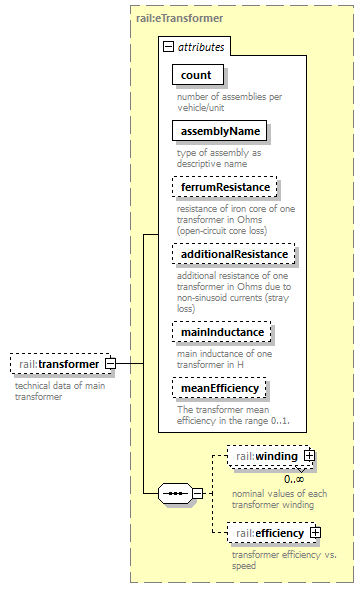 | ||||||||||||||||||||||||||||||||||||||||||||||||||||||
| namespace | https://www.railml.org/schemas/2021 | ||||||||||||||||||||||||||||||||||||||||||||||||||||||
| type | rail:eTransformer | ||||||||||||||||||||||||||||||||||||||||||||||||||||||
| properties |
| ||||||||||||||||||||||||||||||||||||||||||||||||||||||
| children | rail:winding rail:efficiency | ||||||||||||||||||||||||||||||||||||||||||||||||||||||
| attributes |
| ||||||||||||||||||||||||||||||||||||||||||||||||||||||
| annotation |
| ||||||||||||||||||||||||||||||||||||||||||||||||||||||
| source | <xs:element name="transformer" type="rail:eTransformer" minOccurs="0"> <xs:annotation> <xs:documentation>technical data of main transformer</xs:documentation> <xs:documentation>See https://wiki2.railml.org/wiki/RS:transformer</xs:documentation> </xs:annotation> </xs:element> |
element ePropulsion/fourQuadrantChopper
| diagram |  | ||||||||||||||||||||||||||||||||||||||||||||||
| namespace | https://www.railml.org/schemas/2021 | ||||||||||||||||||||||||||||||||||||||||||||||
| type | rail:eFourQuadrantChopper | ||||||||||||||||||||||||||||||||||||||||||||||
| properties |
| ||||||||||||||||||||||||||||||||||||||||||||||
| children | rail:efficiency rail:phi | ||||||||||||||||||||||||||||||||||||||||||||||
| attributes |
| ||||||||||||||||||||||||||||||||||||||||||||||
| annotation |
| ||||||||||||||||||||||||||||||||||||||||||||||
| source | <xs:element name="fourQuadrantChopper" type="rail:eFourQuadrantChopper" minOccurs="0"> <xs:annotation> <xs:documentation>technical data of inverter between OHL/transformer and link circuit</xs:documentation> <xs:documentation>See https://wiki2.railml.org/wiki/RS:fourQuadrantChopper</xs:documentation> </xs:annotation> </xs:element> |
element ePropulsion/link
| diagram |  | ||||||||||||||||||||||
| namespace | https://www.railml.org/schemas/2021 | ||||||||||||||||||||||
| type | rail:tLink | ||||||||||||||||||||||
| properties |
| ||||||||||||||||||||||
| attributes |
| ||||||||||||||||||||||
| annotation |
| ||||||||||||||||||||||
| source | <xs:element name="link" type="rail:tLink" minOccurs="0"> <xs:annotation> <xs:documentation>nominal values of link circuit between input inverter and motor inverter</xs:documentation> <xs:documentation>See https://wiki2.railml.org/wiki/RS:link</xs:documentation> </xs:annotation> </xs:element> |
element ePropulsion/tractionInverter
| diagram |  | ||||||||||||||||||||||||||||||
| namespace | https://www.railml.org/schemas/2021 | ||||||||||||||||||||||||||||||
| type | rail:eTractionInverter | ||||||||||||||||||||||||||||||
| properties |
| ||||||||||||||||||||||||||||||
| children | rail:efficiency rail:pulsePattern | ||||||||||||||||||||||||||||||
| attributes |
| ||||||||||||||||||||||||||||||
| annotation |
| ||||||||||||||||||||||||||||||
| source | <xs:element name="tractionInverter" type="rail:eTractionInverter" minOccurs="0"> <xs:annotation> <xs:documentation>technical data of inverter between link circuit and motors</xs:documentation> <xs:documentation>See https://wiki2.railml.org/wiki/RS:tractionInverter</xs:documentation> </xs:annotation> </xs:element> |
element ePropulsion/tractionMotor
| diagram |  | ||||||||||||||||||||||||||||||||||||||||||||||||||||||||||||||||||||||||||||||||||||||||||||||||||||||||||||||||||||||||||||||||||||||||||||||||||||||
| namespace | https://www.railml.org/schemas/2021 | ||||||||||||||||||||||||||||||||||||||||||||||||||||||||||||||||||||||||||||||||||||||||||||||||||||||||||||||||||||||||||||||||||||||||||||||||||||||
| type | rail:eTractionMotor | ||||||||||||||||||||||||||||||||||||||||||||||||||||||||||||||||||||||||||||||||||||||||||||||||||||||||||||||||||||||||||||||||||||||||||||||||||||||
| properties |
| ||||||||||||||||||||||||||||||||||||||||||||||||||||||||||||||||||||||||||||||||||||||||||||||||||||||||||||||||||||||||||||||||||||||||||||||||||||||
| children | rail:efficiency rail:mechanicalLosses | ||||||||||||||||||||||||||||||||||||||||||||||||||||||||||||||||||||||||||||||||||||||||||||||||||||||||||||||||||||||||||||||||||||||||||||||||||||||
| attributes |
| ||||||||||||||||||||||||||||||||||||||||||||||||||||||||||||||||||||||||||||||||||||||||||||||||||||||||||||||||||||||||||||||||||||||||||||||||||||||
| annotation |
| ||||||||||||||||||||||||||||||||||||||||||||||||||||||||||||||||||||||||||||||||||||||||||||||||||||||||||||||||||||||||||||||||||||||||||||||||||||||
| source | <xs:element name="tractionMotor" type="rail:eTractionMotor" minOccurs="0"> <xs:annotation> <xs:documentation>technical data of traction motor</xs:documentation> <xs:documentation>See https://wiki2.railml.org/wiki/RS:tractionMotor</xs:documentation> </xs:annotation> </xs:element> |
element ePropulsion/diesel
| diagram | 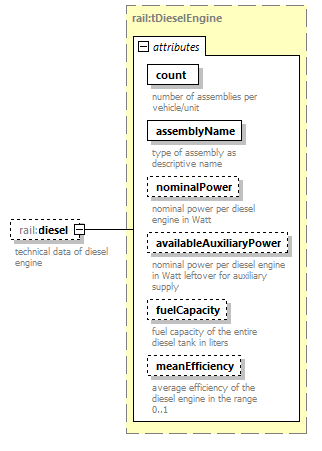 | ||||||||||||||||||||||||||||||||||||||||||||||||||||||
| namespace | https://www.railml.org/schemas/2021 | ||||||||||||||||||||||||||||||||||||||||||||||||||||||
| type | rail:tDieselEngine | ||||||||||||||||||||||||||||||||||||||||||||||||||||||
| properties |
| ||||||||||||||||||||||||||||||||||||||||||||||||||||||
| attributes |
| ||||||||||||||||||||||||||||||||||||||||||||||||||||||
| annotation |
| ||||||||||||||||||||||||||||||||||||||||||||||||||||||
| source | <xs:element name="diesel" type="rail:tDieselEngine" minOccurs="0"> <xs:annotation> <xs:documentation>technical data of diesel engine</xs:documentation> <xs:documentation>See https://wiki2.railml.org/wiki/RS:diesel</xs:documentation> </xs:annotation> </xs:element> |
element ePropulsion/gear
| diagram | 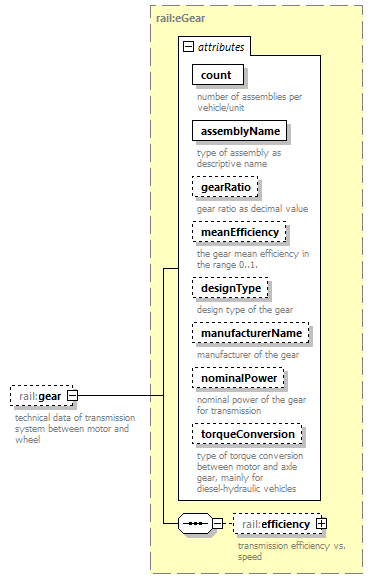 | ||||||||||||||||||||||||||||||||||||||||||||||||||||||||||||||||||||||
| namespace | https://www.railml.org/schemas/2021 | ||||||||||||||||||||||||||||||||||||||||||||||||||||||||||||||||||||||
| type | rail:eGear | ||||||||||||||||||||||||||||||||||||||||||||||||||||||||||||||||||||||
| properties |
| ||||||||||||||||||||||||||||||||||||||||||||||||||||||||||||||||||||||
| children | rail:efficiency | ||||||||||||||||||||||||||||||||||||||||||||||||||||||||||||||||||||||
| attributes |
| ||||||||||||||||||||||||||||||||||||||||||||||||||||||||||||||||||||||
| annotation |
| ||||||||||||||||||||||||||||||||||||||||||||||||||||||||||||||||||||||
| source | <xs:element name="gear" type="rail:eGear" minOccurs="0"> <xs:annotation> <xs:documentation>technical data of transmission system between motor and wheel</xs:documentation> <xs:documentation>See https://wiki2.railml.org/wiki/RS:gear</xs:documentation> </xs:annotation> </xs:element> |
element ePropulsion/auxiliarySupply
| diagram |  | ||||||||||||||||||||||||||||||||||||||||||||||||||||||
| namespace | https://www.railml.org/schemas/2021 | ||||||||||||||||||||||||||||||||||||||||||||||||||||||
| type | rail:eAuxiliarySupply | ||||||||||||||||||||||||||||||||||||||||||||||||||||||
| properties |
| ||||||||||||||||||||||||||||||||||||||||||||||||||||||
| children | rail:dedicatedSupplySystem | ||||||||||||||||||||||||||||||||||||||||||||||||||||||
| attributes |
| ||||||||||||||||||||||||||||||||||||||||||||||||||||||
| annotation |
| ||||||||||||||||||||||||||||||||||||||||||||||||||||||
| source | <xs:element name="auxiliarySupply" type="rail:eAuxiliarySupply" minOccurs="0" maxOccurs="unbounded"> <xs:annotation> <xs:documentation>technical data of auxiliary systems (supply and consumption)</xs:documentation> <xs:documentation>See https://wiki2.railml.org/wiki/RS:auxiliarySupply</xs:documentation> </xs:annotation> </xs:element> |
element ePropulsion/tractiveEffort
| diagram |  | ||||||
| namespace | https://www.railml.org/schemas/2021 | ||||||
| type | rail:tEffortCurve | ||||||
| properties |
| ||||||
| children | rail:valueTable rail:segmentTable | ||||||
| annotation |
| ||||||
| source | <xs:element name="tractiveEffort" type="rail:tEffortCurve" minOccurs="0"> <xs:annotation> <xs:documentation>mechanical tractive effort at wheel vs. speed by propulsion system</xs:documentation> <xs:documentation>See https://wiki2.railml.org/wiki/RS:tractiveEffort</xs:documentation> </xs:annotation> </xs:element> |
element ePropulsion/brakeEffort
| diagram | 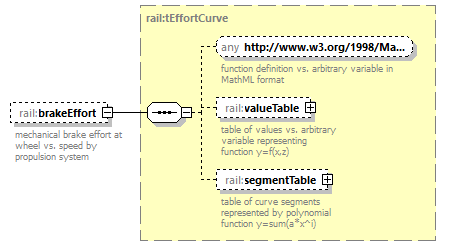 | ||||||
| namespace | https://www.railml.org/schemas/2021 | ||||||
| type | rail:tEffortCurve | ||||||
| properties |
| ||||||
| children | rail:valueTable rail:segmentTable | ||||||
| annotation |
| ||||||
| source | <xs:element name="brakeEffort" type="rail:tEffortCurve" minOccurs="0"> <xs:annotation> <xs:documentation>mechanical brake effort at wheel vs. speed by propulsion system</xs:documentation> <xs:documentation>See https://wiki2.railml.org/wiki/RS:brakeEffort</xs:documentation> </xs:annotation> </xs:element> |
element ePropulsion/tractiveCurrent
| diagram | 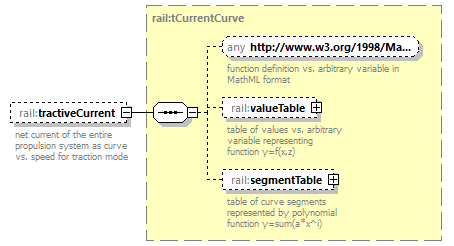 | ||||||
| namespace | https://www.railml.org/schemas/2021 | ||||||
| type | rail:tCurrentCurve | ||||||
| properties |
| ||||||
| children | rail:valueTable rail:segmentTable | ||||||
| annotation |
| ||||||
| source | <xs:element name="tractiveCurrent" type="rail:tCurrentCurve" minOccurs="0"> <xs:annotation> <xs:documentation>net current of the entire propulsion system as curve vs. speed for traction mode</xs:documentation> <xs:documentation>See https://wiki2.railml.org/wiki/RS:tractiveCurrent</xs:documentation> </xs:annotation> </xs:element> |
element ePropulsion/brakeCurrent
| diagram |  | ||||||
| namespace | https://www.railml.org/schemas/2021 | ||||||
| type | rail:tCurrentCurve | ||||||
| properties |
| ||||||
| children | rail:valueTable rail:segmentTable | ||||||
| annotation |
| ||||||
| source | <xs:element name="brakeCurrent" type="rail:tCurrentCurve" minOccurs="0"> <xs:annotation> <xs:documentation>net current of the entire propulsion system as curve vs. speed for braking mode</xs:documentation> <xs:documentation>See https://wiki2.railml.org/wiki/RS:brakeCurrent</xs:documentation> </xs:annotation> </xs:element> |
element ePropulsion/tractiveCurrentLimitation
| diagram |  | ||||||
| namespace | https://www.railml.org/schemas/2021 | ||||||
| type | rail:tCurrentLimitation | ||||||
| properties |
| ||||||
| children | rail:valueTable rail:segmentTable | ||||||
| annotation |
| ||||||
| source | <xs:element name="tractiveCurrentLimitation" type="rail:tCurrentLimitation" minOccurs="0"> <xs:annotation> <xs:documentation>limitation curve of net current of the entire propulsion system vs. net voltage for traction mode</xs:documentation> <xs:documentation>See https://wiki2.railml.org/wiki/RS:tractiveCurrentLimitation</xs:documentation> </xs:annotation> </xs:element> |
element ePropulsion/brakeCurrentLimitation
| diagram |  | ||||||
| namespace | https://www.railml.org/schemas/2021 | ||||||
| type | rail:tCurrentLimitation | ||||||
| properties |
| ||||||
| children | rail:valueTable rail:segmentTable | ||||||
| annotation |
| ||||||
| source | <xs:element name="brakeCurrentLimitation" type="rail:tCurrentLimitation" minOccurs="0"> <xs:annotation> <xs:documentation>limitation curve of net current of the entire propulsion system vs. net voltage for braking mode</xs:documentation> <xs:documentation>See https://wiki2.railml.org/wiki/RS:brakeCurrentLimitation</xs:documentation> </xs:annotation> </xs:element> |
element ePropulsion/tractiveVehicleEfficiency
| diagram |  | ||||||
| namespace | https://www.railml.org/schemas/2021 | ||||||
| type | rail:tEfficiencyCurve | ||||||
| properties |
| ||||||
| children | rail:valueTable rail:segmentTable | ||||||
| annotation |
| ||||||
| source | <xs:element name="tractiveVehicleEfficiency" type="rail:tEfficiencyCurve" minOccurs="0"> <xs:annotation> <xs:documentation>efficiency of the entire propulsion system as curve vs. speed or effort for traction mode</xs:documentation> <xs:documentation>See https://wiki2.railml.org/wiki/RS:tractiveVehicleEfficiency</xs:documentation> </xs:annotation> </xs:element> |
element ePropulsion/brakeVehicleEfficiency
| diagram |  | ||||||
| namespace | https://www.railml.org/schemas/2021 | ||||||
| type | rail:tEfficiencyCurve | ||||||
| properties |
| ||||||
| children | rail:valueTable rail:segmentTable | ||||||
| annotation |
| ||||||
| source | <xs:element name="brakeVehicleEfficiency" type="rail:tEfficiencyCurve" minOccurs="0"> <xs:annotation> <xs:documentation>efficiency of the entire propulsion system as curve vs. speed or effort for braking mode</xs:documentation> <xs:documentation>See https://wiki2.railml.org/wiki/RS:brakeVehicleEfficiency</xs:documentation> </xs:annotation> </xs:element> |
element ePropulsion/rackTraction
| diagram | 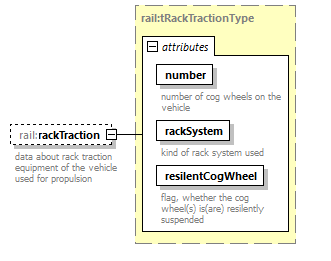 | ||||||||||||||||||||||||||||||
| namespace | https://www.railml.org/schemas/2021 | ||||||||||||||||||||||||||||||
| type | rail:tRackTractionType | ||||||||||||||||||||||||||||||
| properties |
| ||||||||||||||||||||||||||||||
| attributes |
| ||||||||||||||||||||||||||||||
| annotation |
| ||||||||||||||||||||||||||||||
| source | <xs:element name="rackTraction" type="rail:tRackTractionType" minOccurs="0"> <xs:annotation> <xs:documentation>data about rack traction equipment of the vehicle used for propulsion</xs:documentation> <xs:documentation>See https://wiki2.railml.org/wiki/RS:rackTraction_propulsion</xs:documentation> </xs:annotation> </xs:element> |
complexType ePulsePattern
| diagram |  | ||
| namespace | https://www.railml.org/schemas/2021 | ||
| children | rail:valueTable | ||
| used by |
| ||
| source | <xs:complexType name="ePulsePattern"> <xs:sequence> <xs:element name="valueTable"> <xs:annotation> <xs:documentation>table of values vs. arbitrary variable</xs:documentation> <xs:documentation>See https://wiki2.railml.org/wiki/RS:valueTable_pulsePattern</xs:documentation> </xs:annotation> <xs:complexType> <xs:complexContent> <xs:extension base="rail:tValueTable"/> </xs:complexContent> </xs:complexType> </xs:element> </xs:sequence> </xs:complexType> |
element ePulsePattern/valueTable
| diagram |  | ||||||||||||||||||||||||||||||||||||||||||||||||||||||
| namespace | https://www.railml.org/schemas/2021 | ||||||||||||||||||||||||||||||||||||||||||||||||||||||
| type | extension of rail:tValueTable | ||||||||||||||||||||||||||||||||||||||||||||||||||||||
| properties |
| ||||||||||||||||||||||||||||||||||||||||||||||||||||||
| children | rail:columnHeader rail:valueLine | ||||||||||||||||||||||||||||||||||||||||||||||||||||||
| attributes |
| ||||||||||||||||||||||||||||||||||||||||||||||||||||||
| annotation |
| ||||||||||||||||||||||||||||||||||||||||||||||||||||||
| source | <xs:element name="valueTable"> <xs:annotation> <xs:documentation>table of values vs. arbitrary variable</xs:documentation> <xs:documentation>See https://wiki2.railml.org/wiki/RS:valueTable_pulsePattern</xs:documentation> </xs:annotation> <xs:complexType> <xs:complexContent> <xs:extension base="rail:tValueTable"/> </xs:complexContent> </xs:complexType> </xs:element> |
complexType eStorage
| diagram |  | ||||||||||||||||||||||||||||||||||||||||||||||||||||||||||||||||||||||||||||||||||||||||||||||||||||||||||||||
| namespace | https://www.railml.org/schemas/2021 | ||||||||||||||||||||||||||||||||||||||||||||||||||||||||||||||||||||||||||||||||||||||||||||||||||||||||||||||
| type | extension of rail:tStorage | ||||||||||||||||||||||||||||||||||||||||||||||||||||||||||||||||||||||||||||||||||||||||||||||||||||||||||||||
| properties |
| ||||||||||||||||||||||||||||||||||||||||||||||||||||||||||||||||||||||||||||||||||||||||||||||||||||||||||||||
| children | rail:additionalName rail:efficiency | ||||||||||||||||||||||||||||||||||||||||||||||||||||||||||||||||||||||||||||||||||||||||||||||||||||||||||||||
| used by |
| ||||||||||||||||||||||||||||||||||||||||||||||||||||||||||||||||||||||||||||||||||||||||||||||||||||||||||||||
| attributes |
| ||||||||||||||||||||||||||||||||||||||||||||||||||||||||||||||||||||||||||||||||||||||||||||||||||||||||||||||
| source | <xs:complexType name="eStorage"> <xs:complexContent> <xs:extension base="rail:tStorage"> <xs:sequence> <xs:element name="efficiency" type="rail:tEfficiencyCurve" minOccurs="0"> <xs:annotation> <xs:documentation>detailed efficiency of energy storage device</xs:documentation> <xs:documentation>See https://wiki2.railml.org/wiki/RS:efficiency_energyStorage</xs:documentation> </xs:annotation> </xs:element> </xs:sequence> </xs:extension> </xs:complexContent> </xs:complexType> |
element eStorage/efficiency
| diagram | 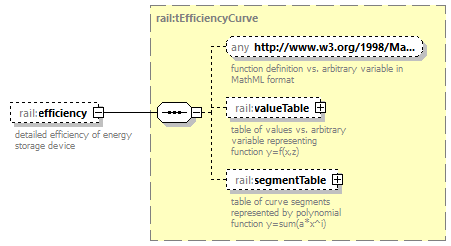 | ||||||
| namespace | https://www.railml.org/schemas/2021 | ||||||
| type | rail:tEfficiencyCurve | ||||||
| properties |
| ||||||
| children | rail:valueTable rail:segmentTable | ||||||
| annotation |
| ||||||
| source | <xs:element name="efficiency" type="rail:tEfficiencyCurve" minOccurs="0"> <xs:annotation> <xs:documentation>detailed efficiency of energy storage device</xs:documentation> <xs:documentation>See https://wiki2.railml.org/wiki/RS:efficiency_energyStorage</xs:documentation> </xs:annotation> </xs:element> |
complexType eTractionInverter
| diagram |  | ||||||||||||||||||||||||||||||
| namespace | https://www.railml.org/schemas/2021 | ||||||||||||||||||||||||||||||
| type | extension of rail:tTractionInverter | ||||||||||||||||||||||||||||||
| properties |
| ||||||||||||||||||||||||||||||
| children | rail:efficiency rail:pulsePattern | ||||||||||||||||||||||||||||||
| used by |
| ||||||||||||||||||||||||||||||
| attributes |
| ||||||||||||||||||||||||||||||
| source | <xs:complexType name="eTractionInverter"> <xs:complexContent> <xs:extension base="rail:tTractionInverter"> <xs:sequence> <xs:element name="efficiency" type="rail:tEfficiencyCurve" minOccurs="0"> <xs:annotation> <xs:documentation>traction inverter efficiency vs. speed</xs:documentation> <xs:documentation>See https://wiki2.railml.org/wiki/RS:efficiency_tractionInverter</xs:documentation> </xs:annotation> </xs:element> <xs:element name="pulsePattern" type="rail:ePulsePattern" minOccurs="0"> <xs:annotation> <xs:documentation>pulse pattern of the traction inverter</xs:documentation> <xs:documentation>See https://wiki2.railml.org/wiki/RS:pulsePattern</xs:documentation> </xs:annotation> </xs:element> </xs:sequence> </xs:extension> </xs:complexContent> </xs:complexType> |
element eTractionInverter/efficiency
| diagram | 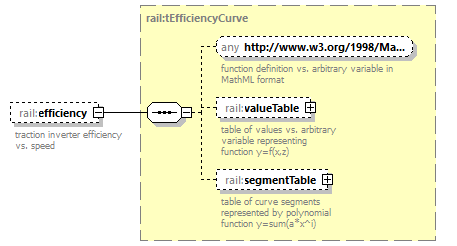 | ||||||
| namespace | https://www.railml.org/schemas/2021 | ||||||
| type | rail:tEfficiencyCurve | ||||||
| properties |
| ||||||
| children | rail:valueTable rail:segmentTable | ||||||
| annotation |
| ||||||
| source | <xs:element name="efficiency" type="rail:tEfficiencyCurve" minOccurs="0"> <xs:annotation> <xs:documentation>traction inverter efficiency vs. speed</xs:documentation> <xs:documentation>See https://wiki2.railml.org/wiki/RS:efficiency_tractionInverter</xs:documentation> </xs:annotation> </xs:element> |
element eTractionInverter/pulsePattern
| diagram |  | ||||||
| namespace | https://www.railml.org/schemas/2021 | ||||||
| type | rail:ePulsePattern | ||||||
| properties |
| ||||||
| children | rail:valueTable | ||||||
| annotation |
| ||||||
| source | <xs:element name="pulsePattern" type="rail:ePulsePattern" minOccurs="0"> <xs:annotation> <xs:documentation>pulse pattern of the traction inverter</xs:documentation> <xs:documentation>See https://wiki2.railml.org/wiki/RS:pulsePattern</xs:documentation> </xs:annotation> </xs:element> |
complexType eTractionMotor
| diagram |  | ||||||||||||||||||||||||||||||||||||||||||||||||||||||||||||||||||||||||||||||||||||||||||||||||||||||||||||||||||||||||||||||||||||||||||||||||||||||
| namespace | https://www.railml.org/schemas/2021 | ||||||||||||||||||||||||||||||||||||||||||||||||||||||||||||||||||||||||||||||||||||||||||||||||||||||||||||||||||||||||||||||||||||||||||||||||||||||
| type | extension of rail:tTractionMotor | ||||||||||||||||||||||||||||||||||||||||||||||||||||||||||||||||||||||||||||||||||||||||||||||||||||||||||||||||||||||||||||||||||||||||||||||||||||||
| properties |
| ||||||||||||||||||||||||||||||||||||||||||||||||||||||||||||||||||||||||||||||||||||||||||||||||||||||||||||||||||||||||||||||||||||||||||||||||||||||
| children | rail:efficiency rail:mechanicalLosses | ||||||||||||||||||||||||||||||||||||||||||||||||||||||||||||||||||||||||||||||||||||||||||||||||||||||||||||||||||||||||||||||||||||||||||||||||||||||
| used by |
| ||||||||||||||||||||||||||||||||||||||||||||||||||||||||||||||||||||||||||||||||||||||||||||||||||||||||||||||||||||||||||||||||||||||||||||||||||||||
| attributes |
| ||||||||||||||||||||||||||||||||||||||||||||||||||||||||||||||||||||||||||||||||||||||||||||||||||||||||||||||||||||||||||||||||||||||||||||||||||||||
| source | <xs:complexType name="eTractionMotor"> <xs:complexContent> <xs:extension base="rail:tTractionMotor"> <xs:sequence> <xs:element name="efficiency" type="rail:tEfficiencyCurve" minOccurs="0"> <xs:annotation> <xs:documentation>traction motor efficiency vs. speed</xs:documentation> <xs:documentation>See https://wiki2.railml.org/wiki/RS:efficiency_tractionMotor</xs:documentation> </xs:annotation> </xs:element> <xs:element name="mechanicalLosses" type="rail:tLosses" minOccurs="0"> <xs:annotation> <xs:documentation>traction motor mechanical losses vs. speed</xs:documentation> <xs:documentation>See https://wiki2.railml.org/wiki/RS:mechanicalLosses</xs:documentation> </xs:annotation> </xs:element> </xs:sequence> </xs:extension> </xs:complexContent> </xs:complexType> |
element eTractionMotor/efficiency
| diagram | 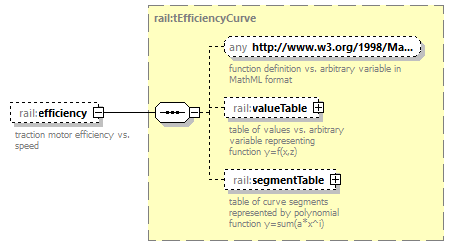 | ||||||
| namespace | https://www.railml.org/schemas/2021 | ||||||
| type | rail:tEfficiencyCurve | ||||||
| properties |
| ||||||
| children | rail:valueTable rail:segmentTable | ||||||
| annotation |
| ||||||
| source | <xs:element name="efficiency" type="rail:tEfficiencyCurve" minOccurs="0"> <xs:annotation> <xs:documentation>traction motor efficiency vs. speed</xs:documentation> <xs:documentation>See https://wiki2.railml.org/wiki/RS:efficiency_tractionMotor</xs:documentation> </xs:annotation> </xs:element> |
element eTractionMotor/mechanicalLosses
| diagram |  | ||||||
| namespace | https://www.railml.org/schemas/2021 | ||||||
| type | rail:tLosses | ||||||
| properties |
| ||||||
| children | rail:valueTable rail:segmentTable | ||||||
| annotation |
| ||||||
| source | <xs:element name="mechanicalLosses" type="rail:tLosses" minOccurs="0"> <xs:annotation> <xs:documentation>traction motor mechanical losses vs. speed</xs:documentation> <xs:documentation>See https://wiki2.railml.org/wiki/RS:mechanicalLosses</xs:documentation> </xs:annotation> </xs:element> |
complexType eTrainOrder
| diagram |  | ||
| namespace | https://www.railml.org/schemas/2021 | ||
| children | rail:vehicleRef | ||
| used by |
| ||
| source | <xs:complexType name="eTrainOrder"> <xs:sequence> <xs:element name="vehicleRef" type="rail:tVehicleRef" maxOccurs="unbounded"> <xs:annotation> <xs:documentation>references via ID-attribute to vehicle element</xs:documentation> <xs:documentation>See https://wiki2.railml.org/wiki/RS:vehicleRef</xs:documentation> </xs:annotation> </xs:element> </xs:sequence> </xs:complexType> |
element eTrainOrder/vehicleRef
| diagram |  | ||||||||||||||||||||||||||||||||||||||||||||||
| namespace | https://www.railml.org/schemas/2021 | ||||||||||||||||||||||||||||||||||||||||||||||
| type | rail:tVehicleRef | ||||||||||||||||||||||||||||||||||||||||||||||
| properties |
| ||||||||||||||||||||||||||||||||||||||||||||||
| attributes |
| ||||||||||||||||||||||||||||||||||||||||||||||
| annotation |
| ||||||||||||||||||||||||||||||||||||||||||||||
| source | <xs:element name="vehicleRef" type="rail:tVehicleRef" maxOccurs="unbounded"> <xs:annotation> <xs:documentation>references via ID-attribute to vehicle element</xs:documentation> <xs:documentation>See https://wiki2.railml.org/wiki/RS:vehicleRef</xs:documentation> </xs:annotation> </xs:element> |
complexType eTrainRadio
| diagram | 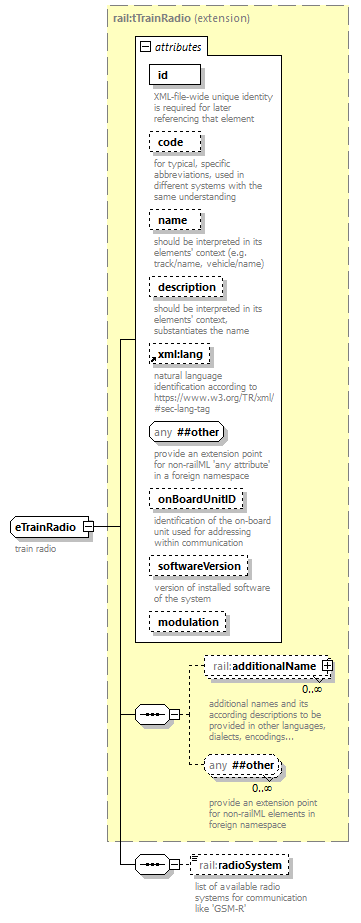 | ||||||||||||||||||||||||||||||||||||||||||||||||||||||||||||||||||||
| namespace | https://www.railml.org/schemas/2021 | ||||||||||||||||||||||||||||||||||||||||||||||||||||||||||||||||||||
| type | extension of rail:tTrainRadio | ||||||||||||||||||||||||||||||||||||||||||||||||||||||||||||||||||||
| properties |
| ||||||||||||||||||||||||||||||||||||||||||||||||||||||||||||||||||||
| children | rail:additionalName rail:radioSystem | ||||||||||||||||||||||||||||||||||||||||||||||||||||||||||||||||||||
| used by |
| ||||||||||||||||||||||||||||||||||||||||||||||||||||||||||||||||||||
| attributes |
| ||||||||||||||||||||||||||||||||||||||||||||||||||||||||||||||||||||
| annotation |
| ||||||||||||||||||||||||||||||||||||||||||||||||||||||||||||||||||||
| source | <xs:complexType name="eTrainRadio"> <xs:annotation> <xs:documentation>train radio</xs:documentation> <xs:documentation>See https://wiki2.railml.org/wiki/RS:trainRadio</xs:documentation> </xs:annotation> <xs:complexContent> <xs:extension base="rail:tTrainRadio"> <xs:sequence> <xs:element name="radioSystem" type="rail:tRadioSystem" minOccurs="0"> <xs:annotation> <xs:documentation>list of available radio systems for communication like 'GSM-R'</xs:documentation> <xs:documentation>See https://wiki2.railml.org/wiki/RS:radioSystem</xs:documentation> </xs:annotation> </xs:element> </xs:sequence> </xs:extension> </xs:complexContent> </xs:complexType> |
element eTrainRadio/radioSystem
| diagram |  | ||||||
| namespace | https://www.railml.org/schemas/2021 | ||||||
| type | rail:tRadioSystem | ||||||
| properties |
| ||||||
| annotation |
| ||||||
| source | <xs:element name="radioSystem" type="rail:tRadioSystem" minOccurs="0"> <xs:annotation> <xs:documentation>list of available radio systems for communication like 'GSM-R'</xs:documentation> <xs:documentation>See https://wiki2.railml.org/wiki/RS:radioSystem</xs:documentation> </xs:annotation> </xs:element> |
complexType eTransformer
| diagram |  | ||||||||||||||||||||||||||||||||||||||||||||||||||||||
| namespace | https://www.railml.org/schemas/2021 | ||||||||||||||||||||||||||||||||||||||||||||||||||||||
| type | extension of rail:tTransformer | ||||||||||||||||||||||||||||||||||||||||||||||||||||||
| properties |
| ||||||||||||||||||||||||||||||||||||||||||||||||||||||
| children | rail:winding rail:efficiency | ||||||||||||||||||||||||||||||||||||||||||||||||||||||
| used by |
| ||||||||||||||||||||||||||||||||||||||||||||||||||||||
| attributes |
| ||||||||||||||||||||||||||||||||||||||||||||||||||||||
| source | <xs:complexType name="eTransformer"> <xs:complexContent> <xs:extension base="rail:tTransformer"> <xs:sequence> <xs:element name="winding" type="rail:tWinding" minOccurs="0" maxOccurs="unbounded"> <xs:annotation> <xs:documentation>nominal values of each transformer winding</xs:documentation> <xs:documentation>See https://wiki2.railml.org/wiki/RS:winding</xs:documentation> </xs:annotation> </xs:element> <xs:element name="efficiency" type="rail:tEfficiencyCurve" minOccurs="0"> <xs:annotation> <xs:documentation>transformer efficiency vs. speed</xs:documentation> <xs:documentation>See https://wiki2.railml.org/wiki/RS:efficiency_transformer</xs:documentation> </xs:annotation> </xs:element> </xs:sequence> </xs:extension> </xs:complexContent> </xs:complexType> |
element eTransformer/winding
| diagram |  | ||||||||||||||||||||||||||||||||||||||||||||||||||||||||||||||||||||||
| namespace | https://www.railml.org/schemas/2021 | ||||||||||||||||||||||||||||||||||||||||||||||||||||||||||||||||||||||
| type | rail:tWinding | ||||||||||||||||||||||||||||||||||||||||||||||||||||||||||||||||||||||
| properties |
| ||||||||||||||||||||||||||||||||||||||||||||||||||||||||||||||||||||||
| attributes |
| ||||||||||||||||||||||||||||||||||||||||||||||||||||||||||||||||||||||
| annotation |
| ||||||||||||||||||||||||||||||||||||||||||||||||||||||||||||||||||||||
| source | <xs:element name="winding" type="rail:tWinding" minOccurs="0" maxOccurs="unbounded"> <xs:annotation> <xs:documentation>nominal values of each transformer winding</xs:documentation> <xs:documentation>See https://wiki2.railml.org/wiki/RS:winding</xs:documentation> </xs:annotation> </xs:element> |
element eTransformer/efficiency
| diagram |  | ||||||
| namespace | https://www.railml.org/schemas/2021 | ||||||
| type | rail:tEfficiencyCurve | ||||||
| properties |
| ||||||
| children | rail:valueTable rail:segmentTable | ||||||
| annotation |
| ||||||
| source | <xs:element name="efficiency" type="rail:tEfficiencyCurve" minOccurs="0"> <xs:annotation> <xs:documentation>transformer efficiency vs. speed</xs:documentation> <xs:documentation>See https://wiki2.railml.org/wiki/RS:efficiency_transformer</xs:documentation> </xs:annotation> </xs:element> |
complexType eVehicle
| diagram |  | ||||||||||||||||||||||||||||||||||||||||||||||||||||||||||||||||||||||||||||||||||||||||||||||||||||||||||||||||||||||||||||||||||||||||||||||||||||||||||||||||||||||||||||||||||||||||||||||||||||||||||||||||||||||
| namespace | https://www.railml.org/schemas/2021 | ||||||||||||||||||||||||||||||||||||||||||||||||||||||||||||||||||||||||||||||||||||||||||||||||||||||||||||||||||||||||||||||||||||||||||||||||||||||||||||||||||||||||||||||||||||||||||||||||||||||||||||||||||||||
| type | extension of rail:tVehicle | ||||||||||||||||||||||||||||||||||||||||||||||||||||||||||||||||||||||||||||||||||||||||||||||||||||||||||||||||||||||||||||||||||||||||||||||||||||||||||||||||||||||||||||||||||||||||||||||||||||||||||||||||||||||
| properties |
| ||||||||||||||||||||||||||||||||||||||||||||||||||||||||||||||||||||||||||||||||||||||||||||||||||||||||||||||||||||||||||||||||||||||||||||||||||||||||||||||||||||||||||||||||||||||||||||||||||||||||||||||||||||||
| children | rail:additionalName rail:states rail:classification rail:engine rail:wagon rail:vehicleBrakes rail:loadLimitMatrix rail:curvingLimitation rail:maintenanceIntervals | ||||||||||||||||||||||||||||||||||||||||||||||||||||||||||||||||||||||||||||||||||||||||||||||||||||||||||||||||||||||||||||||||||||||||||||||||||||||||||||||||||||||||||||||||||||||||||||||||||||||||||||||||||||||
| used by |
| ||||||||||||||||||||||||||||||||||||||||||||||||||||||||||||||||||||||||||||||||||||||||||||||||||||||||||||||||||||||||||||||||||||||||||||||||||||||||||||||||||||||||||||||||||||||||||||||||||||||||||||||||||||||
| attributes |
| ||||||||||||||||||||||||||||||||||||||||||||||||||||||||||||||||||||||||||||||||||||||||||||||||||||||||||||||||||||||||||||||||||||||||||||||||||||||||||||||||||||||||||||||||||||||||||||||||||||||||||||||||||||||
| source | <xs:complexType name="eVehicle"> <xs:complexContent> <xs:extension base="rail:tVehicle"> <xs:sequence> <xs:element name="classification" type="rail:eClassification" minOccurs="0"> <xs:annotation> <xs:documentation>general management and classification data of vehicle</xs:documentation> <xs:documentation>See https://wiki2.railml.org/wiki/RS:classification</xs:documentation> </xs:annotation> </xs:element> <xs:element name="engine" type="rail:eEngine" minOccurs="0"> <xs:annotation> <xs:documentation>engine data about a motor car or locomotive</xs:documentation> <xs:documentation>See https://wiki2.railml.org/wiki/RS:engine</xs:documentation> </xs:annotation> </xs:element> <xs:element name="wagon" type="rail:eWagon" minOccurs="0"> <xs:annotation> <xs:documentation>technical and payload data about a (motor) car or locomotive</xs:documentation> <xs:documentation>See https://wiki2.railml.org/wiki/RS:wagon</xs:documentation> </xs:annotation> </xs:element> <xs:element name="vehicleBrakes" type="rail:eVehicleBrakes" minOccurs="0"> <xs:annotation> <xs:documentation>data about brake systems independent from propulsion</xs:documentation> <xs:documentation>See https://wiki2.railml.org/wiki/RS:vehicleBrakes</xs:documentation> </xs:annotation> </xs:element> <xs:element name="loadLimitMatrix" type="rail:eLoadLimitMatrix" minOccurs="0"> <xs:annotation> <xs:documentation>matrix of permissible speed, line classification and payload</xs:documentation> <xs:documentation>See https://wiki2.railml.org/wiki/RS:loadLimitMatrix</xs:documentation> </xs:annotation> </xs:element> <xs:element name="curvingLimitation" type="rail:eCurvingLimitation" minOccurs="0"> <xs:annotation> <xs:documentation>list of permissible curve radius in horizontal and vertical direction</xs:documentation> <xs:documentation>See https://wiki2.railml.org/wiki/RS:curvingLimitation</xs:documentation> </xs:annotation> </xs:element> <xs:element name="maintenanceIntervals" type="rail:eMaintenanceIntervals" minOccurs="0"> <xs:annotation> <xs:documentation>See https://wiki2.railml.org/wiki/RS:maintenanceIntervals</xs:documentation> </xs:annotation> </xs:element> </xs:sequence> </xs:extension> </xs:complexContent> </xs:complexType> |
element eVehicle/classification
| diagram |  | ||||||
| namespace | https://www.railml.org/schemas/2021 | ||||||
| type | rail:eClassification | ||||||
| properties |
| ||||||
| children | rail:manufacturer rail:owner rail:operator | ||||||
| annotation |
| ||||||
| source | <xs:element name="classification" type="rail:eClassification" minOccurs="0"> <xs:annotation> <xs:documentation>general management and classification data of vehicle</xs:documentation> <xs:documentation>See https://wiki2.railml.org/wiki/RS:classification</xs:documentation> </xs:annotation> </xs:element> |
element eVehicle/engine
| diagram | 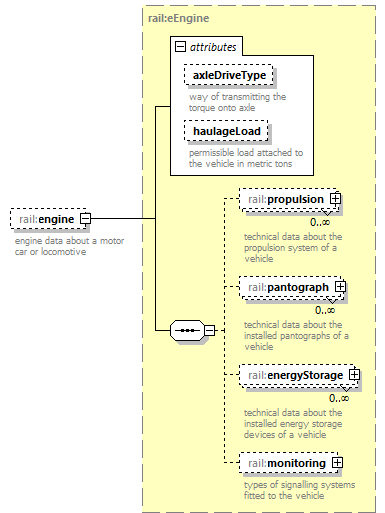 | ||||||||||||||||||||||
| namespace | https://www.railml.org/schemas/2021 | ||||||||||||||||||||||
| type | rail:eEngine | ||||||||||||||||||||||
| properties |
| ||||||||||||||||||||||
| children | rail:propulsion rail:pantograph rail:energyStorage rail:monitoring | ||||||||||||||||||||||
| attributes |
| ||||||||||||||||||||||
| annotation |
| ||||||||||||||||||||||
| source | <xs:element name="engine" type="rail:eEngine" minOccurs="0"> <xs:annotation> <xs:documentation>engine data about a motor car or locomotive</xs:documentation> <xs:documentation>See https://wiki2.railml.org/wiki/RS:engine</xs:documentation> </xs:annotation> </xs:element> |
element eVehicle/wagon
| diagram |  | ||||||||||||||||||||||||||||||||||||||||||||||||||||||||||||||
| namespace | https://www.railml.org/schemas/2021 | ||||||||||||||||||||||||||||||||||||||||||||||||||||||||||||||
| type | rail:eWagon | ||||||||||||||||||||||||||||||||||||||||||||||||||||||||||||||
| properties |
| ||||||||||||||||||||||||||||||||||||||||||||||||||||||||||||||
| children | rail:passenger rail:goods rail:auxiliarySupplySystem rail:driversCab rail:rackTraction rail:couplers rail:trainClearanceGauge | ||||||||||||||||||||||||||||||||||||||||||||||||||||||||||||||
| attributes |
| ||||||||||||||||||||||||||||||||||||||||||||||||||||||||||||||
| annotation |
| ||||||||||||||||||||||||||||||||||||||||||||||||||||||||||||||
| source | <xs:element name="wagon" type="rail:eWagon" minOccurs="0"> <xs:annotation> <xs:documentation>technical and payload data about a (motor) car or locomotive</xs:documentation> <xs:documentation>See https://wiki2.railml.org/wiki/RS:wagon</xs:documentation> </xs:annotation> </xs:element> |
element eVehicle/vehicleBrakes
| diagram |  | ||||||
| namespace | https://www.railml.org/schemas/2021 | ||||||
| type | rail:eVehicleBrakes | ||||||
| properties |
| ||||||
| children | rail:vehicleBrake rail:vehicleBrakeOperation rail:mechanicalBrakeEffort rail:eddyCurrentBrake | ||||||
| annotation |
| ||||||
| source | <xs:element name="vehicleBrakes" type="rail:eVehicleBrakes" minOccurs="0"> <xs:annotation> <xs:documentation>data about brake systems independent from propulsion</xs:documentation> <xs:documentation>See https://wiki2.railml.org/wiki/RS:vehicleBrakes</xs:documentation> </xs:annotation> </xs:element> |
element eVehicle/loadLimitMatrix
| diagram | 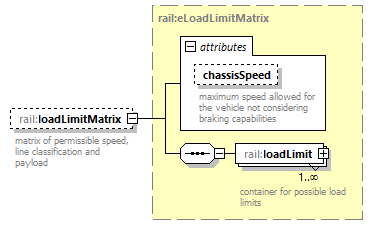 | ||||||||||||||
| namespace | https://www.railml.org/schemas/2021 | ||||||||||||||
| type | rail:eLoadLimitMatrix | ||||||||||||||
| properties |
| ||||||||||||||
| children | rail:loadLimit | ||||||||||||||
| attributes |
| ||||||||||||||
| annotation |
| ||||||||||||||
| source | <xs:element name="loadLimitMatrix" type="rail:eLoadLimitMatrix" minOccurs="0"> <xs:annotation> <xs:documentation>matrix of permissible speed, line classification and payload</xs:documentation> <xs:documentation>See https://wiki2.railml.org/wiki/RS:loadLimitMatrix</xs:documentation> </xs:annotation> </xs:element> |
element eVehicle/curvingLimitation
| diagram | 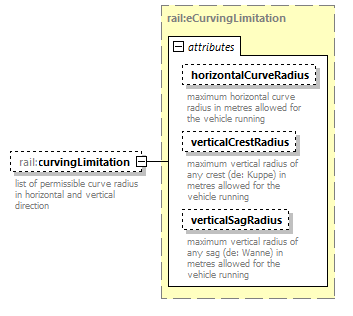 | ||||||||||||||||||||||||||||||
| namespace | https://www.railml.org/schemas/2021 | ||||||||||||||||||||||||||||||
| type | rail:eCurvingLimitation | ||||||||||||||||||||||||||||||
| properties |
| ||||||||||||||||||||||||||||||
| attributes |
| ||||||||||||||||||||||||||||||
| annotation |
| ||||||||||||||||||||||||||||||
| source | <xs:element name="curvingLimitation" type="rail:eCurvingLimitation" minOccurs="0"> <xs:annotation> <xs:documentation>list of permissible curve radius in horizontal and vertical direction</xs:documentation> <xs:documentation>See https://wiki2.railml.org/wiki/RS:curvingLimitation</xs:documentation> </xs:annotation> </xs:element> |
element eVehicle/maintenanceIntervals
| diagram |  | ||||||
| namespace | https://www.railml.org/schemas/2021 | ||||||
| type | rail:eMaintenanceIntervals | ||||||
| properties |
| ||||||
| children | rail:maintenanceInterval | ||||||
| annotation |
| ||||||
| source | <xs:element name="maintenanceIntervals" type="rail:eMaintenanceIntervals" minOccurs="0"> <xs:annotation> <xs:documentation>See https://wiki2.railml.org/wiki/RS:maintenanceIntervals</xs:documentation> </xs:annotation> </xs:element> |
complexType eVehicleBrake
| diagram |  | ||||||||||||||||||||||||||||||||||||||||||||||||||||||||||||||||||||||||||||||||||||||||||||||
| namespace | https://www.railml.org/schemas/2021 | ||||||||||||||||||||||||||||||||||||||||||||||||||||||||||||||||||||||||||||||||||||||||||||||
| type | extension of rail:tBasicBrakeType | ||||||||||||||||||||||||||||||||||||||||||||||||||||||||||||||||||||||||||||||||||||||||||||||
| properties |
| ||||||||||||||||||||||||||||||||||||||||||||||||||||||||||||||||||||||||||||||||||||||||||||||
| children | rail:auxiliaryBrakes | ||||||||||||||||||||||||||||||||||||||||||||||||||||||||||||||||||||||||||||||||||||||||||||||
| used by |
| ||||||||||||||||||||||||||||||||||||||||||||||||||||||||||||||||||||||||||||||||||||||||||||||
| attributes |
| ||||||||||||||||||||||||||||||||||||||||||||||||||||||||||||||||||||||||||||||||||||||||||||||
| source | <xs:complexType name="eVehicleBrake"> <xs:complexContent> <xs:extension base="rail:tBasicBrakeType"> <xs:annotation> <xs:documentation>See https://wiki2.railml.org/wiki/RS:vehicleBrake</xs:documentation> </xs:annotation> <xs:attributeGroup ref="rail:aVehicleBrake"/> </xs:extension> </xs:complexContent> </xs:complexType> |
complexType eVehicleBrakes
| diagram |  | ||||
| namespace | https://www.railml.org/schemas/2021 | ||||
| children | rail:vehicleBrake rail:vehicleBrakeOperation rail:mechanicalBrakeEffort rail:eddyCurrentBrake | ||||
| used by |
| ||||
| annotation |
| ||||
| source | <xs:complexType name="eVehicleBrakes"> <xs:annotation> <xs:documentation>data about brake systems independent from propulsion</xs:documentation> <xs:documentation>See https://wiki2.railml.org/wiki/RS:vehicleBrakes</xs:documentation> </xs:annotation> <xs:sequence> <xs:element name="vehicleBrake" type="rail:eVehicleBrake" maxOccurs="unbounded"> <xs:annotation> <xs:documentation>settings and characteristic of a particular brake type or brake application position</xs:documentation> <xs:documentation>See https://wiki2.railml.org/wiki/RS:vehicleBrake</xs:documentation> </xs:annotation> </xs:element> <xs:element name="vehicleBrakeOperation" type="rail:tBasicBrakeOperation" minOccurs="0" maxOccurs="unbounded"> <xs:annotation> <xs:documentation>operational braking rules according to specific supervision regime for single vehicle</xs:documentation> <xs:documentation>See https://wiki2.railml.org/wiki/RS:vehicleBrakeOperation</xs:documentation> </xs:annotation> </xs:element> <xs:element name="mechanicalBrakeEffort" type="rail:tEffortCurve" minOccurs="0"> <xs:annotation> <xs:documentation>mechanical brake effort at wheel vs. speed by brake systems without propulsion</xs:documentation> <xs:documentation>See https://wiki2.railml.org/wiki/RS:mechanicalBrakeEffort</xs:documentation> </xs:annotation> </xs:element> <xs:element name="eddyCurrentBrake" type="rail:tEddyCurrentBrake" minOccurs="0"> <xs:annotation> <xs:documentation>technical data of eddy current brake</xs:documentation> <xs:documentation>See https://wiki2.railml.org/wiki/RS:eddyCurrentBrake</xs:documentation> </xs:annotation> </xs:element> </xs:sequence> </xs:complexType> |
element eVehicleBrakes/vehicleBrake
| diagram | 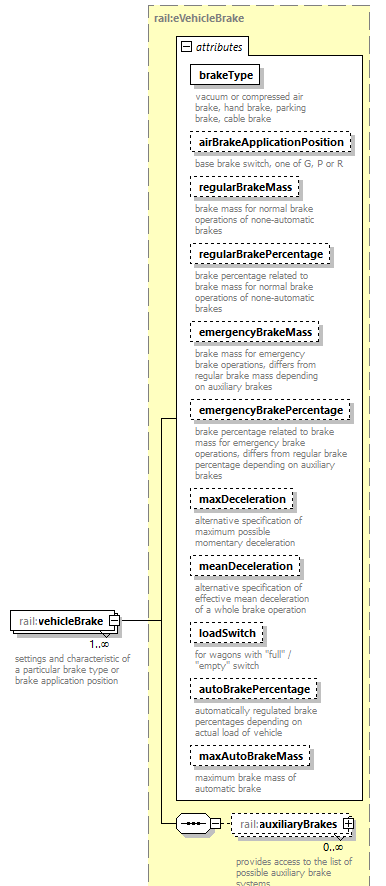 | ||||||||||||||||||||||||||||||||||||||||||||||||||||||||||||||||||||||||||||||||||||||||||||||
| namespace | https://www.railml.org/schemas/2021 | ||||||||||||||||||||||||||||||||||||||||||||||||||||||||||||||||||||||||||||||||||||||||||||||
| type | rail:eVehicleBrake | ||||||||||||||||||||||||||||||||||||||||||||||||||||||||||||||||||||||||||||||||||||||||||||||
| properties |
| ||||||||||||||||||||||||||||||||||||||||||||||||||||||||||||||||||||||||||||||||||||||||||||||
| children | rail:auxiliaryBrakes | ||||||||||||||||||||||||||||||||||||||||||||||||||||||||||||||||||||||||||||||||||||||||||||||
| attributes |
| ||||||||||||||||||||||||||||||||||||||||||||||||||||||||||||||||||||||||||||||||||||||||||||||
| annotation |
| ||||||||||||||||||||||||||||||||||||||||||||||||||||||||||||||||||||||||||||||||||||||||||||||
| source | <xs:element name="vehicleBrake" type="rail:eVehicleBrake" maxOccurs="unbounded"> <xs:annotation> <xs:documentation>settings and characteristic of a particular brake type or brake application position</xs:documentation> <xs:documentation>See https://wiki2.railml.org/wiki/RS:vehicleBrake</xs:documentation> </xs:annotation> </xs:element> |
element eVehicleBrakes/vehicleBrakeOperation
| diagram | 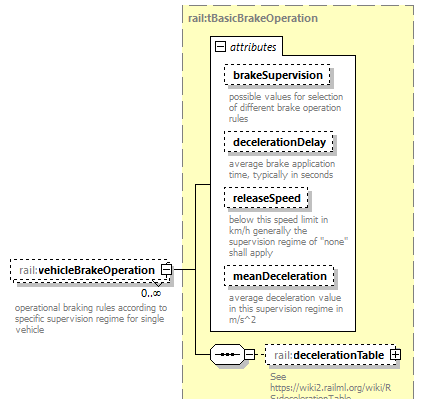 | ||||||||||||||||||||||||||||||||||||||
| namespace | https://www.railml.org/schemas/2021 | ||||||||||||||||||||||||||||||||||||||
| type | rail:tBasicBrakeOperation | ||||||||||||||||||||||||||||||||||||||
| properties |
| ||||||||||||||||||||||||||||||||||||||
| children | rail:decelerationTable | ||||||||||||||||||||||||||||||||||||||
| attributes |
| ||||||||||||||||||||||||||||||||||||||
| annotation |
| ||||||||||||||||||||||||||||||||||||||
| source | <xs:element name="vehicleBrakeOperation" type="rail:tBasicBrakeOperation" minOccurs="0" maxOccurs="unbounded"> <xs:annotation> <xs:documentation>operational braking rules according to specific supervision regime for single vehicle</xs:documentation> <xs:documentation>See https://wiki2.railml.org/wiki/RS:vehicleBrakeOperation</xs:documentation> </xs:annotation> </xs:element> |
element eVehicleBrakes/mechanicalBrakeEffort
| diagram |  | ||||||
| namespace | https://www.railml.org/schemas/2021 | ||||||
| type | rail:tEffortCurve | ||||||
| properties |
| ||||||
| children | rail:valueTable rail:segmentTable | ||||||
| annotation |
| ||||||
| source | <xs:element name="mechanicalBrakeEffort" type="rail:tEffortCurve" minOccurs="0"> <xs:annotation> <xs:documentation>mechanical brake effort at wheel vs. speed by brake systems without propulsion</xs:documentation> <xs:documentation>See https://wiki2.railml.org/wiki/RS:mechanicalBrakeEffort</xs:documentation> </xs:annotation> </xs:element> |
element eVehicleBrakes/eddyCurrentBrake
| diagram | 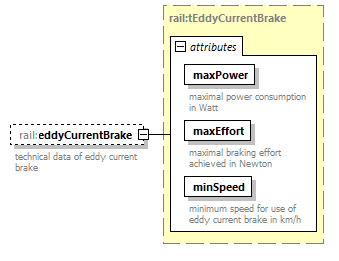 | ||||||||||||||||||||||||||||||
| namespace | https://www.railml.org/schemas/2021 | ||||||||||||||||||||||||||||||
| type | rail:tEddyCurrentBrake | ||||||||||||||||||||||||||||||
| properties |
| ||||||||||||||||||||||||||||||
| attributes |
| ||||||||||||||||||||||||||||||
| annotation |
| ||||||||||||||||||||||||||||||
| source | <xs:element name="eddyCurrentBrake" type="rail:tEddyCurrentBrake" minOccurs="0"> <xs:annotation> <xs:documentation>technical data of eddy current brake</xs:documentation> <xs:documentation>See https://wiki2.railml.org/wiki/RS:eddyCurrentBrake</xs:documentation> </xs:annotation> </xs:element> |
complexType eVehicles
| diagram |  | ||
| namespace | https://www.railml.org/schemas/2021 | ||
| children | rail:vehicle | ||
| used by |
| ||
| source | <xs:complexType name="eVehicles"> <xs:sequence> <xs:element name="vehicle" type="rail:eVehicle" maxOccurs="unbounded"> <xs:annotation> <xs:documentation>data related to single vehicle or vehicle family</xs:documentation> <xs:documentation>See https://wiki2.railml.org/wiki/RS:vehicle</xs:documentation> </xs:annotation> </xs:element> </xs:sequence> </xs:complexType> |
element eVehicles/vehicle
| diagram |  | ||||||||||||||||||||||||||||||||||||||||||||||||||||||||||||||||||||||||||||||||||||||||||||||||||||||||||||||||||||||||||||||||||||||||||||||||||||||||||||||||||||||||||||||||||||||||||||||||||||||||||||||||||||||
| namespace | https://www.railml.org/schemas/2021 | ||||||||||||||||||||||||||||||||||||||||||||||||||||||||||||||||||||||||||||||||||||||||||||||||||||||||||||||||||||||||||||||||||||||||||||||||||||||||||||||||||||||||||||||||||||||||||||||||||||||||||||||||||||||
| type | rail:eVehicle | ||||||||||||||||||||||||||||||||||||||||||||||||||||||||||||||||||||||||||||||||||||||||||||||||||||||||||||||||||||||||||||||||||||||||||||||||||||||||||||||||||||||||||||||||||||||||||||||||||||||||||||||||||||||
| properties |
| ||||||||||||||||||||||||||||||||||||||||||||||||||||||||||||||||||||||||||||||||||||||||||||||||||||||||||||||||||||||||||||||||||||||||||||||||||||||||||||||||||||||||||||||||||||||||||||||||||||||||||||||||||||||
| children | rail:additionalName rail:states rail:classification rail:engine rail:wagon rail:vehicleBrakes rail:loadLimitMatrix rail:curvingLimitation rail:maintenanceIntervals | ||||||||||||||||||||||||||||||||||||||||||||||||||||||||||||||||||||||||||||||||||||||||||||||||||||||||||||||||||||||||||||||||||||||||||||||||||||||||||||||||||||||||||||||||||||||||||||||||||||||||||||||||||||||
| attributes |
| ||||||||||||||||||||||||||||||||||||||||||||||||||||||||||||||||||||||||||||||||||||||||||||||||||||||||||||||||||||||||||||||||||||||||||||||||||||||||||||||||||||||||||||||||||||||||||||||||||||||||||||||||||||||
| annotation |
| ||||||||||||||||||||||||||||||||||||||||||||||||||||||||||||||||||||||||||||||||||||||||||||||||||||||||||||||||||||||||||||||||||||||||||||||||||||||||||||||||||||||||||||||||||||||||||||||||||||||||||||||||||||||
| source | <xs:element name="vehicle" type="rail:eVehicle" maxOccurs="unbounded"> <xs:annotation> <xs:documentation>data related to single vehicle or vehicle family</xs:documentation> <xs:documentation>See https://wiki2.railml.org/wiki/RS:vehicle</xs:documentation> </xs:annotation> </xs:element> |
complexType eWagon
| diagram |  | ||||||||||||||||||||||||||||||||||||||||||||||||||||||||||||||
| namespace | https://www.railml.org/schemas/2021 | ||||||||||||||||||||||||||||||||||||||||||||||||||||||||||||||
| type | extension of rail:tWagon | ||||||||||||||||||||||||||||||||||||||||||||||||||||||||||||||
| properties |
| ||||||||||||||||||||||||||||||||||||||||||||||||||||||||||||||
| children | rail:passenger rail:goods rail:auxiliarySupplySystem rail:driversCab rail:rackTraction rail:couplers rail:trainClearanceGauge | ||||||||||||||||||||||||||||||||||||||||||||||||||||||||||||||
| used by |
| ||||||||||||||||||||||||||||||||||||||||||||||||||||||||||||||
| attributes |
| ||||||||||||||||||||||||||||||||||||||||||||||||||||||||||||||
| annotation |
| ||||||||||||||||||||||||||||||||||||||||||||||||||||||||||||||
| source | <xs:complexType name="eWagon"> <xs:annotation> <xs:documentation>data about the car body of a vehicle and its payload</xs:documentation> <xs:documentation>See https://wiki2.railml.org/wiki/RS:wagon</xs:documentation> </xs:annotation> <xs:complexContent> <xs:extension base="rail:tWagon"> <xs:sequence> <xs:element name="passenger" type="rail:ePassenger" minOccurs="0"> <xs:annotation> <xs:documentation>data for passenger cars</xs:documentation> <xs:documentation>See https://wiki2.railml.org/wiki/RS:passenger</xs:documentation> </xs:annotation> </xs:element> <xs:element name="goods" type="rail:eGoods" minOccurs="0"> <xs:annotation> <xs:documentation>data for freight cars</xs:documentation> <xs:documentation>See https://wiki2.railml.org/wiki/RS:goods</xs:documentation> </xs:annotation> </xs:element> <xs:element name="auxiliarySupplySystem" type="rail:tElectrificationSystem" minOccurs="0" maxOccurs="unbounded"> <xs:annotation> <xs:documentation>installed supply systems for auxiliaries in the vehicle</xs:documentation> <xs:documentation>See https://wiki2.railml.org/wiki/RS:auxiliarySupplySystem</xs:documentation> </xs:annotation> </xs:element> <xs:element name="driversCab" type="rail:tDriversCabType" minOccurs="0" maxOccurs="unbounded"> <xs:annotation> <xs:documentation>data about each drivers cab of the vehicle</xs:documentation> <xs:documentation>See https://wiki2.railml.org/wiki/RS:driversCab</xs:documentation> </xs:annotation> </xs:element> <xs:element name="rackTraction" type="rail:tRackTractionType" minOccurs="0"> <xs:annotation> <xs:documentation>data about rack traction equipment of the vehicle used for braking only</xs:documentation> <xs:documentation>See https://wiki2.railml.org/wiki/RS:rackTraction_wagon</xs:documentation> </xs:annotation> </xs:element> <xs:element name="couplers" type="rail:eCouplers" minOccurs="0"> <xs:annotation> <xs:documentation>data for couplers between wagons</xs:documentation> <xs:documentation>See https://wiki2.railml.org/wiki/RS:couplers</xs:documentation> </xs:annotation> </xs:element> <xs:element name="trainClearanceGauge" type="rail:tClearanceGaugeType" minOccurs="0" maxOccurs="unbounded"> <xs:annotation> <xs:documentation>data about all compatible clearance gauges of the vehicle</xs:documentation> <xs:documentation>See https://wiki2.railml.org/wiki/RS:trainClearanceGauge</xs:documentation> </xs:annotation> </xs:element> </xs:sequence> </xs:extension> </xs:complexContent> </xs:complexType> |
element eWagon/passenger
| diagram | 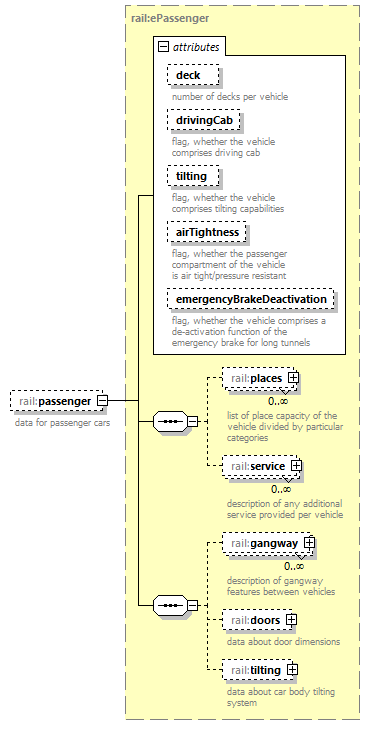 | ||||||||||||||||||||||||||||||||||||||||||||||
| namespace | https://www.railml.org/schemas/2021 | ||||||||||||||||||||||||||||||||||||||||||||||
| type | rail:ePassenger | ||||||||||||||||||||||||||||||||||||||||||||||
| properties |
| ||||||||||||||||||||||||||||||||||||||||||||||
| children | rail:places rail:service rail:gangway rail:doors rail:tilting | ||||||||||||||||||||||||||||||||||||||||||||||
| attributes |
| ||||||||||||||||||||||||||||||||||||||||||||||
| annotation |
| ||||||||||||||||||||||||||||||||||||||||||||||
| source | <xs:element name="passenger" type="rail:ePassenger" minOccurs="0"> <xs:annotation> <xs:documentation>data for passenger cars</xs:documentation> <xs:documentation>See https://wiki2.railml.org/wiki/RS:passenger</xs:documentation> </xs:annotation> </xs:element> |
element eWagon/goods
| diagram |  | ||||||||||||||||||||||||||||||||||||||||||||||
| namespace | https://www.railml.org/schemas/2021 | ||||||||||||||||||||||||||||||||||||||||||||||
| type | rail:eGoods | ||||||||||||||||||||||||||||||||||||||||||||||
| properties |
| ||||||||||||||||||||||||||||||||||||||||||||||
| children | rail:service | ||||||||||||||||||||||||||||||||||||||||||||||
| attributes |
| ||||||||||||||||||||||||||||||||||||||||||||||
| annotation |
| ||||||||||||||||||||||||||||||||||||||||||||||
| source | <xs:element name="goods" type="rail:eGoods" minOccurs="0"> <xs:annotation> <xs:documentation>data for freight cars</xs:documentation> <xs:documentation>See https://wiki2.railml.org/wiki/RS:goods</xs:documentation> </xs:annotation> </xs:element> |
element eWagon/auxiliarySupplySystem
| diagram |  | ||||||||||||||||||||||
| namespace | https://www.railml.org/schemas/2021 | ||||||||||||||||||||||
| type | rail:tElectrificationSystem | ||||||||||||||||||||||
| properties |
| ||||||||||||||||||||||
| attributes |
| ||||||||||||||||||||||
| annotation |
| ||||||||||||||||||||||
| source | <xs:element name="auxiliarySupplySystem" type="rail:tElectrificationSystem" minOccurs="0" maxOccurs="unbounded"> <xs:annotation> <xs:documentation>installed supply systems for auxiliaries in the vehicle</xs:documentation> <xs:documentation>See https://wiki2.railml.org/wiki/RS:auxiliarySupplySystem</xs:documentation> </xs:annotation> </xs:element> |
element eWagon/driversCab
| diagram |  | ||||||||||||||||||||||||||||||
| namespace | https://www.railml.org/schemas/2021 | ||||||||||||||||||||||||||||||
| type | rail:tDriversCabType | ||||||||||||||||||||||||||||||
| properties |
| ||||||||||||||||||||||||||||||
| attributes |
| ||||||||||||||||||||||||||||||
| annotation |
| ||||||||||||||||||||||||||||||
| source | <xs:element name="driversCab" type="rail:tDriversCabType" minOccurs="0" maxOccurs="unbounded"> <xs:annotation> <xs:documentation>data about each drivers cab of the vehicle</xs:documentation> <xs:documentation>See https://wiki2.railml.org/wiki/RS:driversCab</xs:documentation> </xs:annotation> </xs:element> |
element eWagon/rackTraction
| diagram |  | ||||||||||||||||||||||||||||||
| namespace | https://www.railml.org/schemas/2021 | ||||||||||||||||||||||||||||||
| type | rail:tRackTractionType | ||||||||||||||||||||||||||||||
| properties |
| ||||||||||||||||||||||||||||||
| attributes |
| ||||||||||||||||||||||||||||||
| annotation |
| ||||||||||||||||||||||||||||||
| source | <xs:element name="rackTraction" type="rail:tRackTractionType" minOccurs="0"> <xs:annotation> <xs:documentation>data about rack traction equipment of the vehicle used for braking only</xs:documentation> <xs:documentation>See https://wiki2.railml.org/wiki/RS:rackTraction_wagon</xs:documentation> </xs:annotation> </xs:element> |
element eWagon/couplers
| diagram | 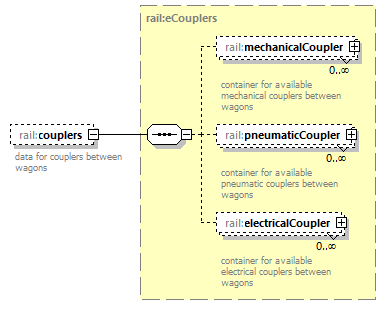 | ||||||
| namespace | https://www.railml.org/schemas/2021 | ||||||
| type | rail:eCouplers | ||||||
| properties |
| ||||||
| children | rail:mechanicalCoupler rail:pneumaticCoupler rail:electricalCoupler | ||||||
| annotation |
| ||||||
| source | <xs:element name="couplers" type="rail:eCouplers" minOccurs="0"> <xs:annotation> <xs:documentation>data for couplers between wagons</xs:documentation> <xs:documentation>See https://wiki2.railml.org/wiki/RS:couplers</xs:documentation> </xs:annotation> </xs:element> |
element eWagon/trainClearanceGauge
| diagram | 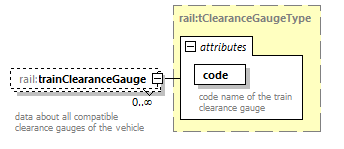 | ||||||||||||||||
| namespace | https://www.railml.org/schemas/2021 | ||||||||||||||||
| type | rail:tClearanceGaugeType | ||||||||||||||||
| properties |
| ||||||||||||||||
| attributes |
| ||||||||||||||||
| annotation |
| ||||||||||||||||
| source | <xs:element name="trainClearanceGauge" type="rail:tClearanceGaugeType" minOccurs="0" maxOccurs="unbounded"> <xs:annotation> <xs:documentation>data about all compatible clearance gauges of the vehicle</xs:documentation> <xs:documentation>See https://wiki2.railml.org/wiki/RS:trainClearanceGauge</xs:documentation> </xs:annotation> </xs:element> |
element timetable
| diagram |  | ||||||||||||||||||||||||||||||||||||||||||||||||||||||||||||||||||||||||||||||||||||||||||||||||||||||||||||||||||||||||||||||||||||||||||||||||||||||||||||||||||||||||||||||||||||||||||||||||||||||||||||||||||||||||||||||||||||
| namespace | https://www.railml.org/schemas/2021 | ||||||||||||||||||||||||||||||||||||||||||||||||||||||||||||||||||||||||||||||||||||||||||||||||||||||||||||||||||||||||||||||||||||||||||||||||||||||||||||||||||||||||||||||||||||||||||||||||||||||||||||||||||||||||||||||||||||
| type | extension of rail:tTimetable | ||||||||||||||||||||||||||||||||||||||||||||||||||||||||||||||||||||||||||||||||||||||||||||||||||||||||||||||||||||||||||||||||||||||||||||||||||||||||||||||||||||||||||||||||||||||||||||||||||||||||||||||||||||||||||||||||||||
| properties |
| ||||||||||||||||||||||||||||||||||||||||||||||||||||||||||||||||||||||||||||||||||||||||||||||||||||||||||||||||||||||||||||||||||||||||||||||||||||||||||||||||||||||||||||||||||||||||||||||||||||||||||||||||||||||||||||||||||||
| children | rail:additionalName rail:metadata rail:timetablePeriods rail:operatingPeriods rail:distributions rail:categories rail:annotations rail:announcements rail:linesTT rail:patternTrainParts rail:patternTrains rail:trainParts rail:trains rail:trainGroups rail:rosterings | ||||||||||||||||||||||||||||||||||||||||||||||||||||||||||||||||||||||||||||||||||||||||||||||||||||||||||||||||||||||||||||||||||||||||||||||||||||||||||||||||||||||||||||||||||||||||||||||||||||||||||||||||||||||||||||||||||||
| used by |
| ||||||||||||||||||||||||||||||||||||||||||||||||||||||||||||||||||||||||||||||||||||||||||||||||||||||||||||||||||||||||||||||||||||||||||||||||||||||||||||||||||||||||||||||||||||||||||||||||||||||||||||||||||||||||||||||||||||
| attributes |
| ||||||||||||||||||||||||||||||||||||||||||||||||||||||||||||||||||||||||||||||||||||||||||||||||||||||||||||||||||||||||||||||||||||||||||||||||||||||||||||||||||||||||||||||||||||||||||||||||||||||||||||||||||||||||||||||||||||
| identity constraints |
| ||||||||||||||||||||||||||||||||||||||||||||||||||||||||||||||||||||||||||||||||||||||||||||||||||||||||||||||||||||||||||||||||||||||||||||||||||||||||||||||||||||||||||||||||||||||||||||||||||||||||||||||||||||||||||||||||||||
| annotation |
| ||||||||||||||||||||||||||||||||||||||||||||||||||||||||||||||||||||||||||||||||||||||||||||||||||||||||||||||||||||||||||||||||||||||||||||||||||||||||||||||||||||||||||||||||||||||||||||||||||||||||||||||||||||||||||||||||||||
| source | <xs:element name="timetable"> <xs:annotation> <xs:documentation>Root element of subtree related to timetable information.</xs:documentation> <xs:documentation>See https://wiki2.railml.org/wiki/TT:timetable</xs:documentation> </xs:annotation> <xs:complexType> <xs:complexContent> <xs:extension base="rail:tTimetable"> <xs:sequence> <xs:element name="timetablePeriods" type="rail:eTimetablePeriods" minOccurs="0"> <xs:annotation> <xs:documentation>Groups timetablePeriod elements.</xs:documentation> <xs:documentation>See https://wiki2.railml.org/wiki/TT:timetablePeriods</xs:documentation> </xs:annotation> </xs:element> <xs:element name="operatingPeriods" type="rail:eOperatingPeriods" minOccurs="0"> <xs:annotation> <xs:documentation>Groups operatingPeriod elements.</xs:documentation> <xs:documentation>See https://wiki2.railml.org/wiki/TT:operatingPeriods</xs:documentation> </xs:annotation> </xs:element> <xs:element name="distributions" type="rail:eDistributions" minOccurs="0"> <xs:annotation> <xs:documentation>Groups distribution elements.</xs:documentation> <xs:documentation>See https://wiki2.railml.org/wiki/TT:distributions</xs:documentation> </xs:annotation> </xs:element> <xs:element name="categories" type="rail:eCategories" minOccurs="0"> <xs:annotation> <xs:documentation>Groups category elements.</xs:documentation> <xs:documentation>See https://wiki2.railml.org/wiki/TT:categories</xs:documentation> </xs:annotation> </xs:element> <xs:element name="annotations" type="rail:eAnnotations" minOccurs="0"> <xs:annotation> <xs:documentation>Groups annotation elements.</xs:documentation> <xs:documentation>See https://wiki2.railml.org/wiki/TT:annotations</xs:documentation> </xs:annotation> </xs:element> <xs:element name="announcements" type="rail:eAnnouncements" minOccurs="0"> <xs:annotation> <xs:documentation>Groups announcement elements.</xs:documentation> <xs:documentation>See https://wiki2.railml.org/wiki/TT:announcements</xs:documentation> </xs:annotation> </xs:element> <xs:element name="linesTT" type="rail:eLines" minOccurs="0"> <xs:annotation> <xs:documentation>Groups lineTT elements.</xs:documentation> <xs:documentation>See https://wiki2.railml.org/wiki/TT:linesTT</xs:documentation> </xs:annotation> </xs:element> <xs:element name="patternTrainParts" type="rail:ePatternTrainParts" minOccurs="0"> <xs:annotation> <xs:documentation>Groups patternTrainPart elements.</xs:documentation> <xs:documentation>See https://wiki2.railml.org/wiki/TT:patternTrainParts</xs:documentation> </xs:annotation> </xs:element> <xs:element name="patternTrains" type="rail:ePatternTrains" minOccurs="0"> <xs:annotation> <xs:documentation>Groups patternTrain elements.</xs:documentation> <xs:documentation>See https://wiki2.railml.org/wiki/TT:patternTrains</xs:documentation> </xs:annotation> </xs:element> <xs:element name="trainParts" type="rail:eTrainParts" minOccurs="0"> <xs:annotation> <xs:documentation>Groups trainPart elements.</xs:documentation> <xs:documentation>See https://wiki2.railml.org/wiki/TT:trainParts</xs:documentation> </xs:annotation> </xs:element> <xs:element name="trains" type="rail:eTrains" minOccurs="0"> <xs:annotation> <xs:documentation>Groups train elements. </xs:documentation> <xs:documentation>See https://wiki2.railml.org/wiki/TT:trains</xs:documentation> </xs:annotation> </xs:element> <xs:element name="trainGroups" type="rail:eTrainGroups" minOccurs="0"> <xs:annotation> <xs:documentation>Groups trainGroup elements.</xs:documentation> <xs:documentation>See https://wiki2.railml.org/wiki/TT:trainGroups</xs:documentation> </xs:annotation> </xs:element> <xs:element name="rosterings" type="rail:eRosterings" minOccurs="0"> <xs:annotation> <xs:documentation>Groups rostering elements. </xs:documentation> <xs:documentation>See https://wiki2.railml.org/wiki/TT:rosterings</xs:documentation> </xs:annotation> </xs:element> </xs:sequence> </xs:extension> </xs:complexContent> </xs:complexType> <xs:key name="timetablePeriodKey"> <xs:selector xpath=".//rail:timetablePeriods/rail:timetablePeriod"/> <xs:field xpath="@id"/> </xs:key> <xs:keyref name="timetablePeriod-operatingPeriodKeyref" refer="rail:timetablePeriodKey"> <xs:selector xpath=".//rail:operatingPeriods/rail:operatingPeriod"/> <xs:field xpath="@timetablePeriodRef"/> </xs:keyref> <xs:keyref name="timetablePeriod-patternTrainPartKeyref" refer="rail:timetablePeriodKey"> <xs:selector xpath="rail:patternTrainParts/rail:patternTrainPart"/> <xs:field xpath="@timetablePeriodRef"/> </xs:keyref> <xs:keyref name="timetablePeriod-trainPartKeyref" refer="rail:timetablePeriodKey"> <xs:selector xpath=".//rail:trainParts/rail:trainPart"/> <xs:field xpath="@timetablePeriodRef"/> </xs:keyref> <xs:key name="distributionKey"> <xs:selector xpath="rail:distributions/rail:distribution"/> <xs:field xpath="@id"/> </xs:key> <xs:keyref name="distribution-patternTrainKeyref" refer="rail:distributionKey"> <xs:selector xpath="rail:patternTrains/rail:patternTrain"/> <xs:field xpath="@distributionRef"/> </xs:keyref> <xs:key name="patternTrainPartKey"> <xs:selector xpath="rail:patternTrainParts/rail:patternTrainPart"/> <xs:field xpath="@id"/> </xs:key> <xs:keyref name="patternTrainPart-trainPartSequenceKeyref" refer="rail:patternTrainPartKey"> <xs:selector xpath="rail:patternTrains/rail:patternTrain/rail:trainPartSequence/rail:patternTrainPartRef"/> <xs:field xpath="@ref"/> </xs:keyref> <xs:key name="trainPartKey"> <xs:selector xpath=".//rail:trainParts/rail:trainPart"/> <xs:field xpath="@id"/> </xs:key> <xs:keyref name="trainPart-trainPartSequenceKeyref" refer="rail:trainPartKey"> <xs:selector xpath=".//rail:trains/rail:train/rail:trainPartSequence/rail:trainPartRef"/> <xs:field xpath="@ref"/> </xs:keyref> <xs:keyref name="trainPart-blockPartKeyref" refer="rail:trainPartKey"> <xs:selector xpath=".//rail:blockParts/rail:blockPart"/> <xs:field xpath="@trainPartRef"/> </xs:keyref> <xs:keyref name="trainPart-connectionKeyref" refer="rail:trainPartKey"> <xs:selector xpath=".//rail:connections/rail:connection"/> <xs:field xpath="@trainPartRef"/> </xs:keyref> <xs:key name="patternTrainKey"> <xs:selector xpath="rail:patternTrains/rail:patternTrain"/> <xs:field xpath="@id"/> </xs:key> <xs:keyref name="patternTrain-trainGroupKeyref" refer="rail:patternTrainKey"> <xs:selector xpath="rail:trainGroups/rail:trainGroup"/> <xs:field xpath="@patternTrainRef"/> </xs:keyref> <xs:key name="trainKey"> <xs:selector xpath=".//rail:trains/rail:train"/> <xs:field xpath="@id"/> </xs:key> <xs:keyref name="train-trainGroupKeyref" refer="rail:trainKey"> <xs:selector xpath=".//rail:trainGroups/rail:trainGroup/rail:trainRef"/> <xs:field xpath="@ref"/> </xs:keyref> <xs:keyref name="train-connectionKeyref" refer="rail:trainKey"> <xs:selector xpath=".//rail:connections/rail:connection"/> <xs:field xpath="@trainRef"/> </xs:keyref> <xs:key name="trainGroupKey"> <xs:selector xpath=".//rail:trainGroups/rail:trainGroup"/> <xs:field xpath="@id"/> </xs:key> <xs:keyref name="trainGroup-trainGroupParentKeyRef" refer="rail:trainGroupKey"> <xs:selector xpath=".//rail:trainGroups/rail:trainGroup"/> <xs:field xpath="@parentRef"/> </xs:keyref> <xs:key name="blockPartKey"> <xs:selector xpath=".//rail:blockParts/rail:blockPart"/> <xs:field xpath="@id"/> </xs:key> <xs:keyref name="blockPart-blockPartSequenceKeyref" refer="rail:blockPartKey"> <xs:selector xpath=".//rail:blocks/rail:block/rail:blockPartSequence/rail:blockPartRef"/> <xs:field xpath="@ref"/> </xs:keyref> <xs:key name="blockKey"> <xs:selector xpath=".//rail:blocks/rail:block"/> <xs:field xpath="@id"/> </xs:key> <xs:keyref name="block-blockPartSequenceKeyref" refer="rail:blockKey"> <xs:selector xpath=".//rail:blocks/rail:block/rail:blockPartSequence"/> <xs:field xpath="@basicBlockRef"/> </xs:keyref> <xs:keyref name="block-circulationKeyref" refer="rail:blockKey"> <xs:selector xpath=".//rail:circulations/rail:circulation"/> <xs:field xpath="@blockRef"/> </xs:keyref> <xs:keyref name="block-circulationNextKeyref" refer="rail:blockKey"> <xs:selector xpath=".//rail:circulations/rail:circulation"/> <xs:field xpath="@nextBlockRef"/> </xs:keyref> <!-- annotation identity in timetable subschema --> <xs:key name="annotationKey"> <xs:selector xpath=".//rail:annotations/rail:annotation"/> <xs:field xpath="@id"/> </xs:key> <!-- annotation reference in timetable subschema --> <xs:keyref name="annotation-trainPartKeyref" refer="rail:annotationKey"> <xs:selector xpath=".//rail:trainParts/rail:trainPart/rail:annotationRef"/> <xs:field xpath="@ref"/> </xs:keyref> <xs:keyref name="annotation-stopDescriptionKeyref" refer="rail:annotationKey"> <xs:selector xpath=".//rail:ocpsTT/rail:ocpTT/rail:stopDescription/rail:annotationRef"/> <xs:field xpath="@ref"/> </xs:keyref> <xs:keyref name="annotation-connectionKeyref" refer="rail:annotationKey"> <xs:selector xpath=".//rail:ocpsTT/rail:ocpTT/rail:connections/rail:connection/rail:annotationRef"/> <xs:field xpath="@ref"/> </xs:keyref> <!-- announcement identity in timetable subschema --> <xs:key name="announcementKey"> <xs:selector xpath=".//rail:announcements/rail:announcement"/> <xs:field xpath="@id"/> </xs:key> <!-- annotation reference in timetable subschema --> <xs:keyref name="announcement-trainPartKeyref" refer="rail:announcementKey"> <xs:selector xpath=".//rail:trainParts/rail:trainPart/rail:announcementRef"/> <xs:field xpath="@ref"/> </xs:keyref> <xs:keyref name="announcement-stopDescriptionKeyref" refer="rail:announcementKey"> <xs:selector xpath=".//rail:ocpsTT/rail:ocpTT/rail:stopDescription/rail:announcementRef"/> <xs:field xpath="@ref"/> </xs:keyref> <xs:keyref name="line-annotationKeyref" refer="rail:annotationKey"> <xs:selector xpath=".//rail:linesTT/rail:lineTT/rail:annotationRef"/> <xs:field xpath="@ref"/> </xs:keyref> <xs:keyref name="line-announcementKeyref" refer="rail:announcementKey"> <xs:selector xpath=".//rail:linesTT/rail:lineTT/rail:announcementRef"/> <xs:field xpath="@ref"/> </xs:keyref> <xs:key name="lineTTKey"> <xs:selector xpath=".//rail:linesTT/rail:lineTT"/> <xs:field xpath="@id"/> </xs:key> <xs:keyref name="trainPart-lineKeyref" refer="rail:lineTTKey"> <xs:selector xpath=".//rail:trainParts/rail:trainPart"/> <xs:field xpath="@lineTTRef"/> </xs:keyref> <xs:keyref name="announcement-connectionKeyref" refer="rail:announcementKey"> <xs:selector xpath=".//rail:ocpsTT/rail:ocpTT/rail:connections/rail:connection/rail:announcementRef"/> <xs:field xpath="@ref"/> </xs:keyref> </xs:element> |
element timetable/timetablePeriods
| diagram |  | ||||||
| namespace | https://www.railml.org/schemas/2021 | ||||||
| type | rail:eTimetablePeriods | ||||||
| properties |
| ||||||
| children | rail:timetablePeriod | ||||||
| annotation |
| ||||||
| source | <xs:element name="timetablePeriods" type="rail:eTimetablePeriods" minOccurs="0"> <xs:annotation> <xs:documentation>Groups timetablePeriod elements.</xs:documentation> <xs:documentation>See https://wiki2.railml.org/wiki/TT:timetablePeriods</xs:documentation> </xs:annotation> </xs:element> |
element timetable/operatingPeriods
| diagram |  | ||||||
| namespace | https://www.railml.org/schemas/2021 | ||||||
| type | rail:eOperatingPeriods | ||||||
| properties |
| ||||||
| children | rail:operatingPeriod | ||||||
| annotation |
| ||||||
| source | <xs:element name="operatingPeriods" type="rail:eOperatingPeriods" minOccurs="0"> <xs:annotation> <xs:documentation>Groups operatingPeriod elements.</xs:documentation> <xs:documentation>See https://wiki2.railml.org/wiki/TT:operatingPeriods</xs:documentation> </xs:annotation> </xs:element> |
element timetable/distributions
| diagram |  | ||||||
| namespace | https://www.railml.org/schemas/2021 | ||||||
| type | rail:eDistributions | ||||||
| properties |
| ||||||
| children | rail:distribution | ||||||
| annotation |
| ||||||
| source | <xs:element name="distributions" type="rail:eDistributions" minOccurs="0"> <xs:annotation> <xs:documentation>Groups distribution elements.</xs:documentation> <xs:documentation>See https://wiki2.railml.org/wiki/TT:distributions</xs:documentation> </xs:annotation> </xs:element> |
element timetable/categories
| diagram |  | ||||||
| namespace | https://www.railml.org/schemas/2021 | ||||||
| type | rail:eCategories | ||||||
| properties |
| ||||||
| children | rail:category | ||||||
| annotation |
| ||||||
| source | <xs:element name="categories" type="rail:eCategories" minOccurs="0"> <xs:annotation> <xs:documentation>Groups category elements.</xs:documentation> <xs:documentation>See https://wiki2.railml.org/wiki/TT:categories</xs:documentation> </xs:annotation> </xs:element> |
element timetable/annotations
| diagram | 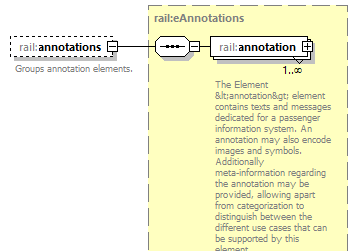 | ||||||
| namespace | https://www.railml.org/schemas/2021 | ||||||
| type | rail:eAnnotations | ||||||
| properties |
| ||||||
| children | rail:annotation | ||||||
| annotation |
| ||||||
| source | <xs:element name="annotations" type="rail:eAnnotations" minOccurs="0"> <xs:annotation> <xs:documentation>Groups annotation elements.</xs:documentation> <xs:documentation>See https://wiki2.railml.org/wiki/TT:annotations</xs:documentation> </xs:annotation> </xs:element> |
element timetable/announcements
| diagram |  | ||||||
| namespace | https://www.railml.org/schemas/2021 | ||||||
| type | rail:eAnnouncements | ||||||
| properties |
| ||||||
| children | rail:announcement | ||||||
| annotation |
| ||||||
| source | <xs:element name="announcements" type="rail:eAnnouncements" minOccurs="0"> <xs:annotation> <xs:documentation>Groups announcement elements.</xs:documentation> <xs:documentation>See https://wiki2.railml.org/wiki/TT:announcements</xs:documentation> </xs:annotation> </xs:element> |
element timetable/linesTT
| diagram |  | ||||||
| namespace | https://www.railml.org/schemas/2021 | ||||||
| type | rail:eLines | ||||||
| properties |
| ||||||
| children | rail:lineTT | ||||||
| annotation |
| ||||||
| source | <xs:element name="linesTT" type="rail:eLines" minOccurs="0"> <xs:annotation> <xs:documentation>Groups lineTT elements.</xs:documentation> <xs:documentation>See https://wiki2.railml.org/wiki/TT:linesTT</xs:documentation> </xs:annotation> </xs:element> |
element timetable/patternTrainParts
| diagram | 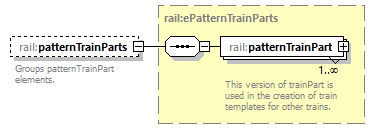 | ||||||
| namespace | https://www.railml.org/schemas/2021 | ||||||
| type | rail:ePatternTrainParts | ||||||
| properties |
| ||||||
| children | rail:patternTrainPart | ||||||
| annotation |
| ||||||
| source | <xs:element name="patternTrainParts" type="rail:ePatternTrainParts" minOccurs="0"> <xs:annotation> <xs:documentation>Groups patternTrainPart elements.</xs:documentation> <xs:documentation>See https://wiki2.railml.org/wiki/TT:patternTrainParts</xs:documentation> </xs:annotation> </xs:element> |
element timetable/patternTrains
| diagram |  | ||||||
| namespace | https://www.railml.org/schemas/2021 | ||||||
| type | rail:ePatternTrains | ||||||
| properties |
| ||||||
| children | rail:patternTrain | ||||||
| annotation |
| ||||||
| source | <xs:element name="patternTrains" type="rail:ePatternTrains" minOccurs="0"> <xs:annotation> <xs:documentation>Groups patternTrain elements.</xs:documentation> <xs:documentation>See https://wiki2.railml.org/wiki/TT:patternTrains</xs:documentation> </xs:annotation> </xs:element> |
element timetable/trainParts
| diagram |  | ||||||
| namespace | https://www.railml.org/schemas/2021 | ||||||
| type | rail:eTrainParts | ||||||
| properties |
| ||||||
| children | rail:trainPart | ||||||
| annotation |
| ||||||
| source | <xs:element name="trainParts" type="rail:eTrainParts" minOccurs="0"> <xs:annotation> <xs:documentation>Groups trainPart elements.</xs:documentation> <xs:documentation>See https://wiki2.railml.org/wiki/TT:trainParts</xs:documentation> </xs:annotation> </xs:element> |
element timetable/trains
| diagram |  | ||||||
| namespace | https://www.railml.org/schemas/2021 | ||||||
| type | rail:eTrains | ||||||
| properties |
| ||||||
| children | rail:train | ||||||
| annotation |
| ||||||
| source | <xs:element name="trains" type="rail:eTrains" minOccurs="0"> <xs:annotation> <xs:documentation>Groups train elements. </xs:documentation> <xs:documentation>See https://wiki2.railml.org/wiki/TT:trains</xs:documentation> </xs:annotation> </xs:element> |
element timetable/trainGroups
| diagram | 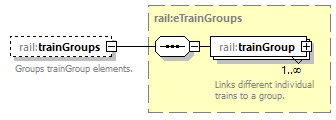 | ||||||
| namespace | https://www.railml.org/schemas/2021 | ||||||
| type | rail:eTrainGroups | ||||||
| properties |
| ||||||
| children | rail:trainGroup | ||||||
| annotation |
| ||||||
| source | <xs:element name="trainGroups" type="rail:eTrainGroups" minOccurs="0"> <xs:annotation> <xs:documentation>Groups trainGroup elements.</xs:documentation> <xs:documentation>See https://wiki2.railml.org/wiki/TT:trainGroups</xs:documentation> </xs:annotation> </xs:element> |
element timetable/rosterings
| diagram |  | ||||||
| namespace | https://www.railml.org/schemas/2021 | ||||||
| type | rail:eRosterings | ||||||
| properties |
| ||||||
| children | rail:rostering | ||||||
| annotation |
| ||||||
| source | <xs:element name="rosterings" type="rail:eRosterings" minOccurs="0"> <xs:annotation> <xs:documentation>Groups rostering elements. </xs:documentation> <xs:documentation>See https://wiki2.railml.org/wiki/TT:rosterings</xs:documentation> </xs:annotation> </xs:element> |
complexType eAlternativeSectionsTT
| diagram |  | ||
| namespace | https://www.railml.org/schemas/2021 | ||
| children | rail:alternativeSectionTT | ||
| used by |
| ||
| source | <xs:complexType name="eAlternativeSectionsTT"> <xs:sequence> <xs:element name="alternativeSectionTT" type="rail:eAlternativeSectionTT" maxOccurs="unbounded"> <xs:annotation> <xs:documentation>Allow the specification of alternative ways to reach the next OCP in an microscopic infrastructure model. These can each be annotated with a priority of their use.</xs:documentation> <xs:documentation>See https://wiki2.railml.org/wiki/TT:alternativeSectionTT</xs:documentation> </xs:annotation> </xs:element> </xs:sequence> </xs:complexType> |
element eAlternativeSectionsTT/alternativeSectionTT
| diagram | 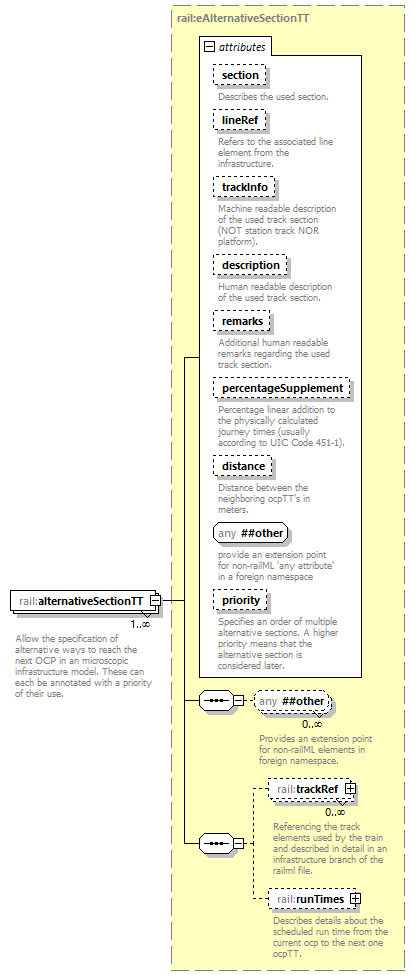 | ||||||||||||||||||||||||||||||||||||||||||||||||||||||||||||||||||||||
| namespace | https://www.railml.org/schemas/2021 | ||||||||||||||||||||||||||||||||||||||||||||||||||||||||||||||||||||||
| type | rail:eAlternativeSectionTT | ||||||||||||||||||||||||||||||||||||||||||||||||||||||||||||||||||||||
| properties |
| ||||||||||||||||||||||||||||||||||||||||||||||||||||||||||||||||||||||
| children | rail:trackRef rail:runTimes | ||||||||||||||||||||||||||||||||||||||||||||||||||||||||||||||||||||||
| attributes |
| ||||||||||||||||||||||||||||||||||||||||||||||||||||||||||||||||||||||
| annotation |
| ||||||||||||||||||||||||||||||||||||||||||||||||||||||||||||||||||||||
| source | <xs:element name="alternativeSectionTT" type="rail:eAlternativeSectionTT" maxOccurs="unbounded"> <xs:annotation> <xs:documentation>Allow the specification of alternative ways to reach the next OCP in an microscopic infrastructure model. These can each be annotated with a priority of their use.</xs:documentation> <xs:documentation>See https://wiki2.railml.org/wiki/TT:alternativeSectionTT</xs:documentation> </xs:annotation> </xs:element> |
complexType eAlternativeSectionTT
| diagram | 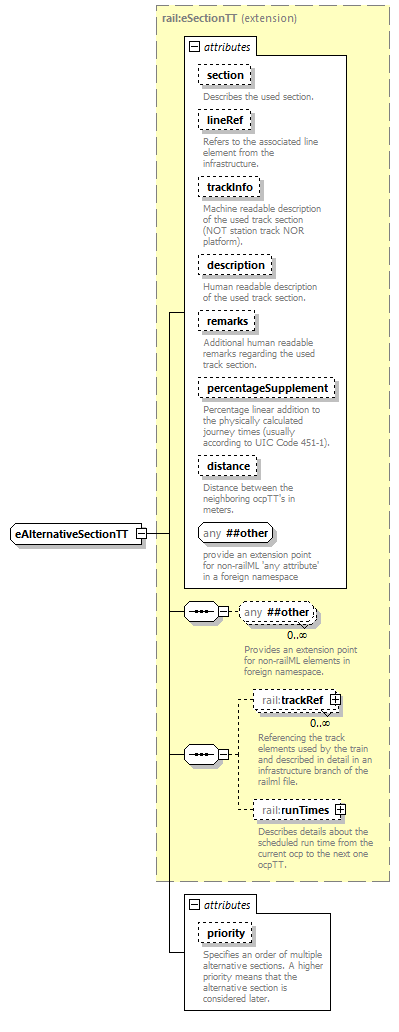 | ||||||||||||||||||||||||||||||||||||||||||||||||||||||||||||||||||||||
| namespace | https://www.railml.org/schemas/2021 | ||||||||||||||||||||||||||||||||||||||||||||||||||||||||||||||||||||||
| type | extension of rail:eSectionTT | ||||||||||||||||||||||||||||||||||||||||||||||||||||||||||||||||||||||
| properties |
| ||||||||||||||||||||||||||||||||||||||||||||||||||||||||||||||||||||||
| children | rail:trackRef rail:runTimes | ||||||||||||||||||||||||||||||||||||||||||||||||||||||||||||||||||||||
| used by |
| ||||||||||||||||||||||||||||||||||||||||||||||||||||||||||||||||||||||
| attributes |
| ||||||||||||||||||||||||||||||||||||||||||||||||||||||||||||||||||||||
| source | <xs:complexType name="eAlternativeSectionTT"> <xs:complexContent> <xs:extension base="rail:eSectionTT"> <xs:attribute name="priority" type="xs:integer"> <xs:annotation> <xs:documentation>Specifies an order of multiple alternative sections. A higher priority means that the alternative section is considered later.</xs:documentation> </xs:annotation> </xs:attribute> </xs:extension> </xs:complexContent> </xs:complexType> |
attribute eAlternativeSectionTT/@priority
| type | xs:integer | ||
| annotation |
| ||
| source | <xs:attribute name="priority" type="xs:integer"> <xs:annotation> <xs:documentation>Specifies an order of multiple alternative sections. A higher priority means that the alternative section is considered later.</xs:documentation> </xs:annotation> </xs:attribute> |
complexType eAnnotation
| diagram |  | ||||||||||||||||||||||||||||||||||||||||||||||||||||||
| namespace | https://www.railml.org/schemas/2021 | ||||||||||||||||||||||||||||||||||||||||||||||||||||||
| type | extension of rail:tAnnotation | ||||||||||||||||||||||||||||||||||||||||||||||||||||||
| properties |
| ||||||||||||||||||||||||||||||||||||||||||||||||||||||
| children | rail:additionalName rail:mediaCategories rail:text | ||||||||||||||||||||||||||||||||||||||||||||||||||||||
| used by |
| ||||||||||||||||||||||||||||||||||||||||||||||||||||||
| attributes |
| ||||||||||||||||||||||||||||||||||||||||||||||||||||||
| source | <xs:complexType name="eAnnotation"> <xs:complexContent> <xs:extension base="rail:tAnnotation"> <xs:sequence> <xs:element name="mediaCategories" type="rail:tMediaCategories" minOccurs="0"> <xs:annotation> <xs:documentation>Allows specification of one or more media categories for this annotation (e.g. Cancellation message, Delay reason, Formation change).</xs:documentation> <xs:documentation>See https://wiki2.railml.org/wiki/TT:mediaCategories</xs:documentation> </xs:annotation> </xs:element> <xs:element name="text" type="rail:tInfoText" minOccurs="0" maxOccurs="unbounded"> <xs:annotation> <xs:documentation>Contains texts and messages dedicated for a passenger information system.</xs:documentation> <xs:documentation>See https://wiki2.railml.org/wiki/TT:text</xs:documentation> </xs:annotation> </xs:element> </xs:sequence> </xs:extension> </xs:complexContent> </xs:complexType> |
element eAnnotation/mediaCategories
| diagram |  | ||||||
| namespace | https://www.railml.org/schemas/2021 | ||||||
| type | rail:tMediaCategories | ||||||
| properties |
| ||||||
| children | rail:mediaCategory | ||||||
| annotation |
| ||||||
| source | <xs:element name="mediaCategories" type="rail:tMediaCategories" minOccurs="0"> <xs:annotation> <xs:documentation>Allows specification of one or more media categories for this annotation (e.g. Cancellation message, Delay reason, Formation change).</xs:documentation> <xs:documentation>See https://wiki2.railml.org/wiki/TT:mediaCategories</xs:documentation> </xs:annotation> </xs:element> |
element eAnnotation/text
| diagram | 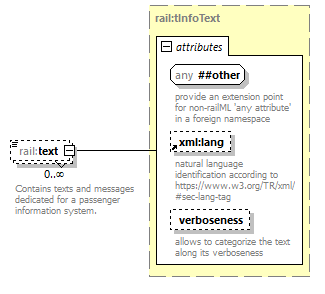 | ||||||||||||||||||||||
| namespace | https://www.railml.org/schemas/2021 | ||||||||||||||||||||||
| type | rail:tInfoText | ||||||||||||||||||||||
| properties |
| ||||||||||||||||||||||
| attributes |
| ||||||||||||||||||||||
| annotation |
| ||||||||||||||||||||||
| source | <xs:element name="text" type="rail:tInfoText" minOccurs="0" maxOccurs="unbounded"> <xs:annotation> <xs:documentation>Contains texts and messages dedicated for a passenger information system.</xs:documentation> <xs:documentation>See https://wiki2.railml.org/wiki/TT:text</xs:documentation> </xs:annotation> </xs:element> |
complexType eAnnotations
| diagram | 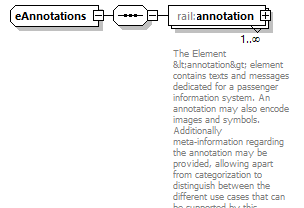 | ||
| namespace | https://www.railml.org/schemas/2021 | ||
| children | rail:annotation | ||
| used by |
| ||
| source | <xs:complexType name="eAnnotations"> <xs:sequence> <xs:element name="annotation" type="rail:eAnnotation" maxOccurs="unbounded"> <xs:annotation> <xs:documentation>The Element <annotation> element contains texts and messages dedicated for a passenger information system. An annotation may also encode images and symbols. Additionally meta-information regarding the annotation may be provided, allowing apart from categorization to distinguish between the different use cases that can be supported by this element.</xs:documentation> <xs:documentation>See https://wiki2.railml.org/wiki/TT:annotation</xs:documentation> </xs:annotation> </xs:element> </xs:sequence> </xs:complexType> |
element eAnnotations/annotation
| diagram |  | ||||||||||||||||||||||||||||||||||||||||||||||||||||||
| namespace | https://www.railml.org/schemas/2021 | ||||||||||||||||||||||||||||||||||||||||||||||||||||||
| type | rail:eAnnotation | ||||||||||||||||||||||||||||||||||||||||||||||||||||||
| properties |
| ||||||||||||||||||||||||||||||||||||||||||||||||||||||
| children | rail:additionalName rail:mediaCategories rail:text | ||||||||||||||||||||||||||||||||||||||||||||||||||||||
| attributes |
| ||||||||||||||||||||||||||||||||||||||||||||||||||||||
| annotation |
| ||||||||||||||||||||||||||||||||||||||||||||||||||||||
| source | <xs:element name="annotation" type="rail:eAnnotation" maxOccurs="unbounded"> <xs:annotation> <xs:documentation>The Element <annotation> element contains texts and messages dedicated for a passenger information system. An annotation may also encode images and symbols. Additionally meta-information regarding the annotation may be provided, allowing apart from categorization to distinguish between the different use cases that can be supported by this element.</xs:documentation> <xs:documentation>See https://wiki2.railml.org/wiki/TT:annotation</xs:documentation> </xs:annotation> </xs:element> |
complexType eAnnouncement
| diagram |  | ||||||||||||||||||||||||||||||||||||||||||||||
| namespace | https://www.railml.org/schemas/2021 | ||||||||||||||||||||||||||||||||||||||||||||||
| type | extension of rail:tAnnouncement | ||||||||||||||||||||||||||||||||||||||||||||||
| properties |
| ||||||||||||||||||||||||||||||||||||||||||||||
| children | rail:additionalName rail:mediaCategories | ||||||||||||||||||||||||||||||||||||||||||||||
| used by |
| ||||||||||||||||||||||||||||||||||||||||||||||
| attributes |
| ||||||||||||||||||||||||||||||||||||||||||||||
| source | <xs:complexType name="eAnnouncement"> <xs:complexContent> <xs:extension base="rail:tAnnouncement"> <xs:sequence> <xs:element name="mediaCategories" type="rail:tMediaCategories" minOccurs="0"> <xs:annotation> <xs:documentation>Allows specification of one or more media categories for this announcement (e.g. Cancellation message, Delay reason, Formation change).</xs:documentation> <xs:documentation>See https://wiki2.railml.org/wiki/TT:mediaCategories</xs:documentation> </xs:annotation> </xs:element> </xs:sequence> </xs:extension> </xs:complexContent> </xs:complexType> |
element eAnnouncement/mediaCategories
| diagram |  | ||||||
| namespace | https://www.railml.org/schemas/2021 | ||||||
| type | rail:tMediaCategories | ||||||
| properties |
| ||||||
| children | rail:mediaCategory | ||||||
| annotation |
| ||||||
| source | <xs:element name="mediaCategories" type="rail:tMediaCategories" minOccurs="0"> <xs:annotation> <xs:documentation>Allows specification of one or more media categories for this announcement (e.g. Cancellation message, Delay reason, Formation change).</xs:documentation> <xs:documentation>See https://wiki2.railml.org/wiki/TT:mediaCategories</xs:documentation> </xs:annotation> </xs:element> |
complexType eAnnouncements
| diagram |  | ||
| namespace | https://www.railml.org/schemas/2021 | ||
| children | rail:announcement | ||
| used by |
| ||
| source | <xs:complexType name="eAnnouncements"> <xs:sequence> <xs:element name="announcement" type="rail:eAnnouncement" maxOccurs="unbounded"> <xs:annotation> <xs:documentation>With this element it is possible to define announcements for passenger information systems that are used by the timetable. Several elements of the timetable allow references to announcements to indicate that a particular announcement is to be played when a certain event is triggered (arrival, departure, etc.).</xs:documentation> <xs:documentation>See https://wiki2.railml.org/wiki/TT:announcement</xs:documentation> </xs:annotation> </xs:element> </xs:sequence> </xs:complexType> |
element eAnnouncements/announcement
| diagram | 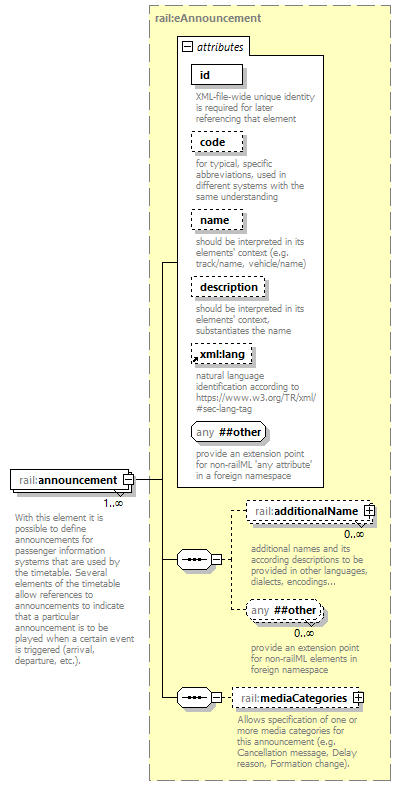 | ||||||||||||||||||||||||||||||||||||||||||||||
| namespace | https://www.railml.org/schemas/2021 | ||||||||||||||||||||||||||||||||||||||||||||||
| type | rail:eAnnouncement | ||||||||||||||||||||||||||||||||||||||||||||||
| properties |
| ||||||||||||||||||||||||||||||||||||||||||||||
| children | rail:additionalName rail:mediaCategories | ||||||||||||||||||||||||||||||||||||||||||||||
| attributes |
| ||||||||||||||||||||||||||||||||||||||||||||||
| annotation |
| ||||||||||||||||||||||||||||||||||||||||||||||
| source | <xs:element name="announcement" type="rail:eAnnouncement" maxOccurs="unbounded"> <xs:annotation> <xs:documentation>With this element it is possible to define announcements for passenger information systems that are used by the timetable. Several elements of the timetable allow references to announcements to indicate that a particular announcement is to be played when a certain event is triggered (arrival, departure, etc.).</xs:documentation> <xs:documentation>See https://wiki2.railml.org/wiki/TT:announcement</xs:documentation> </xs:annotation> </xs:element> |
complexType eArrivalDepartureTimes
| diagram |  | ||||||||||||||||||||||||||||||||||||||||||||||||||||||
| namespace | https://www.railml.org/schemas/2021 | ||||||||||||||||||||||||||||||||||||||||||||||||||||||
| type | extension of rail:tArrivalDepartureTimes | ||||||||||||||||||||||||||||||||||||||||||||||||||||||
| properties |
| ||||||||||||||||||||||||||||||||||||||||||||||||||||||
| used by |
| ||||||||||||||||||||||||||||||||||||||||||||||||||||||
| attributes |
| ||||||||||||||||||||||||||||||||||||||||||||||||||||||
| source | <xs:complexType name="eArrivalDepartureTimes"> <xs:complexContent> <xs:extension base="rail:tArrivalDepartureTimes"/> </xs:complexContent> </xs:complexType> |
complexType eBlock
| diagram |  | ||||||||||||||||||||||||||||||||||||||||||||||||||||||||||
| namespace | https://www.railml.org/schemas/2021 | ||||||||||||||||||||||||||||||||||||||||||||||||||||||||||
| type | extension of rail:tBlock | ||||||||||||||||||||||||||||||||||||||||||||||||||||||||||
| properties |
| ||||||||||||||||||||||||||||||||||||||||||||||||||||||||||
| children | rail:additionalName rail:blockPartSequence | ||||||||||||||||||||||||||||||||||||||||||||||||||||||||||
| used by |
| ||||||||||||||||||||||||||||||||||||||||||||||||||||||||||
| attributes |
| ||||||||||||||||||||||||||||||||||||||||||||||||||||||||||
| source | <xs:complexType name="eBlock"> <xs:complexContent> <xs:extension base="rail:tBlock"> <xs:sequence> <xs:element name="blockPartSequence" type="rail:eBlockPartSequence" maxOccurs="unbounded"> <xs:annotation> <xs:documentation>Groups the referenced blockParts into a sequence of tasks.</xs:documentation> <xs:documentation>See https://wiki2.railml.org/wiki/TT:blockPartSequence</xs:documentation> </xs:annotation> </xs:element> </xs:sequence> </xs:extension> </xs:complexContent> </xs:complexType> |
element eBlock/blockPartSequence
| diagram |  | ||||||||||||||||||||||||||||||||||||||||||||||
| namespace | https://www.railml.org/schemas/2021 | ||||||||||||||||||||||||||||||||||||||||||||||
| type | rail:eBlockPartSequence | ||||||||||||||||||||||||||||||||||||||||||||||
| properties |
| ||||||||||||||||||||||||||||||||||||||||||||||
| children | rail:blockPartRef | ||||||||||||||||||||||||||||||||||||||||||||||
| attributes |
| ||||||||||||||||||||||||||||||||||||||||||||||
| annotation |
| ||||||||||||||||||||||||||||||||||||||||||||||
| source | <xs:element name="blockPartSequence" type="rail:eBlockPartSequence" maxOccurs="unbounded"> <xs:annotation> <xs:documentation>Groups the referenced blockParts into a sequence of tasks.</xs:documentation> <xs:documentation>See https://wiki2.railml.org/wiki/TT:blockPartSequence</xs:documentation> </xs:annotation> </xs:element> |
complexType eBlockParts
| diagram |  | ||
| namespace | https://www.railml.org/schemas/2021 | ||
| children | rail:blockPart | ||
| used by |
| ||
| source | <xs:complexType name="eBlockParts"> <xs:sequence> <xs:element name="blockPart" type="rail:tBlockPart" maxOccurs="unbounded"> <xs:annotation> <xs:documentation>Contains all data, which is related to an atomic particle of a block.</xs:documentation> <xs:documentation>See https://wiki2.railml.org/wiki/TT:blockPart</xs:documentation> </xs:annotation> </xs:element> <xs:any namespace="##other" processContents="strict" minOccurs="0" maxOccurs="unbounded"> <xs:annotation> <xs:documentation>DEPRECATED: The blockParts element is only the container for blockPart and shall not be extended.</xs:documentation> </xs:annotation> </xs:any> </xs:sequence> </xs:complexType> |
element eBlockParts/blockPart
| diagram |  | ||||||||||||||||||||||||||||||||||||||||||||||||||||||||||||||||||||||||||||||||||||||||||||||||||||||||||||||||||||||||||||||||||||||||||||||||||||||
| namespace | https://www.railml.org/schemas/2021 | ||||||||||||||||||||||||||||||||||||||||||||||||||||||||||||||||||||||||||||||||||||||||||||||||||||||||||||||||||||||||||||||||||||||||||||||||||||||
| type | rail:tBlockPart | ||||||||||||||||||||||||||||||||||||||||||||||||||||||||||||||||||||||||||||||||||||||||||||||||||||||||||||||||||||||||||||||||||||||||||||||||||||||
| properties |
| ||||||||||||||||||||||||||||||||||||||||||||||||||||||||||||||||||||||||||||||||||||||||||||||||||||||||||||||||||||||||||||||||||||||||||||||||||||||
| children | rail:additionalName | ||||||||||||||||||||||||||||||||||||||||||||||||||||||||||||||||||||||||||||||||||||||||||||||||||||||||||||||||||||||||||||||||||||||||||||||||||||||
| attributes |
| ||||||||||||||||||||||||||||||||||||||||||||||||||||||||||||||||||||||||||||||||||||||||||||||||||||||||||||||||||||||||||||||||||||||||||||||||||||||
| annotation |
| ||||||||||||||||||||||||||||||||||||||||||||||||||||||||||||||||||||||||||||||||||||||||||||||||||||||||||||||||||||||||||||||||||||||||||||||||||||||
| source | <xs:element name="blockPart" type="rail:tBlockPart" maxOccurs="unbounded"> <xs:annotation> <xs:documentation>Contains all data, which is related to an atomic particle of a block.</xs:documentation> <xs:documentation>See https://wiki2.railml.org/wiki/TT:blockPart</xs:documentation> </xs:annotation> </xs:element> |
complexType eBlockPartSequence
| diagram |  | ||||||||||||||||||||||||||||||||||||||||||||||
| namespace | https://www.railml.org/schemas/2021 | ||||||||||||||||||||||||||||||||||||||||||||||
| type | extension of rail:tBlockPartSequence | ||||||||||||||||||||||||||||||||||||||||||||||
| properties |
| ||||||||||||||||||||||||||||||||||||||||||||||
| children | rail:blockPartRef | ||||||||||||||||||||||||||||||||||||||||||||||
| used by |
| ||||||||||||||||||||||||||||||||||||||||||||||
| attributes |
| ||||||||||||||||||||||||||||||||||||||||||||||
| source | <xs:complexType name="eBlockPartSequence"> <xs:complexContent> <xs:extension base="rail:tBlockPartSequence"> <xs:sequence> <xs:element name="blockPartRef" type="rail:tBlockPartRef" maxOccurs="unbounded"> <xs:annotation> <xs:documentation>Refers to blockParts for building sequences of tasks.</xs:documentation> <xs:documentation>See https://wiki2.railml.org/wiki/TT:blockPartRef</xs:documentation> </xs:annotation> </xs:element> </xs:sequence> </xs:extension> </xs:complexContent> </xs:complexType> |
element eBlockPartSequence/blockPartRef
| diagram |  | ||||||||||||||
| namespace | https://www.railml.org/schemas/2021 | ||||||||||||||
| type | rail:tBlockPartRef | ||||||||||||||
| properties |
| ||||||||||||||
| attributes |
| ||||||||||||||
| annotation |
| ||||||||||||||
| source | <xs:element name="blockPartRef" type="rail:tBlockPartRef" maxOccurs="unbounded"> <xs:annotation> <xs:documentation>Refers to blockParts for building sequences of tasks.</xs:documentation> <xs:documentation>See https://wiki2.railml.org/wiki/TT:blockPartRef</xs:documentation> </xs:annotation> </xs:element> |
complexType eBlocks
| diagram |  | ||
| namespace | https://www.railml.org/schemas/2021 | ||
| children | rail:block | ||
| used by |
| ||
| source | <xs:complexType name="eBlocks"> <xs:sequence> <xs:element name="block" type="rail:eBlock" maxOccurs="unbounded"> <xs:annotation> <xs:documentation>Contains all data related to a "vehicle duty" containing a sequence of atomic tasks (blockParts). </xs:documentation> <xs:documentation>See https://wiki2.railml.org/wiki/TT:block</xs:documentation> </xs:annotation> </xs:element> </xs:sequence> </xs:complexType> |
element eBlocks/block
| diagram |  | ||||||||||||||||||||||||||||||||||||||||||||||||||||||||||
| namespace | https://www.railml.org/schemas/2021 | ||||||||||||||||||||||||||||||||||||||||||||||||||||||||||
| type | rail:eBlock | ||||||||||||||||||||||||||||||||||||||||||||||||||||||||||
| properties |
| ||||||||||||||||||||||||||||||||||||||||||||||||||||||||||
| children | rail:additionalName rail:blockPartSequence | ||||||||||||||||||||||||||||||||||||||||||||||||||||||||||
| attributes |
| ||||||||||||||||||||||||||||||||||||||||||||||||||||||||||
| annotation |
| ||||||||||||||||||||||||||||||||||||||||||||||||||||||||||
| source | <xs:element name="block" type="rail:eBlock" maxOccurs="unbounded"> <xs:annotation> <xs:documentation>Contains all data related to a "vehicle duty" containing a sequence of atomic tasks (blockParts). </xs:documentation> <xs:documentation>See https://wiki2.railml.org/wiki/TT:block</xs:documentation> </xs:annotation> </xs:element> |
complexType eBrakeUsage
| diagram |  | ||||||||||||||||||||||||||||||||||||||||||||||||||||||||||||||||||||||||||||||
| namespace | https://www.railml.org/schemas/2021 | ||||||||||||||||||||||||||||||||||||||||||||||||||||||||||||||||||||||||||||||
| type | extension of rail:tBasicBrakeType | ||||||||||||||||||||||||||||||||||||||||||||||||||||||||||||||||||||||||||||||
| properties |
| ||||||||||||||||||||||||||||||||||||||||||||||||||||||||||||||||||||||||||||||
| children | rail:auxiliaryBrakes | ||||||||||||||||||||||||||||||||||||||||||||||||||||||||||||||||||||||||||||||
| used by |
| ||||||||||||||||||||||||||||||||||||||||||||||||||||||||||||||||||||||||||||||
| attributes |
| ||||||||||||||||||||||||||||||||||||||||||||||||||||||||||||||||||||||||||||||
| source | <xs:complexType name="eBrakeUsage"> <xs:complexContent> <xs:extension base="rail:tBasicBrakeType"> <xs:sequence> <xs:any namespace="##other" processContents="strict" minOccurs="0" maxOccurs="unbounded"> <xs:annotation> <xs:documentation>Provides an extension point for non-railML elements in foreign namespace.</xs:documentation> </xs:annotation> </xs:any> </xs:sequence> <xs:attributeGroup ref="rail:aBrakeUsage"/> </xs:extension> </xs:complexContent> </xs:complexType> |
complexType eCategories
| diagram |  | ||
| namespace | https://www.railml.org/schemas/2021 | ||
| children | rail:category | ||
| used by |
| ||
| source | <xs:complexType name="eCategories"> <xs:sequence> <xs:element name="category" type="rail:eCategory" maxOccurs="unbounded"> <xs:annotation> <xs:documentation>Describes a "train type" or "train category" freely defined by the operator, e.g. "EC" for "EuroCity".</xs:documentation> <xs:documentation>See https://wiki2.railml.org/wiki/TT:category</xs:documentation> </xs:annotation> </xs:element> </xs:sequence> </xs:complexType> |
element eCategories/category
| diagram |  | ||||||||||||||||||||||||||||||||||||||||||||||||||||||||||||||||||||||||||||||||||||||||
| namespace | https://www.railml.org/schemas/2021 | ||||||||||||||||||||||||||||||||||||||||||||||||||||||||||||||||||||||||||||||||||||||||
| type | rail:eCategory | ||||||||||||||||||||||||||||||||||||||||||||||||||||||||||||||||||||||||||||||||||||||||
| properties |
| ||||||||||||||||||||||||||||||||||||||||||||||||||||||||||||||||||||||||||||||||||||||||
| children | rail:additionalName | ||||||||||||||||||||||||||||||||||||||||||||||||||||||||||||||||||||||||||||||||||||||||
| attributes |
| ||||||||||||||||||||||||||||||||||||||||||||||||||||||||||||||||||||||||||||||||||||||||
| annotation |
| ||||||||||||||||||||||||||||||||||||||||||||||||||||||||||||||||||||||||||||||||||||||||
| source | <xs:element name="category" type="rail:eCategory" maxOccurs="unbounded"> <xs:annotation> <xs:documentation>Describes a "train type" or "train category" freely defined by the operator, e.g. "EC" for "EuroCity".</xs:documentation> <xs:documentation>See https://wiki2.railml.org/wiki/TT:category</xs:documentation> </xs:annotation> </xs:element> |
complexType eCategory
| diagram |  | ||||||||||||||||||||||||||||||||||||||||||||||||||||||||||||||||||||||||||||||||||||||||
| namespace | https://www.railml.org/schemas/2021 | ||||||||||||||||||||||||||||||||||||||||||||||||||||||||||||||||||||||||||||||||||||||||
| type | extension of rail:tCategory | ||||||||||||||||||||||||||||||||||||||||||||||||||||||||||||||||||||||||||||||||||||||||
| properties |
| ||||||||||||||||||||||||||||||||||||||||||||||||||||||||||||||||||||||||||||||||||||||||
| children | rail:additionalName | ||||||||||||||||||||||||||||||||||||||||||||||||||||||||||||||||||||||||||||||||||||||||
| used by |
| ||||||||||||||||||||||||||||||||||||||||||||||||||||||||||||||||||||||||||||||||||||||||
| attributes |
| ||||||||||||||||||||||||||||||||||||||||||||||||||||||||||||||||||||||||||||||||||||||||
| source | <xs:complexType name="eCategory"> <xs:complexContent> <xs:extension base="rail:tCategory"/> </xs:complexContent> </xs:complexType> |
complexType eCirculations
| diagram |  | ||
| namespace | https://www.railml.org/schemas/2021 | ||
| children | rail:circulation | ||
| used by |
| ||
| source | <xs:complexType name="eCirculations"> <xs:sequence> <xs:element name="circulation" type="rail:tCirculation" maxOccurs="unbounded"> <xs:annotation> <xs:documentation>Chains the blocks into a complete rostering.</xs:documentation> <xs:documentation>See https://wiki2.railml.org/wiki/TT:circulation</xs:documentation> </xs:annotation> </xs:element> </xs:sequence> </xs:complexType> |
element eCirculations/circulation
| diagram | 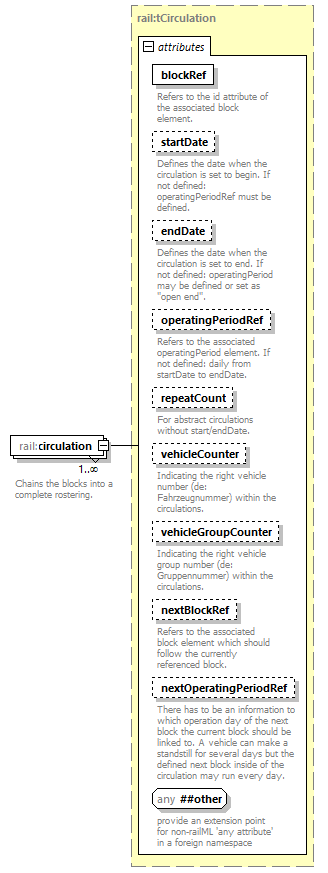 | ||||||||||||||||||||||||||||||||||||||||||||||||||||||||||||||||||||||||||||||
| namespace | https://www.railml.org/schemas/2021 | ||||||||||||||||||||||||||||||||||||||||||||||||||||||||||||||||||||||||||||||
| type | rail:tCirculation | ||||||||||||||||||||||||||||||||||||||||||||||||||||||||||||||||||||||||||||||
| properties |
| ||||||||||||||||||||||||||||||||||||||||||||||||||||||||||||||||||||||||||||||
| attributes |
| ||||||||||||||||||||||||||||||||||||||||||||||||||||||||||||||||||||||||||||||
| annotation |
| ||||||||||||||||||||||||||||||||||||||||||||||||||||||||||||||||||||||||||||||
| source | <xs:element name="circulation" type="rail:tCirculation" maxOccurs="unbounded"> <xs:annotation> <xs:documentation>Chains the blocks into a complete rostering.</xs:documentation> <xs:documentation>See https://wiki2.railml.org/wiki/TT:circulation</xs:documentation> </xs:annotation> </xs:element> |
complexType eConnectionsTT
| diagram |  | ||
| namespace | https://www.railml.org/schemas/2021 | ||
| children | rail:connection | ||
| used by |
| ||
| source | <xs:complexType name="eConnectionsTT"> <xs:sequence> <xs:element name="connection" type="rail:eConnectionTT" minOccurs="0" maxOccurs="unbounded"> <xs:annotation> <xs:documentation>Describes connections between this train and another one.</xs:documentation> <xs:documentation>See https://wiki2.railml.org/wiki/TT:connection</xs:documentation> </xs:annotation> </xs:element> </xs:sequence> </xs:complexType> |
element eConnectionsTT/connection
| diagram |  | ||||||||||||||||||||||||||||||||||||||||||||||||||||||||||||||||||||||||||||||||||||||||||||||||||
| namespace | https://www.railml.org/schemas/2021 | ||||||||||||||||||||||||||||||||||||||||||||||||||||||||||||||||||||||||||||||||||||||||||||||||||
| type | rail:eConnectionTT | ||||||||||||||||||||||||||||||||||||||||||||||||||||||||||||||||||||||||||||||||||||||||||||||||||
| properties |
| ||||||||||||||||||||||||||||||||||||||||||||||||||||||||||||||||||||||||||||||||||||||||||||||||||
| children | rail:externalReference rail:annotationRef rail:announcementRef | ||||||||||||||||||||||||||||||||||||||||||||||||||||||||||||||||||||||||||||||||||||||||||||||||||
| attributes |
| ||||||||||||||||||||||||||||||||||||||||||||||||||||||||||||||||||||||||||||||||||||||||||||||||||
| annotation |
| ||||||||||||||||||||||||||||||||||||||||||||||||||||||||||||||||||||||||||||||||||||||||||||||||||
| source | <xs:element name="connection" type="rail:eConnectionTT" minOccurs="0" maxOccurs="unbounded"> <xs:annotation> <xs:documentation>Describes connections between this train and another one.</xs:documentation> <xs:documentation>See https://wiki2.railml.org/wiki/TT:connection</xs:documentation> </xs:annotation> </xs:element> |
complexType eConnectionTT
| diagram |  | ||||||||||||||||||||||||||||||||||||||||||||||||||||||||||||||||||||||||||||||||||||||||||||||||||
| namespace | https://www.railml.org/schemas/2021 | ||||||||||||||||||||||||||||||||||||||||||||||||||||||||||||||||||||||||||||||||||||||||||||||||||
| type | extension of rail:tConnectionTT | ||||||||||||||||||||||||||||||||||||||||||||||||||||||||||||||||||||||||||||||||||||||||||||||||||
| properties |
| ||||||||||||||||||||||||||||||||||||||||||||||||||||||||||||||||||||||||||||||||||||||||||||||||||
| children | rail:externalReference rail:annotationRef rail:announcementRef | ||||||||||||||||||||||||||||||||||||||||||||||||||||||||||||||||||||||||||||||||||||||||||||||||||
| used by |
| ||||||||||||||||||||||||||||||||||||||||||||||||||||||||||||||||||||||||||||||||||||||||||||||||||
| attributes |
| ||||||||||||||||||||||||||||||||||||||||||||||||||||||||||||||||||||||||||||||||||||||||||||||||||
| source | <xs:complexType name="eConnectionTT"> <xs:complexContent> <xs:extension base="rail:tConnectionTT"> <xs:sequence> <xs:element name="externalReference" type="rail:eExternalReference" minOccurs="0"> <xs:annotation> <xs:documentation>Groups elements used to describe a train external to the railML document in order to specify a connection to that train.</xs:documentation> <xs:documentation>See https://wiki2.railml.org/wiki/TT:externalReference</xs:documentation> </xs:annotation> </xs:element> <xs:element name="annotationRef" type="rail:tAnnotationRef" minOccurs="0" maxOccurs="unbounded"> <xs:annotation> <xs:documentation>Refers to id attributes of annotation elements. Used to specify connection specific passenger information.</xs:documentation> <xs:documentation>See https://wiki2.railml.org/wiki/TT:annotationRef_connection</xs:documentation> </xs:annotation> </xs:element> <xs:element name="announcementRef" type="rail:tAnnouncementRef" minOccurs="0" maxOccurs="unbounded"> <xs:annotation> <xs:documentation>Refers to id attributes of announcement elements. Used to specify connection specific accoustic passenger information.</xs:documentation> <xs:documentation>See https://wiki2.railml.org/wiki/TT:announcementRef_connection</xs:documentation> </xs:annotation> </xs:element> </xs:sequence> </xs:extension> </xs:complexContent> </xs:complexType> |
element eConnectionTT/externalReference
| diagram |  | ||||||
| namespace | https://www.railml.org/schemas/2021 | ||||||
| type | rail:eExternalReference | ||||||
| properties |
| ||||||
| children | rail:tafTapTsiTrainID rail:trainNumber rail:lineNumber rail:information | ||||||
| annotation |
| ||||||
| source | <xs:element name="externalReference" type="rail:eExternalReference" minOccurs="0"> <xs:annotation> <xs:documentation>Groups elements used to describe a train external to the railML document in order to specify a connection to that train.</xs:documentation> <xs:documentation>See https://wiki2.railml.org/wiki/TT:externalReference</xs:documentation> </xs:annotation> </xs:element> |
element eConnectionTT/annotationRef
| diagram | 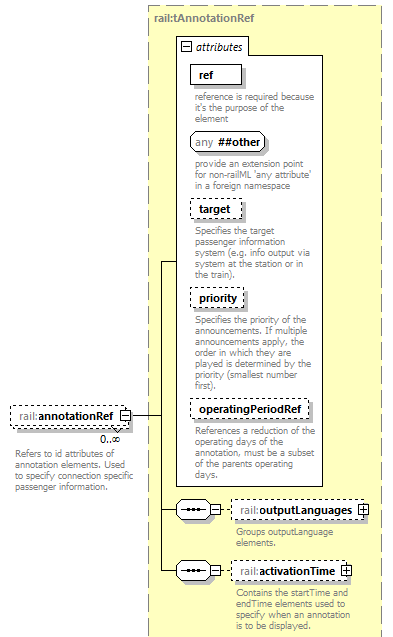 | ||||||||||||||||||||||||||||||||||||||
| namespace | https://www.railml.org/schemas/2021 | ||||||||||||||||||||||||||||||||||||||
| type | rail:tAnnotationRef | ||||||||||||||||||||||||||||||||||||||
| properties |
| ||||||||||||||||||||||||||||||||||||||
| children | rail:outputLanguages rail:activationTime | ||||||||||||||||||||||||||||||||||||||
| attributes |
| ||||||||||||||||||||||||||||||||||||||
| annotation |
| ||||||||||||||||||||||||||||||||||||||
| source | <xs:element name="annotationRef" type="rail:tAnnotationRef" minOccurs="0" maxOccurs="unbounded"> <xs:annotation> <xs:documentation>Refers to id attributes of annotation elements. Used to specify connection specific passenger information.</xs:documentation> <xs:documentation>See https://wiki2.railml.org/wiki/TT:annotationRef_connection</xs:documentation> </xs:annotation> </xs:element> |
element eConnectionTT/announcementRef
| diagram |  | ||||||||||||||||||||||||||||||||||||||
| namespace | https://www.railml.org/schemas/2021 | ||||||||||||||||||||||||||||||||||||||
| type | rail:tAnnouncementRef | ||||||||||||||||||||||||||||||||||||||
| properties |
| ||||||||||||||||||||||||||||||||||||||
| children | rail:outputLanguages rail:trigger rail:periodic | ||||||||||||||||||||||||||||||||||||||
| attributes |
| ||||||||||||||||||||||||||||||||||||||
| annotation |
| ||||||||||||||||||||||||||||||||||||||
| source | <xs:element name="announcementRef" type="rail:tAnnouncementRef" minOccurs="0" maxOccurs="unbounded"> <xs:annotation> <xs:documentation>Refers to id attributes of announcement elements. Used to specify connection specific accoustic passenger information.</xs:documentation> <xs:documentation>See https://wiki2.railml.org/wiki/TT:announcementRef_connection</xs:documentation> </xs:annotation> </xs:element> |
complexType eDistribution
| diagram |  | ||||||||||||||||||||||||||||||||||||||||||||||
| namespace | https://www.railml.org/schemas/2021 | ||||||||||||||||||||||||||||||||||||||||||||||
| type | extension of rail:tElementWithIDAndName | ||||||||||||||||||||||||||||||||||||||||||||||
| properties |
| ||||||||||||||||||||||||||||||||||||||||||||||
| children | rail:additionalName rail:referenceOcp rail:slotGroup | ||||||||||||||||||||||||||||||||||||||||||||||
| used by |
| ||||||||||||||||||||||||||||||||||||||||||||||
| attributes |
| ||||||||||||||||||||||||||||||||||||||||||||||
| annotation |
| ||||||||||||||||||||||||||||||||||||||||||||||
| source | <xs:complexType name="eDistribution"> <xs:annotation> <xs:documentation>Allows listing the number of trains in different time slots, without exact times for the trains.</xs:documentation> </xs:annotation> <xs:complexContent> <xs:extension base="rail:tElementWithIDAndName"> <xs:sequence> <xs:element name="referenceOcp" type="rail:tReferenceOcp" minOccurs="0"> <xs:annotation> <xs:documentation>Specifies the OCP for which the times slots are valid.</xs:documentation> <xs:documentation>See https://wiki2.railml.org/wiki/TT:referenceOcp</xs:documentation> </xs:annotation> </xs:element> <xs:element name="slotGroup" type="rail:eSlotGroup" maxOccurs="unbounded"> <xs:annotation> <xs:documentation>One or more slot groups, each containing one or more time slots that belong to a common interval pattern.</xs:documentation> <xs:documentation>See https://wiki2.railml.org/wiki/TT:slotGroup</xs:documentation> </xs:annotation> </xs:element> </xs:sequence> </xs:extension> </xs:complexContent> </xs:complexType> |
element eDistribution/referenceOcp
| diagram |  | ||||||||||||||||||||||
| namespace | https://www.railml.org/schemas/2021 | ||||||||||||||||||||||
| type | rail:tReferenceOcp | ||||||||||||||||||||||
| properties |
| ||||||||||||||||||||||
| attributes |
| ||||||||||||||||||||||
| annotation |
| ||||||||||||||||||||||
| source | <xs:element name="referenceOcp" type="rail:tReferenceOcp" minOccurs="0"> <xs:annotation> <xs:documentation>Specifies the OCP for which the times slots are valid.</xs:documentation> <xs:documentation>See https://wiki2.railml.org/wiki/TT:referenceOcp</xs:documentation> </xs:annotation> </xs:element> |
element eDistribution/slotGroup
| diagram |  | ||||||
| namespace | https://www.railml.org/schemas/2021 | ||||||
| type | rail:eSlotGroup | ||||||
| properties |
| ||||||
| children | rail:slot | ||||||
| annotation |
| ||||||
| source | <xs:element name="slotGroup" type="rail:eSlotGroup" maxOccurs="unbounded"> <xs:annotation> <xs:documentation>One or more slot groups, each containing one or more time slots that belong to a common interval pattern.</xs:documentation> <xs:documentation>See https://wiki2.railml.org/wiki/TT:slotGroup</xs:documentation> </xs:annotation> </xs:element> |
complexType eDistributions
| diagram |  | ||
| namespace | https://www.railml.org/schemas/2021 | ||
| children | rail:distribution | ||
| used by |
| ||
| annotation |
| ||
| source | <xs:complexType name="eDistributions"> <xs:annotation> <xs:documentation>Container for one or more distribution elements.</xs:documentation> </xs:annotation> <xs:sequence> <xs:element name="distribution" type="rail:eDistribution" maxOccurs="unbounded"> <xs:annotation> <xs:documentation>Lists how trains are distributed in time.</xs:documentation> <xs:documentation>See https://wiki2.railml.org/wiki/TT:distribution</xs:documentation> </xs:annotation> </xs:element> </xs:sequence> </xs:complexType> |
element eDistributions/distribution
| diagram |  | ||||||||||||||||||||||||||||||||||||||||||||||
| namespace | https://www.railml.org/schemas/2021 | ||||||||||||||||||||||||||||||||||||||||||||||
| type | rail:eDistribution | ||||||||||||||||||||||||||||||||||||||||||||||
| properties |
| ||||||||||||||||||||||||||||||||||||||||||||||
| children | rail:additionalName rail:referenceOcp rail:slotGroup | ||||||||||||||||||||||||||||||||||||||||||||||
| attributes |
| ||||||||||||||||||||||||||||||||||||||||||||||
| annotation |
| ||||||||||||||||||||||||||||||||||||||||||||||
| source | <xs:element name="distribution" type="rail:eDistribution" maxOccurs="unbounded"> <xs:annotation> <xs:documentation>Lists how trains are distributed in time.</xs:documentation> <xs:documentation>See https://wiki2.railml.org/wiki/TT:distribution</xs:documentation> </xs:annotation> </xs:element> |
complexType eEquipment
| diagram | 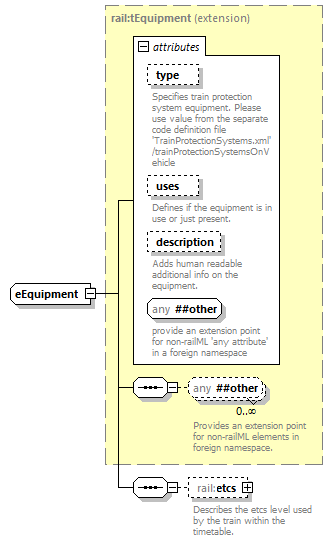 | ||||||||||||||||||||||||||||||
| namespace | https://www.railml.org/schemas/2021 | ||||||||||||||||||||||||||||||
| type | extension of rail:tEquipment | ||||||||||||||||||||||||||||||
| properties |
| ||||||||||||||||||||||||||||||
| children | rail:etcs | ||||||||||||||||||||||||||||||
| used by |
| ||||||||||||||||||||||||||||||
| attributes |
| ||||||||||||||||||||||||||||||
| source | <xs:complexType name="eEquipment"> <xs:complexContent> <xs:extension base="rail:tEquipment"> <xs:sequence> <xs:element name="etcs" type="rail:tEtcsTT" minOccurs="0"> <xs:annotation> <xs:documentation>Describes the etcs level used by the train within the timetable.</xs:documentation> <xs:documentation>See https://wiki2.railml.org/wiki/TT:etcs</xs:documentation> </xs:annotation> </xs:element> </xs:sequence> </xs:extension> </xs:complexContent> </xs:complexType> |
element eEquipment/etcs
| diagram |  | ||||||||||||||||||||||||||||||||||||||||||||||
| namespace | https://www.railml.org/schemas/2021 | ||||||||||||||||||||||||||||||||||||||||||||||
| type | rail:tEtcsTT | ||||||||||||||||||||||||||||||||||||||||||||||
| properties |
| ||||||||||||||||||||||||||||||||||||||||||||||
| attributes |
| ||||||||||||||||||||||||||||||||||||||||||||||
| annotation |
| ||||||||||||||||||||||||||||||||||||||||||||||
| source | <xs:element name="etcs" type="rail:tEtcsTT" minOccurs="0"> <xs:annotation> <xs:documentation>Describes the etcs level used by the train within the timetable.</xs:documentation> <xs:documentation>See https://wiki2.railml.org/wiki/TT:etcs</xs:documentation> </xs:annotation> </xs:element> |
complexType eEquipmentUsage
| diagram |  | ||
| namespace | https://www.railml.org/schemas/2021 | ||
| children | rail:equipment | ||
| used by |
| ||
| source | <xs:complexType name="eEquipmentUsage"> <xs:sequence> <xs:element name="equipment" type="rail:eEquipment" minOccurs="0" maxOccurs="unbounded"> <xs:annotation> <xs:documentation>Describes the required technical equipment of the train.</xs:documentation> <xs:documentation>See https://wiki2.railml.org/wiki/TT:equipment</xs:documentation> </xs:annotation> </xs:element> </xs:sequence> </xs:complexType> |
element eEquipmentUsage/equipment
| diagram |  | ||||||||||||||||||||||||||||||
| namespace | https://www.railml.org/schemas/2021 | ||||||||||||||||||||||||||||||
| type | rail:eEquipment | ||||||||||||||||||||||||||||||
| properties |
| ||||||||||||||||||||||||||||||
| children | rail:etcs | ||||||||||||||||||||||||||||||
| attributes |
| ||||||||||||||||||||||||||||||
| annotation |
| ||||||||||||||||||||||||||||||
| source | <xs:element name="equipment" type="rail:eEquipment" minOccurs="0" maxOccurs="unbounded"> <xs:annotation> <xs:documentation>Describes the required technical equipment of the train.</xs:documentation> <xs:documentation>See https://wiki2.railml.org/wiki/TT:equipment</xs:documentation> </xs:annotation> </xs:element> |
complexType eExternalReference
| diagram |  | ||
| namespace | https://www.railml.org/schemas/2021 | ||
| children | rail:tafTapTsiTrainID rail:trainNumber rail:lineNumber rail:information | ||
| used by |
| ||
| source | <xs:complexType name="eExternalReference"> <xs:sequence> <xs:element name="tafTapTsiTrainID" type="rail:eTapTsiTransportOperationalIdentifier" minOccurs="0"> <xs:annotation> <xs:documentation>Groups elements used to describe a train external to the railML document in order to specify a connection to that train.</xs:documentation> <xs:documentation>See https://wiki2.railml.org/wiki/TT:tafTapTsiTrainID_externalReference</xs:documentation> </xs:annotation> </xs:element> <xs:element name="trainNumber" minOccurs="0"> <xs:annotation> <xs:documentation>This element is used to identify a train as part of a described connection by its train number. It is expected that the train identified thus is external to the enclosing railML document.</xs:documentation> <xs:documentation>See https://wiki2.railml.org/wiki/TT:trainNumber</xs:documentation> </xs:annotation> <xs:complexType> <xs:sequence> <xs:element name="organizationalUnitBinding" type="rail:eOrganizationalUnitBinding" minOccurs="0"> <xs:annotation> <xs:documentation>See https://wiki2.railml.org/wiki/TT:organizationalUnitBinding</xs:documentation> </xs:annotation> </xs:element> </xs:sequence> <xs:attribute name="trainNumber" type="xs:string"> <xs:annotation> <xs:documentation>Used to specify the number of the connecting train.</xs:documentation> </xs:annotation> </xs:attribute> </xs:complexType> </xs:element> <xs:element name="lineNumber" minOccurs="0"> <xs:annotation> <xs:documentation>Describes a number or character string assigned to a certain number of train journeys, in the sense of a sequence of stops and journey times for easier identification.</xs:documentation> <xs:documentation>See https://wiki2.railml.org/wiki/TT:lineNumber</xs:documentation> </xs:annotation> <xs:complexType> <xs:attribute name="lineNumber" type="xs:string"> <xs:annotation> <xs:documentation>Defines the number of the line.</xs:documentation> </xs:annotation> </xs:attribute> </xs:complexType> </xs:element> <xs:element name="information" minOccurs="0"> <xs:annotation> <xs:documentation>See https://wiki2.railml.org/wiki/TT:information</xs:documentation> </xs:annotation> <xs:complexType> <xs:attribute name="description" type="xs:string"> <xs:annotation> <xs:documentation>Used to provide the description of the connection - e.g. 'Connection to Berlin via Wolfsburg'</xs:documentation> </xs:annotation> </xs:attribute> </xs:complexType> </xs:element> </xs:sequence> </xs:complexType> |
element eExternalReference/tafTapTsiTrainID
| diagram |  | ||||||||||||||||||||||||||||||||||||||||||||||||||||||
| namespace | https://www.railml.org/schemas/2021 | ||||||||||||||||||||||||||||||||||||||||||||||||||||||
| type | rail:eTapTsiTransportOperationalIdentifier | ||||||||||||||||||||||||||||||||||||||||||||||||||||||
| properties |
| ||||||||||||||||||||||||||||||||||||||||||||||||||||||
| attributes |
| ||||||||||||||||||||||||||||||||||||||||||||||||||||||
| annotation |
| ||||||||||||||||||||||||||||||||||||||||||||||||||||||
| source | <xs:element name="tafTapTsiTrainID" type="rail:eTapTsiTransportOperationalIdentifier" minOccurs="0"> <xs:annotation> <xs:documentation>Groups elements used to describe a train external to the railML document in order to specify a connection to that train.</xs:documentation> <xs:documentation>See https://wiki2.railml.org/wiki/TT:tafTapTsiTrainID_externalReference</xs:documentation> </xs:annotation> </xs:element> |
element eExternalReference/trainNumber
| diagram | 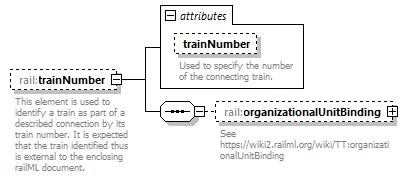 | ||||||||||||||
| namespace | https://www.railml.org/schemas/2021 | ||||||||||||||
| properties |
| ||||||||||||||
| children | rail:organizationalUnitBinding | ||||||||||||||
| attributes |
| ||||||||||||||
| annotation |
| ||||||||||||||
| source | <xs:element name="trainNumber" minOccurs="0"> <xs:annotation> <xs:documentation>This element is used to identify a train as part of a described connection by its train number. It is expected that the train identified thus is external to the enclosing railML document.</xs:documentation> <xs:documentation>See https://wiki2.railml.org/wiki/TT:trainNumber</xs:documentation> </xs:annotation> <xs:complexType> <xs:sequence> <xs:element name="organizationalUnitBinding" type="rail:eOrganizationalUnitBinding" minOccurs="0"> <xs:annotation> <xs:documentation>See https://wiki2.railml.org/wiki/TT:organizationalUnitBinding</xs:documentation> </xs:annotation> </xs:element> </xs:sequence> <xs:attribute name="trainNumber" type="xs:string"> <xs:annotation> <xs:documentation>Used to specify the number of the connecting train.</xs:documentation> </xs:annotation> </xs:attribute> </xs:complexType> </xs:element> |
attribute eExternalReference/trainNumber/@trainNumber
| type | xs:string | ||
| annotation |
| ||
| source | <xs:attribute name="trainNumber" type="xs:string"> <xs:annotation> <xs:documentation>Used to specify the number of the connecting train.</xs:documentation> </xs:annotation> </xs:attribute> |
element eExternalReference/trainNumber/organizationalUnitBinding
| diagram | 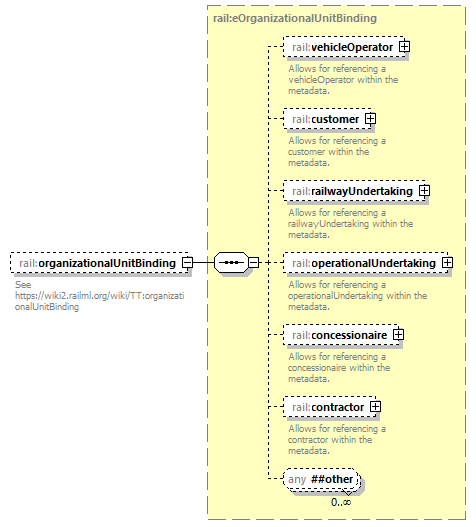 | ||||||
| namespace | https://www.railml.org/schemas/2021 | ||||||
| type | rail:eOrganizationalUnitBinding | ||||||
| properties |
| ||||||
| children | rail:vehicleOperator rail:customer rail:railwayUndertaking rail:operationalUndertaking rail:concessionaire rail:contractor | ||||||
| annotation |
| ||||||
| source | <xs:element name="organizationalUnitBinding" type="rail:eOrganizationalUnitBinding" minOccurs="0"> <xs:annotation> <xs:documentation>See https://wiki2.railml.org/wiki/TT:organizationalUnitBinding</xs:documentation> </xs:annotation> </xs:element> |
element eExternalReference/lineNumber
| diagram | 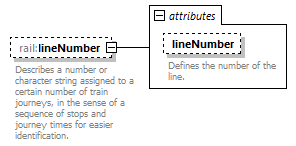 | ||||||||||||||
| namespace | https://www.railml.org/schemas/2021 | ||||||||||||||
| properties |
| ||||||||||||||
| attributes |
| ||||||||||||||
| annotation |
| ||||||||||||||
| source | <xs:element name="lineNumber" minOccurs="0"> <xs:annotation> <xs:documentation>Describes a number or character string assigned to a certain number of train journeys, in the sense of a sequence of stops and journey times for easier identification.</xs:documentation> <xs:documentation>See https://wiki2.railml.org/wiki/TT:lineNumber</xs:documentation> </xs:annotation> <xs:complexType> <xs:attribute name="lineNumber" type="xs:string"> <xs:annotation> <xs:documentation>Defines the number of the line.</xs:documentation> </xs:annotation> </xs:attribute> </xs:complexType> </xs:element> |
attribute eExternalReference/lineNumber/@lineNumber
| type | xs:string | ||
| annotation |
| ||
| source | <xs:attribute name="lineNumber" type="xs:string"> <xs:annotation> <xs:documentation>Defines the number of the line.</xs:documentation> </xs:annotation> </xs:attribute> |
element eExternalReference/information
| diagram | 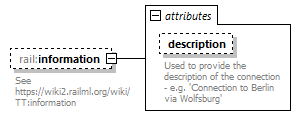 | ||||||||||||||
| namespace | https://www.railml.org/schemas/2021 | ||||||||||||||
| properties |
| ||||||||||||||
| attributes |
| ||||||||||||||
| annotation |
| ||||||||||||||
| source | <xs:element name="information" minOccurs="0"> <xs:annotation> <xs:documentation>See https://wiki2.railml.org/wiki/TT:information</xs:documentation> </xs:annotation> <xs:complexType> <xs:attribute name="description" type="xs:string"> <xs:annotation> <xs:documentation>Used to provide the description of the connection - e.g. 'Connection to Berlin via Wolfsburg'</xs:documentation> </xs:annotation> </xs:attribute> </xs:complexType> </xs:element> |
attribute eExternalReference/information/@description
| type | xs:string | ||
| annotation |
| ||
| source | <xs:attribute name="description" type="xs:string"> <xs:annotation> <xs:documentation>Used to provide the description of the connection - e.g. 'Connection to Berlin via Wolfsburg'</xs:documentation> </xs:annotation> </xs:attribute> |
complexType eFormationTT
| diagram |  | ||||||||||||||||||||||||||||||||||||||||||||||||||||||||||||||
| namespace | https://www.railml.org/schemas/2021 | ||||||||||||||||||||||||||||||||||||||||||||||||||||||||||||||
| type | extension of rail:tFormationTT | ||||||||||||||||||||||||||||||||||||||||||||||||||||||||||||||
| properties |
| ||||||||||||||||||||||||||||||||||||||||||||||||||||||||||||||
| children | rail:equipmentUsage rail:passengerUsage rail:reservationInfo | ||||||||||||||||||||||||||||||||||||||||||||||||||||||||||||||
| used by |
| ||||||||||||||||||||||||||||||||||||||||||||||||||||||||||||||
| attributes |
| ||||||||||||||||||||||||||||||||||||||||||||||||||||||||||||||
| source | <xs:complexType name="eFormationTT"> <xs:complexContent> <xs:extension base="rail:tFormationTT"> <xs:sequence> <xs:element name="equipmentUsage" type="rail:eEquipmentUsage" minOccurs="0"> <xs:annotation> <xs:documentation>Describes how the equipment of the rolling stock is used or required by a certain trainPart.</xs:documentation> <xs:documentation>See https://wiki2.railml.org/wiki/TT:equipmentUsage_formationTT</xs:documentation> </xs:annotation> </xs:element> <xs:element name="passengerUsage" type="rail:ePassengerFacilityTT" minOccurs="0"> <xs:annotation> <xs:documentation>Describes how the rolling stock is used by the passengers in a certain train.</xs:documentation> <xs:documentation>See https://wiki2.railml.org/wiki/TT:passengerUsage</xs:documentation> </xs:annotation> </xs:element> <xs:element name="reservationInfo" type="rail:eReservationInfo" minOccurs="0"> <xs:annotation> <xs:documentation>Intended for booking information described in its sub elements booking.</xs:documentation> <xs:documentation>See https://wiki2.railml.org/wiki/TT:reservationInfo</xs:documentation> </xs:annotation> </xs:element> </xs:sequence> </xs:extension> </xs:complexContent> </xs:complexType> |
element eFormationTT/equipmentUsage
| diagram |  | ||||||
| namespace | https://www.railml.org/schemas/2021 | ||||||
| type | rail:eEquipmentUsage | ||||||
| properties |
| ||||||
| children | rail:equipment | ||||||
| annotation |
| ||||||
| source | <xs:element name="equipmentUsage" type="rail:eEquipmentUsage" minOccurs="0"> <xs:annotation> <xs:documentation>Describes how the equipment of the rolling stock is used or required by a certain trainPart.</xs:documentation> <xs:documentation>See https://wiki2.railml.org/wiki/TT:equipmentUsage_formationTT</xs:documentation> </xs:annotation> </xs:element> |
element eFormationTT/passengerUsage
| diagram |  | ||||||
| namespace | https://www.railml.org/schemas/2021 | ||||||
| type | rail:ePassengerFacilityTT | ||||||
| properties |
| ||||||
| children | rail:places rail:service | ||||||
| annotation |
| ||||||
| source | <xs:element name="passengerUsage" type="rail:ePassengerFacilityTT" minOccurs="0"> <xs:annotation> <xs:documentation>Describes how the rolling stock is used by the passengers in a certain train.</xs:documentation> <xs:documentation>See https://wiki2.railml.org/wiki/TT:passengerUsage</xs:documentation> </xs:annotation> </xs:element> |
element eFormationTT/reservationInfo
| diagram | 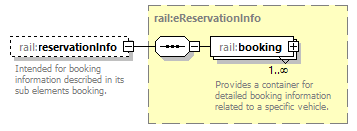 | ||||||
| namespace | https://www.railml.org/schemas/2021 | ||||||
| type | rail:eReservationInfo | ||||||
| properties |
| ||||||
| children | rail:booking | ||||||
| annotation |
| ||||||
| source | <xs:element name="reservationInfo" type="rail:eReservationInfo" minOccurs="0"> <xs:annotation> <xs:documentation>Intended for booking information described in its sub elements booking.</xs:documentation> <xs:documentation>See https://wiki2.railml.org/wiki/TT:reservationInfo</xs:documentation> </xs:annotation> </xs:element> |
complexType eHolidays
| diagram |  | ||
| namespace | https://www.railml.org/schemas/2021 | ||
| children | rail:holiday | ||
| used by |
| ||
| source | <xs:complexType name="eHolidays"> <xs:sequence> <xs:element name="holiday" type="rail:tHoliday" maxOccurs="unbounded"> <xs:annotation> <xs:documentation>This element is used to specify the public holidays effective in the enclosing timetable period. Operating periods usually refer to such holidays with phrases like "all days, excluding public holidays".</xs:documentation> <xs:documentation>See https://wiki2.railml.org/wiki/TT:holiday</xs:documentation> </xs:annotation> </xs:element> </xs:sequence> </xs:complexType> |
element eHolidays/holiday
| diagram | 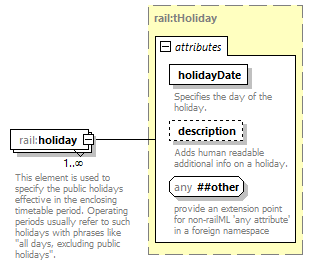 | ||||||||||||||||||||||
| namespace | https://www.railml.org/schemas/2021 | ||||||||||||||||||||||
| type | rail:tHoliday | ||||||||||||||||||||||
| properties |
| ||||||||||||||||||||||
| attributes |
| ||||||||||||||||||||||
| annotation |
| ||||||||||||||||||||||
| source | <xs:element name="holiday" type="rail:tHoliday" maxOccurs="unbounded"> <xs:annotation> <xs:documentation>This element is used to specify the public holidays effective in the enclosing timetable period. Operating periods usually refer to such holidays with phrases like "all days, excluding public holidays".</xs:documentation> <xs:documentation>See https://wiki2.railml.org/wiki/TT:holiday</xs:documentation> </xs:annotation> </xs:element> |
complexType eLines
| diagram |  | ||
| namespace | https://www.railml.org/schemas/2021 | ||
| children | rail:lineTT | ||
| used by |
| ||
| source | <xs:complexType name="eLines"> <xs:sequence> <xs:element name="lineTT" type="rail:eLineTT" maxOccurs="unbounded"> <xs:annotation> <xs:documentation>The element <lineTT> was introduced to allow providing more information for a line/transport service than its mere name. Before there was only as simple attribute "line" at the level of the train part. This attribute can still be used if no further information is available. If however the name of a trainsport service needs translating or media resources can be provided for passenger information systems, then this element can be used.</xs:documentation> <xs:documentation>See https://wiki2.railml.org/wiki/TT:lineTT</xs:documentation> </xs:annotation> </xs:element> </xs:sequence> </xs:complexType> |
element eLines/lineTT
| diagram |  | ||||||||||||||||||||||||||||||||||||||||||||||
| namespace | https://www.railml.org/schemas/2021 | ||||||||||||||||||||||||||||||||||||||||||||||
| type | rail:eLineTT | ||||||||||||||||||||||||||||||||||||||||||||||
| properties |
| ||||||||||||||||||||||||||||||||||||||||||||||
| children | rail:additionalName rail:mediaResources | ||||||||||||||||||||||||||||||||||||||||||||||
| attributes |
| ||||||||||||||||||||||||||||||||||||||||||||||
| annotation |
| ||||||||||||||||||||||||||||||||||||||||||||||
| source | <xs:element name="lineTT" type="rail:eLineTT" maxOccurs="unbounded"> <xs:annotation> <xs:documentation>The element <lineTT> was introduced to allow providing more information for a line/transport service than its mere name. Before there was only as simple attribute "line" at the level of the train part. This attribute can still be used if no further information is available. If however the name of a trainsport service needs translating or media resources can be provided for passenger information systems, then this element can be used.</xs:documentation> <xs:documentation>See https://wiki2.railml.org/wiki/TT:lineTT</xs:documentation> </xs:annotation> </xs:element> |
complexType eLineTT
| diagram |  | ||||||||||||||||||||||||||||||||||||||||||||||
| namespace | https://www.railml.org/schemas/2021 | ||||||||||||||||||||||||||||||||||||||||||||||
| type | extension of rail:tLineTT | ||||||||||||||||||||||||||||||||||||||||||||||
| properties |
| ||||||||||||||||||||||||||||||||||||||||||||||
| children | rail:additionalName rail:mediaResources | ||||||||||||||||||||||||||||||||||||||||||||||
| used by |
| ||||||||||||||||||||||||||||||||||||||||||||||
| attributes |
| ||||||||||||||||||||||||||||||||||||||||||||||
| source | <xs:complexType name="eLineTT"> <xs:complexContent> <xs:extension base="rail:tLineTT"> <xs:sequence> <xs:element name="mediaResources" type="rail:tMediaResources" minOccurs="0"> <xs:annotation> <xs:documentation>Allows specifying text and audio fragments intended for passenger information systems when replacing placeholders of special texts or announcements with the actual content fragments.</xs:documentation> <xs:documentation>See https://wiki2.railml.org/wiki/TT:mediaResources</xs:documentation> </xs:annotation> </xs:element> </xs:sequence> </xs:extension> </xs:complexContent> </xs:complexType> |
element eLineTT/mediaResources
| diagram |  | ||||||
| namespace | https://www.railml.org/schemas/2021 | ||||||
| type | rail:tMediaResources | ||||||
| properties |
| ||||||
| children | rail:textFragments rail:audioFragments | ||||||
| annotation |
| ||||||
| source | <xs:element name="mediaResources" type="rail:tMediaResources" minOccurs="0"> <xs:annotation> <xs:documentation>Allows specifying text and audio fragments intended for passenger information systems when replacing placeholders of special texts or announcements with the actual content fragments.</xs:documentation> <xs:documentation>See https://wiki2.railml.org/wiki/TT:mediaResources</xs:documentation> </xs:annotation> </xs:element> |
complexType eOcpsTT
| diagram |  | ||
| namespace | https://www.railml.org/schemas/2021 | ||
| children | rail:ocpTT | ||
| used by |
| ||
| source | <xs:complexType name="eOcpsTT"> <xs:sequence> <xs:element name="ocpTT" type="rail:eOcpTT" maxOccurs="unbounded"> <xs:annotation> <xs:documentation>Describes a single point along the train path.</xs:documentation> <xs:documentation>See https://wiki2.railml.org/wiki/TT:ocpTT</xs:documentation> </xs:annotation> </xs:element> </xs:sequence> </xs:complexType> |
element eOcpsTT/ocpTT
| diagram |  | ||||||||||||||||||||||||||||||||||||||||||||||||||||||||||||||||||||||||||||||||||||||
| namespace | https://www.railml.org/schemas/2021 | ||||||||||||||||||||||||||||||||||||||||||||||||||||||||||||||||||||||||||||||||||||||
| type | rail:eOcpTT | ||||||||||||||||||||||||||||||||||||||||||||||||||||||||||||||||||||||||||||||||||||||
| properties |
| ||||||||||||||||||||||||||||||||||||||||||||||||||||||||||||||||||||||||||||||||||||||
| children | rail:times rail:connections rail:statistics rail:sectionTT rail:alternativeSectionsTT rail:stopDescription rail:originalTrackInfo | ||||||||||||||||||||||||||||||||||||||||||||||||||||||||||||||||||||||||||||||||||||||
| attributes |
| ||||||||||||||||||||||||||||||||||||||||||||||||||||||||||||||||||||||||||||||||||||||
| annotation |
| ||||||||||||||||||||||||||||||||||||||||||||||||||||||||||||||||||||||||||||||||||||||
| source | <xs:element name="ocpTT" type="rail:eOcpTT" maxOccurs="unbounded"> <xs:annotation> <xs:documentation>Describes a single point along the train path.</xs:documentation> <xs:documentation>See https://wiki2.railml.org/wiki/TT:ocpTT</xs:documentation> </xs:annotation> </xs:element> |
complexType eOcpTT
| diagram |  | ||||||||||||||||||||||||||||||||||||||||||||||||||||||||||||||||||||||||||||||||||||||
| namespace | https://www.railml.org/schemas/2021 | ||||||||||||||||||||||||||||||||||||||||||||||||||||||||||||||||||||||||||||||||||||||
| type | extension of rail:tOcpTT | ||||||||||||||||||||||||||||||||||||||||||||||||||||||||||||||||||||||||||||||||||||||
| properties |
| ||||||||||||||||||||||||||||||||||||||||||||||||||||||||||||||||||||||||||||||||||||||
| children | rail:times rail:connections rail:statistics rail:sectionTT rail:alternativeSectionsTT rail:stopDescription rail:originalTrackInfo | ||||||||||||||||||||||||||||||||||||||||||||||||||||||||||||||||||||||||||||||||||||||
| used by |
| ||||||||||||||||||||||||||||||||||||||||||||||||||||||||||||||||||||||||||||||||||||||
| attributes |
| ||||||||||||||||||||||||||||||||||||||||||||||||||||||||||||||||||||||||||||||||||||||
| source | <xs:complexType name="eOcpTT"> <xs:complexContent> <xs:extension base="rail:tOcpTT"> <xs:sequence> <xs:element name="times" type="rail:eArrivalDepartureTimes" minOccurs="0" maxOccurs="unbounded"> <xs:annotation> <xs:documentation>Describes arrival and departure times of a train with their scope.</xs:documentation> <xs:documentation>See https://wiki2.railml.org/wiki/TT:times</xs:documentation> </xs:annotation> </xs:element> <xs:element name="connections" type="rail:eConnectionsTT" minOccurs="0"> <xs:annotation> <xs:documentation>Groups connection elements.</xs:documentation> <xs:documentation>See https://wiki2.railml.org/wiki/TT:connections</xs:documentation> </xs:annotation> </xs:element> <xs:element name="statistics" type="rail:eStatistics" minOccurs="0"> <xs:annotation> <xs:documentation>Groups statistic elements.</xs:documentation> <xs:documentation>See https://wiki2.railml.org/wiki/TT:statistics</xs:documentation> </xs:annotation> </xs:element> <xs:element name="sectionTT" type="rail:eSectionTT" minOccurs="0"> <xs:annotation> <xs:documentation>Describes data concerning the way from one ocpTT to the next one in the order of the sequence.</xs:documentation> <xs:documentation>See https://wiki2.railml.org/wiki/TT:sectionTT</xs:documentation> </xs:annotation> </xs:element> <xs:element name="alternativeSectionsTT" type="rail:eAlternativeSectionsTT" minOccurs="0"> <xs:annotation> <xs:documentation>Describes alternative pathes from this ocpTT to the next.</xs:documentation> <xs:documentation>See https://wiki2.railml.org/wiki/TT:alternativeSectionsTT</xs:documentation> </xs:annotation> </xs:element> <xs:element name="stopDescription" type="rail:eStopDescription" minOccurs="0"> <xs:annotation> <xs:documentation>Describes data concerning the stop (or pass) of the enclosing ocpTT.</xs:documentation> <xs:documentation>See https://wiki2.railml.org/wiki/TT:stopDescription</xs:documentation> </xs:annotation> </xs:element> <xs:element name="originalTrackInfo" type="rail:eOriginalTrackInfo" minOccurs="0"> <xs:annotation> <xs:documentation>Allows for definition of station tracks that were supposed to be used by the train at the stop before some dispatching operation that caused a track change.</xs:documentation> <xs:documentation>See https://wiki2.railml.org/wiki/TT:originalTrackInfo</xs:documentation> </xs:annotation> </xs:element> <xs:any namespace="##other" processContents="strict" minOccurs="0" maxOccurs="unbounded"/> </xs:sequence> </xs:extension> </xs:complexContent> </xs:complexType> |
element eOcpTT/times
| diagram | 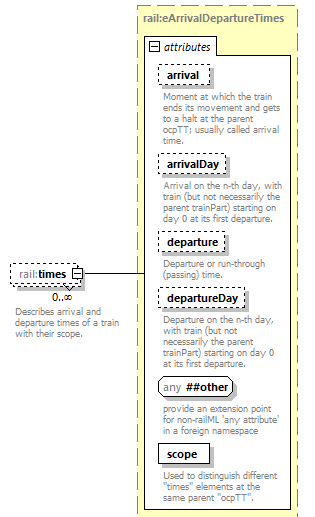 | ||||||||||||||||||||||||||||||||||||||||||||||||||||||
| namespace | https://www.railml.org/schemas/2021 | ||||||||||||||||||||||||||||||||||||||||||||||||||||||
| type | rail:eArrivalDepartureTimes | ||||||||||||||||||||||||||||||||||||||||||||||||||||||
| properties |
| ||||||||||||||||||||||||||||||||||||||||||||||||||||||
| attributes |
| ||||||||||||||||||||||||||||||||||||||||||||||||||||||
| annotation |
| ||||||||||||||||||||||||||||||||||||||||||||||||||||||
| source | <xs:element name="times" type="rail:eArrivalDepartureTimes" minOccurs="0" maxOccurs="unbounded"> <xs:annotation> <xs:documentation>Describes arrival and departure times of a train with their scope.</xs:documentation> <xs:documentation>See https://wiki2.railml.org/wiki/TT:times</xs:documentation> </xs:annotation> </xs:element> |
element eOcpTT/connections
| diagram |  | ||||||
| namespace | https://www.railml.org/schemas/2021 | ||||||
| type | rail:eConnectionsTT | ||||||
| properties |
| ||||||
| children | rail:connection | ||||||
| annotation |
| ||||||
| source | <xs:element name="connections" type="rail:eConnectionsTT" minOccurs="0"> <xs:annotation> <xs:documentation>Groups connection elements.</xs:documentation> <xs:documentation>See https://wiki2.railml.org/wiki/TT:connections</xs:documentation> </xs:annotation> </xs:element> |
element eOcpTT/statistics
| diagram | 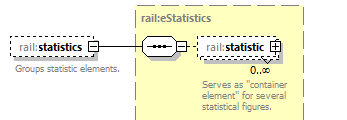 | ||||||
| namespace | https://www.railml.org/schemas/2021 | ||||||
| type | rail:eStatistics | ||||||
| properties |
| ||||||
| children | rail:statistic | ||||||
| annotation |
| ||||||
| source | <xs:element name="statistics" type="rail:eStatistics" minOccurs="0"> <xs:annotation> <xs:documentation>Groups statistic elements.</xs:documentation> <xs:documentation>See https://wiki2.railml.org/wiki/TT:statistics</xs:documentation> </xs:annotation> </xs:element> |
element eOcpTT/sectionTT
| diagram |  | ||||||||||||||||||||||||||||||||||||||||||||||||||||||||||||||
| namespace | https://www.railml.org/schemas/2021 | ||||||||||||||||||||||||||||||||||||||||||||||||||||||||||||||
| type | rail:eSectionTT | ||||||||||||||||||||||||||||||||||||||||||||||||||||||||||||||
| properties |
| ||||||||||||||||||||||||||||||||||||||||||||||||||||||||||||||
| children | rail:trackRef rail:runTimes | ||||||||||||||||||||||||||||||||||||||||||||||||||||||||||||||
| attributes |
| ||||||||||||||||||||||||||||||||||||||||||||||||||||||||||||||
| annotation |
| ||||||||||||||||||||||||||||||||||||||||||||||||||||||||||||||
| source | <xs:element name="sectionTT" type="rail:eSectionTT" minOccurs="0"> <xs:annotation> <xs:documentation>Describes data concerning the way from one ocpTT to the next one in the order of the sequence.</xs:documentation> <xs:documentation>See https://wiki2.railml.org/wiki/TT:sectionTT</xs:documentation> </xs:annotation> </xs:element> |
element eOcpTT/alternativeSectionsTT
| diagram | 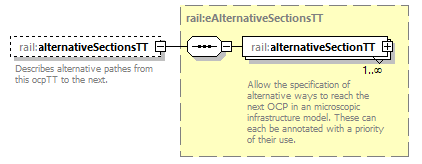 | ||||||
| namespace | https://www.railml.org/schemas/2021 | ||||||
| type | rail:eAlternativeSectionsTT | ||||||
| properties |
| ||||||
| children | rail:alternativeSectionTT | ||||||
| annotation |
| ||||||
| source | <xs:element name="alternativeSectionsTT" type="rail:eAlternativeSectionsTT" minOccurs="0"> <xs:annotation> <xs:documentation>Describes alternative pathes from this ocpTT to the next.</xs:documentation> <xs:documentation>See https://wiki2.railml.org/wiki/TT:alternativeSectionsTT</xs:documentation> </xs:annotation> </xs:element> |
element eOcpTT/stopDescription
| diagram |  | ||||||||||||||||||||||||||||||||||||||||||||||||||||||||||||||||||||||
| namespace | https://www.railml.org/schemas/2021 | ||||||||||||||||||||||||||||||||||||||||||||||||||||||||||||||||||||||
| type | rail:eStopDescription | ||||||||||||||||||||||||||||||||||||||||||||||||||||||||||||||||||||||
| properties |
| ||||||||||||||||||||||||||||||||||||||||||||||||||||||||||||||||||||||
| children | rail:stopTimes rail:stopActivities rail:platformEdgeRef rail:serviceSectionRef rail:trackInfo rail:annotationRef rail:announcementRef | ||||||||||||||||||||||||||||||||||||||||||||||||||||||||||||||||||||||
| attributes |
| ||||||||||||||||||||||||||||||||||||||||||||||||||||||||||||||||||||||
| annotation |
| ||||||||||||||||||||||||||||||||||||||||||||||||||||||||||||||||||||||
| source | <xs:element name="stopDescription" type="rail:eStopDescription" minOccurs="0"> <xs:annotation> <xs:documentation>Describes data concerning the stop (or pass) of the enclosing ocpTT.</xs:documentation> <xs:documentation>See https://wiki2.railml.org/wiki/TT:stopDescription</xs:documentation> </xs:annotation> </xs:element> |
element eOcpTT/originalTrackInfo
| diagram | 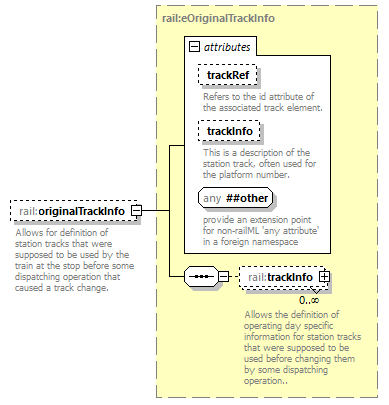 | ||||||||||||||||||||||
| namespace | https://www.railml.org/schemas/2021 | ||||||||||||||||||||||
| type | rail:eOriginalTrackInfo | ||||||||||||||||||||||
| properties |
| ||||||||||||||||||||||
| children | rail:trackInfo | ||||||||||||||||||||||
| attributes |
| ||||||||||||||||||||||
| annotation |
| ||||||||||||||||||||||
| source | <xs:element name="originalTrackInfo" type="rail:eOriginalTrackInfo" minOccurs="0"> <xs:annotation> <xs:documentation>Allows for definition of station tracks that were supposed to be used by the train at the stop before some dispatching operation that caused a track change.</xs:documentation> <xs:documentation>See https://wiki2.railml.org/wiki/TT:originalTrackInfo</xs:documentation> </xs:annotation> </xs:element> |
complexType eOperatingDay
| diagram |  | ||||||||||||||||||||||||||||||||
| namespace | https://www.railml.org/schemas/2021 | ||||||||||||||||||||||||||||||||
| type | extension of rail:tOperatingDay | ||||||||||||||||||||||||||||||||
| properties |
| ||||||||||||||||||||||||||||||||
| children | rail:operatingDayDeviance | ||||||||||||||||||||||||||||||||
| used by |
| ||||||||||||||||||||||||||||||||
| attributes |
| ||||||||||||||||||||||||||||||||
| source | <xs:complexType name="eOperatingDay"> <xs:complexContent> <xs:extension base="rail:tOperatingDay"> <xs:sequence> <xs:element name="operatingDayDeviance" type="rail:tOperatingDayDeviance" minOccurs="0" maxOccurs="unbounded"> <xs:annotation> <xs:documentation>Describes the operation modifications of the standard week described in operatingDay.</xs:documentation> <xs:documentation>See https://wiki2.railml.org/wiki/TT:operatingDayDeviance</xs:documentation> </xs:annotation> </xs:element> </xs:sequence> </xs:extension> </xs:complexContent> </xs:complexType> |
element eOperatingDay/operatingDayDeviance
| diagram |  | ||||||||||||||||||||||||||||||||||||
| namespace | https://www.railml.org/schemas/2021 | ||||||||||||||||||||||||||||||||||||
| type | rail:tOperatingDayDeviance | ||||||||||||||||||||||||||||||||||||
| properties |
| ||||||||||||||||||||||||||||||||||||
| attributes |
| ||||||||||||||||||||||||||||||||||||
| annotation |
| ||||||||||||||||||||||||||||||||||||
| source | <xs:element name="operatingDayDeviance" type="rail:tOperatingDayDeviance" minOccurs="0" maxOccurs="unbounded"> <xs:annotation> <xs:documentation>Describes the operation modifications of the standard week described in operatingDay.</xs:documentation> <xs:documentation>See https://wiki2.railml.org/wiki/TT:operatingDayDeviance</xs:documentation> </xs:annotation> </xs:element> |
complexType eOperatingPeriod
| diagram |  | ||||||||||||||||||||||||||||||||||||||||||||||||||||||||||||||||||||||||||
| namespace | https://www.railml.org/schemas/2021 | ||||||||||||||||||||||||||||||||||||||||||||||||||||||||||||||||||||||||||
| type | extension of rail:tOperatingPeriod | ||||||||||||||||||||||||||||||||||||||||||||||||||||||||||||||||||||||||||
| properties |
| ||||||||||||||||||||||||||||||||||||||||||||||||||||||||||||||||||||||||||
| children | rail:additionalName rail:operatingDay rail:specialService | ||||||||||||||||||||||||||||||||||||||||||||||||||||||||||||||||||||||||||
| used by |
| ||||||||||||||||||||||||||||||||||||||||||||||||||||||||||||||||||||||||||
| attributes |
| ||||||||||||||||||||||||||||||||||||||||||||||||||||||||||||||||||||||||||
| source | <xs:complexType name="eOperatingPeriod"> <xs:complexContent> <xs:extension base="rail:tOperatingPeriod"> <xs:sequence> <xs:element name="operatingDay" type="rail:eOperatingDay" minOccurs="0" maxOccurs="unbounded"> <xs:annotation> <xs:documentation>Gives a week based abstract description of an operating period for a normal day.</xs:documentation> <xs:documentation>See https://wiki2.railml.org/wiki/TT:operatingDay</xs:documentation> </xs:annotation> </xs:element> <xs:element name="specialService" type="rail:tSpecialService" minOccurs="0" maxOccurs="unbounded"> <xs:annotation> <xs:documentation>Describes a calendar based modification of the operatingPeriod by including or excluding certain days or periods.</xs:documentation> <xs:documentation>See https://wiki2.railml.org/wiki/TT:specialService_operatingPeriod</xs:documentation> </xs:annotation> </xs:element> </xs:sequence> </xs:extension> </xs:complexContent> </xs:complexType> |
element eOperatingPeriod/operatingDay
| diagram |  | ||||||||||||||||||||||||||||||||
| namespace | https://www.railml.org/schemas/2021 | ||||||||||||||||||||||||||||||||
| type | rail:eOperatingDay | ||||||||||||||||||||||||||||||||
| properties |
| ||||||||||||||||||||||||||||||||
| children | rail:operatingDayDeviance | ||||||||||||||||||||||||||||||||
| attributes |
| ||||||||||||||||||||||||||||||||
| annotation |
| ||||||||||||||||||||||||||||||||
| source | <xs:element name="operatingDay" type="rail:eOperatingDay" minOccurs="0" maxOccurs="unbounded"> <xs:annotation> <xs:documentation>Gives a week based abstract description of an operating period for a normal day.</xs:documentation> <xs:documentation>See https://wiki2.railml.org/wiki/TT:operatingDay</xs:documentation> </xs:annotation> </xs:element> |
element eOperatingPeriod/specialService
| diagram |  | ||||||||||||||||||||||||||||||||||||||||||||||
| namespace | https://www.railml.org/schemas/2021 | ||||||||||||||||||||||||||||||||||||||||||||||
| type | rail:tSpecialService | ||||||||||||||||||||||||||||||||||||||||||||||
| properties |
| ||||||||||||||||||||||||||||||||||||||||||||||
| attributes |
| ||||||||||||||||||||||||||||||||||||||||||||||
| annotation |
| ||||||||||||||||||||||||||||||||||||||||||||||
| source | <xs:element name="specialService" type="rail:tSpecialService" minOccurs="0" maxOccurs="unbounded"> <xs:annotation> <xs:documentation>Describes a calendar based modification of the operatingPeriod by including or excluding certain days or periods.</xs:documentation> <xs:documentation>See https://wiki2.railml.org/wiki/TT:specialService_operatingPeriod</xs:documentation> </xs:annotation> </xs:element> |
complexType eOperatingPeriodRef
| diagram |  | ||||||||||||||||||||||||||
| namespace | https://www.railml.org/schemas/2021 | ||||||||||||||||||||||||||
| type | extension of rail:tOperatingPeriodRef | ||||||||||||||||||||||||||
| properties |
| ||||||||||||||||||||||||||
| children | rail:specialService | ||||||||||||||||||||||||||
| used by |
| ||||||||||||||||||||||||||
| attributes |
| ||||||||||||||||||||||||||
| source | <xs:complexType name="eOperatingPeriodRef"> <xs:complexContent> <xs:extension base="rail:tOperatingPeriodRef"> <xs:sequence> <xs:element name="specialService" type="rail:tSpecialService" minOccurs="0" maxOccurs="unbounded"> <xs:annotation> <xs:documentation>DEPRECATED: use reference to individual operating period instead.</xs:documentation> <xs:documentation>See https://wiki2.railml.org/wiki/TT:specialService_operatingPeriodRef</xs:documentation> </xs:annotation> </xs:element> </xs:sequence> </xs:extension> </xs:complexContent> </xs:complexType> |
element eOperatingPeriodRef/specialService
| diagram |  | ||||||||||||||||||||||||||||||||||||||||||||||
| namespace | https://www.railml.org/schemas/2021 | ||||||||||||||||||||||||||||||||||||||||||||||
| type | rail:tSpecialService | ||||||||||||||||||||||||||||||||||||||||||||||
| properties |
| ||||||||||||||||||||||||||||||||||||||||||||||
| attributes |
| ||||||||||||||||||||||||||||||||||||||||||||||
| annotation |
| ||||||||||||||||||||||||||||||||||||||||||||||
| source | <xs:element name="specialService" type="rail:tSpecialService" minOccurs="0" maxOccurs="unbounded"> <xs:annotation> <xs:documentation>DEPRECATED: use reference to individual operating period instead.</xs:documentation> <xs:documentation>See https://wiki2.railml.org/wiki/TT:specialService_operatingPeriodRef</xs:documentation> </xs:annotation> </xs:element> |
complexType eOperatingPeriods
| diagram |  | ||
| namespace | https://www.railml.org/schemas/2021 | ||
| children | rail:operatingPeriod | ||
| used by |
| ||
| source | <xs:complexType name="eOperatingPeriods"> <xs:sequence> <xs:element name="operatingPeriod" type="rail:eOperatingPeriod" maxOccurs="unbounded"> <xs:annotation> <xs:documentation>Describes the operation of a train. This could either be in relation to certain days of a calendar or abstract based on a standard week (or both).</xs:documentation> <xs:documentation>See https://wiki2.railml.org/wiki/TT:operatingPeriod</xs:documentation> </xs:annotation> </xs:element> </xs:sequence> </xs:complexType> |
element eOperatingPeriods/operatingPeriod
| diagram | 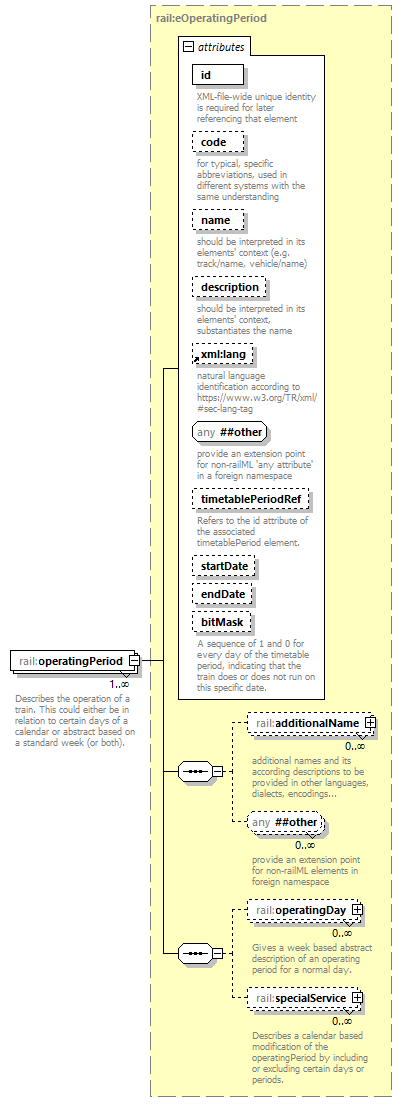 | ||||||||||||||||||||||||||||||||||||||||||||||||||||||||||||||||||||||||||
| namespace | https://www.railml.org/schemas/2021 | ||||||||||||||||||||||||||||||||||||||||||||||||||||||||||||||||||||||||||
| type | rail:eOperatingPeriod | ||||||||||||||||||||||||||||||||||||||||||||||||||||||||||||||||||||||||||
| properties |
| ||||||||||||||||||||||||||||||||||||||||||||||||||||||||||||||||||||||||||
| children | rail:additionalName rail:operatingDay rail:specialService | ||||||||||||||||||||||||||||||||||||||||||||||||||||||||||||||||||||||||||
| attributes |
| ||||||||||||||||||||||||||||||||||||||||||||||||||||||||||||||||||||||||||
| annotation |
| ||||||||||||||||||||||||||||||||||||||||||||||||||||||||||||||||||||||||||
| source | <xs:element name="operatingPeriod" type="rail:eOperatingPeriod" maxOccurs="unbounded"> <xs:annotation> <xs:documentation>Describes the operation of a train. This could either be in relation to certain days of a calendar or abstract based on a standard week (or both).</xs:documentation> <xs:documentation>See https://wiki2.railml.org/wiki/TT:operatingPeriod</xs:documentation> </xs:annotation> </xs:element> |
complexType eOrganizationalUnitBinding
| diagram |  | ||
| namespace | https://www.railml.org/schemas/2021 | ||
| children | rail:vehicleOperator rail:customer rail:railwayUndertaking rail:operationalUndertaking rail:concessionaire rail:contractor | ||
| used by |
| ||
| source | <xs:complexType name="eOrganizationalUnitBinding"> <xs:sequence> <xs:element name="vehicleOperator" type="rail:tElementWithReference" minOccurs="0"> <xs:annotation> <xs:documentation>Allows for referencing a vehicleOperator within the metadata.</xs:documentation> <xs:documentation>See https://wiki2.railml.org/wiki/TT:vehicleOperator</xs:documentation> </xs:annotation> </xs:element> <xs:element name="customer" type="rail:tElementWithReference" minOccurs="0"> <xs:annotation> <xs:documentation>Allows for referencing a customer within the metadata.</xs:documentation> <xs:documentation>See https://wiki2.railml.org/wiki/TT:customer</xs:documentation> </xs:annotation> </xs:element> <xs:element name="railwayUndertaking" type="rail:tElementWithReference" minOccurs="0"> <xs:annotation> <xs:documentation>Allows for referencing a railwayUndertaking within the metadata.</xs:documentation> <xs:documentation>See https://wiki2.railml.org/wiki/TT:railwayUndertaking</xs:documentation> </xs:annotation> </xs:element> <xs:element name="operationalUndertaking" type="rail:tElementWithReference" minOccurs="0"> <xs:annotation> <xs:documentation>Allows for referencing a operationalUndertaking within the metadata.</xs:documentation> <xs:documentation>See https://wiki2.railml.org/wiki/TT:operationalUndertaking</xs:documentation> </xs:annotation> </xs:element> <xs:element name="concessionaire" type="rail:tElementWithReference" minOccurs="0"> <xs:annotation> <xs:documentation>Allows for referencing a concessionaire within the metadata.</xs:documentation> <xs:documentation>See https://wiki2.railml.org/wiki/TT:concessionaire</xs:documentation> </xs:annotation> </xs:element> <xs:element name="contractor" type="rail:tElementWithReference" minOccurs="0"> <xs:annotation> <xs:documentation>Allows for referencing a contractor within the metadata.</xs:documentation> <xs:documentation>See https://wiki2.railml.org/wiki/TT:contractor</xs:documentation> </xs:annotation> </xs:element> <xs:any namespace="##other" processContents="strict" minOccurs="0" maxOccurs="unbounded"/> </xs:sequence> </xs:complexType> |
element eOrganizationalUnitBinding/vehicleOperator
| diagram | 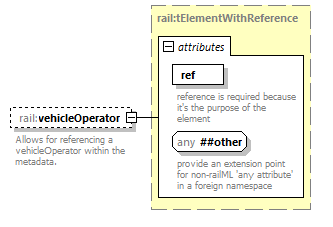 | ||||||||||||||
| namespace | https://www.railml.org/schemas/2021 | ||||||||||||||
| type | rail:tElementWithReference | ||||||||||||||
| properties |
| ||||||||||||||
| attributes |
| ||||||||||||||
| annotation |
| ||||||||||||||
| source | <xs:element name="vehicleOperator" type="rail:tElementWithReference" minOccurs="0"> <xs:annotation> <xs:documentation>Allows for referencing a vehicleOperator within the metadata.</xs:documentation> <xs:documentation>See https://wiki2.railml.org/wiki/TT:vehicleOperator</xs:documentation> </xs:annotation> </xs:element> |
element eOrganizationalUnitBinding/customer
| diagram |  | ||||||||||||||
| namespace | https://www.railml.org/schemas/2021 | ||||||||||||||
| type | rail:tElementWithReference | ||||||||||||||
| properties |
| ||||||||||||||
| attributes |
| ||||||||||||||
| annotation |
| ||||||||||||||
| source | <xs:element name="customer" type="rail:tElementWithReference" minOccurs="0"> <xs:annotation> <xs:documentation>Allows for referencing a customer within the metadata.</xs:documentation> <xs:documentation>See https://wiki2.railml.org/wiki/TT:customer</xs:documentation> </xs:annotation> </xs:element> |
element eOrganizationalUnitBinding/railwayUndertaking
| diagram |  | ||||||||||||||
| namespace | https://www.railml.org/schemas/2021 | ||||||||||||||
| type | rail:tElementWithReference | ||||||||||||||
| properties |
| ||||||||||||||
| attributes |
| ||||||||||||||
| annotation |
| ||||||||||||||
| source | <xs:element name="railwayUndertaking" type="rail:tElementWithReference" minOccurs="0"> <xs:annotation> <xs:documentation>Allows for referencing a railwayUndertaking within the metadata.</xs:documentation> <xs:documentation>See https://wiki2.railml.org/wiki/TT:railwayUndertaking</xs:documentation> </xs:annotation> </xs:element> |
element eOrganizationalUnitBinding/operationalUndertaking
| diagram |  | ||||||||||||||
| namespace | https://www.railml.org/schemas/2021 | ||||||||||||||
| type | rail:tElementWithReference | ||||||||||||||
| properties |
| ||||||||||||||
| attributes |
| ||||||||||||||
| annotation |
| ||||||||||||||
| source | <xs:element name="operationalUndertaking" type="rail:tElementWithReference" minOccurs="0"> <xs:annotation> <xs:documentation>Allows for referencing a operationalUndertaking within the metadata.</xs:documentation> <xs:documentation>See https://wiki2.railml.org/wiki/TT:operationalUndertaking</xs:documentation> </xs:annotation> </xs:element> |
element eOrganizationalUnitBinding/concessionaire
| diagram |  | ||||||||||||||
| namespace | https://www.railml.org/schemas/2021 | ||||||||||||||
| type | rail:tElementWithReference | ||||||||||||||
| properties |
| ||||||||||||||
| attributes |
| ||||||||||||||
| annotation |
| ||||||||||||||
| source | <xs:element name="concessionaire" type="rail:tElementWithReference" minOccurs="0"> <xs:annotation> <xs:documentation>Allows for referencing a concessionaire within the metadata.</xs:documentation> <xs:documentation>See https://wiki2.railml.org/wiki/TT:concessionaire</xs:documentation> </xs:annotation> </xs:element> |
element eOrganizationalUnitBinding/contractor
| diagram |  | ||||||||||||||
| namespace | https://www.railml.org/schemas/2021 | ||||||||||||||
| type | rail:tElementWithReference | ||||||||||||||
| properties |
| ||||||||||||||
| attributes |
| ||||||||||||||
| annotation |
| ||||||||||||||
| source | <xs:element name="contractor" type="rail:tElementWithReference" minOccurs="0"> <xs:annotation> <xs:documentation>Allows for referencing a contractor within the metadata.</xs:documentation> <xs:documentation>See https://wiki2.railml.org/wiki/TT:contractor</xs:documentation> </xs:annotation> </xs:element> |
complexType eOriginalTrackInfo
| diagram |  | ||||||||||||||||||||||
| namespace | https://www.railml.org/schemas/2021 | ||||||||||||||||||||||
| type | extension of rail:tOriginalTrackInfo | ||||||||||||||||||||||
| properties |
| ||||||||||||||||||||||
| children | rail:trackInfo | ||||||||||||||||||||||
| used by |
| ||||||||||||||||||||||
| attributes |
| ||||||||||||||||||||||
| source | <xs:complexType name="eOriginalTrackInfo"> <xs:complexContent> <xs:extension base="rail:tOriginalTrackInfo"> <xs:sequence> <xs:element name="trackInfo" type="rail:tStationTrackInfo" minOccurs="0" maxOccurs="unbounded"> <xs:annotation> <xs:documentation>Allows the definition of operating day specific information for station tracks that were supposed to be used before changing them by some dispatching operation..</xs:documentation> <xs:documentation>See https://wiki2.railml.org/wiki/TT:trackInfo_originalTrackInfo</xs:documentation> </xs:annotation> </xs:element> </xs:sequence> </xs:extension> </xs:complexContent> </xs:complexType> |
element eOriginalTrackInfo/trackInfo
| diagram |  | ||||||||||||||||||||||||||||||
| namespace | https://www.railml.org/schemas/2021 | ||||||||||||||||||||||||||||||
| type | rail:tStationTrackInfo | ||||||||||||||||||||||||||||||
| properties |
| ||||||||||||||||||||||||||||||
| attributes |
| ||||||||||||||||||||||||||||||
| annotation |
| ||||||||||||||||||||||||||||||
| source | <xs:element name="trackInfo" type="rail:tStationTrackInfo" minOccurs="0" maxOccurs="unbounded"> <xs:annotation> <xs:documentation>Allows the definition of operating day specific information for station tracks that were supposed to be used before changing them by some dispatching operation..</xs:documentation> <xs:documentation>See https://wiki2.railml.org/wiki/TT:trackInfo_originalTrackInfo</xs:documentation> </xs:annotation> </xs:element> |
complexType eOriginDestinationInfo
| diagram | 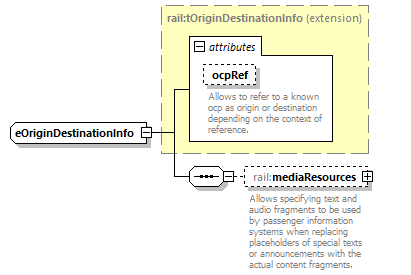 | ||||||||||||||
| namespace | https://www.railml.org/schemas/2021 | ||||||||||||||
| type | extension of rail:tOriginDestinationInfo | ||||||||||||||
| properties |
| ||||||||||||||
| children | rail:mediaResources | ||||||||||||||
| used by |
| ||||||||||||||
| attributes |
| ||||||||||||||
| source | <xs:complexType name="eOriginDestinationInfo"> <xs:complexContent> <xs:extension base="rail:tOriginDestinationInfo"> <xs:sequence> <xs:element name="mediaResources" type="rail:tMediaResources" minOccurs="0"> <xs:annotation> <xs:documentation>Allows specifying text and audio fragments to be used by passenger information systems when replacing placeholders of special texts or announcements with the actual content fragments.</xs:documentation> <xs:documentation>See https://wiki2.railml.org/wiki/TT:mediaResources</xs:documentation> </xs:annotation> </xs:element> </xs:sequence> </xs:extension> </xs:complexContent> </xs:complexType> |
element eOriginDestinationInfo/mediaResources
| diagram |  | ||||||
| namespace | https://www.railml.org/schemas/2021 | ||||||
| type | rail:tMediaResources | ||||||
| properties |
| ||||||
| children | rail:textFragments rail:audioFragments | ||||||
| annotation |
| ||||||
| source | <xs:element name="mediaResources" type="rail:tMediaResources" minOccurs="0"> <xs:annotation> <xs:documentation>Allows specifying text and audio fragments to be used by passenger information systems when replacing placeholders of special texts or announcements with the actual content fragments.</xs:documentation> <xs:documentation>See https://wiki2.railml.org/wiki/TT:mediaResources</xs:documentation> </xs:annotation> </xs:element> |
complexType ePassengerFacilityTT
| diagram |  | ||
| namespace | https://www.railml.org/schemas/2021 | ||
| children | rail:places rail:service | ||
| used by |
| ||
| source | <xs:complexType name="ePassengerFacilityTT"> <xs:sequence> <xs:any namespace="##other" processContents="strict" minOccurs="0" maxOccurs="unbounded"> <xs:annotation> <xs:documentation>Provide an extension point for non-railML elements in foreign namespace.</xs:documentation> </xs:annotation> </xs:any> <xs:element name="places" type="rail:tPlacesTT" minOccurs="0" maxOccurs="unbounded"> <xs:annotation> <xs:documentation>contains the data related to particular passenger capacity with respect to the various categories of providing space for them</xs:documentation> <xs:documentation>See https://wiki2.railml.org/wiki/TT:places</xs:documentation> </xs:annotation> </xs:element> <xs:element name="service" type="rail:tService" minOccurs="0" maxOccurs="unbounded"> <xs:annotation> <xs:documentation>Description of any additional service provided per vehicle.</xs:documentation> <xs:documentation>See https://wiki2.railml.org/wiki/TT:service</xs:documentation> </xs:annotation> </xs:element> </xs:sequence> </xs:complexType> |
element ePassengerFacilityTT/places
| diagram |  | ||||||||||||||||||||||||||||||||||||||||||||||
| namespace | https://www.railml.org/schemas/2021 | ||||||||||||||||||||||||||||||||||||||||||||||
| type | rail:tPlacesTT | ||||||||||||||||||||||||||||||||||||||||||||||
| properties |
| ||||||||||||||||||||||||||||||||||||||||||||||
| attributes |
| ||||||||||||||||||||||||||||||||||||||||||||||
| annotation |
| ||||||||||||||||||||||||||||||||||||||||||||||
| source | <xs:element name="places" type="rail:tPlacesTT" minOccurs="0" maxOccurs="unbounded"> <xs:annotation> <xs:documentation>contains the data related to particular passenger capacity with respect to the various categories of providing space for them</xs:documentation> <xs:documentation>See https://wiki2.railml.org/wiki/TT:places</xs:documentation> </xs:annotation> </xs:element> |
element ePassengerFacilityTT/service
| diagram |  | ||||||||||||||||||||||||||||||||||||||||||||||||||||
| namespace | https://www.railml.org/schemas/2021 | ||||||||||||||||||||||||||||||||||||||||||||||||||||
| type | rail:tService | ||||||||||||||||||||||||||||||||||||||||||||||||||||
| properties |
| ||||||||||||||||||||||||||||||||||||||||||||||||||||
| attributes |
| ||||||||||||||||||||||||||||||||||||||||||||||||||||
| annotation |
| ||||||||||||||||||||||||||||||||||||||||||||||||||||
| source | <xs:element name="service" type="rail:tService" minOccurs="0" maxOccurs="unbounded"> <xs:annotation> <xs:documentation>Description of any additional service provided per vehicle.</xs:documentation> <xs:documentation>See https://wiki2.railml.org/wiki/TT:service</xs:documentation> </xs:annotation> </xs:element> |
complexType ePatternTrain
| diagram |  | ||||||||||||||||||||||||||||||||||||||||||||||||||||||||||||||
| namespace | https://www.railml.org/schemas/2021 | ||||||||||||||||||||||||||||||||||||||||||||||||||||||||||||||
| type | extension of rail:tPatternTrain | ||||||||||||||||||||||||||||||||||||||||||||||||||||||||||||||
| properties |
| ||||||||||||||||||||||||||||||||||||||||||||||||||||||||||||||
| children | rail:additionalName rail:trainPartSequence | ||||||||||||||||||||||||||||||||||||||||||||||||||||||||||||||
| used by |
| ||||||||||||||||||||||||||||||||||||||||||||||||||||||||||||||
| attributes |
| ||||||||||||||||||||||||||||||||||||||||||||||||||||||||||||||
| source | <xs:complexType name="ePatternTrain"> <xs:complexContent> <xs:extension base="rail:tPatternTrain"> <xs:sequence> <xs:element name="trainPartSequence" type="rail:ePatternTrainPartSequence" maxOccurs="unbounded"> <xs:annotation> <xs:documentation>Groups all patternTrainPart references belonging to a pattern train.</xs:documentation> <xs:documentation>See https://wiki2.railml.org/wiki/TT:trainPartSequence</xs:documentation> </xs:annotation> </xs:element> </xs:sequence> </xs:extension> </xs:complexContent> </xs:complexType> |
element ePatternTrain/trainPartSequence
| diagram |  | ||||||||||||||||||||||
| namespace | https://www.railml.org/schemas/2021 | ||||||||||||||||||||||
| type | rail:ePatternTrainPartSequence | ||||||||||||||||||||||
| properties |
| ||||||||||||||||||||||
| children | rail:patternTrainPartRef rail:topologyReference | ||||||||||||||||||||||
| attributes |
| ||||||||||||||||||||||
| annotation |
| ||||||||||||||||||||||
| source | <xs:element name="trainPartSequence" type="rail:ePatternTrainPartSequence" maxOccurs="unbounded"> <xs:annotation> <xs:documentation>Groups all patternTrainPart references belonging to a pattern train.</xs:documentation> <xs:documentation>See https://wiki2.railml.org/wiki/TT:trainPartSequence</xs:documentation> </xs:annotation> </xs:element> |
complexType ePatternTrainArrivalDepartureTimes
| diagram |  | ||||||||||||||||||||||||||||||||||||||||||||||||||||||
| namespace | https://www.railml.org/schemas/2021 | ||||||||||||||||||||||||||||||||||||||||||||||||||||||
| type | extension of rail:tPatternTrainArrivalDepartureTimes | ||||||||||||||||||||||||||||||||||||||||||||||||||||||
| properties |
| ||||||||||||||||||||||||||||||||||||||||||||||||||||||
| used by |
| ||||||||||||||||||||||||||||||||||||||||||||||||||||||
| attributes |
| ||||||||||||||||||||||||||||||||||||||||||||||||||||||
| source | <xs:complexType name="ePatternTrainArrivalDepartureTimes"> <xs:complexContent> <xs:extension base="rail:tPatternTrainArrivalDepartureTimes"/> </xs:complexContent> </xs:complexType> |
complexType ePatternTrainOcp
| diagram |  | ||||||||||||||||||||||||||||||||||||||||||||||||||||||||||||||||||||||
| namespace | https://www.railml.org/schemas/2021 | ||||||||||||||||||||||||||||||||||||||||||||||||||||||||||||||||||||||
| type | extension of rail:tBaseOcpTT | ||||||||||||||||||||||||||||||||||||||||||||||||||||||||||||||||||||||
| properties |
| ||||||||||||||||||||||||||||||||||||||||||||||||||||||||||||||||||||||
| children | rail:times rail:sectionTT rail:alternativeSectionsTT rail:stopDescription | ||||||||||||||||||||||||||||||||||||||||||||||||||||||||||||||||||||||
| used by |
| ||||||||||||||||||||||||||||||||||||||||||||||||||||||||||||||||||||||
| attributes |
| ||||||||||||||||||||||||||||||||||||||||||||||||||||||||||||||||||||||
| source | <xs:complexType name="ePatternTrainOcp"> <xs:complexContent> <xs:extension base="rail:tBaseOcpTT"> <xs:sequence> <xs:element name="times" type="rail:ePatternTrainArrivalDepartureTimes" minOccurs="0" maxOccurs="unbounded"> <xs:annotation> <xs:documentation>Describes arrival and departure times of a pattern train with their scope.</xs:documentation> <xs:documentation>See https://wiki2.railml.org/wiki/TT:times</xs:documentation> </xs:annotation> </xs:element> <xs:element name="sectionTT" type="rail:eSectionTT" minOccurs="0"> <xs:annotation> <xs:documentation>Describes data concerning the way from one ocpTT to the next one in the order of the sequence.</xs:documentation> <xs:documentation>See https://wiki2.railml.org/wiki/TT:sectionTT</xs:documentation> </xs:annotation> </xs:element> <xs:element name="alternativeSectionsTT" type="rail:eAlternativeSectionsTT" minOccurs="0"> <xs:annotation> <xs:documentation>Describes alternative pathes from one ocpTT to its successor in order of the sequence.</xs:documentation> <xs:documentation>See https://wiki2.railml.org/wiki/TT:alternativeSectionsTT</xs:documentation> </xs:annotation> </xs:element> <xs:element name="stopDescription" type="rail:ePatternTrainStopDescription" minOccurs="0"> <xs:annotation> <xs:documentation>Describes data concerning the stop (or pass) at the parent pattern train ocpTT.</xs:documentation> <xs:documentation>See https://wiki2.railml.org/wiki/TT:stopDescription</xs:documentation> </xs:annotation> </xs:element> <xs:any namespace="##other" processContents="strict" minOccurs="0" maxOccurs="unbounded"/> </xs:sequence> </xs:extension> </xs:complexContent> </xs:complexType> |
element ePatternTrainOcp/times
| diagram |  | ||||||||||||||||||||||||||||||||||||||||||||||||||||||
| namespace | https://www.railml.org/schemas/2021 | ||||||||||||||||||||||||||||||||||||||||||||||||||||||
| type | rail:ePatternTrainArrivalDepartureTimes | ||||||||||||||||||||||||||||||||||||||||||||||||||||||
| properties |
| ||||||||||||||||||||||||||||||||||||||||||||||||||||||
| attributes |
| ||||||||||||||||||||||||||||||||||||||||||||||||||||||
| annotation |
| ||||||||||||||||||||||||||||||||||||||||||||||||||||||
| source | <xs:element name="times" type="rail:ePatternTrainArrivalDepartureTimes" minOccurs="0" maxOccurs="unbounded"> <xs:annotation> <xs:documentation>Describes arrival and departure times of a pattern train with their scope.</xs:documentation> <xs:documentation>See https://wiki2.railml.org/wiki/TT:times</xs:documentation> </xs:annotation> </xs:element> |
element ePatternTrainOcp/sectionTT
| diagram | 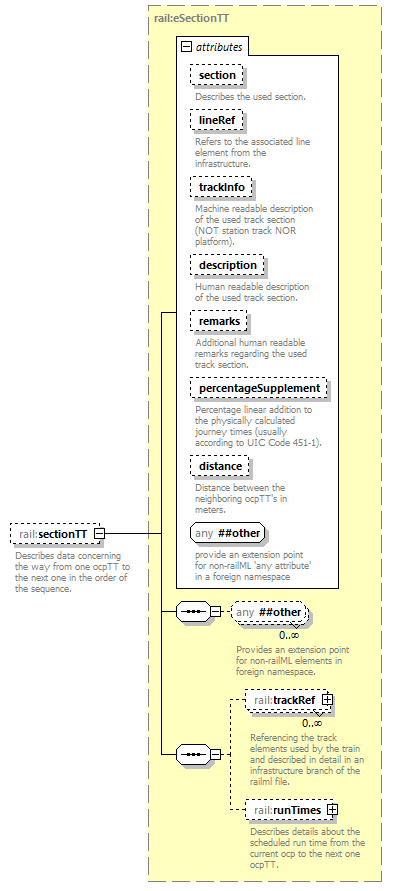 | ||||||||||||||||||||||||||||||||||||||||||||||||||||||||||||||
| namespace | https://www.railml.org/schemas/2021 | ||||||||||||||||||||||||||||||||||||||||||||||||||||||||||||||
| type | rail:eSectionTT | ||||||||||||||||||||||||||||||||||||||||||||||||||||||||||||||
| properties |
| ||||||||||||||||||||||||||||||||||||||||||||||||||||||||||||||
| children | rail:trackRef rail:runTimes | ||||||||||||||||||||||||||||||||||||||||||||||||||||||||||||||
| attributes |
| ||||||||||||||||||||||||||||||||||||||||||||||||||||||||||||||
| annotation |
| ||||||||||||||||||||||||||||||||||||||||||||||||||||||||||||||
| source | <xs:element name="sectionTT" type="rail:eSectionTT" minOccurs="0"> <xs:annotation> <xs:documentation>Describes data concerning the way from one ocpTT to the next one in the order of the sequence.</xs:documentation> <xs:documentation>See https://wiki2.railml.org/wiki/TT:sectionTT</xs:documentation> </xs:annotation> </xs:element> |
element ePatternTrainOcp/alternativeSectionsTT
| diagram |  | ||||||
| namespace | https://www.railml.org/schemas/2021 | ||||||
| type | rail:eAlternativeSectionsTT | ||||||
| properties |
| ||||||
| children | rail:alternativeSectionTT | ||||||
| annotation |
| ||||||
| source | <xs:element name="alternativeSectionsTT" type="rail:eAlternativeSectionsTT" minOccurs="0"> <xs:annotation> <xs:documentation>Describes alternative pathes from one ocpTT to its successor in order of the sequence.</xs:documentation> <xs:documentation>See https://wiki2.railml.org/wiki/TT:alternativeSectionsTT</xs:documentation> </xs:annotation> </xs:element> |
element ePatternTrainOcp/stopDescription
| diagram | 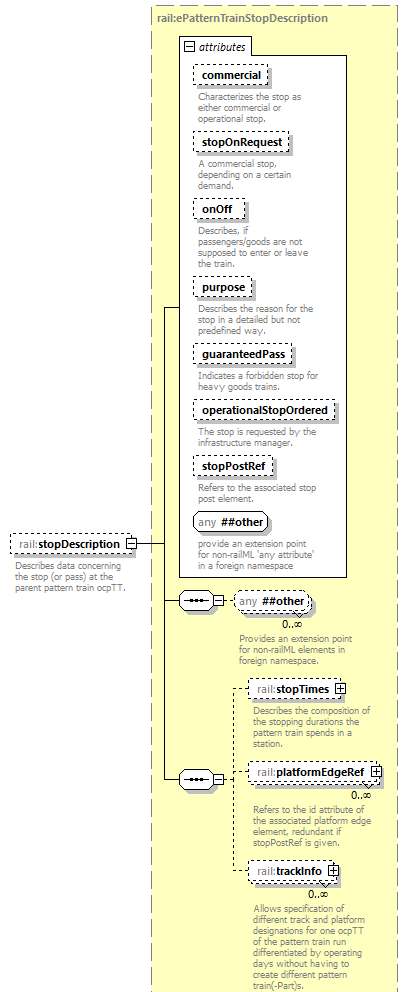 | ||||||||||||||||||||||||||||||||||||||||||||||||||||||||||||||
| namespace | https://www.railml.org/schemas/2021 | ||||||||||||||||||||||||||||||||||||||||||||||||||||||||||||||
| type | rail:ePatternTrainStopDescription | ||||||||||||||||||||||||||||||||||||||||||||||||||||||||||||||
| properties |
| ||||||||||||||||||||||||||||||||||||||||||||||||||||||||||||||
| children | rail:stopTimes rail:platformEdgeRef rail:trackInfo | ||||||||||||||||||||||||||||||||||||||||||||||||||||||||||||||
| attributes |
| ||||||||||||||||||||||||||||||||||||||||||||||||||||||||||||||
| annotation |
| ||||||||||||||||||||||||||||||||||||||||||||||||||||||||||||||
| source | <xs:element name="stopDescription" type="rail:ePatternTrainStopDescription" minOccurs="0"> <xs:annotation> <xs:documentation>Describes data concerning the stop (or pass) at the parent pattern train ocpTT.</xs:documentation> <xs:documentation>See https://wiki2.railml.org/wiki/TT:stopDescription</xs:documentation> </xs:annotation> </xs:element> |
complexType ePatternTrainOcps
| diagram |  | ||
| namespace | https://www.railml.org/schemas/2021 | ||
| children | rail:ocpTT | ||
| used by |
| ||
| source | <xs:complexType name="ePatternTrainOcps"> <xs:sequence> <xs:element name="ocpTT" type="rail:ePatternTrainOcp" maxOccurs="unbounded"> <xs:annotation> <xs:documentation>Describes a single point along the pattern train path.</xs:documentation> <xs:documentation>See https://wiki2.railml.org/wiki/TT:ocpTT_ocpsTT_patternTrainPart</xs:documentation> </xs:annotation> </xs:element> </xs:sequence> </xs:complexType> |
element ePatternTrainOcps/ocpTT
| diagram |  | ||||||||||||||||||||||||||||||||||||||||||||||||||||||||||||||||||||||
| namespace | https://www.railml.org/schemas/2021 | ||||||||||||||||||||||||||||||||||||||||||||||||||||||||||||||||||||||
| type | rail:ePatternTrainOcp | ||||||||||||||||||||||||||||||||||||||||||||||||||||||||||||||||||||||
| properties |
| ||||||||||||||||||||||||||||||||||||||||||||||||||||||||||||||||||||||
| children | rail:times rail:sectionTT rail:alternativeSectionsTT rail:stopDescription | ||||||||||||||||||||||||||||||||||||||||||||||||||||||||||||||||||||||
| attributes |
| ||||||||||||||||||||||||||||||||||||||||||||||||||||||||||||||||||||||
| annotation |
| ||||||||||||||||||||||||||||||||||||||||||||||||||||||||||||||||||||||
| source | <xs:element name="ocpTT" type="rail:ePatternTrainOcp" maxOccurs="unbounded"> <xs:annotation> <xs:documentation>Describes a single point along the pattern train path.</xs:documentation> <xs:documentation>See https://wiki2.railml.org/wiki/TT:ocpTT_ocpsTT_patternTrainPart</xs:documentation> </xs:annotation> </xs:element> |
complexType ePatternTrainPart
| diagram |  | ||||||||||||||||||||||||||||||||||||||||||||||||||||||||||||||||||||||||||||||||||||||||||||||
| namespace | https://www.railml.org/schemas/2021 | ||||||||||||||||||||||||||||||||||||||||||||||||||||||||||||||||||||||||||||||||||||||||||||||
| type | extension of rail:tBaseTrainPart | ||||||||||||||||||||||||||||||||||||||||||||||||||||||||||||||||||||||||||||||||||||||||||||||
| properties |
| ||||||||||||||||||||||||||||||||||||||||||||||||||||||||||||||||||||||||||||||||||||||||||||||
| children | rail:additionalName rail:formationTT rail:ocpsTT rail:organizationalUnitBinding rail:origin rail:destination | ||||||||||||||||||||||||||||||||||||||||||||||||||||||||||||||||||||||||||||||||||||||||||||||
| used by |
| ||||||||||||||||||||||||||||||||||||||||||||||||||||||||||||||||||||||||||||||||||||||||||||||
| attributes |
| ||||||||||||||||||||||||||||||||||||||||||||||||||||||||||||||||||||||||||||||||||||||||||||||
| source | <xs:complexType name="ePatternTrainPart"> <xs:complexContent> <xs:extension base="rail:tBaseTrainPart"> <xs:sequence> <xs:element name="formationTT" type="rail:tBaseFormationTT" minOccurs="0"> <xs:annotation> <xs:documentation>Describes how a formation is used for a patternTrainPart.</xs:documentation> <xs:documentation>See https://wiki2.railml.org/wiki/TT:formationTT</xs:documentation> </xs:annotation> </xs:element> <xs:element name="ocpsTT" type="rail:ePatternTrainOcps"> <xs:annotation> <xs:documentation>Groups ocpTT elements applying for the respective patternTrainPart of a train template.</xs:documentation> <xs:documentation>See https://wiki2.railml.org/wiki/TT:ocpsTT</xs:documentation> </xs:annotation> </xs:element> <xs:element name="organizationalUnitBinding" type="rail:eOrganizationalUnitBinding" minOccurs="0"> <xs:annotation> <xs:documentation>Describes what organizational units are responsible for this patternTrainPart.</xs:documentation> <xs:documentation>See https://wiki2.railml.org/wiki/TT:organizationalUnitBinding</xs:documentation> </xs:annotation> </xs:element> <xs:element name="origin" type="rail:tOriginDestinationInfo" minOccurs="0"> <xs:annotation> <xs:documentation>Allows for specifying information about the origin of the pattern train if it cannot be derived from its path (trains entering the operated area).</xs:documentation> <xs:documentation>See https://wiki2.railml.org/wiki/TT:origin</xs:documentation> </xs:annotation> </xs:element> <xs:element name="destination" type="rail:tOriginDestinationInfo" minOccurs="0"> <xs:annotation> <xs:documentation>Allows for specifying information about the destination of the pattern train if it cannot be derived from its path (trains leaving the operated area).</xs:documentation> <xs:documentation>See https://wiki2.railml.org/wiki/TT:destination</xs:documentation> </xs:annotation> </xs:element> </xs:sequence> </xs:extension> </xs:complexContent> </xs:complexType> |
element ePatternTrainPart/formationTT
| diagram |  | ||||||||||||||
| namespace | https://www.railml.org/schemas/2021 | ||||||||||||||
| type | rail:tBaseFormationTT | ||||||||||||||
| properties |
| ||||||||||||||
| attributes |
| ||||||||||||||
| annotation |
| ||||||||||||||
| source | <xs:element name="formationTT" type="rail:tBaseFormationTT" minOccurs="0"> <xs:annotation> <xs:documentation>Describes how a formation is used for a patternTrainPart.</xs:documentation> <xs:documentation>See https://wiki2.railml.org/wiki/TT:formationTT</xs:documentation> </xs:annotation> </xs:element> |
element ePatternTrainPart/ocpsTT
| diagram |  | ||||
| namespace | https://www.railml.org/schemas/2021 | ||||
| type | rail:ePatternTrainOcps | ||||
| properties |
| ||||
| children | rail:ocpTT | ||||
| annotation |
| ||||
| source | <xs:element name="ocpsTT" type="rail:ePatternTrainOcps"> <xs:annotation> <xs:documentation>Groups ocpTT elements applying for the respective patternTrainPart of a train template.</xs:documentation> <xs:documentation>See https://wiki2.railml.org/wiki/TT:ocpsTT</xs:documentation> </xs:annotation> </xs:element> |
element ePatternTrainPart/organizationalUnitBinding
| diagram |  | ||||||
| namespace | https://www.railml.org/schemas/2021 | ||||||
| type | rail:eOrganizationalUnitBinding | ||||||
| properties |
| ||||||
| children | rail:vehicleOperator rail:customer rail:railwayUndertaking rail:operationalUndertaking rail:concessionaire rail:contractor | ||||||
| annotation |
| ||||||
| source | <xs:element name="organizationalUnitBinding" type="rail:eOrganizationalUnitBinding" minOccurs="0"> <xs:annotation> <xs:documentation>Describes what organizational units are responsible for this patternTrainPart.</xs:documentation> <xs:documentation>See https://wiki2.railml.org/wiki/TT:organizationalUnitBinding</xs:documentation> </xs:annotation> </xs:element> |
element ePatternTrainPart/origin
| diagram |  | ||||||||||||||
| namespace | https://www.railml.org/schemas/2021 | ||||||||||||||
| type | rail:tOriginDestinationInfo | ||||||||||||||
| properties |
| ||||||||||||||
| attributes |
| ||||||||||||||
| annotation |
| ||||||||||||||
| source | <xs:element name="origin" type="rail:tOriginDestinationInfo" minOccurs="0"> <xs:annotation> <xs:documentation>Allows for specifying information about the origin of the pattern train if it cannot be derived from its path (trains entering the operated area).</xs:documentation> <xs:documentation>See https://wiki2.railml.org/wiki/TT:origin</xs:documentation> </xs:annotation> </xs:element> |
element ePatternTrainPart/destination
| diagram |  | ||||||||||||||
| namespace | https://www.railml.org/schemas/2021 | ||||||||||||||
| type | rail:tOriginDestinationInfo | ||||||||||||||
| properties |
| ||||||||||||||
| attributes |
| ||||||||||||||
| annotation |
| ||||||||||||||
| source | <xs:element name="destination" type="rail:tOriginDestinationInfo" minOccurs="0"> <xs:annotation> <xs:documentation>Allows for specifying information about the destination of the pattern train if it cannot be derived from its path (trains leaving the operated area).</xs:documentation> <xs:documentation>See https://wiki2.railml.org/wiki/TT:destination</xs:documentation> </xs:annotation> </xs:element> |
complexType ePatternTrainParts
| diagram |  | ||
| namespace | https://www.railml.org/schemas/2021 | ||
| children | rail:patternTrainPart | ||
| used by |
| ||
| source | <xs:complexType name="ePatternTrainParts"> <xs:sequence> <xs:element name="patternTrainPart" type="rail:ePatternTrainPart" maxOccurs="unbounded"> <xs:annotation> <xs:documentation>This version of trainPart is used in the creation of train templates for other trains.</xs:documentation> <xs:documentation>A trainPart describes the most basic part of a train. Hence there is no changement of the formation or operating period allowed during a train parts route.</xs:documentation> <xs:documentation>See https://wiki2.railml.org/wiki/TT:patternTrainPart</xs:documentation> </xs:annotation> </xs:element> </xs:sequence> </xs:complexType> |
element ePatternTrainParts/patternTrainPart
| diagram |  | ||||||||||||||||||||||||||||||||||||||||||||||||||||||||||||||||||||||||||||||||||||||||||||||
| namespace | https://www.railml.org/schemas/2021 | ||||||||||||||||||||||||||||||||||||||||||||||||||||||||||||||||||||||||||||||||||||||||||||||
| type | rail:ePatternTrainPart | ||||||||||||||||||||||||||||||||||||||||||||||||||||||||||||||||||||||||||||||||||||||||||||||
| properties |
| ||||||||||||||||||||||||||||||||||||||||||||||||||||||||||||||||||||||||||||||||||||||||||||||
| children | rail:additionalName rail:formationTT rail:ocpsTT rail:organizationalUnitBinding rail:origin rail:destination | ||||||||||||||||||||||||||||||||||||||||||||||||||||||||||||||||||||||||||||||||||||||||||||||
| attributes |
| ||||||||||||||||||||||||||||||||||||||||||||||||||||||||||||||||||||||||||||||||||||||||||||||
| annotation |
| ||||||||||||||||||||||||||||||||||||||||||||||||||||||||||||||||||||||||||||||||||||||||||||||
| source | <xs:element name="patternTrainPart" type="rail:ePatternTrainPart" maxOccurs="unbounded"> <xs:annotation> <xs:documentation>This version of trainPart is used in the creation of train templates for other trains.</xs:documentation> <xs:documentation>A trainPart describes the most basic part of a train. Hence there is no changement of the formation or operating period allowed during a train parts route.</xs:documentation> <xs:documentation>See https://wiki2.railml.org/wiki/TT:patternTrainPart</xs:documentation> </xs:annotation> </xs:element> |
complexType ePatternTrainPartSequence
| diagram | 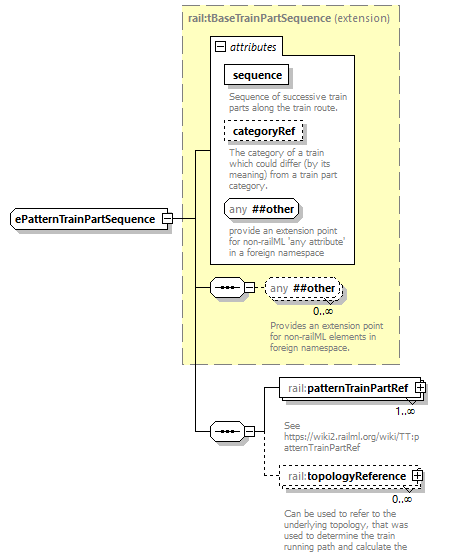 | ||||||||||||||||||||||
| namespace | https://www.railml.org/schemas/2021 | ||||||||||||||||||||||
| type | extension of rail:tBaseTrainPartSequence | ||||||||||||||||||||||
| properties |
| ||||||||||||||||||||||
| children | rail:patternTrainPartRef rail:topologyReference | ||||||||||||||||||||||
| used by |
| ||||||||||||||||||||||
| attributes |
| ||||||||||||||||||||||
| source | <xs:complexType name="ePatternTrainPartSequence"> <xs:complexContent> <xs:extension base="rail:tBaseTrainPartSequence"> <xs:sequence> <xs:element name="patternTrainPartRef" type="rail:tTrainPartRef" maxOccurs="unbounded"> <xs:annotation> <xs:documentation>See https://wiki2.railml.org/wiki/TT:patternTrainPartRef</xs:documentation> </xs:annotation> </xs:element> <xs:element name="topologyReference" type="rail:tTopologyReference" minOccurs="0" maxOccurs="unbounded"> <xs:annotation> <xs:documentation>Can be used to refer to the underlying topology, that was used to determine the train running path and calculate the runtimes.</xs:documentation> <xs:documentation>See https://wiki2.railml.org/wiki/TT:topologyReference</xs:documentation> </xs:annotation> </xs:element> </xs:sequence> </xs:extension> </xs:complexContent> </xs:complexType> |
element ePatternTrainPartSequence/patternTrainPartRef
| diagram |  | ||||||||||||||||||||||||
| namespace | https://www.railml.org/schemas/2021 | ||||||||||||||||||||||||
| type | rail:tTrainPartRef | ||||||||||||||||||||||||
| properties |
| ||||||||||||||||||||||||
| attributes |
| ||||||||||||||||||||||||
| annotation |
| ||||||||||||||||||||||||
| source | <xs:element name="patternTrainPartRef" type="rail:tTrainPartRef" maxOccurs="unbounded"> <xs:annotation> <xs:documentation>See https://wiki2.railml.org/wiki/TT:patternTrainPartRef</xs:documentation> </xs:annotation> </xs:element> |
element ePatternTrainPartSequence/topologyReference
| diagram | 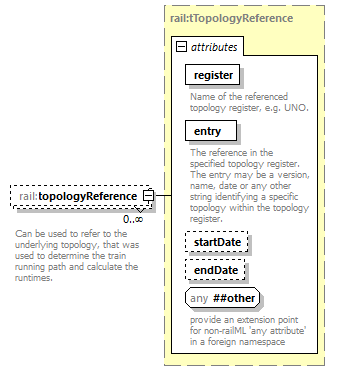 | ||||||||||||||||||||||||||||||||||
| namespace | https://www.railml.org/schemas/2021 | ||||||||||||||||||||||||||||||||||
| type | rail:tTopologyReference | ||||||||||||||||||||||||||||||||||
| properties |
| ||||||||||||||||||||||||||||||||||
| attributes |
| ||||||||||||||||||||||||||||||||||
| annotation |
| ||||||||||||||||||||||||||||||||||
| source | <xs:element name="topologyReference" type="rail:tTopologyReference" minOccurs="0" maxOccurs="unbounded"> <xs:annotation> <xs:documentation>Can be used to refer to the underlying topology, that was used to determine the train running path and calculate the runtimes.</xs:documentation> <xs:documentation>See https://wiki2.railml.org/wiki/TT:topologyReference</xs:documentation> </xs:annotation> </xs:element> |
complexType ePatternTrains
| diagram |  | ||
| namespace | https://www.railml.org/schemas/2021 | ||
| children | rail:patternTrain | ||
| used by |
| ||
| source | <xs:complexType name="ePatternTrains"> <xs:sequence> <xs:element name="patternTrain" type="rail:ePatternTrain" maxOccurs="unbounded"> <xs:annotation> <xs:documentation>A pattern train is a template for other trains. It is not itself a train that is supposed to run. A pattern train describes a group of trains that belong to the same service and describes properties of that service as part of a service concept. Such a service is defined as a group of trains that run under a common name with the same stopping pattern and which usually have the same travel time between the common start and end stations.</xs:documentation> <xs:documentation>See https://wiki2.railml.org/wiki/TT:patternTrain</xs:documentation> </xs:annotation> </xs:element> </xs:sequence> </xs:complexType> |
element ePatternTrains/patternTrain
| diagram |  | ||||||||||||||||||||||||||||||||||||||||||||||||||||||||||||||
| namespace | https://www.railml.org/schemas/2021 | ||||||||||||||||||||||||||||||||||||||||||||||||||||||||||||||
| type | rail:ePatternTrain | ||||||||||||||||||||||||||||||||||||||||||||||||||||||||||||||
| properties |
| ||||||||||||||||||||||||||||||||||||||||||||||||||||||||||||||
| children | rail:additionalName rail:trainPartSequence | ||||||||||||||||||||||||||||||||||||||||||||||||||||||||||||||
| attributes |
| ||||||||||||||||||||||||||||||||||||||||||||||||||||||||||||||
| annotation |
| ||||||||||||||||||||||||||||||||||||||||||||||||||||||||||||||
| source | <xs:element name="patternTrain" type="rail:ePatternTrain" maxOccurs="unbounded"> <xs:annotation> <xs:documentation>A pattern train is a template for other trains. It is not itself a train that is supposed to run. A pattern train describes a group of trains that belong to the same service and describes properties of that service as part of a service concept. Such a service is defined as a group of trains that run under a common name with the same stopping pattern and which usually have the same travel time between the common start and end stations.</xs:documentation> <xs:documentation>See https://wiki2.railml.org/wiki/TT:patternTrain</xs:documentation> </xs:annotation> </xs:element> |
complexType ePatternTrainStopDescription
| diagram |  | ||||||||||||||||||||||||||||||||||||||||||||||||||||||||||||||
| namespace | https://www.railml.org/schemas/2021 | ||||||||||||||||||||||||||||||||||||||||||||||||||||||||||||||
| type | extension of rail:tBaseStopDescription | ||||||||||||||||||||||||||||||||||||||||||||||||||||||||||||||
| properties |
| ||||||||||||||||||||||||||||||||||||||||||||||||||||||||||||||
| children | rail:stopTimes rail:platformEdgeRef rail:trackInfo | ||||||||||||||||||||||||||||||||||||||||||||||||||||||||||||||
| used by |
| ||||||||||||||||||||||||||||||||||||||||||||||||||||||||||||||
| attributes |
| ||||||||||||||||||||||||||||||||||||||||||||||||||||||||||||||
| source | <xs:complexType name="ePatternTrainStopDescription"> <xs:complexContent> <xs:extension base="rail:tBaseStopDescription"> <xs:sequence> <xs:element name="stopTimes" type="rail:tStopTimes" minOccurs="0"> <xs:annotation> <xs:documentation>Describes the composition of the stopping durations the pattern train spends in a station.</xs:documentation> <xs:documentation>See https://wiki2.railml.org/wiki/TT:stopTimes</xs:documentation> </xs:annotation> </xs:element> <xs:element name="platformEdgeRef" type="rail:tPlatformEdgeRef" minOccurs="0" maxOccurs="unbounded"> <xs:annotation> <xs:documentation>Refers to the id attribute of the associated platform edge element, redundant if stopPostRef is given.</xs:documentation> <xs:documentation>See https://wiki2.railml.org/wiki/TT:platformEdgeRef</xs:documentation> </xs:annotation> </xs:element> <xs:element name="trackInfo" type="rail:tBaseTrackInfo" minOccurs="0" maxOccurs="unbounded"> <xs:annotation> <xs:documentation>Allows specification of different track and platform designations for one ocpTT of the pattern train run differentiated by operating days without having to create different pattern train(-Part)s.</xs:documentation> <xs:documentation>See https://wiki2.railml.org/wiki/TT:trackInfo_stopDescription</xs:documentation> </xs:annotation> </xs:element> </xs:sequence> </xs:extension> </xs:complexContent> </xs:complexType> |
element ePatternTrainStopDescription/stopTimes
| diagram |  | ||||||||||||||||||||||||||||||||||||||||||||||
| namespace | https://www.railml.org/schemas/2021 | ||||||||||||||||||||||||||||||||||||||||||||||
| type | rail:tStopTimes | ||||||||||||||||||||||||||||||||||||||||||||||
| properties |
| ||||||||||||||||||||||||||||||||||||||||||||||
| attributes |
| ||||||||||||||||||||||||||||||||||||||||||||||
| annotation |
| ||||||||||||||||||||||||||||||||||||||||||||||
| source | <xs:element name="stopTimes" type="rail:tStopTimes" minOccurs="0"> <xs:annotation> <xs:documentation>Describes the composition of the stopping durations the pattern train spends in a station.</xs:documentation> <xs:documentation>See https://wiki2.railml.org/wiki/TT:stopTimes</xs:documentation> </xs:annotation> </xs:element> |
element ePatternTrainStopDescription/platformEdgeRef
| diagram |  | ||||||||||||||
| namespace | https://www.railml.org/schemas/2021 | ||||||||||||||
| type | rail:tPlatformEdgeRef | ||||||||||||||
| properties |
| ||||||||||||||
| attributes |
| ||||||||||||||
| annotation |
| ||||||||||||||
| source | <xs:element name="platformEdgeRef" type="rail:tPlatformEdgeRef" minOccurs="0" maxOccurs="unbounded"> <xs:annotation> <xs:documentation>Refers to the id attribute of the associated platform edge element, redundant if stopPostRef is given.</xs:documentation> <xs:documentation>See https://wiki2.railml.org/wiki/TT:platformEdgeRef</xs:documentation> </xs:annotation> </xs:element> |
element ePatternTrainStopDescription/trackInfo
| diagram | 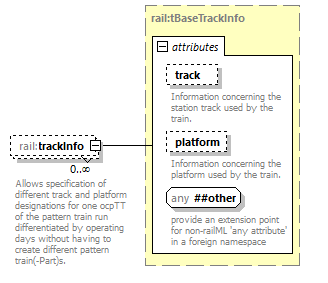 | ||||||||||||||||||||||
| namespace | https://www.railml.org/schemas/2021 | ||||||||||||||||||||||
| type | rail:tBaseTrackInfo | ||||||||||||||||||||||
| properties |
| ||||||||||||||||||||||
| attributes |
| ||||||||||||||||||||||
| annotation |
| ||||||||||||||||||||||
| source | <xs:element name="trackInfo" type="rail:tBaseTrackInfo" minOccurs="0" maxOccurs="unbounded"> <xs:annotation> <xs:documentation>Allows specification of different track and platform designations for one ocpTT of the pattern train run differentiated by operating days without having to create different pattern train(-Part)s.</xs:documentation> <xs:documentation>See https://wiki2.railml.org/wiki/TT:trackInfo_stopDescription</xs:documentation> </xs:annotation> </xs:element> |
complexType eReplacedTrains
| diagram | 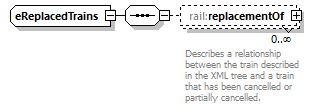 | ||
| namespace | https://www.railml.org/schemas/2021 | ||
| children | rail:replacementOf | ||
| used by |
| ||
| source | <xs:complexType name="eReplacedTrains"> <xs:sequence> <xs:element name="replacementOf" type="rail:eReplacementOf" minOccurs="0" maxOccurs="unbounded"> <xs:annotation> <xs:documentation>Describes a relationship between the train described in the XML tree and a train that has been cancelled or partially cancelled.</xs:documentation> <xs:documentation>See https://wiki2.railml.org/wiki/TT:replacementOf</xs:documentation> </xs:annotation> </xs:element> </xs:sequence> </xs:complexType> |
element eReplacedTrains/replacementOf
| diagram |  | ||||||
| namespace | https://www.railml.org/schemas/2021 | ||||||
| type | rail:eReplacementOf | ||||||
| properties |
| ||||||
| children | rail:operatingPeriodRef rail:tafTapTsiTrainID rail:uniqueTrainKey | ||||||
| annotation |
| ||||||
| source | <xs:element name="replacementOf" type="rail:eReplacementOf" minOccurs="0" maxOccurs="unbounded"> <xs:annotation> <xs:documentation>Describes a relationship between the train described in the XML tree and a train that has been cancelled or partially cancelled.</xs:documentation> <xs:documentation>See https://wiki2.railml.org/wiki/TT:replacementOf</xs:documentation> </xs:annotation> </xs:element> |
complexType eReplacementOf
| diagram |  | ||
| namespace | https://www.railml.org/schemas/2021 | ||
| children | rail:operatingPeriodRef rail:tafTapTsiTrainID rail:uniqueTrainKey | ||
| used by |
| ||
| source | <xs:complexType name="eReplacementOf"> <xs:sequence> <xs:element name="operatingPeriodRef" type="rail:tOperatingPeriodRef"> <xs:annotation> <xs:documentation>Specifies the operating days of a replacement service.</xs:documentation> <xs:documentation>See https://wiki2.railml.org/wiki/TT:operatingPeriodRef_replacementOf</xs:documentation> </xs:annotation> </xs:element> <xs:choice> <xs:element name="tafTapTsiTrainID" type="rail:eTapTsiTransportOperationalIdentifier"> <xs:annotation> <xs:documentation>Specifies a replaced train or train parts. Alternatively, uniqueTrainKey can be used.</xs:documentation> <xs:documentation>See https://wiki2.railml.org/wiki/TT:tafTapTsiTrainID_replacementOf</xs:documentation> </xs:annotation> </xs:element> <xs:element name="uniqueTrainKey" type="rail:tUniqueTrainKey"> <xs:annotation> <xs:documentation>Specifies a replaced train or train parts. Alternatively, tafTapTsiTrainID can be used.</xs:documentation> <xs:documentation>See https://wiki2.railml.org/wiki/TT:uniqueTrainKey</xs:documentation> </xs:annotation> </xs:element> </xs:choice> </xs:sequence> </xs:complexType> |
element eReplacementOf/operatingPeriodRef
| diagram |  | ||||||||||||||||||||||||||
| namespace | https://www.railml.org/schemas/2021 | ||||||||||||||||||||||||||
| type | rail:tOperatingPeriodRef | ||||||||||||||||||||||||||
| properties |
| ||||||||||||||||||||||||||
| attributes |
| ||||||||||||||||||||||||||
| annotation |
| ||||||||||||||||||||||||||
| source | <xs:element name="operatingPeriodRef" type="rail:tOperatingPeriodRef"> <xs:annotation> <xs:documentation>Specifies the operating days of a replacement service.</xs:documentation> <xs:documentation>See https://wiki2.railml.org/wiki/TT:operatingPeriodRef_replacementOf</xs:documentation> </xs:annotation> </xs:element> |
element eReplacementOf/tafTapTsiTrainID
| diagram |  | ||||||||||||||||||||||||||||||||||||||||||||||||||||||
| namespace | https://www.railml.org/schemas/2021 | ||||||||||||||||||||||||||||||||||||||||||||||||||||||
| type | rail:eTapTsiTransportOperationalIdentifier | ||||||||||||||||||||||||||||||||||||||||||||||||||||||
| properties |
| ||||||||||||||||||||||||||||||||||||||||||||||||||||||
| attributes |
| ||||||||||||||||||||||||||||||||||||||||||||||||||||||
| annotation |
| ||||||||||||||||||||||||||||||||||||||||||||||||||||||
| source | <xs:element name="tafTapTsiTrainID" type="rail:eTapTsiTransportOperationalIdentifier"> <xs:annotation> <xs:documentation>Specifies a replaced train or train parts. Alternatively, uniqueTrainKey can be used.</xs:documentation> <xs:documentation>See https://wiki2.railml.org/wiki/TT:tafTapTsiTrainID_replacementOf</xs:documentation> </xs:annotation> </xs:element> |
element eReplacementOf/uniqueTrainKey
| diagram |  | ||||||||||||||||||||||||||||||
| namespace | https://www.railml.org/schemas/2021 | ||||||||||||||||||||||||||||||
| type | rail:tUniqueTrainKey | ||||||||||||||||||||||||||||||
| properties |
| ||||||||||||||||||||||||||||||
| attributes |
| ||||||||||||||||||||||||||||||
| annotation |
| ||||||||||||||||||||||||||||||
| source | <xs:element name="uniqueTrainKey" type="rail:tUniqueTrainKey"> <xs:annotation> <xs:documentation>Specifies a replaced train or train parts. Alternatively, tafTapTsiTrainID can be used.</xs:documentation> <xs:documentation>See https://wiki2.railml.org/wiki/TT:uniqueTrainKey</xs:documentation> </xs:annotation> </xs:element> |
complexType eReservationInfo
| diagram |  | ||
| namespace | https://www.railml.org/schemas/2021 | ||
| children | rail:booking | ||
| used by |
| ||
| source | <xs:complexType name="eReservationInfo"> <xs:sequence> <xs:element name="booking" type="rail:tBooking" maxOccurs="unbounded"> <xs:annotation> <xs:documentation>Provides a container for detailed booking information related to a specific vehicle.</xs:documentation> <xs:documentation>See https://wiki2.railml.org/wiki/TT:booking</xs:documentation> </xs:annotation> </xs:element> </xs:sequence> </xs:complexType> |
element eReservationInfo/booking
| diagram | 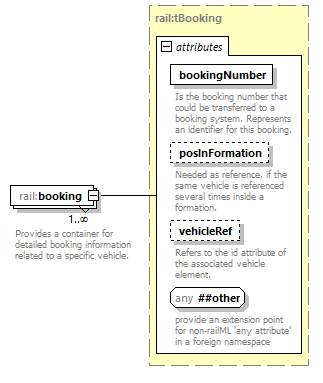 | ||||||||||||||||||||||||||||||
| namespace | https://www.railml.org/schemas/2021 | ||||||||||||||||||||||||||||||
| type | rail:tBooking | ||||||||||||||||||||||||||||||
| properties |
| ||||||||||||||||||||||||||||||
| attributes |
| ||||||||||||||||||||||||||||||
| annotation |
| ||||||||||||||||||||||||||||||
| source | <xs:element name="booking" type="rail:tBooking" maxOccurs="unbounded"> <xs:annotation> <xs:documentation>Provides a container for detailed booking information related to a specific vehicle.</xs:documentation> <xs:documentation>See https://wiki2.railml.org/wiki/TT:booking</xs:documentation> </xs:annotation> </xs:element> |
complexType eRostering
| diagram |  | ||||||||||||||||||||||||||||||||||||||||||||||||||||||||||||||||||||||||||||||||||||||||||||||
| namespace | https://www.railml.org/schemas/2021 | ||||||||||||||||||||||||||||||||||||||||||||||||||||||||||||||||||||||||||||||||||||||||||||||
| type | extension of rail:tRostering | ||||||||||||||||||||||||||||||||||||||||||||||||||||||||||||||||||||||||||||||||||||||||||||||
| properties |
| ||||||||||||||||||||||||||||||||||||||||||||||||||||||||||||||||||||||||||||||||||||||||||||||
| children | rail:additionalName rail:blockParts rail:blocks rail:circulations | ||||||||||||||||||||||||||||||||||||||||||||||||||||||||||||||||||||||||||||||||||||||||||||||
| used by |
| ||||||||||||||||||||||||||||||||||||||||||||||||||||||||||||||||||||||||||||||||||||||||||||||
| attributes |
| ||||||||||||||||||||||||||||||||||||||||||||||||||||||||||||||||||||||||||||||||||||||||||||||
| source | <xs:complexType name="eRostering"> <xs:complexContent> <xs:extension base="rail:tRostering"> <xs:sequence> <xs:element name="blockParts" type="rail:eBlockParts"> <xs:annotation> <xs:documentation>Groups blockPart elements.</xs:documentation> <xs:documentation>See https://wiki2.railml.org/wiki/TT:blockParts</xs:documentation> </xs:annotation> </xs:element> <xs:element name="blocks" type="rail:eBlocks" minOccurs="0"> <xs:annotation> <xs:documentation>Groups block elements.</xs:documentation> <xs:documentation>See https://wiki2.railml.org/wiki/TT:blocks</xs:documentation> </xs:annotation> </xs:element> <xs:element name="circulations" type="rail:eCirculations" minOccurs="0"> <xs:annotation> <xs:documentation>Groups circulation elements.</xs:documentation> <xs:documentation>See https://wiki2.railml.org/wiki/TT:circulations</xs:documentation> </xs:annotation> </xs:element> </xs:sequence> </xs:extension> </xs:complexContent> </xs:complexType> |
element eRostering/blockParts
| diagram |  | ||||
| namespace | https://www.railml.org/schemas/2021 | ||||
| type | rail:eBlockParts | ||||
| properties |
| ||||
| children | rail:blockPart | ||||
| annotation |
| ||||
| source | <xs:element name="blockParts" type="rail:eBlockParts"> <xs:annotation> <xs:documentation>Groups blockPart elements.</xs:documentation> <xs:documentation>See https://wiki2.railml.org/wiki/TT:blockParts</xs:documentation> </xs:annotation> </xs:element> |
element eRostering/blocks
| diagram |  | ||||||
| namespace | https://www.railml.org/schemas/2021 | ||||||
| type | rail:eBlocks | ||||||
| properties |
| ||||||
| children | rail:block | ||||||
| annotation |
| ||||||
| source | <xs:element name="blocks" type="rail:eBlocks" minOccurs="0"> <xs:annotation> <xs:documentation>Groups block elements.</xs:documentation> <xs:documentation>See https://wiki2.railml.org/wiki/TT:blocks</xs:documentation> </xs:annotation> </xs:element> |
element eRostering/circulations
| diagram |  | ||||||
| namespace | https://www.railml.org/schemas/2021 | ||||||
| type | rail:eCirculations | ||||||
| properties |
| ||||||
| children | rail:circulation | ||||||
| annotation |
| ||||||
| source | <xs:element name="circulations" type="rail:eCirculations" minOccurs="0"> <xs:annotation> <xs:documentation>Groups circulation elements.</xs:documentation> <xs:documentation>See https://wiki2.railml.org/wiki/TT:circulations</xs:documentation> </xs:annotation> </xs:element> |
complexType eRosterings
| diagram |  | ||
| namespace | https://www.railml.org/schemas/2021 | ||
| children | rail:rostering | ||
| used by |
| ||
| source | <xs:complexType name="eRosterings"> <xs:sequence> <xs:element name="rostering" type="rail:eRostering" maxOccurs="unbounded"> <xs:annotation> <xs:documentation>Contains all data, which are related to a rostering of a vehicle or a formation of vehicles.</xs:documentation> <xs:documentation>See https://wiki2.railml.org/wiki/TT:rostering</xs:documentation> </xs:annotation> </xs:element> </xs:sequence> </xs:complexType> |
element eRosterings/rostering
| diagram |  | ||||||||||||||||||||||||||||||||||||||||||||||||||||||||||||||||||||||||||||||||||||||||||||||
| namespace | https://www.railml.org/schemas/2021 | ||||||||||||||||||||||||||||||||||||||||||||||||||||||||||||||||||||||||||||||||||||||||||||||
| type | rail:eRostering | ||||||||||||||||||||||||||||||||||||||||||||||||||||||||||||||||||||||||||||||||||||||||||||||
| properties |
| ||||||||||||||||||||||||||||||||||||||||||||||||||||||||||||||||||||||||||||||||||||||||||||||
| children | rail:additionalName rail:blockParts rail:blocks rail:circulations | ||||||||||||||||||||||||||||||||||||||||||||||||||||||||||||||||||||||||||||||||||||||||||||||
| attributes |
| ||||||||||||||||||||||||||||||||||||||||||||||||||||||||||||||||||||||||||||||||||||||||||||||
| annotation |
| ||||||||||||||||||||||||||||||||||||||||||||||||||||||||||||||||||||||||||||||||||||||||||||||
| source | <xs:element name="rostering" type="rail:eRostering" maxOccurs="unbounded"> <xs:annotation> <xs:documentation>Contains all data, which are related to a rostering of a vehicle or a formation of vehicles.</xs:documentation> <xs:documentation>See https://wiki2.railml.org/wiki/TT:rostering</xs:documentation> </xs:annotation> </xs:element> |
complexType eSectionTT
| diagram |  | ||||||||||||||||||||||||||||||||||||||||||||||||||||||||||||||
| namespace | https://www.railml.org/schemas/2021 | ||||||||||||||||||||||||||||||||||||||||||||||||||||||||||||||
| type | extension of rail:tSectionTT | ||||||||||||||||||||||||||||||||||||||||||||||||||||||||||||||
| properties |
| ||||||||||||||||||||||||||||||||||||||||||||||||||||||||||||||
| children | rail:trackRef rail:runTimes | ||||||||||||||||||||||||||||||||||||||||||||||||||||||||||||||
| used by |
| ||||||||||||||||||||||||||||||||||||||||||||||||||||||||||||||
| attributes |
| ||||||||||||||||||||||||||||||||||||||||||||||||||||||||||||||
| source | <xs:complexType name="eSectionTT"> <xs:complexContent> <xs:extension base="rail:tSectionTT"> <xs:sequence> <xs:element name="trackRef" type="rail:tTrackRef" minOccurs="0" maxOccurs="unbounded"> <xs:annotation> <xs:documentation>Referencing the track elements used by the train and described in detail in an infrastructure branch of the railml file.</xs:documentation> <xs:documentation>See https://wiki2.railml.org/wiki/TT:trackRef</xs:documentation> </xs:annotation> </xs:element> <xs:element name="runTimes" type="rail:tRunTimes" minOccurs="0"> <xs:annotation> <xs:documentation>Describes details about the scheduled run time from the current ocp to the next one ocpTT.</xs:documentation> <xs:documentation>See https://wiki2.railml.org/wiki/TT:runTimes</xs:documentation> </xs:annotation> </xs:element> </xs:sequence> </xs:extension> </xs:complexContent> </xs:complexType> |
element eSectionTT/trackRef
| diagram |  | ||||||||||||||||||||||
| namespace | https://www.railml.org/schemas/2021 | ||||||||||||||||||||||
| type | rail:tTrackRef | ||||||||||||||||||||||
| properties |
| ||||||||||||||||||||||
| attributes |
| ||||||||||||||||||||||
| annotation |
| ||||||||||||||||||||||
| source | <xs:element name="trackRef" type="rail:tTrackRef" minOccurs="0" maxOccurs="unbounded"> <xs:annotation> <xs:documentation>Referencing the track elements used by the train and described in detail in an infrastructure branch of the railml file.</xs:documentation> <xs:documentation>See https://wiki2.railml.org/wiki/TT:trackRef</xs:documentation> </xs:annotation> </xs:element> |
element eSectionTT/runTimes
| diagram | 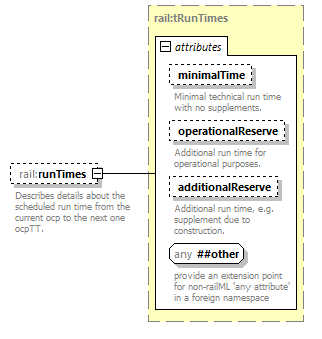 | ||||||||||||||||||||||||||||||
| namespace | https://www.railml.org/schemas/2021 | ||||||||||||||||||||||||||||||
| type | rail:tRunTimes | ||||||||||||||||||||||||||||||
| properties |
| ||||||||||||||||||||||||||||||
| attributes |
| ||||||||||||||||||||||||||||||
| annotation |
| ||||||||||||||||||||||||||||||
| source | <xs:element name="runTimes" type="rail:tRunTimes" minOccurs="0"> <xs:annotation> <xs:documentation>Describes details about the scheduled run time from the current ocp to the next one ocpTT.</xs:documentation> <xs:documentation>See https://wiki2.railml.org/wiki/TT:runTimes</xs:documentation> </xs:annotation> </xs:element> |
complexType eSlot
| diagram |  | ||||||||||||||||||||||||||||||||||||||
| namespace | https://www.railml.org/schemas/2021 | ||||||||||||||||||||||||||||||||||||||
| type | extension of rail:tSlot | ||||||||||||||||||||||||||||||||||||||
| properties |
| ||||||||||||||||||||||||||||||||||||||
| children | rail:operatingDay | ||||||||||||||||||||||||||||||||||||||
| used by |
| ||||||||||||||||||||||||||||||||||||||
| attributes |
| ||||||||||||||||||||||||||||||||||||||
| annotation |
| ||||||||||||||||||||||||||||||||||||||
| source | <xs:complexType name="eSlot"> <xs:annotation> <xs:documentation>A time slot with a number of trains, as part of a distribution.</xs:documentation> </xs:annotation> <xs:complexContent> <xs:extension base="rail:tSlot"> <xs:sequence> <xs:element name="operatingDay" type="rail:eOperatingDay" minOccurs="0" maxOccurs="unbounded"> <xs:annotation> <xs:documentation>The Element <operatingDay> gives a week based abstract description of an operating period for a normal day. Variations at certain types of days (e.g. public holidays) are dealt with in operatingDayDeviance.</xs:documentation> <xs:documentation>See https://wiki2.railml.org/wiki/TT:operatingDay</xs:documentation> </xs:annotation> </xs:element> </xs:sequence> </xs:extension> </xs:complexContent> </xs:complexType> |
element eSlot/operatingDay
| diagram |  | ||||||||||||||||||||||||||||||||
| namespace | https://www.railml.org/schemas/2021 | ||||||||||||||||||||||||||||||||
| type | rail:eOperatingDay | ||||||||||||||||||||||||||||||||
| properties |
| ||||||||||||||||||||||||||||||||
| children | rail:operatingDayDeviance | ||||||||||||||||||||||||||||||||
| attributes |
| ||||||||||||||||||||||||||||||||
| annotation |
| ||||||||||||||||||||||||||||||||
| source | <xs:element name="operatingDay" type="rail:eOperatingDay" minOccurs="0" maxOccurs="unbounded"> <xs:annotation> <xs:documentation>The Element <operatingDay> gives a week based abstract description of an operating period for a normal day. Variations at certain types of days (e.g. public holidays) are dealt with in operatingDayDeviance.</xs:documentation> <xs:documentation>See https://wiki2.railml.org/wiki/TT:operatingDay</xs:documentation> </xs:annotation> </xs:element> |
complexType eSlotGroup
| diagram |  | ||
| namespace | https://www.railml.org/schemas/2021 | ||
| children | rail:slot | ||
| used by |
| ||
| annotation |
| ||
| source | <xs:complexType name="eSlotGroup"> <xs:annotation> <xs:documentation>A group of one or more time slots in a distribution that belong to a common interval pattern.</xs:documentation> </xs:annotation> <xs:sequence> <xs:element name="slot" type="rail:eSlot" maxOccurs="unbounded"> <xs:annotation> <xs:documentation>A time slot belonging to this slot group.</xs:documentation> <xs:documentation>See https://wiki2.railml.org/wiki/TT:slot</xs:documentation> </xs:annotation> </xs:element> </xs:sequence> </xs:complexType> |
element eSlotGroup/slot
| diagram |  | ||||||||||||||||||||||||||||||||||||||
| namespace | https://www.railml.org/schemas/2021 | ||||||||||||||||||||||||||||||||||||||
| type | rail:eSlot | ||||||||||||||||||||||||||||||||||||||
| properties |
| ||||||||||||||||||||||||||||||||||||||
| children | rail:operatingDay | ||||||||||||||||||||||||||||||||||||||
| attributes |
| ||||||||||||||||||||||||||||||||||||||
| annotation |
| ||||||||||||||||||||||||||||||||||||||
| source | <xs:element name="slot" type="rail:eSlot" maxOccurs="unbounded"> <xs:annotation> <xs:documentation>A time slot belonging to this slot group.</xs:documentation> <xs:documentation>See https://wiki2.railml.org/wiki/TT:slot</xs:documentation> </xs:annotation> </xs:element> |
complexType eStatistic
| diagram |  | ||||||
| namespace | https://www.railml.org/schemas/2021 | ||||||
| type | extension of rail:tStatistic | ||||||
| properties |
| ||||||
| children | rail:mean rail:median rail:standardDeviation rail:statisticAnalyses | ||||||
| used by |
| ||||||
| attributes |
| ||||||
| source | <xs:complexType name="eStatistic"> <xs:complexContent> <xs:extension base="rail:tStatistic"> <xs:sequence> <xs:element name="mean" type="rail:tStatisticTimes" minOccurs="0"> <xs:annotation> <xs:documentation>Provides 'mean' values for actually driven and therefore measured times.</xs:documentation> <xs:documentation>See https://wiki2.railml.org/wiki/TT:mean</xs:documentation> </xs:annotation> </xs:element> <xs:element name="median" type="rail:tStatisticTimes" minOccurs="0"> <xs:annotation> <xs:documentation>Provides 'median' values for actually driven and therefore measured times.</xs:documentation> <xs:documentation>See https://wiki2.railml.org/wiki/TT:median</xs:documentation> </xs:annotation> </xs:element> <xs:element name="standardDeviation" type="rail:tStandardDeviationTimes" minOccurs="0"> <xs:annotation> <xs:documentation>Provides 'standard deviation' values for actually driven and therefore measured times.</xs:documentation> <xs:documentation>See https://wiki2.railml.org/wiki/TT:standardDeviation</xs:documentation> </xs:annotation> </xs:element> <xs:element name="statisticAnalyses" type="rail:tStatisticAnalyses" minOccurs="0" maxOccurs="unbounded"> <xs:annotation> <xs:documentation>Provides a formalized output for the result of an analysed statistic figure.</xs:documentation> <xs:documentation>See https://wiki2.railml.org/wiki/TT:statisticAnalyses</xs:documentation> </xs:annotation> </xs:element> </xs:sequence> </xs:extension> </xs:complexContent> </xs:complexType> |
element eStatistic/mean
| diagram |  | ||||||||||||||||||||||||||||||||||||||||||||||||||||||||||||||||||||||
| namespace | https://www.railml.org/schemas/2021 | ||||||||||||||||||||||||||||||||||||||||||||||||||||||||||||||||||||||
| type | rail:tStatisticTimes | ||||||||||||||||||||||||||||||||||||||||||||||||||||||||||||||||||||||
| properties |
| ||||||||||||||||||||||||||||||||||||||||||||||||||||||||||||||||||||||
| attributes |
| ||||||||||||||||||||||||||||||||||||||||||||||||||||||||||||||||||||||
| annotation |
| ||||||||||||||||||||||||||||||||||||||||||||||||||||||||||||||||||||||
| source | <xs:element name="mean" type="rail:tStatisticTimes" minOccurs="0"> <xs:annotation> <xs:documentation>Provides 'mean' values for actually driven and therefore measured times.</xs:documentation> <xs:documentation>See https://wiki2.railml.org/wiki/TT:mean</xs:documentation> </xs:annotation> </xs:element> |
element eStatistic/median
| diagram | 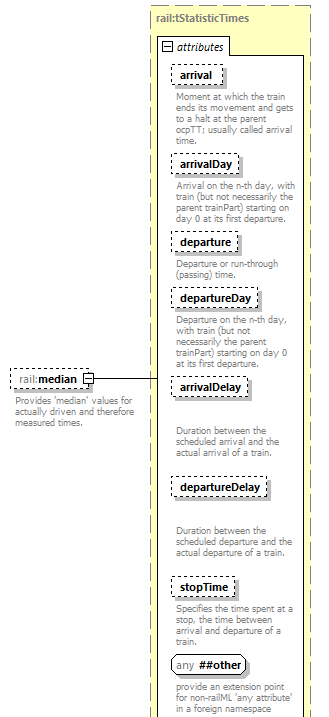 | ||||||||||||||||||||||||||||||||||||||||||||||||||||||||||||||||||||||
| namespace | https://www.railml.org/schemas/2021 | ||||||||||||||||||||||||||||||||||||||||||||||||||||||||||||||||||||||
| type | rail:tStatisticTimes | ||||||||||||||||||||||||||||||||||||||||||||||||||||||||||||||||||||||
| properties |
| ||||||||||||||||||||||||||||||||||||||||||||||||||||||||||||||||||||||
| attributes |
| ||||||||||||||||||||||||||||||||||||||||||||||||||||||||||||||||||||||
| annotation |
| ||||||||||||||||||||||||||||||||||||||||||||||||||||||||||||||||||||||
| source | <xs:element name="median" type="rail:tStatisticTimes" minOccurs="0"> <xs:annotation> <xs:documentation>Provides 'median' values for actually driven and therefore measured times.</xs:documentation> <xs:documentation>See https://wiki2.railml.org/wiki/TT:median</xs:documentation> </xs:annotation> </xs:element> |
element eStatistic/standardDeviation
| diagram | 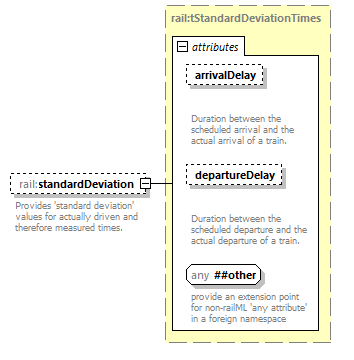 | ||||||||||||||||||||||
| namespace | https://www.railml.org/schemas/2021 | ||||||||||||||||||||||
| type | rail:tStandardDeviationTimes | ||||||||||||||||||||||
| properties |
| ||||||||||||||||||||||
| attributes |
| ||||||||||||||||||||||
| annotation |
| ||||||||||||||||||||||
| source | <xs:element name="standardDeviation" type="rail:tStandardDeviationTimes" minOccurs="0"> <xs:annotation> <xs:documentation>Provides 'standard deviation' values for actually driven and therefore measured times.</xs:documentation> <xs:documentation>See https://wiki2.railml.org/wiki/TT:standardDeviation</xs:documentation> </xs:annotation> </xs:element> |
element eStatistic/statisticAnalyses
| diagram |  | ||||||||||||||||||||||||||||||||||||||||||||||
| namespace | https://www.railml.org/schemas/2021 | ||||||||||||||||||||||||||||||||||||||||||||||
| type | rail:tStatisticAnalyses | ||||||||||||||||||||||||||||||||||||||||||||||
| properties |
| ||||||||||||||||||||||||||||||||||||||||||||||
| attributes |
| ||||||||||||||||||||||||||||||||||||||||||||||
| annotation |
| ||||||||||||||||||||||||||||||||||||||||||||||
| source | <xs:element name="statisticAnalyses" type="rail:tStatisticAnalyses" minOccurs="0" maxOccurs="unbounded"> <xs:annotation> <xs:documentation>Provides a formalized output for the result of an analysed statistic figure.</xs:documentation> <xs:documentation>See https://wiki2.railml.org/wiki/TT:statisticAnalyses</xs:documentation> </xs:annotation> </xs:element> |
complexType eStatistics
| diagram |  | ||
| namespace | https://www.railml.org/schemas/2021 | ||
| children | rail:statistic | ||
| used by |
| ||
| source | <xs:complexType name="eStatistics"> <xs:sequence> <xs:element name="statistic" type="rail:eStatistic" minOccurs="0" maxOccurs="unbounded"> <xs:annotation> <xs:documentation>Serves as "container element" for several statistical figures.</xs:documentation> <xs:documentation>See https://wiki2.railml.org/wiki/TT:statistic</xs:documentation> </xs:annotation> </xs:element> </xs:sequence> </xs:complexType> |
element eStatistics/statistic
| diagram |  | ||||||
| namespace | https://www.railml.org/schemas/2021 | ||||||
| type | rail:eStatistic | ||||||
| properties |
| ||||||
| children | rail:mean rail:median rail:standardDeviation rail:statisticAnalyses | ||||||
| attributes |
| ||||||
| annotation |
| ||||||
| source | <xs:element name="statistic" type="rail:eStatistic" minOccurs="0" maxOccurs="unbounded"> <xs:annotation> <xs:documentation>Serves as "container element" for several statistical figures.</xs:documentation> <xs:documentation>See https://wiki2.railml.org/wiki/TT:statistic</xs:documentation> </xs:annotation> </xs:element> |
complexType eStopActivities
| diagram |  | ||
| namespace | https://www.railml.org/schemas/2021 | ||
| children | rail:stopActivity | ||
| used by |
| ||
| source | <xs:complexType name="eStopActivities"> <xs:sequence> <xs:element name="stopActivity" type="rail:tStopActivity" maxOccurs="unbounded"> <xs:annotation> <xs:documentation>Describes the activity carried out at this stop.</xs:documentation> <xs:documentation>See https://wiki2.railml.org/wiki/TT:stopActivity</xs:documentation> </xs:annotation> </xs:element> </xs:sequence> </xs:complexType> |
element eStopActivities/stopActivity
| diagram |  | ||||||||||||||
| namespace | https://www.railml.org/schemas/2021 | ||||||||||||||
| type | rail:tStopActivity | ||||||||||||||
| properties |
| ||||||||||||||
| attributes |
| ||||||||||||||
| annotation |
| ||||||||||||||
| source | <xs:element name="stopActivity" type="rail:tStopActivity" maxOccurs="unbounded"> <xs:annotation> <xs:documentation>Describes the activity carried out at this stop.</xs:documentation> <xs:documentation>See https://wiki2.railml.org/wiki/TT:stopActivity</xs:documentation> </xs:annotation> </xs:element> |
complexType eStopDescription
| diagram |  | ||||||||||||||||||||||||||||||||||||||||||||||||||||||||||||||||||||||
| namespace | https://www.railml.org/schemas/2021 | ||||||||||||||||||||||||||||||||||||||||||||||||||||||||||||||||||||||
| type | extension of rail:tStopDescription | ||||||||||||||||||||||||||||||||||||||||||||||||||||||||||||||||||||||
| properties |
| ||||||||||||||||||||||||||||||||||||||||||||||||||||||||||||||||||||||
| children | rail:stopTimes rail:stopActivities rail:platformEdgeRef rail:serviceSectionRef rail:trackInfo rail:annotationRef rail:announcementRef | ||||||||||||||||||||||||||||||||||||||||||||||||||||||||||||||||||||||
| used by |
| ||||||||||||||||||||||||||||||||||||||||||||||||||||||||||||||||||||||
| attributes |
| ||||||||||||||||||||||||||||||||||||||||||||||||||||||||||||||||||||||
| source | <xs:complexType name="eStopDescription"> <xs:complexContent> <xs:extension base="rail:tStopDescription"> <xs:sequence> <xs:element name="stopTimes" type="rail:tStopTimes" minOccurs="0"> <xs:annotation> <xs:documentation>Describes the composition of the stopping durations a train spends in a station.</xs:documentation> <xs:documentation>See https://wiki2.railml.org/wiki/TT:stopTimes</xs:documentation> </xs:annotation> </xs:element> <xs:element name="stopActivities" type="rail:eStopActivities" minOccurs="0"> <xs:annotation> <xs:documentation>Groups stopActivity elements. Activities carried out at stop.</xs:documentation> <xs:documentation>See https://wiki2.railml.org/wiki/TT:stopActivities</xs:documentation> </xs:annotation> </xs:element> <xs:element name="platformEdgeRef" type="rail:tPlatformEdgeRef" minOccurs="0" maxOccurs="unbounded"> <xs:annotation> <xs:documentation>Refers to the id attribute of the associated platform edge element; May be redundant if stopPostRef is given.</xs:documentation> <xs:documentation>See https://wiki2.railml.org/wiki/TT:platformEdgeRef</xs:documentation> </xs:annotation> </xs:element> <xs:element name="serviceSectionRef" type="rail:tServiceSectionRef" minOccurs="0" maxOccurs="unbounded"> <xs:annotation> <xs:documentation>Is referencing the serviceSection element used by the train and described in detail in an infrastructure branch of the railml file.</xs:documentation> <xs:documentation>See https://wiki2.railml.org/wiki/TT:serviceSectionRef</xs:documentation> </xs:annotation> </xs:element> <xs:element name="trackInfo" type="rail:tStationTrackInfo" minOccurs="0" maxOccurs="unbounded"> <xs:annotation> <xs:documentation>Allows specification of different track and platform designations for one ocpTT of the train run differentiated by operating days without having to create different train(-Part)s.</xs:documentation> <xs:documentation>See https://wiki2.railml.org/wiki/TT:trackInfo_stopDescription</xs:documentation> </xs:annotation> </xs:element> <xs:element name="annotationRef" type="rail:tAnnotationRef" minOccurs="0" maxOccurs="unbounded"> <xs:annotation> <xs:documentation>Refers to the id attribute of an annotation element.</xs:documentation> <xs:documentation>See https://wiki2.railml.org/wiki/TT:annotationRef_stopDescription</xs:documentation> </xs:annotation> </xs:element> <xs:element name="announcementRef" type="rail:tAnnouncementRef" minOccurs="0" maxOccurs="unbounded"> <xs:annotation> <xs:documentation>Refers to the id attribute of an announcement element.</xs:documentation> <xs:documentation>See https://wiki2.railml.org/wiki/TT:announcementRef_stopDescription</xs:documentation> </xs:annotation> </xs:element> </xs:sequence> </xs:extension> </xs:complexContent> </xs:complexType> |
element eStopDescription/stopTimes
| diagram |  | ||||||||||||||||||||||||||||||||||||||||||||||
| namespace | https://www.railml.org/schemas/2021 | ||||||||||||||||||||||||||||||||||||||||||||||
| type | rail:tStopTimes | ||||||||||||||||||||||||||||||||||||||||||||||
| properties |
| ||||||||||||||||||||||||||||||||||||||||||||||
| attributes |
| ||||||||||||||||||||||||||||||||||||||||||||||
| annotation |
| ||||||||||||||||||||||||||||||||||||||||||||||
| source | <xs:element name="stopTimes" type="rail:tStopTimes" minOccurs="0"> <xs:annotation> <xs:documentation>Describes the composition of the stopping durations a train spends in a station.</xs:documentation> <xs:documentation>See https://wiki2.railml.org/wiki/TT:stopTimes</xs:documentation> </xs:annotation> </xs:element> |
element eStopDescription/stopActivities
| diagram |  | ||||||
| namespace | https://www.railml.org/schemas/2021 | ||||||
| type | rail:eStopActivities | ||||||
| properties |
| ||||||
| children | rail:stopActivity | ||||||
| annotation |
| ||||||
| source | <xs:element name="stopActivities" type="rail:eStopActivities" minOccurs="0"> <xs:annotation> <xs:documentation>Groups stopActivity elements. Activities carried out at stop.</xs:documentation> <xs:documentation>See https://wiki2.railml.org/wiki/TT:stopActivities</xs:documentation> </xs:annotation> </xs:element> |
element eStopDescription/platformEdgeRef
| diagram | 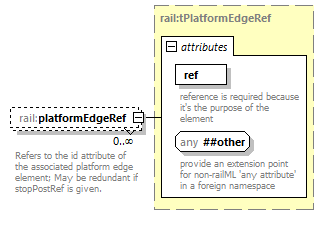 | ||||||||||||||
| namespace | https://www.railml.org/schemas/2021 | ||||||||||||||
| type | rail:tPlatformEdgeRef | ||||||||||||||
| properties |
| ||||||||||||||
| attributes |
| ||||||||||||||
| annotation |
| ||||||||||||||
| source | <xs:element name="platformEdgeRef" type="rail:tPlatformEdgeRef" minOccurs="0" maxOccurs="unbounded"> <xs:annotation> <xs:documentation>Refers to the id attribute of the associated platform edge element; May be redundant if stopPostRef is given.</xs:documentation> <xs:documentation>See https://wiki2.railml.org/wiki/TT:platformEdgeRef</xs:documentation> </xs:annotation> </xs:element> |
element eStopDescription/serviceSectionRef
| diagram | 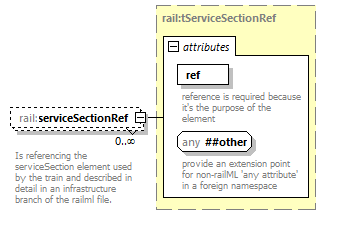 | ||||||||||||||
| namespace | https://www.railml.org/schemas/2021 | ||||||||||||||
| type | rail:tServiceSectionRef | ||||||||||||||
| properties |
| ||||||||||||||
| attributes |
| ||||||||||||||
| annotation |
| ||||||||||||||
| source | <xs:element name="serviceSectionRef" type="rail:tServiceSectionRef" minOccurs="0" maxOccurs="unbounded"> <xs:annotation> <xs:documentation>Is referencing the serviceSection element used by the train and described in detail in an infrastructure branch of the railml file.</xs:documentation> <xs:documentation>See https://wiki2.railml.org/wiki/TT:serviceSectionRef</xs:documentation> </xs:annotation> </xs:element> |
element eStopDescription/trackInfo
| diagram |  | ||||||||||||||||||||||||||||||
| namespace | https://www.railml.org/schemas/2021 | ||||||||||||||||||||||||||||||
| type | rail:tStationTrackInfo | ||||||||||||||||||||||||||||||
| properties |
| ||||||||||||||||||||||||||||||
| attributes |
| ||||||||||||||||||||||||||||||
| annotation |
| ||||||||||||||||||||||||||||||
| source | <xs:element name="trackInfo" type="rail:tStationTrackInfo" minOccurs="0" maxOccurs="unbounded"> <xs:annotation> <xs:documentation>Allows specification of different track and platform designations for one ocpTT of the train run differentiated by operating days without having to create different train(-Part)s.</xs:documentation> <xs:documentation>See https://wiki2.railml.org/wiki/TT:trackInfo_stopDescription</xs:documentation> </xs:annotation> </xs:element> |
element eStopDescription/annotationRef
| diagram | 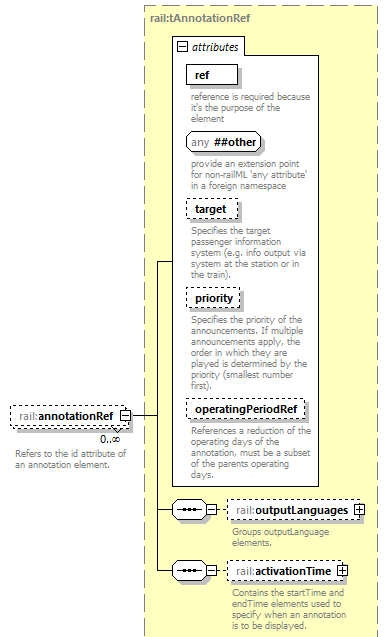 | ||||||||||||||||||||||||||||||||||||||
| namespace | https://www.railml.org/schemas/2021 | ||||||||||||||||||||||||||||||||||||||
| type | rail:tAnnotationRef | ||||||||||||||||||||||||||||||||||||||
| properties |
| ||||||||||||||||||||||||||||||||||||||
| children | rail:outputLanguages rail:activationTime | ||||||||||||||||||||||||||||||||||||||
| attributes |
| ||||||||||||||||||||||||||||||||||||||
| annotation |
| ||||||||||||||||||||||||||||||||||||||
| source | <xs:element name="annotationRef" type="rail:tAnnotationRef" minOccurs="0" maxOccurs="unbounded"> <xs:annotation> <xs:documentation>Refers to the id attribute of an annotation element.</xs:documentation> <xs:documentation>See https://wiki2.railml.org/wiki/TT:annotationRef_stopDescription</xs:documentation> </xs:annotation> </xs:element> |
element eStopDescription/announcementRef
| diagram |  | ||||||||||||||||||||||||||||||||||||||
| namespace | https://www.railml.org/schemas/2021 | ||||||||||||||||||||||||||||||||||||||
| type | rail:tAnnouncementRef | ||||||||||||||||||||||||||||||||||||||
| properties |
| ||||||||||||||||||||||||||||||||||||||
| children | rail:outputLanguages rail:trigger rail:periodic | ||||||||||||||||||||||||||||||||||||||
| attributes |
| ||||||||||||||||||||||||||||||||||||||
| annotation |
| ||||||||||||||||||||||||||||||||||||||
| source | <xs:element name="announcementRef" type="rail:tAnnouncementRef" minOccurs="0" maxOccurs="unbounded"> <xs:annotation> <xs:documentation>Refers to the id attribute of an announcement element.</xs:documentation> <xs:documentation>See https://wiki2.railml.org/wiki/TT:announcementRef_stopDescription</xs:documentation> </xs:annotation> </xs:element> |
complexType eTapTsiTransportOperationalIdentifier
| diagram |  | ||||||||||||||||||||||||||||||||||||||||||||||||||||||
| namespace | https://www.railml.org/schemas/2021 | ||||||||||||||||||||||||||||||||||||||||||||||||||||||
| type | extension of rail:tTapTsiCompositIdentifierOperationalType | ||||||||||||||||||||||||||||||||||||||||||||||||||||||
| properties |
| ||||||||||||||||||||||||||||||||||||||||||||||||||||||
| used by |
| ||||||||||||||||||||||||||||||||||||||||||||||||||||||
| attributes |
| ||||||||||||||||||||||||||||||||||||||||||||||||||||||
| source | <xs:complexType name="eTapTsiTransportOperationalIdentifier"> <xs:complexContent> <xs:extension base="rail:tTapTsiCompositIdentifierOperationalType"/> </xs:complexContent> </xs:complexType> |
complexType eTimetablePeriod
| diagram |  | ||||||||||||||||||||||||||||||||||||||||||||||||||||||||||||||||||||||
| namespace | https://www.railml.org/schemas/2021 | ||||||||||||||||||||||||||||||||||||||||||||||||||||||||||||||||||||||
| type | extension of rail:tTimetablePeriod | ||||||||||||||||||||||||||||||||||||||||||||||||||||||||||||||||||||||
| properties |
| ||||||||||||||||||||||||||||||||||||||||||||||||||||||||||||||||||||||
| children | rail:additionalName rail:holidays | ||||||||||||||||||||||||||||||||||||||||||||||||||||||||||||||||||||||
| used by |
| ||||||||||||||||||||||||||||||||||||||||||||||||||||||||||||||||||||||
| attributes |
| ||||||||||||||||||||||||||||||||||||||||||||||||||||||||||||||||||||||
| source | <xs:complexType name="eTimetablePeriod"> <xs:complexContent> <xs:extension base="rail:tTimetablePeriod"> <xs:sequence> <xs:element name="holidays" type="rail:eHolidays" minOccurs="0"> <xs:annotation> <xs:documentation>Groups holiday elements.</xs:documentation> <xs:documentation>See https://wiki2.railml.org/wiki/TT:holidays</xs:documentation> </xs:annotation> </xs:element> </xs:sequence> </xs:extension> </xs:complexContent> </xs:complexType> |
element eTimetablePeriod/holidays
| diagram |  | ||||||
| namespace | https://www.railml.org/schemas/2021 | ||||||
| type | rail:eHolidays | ||||||
| properties |
| ||||||
| children | rail:holiday | ||||||
| annotation |
| ||||||
| source | <xs:element name="holidays" type="rail:eHolidays" minOccurs="0"> <xs:annotation> <xs:documentation>Groups holiday elements.</xs:documentation> <xs:documentation>See https://wiki2.railml.org/wiki/TT:holidays</xs:documentation> </xs:annotation> </xs:element> |
complexType eTimetablePeriods
| diagram |  | ||
| namespace | https://www.railml.org/schemas/2021 | ||
| children | rail:timetablePeriod | ||
| used by |
| ||
| source | <xs:complexType name="eTimetablePeriods"> <xs:sequence> <xs:element name="timetablePeriod" type="rail:eTimetablePeriod" maxOccurs="unbounded"> <xs:annotation> <xs:documentation>Defines a timetable period, lasting typically about a year.</xs:documentation> <xs:documentation>See https://wiki2.railml.org/wiki/TT:timetablePeriod</xs:documentation> </xs:annotation> </xs:element> </xs:sequence> </xs:complexType> |
element eTimetablePeriods/timetablePeriod
| diagram | 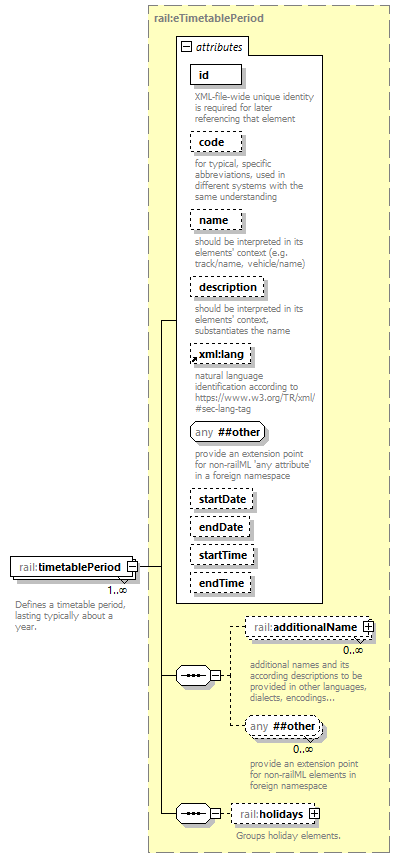 | ||||||||||||||||||||||||||||||||||||||||||||||||||||||||||||||||||||||
| namespace | https://www.railml.org/schemas/2021 | ||||||||||||||||||||||||||||||||||||||||||||||||||||||||||||||||||||||
| type | rail:eTimetablePeriod | ||||||||||||||||||||||||||||||||||||||||||||||||||||||||||||||||||||||
| properties |
| ||||||||||||||||||||||||||||||||||||||||||||||||||||||||||||||||||||||
| children | rail:additionalName rail:holidays | ||||||||||||||||||||||||||||||||||||||||||||||||||||||||||||||||||||||
| attributes |
| ||||||||||||||||||||||||||||||||||||||||||||||||||||||||||||||||||||||
| annotation |
| ||||||||||||||||||||||||||||||||||||||||||||||||||||||||||||||||||||||
| source | <xs:element name="timetablePeriod" type="rail:eTimetablePeriod" maxOccurs="unbounded"> <xs:annotation> <xs:documentation>Defines a timetable period, lasting typically about a year.</xs:documentation> <xs:documentation>See https://wiki2.railml.org/wiki/TT:timetablePeriod</xs:documentation> </xs:annotation> </xs:element> |
complexType eTrain
| diagram |  | ||||||||||||||||||||||||||||||||||||||||||||||||||||||||||||||||||||||||||||||||||||||||||||||||||||||||||||||
| namespace | https://www.railml.org/schemas/2021 | ||||||||||||||||||||||||||||||||||||||||||||||||||||||||||||||||||||||||||||||||||||||||||||||||||||||||||||||
| type | extension of rail:tTrain | ||||||||||||||||||||||||||||||||||||||||||||||||||||||||||||||||||||||||||||||||||||||||||||||||||||||||||||||
| properties |
| ||||||||||||||||||||||||||||||||||||||||||||||||||||||||||||||||||||||||||||||||||||||||||||||||||||||||||||||
| children | rail:additionalName rail:trainPartSequence rail:tafTapTsiTrainID rail:replacements | ||||||||||||||||||||||||||||||||||||||||||||||||||||||||||||||||||||||||||||||||||||||||||||||||||||||||||||||
| used by |
| ||||||||||||||||||||||||||||||||||||||||||||||||||||||||||||||||||||||||||||||||||||||||||||||||||||||||||||||
| attributes |
| ||||||||||||||||||||||||||||||||||||||||||||||||||||||||||||||||||||||||||||||||||||||||||||||||||||||||||||||
| source | <xs:complexType name="eTrain"> <xs:complexContent> <xs:extension base="rail:tTrain"> <xs:sequence> <xs:element name="trainPartSequence" type="rail:eTrainPartSequence" maxOccurs="unbounded"> <xs:annotation> <xs:documentation>Groups all trainPart references belonging to a train.</xs:documentation> <xs:documentation>See https://wiki2.railml.org/wiki/TT:trainPartSequence</xs:documentation> </xs:annotation> </xs:element> <xs:element name="tafTapTsiTrainID" type="rail:eTapTsiTransportOperationalIdentifier" minOccurs="0"> <xs:annotation> <xs:documentation>Optional information corresponding to the TAF/TAP TSI train ID.</xs:documentation> <xs:documentation>See https://wiki2.railml.org/wiki/TT:tafTapTsiTrainID</xs:documentation> </xs:annotation> </xs:element> <xs:element name="replacements" type="rail:eReplacedTrains" minOccurs="0"> <xs:annotation> <xs:documentation>A container element for instances of replacementOf. Contains the mapping of train replacements.</xs:documentation> <xs:documentation>See https://wiki2.railml.org/wiki/TT:replacements</xs:documentation> </xs:annotation> </xs:element> </xs:sequence> </xs:extension> </xs:complexContent> </xs:complexType> |
element eTrain/trainPartSequence
| diagram |  | ||||||||||||||||||||||||||||||||
| namespace | https://www.railml.org/schemas/2021 | ||||||||||||||||||||||||||||||||
| type | rail:eTrainPartSequence | ||||||||||||||||||||||||||||||||
| properties |
| ||||||||||||||||||||||||||||||||
| children | rail:trainPartRef rail:speedProfileRef rail:equipmentUsage rail:brakeUsage rail:topologyReference | ||||||||||||||||||||||||||||||||
| attributes |
| ||||||||||||||||||||||||||||||||
| annotation |
| ||||||||||||||||||||||||||||||||
| source | <xs:element name="trainPartSequence" type="rail:eTrainPartSequence" maxOccurs="unbounded"> <xs:annotation> <xs:documentation>Groups all trainPart references belonging to a train.</xs:documentation> <xs:documentation>See https://wiki2.railml.org/wiki/TT:trainPartSequence</xs:documentation> </xs:annotation> </xs:element> |
element eTrain/tafTapTsiTrainID
| diagram | 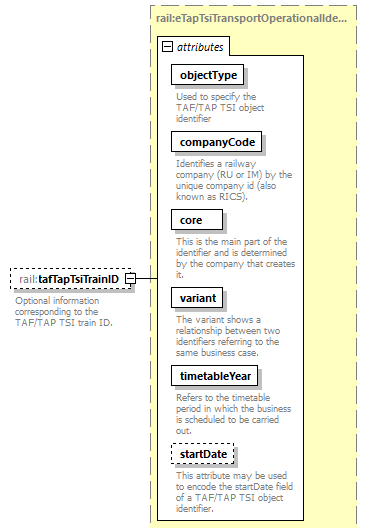 | ||||||||||||||||||||||||||||||||||||||||||||||||||||||
| namespace | https://www.railml.org/schemas/2021 | ||||||||||||||||||||||||||||||||||||||||||||||||||||||
| type | rail:eTapTsiTransportOperationalIdentifier | ||||||||||||||||||||||||||||||||||||||||||||||||||||||
| properties |
| ||||||||||||||||||||||||||||||||||||||||||||||||||||||
| attributes |
| ||||||||||||||||||||||||||||||||||||||||||||||||||||||
| annotation |
| ||||||||||||||||||||||||||||||||||||||||||||||||||||||
| source | <xs:element name="tafTapTsiTrainID" type="rail:eTapTsiTransportOperationalIdentifier" minOccurs="0"> <xs:annotation> <xs:documentation>Optional information corresponding to the TAF/TAP TSI train ID.</xs:documentation> <xs:documentation>See https://wiki2.railml.org/wiki/TT:tafTapTsiTrainID</xs:documentation> </xs:annotation> </xs:element> |
element eTrain/replacements
| diagram | 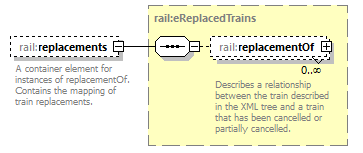 | ||||||
| namespace | https://www.railml.org/schemas/2021 | ||||||
| type | rail:eReplacedTrains | ||||||
| properties |
| ||||||
| children | rail:replacementOf | ||||||
| annotation |
| ||||||
| source | <xs:element name="replacements" type="rail:eReplacedTrains" minOccurs="0"> <xs:annotation> <xs:documentation>A container element for instances of replacementOf. Contains the mapping of train replacements.</xs:documentation> <xs:documentation>See https://wiki2.railml.org/wiki/TT:replacements</xs:documentation> </xs:annotation> </xs:element> |
complexType eTrainGroup
| diagram |  | ||||||||||||||||||||||||||||||||||||||||||||||||||||||||||||||||||||||||||||||||||||||||||||
| namespace | https://www.railml.org/schemas/2021 | ||||||||||||||||||||||||||||||||||||||||||||||||||||||||||||||||||||||||||||||||||||||||||||
| type | extension of rail:tTrainGroup | ||||||||||||||||||||||||||||||||||||||||||||||||||||||||||||||||||||||||||||||||||||||||||||
| properties |
| ||||||||||||||||||||||||||||||||||||||||||||||||||||||||||||||||||||||||||||||||||||||||||||
| children | rail:additionalName rail:trainRef | ||||||||||||||||||||||||||||||||||||||||||||||||||||||||||||||||||||||||||||||||||||||||||||
| used by |
| ||||||||||||||||||||||||||||||||||||||||||||||||||||||||||||||||||||||||||||||||||||||||||||
| attributes |
| ||||||||||||||||||||||||||||||||||||||||||||||||||||||||||||||||||||||||||||||||||||||||||||
| source | <xs:complexType name="eTrainGroup"> <xs:complexContent> <xs:extension base="rail:tTrainGroup"> <xs:sequence> <xs:element name="trainRef" type="rail:tElementRefInGroup" minOccurs="0" maxOccurs="unbounded"> <xs:annotation> <xs:documentation>Reference to the trains included in a trainGroup; the group members could be ordered by a sequence attribute.</xs:documentation> <xs:documentation>See https://wiki2.railml.org/wiki/TT:trainRef</xs:documentation> </xs:annotation> </xs:element> </xs:sequence> <xs:attribute name="parentRef" type="rail:tGenericRef"> <xs:annotation> <xs:documentation>Reference to a parent trainGroup, i.e. a group with sub-groups.</xs:documentation> </xs:annotation> </xs:attribute> </xs:extension> </xs:complexContent> </xs:complexType> |
attribute eTrainGroup/@parentRef
| type | rail:tGenericRef | ||
| annotation |
| ||
| source | <xs:attribute name="parentRef" type="rail:tGenericRef"> <xs:annotation> <xs:documentation>Reference to a parent trainGroup, i.e. a group with sub-groups.</xs:documentation> </xs:annotation> </xs:attribute> |
element eTrainGroup/trainRef
| diagram | 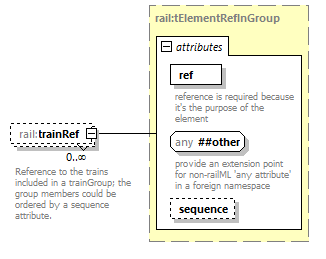 | ||||||||||||||||||||
| namespace | https://www.railml.org/schemas/2021 | ||||||||||||||||||||
| type | rail:tElementRefInGroup | ||||||||||||||||||||
| properties |
| ||||||||||||||||||||
| attributes |
| ||||||||||||||||||||
| annotation |
| ||||||||||||||||||||
| source | <xs:element name="trainRef" type="rail:tElementRefInGroup" minOccurs="0" maxOccurs="unbounded"> <xs:annotation> <xs:documentation>Reference to the trains included in a trainGroup; the group members could be ordered by a sequence attribute.</xs:documentation> <xs:documentation>See https://wiki2.railml.org/wiki/TT:trainRef</xs:documentation> </xs:annotation> </xs:element> |
complexType eTrainGroups
| diagram |  | ||
| namespace | https://www.railml.org/schemas/2021 | ||
| children | rail:trainGroup | ||
| used by |
| ||
| source | <xs:complexType name="eTrainGroups"> <xs:sequence> <xs:element name="trainGroup" type="rail:eTrainGroup" maxOccurs="unbounded"> <xs:annotation> <xs:documentation>Links different individual trains to a group.</xs:documentation> <xs:documentation>See https://wiki2.railml.org/wiki/TT:trainGroup</xs:documentation> </xs:annotation> </xs:element> </xs:sequence> </xs:complexType> |
element eTrainGroups/trainGroup
| diagram |  | ||||||||||||||||||||||||||||||||||||||||||||||||||||||||||||||||||||||||||||||||||||||||||||
| namespace | https://www.railml.org/schemas/2021 | ||||||||||||||||||||||||||||||||||||||||||||||||||||||||||||||||||||||||||||||||||||||||||||
| type | rail:eTrainGroup | ||||||||||||||||||||||||||||||||||||||||||||||||||||||||||||||||||||||||||||||||||||||||||||
| properties |
| ||||||||||||||||||||||||||||||||||||||||||||||||||||||||||||||||||||||||||||||||||||||||||||
| children | rail:additionalName rail:trainRef | ||||||||||||||||||||||||||||||||||||||||||||||||||||||||||||||||||||||||||||||||||||||||||||
| attributes |
| ||||||||||||||||||||||||||||||||||||||||||||||||||||||||||||||||||||||||||||||||||||||||||||
| annotation |
| ||||||||||||||||||||||||||||||||||||||||||||||||||||||||||||||||||||||||||||||||||||||||||||
| source | <xs:element name="trainGroup" type="rail:eTrainGroup" maxOccurs="unbounded"> <xs:annotation> <xs:documentation>Links different individual trains to a group.</xs:documentation> <xs:documentation>See https://wiki2.railml.org/wiki/TT:trainGroup</xs:documentation> </xs:annotation> </xs:element> |
complexType eTrainPart
| diagram |  | ||||||||||||||||||||||||||||||||||||||||||||||||||||||||||||||||||||||||||||||||||||||||||||||||||||||||||||||||||||||||||||||||||||||||||||||||||||||||||||||||||
| namespace | https://www.railml.org/schemas/2021 | ||||||||||||||||||||||||||||||||||||||||||||||||||||||||||||||||||||||||||||||||||||||||||||||||||||||||||||||||||||||||||||||||||||||||||||||||||||||||||||||||||
| type | extension of rail:tTrainPart | ||||||||||||||||||||||||||||||||||||||||||||||||||||||||||||||||||||||||||||||||||||||||||||||||||||||||||||||||||||||||||||||||||||||||||||||||||||||||||||||||||
| properties |
| ||||||||||||||||||||||||||||||||||||||||||||||||||||||||||||||||||||||||||||||||||||||||||||||||||||||||||||||||||||||||||||||||||||||||||||||||||||||||||||||||||
| children | rail:additionalName rail:formationTT rail:operatingPeriodRef rail:ocpsTT rail:organizationalUnitBinding rail:annotationRef rail:announcementRef rail:origin rail:destination | ||||||||||||||||||||||||||||||||||||||||||||||||||||||||||||||||||||||||||||||||||||||||||||||||||||||||||||||||||||||||||||||||||||||||||||||||||||||||||||||||||
| used by |
| ||||||||||||||||||||||||||||||||||||||||||||||||||||||||||||||||||||||||||||||||||||||||||||||||||||||||||||||||||||||||||||||||||||||||||||||||||||||||||||||||||
| attributes |
| ||||||||||||||||||||||||||||||||||||||||||||||||||||||||||||||||||||||||||||||||||||||||||||||||||||||||||||||||||||||||||||||||||||||||||||||||||||||||||||||||||
| source | <xs:complexType name="eTrainPart"> <xs:complexContent> <xs:extension base="rail:tTrainPart"> <xs:sequence> <xs:element name="formationTT" type="rail:eFormationTT" minOccurs="0"> <xs:annotation> <xs:documentation>Describes formation usage for a trainPart.</xs:documentation> <xs:documentation>See https://wiki2.railml.org/wiki/TT:formationTT</xs:documentation> </xs:annotation> </xs:element> <xs:element name="operatingPeriodRef" type="rail:eOperatingPeriodRef" minOccurs="0"> <xs:annotation> <xs:documentation>Reference to the operatingPeriod for the trainPart.</xs:documentation> <xs:documentation>See https://wiki2.railml.org/wiki/TT:operatingPeriodRef_trainPart</xs:documentation> </xs:annotation> </xs:element> <xs:element name="ocpsTT" type="rail:eOcpsTT"> <xs:annotation> <xs:documentation>Container for ocpTT elements that make up the trainPart.</xs:documentation> <xs:documentation>See https://wiki2.railml.org/wiki/TT:ocpsTT</xs:documentation> </xs:annotation> </xs:element> <xs:element name="organizationalUnitBinding" type="rail:eOrganizationalUnitBinding" minOccurs="0"> <xs:annotation> <xs:documentation>Describes what organizational units are responsible for this trainPart.</xs:documentation> <xs:documentation>See https://wiki2.railml.org/wiki/TT:organizationalUnitBinding_trainPart</xs:documentation> </xs:annotation> </xs:element> <xs:element name="annotationRef" type="rail:tAnnotationRef" minOccurs="0" maxOccurs="unbounded"> <xs:annotation> <xs:documentation>Refers to id attributes of annotation elements. Used to specify passenger information that applies to the whole trainPart.</xs:documentation> <xs:documentation>See https://wiki2.railml.org/wiki/TT:annotationRef_trainPart</xs:documentation> </xs:annotation> </xs:element> <xs:element name="announcementRef" type="rail:tAnnouncementRef" minOccurs="0" maxOccurs="unbounded"> <xs:annotation> <xs:documentation>Refers to id attributes of announcement elements. Used to specify accoustic passenger information that applies to the whole trainPart.</xs:documentation> <xs:documentation>See https://wiki2.railml.org/wiki/TT:announcementRef_trainPart</xs:documentation> </xs:annotation> </xs:element> <xs:element name="origin" type="rail:eOriginDestinationInfo" minOccurs="0"> <xs:annotation> <xs:documentation>Allows for specifying information about the origin of the train if it cannot be derived from its path (trains entering the operated area).</xs:documentation> <xs:documentation>See https://wiki2.railml.org/wiki/TT:origin</xs:documentation> </xs:annotation> </xs:element> <xs:element name="destination" type="rail:eOriginDestinationInfo" minOccurs="0"> <xs:annotation> <xs:documentation>Allows for specifying information about the destination of the train if it cannot be derived from its path (trains leaving the operated area).</xs:documentation> <xs:documentation>See https://wiki2.railml.org/wiki/TT:destination</xs:documentation> </xs:annotation> </xs:element> <xs:any namespace="##other" processContents="strict" minOccurs="0" maxOccurs="unbounded"> <xs:annotation> <xs:documentation>This element has been deprecated, and is only kept for backward compatibility. Please use the first any-element in the the sequence instead.</xs:documentation> </xs:annotation> </xs:any> </xs:sequence> </xs:extension> </xs:complexContent> </xs:complexType> |
element eTrainPart/formationTT
| diagram |  | ||||||||||||||||||||||||||||||||||||||||||||||||||||||||||||||
| namespace | https://www.railml.org/schemas/2021 | ||||||||||||||||||||||||||||||||||||||||||||||||||||||||||||||
| type | rail:eFormationTT | ||||||||||||||||||||||||||||||||||||||||||||||||||||||||||||||
| properties |
| ||||||||||||||||||||||||||||||||||||||||||||||||||||||||||||||
| children | rail:equipmentUsage rail:passengerUsage rail:reservationInfo | ||||||||||||||||||||||||||||||||||||||||||||||||||||||||||||||
| attributes |
| ||||||||||||||||||||||||||||||||||||||||||||||||||||||||||||||
| annotation |
| ||||||||||||||||||||||||||||||||||||||||||||||||||||||||||||||
| source | <xs:element name="formationTT" type="rail:eFormationTT" minOccurs="0"> <xs:annotation> <xs:documentation>Describes formation usage for a trainPart.</xs:documentation> <xs:documentation>See https://wiki2.railml.org/wiki/TT:formationTT</xs:documentation> </xs:annotation> </xs:element> |
element eTrainPart/operatingPeriodRef
| diagram |  | ||||||||||||||||||||||||||
| namespace | https://www.railml.org/schemas/2021 | ||||||||||||||||||||||||||
| type | rail:eOperatingPeriodRef | ||||||||||||||||||||||||||
| properties |
| ||||||||||||||||||||||||||
| children | rail:specialService | ||||||||||||||||||||||||||
| attributes |
| ||||||||||||||||||||||||||
| annotation |
| ||||||||||||||||||||||||||
| source | <xs:element name="operatingPeriodRef" type="rail:eOperatingPeriodRef" minOccurs="0"> <xs:annotation> <xs:documentation>Reference to the operatingPeriod for the trainPart.</xs:documentation> <xs:documentation>See https://wiki2.railml.org/wiki/TT:operatingPeriodRef_trainPart</xs:documentation> </xs:annotation> </xs:element> |
element eTrainPart/ocpsTT
| diagram |  | ||||
| namespace | https://www.railml.org/schemas/2021 | ||||
| type | rail:eOcpsTT | ||||
| properties |
| ||||
| children | rail:ocpTT | ||||
| annotation |
| ||||
| source | <xs:element name="ocpsTT" type="rail:eOcpsTT"> <xs:annotation> <xs:documentation>Container for ocpTT elements that make up the trainPart.</xs:documentation> <xs:documentation>See https://wiki2.railml.org/wiki/TT:ocpsTT</xs:documentation> </xs:annotation> </xs:element> |
element eTrainPart/organizationalUnitBinding
| diagram |  | ||||||
| namespace | https://www.railml.org/schemas/2021 | ||||||
| type | rail:eOrganizationalUnitBinding | ||||||
| properties |
| ||||||
| children | rail:vehicleOperator rail:customer rail:railwayUndertaking rail:operationalUndertaking rail:concessionaire rail:contractor | ||||||
| annotation |
| ||||||
| source | <xs:element name="organizationalUnitBinding" type="rail:eOrganizationalUnitBinding" minOccurs="0"> <xs:annotation> <xs:documentation>Describes what organizational units are responsible for this trainPart.</xs:documentation> <xs:documentation>See https://wiki2.railml.org/wiki/TT:organizationalUnitBinding_trainPart</xs:documentation> </xs:annotation> </xs:element> |
element eTrainPart/annotationRef
| diagram |  | ||||||||||||||||||||||||||||||||||||||
| namespace | https://www.railml.org/schemas/2021 | ||||||||||||||||||||||||||||||||||||||
| type | rail:tAnnotationRef | ||||||||||||||||||||||||||||||||||||||
| properties |
| ||||||||||||||||||||||||||||||||||||||
| children | rail:outputLanguages rail:activationTime | ||||||||||||||||||||||||||||||||||||||
| attributes |
| ||||||||||||||||||||||||||||||||||||||
| annotation |
| ||||||||||||||||||||||||||||||||||||||
| source | <xs:element name="annotationRef" type="rail:tAnnotationRef" minOccurs="0" maxOccurs="unbounded"> <xs:annotation> <xs:documentation>Refers to id attributes of annotation elements. Used to specify passenger information that applies to the whole trainPart.</xs:documentation> <xs:documentation>See https://wiki2.railml.org/wiki/TT:annotationRef_trainPart</xs:documentation> </xs:annotation> </xs:element> |
element eTrainPart/announcementRef
| diagram |  | ||||||||||||||||||||||||||||||||||||||
| namespace | https://www.railml.org/schemas/2021 | ||||||||||||||||||||||||||||||||||||||
| type | rail:tAnnouncementRef | ||||||||||||||||||||||||||||||||||||||
| properties |
| ||||||||||||||||||||||||||||||||||||||
| children | rail:outputLanguages rail:trigger rail:periodic | ||||||||||||||||||||||||||||||||||||||
| attributes |
| ||||||||||||||||||||||||||||||||||||||
| annotation |
| ||||||||||||||||||||||||||||||||||||||
| source | <xs:element name="announcementRef" type="rail:tAnnouncementRef" minOccurs="0" maxOccurs="unbounded"> <xs:annotation> <xs:documentation>Refers to id attributes of announcement elements. Used to specify accoustic passenger information that applies to the whole trainPart.</xs:documentation> <xs:documentation>See https://wiki2.railml.org/wiki/TT:announcementRef_trainPart</xs:documentation> </xs:annotation> </xs:element> |
element eTrainPart/origin
| diagram |  | ||||||||||||||
| namespace | https://www.railml.org/schemas/2021 | ||||||||||||||
| type | rail:eOriginDestinationInfo | ||||||||||||||
| properties |
| ||||||||||||||
| children | rail:mediaResources | ||||||||||||||
| attributes |
| ||||||||||||||
| annotation |
| ||||||||||||||
| source | <xs:element name="origin" type="rail:eOriginDestinationInfo" minOccurs="0"> <xs:annotation> <xs:documentation>Allows for specifying information about the origin of the train if it cannot be derived from its path (trains entering the operated area).</xs:documentation> <xs:documentation>See https://wiki2.railml.org/wiki/TT:origin</xs:documentation> </xs:annotation> </xs:element> |
element eTrainPart/destination
| diagram |  | ||||||||||||||
| namespace | https://www.railml.org/schemas/2021 | ||||||||||||||
| type | rail:eOriginDestinationInfo | ||||||||||||||
| properties |
| ||||||||||||||
| children | rail:mediaResources | ||||||||||||||
| attributes |
| ||||||||||||||
| annotation |
| ||||||||||||||
| source | <xs:element name="destination" type="rail:eOriginDestinationInfo" minOccurs="0"> <xs:annotation> <xs:documentation>Allows for specifying information about the destination of the train if it cannot be derived from its path (trains leaving the operated area).</xs:documentation> <xs:documentation>See https://wiki2.railml.org/wiki/TT:destination</xs:documentation> </xs:annotation> </xs:element> |
complexType eTrainParts
| diagram |  | ||
| namespace | https://www.railml.org/schemas/2021 | ||
| children | rail:trainPart | ||
| used by |
| ||
| source | <xs:complexType name="eTrainParts"> <xs:sequence> <xs:element name="trainPart" type="rail:eTrainPart" maxOccurs="unbounded"> <xs:annotation> <xs:documentation>See https://wiki2.railml.org/wiki/TT:trainPart</xs:documentation> </xs:annotation> </xs:element> </xs:sequence> </xs:complexType> |
element eTrainParts/trainPart
| diagram |  | ||||||||||||||||||||||||||||||||||||||||||||||||||||||||||||||||||||||||||||||||||||||||||||||||||||||||||||||||||||||||||||||||||||||||||||||||||||||||||||||||||
| namespace | https://www.railml.org/schemas/2021 | ||||||||||||||||||||||||||||||||||||||||||||||||||||||||||||||||||||||||||||||||||||||||||||||||||||||||||||||||||||||||||||||||||||||||||||||||||||||||||||||||||
| type | rail:eTrainPart | ||||||||||||||||||||||||||||||||||||||||||||||||||||||||||||||||||||||||||||||||||||||||||||||||||||||||||||||||||||||||||||||||||||||||||||||||||||||||||||||||||
| properties |
| ||||||||||||||||||||||||||||||||||||||||||||||||||||||||||||||||||||||||||||||||||||||||||||||||||||||||||||||||||||||||||||||||||||||||||||||||||||||||||||||||||
| children | rail:additionalName rail:formationTT rail:operatingPeriodRef rail:ocpsTT rail:organizationalUnitBinding rail:annotationRef rail:announcementRef rail:origin rail:destination | ||||||||||||||||||||||||||||||||||||||||||||||||||||||||||||||||||||||||||||||||||||||||||||||||||||||||||||||||||||||||||||||||||||||||||||||||||||||||||||||||||
| attributes |
| ||||||||||||||||||||||||||||||||||||||||||||||||||||||||||||||||||||||||||||||||||||||||||||||||||||||||||||||||||||||||||||||||||||||||||||||||||||||||||||||||||
| annotation |
| ||||||||||||||||||||||||||||||||||||||||||||||||||||||||||||||||||||||||||||||||||||||||||||||||||||||||||||||||||||||||||||||||||||||||||||||||||||||||||||||||||
| source | <xs:element name="trainPart" type="rail:eTrainPart" maxOccurs="unbounded"> <xs:annotation> <xs:documentation>See https://wiki2.railml.org/wiki/TT:trainPart</xs:documentation> </xs:annotation> </xs:element> |
complexType eTrainPartSequence
| diagram |  | ||||||||||||||||||||||||||||||||
| namespace | https://www.railml.org/schemas/2021 | ||||||||||||||||||||||||||||||||
| type | extension of rail:tTrainPartSequence | ||||||||||||||||||||||||||||||||
| properties |
| ||||||||||||||||||||||||||||||||
| children | rail:trainPartRef rail:speedProfileRef rail:equipmentUsage rail:brakeUsage rail:topologyReference | ||||||||||||||||||||||||||||||||
| used by |
| ||||||||||||||||||||||||||||||||
| attributes |
| ||||||||||||||||||||||||||||||||
| source | <xs:complexType name="eTrainPartSequence"> <xs:complexContent> <xs:extension base="rail:tTrainPartSequence"> <xs:sequence> <xs:element name="trainPartRef" type="rail:tTrainPartRef" maxOccurs="unbounded"> <xs:annotation> <xs:documentation>Used for referencing one trainPart belonging with others to the same trainPartSequence.</xs:documentation> <xs:documentation>See https://wiki2.railml.org/wiki/TT:trainPartRef</xs:documentation> </xs:annotation> </xs:element> <xs:element name="speedProfileRef" type="rail:tSpeedProfileRef" minOccurs="0" maxOccurs="unbounded"> <xs:annotation> <xs:documentation>A reference to a speed profile; there could be several speed profiles to be considered.</xs:documentation> <xs:documentation>See https://wiki2.railml.org/wiki/TT:speedProfileRef</xs:documentation> </xs:annotation> </xs:element> <xs:element name="equipmentUsage" type="rail:eEquipmentUsage" minOccurs="0"> <xs:annotation> <xs:documentation>Describes how the equipment of the rolling stock is used or required by a certain train.</xs:documentation> <xs:documentation>See https://wiki2.railml.org/wiki/TT:equipmentUsage_trainPartSequence</xs:documentation> </xs:annotation> </xs:element> <xs:element name="brakeUsage" type="rail:eBrakeUsage" minOccurs="0"> <xs:annotation> <xs:documentation>Defines the brake system for the whole train as a "fixed formation".</xs:documentation> <xs:documentation>See https://wiki2.railml.org/wiki/TT:brakeUsage</xs:documentation> </xs:annotation> </xs:element> <xs:element name="topologyReference" type="rail:tTopologyReference" minOccurs="0" maxOccurs="unbounded"> <xs:annotation> <xs:documentation>Can be used to refer to the underlying topology, that was used to determine the train running path and calculate the runtimes.</xs:documentation> <xs:documentation>See https://wiki2.railml.org/wiki/TT:topologyReference</xs:documentation> </xs:annotation> </xs:element> </xs:sequence> </xs:extension> </xs:complexContent> </xs:complexType> |
element eTrainPartSequence/trainPartRef
| diagram |  | ||||||||||||||||||||||||
| namespace | https://www.railml.org/schemas/2021 | ||||||||||||||||||||||||
| type | rail:tTrainPartRef | ||||||||||||||||||||||||
| properties |
| ||||||||||||||||||||||||
| attributes |
| ||||||||||||||||||||||||
| annotation |
| ||||||||||||||||||||||||
| source | <xs:element name="trainPartRef" type="rail:tTrainPartRef" maxOccurs="unbounded"> <xs:annotation> <xs:documentation>Used for referencing one trainPart belonging with others to the same trainPartSequence.</xs:documentation> <xs:documentation>See https://wiki2.railml.org/wiki/TT:trainPartRef</xs:documentation> </xs:annotation> </xs:element> |
element eTrainPartSequence/speedProfileRef
| diagram |  | ||||||||||||||
| namespace | https://www.railml.org/schemas/2021 | ||||||||||||||
| type | rail:tSpeedProfileRef | ||||||||||||||
| properties |
| ||||||||||||||
| attributes |
| ||||||||||||||
| annotation |
| ||||||||||||||
| source | <xs:element name="speedProfileRef" type="rail:tSpeedProfileRef" minOccurs="0" maxOccurs="unbounded"> <xs:annotation> <xs:documentation>A reference to a speed profile; there could be several speed profiles to be considered.</xs:documentation> <xs:documentation>See https://wiki2.railml.org/wiki/TT:speedProfileRef</xs:documentation> </xs:annotation> </xs:element> |
element eTrainPartSequence/equipmentUsage
| diagram | 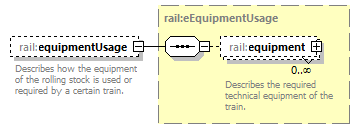 | ||||||
| namespace | https://www.railml.org/schemas/2021 | ||||||
| type | rail:eEquipmentUsage | ||||||
| properties |
| ||||||
| children | rail:equipment | ||||||
| annotation |
| ||||||
| source | <xs:element name="equipmentUsage" type="rail:eEquipmentUsage" minOccurs="0"> <xs:annotation> <xs:documentation>Describes how the equipment of the rolling stock is used or required by a certain train.</xs:documentation> <xs:documentation>See https://wiki2.railml.org/wiki/TT:equipmentUsage_trainPartSequence</xs:documentation> </xs:annotation> </xs:element> |
element eTrainPartSequence/brakeUsage
| diagram | 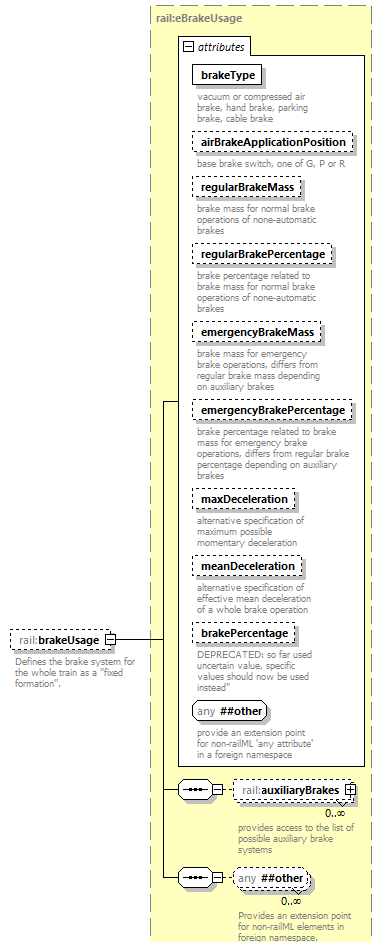 | ||||||||||||||||||||||||||||||||||||||||||||||||||||||||||||||||||||||||||||||
| namespace | https://www.railml.org/schemas/2021 | ||||||||||||||||||||||||||||||||||||||||||||||||||||||||||||||||||||||||||||||
| type | rail:eBrakeUsage | ||||||||||||||||||||||||||||||||||||||||||||||||||||||||||||||||||||||||||||||
| properties |
| ||||||||||||||||||||||||||||||||||||||||||||||||||||||||||||||||||||||||||||||
| children | rail:auxiliaryBrakes | ||||||||||||||||||||||||||||||||||||||||||||||||||||||||||||||||||||||||||||||
| attributes |
| ||||||||||||||||||||||||||||||||||||||||||||||||||||||||||||||||||||||||||||||
| annotation |
| ||||||||||||||||||||||||||||||||||||||||||||||||||||||||||||||||||||||||||||||
| source | <xs:element name="brakeUsage" type="rail:eBrakeUsage" minOccurs="0"> <xs:annotation> <xs:documentation>Defines the brake system for the whole train as a "fixed formation".</xs:documentation> <xs:documentation>See https://wiki2.railml.org/wiki/TT:brakeUsage</xs:documentation> </xs:annotation> </xs:element> |
element eTrainPartSequence/topologyReference
| diagram | 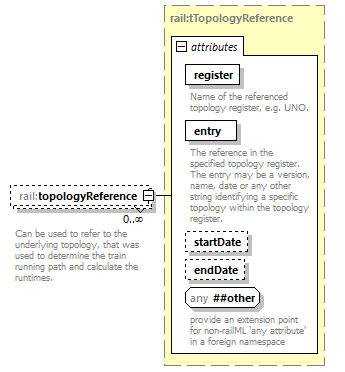 | ||||||||||||||||||||||||||||||||||
| namespace | https://www.railml.org/schemas/2021 | ||||||||||||||||||||||||||||||||||
| type | rail:tTopologyReference | ||||||||||||||||||||||||||||||||||
| properties |
| ||||||||||||||||||||||||||||||||||
| attributes |
| ||||||||||||||||||||||||||||||||||
| annotation |
| ||||||||||||||||||||||||||||||||||
| source | <xs:element name="topologyReference" type="rail:tTopologyReference" minOccurs="0" maxOccurs="unbounded"> <xs:annotation> <xs:documentation>Can be used to refer to the underlying topology, that was used to determine the train running path and calculate the runtimes.</xs:documentation> <xs:documentation>See https://wiki2.railml.org/wiki/TT:topologyReference</xs:documentation> </xs:annotation> </xs:element> |
complexType eTrains
| diagram |  | ||
| namespace | https://www.railml.org/schemas/2021 | ||
| children | rail:train | ||
| used by |
| ||
| source | <xs:complexType name="eTrains"> <xs:sequence> <xs:element name="train" type="rail:eTrain" maxOccurs="unbounded"> <xs:annotation> <xs:documentation>Describes a train from different perspectives.</xs:documentation> <xs:documentation>See https://wiki2.railml.org/wiki/TT:train</xs:documentation> </xs:annotation> </xs:element> </xs:sequence> </xs:complexType> |
element eTrains/train
| diagram |  | ||||||||||||||||||||||||||||||||||||||||||||||||||||||||||||||||||||||||||||||||||||||||||||||||||||||||||||||
| namespace | https://www.railml.org/schemas/2021 | ||||||||||||||||||||||||||||||||||||||||||||||||||||||||||||||||||||||||||||||||||||||||||||||||||||||||||||||
| type | rail:eTrain | ||||||||||||||||||||||||||||||||||||||||||||||||||||||||||||||||||||||||||||||||||||||||||||||||||||||||||||||
| properties |
| ||||||||||||||||||||||||||||||||||||||||||||||||||||||||||||||||||||||||||||||||||||||||||||||||||||||||||||||
| children | rail:additionalName rail:trainPartSequence rail:tafTapTsiTrainID rail:replacements | ||||||||||||||||||||||||||||||||||||||||||||||||||||||||||||||||||||||||||||||||||||||||||||||||||||||||||||||
| attributes |
| ||||||||||||||||||||||||||||||||||||||||||||||||||||||||||||||||||||||||||||||||||||||||||||||||||||||||||||||
| annotation |
| ||||||||||||||||||||||||||||||||||||||||||||||||||||||||||||||||||||||||||||||||||||||||||||||||||||||||||||||
| source | <xs:element name="train" type="rail:eTrain" maxOccurs="unbounded"> <xs:annotation> <xs:documentation>Describes a train from different perspectives.</xs:documentation> <xs:documentation>See https://wiki2.railml.org/wiki/TT:train</xs:documentation> </xs:annotation> </xs:element> |
complexType tMediaCategories
| diagram |  | ||
| namespace | https://www.railml.org/schemas/2021 | ||
| children | rail:mediaCategory | ||
| used by |
| ||
| source | <xs:complexType name="tMediaCategories"> <xs:sequence> <xs:element name="mediaCategory" type="rail:tAdditionalName" maxOccurs="unbounded"> <xs:annotation> <xs:documentation>With a mediaCategory it is possible to provide metadata for passenger information data.</xs:documentation> <xs:documentation>See https://wiki2.railml.org/wiki/TT:mediaCategory</xs:documentation> </xs:annotation> </xs:element> </xs:sequence> </xs:complexType> |
element tMediaCategories/mediaCategory
| diagram |  | ||||||||||||||||||||||||||||||
| namespace | https://www.railml.org/schemas/2021 | ||||||||||||||||||||||||||||||
| type | rail:tAdditionalName | ||||||||||||||||||||||||||||||
| properties |
| ||||||||||||||||||||||||||||||
| attributes |
| ||||||||||||||||||||||||||||||
| annotation |
| ||||||||||||||||||||||||||||||
| source | <xs:element name="mediaCategory" type="rail:tAdditionalName" maxOccurs="unbounded"> <xs:annotation> <xs:documentation>With a mediaCategory it is possible to provide metadata for passenger information data.</xs:documentation> <xs:documentation>See https://wiki2.railml.org/wiki/TT:mediaCategory</xs:documentation> </xs:annotation> </xs:element> |
complexType tAdditionalOcpName
| diagram | 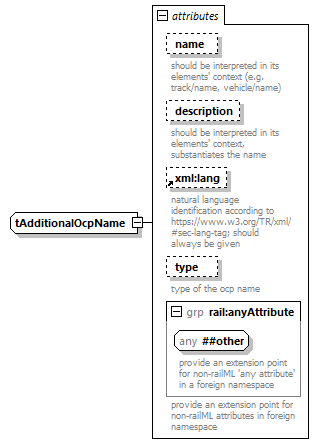 | ||||||||||||||||||||||||||||||||||||||
| namespace | https://www.railml.org/schemas/2021 | ||||||||||||||||||||||||||||||||||||||
| used by |
| ||||||||||||||||||||||||||||||||||||||
| attributes |
| ||||||||||||||||||||||||||||||||||||||
| source | <xs:complexType name="tAdditionalOcpName"> <xs:attribute name="name" type="rail:tGenericName"> <xs:annotation> <xs:documentation>should be interpreted in its elements' context (e.g. track/name, vehicle/name)</xs:documentation> </xs:annotation> </xs:attribute> <xs:attribute name="description" type="rail:tElementDescription"> <xs:annotation> <xs:documentation>should be interpreted in its elements' context, substantiates the name</xs:documentation> </xs:annotation> </xs:attribute> <xs:attribute ref="xml:lang"> <xs:annotation> <xs:documentation>natural language identification according to https://www.w3.org/TR/xml/#sec-lang-tag; should always be given</xs:documentation> </xs:annotation> </xs:attribute> <xs:attribute name="type" type="rail:tOcpNameType"> <xs:annotation> <xs:documentation>type of the ocp name</xs:documentation> </xs:annotation> </xs:attribute> <xs:attributeGroup ref="rail:anyAttribute"> <xs:annotation> <xs:documentation>provide an extension point for non-railML attributes in foreign namespace</xs:documentation> </xs:annotation> </xs:attributeGroup> </xs:complexType> |
attribute tAdditionalOcpName/@name
| type | rail:tGenericName | ||
| annotation |
| ||
| source | <xs:attribute name="name" type="rail:tGenericName"> <xs:annotation> <xs:documentation>should be interpreted in its elements' context (e.g. track/name, vehicle/name)</xs:documentation> </xs:annotation> </xs:attribute> |
attribute tAdditionalOcpName/@description
| type | rail:tElementDescription | ||
| annotation |
| ||
| source | <xs:attribute name="description" type="rail:tElementDescription"> <xs:annotation> <xs:documentation>should be interpreted in its elements' context, substantiates the name</xs:documentation> </xs:annotation> </xs:attribute> |
attribute tAdditionalOcpName/@type
| type | rail:tOcpNameType | ||
| annotation |
| ||
| source | <xs:attribute name="type" type="rail:tOcpNameType"> <xs:annotation> <xs:documentation>type of the ocp name</xs:documentation> </xs:annotation> </xs:attribute> |
complexType tAttribute
| diagram |  | ||||||||||||||||||
| namespace | https://www.railml.org/schemas/2021 | ||||||||||||||||||
| used by |
| ||||||||||||||||||
| attributes |
| ||||||||||||||||||
| source | <xs:complexType name="tAttribute"> <xs:attribute name="name" type="xs:string" use="required"/> <xs:attribute name="value" type="xs:string" use="required"/> </xs:complexType> |
attribute tAttribute/@name
| type | xs:string | ||
| properties |
| ||
| source | <xs:attribute name="name" type="xs:string" use="required"/> |
attribute tAttribute/@value
| type | xs:string | ||
| properties |
| ||
| source | <xs:attribute name="value" type="xs:string" use="required"/> |
complexType tAxleWeight
| diagram |  | ||||||||||||||||||
| namespace | https://www.railml.org/schemas/2021 | ||||||||||||||||||
| used by |
| ||||||||||||||||||
| attributes |
| ||||||||||||||||||
| source | <xs:complexType name="tAxleWeight"> <xs:attributeGroup ref="rail:aAxleWeight"/> </xs:complexType> |
complexType tAxleWeightChange
| diagram |  | ||||||||||||||||||||||||||||||||||||||||||||||||||||||||||||||||||||||||||||||||||||||||||
| namespace | https://www.railml.org/schemas/2021 | ||||||||||||||||||||||||||||||||||||||||||||||||||||||||||||||||||||||||||||||||||||||||||
| type | extension of rail:tDelimitedOrientedElementDeprecated | ||||||||||||||||||||||||||||||||||||||||||||||||||||||||||||||||||||||||||||||||||||||||||
| properties |
| ||||||||||||||||||||||||||||||||||||||||||||||||||||||||||||||||||||||||||||||||||||||||||
| children | rail:additionalName rail:geoCoord rail:states | ||||||||||||||||||||||||||||||||||||||||||||||||||||||||||||||||||||||||||||||||||||||||||
| used by |
| ||||||||||||||||||||||||||||||||||||||||||||||||||||||||||||||||||||||||||||||||||||||||||
| attributes |
| ||||||||||||||||||||||||||||||||||||||||||||||||||||||||||||||||||||||||||||||||||||||||||
| source | <xs:complexType name="tAxleWeightChange"> <xs:complexContent> <xs:extension base="rail:tDelimitedOrientedElementDeprecated"> <xs:attributeGroup ref="rail:aAxleWeight"/> </xs:extension> </xs:complexContent> </xs:complexType> |
complexType tBalise
| diagram |  | ||||||||||||||||||||||||||||||||||||||||||||||||||||||||||||||||||||||||||||||||||||||||||||||||||||||||||||||||||||||||||||||||||
| namespace | https://www.railml.org/schemas/2021 | ||||||||||||||||||||||||||||||||||||||||||||||||||||||||||||||||||||||||||||||||||||||||||||||||||||||||||||||||||||||||||||||||||
| type | extension of rail:tOrientedElement | ||||||||||||||||||||||||||||||||||||||||||||||||||||||||||||||||||||||||||||||||||||||||||||||||||||||||||||||||||||||||||||||||||
| properties |
| ||||||||||||||||||||||||||||||||||||||||||||||||||||||||||||||||||||||||||||||||||||||||||||||||||||||||||||||||||||||||||||||||||
| children | rail:additionalName rail:geoCoord rail:states | ||||||||||||||||||||||||||||||||||||||||||||||||||||||||||||||||||||||||||||||||||||||||||||||||||||||||||||||||||||||||||||||||||
| used by |
| ||||||||||||||||||||||||||||||||||||||||||||||||||||||||||||||||||||||||||||||||||||||||||||||||||||||||||||||||||||||||||||||||||
| attributes |
| ||||||||||||||||||||||||||||||||||||||||||||||||||||||||||||||||||||||||||||||||||||||||||||||||||||||||||||||||||||||||||||||||||
| source | <xs:complexType name="tBalise"> <xs:complexContent> <xs:extension base="rail:tOrientedElement"> <xs:attributeGroup ref="rail:aBalise"/> <xs:attribute name="ndx" type="rail:tPIG"/> </xs:extension> </xs:complexContent> </xs:complexType> |
attribute tBalise/@ndx
| type | rail:tPIG | |||||||||
| facets |
| |||||||||
| source | <xs:attribute name="ndx" type="rail:tPIG"/> |
complexType tBaliseGroup
| diagram | 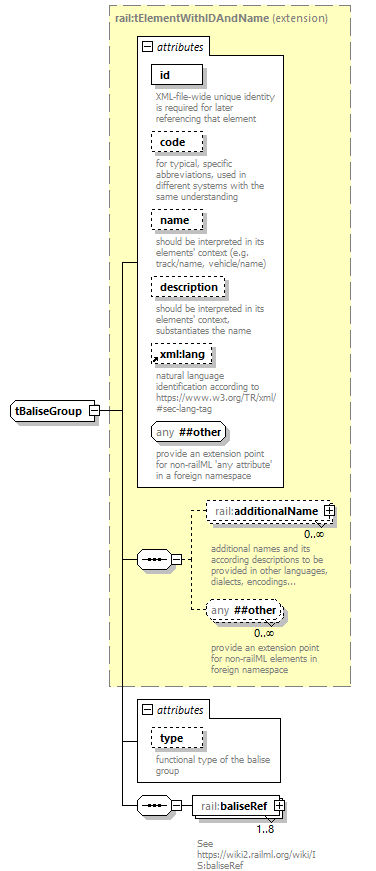 | ||||||||||||||||||||||||||||||||||||||||||||||||||||||
| namespace | https://www.railml.org/schemas/2021 | ||||||||||||||||||||||||||||||||||||||||||||||||||||||
| type | extension of rail:tElementWithIDAndName | ||||||||||||||||||||||||||||||||||||||||||||||||||||||
| properties |
| ||||||||||||||||||||||||||||||||||||||||||||||||||||||
| children | rail:additionalName rail:baliseRef | ||||||||||||||||||||||||||||||||||||||||||||||||||||||
| used by |
| ||||||||||||||||||||||||||||||||||||||||||||||||||||||
| attributes |
| ||||||||||||||||||||||||||||||||||||||||||||||||||||||
| source | <xs:complexType name="tBaliseGroup"> <xs:complexContent> <xs:extension base="rail:tElementWithIDAndName"> <xs:sequence> <xs:element name="baliseRef" type="rail:tBaliseRefInGroup" maxOccurs="8"> <xs:annotation> <xs:documentation>See https://wiki2.railml.org/wiki/IS:baliseRef</xs:documentation> </xs:annotation> </xs:element> </xs:sequence> <xs:attribute name="type" type="rail:tBaliseGroupType"> <xs:annotation> <xs:documentation>functional type of the balise group</xs:documentation> </xs:annotation> </xs:attribute> </xs:extension> </xs:complexContent> </xs:complexType> |
attribute tBaliseGroup/@type
| type | rail:tBaliseGroupType | ||
| annotation |
| ||
| source | <xs:attribute name="type" type="rail:tBaliseGroupType"> <xs:annotation> <xs:documentation>functional type of the balise group</xs:documentation> </xs:annotation> </xs:attribute> |
element tBaliseGroup/baliseRef
| diagram |  | ||||||||||||||||||||
| namespace | https://www.railml.org/schemas/2021 | ||||||||||||||||||||
| type | rail:tBaliseRefInGroup | ||||||||||||||||||||
| properties |
| ||||||||||||||||||||
| attributes |
| ||||||||||||||||||||
| annotation |
| ||||||||||||||||||||
| source | <xs:element name="baliseRef" type="rail:tBaliseRefInGroup" maxOccurs="8"> <xs:annotation> <xs:documentation>See https://wiki2.railml.org/wiki/IS:baliseRef</xs:documentation> </xs:annotation> </xs:element> |
complexType tBaliseRefInGroup
| diagram | 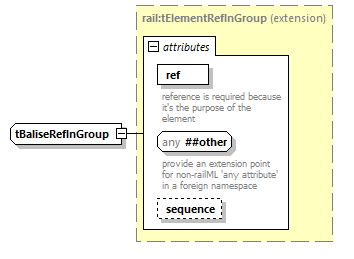 | ||||||||||||||||||||
| namespace | https://www.railml.org/schemas/2021 | ||||||||||||||||||||
| type | extension of rail:tElementRefInGroup | ||||||||||||||||||||
| properties |
| ||||||||||||||||||||
| used by |
| ||||||||||||||||||||
| attributes |
| ||||||||||||||||||||
| source | <xs:complexType name="tBaliseRefInGroup"> <xs:complexContent> <xs:extension base="rail:tElementRefInGroup"/> <!-- Possible baliseGroup-specific attributes to be added here later --> </xs:complexContent> </xs:complexType> |
complexType tBasePlacedElement
| diagram | 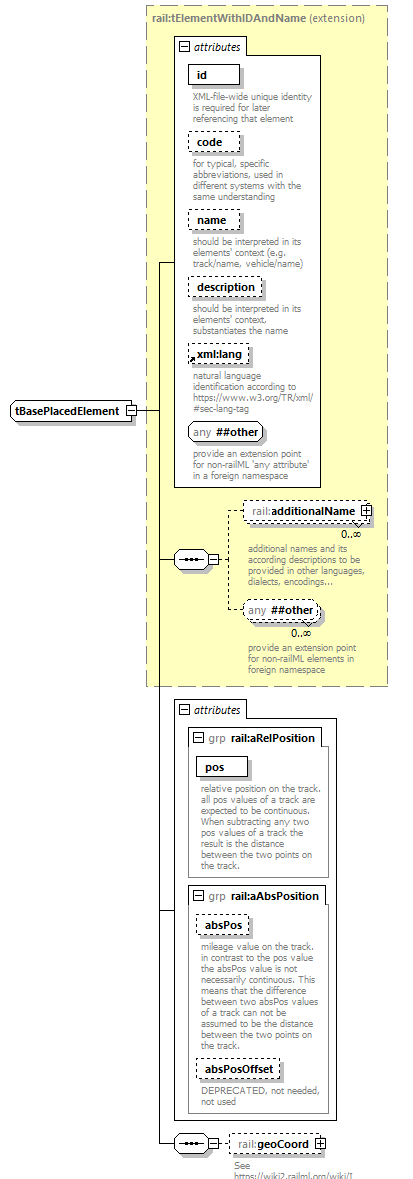 | ||||||||||||||||||||||||||||||||||||||||||||||||||||||||||||||||||||||
| namespace | https://www.railml.org/schemas/2021 | ||||||||||||||||||||||||||||||||||||||||||||||||||||||||||||||||||||||
| type | extension of rail:tElementWithIDAndName | ||||||||||||||||||||||||||||||||||||||||||||||||||||||||||||||||||||||
| properties |
| ||||||||||||||||||||||||||||||||||||||||||||||||||||||||||||||||||||||
| children | rail:additionalName rail:geoCoord | ||||||||||||||||||||||||||||||||||||||||||||||||||||||||||||||||||||||
| used by |
| ||||||||||||||||||||||||||||||||||||||||||||||||||||||||||||||||||||||
| attributes |
| ||||||||||||||||||||||||||||||||||||||||||||||||||||||||||||||||||||||
| source | <xs:complexType name="tBasePlacedElement"> <xs:complexContent> <xs:extension base="rail:tElementWithIDAndName"> <xs:sequence> <xs:element name="geoCoord" type="rail:tGeoCoord" minOccurs="0"> <xs:annotation> <xs:documentation>See https://wiki2.railml.org/wiki/IS:geoCoord</xs:documentation> </xs:annotation> </xs:element> </xs:sequence> <xs:attributeGroup ref="rail:aRelPosition"/> <xs:attributeGroup ref="rail:aAbsPosition"/> </xs:extension> </xs:complexContent> </xs:complexType> |
element tBasePlacedElement/geoCoord
| diagram |  | ||||||||||||||||||||||||||||||
| namespace | https://www.railml.org/schemas/2021 | ||||||||||||||||||||||||||||||
| type | rail:tGeoCoord | ||||||||||||||||||||||||||||||
| properties |
| ||||||||||||||||||||||||||||||
| attributes |
| ||||||||||||||||||||||||||||||
| annotation |
| ||||||||||||||||||||||||||||||
| source | <xs:element name="geoCoord" type="rail:tGeoCoord" minOccurs="0"> <xs:annotation> <xs:documentation>See https://wiki2.railml.org/wiki/IS:geoCoord</xs:documentation> </xs:annotation> </xs:element> |
complexType tBaseServiceSection
| diagram |  | ||||||||||||||||||||||||||||||||||||||||||||||||||||||||||||||||||||||||||||||||||||||||||||||||||||||||||||||
| namespace | https://www.railml.org/schemas/2021 | ||||||||||||||||||||||||||||||||||||||||||||||||||||||||||||||||||||||||||||||||||||||||||||||||||||||||||||||
| type | extension of rail:tDelimitedOrientedElementWithLengthDeprecated | ||||||||||||||||||||||||||||||||||||||||||||||||||||||||||||||||||||||||||||||||||||||||||||||||||||||||||||||
| properties |
| ||||||||||||||||||||||||||||||||||||||||||||||||||||||||||||||||||||||||||||||||||||||||||||||||||||||||||||||
| children | rail:additionalName rail:geoCoord rail:states | ||||||||||||||||||||||||||||||||||||||||||||||||||||||||||||||||||||||||||||||||||||||||||||||||||||||||||||||
| used by |
| ||||||||||||||||||||||||||||||||||||||||||||||||||||||||||||||||||||||||||||||||||||||||||||||||||||||||||||||
| attributes |
| ||||||||||||||||||||||||||||||||||||||||||||||||||||||||||||||||||||||||||||||||||||||||||||||||||||||||||||||
| source | <xs:complexType name="tBaseServiceSection"> <xs:complexContent> <xs:extension base="rail:tDelimitedOrientedElementWithLengthDeprecated"> <xs:attribute name="height" type="rail:tLengthMM"> <xs:annotation> <xs:documentation>height above the rails in millimeters</xs:documentation> </xs:annotation> </xs:attribute> <xs:attribute name="side" type="rail:tSide"> <xs:annotation> <xs:documentation>side as seen from the oriented track, e.g. left or right</xs:documentation> </xs:annotation> </xs:attribute> <xs:attribute name="ocpRef" type="rail:tGenericRef"> <xs:annotation> <xs:documentation>reference to the OCP, where the platform edge / service section belongs to</xs:documentation> </xs:annotation> </xs:attribute> <xs:attributeGroup ref="rail:anyAttribute"/> </xs:extension> </xs:complexContent> </xs:complexType> |
attribute tBaseServiceSection/@height
| type | rail:tLengthMM | ||||||
| facets |
| ||||||
| annotation |
| ||||||
| source | <xs:attribute name="height" type="rail:tLengthMM"> <xs:annotation> <xs:documentation>height above the rails in millimeters</xs:documentation> </xs:annotation> </xs:attribute> |
attribute tBaseServiceSection/@side
| type | rail:tSide | ||||||||||||||||||
| facets |
| ||||||||||||||||||
| annotation |
| ||||||||||||||||||
| source | <xs:attribute name="side" type="rail:tSide"> <xs:annotation> <xs:documentation>side as seen from the oriented track, e.g. left or right</xs:documentation> </xs:annotation> </xs:attribute> |
attribute tBaseServiceSection/@ocpRef
| type | rail:tGenericRef | ||
| annotation |
| ||
| source | <xs:attribute name="ocpRef" type="rail:tGenericRef"> <xs:annotation> <xs:documentation>reference to the OCP, where the platform edge / service section belongs to</xs:documentation> </xs:annotation> </xs:attribute> |
complexType tBorder
| diagram |  | ||||||||||||||||||||||||||||||||||||||||||||||||||||||||||||||||||||||||||||||||||||
| namespace | https://www.railml.org/schemas/2021 | ||||||||||||||||||||||||||||||||||||||||||||||||||||||||||||||||||||||||||||||||||||
| type | extension of rail:tDelimitedOrientedElement | ||||||||||||||||||||||||||||||||||||||||||||||||||||||||||||||||||||||||||||||||||||
| properties |
| ||||||||||||||||||||||||||||||||||||||||||||||||||||||||||||||||||||||||||||||||||||
| children | rail:additionalName rail:geoCoord rail:states | ||||||||||||||||||||||||||||||||||||||||||||||||||||||||||||||||||||||||||||||||||||
| used by |
| ||||||||||||||||||||||||||||||||||||||||||||||||||||||||||||||||||||||||||||||||||||
| attributes |
| ||||||||||||||||||||||||||||||||||||||||||||||||||||||||||||||||||||||||||||||||||||
| source | <xs:complexType name="tBorder"> <xs:complexContent> <xs:extension base="rail:tDelimitedOrientedElement"> <xs:attribute name="type" type="rail:tBorderType" use="required"/> </xs:extension> </xs:complexContent> </xs:complexType> |
attribute tBorder/@type
| type | rail:tBorderType | ||
| properties |
| ||
| source | <xs:attribute name="type" type="rail:tBorderType" use="required"/> |
complexType tBraking
| diagram |  | ||||||||||||||||||||||||||||||
| namespace | https://www.railml.org/schemas/2021 | ||||||||||||||||||||||||||||||
| used by |
| ||||||||||||||||||||||||||||||
| attributes |
| ||||||||||||||||||||||||||||||
| annotation |
| ||||||||||||||||||||||||||||||
| source | <xs:complexType name="tBraking"> <xs:annotation> <xs:documentation>parameters describing the train braking configuration</xs:documentation> </xs:annotation> <xs:attributeGroup ref="rail:aMinBasicBrakeAttributes"/> <xs:attribute name="minimumBrakePercentage" type="rail:tBrakePercentage"> <xs:annotation> <xs:documentation>minimum brake percentage of the train</xs:documentation> </xs:annotation> </xs:attribute> </xs:complexType> |
attribute tBraking/@minimumBrakePercentage
| type | rail:tBrakePercentage | |||||||||
| facets |
| |||||||||
| annotation |
| |||||||||
| source | <xs:attribute name="minimumBrakePercentage" type="rail:tBrakePercentage"> <xs:annotation> <xs:documentation>minimum brake percentage of the train</xs:documentation> </xs:annotation> </xs:attribute> |
complexType tBridge
| diagram |  | ||||||||||||||||||||||||||||||||||||||||||||||||||||||||||||||||||||||||||||||||||||||||||||||||||
| namespace | https://www.railml.org/schemas/2021 | ||||||||||||||||||||||||||||||||||||||||||||||||||||||||||||||||||||||||||||||||||||||||||||||||||
| type | extension of rail:tDelimitedOrientedElementWithLengthDeprecated | ||||||||||||||||||||||||||||||||||||||||||||||||||||||||||||||||||||||||||||||||||||||||||||||||||
| properties |
| ||||||||||||||||||||||||||||||||||||||||||||||||||||||||||||||||||||||||||||||||||||||||||||||||||
| children | rail:additionalName rail:geoCoord rail:states | ||||||||||||||||||||||||||||||||||||||||||||||||||||||||||||||||||||||||||||||||||||||||||||||||||
| used by |
| ||||||||||||||||||||||||||||||||||||||||||||||||||||||||||||||||||||||||||||||||||||||||||||||||||
| attributes |
| ||||||||||||||||||||||||||||||||||||||||||||||||||||||||||||||||||||||||||||||||||||||||||||||||||
| source | <xs:complexType name="tBridge"> <xs:complexContent> <xs:extension base="rail:tDelimitedOrientedElementWithLengthDeprecated"> <xs:attribute name="kind" type="xs:string"/> <xs:attribute name="meterload" type="rail:tMeterloadTonsPerMeter"/> </xs:extension> </xs:complexContent> </xs:complexType> |
attribute tBridge/@kind
| type | xs:string |
| source | <xs:attribute name="kind" type="xs:string"/> |
attribute tBridge/@meterload
| type | rail:tMeterloadTonsPerMeter | ||||||
| facets |
| ||||||
| source | <xs:attribute name="meterload" type="rail:tMeterloadTonsPerMeter"/> |
complexType tBufferStop
| diagram |  | ||||||||||||||||||||||||||||||||||||||||||||||
| namespace | https://www.railml.org/schemas/2021 | ||||||||||||||||||||||||||||||||||||||||||||||
| type | extension of rail:tElementWithIDAndName | ||||||||||||||||||||||||||||||||||||||||||||||
| properties |
| ||||||||||||||||||||||||||||||||||||||||||||||
| children | rail:additionalName | ||||||||||||||||||||||||||||||||||||||||||||||
| used by |
| ||||||||||||||||||||||||||||||||||||||||||||||
| attributes |
| ||||||||||||||||||||||||||||||||||||||||||||||
| source | <xs:complexType name="tBufferStop"> <xs:complexContent> <xs:extension base="rail:tElementWithIDAndName"/> </xs:complexContent> </xs:complexType> |
complexType tChildRule
| diagram |  | ||||||||||||||
| namespace | https://www.railml.org/schemas/2021 | ||||||||||||||
| used by |
| ||||||||||||||
| attributes |
| ||||||||||||||
| source | <xs:complexType name="tChildRule"> <xs:attribute name="ruleRef" type="rail:tGenericRef" use="required"> <xs:annotation> <xs:documentation>reference to an operatingRule element</xs:documentation> </xs:annotation> </xs:attribute> </xs:complexType> |
attribute tChildRule/@ruleRef
| type | rail:tGenericRef | ||
| properties |
| ||
| annotation |
| ||
| source | <xs:attribute name="ruleRef" type="rail:tGenericRef" use="required"> <xs:annotation> <xs:documentation>reference to an operatingRule element</xs:documentation> </xs:annotation> </xs:attribute> |
complexType tClearanceGaugeChange
| diagram |  | ||||||||||||||||||||||||||||||||||||||||||||||||||||||||||||||||||||||||||||||
| namespace | https://www.railml.org/schemas/2021 | ||||||||||||||||||||||||||||||||||||||||||||||||||||||||||||||||||||||||||||||
| type | extension of rail:tDelimitedOrientedElementDeprecated | ||||||||||||||||||||||||||||||||||||||||||||||||||||||||||||||||||||||||||||||
| properties |
| ||||||||||||||||||||||||||||||||||||||||||||||||||||||||||||||||||||||||||||||
| children | rail:additionalName rail:geoCoord rail:states rail:clearanceGauge | ||||||||||||||||||||||||||||||||||||||||||||||||||||||||||||||||||||||||||||||
| used by |
| ||||||||||||||||||||||||||||||||||||||||||||||||||||||||||||||||||||||||||||||
| attributes |
| ||||||||||||||||||||||||||||||||||||||||||||||||||||||||||||||||||||||||||||||
| source | <xs:complexType name="tClearanceGaugeChange"> <xs:complexContent> <xs:extension base="rail:tDelimitedOrientedElementDeprecated"> <xs:sequence> <xs:element name="clearanceGauge" type="rail:tClearanceGaugeType"> <xs:annotation> <xs:documentation>See https://wiki2.railml.org/wiki/IS:clearanceGauge</xs:documentation> </xs:annotation> </xs:element> </xs:sequence> </xs:extension> </xs:complexContent> </xs:complexType> |
element tClearanceGaugeChange/clearanceGauge
| diagram | 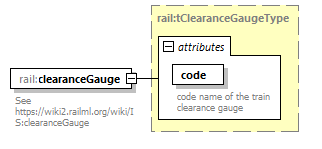 | ||||||||||||||||
| namespace | https://www.railml.org/schemas/2021 | ||||||||||||||||
| type | rail:tClearanceGaugeType | ||||||||||||||||
| properties |
| ||||||||||||||||
| attributes |
| ||||||||||||||||
| annotation |
| ||||||||||||||||
| source | <xs:element name="clearanceGauge" type="rail:tClearanceGaugeType"> <xs:annotation> <xs:documentation>See https://wiki2.railml.org/wiki/IS:clearanceGauge</xs:documentation> </xs:annotation> </xs:element> |
complexType tCommonSwitchAndCrossingData
| diagram |  | ||||||||||||||||||||||||||||||||||||||||||||||||||||||||||||||||||||||||||||||||||||||||||||||||||||||||||||||||||||||||||||||||||||||||||||||||
| namespace | https://www.railml.org/schemas/2021 | ||||||||||||||||||||||||||||||||||||||||||||||||||||||||||||||||||||||||||||||||||||||||||||||||||||||||||||||||||||||||||||||||||||||||||||||||
| type | extension of rail:tPlacedElement | ||||||||||||||||||||||||||||||||||||||||||||||||||||||||||||||||||||||||||||||||||||||||||||||||||||||||||||||||||||||||||||||||||||||||||||||||
| properties |
| ||||||||||||||||||||||||||||||||||||||||||||||||||||||||||||||||||||||||||||||||||||||||||||||||||||||||||||||||||||||||||||||||||||||||||||||||
| children | rail:additionalName rail:geoCoord rail:states | ||||||||||||||||||||||||||||||||||||||||||||||||||||||||||||||||||||||||||||||||||||||||||||||||||||||||||||||||||||||||||||||||||||||||||||||||
| used by |
| ||||||||||||||||||||||||||||||||||||||||||||||||||||||||||||||||||||||||||||||||||||||||||||||||||||||||||||||||||||||||||||||||||||||||||||||||
| attributes |
| ||||||||||||||||||||||||||||||||||||||||||||||||||||||||||||||||||||||||||||||||||||||||||||||||||||||||||||||||||||||||||||||||||||||||||||||||
| source | <xs:complexType name="tCommonSwitchAndCrossingData"> <xs:complexContent> <xs:extension base="rail:tPlacedElement"> <xs:attribute name="trackContinueCourse" type="rail:tCourse"/> <xs:attribute name="trackContinueRadius" type="rail:tRadiusM"/> <xs:attribute name="normalPosition" type="rail:tCourse"/> <xs:attribute name="model" type="xs:string"/> <xs:attribute name="length" type="rail:tLengthM"/> <xs:attribute name="remoteOperated" type="xs:boolean"> <xs:annotation> <xs:documentation>position is operated from anywhere else, i.e. from signalbox or remote operator place but not directly at the switch/crossing</xs:documentation> </xs:annotation> </xs:attribute> <xs:attribute name="remoteIndicated" type="xs:boolean"> <xs:annotation> <xs:documentation>position is indicated at a remote place like within the signalbox or a remote operator place</xs:documentation> </xs:annotation> </xs:attribute> <xs:attribute name="lockRef" type="rail:tGenericRef"/> <xs:attribute name="clearancePosOffset" type="rail:tLengthM"/> <xs:attributeGroup ref="rail:aOcpRef"/> <xs:attributeGroup ref="rail:anyAttribute"> <xs:annotation> <xs:documentation>provide an extension point for non-railML attributes in foreign namespace</xs:documentation> </xs:annotation> </xs:attributeGroup> </xs:extension> </xs:complexContent> </xs:complexType> |
attribute tCommonSwitchAndCrossingData/@trackContinueCourse
| type | rail:tCourse |
| source | <xs:attribute name="trackContinueCourse" type="rail:tCourse"/> |
attribute tCommonSwitchAndCrossingData/@trackContinueRadius
| type | rail:tRadiusM | ||||||
| facets |
| ||||||
| source | <xs:attribute name="trackContinueRadius" type="rail:tRadiusM"/> |
attribute tCommonSwitchAndCrossingData/@normalPosition
| type | rail:tCourse |
| source | <xs:attribute name="normalPosition" type="rail:tCourse"/> |
attribute tCommonSwitchAndCrossingData/@model
| type | xs:string |
| source | <xs:attribute name="model" type="xs:string"/> |
attribute tCommonSwitchAndCrossingData/@length
| type | rail:tLengthM | ||||||
| facets |
| ||||||
| source | <xs:attribute name="length" type="rail:tLengthM"/> |
attribute tCommonSwitchAndCrossingData/@remoteOperated
| type | xs:boolean | ||
| annotation |
| ||
| source | <xs:attribute name="remoteOperated" type="xs:boolean"> <xs:annotation> <xs:documentation>position is operated from anywhere else, i.e. from signalbox or remote operator place but not directly at the switch/crossing</xs:documentation> </xs:annotation> </xs:attribute> |
attribute tCommonSwitchAndCrossingData/@remoteIndicated
| type | xs:boolean | ||
| annotation |
| ||
| source | <xs:attribute name="remoteIndicated" type="xs:boolean"> <xs:annotation> <xs:documentation>position is indicated at a remote place like within the signalbox or a remote operator place</xs:documentation> </xs:annotation> </xs:attribute> |
attribute tCommonSwitchAndCrossingData/@lockRef
| type | rail:tGenericRef |
| source | <xs:attribute name="lockRef" type="rail:tGenericRef"/> |
attribute tCommonSwitchAndCrossingData/@clearancePosOffset
| type | rail:tLengthM | ||||||
| facets |
| ||||||
| source | <xs:attribute name="clearancePosOffset" type="rail:tLengthM"/> |
complexType tConnectionData
| diagram |  | ||||||||||||||||||
| namespace | https://www.railml.org/schemas/2021 | ||||||||||||||||||
| used by |
| ||||||||||||||||||
| attributes |
| ||||||||||||||||||
| source | <xs:complexType name="tConnectionData"> <xs:attribute name="id" type="rail:tGenericID" use="required"/> <xs:attribute name="ref" type="rail:tGenericRef" use="required"/> </xs:complexType> |
attribute tConnectionData/@id
| type | rail:tGenericID | ||
| properties |
| ||
| source | <xs:attribute name="id" type="rail:tGenericID" use="required"/> |
attribute tConnectionData/@ref
| type | rail:tGenericRef | ||
| properties |
| ||
| source | <xs:attribute name="ref" type="rail:tGenericRef" use="required"/> |
complexType tController
| diagram |  | ||||||||||||||||||||||||||||||||||||||||||||||||||||||||||||||||||||||||||||||||||||||||||||||||||||||||||||||
| namespace | https://www.railml.org/schemas/2021 | ||||||||||||||||||||||||||||||||||||||||||||||||||||||||||||||||||||||||||||||||||||||||||||||||||||||||||||||
| type | extension of rail:tElementWithIDAndName | ||||||||||||||||||||||||||||||||||||||||||||||||||||||||||||||||||||||||||||||||||||||||||||||||||||||||||||||
| properties |
| ||||||||||||||||||||||||||||||||||||||||||||||||||||||||||||||||||||||||||||||||||||||||||||||||||||||||||||||
| children | rail:additionalName rail:states rail:ocpRef rail:trackVacancyDetectionArea rail:localOperationArea rail:workZone | ||||||||||||||||||||||||||||||||||||||||||||||||||||||||||||||||||||||||||||||||||||||||||||||||||||||||||||||
| used by |
| ||||||||||||||||||||||||||||||||||||||||||||||||||||||||||||||||||||||||||||||||||||||||||||||||||||||||||||||
| attributes |
| ||||||||||||||||||||||||||||||||||||||||||||||||||||||||||||||||||||||||||||||||||||||||||||||||||||||||||||||
| source | <xs:complexType name="tController"> <xs:complexContent> <xs:extension base="rail:tElementWithIDAndName"> <xs:annotation> <xs:documentation>controller element, e.g. interlocking</xs:documentation> </xs:annotation> <xs:sequence> <xs:element name="states" type="rail:tStates" minOccurs="0"> <xs:annotation> <xs:documentation>Container to define disabled/enabled controllers</xs:documentation> <xs:documentation>See https://wiki2.railml.org/wiki/IS:states</xs:documentation> </xs:annotation> </xs:element> <xs:element name="ocpRef" type="rail:tElementRefInGroup" minOccurs="0" maxOccurs="unbounded"> <xs:annotation> <xs:documentation>reference from a controller to an OCP</xs:documentation> <xs:documentation>See https://wiki2.railml.org/wiki/IS:ocpRef_controller</xs:documentation> </xs:annotation> </xs:element> <xs:element name="trackVacancyDetectionArea" type="rail:tTrackVacancyDetectionArea" minOccurs="0" maxOccurs="unbounded"> <xs:annotation> <xs:documentation>defining the track vacancy detection areas controlled by this controller</xs:documentation> <xs:documentation>See https://wiki2.railml.org/wiki/IS:trackVacancyDetectionArea</xs:documentation> </xs:annotation> </xs:element> <xs:element name="localOperationArea" type="rail:tLocalOperationArea" minOccurs="0" maxOccurs="unbounded"> <xs:annotation> <xs:documentation>defining the local operation areas controlled by this controller</xs:documentation> <xs:documentation>See https://wiki2.railml.org/wiki/IS:localOperationArea</xs:documentation> </xs:annotation> </xs:element> <xs:element name="workZone" type="rail:tWorkZone" minOccurs="0" maxOccurs="unbounded"> <xs:annotation> <xs:documentation>defining work zones that are controlled by the controller</xs:documentation> <xs:documentation>See https://wiki2.railml.org/wiki/IS:workZone</xs:documentation> </xs:annotation> </xs:element> </xs:sequence> <xs:attributeGroup ref="rail:aController"/> </xs:extension> </xs:complexContent> </xs:complexType> |
element tController/states
| diagram |  | ||||||
| namespace | https://www.railml.org/schemas/2021 | ||||||
| type | rail:tStates | ||||||
| properties |
| ||||||
| children | rail:state | ||||||
| annotation |
| ||||||
| source | <xs:element name="states" type="rail:tStates" minOccurs="0"> <xs:annotation> <xs:documentation>Container to define disabled/enabled controllers</xs:documentation> <xs:documentation>See https://wiki2.railml.org/wiki/IS:states</xs:documentation> </xs:annotation> </xs:element> |
element tController/ocpRef
| diagram | 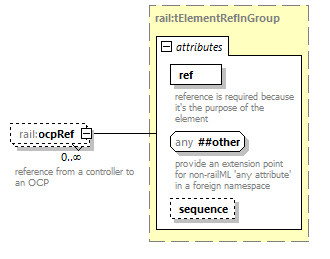 | ||||||||||||||||||||
| namespace | https://www.railml.org/schemas/2021 | ||||||||||||||||||||
| type | rail:tElementRefInGroup | ||||||||||||||||||||
| properties |
| ||||||||||||||||||||
| attributes |
| ||||||||||||||||||||
| annotation |
| ||||||||||||||||||||
| source | <xs:element name="ocpRef" type="rail:tElementRefInGroup" minOccurs="0" maxOccurs="unbounded"> <xs:annotation> <xs:documentation>reference from a controller to an OCP</xs:documentation> <xs:documentation>See https://wiki2.railml.org/wiki/IS:ocpRef_controller</xs:documentation> </xs:annotation> </xs:element> |
element tController/trackVacancyDetectionArea
| diagram |  | ||||||||||||||
| namespace | https://www.railml.org/schemas/2021 | ||||||||||||||
| type | rail:tTrackVacancyDetectionArea | ||||||||||||||
| properties |
| ||||||||||||||
| attributes |
| ||||||||||||||
| annotation |
| ||||||||||||||
| source | <xs:element name="trackVacancyDetectionArea" type="rail:tTrackVacancyDetectionArea" minOccurs="0" maxOccurs="unbounded"> <xs:annotation> <xs:documentation>defining the track vacancy detection areas controlled by this controller</xs:documentation> <xs:documentation>See https://wiki2.railml.org/wiki/IS:trackVacancyDetectionArea</xs:documentation> </xs:annotation> </xs:element> |
element tController/localOperationArea
| diagram |  | ||||||||||||||
| namespace | https://www.railml.org/schemas/2021 | ||||||||||||||
| type | rail:tLocalOperationArea | ||||||||||||||
| properties |
| ||||||||||||||
| attributes |
| ||||||||||||||
| annotation |
| ||||||||||||||
| source | <xs:element name="localOperationArea" type="rail:tLocalOperationArea" minOccurs="0" maxOccurs="unbounded"> <xs:annotation> <xs:documentation>defining the local operation areas controlled by this controller</xs:documentation> <xs:documentation>See https://wiki2.railml.org/wiki/IS:localOperationArea</xs:documentation> </xs:annotation> </xs:element> |
element tController/workZone
| diagram |  | ||||||||||||||
| namespace | https://www.railml.org/schemas/2021 | ||||||||||||||
| type | rail:tWorkZone | ||||||||||||||
| properties |
| ||||||||||||||
| attributes |
| ||||||||||||||
| annotation |
| ||||||||||||||
| source | <xs:element name="workZone" type="rail:tWorkZone" minOccurs="0" maxOccurs="unbounded"> <xs:annotation> <xs:documentation>defining work zones that are controlled by the controller</xs:documentation> <xs:documentation>See https://wiki2.railml.org/wiki/IS:workZone</xs:documentation> </xs:annotation> </xs:element> |
complexType tCrossedElement
| diagram |  | ||||||||||||||||||||||||||||||||||||||||||||||||||||||||||||||||
| namespace | https://www.railml.org/schemas/2021 | ||||||||||||||||||||||||||||||||||||||||||||||||||||||||||||||||
| type | extension of rail:tElementWithIDAndName | ||||||||||||||||||||||||||||||||||||||||||||||||||||||||||||||||
| properties |
| ||||||||||||||||||||||||||||||||||||||||||||||||||||||||||||||||
| children | rail:additionalName | ||||||||||||||||||||||||||||||||||||||||||||||||||||||||||||||||
| used by |
| ||||||||||||||||||||||||||||||||||||||||||||||||||||||||||||||||
| attributes |
| ||||||||||||||||||||||||||||||||||||||||||||||||||||||||||||||||
| source | <xs:complexType name="tCrossedElement"> <xs:complexContent> <xs:extension base="rail:tElementWithIDAndName"> <xs:attributeGroup ref="rail:aCrossedElement"/> </xs:extension> </xs:complexContent> </xs:complexType> |
complexType tCrossing
| diagram |  | ||||||||||||||||||||||||||||||||||||||||||||||||||||||||||||||||||||||||||||||||||||||||||||||||||||||||||||||||||||||||||||||||||||||||||||||||||||||
| namespace | https://www.railml.org/schemas/2021 | ||||||||||||||||||||||||||||||||||||||||||||||||||||||||||||||||||||||||||||||||||||||||||||||||||||||||||||||||||||||||||||||||||||||||||||||||||||||
| type | extension of rail:tCommonSwitchAndCrossingData | ||||||||||||||||||||||||||||||||||||||||||||||||||||||||||||||||||||||||||||||||||||||||||||||||||||||||||||||||||||||||||||||||||||||||||||||||||||||
| properties |
| ||||||||||||||||||||||||||||||||||||||||||||||||||||||||||||||||||||||||||||||||||||||||||||||||||||||||||||||||||||||||||||||||||||||||||||||||||||||
| children | rail:additionalName rail:geoCoord rail:states | ||||||||||||||||||||||||||||||||||||||||||||||||||||||||||||||||||||||||||||||||||||||||||||||||||||||||||||||||||||||||||||||||||||||||||||||||||||||
| used by |
| ||||||||||||||||||||||||||||||||||||||||||||||||||||||||||||||||||||||||||||||||||||||||||||||||||||||||||||||||||||||||||||||||||||||||||||||||||||||
| attributes |
| ||||||||||||||||||||||||||||||||||||||||||||||||||||||||||||||||||||||||||||||||||||||||||||||||||||||||||||||||||||||||||||||||||||||||||||||||||||||
| source | <xs:complexType name="tCrossing"> <xs:complexContent> <xs:extension base="rail:tCommonSwitchAndCrossingData"> <xs:attribute name="type" type="rail:tCrossingType"/> </xs:extension> </xs:complexContent> </xs:complexType> |
attribute tCrossing/@type
| type | rail:tCrossingType |
| source | <xs:attribute name="type" type="rail:tCrossingType"/> |
complexType tCrossSection
| diagram |  | ||||||||||||||||||||||||||||||||||||||||||||||||||||||||||||||||||||||||||||||||||||||||||||||||||||||||||
| namespace | https://www.railml.org/schemas/2021 | ||||||||||||||||||||||||||||||||||||||||||||||||||||||||||||||||||||||||||||||||||||||||||||||||||||||||||
| type | extension of rail:tPlacedElement | ||||||||||||||||||||||||||||||||||||||||||||||||||||||||||||||||||||||||||||||||||||||||||||||||||||||||||
| properties |
| ||||||||||||||||||||||||||||||||||||||||||||||||||||||||||||||||||||||||||||||||||||||||||||||||||||||||||
| children | rail:additionalName rail:geoCoord rail:states | ||||||||||||||||||||||||||||||||||||||||||||||||||||||||||||||||||||||||||||||||||||||||||||||||||||||||||
| used by |
| ||||||||||||||||||||||||||||||||||||||||||||||||||||||||||||||||||||||||||||||||||||||||||||||||||||||||||
| attributes |
| ||||||||||||||||||||||||||||||||||||||||||||||||||||||||||||||||||||||||||||||||||||||||||||||||||||||||||
| source | <xs:complexType name="tCrossSection"> <xs:complexContent> <xs:extension base="rail:tPlacedElement"> <xs:attribute name="type" type="rail:tCrossSectionBlockType"/> <xs:attribute name="ocpRef" type="rail:tGenericRef" use="required"/> <xs:attribute name="ocpTrackID" type="xs:unsignedByte"> <xs:annotation> <xs:documentation>DEPRECATED since it is not needed anymore (for defining platforms, please use the platform element instead)</xs:documentation> </xs:annotation> </xs:attribute> <xs:attribute name="dir" type="rail:tLaxDirection"> <xs:annotation> <xs:documentation>DEPRECATED since it is not needed here.</xs:documentation> </xs:annotation> </xs:attribute> <xs:attribute name="ocpCenterSide" type="rail:tOcpCenterSide"> <xs:annotation> <xs:documentation>relative direction starting from the relevant track towards the "operational center" of the OCP</xs:documentation> </xs:annotation> </xs:attribute> </xs:extension> </xs:complexContent> </xs:complexType> |
attribute tCrossSection/@type
| type | rail:tCrossSectionBlockType |
| source | <xs:attribute name="type" type="rail:tCrossSectionBlockType"/> |
attribute tCrossSection/@ocpRef
| type | rail:tGenericRef | ||
| properties |
| ||
| source | <xs:attribute name="ocpRef" type="rail:tGenericRef" use="required"/> |
attribute tCrossSection/@ocpTrackID
| type | xs:unsignedByte | ||
| annotation |
| ||
| source | <xs:attribute name="ocpTrackID" type="xs:unsignedByte"> <xs:annotation> <xs:documentation>DEPRECATED since it is not needed anymore (for defining platforms, please use the platform element instead)</xs:documentation> </xs:annotation> </xs:attribute> |
attribute tCrossSection/@dir
| type | rail:tLaxDirection | ||||||||||||||||||
| facets |
| ||||||||||||||||||
| annotation |
| ||||||||||||||||||
| source | <xs:attribute name="dir" type="rail:tLaxDirection"> <xs:annotation> <xs:documentation>DEPRECATED since it is not needed here.</xs:documentation> </xs:annotation> </xs:attribute> |
attribute tCrossSection/@ocpCenterSide
| type | rail:tOcpCenterSide | ||||||||||||||||||||||||
| facets |
| ||||||||||||||||||||||||
| annotation |
| ||||||||||||||||||||||||
| source | <xs:attribute name="ocpCenterSide" type="rail:tOcpCenterSide"> <xs:annotation> <xs:documentation>relative direction starting from the relevant track towards the "operational center" of the OCP</xs:documentation> </xs:annotation> </xs:attribute> |
complexType tDelimitedOrientedElement
| diagram |  | ||||||||||||||||||||||||||||||||||||||||||||||||||||||||||||||||||||||||||||||
| namespace | https://www.railml.org/schemas/2021 | ||||||||||||||||||||||||||||||||||||||||||||||||||||||||||||||||||||||||||||||
| type | extension of rail:tPlacedElement | ||||||||||||||||||||||||||||||||||||||||||||||||||||||||||||||||||||||||||||||
| properties |
| ||||||||||||||||||||||||||||||||||||||||||||||||||||||||||||||||||||||||||||||
| children | rail:additionalName rail:geoCoord rail:states | ||||||||||||||||||||||||||||||||||||||||||||||||||||||||||||||||||||||||||||||
| used by |
| ||||||||||||||||||||||||||||||||||||||||||||||||||||||||||||||||||||||||||||||
| attributes |
| ||||||||||||||||||||||||||||||||||||||||||||||||||||||||||||||||||||||||||||||
| source | <xs:complexType name="tDelimitedOrientedElement"> <xs:complexContent> <xs:extension base="rail:tPlacedElement"> <xs:attributeGroup ref="rail:aDelimitedOrientation"/> </xs:extension> </xs:complexContent> </xs:complexType> |
complexType tDelimitedOrientedElementDeprecated
| diagram |  | ||||||||||||||||||||||||||||||||||||||||||||||||||||||||||||||||||||||||||||||
| namespace | https://www.railml.org/schemas/2021 | ||||||||||||||||||||||||||||||||||||||||||||||||||||||||||||||||||||||||||||||
| type | extension of rail:tPlacedElement | ||||||||||||||||||||||||||||||||||||||||||||||||||||||||||||||||||||||||||||||
| properties |
| ||||||||||||||||||||||||||||||||||||||||||||||||||||||||||||||||||||||||||||||
| children | rail:additionalName rail:geoCoord rail:states | ||||||||||||||||||||||||||||||||||||||||||||||||||||||||||||||||||||||||||||||
| used by |
| ||||||||||||||||||||||||||||||||||||||||||||||||||||||||||||||||||||||||||||||
| attributes |
| ||||||||||||||||||||||||||||||||||||||||||||||||||||||||||||||||||||||||||||||
| source | <xs:complexType name="tDelimitedOrientedElementDeprecated"> <xs:complexContent> <xs:extension base="rail:tPlacedElement"> <xs:attributeGroup ref="rail:aDelimitedOrientationDeprecated"/> </xs:extension> </xs:complexContent> </xs:complexType> |
complexType tDelimitedOrientedElementWithLength
| diagram | 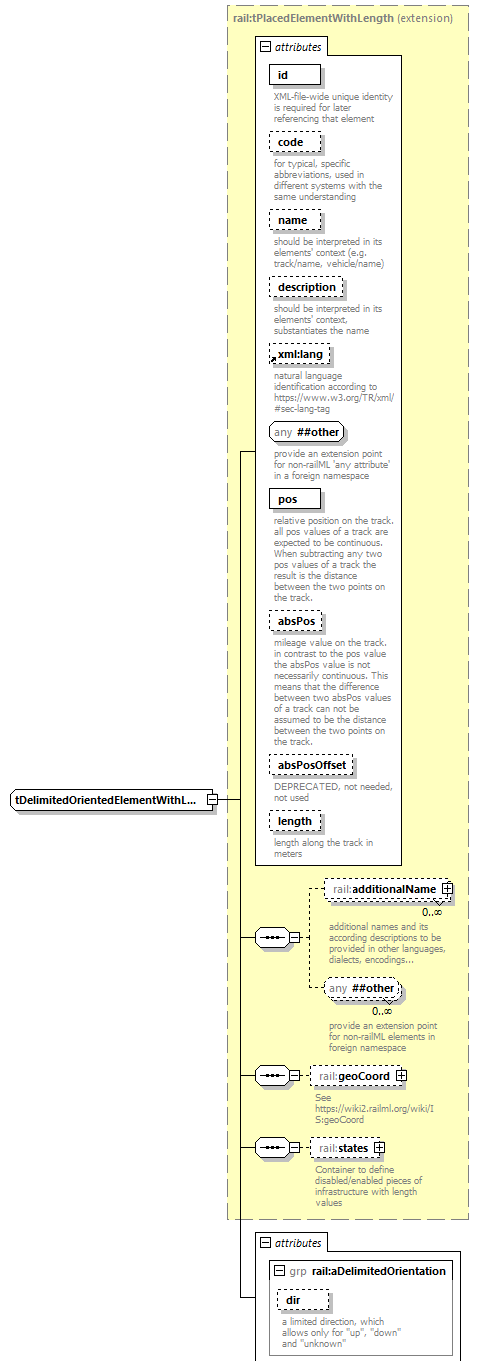 | ||||||||||||||||||||||||||||||||||||||||||||||||||||||||||||||||||||||||||||||||||||||
| namespace | https://www.railml.org/schemas/2021 | ||||||||||||||||||||||||||||||||||||||||||||||||||||||||||||||||||||||||||||||||||||||
| type | extension of rail:tPlacedElementWithLength | ||||||||||||||||||||||||||||||||||||||||||||||||||||||||||||||||||||||||||||||||||||||
| properties |
| ||||||||||||||||||||||||||||||||||||||||||||||||||||||||||||||||||||||||||||||||||||||
| children | rail:additionalName rail:geoCoord rail:states | ||||||||||||||||||||||||||||||||||||||||||||||||||||||||||||||||||||||||||||||||||||||
| attributes |
| ||||||||||||||||||||||||||||||||||||||||||||||||||||||||||||||||||||||||||||||||||||||
| source | <xs:complexType name="tDelimitedOrientedElementWithLength"> <xs:complexContent> <xs:extension base="rail:tPlacedElementWithLength"> <xs:attributeGroup ref="rail:aDelimitedOrientation"/> </xs:extension> </xs:complexContent> </xs:complexType> |
complexType tDelimitedOrientedElementWithLengthDeprecated
| diagram | 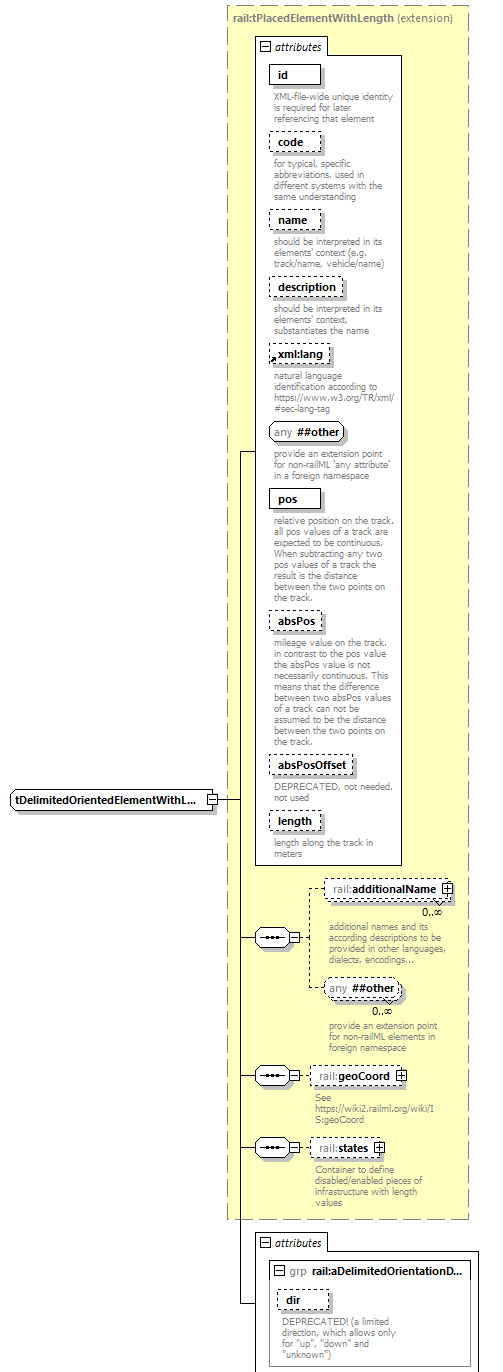 | ||||||||||||||||||||||||||||||||||||||||||||||||||||||||||||||||||||||||||||||||||||||
| namespace | https://www.railml.org/schemas/2021 | ||||||||||||||||||||||||||||||||||||||||||||||||||||||||||||||||||||||||||||||||||||||
| type | extension of rail:tPlacedElementWithLength | ||||||||||||||||||||||||||||||||||||||||||||||||||||||||||||||||||||||||||||||||||||||
| properties |
| ||||||||||||||||||||||||||||||||||||||||||||||||||||||||||||||||||||||||||||||||||||||
| children | rail:additionalName rail:geoCoord rail:states | ||||||||||||||||||||||||||||||||||||||||||||||||||||||||||||||||||||||||||||||||||||||
| used by |
| ||||||||||||||||||||||||||||||||||||||||||||||||||||||||||||||||||||||||||||||||||||||
| attributes |
| ||||||||||||||||||||||||||||||||||||||||||||||||||||||||||||||||||||||||||||||||||||||
| source | <xs:complexType name="tDelimitedOrientedElementWithLengthDeprecated"> <xs:complexContent> <xs:extension base="rail:tPlacedElementWithLength"> <xs:attributeGroup ref="rail:aDelimitedOrientationDeprecated"/> </xs:extension> </xs:complexContent> </xs:complexType> |
complexType tDerailer
| diagram |  | ||||||||||||||||||||||||||||||||||||||||||||||||||||||||||||||||||||||||||||||||||||||||||||||||||||||||||||||||||||||
| namespace | https://www.railml.org/schemas/2021 | ||||||||||||||||||||||||||||||||||||||||||||||||||||||||||||||||||||||||||||||||||||||||||||||||||||||||||||||||||||||
| type | extension of rail:tRuleCodeElement | ||||||||||||||||||||||||||||||||||||||||||||||||||||||||||||||||||||||||||||||||||||||||||||||||||||||||||||||||||||||
| properties |
| ||||||||||||||||||||||||||||||||||||||||||||||||||||||||||||||||||||||||||||||||||||||||||||||||||||||||||||||||||||||
| children | rail:additionalName rail:geoCoord rail:states | ||||||||||||||||||||||||||||||||||||||||||||||||||||||||||||||||||||||||||||||||||||||||||||||||||||||||||||||||||||||
| used by |
| ||||||||||||||||||||||||||||||||||||||||||||||||||||||||||||||||||||||||||||||||||||||||||||||||||||||||||||||||||||||
| attributes |
| ||||||||||||||||||||||||||||||||||||||||||||||||||||||||||||||||||||||||||||||||||||||||||||||||||||||||||||||||||||||
| source | <xs:complexType name="tDerailer"> <xs:complexContent> <xs:extension base="rail:tRuleCodeElement"> <xs:attribute name="derailSide" type="rail:tSide"> <xs:annotation> <xs:documentation>Side, to which the vehicle will be derailed (left or right) considering the orientation of the track.</xs:documentation> </xs:annotation> </xs:attribute> <xs:attribute name="kind" type="rail:tDerailKind"> <xs:annotation> <xs:documentation>kind of derail device (cp. book "Railway Signalling and Interlocking" by Gregor Theeg and Sergej Vlasenko (Editors), p. 155)</xs:documentation> </xs:annotation> </xs:attribute> <xs:attribute name="model" type="xs:string"> <xs:annotation> <xs:documentation>specification of the derailer</xs:documentation> </xs:annotation> </xs:attribute> <xs:attribute name="lockRef" type="rail:tGenericRef"> <xs:annotation> <xs:documentation>Reference to a lock, locking the derailer</xs:documentation> </xs:annotation> </xs:attribute> </xs:extension> </xs:complexContent> </xs:complexType> |
attribute tDerailer/@derailSide
| type | rail:tSide | ||||||||||||||||||
| facets |
| ||||||||||||||||||
| annotation |
| ||||||||||||||||||
| source | <xs:attribute name="derailSide" type="rail:tSide"> <xs:annotation> <xs:documentation>Side, to which the vehicle will be derailed (left or right) considering the orientation of the track.</xs:documentation> </xs:annotation> </xs:attribute> |
attribute tDerailer/@kind
| type | rail:tDerailKind | ||||||||||||||||||
| facets |
| ||||||||||||||||||
| annotation |
| ||||||||||||||||||
| source | <xs:attribute name="kind" type="rail:tDerailKind"> <xs:annotation> <xs:documentation>kind of derail device (cp. book "Railway Signalling and Interlocking" by Gregor Theeg and Sergej Vlasenko (Editors), p. 155)</xs:documentation> </xs:annotation> </xs:attribute> |
attribute tDerailer/@model
| type | xs:string | ||
| annotation |
| ||
| source | <xs:attribute name="model" type="xs:string"> <xs:annotation> <xs:documentation>specification of the derailer</xs:documentation> </xs:annotation> </xs:attribute> |
attribute tDerailer/@lockRef
| type | rail:tGenericRef | ||
| annotation |
| ||
| source | <xs:attribute name="lockRef" type="rail:tGenericRef"> <xs:annotation> <xs:documentation>Reference to a lock, locking the derailer</xs:documentation> </xs:annotation> </xs:attribute> |
complexType tElectrification
| diagram |  | ||||||||||||||||||||||||
| namespace | https://www.railml.org/schemas/2021 | ||||||||||||||||||||||||
| children | rail:maxTrainCurrent | ||||||||||||||||||||||||
| used by |
| ||||||||||||||||||||||||
| attributes |
| ||||||||||||||||||||||||
| source | <xs:complexType name="tElectrification"> <xs:sequence> <xs:element name="maxTrainCurrent" type="rail:tMaxTrainCurrent" minOccurs="0" maxOccurs="unbounded"> <xs:annotation> <xs:documentation>maximum allowed train current</xs:documentation> <xs:documentation>See https://wiki2.railml.org/wiki/IS:maxTrainCurrent</xs:documentation> </xs:annotation> </xs:element> </xs:sequence> <xs:attributeGroup ref="rail:aElectrification"/> </xs:complexType> |
element tElectrification/maxTrainCurrent
| diagram |  | ||||||||||||||||||||||||||||||
| namespace | https://www.railml.org/schemas/2021 | ||||||||||||||||||||||||||||||
| type | rail:tMaxTrainCurrent | ||||||||||||||||||||||||||||||
| properties |
| ||||||||||||||||||||||||||||||
| attributes |
| ||||||||||||||||||||||||||||||
| annotation |
| ||||||||||||||||||||||||||||||
| source | <xs:element name="maxTrainCurrent" type="rail:tMaxTrainCurrent" minOccurs="0" maxOccurs="unbounded"> <xs:annotation> <xs:documentation>maximum allowed train current</xs:documentation> <xs:documentation>See https://wiki2.railml.org/wiki/IS:maxTrainCurrent</xs:documentation> </xs:annotation> </xs:element> |
complexType tElectrificationChange
| diagram |  | ||||||||||||||||||||||||||||||||||||||||||||||||||||||||||||||||||||||||||||||||||||||||||||||||||||||||||||
| namespace | https://www.railml.org/schemas/2021 | ||||||||||||||||||||||||||||||||||||||||||||||||||||||||||||||||||||||||||||||||||||||||||||||||||||||||||||
| type | extension of rail:tDelimitedOrientedElementDeprecated | ||||||||||||||||||||||||||||||||||||||||||||||||||||||||||||||||||||||||||||||||||||||||||||||||||||||||||||
| properties |
| ||||||||||||||||||||||||||||||||||||||||||||||||||||||||||||||||||||||||||||||||||||||||||||||||||||||||||||
| children | rail:additionalName rail:geoCoord rail:states rail:maxTrainCurrent | ||||||||||||||||||||||||||||||||||||||||||||||||||||||||||||||||||||||||||||||||||||||||||||||||||||||||||||
| used by |
| ||||||||||||||||||||||||||||||||||||||||||||||||||||||||||||||||||||||||||||||||||||||||||||||||||||||||||||
| attributes |
| ||||||||||||||||||||||||||||||||||||||||||||||||||||||||||||||||||||||||||||||||||||||||||||||||||||||||||||
| source | <xs:complexType name="tElectrificationChange"> <xs:complexContent> <xs:extension base="rail:tDelimitedOrientedElementDeprecated"> <xs:sequence> <xs:element name="maxTrainCurrent" type="rail:tMaxTrainCurrent" minOccurs="0" maxOccurs="unbounded"> <xs:annotation> <xs:documentation>maximum allowed train current</xs:documentation> <xs:documentation>See https://wiki2.railml.org/wiki/IS:maxTrainCurrent</xs:documentation> </xs:annotation> </xs:element> </xs:sequence> <xs:attributeGroup ref="rail:aElectrification"/> <xs:attribute name="vMax" type="rail:tSpeedKmPerHour"/> <xs:attribute name="isolatedSection" type="xs:boolean" default="false"/> </xs:extension> </xs:complexContent> </xs:complexType> |
attribute tElectrificationChange/@vMax
| type | rail:tSpeedKmPerHour | ||||||||||||
| facets |
| ||||||||||||
| source | <xs:attribute name="vMax" type="rail:tSpeedKmPerHour"/> |
attribute tElectrificationChange/@isolatedSection
| type | xs:boolean | ||
| properties |
| ||
| source | <xs:attribute name="isolatedSection" type="xs:boolean" default="false"/> |
element tElectrificationChange/maxTrainCurrent
| diagram |  | ||||||||||||||||||||||||||||||
| namespace | https://www.railml.org/schemas/2021 | ||||||||||||||||||||||||||||||
| type | rail:tMaxTrainCurrent | ||||||||||||||||||||||||||||||
| properties |
| ||||||||||||||||||||||||||||||
| attributes |
| ||||||||||||||||||||||||||||||
| annotation |
| ||||||||||||||||||||||||||||||
| source | <xs:element name="maxTrainCurrent" type="rail:tMaxTrainCurrent" minOccurs="0" maxOccurs="unbounded"> <xs:annotation> <xs:documentation>maximum allowed train current</xs:documentation> <xs:documentation>See https://wiki2.railml.org/wiki/IS:maxTrainCurrent</xs:documentation> </xs:annotation> </xs:element> |
complexType tEpsgCode
| diagram |  | ||||||||||||||||||
| namespace | https://www.railml.org/schemas/2021 | ||||||||||||||||||
| used by |
| ||||||||||||||||||
| attributes |
| ||||||||||||||||||
| source | <xs:complexType name="tEpsgCode"> <xs:attributeGroup ref="rail:aEpsgCode"/> </xs:complexType> |
complexType tGauge
| diagram |  | ||||||||||||
| namespace | https://www.railml.org/schemas/2021 | ||||||||||||
| used by |
| ||||||||||||
| attributes |
| ||||||||||||
| source | <xs:complexType name="tGauge"> <xs:attributeGroup ref="rail:aGauge"/> </xs:complexType> |
complexType tGaugeChange
| diagram |  | ||||||||||||||||||||||||||||||||||||||||||||||||||||||||||||||||||||||||||||||||||||
| namespace | https://www.railml.org/schemas/2021 | ||||||||||||||||||||||||||||||||||||||||||||||||||||||||||||||||||||||||||||||||||||
| type | extension of rail:tDelimitedOrientedElementDeprecated | ||||||||||||||||||||||||||||||||||||||||||||||||||||||||||||||||||||||||||||||||||||
| properties |
| ||||||||||||||||||||||||||||||||||||||||||||||||||||||||||||||||||||||||||||||||||||
| children | rail:additionalName rail:geoCoord rail:states | ||||||||||||||||||||||||||||||||||||||||||||||||||||||||||||||||||||||||||||||||||||
| used by |
| ||||||||||||||||||||||||||||||||||||||||||||||||||||||||||||||||||||||||||||||||||||
| attributes |
| ||||||||||||||||||||||||||||||||||||||||||||||||||||||||||||||||||||||||||||||||||||
| source | <xs:complexType name="tGaugeChange"> <xs:complexContent> <xs:extension base="rail:tDelimitedOrientedElementDeprecated"> <xs:attributeGroup ref="rail:aGauge"/> </xs:extension> </xs:complexContent> </xs:complexType> |
complexType tGenericArea
| diagram |  | ||||||||||||||||||||||||||||||||||||||||||||||
| namespace | https://www.railml.org/schemas/2021 | ||||||||||||||||||||||||||||||||||||||||||||||
| type | extension of rail:tElementWithIDAndName | ||||||||||||||||||||||||||||||||||||||||||||||
| properties |
| ||||||||||||||||||||||||||||||||||||||||||||||
| children | rail:additionalName rail:location rail:limitedBy | ||||||||||||||||||||||||||||||||||||||||||||||
| used by |
| ||||||||||||||||||||||||||||||||||||||||||||||
| attributes |
| ||||||||||||||||||||||||||||||||||||||||||||||
| source | <xs:complexType name="tGenericArea"> <xs:complexContent> <xs:extension base="rail:tElementWithIDAndName"> <xs:annotation> <xs:documentation>generic area element; the specific purpose of this area is specified by the element that references this area</xs:documentation> </xs:annotation> <xs:sequence> <xs:element name="location" type="rail:tGenericAreaLocation" minOccurs="0"> <xs:annotation> <xs:documentation>location of the area within the track networt or with reference to a coordinate reference system</xs:documentation> <xs:documentation>See https://wiki2.railml.org/wiki/IS:location</xs:documentation> </xs:annotation> </xs:element> <xs:element name="limitedBy" type="rail:tElementRefInGroup" minOccurs="0" maxOccurs="unbounded"> <xs:annotation> <xs:documentation>reference from the area to an element bounding this area</xs:documentation> <xs:documentation>See https://wiki2.railml.org/wiki/IS:limitedBy</xs:documentation> </xs:annotation> </xs:element> </xs:sequence> </xs:extension> </xs:complexContent> </xs:complexType> |
element tGenericArea/location
| diagram |  | ||||||
| namespace | https://www.railml.org/schemas/2021 | ||||||
| type | rail:tGenericAreaLocation | ||||||
| properties |
| ||||||
| children | rail:circle rail:polygon rail:trackLocation | ||||||
| annotation |
| ||||||
| source | <xs:element name="location" type="rail:tGenericAreaLocation" minOccurs="0"> <xs:annotation> <xs:documentation>location of the area within the track networt or with reference to a coordinate reference system</xs:documentation> <xs:documentation>See https://wiki2.railml.org/wiki/IS:location</xs:documentation> </xs:annotation> </xs:element> |
element tGenericArea/limitedBy
| diagram |  | ||||||||||||||||||||
| namespace | https://www.railml.org/schemas/2021 | ||||||||||||||||||||
| type | rail:tElementRefInGroup | ||||||||||||||||||||
| properties |
| ||||||||||||||||||||
| attributes |
| ||||||||||||||||||||
| annotation |
| ||||||||||||||||||||
| source | <xs:element name="limitedBy" type="rail:tElementRefInGroup" minOccurs="0" maxOccurs="unbounded"> <xs:annotation> <xs:documentation>reference from the area to an element bounding this area</xs:documentation> <xs:documentation>See https://wiki2.railml.org/wiki/IS:limitedBy</xs:documentation> </xs:annotation> </xs:element> |
complexType tGenericAreaLocation
| diagram | 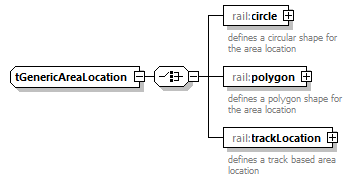 | ||
| namespace | https://www.railml.org/schemas/2021 | ||
| children | rail:circle rail:polygon rail:trackLocation | ||
| used by |
| ||
| source | <xs:complexType name="tGenericAreaLocation"> <xs:choice> <xs:element name="circle" type="rail:tLocationCircle"> <xs:annotation> <xs:documentation>defines a circular shape for the area location</xs:documentation> <xs:documentation>See https://wiki2.railml.org/wiki/IS:circle</xs:documentation> </xs:annotation> </xs:element> <xs:element name="polygon" type="rail:tLocationPolygon"> <xs:annotation> <xs:documentation>defines a polygon shape for the area location</xs:documentation> <xs:documentation>See https://wiki2.railml.org/wiki/IS:polygon</xs:documentation> </xs:annotation> </xs:element> <xs:element name="trackLocation" type="rail:tLocationTrack"> <xs:annotation> <xs:documentation>defines a track based area location</xs:documentation> <xs:documentation>See https://wiki2.railml.org/wiki/IS:trackLocation</xs:documentation> </xs:annotation> </xs:element> </xs:choice> </xs:complexType> |
element tGenericAreaLocation/circle
| diagram | 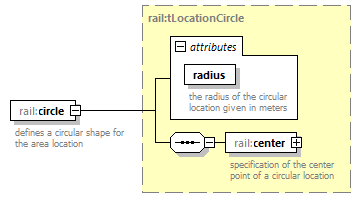 | ||||||||||||||
| namespace | https://www.railml.org/schemas/2021 | ||||||||||||||
| type | rail:tLocationCircle | ||||||||||||||
| properties |
| ||||||||||||||
| children | rail:center | ||||||||||||||
| attributes |
| ||||||||||||||
| annotation |
| ||||||||||||||
| source | <xs:element name="circle" type="rail:tLocationCircle"> <xs:annotation> <xs:documentation>defines a circular shape for the area location</xs:documentation> <xs:documentation>See https://wiki2.railml.org/wiki/IS:circle</xs:documentation> </xs:annotation> </xs:element> |
element tGenericAreaLocation/polygon
| diagram |  | ||||
| namespace | https://www.railml.org/schemas/2021 | ||||
| type | rail:tLocationPolygon | ||||
| properties |
| ||||
| children | rail:point | ||||
| annotation |
| ||||
| source | <xs:element name="polygon" type="rail:tLocationPolygon"> <xs:annotation> <xs:documentation>defines a polygon shape for the area location</xs:documentation> <xs:documentation>See https://wiki2.railml.org/wiki/IS:polygon</xs:documentation> </xs:annotation> </xs:element> |
element tGenericAreaLocation/trackLocation
| diagram | 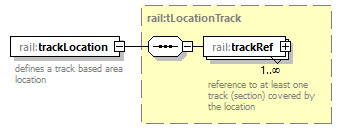 | ||||
| namespace | https://www.railml.org/schemas/2021 | ||||
| type | rail:tLocationTrack | ||||
| properties |
| ||||
| children | rail:trackRef | ||||
| annotation |
| ||||
| source | <xs:element name="trackLocation" type="rail:tLocationTrack"> <xs:annotation> <xs:documentation>defines a track based area location</xs:documentation> <xs:documentation>See https://wiki2.railml.org/wiki/IS:trackLocation</xs:documentation> </xs:annotation> </xs:element> |
complexType tGeoCoord
| diagram |  | ||||||||||||||||||||||||||||||
| namespace | https://www.railml.org/schemas/2021 | ||||||||||||||||||||||||||||||
| used by |
| ||||||||||||||||||||||||||||||
| attributes |
| ||||||||||||||||||||||||||||||
| source | <xs:complexType name="tGeoCoord"> <xs:attribute name="coord" type="rail:tCoordinateList" use="required"/> <xs:attribute name="extraHeight" type="xs:double"/> <xs:attribute name="epsgCode" type="xs:anyURI"/> <xs:attribute name="heightEpsgCode" type="xs:anyURI"/> </xs:complexType> |
attribute tGeoCoord/@coord
| type | rail:tCoordinateList | |||||||||
| properties |
| |||||||||
| facets |
| |||||||||
| source | <xs:attribute name="coord" type="rail:tCoordinateList" use="required"/> |
attribute tGeoCoord/@extraHeight
| type | xs:double |
| source | <xs:attribute name="extraHeight" type="xs:double"/> |
attribute tGeoCoord/@epsgCode
| type | xs:anyURI |
| source | <xs:attribute name="epsgCode" type="xs:anyURI"/> |
attribute tGeoCoord/@heightEpsgCode
| type | xs:anyURI |
| source | <xs:attribute name="heightEpsgCode" type="xs:anyURI"/> |
complexType tGradientChange
| diagram |  | ||||||||||||||||||||||||||||||||||||||||||||||||||||||||||||||||||||||||||||||||||||||||||||||||
| namespace | https://www.railml.org/schemas/2021 | ||||||||||||||||||||||||||||||||||||||||||||||||||||||||||||||||||||||||||||||||||||||||||||||||
| type | extension of rail:tStrictOrientedElement | ||||||||||||||||||||||||||||||||||||||||||||||||||||||||||||||||||||||||||||||||||||||||||||||||
| properties |
| ||||||||||||||||||||||||||||||||||||||||||||||||||||||||||||||||||||||||||||||||||||||||||||||||
| children | rail:additionalName rail:geoCoord rail:states | ||||||||||||||||||||||||||||||||||||||||||||||||||||||||||||||||||||||||||||||||||||||||||||||||
| used by |
| ||||||||||||||||||||||||||||||||||||||||||||||||||||||||||||||||||||||||||||||||||||||||||||||||
| attributes |
| ||||||||||||||||||||||||||||||||||||||||||||||||||||||||||||||||||||||||||||||||||||||||||||||||
| source | <xs:complexType name="tGradientChange"> <xs:complexContent> <xs:extension base="rail:tStrictOrientedElement"> <xs:attribute name="slope" type="rail:tGradientPromille" use="required"/> <xs:attribute name="transitionLenght" type="rail:tLengthM"/> <xs:attribute name="transitionRadius" type="rail:tRadiusM"/> </xs:extension> </xs:complexContent> </xs:complexType> |
attribute tGradientChange/@slope
| type | rail:tGradientPromille | ||||||
| properties |
| ||||||
| facets |
| ||||||
| source | <xs:attribute name="slope" type="rail:tGradientPromille" use="required"/> |
attribute tGradientChange/@transitionLenght
| type | rail:tLengthM | ||||||
| facets |
| ||||||
| source | <xs:attribute name="transitionLenght" type="rail:tLengthM"/> |
attribute tGradientChange/@transitionRadius
| type | rail:tRadiusM | ||||||
| facets |
| ||||||
| source | <xs:attribute name="transitionRadius" type="rail:tRadiusM"/> |
complexType tImpairmentSection
| diagram | 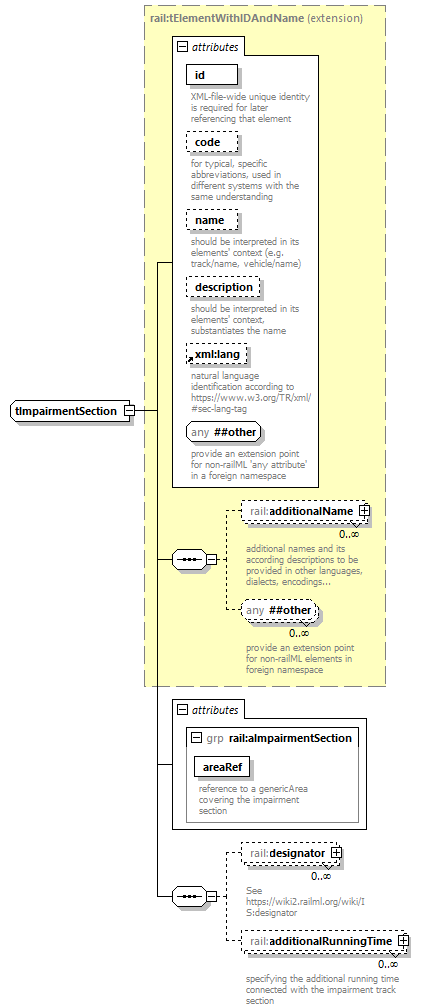 | ||||||||||||||||||||||||||||||||||||||||||||||||||||||
| namespace | https://www.railml.org/schemas/2021 | ||||||||||||||||||||||||||||||||||||||||||||||||||||||
| type | extension of rail:tElementWithIDAndName | ||||||||||||||||||||||||||||||||||||||||||||||||||||||
| properties |
| ||||||||||||||||||||||||||||||||||||||||||||||||||||||
| children | rail:additionalName rail:designator rail:additionalRunningTime | ||||||||||||||||||||||||||||||||||||||||||||||||||||||
| used by |
| ||||||||||||||||||||||||||||||||||||||||||||||||||||||
| attributes |
| ||||||||||||||||||||||||||||||||||||||||||||||||||||||
| source | <xs:complexType name="tImpairmentSection"> <xs:complexContent> <xs:extension base="rail:tElementWithIDAndName"> <xs:sequence> <xs:element name="designator" type="rail:tDesignator" minOccurs="0" maxOccurs="unbounded"> <xs:annotation> <xs:documentation>See https://wiki2.railml.org/wiki/IS:designator</xs:documentation> </xs:annotation> </xs:element> <xs:element name="additionalRunningTime" type="rail:tImpairmentSectionAdditionalRunningTime" minOccurs="0" maxOccurs="unbounded"> <xs:annotation> <xs:documentation>specifying the additional running time connected with the impairment track section</xs:documentation> <xs:documentation>See https://wiki2.railml.org/wiki/IS:additionalRunningTime</xs:documentation> </xs:annotation> </xs:element> </xs:sequence> <xs:attributeGroup ref="rail:aImpairmentSection"/> </xs:extension> </xs:complexContent> </xs:complexType> |
element tImpairmentSection/designator
| diagram |  | ||||||||||||||||||||||||||||||||||||
| namespace | https://www.railml.org/schemas/2021 | ||||||||||||||||||||||||||||||||||||
| type | rail:tDesignator | ||||||||||||||||||||||||||||||||||||
| properties |
| ||||||||||||||||||||||||||||||||||||
| attributes |
| ||||||||||||||||||||||||||||||||||||
| annotation |
| ||||||||||||||||||||||||||||||||||||
| source | <xs:element name="designator" type="rail:tDesignator" minOccurs="0" maxOccurs="unbounded"> <xs:annotation> <xs:documentation>See https://wiki2.railml.org/wiki/IS:designator</xs:documentation> </xs:annotation> </xs:element> |
element tImpairmentSection/additionalRunningTime
| diagram |  | ||||||||||||||||||||||
| namespace | https://www.railml.org/schemas/2021 | ||||||||||||||||||||||
| type | rail:tImpairmentSectionAdditionalRunningTime | ||||||||||||||||||||||
| properties |
| ||||||||||||||||||||||
| attributes |
| ||||||||||||||||||||||
| annotation |
| ||||||||||||||||||||||
| source | <xs:element name="additionalRunningTime" type="rail:tImpairmentSectionAdditionalRunningTime" minOccurs="0" maxOccurs="unbounded"> <xs:annotation> <xs:documentation>specifying the additional running time connected with the impairment track section</xs:documentation> <xs:documentation>See https://wiki2.railml.org/wiki/IS:additionalRunningTime</xs:documentation> </xs:annotation> </xs:element> |
complexType tImpairmentSectionAdditionalRunningTime
| diagram |  | ||||||||||||||||||||||
| namespace | https://www.railml.org/schemas/2021 | ||||||||||||||||||||||
| used by |
| ||||||||||||||||||||||
| attributes |
| ||||||||||||||||||||||
| source | <xs:complexType name="tImpairmentSectionAdditionalRunningTime"> <xs:attribute name="value" type="xs:duration" use="required"> <xs:annotation> <xs:documentation>quantify the additional running time (in form of xs:duration)</xs:documentation> </xs:annotation> </xs:attribute> <xs:attribute name="absDir" type="rail:tMileageDirection"> <xs:annotation> <xs:documentation>define the travel direction for which the additional running time applies</xs:documentation> </xs:annotation> </xs:attribute> </xs:complexType> |
attribute tImpairmentSectionAdditionalRunningTime/@value
| type | xs:duration | ||
| properties |
| ||
| annotation |
| ||
| source | <xs:attribute name="value" type="xs:duration" use="required"> <xs:annotation> <xs:documentation>quantify the additional running time (in form of xs:duration)</xs:documentation> </xs:annotation> </xs:attribute> |
attribute tImpairmentSectionAdditionalRunningTime/@absDir
| type | rail:tMileageDirection | |||||||||
| facets |
| |||||||||
| annotation |
| |||||||||
| source | <xs:attribute name="absDir" type="rail:tMileageDirection"> <xs:annotation> <xs:documentation>define the travel direction for which the additional running time applies</xs:documentation> </xs:annotation> </xs:attribute> |
complexType tInformationArea
| diagram |  | ||||||||||||||
| namespace | https://www.railml.org/schemas/2021 | ||||||||||||||
| type | extension of rail:tElementWithReference | ||||||||||||||
| properties |
| ||||||||||||||
| used by |
| ||||||||||||||
| attributes |
| ||||||||||||||
| source | <xs:complexType name="tInformationArea"> <xs:complexContent> <xs:extension base="rail:tElementWithReference"/> <!-- Possible information area specific attributes to be added here later --> </xs:complexContent> </xs:complexType> |
complexType tInfrastructure
| diagram |  | ||||||||||||||||||||||||||||||||||||||||||||||||||||||||||||||||||||||||||||||
| namespace | https://www.railml.org/schemas/2021 | ||||||||||||||||||||||||||||||||||||||||||||||||||||||||||||||||||||||||||||||
| type | extension of rail:tGlobalElementWithMetadata | ||||||||||||||||||||||||||||||||||||||||||||||||||||||||||||||||||||||||||||||
| properties |
| ||||||||||||||||||||||||||||||||||||||||||||||||||||||||||||||||||||||||||||||
| children | rail:additionalName rail:metadata | ||||||||||||||||||||||||||||||||||||||||||||||||||||||||||||||||||||||||||||||
| used by |
| ||||||||||||||||||||||||||||||||||||||||||||||||||||||||||||||||||||||||||||||
| attributes |
| ||||||||||||||||||||||||||||||||||||||||||||||||||||||||||||||||||||||||||||||
| source | <xs:complexType name="tInfrastructure"> <xs:complexContent> <xs:extension base="rail:tGlobalElementWithMetadata"> <xs:attributeGroup ref="rail:aInfrastructure"/> </xs:extension> </xs:complexContent> </xs:complexType> |
complexType tInfrastructureVisualization
| diagram |  | ||||||||||||||||||||||||
| namespace | https://www.railml.org/schemas/2021 | ||||||||||||||||||||||||
| used by |
| ||||||||||||||||||||||||
| attributes |
| ||||||||||||||||||||||||
| source | <xs:complexType name="tInfrastructureVisualization"> <xs:attribute name="version" type="rail:tRailMLVersion" use="required"/> <xs:attribute name="infrastructureRef" type="rail:tGenericRef"/> <xs:attribute name="id" type="rail:tGenericID" use="required"/> </xs:complexType> |
attribute tInfrastructureVisualization/@version
| type | rail:tRailMLVersion | ||||||
| properties |
| ||||||
| facets |
| ||||||
| source | <xs:attribute name="version" type="rail:tRailMLVersion" use="required"/> |
attribute tInfrastructureVisualization/@infrastructureRef
| type | rail:tGenericRef |
| source | <xs:attribute name="infrastructureRef" type="rail:tGenericRef"/> |
attribute tInfrastructureVisualization/@id
| type | rail:tGenericID | ||
| properties |
| ||
| source | <xs:attribute name="id" type="rail:tGenericID" use="required"/> |
complexType tLevelCrossing
| diagram |  | ||||||||||||||||||||||||||||||||||||||||||||||||||||||||||||||||||||||||||||||||||||||||||||||||||||||||||||||||||||||||||||||
| namespace | https://www.railml.org/schemas/2021 | ||||||||||||||||||||||||||||||||||||||||||||||||||||||||||||||||||||||||||||||||||||||||||||||||||||||||||||||||||||||||||||||
| type | extension of rail:tDelimitedOrientedElementDeprecated | ||||||||||||||||||||||||||||||||||||||||||||||||||||||||||||||||||||||||||||||||||||||||||||||||||||||||||||||||||||||||||||||
| properties |
| ||||||||||||||||||||||||||||||||||||||||||||||||||||||||||||||||||||||||||||||||||||||||||||||||||||||||||||||||||||||||||||||
| children | rail:additionalName rail:geoCoord rail:states | ||||||||||||||||||||||||||||||||||||||||||||||||||||||||||||||||||||||||||||||||||||||||||||||||||||||||||||||||||||||||||||||
| used by |
| ||||||||||||||||||||||||||||||||||||||||||||||||||||||||||||||||||||||||||||||||||||||||||||||||||||||||||||||||||||||||||||||
| attributes |
| ||||||||||||||||||||||||||||||||||||||||||||||||||||||||||||||||||||||||||||||||||||||||||||||||||||||||||||||||||||||||||||||
| source | <xs:complexType name="tLevelCrossing"> <xs:complexContent> <xs:extension base="rail:tDelimitedOrientedElementDeprecated"> <xs:attribute name="length" type="rail:tLengthM"> <xs:annotation> <xs:documentation>length of the level crossing from railway point of view</xs:documentation> </xs:annotation> </xs:attribute> <xs:attribute name="angle" type="rail:tAngleDegQuadrant"> <xs:annotation> <xs:documentation>crossing angle between road and railway in degrees</xs:documentation> </xs:annotation> </xs:attribute> <xs:attribute name="protection" type="xs:string"> <xs:annotation> <xs:documentation>technical protection equipment at the level crossing</xs:documentation> </xs:annotation> </xs:attribute> <xs:attribute name="offset" type="rail:tLengthM"> <xs:annotation> <xs:documentation>describes how many meters of the @length value is before @pos. If @offset is not defined, by default @pos describes the geometric center of the level crossing.</xs:documentation> </xs:annotation> </xs:attribute> <xs:attributeGroup ref="rail:aOcpRef"/> </xs:extension> </xs:complexContent> </xs:complexType> |
attribute tLevelCrossing/@length
| type | rail:tLengthM | ||||||
| facets |
| ||||||
| annotation |
| ||||||
| source | <xs:attribute name="length" type="rail:tLengthM"> <xs:annotation> <xs:documentation>length of the level crossing from railway point of view</xs:documentation> </xs:annotation> </xs:attribute> |
attribute tLevelCrossing/@angle
| type | rail:tAngleDegQuadrant | ||||||||||||||||||
| facets |
| ||||||||||||||||||
| annotation |
| ||||||||||||||||||
| source | <xs:attribute name="angle" type="rail:tAngleDegQuadrant"> <xs:annotation> <xs:documentation>crossing angle between road and railway in degrees</xs:documentation> </xs:annotation> </xs:attribute> |
attribute tLevelCrossing/@protection
| type | xs:string | ||
| annotation |
| ||
| source | <xs:attribute name="protection" type="xs:string"> <xs:annotation> <xs:documentation>technical protection equipment at the level crossing</xs:documentation> </xs:annotation> </xs:attribute> |
attribute tLevelCrossing/@offset
| type | rail:tLengthM | ||||||
| facets |
| ||||||
| annotation |
| ||||||
| source | <xs:attribute name="offset" type="rail:tLengthM"> <xs:annotation> <xs:documentation>describes how many meters of the @length value is before @pos. If @offset is not defined, by default @pos describes the geometric center of the level crossing.</xs:documentation> </xs:annotation> </xs:attribute> |
complexType tLine
| diagram |  | ||||||||||||||||||||||||||||||||||||||||||||||||||||||||||||||||||||||||||||||
| namespace | https://www.railml.org/schemas/2021 | ||||||||||||||||||||||||||||||||||||||||||||||||||||||||||||||||||||||||||||||
| type | extension of rail:tElementWithIDAndName | ||||||||||||||||||||||||||||||||||||||||||||||||||||||||||||||||||||||||||||||
| properties |
| ||||||||||||||||||||||||||||||||||||||||||||||||||||||||||||||||||||||||||||||
| children | rail:additionalName rail:states | ||||||||||||||||||||||||||||||||||||||||||||||||||||||||||||||||||||||||||||||
| used by |
| ||||||||||||||||||||||||||||||||||||||||||||||||||||||||||||||||||||||||||||||
| attributes |
| ||||||||||||||||||||||||||||||||||||||||||||||||||||||||||||||||||||||||||||||
| source | <xs:complexType name="tLine"> <xs:complexContent> <xs:extension base="rail:tElementWithIDAndName"> <xs:sequence> <xs:element name="states" type="rail:tStates" minOccurs="0"> <xs:annotation> <xs:documentation>Container to define disabled/enabled lines</xs:documentation> <xs:documentation>See https://wiki2.railml.org/wiki/IS:states</xs:documentation> </xs:annotation> </xs:element> </xs:sequence> <xs:attributeGroup ref="rail:aLine"/> </xs:extension> </xs:complexContent> </xs:complexType> |
element tLine/states
| diagram | 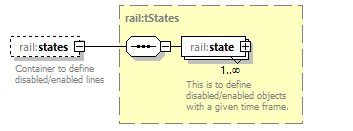 | ||||||
| namespace | https://www.railml.org/schemas/2021 | ||||||
| type | rail:tStates | ||||||
| properties |
| ||||||
| children | rail:state | ||||||
| annotation |
| ||||||
| source | <xs:element name="states" type="rail:tStates" minOccurs="0"> <xs:annotation> <xs:documentation>Container to define disabled/enabled lines</xs:documentation> <xs:documentation>See https://wiki2.railml.org/wiki/IS:states</xs:documentation> </xs:annotation> </xs:element> |
complexType tLocallyControlledArea
| diagram |  | ||||||||||||||||||||||||||||||||||||||||||||||||||||||||||||||||||||||
| namespace | https://www.railml.org/schemas/2021 | ||||||||||||||||||||||||||||||||||||||||||||||||||||||||||||||||||||||
| type | extension of rail:tElementWithIDAndName | ||||||||||||||||||||||||||||||||||||||||||||||||||||||||||||||||||||||
| properties |
| ||||||||||||||||||||||||||||||||||||||||||||||||||||||||||||||||||||||
| children | rail:additionalName rail:states | ||||||||||||||||||||||||||||||||||||||||||||||||||||||||||||||||||||||
| used by |
| ||||||||||||||||||||||||||||||||||||||||||||||||||||||||||||||||||||||
| attributes |
| ||||||||||||||||||||||||||||||||||||||||||||||||||||||||||||||||||||||
| source | <xs:complexType name="tLocallyControlledArea"> <xs:complexContent> <xs:extension base="rail:tElementWithIDAndName"> <xs:sequence> <xs:element name="states" type="rail:tStates" minOccurs="0"> <xs:annotation> <xs:documentation>Container to define disabled/enabled locally controlled areas</xs:documentation> <xs:documentation>See https://wiki2.railml.org/wiki/IS:states</xs:documentation> </xs:annotation> </xs:element> </xs:sequence> <xs:attribute name="ocpRef" type="rail:tGenericRef"> <xs:annotation> <xs:documentation>DEPRECATED: use attribute 'ocpStationRef' or 'controllerRef' instead</xs:documentation> </xs:annotation> </xs:attribute> <xs:attributeGroup ref="rail:aOcpRef"/> </xs:extension> </xs:complexContent> </xs:complexType> |
attribute tLocallyControlledArea/@ocpRef
| type | rail:tGenericRef | ||
| annotation |
| ||
| source | <xs:attribute name="ocpRef" type="rail:tGenericRef"> <xs:annotation> <xs:documentation>DEPRECATED: use attribute 'ocpStationRef' or 'controllerRef' instead</xs:documentation> </xs:annotation> </xs:attribute> |
element tLocallyControlledArea/states
| diagram |  | ||||||
| namespace | https://www.railml.org/schemas/2021 | ||||||
| type | rail:tStates | ||||||
| properties |
| ||||||
| children | rail:state | ||||||
| annotation |
| ||||||
| source | <xs:element name="states" type="rail:tStates" minOccurs="0"> <xs:annotation> <xs:documentation>Container to define disabled/enabled locally controlled areas</xs:documentation> <xs:documentation>See https://wiki2.railml.org/wiki/IS:states</xs:documentation> </xs:annotation> </xs:element> |
complexType tLocalOperationArea
| diagram |  | ||||||||||||||
| namespace | https://www.railml.org/schemas/2021 | ||||||||||||||
| type | extension of rail:tElementWithReference | ||||||||||||||
| properties |
| ||||||||||||||
| used by |
| ||||||||||||||
| attributes |
| ||||||||||||||
| source | <xs:complexType name="tLocalOperationArea"> <xs:complexContent> <xs:extension base="rail:tElementWithReference"/> <!-- Possible local operation area specific attributes to be added here later --> </xs:complexContent> </xs:complexType> |
complexType tLocation
| diagram |  | ||||||||||||||||||||||||||||||||||||||
| namespace | https://www.railml.org/schemas/2021 | ||||||||||||||||||||||||||||||||||||||
| children | rail:geoCoord | ||||||||||||||||||||||||||||||||||||||
| used by |
| ||||||||||||||||||||||||||||||||||||||
| attributes |
| ||||||||||||||||||||||||||||||||||||||
| source | <xs:complexType name="tLocation"> <xs:sequence> <xs:element name="geoCoord" type="rail:tGeoCoord" minOccurs="0"> <xs:annotation> <xs:documentation>location described by geographic coordinates</xs:documentation> <xs:documentation>See https://wiki2.railml.org/wiki/IS:geoCoord</xs:documentation> </xs:annotation> </xs:element> </xs:sequence> <xs:attribute name="ocpRef" type="rail:tGenericRef"> <xs:annotation> <xs:documentation>location described by the reference to a well-known 'operation or control point' defined in the same railML file</xs:documentation> </xs:annotation> </xs:attribute> <xs:attributeGroup ref="rail:aRelPosition"/> <xs:attributeGroup ref="rail:aAbsPosition"/> </xs:complexType> |
attribute tLocation/@ocpRef
| type | rail:tGenericRef | ||
| annotation |
| ||
| source | <xs:attribute name="ocpRef" type="rail:tGenericRef"> <xs:annotation> <xs:documentation>location described by the reference to a well-known 'operation or control point' defined in the same railML file</xs:documentation> </xs:annotation> </xs:attribute> |
element tLocation/geoCoord
| diagram |  | ||||||||||||||||||||||||||||||
| namespace | https://www.railml.org/schemas/2021 | ||||||||||||||||||||||||||||||
| type | rail:tGeoCoord | ||||||||||||||||||||||||||||||
| properties |
| ||||||||||||||||||||||||||||||
| attributes |
| ||||||||||||||||||||||||||||||
| annotation |
| ||||||||||||||||||||||||||||||
| source | <xs:element name="geoCoord" type="rail:tGeoCoord" minOccurs="0"> <xs:annotation> <xs:documentation>location described by geographic coordinates</xs:documentation> <xs:documentation>See https://wiki2.railml.org/wiki/IS:geoCoord</xs:documentation> </xs:annotation> </xs:element> |
complexType tLocationCircle
| diagram |  | ||||||||||||||
| namespace | https://www.railml.org/schemas/2021 | ||||||||||||||
| children | rail:center | ||||||||||||||
| used by |
| ||||||||||||||
| attributes |
| ||||||||||||||
| source | <xs:complexType name="tLocationCircle"> <xs:sequence> <xs:element name="center" type="rail:tGeoCoord"> <xs:annotation> <xs:documentation>specification of the center point of a circular location</xs:documentation> <xs:documentation>See https://wiki2.railml.org/wiki/IS:center</xs:documentation> </xs:annotation> </xs:element> </xs:sequence> <xs:attribute name="radius" type="rail:tLengthM" use="required"> <xs:annotation> <xs:documentation>the radius of the circular location given in meters</xs:documentation> </xs:annotation> </xs:attribute> </xs:complexType> |
attribute tLocationCircle/@radius
| type | rail:tLengthM | ||||||
| properties |
| ||||||
| facets |
| ||||||
| annotation |
| ||||||
| source | <xs:attribute name="radius" type="rail:tLengthM" use="required"> <xs:annotation> <xs:documentation>the radius of the circular location given in meters</xs:documentation> </xs:annotation> </xs:attribute> |
element tLocationCircle/center
| diagram | 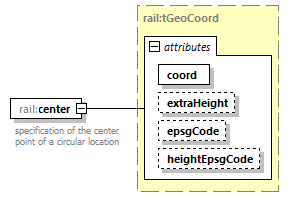 | ||||||||||||||||||||||||||||||
| namespace | https://www.railml.org/schemas/2021 | ||||||||||||||||||||||||||||||
| type | rail:tGeoCoord | ||||||||||||||||||||||||||||||
| properties |
| ||||||||||||||||||||||||||||||
| attributes |
| ||||||||||||||||||||||||||||||
| annotation |
| ||||||||||||||||||||||||||||||
| source | <xs:element name="center" type="rail:tGeoCoord"> <xs:annotation> <xs:documentation>specification of the center point of a circular location</xs:documentation> <xs:documentation>See https://wiki2.railml.org/wiki/IS:center</xs:documentation> </xs:annotation> </xs:element> |
complexType tLocationPolygon
| diagram |  | ||
| namespace | https://www.railml.org/schemas/2021 | ||
| children | rail:point | ||
| used by |
| ||
| source | <xs:complexType name="tLocationPolygon"> <xs:sequence> <xs:element name="point" type="rail:tGeoCoord" minOccurs="3" maxOccurs="unbounded"> <xs:annotation> <xs:documentation>specification of the polygon by its bounding nodes; first and last point are connected to close the polygon</xs:documentation> <xs:documentation>See https://wiki2.railml.org/wiki/IS:point</xs:documentation> </xs:annotation> </xs:element> </xs:sequence> </xs:complexType> |
element tLocationPolygon/point
| diagram |  | ||||||||||||||||||||||||||||||
| namespace | https://www.railml.org/schemas/2021 | ||||||||||||||||||||||||||||||
| type | rail:tGeoCoord | ||||||||||||||||||||||||||||||
| properties |
| ||||||||||||||||||||||||||||||
| attributes |
| ||||||||||||||||||||||||||||||
| annotation |
| ||||||||||||||||||||||||||||||
| source | <xs:element name="point" type="rail:tGeoCoord" minOccurs="3" maxOccurs="unbounded"> <xs:annotation> <xs:documentation>specification of the polygon by its bounding nodes; first and last point are connected to close the polygon</xs:documentation> <xs:documentation>See https://wiki2.railml.org/wiki/IS:point</xs:documentation> </xs:annotation> </xs:element> |
complexType tLocationTrack
| diagram |  | ||
| namespace | https://www.railml.org/schemas/2021 | ||
| children | rail:trackRef | ||
| used by |
| ||
| source | <xs:complexType name="tLocationTrack"> <xs:sequence> <xs:element name="trackRef" type="rail:tLocationTrackRef" maxOccurs="unbounded"> <xs:annotation> <xs:documentation>reference to at least one track (section) covered by the location</xs:documentation> <xs:documentation>See https://wiki2.railml.org/wiki/IS:trackRef_trackLocation</xs:documentation> </xs:annotation> </xs:element> </xs:sequence> </xs:complexType> |
element tLocationTrack/trackRef
| diagram |  | ||||||||||||||||||||||||||||||
| namespace | https://www.railml.org/schemas/2021 | ||||||||||||||||||||||||||||||
| type | rail:tLocationTrackRef | ||||||||||||||||||||||||||||||
| properties |
| ||||||||||||||||||||||||||||||
| attributes |
| ||||||||||||||||||||||||||||||
| annotation |
| ||||||||||||||||||||||||||||||
| source | <xs:element name="trackRef" type="rail:tLocationTrackRef" maxOccurs="unbounded"> <xs:annotation> <xs:documentation>reference to at least one track (section) covered by the location</xs:documentation> <xs:documentation>See https://wiki2.railml.org/wiki/IS:trackRef_trackLocation</xs:documentation> </xs:annotation> </xs:element> |
complexType tLocationTrackRef
| diagram |  | ||||||||||||||||||||||||||||||
| namespace | https://www.railml.org/schemas/2021 | ||||||||||||||||||||||||||||||
| type | extension of rail:tElementWithReference | ||||||||||||||||||||||||||||||
| properties |
| ||||||||||||||||||||||||||||||
| used by |
| ||||||||||||||||||||||||||||||
| attributes |
| ||||||||||||||||||||||||||||||
| source | <xs:complexType name="tLocationTrackRef"> <xs:complexContent> <xs:extension base="rail:tElementWithReference"> <xs:attribute name="fromPos" type="rail:tLengthM"> <xs:annotation> <xs:documentation>relative position on track where location starts</xs:documentation> </xs:annotation> </xs:attribute> <xs:attribute name="toPos" type="rail:tLengthM"> <xs:annotation> <xs:documentation>relative position on track where location ends</xs:documentation> </xs:annotation> </xs:attribute> </xs:extension> </xs:complexContent> </xs:complexType> |
attribute tLocationTrackRef/@fromPos
| type | rail:tLengthM | ||||||
| facets |
| ||||||
| annotation |
| ||||||
| source | <xs:attribute name="fromPos" type="rail:tLengthM"> <xs:annotation> <xs:documentation>relative position on track where location starts</xs:documentation> </xs:annotation> </xs:attribute> |
attribute tLocationTrackRef/@toPos
| type | rail:tLengthM | ||||||
| facets |
| ||||||
| annotation |
| ||||||
| source | <xs:attribute name="toPos" type="rail:tLengthM"> <xs:annotation> <xs:documentation>relative position on track where location ends</xs:documentation> </xs:annotation> </xs:attribute> |
complexType tLock
| diagram |  | ||||||||||||||||||||||||||||||||||||||||||||||||||||||||||||||||||||||||||||||||||||||||||||||||||||||||||||||||||||
| namespace | https://www.railml.org/schemas/2021 | ||||||||||||||||||||||||||||||||||||||||||||||||||||||||||||||||||||||||||||||||||||||||||||||||||||||||||||||||||||
| type | extension of rail:tOrientedElement | ||||||||||||||||||||||||||||||||||||||||||||||||||||||||||||||||||||||||||||||||||||||||||||||||||||||||||||||||||||
| properties |
| ||||||||||||||||||||||||||||||||||||||||||||||||||||||||||||||||||||||||||||||||||||||||||||||||||||||||||||||||||||
| children | rail:additionalName rail:geoCoord rail:states rail:lockedElement | ||||||||||||||||||||||||||||||||||||||||||||||||||||||||||||||||||||||||||||||||||||||||||||||||||||||||||||||||||||
| used by |
| ||||||||||||||||||||||||||||||||||||||||||||||||||||||||||||||||||||||||||||||||||||||||||||||||||||||||||||||||||||
| attributes |
| ||||||||||||||||||||||||||||||||||||||||||||||||||||||||||||||||||||||||||||||||||||||||||||||||||||||||||||||||||||
| source | <xs:complexType name="tLock"> <xs:complexContent> <xs:extension base="rail:tOrientedElement"> <xs:sequence> <xs:element name="lockedElement" type="rail:tLockedElement" minOccurs="0" maxOccurs="unbounded"> <xs:annotation> <xs:documentation>reference to the infrastructure elements that are locked together</xs:documentation> <xs:documentation>See https://wiki2.railml.org/wiki/IS:lockedElement</xs:documentation> </xs:annotation> </xs:element> </xs:sequence> <xs:attributeGroup ref="rail:aLock"/> <xs:attributeGroup ref="rail:anyAttribute"> <xs:annotation> <xs:documentation>provide an extension point for non-railML attributes in foreign namespace</xs:documentation> </xs:annotation> </xs:attributeGroup> </xs:extension> </xs:complexContent> </xs:complexType> |
element tLock/lockedElement
| diagram |  | ||||||||||||||||||||
| namespace | https://www.railml.org/schemas/2021 | ||||||||||||||||||||
| type | rail:tLockedElement | ||||||||||||||||||||
| properties |
| ||||||||||||||||||||
| attributes |
| ||||||||||||||||||||
| annotation |
| ||||||||||||||||||||
| source | <xs:element name="lockedElement" type="rail:tLockedElement" minOccurs="0" maxOccurs="unbounded"> <xs:annotation> <xs:documentation>reference to the infrastructure elements that are locked together</xs:documentation> <xs:documentation>See https://wiki2.railml.org/wiki/IS:lockedElement</xs:documentation> </xs:annotation> </xs:element> |
complexType tLockedElement
| diagram |  | ||||||||||||||||||||
| namespace | https://www.railml.org/schemas/2021 | ||||||||||||||||||||
| type | extension of rail:tElementWithReference | ||||||||||||||||||||
| properties |
| ||||||||||||||||||||
| used by |
| ||||||||||||||||||||
| attributes |
| ||||||||||||||||||||
| source | <xs:complexType name="tLockedElement"> <xs:complexContent> <xs:extension base="rail:tElementWithReference"> <xs:attribute name="hasKeyByDefault" type="xs:boolean"/> </xs:extension> </xs:complexContent> </xs:complexType> |
attribute tLockedElement/@hasKeyByDefault
| type | xs:boolean |
| source | <xs:attribute name="hasKeyByDefault" type="xs:boolean"/> |
complexType tMacroscopicNode
| diagram |  | ||||||||||||||||||
| namespace | https://www.railml.org/schemas/2021 | ||||||||||||||||||
| used by |
| ||||||||||||||||||
| attributes |
| ||||||||||||||||||
| annotation |
| ||||||||||||||||||
| source | <xs:complexType name="tMacroscopicNode"> <xs:annotation> <xs:documentation>also "Star" or "Hub"</xs:documentation> </xs:annotation> <xs:attribute name="ocpRef" type="rail:tGenericRef" use="required"/> <xs:attribute name="flowDirection" type="rail:tFlowDirection" default="both"/> </xs:complexType> |
attribute tMacroscopicNode/@ocpRef
| type | rail:tGenericRef | ||
| properties |
| ||
| source | <xs:attribute name="ocpRef" type="rail:tGenericRef" use="required"/> |
attribute tMacroscopicNode/@flowDirection
| type | rail:tFlowDirection | ||
| properties |
| ||
| source | <xs:attribute name="flowDirection" type="rail:tFlowDirection" default="both"/> |
complexType tMaxTrainCurrent
| diagram |  | ||||||||||||||||||||||||||||||
| namespace | https://www.railml.org/schemas/2021 | ||||||||||||||||||||||||||||||
| used by |
| ||||||||||||||||||||||||||||||
| attributes |
| ||||||||||||||||||||||||||||||
| source | <xs:complexType name="tMaxTrainCurrent"> <xs:attribute name="maxCurrent" type="rail:tCurrentAmpere"> <xs:annotation> <xs:documentation>maximum allowed current for the train in Ampere</xs:documentation> </xs:annotation> </xs:attribute> <xs:attribute name="type" type="rail:tMaxTrainCurrentType"> <xs:annotation> <xs:documentation>type of operation for maximum train current: standstill or driving</xs:documentation> </xs:annotation> </xs:attribute> <xs:attribute name="validFor" type="rail:tMaxTrainCurrentValidFor"> <xs:annotation> <xs:documentation>application of maximum train current: train or pantograph</xs:documentation> </xs:annotation> </xs:attribute> <xs:attributeGroup ref="rail:anyAttribute"/> </xs:complexType> |
attribute tMaxTrainCurrent/@maxCurrent
| type | rail:tCurrentAmpere | ||||||
| facets |
| ||||||
| annotation |
| ||||||
| source | <xs:attribute name="maxCurrent" type="rail:tCurrentAmpere"> <xs:annotation> <xs:documentation>maximum allowed current for the train in Ampere</xs:documentation> </xs:annotation> </xs:attribute> |
attribute tMaxTrainCurrent/@type
| type | rail:tMaxTrainCurrentType | |||||||||
| facets |
| |||||||||
| annotation |
| |||||||||
| source | <xs:attribute name="type" type="rail:tMaxTrainCurrentType"> <xs:annotation> <xs:documentation>type of operation for maximum train current: standstill or driving</xs:documentation> </xs:annotation> </xs:attribute> |
attribute tMaxTrainCurrent/@validFor
| type | rail:tMaxTrainCurrentValidFor | |||||||||
| facets |
| |||||||||
| annotation |
| |||||||||
| source | <xs:attribute name="validFor" type="rail:tMaxTrainCurrentValidFor"> <xs:annotation> <xs:documentation>application of maximum train current: train or pantograph</xs:documentation> </xs:annotation> </xs:attribute> |
complexType tMediaAudioFragment
| diagram |  | ||||||||||||||||||||||
| namespace | https://www.railml.org/schemas/2021 | ||||||||||||||||||||||
| children | rail:textToSpeechTemplate | ||||||||||||||||||||||
| used by |
| ||||||||||||||||||||||
| attributes |
| ||||||||||||||||||||||
| source | <xs:complexType name="tMediaAudioFragment"> <xs:sequence> <xs:element name="textToSpeechTemplate" type="rail:tInfoTextBase" minOccurs="0"> <xs:annotation> <xs:documentation>allows to specify text to speech templates to be used for placeholder replacements in text-to-speech based announcements. This is managed separately from text fragments for special text placeholder replacement as text to speech templates usually contain special characters for encoding special phonetics, especially when dealing with location names.</xs:documentation> <xs:documentation>See https://wiki2.railml.org/wiki/IS:textToSpeechTemplate</xs:documentation> </xs:annotation> </xs:element> </xs:sequence> <xs:attribute name="code" type="rail:tGenericName"> <xs:annotation> <xs:documentation>for typical, specific abbreviations, used in different systems with the same understanding</xs:documentation> </xs:annotation> </xs:attribute> <xs:attribute ref="xml:lang"/> </xs:complexType> |
attribute tMediaAudioFragment/@code
| type | rail:tGenericName | ||
| annotation |
| ||
| source | <xs:attribute name="code" type="rail:tGenericName"> <xs:annotation> <xs:documentation>for typical, specific abbreviations, used in different systems with the same understanding</xs:documentation> </xs:annotation> </xs:attribute> |
element tMediaAudioFragment/textToSpeechTemplate
| diagram | 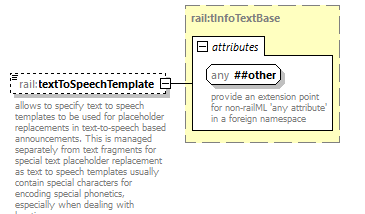 | ||||||
| namespace | https://www.railml.org/schemas/2021 | ||||||
| type | rail:tInfoTextBase | ||||||
| properties |
| ||||||
| attributes |
| ||||||
| annotation |
| ||||||
| source | <xs:element name="textToSpeechTemplate" type="rail:tInfoTextBase" minOccurs="0"> <xs:annotation> <xs:documentation>allows to specify text to speech templates to be used for placeholder replacements in text-to-speech based announcements. This is managed separately from text fragments for special text placeholder replacement as text to speech templates usually contain special characters for encoding special phonetics, especially when dealing with location names.</xs:documentation> <xs:documentation>See https://wiki2.railml.org/wiki/IS:textToSpeechTemplate</xs:documentation> </xs:annotation> </xs:element> |
complexType tMediaAudioFragments
| diagram |  | ||
| namespace | https://www.railml.org/schemas/2021 | ||
| children | rail:audioFragment | ||
| used by |
| ||
| source | <xs:complexType name="tMediaAudioFragments"> <xs:sequence> <xs:element name="audioFragment" type="rail:tMediaAudioFragment" maxOccurs="unbounded"> <xs:annotation> <xs:documentation>allows to specify audio fragments to be used for placeholder replacements in announcements</xs:documentation> <xs:documentation>See https://wiki2.railml.org/wiki/IS:audioFragment</xs:documentation> </xs:annotation> </xs:element> </xs:sequence> </xs:complexType> |
element tMediaAudioFragments/audioFragment
| diagram |  | ||||||||||||||||||||||
| namespace | https://www.railml.org/schemas/2021 | ||||||||||||||||||||||
| type | rail:tMediaAudioFragment | ||||||||||||||||||||||
| properties |
| ||||||||||||||||||||||
| children | rail:textToSpeechTemplate | ||||||||||||||||||||||
| attributes |
| ||||||||||||||||||||||
| annotation |
| ||||||||||||||||||||||
| source | <xs:element name="audioFragment" type="rail:tMediaAudioFragment" maxOccurs="unbounded"> <xs:annotation> <xs:documentation>allows to specify audio fragments to be used for placeholder replacements in announcements</xs:documentation> <xs:documentation>See https://wiki2.railml.org/wiki/IS:audioFragment</xs:documentation> </xs:annotation> </xs:element> |
complexType tMediaResources
| diagram | 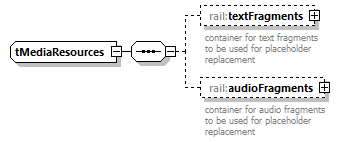 | ||
| namespace | https://www.railml.org/schemas/2021 | ||
| children | rail:textFragments rail:audioFragments | ||
| used by |
| ||
| source | <xs:complexType name="tMediaResources"> <xs:sequence> <xs:element name="textFragments" type="rail:tMediaTextFragments" minOccurs="0"> <xs:annotation> <xs:documentation>container for text fragments to be used for placeholder replacement</xs:documentation> <xs:documentation>See https://wiki2.railml.org/wiki/IS:textFragments</xs:documentation> </xs:annotation> </xs:element> <xs:element name="audioFragments" type="rail:tMediaAudioFragments" minOccurs="0"> <xs:annotation> <xs:documentation>container for audio fragments to be used for placeholder replacement</xs:documentation> <xs:documentation>See https://wiki2.railml.org/wiki/IS:audioFragments</xs:documentation> </xs:annotation> </xs:element> </xs:sequence> </xs:complexType> |
element tMediaResources/textFragments
| diagram | 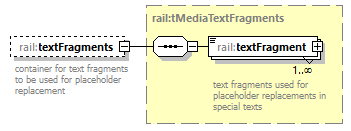 | ||||||
| namespace | https://www.railml.org/schemas/2021 | ||||||
| type | rail:tMediaTextFragments | ||||||
| properties |
| ||||||
| children | rail:textFragment | ||||||
| annotation |
| ||||||
| source | <xs:element name="textFragments" type="rail:tMediaTextFragments" minOccurs="0"> <xs:annotation> <xs:documentation>container for text fragments to be used for placeholder replacement</xs:documentation> <xs:documentation>See https://wiki2.railml.org/wiki/IS:textFragments</xs:documentation> </xs:annotation> </xs:element> |
element tMediaResources/audioFragments
| diagram | 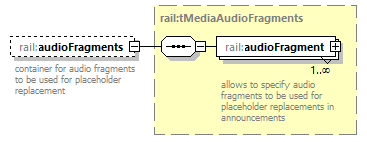 | ||||||
| namespace | https://www.railml.org/schemas/2021 | ||||||
| type | rail:tMediaAudioFragments | ||||||
| properties |
| ||||||
| children | rail:audioFragment | ||||||
| annotation |
| ||||||
| source | <xs:element name="audioFragments" type="rail:tMediaAudioFragments" minOccurs="0"> <xs:annotation> <xs:documentation>container for audio fragments to be used for placeholder replacement</xs:documentation> <xs:documentation>See https://wiki2.railml.org/wiki/IS:audioFragments</xs:documentation> </xs:annotation> </xs:element> |
complexType tMediaTextFragments
| diagram |  | ||
| namespace | https://www.railml.org/schemas/2021 | ||
| children | rail:textFragment | ||
| used by |
| ||
| source | <xs:complexType name="tMediaTextFragments"> <xs:sequence> <xs:element name="textFragment" type="rail:tInfoText" maxOccurs="unbounded"> <xs:annotation> <xs:documentation>text fragments used for placeholder replacements in special texts</xs:documentation> <xs:documentation>See https://wiki2.railml.org/wiki/IS:textFragment</xs:documentation> </xs:annotation> </xs:element> </xs:sequence> </xs:complexType> |
element tMediaTextFragments/textFragment
| diagram |  | ||||||||||||||||||||||
| namespace | https://www.railml.org/schemas/2021 | ||||||||||||||||||||||
| type | rail:tInfoText | ||||||||||||||||||||||
| properties |
| ||||||||||||||||||||||
| attributes |
| ||||||||||||||||||||||
| annotation |
| ||||||||||||||||||||||
| source | <xs:element name="textFragment" type="rail:tInfoText" maxOccurs="unbounded"> <xs:annotation> <xs:documentation>text fragments used for placeholder replacements in special texts</xs:documentation> <xs:documentation>See https://wiki2.railml.org/wiki/IS:textFragment</xs:documentation> </xs:annotation> </xs:element> |
complexType tMileageChange
| diagram | 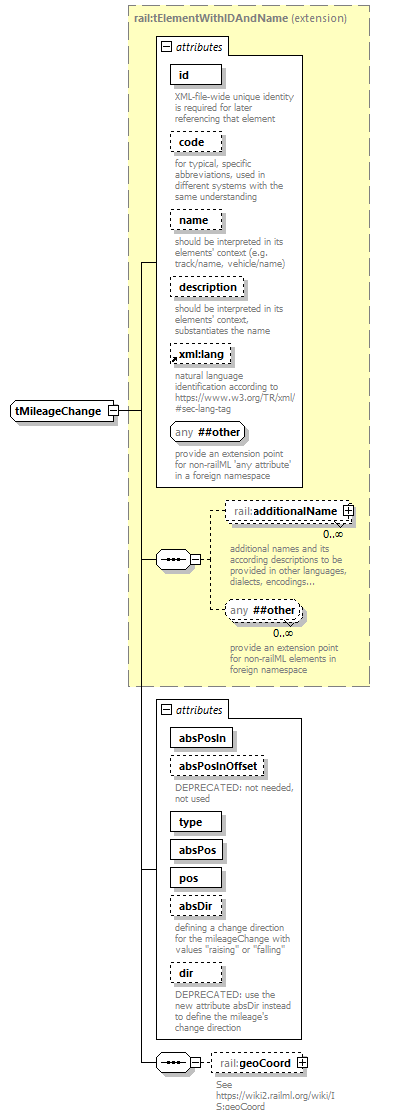 | ||||||||||||||||||||||||||||||||||||||||||||||||||||||||||||||||||||||||||||||||||||||||||||||
| namespace | https://www.railml.org/schemas/2021 | ||||||||||||||||||||||||||||||||||||||||||||||||||||||||||||||||||||||||||||||||||||||||||||||
| type | extension of rail:tElementWithIDAndName | ||||||||||||||||||||||||||||||||||||||||||||||||||||||||||||||||||||||||||||||||||||||||||||||
| properties |
| ||||||||||||||||||||||||||||||||||||||||||||||||||||||||||||||||||||||||||||||||||||||||||||||
| children | rail:additionalName rail:geoCoord | ||||||||||||||||||||||||||||||||||||||||||||||||||||||||||||||||||||||||||||||||||||||||||||||
| used by |
| ||||||||||||||||||||||||||||||||||||||||||||||||||||||||||||||||||||||||||||||||||||||||||||||
| attributes |
| ||||||||||||||||||||||||||||||||||||||||||||||||||||||||||||||||||||||||||||||||||||||||||||||
| source | <xs:complexType name="tMileageChange"> <xs:complexContent> <xs:extension base="rail:tElementWithIDAndName"> <xs:sequence> <xs:element name="geoCoord" type="rail:tGeoCoord" minOccurs="0"> <xs:annotation> <xs:documentation>See https://wiki2.railml.org/wiki/IS:geoCoord</xs:documentation> </xs:annotation> </xs:element> </xs:sequence> <xs:attribute name="absPosIn" type="rail:tLengthM" use="required"/> <xs:attribute name="absPosInOffset" type="rail:tLengthM"> <xs:annotation> <xs:documentation>DEPRECATED: not needed, not used</xs:documentation> </xs:annotation> </xs:attribute> <xs:attribute name="type" type="rail:tMileageChangeDescr" use="required"/> <xs:attribute name="absPos" type="rail:tLengthM" use="required"/> <xs:attribute name="pos" type="rail:tLengthM" use="required"/> <xs:attribute name="absDir" type="rail:tMileageDirection"> <xs:annotation> <xs:documentation>defining a change direction for the mileageChange with values "raising" or "falling"</xs:documentation> </xs:annotation> </xs:attribute> <xs:attribute name="dir" type="rail:tStrictDirection"> <xs:annotation> <xs:documentation>DEPRECATED: use the new attribute absDir instead to define the mileage's change direction</xs:documentation> </xs:annotation> </xs:attribute> </xs:extension> </xs:complexContent> </xs:complexType> |
attribute tMileageChange/@absPosIn
| type | rail:tLengthM | ||||||
| properties |
| ||||||
| facets |
| ||||||
| source | <xs:attribute name="absPosIn" type="rail:tLengthM" use="required"/> |
attribute tMileageChange/@absPosInOffset
| type | rail:tLengthM | ||||||
| facets |
| ||||||
| annotation |
| ||||||
| source | <xs:attribute name="absPosInOffset" type="rail:tLengthM"> <xs:annotation> <xs:documentation>DEPRECATED: not needed, not used</xs:documentation> </xs:annotation> </xs:attribute> |
attribute tMileageChange/@type
| type | rail:tMileageChangeDescr | |||||||||
| properties |
| |||||||||
| facets |
| |||||||||
| source | <xs:attribute name="type" type="rail:tMileageChangeDescr" use="required"/> |
attribute tMileageChange/@absPos
| type | rail:tLengthM | ||||||
| properties |
| ||||||
| facets |
| ||||||
| source | <xs:attribute name="absPos" type="rail:tLengthM" use="required"/> |
attribute tMileageChange/@pos
| type | rail:tLengthM | ||||||
| properties |
| ||||||
| facets |
| ||||||
| source | <xs:attribute name="pos" type="rail:tLengthM" use="required"/> |
attribute tMileageChange/@absDir
| type | rail:tMileageDirection | |||||||||
| facets |
| |||||||||
| annotation |
| |||||||||
| source | <xs:attribute name="absDir" type="rail:tMileageDirection"> <xs:annotation> <xs:documentation>defining a change direction for the mileageChange with values "raising" or "falling"</xs:documentation> </xs:annotation> </xs:attribute> |
attribute tMileageChange/@dir
| type | rail:tStrictDirection | |||||||||
| facets |
| |||||||||
| annotation |
| |||||||||
| source | <xs:attribute name="dir" type="rail:tStrictDirection"> <xs:annotation> <xs:documentation>DEPRECATED: use the new attribute absDir instead to define the mileage's change direction</xs:documentation> </xs:annotation> </xs:attribute> |
element tMileageChange/geoCoord
| diagram | 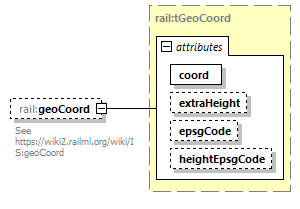 | ||||||||||||||||||||||||||||||
| namespace | https://www.railml.org/schemas/2021 | ||||||||||||||||||||||||||||||
| type | rail:tGeoCoord | ||||||||||||||||||||||||||||||
| properties |
| ||||||||||||||||||||||||||||||
| attributes |
| ||||||||||||||||||||||||||||||
| annotation |
| ||||||||||||||||||||||||||||||
| source | <xs:element name="geoCoord" type="rail:tGeoCoord" minOccurs="0"> <xs:annotation> <xs:documentation>See https://wiki2.railml.org/wiki/IS:geoCoord</xs:documentation> </xs:annotation> </xs:element> |
complexType tOcpAdditionalName
| diagram |  | ||||||||||||||||||||||||||||||
| namespace | https://www.railml.org/schemas/2021 | ||||||||||||||||||||||||||||||
| used by |
| ||||||||||||||||||||||||||||||
| attributes |
| ||||||||||||||||||||||||||||||
| annotation |
| ||||||||||||||||||||||||||||||
| source | <xs:complexType name="tOcpAdditionalName"> <xs:annotation> <xs:documentation>This type is only used by the deprecated element "additionalName" in "propOther". Please use "additionalName" in "ocp" instead.</xs:documentation> </xs:annotation> <xs:attribute name="value" type="xs:string" use="required"> <xs:annotation> <xs:documentation>This element has been deprecated, and is only kept for backward compatibility. Please use attribute "name" in element "additionalName" in "ocp" instead</xs:documentation> </xs:annotation> </xs:attribute> <xs:attribute name="type" type="rail:tOcpNameType"> <xs:annotation> <xs:documentation>This element has been deprecated, and is only kept for backward compatibility. The element "additionalName" in "ocp" provides the same attribute.</xs:documentation> </xs:annotation> </xs:attribute> <xs:attribute ref="xml:lang"> <xs:annotation> <xs:documentation>This element has been deprecated, and is only kept for backward compatibility. The element "additionalName" in "ocp" provides the same attribute.</xs:documentation> </xs:annotation> </xs:attribute> </xs:complexType> |
attribute tOcpAdditionalName/@value
| type | xs:string | ||
| properties |
| ||
| annotation |
| ||
| source | <xs:attribute name="value" type="xs:string" use="required"> <xs:annotation> <xs:documentation>This element has been deprecated, and is only kept for backward compatibility. Please use attribute "name" in element "additionalName" in "ocp" instead</xs:documentation> </xs:annotation> </xs:attribute> |
attribute tOcpAdditionalName/@type
| type | rail:tOcpNameType | ||
| annotation |
| ||
| source | <xs:attribute name="type" type="rail:tOcpNameType"> <xs:annotation> <xs:documentation>This element has been deprecated, and is only kept for backward compatibility. The element "additionalName" in "ocp" provides the same attribute.</xs:documentation> </xs:annotation> </xs:attribute> |
complexType tOcpArea
| diagram |  | ||||||||||||||||||||||||
| namespace | https://www.railml.org/schemas/2021 | ||||||||||||||||||||||||
| used by |
| ||||||||||||||||||||||||
| attributes |
| ||||||||||||||||||||||||
| source | <xs:complexType name="tOcpArea"> <xs:attribute name="name" type="rail:tGenericName"/> <xs:attribute name="number" type="rail:tPositiveCounter"/> <xs:attribute name="zip" type="xs:string"/> </xs:complexType> |
attribute tOcpArea/@name
| type | rail:tGenericName |
| source | <xs:attribute name="name" type="rail:tGenericName"/> |
attribute tOcpArea/@number
| type | rail:tPositiveCounter |
| source | <xs:attribute name="number" type="rail:tPositiveCounter"/> |
attribute tOcpArea/@zip
| type | xs:string |
| source | <xs:attribute name="zip" type="xs:string"/> |
complexType tOcpPropEquipmentSummary
| diagram |  | ||||||||||||||||||||||||||||||||||||
| namespace | https://www.railml.org/schemas/2021 | ||||||||||||||||||||||||||||||||||||
| used by |
| ||||||||||||||||||||||||||||||||||||
| attributes |
| ||||||||||||||||||||||||||||||||||||
| source | <xs:complexType name="tOcpPropEquipmentSummary"> <xs:attribute name="signalBox" type="rail:tInterlockingTypes"/> <xs:attribute name="powerstation" type="xs:boolean" default="false"/> <xs:attribute name="hasHomeSignals" type="xs:boolean" default="false"/> <xs:attribute name="hasStarterSignals" type="xs:boolean" default="false"/> <xs:attribute name="hasSwitches" type="xs:boolean" default="false"/> </xs:complexType> |
attribute tOcpPropEquipmentSummary/@signalBox
| type | rail:tInterlockingTypes | ||||||||||||||||||||||
| facets |
| ||||||||||||||||||||||
| source | <xs:attribute name="signalBox" type="rail:tInterlockingTypes"/> |
attribute tOcpPropEquipmentSummary/@powerstation
| type | xs:boolean | ||
| properties |
| ||
| source | <xs:attribute name="powerstation" type="xs:boolean" default="false"/> |
attribute tOcpPropEquipmentSummary/@hasHomeSignals
| type | xs:boolean | ||
| properties |
| ||
| source | <xs:attribute name="hasHomeSignals" type="xs:boolean" default="false"/> |
attribute tOcpPropEquipmentSummary/@hasStarterSignals
| type | xs:boolean | ||
| properties |
| ||
| source | <xs:attribute name="hasStarterSignals" type="xs:boolean" default="false"/> |
attribute tOcpPropEquipmentSummary/@hasSwitches
| type | xs:boolean | ||
| properties |
| ||
| source | <xs:attribute name="hasSwitches" type="xs:boolean" default="false"/> |
complexType tOcpPropOperational
| diagram |  | ||||||||||||||||||||||||||||||||||||||||||||||
| namespace | https://www.railml.org/schemas/2021 | ||||||||||||||||||||||||||||||||||||||||||||||
| used by |
| ||||||||||||||||||||||||||||||||||||||||||||||
| attributes |
| ||||||||||||||||||||||||||||||||||||||||||||||
| source | <xs:complexType name="tOcpPropOperational"> <xs:attribute name="operationalType" type="rail:tOcpOperationalType"/> <xs:attribute name="trafficType" type="rail:tOcpTrafficType"/> <xs:attribute name="orderChangeable" type="xs:boolean" default="false"/> <xs:attribute name="ensuresTrainSequence" type="xs:boolean" default="true"/> <xs:attribute name="remoteControlled" type="xs:boolean" default="false"> <xs:annotation> <xs:documentation>specify whether the OCP is remotely controlled by a TMS or CTC</xs:documentation> </xs:annotation> </xs:attribute> <xs:attribute name="simultaneousEntry" type="rail:tSimultaneousEntry"> <xs:annotation> <xs:documentation>describes the pattern for a simultaneous entry into the OCP</xs:documentation> </xs:annotation> </xs:attribute> </xs:complexType> |
attribute tOcpPropOperational/@operationalType
| type | rail:tOcpOperationalType |
| source | <xs:attribute name="operationalType" type="rail:tOcpOperationalType"/> |
attribute tOcpPropOperational/@trafficType
| type | rail:tOcpTrafficType |
| source | <xs:attribute name="trafficType" type="rail:tOcpTrafficType"/> |
attribute tOcpPropOperational/@orderChangeable
| type | xs:boolean | ||
| properties |
| ||
| source | <xs:attribute name="orderChangeable" type="xs:boolean" default="false"/> |
attribute tOcpPropOperational/@ensuresTrainSequence
| type | xs:boolean | ||
| properties |
| ||
| source | <xs:attribute name="ensuresTrainSequence" type="xs:boolean" default="true"/> |
attribute tOcpPropOperational/@remoteControlled
| type | xs:boolean | ||
| properties |
| ||
| annotation |
| ||
| source | <xs:attribute name="remoteControlled" type="xs:boolean" default="false"> <xs:annotation> <xs:documentation>specify whether the OCP is remotely controlled by a TMS or CTC</xs:documentation> </xs:annotation> </xs:attribute> |
attribute tOcpPropOperational/@simultaneousEntry
| type | rail:tSimultaneousEntry | ||
| annotation |
| ||
| source | <xs:attribute name="simultaneousEntry" type="rail:tSimultaneousEntry"> <xs:annotation> <xs:documentation>describes the pattern for a simultaneous entry into the OCP</xs:documentation> </xs:annotation> </xs:attribute> |
complexType tOcpPropOther
| diagram |  | ||||||||||||||||||||||||||||||
| namespace | https://www.railml.org/schemas/2021 | ||||||||||||||||||||||||||||||
| used by |
| ||||||||||||||||||||||||||||||
| attributes |
| ||||||||||||||||||||||||||||||
| source | <xs:complexType name="tOcpPropOther"> <xs:attribute name="frontier" type="xs:boolean" default="false"> <xs:annotation> <xs:documentation>DEPRECATED, because usage unclear.</xs:documentation> </xs:annotation> </xs:attribute> <xs:attribute name="chargeFrontier" type="xs:boolean" default="false"> <xs:annotation> <xs:documentation>DEPRECATED, because usage unclear.</xs:documentation> </xs:annotation> </xs:attribute> <xs:attribute name="status" type="rail:tInfrastructureStatus" default="operational"> <xs:annotation> <xs:documentation>DEPRECATED! Please use new optional child element "states" instead; defines the status of the OCP in terms of availability for operation</xs:documentation> </xs:annotation> </xs:attribute> </xs:complexType> |
attribute tOcpPropOther/@frontier
| type | xs:boolean | ||
| properties |
| ||
| annotation |
| ||
| source | <xs:attribute name="frontier" type="xs:boolean" default="false"> <xs:annotation> <xs:documentation>DEPRECATED, because usage unclear.</xs:documentation> </xs:annotation> </xs:attribute> |
attribute tOcpPropOther/@chargeFrontier
| type | xs:boolean | ||
| properties |
| ||
| annotation |
| ||
| source | <xs:attribute name="chargeFrontier" type="xs:boolean" default="false"> <xs:annotation> <xs:documentation>DEPRECATED, because usage unclear.</xs:documentation> </xs:annotation> </xs:attribute> |
attribute tOcpPropOther/@status
| type | rail:tInfrastructureStatus | ||
| properties |
| ||
| annotation |
| ||
| source | <xs:attribute name="status" type="rail:tInfrastructureStatus" default="operational"> <xs:annotation> <xs:documentation>DEPRECATED! Please use new optional child element "states" instead; defines the status of the OCP in terms of availability for operation</xs:documentation> </xs:annotation> </xs:attribute> |
complexType tOcpPropService
| diagram |  | ||||||||||||||||||||||||||||||||||||||||||||||||||||||||||||||||||
| namespace | https://www.railml.org/schemas/2021 | ||||||||||||||||||||||||||||||||||||||||||||||||||||||||||||||||||
| used by |
| ||||||||||||||||||||||||||||||||||||||||||||||||||||||||||||||||||
| attributes |
| ||||||||||||||||||||||||||||||||||||||||||||||||||||||||||||||||||
| source | <xs:complexType name="tOcpPropService"> <xs:attribute name="passenger" type="xs:boolean" default="false"/> <xs:attribute name="service" type="xs:boolean" default="false"/> <xs:attribute name="ship" type="xs:boolean" default="false"/> <xs:attribute name="bus" type="xs:boolean" default="false"/> <xs:attribute name="airport" type="xs:boolean" default="false"/> <xs:attribute name="tariffpoint" type="xs:boolean" default="false"/> <xs:attribute name="goodsLoading" type="xs:boolean" default="false"/> <xs:attribute name="goodsSiding" type="xs:boolean" default="false"/> <xs:attribute name="goodsIntermodal" type="xs:boolean" default="false"/> <xs:attribute name="goodsMarshalling" type="xs:boolean" default="false"/> </xs:complexType> |
attribute tOcpPropService/@passenger
| type | xs:boolean | ||
| properties |
| ||
| source | <xs:attribute name="passenger" type="xs:boolean" default="false"/> |
attribute tOcpPropService/@service
| type | xs:boolean | ||
| properties |
| ||
| source | <xs:attribute name="service" type="xs:boolean" default="false"/> |
attribute tOcpPropService/@ship
| type | xs:boolean | ||
| properties |
| ||
| source | <xs:attribute name="ship" type="xs:boolean" default="false"/> |
attribute tOcpPropService/@bus
| type | xs:boolean | ||
| properties |
| ||
| source | <xs:attribute name="bus" type="xs:boolean" default="false"/> |
attribute tOcpPropService/@airport
| type | xs:boolean | ||
| properties |
| ||
| source | <xs:attribute name="airport" type="xs:boolean" default="false"/> |
attribute tOcpPropService/@tariffpoint
| type | xs:boolean | ||
| properties |
| ||
| source | <xs:attribute name="tariffpoint" type="xs:boolean" default="false"/> |
attribute tOcpPropService/@goodsLoading
| type | xs:boolean | ||
| properties |
| ||
| source | <xs:attribute name="goodsLoading" type="xs:boolean" default="false"/> |
attribute tOcpPropService/@goodsSiding
| type | xs:boolean | ||
| properties |
| ||
| source | <xs:attribute name="goodsSiding" type="xs:boolean" default="false"/> |
attribute tOcpPropService/@goodsIntermodal
| type | xs:boolean | ||
| properties |
| ||
| source | <xs:attribute name="goodsIntermodal" type="xs:boolean" default="false"/> |
attribute tOcpPropService/@goodsMarshalling
| type | xs:boolean | ||
| properties |
| ||
| source | <xs:attribute name="goodsMarshalling" type="xs:boolean" default="false"/> |
complexType tOcpRefInGroup
| diagram |  | ||||||||||||||||||||
| namespace | https://www.railml.org/schemas/2021 | ||||||||||||||||||||
| type | extension of rail:tElementRefInGroup | ||||||||||||||||||||
| properties |
| ||||||||||||||||||||
| used by |
| ||||||||||||||||||||
| attributes |
| ||||||||||||||||||||
| source | <xs:complexType name="tOcpRefInGroup"> <xs:complexContent> <xs:extension base="rail:tElementRefInGroup"/> <!-- Possible ocpGroup-specific attributes to be added here later --> </xs:complexContent> </xs:complexType> |
complexType tOcpRelation
| diagram | 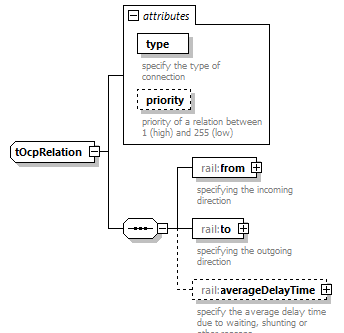 | ||||||||||||||||||||||
| namespace | https://www.railml.org/schemas/2021 | ||||||||||||||||||||||
| children | rail:from rail:to rail:averageDelayTime | ||||||||||||||||||||||
| used by |
| ||||||||||||||||||||||
| attributes |
| ||||||||||||||||||||||
| source | <xs:complexType name="tOcpRelation"> <xs:sequence> <xs:element name="from" type="rail:tOcpRelationNode"> <xs:annotation> <xs:documentation>specifying the incoming direction</xs:documentation> <xs:documentation>See https://wiki2.railml.org/wiki/IS:from_relation</xs:documentation> </xs:annotation> </xs:element> <xs:element name="to" type="rail:tOcpRelationNode"> <xs:annotation> <xs:documentation>specifying the outgoing direction</xs:documentation> <xs:documentation>See https://wiki2.railml.org/wiki/IS:to_relation</xs:documentation> </xs:annotation> </xs:element> <xs:element name="averageDelayTime" type="rail:tOcpRelationDelayTime" minOccurs="0"> <xs:annotation> <xs:documentation>specify the average delay time due to waiting, shunting or other reasons</xs:documentation> <xs:documentation>See https://wiki2.railml.org/wiki/IS:averageDelayTime</xs:documentation> </xs:annotation> </xs:element> </xs:sequence> <xs:attribute name="type" type="rail:tOcpRelationType" use="required"> <xs:annotation> <xs:documentation>specify the type of connection</xs:documentation> </xs:annotation> </xs:attribute> <xs:attribute name="priority" type="rail:tRelationPriority"> <xs:annotation> <xs:documentation>priority of a relation between 1 (high) and 255 (low)</xs:documentation> </xs:annotation> </xs:attribute> </xs:complexType> |
attribute tOcpRelation/@type
| type | rail:tOcpRelationType | ||
| properties |
| ||
| annotation |
| ||
| source | <xs:attribute name="type" type="rail:tOcpRelationType" use="required"> <xs:annotation> <xs:documentation>specify the type of connection</xs:documentation> </xs:annotation> </xs:attribute> |
attribute tOcpRelation/@priority
| type | rail:tRelationPriority | |||||||||
| facets |
| |||||||||
| annotation |
| |||||||||
| source | <xs:attribute name="priority" type="rail:tRelationPriority"> <xs:annotation> <xs:documentation>priority of a relation between 1 (high) and 255 (low)</xs:documentation> </xs:annotation> </xs:attribute> |
element tOcpRelation/from
| diagram | 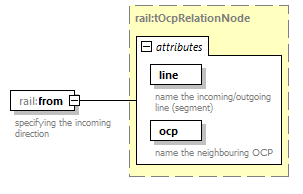 | ||||||||||||||||||||||
| namespace | https://www.railml.org/schemas/2021 | ||||||||||||||||||||||
| type | rail:tOcpRelationNode | ||||||||||||||||||||||
| properties |
| ||||||||||||||||||||||
| attributes |
| ||||||||||||||||||||||
| annotation |
| ||||||||||||||||||||||
| source | <xs:element name="from" type="rail:tOcpRelationNode"> <xs:annotation> <xs:documentation>specifying the incoming direction</xs:documentation> <xs:documentation>See https://wiki2.railml.org/wiki/IS:from_relation</xs:documentation> </xs:annotation> </xs:element> |
element tOcpRelation/to
| diagram | 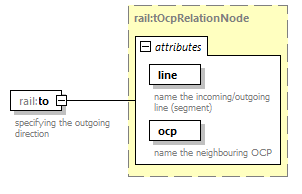 | ||||||||||||||||||||||
| namespace | https://www.railml.org/schemas/2021 | ||||||||||||||||||||||
| type | rail:tOcpRelationNode | ||||||||||||||||||||||
| properties |
| ||||||||||||||||||||||
| attributes |
| ||||||||||||||||||||||
| annotation |
| ||||||||||||||||||||||
| source | <xs:element name="to" type="rail:tOcpRelationNode"> <xs:annotation> <xs:documentation>specifying the outgoing direction</xs:documentation> <xs:documentation>See https://wiki2.railml.org/wiki/IS:to_relation</xs:documentation> </xs:annotation> </xs:element> |
element tOcpRelation/averageDelayTime
| diagram |  | ||||||||||||||
| namespace | https://www.railml.org/schemas/2021 | ||||||||||||||
| type | rail:tOcpRelationDelayTime | ||||||||||||||
| properties |
| ||||||||||||||
| attributes |
| ||||||||||||||
| annotation |
| ||||||||||||||
| source | <xs:element name="averageDelayTime" type="rail:tOcpRelationDelayTime" minOccurs="0"> <xs:annotation> <xs:documentation>specify the average delay time due to waiting, shunting or other reasons</xs:documentation> <xs:documentation>See https://wiki2.railml.org/wiki/IS:averageDelayTime</xs:documentation> </xs:annotation> </xs:element> |
complexType tOcpRelationDelayTime
| diagram |  | ||||||||||||||
| namespace | https://www.railml.org/schemas/2021 | ||||||||||||||
| used by |
| ||||||||||||||
| attributes |
| ||||||||||||||
| source | <xs:complexType name="tOcpRelationDelayTime"> <xs:attribute name="value" type="xs:duration" use="required"> <xs:annotation> <xs:documentation>the average delay time is given in xs:duration format</xs:documentation> </xs:annotation> </xs:attribute> </xs:complexType> |
attribute tOcpRelationDelayTime/@value
| type | xs:duration | ||
| properties |
| ||
| annotation |
| ||
| source | <xs:attribute name="value" type="xs:duration" use="required"> <xs:annotation> <xs:documentation>the average delay time is given in xs:duration format</xs:documentation> </xs:annotation> </xs:attribute> |
complexType tOcpRelationNode
| diagram | 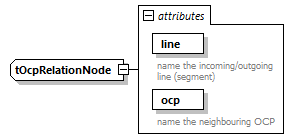 | ||||||||||||||||||||||
| namespace | https://www.railml.org/schemas/2021 | ||||||||||||||||||||||
| used by |
| ||||||||||||||||||||||
| attributes |
| ||||||||||||||||||||||
| source | <xs:complexType name="tOcpRelationNode"> <xs:attribute name="line" type="rail:tGenericRef" use="required"> <xs:annotation> <xs:documentation>name the incoming/outgoing line (segment)</xs:documentation> </xs:annotation> </xs:attribute> <xs:attribute name="ocp" type="rail:tGenericRef" use="required"> <xs:annotation> <xs:documentation>name the neighbouring OCP</xs:documentation> </xs:annotation> </xs:attribute> </xs:complexType> |
attribute tOcpRelationNode/@line
| type | rail:tGenericRef | ||
| properties |
| ||
| annotation |
| ||
| source | <xs:attribute name="line" type="rail:tGenericRef" use="required"> <xs:annotation> <xs:documentation>name the incoming/outgoing line (segment)</xs:documentation> </xs:annotation> </xs:attribute> |
attribute tOcpRelationNode/@ocp
| type | rail:tGenericRef | ||
| properties |
| ||
| annotation |
| ||
| source | <xs:attribute name="ocp" type="rail:tGenericRef" use="required"> <xs:annotation> <xs:documentation>name the neighbouring OCP</xs:documentation> </xs:annotation> </xs:attribute> |
complexType tOcpTsi
| diagram | 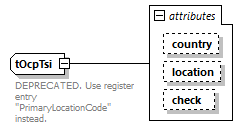 | ||||||||||||||||||||||||
| namespace | https://www.railml.org/schemas/2021 | ||||||||||||||||||||||||
| used by |
| ||||||||||||||||||||||||
| attributes |
| ||||||||||||||||||||||||
| annotation |
| ||||||||||||||||||||||||
| source | <xs:complexType name="tOcpTsi"> <xs:annotation> <xs:documentation>DEPRECATED. Use register entry "PrimaryLocationCode" instead.</xs:documentation> </xs:annotation> <xs:attribute name="country" type="rail:tTwoDigits"/> <xs:attribute name="location" type="rail:tFiveDigits"/> <xs:attribute name="check" type="rail:tOneDigit"/> <!-- more attributes can be added here later --> </xs:complexType> |
attribute tOcpTsi/@country
| type | rail:tTwoDigits | |||||||||
| facets |
| |||||||||
| source | <xs:attribute name="country" type="rail:tTwoDigits"/> |
attribute tOcpTsi/@location
| type | rail:tFiveDigits | |||||||||
| facets |
| |||||||||
| source | <xs:attribute name="location" type="rail:tFiveDigits"/> |
attribute tOcpTsi/@check
| type | rail:tOneDigit | |||||||||
| facets |
| |||||||||
| source | <xs:attribute name="check" type="rail:tOneDigit"/> |
complexType tOcpUptime
| diagram | 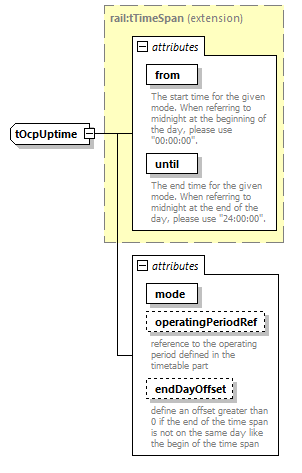 | ||||||||||||||||||||||||||||||||||||||||||||
| namespace | https://www.railml.org/schemas/2021 | ||||||||||||||||||||||||||||||||||||||||||||
| type | extension of rail:tTimeSpan | ||||||||||||||||||||||||||||||||||||||||||||
| properties |
| ||||||||||||||||||||||||||||||||||||||||||||
| used by |
| ||||||||||||||||||||||||||||||||||||||||||||
| attributes |
| ||||||||||||||||||||||||||||||||||||||||||||
| source | <xs:complexType name="tOcpUptime"> <xs:complexContent> <xs:extension base="rail:tTimeSpan"> <xs:attribute name="mode" type="rail:tOcpManMode" use="required"/> <xs:attribute name="operatingPeriodRef" type="rail:tGenericRef"> <xs:annotation> <xs:documentation>reference to the operating period defined in the timetable part</xs:documentation> </xs:annotation> </xs:attribute> <xs:attribute name="endDayOffset" type="xs:nonNegativeInteger"> <xs:annotation> <xs:documentation>define an offset greater than 0 if the end of the time span is not on the same day like the begin of the time span</xs:documentation> </xs:annotation> </xs:attribute> </xs:extension> </xs:complexContent> </xs:complexType> |
attribute tOcpUptime/@mode
| type | rail:tOcpManMode | ||
| properties |
| ||
| source | <xs:attribute name="mode" type="rail:tOcpManMode" use="required"/> |
attribute tOcpUptime/@operatingPeriodRef
| type | rail:tGenericRef | ||
| annotation |
| ||
| source | <xs:attribute name="operatingPeriodRef" type="rail:tGenericRef"> <xs:annotation> <xs:documentation>reference to the operating period defined in the timetable part</xs:documentation> </xs:annotation> </xs:attribute> |
attribute tOcpUptime/@endDayOffset
| type | xs:nonNegativeInteger | ||
| annotation |
| ||
| source | <xs:attribute name="endDayOffset" type="xs:nonNegativeInteger"> <xs:annotation> <xs:documentation>define an offset greater than 0 if the end of the time span is not on the same day like the begin of the time span</xs:documentation> </xs:annotation> </xs:attribute> |
complexType tOcpWithIDAndName
| diagram |  | ||||||||||||||||||||||||||||||||||||||||||||||||||||||
| namespace | https://www.railml.org/schemas/2021 | ||||||||||||||||||||||||||||||||||||||||||||||||||||||
| type | extension of rail:tAdditionalName | ||||||||||||||||||||||||||||||||||||||||||||||||||||||
| properties |
| ||||||||||||||||||||||||||||||||||||||||||||||||||||||
| children | rail:additionalName | ||||||||||||||||||||||||||||||||||||||||||||||||||||||
| used by |
| ||||||||||||||||||||||||||||||||||||||||||||||||||||||
| attributes |
| ||||||||||||||||||||||||||||||||||||||||||||||||||||||
| annotation |
| ||||||||||||||||||||||||||||||||||||||||||||||||||||||
| source | <xs:complexType name="tOcpWithIDAndName"> <xs:annotation> <xs:documentation>generic base type, used for inheritance of many railML types</xs:documentation> </xs:annotation> <xs:complexContent> <xs:extension base="rail:tAdditionalName"> <xs:sequence> <xs:element name="additionalName" type="rail:tAdditionalOcpName" minOccurs="0" maxOccurs="unbounded"> <xs:annotation> <xs:documentation>additional names and its according descriptions to be provided in other languages, dialects, encodings...</xs:documentation> <xs:documentation>See https://wiki2.railml.org/wiki/IS:additionalName_ocp</xs:documentation> </xs:annotation> </xs:element> <xs:any namespace="##other" processContents="strict" minOccurs="0" maxOccurs="unbounded"> <xs:annotation> <xs:documentation>provide an extension point for non-railML elements in foreign namespace</xs:documentation> </xs:annotation> </xs:any> </xs:sequence> <xs:attribute name="id" type="rail:tGenericID" use="required"> <xs:annotation> <xs:documentation>XML-file-wide unique identity is required for later referencing that element</xs:documentation> </xs:annotation> </xs:attribute> <xs:attribute name="code" type="rail:tGenericName"> <xs:annotation> <xs:documentation>for typical, specific abbreviations, used in different systems with the same understanding</xs:documentation> </xs:annotation> </xs:attribute> <xs:attribute name="type" type="rail:tOcpNameType"> <xs:annotation> <xs:documentation>type of the ocp name</xs:documentation> </xs:annotation> </xs:attribute> </xs:extension> </xs:complexContent> </xs:complexType> |
attribute tOcpWithIDAndName/@id
| type | rail:tGenericID | ||
| properties |
| ||
| annotation |
| ||
| source | <xs:attribute name="id" type="rail:tGenericID" use="required"> <xs:annotation> <xs:documentation>XML-file-wide unique identity is required for later referencing that element</xs:documentation> </xs:annotation> </xs:attribute> |
attribute tOcpWithIDAndName/@code
| type | rail:tGenericName | ||
| annotation |
| ||
| source | <xs:attribute name="code" type="rail:tGenericName"> <xs:annotation> <xs:documentation>for typical, specific abbreviations, used in different systems with the same understanding</xs:documentation> </xs:annotation> </xs:attribute> |
attribute tOcpWithIDAndName/@type
| type | rail:tOcpNameType | ||
| annotation |
| ||
| source | <xs:attribute name="type" type="rail:tOcpNameType"> <xs:annotation> <xs:documentation>type of the ocp name</xs:documentation> </xs:annotation> </xs:attribute> |
element tOcpWithIDAndName/additionalName
| diagram |  | ||||||||||||||||||||||||||||||||||||||
| namespace | https://www.railml.org/schemas/2021 | ||||||||||||||||||||||||||||||||||||||
| type | rail:tAdditionalOcpName | ||||||||||||||||||||||||||||||||||||||
| properties |
| ||||||||||||||||||||||||||||||||||||||
| attributes |
| ||||||||||||||||||||||||||||||||||||||
| annotation |
| ||||||||||||||||||||||||||||||||||||||
| source | <xs:element name="additionalName" type="rail:tAdditionalOcpName" minOccurs="0" maxOccurs="unbounded"> <xs:annotation> <xs:documentation>additional names and its according descriptions to be provided in other languages, dialects, encodings...</xs:documentation> <xs:documentation>See https://wiki2.railml.org/wiki/IS:additionalName_ocp</xs:documentation> </xs:annotation> </xs:element> |
complexType tOpenEnd
| diagram |  | ||||||||||||||||||||||||||||||||||||||||||||||
| namespace | https://www.railml.org/schemas/2021 | ||||||||||||||||||||||||||||||||||||||||||||||
| type | extension of rail:tElementWithIDAndName | ||||||||||||||||||||||||||||||||||||||||||||||
| properties |
| ||||||||||||||||||||||||||||||||||||||||||||||
| children | rail:additionalName | ||||||||||||||||||||||||||||||||||||||||||||||
| used by |
| ||||||||||||||||||||||||||||||||||||||||||||||
| attributes |
| ||||||||||||||||||||||||||||||||||||||||||||||
| source | <xs:complexType name="tOpenEnd"> <xs:complexContent> <xs:extension base="rail:tElementWithIDAndName"/> </xs:complexContent> </xs:complexType> |
complexType tOperatingRule
| diagram |  | ||||||||||||||||||||||||||||||||||||||||||||||
| namespace | https://www.railml.org/schemas/2021 | ||||||||||||||||||||||||||||||||||||||||||||||
| type | extension of rail:tElementWithIDAndName | ||||||||||||||||||||||||||||||||||||||||||||||
| properties |
| ||||||||||||||||||||||||||||||||||||||||||||||
| children | rail:additionalName rail:childRule rail:objectRef | ||||||||||||||||||||||||||||||||||||||||||||||
| used by |
| ||||||||||||||||||||||||||||||||||||||||||||||
| attributes |
| ||||||||||||||||||||||||||||||||||||||||||||||
| source | <xs:complexType name="tOperatingRule"> <xs:complexContent> <xs:extension base="rail:tElementWithIDAndName"> <xs:sequence> <xs:element name="childRule" type="rail:tChildRule" minOccurs="0" maxOccurs="unbounded"> <xs:annotation> <xs:documentation>reference to any another rule included here as part of the main rule</xs:documentation> <xs:documentation>See https://wiki2.railml.org/wiki/IS:childRule</xs:documentation> </xs:annotation> </xs:element> <xs:element name="objectRef" type="rail:tElementWithReference" minOccurs="0" maxOccurs="unbounded"> <xs:annotation> <xs:documentation>reference to any infrastructure object affected by the rule</xs:documentation> </xs:annotation> </xs:element> </xs:sequence> </xs:extension> </xs:complexContent> </xs:complexType> |
element tOperatingRule/childRule
| diagram | 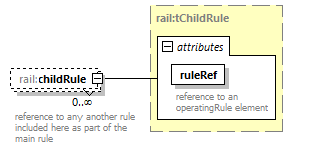 | ||||||||||||||
| namespace | https://www.railml.org/schemas/2021 | ||||||||||||||
| type | rail:tChildRule | ||||||||||||||
| properties |
| ||||||||||||||
| attributes |
| ||||||||||||||
| annotation |
| ||||||||||||||
| source | <xs:element name="childRule" type="rail:tChildRule" minOccurs="0" maxOccurs="unbounded"> <xs:annotation> <xs:documentation>reference to any another rule included here as part of the main rule</xs:documentation> <xs:documentation>See https://wiki2.railml.org/wiki/IS:childRule</xs:documentation> </xs:annotation> </xs:element> |
element tOperatingRule/objectRef
| diagram | 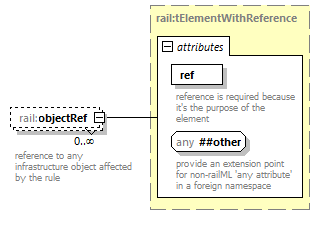 | ||||||||||||||
| namespace | https://www.railml.org/schemas/2021 | ||||||||||||||
| type | rail:tElementWithReference | ||||||||||||||
| properties |
| ||||||||||||||
| attributes |
| ||||||||||||||
| annotation |
| ||||||||||||||
| source | <xs:element name="objectRef" type="rail:tElementWithReference" minOccurs="0" maxOccurs="unbounded"> <xs:annotation> <xs:documentation>reference to any infrastructure object affected by the rule</xs:documentation> </xs:annotation> </xs:element> |
complexType tOperationControlPoint
| diagram |  | ||||||||||||||||||||||||||||||||||||||||||||||||||||||||||||||||||||||||||||||||||||
| namespace | https://www.railml.org/schemas/2021 | ||||||||||||||||||||||||||||||||||||||||||||||||||||||||||||||||||||||||||||||||||||
| type | extension of rail:tOcpWithIDAndName | ||||||||||||||||||||||||||||||||||||||||||||||||||||||||||||||||||||||||||||||||||||
| properties |
| ||||||||||||||||||||||||||||||||||||||||||||||||||||||||||||||||||||||||||||||||||||
| children | rail:additionalName rail:controllerRef | ||||||||||||||||||||||||||||||||||||||||||||||||||||||||||||||||||||||||||||||||||||
| used by |
| ||||||||||||||||||||||||||||||||||||||||||||||||||||||||||||||||||||||||||||||||||||
| attributes |
| ||||||||||||||||||||||||||||||||||||||||||||||||||||||||||||||||||||||||||||||||||||
| source | <xs:complexType name="tOperationControlPoint"> <xs:complexContent> <xs:extension base="rail:tOcpWithIDAndName"> <xs:sequence> <xs:element name="controllerRef" type="rail:tElementRefInGroup" minOccurs="0" maxOccurs="unbounded"> <xs:annotation> <xs:documentation>reference from OCP to a Controller</xs:documentation> <xs:documentation>See https://wiki2.railml.org/wiki/IS:controllerRef_ocp</xs:documentation> </xs:annotation> </xs:element> </xs:sequence> <xs:attribute name="number" type="xs:string"> <xs:annotation> <xs:documentation>DEPRECATED: use the 'designator' with its parameters 'register' and 'entry' instead</xs:documentation> </xs:annotation> </xs:attribute> <xs:attribute name="abbrevation" type="xs:string"> <xs:annotation> <xs:documentation>DEPRECATED: use the 'designator' with its parameters 'register' and 'entry' instead</xs:documentation> </xs:annotation> </xs:attribute> <xs:attribute name="timezone" type="rail:tTimeZone"/> <xs:attribute name="parentOcpRef" type="rail:tGenericRef"> <xs:annotation> <xs:documentation>references the one and only parent ocp of this ocp</xs:documentation> </xs:annotation> </xs:attribute> </xs:extension> </xs:complexContent> </xs:complexType> |
attribute tOperationControlPoint/@number
| type | xs:string | ||
| annotation |
| ||
| source | <xs:attribute name="number" type="xs:string"> <xs:annotation> <xs:documentation>DEPRECATED: use the 'designator' with its parameters 'register' and 'entry' instead</xs:documentation> </xs:annotation> </xs:attribute> |
attribute tOperationControlPoint/@abbrevation
| type | xs:string | ||
| annotation |
| ||
| source | <xs:attribute name="abbrevation" type="xs:string"> <xs:annotation> <xs:documentation>DEPRECATED: use the 'designator' with its parameters 'register' and 'entry' instead</xs:documentation> </xs:annotation> </xs:attribute> |
attribute tOperationControlPoint/@timezone
| type | rail:tTimeZone |
| source | <xs:attribute name="timezone" type="rail:tTimeZone"/> |
attribute tOperationControlPoint/@parentOcpRef
| type | rail:tGenericRef | ||
| annotation |
| ||
| source | <xs:attribute name="parentOcpRef" type="rail:tGenericRef"> <xs:annotation> <xs:documentation>references the one and only parent ocp of this ocp</xs:documentation> </xs:annotation> </xs:attribute> |
element tOperationControlPoint/controllerRef
| diagram |  | ||||||||||||||||||||
| namespace | https://www.railml.org/schemas/2021 | ||||||||||||||||||||
| type | rail:tElementRefInGroup | ||||||||||||||||||||
| properties |
| ||||||||||||||||||||
| attributes |
| ||||||||||||||||||||
| annotation |
| ||||||||||||||||||||
| source | <xs:element name="controllerRef" type="rail:tElementRefInGroup" minOccurs="0" maxOccurs="unbounded"> <xs:annotation> <xs:documentation>reference from OCP to a Controller</xs:documentation> <xs:documentation>See https://wiki2.railml.org/wiki/IS:controllerRef_ocp</xs:documentation> </xs:annotation> </xs:element> |
complexType tOperationMode
| diagram |  | ||||||||||||||||||||||||
| namespace | https://www.railml.org/schemas/2021 | ||||||||||||||||||||||||
| used by |
| ||||||||||||||||||||||||
| attributes |
| ||||||||||||||||||||||||
| source | <xs:complexType name="tOperationMode"> <xs:attributeGroup ref="rail:aOperationMode"/> </xs:complexType> |
complexType tOperationModeChange
| diagram |  | ||||||||||||||||||||||||||||||||||||||||||||||||||||||||||||||||||||||||||||||||||||||||||||||||
| namespace | https://www.railml.org/schemas/2021 | ||||||||||||||||||||||||||||||||||||||||||||||||||||||||||||||||||||||||||||||||||||||||||||||||
| type | extension of rail:tStrictOrientedElement | ||||||||||||||||||||||||||||||||||||||||||||||||||||||||||||||||||||||||||||||||||||||||||||||||
| properties |
| ||||||||||||||||||||||||||||||||||||||||||||||||||||||||||||||||||||||||||||||||||||||||||||||||
| children | rail:additionalName rail:geoCoord rail:states | ||||||||||||||||||||||||||||||||||||||||||||||||||||||||||||||||||||||||||||||||||||||||||||||||
| used by |
| ||||||||||||||||||||||||||||||||||||||||||||||||||||||||||||||||||||||||||||||||||||||||||||||||
| attributes |
| ||||||||||||||||||||||||||||||||||||||||||||||||||||||||||||||||||||||||||||||||||||||||||||||||
| source | <xs:complexType name="tOperationModeChange"> <xs:complexContent> <xs:extension base="rail:tStrictOrientedElement"> <xs:attributeGroup ref="rail:aOperationMode"/> </xs:extension> </xs:complexContent> </xs:complexType> |
complexType tOrientedElement
| diagram |  | ||||||||||||||||||||||||||||||||||||||||||||||||||||||||||||||||||||||||||||||
| namespace | https://www.railml.org/schemas/2021 | ||||||||||||||||||||||||||||||||||||||||||||||||||||||||||||||||||||||||||||||
| type | extension of rail:tPlacedElement | ||||||||||||||||||||||||||||||||||||||||||||||||||||||||||||||||||||||||||||||
| properties |
| ||||||||||||||||||||||||||||||||||||||||||||||||||||||||||||||||||||||||||||||
| children | rail:additionalName rail:geoCoord rail:states | ||||||||||||||||||||||||||||||||||||||||||||||||||||||||||||||||||||||||||||||
| used by |
| ||||||||||||||||||||||||||||||||||||||||||||||||||||||||||||||||||||||||||||||
| attributes |
| ||||||||||||||||||||||||||||||||||||||||||||||||||||||||||||||||||||||||||||||
| source | <xs:complexType name="tOrientedElement"> <xs:complexContent> <xs:extension base="rail:tPlacedElement"> <xs:attributeGroup ref="rail:aOrientation"/> </xs:extension> </xs:complexContent> </xs:complexType> |
complexType tOrientedElementWithLength
| diagram | 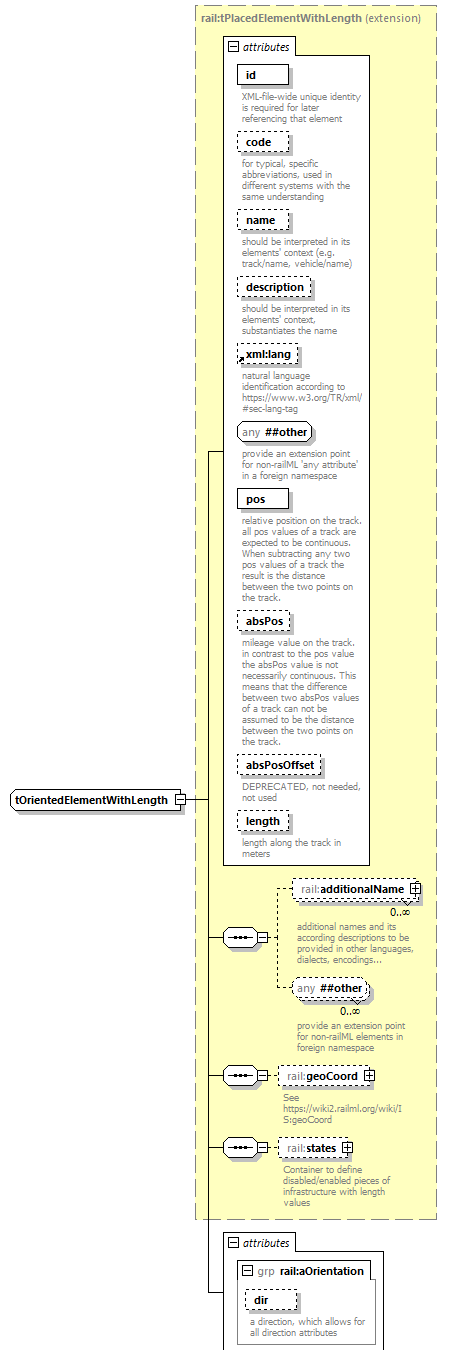 | ||||||||||||||||||||||||||||||||||||||||||||||||||||||||||||||||||||||||||||||||||||||
| namespace | https://www.railml.org/schemas/2021 | ||||||||||||||||||||||||||||||||||||||||||||||||||||||||||||||||||||||||||||||||||||||
| type | extension of rail:tPlacedElementWithLength | ||||||||||||||||||||||||||||||||||||||||||||||||||||||||||||||||||||||||||||||||||||||
| properties |
| ||||||||||||||||||||||||||||||||||||||||||||||||||||||||||||||||||||||||||||||||||||||
| children | rail:additionalName rail:geoCoord rail:states | ||||||||||||||||||||||||||||||||||||||||||||||||||||||||||||||||||||||||||||||||||||||
| attributes |
| ||||||||||||||||||||||||||||||||||||||||||||||||||||||||||||||||||||||||||||||||||||||
| source | <xs:complexType name="tOrientedElementWithLength"> <xs:complexContent> <xs:extension base="rail:tPlacedElementWithLength"> <xs:attributeGroup ref="rail:aOrientation"/> </xs:extension> </xs:complexContent> </xs:complexType> |
complexType tOwner
| diagram |  | ||||||||||||||||||||||||||||
| namespace | https://www.railml.org/schemas/2021 | ||||||||||||||||||||||||||||
| used by |
| ||||||||||||||||||||||||||||
| attributes |
| ||||||||||||||||||||||||||||
| source | <xs:complexType name="tOwner"> <xs:attributeGroup ref="rail:aOwner"/> </xs:complexType> |
complexType tOwnerChange
| diagram |  | ||||||||||||||||||||||||||||||||||||||||||||||||||||||||||||||||||||||||||||||||||||||||||||||||||||
| namespace | https://www.railml.org/schemas/2021 | ||||||||||||||||||||||||||||||||||||||||||||||||||||||||||||||||||||||||||||||||||||||||||||||||||||
| type | extension of rail:tDelimitedOrientedElementDeprecated | ||||||||||||||||||||||||||||||||||||||||||||||||||||||||||||||||||||||||||||||||||||||||||||||||||||
| properties |
| ||||||||||||||||||||||||||||||||||||||||||||||||||||||||||||||||||||||||||||||||||||||||||||||||||||
| children | rail:additionalName rail:geoCoord rail:states | ||||||||||||||||||||||||||||||||||||||||||||||||||||||||||||||||||||||||||||||||||||||||||||||||||||
| used by |
| ||||||||||||||||||||||||||||||||||||||||||||||||||||||||||||||||||||||||||||||||||||||||||||||||||||
| attributes |
| ||||||||||||||||||||||||||||||||||||||||||||||||||||||||||||||||||||||||||||||||||||||||||||||||||||
| source | <xs:complexType name="tOwnerChange"> <xs:complexContent> <xs:extension base="rail:tDelimitedOrientedElementDeprecated"> <xs:attributeGroup ref="rail:aOwner"/> </xs:extension> </xs:complexContent> </xs:complexType> |
complexType tPath
| diagram |  | ||
| namespace | https://www.railml.org/schemas/2021 | ||
| children | rail:ocpRef | ||
| used by |
| ||
| source | <xs:complexType name="tPath"> <xs:sequence> <xs:element name="ocpRef" type="rail:tOcpRefInGroup" minOccurs="2" maxOccurs="2"> <xs:annotation> <xs:documentation>See https://wiki2.railml.org/wiki/IS:ocpRef_path</xs:documentation> </xs:annotation> </xs:element> </xs:sequence> </xs:complexType> |
element tPath/ocpRef
| diagram |  | ||||||||||||||||||||
| namespace | https://www.railml.org/schemas/2021 | ||||||||||||||||||||
| type | rail:tOcpRefInGroup | ||||||||||||||||||||
| properties |
| ||||||||||||||||||||
| attributes |
| ||||||||||||||||||||
| annotation |
| ||||||||||||||||||||
| source | <xs:element name="ocpRef" type="rail:tOcpRefInGroup" minOccurs="2" maxOccurs="2"> <xs:annotation> <xs:documentation>See https://wiki2.railml.org/wiki/IS:ocpRef_path</xs:documentation> </xs:annotation> </xs:element> |
complexType tPlacedElement
| diagram |  | ||||||||||||||||||||||||||||||||||||||||||||||||||||||||||||||||||||||
| namespace | https://www.railml.org/schemas/2021 | ||||||||||||||||||||||||||||||||||||||||||||||||||||||||||||||||||||||
| type | extension of rail:tBasePlacedElement | ||||||||||||||||||||||||||||||||||||||||||||||||||||||||||||||||||||||
| properties |
| ||||||||||||||||||||||||||||||||||||||||||||||||||||||||||||||||||||||
| children | rail:additionalName rail:geoCoord rail:states | ||||||||||||||||||||||||||||||||||||||||||||||||||||||||||||||||||||||
| used by |
| ||||||||||||||||||||||||||||||||||||||||||||||||||||||||||||||||||||||
| attributes |
| ||||||||||||||||||||||||||||||||||||||||||||||||||||||||||||||||||||||
| source | <xs:complexType name="tPlacedElement"> <xs:complexContent> <xs:extension base="rail:tBasePlacedElement"> <xs:sequence> <xs:element name="states" type="rail:tStates" minOccurs="0"> <xs:annotation> <xs:documentation>Container to define disabled/enabled pieces of infrastructure.</xs:documentation> <xs:documentation>See https://wiki2.railml.org/wiki/IS:states</xs:documentation> </xs:annotation> </xs:element> </xs:sequence> </xs:extension> </xs:complexContent> </xs:complexType> |
element tPlacedElement/states
| diagram | 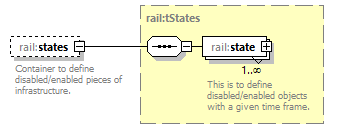 | ||||||
| namespace | https://www.railml.org/schemas/2021 | ||||||
| type | rail:tStates | ||||||
| properties |
| ||||||
| children | rail:state | ||||||
| annotation |
| ||||||
| source | <xs:element name="states" type="rail:tStates" minOccurs="0"> <xs:annotation> <xs:documentation>Container to define disabled/enabled pieces of infrastructure.</xs:documentation> <xs:documentation>See https://wiki2.railml.org/wiki/IS:states</xs:documentation> </xs:annotation> </xs:element> |
complexType tPlacedElementWithLength
| diagram |  | ||||||||||||||||||||||||||||||||||||||||||||||||||||||||||||||||||||||||||||||
| namespace | https://www.railml.org/schemas/2021 | ||||||||||||||||||||||||||||||||||||||||||||||||||||||||||||||||||||||||||||||
| type | extension of rail:tBasePlacedElement | ||||||||||||||||||||||||||||||||||||||||||||||||||||||||||||||||||||||||||||||
| properties |
| ||||||||||||||||||||||||||||||||||||||||||||||||||||||||||||||||||||||||||||||
| children | rail:additionalName rail:geoCoord rail:states | ||||||||||||||||||||||||||||||||||||||||||||||||||||||||||||||||||||||||||||||
| used by |
| ||||||||||||||||||||||||||||||||||||||||||||||||||||||||||||||||||||||||||||||
| attributes |
| ||||||||||||||||||||||||||||||||||||||||||||||||||||||||||||||||||||||||||||||
| source | <xs:complexType name="tPlacedElementWithLength"> <xs:complexContent> <xs:extension base="rail:tBasePlacedElement"> <xs:sequence> <xs:element name="states" type="rail:tStatesWithLength" minOccurs="0"> <xs:annotation> <xs:documentation>Container to define disabled/enabled pieces of infrastructure with length values</xs:documentation> <xs:documentation>See https://wiki2.railml.org/wiki/IS:states_(with_length)</xs:documentation> </xs:annotation> </xs:element> </xs:sequence> <xs:attribute name="length" type="rail:tLengthM"> <xs:annotation> <xs:documentation>length along the track in meters</xs:documentation> </xs:annotation> </xs:attribute> </xs:extension> </xs:complexContent> </xs:complexType> |
attribute tPlacedElementWithLength/@length
| type | rail:tLengthM | ||||||
| facets |
| ||||||
| annotation |
| ||||||
| source | <xs:attribute name="length" type="rail:tLengthM"> <xs:annotation> <xs:documentation>length along the track in meters</xs:documentation> </xs:annotation> </xs:attribute> |
element tPlacedElementWithLength/states
| diagram | 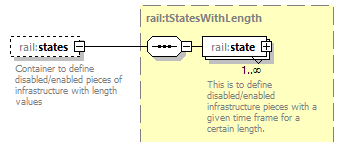 | ||||||
| namespace | https://www.railml.org/schemas/2021 | ||||||
| type | rail:tStatesWithLength | ||||||
| properties |
| ||||||
| children | rail:state | ||||||
| annotation |
| ||||||
| source | <xs:element name="states" type="rail:tStatesWithLength" minOccurs="0"> <xs:annotation> <xs:documentation>Container to define disabled/enabled pieces of infrastructure with length values</xs:documentation> <xs:documentation>See https://wiki2.railml.org/wiki/IS:states_(with_length)</xs:documentation> </xs:annotation> </xs:element> |
complexType tPlatformEdge
| diagram |  | ||||||||||||||||||||||||||||||||||||||||||||||||||||||||||||||||||||||||||||||||||||||||||||||||||||||||||||||||||||||
| namespace | https://www.railml.org/schemas/2021 | ||||||||||||||||||||||||||||||||||||||||||||||||||||||||||||||||||||||||||||||||||||||||||||||||||||||||||||||||||||||
| type | extension of rail:tBaseServiceSection | ||||||||||||||||||||||||||||||||||||||||||||||||||||||||||||||||||||||||||||||||||||||||||||||||||||||||||||||||||||||
| properties |
| ||||||||||||||||||||||||||||||||||||||||||||||||||||||||||||||||||||||||||||||||||||||||||||||||||||||||||||||||||||||
| children | rail:additionalName rail:geoCoord rail:states rail:propPassengerInfo | ||||||||||||||||||||||||||||||||||||||||||||||||||||||||||||||||||||||||||||||||||||||||||||||||||||||||||||||||||||||
| used by |
| ||||||||||||||||||||||||||||||||||||||||||||||||||||||||||||||||||||||||||||||||||||||||||||||||||||||||||||||||||||||
| attributes |
| ||||||||||||||||||||||||||||||||||||||||||||||||||||||||||||||||||||||||||||||||||||||||||||||||||||||||||||||||||||||
| source | <xs:complexType name="tPlatformEdge"> <xs:complexContent> <xs:extension base="rail:tBaseServiceSection"> <xs:sequence> <xs:element name="propPassengerInfo" type="rail:tPropPassengerInfo" minOccurs="0"> <xs:annotation> <xs:documentation>properties for passenger information systems</xs:documentation> <xs:documentation>See https://wiki2.railml.org/wiki/IS:propPassengerInfo_platformEdge</xs:documentation> </xs:annotation> </xs:element> </xs:sequence> <xs:attribute name="parentPlatformEdgeRef" type="rail:tGenericRef"> <xs:annotation> <xs:documentation>reference to a parent platform edge for grouping platform edge parts together</xs:documentation> </xs:annotation> </xs:attribute> </xs:extension> </xs:complexContent> </xs:complexType> |
attribute tPlatformEdge/@parentPlatformEdgeRef
| type | rail:tGenericRef | ||
| annotation |
| ||
| source | <xs:attribute name="parentPlatformEdgeRef" type="rail:tGenericRef"> <xs:annotation> <xs:documentation>reference to a parent platform edge for grouping platform edge parts together</xs:documentation> </xs:annotation> </xs:attribute> |
element tPlatformEdge/propPassengerInfo
| diagram |  | ||||||
| namespace | https://www.railml.org/schemas/2021 | ||||||
| type | rail:tPropPassengerInfo | ||||||
| properties |
| ||||||
| children | rail:mediaResources | ||||||
| annotation |
| ||||||
| source | <xs:element name="propPassengerInfo" type="rail:tPropPassengerInfo" minOccurs="0"> <xs:annotation> <xs:documentation>properties for passenger information systems</xs:documentation> <xs:documentation>See https://wiki2.railml.org/wiki/IS:propPassengerInfo_platformEdge</xs:documentation> </xs:annotation> </xs:element> |
complexType tPoint
| diagram |  | ||||||||||||||||||
| namespace | https://www.railml.org/schemas/2021 | ||||||||||||||||||
| used by |
| ||||||||||||||||||
| attributes |
| ||||||||||||||||||
| source | <xs:complexType name="tPoint"> <xs:attribute name="x" type="xs:double" use="required"/> <xs:attribute name="y" type="xs:double" use="required"/> </xs:complexType> |
attribute tPoint/@x
| type | xs:double | ||
| properties |
| ||
| source | <xs:attribute name="x" type="xs:double" use="required"/> |
attribute tPoint/@y
| type | xs:double | ||
| properties |
| ||
| source | <xs:attribute name="y" type="xs:double" use="required"/> |
complexType tPowerTransmission
| diagram |  | ||||||||||||||||||
| namespace | https://www.railml.org/schemas/2021 | ||||||||||||||||||
| used by |
| ||||||||||||||||||
| attributes |
| ||||||||||||||||||
| source | <xs:complexType name="tPowerTransmission"> <xs:attributeGroup ref="rail:aPowerTransmission"/> </xs:complexType> |
complexType tPowerTransmissionChange
| diagram |  | ||||||||||||||||||||||||||||||||||||||||||||||||||||||||||||||||||||||||||||||||||||||||||
| namespace | https://www.railml.org/schemas/2021 | ||||||||||||||||||||||||||||||||||||||||||||||||||||||||||||||||||||||||||||||||||||||||||
| type | extension of rail:tDelimitedOrientedElementDeprecated | ||||||||||||||||||||||||||||||||||||||||||||||||||||||||||||||||||||||||||||||||||||||||||
| properties |
| ||||||||||||||||||||||||||||||||||||||||||||||||||||||||||||||||||||||||||||||||||||||||||
| children | rail:additionalName rail:geoCoord rail:states | ||||||||||||||||||||||||||||||||||||||||||||||||||||||||||||||||||||||||||||||||||||||||||
| used by |
| ||||||||||||||||||||||||||||||||||||||||||||||||||||||||||||||||||||||||||||||||||||||||||
| attributes |
| ||||||||||||||||||||||||||||||||||||||||||||||||||||||||||||||||||||||||||||||||||||||||||
| source | <xs:complexType name="tPowerTransmissionChange"> <xs:complexContent> <xs:extension base="rail:tDelimitedOrientedElementDeprecated"> <xs:attributeGroup ref="rail:aPowerTransmission"/> </xs:extension> </xs:complexContent> </xs:complexType> |
complexType tPropPassengerInfo
| diagram |  | ||
| namespace | https://www.railml.org/schemas/2021 | ||
| children | rail:mediaResources | ||
| used by |
| ||
| source | <xs:complexType name="tPropPassengerInfo"> <xs:sequence> <xs:element name="mediaResources" type="rail:tMediaResources" minOccurs="0"> <xs:annotation> <xs:documentation>container for media resources connected with the infrastructure element such as announcement or special text fragments. Theses fragments are usually used to replace placeholders in announcements or special texts.</xs:documentation> <xs:documentation>See https://wiki2.railml.org/wiki/IS:mediaResources</xs:documentation> </xs:annotation> </xs:element> </xs:sequence> </xs:complexType> |
element tPropPassengerInfo/mediaResources
| diagram |  | ||||||
| namespace | https://www.railml.org/schemas/2021 | ||||||
| type | rail:tMediaResources | ||||||
| properties |
| ||||||
| children | rail:textFragments rail:audioFragments | ||||||
| annotation |
| ||||||
| source | <xs:element name="mediaResources" type="rail:tMediaResources" minOccurs="0"> <xs:annotation> <xs:documentation>container for media resources connected with the infrastructure element such as announcement or special text fragments. Theses fragments are usually used to replace placeholders in announcements or special texts.</xs:documentation> <xs:documentation>See https://wiki2.railml.org/wiki/IS:mediaResources</xs:documentation> </xs:annotation> </xs:element> |
complexType tRadiusChange
| diagram |  | ||||||||||||||||||||||||||||||||||||||||||||||||||||||||||||||||||||||||||||||||||||||||||||||||||||||
| namespace | https://www.railml.org/schemas/2021 | ||||||||||||||||||||||||||||||||||||||||||||||||||||||||||||||||||||||||||||||||||||||||||||||||||||||
| type | extension of rail:tDelimitedOrientedElementDeprecated | ||||||||||||||||||||||||||||||||||||||||||||||||||||||||||||||||||||||||||||||||||||||||||||||||||||||
| properties |
| ||||||||||||||||||||||||||||||||||||||||||||||||||||||||||||||||||||||||||||||||||||||||||||||||||||||
| children | rail:additionalName rail:geoCoord rail:states | ||||||||||||||||||||||||||||||||||||||||||||||||||||||||||||||||||||||||||||||||||||||||||||||||||||||
| used by |
| ||||||||||||||||||||||||||||||||||||||||||||||||||||||||||||||||||||||||||||||||||||||||||||||||||||||
| attributes |
| ||||||||||||||||||||||||||||||||||||||||||||||||||||||||||||||||||||||||||||||||||||||||||||||||||||||
| source | <xs:complexType name="tRadiusChange"> <xs:complexContent> <xs:extension base="rail:tDelimitedOrientedElementDeprecated"> <xs:attributeGroup ref="rail:aRadiusChange"/> </xs:extension> </xs:complexContent> </xs:complexType> |
complexType tReleaseGroup
| diagram |  | ||
| namespace | https://www.railml.org/schemas/2021 | ||
| children | rail:trackSectionRef | ||
| used by |
| ||
| source | <xs:complexType name="tReleaseGroup"> <xs:sequence> <xs:element name="trackSectionRef" maxOccurs="unbounded"> <xs:annotation> <xs:documentation>See https://wiki2.railml.org/wiki/IS:trackSectionRef</xs:documentation> </xs:annotation> <xs:complexType> <xs:complexContent> <xs:extension base="rail:tElementWithReference"> <xs:attribute name="flankProtection" type="xs:boolean"> <xs:annotation> <xs:documentation>Set to “true” if trackSection is not part of the path of the route and gives it flank protection</xs:documentation> </xs:annotation> </xs:attribute> </xs:extension> </xs:complexContent> </xs:complexType> </xs:element> </xs:sequence> </xs:complexType> |
element tReleaseGroup/trackSectionRef
| diagram |  | ||||||||||||||||||||||
| namespace | https://www.railml.org/schemas/2021 | ||||||||||||||||||||||
| type | extension of rail:tElementWithReference | ||||||||||||||||||||||
| properties |
| ||||||||||||||||||||||
| attributes |
| ||||||||||||||||||||||
| annotation |
| ||||||||||||||||||||||
| source | <xs:element name="trackSectionRef" maxOccurs="unbounded"> <xs:annotation> <xs:documentation>See https://wiki2.railml.org/wiki/IS:trackSectionRef</xs:documentation> </xs:annotation> <xs:complexType> <xs:complexContent> <xs:extension base="rail:tElementWithReference"> <xs:attribute name="flankProtection" type="xs:boolean"> <xs:annotation> <xs:documentation>Set to “true” if trackSection is not part of the path of the route and gives it flank protection</xs:documentation> </xs:annotation> </xs:attribute> </xs:extension> </xs:complexContent> </xs:complexType> </xs:element> |
attribute tReleaseGroup/trackSectionRef/@flankProtection
| type | xs:boolean | ||
| annotation |
| ||
| source | <xs:attribute name="flankProtection" type="xs:boolean"> <xs:annotation> <xs:documentation>Set to “true” if trackSection is not part of the path of the route and gives it flank protection</xs:documentation> </xs:annotation> </xs:attribute> |
complexType tRoute
| diagram |  | ||||||||||||||||||||||||||||||||||||||||||||||||||||||||||||||||||||||||||||||||||||||||||||||||||||||||||||||||||||||||||||||||||||||
| namespace | https://www.railml.org/schemas/2021 | ||||||||||||||||||||||||||||||||||||||||||||||||||||||||||||||||||||||||||||||||||||||||||||||||||||||||||||||||||||||||||||||||||||||
| type | extension of rail:tElementWithIDAndName | ||||||||||||||||||||||||||||||||||||||||||||||||||||||||||||||||||||||||||||||||||||||||||||||||||||||||||||||||||||||||||||||||||||||
| properties |
| ||||||||||||||||||||||||||||||||||||||||||||||||||||||||||||||||||||||||||||||||||||||||||||||||||||||||||||||||||||||||||||||||||||||
| children | rail:additionalName rail:switchAndPosition rail:overlapSwitchAndPosition rail:releaseGroup rail:states | ||||||||||||||||||||||||||||||||||||||||||||||||||||||||||||||||||||||||||||||||||||||||||||||||||||||||||||||||||||||||||||||||||||||
| used by |
| ||||||||||||||||||||||||||||||||||||||||||||||||||||||||||||||||||||||||||||||||||||||||||||||||||||||||||||||||||||||||||||||||||||||
| attributes |
| ||||||||||||||||||||||||||||||||||||||||||||||||||||||||||||||||||||||||||||||||||||||||||||||||||||||||||||||||||||||||||||||||||||||
| source | <xs:complexType name="tRoute"> <xs:complexContent> <xs:extension base="rail:tElementWithIDAndName"> <xs:sequence> <xs:element name="switchAndPosition" type="rail:tSwitchAndPosition" minOccurs="0" maxOccurs="unbounded"> <xs:annotation> <xs:documentation>See https://wiki2.railml.org/wiki/IS:switchAndPosition</xs:documentation> </xs:annotation> </xs:element> <xs:element name="overlapSwitchAndPosition" type="rail:tSwitchAndPosition" minOccurs="0" maxOccurs="unbounded"> <xs:annotation> <xs:documentation>See https://wiki2.railml.org/wiki/IS:overlapSwitchAndPosition</xs:documentation> </xs:annotation> </xs:element> <xs:element name="releaseGroup" type="rail:tReleaseGroup" minOccurs="0" maxOccurs="unbounded"> <xs:annotation> <xs:documentation>See https://wiki2.railml.org/wiki/IS:releaseGroup</xs:documentation> </xs:annotation> </xs:element> <xs:element name="states" type="rail:tStates" minOccurs="0"> <xs:annotation> <xs:documentation>See https://wiki2.railml.org/wiki/IS:states</xs:documentation> </xs:annotation> </xs:element> </xs:sequence> <xs:attribute name="conditional"> <xs:simpleType> <xs:union> <xs:simpleType> <xs:restriction base="xs:string"> <xs:enumeration value="ocpManned"/> <xs:enumeration value="ocpUnmanned"/> </xs:restriction> </xs:simpleType> <xs:simpleType> <xs:restriction base="rail:tOtherEnumerationValue"/> </xs:simpleType> </xs:union> </xs:simpleType> </xs:attribute> <xs:attribute name="approachPointRef" type="rail:tGenericRef"> <xs:annotation> <xs:documentation>Used for a speed restriction on an approach zone in front of the route (Before RouteEntry) a train must obey if the route is closed (red light). The approachPoint refers to where the approach zone starts in front of the route. This may be the distant signal in front of the route.</xs:documentation> </xs:annotation> </xs:attribute> <xs:attribute name="approachSpeed" type="rail:tSpeedKmPerHour"> <xs:annotation> <xs:documentation>used together with approachPoint, ApproachSpeed can also be used for multiple route approach speed profiling.</xs:documentation> </xs:annotation> </xs:attribute> <xs:attribute name="overlapEndRef" type="rail:tGenericRef"> <xs:annotation> <xs:documentation>The overlap always starts at the RouteExit signal. The reference of the overlapEnd is to the end of the overlap/slip. This is usually a train detection element. Only one type of overlap exists. The overlap is defined to always start at the end signal of the route. The end of the overlap can be defined at the end point (usually an axle counter or a track circuit border) for an unambiguous overlap path. For an ambiguous overlap path the protective elements need to be defined (switch and position, flank protection or head protection). The overlap is always released together with the route. Except if there is defined a trigger. If a trigger is defined it can have a timer. The timer is set in seconds. The overlap is released after the trigger is activated and the timer has elapsed. The trigger can be a trigger point (line side) which either reacts on the head of the train (occupy TVD after the trigger point) or the complete train (release TVD before the trigger point). Or the trigger can be activated according to the speed of the train (train side). Only speed 0 km/h is deemed relevant (standstill). This (train side) trigger is technology independent. This as it can relay both to ETCS (which can be designed to send a telegram after standstill for a certain time), or human interlocking of the local dispatcher who observes that the train has come to a standstill and after a handling time (reflected in the timer) releases the overlap.</xs:documentation> </xs:annotation> </xs:attribute> <xs:attribute name="releaseTriggerRef" type="rail:tGenericRef"> <xs:annotation> <xs:documentation>Reference to the trigger point for the overlap release timer. This is usually a train detection element. If no overlapReleaseTimer is set, but a overlapValidityTime is set, the default value is that the timing starts from when the train has stopped on the route. This technology independent (ETCS standstill telegram or local dispatcher observance)</xs:documentation> </xs:annotation> </xs:attribute> <xs:attribute name="releaseTriggerHead" type="xs:boolean"> <xs:annotation> <xs:documentation>"true" = valid for first axle (head) of the train. "false" = valid for last axle (tail/rear) of the train</xs:documentation> </xs:annotation> </xs:attribute> <xs:attribute name="overlapValidityTime" type="xs:duration"> <xs:annotation> <xs:documentation>Duration the overlap is active blocking potential overlapping routes from forming. The overlap is formed together with the route and is released after overlapValidityTime has run out after the overlapReleaseTimer (aka overlap validity time trigger point) value has been triggered.</xs:documentation> <xs:documentation>See https://www.w3.org/TR/xmlschema-2/#duration</xs:documentation> </xs:annotation> </xs:attribute> <xs:attribute name="proceedSpeed" type="rail:tSpeedKmPerHour"> <xs:annotation> <xs:documentation>Proceed speed is a speed restrictions by the route. This is valid for the whole route (from signal to signal). No value=track speed.</xs:documentation> </xs:annotation> </xs:attribute> <xs:attribute name="releaseSpeed" type="rail:tSpeedKmPerHour"> <xs:annotation> <xs:documentation>Release speed is the speed at which the brake curve intervention is removed and the train driver is unsupervised except from SPAD. This is valid for the whole route (from signal to signal).</xs:documentation> </xs:annotation> </xs:attribute> <xs:attribute name="entryRef" type="rail:tGenericRef" use="required"> <xs:annotation> <xs:documentation>refSignalId. Note term definition "route entry"</xs:documentation> </xs:annotation> </xs:attribute> <xs:attribute name="exitRef" type="rail:tGenericRef" use="required"> <xs:annotation> <xs:documentation>ref to any element. reference to the signal where the route ends.</xs:documentation> </xs:annotation> </xs:attribute> </xs:extension> </xs:complexContent> </xs:complexType> |
attribute tRoute/@conditional
| type | union of (restriction of xs:string, rail:tOtherEnumerationValue) |
| source | <xs:attribute name="conditional"> <xs:simpleType> <xs:union> <xs:simpleType> <xs:restriction base="xs:string"> <xs:enumeration value="ocpManned"/> <xs:enumeration value="ocpUnmanned"/> </xs:restriction> </xs:simpleType> <xs:simpleType> <xs:restriction base="rail:tOtherEnumerationValue"/> </xs:simpleType> </xs:union> </xs:simpleType> </xs:attribute> |
attribute tRoute/@approachPointRef
| type | rail:tGenericRef | ||
| annotation |
| ||
| source | <xs:attribute name="approachPointRef" type="rail:tGenericRef"> <xs:annotation> <xs:documentation>Used for a speed restriction on an approach zone in front of the route (Before RouteEntry) a train must obey if the route is closed (red light). The approachPoint refers to where the approach zone starts in front of the route. This may be the distant signal in front of the route.</xs:documentation> </xs:annotation> </xs:attribute> |
attribute tRoute/@approachSpeed
| type | rail:tSpeedKmPerHour | ||||||||||||
| facets |
| ||||||||||||
| annotation |
| ||||||||||||
| source | <xs:attribute name="approachSpeed" type="rail:tSpeedKmPerHour"> <xs:annotation> <xs:documentation>used together with approachPoint, ApproachSpeed can also be used for multiple route approach speed profiling.</xs:documentation> </xs:annotation> </xs:attribute> |
attribute tRoute/@overlapEndRef
| type | rail:tGenericRef | ||
| annotation |
| ||
| source | <xs:attribute name="overlapEndRef" type="rail:tGenericRef"> <xs:annotation> <xs:documentation>The overlap always starts at the RouteExit signal. The reference of the overlapEnd is to the end of the overlap/slip. This is usually a train detection element. Only one type of overlap exists. The overlap is defined to always start at the end signal of the route. The end of the overlap can be defined at the end point (usually an axle counter or a track circuit border) for an unambiguous overlap path. For an ambiguous overlap path the protective elements need to be defined (switch and position, flank protection or head protection). The overlap is always released together with the route. Except if there is defined a trigger. If a trigger is defined it can have a timer. The timer is set in seconds. The overlap is released after the trigger is activated and the timer has elapsed. The trigger can be a trigger point (line side) which either reacts on the head of the train (occupy TVD after the trigger point) or the complete train (release TVD before the trigger point). Or the trigger can be activated according to the speed of the train (train side). Only speed 0 km/h is deemed relevant (standstill). This (train side) trigger is technology independent. This as it can relay both to ETCS (which can be designed to send a telegram after standstill for a certain time), or human interlocking of the local dispatcher who observes that the train has come to a standstill and after a handling time (reflected in the timer) releases the overlap.</xs:documentation> </xs:annotation> </xs:attribute> |
attribute tRoute/@releaseTriggerRef
| type | rail:tGenericRef | ||
| annotation |
| ||
| source | <xs:attribute name="releaseTriggerRef" type="rail:tGenericRef"> <xs:annotation> <xs:documentation>Reference to the trigger point for the overlap release timer. This is usually a train detection element. If no overlapReleaseTimer is set, but a overlapValidityTime is set, the default value is that the timing starts from when the train has stopped on the route. This technology independent (ETCS standstill telegram or local dispatcher observance)</xs:documentation> </xs:annotation> </xs:attribute> |
attribute tRoute/@releaseTriggerHead
| type | xs:boolean | ||
| annotation |
| ||
| source | <xs:attribute name="releaseTriggerHead" type="xs:boolean"> <xs:annotation> <xs:documentation>"true" = valid for first axle (head) of the train. "false" = valid for last axle (tail/rear) of the train</xs:documentation> </xs:annotation> </xs:attribute> |
attribute tRoute/@overlapValidityTime
| type | xs:duration | ||||
| annotation |
| ||||
| source | <xs:attribute name="overlapValidityTime" type="xs:duration"> <xs:annotation> <xs:documentation>Duration the overlap is active blocking potential overlapping routes from forming. The overlap is formed together with the route and is released after overlapValidityTime has run out after the overlapReleaseTimer (aka overlap validity time trigger point) value has been triggered.</xs:documentation> <xs:documentation>See https://www.w3.org/TR/xmlschema-2/#duration</xs:documentation> </xs:annotation> </xs:attribute> |
attribute tRoute/@proceedSpeed
| type | rail:tSpeedKmPerHour | ||||||||||||
| facets |
| ||||||||||||
| annotation |
| ||||||||||||
| source | <xs:attribute name="proceedSpeed" type="rail:tSpeedKmPerHour"> <xs:annotation> <xs:documentation>Proceed speed is a speed restrictions by the route. This is valid for the whole route (from signal to signal). No value=track speed.</xs:documentation> </xs:annotation> </xs:attribute> |
attribute tRoute/@releaseSpeed
| type | rail:tSpeedKmPerHour | ||||||||||||
| facets |
| ||||||||||||
| annotation |
| ||||||||||||
| source | <xs:attribute name="releaseSpeed" type="rail:tSpeedKmPerHour"> <xs:annotation> <xs:documentation>Release speed is the speed at which the brake curve intervention is removed and the train driver is unsupervised except from SPAD. This is valid for the whole route (from signal to signal).</xs:documentation> </xs:annotation> </xs:attribute> |
attribute tRoute/@entryRef
| type | rail:tGenericRef | ||
| properties |
| ||
| annotation |
| ||
| source | <xs:attribute name="entryRef" type="rail:tGenericRef" use="required"> <xs:annotation> <xs:documentation>refSignalId. Note term definition "route entry"</xs:documentation> </xs:annotation> </xs:attribute> |
attribute tRoute/@exitRef
| type | rail:tGenericRef | ||
| properties |
| ||
| annotation |
| ||
| source | <xs:attribute name="exitRef" type="rail:tGenericRef" use="required"> <xs:annotation> <xs:documentation>ref to any element. reference to the signal where the route ends.</xs:documentation> </xs:annotation> </xs:attribute> |
element tRoute/switchAndPosition
| diagram | 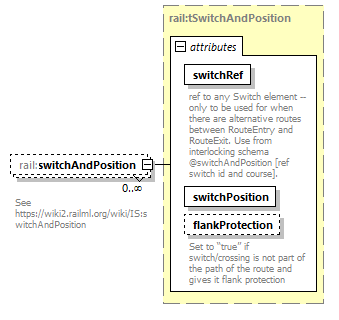 | ||||||||||||||||||||||||||||
| namespace | https://www.railml.org/schemas/2021 | ||||||||||||||||||||||||||||
| type | rail:tSwitchAndPosition | ||||||||||||||||||||||||||||
| properties |
| ||||||||||||||||||||||||||||
| attributes |
| ||||||||||||||||||||||||||||
| annotation |
| ||||||||||||||||||||||||||||
| source | <xs:element name="switchAndPosition" type="rail:tSwitchAndPosition" minOccurs="0" maxOccurs="unbounded"> <xs:annotation> <xs:documentation>See https://wiki2.railml.org/wiki/IS:switchAndPosition</xs:documentation> </xs:annotation> </xs:element> |
element tRoute/overlapSwitchAndPosition
| diagram | 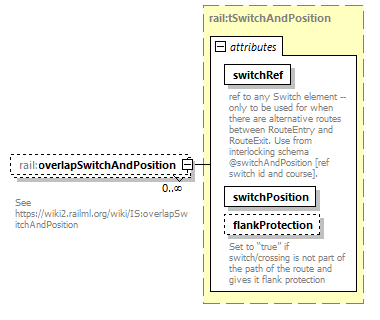 | ||||||||||||||||||||||||||||
| namespace | https://www.railml.org/schemas/2021 | ||||||||||||||||||||||||||||
| type | rail:tSwitchAndPosition | ||||||||||||||||||||||||||||
| properties |
| ||||||||||||||||||||||||||||
| attributes |
| ||||||||||||||||||||||||||||
| annotation |
| ||||||||||||||||||||||||||||
| source | <xs:element name="overlapSwitchAndPosition" type="rail:tSwitchAndPosition" minOccurs="0" maxOccurs="unbounded"> <xs:annotation> <xs:documentation>See https://wiki2.railml.org/wiki/IS:overlapSwitchAndPosition</xs:documentation> </xs:annotation> </xs:element> |
element tRoute/releaseGroup
| diagram |  | ||||||
| namespace | https://www.railml.org/schemas/2021 | ||||||
| type | rail:tReleaseGroup | ||||||
| properties |
| ||||||
| children | rail:trackSectionRef | ||||||
| annotation |
| ||||||
| source | <xs:element name="releaseGroup" type="rail:tReleaseGroup" minOccurs="0" maxOccurs="unbounded"> <xs:annotation> <xs:documentation>See https://wiki2.railml.org/wiki/IS:releaseGroup</xs:documentation> </xs:annotation> </xs:element> |
element tRoute/states
| diagram | 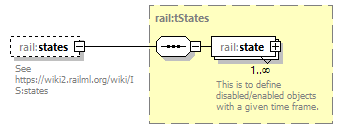 | ||||||
| namespace | https://www.railml.org/schemas/2021 | ||||||
| type | rail:tStates | ||||||
| properties |
| ||||||
| children | rail:state | ||||||
| annotation |
| ||||||
| source | <xs:element name="states" type="rail:tStates" minOccurs="0"> <xs:annotation> <xs:documentation>See https://wiki2.railml.org/wiki/IS:states</xs:documentation> </xs:annotation> </xs:element> |
complexType tRuleCodeElement
| diagram |  | ||||||||||||||||||||||||||||||||||||||||||||||||||||||||||||||||||||||||||||||||||||||
| namespace | https://www.railml.org/schemas/2021 | ||||||||||||||||||||||||||||||||||||||||||||||||||||||||||||||||||||||||||||||||||||||
| type | extension of rail:tOrientedElement | ||||||||||||||||||||||||||||||||||||||||||||||||||||||||||||||||||||||||||||||||||||||
| properties |
| ||||||||||||||||||||||||||||||||||||||||||||||||||||||||||||||||||||||||||||||||||||||
| children | rail:additionalName rail:geoCoord rail:states | ||||||||||||||||||||||||||||||||||||||||||||||||||||||||||||||||||||||||||||||||||||||
| used by |
| ||||||||||||||||||||||||||||||||||||||||||||||||||||||||||||||||||||||||||||||||||||||
| attributes |
| ||||||||||||||||||||||||||||||||||||||||||||||||||||||||||||||||||||||||||||||||||||||
| source | <xs:complexType name="tRuleCodeElement"> <xs:complexContent> <xs:extension base="rail:tOrientedElement"> <xs:attribute name="ruleCode" type="rail:tElementDescription"> <xs:annotation> <xs:documentation>Code for this element in the rule book, combination of letters and numbers and space allowed, e.g. Ne5, GA, SFRS/E</xs:documentation> </xs:annotation> </xs:attribute> </xs:extension> </xs:complexContent> </xs:complexType> |
attribute tRuleCodeElement/@ruleCode
| type | rail:tElementDescription | ||
| annotation |
| ||
| source | <xs:attribute name="ruleCode" type="rail:tElementDescription"> <xs:annotation> <xs:documentation>Code for this element in the rule book, combination of letters and numbers and space allowed, e.g. Ne5, GA, SFRS/E</xs:documentation> </xs:annotation> </xs:attribute> |
complexType tServiceSection
| diagram |  | ||||||||||||||||||||||||||||||||||||||||||||||||||||||||||||||||||||||||||||||||||||||||||||||||||||||||||||||||||||||||||||||||||||||||||||||||||||||||||||||||||||||||||||||||||||||
| namespace | https://www.railml.org/schemas/2021 | ||||||||||||||||||||||||||||||||||||||||||||||||||||||||||||||||||||||||||||||||||||||||||||||||||||||||||||||||||||||||||||||||||||||||||||||||||||||||||||||||||||||||||||||||||||||
| type | extension of rail:tBaseServiceSection | ||||||||||||||||||||||||||||||||||||||||||||||||||||||||||||||||||||||||||||||||||||||||||||||||||||||||||||||||||||||||||||||||||||||||||||||||||||||||||||||||||||||||||||||||||||||
| properties |
| ||||||||||||||||||||||||||||||||||||||||||||||||||||||||||||||||||||||||||||||||||||||||||||||||||||||||||||||||||||||||||||||||||||||||||||||||||||||||||||||||||||||||||||||||||||||
| children | rail:additionalName rail:geoCoord rail:states | ||||||||||||||||||||||||||||||||||||||||||||||||||||||||||||||||||||||||||||||||||||||||||||||||||||||||||||||||||||||||||||||||||||||||||||||||||||||||||||||||||||||||||||||||||||||
| used by |
| ||||||||||||||||||||||||||||||||||||||||||||||||||||||||||||||||||||||||||||||||||||||||||||||||||||||||||||||||||||||||||||||||||||||||||||||||||||||||||||||||||||||||||||||||||||||
| attributes |
| ||||||||||||||||||||||||||||||||||||||||||||||||||||||||||||||||||||||||||||||||||||||||||||||||||||||||||||||||||||||||||||||||||||||||||||||||||||||||||||||||||||||||||||||||||||||
| source | <xs:complexType name="tServiceSection"> <xs:complexContent> <xs:extension base="rail:tBaseServiceSection"> <xs:attribute name="parentServiceSectionRef" type="rail:tGenericRef"> <xs:annotation> <xs:documentation>reference to a parent service section for grouping service section parts together</xs:documentation> </xs:annotation> </xs:attribute> <xs:attribute name="ramp" type="xs:boolean"> <xs:annotation> <xs:documentation>defining the service section as being a ramp</xs:documentation> </xs:annotation> </xs:attribute> <xs:attribute name="maintenance" type="xs:boolean"> <xs:annotation> <xs:documentation>defining the service section as being a maintenance area</xs:documentation> </xs:annotation> </xs:attribute> <xs:attribute name="loadingFacility" type="xs:boolean"> <xs:annotation> <xs:documentation>defining the service section as being equipped with loading facilities</xs:documentation> </xs:annotation> </xs:attribute> <xs:attribute name="cleaning" type="xs:boolean"> <xs:annotation> <xs:documentation>defining the service section as being a cleaning area</xs:documentation> </xs:annotation> </xs:attribute> <xs:attribute name="fueling" type="xs:boolean"> <xs:annotation> <xs:documentation>defining the service section as being a fueling area</xs:documentation> </xs:annotation> </xs:attribute> <xs:attribute name="parking" type="xs:boolean"> <xs:annotation> <xs:documentation>defining the service section as being a parking area</xs:documentation> </xs:annotation> </xs:attribute> <xs:attribute name="preheating" type="xs:boolean"> <xs:annotation> <xs:documentation>defining the service section as being a preheating area</xs:documentation> </xs:annotation> </xs:attribute> <xs:attribute name="rampType" type="rail:tRampType"> <xs:annotation> <xs:documentation>specify the specific construction of the ramp</xs:documentation> </xs:annotation> </xs:attribute> </xs:extension> </xs:complexContent> </xs:complexType> |
attribute tServiceSection/@parentServiceSectionRef
| type | rail:tGenericRef | ||
| annotation |
| ||
| source | <xs:attribute name="parentServiceSectionRef" type="rail:tGenericRef"> <xs:annotation> <xs:documentation>reference to a parent service section for grouping service section parts together</xs:documentation> </xs:annotation> </xs:attribute> |
attribute tServiceSection/@ramp
| type | xs:boolean | ||
| annotation |
| ||
| source | <xs:attribute name="ramp" type="xs:boolean"> <xs:annotation> <xs:documentation>defining the service section as being a ramp</xs:documentation> </xs:annotation> </xs:attribute> |
attribute tServiceSection/@maintenance
| type | xs:boolean | ||
| annotation |
| ||
| source | <xs:attribute name="maintenance" type="xs:boolean"> <xs:annotation> <xs:documentation>defining the service section as being a maintenance area</xs:documentation> </xs:annotation> </xs:attribute> |
attribute tServiceSection/@loadingFacility
| type | xs:boolean | ||
| annotation |
| ||
| source | <xs:attribute name="loadingFacility" type="xs:boolean"> <xs:annotation> <xs:documentation>defining the service section as being equipped with loading facilities</xs:documentation> </xs:annotation> </xs:attribute> |
attribute tServiceSection/@cleaning
| type | xs:boolean | ||
| annotation |
| ||
| source | <xs:attribute name="cleaning" type="xs:boolean"> <xs:annotation> <xs:documentation>defining the service section as being a cleaning area</xs:documentation> </xs:annotation> </xs:attribute> |
attribute tServiceSection/@fueling
| type | xs:boolean | ||
| annotation |
| ||
| source | <xs:attribute name="fueling" type="xs:boolean"> <xs:annotation> <xs:documentation>defining the service section as being a fueling area</xs:documentation> </xs:annotation> </xs:attribute> |
attribute tServiceSection/@parking
| type | xs:boolean | ||
| annotation |
| ||
| source | <xs:attribute name="parking" type="xs:boolean"> <xs:annotation> <xs:documentation>defining the service section as being a parking area</xs:documentation> </xs:annotation> </xs:attribute> |
attribute tServiceSection/@preheating
| type | xs:boolean | ||
| annotation |
| ||
| source | <xs:attribute name="preheating" type="xs:boolean"> <xs:annotation> <xs:documentation>defining the service section as being a preheating area</xs:documentation> </xs:annotation> </xs:attribute> |
attribute tServiceSection/@rampType
| type | rail:tRampType | ||
| annotation |
| ||
| source | <xs:attribute name="rampType" type="rail:tRampType"> <xs:annotation> <xs:documentation>specify the specific construction of the ramp</xs:documentation> </xs:annotation> </xs:attribute> |
complexType tSignal
| diagram |  | ||||||||||||||||||||||||||||||||||||||||||||||||||||||||||||||||||||||||||||||||||||||||||||||||||||||||||||||||||||||||||||||||||||||||||||||||||||||||||||||||||||||||||||||||||||||||||||||||||||||||||||||||||||||||||||||||||||||
| namespace | https://www.railml.org/schemas/2021 | ||||||||||||||||||||||||||||||||||||||||||||||||||||||||||||||||||||||||||||||||||||||||||||||||||||||||||||||||||||||||||||||||||||||||||||||||||||||||||||||||||||||||||||||||||||||||||||||||||||||||||||||||||||||||||||||||||||||
| type | extension of rail:tRuleCodeElement | ||||||||||||||||||||||||||||||||||||||||||||||||||||||||||||||||||||||||||||||||||||||||||||||||||||||||||||||||||||||||||||||||||||||||||||||||||||||||||||||||||||||||||||||||||||||||||||||||||||||||||||||||||||||||||||||||||||||
| properties |
| ||||||||||||||||||||||||||||||||||||||||||||||||||||||||||||||||||||||||||||||||||||||||||||||||||||||||||||||||||||||||||||||||||||||||||||||||||||||||||||||||||||||||||||||||||||||||||||||||||||||||||||||||||||||||||||||||||||||
| children | rail:additionalName rail:geoCoord rail:states rail:speed rail:etcs rail:levelCrossing rail:trainRadio rail:catenary rail:line rail:milepost rail:braking rail:trainProtectionElementGroupRef rail:baliseGroupRef | ||||||||||||||||||||||||||||||||||||||||||||||||||||||||||||||||||||||||||||||||||||||||||||||||||||||||||||||||||||||||||||||||||||||||||||||||||||||||||||||||||||||||||||||||||||||||||||||||||||||||||||||||||||||||||||||||||||||
| used by |
| ||||||||||||||||||||||||||||||||||||||||||||||||||||||||||||||||||||||||||||||||||||||||||||||||||||||||||||||||||||||||||||||||||||||||||||||||||||||||||||||||||||||||||||||||||||||||||||||||||||||||||||||||||||||||||||||||||||||
| attributes |
| ||||||||||||||||||||||||||||||||||||||||||||||||||||||||||||||||||||||||||||||||||||||||||||||||||||||||||||||||||||||||||||||||||||||||||||||||||||||||||||||||||||||||||||||||||||||||||||||||||||||||||||||||||||||||||||||||||||||
| source | <xs:complexType name="tSignal"> <xs:complexContent> <xs:extension base="rail:tRuleCodeElement"> <xs:sequence> <xs:element name="speed" type="rail:tSignalSpeed" minOccurs="0"> <xs:annotation> <xs:documentation>sub-element for defining a speed signal or panel</xs:documentation> <xs:documentation>See https://wiki2.railml.org/wiki/IS:speed_signal</xs:documentation> </xs:annotation> </xs:element> <xs:element name="etcs" type="rail:tSignalEtcs" minOccurs="0"> <xs:annotation> <xs:documentation>sub-element for defining an ETCS panel</xs:documentation> <xs:documentation>See https://wiki2.railml.org/wiki/IS:etcs</xs:documentation> </xs:annotation> </xs:element> <xs:element name="levelCrossing" type="rail:tSignalLevelCrossing" minOccurs="0"> <xs:annotation> <xs:documentation>sub-element for defining a level crossing signal or panel</xs:documentation> <xs:documentation>See https://wiki2.railml.org/wiki/IS:levelCrossing_signal</xs:documentation> </xs:annotation> </xs:element> <xs:element name="trainRadio" type="rail:tSignalTrainRadio" minOccurs="0"> <xs:annotation> <xs:documentation>sub-element for defining a train radio signal or panel</xs:documentation> <xs:documentation>See https://wiki2.railml.org/wiki/IS:trainRadio_signal</xs:documentation> </xs:annotation> </xs:element> <xs:element name="catenary" type="rail:tSignalCatenary" minOccurs="0"> <xs:annotation> <xs:documentation>sub-element for defining a catenary signal or panel</xs:documentation> <xs:documentation>See https://wiki2.railml.org/wiki/IS:catenary</xs:documentation> </xs:annotation> </xs:element> <xs:element name="line" type="rail:tSignalLine" minOccurs="0"> <xs:annotation> <xs:documentation>sub-element for defining a line signal or panel</xs:documentation> <xs:documentation>See https://wiki2.railml.org/wiki/IS:line_signal</xs:documentation> </xs:annotation> </xs:element> <xs:element name="milepost" type="rail:tSignalMilepost" minOccurs="0"> <xs:annotation> <xs:documentation>sub-element for defining a mileage signpost</xs:documentation> <xs:documentation>See https://wiki2.railml.org/wiki/IS:milepost</xs:documentation> </xs:annotation> </xs:element> <xs:element name="braking" type="rail:tSignalBraking" minOccurs="0"> <xs:annotation> <xs:documentation>sub-element for defining a braking signal or panel</xs:documentation> <xs:documentation>See https://wiki2.railml.org/wiki/IS:braking</xs:documentation> </xs:annotation> </xs:element> <xs:element name="trainProtectionElementGroupRef" type="rail:tElementWithReference" minOccurs="0" maxOccurs="unbounded"> <xs:annotation> <xs:documentation>sub-element for a reference to a trainProtectionElementGroup, which is connected to the signal's aspect</xs:documentation> <xs:documentation>See https://wiki2.railml.org/wiki/IS:trainProtectionElementGroupRef</xs:documentation> </xs:annotation> </xs:element> <xs:element name="baliseGroupRef" type="rail:tElementWithReference" minOccurs="0" maxOccurs="unbounded"> <xs:annotation> <xs:documentation>sub-element for a reference to a baliseGroup, which is connected to the signal's aspect</xs:documentation> <xs:documentation>See https://wiki2.railml.org/wiki/IS:baliseGroupRef</xs:documentation> </xs:annotation> </xs:element> </xs:sequence> <xs:attributeGroup ref="rail:aSignal"/> <xs:attributeGroup ref="rail:aOcpRef"/> </xs:extension> </xs:complexContent> </xs:complexType> |
element tSignal/speed
| diagram |  | ||||||||||||||||||||||||||||||
| namespace | https://www.railml.org/schemas/2021 | ||||||||||||||||||||||||||||||
| type | rail:tSignalSpeed | ||||||||||||||||||||||||||||||
| properties |
| ||||||||||||||||||||||||||||||
| children | rail:speedChangeRef | ||||||||||||||||||||||||||||||
| attributes |
| ||||||||||||||||||||||||||||||
| annotation |
| ||||||||||||||||||||||||||||||
| source | <xs:element name="speed" type="rail:tSignalSpeed" minOccurs="0"> <xs:annotation> <xs:documentation>sub-element for defining a speed signal or panel</xs:documentation> <xs:documentation>See https://wiki2.railml.org/wiki/IS:speed_signal</xs:documentation> </xs:annotation> </xs:element> |
element tSignal/etcs
| diagram |  | ||||||||||||||||||||||||||||||||||||||||||||||||||||||
| namespace | https://www.railml.org/schemas/2021 | ||||||||||||||||||||||||||||||||||||||||||||||||||||||
| type | rail:tSignalEtcs | ||||||||||||||||||||||||||||||||||||||||||||||||||||||
| properties |
| ||||||||||||||||||||||||||||||||||||||||||||||||||||||
| attributes |
| ||||||||||||||||||||||||||||||||||||||||||||||||||||||
| annotation |
| ||||||||||||||||||||||||||||||||||||||||||||||||||||||
| source | <xs:element name="etcs" type="rail:tSignalEtcs" minOccurs="0"> <xs:annotation> <xs:documentation>sub-element for defining an ETCS panel</xs:documentation> <xs:documentation>See https://wiki2.railml.org/wiki/IS:etcs</xs:documentation> </xs:annotation> </xs:element> |
element tSignal/levelCrossing
| diagram | 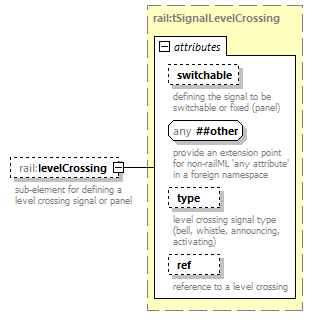 | ||||||||||||||||||||||||||||||
| namespace | https://www.railml.org/schemas/2021 | ||||||||||||||||||||||||||||||
| type | rail:tSignalLevelCrossing | ||||||||||||||||||||||||||||||
| properties |
| ||||||||||||||||||||||||||||||
| attributes |
| ||||||||||||||||||||||||||||||
| annotation |
| ||||||||||||||||||||||||||||||
| source | <xs:element name="levelCrossing" type="rail:tSignalLevelCrossing" minOccurs="0"> <xs:annotation> <xs:documentation>sub-element for defining a level crossing signal or panel</xs:documentation> <xs:documentation>See https://wiki2.railml.org/wiki/IS:levelCrossing_signal</xs:documentation> </xs:annotation> </xs:element> |
element tSignal/trainRadio
| diagram |  | ||||||||||||||||||||||
| namespace | https://www.railml.org/schemas/2021 | ||||||||||||||||||||||
| type | rail:tSignalTrainRadio | ||||||||||||||||||||||
| properties |
| ||||||||||||||||||||||
| attributes |
| ||||||||||||||||||||||
| annotation |
| ||||||||||||||||||||||
| source | <xs:element name="trainRadio" type="rail:tSignalTrainRadio" minOccurs="0"> <xs:annotation> <xs:documentation>sub-element for defining a train radio signal or panel</xs:documentation> <xs:documentation>See https://wiki2.railml.org/wiki/IS:trainRadio_signal</xs:documentation> </xs:annotation> </xs:element> |
element tSignal/catenary
| diagram |  | ||||||||||||||||||||||
| namespace | https://www.railml.org/schemas/2021 | ||||||||||||||||||||||
| type | rail:tSignalCatenary | ||||||||||||||||||||||
| properties |
| ||||||||||||||||||||||
| attributes |
| ||||||||||||||||||||||
| annotation |
| ||||||||||||||||||||||
| source | <xs:element name="catenary" type="rail:tSignalCatenary" minOccurs="0"> <xs:annotation> <xs:documentation>sub-element for defining a catenary signal or panel</xs:documentation> <xs:documentation>See https://wiki2.railml.org/wiki/IS:catenary</xs:documentation> </xs:annotation> </xs:element> |
element tSignal/line
| diagram | 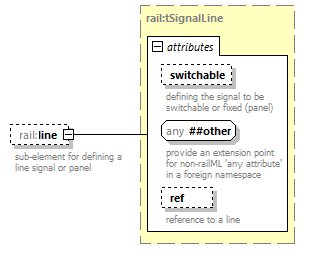 | ||||||||||||||||||||||
| namespace | https://www.railml.org/schemas/2021 | ||||||||||||||||||||||
| type | rail:tSignalLine | ||||||||||||||||||||||
| properties |
| ||||||||||||||||||||||
| attributes |
| ||||||||||||||||||||||
| annotation |
| ||||||||||||||||||||||
| source | <xs:element name="line" type="rail:tSignalLine" minOccurs="0"> <xs:annotation> <xs:documentation>sub-element for defining a line signal or panel</xs:documentation> <xs:documentation>See https://wiki2.railml.org/wiki/IS:line_signal</xs:documentation> </xs:annotation> </xs:element> |
element tSignal/milepost
| diagram |  | ||||||||||||||||||||||||||||||||||||||||||||||
| namespace | https://www.railml.org/schemas/2021 | ||||||||||||||||||||||||||||||||||||||||||||||
| type | rail:tSignalMilepost | ||||||||||||||||||||||||||||||||||||||||||||||
| properties |
| ||||||||||||||||||||||||||||||||||||||||||||||
| attributes |
| ||||||||||||||||||||||||||||||||||||||||||||||
| annotation |
| ||||||||||||||||||||||||||||||||||||||||||||||
| source | <xs:element name="milepost" type="rail:tSignalMilepost" minOccurs="0"> <xs:annotation> <xs:documentation>sub-element for defining a mileage signpost</xs:documentation> <xs:documentation>See https://wiki2.railml.org/wiki/IS:milepost</xs:documentation> </xs:annotation> </xs:element> |
element tSignal/braking
| diagram | 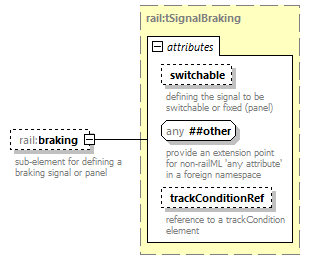 | ||||||||||||||||||||||
| namespace | https://www.railml.org/schemas/2021 | ||||||||||||||||||||||
| type | rail:tSignalBraking | ||||||||||||||||||||||
| properties |
| ||||||||||||||||||||||
| attributes |
| ||||||||||||||||||||||
| annotation |
| ||||||||||||||||||||||
| source | <xs:element name="braking" type="rail:tSignalBraking" minOccurs="0"> <xs:annotation> <xs:documentation>sub-element for defining a braking signal or panel</xs:documentation> <xs:documentation>See https://wiki2.railml.org/wiki/IS:braking</xs:documentation> </xs:annotation> </xs:element> |
element tSignal/trainProtectionElementGroupRef
| diagram |  | ||||||||||||||
| namespace | https://www.railml.org/schemas/2021 | ||||||||||||||
| type | rail:tElementWithReference | ||||||||||||||
| properties |
| ||||||||||||||
| attributes |
| ||||||||||||||
| annotation |
| ||||||||||||||
| source | <xs:element name="trainProtectionElementGroupRef" type="rail:tElementWithReference" minOccurs="0" maxOccurs="unbounded"> <xs:annotation> <xs:documentation>sub-element for a reference to a trainProtectionElementGroup, which is connected to the signal's aspect</xs:documentation> <xs:documentation>See https://wiki2.railml.org/wiki/IS:trainProtectionElementGroupRef</xs:documentation> </xs:annotation> </xs:element> |
element tSignal/baliseGroupRef
| diagram |  | ||||||||||||||
| namespace | https://www.railml.org/schemas/2021 | ||||||||||||||
| type | rail:tElementWithReference | ||||||||||||||
| properties |
| ||||||||||||||
| attributes |
| ||||||||||||||
| annotation |
| ||||||||||||||
| source | <xs:element name="baliseGroupRef" type="rail:tElementWithReference" minOccurs="0" maxOccurs="unbounded"> <xs:annotation> <xs:documentation>sub-element for a reference to a baliseGroup, which is connected to the signal's aspect</xs:documentation> <xs:documentation>See https://wiki2.railml.org/wiki/IS:baliseGroupRef</xs:documentation> </xs:annotation> </xs:element> |
complexType tSignalBase
| diagram |  | ||||||||||||||
| namespace | https://www.railml.org/schemas/2021 | ||||||||||||||
| used by |
| ||||||||||||||
| attributes |
| ||||||||||||||
| source | <xs:complexType name="tSignalBase"> <xs:attribute name="switchable" type="xs:boolean"> <xs:annotation> <xs:documentation>defining the signal to be switchable or fixed (panel)</xs:documentation> </xs:annotation> </xs:attribute> <xs:attributeGroup ref="rail:anyAttribute"> <xs:annotation> <xs:documentation>provide an extension point for non-railML attributes in foreign namespace</xs:documentation> </xs:annotation> </xs:attributeGroup> </xs:complexType> |
attribute tSignalBase/@switchable
| type | xs:boolean | ||
| annotation |
| ||
| source | <xs:attribute name="switchable" type="xs:boolean"> <xs:annotation> <xs:documentation>defining the signal to be switchable or fixed (panel)</xs:documentation> </xs:annotation> </xs:attribute> |
complexType tSignalBraking
| diagram |  | ||||||||||||||||||||||
| namespace | https://www.railml.org/schemas/2021 | ||||||||||||||||||||||
| type | extension of rail:tSignalBase | ||||||||||||||||||||||
| properties |
| ||||||||||||||||||||||
| used by |
| ||||||||||||||||||||||
| attributes |
| ||||||||||||||||||||||
| source | <xs:complexType name="tSignalBraking"> <xs:complexContent> <xs:extension base="rail:tSignalBase"> <xs:attribute name="trackConditionRef" type="rail:tGenericRef"> <xs:annotation> <xs:documentation>reference to a trackCondition element</xs:documentation> </xs:annotation> </xs:attribute> </xs:extension> </xs:complexContent> </xs:complexType> |
attribute tSignalBraking/@trackConditionRef
| type | rail:tGenericRef | ||
| annotation |
| ||
| source | <xs:attribute name="trackConditionRef" type="rail:tGenericRef"> <xs:annotation> <xs:documentation>reference to a trackCondition element</xs:documentation> </xs:annotation> </xs:attribute> |
complexType tSignalCatenary
| diagram |  | ||||||||||||||||||||||
| namespace | https://www.railml.org/schemas/2021 | ||||||||||||||||||||||
| type | extension of rail:tSignalBase | ||||||||||||||||||||||
| properties |
| ||||||||||||||||||||||
| used by |
| ||||||||||||||||||||||
| attributes |
| ||||||||||||||||||||||
| source | <xs:complexType name="tSignalCatenary"> <xs:complexContent> <xs:extension base="rail:tSignalBase"> <xs:attribute name="trackConditionRef" type="rail:tGenericRef"> <xs:annotation> <xs:documentation>reference to a trackCondition element</xs:documentation> </xs:annotation> </xs:attribute> </xs:extension> </xs:complexContent> </xs:complexType> |
attribute tSignalCatenary/@trackConditionRef
| type | rail:tGenericRef | ||
| annotation |
| ||
| source | <xs:attribute name="trackConditionRef" type="rail:tGenericRef"> <xs:annotation> <xs:documentation>reference to a trackCondition element</xs:documentation> </xs:annotation> </xs:attribute> |
complexType tSignalEtcs
| diagram | 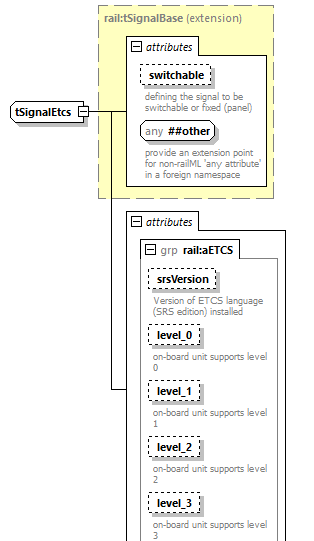 | ||||||||||||||||||||||||||||||||||||||||||||||||||||||
| namespace | https://www.railml.org/schemas/2021 | ||||||||||||||||||||||||||||||||||||||||||||||||||||||
| type | extension of rail:tSignalBase | ||||||||||||||||||||||||||||||||||||||||||||||||||||||
| properties |
| ||||||||||||||||||||||||||||||||||||||||||||||||||||||
| used by |
| ||||||||||||||||||||||||||||||||||||||||||||||||||||||
| attributes |
| ||||||||||||||||||||||||||||||||||||||||||||||||||||||
| source | <xs:complexType name="tSignalEtcs"> <xs:complexContent> <xs:extension base="rail:tSignalBase"> <xs:attributeGroup ref="rail:aETCS"> <xs:annotation> <xs:documentation>ETCS level (1, 2, 3, ...)</xs:documentation> </xs:annotation> </xs:attributeGroup> </xs:extension> </xs:complexContent> </xs:complexType> |
complexType tSignalGroup
| diagram |  | ||||||||||||||||||||||||||||||||||||||||||||||||||||
| namespace | https://www.railml.org/schemas/2021 | ||||||||||||||||||||||||||||||||||||||||||||||||||||
| type | extension of rail:tElementWithIDAndName | ||||||||||||||||||||||||||||||||||||||||||||||||||||
| properties |
| ||||||||||||||||||||||||||||||||||||||||||||||||||||
| children | rail:additionalName | ||||||||||||||||||||||||||||||||||||||||||||||||||||
| used by |
| ||||||||||||||||||||||||||||||||||||||||||||||||||||
| attributes |
| ||||||||||||||||||||||||||||||||||||||||||||||||||||
| source | <xs:complexType name="tSignalGroup"> <xs:complexContent> <xs:extension base="rail:tElementWithIDAndName"> <xs:attributeGroup ref="rail:aSignalGroup"/> </xs:extension> </xs:complexContent> </xs:complexType> |
complexType tSignalLevelCrossing
| diagram |  | ||||||||||||||||||||||||||||||
| namespace | https://www.railml.org/schemas/2021 | ||||||||||||||||||||||||||||||
| type | extension of rail:tSignalBase | ||||||||||||||||||||||||||||||
| properties |
| ||||||||||||||||||||||||||||||
| used by |
| ||||||||||||||||||||||||||||||
| attributes |
| ||||||||||||||||||||||||||||||
| source | <xs:complexType name="tSignalLevelCrossing"> <xs:complexContent> <xs:extension base="rail:tSignalBase"> <xs:attribute name="type" type="rail:tLevelCrossingSignalType"> <xs:annotation> <xs:documentation>level crossing signal type (bell, whistle, announcing, activating)</xs:documentation> </xs:annotation> </xs:attribute> <xs:attribute name="ref" type="rail:tGenericRef"> <xs:annotation> <xs:documentation>reference to a level crossing</xs:documentation> </xs:annotation> </xs:attribute> </xs:extension> </xs:complexContent> </xs:complexType> |
attribute tSignalLevelCrossing/@type
| type | rail:tLevelCrossingSignalType | ||
| annotation |
| ||
| source | <xs:attribute name="type" type="rail:tLevelCrossingSignalType"> <xs:annotation> <xs:documentation>level crossing signal type (bell, whistle, announcing, activating)</xs:documentation> </xs:annotation> </xs:attribute> |
attribute tSignalLevelCrossing/@ref
| type | rail:tGenericRef | ||
| annotation |
| ||
| source | <xs:attribute name="ref" type="rail:tGenericRef"> <xs:annotation> <xs:documentation>reference to a level crossing</xs:documentation> </xs:annotation> </xs:attribute> |
complexType tSignalLine
| diagram | 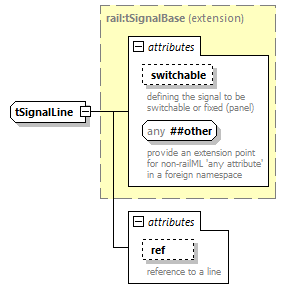 | ||||||||||||||||||||||
| namespace | https://www.railml.org/schemas/2021 | ||||||||||||||||||||||
| type | extension of rail:tSignalBase | ||||||||||||||||||||||
| properties |
| ||||||||||||||||||||||
| used by |
| ||||||||||||||||||||||
| attributes |
| ||||||||||||||||||||||
| source | <xs:complexType name="tSignalLine"> <xs:complexContent> <xs:extension base="rail:tSignalBase"> <xs:attribute name="ref" type="rail:tGenericRef"> <xs:annotation> <xs:documentation>reference to a line</xs:documentation> </xs:annotation> </xs:attribute> </xs:extension> </xs:complexContent> </xs:complexType> |
attribute tSignalLine/@ref
| type | rail:tGenericRef | ||
| annotation |
| ||
| source | <xs:attribute name="ref" type="rail:tGenericRef"> <xs:annotation> <xs:documentation>reference to a line</xs:documentation> </xs:annotation> </xs:attribute> |
complexType tSignalMilepost
| diagram |  | ||||||||||||||||||||||||||||||||||||||||||||||
| namespace | https://www.railml.org/schemas/2021 | ||||||||||||||||||||||||||||||||||||||||||||||
| type | extension of rail:tSignalBase | ||||||||||||||||||||||||||||||||||||||||||||||
| properties |
| ||||||||||||||||||||||||||||||||||||||||||||||
| used by |
| ||||||||||||||||||||||||||||||||||||||||||||||
| attributes |
| ||||||||||||||||||||||||||||||||||||||||||||||
| source | <xs:complexType name="tSignalMilepost"> <xs:complexContent> <xs:extension base="rail:tSignalBase"> <xs:attribute name="shownValue" type="rail:tLength"> <xs:annotation> <xs:documentation>mileage value printed on the milepost</xs:documentation> </xs:annotation> </xs:attribute> <xs:attribute name="shownRemark" type="xs:string"> <xs:annotation> <xs:documentation>any remark that is printed on the milepost, e.g. for documenting a mileage gap</xs:documentation> </xs:annotation> </xs:attribute> <xs:attribute name="mileageChangeRef" type="rail:tGenericRef"> <xs:annotation> <xs:documentation>reference to a mileageChange element</xs:documentation> </xs:annotation> </xs:attribute> <xs:attribute name="lineRef" type="rail:tGenericRef"> <xs:annotation> <xs:documentation>reference to a line, for which the milepost is valid</xs:documentation> </xs:annotation> </xs:attribute> </xs:extension> </xs:complexContent> </xs:complexType> |
attribute tSignalMilepost/@shownValue
| type | rail:tLength | ||||||
| facets |
| ||||||
| annotation |
| ||||||
| source | <xs:attribute name="shownValue" type="rail:tLength"> <xs:annotation> <xs:documentation>mileage value printed on the milepost</xs:documentation> </xs:annotation> </xs:attribute> |
attribute tSignalMilepost/@shownRemark
| type | xs:string | ||
| annotation |
| ||
| source | <xs:attribute name="shownRemark" type="xs:string"> <xs:annotation> <xs:documentation>any remark that is printed on the milepost, e.g. for documenting a mileage gap</xs:documentation> </xs:annotation> </xs:attribute> |
attribute tSignalMilepost/@mileageChangeRef
| type | rail:tGenericRef | ||
| annotation |
| ||
| source | <xs:attribute name="mileageChangeRef" type="rail:tGenericRef"> <xs:annotation> <xs:documentation>reference to a mileageChange element</xs:documentation> </xs:annotation> </xs:attribute> |
attribute tSignalMilepost/@lineRef
| type | rail:tGenericRef | ||
| annotation |
| ||
| source | <xs:attribute name="lineRef" type="rail:tGenericRef"> <xs:annotation> <xs:documentation>reference to a line, for which the milepost is valid</xs:documentation> </xs:annotation> </xs:attribute> |
complexType tSignalRefInGroup
| diagram |  | ||||||||||||||||||||
| namespace | https://www.railml.org/schemas/2021 | ||||||||||||||||||||
| type | extension of rail:tElementRefInGroup | ||||||||||||||||||||
| properties |
| ||||||||||||||||||||
| used by |
| ||||||||||||||||||||
| attributes |
| ||||||||||||||||||||
| source | <xs:complexType name="tSignalRefInGroup"> <xs:complexContent> <xs:extension base="rail:tElementRefInGroup"/> <!-- Possible signalGroup-specific attributes to be added here later --> </xs:complexContent> </xs:complexType> |
complexType tSignalSpeed
| diagram |  | ||||||||||||||||||||||||||||||
| namespace | https://www.railml.org/schemas/2021 | ||||||||||||||||||||||||||||||
| type | extension of rail:tSignalBase | ||||||||||||||||||||||||||||||
| properties |
| ||||||||||||||||||||||||||||||
| children | rail:speedChangeRef | ||||||||||||||||||||||||||||||
| used by |
| ||||||||||||||||||||||||||||||
| attributes |
| ||||||||||||||||||||||||||||||
| source | <xs:complexType name="tSignalSpeed"> <xs:complexContent> <xs:extension base="rail:tSignalBase"> <xs:sequence> <xs:element name="speedChangeRef" type="rail:tElementWithReference" minOccurs="0" maxOccurs="unbounded"> <xs:annotation> <xs:documentation>reference to a speed change</xs:documentation> <xs:documentation>See https://wiki2.railml.org/wiki/IS:speedChangeRef</xs:documentation> </xs:annotation> </xs:element> </xs:sequence> <xs:attribute name="kind" type="rail:tSignalKind"> <xs:annotation> <xs:documentation>speed signal/panel kind (announcement, execution)</xs:documentation> </xs:annotation> </xs:attribute> <xs:attribute name="trainRelation" type="rail:tTrainRelation"> <xs:annotation> <xs:documentation>Reference to the part of the train from where on the signal is valid.</xs:documentation> </xs:annotation> </xs:attribute> </xs:extension> </xs:complexContent> </xs:complexType> |
attribute tSignalSpeed/@kind
| type | rail:tSignalKind | ||
| annotation |
| ||
| source | <xs:attribute name="kind" type="rail:tSignalKind"> <xs:annotation> <xs:documentation>speed signal/panel kind (announcement, execution)</xs:documentation> </xs:annotation> </xs:attribute> |
attribute tSignalSpeed/@trainRelation
| type | rail:tTrainRelation | ||
| annotation |
| ||
| source | <xs:attribute name="trainRelation" type="rail:tTrainRelation"> <xs:annotation> <xs:documentation>Reference to the part of the train from where on the signal is valid.</xs:documentation> </xs:annotation> </xs:attribute> |
element tSignalSpeed/speedChangeRef
| diagram |  | ||||||||||||||
| namespace | https://www.railml.org/schemas/2021 | ||||||||||||||
| type | rail:tElementWithReference | ||||||||||||||
| properties |
| ||||||||||||||
| attributes |
| ||||||||||||||
| annotation |
| ||||||||||||||
| source | <xs:element name="speedChangeRef" type="rail:tElementWithReference" minOccurs="0" maxOccurs="unbounded"> <xs:annotation> <xs:documentation>reference to a speed change</xs:documentation> <xs:documentation>See https://wiki2.railml.org/wiki/IS:speedChangeRef</xs:documentation> </xs:annotation> </xs:element> |
complexType tSignalTrainRadio
| diagram |  | ||||||||||||||||||||||
| namespace | https://www.railml.org/schemas/2021 | ||||||||||||||||||||||
| type | extension of rail:tSignalBase | ||||||||||||||||||||||
| properties |
| ||||||||||||||||||||||
| used by |
| ||||||||||||||||||||||
| attributes |
| ||||||||||||||||||||||
| source | <xs:complexType name="tSignalTrainRadio"> <xs:complexContent> <xs:extension base="rail:tSignalBase"> <xs:attribute name="trackConditionRef" type="rail:tGenericRef"> <xs:annotation> <xs:documentation>reference to a trackCondition element</xs:documentation> </xs:annotation> </xs:attribute> </xs:extension> </xs:complexContent> </xs:complexType> |
attribute tSignalTrainRadio/@trackConditionRef
| type | rail:tGenericRef | ||
| annotation |
| ||
| source | <xs:attribute name="trackConditionRef" type="rail:tGenericRef"> <xs:annotation> <xs:documentation>reference to a trackCondition element</xs:documentation> </xs:annotation> </xs:attribute> |
complexType tSize
| diagram |  | ||||||||||||||||||
| namespace | https://www.railml.org/schemas/2021 | ||||||||||||||||||
| used by |
| ||||||||||||||||||
| attributes |
| ||||||||||||||||||
| source | <xs:complexType name="tSize"> <xs:attribute name="width" type="xs:double" use="required"/> <xs:attribute name="height" type="xs:double" use="required"/> </xs:complexType> |
attribute tSize/@width
| type | xs:double | ||
| properties |
| ||
| source | <xs:attribute name="width" type="xs:double" use="required"/> |
attribute tSize/@height
| type | xs:double | ||
| properties |
| ||
| source | <xs:attribute name="height" type="xs:double" use="required"/> |
complexType tSpeedChange
| diagram |  | ||||||||||||||||||||||||||||||||||||||||||||||||||||||||||||||||||||||||||||||||||||||||||||||||||||||||||||||||||||||||||||||||||||||||||||||
| namespace | https://www.railml.org/schemas/2021 | ||||||||||||||||||||||||||||||||||||||||||||||||||||||||||||||||||||||||||||||||||||||||||||||||||||||||||||||||||||||||||||||||||||||||||||||
| type | extension of rail:tStrictOrientedElement | ||||||||||||||||||||||||||||||||||||||||||||||||||||||||||||||||||||||||||||||||||||||||||||||||||||||||||||||||||||||||||||||||||||||||||||||
| properties |
| ||||||||||||||||||||||||||||||||||||||||||||||||||||||||||||||||||||||||||||||||||||||||||||||||||||||||||||||||||||||||||||||||||||||||||||||
| children | rail:additionalName rail:geoCoord rail:states | ||||||||||||||||||||||||||||||||||||||||||||||||||||||||||||||||||||||||||||||||||||||||||||||||||||||||||||||||||||||||||||||||||||||||||||||
| used by |
| ||||||||||||||||||||||||||||||||||||||||||||||||||||||||||||||||||||||||||||||||||||||||||||||||||||||||||||||||||||||||||||||||||||||||||||||
| attributes |
| ||||||||||||||||||||||||||||||||||||||||||||||||||||||||||||||||||||||||||||||||||||||||||||||||||||||||||||||||||||||||||||||||||||||||||||||
| source | <xs:complexType name="tSpeedChange"> <xs:complexContent> <xs:extension base="rail:tStrictOrientedElement"> <xs:attributeGroup ref="rail:aSpeed"/> <xs:attribute name="trainRelation" type="rail:tTrainRelation"> <xs:annotation> <xs:documentation>Reference to the part of the train from where on the speed change is valid. Normally, a speed restriction that is higher than the train's current speed will be valid when the end of the train has passed the speed change while a speed restriction that is lower than the train's current speed will be valid already when the head of train passes the speedChange.</xs:documentation> <xs:documentation>If the attribute is not given, it means that the information is not known.</xs:documentation> </xs:annotation> </xs:attribute> <xs:attribute name="mandatoryStop" type="xs:boolean"> <xs:annotation> <xs:documentation>specifying the speedChange as a mandatory stop point, e.g. in front of a level crossing</xs:documentation> </xs:annotation> </xs:attribute> <xs:attribute name="signalised" type="xs:boolean"> <xs:annotation> <xs:documentation>indicates whether the speed aspect is shown next to the track by a signal or panel (true) or only in the "driver's timetable" (false)</xs:documentation> </xs:annotation> </xs:attribute> </xs:extension> </xs:complexContent> </xs:complexType> |
attribute tSpeedChange/@trainRelation
| type | rail:tTrainRelation | ||||
| annotation |
| ||||
| source | <xs:attribute name="trainRelation" type="rail:tTrainRelation"> <xs:annotation> <xs:documentation>Reference to the part of the train from where on the speed change is valid. Normally, a speed restriction that is higher than the train's current speed will be valid when the end of the train has passed the speed change while a speed restriction that is lower than the train's current speed will be valid already when the head of train passes the speedChange.</xs:documentation> <xs:documentation>If the attribute is not given, it means that the information is not known.</xs:documentation> </xs:annotation> </xs:attribute> |
attribute tSpeedChange/@mandatoryStop
| type | xs:boolean | ||
| annotation |
| ||
| source | <xs:attribute name="mandatoryStop" type="xs:boolean"> <xs:annotation> <xs:documentation>specifying the speedChange as a mandatory stop point, e.g. in front of a level crossing</xs:documentation> </xs:annotation> </xs:attribute> |
attribute tSpeedChange/@signalised
| type | xs:boolean | ||
| annotation |
| ||
| source | <xs:attribute name="signalised" type="xs:boolean"> <xs:annotation> <xs:documentation>indicates whether the speed aspect is shown next to the track by a signal or panel (true) or only in the "driver's timetable" (false)</xs:documentation> </xs:annotation> </xs:attribute> |
complexType tSpeedInfo
| diagram | 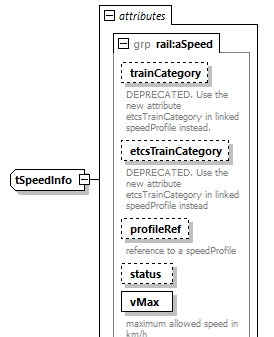 | ||||||||||||||||||||||||||||||||||||||||||||
| namespace | https://www.railml.org/schemas/2021 | ||||||||||||||||||||||||||||||||||||||||||||
| used by |
| ||||||||||||||||||||||||||||||||||||||||||||
| attributes |
| ||||||||||||||||||||||||||||||||||||||||||||
| source | <xs:complexType name="tSpeedInfo"> <xs:attributeGroup ref="rail:aSpeed"/> </xs:complexType> |
complexType tSpeedProfile
| diagram |  | ||||||||||||||||||||||||||||||||||||||||||||||||||||||||||||||||||||||||||||||||||||||||||||||||||||||||||||||||||||||||||||||||||||||
| namespace | https://www.railml.org/schemas/2021 | ||||||||||||||||||||||||||||||||||||||||||||||||||||||||||||||||||||||||||||||||||||||||||||||||||||||||||||||||||||||||||||||||||||||
| type | extension of rail:tElementWithIDAndName | ||||||||||||||||||||||||||||||||||||||||||||||||||||||||||||||||||||||||||||||||||||||||||||||||||||||||||||||||||||||||||||||||||||||
| properties |
| ||||||||||||||||||||||||||||||||||||||||||||||||||||||||||||||||||||||||||||||||||||||||||||||||||||||||||||||||||||||||||||||||||||||
| children | rail:additionalName rail:tilting rail:braking rail:path | ||||||||||||||||||||||||||||||||||||||||||||||||||||||||||||||||||||||||||||||||||||||||||||||||||||||||||||||||||||||||||||||||||||||
| used by |
| ||||||||||||||||||||||||||||||||||||||||||||||||||||||||||||||||||||||||||||||||||||||||||||||||||||||||||||||||||||||||||||||||||||||
| attributes |
| ||||||||||||||||||||||||||||||||||||||||||||||||||||||||||||||||||||||||||||||||||||||||||||||||||||||||||||||||||||||||||||||||||||||
| source | <xs:complexType name="tSpeedProfile"> <xs:complexContent> <xs:extension base="rail:tElementWithIDAndName"> <xs:annotation> <xs:documentation>speed profile element that is referenced by speedChange elements</xs:documentation> </xs:annotation> <xs:sequence> <xs:element name="tilting" type="rail:tTilting" minOccurs="0"> <xs:annotation> <xs:documentation>the tilting element contains parameters describing the required train tilting characteristics</xs:documentation> <xs:documentation>See https://wiki2.railml.org/wiki/IS:tilting</xs:documentation> </xs:annotation> </xs:element> <xs:element name="braking" type="rail:tBraking" minOccurs="0"> <xs:annotation> <xs:documentation>the braking element contains parameters describing the required train braking configuration</xs:documentation> <xs:documentation>See https://wiki2.railml.org/wiki/IS:braking</xs:documentation> </xs:annotation> </xs:element> <xs:element name="path" type="rail:tPath" minOccurs="0"> <xs:annotation> <xs:documentation>the path element indicates a train run between two neighbouring OCPs</xs:documentation> <xs:documentation>See https://wiki2.railml.org/wiki/IS:path</xs:documentation> </xs:annotation> </xs:element> </xs:sequence> <xs:attribute name="basicSpeedProfile" type="xs:boolean" default="false"> <xs:annotation> <xs:documentation>specify the speed profile being a basic speed profile</xs:documentation> <xs:documentation>defines a "baseline speed value" that is valid for all trains if no other specific speed restrictions are given. The basic speed profile is always linked with @influence="increasing"</xs:documentation> </xs:annotation> </xs:attribute> <xs:attribute name="etcsTrainCategory" type="rail:tEtcsTrainCategory"> <xs:annotation> <xs:documentation>the international train category number as specified on page 38 in ERA_ERTMS_040001 "Assignment of values to ETCS variables" v1.9 from 10/07/12</xs:documentation> </xs:annotation> </xs:attribute> <xs:attribute name="influence" type="rail:tInfluence" use="required"> <xs:annotation> <xs:documentation>allows for overlaying speed profiles</xs:documentation> </xs:annotation> </xs:attribute> <xs:attribute name="maxAxleLoad" type="rail:tWeightTons"> <xs:annotation> <xs:documentation>maximum axle load of the train in tons</xs:documentation> </xs:annotation> </xs:attribute> <xs:attribute name="maxMeterLoad" type="rail:tMeterloadTonsPerMeter"> <xs:annotation> <xs:documentation>maximum meter load of the train in tons per meter</xs:documentation> </xs:annotation> </xs:attribute> <xs:attribute name="operatingPeriodRef" type="rail:tGenericRef"> <xs:annotation> <xs:documentation>reference to an operatingPeriod element from the timetable sub-schema</xs:documentation> </xs:annotation> </xs:attribute> <xs:attributeGroup ref="rail:aPeriodTimeSpan"> <xs:annotation> <xs:documentation>Start and end time of the validity of the speed profile.</xs:documentation> </xs:annotation> </xs:attributeGroup> <xs:attribute name="endDayOffset" type="xs:nonNegativeInteger"> <xs:annotation> <xs:documentation>The number of midnight overruns over which the speed profile is valid.</xs:documentation> </xs:annotation> </xs:attribute> <xs:attribute name="trainProtectionSystem" type="xs:string"> <xs:annotation> <xs:documentation>defining the train protection system</xs:documentation> <xs:documentation>use value from the separate code definition file 'TrainProtectionSystems.xml'/trainProtectionSystemsAtTrack</xs:documentation> </xs:annotation> </xs:attribute> <xs:attribute name="verbalConstraint" type="xs:string"> <xs:annotation> <xs:documentation>defining additional verbal constraints like certain train types</xs:documentation> </xs:annotation> </xs:attribute> </xs:extension> </xs:complexContent> </xs:complexType> |
attribute tSpeedProfile/@basicSpeedProfile
| type | xs:boolean | ||||
| properties |
| ||||
| annotation |
| ||||
| source | <xs:attribute name="basicSpeedProfile" type="xs:boolean" default="false"> <xs:annotation> <xs:documentation>specify the speed profile being a basic speed profile</xs:documentation> <xs:documentation>defines a "baseline speed value" that is valid for all trains if no other specific speed restrictions are given. The basic speed profile is always linked with @influence="increasing"</xs:documentation> </xs:annotation> </xs:attribute> |
attribute tSpeedProfile/@etcsTrainCategory
| type | rail:tEtcsTrainCategory | |||||||||
| facets |
| |||||||||
| annotation |
| |||||||||
| source | <xs:attribute name="etcsTrainCategory" type="rail:tEtcsTrainCategory"> <xs:annotation> <xs:documentation>the international train category number as specified on page 38 in ERA_ERTMS_040001 "Assignment of values to ETCS variables" v1.9 from 10/07/12</xs:documentation> </xs:annotation> </xs:attribute> |
attribute tSpeedProfile/@influence
| type | rail:tInfluence | ||
| properties |
| ||
| annotation |
| ||
| source | <xs:attribute name="influence" type="rail:tInfluence" use="required"> <xs:annotation> <xs:documentation>allows for overlaying speed profiles</xs:documentation> </xs:annotation> </xs:attribute> |
attribute tSpeedProfile/@maxAxleLoad
| type | rail:tWeightTons | ||||||
| facets |
| ||||||
| annotation |
| ||||||
| source | <xs:attribute name="maxAxleLoad" type="rail:tWeightTons"> <xs:annotation> <xs:documentation>maximum axle load of the train in tons</xs:documentation> </xs:annotation> </xs:attribute> |
attribute tSpeedProfile/@maxMeterLoad
| type | rail:tMeterloadTonsPerMeter | ||||||
| facets |
| ||||||
| annotation |
| ||||||
| source | <xs:attribute name="maxMeterLoad" type="rail:tMeterloadTonsPerMeter"> <xs:annotation> <xs:documentation>maximum meter load of the train in tons per meter</xs:documentation> </xs:annotation> </xs:attribute> |
attribute tSpeedProfile/@operatingPeriodRef
| type | rail:tGenericRef | ||
| annotation |
| ||
| source | <xs:attribute name="operatingPeriodRef" type="rail:tGenericRef"> <xs:annotation> <xs:documentation>reference to an operatingPeriod element from the timetable sub-schema</xs:documentation> </xs:annotation> </xs:attribute> |
attribute tSpeedProfile/@endDayOffset
| type | xs:nonNegativeInteger | ||
| annotation |
| ||
| source | <xs:attribute name="endDayOffset" type="xs:nonNegativeInteger"> <xs:annotation> <xs:documentation>The number of midnight overruns over which the speed profile is valid.</xs:documentation> </xs:annotation> </xs:attribute> |
attribute tSpeedProfile/@trainProtectionSystem
| type | xs:string | ||||
| annotation |
| ||||
| source | <xs:attribute name="trainProtectionSystem" type="xs:string"> <xs:annotation> <xs:documentation>defining the train protection system</xs:documentation> <xs:documentation>use value from the separate code definition file 'TrainProtectionSystems.xml'/trainProtectionSystemsAtTrack</xs:documentation> </xs:annotation> </xs:attribute> |
attribute tSpeedProfile/@verbalConstraint
| type | xs:string | ||
| annotation |
| ||
| source | <xs:attribute name="verbalConstraint" type="xs:string"> <xs:annotation> <xs:documentation>defining additional verbal constraints like certain train types</xs:documentation> </xs:annotation> </xs:attribute> |
element tSpeedProfile/tilting
| diagram | 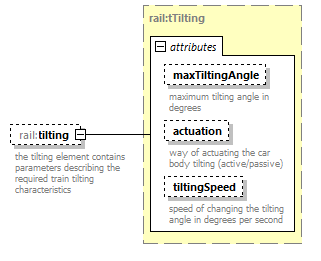 | ||||||||||||||||||||||||||||||
| namespace | https://www.railml.org/schemas/2021 | ||||||||||||||||||||||||||||||
| type | rail:tTilting | ||||||||||||||||||||||||||||||
| properties |
| ||||||||||||||||||||||||||||||
| attributes |
| ||||||||||||||||||||||||||||||
| annotation |
| ||||||||||||||||||||||||||||||
| source | <xs:element name="tilting" type="rail:tTilting" minOccurs="0"> <xs:annotation> <xs:documentation>the tilting element contains parameters describing the required train tilting characteristics</xs:documentation> <xs:documentation>See https://wiki2.railml.org/wiki/IS:tilting</xs:documentation> </xs:annotation> </xs:element> |
element tSpeedProfile/braking
| diagram |  | ||||||||||||||||||||||||||||||
| namespace | https://www.railml.org/schemas/2021 | ||||||||||||||||||||||||||||||
| type | rail:tBraking | ||||||||||||||||||||||||||||||
| properties |
| ||||||||||||||||||||||||||||||
| attributes |
| ||||||||||||||||||||||||||||||
| annotation |
| ||||||||||||||||||||||||||||||
| source | <xs:element name="braking" type="rail:tBraking" minOccurs="0"> <xs:annotation> <xs:documentation>the braking element contains parameters describing the required train braking configuration</xs:documentation> <xs:documentation>See https://wiki2.railml.org/wiki/IS:braking</xs:documentation> </xs:annotation> </xs:element> |
element tSpeedProfile/path
| diagram |  | ||||||
| namespace | https://www.railml.org/schemas/2021 | ||||||
| type | rail:tPath | ||||||
| properties |
| ||||||
| children | rail:ocpRef | ||||||
| annotation |
| ||||||
| source | <xs:element name="path" type="rail:tPath" minOccurs="0"> <xs:annotation> <xs:documentation>the path element indicates a train run between two neighbouring OCPs</xs:documentation> <xs:documentation>See https://wiki2.railml.org/wiki/IS:path</xs:documentation> </xs:annotation> </xs:element> |
complexType tStatesWithLength
| diagram |  | ||
| namespace | https://www.railml.org/schemas/2021 | ||
| children | rail:state | ||
| used by |
| ||
| source | <xs:complexType name="tStatesWithLength"> <xs:sequence> <xs:element name="state" type="rail:tStateWithLength" maxOccurs="unbounded"> <xs:annotation> <xs:documentation>This is to define disabled/enabled infrastructure pieces with a given time frame for a certain length.</xs:documentation> <xs:documentation>See https://wiki2.railml.org/wiki/IS:state_(with_length)</xs:documentation> </xs:annotation> </xs:element> </xs:sequence> </xs:complexType> |
element tStatesWithLength/state
| diagram |  | ||||||||||||||||||||||||||||||||||||||||||||||||||||||||||||||||||||||||||||||
| namespace | https://www.railml.org/schemas/2021 | ||||||||||||||||||||||||||||||||||||||||||||||||||||||||||||||||||||||||||||||
| type | rail:tStateWithLength | ||||||||||||||||||||||||||||||||||||||||||||||||||||||||||||||||||||||||||||||
| properties |
| ||||||||||||||||||||||||||||||||||||||||||||||||||||||||||||||||||||||||||||||
| children | rail:designator rail:from rail:to | ||||||||||||||||||||||||||||||||||||||||||||||||||||||||||||||||||||||||||||||
| attributes |
| ||||||||||||||||||||||||||||||||||||||||||||||||||||||||||||||||||||||||||||||
| annotation |
| ||||||||||||||||||||||||||||||||||||||||||||||||||||||||||||||||||||||||||||||
| source | <xs:element name="state" type="rail:tStateWithLength" maxOccurs="unbounded"> <xs:annotation> <xs:documentation>This is to define disabled/enabled infrastructure pieces with a given time frame for a certain length.</xs:documentation> <xs:documentation>See https://wiki2.railml.org/wiki/IS:state_(with_length)</xs:documentation> </xs:annotation> </xs:element> |
complexType tStateWithLength
| diagram | 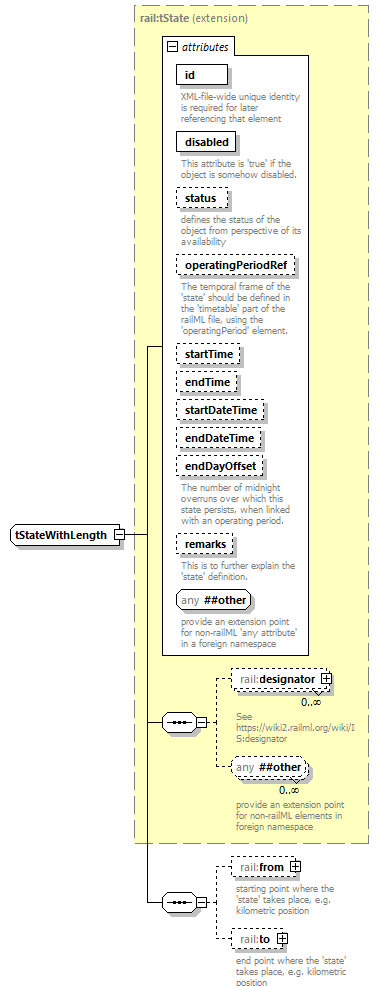 | ||||||||||||||||||||||||||||||||||||||||||||||||||||||||||||||||||||||||||||||
| namespace | https://www.railml.org/schemas/2021 | ||||||||||||||||||||||||||||||||||||||||||||||||||||||||||||||||||||||||||||||
| type | extension of rail:tState | ||||||||||||||||||||||||||||||||||||||||||||||||||||||||||||||||||||||||||||||
| properties |
| ||||||||||||||||||||||||||||||||||||||||||||||||||||||||||||||||||||||||||||||
| children | rail:designator rail:from rail:to | ||||||||||||||||||||||||||||||||||||||||||||||||||||||||||||||||||||||||||||||
| used by |
| ||||||||||||||||||||||||||||||||||||||||||||||||||||||||||||||||||||||||||||||
| attributes |
| ||||||||||||||||||||||||||||||||||||||||||||||||||||||||||||||||||||||||||||||
| source | <xs:complexType name="tStateWithLength"> <xs:complexContent> <xs:extension base="rail:tState"> <xs:sequence> <xs:element name="from" type="rail:tLocation" minOccurs="0"> <xs:annotation> <xs:documentation>starting point where the 'state' takes place, e.g. kilometric position</xs:documentation> <xs:documentation>See https://wiki2.railml.org/wiki/IS:from_state</xs:documentation> </xs:annotation> </xs:element> <xs:element name="to" type="rail:tLocation" minOccurs="0"> <xs:annotation> <xs:documentation>end point where the 'state' takes place, e.g. kilometric position</xs:documentation> <xs:documentation>See https://wiki2.railml.org/wiki/IS:to_state</xs:documentation> </xs:annotation> </xs:element> </xs:sequence> </xs:extension> </xs:complexContent> </xs:complexType> |
element tStateWithLength/from
| diagram |  | ||||||||||||||||||||||||||||||||||||||
| namespace | https://www.railml.org/schemas/2021 | ||||||||||||||||||||||||||||||||||||||
| type | rail:tLocation | ||||||||||||||||||||||||||||||||||||||
| properties |
| ||||||||||||||||||||||||||||||||||||||
| children | rail:geoCoord | ||||||||||||||||||||||||||||||||||||||
| attributes |
| ||||||||||||||||||||||||||||||||||||||
| annotation |
| ||||||||||||||||||||||||||||||||||||||
| source | <xs:element name="from" type="rail:tLocation" minOccurs="0"> <xs:annotation> <xs:documentation>starting point where the 'state' takes place, e.g. kilometric position</xs:documentation> <xs:documentation>See https://wiki2.railml.org/wiki/IS:from_state</xs:documentation> </xs:annotation> </xs:element> |
element tStateWithLength/to
| diagram |  | ||||||||||||||||||||||||||||||||||||||
| namespace | https://www.railml.org/schemas/2021 | ||||||||||||||||||||||||||||||||||||||
| type | rail:tLocation | ||||||||||||||||||||||||||||||||||||||
| properties |
| ||||||||||||||||||||||||||||||||||||||
| children | rail:geoCoord | ||||||||||||||||||||||||||||||||||||||
| attributes |
| ||||||||||||||||||||||||||||||||||||||
| annotation |
| ||||||||||||||||||||||||||||||||||||||
| source | <xs:element name="to" type="rail:tLocation" minOccurs="0"> <xs:annotation> <xs:documentation>end point where the 'state' takes place, e.g. kilometric position</xs:documentation> <xs:documentation>See https://wiki2.railml.org/wiki/IS:to_state</xs:documentation> </xs:annotation> </xs:element> |
complexType tStopPost
| diagram |  | ||||||||||||||||||||||||||||||||||||||||||||||||||||||||||||||||||||||||||||||||||||||||||||||||||||||||||||||||||||||||||||||||||||||||||||||||||||||
| namespace | https://www.railml.org/schemas/2021 | ||||||||||||||||||||||||||||||||||||||||||||||||||||||||||||||||||||||||||||||||||||||||||||||||||||||||||||||||||||||||||||||||||||||||||||||||||||||
| type | extension of rail:tRuleCodeElement | ||||||||||||||||||||||||||||||||||||||||||||||||||||||||||||||||||||||||||||||||||||||||||||||||||||||||||||||||||||||||||||||||||||||||||||||||||||||
| properties |
| ||||||||||||||||||||||||||||||||||||||||||||||||||||||||||||||||||||||||||||||||||||||||||||||||||||||||||||||||||||||||||||||||||||||||||||||||||||||
| children | rail:additionalName rail:geoCoord rail:states rail:validForMovements rail:signalRef | ||||||||||||||||||||||||||||||||||||||||||||||||||||||||||||||||||||||||||||||||||||||||||||||||||||||||||||||||||||||||||||||||||||||||||||||||||||||
| used by |
| ||||||||||||||||||||||||||||||||||||||||||||||||||||||||||||||||||||||||||||||||||||||||||||||||||||||||||||||||||||||||||||||||||||||||||||||||||||||
| attributes |
| ||||||||||||||||||||||||||||||||||||||||||||||||||||||||||||||||||||||||||||||||||||||||||||||||||||||||||||||||||||||||||||||||||||||||||||||||||||||
| source | <xs:complexType name="tStopPost"> <xs:complexContent> <xs:extension base="rail:tRuleCodeElement"> <xs:sequence> <xs:element name="validForMovements" type="rail:tValidForMovements" minOccurs="0" maxOccurs="unbounded"> <xs:annotation> <xs:documentation>specification of the train types for which the stop post is relevant</xs:documentation> <xs:documentation>See https://wiki2.railml.org/wiki/IS:validForMovements</xs:documentation> </xs:annotation> </xs:element> <xs:element name="signalRef" type="rail:tElementWithReference" minOccurs="0" maxOccurs="unbounded"> <xs:annotation> <xs:documentation>reference to a (main) signal that is valid for a train waiting at the stop post</xs:documentation> <xs:documentation>See https://wiki2.railml.org/wiki/IS:signalRef_stopPost</xs:documentation> </xs:annotation> </xs:element> </xs:sequence> <xs:attributeGroup ref="rail:aStopPost"/> <xs:attributeGroup ref="rail:anyAttribute"> <xs:annotation> <xs:documentation>provide an extension point for non-railML attributes in foreign namespace</xs:documentation> </xs:annotation> </xs:attributeGroup> </xs:extension> </xs:complexContent> </xs:complexType> |
element tStopPost/validForMovements
| diagram |  | ||||||||||||||
| namespace | https://www.railml.org/schemas/2021 | ||||||||||||||
| type | rail:tValidForMovements | ||||||||||||||
| properties |
| ||||||||||||||
| attributes |
| ||||||||||||||
| annotation |
| ||||||||||||||
| source | <xs:element name="validForMovements" type="rail:tValidForMovements" minOccurs="0" maxOccurs="unbounded"> <xs:annotation> <xs:documentation>specification of the train types for which the stop post is relevant</xs:documentation> <xs:documentation>See https://wiki2.railml.org/wiki/IS:validForMovements</xs:documentation> </xs:annotation> </xs:element> |
element tStopPost/signalRef
| diagram | 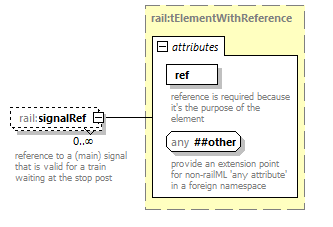 | ||||||||||||||
| namespace | https://www.railml.org/schemas/2021 | ||||||||||||||
| type | rail:tElementWithReference | ||||||||||||||
| properties |
| ||||||||||||||
| attributes |
| ||||||||||||||
| annotation |
| ||||||||||||||
| source | <xs:element name="signalRef" type="rail:tElementWithReference" minOccurs="0" maxOccurs="unbounded"> <xs:annotation> <xs:documentation>reference to a (main) signal that is valid for a train waiting at the stop post</xs:documentation> <xs:documentation>See https://wiki2.railml.org/wiki/IS:signalRef_stopPost</xs:documentation> </xs:annotation> </xs:element> |
complexType tStrictOrientedElement
| diagram |  | ||||||||||||||||||||||||||||||||||||||||||||||||||||||||||||||||||||||||||||||
| namespace | https://www.railml.org/schemas/2021 | ||||||||||||||||||||||||||||||||||||||||||||||||||||||||||||||||||||||||||||||
| type | extension of rail:tPlacedElement | ||||||||||||||||||||||||||||||||||||||||||||||||||||||||||||||||||||||||||||||
| properties |
| ||||||||||||||||||||||||||||||||||||||||||||||||||||||||||||||||||||||||||||||
| children | rail:additionalName rail:geoCoord rail:states | ||||||||||||||||||||||||||||||||||||||||||||||||||||||||||||||||||||||||||||||
| used by |
| ||||||||||||||||||||||||||||||||||||||||||||||||||||||||||||||||||||||||||||||
| attributes |
| ||||||||||||||||||||||||||||||||||||||||||||||||||||||||||||||||||||||||||||||
| source | <xs:complexType name="tStrictOrientedElement"> <xs:complexContent> <xs:extension base="rail:tPlacedElement"> <xs:attributeGroup ref="rail:aStrictOrientation"/> </xs:extension> </xs:complexContent> </xs:complexType> |
complexType tStrictOrientedElementWithLength
| diagram | 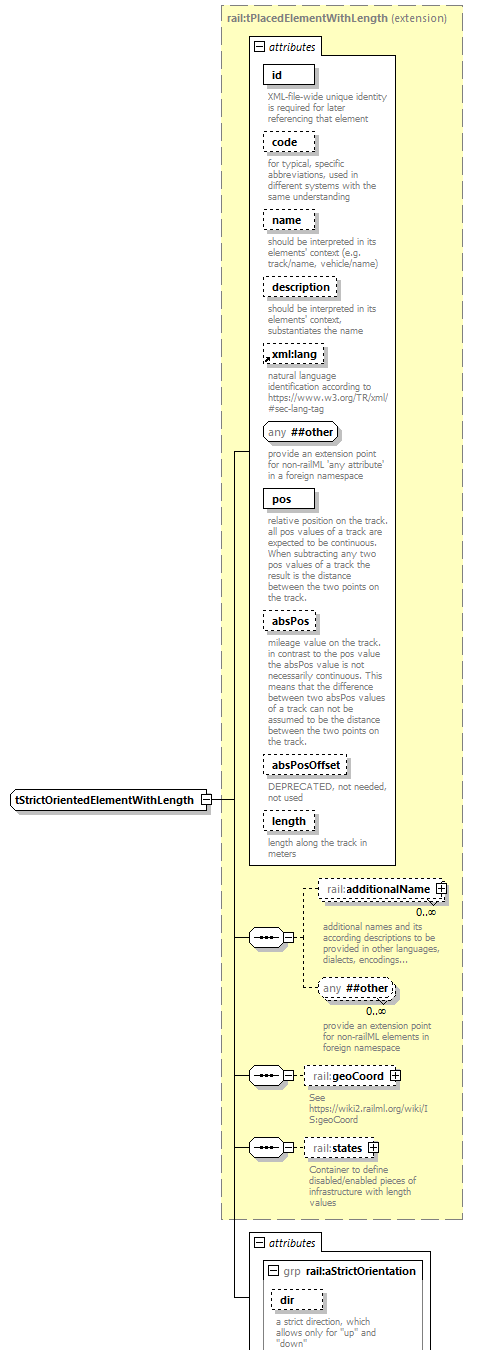 | ||||||||||||||||||||||||||||||||||||||||||||||||||||||||||||||||||||||||||||||||||||||
| namespace | https://www.railml.org/schemas/2021 | ||||||||||||||||||||||||||||||||||||||||||||||||||||||||||||||||||||||||||||||||||||||
| type | extension of rail:tPlacedElementWithLength | ||||||||||||||||||||||||||||||||||||||||||||||||||||||||||||||||||||||||||||||||||||||
| properties |
| ||||||||||||||||||||||||||||||||||||||||||||||||||||||||||||||||||||||||||||||||||||||
| children | rail:additionalName rail:geoCoord rail:states | ||||||||||||||||||||||||||||||||||||||||||||||||||||||||||||||||||||||||||||||||||||||
| attributes |
| ||||||||||||||||||||||||||||||||||||||||||||||||||||||||||||||||||||||||||||||||||||||
| source | <xs:complexType name="tStrictOrientedElementWithLength"> <xs:complexContent> <xs:extension base="rail:tPlacedElementWithLength"> <xs:attributeGroup ref="rail:aStrictOrientation"/> </xs:extension> </xs:complexContent> </xs:complexType> |
complexType tSwitch
| diagram |  | ||||||||||||||||||||||||||||||||||||||||||||||||||||||||||||||||||||||||||||||||||||||||||||||||||||||||||||||||||||||||||||||||||||||||||||||||||||||
| namespace | https://www.railml.org/schemas/2021 | ||||||||||||||||||||||||||||||||||||||||||||||||||||||||||||||||||||||||||||||||||||||||||||||||||||||||||||||||||||||||||||||||||||||||||||||||||||||
| type | extension of rail:tCommonSwitchAndCrossingData | ||||||||||||||||||||||||||||||||||||||||||||||||||||||||||||||||||||||||||||||||||||||||||||||||||||||||||||||||||||||||||||||||||||||||||||||||||||||
| properties |
| ||||||||||||||||||||||||||||||||||||||||||||||||||||||||||||||||||||||||||||||||||||||||||||||||||||||||||||||||||||||||||||||||||||||||||||||||||||||
| children | rail:additionalName rail:geoCoord rail:states | ||||||||||||||||||||||||||||||||||||||||||||||||||||||||||||||||||||||||||||||||||||||||||||||||||||||||||||||||||||||||||||||||||||||||||||||||||||||
| used by |
| ||||||||||||||||||||||||||||||||||||||||||||||||||||||||||||||||||||||||||||||||||||||||||||||||||||||||||||||||||||||||||||||||||||||||||||||||||||||
| attributes |
| ||||||||||||||||||||||||||||||||||||||||||||||||||||||||||||||||||||||||||||||||||||||||||||||||||||||||||||||||||||||||||||||||||||||||||||||||||||||
| source | <xs:complexType name="tSwitch"> <xs:complexContent> <xs:extension base="rail:tCommonSwitchAndCrossingData"> <xs:attribute name="type" type="rail:tSwitchType"/> </xs:extension> </xs:complexContent> </xs:complexType> |
attribute tSwitch/@type
| type | rail:tSwitchType |
| source | <xs:attribute name="type" type="rail:tSwitchType"/> |
complexType tSwitchAndPosition
| diagram | 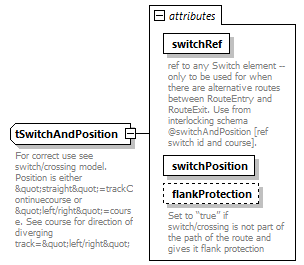 | ||||||||||||||||||||||||||||
| namespace | https://www.railml.org/schemas/2021 | ||||||||||||||||||||||||||||
| used by |
| ||||||||||||||||||||||||||||
| attributes |
| ||||||||||||||||||||||||||||
| annotation |
| ||||||||||||||||||||||||||||
| source | <xs:complexType name="tSwitchAndPosition"> <xs:annotation> <xs:documentation>For correct use see switch/crossing model. Position is either "straight"=trackContinuecourse or "left/right"=course. See course for direction of diverging track="left/right"</xs:documentation> </xs:annotation> <xs:attribute name="switchRef" type="rail:tGenericRef" use="required"> <xs:annotation> <xs:documentation>ref to any Switch element -- only to be used for when there are alternative routes between RouteEntry and RouteExit. Use from interlocking schema @switchAndPosition [ref switch id and course].</xs:documentation> </xs:annotation> </xs:attribute> <xs:attribute name="switchPosition" type="rail:tCourse" use="required"/> <xs:attribute name="flankProtection" type="xs:boolean"> <xs:annotation> <xs:documentation>Set to “true” if switch/crossing is not part of the path of the route and gives it flank protection</xs:documentation> </xs:annotation> </xs:attribute> </xs:complexType> |
attribute tSwitchAndPosition/@switchRef
| type | rail:tGenericRef | ||
| properties |
| ||
| annotation |
| ||
| source | <xs:attribute name="switchRef" type="rail:tGenericRef" use="required"> <xs:annotation> <xs:documentation>ref to any Switch element -- only to be used for when there are alternative routes between RouteEntry and RouteExit. Use from interlocking schema @switchAndPosition [ref switch id and course].</xs:documentation> </xs:annotation> </xs:attribute> |
attribute tSwitchAndPosition/@switchPosition
| type | rail:tCourse | ||
| properties |
| ||
| source | <xs:attribute name="switchPosition" type="rail:tCourse" use="required"/> |
attribute tSwitchAndPosition/@flankProtection
| type | xs:boolean | ||
| annotation |
| ||
| source | <xs:attribute name="flankProtection" type="xs:boolean"> <xs:annotation> <xs:documentation>Set to “true” if switch/crossing is not part of the path of the route and gives it flank protection</xs:documentation> </xs:annotation> </xs:attribute> |
complexType tSwitchConnectionData
| diagram |  | ||||||||||||||||||||||||||||||||||||||||||||||||||||||||
| namespace | https://www.railml.org/schemas/2021 | ||||||||||||||||||||||||||||||||||||||||||||||||||||||||
| type | extension of rail:tConnectionData | ||||||||||||||||||||||||||||||||||||||||||||||||||||||||
| properties |
| ||||||||||||||||||||||||||||||||||||||||||||||||||||||||
| used by |
| ||||||||||||||||||||||||||||||||||||||||||||||||||||||||
| attributes |
| ||||||||||||||||||||||||||||||||||||||||||||||||||||||||
| source | <xs:complexType name="tSwitchConnectionData"> <xs:complexContent> <xs:extension base="rail:tConnectionData"> <xs:attributeGroup ref="rail:aConnectionData"/> </xs:extension> </xs:complexContent> </xs:complexType> |
complexType tTrack
| diagram |  | ||||||||||||||||||||||||||||||||||||||||||||||||||||||||||||||||||||||
| namespace | https://www.railml.org/schemas/2021 | ||||||||||||||||||||||||||||||||||||||||||||||||||||||||||||||||||||||
| type | extension of rail:tElementWithIDAndName | ||||||||||||||||||||||||||||||||||||||||||||||||||||||||||||||||||||||
| properties |
| ||||||||||||||||||||||||||||||||||||||||||||||||||||||||||||||||||||||
| children | rail:additionalName rail:states | ||||||||||||||||||||||||||||||||||||||||||||||||||||||||||||||||||||||
| used by |
| ||||||||||||||||||||||||||||||||||||||||||||||||||||||||||||||||||||||
| attributes |
| ||||||||||||||||||||||||||||||||||||||||||||||||||||||||||||||||||||||
| source | <xs:complexType name="tTrack"> <xs:complexContent> <xs:extension base="rail:tElementWithIDAndName"> <xs:sequence> <xs:element name="states" type="rail:tStatesWithLength" minOccurs="0"> <xs:annotation> <xs:documentation>Container to define disabled/enabled pieces of a track</xs:documentation> <xs:documentation>See https://wiki2.railml.org/wiki/IS:states_(with_length)</xs:documentation> </xs:annotation> </xs:element> </xs:sequence> <xs:attribute name="type" type="rail:tTrackType"> <xs:annotation> <xs:documentation>This is a classification of the track. Possible values are: mainTrack, secondaryTrack, connectingTrack, sidingTrack and stationTrack (deprecated since 2.4)</xs:documentation> </xs:annotation> </xs:attribute> <xs:attribute name="mainDir" type="rail:tExtendedDirection"> <xs:annotation> <xs:documentation>main driving direction on the track</xs:documentation> </xs:annotation> </xs:attribute> <xs:attribute name="infraAttrGroupRef" type="rail:tGenericRef"> <xs:annotation> <xs:documentation>DEPRECATED: use sub-element infraAttrGroupRef instead.</xs:documentation> </xs:annotation> </xs:attribute> </xs:extension> </xs:complexContent> </xs:complexType> |
attribute tTrack/@type
| type | rail:tTrackType | ||
| annotation |
| ||
| source | <xs:attribute name="type" type="rail:tTrackType"> <xs:annotation> <xs:documentation>This is a classification of the track. Possible values are: mainTrack, secondaryTrack, connectingTrack, sidingTrack and stationTrack (deprecated since 2.4)</xs:documentation> </xs:annotation> </xs:attribute> |
attribute tTrack/@mainDir
| type | rail:tExtendedDirection | ||||||||||||
| facets |
| ||||||||||||
| annotation |
| ||||||||||||
| source | <xs:attribute name="mainDir" type="rail:tExtendedDirection"> <xs:annotation> <xs:documentation>main driving direction on the track</xs:documentation> </xs:annotation> </xs:attribute> |
attribute tTrack/@infraAttrGroupRef
| type | rail:tGenericRef | ||
| annotation |
| ||
| source | <xs:attribute name="infraAttrGroupRef" type="rail:tGenericRef"> <xs:annotation> <xs:documentation>DEPRECATED: use sub-element infraAttrGroupRef instead.</xs:documentation> </xs:annotation> </xs:attribute> |
element tTrack/states
| diagram | 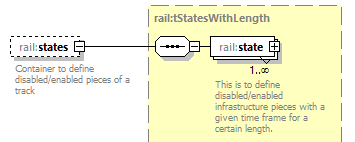 | ||||||
| namespace | https://www.railml.org/schemas/2021 | ||||||
| type | rail:tStatesWithLength | ||||||
| properties |
| ||||||
| children | rail:state | ||||||
| annotation |
| ||||||
| source | <xs:element name="states" type="rail:tStatesWithLength" minOccurs="0"> <xs:annotation> <xs:documentation>Container to define disabled/enabled pieces of a track</xs:documentation> <xs:documentation>See https://wiki2.railml.org/wiki/IS:states_(with_length)</xs:documentation> </xs:annotation> </xs:element> |
complexType tTrackCircuitBorder
| diagram |  | ||||||||||||||||||||||||||||||||||||||||||||||||||||||||||||||||||||||||||||||||||||||||||||||||||||
| namespace | https://www.railml.org/schemas/2021 | ||||||||||||||||||||||||||||||||||||||||||||||||||||||||||||||||||||||||||||||||||||||||||||||||||||
| type | extension of rail:tDelimitedOrientedElementDeprecated | ||||||||||||||||||||||||||||||||||||||||||||||||||||||||||||||||||||||||||||||||||||||||||||||||||||
| properties |
| ||||||||||||||||||||||||||||||||||||||||||||||||||||||||||||||||||||||||||||||||||||||||||||||||||||
| children | rail:additionalName rail:geoCoord rail:states | ||||||||||||||||||||||||||||||||||||||||||||||||||||||||||||||||||||||||||||||||||||||||||||||||||||
| used by |
| ||||||||||||||||||||||||||||||||||||||||||||||||||||||||||||||||||||||||||||||||||||||||||||||||||||
| attributes |
| ||||||||||||||||||||||||||||||||||||||||||||||||||||||||||||||||||||||||||||||||||||||||||||||||||||
| source | <xs:complexType name="tTrackCircuitBorder"> <xs:complexContent> <xs:extension base="rail:tDelimitedOrientedElementDeprecated"> <xs:attribute name="insulatedRail" type="rail:tInsulatedRailSide"/> <xs:attributeGroup ref="rail:aOcpRef"/> </xs:extension> </xs:complexContent> </xs:complexType> |
attribute tTrackCircuitBorder/@insulatedRail
| type | rail:tInsulatedRailSide | |||||||||||||||
| facets |
| |||||||||||||||
| source | <xs:attribute name="insulatedRail" type="rail:tInsulatedRailSide"/> |
complexType tTrackCondition
| diagram |  | ||||||||||||||||||||||||||||||||||||||||||||||||||||||||||||||||||||||||||||||||||||||||||
| namespace | https://www.railml.org/schemas/2021 | ||||||||||||||||||||||||||||||||||||||||||||||||||||||||||||||||||||||||||||||||||||||||||
| type | extension of rail:tDelimitedOrientedElement | ||||||||||||||||||||||||||||||||||||||||||||||||||||||||||||||||||||||||||||||||||||||||||
| properties |
| ||||||||||||||||||||||||||||||||||||||||||||||||||||||||||||||||||||||||||||||||||||||||||
| children | rail:additionalName rail:geoCoord rail:states | ||||||||||||||||||||||||||||||||||||||||||||||||||||||||||||||||||||||||||||||||||||||||||
| used by |
| ||||||||||||||||||||||||||||||||||||||||||||||||||||||||||||||||||||||||||||||||||||||||||
| attributes |
| ||||||||||||||||||||||||||||||||||||||||||||||||||||||||||||||||||||||||||||||||||||||||||
| source | <xs:complexType name="tTrackCondition"> <xs:complexContent> <xs:extension base="rail:tDelimitedOrientedElement"> <xs:attribute name="length" type="rail:tLengthM"/> <xs:attribute name="type" type="rail:tTrackConditionType"/> </xs:extension> </xs:complexContent> </xs:complexType> |
attribute tTrackCondition/@length
| type | rail:tLengthM | ||||||
| facets |
| ||||||
| source | <xs:attribute name="length" type="rail:tLengthM"/> |
attribute tTrackCondition/@type
| type | rail:tTrackConditionType |
| source | <xs:attribute name="type" type="rail:tTrackConditionType"/> |
complexType tTrackNode
| diagram | 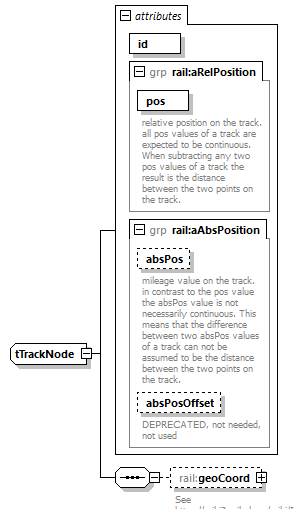 | ||||||||||||||||||||||||||||||||||||
| namespace | https://www.railml.org/schemas/2021 | ||||||||||||||||||||||||||||||||||||
| children | rail:geoCoord | ||||||||||||||||||||||||||||||||||||
| used by |
| ||||||||||||||||||||||||||||||||||||
| attributes |
| ||||||||||||||||||||||||||||||||||||
| source | <xs:complexType name="tTrackNode"> <xs:sequence> <xs:element name="geoCoord" type="rail:tGeoCoord" minOccurs="0"> <xs:annotation> <xs:documentation>See https://wiki2.railml.org/wiki/IS:geoCoord</xs:documentation> </xs:annotation> </xs:element> </xs:sequence> <xs:attribute name="id" type="rail:tGenericID" use="required"/> <xs:attributeGroup ref="rail:aRelPosition"/> <xs:attributeGroup ref="rail:aAbsPosition"/> </xs:complexType> |
attribute tTrackNode/@id
| type | rail:tGenericID | ||
| properties |
| ||
| source | <xs:attribute name="id" type="rail:tGenericID" use="required"/> |
element tTrackNode/geoCoord
| diagram | 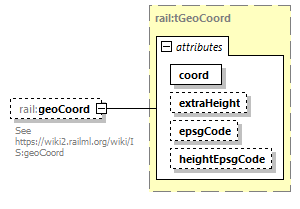 | ||||||||||||||||||||||||||||||
| namespace | https://www.railml.org/schemas/2021 | ||||||||||||||||||||||||||||||
| type | rail:tGeoCoord | ||||||||||||||||||||||||||||||
| properties |
| ||||||||||||||||||||||||||||||
| attributes |
| ||||||||||||||||||||||||||||||
| annotation |
| ||||||||||||||||||||||||||||||
| source | <xs:element name="geoCoord" type="rail:tGeoCoord" minOccurs="0"> <xs:annotation> <xs:documentation>See https://wiki2.railml.org/wiki/IS:geoCoord</xs:documentation> </xs:annotation> </xs:element> |
complexType tTrackRefInGroup
| diagram |  | ||||||||||||||||||||
| namespace | https://www.railml.org/schemas/2021 | ||||||||||||||||||||
| type | extension of rail:tElementRefInGroup | ||||||||||||||||||||
| properties |
| ||||||||||||||||||||
| used by |
| ||||||||||||||||||||
| attributes |
| ||||||||||||||||||||
| source | <xs:complexType name="tTrackRefInGroup"> <xs:complexContent> <xs:extension base="rail:tElementRefInGroup"/> <!-- Possible trackGroup-specific attributes to be added here later --> </xs:complexContent> </xs:complexType> |
complexType tTrackVacancyDetectionArea
| diagram |  | ||||||||||||||
| namespace | https://www.railml.org/schemas/2021 | ||||||||||||||
| type | extension of rail:tElementWithReference | ||||||||||||||
| properties |
| ||||||||||||||
| used by |
| ||||||||||||||
| attributes |
| ||||||||||||||
| source | <xs:complexType name="tTrackVacancyDetectionArea"> <xs:complexContent> <xs:extension base="rail:tElementWithReference"/> <!-- Possible track vacancy detection area specific attributes to be added here later --> </xs:complexContent> </xs:complexType> |
complexType tTrainDetector
| diagram |  | ||||||||||||||||||||||||||||||||||||||||||||||||||||||||||||||||||||||||||||||||||||||||||||||||||||||||||||||||||||||||||||||||||||||||||
| namespace | https://www.railml.org/schemas/2021 | ||||||||||||||||||||||||||||||||||||||||||||||||||||||||||||||||||||||||||||||||||||||||||||||||||||||||||||||||||||||||||||||||||||||||||
| type | extension of rail:tDelimitedOrientedElement | ||||||||||||||||||||||||||||||||||||||||||||||||||||||||||||||||||||||||||||||||||||||||||||||||||||||||||||||||||||||||||||||||||||||||||
| properties |
| ||||||||||||||||||||||||||||||||||||||||||||||||||||||||||||||||||||||||||||||||||||||||||||||||||||||||||||||||||||||||||||||||||||||||||
| children | rail:additionalName rail:geoCoord rail:states | ||||||||||||||||||||||||||||||||||||||||||||||||||||||||||||||||||||||||||||||||||||||||||||||||||||||||||||||||||||||||||||||||||||||||||
| used by |
| ||||||||||||||||||||||||||||||||||||||||||||||||||||||||||||||||||||||||||||||||||||||||||||||||||||||||||||||||||||||||||||||||||||||||||
| attributes |
| ||||||||||||||||||||||||||||||||||||||||||||||||||||||||||||||||||||||||||||||||||||||||||||||||||||||||||||||||||||||||||||||||||||||||||
| source | <xs:complexType name="tTrainDetector"> <xs:complexContent> <xs:extension base="rail:tDelimitedOrientedElement"> <xs:attribute name="detectionObject" type="rail:tDetectionObject"/> <xs:attribute name="medium" type="rail:tDetectorMedium"/> <xs:attribute name="posInTrack" type="rail:tPosInTrack"/> <xs:attribute name="directionDetection" type="xs:boolean"/> <xs:attribute name="model" type="xs:string"/> <xs:attribute name="axleCounting" type="xs:boolean"/> <xs:attribute name="virtual" type="xs:boolean"> <xs:annotation> <xs:documentation>use this attribute to model a local dispatcher doing a visual train detection</xs:documentation> </xs:annotation> </xs:attribute> <xs:attributeGroup ref="rail:aOcpRef"/> </xs:extension> </xs:complexContent> </xs:complexType> |
attribute tTrainDetector/@detectionObject
| type | rail:tDetectionObject |
| source | <xs:attribute name="detectionObject" type="rail:tDetectionObject"/> |
attribute tTrainDetector/@medium
| type | rail:tDetectorMedium |
| source | <xs:attribute name="medium" type="rail:tDetectorMedium"/> |
attribute tTrainDetector/@posInTrack
| type | rail:tPosInTrack | |||||||||||||||||||||||||||||||||
| facets |
| |||||||||||||||||||||||||||||||||
| source | <xs:attribute name="posInTrack" type="rail:tPosInTrack"/> |
attribute tTrainDetector/@directionDetection
| type | xs:boolean |
| source | <xs:attribute name="directionDetection" type="xs:boolean"/> |
attribute tTrainDetector/@model
| type | xs:string |
| source | <xs:attribute name="model" type="xs:string"/> |
attribute tTrainDetector/@axleCounting
| type | xs:boolean |
| source | <xs:attribute name="axleCounting" type="xs:boolean"/> |
attribute tTrainDetector/@virtual
| type | xs:boolean | ||
| annotation |
| ||
| source | <xs:attribute name="virtual" type="xs:boolean"> <xs:annotation> <xs:documentation>use this attribute to model a local dispatcher doing a visual train detection</xs:documentation> </xs:annotation> </xs:attribute> |
complexType tTrainProtection
| diagram |  | ||||||||||||||||||||||||||||
| namespace | https://www.railml.org/schemas/2021 | ||||||||||||||||||||||||||||
| used by |
| ||||||||||||||||||||||||||||
| attributes |
| ||||||||||||||||||||||||||||
| source | <xs:complexType name="tTrainProtection"> <xs:attributeGroup ref="rail:aTrainProtection"/> </xs:complexType> |
complexType tTrainProtectionChange
| diagram |  | ||||||||||||||||||||||||||||||||||||||||||||||||||||||||||||||||||||||||||||||||||||||||||||||||||||
| namespace | https://www.railml.org/schemas/2021 | ||||||||||||||||||||||||||||||||||||||||||||||||||||||||||||||||||||||||||||||||||||||||||||||||||||
| type | extension of rail:tStrictOrientedElement | ||||||||||||||||||||||||||||||||||||||||||||||||||||||||||||||||||||||||||||||||||||||||||||||||||||
| properties |
| ||||||||||||||||||||||||||||||||||||||||||||||||||||||||||||||||||||||||||||||||||||||||||||||||||||
| children | rail:additionalName rail:geoCoord rail:states | ||||||||||||||||||||||||||||||||||||||||||||||||||||||||||||||||||||||||||||||||||||||||||||||||||||
| used by |
| ||||||||||||||||||||||||||||||||||||||||||||||||||||||||||||||||||||||||||||||||||||||||||||||||||||
| attributes |
| ||||||||||||||||||||||||||||||||||||||||||||||||||||||||||||||||||||||||||||||||||||||||||||||||||||
| source | <xs:complexType name="tTrainProtectionChange"> <xs:complexContent> <xs:extension base="rail:tStrictOrientedElement"> <xs:attributeGroup ref="rail:aTrainProtection"/> </xs:extension> </xs:complexContent> </xs:complexType> |
complexType tTrainProtectionElement
| diagram |  | ||||||||||||||||||||||||||||||||||||||||||||||||||||||||||||||||||||||||||||||||||||||||||||||||||||||||||||||||||
| namespace | https://www.railml.org/schemas/2021 | ||||||||||||||||||||||||||||||||||||||||||||||||||||||||||||||||||||||||||||||||||||||||||||||||||||||||||||||||||
| type | extension of rail:tOrientedElement | ||||||||||||||||||||||||||||||||||||||||||||||||||||||||||||||||||||||||||||||||||||||||||||||||||||||||||||||||||
| properties |
| ||||||||||||||||||||||||||||||||||||||||||||||||||||||||||||||||||||||||||||||||||||||||||||||||||||||||||||||||||
| children | rail:additionalName rail:geoCoord rail:states | ||||||||||||||||||||||||||||||||||||||||||||||||||||||||||||||||||||||||||||||||||||||||||||||||||||||||||||||||||
| used by |
| ||||||||||||||||||||||||||||||||||||||||||||||||||||||||||||||||||||||||||||||||||||||||||||||||||||||||||||||||||
| attributes |
| ||||||||||||||||||||||||||||||||||||||||||||||||||||||||||||||||||||||||||||||||||||||||||||||||||||||||||||||||||
| source | <xs:complexType name="tTrainProtectionElement"> <xs:complexContent> <xs:extension base="rail:tOrientedElement"> <xs:attributeGroup ref="rail:aTrainProtection"/> <xs:attribute name="system" type="xs:string"> <xs:annotation> <xs:documentation>DEPRECATED: use the enumeration parameter trainProtectionSystem instead</xs:documentation> </xs:annotation> </xs:attribute> <xs:attribute name="model" type="xs:string"/> </xs:extension> </xs:complexContent> </xs:complexType> |
attribute tTrainProtectionElement/@system
| type | xs:string | ||
| annotation |
| ||
| source | <xs:attribute name="system" type="xs:string"> <xs:annotation> <xs:documentation>DEPRECATED: use the enumeration parameter trainProtectionSystem instead</xs:documentation> </xs:annotation> </xs:attribute> |
attribute tTrainProtectionElement/@model
| type | xs:string |
| source | <xs:attribute name="model" type="xs:string"/> |
complexType tTrainProtectionElementGroup
| diagram | 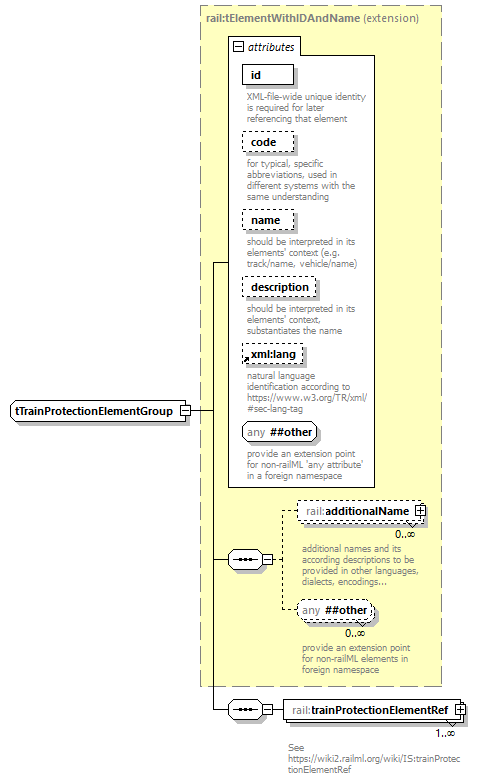 | ||||||||||||||||||||||||||||||||||||||||||||||
| namespace | https://www.railml.org/schemas/2021 | ||||||||||||||||||||||||||||||||||||||||||||||
| type | extension of rail:tElementWithIDAndName | ||||||||||||||||||||||||||||||||||||||||||||||
| properties |
| ||||||||||||||||||||||||||||||||||||||||||||||
| children | rail:additionalName rail:trainProtectionElementRef | ||||||||||||||||||||||||||||||||||||||||||||||
| used by |
| ||||||||||||||||||||||||||||||||||||||||||||||
| attributes |
| ||||||||||||||||||||||||||||||||||||||||||||||
| source | <xs:complexType name="tTrainProtectionElementGroup"> <xs:complexContent> <xs:extension base="rail:tElementWithIDAndName"> <xs:sequence> <xs:element name="trainProtectionElementRef" type="rail:tElementWithReference" maxOccurs="unbounded"> <xs:annotation> <xs:documentation>See https://wiki2.railml.org/wiki/IS:trainProtectionElementRef</xs:documentation> </xs:annotation> </xs:element> </xs:sequence> </xs:extension> </xs:complexContent> </xs:complexType> |
element tTrainProtectionElementGroup/trainProtectionElementRef
| diagram |  | ||||||||||||||
| namespace | https://www.railml.org/schemas/2021 | ||||||||||||||
| type | rail:tElementWithReference | ||||||||||||||
| properties |
| ||||||||||||||
| attributes |
| ||||||||||||||
| annotation |
| ||||||||||||||
| source | <xs:element name="trainProtectionElementRef" type="rail:tElementWithReference" maxOccurs="unbounded"> <xs:annotation> <xs:documentation>See https://wiki2.railml.org/wiki/IS:trainProtectionElementRef</xs:documentation> </xs:annotation> </xs:element> |
complexType tTrainRadioAttributes
| diagram |  | ||||||||||||||||||||||||||||||||||||||||||||||||||||||||||||||
| namespace | https://www.railml.org/schemas/2021 | ||||||||||||||||||||||||||||||||||||||||||||||||||||||||||||||
| used by |
| ||||||||||||||||||||||||||||||||||||||||||||||||||||||||||||||
| attributes |
| ||||||||||||||||||||||||||||||||||||||||||||||||||||||||||||||
| source | <xs:complexType name="tTrainRadioAttributes"> <xs:attributeGroup ref="rail:aTrainRadioInfrastructure"/> </xs:complexType> |
complexType tTrainRadioChange
| diagram |  | ||||||||||||||||||||||||||||||||||||||||||||||||||||||||||||||||||||||||||||||||||||||||||||||||||||||||||||||||||||||||||||||||||||||
| namespace | https://www.railml.org/schemas/2021 | ||||||||||||||||||||||||||||||||||||||||||||||||||||||||||||||||||||||||||||||||||||||||||||||||||||||||||||||||||||||||||||||||||||||
| type | extension of rail:tOrientedElement | ||||||||||||||||||||||||||||||||||||||||||||||||||||||||||||||||||||||||||||||||||||||||||||||||||||||||||||||||||||||||||||||||||||||
| properties |
| ||||||||||||||||||||||||||||||||||||||||||||||||||||||||||||||||||||||||||||||||||||||||||||||||||||||||||||||||||||||||||||||||||||||
| children | rail:additionalName rail:geoCoord rail:states | ||||||||||||||||||||||||||||||||||||||||||||||||||||||||||||||||||||||||||||||||||||||||||||||||||||||||||||||||||||||||||||||||||||||
| used by |
| ||||||||||||||||||||||||||||||||||||||||||||||||||||||||||||||||||||||||||||||||||||||||||||||||||||||||||||||||||||||||||||||||||||||
| attributes |
| ||||||||||||||||||||||||||||||||||||||||||||||||||||||||||||||||||||||||||||||||||||||||||||||||||||||||||||||||||||||||||||||||||||||
| source | <xs:complexType name="tTrainRadioChange"> <xs:complexContent> <xs:extension base="rail:tOrientedElement"> <xs:attributeGroup ref="rail:aTrainRadioInfrastructure"/> <xs:attributeGroup ref="rail:anyAttribute"> <xs:annotation> <xs:documentation>provide an extension point for non-railML attributes in foreign namespace</xs:documentation> </xs:annotation> </xs:attributeGroup> </xs:extension> </xs:complexContent> </xs:complexType> |
complexType tTunnel
| diagram |  | ||||||||||||||||||||||||||||||||||||||||||||||||||||||||||||||||||||||||||||||||||||||||||||||||||||||||||||||||||||||||||||
| namespace | https://www.railml.org/schemas/2021 | ||||||||||||||||||||||||||||||||||||||||||||||||||||||||||||||||||||||||||||||||||||||||||||||||||||||||||||||||||||||||||||
| type | extension of rail:tDelimitedOrientedElementWithLengthDeprecated | ||||||||||||||||||||||||||||||||||||||||||||||||||||||||||||||||||||||||||||||||||||||||||||||||||||||||||||||||||||||||||||
| properties |
| ||||||||||||||||||||||||||||||||||||||||||||||||||||||||||||||||||||||||||||||||||||||||||||||||||||||||||||||||||||||||||||
| children | rail:additionalName rail:geoCoord rail:states | ||||||||||||||||||||||||||||||||||||||||||||||||||||||||||||||||||||||||||||||||||||||||||||||||||||||||||||||||||||||||||||
| used by |
| ||||||||||||||||||||||||||||||||||||||||||||||||||||||||||||||||||||||||||||||||||||||||||||||||||||||||||||||||||||||||||||
| attributes |
| ||||||||||||||||||||||||||||||||||||||||||||||||||||||||||||||||||||||||||||||||||||||||||||||||||||||||||||||||||||||||||||
| source | <xs:complexType name="tTunnel"> <xs:complexContent> <xs:extension base="rail:tDelimitedOrientedElementWithLengthDeprecated"> <xs:attribute name="crossSection" type="rail:tLengthM"> <xs:annotation> <xs:documentation>The area of the tunnel cross section in square meters.</xs:documentation> <xs:documentation>Attention: currently the units given for crossSection in railML is given in metres (tLengthM), but to be understood and used as square metres. This issue will be fixed in a future railML version.</xs:documentation> </xs:annotation> </xs:attribute> <xs:attribute name="kind" type="rail:tTunnelType"> <xs:annotation> <xs:documentation>specify whether the tunnel is made from bricks, concrete, etc.</xs:documentation> </xs:annotation> </xs:attribute> <xs:attribute name="resistanceFactorPassenger" type="xs:double"> <xs:annotation> <xs:documentation>the tunnel resistance factor in kg/m for passenger trains</xs:documentation> <xs:documentation>Define this value only if @kind and @crossSection are not known.</xs:documentation> </xs:annotation> </xs:attribute> <xs:attribute name="resistanceFactorFreight" type="xs:double"> <xs:annotation> <xs:documentation>the tunnel resistance factor in kg/m for freight trains</xs:documentation> <xs:documentation>Define this value only if @kind and @crossSection are not known.</xs:documentation> </xs:annotation> </xs:attribute> </xs:extension> </xs:complexContent> </xs:complexType> |
attribute tTunnel/@crossSection
| type | rail:tLengthM | ||||||
| facets |
| ||||||
| annotation |
| ||||||
| source | <xs:attribute name="crossSection" type="rail:tLengthM"> <xs:annotation> <xs:documentation>The area of the tunnel cross section in square meters.</xs:documentation> <xs:documentation>Attention: currently the units given for crossSection in railML is given in metres (tLengthM), but to be understood and used as square metres. This issue will be fixed in a future railML version.</xs:documentation> </xs:annotation> </xs:attribute> |
attribute tTunnel/@kind
| type | rail:tTunnelType | ||
| annotation |
| ||
| source | <xs:attribute name="kind" type="rail:tTunnelType"> <xs:annotation> <xs:documentation>specify whether the tunnel is made from bricks, concrete, etc.</xs:documentation> </xs:annotation> </xs:attribute> |
attribute tTunnel/@resistanceFactorPassenger
| type | xs:double | ||||
| annotation |
| ||||
| source | <xs:attribute name="resistanceFactorPassenger" type="xs:double"> <xs:annotation> <xs:documentation>the tunnel resistance factor in kg/m for passenger trains</xs:documentation> <xs:documentation>Define this value only if @kind and @crossSection are not known.</xs:documentation> </xs:annotation> </xs:attribute> |
attribute tTunnel/@resistanceFactorFreight
| type | xs:double | ||||
| annotation |
| ||||
| source | <xs:attribute name="resistanceFactorFreight" type="xs:double"> <xs:annotation> <xs:documentation>the tunnel resistance factor in kg/m for freight trains</xs:documentation> <xs:documentation>Define this value only if @kind and @crossSection are not known.</xs:documentation> </xs:annotation> </xs:attribute> |
complexType tValidForMovements
| diagram |  | ||||||||||||||
| namespace | https://www.railml.org/schemas/2021 | ||||||||||||||
| used by |
| ||||||||||||||
| attributes |
| ||||||||||||||
| source | <xs:complexType name="tValidForMovements"> <xs:attribute name="kind" type="rail:tTrainMovements"> <xs:annotation> <xs:documentation>specification of the train types</xs:documentation> </xs:annotation> </xs:attribute> </xs:complexType> |
attribute tValidForMovements/@kind
| type | rail:tTrainMovements | ||
| annotation |
| ||
| source | <xs:attribute name="kind" type="rail:tTrainMovements"> <xs:annotation> <xs:documentation>specification of the train types</xs:documentation> </xs:annotation> </xs:attribute> |
complexType tWorkZone
| diagram |  | ||||||||||||||
| namespace | https://www.railml.org/schemas/2021 | ||||||||||||||
| type | extension of rail:tElementWithReference | ||||||||||||||
| properties |
| ||||||||||||||
| used by |
| ||||||||||||||
| attributes |
| ||||||||||||||
| source | <xs:complexType name="tWorkZone"> <xs:complexContent> <xs:extension base="rail:tElementWithReference"/> <!-- Possible work zone specific attributes to be added here later --> </xs:complexContent> </xs:complexType> |
simpleType tBaliseCountryID
| namespace | https://www.railml.org/schemas/2021 | |||||||||
| type | restriction of xs:integer | |||||||||
| properties |
| |||||||||
| used by |
| |||||||||
| facets |
| |||||||||
| source | <xs:simpleType name="tBaliseCountryID"> <xs:restriction base="xs:integer"> <xs:minInclusive value="0"/> <xs:maxInclusive value="1023"/> </xs:restriction> </xs:simpleType> |
simpleType tBaliseGroupID
| namespace | https://www.railml.org/schemas/2021 | |||||||||
| type | restriction of xs:integer | |||||||||
| properties |
| |||||||||
| used by |
| |||||||||
| facets |
| |||||||||
| source | <xs:simpleType name="tBaliseGroupID"> <xs:restriction base="xs:integer"> <xs:minInclusive value="0"/> <xs:maxInclusive value="16383"/> </xs:restriction> </xs:simpleType> |
simpleType tBaliseGroupType
| namespace | https://www.railml.org/schemas/2021 | ||
| type | union of (restriction of xs:string, rail:tOtherEnumerationValue) | ||
| used by |
| ||
| source | <xs:simpleType name="tBaliseGroupType"> <xs:union> <xs:simpleType> <xs:restriction base="xs:string"> <xs:enumeration value="infill"/> <xs:enumeration value="signal"/> <xs:enumeration value="fixed"/> </xs:restriction> </xs:simpleType> <xs:simpleType> <xs:restriction base="rail:tOtherEnumerationValue"/> </xs:simpleType> </xs:union> </xs:simpleType> |
simpleType tBaliseLinkingAcc
| namespace | https://www.railml.org/schemas/2021 | |||||||||
| type | restriction of xs:integer | |||||||||
| properties |
| |||||||||
| used by |
| |||||||||
| facets |
| |||||||||
| source | <xs:simpleType name="tBaliseLinkingAcc"> <xs:restriction base="xs:integer"> <xs:minInclusive value="-63"/> <xs:maxInclusive value="63"/> </xs:restriction> </xs:simpleType> |
simpleType tBaliseLinkReaction
| namespace | https://www.railml.org/schemas/2021 | ||||||||||||
| type | restriction of xs:string | ||||||||||||
| properties |
| ||||||||||||
| used by |
| ||||||||||||
| facets |
| ||||||||||||
| source | <xs:simpleType name="tBaliseLinkReaction"> <xs:restriction base="xs:string"> <xs:enumeration value="trainTrip"/> <xs:enumeration value="applyServiceBrake"/> <xs:enumeration value="noReaction"/> </xs:restriction> </xs:simpleType> |
simpleType tBaliseType
| namespace | https://www.railml.org/schemas/2021 | |||||||||
| type | restriction of xs:string | |||||||||
| properties |
| |||||||||
| used by |
| |||||||||
| facets |
| |||||||||
| source | <xs:simpleType name="tBaliseType"> <xs:restriction base="xs:string"> <xs:enumeration value="fixed"/> <xs:enumeration value="controlled"/> </xs:restriction> </xs:simpleType> |
simpleType tBorderType
| namespace | https://www.railml.org/schemas/2021 | ||
| type | union of (restriction of xs:string, rail:tOtherEnumerationValue) | ||
| used by |
| ||
| source | <xs:simpleType name="tBorderType"> <xs:union> <xs:simpleType> <xs:restriction base="xs:string"> <xs:enumeration value="tarif"/> <xs:enumeration value="area"/> <xs:enumeration value="state"/> <xs:enumeration value="country"/> <xs:enumeration value="station"/> <xs:enumeration value="project"/> </xs:restriction> </xs:simpleType> <xs:simpleType> <xs:restriction base="rail:tOtherEnumerationValue"/> </xs:simpleType> </xs:union> </xs:simpleType> |
simpleType tClearanceManaging
| namespace | https://www.railml.org/schemas/2021 | ||
| type | union of (restriction of xs:string, rail:tOtherEnumerationValue) | ||
| used by |
| ||
| source | <xs:simpleType name="tClearanceManaging"> <xs:union> <xs:simpleType> <xs:restriction base="xs:string"> <xs:enumeration value="sight"/> <xs:enumeration value="time"/> <xs:enumeration value="blocking"/> <xs:enumeration value="LZB-blocking"/> <xs:enumeration value="absBrakeDist"/> </xs:restriction> </xs:simpleType> <xs:simpleType> <xs:restriction base="rail:tOtherEnumerationValue"/> </xs:simpleType> </xs:union> </xs:simpleType> |
simpleType tConnectionOrientation
| namespace | https://www.railml.org/schemas/2021 | ||
| type | union of (restriction of xs:string, rail:tOtherEnumerationValue) | ||
| used by |
| ||
| source | <xs:simpleType name="tConnectionOrientation"> <xs:union> <xs:simpleType> <xs:restriction base="xs:string"> <xs:enumeration value="incoming"/> <xs:enumeration value="outgoing"/> <xs:enumeration value="rightAngled"/> <xs:enumeration value="unknown"/> </xs:restriction> </xs:simpleType> <xs:simpleType> <xs:restriction base="rail:tOtherEnumerationValue"/> </xs:simpleType> </xs:union> </xs:simpleType> |
simpleType tControllerTechnologyType
| namespace | https://www.railml.org/schemas/2021 | ||||||||||||||||||
| type | restriction of xs:string | ||||||||||||||||||
| properties |
| ||||||||||||||||||
| used by |
| ||||||||||||||||||
| facets |
| ||||||||||||||||||
| source | <xs:simpleType name="tControllerTechnologyType"> <xs:restriction base="xs:string"> <xs:enumeration value="manual"/> <xs:enumeration value="mechanical"/> <xs:enumeration value="electro-mechanical"/> <xs:enumeration value="electrical"/> <xs:enumeration value="electronic"/> </xs:restriction> </xs:simpleType> |
simpleType tControllerType
| namespace | https://www.railml.org/schemas/2021 | ||
| type | union of (restriction of xs:string, rail:tOtherEnumerationValue) | ||
| used by |
| ||
| source | <xs:simpleType name="tControllerType"> <xs:union> <xs:simpleType> <xs:restriction base="xs:string"> <xs:enumeration value="none"/> <xs:enumeration value="singleElement"/> <xs:enumeration value="local"/> <xs:enumeration value="regional"/> <xs:enumeration value="crossRegional"/> </xs:restriction> </xs:simpleType> <xs:simpleType> <xs:restriction base="rail:tOtherEnumerationValue"/> </xs:simpleType> </xs:union> </xs:simpleType> |
simpleType tCourse
| namespace | https://www.railml.org/schemas/2021 | ||
| type | union of (restriction of xs:string, rail:tOtherEnumerationValue) | ||
| used by |
| ||
| source | <xs:simpleType name="tCourse"> <xs:union> <xs:simpleType> <xs:restriction base="xs:string"> <xs:enumeration value="straight"/> <xs:enumeration value="left"/> <xs:enumeration value="right"/> </xs:restriction> </xs:simpleType> <xs:simpleType> <xs:restriction base="rail:tOtherEnumerationValue"/> </xs:simpleType> </xs:union> </xs:simpleType> |
simpleType tCrossedElementType
| namespace | https://www.railml.org/schemas/2021 | ||
| type | union of (restriction of xs:string, rail:tOtherEnumerationValue) | ||
| used by |
| ||
| source | <xs:simpleType name="tCrossedElementType"> <xs:union> <xs:simpleType> <xs:restriction base="xs:string"> <xs:enumeration value="highway:cycleway"> <xs:annotation> <xs:documentation>See https://wiki.openstreetmap.org/wiki/Tag:highway%3Dcycleway</xs:documentation> </xs:annotation> </xs:enumeration> <xs:enumeration value="highway:footway"> <xs:annotation> <xs:documentation>See https://wiki.openstreetmap.org/wiki/Tag:highway%3Dfootway</xs:documentation> </xs:annotation> </xs:enumeration> <xs:enumeration value="highway:motorway"> <xs:annotation> <xs:documentation>See https://wiki.openstreetmap.org/wiki/Tag:highway%3Dmotorway</xs:documentation> </xs:annotation> </xs:enumeration> <xs:enumeration value="highway:road"> <xs:annotation> <xs:documentation>See https://wiki.openstreetmap.org/wiki/Tag:highway%3Droad</xs:documentation> </xs:annotation> </xs:enumeration> <xs:enumeration value="natural:peak"> <xs:annotation> <xs:documentation>See https://wiki.openstreetmap.org/wiki/Tag:natural%3Dpeak</xs:documentation> </xs:annotation> </xs:enumeration> <xs:enumeration value="natural:ridge"> <xs:annotation> <xs:documentation>See https://wiki.openstreetmap.org/wiki/Tag:natural%3Dridge</xs:documentation> </xs:annotation> </xs:enumeration> <xs:enumeration value="natural:valley"> <xs:annotation> <xs:documentation>See https://wiki.openstreetmap.org/wiki/Tag:natural%3Dvalley</xs:documentation> </xs:annotation> </xs:enumeration> <xs:enumeration value="natural:water"> <xs:annotation> <xs:documentation>See https://wiki.openstreetmap.org/wiki/Tag:natural%3Dwater</xs:documentation> </xs:annotation> </xs:enumeration> <xs:enumeration value="waterway:river"> <xs:annotation> <xs:documentation>See https://wiki.openstreetmap.org/wiki/Tag:waterway%3Driver</xs:documentation> </xs:annotation> </xs:enumeration> </xs:restriction> </xs:simpleType> <xs:simpleType> <xs:restriction base="rail:tOtherEnumerationValue"/> </xs:simpleType> </xs:union> </xs:simpleType> |
simpleType tCrossingType
| namespace | https://www.railml.org/schemas/2021 | ||
| type | union of (restriction of xs:string, rail:tOtherEnumerationValue) | ||
| used by |
| ||
| source | <xs:simpleType name="tCrossingType"> <xs:union> <xs:simpleType> <xs:restriction base="xs:string"> <xs:enumeration value="simpleCrossing"/> <xs:enumeration value="simpleSwitchCrossing"/> <xs:enumeration value="doubleSwitchCrossing"/> </xs:restriction> </xs:simpleType> <xs:simpleType> <xs:restriction base="rail:tOtherEnumerationValue"/> </xs:simpleType> </xs:union> </xs:simpleType> |
simpleType tCrossSectionBlockType
| namespace | https://www.railml.org/schemas/2021 | ||
| type | union of (restriction of xs:string, rail:tOtherEnumerationValue) | ||
| used by |
| ||
| source | <xs:simpleType name="tCrossSectionBlockType"> <xs:union> <xs:simpleType> <xs:restriction base="xs:string"> <xs:enumeration value="station"/> <xs:enumeration value="block"/> <xs:enumeration value="autoblock"/> </xs:restriction> </xs:simpleType> <xs:simpleType> <xs:restriction base="rail:tOtherEnumerationValue"/> </xs:simpleType> </xs:union> </xs:simpleType> |
simpleType tDerailKind
| namespace | https://www.railml.org/schemas/2021 | ||||||||||||||||||
| type | restriction of xs:string | ||||||||||||||||||
| properties |
| ||||||||||||||||||
| used by |
| ||||||||||||||||||
| facets |
| ||||||||||||||||||
| source | <xs:simpleType name="tDerailKind"> <xs:restriction base="xs:string"> <xs:enumeration value="blockDerail"> <xs:annotation> <xs:documentation>see book "Railway Signalling and Interlocking", p. 155</xs:documentation> </xs:annotation> </xs:enumeration> <xs:enumeration value="singleCatchPoints"> <xs:annotation> <xs:documentation>see book "Railway Signalling and Interlocking", p. 155</xs:documentation> </xs:annotation> </xs:enumeration> <xs:enumeration value="doubleCatchPoints"> <xs:annotation> <xs:documentation>see book "Railway Signalling and Interlocking", p. 155</xs:documentation> </xs:annotation> </xs:enumeration> </xs:restriction> </xs:simpleType> |
simpleType tDetectionObject
| namespace | https://www.railml.org/schemas/2021 | ||
| type | union of (restriction of xs:string, rail:tOtherEnumerationValue) | ||
| used by |
| ||
| source | <xs:simpleType name="tDetectionObject"> <xs:union> <xs:simpleType> <xs:restriction base="xs:string"> <xs:enumeration value="wheel"/> <xs:enumeration value="axle"/> <xs:enumeration value="train"/> <xs:enumeration value="endOfTrain"/> <xs:enumeration value="obstacle"/> </xs:restriction> </xs:simpleType> <xs:simpleType> <xs:restriction base="rail:tOtherEnumerationValue"/> </xs:simpleType> </xs:union> </xs:simpleType> |
simpleType tDetectorMedium
| namespace | https://www.railml.org/schemas/2021 | ||
| type | union of (restriction of xs:string, rail:tOtherEnumerationValue) | ||
| used by |
| ||
| source | <xs:simpleType name="tDetectorMedium"> <xs:union> <xs:simpleType> <xs:restriction base="xs:string"> <xs:enumeration value="mechanical"/> <xs:enumeration value="hydraulic"/> <xs:enumeration value="pneumatic"/> <xs:enumeration value="magnetic"/> <xs:enumeration value="inductive"/> <xs:enumeration value="optical"/> <xs:enumeration value="radio"/> <xs:enumeration value="manual"> <xs:annotation> <xs:documentation>used for local dispatchers manual observation</xs:documentation> </xs:annotation> </xs:enumeration> </xs:restriction> </xs:simpleType> <xs:simpleType> <xs:restriction base="rail:tOtherEnumerationValue"/> </xs:simpleType> </xs:union> </xs:simpleType> |
simpleType tElectrificationType
| namespace | https://www.railml.org/schemas/2021 | ||
| type | union of (restriction of xs:string, rail:tOtherEnumerationValue) | ||
| used by |
| ||
| source | <xs:simpleType name="tElectrificationType"> <xs:union> <xs:simpleType> <xs:restriction base="xs:string"> <xs:enumeration value="none"/> <xs:enumeration value="overhead"/> <xs:enumeration value="3rdRail"/> <xs:enumeration value="sideRail"/> </xs:restriction> </xs:simpleType> <xs:simpleType> <xs:restriction base="rail:tOtherEnumerationValue"/> </xs:simpleType> </xs:union> </xs:simpleType> |
simpleType tHorizontalCurveType
| namespace | https://www.railml.org/schemas/2021 | ||
| type | union of (restriction of xs:string, rail:tOtherEnumerationValue) | ||
| used by |
| ||
| source | <xs:simpleType name="tHorizontalCurveType"> <xs:union> <xs:simpleType> <xs:restriction base="xs:string"> <xs:enumeration value="TS_cubicParabola"> <xs:annotation> <xs:documentation>begin of transition curve of type cubic parabola</xs:documentation> </xs:annotation> </xs:enumeration> <xs:enumeration value="TS_parabola4"> <xs:annotation> <xs:documentation>begin of transition curve of type 4th degree parabola</xs:documentation> </xs:annotation> </xs:enumeration> <xs:enumeration value="TS_clothoide"> <xs:annotation> <xs:documentation>begin of transition curve of type clothoide</xs:documentation> </xs:annotation> </xs:enumeration> <xs:enumeration value="TS_WienerBogen"> <xs:annotation> <xs:documentation>begin of transition curve of type Wiener Bogen</xs:documentation> </xs:annotation> </xs:enumeration> <xs:enumeration value="TS_BlossBogen"> <xs:annotation> <xs:documentation>begin of transition curve of type Bloss Bogen</xs:documentation> </xs:annotation> </xs:enumeration> <xs:enumeration value="TS_Sinusoide"> <xs:annotation> <xs:documentation>begin of transition curve of type Sinusoide</xs:documentation> </xs:annotation> </xs:enumeration> <xs:enumeration value="TS_Cosinusoide"> <xs:annotation> <xs:documentation>begin of transition curve of type Cosinusoide</xs:documentation> </xs:annotation> </xs:enumeration> <xs:enumeration value="SC"> <xs:annotation> <xs:documentation>end of transition curve (spiral - curve)</xs:documentation> </xs:annotation> </xs:enumeration> </xs:restriction> </xs:simpleType> <xs:simpleType> <xs:restriction base="rail:tOtherEnumerationValue"/> </xs:simpleType> </xs:union> </xs:simpleType> |
simpleType tInfluence
| namespace | https://www.railml.org/schemas/2021 | ||
| type | union of (restriction of xs:string, rail:tOtherEnumerationValue) | ||
| used by |
| ||
| source | <xs:simpleType name="tInfluence"> <xs:union> <xs:simpleType> <xs:restriction base="xs:string"> <xs:enumeration value="increasing"/> <xs:enumeration value="decreasing"/> </xs:restriction> </xs:simpleType> <xs:simpleType> <xs:restriction base="rail:tOtherEnumerationValue"/> </xs:simpleType> </xs:union> </xs:simpleType> |
simpleType tInsulatedRailSide
| namespace | https://www.railml.org/schemas/2021 | |||||||||||||||
| type | restriction of xs:string | |||||||||||||||
| properties |
| |||||||||||||||
| used by |
| |||||||||||||||
| facets |
| |||||||||||||||
| source | <xs:simpleType name="tInsulatedRailSide"> <xs:restriction base="xs:string"> <xs:enumeration value="none"/> <xs:enumeration value="left"/> <xs:enumeration value="right"/> <xs:enumeration value="both"/> </xs:restriction> </xs:simpleType> |
simpleType tLevelCrossingSignalType
| namespace | https://www.railml.org/schemas/2021 | ||
| type | union of (restriction of xs:string, rail:tOtherEnumerationValue) | ||
| used by |
| ||
| source | <xs:simpleType name="tLevelCrossingSignalType"> <xs:union> <xs:simpleType> <xs:restriction base="xs:string"> <xs:enumeration value="bell"> <xs:annotation> <xs:documentation>signal for train driver to ring the locomotive's bell</xs:documentation> </xs:annotation> </xs:enumeration> <xs:enumeration value="whistle"> <xs:annotation> <xs:documentation>signal for train driver to blow the locomotive's whistle</xs:documentation> </xs:annotation> </xs:enumeration> <xs:enumeration value="announcing"> <xs:annotation> <xs:documentation>signal announcing the upcoming level crossing ("distant signal" for level crossing)</xs:documentation> </xs:annotation> </xs:enumeration> <xs:enumeration value="activating"> <xs:annotation> <xs:documentation>signal that marks the position where the train detector for activating the level crossing is situated</xs:documentation> </xs:annotation> </xs:enumeration> <xs:enumeration value="supervision"> <xs:annotation> <xs:documentation>signal supervising the level crossing</xs:documentation> </xs:annotation> </xs:enumeration> </xs:restriction> </xs:simpleType> <xs:simpleType> <xs:restriction base="rail:tOtherEnumerationValue"/> </xs:simpleType> </xs:union> </xs:simpleType> |
simpleType tLineType
| namespace | https://www.railml.org/schemas/2021 | ||
| type | union of (restriction of xs:string, rail:tOtherEnumerationValue) | ||
| used by |
| ||
| source | <xs:simpleType name="tLineType"> <xs:union> <xs:simpleType> <xs:restriction base="xs:string"> <xs:enumeration value="mainLine"/> <xs:enumeration value="secondaryLine"/> <xs:enumeration value="branchLine"/> </xs:restriction> </xs:simpleType> <xs:simpleType> <xs:restriction base="rail:tOtherEnumerationValue"/> </xs:simpleType> </xs:union> </xs:simpleType> |
simpleType tMaxTrainCurrentType
| namespace | https://www.railml.org/schemas/2021 | |||||||||
| type | restriction of xs:string | |||||||||
| properties |
| |||||||||
| used by |
| |||||||||
| facets |
| |||||||||
| source | <xs:simpleType name="tMaxTrainCurrentType"> <xs:restriction base="xs:string"> <xs:enumeration value="driving"/> <xs:enumeration value="standstill"/> </xs:restriction> </xs:simpleType> |
simpleType tMaxTrainCurrentValidFor
| namespace | https://www.railml.org/schemas/2021 | |||||||||
| type | restriction of xs:string | |||||||||
| properties |
| |||||||||
| used by |
| |||||||||
| facets |
| |||||||||
| source | <xs:simpleType name="tMaxTrainCurrentValidFor"> <xs:restriction base="xs:string"> <xs:enumeration value="train"/> <xs:enumeration value="pantograph"/> </xs:restriction> </xs:simpleType> |
simpleType tMileageChangeDescr
| namespace | https://www.railml.org/schemas/2021 | |||||||||
| type | restriction of xs:string | |||||||||
| properties |
| |||||||||
| used by |
| |||||||||
| facets |
| |||||||||
| source | <xs:simpleType name="tMileageChangeDescr"> <xs:restriction base="xs:string"> <xs:enumeration value="overlapping"/> <xs:enumeration value="missing"/> </xs:restriction> </xs:simpleType> |
simpleType tOcpCenterSide
| namespace | https://www.railml.org/schemas/2021 | ||||||||||||||||||||||||
| type | restriction of xs:string | ||||||||||||||||||||||||
| properties |
| ||||||||||||||||||||||||
| used by |
| ||||||||||||||||||||||||
| facets |
| ||||||||||||||||||||||||
| source | <xs:simpleType name="tOcpCenterSide"> <xs:restriction base="xs:string"> <xs:enumeration value="left"/> <xs:enumeration value="right"/> <xs:enumeration value="above"/> <xs:enumeration value="below"/> <xs:enumeration value="ahead"/> <xs:enumeration value="behind"/> <xs:enumeration value="none"/> </xs:restriction> </xs:simpleType> |
simpleType tOcpManMode
| namespace | https://www.railml.org/schemas/2021 | ||
| type | union of (restriction of xs:string, rail:tOtherEnumerationValue) | ||
| used by |
| ||
| source | <xs:simpleType name="tOcpManMode"> <xs:union> <xs:simpleType> <xs:restriction base="xs:string"> <xs:enumeration value="manned"/> <xs:enumeration value="unmanned"/> <xs:enumeration value="off"/> </xs:restriction> </xs:simpleType> <xs:simpleType> <xs:restriction base="rail:tOtherEnumerationValue"/> </xs:simpleType> </xs:union> </xs:simpleType> |
simpleType tOcpNameType
| namespace | https://www.railml.org/schemas/2021 | ||
| type | union of (restriction of xs:string, rail:tOtherEnumerationValue) | ||
| used by |
| ||
| source | <xs:simpleType name="tOcpNameType"> <xs:union> <xs:simpleType> <xs:restriction base="xs:string"> <xs:enumeration value="operationalName"/> <xs:enumeration value="trafficName"/> <xs:enumeration value="localName"/> </xs:restriction> </xs:simpleType> <xs:simpleType> <xs:restriction base="rail:tOtherEnumerationValue"/> </xs:simpleType> </xs:union> </xs:simpleType> |
simpleType tOcpOperationalType
| namespace | https://www.railml.org/schemas/2021 | ||
| type | union of (restriction of xs:string, rail:tOtherEnumerationValue) | ||
| used by |
| ||
| source | <xs:simpleType name="tOcpOperationalType"> <xs:union> <xs:simpleType> <xs:restriction base="xs:string"> <xs:enumeration value="station"> <xs:annotation> <xs:documentation>a usual station for beginning, ending, overtaking of trains with passing tracks, ... </xs:documentation> </xs:annotation> </xs:enumeration> <xs:enumeration value="depot"> <xs:annotation> <xs:documentation>a train depot</xs:documentation> </xs:annotation> </xs:enumeration> <xs:enumeration value="stoppingPoint"> <xs:annotation> <xs:documentation>an ocp without signals, switches, addtional tracks where trains start, stop or end e. g. for passenger exchange</xs:documentation> </xs:annotation> </xs:enumeration> <xs:enumeration value="crossover"> <xs:annotation> <xs:documentation>a connection between two tracks of a double-track line </xs:documentation> </xs:annotation> </xs:enumeration> <xs:enumeration value="junction"> <xs:annotation> <xs:documentation>joining/splitting of two lines</xs:documentation> </xs:annotation> </xs:enumeration> <xs:enumeration value="blockPost"> <xs:annotation> <xs:documentation>a (mainly staffed) ocp with signals where the train spacing is monitored</xs:documentation> </xs:annotation> </xs:enumeration> <xs:enumeration value="blockSignal"> <xs:annotation> <xs:documentation>an ocp consisting of a block signal for train spacing only, mainly unstaffed and automated operating</xs:documentation> </xs:annotation> </xs:enumeration> <xs:enumeration value="siding"> <xs:annotation> <xs:documentation>an ocp to collect and deliver of cargo waggons to build trains, but not for train operation</xs:documentation> </xs:annotation> </xs:enumeration> </xs:restriction> </xs:simpleType> <xs:simpleType> <xs:restriction base="rail:tOtherEnumerationValue"/> </xs:simpleType> </xs:union> </xs:simpleType> |
simpleType tOcpRelationType
| namespace | https://www.railml.org/schemas/2021 | ||
| type | union of (restriction of xs:string, rail:tOtherEnumerationValue) | ||
| used by |
| ||
| source | <xs:simpleType name="tOcpRelationType"> <xs:union> <xs:simpleType> <xs:restriction base="xs:string"> <xs:enumeration value="direct"/> <xs:enumeration value="changeDrivingDirection"/> <xs:enumeration value="crossesContraflowTraffic"/> <xs:enumeration value="requiresShunting"/> </xs:restriction> </xs:simpleType> <xs:simpleType> <xs:restriction base="rail:tOtherEnumerationValue"/> </xs:simpleType> </xs:union> </xs:simpleType> |
simpleType tOcpTrafficType
| namespace | https://www.railml.org/schemas/2021 | ||
| type | union of (restriction of xs:string, rail:tOtherEnumerationValue) | ||
| used by |
| ||
| source | <xs:simpleType name="tOcpTrafficType"> <xs:union> <xs:simpleType> <xs:restriction base="xs:string"> <xs:enumeration value="passenger"/> <xs:enumeration value="freight"/> <xs:enumeration value="shunting"/> <xs:enumeration value="operational"/> </xs:restriction> </xs:simpleType> <xs:simpleType> <xs:restriction base="rail:tOtherEnumerationValue"/> </xs:simpleType> </xs:union> </xs:simpleType> |
simpleType tPIG
| namespace | https://www.railml.org/schemas/2021 | |||||||||
| type | restriction of xs:integer | |||||||||
| properties |
| |||||||||
| used by |
| |||||||||
| facets |
| |||||||||
| source | <xs:simpleType name="tPIG"> <xs:restriction base="xs:integer"> <xs:minInclusive value="0"/> <xs:maxInclusive value="7"/> </xs:restriction> </xs:simpleType> |
simpleType tPosInTrack
| namespace | https://www.railml.org/schemas/2021 | |||||||||||||||||||||||||||||||||
| type | restriction of xs:string | |||||||||||||||||||||||||||||||||
| properties |
| |||||||||||||||||||||||||||||||||
| used by |
| |||||||||||||||||||||||||||||||||
| facets |
| |||||||||||||||||||||||||||||||||
| source | <xs:simpleType name="tPosInTrack"> <xs:restriction base="xs:string"> <xs:enumeration value="center"/> <xs:enumeration value="leftRail"/> <xs:enumeration value="leftRailInside"/> <xs:enumeration value="leftRailOutside"/> <xs:enumeration value="rightRail"/> <xs:enumeration value="rightRailInside"/> <xs:enumeration value="rightRailOutside"/> <xs:enumeration value="outside"/> <xs:enumeration value="outsideLeft"/> <xs:enumeration value="outsideRight"/> </xs:restriction> </xs:simpleType> |
simpleType tPowerTransmissionType
| namespace | https://www.railml.org/schemas/2021 | ||
| type | union of (restriction of xs:string, rail:tOtherEnumerationValue) | ||
| used by |
| ||
| source | <xs:simpleType name="tPowerTransmissionType"> <xs:union> <xs:simpleType> <xs:restriction base="xs:string"> <xs:enumeration value="adhesion"/> <xs:enumeration value="gearrack"/> <xs:enumeration value="cable"/> </xs:restriction> </xs:simpleType> <xs:simpleType> <xs:restriction base="rail:tOtherEnumerationValue"/> </xs:simpleType> </xs:union> </xs:simpleType> |
simpleType tRampType
| namespace | https://www.railml.org/schemas/2021 | ||
| type | union of (restriction of xs:string, rail:tOtherEnumerationValue) | ||
| used by |
| ||
| source | <xs:simpleType name="tRampType"> <xs:union> <xs:simpleType> <xs:restriction base="xs:string"> <xs:enumeration value="flat"> <xs:annotation> <xs:documentation>a flat ramp</xs:documentation> </xs:annotation> </xs:enumeration> <xs:enumeration value="metalBridge"> <xs:annotation> <xs:documentation>a metal bridge used as car ramp</xs:documentation> </xs:annotation> </xs:enumeration> </xs:restriction> </xs:simpleType> <xs:simpleType> <xs:restriction base="rail:tOtherEnumerationValue"/> </xs:simpleType> </xs:union> </xs:simpleType> |
simpleType tRelationPriority
| namespace | https://www.railml.org/schemas/2021 | |||||||||
| type | restriction of xs:integer | |||||||||
| properties |
| |||||||||
| used by |
| |||||||||
| facets |
| |||||||||
| source | <xs:simpleType name="tRelationPriority"> <xs:restriction base="xs:integer"> <xs:minInclusive value="1"/> <xs:maxInclusive value="255"/> </xs:restriction> </xs:simpleType> |
simpleType tSide
| namespace | https://www.railml.org/schemas/2021 | ||||||||||||||||||
| type | restriction of xs:string | ||||||||||||||||||
| properties |
| ||||||||||||||||||
| used by |
| ||||||||||||||||||
| facets |
| ||||||||||||||||||
| source | <xs:simpleType name="tSide"> <xs:restriction base="xs:string"> <xs:enumeration value="left"> <xs:annotation> <xs:documentation>left side, regarding the relative direction of the track from trackBegin to trackEnd</xs:documentation> </xs:annotation> </xs:enumeration> <xs:enumeration value="right"> <xs:annotation> <xs:documentation>right side, regarding the relative direction of the track from trackBegin to trackEnd</xs:documentation> </xs:annotation> </xs:enumeration> <xs:enumeration value="above"> <xs:annotation> <xs:documentation>above the track</xs:documentation> </xs:annotation> </xs:enumeration> </xs:restriction> </xs:simpleType> |
simpleType tSignalFunction
| namespace | https://www.railml.org/schemas/2021 | ||
| type | union of (restriction of xs:string, rail:tOtherEnumerationValue) | ||
| used by |
| ||
| source | <xs:simpleType name="tSignalFunction"> <xs:union> <xs:simpleType> <xs:restriction base="xs:string"> <xs:enumeration value="exit"/> <xs:enumeration value="home"/> <xs:enumeration value="blocking"/> <xs:enumeration value="intermediate"/> </xs:restriction> </xs:simpleType> <xs:simpleType> <xs:restriction base="rail:tOtherEnumerationValue"/> </xs:simpleType> </xs:union> </xs:simpleType> |
simpleType tSignalGroupType
| namespace | https://www.railml.org/schemas/2021 | ||
| type | union of (restriction of xs:string, rail:tOtherEnumerationValue) | ||
| used by |
| ||
| source | <xs:simpleType name="tSignalGroupType"> <xs:union> <xs:simpleType> <xs:restriction base="xs:string"> <xs:enumeration value="distant-main"/> <xs:enumeration value="station"/> </xs:restriction> </xs:simpleType> <xs:simpleType> <xs:restriction base="rail:tOtherEnumerationValue"/> </xs:simpleType> </xs:union> </xs:simpleType> |
simpleType tSignalKind
| namespace | https://www.railml.org/schemas/2021 | ||
| type | union of (restriction of xs:string, rail:tOtherEnumerationValue) | ||
| used by |
| ||
| source | <xs:simpleType name="tSignalKind"> <xs:union> <xs:simpleType> <xs:restriction base="xs:string"> <xs:enumeration value="announcement"/> <xs:enumeration value="execution"/> </xs:restriction> </xs:simpleType> <xs:simpleType> <xs:restriction base="rail:tOtherEnumerationValue"/> </xs:simpleType> </xs:union> </xs:simpleType> |
simpleType tSignalType
| namespace | https://www.railml.org/schemas/2021 | ||
| type | union of (restriction of xs:string, rail:tOtherEnumerationValue) | ||
| used by |
| ||
| source | <xs:simpleType name="tSignalType"> <xs:union> <xs:simpleType> <xs:restriction base="xs:string"> <xs:enumeration value="main"/> <xs:enumeration value="distant"/> <xs:enumeration value="repeater"/> <xs:enumeration value="combined"/> <xs:enumeration value="shunting"/> </xs:restriction> </xs:simpleType> <xs:simpleType> <xs:restriction base="rail:tOtherEnumerationValue"/> </xs:simpleType> </xs:union> </xs:simpleType> |
simpleType tSimultaneousEntry
| namespace | https://www.railml.org/schemas/2021 | ||
| type | union of (restriction of xs:string, rail:tOtherEnumerationValue) | ||
| used by |
| ||
| source | <xs:simpleType name="tSimultaneousEntry"> <xs:union> <xs:simpleType> <xs:restriction base="xs:string"> <xs:enumeration value="yes"/> <xs:enumeration value="no"/> <xs:enumeration value="partial"/> </xs:restriction> </xs:simpleType> <xs:simpleType> <xs:restriction base="rail:tOtherEnumerationValue"/> </xs:simpleType> </xs:union> </xs:simpleType> |
simpleType tSwitchType
| namespace | https://www.railml.org/schemas/2021 | ||
| type | union of (restriction of xs:string, rail:tOtherEnumerationValue) | ||
| used by |
| ||
| source | <xs:simpleType name="tSwitchType"> <xs:union> <xs:simpleType> <xs:restriction base="xs:string"> <xs:enumeration value="ordinarySwitch"/> <xs:enumeration value="insideCurvedSwitch"/> <xs:enumeration value="outsideCurvedSwitch"/> <xs:enumeration value="threeWaySwitch"/> </xs:restriction> </xs:simpleType> <xs:simpleType> <xs:restriction base="rail:tOtherEnumerationValue"/> </xs:simpleType> </xs:union> </xs:simpleType> |
simpleType tTrackConditionType
| namespace | https://www.railml.org/schemas/2021 | ||
| type | union of (restriction of xs:string, rail:tOtherEnumerationValue) | ||
| used by |
| ||
| source | <xs:simpleType name="tTrackConditionType"> <xs:union> <xs:simpleType> <xs:restriction base="xs:string"> <xs:enumeration value="nonStoppingArea"/> <xs:enumeration value="lowerPantograph"/> <xs:enumeration value="mainPowerSwitchOff"/> <xs:enumeration value="radioHole"/> <xs:enumeration value="airTightness"/> <xs:enumeration value="noRegenerativeBrake"/> <xs:enumeration value="noEddyCurrentBrake"/> <xs:enumeration value="noMagneticShoeBrake"/> </xs:restriction> </xs:simpleType> <xs:simpleType> <xs:restriction base="rail:tOtherEnumerationValue"/> </xs:simpleType> </xs:union> </xs:simpleType> |
simpleType tTrackType
| namespace | https://www.railml.org/schemas/2021 | ||
| type | union of (restriction of xs:string, rail:tOtherEnumerationValue) | ||
| used by |
| ||
| source | <xs:simpleType name="tTrackType"> <xs:union> <xs:simpleType> <xs:restriction base="xs:string"> <xs:enumeration value="mainTrack"> <xs:annotation> <xs:documentation>A main track is either an open track between operational points or the extension of an open track within an operational point. It typically connects stations and is used for planned train journeys (trains in commercial operation or trains being moved between operational points).</xs:documentation> </xs:annotation> </xs:enumeration> <xs:enumeration value="secondaryTrack"> <xs:annotation> <xs:documentation>A secondary track is a track used for planned train journeys running in commercial operation or trains being moved between operational points, but it is not an open track between operational points or the extension of an open track.</xs:documentation> </xs:annotation> </xs:enumeration> <xs:enumeration value="connectingTrack"> <xs:annotation> <xs:documentation>Connecting tracks are typically very short and connect other tracks. Examples are short track sections connecting two tracks where switches allow to move from one track to the other. </xs:documentation> </xs:annotation> </xs:enumeration> <xs:enumeration value="sidingTrack"> <xs:annotation> <xs:documentation>Siding tracks are tracks that are not used for planned train journeys, except at the start and end of a train journey if the train is shunted to or from a parking spot.</xs:documentation> </xs:annotation> </xs:enumeration> <xs:enumeration value="stationTrack"> <xs:annotation> <xs:documentation>DEPRECATED; a track in a station, possibly with platforms</xs:documentation> </xs:annotation> </xs:enumeration> </xs:restriction> </xs:simpleType> <xs:simpleType> <xs:restriction base="rail:tOtherEnumerationValue"/> </xs:simpleType> </xs:union> </xs:simpleType> |
simpleType tTrainMovements
| namespace | https://www.railml.org/schemas/2021 | ||
| type | union of (restriction of xs:string, rail:tOtherEnumerationValue) | ||
| used by |
| ||
| source | <xs:simpleType name="tTrainMovements"> <xs:union> <xs:simpleType> <xs:restriction base="xs:string"> <xs:enumeration value="freightTrains"/> <xs:enumeration value="passengerTrains"/> <xs:enumeration value="allTrains"/> <xs:enumeration value="shunting"/> </xs:restriction> </xs:simpleType> <xs:simpleType> <xs:restriction base="rail:tOtherEnumerationValue"/> </xs:simpleType> </xs:union> </xs:simpleType> |
simpleType tTrainRadioNetworkSelection
| namespace | https://www.railml.org/schemas/2021 | ||
| type | union of (restriction of xs:string, rail:tOtherEnumerationValue) | ||
| used by |
| ||
| source | <xs:simpleType name="tTrainRadioNetworkSelection"> <xs:union> <xs:simpleType> <xs:restriction base="xs:string"> <xs:enumeration value="manually"/> <xs:enumeration value="byBalise"/> <xs:enumeration value="automatic"/> </xs:restriction> </xs:simpleType> <xs:simpleType> <xs:restriction base="rail:tOtherEnumerationValue"/> </xs:simpleType> </xs:union> </xs:simpleType> |
simpleType tTrainRadioSystem
| namespace | https://www.railml.org/schemas/2021 | ||
| type | union of (restriction of xs:string, rail:tOtherEnumerationValue) | ||
| used by |
| ||
| source | <xs:simpleType name="tTrainRadioSystem"> <xs:union> <xs:simpleType> <xs:restriction base="xs:string"> <xs:enumeration value="GSM-R"/> <xs:enumeration value="otherDigitalRadio"/> <xs:enumeration value="analogLocalRadio"/> <xs:enumeration value="analogDistantRadio"/> </xs:restriction> </xs:simpleType> <xs:simpleType> <xs:restriction base="rail:tOtherEnumerationValue"/> </xs:simpleType> </xs:union> </xs:simpleType> |
simpleType tTrainRelation
| namespace | https://www.railml.org/schemas/2021 | ||
| type | union of (restriction of xs:string, rail:tOtherEnumerationValue) | ||
| used by |
| ||
| source | <xs:simpleType name="tTrainRelation"> <xs:union> <xs:simpleType> <xs:restriction base="xs:string"> <xs:enumeration value="headOfTrain"/> <xs:enumeration value="midOfTrain"/> <xs:enumeration value="endOfTrain"/> </xs:restriction> </xs:simpleType> <xs:simpleType> <xs:restriction base="rail:tOtherEnumerationValue"/> </xs:simpleType> </xs:union> </xs:simpleType> |
simpleType tTunnelType
| namespace | https://www.railml.org/schemas/2021 | ||
| type | union of (restriction of xs:string, rail:tOtherEnumerationValue) | ||
| used by |
| ||
| source | <xs:simpleType name="tTunnelType"> <xs:union> <xs:simpleType> <xs:restriction base="xs:string"> <xs:enumeration value="natural stone"/> <xs:enumeration value="quarrystone"/> <xs:enumeration value="brick"/> <xs:enumeration value="concrete"/> </xs:restriction> </xs:simpleType> <xs:simpleType> <xs:restriction base="rail:tOtherEnumerationValue"/> </xs:simpleType> </xs:union> </xs:simpleType> |
simpleType tVMax
| namespace | https://www.railml.org/schemas/2021 | ||
| type | union of (rail:tSpeedKmPerHour, restriction of xs:string) | ||
| used by |
| ||
| source | <xs:simpleType name="tVMax"> <xs:union memberTypes="rail:tSpeedKmPerHour"> <xs:simpleType> <xs:restriction base="xs:string"> <xs:enumeration value="end"> <xs:annotation> <xs:documentation>The value 'end' should be used for marking the end of temporary speed restrictions, otherwise define the next speed aspect.</xs:documentation> </xs:annotation> </xs:enumeration> </xs:restriction> </xs:simpleType> </xs:union> </xs:simpleType> |
attributeGroup aAbsPosition
| namespace | https://www.railml.org/schemas/2021 | ||||||||||||||||||||||
| used by |
| ||||||||||||||||||||||
| attributes |
| ||||||||||||||||||||||
| source | <xs:attributeGroup name="aAbsPosition"> <xs:attribute name="absPos" type="rail:tLengthM"> <xs:annotation> <xs:documentation>mileage value on the track. in contrast to the pos value the absPos value is not necessarily continuous. This means that the difference between two absPos values of a track can not be assumed to be the distance between the two points on the track.</xs:documentation> </xs:annotation> </xs:attribute> <xs:attribute name="absPosOffset" type="rail:tLengthM"> <xs:annotation> <xs:documentation>DEPRECATED, not needed, not used</xs:documentation> </xs:annotation> </xs:attribute> </xs:attributeGroup> |
attribute aAbsPosition/@absPos
| type | rail:tLengthM | ||||||
| facets |
| ||||||
| annotation |
| ||||||
| source | <xs:attribute name="absPos" type="rail:tLengthM"> <xs:annotation> <xs:documentation>mileage value on the track. in contrast to the pos value the absPos value is not necessarily continuous. This means that the difference between two absPos values of a track can not be assumed to be the distance between the two points on the track.</xs:documentation> </xs:annotation> </xs:attribute> |
attribute aAbsPosition/@absPosOffset
| type | rail:tLengthM | ||||||
| facets |
| ||||||
| annotation |
| ||||||
| source | <xs:attribute name="absPosOffset" type="rail:tLengthM"> <xs:annotation> <xs:documentation>DEPRECATED, not needed, not used</xs:documentation> </xs:annotation> </xs:attribute> |
attributeGroup aAxleWeight
| namespace | https://www.railml.org/schemas/2021 | ||||||||||||||||||
| used by |
| ||||||||||||||||||
| attributes |
| ||||||||||||||||||
| source | <xs:attributeGroup name="aAxleWeight"> <xs:attribute name="value" type="rail:tWeightTons" use="required"/> <xs:attribute name="meterload" type="rail:tMeterloadTonsPerMeter"/> </xs:attributeGroup> |
attribute aAxleWeight/@value
| type | rail:tWeightTons | ||||||
| properties |
| ||||||
| facets |
| ||||||
| source | <xs:attribute name="value" type="rail:tWeightTons" use="required"/> |
attribute aAxleWeight/@meterload
| type | rail:tMeterloadTonsPerMeter | ||||||
| facets |
| ||||||
| source | <xs:attribute name="meterload" type="rail:tMeterloadTonsPerMeter"/> |
attributeGroup aBalise
| namespace | https://www.railml.org/schemas/2021 | ||||||||||||||||||||||||||||||||||||||||||||||||||||
| used by |
| ||||||||||||||||||||||||||||||||||||||||||||||||||||
| attributes |
| ||||||||||||||||||||||||||||||||||||||||||||||||||||
| source | <xs:attributeGroup name="aBalise"> <xs:attribute name="countryID" type="rail:tBaliseCountryID"/> <xs:attribute name="groupID" type="rail:tBaliseGroupID"/> <xs:attribute name="linkingAccuracy" type="rail:tBaliseLinkingAcc"/> <xs:attribute name="linkReactionAscending" type="rail:tBaliseLinkReaction"/> <xs:attribute name="linkReactionDescending" type="rail:tBaliseLinkReaction"/> <xs:attribute name="staticTelegram" type="rail:tHexString"> <xs:annotation> <xs:documentation>telegram coded to the balise; representation of the binary as hex string</xs:documentation> </xs:annotation> </xs:attribute> <xs:attribute name="type" type="rail:tBaliseType"> <xs:annotation> <xs:documentation>type of balise: fixed or controlled</xs:documentation> </xs:annotation> </xs:attribute> </xs:attributeGroup> |
attribute aBalise/@countryID
| type | rail:tBaliseCountryID | |||||||||
| facets |
| |||||||||
| source | <xs:attribute name="countryID" type="rail:tBaliseCountryID"/> |
attribute aBalise/@groupID
| type | rail:tBaliseGroupID | |||||||||
| facets |
| |||||||||
| source | <xs:attribute name="groupID" type="rail:tBaliseGroupID"/> |
attribute aBalise/@linkingAccuracy
| type | rail:tBaliseLinkingAcc | |||||||||
| facets |
| |||||||||
| source | <xs:attribute name="linkingAccuracy" type="rail:tBaliseLinkingAcc"/> |
attribute aBalise/@linkReactionAscending
| type | rail:tBaliseLinkReaction | ||||||||||||
| facets |
| ||||||||||||
| source | <xs:attribute name="linkReactionAscending" type="rail:tBaliseLinkReaction"/> |
attribute aBalise/@linkReactionDescending
| type | rail:tBaliseLinkReaction | ||||||||||||
| facets |
| ||||||||||||
| source | <xs:attribute name="linkReactionDescending" type="rail:tBaliseLinkReaction"/> |
attribute aBalise/@staticTelegram
| type | rail:tHexString | ||||||
| facets |
| ||||||
| annotation |
| ||||||
| source | <xs:attribute name="staticTelegram" type="rail:tHexString"> <xs:annotation> <xs:documentation>telegram coded to the balise; representation of the binary as hex string</xs:documentation> </xs:annotation> </xs:attribute> |
attribute aBalise/@type
| type | rail:tBaliseType | |||||||||
| facets |
| |||||||||
| annotation |
| |||||||||
| source | <xs:attribute name="type" type="rail:tBaliseType"> <xs:annotation> <xs:documentation>type of balise: fixed or controlled</xs:documentation> </xs:annotation> </xs:attribute> |
attributeGroup aConnectionData
| namespace | https://www.railml.org/schemas/2021 | ||||||||||||||||||||||||||||||||||||||||||||
| used by |
| ||||||||||||||||||||||||||||||||||||||||||||
| attributes |
| ||||||||||||||||||||||||||||||||||||||||||||
| source | <xs:attributeGroup name="aConnectionData"> <xs:attribute name="course" type="rail:tCourse"/> <xs:attribute name="radius" type="rail:tRadiusM"/> <xs:attribute name="maxSpeed" type="rail:tSpeedKmPerHour"/> <xs:attribute name="branchDist" type="rail:tLengthM"> <xs:annotation> <xs:documentation>DEPRECATED: use short 'track' instead</xs:documentation> </xs:annotation> </xs:attribute> <xs:attribute name="orientation" type="rail:tConnectionOrientation" use="required"/> <xs:attribute name="passable" type="xs:boolean" default="true"/> </xs:attributeGroup> |
attribute aConnectionData/@course
| type | rail:tCourse |
| source | <xs:attribute name="course" type="rail:tCourse"/> |
attribute aConnectionData/@radius
| type | rail:tRadiusM | ||||||
| facets |
| ||||||
| source | <xs:attribute name="radius" type="rail:tRadiusM"/> |
attribute aConnectionData/@maxSpeed
| type | rail:tSpeedKmPerHour | ||||||||||||
| facets |
| ||||||||||||
| source | <xs:attribute name="maxSpeed" type="rail:tSpeedKmPerHour"/> |
attribute aConnectionData/@branchDist
| type | rail:tLengthM | ||||||
| facets |
| ||||||
| annotation |
| ||||||
| source | <xs:attribute name="branchDist" type="rail:tLengthM"> <xs:annotation> <xs:documentation>DEPRECATED: use short 'track' instead</xs:documentation> </xs:annotation> </xs:attribute> |
attribute aConnectionData/@orientation
| type | rail:tConnectionOrientation | ||
| properties |
| ||
| source | <xs:attribute name="orientation" type="rail:tConnectionOrientation" use="required"/> |
attribute aConnectionData/@passable
| type | xs:boolean | ||
| properties |
| ||
| source | <xs:attribute name="passable" type="xs:boolean" default="true"/> |
attributeGroup aController
| namespace | https://www.railml.org/schemas/2021 | ||||||||||||||||||||||||||||||||||||||||||||||||||||||||||||||||||||||
| used by |
| ||||||||||||||||||||||||||||||||||||||||||||||||||||||||||||||||||||||
| attributes |
| ||||||||||||||||||||||||||||||||||||||||||||||||||||||||||||||||||||||
| source | <xs:attributeGroup name="aController"> <xs:attribute name="parentControllerRef" type="rail:tGenericRef"> <xs:annotation> <xs:documentation>reference to parent controller</xs:documentation> </xs:annotation> </xs:attribute> <xs:attribute name="model" type="xs:string"> <xs:annotation> <xs:documentation>(product) name of the controller</xs:documentation> </xs:annotation> </xs:attribute> <xs:attribute name="type" type="rail:tControllerType"> <xs:annotation> <xs:documentation>type of controller regarding its complexity and responsibility</xs:documentation> </xs:annotation> </xs:attribute> <xs:attribute name="technologyType" type="rail:tControllerTechnologyType"> <xs:annotation> <xs:documentation>technology that the controller is based on</xs:documentation> </xs:annotation> </xs:attribute> <xs:attribute name="swVersion" type="xs:string"> <xs:annotation> <xs:documentation>controller software version</xs:documentation> </xs:annotation> </xs:attribute> <xs:attribute name="routeSetTime" type="xs:duration"> <xs:annotation> <xs:documentation>Time for the route to be set by the CTC and interlocking. This is from the command is given by the dispatcher at the CTC/OCS terminal and to the signal light lights up or the movement authority is displayed in the MMI in the CAB.</xs:documentation> <xs:documentation>See https://www.w3.org/TR/xmlschema-2/#duration</xs:documentation> <xs:documentation>See https://wiki2.railml.org/wiki/IS:controller</xs:documentation> </xs:annotation> </xs:attribute> <xs:attribute name="typicalThrowTime" type="xs:duration"> <xs:annotation> <xs:documentation>typicalThrowTime is defined as the average time from when signal is given from controller (interlocking), switch is unlocked, blades are switching, locked and controlled and new position is indicated in controller. Forum: consider moving this to controller or switchPointMachineType for generic value or beeing able to set an individual value per switch/crossing?</xs:documentation> <xs:documentation>See https://www.w3.org/TR/xmlschema-2/#duration</xs:documentation> <xs:documentation>See https://wiki2.railml.org/wiki/IS:controller</xs:documentation> </xs:annotation> </xs:attribute> </xs:attributeGroup> |
attribute aController/@parentControllerRef
| type | rail:tGenericRef | ||
| annotation |
| ||
| source | <xs:attribute name="parentControllerRef" type="rail:tGenericRef"> <xs:annotation> <xs:documentation>reference to parent controller</xs:documentation> </xs:annotation> </xs:attribute> |
attribute aController/@model
| type | xs:string | ||
| annotation |
| ||
| source | <xs:attribute name="model" type="xs:string"> <xs:annotation> <xs:documentation>(product) name of the controller</xs:documentation> </xs:annotation> </xs:attribute> |
attribute aController/@type
| type | rail:tControllerType | ||
| annotation |
| ||
| source | <xs:attribute name="type" type="rail:tControllerType"> <xs:annotation> <xs:documentation>type of controller regarding its complexity and responsibility</xs:documentation> </xs:annotation> </xs:attribute> |
attribute aController/@technologyType
| type | rail:tControllerTechnologyType | ||||||||||||||||||
| facets |
| ||||||||||||||||||
| annotation |
| ||||||||||||||||||
| source | <xs:attribute name="technologyType" type="rail:tControllerTechnologyType"> <xs:annotation> <xs:documentation>technology that the controller is based on</xs:documentation> </xs:annotation> </xs:attribute> |
attribute aController/@swVersion
| type | xs:string | ||
| annotation |
| ||
| source | <xs:attribute name="swVersion" type="xs:string"> <xs:annotation> <xs:documentation>controller software version</xs:documentation> </xs:annotation> </xs:attribute> |
attribute aController/@routeSetTime
| type | xs:duration | ||||||
| annotation |
| ||||||
| source | <xs:attribute name="routeSetTime" type="xs:duration"> <xs:annotation> <xs:documentation>Time for the route to be set by the CTC and interlocking. This is from the command is given by the dispatcher at the CTC/OCS terminal and to the signal light lights up or the movement authority is displayed in the MMI in the CAB.</xs:documentation> <xs:documentation>See https://www.w3.org/TR/xmlschema-2/#duration</xs:documentation> <xs:documentation>See https://wiki2.railml.org/wiki/IS:controller</xs:documentation> </xs:annotation> </xs:attribute> |
attribute aController/@typicalThrowTime
| type | xs:duration | ||||||
| annotation |
| ||||||
| source | <xs:attribute name="typicalThrowTime" type="xs:duration"> <xs:annotation> <xs:documentation>typicalThrowTime is defined as the average time from when signal is given from controller (interlocking), switch is unlocked, blades are switching, locked and controlled and new position is indicated in controller. Forum: consider moving this to controller or switchPointMachineType for generic value or beeing able to set an individual value per switch/crossing?</xs:documentation> <xs:documentation>See https://www.w3.org/TR/xmlschema-2/#duration</xs:documentation> <xs:documentation>See https://wiki2.railml.org/wiki/IS:controller</xs:documentation> </xs:annotation> </xs:attribute> |
attributeGroup aCrossedElement
| namespace | https://www.railml.org/schemas/2021 | ||||||||||||||||||||||||
| used by |
| ||||||||||||||||||||||||
| attributes |
| ||||||||||||||||||||||||
| source | <xs:attributeGroup name="aCrossedElement"> <xs:attribute name="type" type="rail:tCrossedElementType" use="required"> <xs:annotation> <xs:documentation>the type of element crossed by this element</xs:documentation> </xs:annotation> </xs:attribute> <xs:attribute name="pos" type="rail:tLengthM"> <xs:annotation> <xs:documentation>the relative position of the center of the crossed element as distance from begin of track</xs:documentation> <xs:documentation>this value must be within the position range of the parent element</xs:documentation> </xs:annotation> </xs:attribute> </xs:attributeGroup> |
attribute aCrossedElement/@type
| type | rail:tCrossedElementType | ||
| properties |
| ||
| annotation |
| ||
| source | <xs:attribute name="type" type="rail:tCrossedElementType" use="required"> <xs:annotation> <xs:documentation>the type of element crossed by this element</xs:documentation> </xs:annotation> </xs:attribute> |
attribute aCrossedElement/@pos
| type | rail:tLengthM | ||||||
| facets |
| ||||||
| annotation |
| ||||||
| source | <xs:attribute name="pos" type="rail:tLengthM"> <xs:annotation> <xs:documentation>the relative position of the center of the crossed element as distance from begin of track</xs:documentation> <xs:documentation>this value must be within the position range of the parent element</xs:documentation> </xs:annotation> </xs:attribute> |
attributeGroup aDelimitedOrientation
| namespace | https://www.railml.org/schemas/2021 | ||||||||||||||
| used by |
| ||||||||||||||
| attributes |
| ||||||||||||||
| source | <xs:attributeGroup name="aDelimitedOrientation"> <xs:attribute name="dir" type="rail:tDelimitedDirection"> <xs:annotation> <xs:documentation>a limited direction, which allows only for "up", "down" and "unknown"</xs:documentation> </xs:annotation> </xs:attribute> </xs:attributeGroup> |
attribute aDelimitedOrientation/@dir
| type | rail:tDelimitedDirection | ||||||||||||
| facets |
| ||||||||||||
| annotation |
| ||||||||||||
| source | <xs:attribute name="dir" type="rail:tDelimitedDirection"> <xs:annotation> <xs:documentation>a limited direction, which allows only for "up", "down" and "unknown"</xs:documentation> </xs:annotation> </xs:attribute> |
attributeGroup aDelimitedOrientationDeprecated
| namespace | https://www.railml.org/schemas/2021 | ||||||||||||||
| used by |
| ||||||||||||||
| attributes |
| ||||||||||||||
| source | <xs:attributeGroup name="aDelimitedOrientationDeprecated"> <xs:attribute name="dir" type="rail:tDelimitedDirection"> <xs:annotation> <xs:documentation>DEPRECATED! (a limited direction, which allows only for "up", "down" and "unknown")</xs:documentation> </xs:annotation> </xs:attribute> </xs:attributeGroup> |
attribute aDelimitedOrientationDeprecated/@dir
| type | rail:tDelimitedDirection | ||||||||||||
| facets |
| ||||||||||||
| annotation |
| ||||||||||||
| source | <xs:attribute name="dir" type="rail:tDelimitedDirection"> <xs:annotation> <xs:documentation>DEPRECATED! (a limited direction, which allows only for "up", "down" and "unknown")</xs:documentation> </xs:annotation> </xs:attribute> |
attributeGroup aElectrification
| namespace | https://www.railml.org/schemas/2021 | ||||||||||||||||||||||||
| used by |
| ||||||||||||||||||||||||
| attributes |
| ||||||||||||||||||||||||
| source | <xs:attributeGroup name="aElectrification"> <xs:attribute name="type" type="rail:tElectrificationType" default="none"/> <xs:attribute name="voltage" type="rail:tVoltageVolt" default="0"/> <xs:attribute name="frequency" type="rail:tFrequencyHertz" default="0"/> </xs:attributeGroup> |
attribute aElectrification/@type
| type | rail:tElectrificationType | ||
| properties |
| ||
| source | <xs:attribute name="type" type="rail:tElectrificationType" default="none"/> |
attribute aElectrification/@voltage
| type | rail:tVoltageVolt | ||||||
| properties |
| ||||||
| facets |
| ||||||
| source | <xs:attribute name="voltage" type="rail:tVoltageVolt" default="0"/> |
attribute aElectrification/@frequency
| type | rail:tFrequencyHertz | |||||||||
| properties |
| |||||||||
| facets |
| |||||||||
| source | <xs:attribute name="frequency" type="rail:tFrequencyHertz" default="0"/> |
attributeGroup aEpsgCode
| namespace | https://www.railml.org/schemas/2021 | ||||||||||||||||||
| used by |
| ||||||||||||||||||
| attributes |
| ||||||||||||||||||
| source | <xs:attributeGroup name="aEpsgCode"> <xs:attribute name="default" type="xs:anyURI" use="required"/> <xs:attribute name="extraHeight" type="xs:anyURI"/> </xs:attributeGroup> |
attribute aEpsgCode/@default
| type | xs:anyURI | ||
| properties |
| ||
| source | <xs:attribute name="default" type="xs:anyURI" use="required"/> |
attribute aEpsgCode/@extraHeight
| type | xs:anyURI |
| source | <xs:attribute name="extraHeight" type="xs:anyURI"/> |
attributeGroup aGauge
| namespace | https://www.railml.org/schemas/2021 | ||||||||||||
| used by |
| ||||||||||||
| attributes |
| ||||||||||||
| source | <xs:attributeGroup name="aGauge"> <xs:attribute name="value" type="rail:tLengthMM" default="1435"/> </xs:attributeGroup> |
attribute aGauge/@value
| type | rail:tLengthMM | ||||||
| properties |
| ||||||
| facets |
| ||||||
| source | <xs:attribute name="value" type="rail:tLengthMM" default="1435"/> |
attributeGroup aImpairmentSection
| namespace | https://www.railml.org/schemas/2021 | ||||||||||||||
| used by |
| ||||||||||||||
| attributes |
| ||||||||||||||
| source | <xs:attributeGroup name="aImpairmentSection"> <xs:attribute name="areaRef" type="rail:tGenericRef" use="required"> <xs:annotation> <xs:documentation>reference to a genericArea covering the impairment section</xs:documentation> </xs:annotation> </xs:attribute> </xs:attributeGroup> |
attribute aImpairmentSection/@areaRef
| type | rail:tGenericRef | ||
| properties |
| ||
| annotation |
| ||
| source | <xs:attribute name="areaRef" type="rail:tGenericRef" use="required"> <xs:annotation> <xs:documentation>reference to a genericArea covering the impairment section</xs:documentation> </xs:annotation> </xs:attribute> |
attributeGroup aInfrastructure
| namespace | https://www.railml.org/schemas/2021 | ||||||||||||||||||||||
| used by |
| ||||||||||||||||||||||
| attributes |
| ||||||||||||||||||||||
| source | <xs:attributeGroup name="aInfrastructure"> <xs:attribute name="timetableRef" type="rail:tGenericRef"> <xs:annotation> <xs:documentation>Reference to the timetable part of the document related to the described infrastructure</xs:documentation> </xs:annotation> </xs:attribute> <xs:attribute name="rollingstockRef" type="rail:tGenericRef"> <xs:annotation> <xs:documentation>Reference to the rollingstock section of the the document that is related to the described infrastructure</xs:documentation> </xs:annotation> </xs:attribute> </xs:attributeGroup> |
attribute aInfrastructure/@timetableRef
| type | rail:tGenericRef | ||
| annotation |
| ||
| source | <xs:attribute name="timetableRef" type="rail:tGenericRef"> <xs:annotation> <xs:documentation>Reference to the timetable part of the document related to the described infrastructure</xs:documentation> </xs:annotation> </xs:attribute> |
attribute aInfrastructure/@rollingstockRef
| type | rail:tGenericRef | ||
| annotation |
| ||
| source | <xs:attribute name="rollingstockRef" type="rail:tGenericRef"> <xs:annotation> <xs:documentation>Reference to the rollingstock section of the the document that is related to the described infrastructure</xs:documentation> </xs:annotation> </xs:attribute> |
attributeGroup aLine
| namespace | https://www.railml.org/schemas/2021 | ||||||||||||||||||||||||||||||||||||||
| used by |
| ||||||||||||||||||||||||||||||||||||||
| attributes |
| ||||||||||||||||||||||||||||||||||||||
| source | <xs:attributeGroup name="aLine"> <xs:attribute name="type" type="rail:tLineType"> <xs:annotation> <xs:documentation>distinguish between different line type: main line, secondary line...</xs:documentation> </xs:annotation> </xs:attribute> <xs:attribute name="infrastructureManagerRef" type="rail:tGenericRef"> <xs:annotation> <xs:documentation>reference to the infrastructure manager entry</xs:documentation> </xs:annotation> </xs:attribute> <xs:attribute name="lineCategory" type="rail:tLineClassificationType"> <xs:annotation> <xs:documentation>the category of the line according to the EU regulation EN 15528 (other national values are also possible)</xs:documentation> </xs:annotation> </xs:attribute> <xs:attribute name="belongsToParent" type="rail:tGenericRef"> <xs:annotation> <xs:documentation>reference to the (one and only) parent line (section)</xs:documentation> </xs:annotation> </xs:attribute> </xs:attributeGroup> |
attribute aLine/@type
| type | rail:tLineType | ||
| annotation |
| ||
| source | <xs:attribute name="type" type="rail:tLineType"> <xs:annotation> <xs:documentation>distinguish between different line type: main line, secondary line...</xs:documentation> </xs:annotation> </xs:attribute> |
attribute aLine/@infrastructureManagerRef
| type | rail:tGenericRef | ||
| annotation |
| ||
| source | <xs:attribute name="infrastructureManagerRef" type="rail:tGenericRef"> <xs:annotation> <xs:documentation>reference to the infrastructure manager entry</xs:documentation> </xs:annotation> </xs:attribute> |
attribute aLine/@lineCategory
| type | rail:tLineClassificationType | ||
| annotation |
| ||
| source | <xs:attribute name="lineCategory" type="rail:tLineClassificationType"> <xs:annotation> <xs:documentation>the category of the line according to the EU regulation EN 15528 (other national values are also possible)</xs:documentation> </xs:annotation> </xs:attribute> |
attribute aLine/@belongsToParent
| type | rail:tGenericRef | ||
| annotation |
| ||
| source | <xs:attribute name="belongsToParent" type="rail:tGenericRef"> <xs:annotation> <xs:documentation>reference to the (one and only) parent line (section)</xs:documentation> </xs:annotation> </xs:attribute> |
attributeGroup aLock
| namespace | https://www.railml.org/schemas/2021 | ||||||||||||||||||||||||||||||||||||||||||||
| used by |
| ||||||||||||||||||||||||||||||||||||||||||||
| attributes |
| ||||||||||||||||||||||||||||||||||||||||||||
| source | <xs:attributeGroup name="aLock"> <xs:attribute name="type" type="xs:string"/> <xs:attribute name="positionAtTrack" type="rail:tSide"> <xs:annotation> <xs:documentation>describe location of the lock along the track</xs:documentation> </xs:annotation> </xs:attribute> <xs:attribute name="trackDist" type="rail:tLengthM"> <xs:annotation> <xs:documentation>distance between the track's middle axis and the middle of the lock cabinet in meters</xs:documentation> </xs:annotation> </xs:attribute> <xs:attribute name="controllerRef" type="rail:tGenericRef"> <xs:annotation> <xs:documentation>link the lock with the controller from where it is controlled</xs:documentation> </xs:annotation> </xs:attribute> <xs:attribute name="keyStorageRef" type="rail:tGenericRef"> <xs:annotation> <xs:documentation>link the lock with the OCP where the key is stored in case it is not inserted in the lock</xs:documentation> </xs:annotation> </xs:attribute> </xs:attributeGroup> |
attribute aLock/@type
| type | xs:string |
| source | <xs:attribute name="type" type="xs:string"/> |
attribute aLock/@positionAtTrack
| type | rail:tSide | ||||||||||||||||||
| facets |
| ||||||||||||||||||
| annotation |
| ||||||||||||||||||
| source | <xs:attribute name="positionAtTrack" type="rail:tSide"> <xs:annotation> <xs:documentation>describe location of the lock along the track</xs:documentation> </xs:annotation> </xs:attribute> |
attribute aLock/@trackDist
| type | rail:tLengthM | ||||||
| facets |
| ||||||
| annotation |
| ||||||
| source | <xs:attribute name="trackDist" type="rail:tLengthM"> <xs:annotation> <xs:documentation>distance between the track's middle axis and the middle of the lock cabinet in meters</xs:documentation> </xs:annotation> </xs:attribute> |
attribute aLock/@controllerRef
| type | rail:tGenericRef | ||
| annotation |
| ||
| source | <xs:attribute name="controllerRef" type="rail:tGenericRef"> <xs:annotation> <xs:documentation>link the lock with the controller from where it is controlled</xs:documentation> </xs:annotation> </xs:attribute> |
attribute aLock/@keyStorageRef
| type | rail:tGenericRef | ||
| annotation |
| ||
| source | <xs:attribute name="keyStorageRef" type="rail:tGenericRef"> <xs:annotation> <xs:documentation>link the lock with the OCP where the key is stored in case it is not inserted in the lock</xs:documentation> </xs:annotation> </xs:attribute> |
attributeGroup aOcpRef
| namespace | https://www.railml.org/schemas/2021 | ||||||||||||||||||||||
| used by |
| ||||||||||||||||||||||
| attributes |
| ||||||||||||||||||||||
| source | <xs:attributeGroup name="aOcpRef"> <xs:attribute name="ocpStationRef" type="rail:tGenericRef"> <xs:annotation> <xs:documentation>reference on ocp element, e.g. station</xs:documentation> </xs:annotation> </xs:attribute> <xs:attribute name="controllerRef" type="rail:tGenericRef"> <xs:annotation> <xs:documentation>reference on controller element, e.g. interlocking</xs:documentation> </xs:annotation> </xs:attribute> </xs:attributeGroup> |
attribute aOcpRef/@ocpStationRef
| type | rail:tGenericRef | ||
| annotation |
| ||
| source | <xs:attribute name="ocpStationRef" type="rail:tGenericRef"> <xs:annotation> <xs:documentation>reference on ocp element, e.g. station</xs:documentation> </xs:annotation> </xs:attribute> |
attribute aOcpRef/@controllerRef
| type | rail:tGenericRef | ||
| annotation |
| ||
| source | <xs:attribute name="controllerRef" type="rail:tGenericRef"> <xs:annotation> <xs:documentation>reference on controller element, e.g. interlocking</xs:documentation> </xs:annotation> </xs:attribute> |
attributeGroup aOperationMode
| namespace | https://www.railml.org/schemas/2021 | ||||||||||||||||||||||||
| used by |
| ||||||||||||||||||||||||
| attributes |
| ||||||||||||||||||||||||
| source | <xs:attributeGroup name="aOperationMode"> <xs:attribute name="modeLegislative" type="xs:string" use="required"/> <xs:attribute name="modeExecutive" type="xs:string" use="required"/> <xs:attribute name="clearanceManaging" type="rail:tClearanceManaging"/> </xs:attributeGroup> |
attribute aOperationMode/@modeLegislative
| type | xs:string | ||
| properties |
| ||
| source | <xs:attribute name="modeLegislative" type="xs:string" use="required"/> |
attribute aOperationMode/@modeExecutive
| type | xs:string | ||
| properties |
| ||
| source | <xs:attribute name="modeExecutive" type="xs:string" use="required"/> |
attribute aOperationMode/@clearanceManaging
| type | rail:tClearanceManaging |
| source | <xs:attribute name="clearanceManaging" type="rail:tClearanceManaging"/> |
attributeGroup aOrientation
| namespace | https://www.railml.org/schemas/2021 | ||||||||||||||
| used by |
| ||||||||||||||
| attributes |
| ||||||||||||||
| source | <xs:attributeGroup name="aOrientation"> <xs:attribute name="dir" type="rail:tLaxDirection"> <xs:annotation> <xs:documentation>a direction, which allows for all direction attributes</xs:documentation> </xs:annotation> </xs:attribute> </xs:attributeGroup> |
attribute aOrientation/@dir
| type | rail:tLaxDirection | ||||||||||||||||||
| facets |
| ||||||||||||||||||
| annotation |
| ||||||||||||||||||
| source | <xs:attribute name="dir" type="rail:tLaxDirection"> <xs:annotation> <xs:documentation>a direction, which allows for all direction attributes</xs:documentation> </xs:annotation> </xs:attribute> |
attributeGroup aOwner
| namespace | https://www.railml.org/schemas/2021 | ||||||||||||||||||||||||||||
| used by |
| ||||||||||||||||||||||||||||
| attributes |
| ||||||||||||||||||||||||||||
| source | <xs:attributeGroup name="aOwner"> <xs:attribute name="ownerName" type="xs:string"> <xs:annotation> <xs:documentation>DEPRECATED, use infrastructureManagerRef instead to refer to a listed infrastructureManager</xs:documentation> </xs:annotation> </xs:attribute> <xs:attribute name="uic-no" type="rail:tPositiveCounter"/> <xs:attribute name="infrastructureManagerRef" type="rail:tGenericRef"> <xs:annotation> <xs:documentation>reference to the infrastructure manager entry</xs:documentation> </xs:annotation> </xs:attribute> </xs:attributeGroup> |
attribute aOwner/@ownerName
| type | xs:string | ||
| annotation |
| ||
| source | <xs:attribute name="ownerName" type="xs:string"> <xs:annotation> <xs:documentation>DEPRECATED, use infrastructureManagerRef instead to refer to a listed infrastructureManager</xs:documentation> </xs:annotation> </xs:attribute> |
attribute aOwner/@uic-no
| type | rail:tPositiveCounter |
| source | <xs:attribute name="uic-no" type="rail:tPositiveCounter"/> |
attribute aOwner/@infrastructureManagerRef
| type | rail:tGenericRef | ||
| annotation |
| ||
| source | <xs:attribute name="infrastructureManagerRef" type="rail:tGenericRef"> <xs:annotation> <xs:documentation>reference to the infrastructure manager entry</xs:documentation> </xs:annotation> </xs:attribute> |
attributeGroup aPowerTransmission
| namespace | https://www.railml.org/schemas/2021 | ||||||||||||||||||
| used by |
| ||||||||||||||||||
| attributes |
| ||||||||||||||||||
| source | <xs:attributeGroup name="aPowerTransmission"> <xs:attribute name="type" type="rail:tPowerTransmissionType" default="adhesion"/> <xs:attribute name="style" type="xs:string"/> </xs:attributeGroup> |
attribute aPowerTransmission/@type
| type | rail:tPowerTransmissionType | ||
| properties |
| ||
| source | <xs:attribute name="type" type="rail:tPowerTransmissionType" default="adhesion"/> |
attribute aPowerTransmission/@style
| type | xs:string |
| source | <xs:attribute name="style" type="xs:string"/> |
attributeGroup aRadiusChange
| namespace | https://www.railml.org/schemas/2021 | ||||||||||||||||||||||||||||||
| used by |
| ||||||||||||||||||||||||||||||
| attributes |
| ||||||||||||||||||||||||||||||
| source | <xs:attributeGroup name="aRadiusChange"> <xs:attribute name="radius" type="rail:tRadiusM" use="required"> <xs:annotation> <xs:documentation>The radius of the track in [m], which is either valid exactly at this point or from here until the next radiusChange element.</xs:documentation> </xs:annotation> </xs:attribute> <xs:attribute name="superelevation" type="rail:tLengthMM"> <xs:annotation> <xs:documentation>The superelevation of the track in [mm], which is either valid exactly at this point of from here until the next radiusChange element.</xs:documentation> </xs:annotation> </xs:attribute> <xs:attribute name="geometryElementDescription" type="rail:tHorizontalCurveType"> <xs:annotation> <xs:documentation>Specific geometric description either of this point or of the curve between this and the next radiusChange element (shall be used in particular for transition curves).</xs:documentation> </xs:annotation> </xs:attribute> </xs:attributeGroup> |
attribute aRadiusChange/@radius
| type | rail:tRadiusM | ||||||
| properties |
| ||||||
| facets |
| ||||||
| annotation |
| ||||||
| source | <xs:attribute name="radius" type="rail:tRadiusM" use="required"> <xs:annotation> <xs:documentation>The radius of the track in [m], which is either valid exactly at this point or from here until the next radiusChange element.</xs:documentation> </xs:annotation> </xs:attribute> |
attribute aRadiusChange/@superelevation
| type | rail:tLengthMM | ||||||
| facets |
| ||||||
| annotation |
| ||||||
| source | <xs:attribute name="superelevation" type="rail:tLengthMM"> <xs:annotation> <xs:documentation>The superelevation of the track in [mm], which is either valid exactly at this point of from here until the next radiusChange element.</xs:documentation> </xs:annotation> </xs:attribute> |
attribute aRadiusChange/@geometryElementDescription
| type | rail:tHorizontalCurveType | ||
| annotation |
| ||
| source | <xs:attribute name="geometryElementDescription" type="rail:tHorizontalCurveType"> <xs:annotation> <xs:documentation>Specific geometric description either of this point or of the curve between this and the next radiusChange element (shall be used in particular for transition curves).</xs:documentation> </xs:annotation> </xs:attribute> |
attributeGroup aRelPosition
| namespace | https://www.railml.org/schemas/2021 | ||||||||||||||
| used by |
| ||||||||||||||
| attributes |
| ||||||||||||||
| source | <xs:attributeGroup name="aRelPosition"> <xs:attribute name="pos" type="rail:tLengthM" use="required"> <xs:annotation> <xs:documentation>relative position on the track. all pos values of a track are expected to be continuous. When subtracting any two pos values of a track the result is the distance between the two points on the track.</xs:documentation> </xs:annotation> </xs:attribute> </xs:attributeGroup> |
attribute aRelPosition/@pos
| type | rail:tLengthM | ||||||
| properties |
| ||||||
| facets |
| ||||||
| annotation |
| ||||||
| source | <xs:attribute name="pos" type="rail:tLengthM" use="required"> <xs:annotation> <xs:documentation>relative position on the track. all pos values of a track are expected to be continuous. When subtracting any two pos values of a track the result is the distance between the two points on the track.</xs:documentation> </xs:annotation> </xs:attribute> |
attributeGroup aSignal
| namespace | https://www.railml.org/schemas/2021 | ||||||||||||||||||||||||||||||||||||||||||||||||||||||||||||||||||||||||||||||||||||||||||||||||||||||||||||||||||||||||||||||||||||||
| used by |
| ||||||||||||||||||||||||||||||||||||||||||||||||||||||||||||||||||||||||||||||||||||||||||||||||||||||||||||||||||||||||||||||||||||||
| attributes |
| ||||||||||||||||||||||||||||||||||||||||||||||||||||||||||||||||||||||||||||||||||||||||||||||||||||||||||||||||||||||||||||||||||||||
| source | <xs:attributeGroup name="aSignal"> <xs:attribute name="sight" type="rail:tLengthM"> <xs:annotation> <xs:documentation>DEPRECATED with railML 2.4 since it is not being used</xs:documentation> </xs:annotation> </xs:attribute> <xs:attribute name="type" type="rail:tSignalType"/> <xs:attribute name="function" type="rail:tSignalFunction"/> <xs:attribute name="sigSystem" type="xs:string"> <xs:annotation> <xs:documentation>DEPRECATED since it is not needed and not used.</xs:documentation> </xs:annotation> </xs:attribute> <xs:attribute name="switchable" type="xs:boolean" use="required"> <xs:annotation> <xs:documentation>mandatory for differentiation between boards and signals</xs:documentation> </xs:annotation> </xs:attribute> <xs:attribute name="maskableRoute" type="xs:boolean"> <xs:annotation> <xs:documentation>DEPRECATED with railML 2.4 since it is not being used; refers to interlocking content</xs:documentation> </xs:annotation> </xs:attribute> <xs:attribute name="maskableATC" type="xs:boolean"> <xs:annotation> <xs:documentation>DEPRECATED with railML 2.4 since it is not being used; refers to interlocking content</xs:documentation> </xs:annotation> </xs:attribute> <xs:attribute name="virtual" type="xs:boolean" default="false"/> <xs:attribute name="signalBoxOcpRef" type="rail:tGenericRef"> <xs:annotation> <xs:documentation>DEPRECATED: use attribute 'controllerRef' instead</xs:documentation> </xs:annotation> </xs:attribute> <xs:attribute name="stationOcpRef" type="rail:tGenericRef"> <xs:annotation> <xs:documentation>DEPRECATED: use attribute 'ocpStationRef' instead</xs:documentation> </xs:annotation> </xs:attribute> <xs:attribute name="distNearestDangerPoint" type="rail:tLengthM"> <xs:annotation> <xs:documentation>DEPRECATED with railML 2.4 since it is not being used; refers to interlocking content</xs:documentation> </xs:annotation> </xs:attribute> <xs:attribute name="trackDist" type="rail:tLengthM"> <xs:annotation> <xs:documentation>distance of middle of signal from middle of associated track axis</xs:documentation> </xs:annotation> </xs:attribute> <xs:attribute name="height" type="rail:tLengthM"> <xs:annotation> <xs:documentation>height of medium light of the signal above rail level (light spot height)</xs:documentation> </xs:annotation> </xs:attribute> <xs:attribute name="numberOfLamps" type="xs:nonNegativeInteger"> <xs:annotation> <xs:documentation>the number of lamps fitted at the signal screen</xs:documentation> <xs:documentation>See https://wiki2.railml.org/wiki/IS:signal</xs:documentation> </xs:annotation> </xs:attribute> <xs:attribute name="mountedOn"> <xs:annotation> <xs:documentation>the way the signal is physically mounted</xs:documentation> <xs:documentation>See https://wiki2.railml.org/wiki/IS:signal</xs:documentation> </xs:annotation> <xs:simpleType> <xs:union> <xs:simpleType> <xs:restriction base="xs:string"> <xs:enumeration value="pole"/> <xs:enumeration value="gantry"/> <xs:enumeration value="wall"/> <xs:enumeration value="ground"/> </xs:restriction> </xs:simpleType> <xs:simpleType> <xs:restriction base="rail:tOtherEnumerationValue"/> </xs:simpleType> </xs:union> </xs:simpleType> </xs:attribute> <xs:attribute name="positionAtTrack" type="rail:tSide"> <xs:annotation> <xs:documentation>the position the signal is mounted in relation to track</xs:documentation> <xs:documentation>See https://wiki2.railml.org/wiki/IS:signal</xs:documentation> </xs:annotation> </xs:attribute> </xs:attributeGroup> |
attribute aSignal/@sight
| type | rail:tLengthM | ||||||
| facets |
| ||||||
| annotation |
| ||||||
| source | <xs:attribute name="sight" type="rail:tLengthM"> <xs:annotation> <xs:documentation>DEPRECATED with railML 2.4 since it is not being used</xs:documentation> </xs:annotation> </xs:attribute> |
attribute aSignal/@type
| type | rail:tSignalType |
| source | <xs:attribute name="type" type="rail:tSignalType"/> |
attribute aSignal/@function
| type | rail:tSignalFunction |
| source | <xs:attribute name="function" type="rail:tSignalFunction"/> |
attribute aSignal/@sigSystem
| type | xs:string | ||
| annotation |
| ||
| source | <xs:attribute name="sigSystem" type="xs:string"> <xs:annotation> <xs:documentation>DEPRECATED since it is not needed and not used.</xs:documentation> </xs:annotation> </xs:attribute> |
attribute aSignal/@switchable
| type | xs:boolean | ||
| properties |
| ||
| annotation |
| ||
| source | <xs:attribute name="switchable" type="xs:boolean" use="required"> <xs:annotation> <xs:documentation>mandatory for differentiation between boards and signals</xs:documentation> </xs:annotation> </xs:attribute> |
attribute aSignal/@maskableRoute
| type | xs:boolean | ||
| annotation |
| ||
| source | <xs:attribute name="maskableRoute" type="xs:boolean"> <xs:annotation> <xs:documentation>DEPRECATED with railML 2.4 since it is not being used; refers to interlocking content</xs:documentation> </xs:annotation> </xs:attribute> |
attribute aSignal/@maskableATC
| type | xs:boolean | ||
| annotation |
| ||
| source | <xs:attribute name="maskableATC" type="xs:boolean"> <xs:annotation> <xs:documentation>DEPRECATED with railML 2.4 since it is not being used; refers to interlocking content</xs:documentation> </xs:annotation> </xs:attribute> |
attribute aSignal/@virtual
| type | xs:boolean | ||
| properties |
| ||
| source | <xs:attribute name="virtual" type="xs:boolean" default="false"/> |
attribute aSignal/@signalBoxOcpRef
| type | rail:tGenericRef | ||
| annotation |
| ||
| source | <xs:attribute name="signalBoxOcpRef" type="rail:tGenericRef"> <xs:annotation> <xs:documentation>DEPRECATED: use attribute 'controllerRef' instead</xs:documentation> </xs:annotation> </xs:attribute> |
attribute aSignal/@stationOcpRef
| type | rail:tGenericRef | ||
| annotation |
| ||
| source | <xs:attribute name="stationOcpRef" type="rail:tGenericRef"> <xs:annotation> <xs:documentation>DEPRECATED: use attribute 'ocpStationRef' instead</xs:documentation> </xs:annotation> </xs:attribute> |
attribute aSignal/@distNearestDangerPoint
| type | rail:tLengthM | ||||||
| facets |
| ||||||
| annotation |
| ||||||
| source | <xs:attribute name="distNearestDangerPoint" type="rail:tLengthM"> <xs:annotation> <xs:documentation>DEPRECATED with railML 2.4 since it is not being used; refers to interlocking content</xs:documentation> </xs:annotation> </xs:attribute> |
attribute aSignal/@trackDist
| type | rail:tLengthM | ||||||
| facets |
| ||||||
| annotation |
| ||||||
| source | <xs:attribute name="trackDist" type="rail:tLengthM"> <xs:annotation> <xs:documentation>distance of middle of signal from middle of associated track axis</xs:documentation> </xs:annotation> </xs:attribute> |
attribute aSignal/@height
| type | rail:tLengthM | ||||||
| facets |
| ||||||
| annotation |
| ||||||
| source | <xs:attribute name="height" type="rail:tLengthM"> <xs:annotation> <xs:documentation>height of medium light of the signal above rail level (light spot height)</xs:documentation> </xs:annotation> </xs:attribute> |
attribute aSignal/@numberOfLamps
| type | xs:nonNegativeInteger | ||||
| annotation |
| ||||
| source | <xs:attribute name="numberOfLamps" type="xs:nonNegativeInteger"> <xs:annotation> <xs:documentation>the number of lamps fitted at the signal screen</xs:documentation> <xs:documentation>See https://wiki2.railml.org/wiki/IS:signal</xs:documentation> </xs:annotation> </xs:attribute> |
attribute aSignal/@mountedOn
| type | union of (restriction of xs:string, rail:tOtherEnumerationValue) | ||||
| annotation |
| ||||
| source | <xs:attribute name="mountedOn"> <xs:annotation> <xs:documentation>the way the signal is physically mounted</xs:documentation> <xs:documentation>See https://wiki2.railml.org/wiki/IS:signal</xs:documentation> </xs:annotation> <xs:simpleType> <xs:union> <xs:simpleType> <xs:restriction base="xs:string"> <xs:enumeration value="pole"/> <xs:enumeration value="gantry"/> <xs:enumeration value="wall"/> <xs:enumeration value="ground"/> </xs:restriction> </xs:simpleType> <xs:simpleType> <xs:restriction base="rail:tOtherEnumerationValue"/> </xs:simpleType> </xs:union> </xs:simpleType> </xs:attribute> |
attribute aSignal/@positionAtTrack
| type | rail:tSide | ||||||||||||||||||
| facets |
| ||||||||||||||||||
| annotation |
| ||||||||||||||||||
| source | <xs:attribute name="positionAtTrack" type="rail:tSide"> <xs:annotation> <xs:documentation>the position the signal is mounted in relation to track</xs:documentation> <xs:documentation>See https://wiki2.railml.org/wiki/IS:signal</xs:documentation> </xs:annotation> </xs:attribute> |
attributeGroup aSignalGroup
| namespace | https://www.railml.org/schemas/2021 | ||||||||||||
| used by |
| ||||||||||||
| attributes |
| ||||||||||||
| source | <xs:attributeGroup name="aSignalGroup"> <xs:attribute name="type" type="rail:tSignalGroupType"/> </xs:attributeGroup> |
attribute aSignalGroup/@type
| type | rail:tSignalGroupType |
| source | <xs:attribute name="type" type="rail:tSignalGroupType"/> |
attributeGroup aSpeed
| namespace | https://www.railml.org/schemas/2021 | ||||||||||||||||||||||||||||||||||||||||||||
| used by |
| ||||||||||||||||||||||||||||||||||||||||||||
| attributes |
| ||||||||||||||||||||||||||||||||||||||||||||
| source | <xs:attributeGroup name="aSpeed"> <xs:attribute name="trainCategory" type="rail:tTrainCategory"> <xs:annotation> <xs:documentation>DEPRECATED. Use the new attribute etcsTrainCategory in linked speedProfile instead.</xs:documentation> </xs:annotation> </xs:attribute> <xs:attribute name="etcsTrainCategory" type="rail:tEtcsTrainCategory"> <xs:annotation> <xs:documentation>DEPRECATED. Use the new attribute etcsTrainCategory in linked speedProfile instead</xs:documentation> </xs:annotation> </xs:attribute> <xs:attribute name="profileRef" type="rail:tGenericRef"> <xs:annotation> <xs:documentation>reference to a speedProfile</xs:documentation> </xs:annotation> </xs:attribute> <xs:attribute name="status" type="xs:string"/> <xs:attribute name="vMax" type="rail:tVMax" use="required"> <xs:annotation> <xs:documentation>maximum allowed speed in km/h</xs:documentation> </xs:annotation> </xs:attribute> </xs:attributeGroup> |
attribute aSpeed/@trainCategory
| type | rail:tTrainCategory | ||
| annotation |
| ||
| source | <xs:attribute name="trainCategory" type="rail:tTrainCategory"> <xs:annotation> <xs:documentation>DEPRECATED. Use the new attribute etcsTrainCategory in linked speedProfile instead.</xs:documentation> </xs:annotation> </xs:attribute> |
attribute aSpeed/@etcsTrainCategory
| type | rail:tEtcsTrainCategory | |||||||||
| facets |
| |||||||||
| annotation |
| |||||||||
| source | <xs:attribute name="etcsTrainCategory" type="rail:tEtcsTrainCategory"> <xs:annotation> <xs:documentation>DEPRECATED. Use the new attribute etcsTrainCategory in linked speedProfile instead</xs:documentation> </xs:annotation> </xs:attribute> |
attribute aSpeed/@profileRef
| type | rail:tGenericRef | ||
| annotation |
| ||
| source | <xs:attribute name="profileRef" type="rail:tGenericRef"> <xs:annotation> <xs:documentation>reference to a speedProfile</xs:documentation> </xs:annotation> </xs:attribute> |
attribute aSpeed/@status
| type | xs:string |
| source | <xs:attribute name="status" type="xs:string"/> |
attribute aSpeed/@vMax
| type | rail:tVMax | ||
| properties |
| ||
| annotation |
| ||
| source | <xs:attribute name="vMax" type="rail:tVMax" use="required"> <xs:annotation> <xs:documentation>maximum allowed speed in km/h</xs:documentation> </xs:annotation> </xs:attribute> |
attributeGroup aStopPost
| namespace | https://www.railml.org/schemas/2021 | ||||||||||||||||||||||||||||||||||||||||||||||||||||||||||||||||||||||
| used by |
| ||||||||||||||||||||||||||||||||||||||||||||||||||||||||||||||||||||||
| attributes |
| ||||||||||||||||||||||||||||||||||||||||||||||||||||||||||||||||||||||
| source | <xs:attributeGroup name="aStopPost"> <xs:attribute name="trainRelation" type="rail:tTrainRelation"> <xs:annotation> <xs:documentation>Reference to the part of the train from where on the stop post is valid. Normally, a stop post relates to the head of the train.</xs:documentation> </xs:annotation> </xs:attribute> <xs:attribute name="platformEdgeRef" type="rail:tGenericRef"> <xs:annotation> <xs:documentation>reference to a platform edge for which the stop post is relevant</xs:documentation> </xs:annotation> </xs:attribute> <xs:attribute name="trainLength" type="rail:tLengthM"> <xs:annotation> <xs:documentation>set this value if the stop post is only valid for trains with a certain train length</xs:documentation> </xs:annotation> </xs:attribute> <xs:attribute name="axleCount" type="rail:tPositiveCounter"> <xs:annotation> <xs:documentation>set this value if the stop post is only valid for trains with a certain number of axles</xs:documentation> </xs:annotation> </xs:attribute> <xs:attribute name="wagonCount" type="rail:tPositiveCounter"> <xs:annotation> <xs:documentation>set this value if the stop post is only valid for trains with a certain number of wagons</xs:documentation> </xs:annotation> </xs:attribute> <xs:attribute name="verbalConstraints" type="xs:string"> <xs:annotation> <xs:documentation>set this value if the stop post is only valid for trains fulfilling a certain verbal constraint</xs:documentation> </xs:annotation> </xs:attribute> <xs:attribute name="virtual" type="xs:boolean"> <xs:annotation> <xs:documentation>marks a stop post being virtual if there is no physical representation along the track</xs:documentation> </xs:annotation> </xs:attribute> <xs:attribute name="ocpRef" type="rail:tGenericRef"> <xs:annotation> <xs:documentation>reference to an OCP, which the stop post belongs to</xs:documentation> </xs:annotation> </xs:attribute> </xs:attributeGroup> |
attribute aStopPost/@trainRelation
| type | rail:tTrainRelation | ||
| annotation |
| ||
| source | <xs:attribute name="trainRelation" type="rail:tTrainRelation"> <xs:annotation> <xs:documentation>Reference to the part of the train from where on the stop post is valid. Normally, a stop post relates to the head of the train.</xs:documentation> </xs:annotation> </xs:attribute> |
attribute aStopPost/@platformEdgeRef
| type | rail:tGenericRef | ||
| annotation |
| ||
| source | <xs:attribute name="platformEdgeRef" type="rail:tGenericRef"> <xs:annotation> <xs:documentation>reference to a platform edge for which the stop post is relevant</xs:documentation> </xs:annotation> </xs:attribute> |
attribute aStopPost/@trainLength
| type | rail:tLengthM | ||||||
| facets |
| ||||||
| annotation |
| ||||||
| source | <xs:attribute name="trainLength" type="rail:tLengthM"> <xs:annotation> <xs:documentation>set this value if the stop post is only valid for trains with a certain train length</xs:documentation> </xs:annotation> </xs:attribute> |
attribute aStopPost/@axleCount
| type | rail:tPositiveCounter | ||
| annotation |
| ||
| source | <xs:attribute name="axleCount" type="rail:tPositiveCounter"> <xs:annotation> <xs:documentation>set this value if the stop post is only valid for trains with a certain number of axles</xs:documentation> </xs:annotation> </xs:attribute> |
attribute aStopPost/@wagonCount
| type | rail:tPositiveCounter | ||
| annotation |
| ||
| source | <xs:attribute name="wagonCount" type="rail:tPositiveCounter"> <xs:annotation> <xs:documentation>set this value if the stop post is only valid for trains with a certain number of wagons</xs:documentation> </xs:annotation> </xs:attribute> |
attribute aStopPost/@verbalConstraints
| type | xs:string | ||
| annotation |
| ||
| source | <xs:attribute name="verbalConstraints" type="xs:string"> <xs:annotation> <xs:documentation>set this value if the stop post is only valid for trains fulfilling a certain verbal constraint</xs:documentation> </xs:annotation> </xs:attribute> |
attribute aStopPost/@virtual
| type | xs:boolean | ||
| annotation |
| ||
| source | <xs:attribute name="virtual" type="xs:boolean"> <xs:annotation> <xs:documentation>marks a stop post being virtual if there is no physical representation along the track</xs:documentation> </xs:annotation> </xs:attribute> |
attribute aStopPost/@ocpRef
| type | rail:tGenericRef | ||
| annotation |
| ||
| source | <xs:attribute name="ocpRef" type="rail:tGenericRef"> <xs:annotation> <xs:documentation>reference to an OCP, which the stop post belongs to</xs:documentation> </xs:annotation> </xs:attribute> |
attributeGroup aStrictOrientation
| namespace | https://www.railml.org/schemas/2021 | ||||||||||||||
| used by |
| ||||||||||||||
| attributes |
| ||||||||||||||
| source | <xs:attributeGroup name="aStrictOrientation"> <xs:attribute name="dir" type="rail:tStrictDirection"> <xs:annotation> <xs:documentation>a strict direction, which allows only for "up" and "down"</xs:documentation> </xs:annotation> </xs:attribute> </xs:attributeGroup> |
attribute aStrictOrientation/@dir
| type | rail:tStrictDirection | |||||||||
| facets |
| |||||||||
| annotation |
| |||||||||
| source | <xs:attribute name="dir" type="rail:tStrictDirection"> <xs:annotation> <xs:documentation>a strict direction, which allows only for "up" and "down"</xs:documentation> </xs:annotation> </xs:attribute> |
attributeGroup aTrainProtection
| namespace | https://www.railml.org/schemas/2021 | ||||||||||||||||||||||||||||
| used by |
| ||||||||||||||||||||||||||||
| attributes |
| ||||||||||||||||||||||||||||
| source | <xs:attributeGroup name="aTrainProtection"> <xs:attribute name="monitoring" type="rail:tTrainProtectionMonitoring" default="none"/> <xs:attribute name="medium" type="rail:tTrainProtectionMedium"/> <xs:attribute name="trainProtectionSystem" type="xs:string"> <xs:annotation> <xs:documentation>definition of the national train protection system, which is installed at the track</xs:documentation> <xs:documentation>use value from the separate code definition file 'TrainProtectionSystems.xml'/trainProtectionSystemsAtTrack</xs:documentation> </xs:annotation> </xs:attribute> </xs:attributeGroup> |
attribute aTrainProtection/@monitoring
| type | rail:tTrainProtectionMonitoring | ||||||||||||
| properties |
| ||||||||||||
| facets |
| ||||||||||||
| source | <xs:attribute name="monitoring" type="rail:tTrainProtectionMonitoring" default="none"/> |
attribute aTrainProtection/@medium
| type | rail:tTrainProtectionMedium | ||||||||||||||||||||||||||||||
| facets |
| ||||||||||||||||||||||||||||||
| source | <xs:attribute name="medium" type="rail:tTrainProtectionMedium"/> |
attribute aTrainProtection/@trainProtectionSystem
| type | xs:string | ||||
| annotation |
| ||||
| source | <xs:attribute name="trainProtectionSystem" type="xs:string"> <xs:annotation> <xs:documentation>definition of the national train protection system, which is installed at the track</xs:documentation> <xs:documentation>use value from the separate code definition file 'TrainProtectionSystems.xml'/trainProtectionSystemsAtTrack</xs:documentation> </xs:annotation> </xs:attribute> |
attributeGroup aTrainRadioInfrastructure
| namespace | https://www.railml.org/schemas/2021 | ||||||||||||||||||||||||||||||||||||||||||||||||||||||||||||||
| used by |
| ||||||||||||||||||||||||||||||||||||||||||||||||||||||||||||||
| attributes |
| ||||||||||||||||||||||||||||||||||||||||||||||||||||||||||||||
| source | <xs:attributeGroup name="aTrainRadioInfrastructure"> <xs:attribute name="radioSystem" type="rail:tTrainRadioSystem" use="required"> <xs:annotation> <xs:documentation>the train radio system, e.g. 'GSM-R'</xs:documentation> </xs:annotation> </xs:attribute> <xs:attribute name="networkSelection" type="rail:tTrainRadioNetworkSelection"> <xs:annotation> <xs:documentation>defines the procedure of train radio network selection</xs:documentation> </xs:annotation> </xs:attribute> <xs:attribute name="publicEmergency" type="xs:boolean"> <xs:annotation> <xs:documentation>defines whether public emergency calls are available</xs:documentation> </xs:annotation> </xs:attribute> <xs:attribute name="broadcastCalls" type="xs:boolean"> <xs:annotation> <xs:documentation>defines whether broadcast call functionality is available</xs:documentation> </xs:annotation> </xs:attribute> <xs:attribute name="textMessageService" type="xs:boolean"> <xs:annotation> <xs:documentation>defines whether text message service (SMS) is available</xs:documentation> </xs:annotation> </xs:attribute> <xs:attribute name="directMode" type="xs:boolean"> <xs:annotation> <xs:documentation>defines whether direct mode train radio is available</xs:documentation> </xs:annotation> </xs:attribute> <xs:attribute name="publicNetworkRoaming" type="xs:boolean"> <xs:annotation> <xs:documentation>defines whether roaming via public networks is available</xs:documentation> </xs:annotation> </xs:attribute> </xs:attributeGroup> |
attribute aTrainRadioInfrastructure/@radioSystem
| type | rail:tTrainRadioSystem | ||
| properties |
| ||
| annotation |
| ||
| source | <xs:attribute name="radioSystem" type="rail:tTrainRadioSystem" use="required"> <xs:annotation> <xs:documentation>the train radio system, e.g. 'GSM-R'</xs:documentation> </xs:annotation> </xs:attribute> |
attribute aTrainRadioInfrastructure/@networkSelection
| type | rail:tTrainRadioNetworkSelection | ||
| annotation |
| ||
| source | <xs:attribute name="networkSelection" type="rail:tTrainRadioNetworkSelection"> <xs:annotation> <xs:documentation>defines the procedure of train radio network selection</xs:documentation> </xs:annotation> </xs:attribute> |
attribute aTrainRadioInfrastructure/@publicEmergency
| type | xs:boolean | ||
| annotation |
| ||
| source | <xs:attribute name="publicEmergency" type="xs:boolean"> <xs:annotation> <xs:documentation>defines whether public emergency calls are available</xs:documentation> </xs:annotation> </xs:attribute> |
attribute aTrainRadioInfrastructure/@broadcastCalls
| type | xs:boolean | ||
| annotation |
| ||
| source | <xs:attribute name="broadcastCalls" type="xs:boolean"> <xs:annotation> <xs:documentation>defines whether broadcast call functionality is available</xs:documentation> </xs:annotation> </xs:attribute> |
attribute aTrainRadioInfrastructure/@textMessageService
| type | xs:boolean | ||
| annotation |
| ||
| source | <xs:attribute name="textMessageService" type="xs:boolean"> <xs:annotation> <xs:documentation>defines whether text message service (SMS) is available</xs:documentation> </xs:annotation> </xs:attribute> |
attribute aTrainRadioInfrastructure/@directMode
| type | xs:boolean | ||
| annotation |
| ||
| source | <xs:attribute name="directMode" type="xs:boolean"> <xs:annotation> <xs:documentation>defines whether direct mode train radio is available</xs:documentation> </xs:annotation> </xs:attribute> |
attribute aTrainRadioInfrastructure/@publicNetworkRoaming
| type | xs:boolean | ||
| annotation |
| ||
| source | <xs:attribute name="publicNetworkRoaming" type="xs:boolean"> <xs:annotation> <xs:documentation>defines whether roaming via public networks is available</xs:documentation> </xs:annotation> </xs:attribute> |
attribute base
| namespace | http://www.w3.org/XML/1998/namespace | ||||||
| type | xs:anyURI | ||||||
| used by |
| ||||||
| annotation |
| ||||||
| source | <xs:attribute name="base" type="xs:anyURI"> <xs:annotation> <xs:documentation> <div> <h3>base (as an attribute name)</h3> <p> denotes an attribute whose value provides a URI to be used as the base for interpreting any relative URIs in the scope of the element on which it appears; its value is inherited. This name is reserved by virtue of its definition in the XML Base specification.</p> <p> See <a href="http://www.w3.org/TR/xmlbase/">http://www.w3.org/TR/xmlbase/</a> for information about this attribute. </p> </div> </xs:documentation> </xs:annotation> </xs:attribute> |
attribute id
| namespace | http://www.w3.org/XML/1998/namespace | ||
| type | xs:ID | ||
| used by |
| ||
| annotation |
| ||
| source | <xs:attribute name="id" type="xs:ID"> <xs:annotation> <xs:documentation> <div> <h3>id (as an attribute name)</h3> <p> denotes an attribute whose value should be interpreted as if declared to be of type ID. This name is reserved by virtue of its definition in the xml:id specification.</p> <p> See <a href="http://www.w3.org/TR/xml-id/">http://www.w3.org/TR/xml-id/</a> for information about this attribute. </p> </div> </xs:documentation> </xs:annotation> </xs:attribute> |
attribute lang
| namespace | http://www.w3.org/XML/1998/namespace | ||||
| type | union of (xs:language, restriction of xs:string) | ||||
| used by |
| ||||
| annotation |
| ||||
| source | <xs:attribute name="lang"> <xs:annotation> <xs:documentation> <div> <h3>lang (as an attribute name)</h3> <p> denotes an attribute whose value is a language code for the natural language of the content of any element; its value is inherited. This name is reserved by virtue of its definition in the XML specification.</p> </div> <div> <h4>Notes</h4> <p> Attempting to install the relevant ISO 2- and 3-letter codes as the enumerated possible values is probably never going to be a realistic possibility. </p> <p> See BCP 47 at <a href="http://www.rfc-editor.org/rfc/bcp/bcp47.txt"> http://www.rfc-editor.org/rfc/bcp/bcp47.txt</a> and the IANA language subtag registry at <a href="http://www.iana.org/assignments/language-subtag-registry"> http://www.iana.org/assignments/language-subtag-registry</a> for further information. </p> <p> The union allows for the 'un-declaration' of xml:lang with the empty string. </p> </div> </xs:documentation> </xs:annotation> <xs:simpleType> <xs:union memberTypes="xs:language"> <xs:simpleType> <xs:restriction base="xs:string"> <xs:enumeration value=""/> </xs:restriction> </xs:simpleType> </xs:union> </xs:simpleType> </xs:attribute> |
attribute space
| namespace | http://www.w3.org/XML/1998/namespace | |||||||||
| type | restriction of xs:NCName | |||||||||
| used by |
| |||||||||
| facets |
| |||||||||
| annotation |
| |||||||||
| source | <xs:attribute name="space"> <xs:annotation> <xs:documentation> <div> <h3>space (as an attribute name)</h3> <p> denotes an attribute whose value is a keyword indicating what whitespace processing discipline is intended for the content of the element; its value is inherited. This name is reserved by virtue of its definition in the XML specification.</p> </div> </xs:documentation> </xs:annotation> <xs:simpleType> <xs:restriction base="xs:NCName"> <xs:enumeration value="default"/> <xs:enumeration value="preserve"/> </xs:restriction> </xs:simpleType> </xs:attribute> |
attributeGroup specialAttrs
| namespace | http://www.w3.org/XML/1998/namespace | ||||||||||||||||||||||||||||||||||||||
| attributes |
| ||||||||||||||||||||||||||||||||||||||
| source | <xs:attributeGroup name="specialAttrs"> <xs:attribute ref="xml:base"/> <xs:attribute ref="xml:lang"/> <xs:attribute ref="xml:space"/> <xs:attribute ref="xml:id"/> </xs:attributeGroup> |
complexType tAuxiliarySupply
| diagram |  | ||||||||||||||||||||||||||||||||||||||||||||||||||||||
| namespace | https://www.railml.org/schemas/2021 | ||||||||||||||||||||||||||||||||||||||||||||||||||||||
| used by |
| ||||||||||||||||||||||||||||||||||||||||||||||||||||||
| attributes |
| ||||||||||||||||||||||||||||||||||||||||||||||||||||||
| source | <xs:complexType name="tAuxiliarySupply"> <xs:attributeGroup ref="rail:aAuxiliarySupply"/> </xs:complexType> |
complexType tAuxiliarySupplySystem
| diagram | 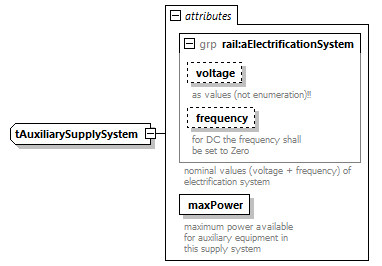 | ||||||||||||||||||||||||||||||
| namespace | https://www.railml.org/schemas/2021 | ||||||||||||||||||||||||||||||
| used by |
| ||||||||||||||||||||||||||||||
| attributes |
| ||||||||||||||||||||||||||||||
| source | <xs:complexType name="tAuxiliarySupplySystem"> <xs:attributeGroup ref="rail:aElectrificationSystem"/> <xs:attribute name="maxPower" type="rail:tPowerWatt" use="required"> <xs:annotation> <xs:documentation>maximum power available for auxiliary equipment in this supply system</xs:documentation> </xs:annotation> </xs:attribute> </xs:complexType> |
attribute tAuxiliarySupplySystem/@maxPower
| type | rail:tPowerWatt | ||||||
| properties |
| ||||||
| facets |
| ||||||
| annotation |
| ||||||
| source | <xs:attribute name="maxPower" type="rail:tPowerWatt" use="required"> <xs:annotation> <xs:documentation>maximum power available for auxiliary equipment in this supply system</xs:documentation> </xs:annotation> </xs:attribute> |
complexType tBasicBrakeOperation
| diagram |  | ||||||||||||||||||||||||||||||||||||||
| namespace | https://www.railml.org/schemas/2021 | ||||||||||||||||||||||||||||||||||||||
| children | rail:decelerationTable | ||||||||||||||||||||||||||||||||||||||
| used by |
| ||||||||||||||||||||||||||||||||||||||
| attributes |
| ||||||||||||||||||||||||||||||||||||||
| annotation |
| ||||||||||||||||||||||||||||||||||||||
| source | <xs:complexType name="tBasicBrakeOperation"> <xs:annotation> <xs:documentation>data type for description of brake operation</xs:documentation> </xs:annotation> <xs:sequence> <xs:element name="decelerationTable" type="rail:tDecelerationCurve" minOccurs="0"> <xs:annotation> <xs:documentation>See https://wiki2.railml.org/wiki/RS:decelerationTable</xs:documentation> </xs:annotation> </xs:element> </xs:sequence> <xs:attributeGroup ref="rail:aBasicBrakeOperation"/> </xs:complexType> |
element tBasicBrakeOperation/decelerationTable
| diagram |  | ||||||
| namespace | https://www.railml.org/schemas/2021 | ||||||
| type | rail:tDecelerationCurve | ||||||
| properties |
| ||||||
| children | rail:valueTable rail:segmentTable | ||||||
| annotation |
| ||||||
| source | <xs:element name="decelerationTable" type="rail:tDecelerationCurve" minOccurs="0"> <xs:annotation> <xs:documentation>See https://wiki2.railml.org/wiki/RS:decelerationTable</xs:documentation> </xs:annotation> </xs:element> |
complexType tCurrentCurve
| diagram |  | ||
| namespace | https://www.railml.org/schemas/2021 | ||
| type | extension of rail:tCurve | ||
| properties |
| ||
| children | rail:valueTable rail:segmentTable | ||
| used by |
| ||
| annotation |
| ||
| source | <xs:complexType name="tCurrentCurve"> <xs:annotation> <xs:documentation>vehicle current curve vs. speed, for use with traction and braking</xs:documentation> </xs:annotation> <xs:complexContent> <xs:extension base="rail:tCurve"/> </xs:complexContent> </xs:complexType> |
complexType tCurrentLimitation
| diagram |  | ||
| namespace | https://www.railml.org/schemas/2021 | ||
| type | extension of rail:tCurve | ||
| properties |
| ||
| children | rail:valueTable rail:segmentTable | ||
| used by |
| ||
| annotation |
| ||
| source | <xs:complexType name="tCurrentLimitation"> <xs:annotation> <xs:documentation>net current limitation curve vs. net voltage, for use with traction and braking</xs:documentation> </xs:annotation> <xs:complexContent> <xs:extension base="rail:tCurve"/> </xs:complexContent> </xs:complexType> |
complexType tCurve
| diagram | 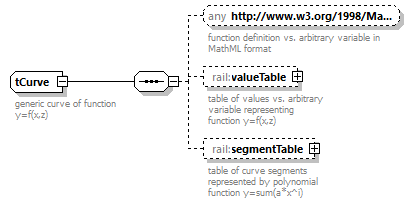 | ||||
| namespace | https://www.railml.org/schemas/2021 | ||||
| children | rail:valueTable rail:segmentTable | ||||
| used by |
| ||||
| annotation |
| ||||
| source | <xs:complexType name="tCurve"> <xs:annotation> <xs:documentation>generic curve of function y=f(x,z)</xs:documentation> </xs:annotation> <xs:sequence> <xs:any namespace="http://www.w3.org/1998/Math/MathML" processContents="strict" minOccurs="0"> <xs:annotation> <xs:documentation>function definition vs. arbitrary variable in MathML format</xs:documentation> </xs:annotation> </xs:any> <xs:element name="valueTable" minOccurs="0"> <xs:annotation> <xs:documentation>table of values vs. arbitrary variable representing function y=f(x,z)</xs:documentation> <xs:documentation>See https://wiki2.railml.org/wiki/RS:valueTable</xs:documentation> </xs:annotation> <xs:complexType> <xs:complexContent> <xs:extension base="rail:tValueTable"/> </xs:complexContent> </xs:complexType> </xs:element> <xs:element name="segmentTable" minOccurs="0"> <xs:annotation> <xs:documentation>table of curve segments represented by polynomial function y=sum(a*x^i)</xs:documentation> <xs:documentation>See https://wiki2.railml.org/wiki/RS:segmentTable</xs:documentation> </xs:annotation> <xs:complexType> <xs:complexContent> <xs:extension base="rail:tSegmentTable"/> </xs:complexContent> </xs:complexType> </xs:element> </xs:sequence> </xs:complexType> |
element tCurve/valueTable
| diagram | 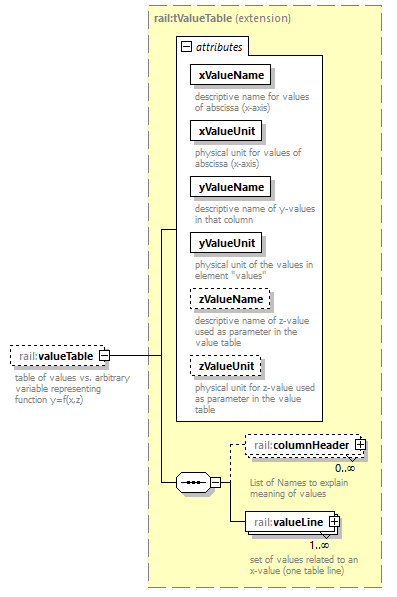 | ||||||||||||||||||||||||||||||||||||||||||||||||||||||
| namespace | https://www.railml.org/schemas/2021 | ||||||||||||||||||||||||||||||||||||||||||||||||||||||
| type | extension of rail:tValueTable | ||||||||||||||||||||||||||||||||||||||||||||||||||||||
| properties |
| ||||||||||||||||||||||||||||||||||||||||||||||||||||||
| children | rail:columnHeader rail:valueLine | ||||||||||||||||||||||||||||||||||||||||||||||||||||||
| attributes |
| ||||||||||||||||||||||||||||||||||||||||||||||||||||||
| annotation |
| ||||||||||||||||||||||||||||||||||||||||||||||||||||||
| source | <xs:element name="valueTable" minOccurs="0"> <xs:annotation> <xs:documentation>table of values vs. arbitrary variable representing function y=f(x,z)</xs:documentation> <xs:documentation>See https://wiki2.railml.org/wiki/RS:valueTable</xs:documentation> </xs:annotation> <xs:complexType> <xs:complexContent> <xs:extension base="rail:tValueTable"/> </xs:complexContent> </xs:complexType> </xs:element> |
element tCurve/segmentTable
| diagram |  | ||||||||||||||||||||||||||||||||||||||
| namespace | https://www.railml.org/schemas/2021 | ||||||||||||||||||||||||||||||||||||||
| type | extension of rail:tSegmentTable | ||||||||||||||||||||||||||||||||||||||
| properties |
| ||||||||||||||||||||||||||||||||||||||
| children | rail:columnHeader rail:valueLine | ||||||||||||||||||||||||||||||||||||||
| attributes |
| ||||||||||||||||||||||||||||||||||||||
| annotation |
| ||||||||||||||||||||||||||||||||||||||
| source | <xs:element name="segmentTable" minOccurs="0"> <xs:annotation> <xs:documentation>table of curve segments represented by polynomial function y=sum(a*x^i)</xs:documentation> <xs:documentation>See https://wiki2.railml.org/wiki/RS:segmentTable</xs:documentation> </xs:annotation> <xs:complexType> <xs:complexContent> <xs:extension base="rail:tSegmentTable"/> </xs:complexContent> </xs:complexType> </xs:element> |
complexType tCurvingLimitationType
| diagram |  | ||||||||||||||||||||||||||||||
| namespace | https://www.railml.org/schemas/2021 | ||||||||||||||||||||||||||||||
| used by |
| ||||||||||||||||||||||||||||||
| attributes |
| ||||||||||||||||||||||||||||||
| annotation |
| ||||||||||||||||||||||||||||||
| source | <xs:complexType name="tCurvingLimitationType"> <xs:annotation> <xs:documentation>container for list of physical curving limits</xs:documentation> </xs:annotation> <xs:attributeGroup ref="rail:aCurvingLimitation"/> </xs:complexType> |
complexType tDecelerationCurve
| diagram | 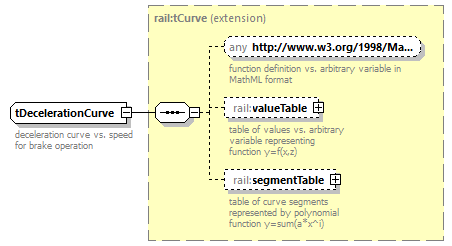 | ||
| namespace | https://www.railml.org/schemas/2021 | ||
| type | extension of rail:tCurve | ||
| properties |
| ||
| children | rail:valueTable rail:segmentTable | ||
| used by |
| ||
| annotation |
| ||
| source | <xs:complexType name="tDecelerationCurve"> <xs:annotation> <xs:documentation>deceleration curve vs. speed for brake operation</xs:documentation> </xs:annotation> <xs:complexContent> <xs:extension base="rail:tCurve"/> </xs:complexContent> </xs:complexType> |
complexType tDieselEngine
| diagram |  | ||||||||||||||||||||||||||||||||||||||||||||||||||||||
| namespace | https://www.railml.org/schemas/2021 | ||||||||||||||||||||||||||||||||||||||||||||||||||||||
| used by |
| ||||||||||||||||||||||||||||||||||||||||||||||||||||||
| attributes |
| ||||||||||||||||||||||||||||||||||||||||||||||||||||||
| annotation |
| ||||||||||||||||||||||||||||||||||||||||||||||||||||||
| source | <xs:complexType name="tDieselEngine"> <xs:annotation> <xs:documentation>technical data of diesel engine</xs:documentation> </xs:annotation> <xs:attributeGroup ref="rail:aAssemblyNameNumber"> <xs:annotation> <xs:documentation>number of diesel engines per vehicle and their type description (for traction)</xs:documentation> </xs:annotation> </xs:attributeGroup> <xs:attributeGroup ref="rail:aDieselEngine"/> </xs:complexType> |
complexType tDoors
| diagram |  | ||||||||||||||||||||||||||||||||||||||||||||||||||||||||||||||||||||||
| namespace | https://www.railml.org/schemas/2021 | ||||||||||||||||||||||||||||||||||||||||||||||||||||||||||||||||||||||
| used by |
| ||||||||||||||||||||||||||||||||||||||||||||||||||||||||||||||||||||||
| attributes |
| ||||||||||||||||||||||||||||||||||||||||||||||||||||||||||||||||||||||
| annotation |
| ||||||||||||||||||||||||||||||||||||||||||||||||||||||||||||||||||||||
| source | <xs:complexType name="tDoors"> <xs:annotation> <xs:documentation>data about door features for the car</xs:documentation> </xs:annotation> <xs:attributeGroup ref="rail:aDoors"/> </xs:complexType> |
complexType tDriversCabType
| diagram | 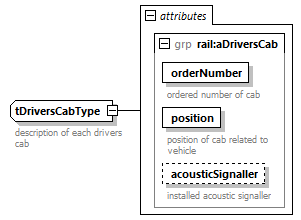 | ||||||||||||||||||||||||||||||
| namespace | https://www.railml.org/schemas/2021 | ||||||||||||||||||||||||||||||
| used by |
| ||||||||||||||||||||||||||||||
| attributes |
| ||||||||||||||||||||||||||||||
| annotation |
| ||||||||||||||||||||||||||||||
| source | <xs:complexType name="tDriversCabType"> <xs:annotation> <xs:documentation>description of each drivers cab</xs:documentation> </xs:annotation> <xs:attributeGroup ref="rail:aDriversCab"/> </xs:complexType> |
complexType tEddyCurrentBrake
| diagram |  | ||||||||||||||||||||||||||||||
| namespace | https://www.railml.org/schemas/2021 | ||||||||||||||||||||||||||||||
| used by |
| ||||||||||||||||||||||||||||||
| attributes |
| ||||||||||||||||||||||||||||||
| annotation |
| ||||||||||||||||||||||||||||||
| source | <xs:complexType name="tEddyCurrentBrake"> <xs:annotation> <xs:documentation>technical data of eddy current brake</xs:documentation> </xs:annotation> <xs:attributeGroup ref="rail:aEddyCurrentBrake"/> </xs:complexType> |
complexType tEfficiencyCurve
| diagram |  | ||
| namespace | https://www.railml.org/schemas/2021 | ||
| type | extension of rail:tCurve | ||
| properties |
| ||
| children | rail:valueTable rail:segmentTable | ||
| used by | |||
| annotation |
| ||
| source | <xs:complexType name="tEfficiencyCurve"> <xs:annotation> <xs:documentation>subsystem efficiency curve vs. speed</xs:documentation> </xs:annotation> <xs:complexContent> <xs:extension base="rail:tCurve"/> </xs:complexContent> </xs:complexType> |
complexType tEffortCurve
| diagram |  | ||
| namespace | https://www.railml.org/schemas/2021 | ||
| type | extension of rail:tCurve | ||
| properties |
| ||
| children | rail:valueTable rail:segmentTable | ||
| used by |
| ||
| annotation |
| ||
| source | <xs:complexType name="tEffortCurve"> <xs:annotation> <xs:documentation>effort curve vs. speed, for use with traction and braking</xs:documentation> </xs:annotation> <xs:complexContent> <xs:extension base="rail:tCurve"/> </xs:complexContent> </xs:complexType> |
complexType tElectricalWagonCouplerType
| diagram |  | ||||||||||||||||||||||||||||||||||||||
| namespace | https://www.railml.org/schemas/2021 | ||||||||||||||||||||||||||||||||||||||
| used by |
| ||||||||||||||||||||||||||||||||||||||
| attributes |
| ||||||||||||||||||||||||||||||||||||||
| annotation |
| ||||||||||||||||||||||||||||||||||||||
| source | <xs:complexType name="tElectricalWagonCouplerType"> <xs:annotation> <xs:documentation>data of available electrical couplers between wagons</xs:documentation> </xs:annotation> <xs:attributeGroup ref="rail:aElectricalWagonCoupler"/> </xs:complexType> |
complexType tElectrificationSystem
| diagram | 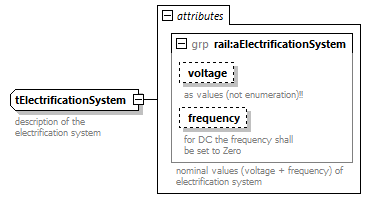 | ||||||||||||||||||||||
| namespace | https://www.railml.org/schemas/2021 | ||||||||||||||||||||||
| used by |
| ||||||||||||||||||||||
| attributes |
| ||||||||||||||||||||||
| annotation |
| ||||||||||||||||||||||
| source | <xs:complexType name="tElectrificationSystem"> <xs:annotation> <xs:documentation>description of the electrification system</xs:documentation> </xs:annotation> <xs:attributeGroup ref="rail:aElectrificationSystem"/> </xs:complexType> |
complexType tEngine
| diagram |  | ||||||||||||||||||||||
| namespace | https://www.railml.org/schemas/2021 | ||||||||||||||||||||||
| used by |
| ||||||||||||||||||||||
| attributes |
| ||||||||||||||||||||||
| annotation |
| ||||||||||||||||||||||
| source | <xs:complexType name="tEngine"> <xs:annotation> <xs:documentation>engine data about a motor car or locomotive</xs:documentation> </xs:annotation> <xs:attributeGroup ref="rail:aEngine"/> </xs:complexType> |
complexType tETCS
| diagram | 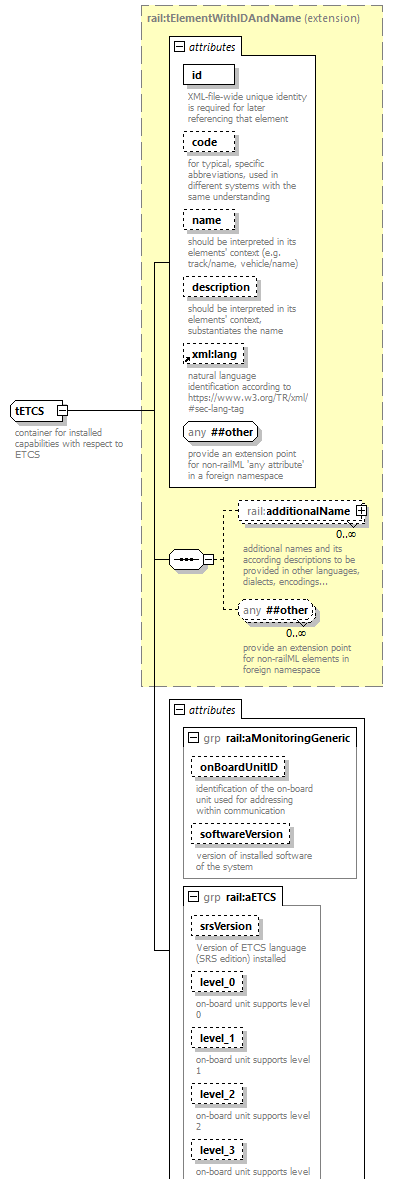 | ||||||||||||||||||||||||||||||||||||||||||||||||||||||||||||||||||||||||||||||||||||||||||||||||||||||
| namespace | https://www.railml.org/schemas/2021 | ||||||||||||||||||||||||||||||||||||||||||||||||||||||||||||||||||||||||||||||||||||||||||||||||||||||
| type | extension of rail:tElementWithIDAndName | ||||||||||||||||||||||||||||||||||||||||||||||||||||||||||||||||||||||||||||||||||||||||||||||||||||||
| properties |
| ||||||||||||||||||||||||||||||||||||||||||||||||||||||||||||||||||||||||||||||||||||||||||||||||||||||
| children | rail:additionalName | ||||||||||||||||||||||||||||||||||||||||||||||||||||||||||||||||||||||||||||||||||||||||||||||||||||||
| used by |
| ||||||||||||||||||||||||||||||||||||||||||||||||||||||||||||||||||||||||||||||||||||||||||||||||||||||
| attributes |
| ||||||||||||||||||||||||||||||||||||||||||||||||||||||||||||||||||||||||||||||||||||||||||||||||||||||
| annotation |
| ||||||||||||||||||||||||||||||||||||||||||||||||||||||||||||||||||||||||||||||||||||||||||||||||||||||
| source | <xs:complexType name="tETCS"> <xs:annotation> <xs:documentation>container for installed capabilities with respect to ETCS</xs:documentation> </xs:annotation> <xs:complexContent> <xs:extension base="rail:tElementWithIDAndName"> <xs:attributeGroup ref="rail:aMonitoringGeneric"/> <xs:attributeGroup ref="rail:aETCS"/> </xs:extension> </xs:complexContent> </xs:complexType> |
complexType tFormation
| diagram |  | ||||||||||||||||||||||||||||||||||||||||||||||||||||||||||||||||||||||||||||||||||||||||||||||||||||||||||||||||||||||
| namespace | https://www.railml.org/schemas/2021 | ||||||||||||||||||||||||||||||||||||||||||||||||||||||||||||||||||||||||||||||||||||||||||||||||||||||||||||||||||||||
| type | extension of rail:tElementWithIDAndName | ||||||||||||||||||||||||||||||||||||||||||||||||||||||||||||||||||||||||||||||||||||||||||||||||||||||||||||||||||||||
| properties |
| ||||||||||||||||||||||||||||||||||||||||||||||||||||||||||||||||||||||||||||||||||||||||||||||||||||||||||||||||||||||
| children | rail:additionalName rail:states | ||||||||||||||||||||||||||||||||||||||||||||||||||||||||||||||||||||||||||||||||||||||||||||||||||||||||||||||||||||||
| used by |
| ||||||||||||||||||||||||||||||||||||||||||||||||||||||||||||||||||||||||||||||||||||||||||||||||||||||||||||||||||||||
| attributes |
| ||||||||||||||||||||||||||||||||||||||||||||||||||||||||||||||||||||||||||||||||||||||||||||||||||||||||||||||||||||||
| annotation |
| ||||||||||||||||||||||||||||||||||||||||||||||||||||||||||||||||||||||||||||||||||||||||||||||||||||||||||||||||||||||
| source | <xs:complexType name="tFormation"> <xs:annotation> <xs:documentation>data for a single train formation made of rs-vehicles</xs:documentation> </xs:annotation> <xs:complexContent> <xs:extension base="rail:tElementWithIDAndName"> <xs:sequence> <xs:element name="states" type="rail:tStates" minOccurs="0"> <xs:annotation> <xs:documentation>Container to define various life cycle status of the formation</xs:documentation> <xs:documentation>See https://wiki2.railml.org/wiki/RS:states</xs:documentation> </xs:annotation> </xs:element> </xs:sequence> <xs:attributeGroup ref="rail:aFormation"/> </xs:extension> </xs:complexContent> </xs:complexType> |
element tFormation/states
| diagram |  | ||||||
| namespace | https://www.railml.org/schemas/2021 | ||||||
| type | rail:tStates | ||||||
| properties |
| ||||||
| children | rail:state | ||||||
| annotation |
| ||||||
| source | <xs:element name="states" type="rail:tStates" minOccurs="0"> <xs:annotation> <xs:documentation>Container to define various life cycle status of the formation</xs:documentation> <xs:documentation>See https://wiki2.railml.org/wiki/RS:states</xs:documentation> </xs:annotation> </xs:element> |
complexType tFourQuadrantChopper
| diagram |  | ||||||||||||||||||||||||||||||||||||||||||||||
| namespace | https://www.railml.org/schemas/2021 | ||||||||||||||||||||||||||||||||||||||||||||||
| used by |
| ||||||||||||||||||||||||||||||||||||||||||||||
| attributes |
| ||||||||||||||||||||||||||||||||||||||||||||||
| annotation |
| ||||||||||||||||||||||||||||||||||||||||||||||
| source | <xs:complexType name="tFourQuadrantChopper"> <xs:annotation> <xs:documentation>technical data of inverter between OHL/transformer and link circuit</xs:documentation> </xs:annotation> <xs:attributeGroup ref="rail:aAssemblyNameNumber"> <xs:annotation> <xs:documentation>number of four-quadrant choppers installed per vehicle and their type description</xs:documentation> </xs:annotation> </xs:attributeGroup> <xs:attributeGroup ref="rail:aFourQuadrantChopper"/> </xs:complexType> |
complexType tGangway
| diagram |  | ||||||||||||||||||||||||||||||||||||||||||||||||||||||||||||||
| namespace | https://www.railml.org/schemas/2021 | ||||||||||||||||||||||||||||||||||||||||||||||||||||||||||||||
| used by |
| ||||||||||||||||||||||||||||||||||||||||||||||||||||||||||||||
| attributes |
| ||||||||||||||||||||||||||||||||||||||||||||||||||||||||||||||
| annotation |
| ||||||||||||||||||||||||||||||||||||||||||||||||||||||||||||||
| source | <xs:complexType name="tGangway"> <xs:annotation> <xs:documentation>description of any gangways of the passenger car to other cars</xs:documentation> </xs:annotation> <xs:attributeGroup ref="rail:aGangway"/> </xs:complexType> |
complexType tGear
| diagram |  | ||||||||||||||||||||||||||||||||||||||||||||||||||||||||||||||||||||||
| namespace | https://www.railml.org/schemas/2021 | ||||||||||||||||||||||||||||||||||||||||||||||||||||||||||||||||||||||
| used by |
| ||||||||||||||||||||||||||||||||||||||||||||||||||||||||||||||||||||||
| attributes |
| ||||||||||||||||||||||||||||||||||||||||||||||||||||||||||||||||||||||
| annotation |
| ||||||||||||||||||||||||||||||||||||||||||||||||||||||||||||||||||||||
| source | <xs:complexType name="tGear"> <xs:annotation> <xs:documentation>technical data of transmission system between motor and wheel</xs:documentation> </xs:annotation> <xs:attributeGroup ref="rail:aAssemblyNameNumber"> <xs:annotation> <xs:documentation>number of gear assemblies per vehicle and their type description</xs:documentation> </xs:annotation> </xs:attributeGroup> <xs:attributeGroup ref="rail:aGear"/> </xs:complexType> |
complexType tGoods
| diagram |  | ||||||||||||||||||||||||||||||||||||||||||||||
| namespace | https://www.railml.org/schemas/2021 | ||||||||||||||||||||||||||||||||||||||||||||||
| used by |
| ||||||||||||||||||||||||||||||||||||||||||||||
| attributes |
| ||||||||||||||||||||||||||||||||||||||||||||||
| annotation |
| ||||||||||||||||||||||||||||||||||||||||||||||
| source | <xs:complexType name="tGoods"> <xs:annotation> <xs:documentation>data for freight cars</xs:documentation> </xs:annotation> <xs:attributeGroup ref="rail:aGoods"/> </xs:complexType> |
complexType tLineClassification
| diagram |  | ||||||||||||||||||||||
| namespace | https://www.railml.org/schemas/2021 | ||||||||||||||||||||||
| used by |
| ||||||||||||||||||||||
| attributes |
| ||||||||||||||||||||||
| annotation |
| ||||||||||||||||||||||
| source | <xs:complexType name="tLineClassification"> <xs:annotation> <xs:documentation>list of line classifications and permissible payload according RIV</xs:documentation> </xs:annotation> <xs:attributeGroup ref="rail:aLineClassification"/> </xs:complexType> |
complexType tLink
| diagram |  | ||||||||||||||||||||||
| namespace | https://www.railml.org/schemas/2021 | ||||||||||||||||||||||
| used by |
| ||||||||||||||||||||||
| attributes |
| ||||||||||||||||||||||
| source | <xs:complexType name="tLink"> <xs:attributeGroup ref="rail:aNominalElectrical"/> </xs:complexType> |
complexType tLoadLimitMatrixType
| diagram | 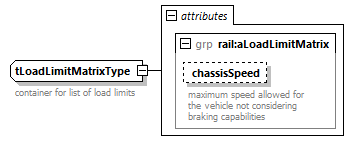 | ||||||||||||||
| namespace | https://www.railml.org/schemas/2021 | ||||||||||||||
| used by |
| ||||||||||||||
| attributes |
| ||||||||||||||
| annotation |
| ||||||||||||||
| source | <xs:complexType name="tLoadLimitMatrixType"> <xs:annotation> <xs:documentation>container for list of load limits</xs:documentation> </xs:annotation> <xs:attributeGroup ref="rail:aLoadLimitMatrix"/> </xs:complexType> |
complexType tLoadLimitType
| diagram |  | ||||||||||||||
| namespace | https://www.railml.org/schemas/2021 | ||||||||||||||
| used by |
| ||||||||||||||
| attributes |
| ||||||||||||||
| annotation |
| ||||||||||||||
| source | <xs:complexType name="tLoadLimitType"> <xs:annotation> <xs:documentation>permissible load limits depending on line classification</xs:documentation> </xs:annotation> <xs:attributeGroup ref="rail:aLoadLimit"/> </xs:complexType> |
complexType tLosses
| diagram |  | ||
| namespace | https://www.railml.org/schemas/2021 | ||
| type | extension of rail:tCurve | ||
| properties |
| ||
| children | rail:valueTable rail:segmentTable | ||
| used by |
| ||
| annotation |
| ||
| source | <xs:complexType name="tLosses"> <xs:annotation> <xs:documentation>losses curve vs. speed, for use with mechanical and electrical systems</xs:documentation> </xs:annotation> <xs:complexContent> <xs:extension base="rail:tCurve"/> </xs:complexContent> </xs:complexType> |
complexType tMaintenanceInterval
| diagram | 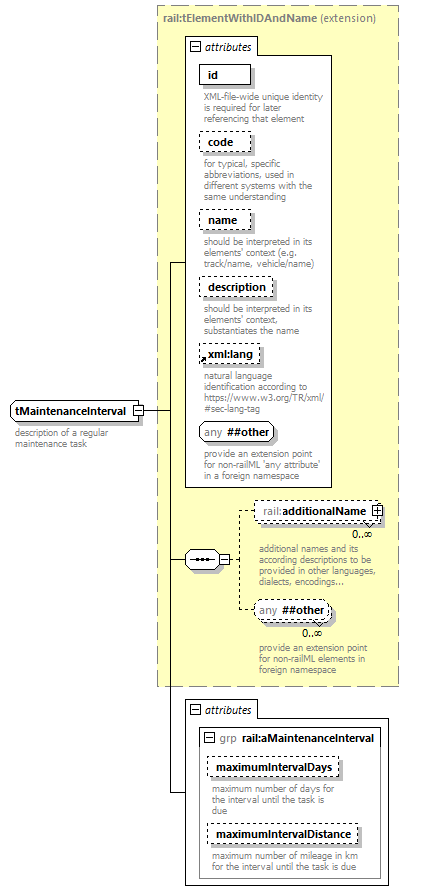 | ||||||||||||||||||||||||||||||||||||||||||||||||||||||||||||||
| namespace | https://www.railml.org/schemas/2021 | ||||||||||||||||||||||||||||||||||||||||||||||||||||||||||||||
| type | extension of rail:tElementWithIDAndName | ||||||||||||||||||||||||||||||||||||||||||||||||||||||||||||||
| properties |
| ||||||||||||||||||||||||||||||||||||||||||||||||||||||||||||||
| children | rail:additionalName | ||||||||||||||||||||||||||||||||||||||||||||||||||||||||||||||
| used by |
| ||||||||||||||||||||||||||||||||||||||||||||||||||||||||||||||
| attributes |
| ||||||||||||||||||||||||||||||||||||||||||||||||||||||||||||||
| annotation |
| ||||||||||||||||||||||||||||||||||||||||||||||||||||||||||||||
| source | <xs:complexType name="tMaintenanceInterval"> <xs:annotation> <xs:documentation>description of a regular maintenance task</xs:documentation> </xs:annotation> <xs:complexContent> <xs:extension base="rail:tElementWithIDAndName"> <xs:attributeGroup ref="rail:aMaintenanceInterval"/> </xs:extension> </xs:complexContent> </xs:complexType> |
complexType tManufacturer
| diagram | 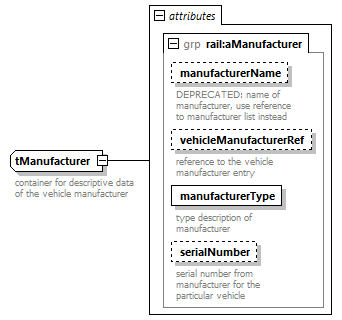 | ||||||||||||||||||||||||||||||||||||||
| namespace | https://www.railml.org/schemas/2021 | ||||||||||||||||||||||||||||||||||||||
| used by |
| ||||||||||||||||||||||||||||||||||||||
| attributes |
| ||||||||||||||||||||||||||||||||||||||
| annotation |
| ||||||||||||||||||||||||||||||||||||||
| source | <xs:complexType name="tManufacturer"> <xs:annotation> <xs:documentation>container for descriptive data of the vehicle manufacturer</xs:documentation> </xs:annotation> <xs:attributeGroup ref="rail:aManufacturer"/> </xs:complexType> |
complexType tMechanicalWagonCouplerType
| diagram |  | ||||||||||||||||||||||||||||||||||||||||||||||
| namespace | https://www.railml.org/schemas/2021 | ||||||||||||||||||||||||||||||||||||||||||||||
| used by |
| ||||||||||||||||||||||||||||||||||||||||||||||
| attributes |
| ||||||||||||||||||||||||||||||||||||||||||||||
| annotation |
| ||||||||||||||||||||||||||||||||||||||||||||||
| source | <xs:complexType name="tMechanicalWagonCouplerType"> <xs:annotation> <xs:documentation>data of available mechanical couplers between wagons</xs:documentation> </xs:annotation> <xs:attributeGroup ref="rail:aMechanicalWagonCoupler"/> </xs:complexType> |
complexType tMonitoring
| diagram |  | ||
| namespace | https://www.railml.org/schemas/2021 | ||
| used by |
| ||
| annotation |
| ||
| source | <xs:complexType name="tMonitoring"> <xs:annotation> <xs:documentation>types of signalling systems fitted to the vehicle</xs:documentation> </xs:annotation> </xs:complexType> |
complexType tNationalSystem
| diagram |  | ||||||||||||||||||||||||||||||||||||||||||||||||||||||||||||||||||||||||||||||||||||||||
| namespace | https://www.railml.org/schemas/2021 | ||||||||||||||||||||||||||||||||||||||||||||||||||||||||||||||||||||||||||||||||||||||||
| type | extension of rail:tElementWithIDAndName | ||||||||||||||||||||||||||||||||||||||||||||||||||||||||||||||||||||||||||||||||||||||||
| properties |
| ||||||||||||||||||||||||||||||||||||||||||||||||||||||||||||||||||||||||||||||||||||||||
| children | rail:additionalName | ||||||||||||||||||||||||||||||||||||||||||||||||||||||||||||||||||||||||||||||||||||||||
| used by |
| ||||||||||||||||||||||||||||||||||||||||||||||||||||||||||||||||||||||||||||||||||||||||
| attributes |
| ||||||||||||||||||||||||||||||||||||||||||||||||||||||||||||||||||||||||||||||||||||||||
| annotation |
| ||||||||||||||||||||||||||||||||||||||||||||||||||||||||||||||||||||||||||||||||||||||||
| source | <xs:complexType name="tNationalSystem"> <xs:annotation> <xs:documentation>description of installed national train protection/monitoring systems like PZB, CIR-ELKE, TVM, LEA, ...</xs:documentation> </xs:annotation> <xs:complexContent> <xs:extension base="rail:tElementWithIDAndName"> <xs:attributeGroup ref="rail:aMonitoringGeneric"/> <xs:attributeGroup ref="rail:aMonitoringSystem"/> </xs:extension> </xs:complexContent> </xs:complexType> |
complexType tOperator
| diagram |  | ||||||||||||||||||||||||||||||||||||||||||
| namespace | https://www.railml.org/schemas/2021 | ||||||||||||||||||||||||||||||||||||||||||
| used by |
| ||||||||||||||||||||||||||||||||||||||||||
| attributes |
| ||||||||||||||||||||||||||||||||||||||||||
| annotation |
| ||||||||||||||||||||||||||||||||||||||||||
| source | <xs:complexType name="tOperator"> <xs:annotation> <xs:documentation>container for descriptive data of the vehicle operator</xs:documentation> </xs:annotation> <xs:attributeGroup ref="rail:aOperator"/> <xs:attributeGroup ref="rail:aTimePeriod"/> </xs:complexType> |
complexType tOtherEquipment
| diagram | 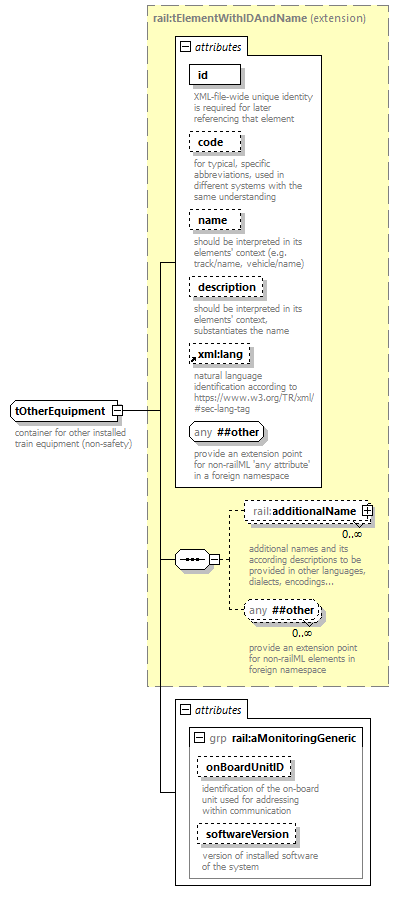 | ||||||||||||||||||||||||||||||||||||||||||||||||||||||||||||||
| namespace | https://www.railml.org/schemas/2021 | ||||||||||||||||||||||||||||||||||||||||||||||||||||||||||||||
| type | extension of rail:tElementWithIDAndName | ||||||||||||||||||||||||||||||||||||||||||||||||||||||||||||||
| properties |
| ||||||||||||||||||||||||||||||||||||||||||||||||||||||||||||||
| children | rail:additionalName | ||||||||||||||||||||||||||||||||||||||||||||||||||||||||||||||
| used by |
| ||||||||||||||||||||||||||||||||||||||||||||||||||||||||||||||
| attributes |
| ||||||||||||||||||||||||||||||||||||||||||||||||||||||||||||||
| annotation |
| ||||||||||||||||||||||||||||||||||||||||||||||||||||||||||||||
| source | <xs:complexType name="tOtherEquipment"> <xs:annotation> <xs:documentation>container for other installed train equipment (non-safety)</xs:documentation> </xs:annotation> <xs:complexContent> <xs:extension base="rail:tElementWithIDAndName"> <xs:attributeGroup ref="rail:aMonitoringGeneric"/> </xs:extension> </xs:complexContent> </xs:complexType> |
complexType tOwnerRS
| diagram |  | ||||||||||||||||||||||||||||||||||
| namespace | https://www.railml.org/schemas/2021 | ||||||||||||||||||||||||||||||||||
| used by |
| ||||||||||||||||||||||||||||||||||
| attributes |
| ||||||||||||||||||||||||||||||||||
| annotation |
| ||||||||||||||||||||||||||||||||||
| source | <xs:complexType name="tOwnerRS"> <xs:annotation> <xs:documentation>container for descriptive data of the vehicle owner</xs:documentation> </xs:annotation> <xs:attributeGroup ref="rail:aOwnerRS"/> <xs:attributeGroup ref="rail:aTimePeriod"/> </xs:complexType> |
complexType tPantograph
| diagram |  | ||||||||||||||||||||||||||||||||||||||||||||||||||||||||||||||||||||||
| namespace | https://www.railml.org/schemas/2021 | ||||||||||||||||||||||||||||||||||||||||||||||||||||||||||||||||||||||
| used by |
| ||||||||||||||||||||||||||||||||||||||||||||||||||||||||||||||||||||||
| attributes |
| ||||||||||||||||||||||||||||||||||||||||||||||||||||||||||||||||||||||
| annotation |
| ||||||||||||||||||||||||||||||||||||||||||||||||||||||||||||||||||||||
| source | <xs:complexType name="tPantograph"> <xs:annotation> <xs:documentation>description of any installed pantograph</xs:documentation> </xs:annotation> <xs:attributeGroup ref="rail:aPantograph"/> </xs:complexType> |
complexType tPassenger
| diagram | 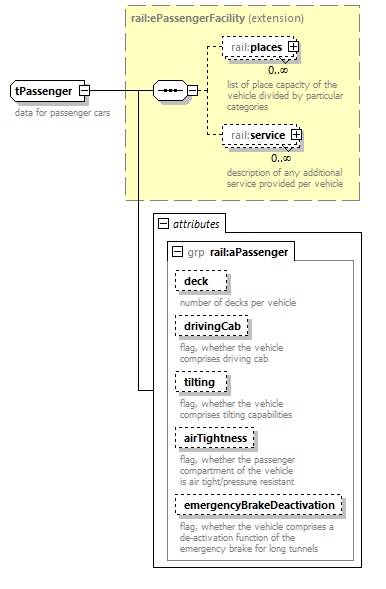 | ||||||||||||||||||||||||||||||||||||||||||||||
| namespace | https://www.railml.org/schemas/2021 | ||||||||||||||||||||||||||||||||||||||||||||||
| type | extension of rail:ePassengerFacility | ||||||||||||||||||||||||||||||||||||||||||||||
| properties |
| ||||||||||||||||||||||||||||||||||||||||||||||
| children | rail:places rail:service | ||||||||||||||||||||||||||||||||||||||||||||||
| used by |
| ||||||||||||||||||||||||||||||||||||||||||||||
| attributes |
| ||||||||||||||||||||||||||||||||||||||||||||||
| annotation |
| ||||||||||||||||||||||||||||||||||||||||||||||
| source | <xs:complexType name="tPassenger"> <xs:annotation> <xs:documentation>data for passenger cars</xs:documentation> </xs:annotation> <xs:complexContent> <xs:extension base="rail:ePassengerFacility"> <xs:attributeGroup ref="rail:aPassenger"/> </xs:extension> </xs:complexContent> </xs:complexType> |
complexType tPassengerFlowSpeed
| diagram |  | ||||||||||||||||||||||
| namespace | https://www.railml.org/schemas/2021 | ||||||||||||||||||||||
| used by |
| ||||||||||||||||||||||
| attributes |
| ||||||||||||||||||||||
| annotation |
| ||||||||||||||||||||||
| source | <xs:complexType name="tPassengerFlowSpeed"> <xs:annotation> <xs:documentation>data for passenger flow speed</xs:documentation> </xs:annotation> <xs:attributeGroup ref="rail:aPassengerFlowSpeed"/> </xs:complexType> |
complexType tPneumaticWagonCouplerType
| diagram |  | ||||||||||||||||||||||||||||||
| namespace | https://www.railml.org/schemas/2021 | ||||||||||||||||||||||||||||||
| used by |
| ||||||||||||||||||||||||||||||
| attributes |
| ||||||||||||||||||||||||||||||
| annotation |
| ||||||||||||||||||||||||||||||
| source | <xs:complexType name="tPneumaticWagonCouplerType"> <xs:annotation> <xs:documentation>data of available pneumatic couplers between wagons</xs:documentation> </xs:annotation> <xs:attributeGroup ref="rail:aPneumaticWagonCoupler"/> </xs:complexType> |
complexType tPropulsion
| diagram |  | ||||||||||||||||||||||||||||||||||||||||||||||||||||||||||||||||||||||||||||||||||||||||||||||||||||||||||||||||||||||||||||||||||||||||||||||||||||||||||||||||||||||||||||||||||||||||||||||||||||||||||||||||||||||||||||||||||||||||||||||
| namespace | https://www.railml.org/schemas/2021 | ||||||||||||||||||||||||||||||||||||||||||||||||||||||||||||||||||||||||||||||||||||||||||||||||||||||||||||||||||||||||||||||||||||||||||||||||||||||||||||||||||||||||||||||||||||||||||||||||||||||||||||||||||||||||||||||||||||||||||||||
| type | extension of rail:tElementWithIDAndName | ||||||||||||||||||||||||||||||||||||||||||||||||||||||||||||||||||||||||||||||||||||||||||||||||||||||||||||||||||||||||||||||||||||||||||||||||||||||||||||||||||||||||||||||||||||||||||||||||||||||||||||||||||||||||||||||||||||||||||||||
| properties |
| ||||||||||||||||||||||||||||||||||||||||||||||||||||||||||||||||||||||||||||||||||||||||||||||||||||||||||||||||||||||||||||||||||||||||||||||||||||||||||||||||||||||||||||||||||||||||||||||||||||||||||||||||||||||||||||||||||||||||||||||
| children | rail:additionalName | ||||||||||||||||||||||||||||||||||||||||||||||||||||||||||||||||||||||||||||||||||||||||||||||||||||||||||||||||||||||||||||||||||||||||||||||||||||||||||||||||||||||||||||||||||||||||||||||||||||||||||||||||||||||||||||||||||||||||||||||
| used by |
| ||||||||||||||||||||||||||||||||||||||||||||||||||||||||||||||||||||||||||||||||||||||||||||||||||||||||||||||||||||||||||||||||||||||||||||||||||||||||||||||||||||||||||||||||||||||||||||||||||||||||||||||||||||||||||||||||||||||||||||||
| attributes |
| ||||||||||||||||||||||||||||||||||||||||||||||||||||||||||||||||||||||||||||||||||||||||||||||||||||||||||||||||||||||||||||||||||||||||||||||||||||||||||||||||||||||||||||||||||||||||||||||||||||||||||||||||||||||||||||||||||||||||||||||
| annotation |
| ||||||||||||||||||||||||||||||||||||||||||||||||||||||||||||||||||||||||||||||||||||||||||||||||||||||||||||||||||||||||||||||||||||||||||||||||||||||||||||||||||||||||||||||||||||||||||||||||||||||||||||||||||||||||||||||||||||||||||||||
| source | <xs:complexType name="tPropulsion"> <xs:annotation> <xs:documentation>technical data about the propulsion system of a vehicle</xs:documentation> </xs:annotation> <xs:complexContent> <xs:extension base="rail:tElementWithIDAndName"> <xs:attributeGroup ref="rail:aElectrificationSystem"> <xs:annotation> <xs:documentation>type of power supply system for electric vehicles (voltage + frequency)</xs:documentation> </xs:annotation> </xs:attributeGroup> <xs:attributeGroup ref="rail:aPropulsion"/> </xs:extension> </xs:complexContent> </xs:complexType> |
complexType tRackTractionType
| diagram |  | ||||||||||||||||||||||||||||||
| namespace | https://www.railml.org/schemas/2021 | ||||||||||||||||||||||||||||||
| used by |
| ||||||||||||||||||||||||||||||
| attributes |
| ||||||||||||||||||||||||||||||
| annotation |
| ||||||||||||||||||||||||||||||
| source | <xs:complexType name="tRackTractionType"> <xs:annotation> <xs:documentation>description of any installed rack traction equipment</xs:documentation> </xs:annotation> <xs:attributeGroup ref="rail:aRackTraction"/> </xs:complexType> |
complexType tRailNetwork
| diagram |  | ||||||||||||||
| namespace | https://www.railml.org/schemas/2021 | ||||||||||||||
| used by |
| ||||||||||||||
| attributes |
| ||||||||||||||
| annotation |
| ||||||||||||||
| source | <xs:complexType name="tRailNetwork"> <xs:annotation> <xs:documentation>list of related rail networks</xs:documentation> </xs:annotation> <xs:attributeGroup ref="rail:aRailNetwork"/> </xs:complexType> |
complexType tRollingstock
| diagram |  | ||||||||||||||||||||||||||||||||||||||||||||||||||||||||||||||||||||||||||||||
| namespace | https://www.railml.org/schemas/2021 | ||||||||||||||||||||||||||||||||||||||||||||||||||||||||||||||||||||||||||||||
| type | extension of rail:tGlobalElementWithMetadata | ||||||||||||||||||||||||||||||||||||||||||||||||||||||||||||||||||||||||||||||
| properties |
| ||||||||||||||||||||||||||||||||||||||||||||||||||||||||||||||||||||||||||||||
| children | rail:additionalName rail:metadata | ||||||||||||||||||||||||||||||||||||||||||||||||||||||||||||||||||||||||||||||
| used by |
| ||||||||||||||||||||||||||||||||||||||||||||||||||||||||||||||||||||||||||||||
| attributes |
| ||||||||||||||||||||||||||||||||||||||||||||||||||||||||||||||||||||||||||||||
| annotation |
| ||||||||||||||||||||||||||||||||||||||||||||||||||||||||||||||||||||||||||||||
| source | <xs:complexType name="tRollingstock"> <xs:annotation> <xs:documentation>rolling stock data root</xs:documentation> </xs:annotation> <xs:complexContent> <xs:extension base="rail:tGlobalElementWithMetadata"> <xs:attributeGroup ref="rail:aRollingstock"/> </xs:extension> </xs:complexContent> </xs:complexType> |
complexType tSegmentTable
| diagram | 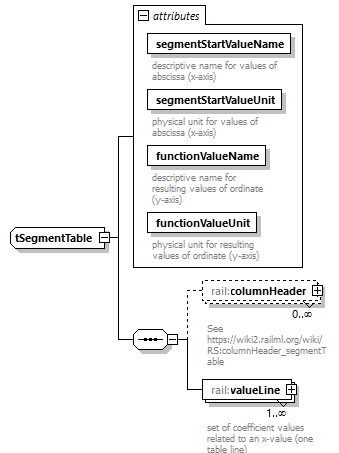 | ||||||||||||||||||||||||||||||||||||||
| namespace | https://www.railml.org/schemas/2021 | ||||||||||||||||||||||||||||||||||||||
| children | rail:columnHeader rail:valueLine | ||||||||||||||||||||||||||||||||||||||
| used by |
| ||||||||||||||||||||||||||||||||||||||
| attributes |
| ||||||||||||||||||||||||||||||||||||||
| source | <xs:complexType name="tSegmentTable"> <xs:sequence> <xs:element name="columnHeader" minOccurs="0" maxOccurs="unbounded"> <xs:annotation> <xs:documentation>See https://wiki2.railml.org/wiki/RS:columnHeader_segmentTable</xs:documentation> </xs:annotation> <xs:complexType> <xs:attribute name="exponentValue" type="xs:integer" use="required"> <xs:annotation> <xs:documentation>the value used as exponent for the related x-value</xs:documentation> <xs:documentation>See https://wiki2.railml.org/wiki/RS:columnHeader_segmentTable</xs:documentation> </xs:annotation> </xs:attribute> </xs:complexType> </xs:element> <xs:element name="valueLine" maxOccurs="unbounded"> <xs:annotation> <xs:documentation>set of coefficient values related to an x-value (one table line)</xs:documentation> <xs:documentation>See https://wiki2.railml.org/wiki/RS:valueLine_segmentTable</xs:documentation> </xs:annotation> <xs:complexType> <xs:sequence> <xs:element name="values" maxOccurs="unbounded"> <xs:annotation> <xs:documentation>the coefficient values related to an x-value themselves</xs:documentation> <xs:documentation>See https://wiki2.railml.org/wiki/RS:values_valueLine_segmentTable</xs:documentation> </xs:annotation> <xs:complexType> <xs:attribute name="coefficentValue" type="xs:decimal" use="required"> <xs:annotation> <xs:documentation>value of coefficent for the exponent in this line (row)</xs:documentation> </xs:annotation> </xs:attribute> </xs:complexType> </xs:element> </xs:sequence> <xs:attribute name="segmentStartValue" type="xs:decimal" use="required"> <xs:annotation> <xs:documentation>the starting x-value of the segment for abscissa (x-axis)</xs:documentation> </xs:annotation> </xs:attribute> </xs:complexType> </xs:element> </xs:sequence> <xs:attribute name="segmentStartValueName" type="rail:tElementDescription" use="required"> <xs:annotation> <xs:documentation>descriptive name for values of abscissa (x-axis)</xs:documentation> </xs:annotation> </xs:attribute> <xs:attribute name="segmentStartValueUnit" type="rail:tUnitName" use="required"> <xs:annotation> <xs:documentation>physical unit for values of abscissa (x-axis)</xs:documentation> </xs:annotation> </xs:attribute> <xs:attribute name="functionValueName" type="rail:tElementDescription" use="required"> <xs:annotation> <xs:documentation>descriptive name for resulting values of ordinate (y-axis)</xs:documentation> </xs:annotation> </xs:attribute> <xs:attribute name="functionValueUnit" type="rail:tUnitName" use="required"> <xs:annotation> <xs:documentation>physical unit for resulting values of ordinate (y-axis)</xs:documentation> </xs:annotation> </xs:attribute> </xs:complexType> |
attribute tSegmentTable/@segmentStartValueName
| type | rail:tElementDescription | ||
| properties |
| ||
| annotation |
| ||
| source | <xs:attribute name="segmentStartValueName" type="rail:tElementDescription" use="required"> <xs:annotation> <xs:documentation>descriptive name for values of abscissa (x-axis)</xs:documentation> </xs:annotation> </xs:attribute> |
attribute tSegmentTable/@segmentStartValueUnit
| type | rail:tUnitName | ||
| properties |
| ||
| annotation |
| ||
| source | <xs:attribute name="segmentStartValueUnit" type="rail:tUnitName" use="required"> <xs:annotation> <xs:documentation>physical unit for values of abscissa (x-axis)</xs:documentation> </xs:annotation> </xs:attribute> |
attribute tSegmentTable/@functionValueName
| type | rail:tElementDescription | ||
| properties |
| ||
| annotation |
| ||
| source | <xs:attribute name="functionValueName" type="rail:tElementDescription" use="required"> <xs:annotation> <xs:documentation>descriptive name for resulting values of ordinate (y-axis)</xs:documentation> </xs:annotation> </xs:attribute> |
attribute tSegmentTable/@functionValueUnit
| type | rail:tUnitName | ||
| properties |
| ||
| annotation |
| ||
| source | <xs:attribute name="functionValueUnit" type="rail:tUnitName" use="required"> <xs:annotation> <xs:documentation>physical unit for resulting values of ordinate (y-axis)</xs:documentation> </xs:annotation> </xs:attribute> |
element tSegmentTable/columnHeader
| diagram |  | ||||||||||||||||
| namespace | https://www.railml.org/schemas/2021 | ||||||||||||||||
| properties |
| ||||||||||||||||
| attributes |
| ||||||||||||||||
| annotation |
| ||||||||||||||||
| source | <xs:element name="columnHeader" minOccurs="0" maxOccurs="unbounded"> <xs:annotation> <xs:documentation>See https://wiki2.railml.org/wiki/RS:columnHeader_segmentTable</xs:documentation> </xs:annotation> <xs:complexType> <xs:attribute name="exponentValue" type="xs:integer" use="required"> <xs:annotation> <xs:documentation>the value used as exponent for the related x-value</xs:documentation> <xs:documentation>See https://wiki2.railml.org/wiki/RS:columnHeader_segmentTable</xs:documentation> </xs:annotation> </xs:attribute> </xs:complexType> </xs:element> |
attribute tSegmentTable/columnHeader/@exponentValue
| type | xs:integer | ||||
| properties |
| ||||
| annotation |
| ||||
| source | <xs:attribute name="exponentValue" type="xs:integer" use="required"> <xs:annotation> <xs:documentation>the value used as exponent for the related x-value</xs:documentation> <xs:documentation>See https://wiki2.railml.org/wiki/RS:columnHeader_segmentTable</xs:documentation> </xs:annotation> </xs:attribute> |
element tSegmentTable/valueLine
| diagram |  | ||||||||||||||
| namespace | https://www.railml.org/schemas/2021 | ||||||||||||||
| properties |
| ||||||||||||||
| children | rail:values | ||||||||||||||
| attributes |
| ||||||||||||||
| annotation |
| ||||||||||||||
| source | <xs:element name="valueLine" maxOccurs="unbounded"> <xs:annotation> <xs:documentation>set of coefficient values related to an x-value (one table line)</xs:documentation> <xs:documentation>See https://wiki2.railml.org/wiki/RS:valueLine_segmentTable</xs:documentation> </xs:annotation> <xs:complexType> <xs:sequence> <xs:element name="values" maxOccurs="unbounded"> <xs:annotation> <xs:documentation>the coefficient values related to an x-value themselves</xs:documentation> <xs:documentation>See https://wiki2.railml.org/wiki/RS:values_valueLine_segmentTable</xs:documentation> </xs:annotation> <xs:complexType> <xs:attribute name="coefficentValue" type="xs:decimal" use="required"> <xs:annotation> <xs:documentation>value of coefficent for the exponent in this line (row)</xs:documentation> </xs:annotation> </xs:attribute> </xs:complexType> </xs:element> </xs:sequence> <xs:attribute name="segmentStartValue" type="xs:decimal" use="required"> <xs:annotation> <xs:documentation>the starting x-value of the segment for abscissa (x-axis)</xs:documentation> </xs:annotation> </xs:attribute> </xs:complexType> </xs:element> |
attribute tSegmentTable/valueLine/@segmentStartValue
| type | xs:decimal | ||
| properties |
| ||
| annotation |
| ||
| source | <xs:attribute name="segmentStartValue" type="xs:decimal" use="required"> <xs:annotation> <xs:documentation>the starting x-value of the segment for abscissa (x-axis)</xs:documentation> </xs:annotation> </xs:attribute> |
element tSegmentTable/valueLine/values
| diagram | 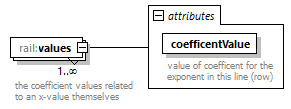 | ||||||||||||||
| namespace | https://www.railml.org/schemas/2021 | ||||||||||||||
| properties |
| ||||||||||||||
| attributes |
| ||||||||||||||
| annotation |
| ||||||||||||||
| source | <xs:element name="values" maxOccurs="unbounded"> <xs:annotation> <xs:documentation>the coefficient values related to an x-value themselves</xs:documentation> <xs:documentation>See https://wiki2.railml.org/wiki/RS:values_valueLine_segmentTable</xs:documentation> </xs:annotation> <xs:complexType> <xs:attribute name="coefficentValue" type="xs:decimal" use="required"> <xs:annotation> <xs:documentation>value of coefficent for the exponent in this line (row)</xs:documentation> </xs:annotation> </xs:attribute> </xs:complexType> </xs:element> |
attribute tSegmentTable/valueLine/values/@coefficentValue
| type | xs:decimal | ||
| properties |
| ||
| annotation |
| ||
| source | <xs:attribute name="coefficentValue" type="xs:decimal" use="required"> <xs:annotation> <xs:documentation>value of coefficent for the exponent in this line (row)</xs:documentation> </xs:annotation> </xs:attribute> |
complexType tSpecificTransmissionModule
| diagram |  | ||||||||||||||||||||||||||||||||||||||||||||||||||||||||||||||||||||
| namespace | https://www.railml.org/schemas/2021 | ||||||||||||||||||||||||||||||||||||||||||||||||||||||||||||||||||||
| type | extension of rail:tElementWithIDAndName | ||||||||||||||||||||||||||||||||||||||||||||||||||||||||||||||||||||
| properties |
| ||||||||||||||||||||||||||||||||||||||||||||||||||||||||||||||||||||
| children | rail:additionalName | ||||||||||||||||||||||||||||||||||||||||||||||||||||||||||||||||||||
| used by |
| ||||||||||||||||||||||||||||||||||||||||||||||||||||||||||||||||||||
| attributes |
| ||||||||||||||||||||||||||||||||||||||||||||||||||||||||||||||||||||
| annotation |
| ||||||||||||||||||||||||||||||||||||||||||||||||||||||||||||||||||||
| source | <xs:complexType name="tSpecificTransmissionModule"> <xs:annotation> <xs:documentation>container for installed special transmission modules</xs:documentation> </xs:annotation> <xs:complexContent> <xs:extension base="rail:tElementWithIDAndName"> <xs:attributeGroup ref="rail:aMonitoringGeneric"/> <xs:attributeGroup ref="rail:aSpecificTransmissionModule"/> </xs:extension> </xs:complexContent> </xs:complexType> |
complexType tSpeedProfileRefRS
| diagram | 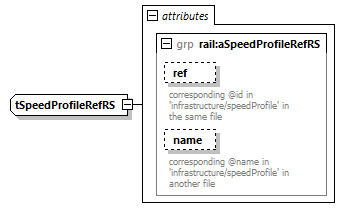 | ||||||||||||||||||||||
| namespace | https://www.railml.org/schemas/2021 | ||||||||||||||||||||||
| used by |
| ||||||||||||||||||||||
| attributes |
| ||||||||||||||||||||||
| source | <xs:complexType name="tSpeedProfileRefRS"> <xs:annotation> <xs:documentation/> </xs:annotation> <xs:attributeGroup ref="rail:aSpeedProfileRefRS"/> </xs:complexType> |
complexType tStorage
| diagram |  | ||||||||||||||||||||||||||||||||||||||||||||||||||||||||||||||||||||||||||||||||||||||||||||||||||||||||||||||
| namespace | https://www.railml.org/schemas/2021 | ||||||||||||||||||||||||||||||||||||||||||||||||||||||||||||||||||||||||||||||||||||||||||||||||||||||||||||||
| type | extension of rail:tElementWithIDAndName | ||||||||||||||||||||||||||||||||||||||||||||||||||||||||||||||||||||||||||||||||||||||||||||||||||||||||||||||
| properties |
| ||||||||||||||||||||||||||||||||||||||||||||||||||||||||||||||||||||||||||||||||||||||||||||||||||||||||||||||
| children | rail:additionalName | ||||||||||||||||||||||||||||||||||||||||||||||||||||||||||||||||||||||||||||||||||||||||||||||||||||||||||||||
| used by |
| ||||||||||||||||||||||||||||||||||||||||||||||||||||||||||||||||||||||||||||||||||||||||||||||||||||||||||||||
| attributes |
| ||||||||||||||||||||||||||||||||||||||||||||||||||||||||||||||||||||||||||||||||||||||||||||||||||||||||||||||
| annotation |
| ||||||||||||||||||||||||||||||||||||||||||||||||||||||||||||||||||||||||||||||||||||||||||||||||||||||||||||||
| source | <xs:complexType name="tStorage"> <xs:annotation> <xs:documentation>technical data of energy storage device</xs:documentation> </xs:annotation> <xs:complexContent> <xs:extension base="rail:tElementWithIDAndName"> <xs:attributeGroup ref="rail:aStorage"/> </xs:extension> </xs:complexContent> </xs:complexType> |
complexType tTechnicalStopActivity
| diagram | 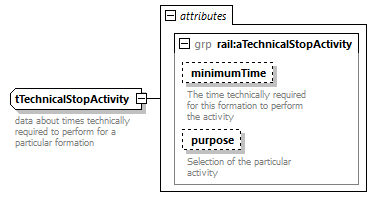 | ||||||||||||||||||||||
| namespace | https://www.railml.org/schemas/2021 | ||||||||||||||||||||||
| used by |
| ||||||||||||||||||||||
| attributes |
| ||||||||||||||||||||||
| annotation |
| ||||||||||||||||||||||
| source | <xs:complexType name="tTechnicalStopActivity"> <xs:annotation> <xs:documentation>data about times technically required to perform for a particular formation</xs:documentation> </xs:annotation> <xs:attributeGroup ref="rail:aTechnicalStopActivity"/> </xs:complexType> |
complexType tTractionInverter
| diagram |  | ||||||||||||||||||||||||||||||
| namespace | https://www.railml.org/schemas/2021 | ||||||||||||||||||||||||||||||
| used by |
| ||||||||||||||||||||||||||||||
| attributes |
| ||||||||||||||||||||||||||||||
| annotation |
| ||||||||||||||||||||||||||||||
| source | <xs:complexType name="tTractionInverter"> <xs:annotation> <xs:documentation>technical data of inverter between link circuit and motors</xs:documentation> </xs:annotation> <xs:attributeGroup ref="rail:aAssemblyNameNumber"> <xs:annotation> <xs:documentation>number of traction inverters installed per vehicle and their type description</xs:documentation> </xs:annotation> </xs:attributeGroup> <xs:attributeGroup ref="rail:aTractionInverter"/> </xs:complexType> |
complexType tTractionMotor
| diagram |  | ||||||||||||||||||||||||||||||||||||||||||||||||||||||||||||||||||||||||||||||||||||||||||||||||||||||||||||||||||||||||||||||||||||||||||||||||||||||
| namespace | https://www.railml.org/schemas/2021 | ||||||||||||||||||||||||||||||||||||||||||||||||||||||||||||||||||||||||||||||||||||||||||||||||||||||||||||||||||||||||||||||||||||||||||||||||||||||
| used by |
| ||||||||||||||||||||||||||||||||||||||||||||||||||||||||||||||||||||||||||||||||||||||||||||||||||||||||||||||||||||||||||||||||||||||||||||||||||||||
| attributes |
| ||||||||||||||||||||||||||||||||||||||||||||||||||||||||||||||||||||||||||||||||||||||||||||||||||||||||||||||||||||||||||||||||||||||||||||||||||||||
| annotation |
| ||||||||||||||||||||||||||||||||||||||||||||||||||||||||||||||||||||||||||||||||||||||||||||||||||||||||||||||||||||||||||||||||||||||||||||||||||||||
| source | <xs:complexType name="tTractionMotor"> <xs:annotation> <xs:documentation>technical data of traction motor</xs:documentation> </xs:annotation> <xs:attributeGroup ref="rail:aAssemblyNameNumber"> <xs:annotation> <xs:documentation>number of traction motors per vehicle and their type description</xs:documentation> </xs:annotation> </xs:attributeGroup> <xs:attributeGroup ref="rail:aTractionMotor"/> </xs:complexType> |
complexType tTrainEngine
| diagram |  | ||||||||||||||||||||||||||||||
| namespace | https://www.railml.org/schemas/2021 | ||||||||||||||||||||||||||||||
| used by |
| ||||||||||||||||||||||||||||||
| attributes |
| ||||||||||||||||||||||||||||||
| source | <xs:complexType name="tTrainEngine"> <xs:attributeGroup ref="rail:aTrainEngine"/> </xs:complexType> |
complexType tTrainRadio
| diagram |  | ||||||||||||||||||||||||||||||||||||||||||||||||||||||||||||||||||||
| namespace | https://www.railml.org/schemas/2021 | ||||||||||||||||||||||||||||||||||||||||||||||||||||||||||||||||||||
| type | extension of rail:tElementWithIDAndName | ||||||||||||||||||||||||||||||||||||||||||||||||||||||||||||||||||||
| properties |
| ||||||||||||||||||||||||||||||||||||||||||||||||||||||||||||||||||||
| children | rail:additionalName | ||||||||||||||||||||||||||||||||||||||||||||||||||||||||||||||||||||
| used by |
| ||||||||||||||||||||||||||||||||||||||||||||||||||||||||||||||||||||
| attributes |
| ||||||||||||||||||||||||||||||||||||||||||||||||||||||||||||||||||||
| annotation |
| ||||||||||||||||||||||||||||||||||||||||||||||||||||||||||||||||||||
| source | <xs:complexType name="tTrainRadio"> <xs:annotation> <xs:documentation>container for installed train radio systems</xs:documentation> </xs:annotation> <xs:complexContent> <xs:extension base="rail:tElementWithIDAndName"> <xs:attributeGroup ref="rail:aMonitoringGeneric"/> <xs:attributeGroup ref="rail:aTrainRadio"/> </xs:extension> </xs:complexContent> </xs:complexType> |
complexType tTrainResistance
| diagram | 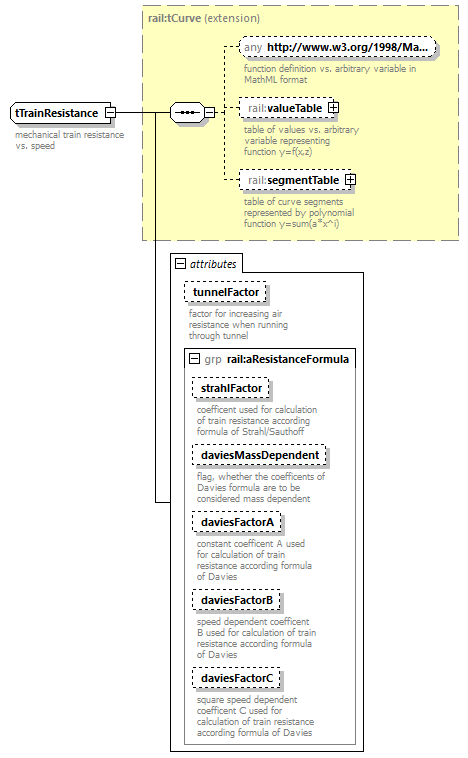 | ||||||||||||||||||||||||||||||||||||||||||||||||||||||
| namespace | https://www.railml.org/schemas/2021 | ||||||||||||||||||||||||||||||||||||||||||||||||||||||
| type | extension of rail:tCurve | ||||||||||||||||||||||||||||||||||||||||||||||||||||||
| properties |
| ||||||||||||||||||||||||||||||||||||||||||||||||||||||
| children | rail:valueTable rail:segmentTable | ||||||||||||||||||||||||||||||||||||||||||||||||||||||
| used by |
| ||||||||||||||||||||||||||||||||||||||||||||||||||||||
| attributes |
| ||||||||||||||||||||||||||||||||||||||||||||||||||||||
| annotation |
| ||||||||||||||||||||||||||||||||||||||||||||||||||||||
| source | <xs:complexType name="tTrainResistance"> <xs:annotation> <xs:documentation>mechanical train resistance vs. speed</xs:documentation> </xs:annotation> <xs:complexContent> <xs:extension base="rail:tCurve"> <xs:attribute name="tunnelFactor" type="xs:decimal"> <xs:annotation> <xs:documentation>factor for increasing air resistance when running through tunnel</xs:documentation> </xs:annotation> </xs:attribute> <xs:attributeGroup ref="rail:aResistanceFormula"/> </xs:extension> </xs:complexContent> </xs:complexType> |
attribute tTrainResistance/@tunnelFactor
| type | xs:decimal | ||
| annotation |
| ||
| source | <xs:attribute name="tunnelFactor" type="xs:decimal"> <xs:annotation> <xs:documentation>factor for increasing air resistance when running through tunnel</xs:documentation> </xs:annotation> </xs:attribute> |
complexType tTransformer
| diagram | 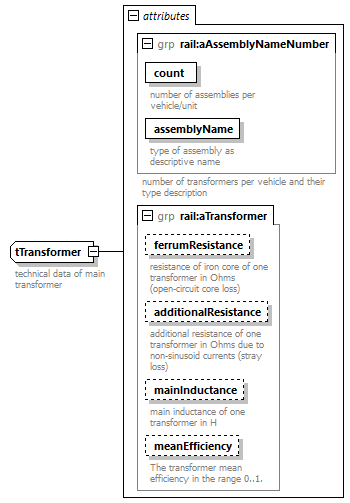 | ||||||||||||||||||||||||||||||||||||||||||||||||||||||
| namespace | https://www.railml.org/schemas/2021 | ||||||||||||||||||||||||||||||||||||||||||||||||||||||
| used by |
| ||||||||||||||||||||||||||||||||||||||||||||||||||||||
| attributes |
| ||||||||||||||||||||||||||||||||||||||||||||||||||||||
| annotation |
| ||||||||||||||||||||||||||||||||||||||||||||||||||||||
| source | <xs:complexType name="tTransformer"> <xs:annotation> <xs:documentation>technical data of main transformer</xs:documentation> </xs:annotation> <xs:attributeGroup ref="rail:aAssemblyNameNumber"> <xs:annotation> <xs:documentation>number of transformers per vehicle and their type description</xs:documentation> </xs:annotation> </xs:attributeGroup> <xs:attributeGroup ref="rail:aTransformer"/> </xs:complexType> |
complexType tValueTable
| diagram | 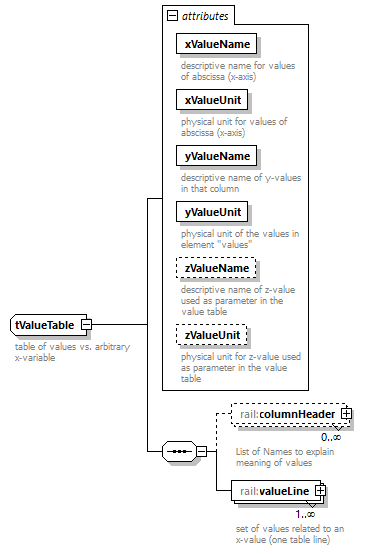 | ||||||||||||||||||||||||||||||||||||||||||||||||||||||
| namespace | https://www.railml.org/schemas/2021 | ||||||||||||||||||||||||||||||||||||||||||||||||||||||
| children | rail:columnHeader rail:valueLine | ||||||||||||||||||||||||||||||||||||||||||||||||||||||
| used by |
| ||||||||||||||||||||||||||||||||||||||||||||||||||||||
| attributes |
| ||||||||||||||||||||||||||||||||||||||||||||||||||||||
| annotation |
| ||||||||||||||||||||||||||||||||||||||||||||||||||||||
| source | <xs:complexType name="tValueTable"> <xs:annotation> <xs:documentation>table of values vs. arbitrary x-variable</xs:documentation> </xs:annotation> <xs:sequence> <xs:element name="columnHeader" minOccurs="0" maxOccurs="unbounded"> <xs:annotation> <xs:documentation>List of Names to explain meaning of values</xs:documentation> <xs:documentation>See https://wiki2.railml.org/wiki/RS:columnHeader_valueTable</xs:documentation> </xs:annotation> <xs:complexType> <xs:attribute name="zValue" type="xs:decimal" use="required"> <xs:annotation> <xs:documentation>z-value itself as parameter in the value table</xs:documentation> </xs:annotation> </xs:attribute> </xs:complexType> </xs:element> <xs:element name="valueLine" maxOccurs="unbounded"> <xs:annotation> <xs:documentation>set of values related to an x-value (one table line)</xs:documentation> <xs:documentation>See https://wiki2.railml.org/wiki/RS:valueLine_valueTable</xs:documentation> </xs:annotation> <xs:complexType> <xs:sequence> <xs:element name="values" maxOccurs="unbounded"> <xs:annotation> <xs:documentation>the values related to an x-value themselves</xs:documentation> <xs:documentation>See https://wiki2.railml.org/wiki/RS:values_valueLine_valueTable</xs:documentation> </xs:annotation> <xs:complexType> <xs:attribute name="yValue" type="xs:decimal" use="required"> <xs:annotation> <xs:documentation>value of ordinate (y-axis) for this line (row)</xs:documentation> </xs:annotation> </xs:attribute> </xs:complexType> </xs:element> </xs:sequence> <xs:attribute name="xValue" type="xs:decimal" use="required"> <xs:annotation> <xs:documentation>values of abscissa (x-axis) for this line (row)</xs:documentation> </xs:annotation> </xs:attribute> </xs:complexType> </xs:element> </xs:sequence> <xs:attribute name="xValueName" type="rail:tElementDescription" use="required"> <xs:annotation> <xs:documentation>descriptive name for values of abscissa (x-axis)</xs:documentation> </xs:annotation> </xs:attribute> <xs:attribute name="xValueUnit" type="rail:tUnitName" use="required"> <xs:annotation> <xs:documentation>physical unit for values of abscissa (x-axis)</xs:documentation> </xs:annotation> </xs:attribute> <xs:attribute name="yValueName" type="rail:tElementDescription" use="required"> <xs:annotation> <xs:documentation>descriptive name of y-values in that column</xs:documentation> </xs:annotation> </xs:attribute> <xs:attribute name="yValueUnit" type="rail:tUnitName" use="required"> <xs:annotation> <xs:documentation>physical unit of the values in element "values"</xs:documentation> </xs:annotation> </xs:attribute> <xs:attribute name="zValueName" type="rail:tElementDescription"> <xs:annotation> <xs:documentation>descriptive name of z-value used as parameter in the value table</xs:documentation> </xs:annotation> </xs:attribute> <xs:attribute name="zValueUnit" type="rail:tUnitName"> <xs:annotation> <xs:documentation>physical unit for z-value used as parameter in the value table</xs:documentation> </xs:annotation> </xs:attribute> </xs:complexType> |
attribute tValueTable/@xValueName
| type | rail:tElementDescription | ||
| properties |
| ||
| annotation |
| ||
| source | <xs:attribute name="xValueName" type="rail:tElementDescription" use="required"> <xs:annotation> <xs:documentation>descriptive name for values of abscissa (x-axis)</xs:documentation> </xs:annotation> </xs:attribute> |
attribute tValueTable/@xValueUnit
| type | rail:tUnitName | ||
| properties |
| ||
| annotation |
| ||
| source | <xs:attribute name="xValueUnit" type="rail:tUnitName" use="required"> <xs:annotation> <xs:documentation>physical unit for values of abscissa (x-axis)</xs:documentation> </xs:annotation> </xs:attribute> |
attribute tValueTable/@yValueName
| type | rail:tElementDescription | ||
| properties |
| ||
| annotation |
| ||
| source | <xs:attribute name="yValueName" type="rail:tElementDescription" use="required"> <xs:annotation> <xs:documentation>descriptive name of y-values in that column</xs:documentation> </xs:annotation> </xs:attribute> |
attribute tValueTable/@yValueUnit
| type | rail:tUnitName | ||
| properties |
| ||
| annotation |
| ||
| source | <xs:attribute name="yValueUnit" type="rail:tUnitName" use="required"> <xs:annotation> <xs:documentation>physical unit of the values in element "values"</xs:documentation> </xs:annotation> </xs:attribute> |
attribute tValueTable/@zValueName
| type | rail:tElementDescription | ||
| annotation |
| ||
| source | <xs:attribute name="zValueName" type="rail:tElementDescription"> <xs:annotation> <xs:documentation>descriptive name of z-value used as parameter in the value table</xs:documentation> </xs:annotation> </xs:attribute> |
attribute tValueTable/@zValueUnit
| type | rail:tUnitName | ||
| annotation |
| ||
| source | <xs:attribute name="zValueUnit" type="rail:tUnitName"> <xs:annotation> <xs:documentation>physical unit for z-value used as parameter in the value table</xs:documentation> </xs:annotation> </xs:attribute> |
element tValueTable/columnHeader
| diagram |  | ||||||||||||||
| namespace | https://www.railml.org/schemas/2021 | ||||||||||||||
| properties |
| ||||||||||||||
| attributes |
| ||||||||||||||
| annotation |
| ||||||||||||||
| source | <xs:element name="columnHeader" minOccurs="0" maxOccurs="unbounded"> <xs:annotation> <xs:documentation>List of Names to explain meaning of values</xs:documentation> <xs:documentation>See https://wiki2.railml.org/wiki/RS:columnHeader_valueTable</xs:documentation> </xs:annotation> <xs:complexType> <xs:attribute name="zValue" type="xs:decimal" use="required"> <xs:annotation> <xs:documentation>z-value itself as parameter in the value table</xs:documentation> </xs:annotation> </xs:attribute> </xs:complexType> </xs:element> |
attribute tValueTable/columnHeader/@zValue
| type | xs:decimal | ||
| properties |
| ||
| annotation |
| ||
| source | <xs:attribute name="zValue" type="xs:decimal" use="required"> <xs:annotation> <xs:documentation>z-value itself as parameter in the value table</xs:documentation> </xs:annotation> </xs:attribute> |
element tValueTable/valueLine
| diagram |  | ||||||||||||||
| namespace | https://www.railml.org/schemas/2021 | ||||||||||||||
| properties |
| ||||||||||||||
| children | rail:values | ||||||||||||||
| attributes |
| ||||||||||||||
| annotation |
| ||||||||||||||
| source | <xs:element name="valueLine" maxOccurs="unbounded"> <xs:annotation> <xs:documentation>set of values related to an x-value (one table line)</xs:documentation> <xs:documentation>See https://wiki2.railml.org/wiki/RS:valueLine_valueTable</xs:documentation> </xs:annotation> <xs:complexType> <xs:sequence> <xs:element name="values" maxOccurs="unbounded"> <xs:annotation> <xs:documentation>the values related to an x-value themselves</xs:documentation> <xs:documentation>See https://wiki2.railml.org/wiki/RS:values_valueLine_valueTable</xs:documentation> </xs:annotation> <xs:complexType> <xs:attribute name="yValue" type="xs:decimal" use="required"> <xs:annotation> <xs:documentation>value of ordinate (y-axis) for this line (row)</xs:documentation> </xs:annotation> </xs:attribute> </xs:complexType> </xs:element> </xs:sequence> <xs:attribute name="xValue" type="xs:decimal" use="required"> <xs:annotation> <xs:documentation>values of abscissa (x-axis) for this line (row)</xs:documentation> </xs:annotation> </xs:attribute> </xs:complexType> </xs:element> |
attribute tValueTable/valueLine/@xValue
| type | xs:decimal | ||
| properties |
| ||
| annotation |
| ||
| source | <xs:attribute name="xValue" type="xs:decimal" use="required"> <xs:annotation> <xs:documentation>values of abscissa (x-axis) for this line (row)</xs:documentation> </xs:annotation> </xs:attribute> |
element tValueTable/valueLine/values
| diagram |  | ||||||||||||||
| namespace | https://www.railml.org/schemas/2021 | ||||||||||||||
| properties |
| ||||||||||||||
| attributes |
| ||||||||||||||
| annotation |
| ||||||||||||||
| source | <xs:element name="values" maxOccurs="unbounded"> <xs:annotation> <xs:documentation>the values related to an x-value themselves</xs:documentation> <xs:documentation>See https://wiki2.railml.org/wiki/RS:values_valueLine_valueTable</xs:documentation> </xs:annotation> <xs:complexType> <xs:attribute name="yValue" type="xs:decimal" use="required"> <xs:annotation> <xs:documentation>value of ordinate (y-axis) for this line (row)</xs:documentation> </xs:annotation> </xs:attribute> </xs:complexType> </xs:element> |
attribute tValueTable/valueLine/values/@yValue
| type | xs:decimal | ||
| properties |
| ||
| annotation |
| ||
| source | <xs:attribute name="yValue" type="xs:decimal" use="required"> <xs:annotation> <xs:documentation>value of ordinate (y-axis) for this line (row)</xs:documentation> </xs:annotation> </xs:attribute> |
complexType tVehicle
| diagram |  | ||||||||||||||||||||||||||||||||||||||||||||||||||||||||||||||||||||||||||||||||||||||||||||||||||||||||||||||||||||||||||||||||||||||||||||||||||||||||||||||||||||||||||||||||||||||||||||||||||||||||||||||||||||||
| namespace | https://www.railml.org/schemas/2021 | ||||||||||||||||||||||||||||||||||||||||||||||||||||||||||||||||||||||||||||||||||||||||||||||||||||||||||||||||||||||||||||||||||||||||||||||||||||||||||||||||||||||||||||||||||||||||||||||||||||||||||||||||||||||
| type | extension of rail:tElementWithIDAndName | ||||||||||||||||||||||||||||||||||||||||||||||||||||||||||||||||||||||||||||||||||||||||||||||||||||||||||||||||||||||||||||||||||||||||||||||||||||||||||||||||||||||||||||||||||||||||||||||||||||||||||||||||||||||
| properties |
| ||||||||||||||||||||||||||||||||||||||||||||||||||||||||||||||||||||||||||||||||||||||||||||||||||||||||||||||||||||||||||||||||||||||||||||||||||||||||||||||||||||||||||||||||||||||||||||||||||||||||||||||||||||||
| children | rail:additionalName rail:states | ||||||||||||||||||||||||||||||||||||||||||||||||||||||||||||||||||||||||||||||||||||||||||||||||||||||||||||||||||||||||||||||||||||||||||||||||||||||||||||||||||||||||||||||||||||||||||||||||||||||||||||||||||||||
| used by |
| ||||||||||||||||||||||||||||||||||||||||||||||||||||||||||||||||||||||||||||||||||||||||||||||||||||||||||||||||||||||||||||||||||||||||||||||||||||||||||||||||||||||||||||||||||||||||||||||||||||||||||||||||||||||
| attributes |
| ||||||||||||||||||||||||||||||||||||||||||||||||||||||||||||||||||||||||||||||||||||||||||||||||||||||||||||||||||||||||||||||||||||||||||||||||||||||||||||||||||||||||||||||||||||||||||||||||||||||||||||||||||||||
| annotation |
| ||||||||||||||||||||||||||||||||||||||||||||||||||||||||||||||||||||||||||||||||||||||||||||||||||||||||||||||||||||||||||||||||||||||||||||||||||||||||||||||||||||||||||||||||||||||||||||||||||||||||||||||||||||||
| source | <xs:complexType name="tVehicle"> <xs:annotation> <xs:documentation>vehicle related data</xs:documentation> </xs:annotation> <xs:complexContent> <xs:extension base="rail:tElementWithIDAndName"> <xs:sequence> <xs:element name="states" type="rail:tStates" minOccurs="0"> <xs:annotation> <xs:documentation>Container to define various life cycle status of the vehicle</xs:documentation> <xs:documentation>See https://wiki2.railml.org/wiki/RS:states</xs:documentation> </xs:annotation> </xs:element> </xs:sequence> <xs:attributeGroup ref="rail:aVehicle"/> </xs:extension> </xs:complexContent> </xs:complexType> |
element tVehicle/states
| diagram |  | ||||||
| namespace | https://www.railml.org/schemas/2021 | ||||||
| type | rail:tStates | ||||||
| properties |
| ||||||
| children | rail:state | ||||||
| annotation |
| ||||||
| source | <xs:element name="states" type="rail:tStates" minOccurs="0"> <xs:annotation> <xs:documentation>Container to define various life cycle status of the vehicle</xs:documentation> <xs:documentation>See https://wiki2.railml.org/wiki/RS:states</xs:documentation> </xs:annotation> </xs:element> |
complexType tVehicleIdentification
| diagram |  | ||||||||||||||||||||||||||||||
| namespace | https://www.railml.org/schemas/2021 | ||||||||||||||||||||||||||||||
| used by |
| ||||||||||||||||||||||||||||||
| attributes |
| ||||||||||||||||||||||||||||||
| annotation |
| ||||||||||||||||||||||||||||||
| source | <xs:complexType name="tVehicleIdentification"> <xs:annotation> <xs:documentation>container for the vehicle identification described by EU paper DV51EN01 annex P or UIC 438</xs:documentation> </xs:annotation> <xs:attributeGroup ref="rail:aVehicleIdentification"/> </xs:complexType> |
complexType tVehicleRef
| diagram |  | ||||||||||||||||||||||||||||||||||||||||||||||
| namespace | https://www.railml.org/schemas/2021 | ||||||||||||||||||||||||||||||||||||||||||||||
| used by |
| ||||||||||||||||||||||||||||||||||||||||||||||
| attributes |
| ||||||||||||||||||||||||||||||||||||||||||||||
| source | <xs:complexType name="tVehicleRef"> <xs:attributeGroup ref="rail:aVehicleRef"/> </xs:complexType> |
complexType tWagon
| diagram | 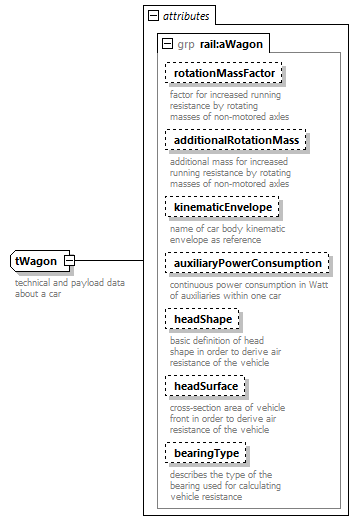 | ||||||||||||||||||||||||||||||||||||||||||||||||||||||||||||||
| namespace | https://www.railml.org/schemas/2021 | ||||||||||||||||||||||||||||||||||||||||||||||||||||||||||||||
| used by |
| ||||||||||||||||||||||||||||||||||||||||||||||||||||||||||||||
| attributes |
| ||||||||||||||||||||||||||||||||||||||||||||||||||||||||||||||
| annotation |
| ||||||||||||||||||||||||||||||||||||||||||||||||||||||||||||||
| source | <xs:complexType name="tWagon"> <xs:annotation> <xs:documentation>technical and payload data about a car</xs:documentation> </xs:annotation> <xs:attributeGroup ref="rail:aWagon"/> </xs:complexType> |
complexType tWinding
| diagram |  | ||||||||||||||||||||||||||||||||||||||||||||||||||||||||||||||||||||||
| namespace | https://www.railml.org/schemas/2021 | ||||||||||||||||||||||||||||||||||||||||||||||||||||||||||||||||||||||
| used by |
| ||||||||||||||||||||||||||||||||||||||||||||||||||||||||||||||||||||||
| attributes |
| ||||||||||||||||||||||||||||||||||||||||||||||||||||||||||||||||||||||
| annotation |
| ||||||||||||||||||||||||||||||||||||||||||||||||||||||||||||||||||||||
| source | <xs:complexType name="tWinding"> <xs:annotation> <xs:documentation>technical data of transformer winding</xs:documentation> </xs:annotation> <xs:attributeGroup ref="rail:aWinding"/> </xs:complexType> |
simpleType tAcousticSignalType
| namespace | https://www.railml.org/schemas/2021 | ||
| type | union of (restriction of xs:string, rail:tOtherEnumerationValue) | ||
| used by |
| ||
| source | <xs:simpleType name="tAcousticSignalType"> <xs:union> <xs:simpleType> <xs:restriction base="xs:string"> <xs:enumeration value="none"/> <xs:enumeration value="bell"/> <xs:enumeration value="alarmBell"/> <xs:enumeration value="horn"/> <xs:enumeration value="airChime"/> <xs:enumeration value="whistle"/> </xs:restriction> </xs:simpleType> <xs:simpleType> <xs:restriction base="rail:tOtherEnumerationValue"/> </xs:simpleType> </xs:union> </xs:simpleType> |
simpleType tAxleDriveType
| namespace | https://www.railml.org/schemas/2021 | ||
| type | union of (restriction of xs:string, rail:tOtherEnumerationValue) | ||
| used by |
| ||
| source | <xs:simpleType name="tAxleDriveType"> <xs:union> <xs:simpleType> <xs:restriction base="xs:string"> <xs:enumeration value="cardanShaft"/> <xs:enumeration value="tubularAxle"/> <xs:enumeration value="noseSuspensionDrive"/> <xs:enumeration value="helicalSpringGear"/> <xs:enumeration value="rubberRingResilientDrive"/> <xs:enumeration value="buchliDrive"/> <xs:enumeration value="inclinedRodDrive"/> <xs:enumeration value="sideRodDrive"/> <xs:enumeration value="chain"/> </xs:restriction> </xs:simpleType> <xs:simpleType> <xs:restriction base="rail:tOtherEnumerationValue"/> </xs:simpleType> </xs:union> </xs:simpleType> |
simpleType tBearingType
| namespace | https://www.railml.org/schemas/2021 | ||
| type | union of (restriction of xs:string, rail:tOtherEnumerationValue) | ||
| used by |
| ||
| source | <xs:simpleType name="tBearingType"> <xs:union> <xs:simpleType> <xs:restriction base="xs:string"> <xs:enumeration value="rollerBearing"/> <xs:enumeration value="ballBearing"/> <xs:enumeration value="plainBearing"/> </xs:restriction> </xs:simpleType> <xs:simpleType> <xs:restriction base="rail:tOtherEnumerationValue"/> </xs:simpleType> </xs:union> </xs:simpleType> |
simpleType tCabPositionType
| namespace | https://www.railml.org/schemas/2021 | |||||||||||||||
| type | restriction of xs:string | |||||||||||||||
| properties |
| |||||||||||||||
| used by |
| |||||||||||||||
| facets |
| |||||||||||||||
| source | <xs:simpleType name="tCabPositionType"> <xs:restriction base="xs:string"> <xs:enumeration value="none"/> <xs:enumeration value="front"/> <xs:enumeration value="middle"/> <xs:enumeration value="rear"/> </xs:restriction> </xs:simpleType> |
simpleType tElectricalCouplerDesignType
| namespace | https://www.railml.org/schemas/2021 | ||
| type | union of (restriction of xs:string, rail:tOtherEnumerationValue) | ||
| used by |
| ||
| source | <xs:simpleType name="tElectricalCouplerDesignType"> <xs:union> <xs:simpleType> <xs:restriction base="xs:string"> <xs:enumeration value="unknown"/> <xs:enumeration value="pushTrainControl36"/> <xs:enumeration value="pushTrainControl34"/> <xs:enumeration value="emergencyBrakeDeactivation"/> <xs:enumeration value="UIC-IS-cable21"/> <xs:enumeration value="UIC556"/> <xs:enumeration value="UIC558-18"/> <xs:enumeration value="UIC568-13"/> <xs:enumeration value="wireTrainBus"/> <xs:enumeration value="multifunctionVehicleBus"/> <xs:enumeration value="trainCommunicationNetwork"/> <xs:enumeration value="vehicleSpecificConnection"/> <xs:enumeration value="fibreOptics"/> </xs:restriction> </xs:simpleType> <xs:simpleType> <xs:restriction base="rail:tOtherEnumerationValue"/> </xs:simpleType> </xs:union> </xs:simpleType> |
simpleType tEndPositionType
| namespace | https://www.railml.org/schemas/2021 | ||||||||||||
| type | restriction of xs:string | ||||||||||||
| properties |
| ||||||||||||
| used by |
| ||||||||||||
| facets |
| ||||||||||||
| source | <xs:simpleType name="tEndPositionType"> <xs:restriction base="xs:string"> <xs:enumeration value="both"/> <xs:enumeration value="front"/> <xs:enumeration value="rear"/> </xs:restriction> </xs:simpleType> |
simpleType tFreightCarType
| namespace | https://www.railml.org/schemas/2021 | ||
| type | union of (restriction of xs:string, rail:tOtherEnumerationValue) | ||
| used by |
| ||
| source | <xs:simpleType name="tFreightCarType"> <xs:union> <xs:simpleType> <xs:restriction base="xs:string"> <xs:enumeration value="open"/> <xs:enumeration value="covered"/> <xs:enumeration value="platform"/> <xs:enumeration value="refrigerated"/> <xs:enumeration value="tank"/> <xs:enumeration value="self-discharging"/> <xs:enumeration value="special"/> </xs:restriction> </xs:simpleType> <xs:simpleType> <xs:restriction base="rail:tOtherEnumerationValue"/> </xs:simpleType> </xs:union> </xs:simpleType> |
simpleType tGangwayDesignType
| namespace | https://www.railml.org/schemas/2021 | ||
| type | union of (restriction of xs:string, rail:tOtherEnumerationValue) | ||
| used by |
| ||
| source | <xs:simpleType name="tGangwayDesignType"> <xs:union> <xs:simpleType> <xs:restriction base="xs:string"> <xs:enumeration value="unknown"/> <xs:enumeration value="standardUIC561"/> <xs:enumeration value="special"/> <xs:enumeration value="nonPublic"/> <xs:enumeration value="sigI"/> <xs:enumeration value="sigII"/> </xs:restriction> </xs:simpleType> <xs:simpleType> <xs:restriction base="rail:tOtherEnumerationValue"/> </xs:simpleType> </xs:union> </xs:simpleType> |
simpleType tGangwayPosition
| namespace | https://www.railml.org/schemas/2021 | ||
| type | union of (restriction of xs:string, rail:tOtherEnumerationValue) | ||
| used by |
| ||
| source | <xs:simpleType name="tGangwayPosition"> <xs:union> <xs:simpleType> <xs:restriction base="xs:string"> <xs:enumeration value="standardUIC"/> <xs:enumeration value="upperDeck"/> <xs:enumeration value="lowerDeck"/> </xs:restriction> </xs:simpleType> <xs:simpleType> <xs:restriction base="rail:tOtherEnumerationValue"/> </xs:simpleType> </xs:union> </xs:simpleType> |
simpleType tHeadShapeType
| namespace | https://www.railml.org/schemas/2021 | ||
| type | union of (restriction of xs:string, rail:tOtherEnumerationValue) | ||
| used by |
| ||
| source | <xs:simpleType name="tHeadShapeType"> <xs:union> <xs:simpleType> <xs:restriction base="xs:string"> <xs:enumeration value="angular"/> <xs:enumeration value="rounded"/> <xs:enumeration value="streamlined"/> </xs:restriction> </xs:simpleType> <xs:simpleType> <xs:restriction base="rail:tOtherEnumerationValue"/> </xs:simpleType> </xs:union> </xs:simpleType> |
simpleType tLoadSwitch
| namespace | https://www.railml.org/schemas/2021 | |||||||||
| type | restriction of xs:string | |||||||||
| properties |
| |||||||||
| used by |
| |||||||||
| facets |
| |||||||||
| source | <xs:simpleType name="tLoadSwitch"> <xs:restriction base="xs:string"> <xs:enumeration value="empty"/> <xs:enumeration value="full"/> </xs:restriction> </xs:simpleType> |
simpleType tMechanicalCouplerDesignType
| namespace | https://www.railml.org/schemas/2021 | ||
| type | union of (restriction of xs:string, rail:tOtherEnumerationValue) | ||
| used by |
| ||
| source | <xs:simpleType name="tMechanicalCouplerDesignType"> <xs:union> <xs:simpleType> <xs:restriction base="xs:string"> <xs:enumeration value="unknown"/> <xs:enumeration value="AAR_KnuckleCoupler"/> <xs:enumeration value="AK69e"/> <xs:enumeration value="AlbertCoupler"/> <xs:enumeration value="APTA_tightlock"/> <xs:enumeration value="BSI_compact"/> <xs:enumeration value="BSI_shunting"/> <xs:enumeration value="buckeyeKnuckleCoupler"/> <xs:enumeration value="BuddPinCup"/> <xs:enumeration value="buffersChainScrewCoupler"/> <xs:enumeration value="C-AKv"/> <xs:enumeration value="centralBuffer1Chain"/> <xs:enumeration value="centralBuffer2Chains"/> <xs:enumeration value="FK-3-2.5"/> <xs:enumeration value="FK-5.5-4"/> <xs:enumeration value="FK-9-6"/> <xs:enumeration value="FK-15-10"/> <xs:enumeration value="FK-15-12"/> <xs:enumeration value="GF_Coupler"/> <xs:enumeration value="GFN"/> <xs:enumeration value="GFT"/> <xs:enumeration value="GFV"/> <xs:enumeration value="Intermat"/> <xs:enumeration value="linkPin_flat"/> <xs:enumeration value="linkPin_round"/> <xs:enumeration value="NorwegianMeatChopper"/> <xs:enumeration value="SA3_WillisonCoupler"/> <xs:enumeration value="Scharfenberg"/> <xs:enumeration value="Scharfenberg10"/> <xs:enumeration value="Scharfenberg35"/> <xs:enumeration value="Scharfenberg55"/> <xs:enumeration value="Scharfenberg140"/> <xs:enumeration value="Scharfenberg330"/> <xs:enumeration value="Scharfenberg430"/> <xs:enumeration value="SchwabCoupler"/> <xs:enumeration value="Wedgelock"/> </xs:restriction> </xs:simpleType> <xs:simpleType> <xs:restriction base="rail:tOtherEnumerationValue"/> </xs:simpleType> </xs:union> </xs:simpleType> |
simpleType tModulationType
| namespace | https://www.railml.org/schemas/2021 | ||
| type | union of (restriction of xs:string, rail:tOtherEnumerationValue) | ||
| used by |
| ||
| source | <xs:simpleType name="tModulationType"> <xs:union> <xs:simpleType> <xs:restriction base="xs:string"> <xs:enumeration value="analogue"/> <xs:enumeration value="digital"/> </xs:restriction> </xs:simpleType> <xs:simpleType> <xs:restriction base="rail:tOtherEnumerationValue"/> </xs:simpleType> </xs:union> </xs:simpleType> |
simpleType tMotivePowerType
| namespace | https://www.railml.org/schemas/2021 | ||
| type | union of (restriction of xs:string, rail:tOtherEnumerationValue) | ||
| used by |
| ||
| source | <xs:simpleType name="tMotivePowerType"> <xs:union> <xs:simpleType> <xs:restriction base="xs:string"> <xs:enumeration value="electric"/> <xs:enumeration value="diesel"/> <xs:enumeration value="steam"/> </xs:restriction> </xs:simpleType> <xs:simpleType> <xs:restriction base="rail:tOtherEnumerationValue"/> </xs:simpleType> </xs:union> </xs:simpleType> |
simpleType tPantographControlType
| namespace | https://www.railml.org/schemas/2021 | ||
| type | union of (restriction of xs:string, rail:tOtherEnumerationValue) | ||
| used by |
| ||
| source | <xs:simpleType name="tPantographControlType"> <xs:union> <xs:simpleType> <xs:restriction base="xs:string"> <xs:enumeration value="cable"/> <xs:enumeration value="spring"/> <xs:enumeration value="air"/> </xs:restriction> </xs:simpleType> <xs:simpleType> <xs:restriction base="rail:tOtherEnumerationValue"/> </xs:simpleType> </xs:union> </xs:simpleType> |
simpleType tPantographPositionType
| namespace | https://www.railml.org/schemas/2021 | ||
| type | union of (restriction of xs:string, rail:tOtherEnumerationValue) | ||
| used by |
| ||
| source | <xs:simpleType name="tPantographPositionType"> <xs:union> <xs:simpleType> <xs:restriction base="xs:string"> <xs:enumeration value="front"/> <xs:enumeration value="frontSecond"/> <xs:enumeration value="middle"/> <xs:enumeration value="rearSecond"/> <xs:enumeration value="rear"/> </xs:restriction> </xs:simpleType> <xs:simpleType> <xs:restriction base="rail:tOtherEnumerationValue"/> </xs:simpleType> </xs:union> </xs:simpleType> |
simpleType tPneumaticCouplerFunctionType
| namespace | https://www.railml.org/schemas/2021 | ||
| type | union of (restriction of xs:string, rail:tOtherEnumerationValue) | ||
| used by |
| ||
| source | <xs:simpleType name="tPneumaticCouplerFunctionType"> <xs:union> <xs:simpleType> <xs:restriction base="xs:string"> <xs:enumeration value="unknown"/> <xs:enumeration value="mainAirPipe"/> <xs:enumeration value="mainAirReservoirPipe"/> <xs:enumeration value="additionalBrakeControlPipe"/> <xs:enumeration value="vacuumAirPipe"/> <xs:enumeration value="steamHeatingPipe"/> </xs:restriction> </xs:simpleType> <xs:simpleType> <xs:restriction base="rail:tOtherEnumerationValue"/> </xs:simpleType> </xs:union> </xs:simpleType> |
simpleType tPropulsionControlType
| namespace | https://www.railml.org/schemas/2021 | ||
| type | union of (restriction of xs:string, rail:tOtherEnumerationValue) | ||
| used by |
| ||
| source | <xs:simpleType name="tPropulsionControlType"> <xs:union> <xs:simpleType> <xs:restriction base="xs:string"> <xs:enumeration value="unknown"/> <xs:enumeration value="camshaftControl"/> <xs:enumeration value="contactorControl"/> <xs:enumeration value="rectifier"/> <xs:enumeration value="thyristorControl"/> </xs:restriction> </xs:simpleType> <xs:simpleType> <xs:restriction base="rail:tOtherEnumerationValue"/> </xs:simpleType> </xs:union> </xs:simpleType> |
simpleType tRackSystemType
| namespace | https://www.railml.org/schemas/2021 | ||
| type | union of (restriction of xs:string, rail:tOtherEnumerationValue) | ||
| used by |
| ||
| source | <xs:simpleType name="tRackSystemType"> <xs:union> <xs:simpleType> <xs:restriction base="xs:string"> <xs:enumeration value="none"/> <xs:enumeration value="Riggenbach"/> <xs:enumeration value="Riggenbach-Klose"/> <xs:enumeration value="Abt2Bars"/> <xs:enumeration value="Abt3Bars"/> <xs:enumeration value="Locher"/> <xs:enumeration value="Strub"/> <xs:enumeration value="Wetli"/> <xs:enumeration value="Marsh"/> <xs:enumeration value="Roll"/> </xs:restriction> </xs:simpleType> <xs:simpleType> <xs:restriction base="rail:tOtherEnumerationValue"/> </xs:simpleType> </xs:union> </xs:simpleType> |
simpleType tRadioSystem
| namespace | https://www.railml.org/schemas/2021 | ||
| type | rail:tGenericName | ||
| properties |
| ||
| used by |
| ||
| annotation |
| ||
| source | <xs:simpleType name="tRadioSystem"> <xs:annotation> <xs:documentation>list of available radio systems for communication like 'GSM-R'</xs:documentation> </xs:annotation> <xs:restriction base="rail:tGenericName"/> </xs:simpleType> |
simpleType tRelatedPositionType
| namespace | https://www.railml.org/schemas/2021 | |||||||||||||||
| type | restriction of xs:string | |||||||||||||||
| properties |
| |||||||||||||||
| used by |
| |||||||||||||||
| facets |
| |||||||||||||||
| source | <xs:simpleType name="tRelatedPositionType"> <xs:restriction base="xs:string"> <xs:enumeration value="none"/> <xs:enumeration value="aside"/> <xs:enumeration value="ontop"/> <xs:enumeration value="below"/> </xs:restriction> </xs:simpleType> |
simpleType tSpeedRangeType
| namespace | https://www.railml.org/schemas/2021 | ||||||||||||
| type | restriction of xs:string | ||||||||||||
| properties |
| ||||||||||||
| used by |
| ||||||||||||
| facets |
| ||||||||||||
| source | <xs:simpleType name="tSpeedRangeType"> <xs:restriction base="xs:string"> <xs:enumeration value="dontcare"/> <xs:enumeration value="slow"/> <xs:enumeration value="fast"/> </xs:restriction> </xs:simpleType> |
simpleType tSupervisionType
| namespace | https://www.railml.org/schemas/2021 | ||
| type | union of (restriction of xs:string, rail:tOtherEnumerationValue) | ||
| used by |
| ||
| annotation |
| ||
| source | <xs:simpleType name="tSupervisionType"> <xs:annotation> <xs:documentation>list of possible brake supervision regimes causing different operational behaviour during braking</xs:documentation> </xs:annotation> <xs:union> <xs:simpleType> <xs:restriction base="xs:string"> <xs:enumeration value="none"/> <xs:enumeration value="ATP"/> <xs:enumeration value="ETCS"/> <xs:enumeration value="unknown"/> </xs:restriction> </xs:simpleType> <xs:simpleType> <xs:restriction base="rail:tOtherEnumerationValue"/> </xs:simpleType> </xs:union> </xs:simpleType> |
simpleType tTechnicalStopActivityTypes
| namespace | https://www.railml.org/schemas/2021 | ||
| type | union of (restriction of xs:string, rail:tOtherEnumerationValue) | ||
| used by |
| ||
| source | <xs:simpleType name="tTechnicalStopActivityTypes"> <xs:union> <xs:simpleType> <xs:restriction base="xs:string"> <xs:enumeration value="split"> <xs:annotation> <xs:documentation>Technical process for uncouple formations / train parts - intended for self-propelling train parts.</xs:documentation> </xs:annotation> </xs:enumeration> <xs:enumeration value="join"> <xs:annotation> <xs:documentation>Technical process for couple formations / train parts - intended for self-propelling train parts.</xs:documentation> </xs:annotation> </xs:enumeration> <xs:enumeration value="reversing-one_driver"> <xs:annotation> <xs:documentation>Technical process for reversing the train direction with one driver who needs to go from one cab to the other</xs:documentation> </xs:annotation> </xs:enumeration> <xs:enumeration value="reversing-two_driver"> <xs:annotation> <xs:documentation>Technical process for reversing train direction with two dirvers, thus without need to go from one cab to the other</xs:documentation> </xs:annotation> </xs:enumeration> </xs:restriction> </xs:simpleType> <xs:simpleType> <xs:restriction base="rail:tOtherEnumerationValue"/> </xs:simpleType> </xs:union> </xs:simpleType> |
simpleType tTorqueConversionType
| namespace | https://www.railml.org/schemas/2021 | ||
| type | union of (restriction of xs:string, rail:tOtherEnumerationValue) | ||
| used by |
| ||
| source | <xs:simpleType name="tTorqueConversionType"> <xs:union> <xs:simpleType> <xs:restriction base="xs:string"> <xs:enumeration value="converter"/> <xs:enumeration value="coupling"/> <xs:enumeration value="hydrodynamicTransmission"/> <xs:enumeration value="hydraulicTransmission"/> <xs:enumeration value="hydromechanicalTransmission"/> <xs:enumeration value="hydrostaticTransmission"/> </xs:restriction> </xs:simpleType> <xs:simpleType> <xs:restriction base="rail:tOtherEnumerationValue"/> </xs:simpleType> </xs:union> </xs:simpleType> |
simpleType tTransmission
| namespace | https://www.railml.org/schemas/2021 | ||
| type | union of (restriction of xs:string, rail:tOtherEnumerationValue) | ||
| used by |
| ||
| source | <xs:simpleType name="tTransmission"> <xs:union> <xs:simpleType> <xs:restriction base="xs:string"> <xs:enumeration value="electric"/> <xs:enumeration value="hydraulic"/> <xs:enumeration value="hydromechanical"/> <xs:enumeration value="mechanical"/> </xs:restriction> </xs:simpleType> <xs:simpleType> <xs:restriction base="rail:tOtherEnumerationValue"/> </xs:simpleType> </xs:union> </xs:simpleType> |
simpleType tVehicleCategoryType
| namespace | https://www.railml.org/schemas/2021 | ||
| type | union of (restriction of xs:string, rail:tOtherEnumerationValue) | ||
| used by |
| ||
| source | <xs:simpleType name="tVehicleCategoryType"> <xs:union> <xs:simpleType> <xs:restriction base="xs:string"> <xs:enumeration value="coach"/> <xs:enumeration value="motorCoach"/> <xs:enumeration value="controlCabCoach"/> <xs:enumeration value="motorVehicles"/> <xs:enumeration value="freightWagon"/> </xs:restriction> </xs:simpleType> <xs:simpleType> <xs:restriction base="rail:tOtherEnumerationValue"/> </xs:simpleType> </xs:union> </xs:simpleType> |
attributeGroup aAssemblyNameNumber
| namespace | https://www.railml.org/schemas/2021 | ||||||||||||||||||||||
| used by |
| ||||||||||||||||||||||
| attributes |
| ||||||||||||||||||||||
| source | <xs:attributeGroup name="aAssemblyNameNumber"> <xs:attribute name="count" type="rail:tCounter" use="required"> <xs:annotation> <xs:documentation>number of assemblies per vehicle/unit</xs:documentation> </xs:annotation> </xs:attribute> <xs:attribute name="assemblyName" type="rail:tGenericName" use="required"> <xs:annotation> <xs:documentation>type of assembly as descriptive name</xs:documentation> </xs:annotation> </xs:attribute> </xs:attributeGroup> |
attribute aAssemblyNameNumber/@count
| type | rail:tCounter | ||
| properties |
| ||
| annotation |
| ||
| source | <xs:attribute name="count" type="rail:tCounter" use="required"> <xs:annotation> <xs:documentation>number of assemblies per vehicle/unit</xs:documentation> </xs:annotation> </xs:attribute> |
attribute aAssemblyNameNumber/@assemblyName
| type | rail:tGenericName | ||
| properties |
| ||
| annotation |
| ||
| source | <xs:attribute name="assemblyName" type="rail:tGenericName" use="required"> <xs:annotation> <xs:documentation>type of assembly as descriptive name</xs:documentation> </xs:annotation> </xs:attribute> |
attributeGroup aAuxiliarySupply
| namespace | https://www.railml.org/schemas/2021 | ||||||||||||||||||||||||||||||||||||||||||||||||||||||
| used by |
| ||||||||||||||||||||||||||||||||||||||||||||||||||||||
| attributes |
| ||||||||||||||||||||||||||||||||||||||||||||||||||||||
| source | <xs:attributeGroup name="aAuxiliarySupply"> <xs:attribute name="power" type="rail:tPowerWatt" use="required"> <xs:annotation> <xs:documentation>power consumption of constant load by auxiliary equipment in Watt (permanent)</xs:documentation> </xs:annotation> </xs:attribute> <xs:attribute name="powerPhi" type="rail:tAngleDegFullCircle"> <xs:annotation> <xs:documentation>phase angle phi of constant power of auxiliary load between -180..+180</xs:documentation> </xs:annotation> </xs:attribute> <xs:attribute name="resistance" type="rail:tResistanceOhm"> <xs:annotation> <xs:documentation>resistance of constant load by auxiliary equipment in Ohm</xs:documentation> </xs:annotation> </xs:attribute> <xs:attribute name="powerBraking" type="rail:tPowerWatt"> <xs:annotation> <xs:documentation>power consumption of constant load by auxiliary equipment in Watt (only during braking mode)</xs:documentation> </xs:annotation> </xs:attribute> <xs:attribute name="powerPhiBraking" type="rail:tAngleDegFullCircle"> <xs:annotation> <xs:documentation>phase angle phi of constant power of auxiliary load between -180..+180 (only during braking mode)</xs:documentation> </xs:annotation> </xs:attribute> <xs:attribute name="resistanceBraking" type="rail:tResistanceOhm"> <xs:annotation> <xs:documentation>resistance of constant load by auxiliary equipment in Ohm (only during braking mode)</xs:documentation> </xs:annotation> </xs:attribute> </xs:attributeGroup> |
attribute aAuxiliarySupply/@power
| type | rail:tPowerWatt | ||||||
| properties |
| ||||||
| facets |
| ||||||
| annotation |
| ||||||
| source | <xs:attribute name="power" type="rail:tPowerWatt" use="required"> <xs:annotation> <xs:documentation>power consumption of constant load by auxiliary equipment in Watt (permanent)</xs:documentation> </xs:annotation> </xs:attribute> |
attribute aAuxiliarySupply/@powerPhi
| type | rail:tAngleDegFullCircle | |||||||||||||||
| facets |
| |||||||||||||||
| annotation |
| |||||||||||||||
| source | <xs:attribute name="powerPhi" type="rail:tAngleDegFullCircle"> <xs:annotation> <xs:documentation>phase angle phi of constant power of auxiliary load between -180..+180</xs:documentation> </xs:annotation> </xs:attribute> |
attribute aAuxiliarySupply/@resistance
| type | rail:tResistanceOhm | ||||||
| facets |
| ||||||
| annotation |
| ||||||
| source | <xs:attribute name="resistance" type="rail:tResistanceOhm"> <xs:annotation> <xs:documentation>resistance of constant load by auxiliary equipment in Ohm</xs:documentation> </xs:annotation> </xs:attribute> |
attribute aAuxiliarySupply/@powerBraking
| type | rail:tPowerWatt | ||||||
| facets |
| ||||||
| annotation |
| ||||||
| source | <xs:attribute name="powerBraking" type="rail:tPowerWatt"> <xs:annotation> <xs:documentation>power consumption of constant load by auxiliary equipment in Watt (only during braking mode)</xs:documentation> </xs:annotation> </xs:attribute> |
attribute aAuxiliarySupply/@powerPhiBraking
| type | rail:tAngleDegFullCircle | |||||||||||||||
| facets |
| |||||||||||||||
| annotation |
| |||||||||||||||
| source | <xs:attribute name="powerPhiBraking" type="rail:tAngleDegFullCircle"> <xs:annotation> <xs:documentation>phase angle phi of constant power of auxiliary load between -180..+180 (only during braking mode)</xs:documentation> </xs:annotation> </xs:attribute> |
attribute aAuxiliarySupply/@resistanceBraking
| type | rail:tResistanceOhm | ||||||
| facets |
| ||||||
| annotation |
| ||||||
| source | <xs:attribute name="resistanceBraking" type="rail:tResistanceOhm"> <xs:annotation> <xs:documentation>resistance of constant load by auxiliary equipment in Ohm (only during braking mode)</xs:documentation> </xs:annotation> </xs:attribute> |
attributeGroup aBasicBrakeOperation
| namespace | https://www.railml.org/schemas/2021 | ||||||||||||||||||||||||||||||||||||||
| used by |
| ||||||||||||||||||||||||||||||||||||||
| attributes |
| ||||||||||||||||||||||||||||||||||||||
| source | <xs:attributeGroup name="aBasicBrakeOperation"> <xs:attribute name="brakeSupervision" type="rail:tSupervisionType"> <xs:annotation> <xs:documentation>possible values for selection of different brake operation rules</xs:documentation> </xs:annotation> </xs:attribute> <xs:attribute name="decelerationDelay" type="xs:duration"> <xs:annotation> <xs:documentation>average brake application time, typically in seconds</xs:documentation> </xs:annotation> </xs:attribute> <xs:attribute name="releaseSpeed" type="rail:tSpeedKmPerHour"> <xs:annotation> <xs:documentation>below this speed limit in km/h generally the supervision regime of "none" shall apply</xs:documentation> </xs:annotation> </xs:attribute> <xs:attribute name="meanDeceleration" type="rail:tAccelerationMeterPerSquareSec"> <xs:annotation> <xs:documentation>average deceleration value in this supervision regime in m/s^2</xs:documentation> </xs:annotation> </xs:attribute> </xs:attributeGroup> |
attribute aBasicBrakeOperation/@brakeSupervision
| type | rail:tSupervisionType | ||
| annotation |
| ||
| source | <xs:attribute name="brakeSupervision" type="rail:tSupervisionType"> <xs:annotation> <xs:documentation>possible values for selection of different brake operation rules</xs:documentation> </xs:annotation> </xs:attribute> |
attribute aBasicBrakeOperation/@decelerationDelay
| type | xs:duration | ||
| annotation |
| ||
| source | <xs:attribute name="decelerationDelay" type="xs:duration"> <xs:annotation> <xs:documentation>average brake application time, typically in seconds</xs:documentation> </xs:annotation> </xs:attribute> |
attribute aBasicBrakeOperation/@releaseSpeed
| type | rail:tSpeedKmPerHour | ||||||||||||
| facets |
| ||||||||||||
| annotation |
| ||||||||||||
| source | <xs:attribute name="releaseSpeed" type="rail:tSpeedKmPerHour"> <xs:annotation> <xs:documentation>below this speed limit in km/h generally the supervision regime of "none" shall apply</xs:documentation> </xs:annotation> </xs:attribute> |
attribute aBasicBrakeOperation/@meanDeceleration
| type | rail:tAccelerationMeterPerSquareSec | ||||||
| facets |
| ||||||
| annotation |
| ||||||
| source | <xs:attribute name="meanDeceleration" type="rail:tAccelerationMeterPerSquareSec"> <xs:annotation> <xs:documentation>average deceleration value in this supervision regime in m/s^2</xs:documentation> </xs:annotation> </xs:attribute> |
attributeGroup aCurvingLimitation
| namespace | https://www.railml.org/schemas/2021 | ||||||||||||||||||||||||||||||
| used by |
| ||||||||||||||||||||||||||||||
| attributes |
| ||||||||||||||||||||||||||||||
| source | <xs:attributeGroup name="aCurvingLimitation"> <xs:attribute name="horizontalCurveRadius" type="rail:tLengthM"> <xs:annotation> <xs:documentation>maximum horizontal curve radius in metres allowed for the vehicle running</xs:documentation> </xs:annotation> </xs:attribute> <xs:attribute name="verticalCrestRadius" type="rail:tLengthM"> <xs:annotation> <xs:documentation>maximum vertical radius of any crest (de: Kuppe) in metres allowed for the vehicle running</xs:documentation> </xs:annotation> </xs:attribute> <xs:attribute name="verticalSagRadius" type="rail:tLengthM"> <xs:annotation> <xs:documentation>maximum vertical radius of any sag (de: Wanne) in metres allowed for the vehicle running</xs:documentation> </xs:annotation> </xs:attribute> </xs:attributeGroup> |
attribute aCurvingLimitation/@horizontalCurveRadius
| type | rail:tLengthM | ||||||
| facets |
| ||||||
| annotation |
| ||||||
| source | <xs:attribute name="horizontalCurveRadius" type="rail:tLengthM"> <xs:annotation> <xs:documentation>maximum horizontal curve radius in metres allowed for the vehicle running</xs:documentation> </xs:annotation> </xs:attribute> |
attribute aCurvingLimitation/@verticalCrestRadius
| type | rail:tLengthM | ||||||
| facets |
| ||||||
| annotation |
| ||||||
| source | <xs:attribute name="verticalCrestRadius" type="rail:tLengthM"> <xs:annotation> <xs:documentation>maximum vertical radius of any crest (de: Kuppe) in metres allowed for the vehicle running</xs:documentation> </xs:annotation> </xs:attribute> |
attribute aCurvingLimitation/@verticalSagRadius
| type | rail:tLengthM | ||||||
| facets |
| ||||||
| annotation |
| ||||||
| source | <xs:attribute name="verticalSagRadius" type="rail:tLengthM"> <xs:annotation> <xs:documentation>maximum vertical radius of any sag (de: Wanne) in metres allowed for the vehicle running</xs:documentation> </xs:annotation> </xs:attribute> |
attributeGroup aDieselEngine
| namespace | https://www.railml.org/schemas/2021 | ||||||||||||||||||||||||||||||||||||||
| used by |
| ||||||||||||||||||||||||||||||||||||||
| attributes |
| ||||||||||||||||||||||||||||||||||||||
| source | <xs:attributeGroup name="aDieselEngine"> <xs:attribute name="nominalPower" type="rail:tPowerWatt"> <xs:annotation> <xs:documentation>nominal power per diesel engine in Watt</xs:documentation> </xs:annotation> </xs:attribute> <xs:attribute name="availableAuxiliaryPower" type="rail:tPowerWatt"> <xs:annotation> <xs:documentation>nominal power per diesel engine in Watt leftover for auxiliary supply</xs:documentation> </xs:annotation> </xs:attribute> <xs:attribute name="fuelCapacity" type="rail:tVolumeLitre"> <xs:annotation> <xs:documentation>fuel capacity of the entire diesel tank in liters</xs:documentation> </xs:annotation> </xs:attribute> <xs:attribute name="meanEfficiency" type="rail:tOneToZero"> <xs:annotation> <xs:documentation>average efficiency of the diesel engine in the range 0..1</xs:documentation> </xs:annotation> </xs:attribute> </xs:attributeGroup> |
attribute aDieselEngine/@nominalPower
| type | rail:tPowerWatt | ||||||
| facets |
| ||||||
| annotation |
| ||||||
| source | <xs:attribute name="nominalPower" type="rail:tPowerWatt"> <xs:annotation> <xs:documentation>nominal power per diesel engine in Watt</xs:documentation> </xs:annotation> </xs:attribute> |
attribute aDieselEngine/@availableAuxiliaryPower
| type | rail:tPowerWatt | ||||||
| facets |
| ||||||
| annotation |
| ||||||
| source | <xs:attribute name="availableAuxiliaryPower" type="rail:tPowerWatt"> <xs:annotation> <xs:documentation>nominal power per diesel engine in Watt leftover for auxiliary supply</xs:documentation> </xs:annotation> </xs:attribute> |
attribute aDieselEngine/@fuelCapacity
| type | rail:tVolumeLitre | |||||||||
| facets |
| |||||||||
| annotation |
| |||||||||
| source | <xs:attribute name="fuelCapacity" type="rail:tVolumeLitre"> <xs:annotation> <xs:documentation>fuel capacity of the entire diesel tank in liters</xs:documentation> </xs:annotation> </xs:attribute> |
attribute aDieselEngine/@meanEfficiency
| type | rail:tOneToZero | ||||||||||||
| facets |
| ||||||||||||
| annotation |
| ||||||||||||
| source | <xs:attribute name="meanEfficiency" type="rail:tOneToZero"> <xs:annotation> <xs:documentation>average efficiency of the diesel engine in the range 0..1</xs:documentation> </xs:annotation> </xs:attribute> |
attributeGroup aDoors
| namespace | https://www.railml.org/schemas/2021 | ||||||||||||||||||||||||||||||||||||||||||||||||||||||||||||||||||||||
| used by |
| ||||||||||||||||||||||||||||||||||||||||||||||||||||||||||||||||||||||
| attributes |
| ||||||||||||||||||||||||||||||||||||||||||||||||||||||||||||||||||||||
| source | <xs:attributeGroup name="aDoors"> <xs:attribute name="number" type="rail:tCounter"> <xs:annotation> <xs:documentation>number of doors per vehicle at each side</xs:documentation> </xs:annotation> </xs:attribute> <xs:attribute name="entranceHeight" type="rail:tLengthM"> <xs:annotation> <xs:documentation>height of entrance foot plate above rail top</xs:documentation> </xs:annotation> </xs:attribute> <xs:attribute name="entranceLength" type="rail:tLengthM"> <xs:annotation> <xs:documentation>maximum distance between the doors of the vehicle</xs:documentation> </xs:annotation> </xs:attribute> <xs:attribute name="entranceWidth" type="rail:tLengthM"> <xs:annotation> <xs:documentation>total of all door width of the vehicle at one side</xs:documentation> </xs:annotation> </xs:attribute> <xs:attribute name="footStepHeight" type="rail:tLengthM"> <xs:annotation> <xs:documentation>height of lowest foot step above rail top</xs:documentation> </xs:annotation> </xs:attribute> <xs:attribute name="lockingSpeed" type="rail:tSpeedKmPerHour"> <xs:annotation> <xs:documentation>speed limit for locking the doors during train ride</xs:documentation> </xs:annotation> </xs:attribute> <xs:attribute name="openingTime" type="xs:duration"> <xs:annotation> <xs:documentation>Time from stand-still of the vehicle to the flow of passengers can start through the doors. This is estimated to be at a door gap of 80cm.</xs:documentation> </xs:annotation> </xs:attribute> <xs:attribute name="closingTime" type="xs:duration"> <xs:annotation> <xs:documentation>Time after closing signal is given on the last door to the vehicles can be put in motion.</xs:documentation> </xs:annotation> </xs:attribute> </xs:attributeGroup> |
attribute aDoors/@number
| type | rail:tCounter | ||
| annotation |
| ||
| source | <xs:attribute name="number" type="rail:tCounter"> <xs:annotation> <xs:documentation>number of doors per vehicle at each side</xs:documentation> </xs:annotation> </xs:attribute> |
attribute aDoors/@entranceHeight
| type | rail:tLengthM | ||||||
| facets |
| ||||||
| annotation |
| ||||||
| source | <xs:attribute name="entranceHeight" type="rail:tLengthM"> <xs:annotation> <xs:documentation>height of entrance foot plate above rail top</xs:documentation> </xs:annotation> </xs:attribute> |
attribute aDoors/@entranceLength
| type | rail:tLengthM | ||||||
| facets |
| ||||||
| annotation |
| ||||||
| source | <xs:attribute name="entranceLength" type="rail:tLengthM"> <xs:annotation> <xs:documentation>maximum distance between the doors of the vehicle</xs:documentation> </xs:annotation> </xs:attribute> |
attribute aDoors/@entranceWidth
| type | rail:tLengthM | ||||||
| facets |
| ||||||
| annotation |
| ||||||
| source | <xs:attribute name="entranceWidth" type="rail:tLengthM"> <xs:annotation> <xs:documentation>total of all door width of the vehicle at one side</xs:documentation> </xs:annotation> </xs:attribute> |
attribute aDoors/@footStepHeight
| type | rail:tLengthM | ||||||
| facets |
| ||||||
| annotation |
| ||||||
| source | <xs:attribute name="footStepHeight" type="rail:tLengthM"> <xs:annotation> <xs:documentation>height of lowest foot step above rail top</xs:documentation> </xs:annotation> </xs:attribute> |
attribute aDoors/@lockingSpeed
| type | rail:tSpeedKmPerHour | ||||||||||||
| facets |
| ||||||||||||
| annotation |
| ||||||||||||
| source | <xs:attribute name="lockingSpeed" type="rail:tSpeedKmPerHour"> <xs:annotation> <xs:documentation>speed limit for locking the doors during train ride</xs:documentation> </xs:annotation> </xs:attribute> |
attribute aDoors/@openingTime
| type | xs:duration | ||
| annotation |
| ||
| source | <xs:attribute name="openingTime" type="xs:duration"> <xs:annotation> <xs:documentation>Time from stand-still of the vehicle to the flow of passengers can start through the doors. This is estimated to be at a door gap of 80cm.</xs:documentation> </xs:annotation> </xs:attribute> |
attribute aDoors/@closingTime
| type | xs:duration | ||
| annotation |
| ||
| source | <xs:attribute name="closingTime" type="xs:duration"> <xs:annotation> <xs:documentation>Time after closing signal is given on the last door to the vehicles can be put in motion.</xs:documentation> </xs:annotation> </xs:attribute> |
attributeGroup aDriversCab
| namespace | https://www.railml.org/schemas/2021 | ||||||||||||||||||||||||||||||
| used by |
| ||||||||||||||||||||||||||||||
| attributes |
| ||||||||||||||||||||||||||||||
| source | <xs:attributeGroup name="aDriversCab"> <xs:attribute name="orderNumber" type="rail:tPositiveCounter" use="required"> <xs:annotation> <xs:documentation>ordered number of cab</xs:documentation> </xs:annotation> </xs:attribute> <xs:attribute name="position" type="rail:tCabPositionType" use="required"> <xs:annotation> <xs:documentation>position of cab related to vehicle</xs:documentation> </xs:annotation> </xs:attribute> <xs:attribute name="acousticSignaller" type="rail:tAcousticSignalType"> <xs:annotation> <xs:documentation>installed acoustic signaller</xs:documentation> </xs:annotation> </xs:attribute> </xs:attributeGroup> |
attribute aDriversCab/@orderNumber
| type | rail:tPositiveCounter | ||
| properties |
| ||
| annotation |
| ||
| source | <xs:attribute name="orderNumber" type="rail:tPositiveCounter" use="required"> <xs:annotation> <xs:documentation>ordered number of cab</xs:documentation> </xs:annotation> </xs:attribute> |
attribute aDriversCab/@position
| type | rail:tCabPositionType | |||||||||||||||
| properties |
| |||||||||||||||
| facets |
| |||||||||||||||
| annotation |
| |||||||||||||||
| source | <xs:attribute name="position" type="rail:tCabPositionType" use="required"> <xs:annotation> <xs:documentation>position of cab related to vehicle</xs:documentation> </xs:annotation> </xs:attribute> |
attribute aDriversCab/@acousticSignaller
| type | rail:tAcousticSignalType | ||
| annotation |
| ||
| source | <xs:attribute name="acousticSignaller" type="rail:tAcousticSignalType"> <xs:annotation> <xs:documentation>installed acoustic signaller</xs:documentation> </xs:annotation> </xs:attribute> |
attributeGroup aEddyCurrentBrake
| namespace | https://www.railml.org/schemas/2021 | ||||||||||||||||||||||||||||||
| used by |
| ||||||||||||||||||||||||||||||
| attributes |
| ||||||||||||||||||||||||||||||
| source | <xs:attributeGroup name="aEddyCurrentBrake"> <xs:attribute name="maxPower" type="rail:tPowerWatt" use="required"> <xs:annotation> <xs:documentation>maximal power consumption in Watt</xs:documentation> </xs:annotation> </xs:attribute> <xs:attribute name="maxEffort" type="rail:tForceNewton" use="required"> <xs:annotation> <xs:documentation>maximal braking effort achieved in Newton</xs:documentation> </xs:annotation> </xs:attribute> <xs:attribute name="minSpeed" type="rail:tSpeedKmPerHour" use="required"> <xs:annotation> <xs:documentation>minimum speed for use of eddy current brake in km/h</xs:documentation> </xs:annotation> </xs:attribute> </xs:attributeGroup> |
attribute aEddyCurrentBrake/@maxPower
| type | rail:tPowerWatt | ||||||
| properties |
| ||||||
| facets |
| ||||||
| annotation |
| ||||||
| source | <xs:attribute name="maxPower" type="rail:tPowerWatt" use="required"> <xs:annotation> <xs:documentation>maximal power consumption in Watt</xs:documentation> </xs:annotation> </xs:attribute> |
attribute aEddyCurrentBrake/@maxEffort
| type | rail:tForceNewton | ||||||
| properties |
| ||||||
| facets |
| ||||||
| annotation |
| ||||||
| source | <xs:attribute name="maxEffort" type="rail:tForceNewton" use="required"> <xs:annotation> <xs:documentation>maximal braking effort achieved in Newton</xs:documentation> </xs:annotation> </xs:attribute> |
attribute aEddyCurrentBrake/@minSpeed
| type | rail:tSpeedKmPerHour | ||||||||||||
| properties |
| ||||||||||||
| facets |
| ||||||||||||
| annotation |
| ||||||||||||
| source | <xs:attribute name="minSpeed" type="rail:tSpeedKmPerHour" use="required"> <xs:annotation> <xs:documentation>minimum speed for use of eddy current brake in km/h</xs:documentation> </xs:annotation> </xs:attribute> |
attributeGroup aElectricalWagonCoupler
| namespace | https://www.railml.org/schemas/2021 | ||||||||||||||||||||||||||||||||||||||
| used by |
| ||||||||||||||||||||||||||||||||||||||
| attributes |
| ||||||||||||||||||||||||||||||||||||||
| source | <xs:attributeGroup name="aElectricalWagonCoupler"> <xs:attribute name="positionOnCarEnd" type="rail:tEndPositionType" use="required"> <xs:annotation> <xs:documentation>basic position of the electrical wagon coupler (front/rear/both)</xs:documentation> </xs:annotation> </xs:attribute> <xs:attribute name="designType" type="rail:tElectricalCouplerDesignType"> <xs:annotation> <xs:documentation>description of the design type of the electrical coupler (mainly control lines)</xs:documentation> </xs:annotation> </xs:attribute> <xs:attribute name="positionOnMechanicalCoupler" type="rail:tRelatedPositionType"> <xs:annotation> <xs:documentation>the position of electrical coupling in relation to mechanical coupling if integrated</xs:documentation> </xs:annotation> </xs:attribute> <xs:attribute name="numberContacts" type="rail:tCounter"> <xs:annotation> <xs:documentation>number of contacts included in the coupler (similar to number of lines)</xs:documentation> </xs:annotation> </xs:attribute> </xs:attributeGroup> |
attribute aElectricalWagonCoupler/@positionOnCarEnd
| type | rail:tEndPositionType | ||||||||||||
| properties |
| ||||||||||||
| facets |
| ||||||||||||
| annotation |
| ||||||||||||
| source | <xs:attribute name="positionOnCarEnd" type="rail:tEndPositionType" use="required"> <xs:annotation> <xs:documentation>basic position of the electrical wagon coupler (front/rear/both)</xs:documentation> </xs:annotation> </xs:attribute> |
attribute aElectricalWagonCoupler/@designType
| type | rail:tElectricalCouplerDesignType | ||
| annotation |
| ||
| source | <xs:attribute name="designType" type="rail:tElectricalCouplerDesignType"> <xs:annotation> <xs:documentation>description of the design type of the electrical coupler (mainly control lines)</xs:documentation> </xs:annotation> </xs:attribute> |
attribute aElectricalWagonCoupler/@positionOnMechanicalCoupler
| type | rail:tRelatedPositionType | |||||||||||||||
| facets |
| |||||||||||||||
| annotation |
| |||||||||||||||
| source | <xs:attribute name="positionOnMechanicalCoupler" type="rail:tRelatedPositionType"> <xs:annotation> <xs:documentation>the position of electrical coupling in relation to mechanical coupling if integrated</xs:documentation> </xs:annotation> </xs:attribute> |
attribute aElectricalWagonCoupler/@numberContacts
| type | rail:tCounter | ||
| annotation |
| ||
| source | <xs:attribute name="numberContacts" type="rail:tCounter"> <xs:annotation> <xs:documentation>number of contacts included in the coupler (similar to number of lines)</xs:documentation> </xs:annotation> </xs:attribute> |
attributeGroup aElectrificationSystem
| namespace | https://www.railml.org/schemas/2021 | ||||||||||||||||||||||
| used by |
| ||||||||||||||||||||||
| attributes |
| ||||||||||||||||||||||
| annotation |
| ||||||||||||||||||||||
| source | <xs:attributeGroup name="aElectrificationSystem"> <xs:annotation> <xs:documentation>nominal values (voltage + frequency) of electrification system</xs:documentation> </xs:annotation> <xs:attribute name="voltage" type="rail:tVoltageVolt"> <xs:annotation> <xs:documentation>as values (not enumeration)!!</xs:documentation> </xs:annotation> </xs:attribute> <xs:attribute name="frequency" type="rail:tFrequencyHertz"> <xs:annotation> <xs:documentation>for DC the frequency shall be set to Zero</xs:documentation> </xs:annotation> </xs:attribute> </xs:attributeGroup> |
attribute aElectrificationSystem/@voltage
| type | rail:tVoltageVolt | ||||||
| facets |
| ||||||
| annotation |
| ||||||
| source | <xs:attribute name="voltage" type="rail:tVoltageVolt"> <xs:annotation> <xs:documentation>as values (not enumeration)!!</xs:documentation> </xs:annotation> </xs:attribute> |
attribute aElectrificationSystem/@frequency
| type | rail:tFrequencyHertz | |||||||||
| facets |
| |||||||||
| annotation |
| |||||||||
| source | <xs:attribute name="frequency" type="rail:tFrequencyHertz"> <xs:annotation> <xs:documentation>for DC the frequency shall be set to Zero</xs:documentation> </xs:annotation> </xs:attribute> |
attributeGroup aEngine
| namespace | https://www.railml.org/schemas/2021 | ||||||||||||||||||||||
| used by |
| ||||||||||||||||||||||
| attributes |
| ||||||||||||||||||||||
| source | <xs:attributeGroup name="aEngine"> <xs:attribute name="axleDriveType" type="rail:tAxleDriveType"> <xs:annotation> <xs:documentation>way of transmitting the torque onto axle</xs:documentation> </xs:annotation> </xs:attribute> <xs:attribute name="haulageLoad" type="rail:tWeightTons"> <xs:annotation> <xs:documentation>permissible load attached to the vehicle in metric tons</xs:documentation> </xs:annotation> </xs:attribute> </xs:attributeGroup> |
attribute aEngine/@axleDriveType
| type | rail:tAxleDriveType | ||
| annotation |
| ||
| source | <xs:attribute name="axleDriveType" type="rail:tAxleDriveType"> <xs:annotation> <xs:documentation>way of transmitting the torque onto axle</xs:documentation> </xs:annotation> </xs:attribute> |
attribute aEngine/@haulageLoad
| type | rail:tWeightTons | ||||||
| facets |
| ||||||
| annotation |
| ||||||
| source | <xs:attribute name="haulageLoad" type="rail:tWeightTons"> <xs:annotation> <xs:documentation>permissible load attached to the vehicle in metric tons</xs:documentation> </xs:annotation> </xs:attribute> |
attributeGroup aFormation
| namespace | https://www.railml.org/schemas/2021 | ||||||||||||||||||||||||||||||||||||||||||||||||||||||||||||||||||||||||||||||
| used by |
| ||||||||||||||||||||||||||||||||||||||||||||||||||||||||||||||||||||||||||||||
| attributes |
| ||||||||||||||||||||||||||||||||||||||||||||||||||||||||||||||||||||||||||||||
| source | <xs:attributeGroup name="aFormation"> <xs:attribute name="formationCount" type="rail:tCounter"> <xs:annotation> <xs:documentation>number of similar formations forming that train</xs:documentation> </xs:annotation> </xs:attribute> <xs:attribute name="length" type="rail:tLengthM"> <xs:annotation> <xs:documentation>entire length of the formation (shall be in accordance with the sum of single vehicles)</xs:documentation> </xs:annotation> </xs:attribute> <xs:attribute name="speed" type="rail:tSpeedKmPerHour"> <xs:annotation> <xs:documentation>allowed maximum speed for the entire formation (shall be in accordance with single vehicle speed values)</xs:documentation> </xs:annotation> </xs:attribute> <xs:attribute name="weight" type="rail:tWeightTons"> <xs:annotation> <xs:documentation>DEPRECATED: weight in metrical tons of the entire formation (shall be in accordance with the sum of single vehicles)</xs:documentation> </xs:annotation> </xs:attribute> <xs:attribute name="bruttoWeight" type="rail:tWeightTons"> <xs:annotation> <xs:documentation>gross weight (vehicles plus payload) in metrical tons of the entire formation (shall be in accordance with the sum of single vehicles)</xs:documentation> </xs:annotation> </xs:attribute> <xs:attribute name="nettoWeight" type="rail:tWeightTons"> <xs:annotation> <xs:documentation>net weight (payload only) in metrical tons of the entire formation (shall be in accordance with the sum of single vehicles)</xs:documentation> </xs:annotation> </xs:attribute> <xs:attribute name="tareWeight" type="rail:tWeightTons"> <xs:annotation> <xs:documentation>tare weight (empty vehicles) in metrical tons of the entire formation (shall be in accordance with the sum of single vehicles)</xs:documentation> </xs:annotation> </xs:attribute> <xs:attribute name="load" type="rail:tWeightTons"> <xs:annotation> <xs:documentation>weight without engine</xs:documentation> </xs:annotation> </xs:attribute> <xs:attribute name="etcsTrainCategory" type="rail:tEtcsTrainCategory"> <xs:annotation> <xs:documentation>the international train category number as specified on page 38 in ERA_ERTMS_040001 "Assignment of values to ETCS variables" v1.9 from 10/07/12</xs:documentation> </xs:annotation> </xs:attribute> </xs:attributeGroup> |
attribute aFormation/@formationCount
| type | rail:tCounter | ||
| annotation |
| ||
| source | <xs:attribute name="formationCount" type="rail:tCounter"> <xs:annotation> <xs:documentation>number of similar formations forming that train</xs:documentation> </xs:annotation> </xs:attribute> |
attribute aFormation/@length
| type | rail:tLengthM | ||||||
| facets |
| ||||||
| annotation |
| ||||||
| source | <xs:attribute name="length" type="rail:tLengthM"> <xs:annotation> <xs:documentation>entire length of the formation (shall be in accordance with the sum of single vehicles)</xs:documentation> </xs:annotation> </xs:attribute> |
attribute aFormation/@speed
| type | rail:tSpeedKmPerHour | ||||||||||||
| facets |
| ||||||||||||
| annotation |
| ||||||||||||
| source | <xs:attribute name="speed" type="rail:tSpeedKmPerHour"> <xs:annotation> <xs:documentation>allowed maximum speed for the entire formation (shall be in accordance with single vehicle speed values)</xs:documentation> </xs:annotation> </xs:attribute> |
attribute aFormation/@weight
| type | rail:tWeightTons | ||||||
| facets |
| ||||||
| annotation |
| ||||||
| source | <xs:attribute name="weight" type="rail:tWeightTons"> <xs:annotation> <xs:documentation>DEPRECATED: weight in metrical tons of the entire formation (shall be in accordance with the sum of single vehicles)</xs:documentation> </xs:annotation> </xs:attribute> |
attribute aFormation/@bruttoWeight
| type | rail:tWeightTons | ||||||
| facets |
| ||||||
| annotation |
| ||||||
| source | <xs:attribute name="bruttoWeight" type="rail:tWeightTons"> <xs:annotation> <xs:documentation>gross weight (vehicles plus payload) in metrical tons of the entire formation (shall be in accordance with the sum of single vehicles)</xs:documentation> </xs:annotation> </xs:attribute> |
attribute aFormation/@nettoWeight
| type | rail:tWeightTons | ||||||
| facets |
| ||||||
| annotation |
| ||||||
| source | <xs:attribute name="nettoWeight" type="rail:tWeightTons"> <xs:annotation> <xs:documentation>net weight (payload only) in metrical tons of the entire formation (shall be in accordance with the sum of single vehicles)</xs:documentation> </xs:annotation> </xs:attribute> |
attribute aFormation/@tareWeight
| type | rail:tWeightTons | ||||||
| facets |
| ||||||
| annotation |
| ||||||
| source | <xs:attribute name="tareWeight" type="rail:tWeightTons"> <xs:annotation> <xs:documentation>tare weight (empty vehicles) in metrical tons of the entire formation (shall be in accordance with the sum of single vehicles)</xs:documentation> </xs:annotation> </xs:attribute> |
attribute aFormation/@load
| type | rail:tWeightTons | ||||||
| facets |
| ||||||
| annotation |
| ||||||
| source | <xs:attribute name="load" type="rail:tWeightTons"> <xs:annotation> <xs:documentation>weight without engine</xs:documentation> </xs:annotation> </xs:attribute> |
attribute aFormation/@etcsTrainCategory
| type | rail:tEtcsTrainCategory | |||||||||
| facets |
| |||||||||
| annotation |
| |||||||||
| source | <xs:attribute name="etcsTrainCategory" type="rail:tEtcsTrainCategory"> <xs:annotation> <xs:documentation>the international train category number as specified on page 38 in ERA_ERTMS_040001 "Assignment of values to ETCS variables" v1.9 from 10/07/12</xs:documentation> </xs:annotation> </xs:attribute> |
attributeGroup aFourQuadrantChopper
| namespace | https://www.railml.org/schemas/2021 | ||||||||||||||||||||||||||||||
| used by |
| ||||||||||||||||||||||||||||||
| attributes |
| ||||||||||||||||||||||||||||||
| source | <xs:attributeGroup name="aFourQuadrantChopper"> <xs:attribute name="meanPhi" type="rail:tAngleDegFullCircle"> <xs:annotation> <xs:documentation>average phase angle phi of four-quadrant-chopper (in traction mode)</xs:documentation> </xs:annotation> </xs:attribute> <xs:attribute name="meanPhiRegeneration" type="rail:tAngleDegFullCircle"> <xs:annotation> <xs:documentation>average phase angle phi of four-quadrant-chopper in regeneration mode</xs:documentation> </xs:annotation> </xs:attribute> <xs:attribute name="meanEfficiency" type="rail:tOneToZero"> <xs:annotation> <xs:documentation>The four quadrant chopper mean efficiency in the range 0..1.</xs:documentation> </xs:annotation> </xs:attribute> </xs:attributeGroup> |
attribute aFourQuadrantChopper/@meanPhi
| type | rail:tAngleDegFullCircle | |||||||||||||||
| facets |
| |||||||||||||||
| annotation |
| |||||||||||||||
| source | <xs:attribute name="meanPhi" type="rail:tAngleDegFullCircle"> <xs:annotation> <xs:documentation>average phase angle phi of four-quadrant-chopper (in traction mode)</xs:documentation> </xs:annotation> </xs:attribute> |
attribute aFourQuadrantChopper/@meanPhiRegeneration
| type | rail:tAngleDegFullCircle | |||||||||||||||
| facets |
| |||||||||||||||
| annotation |
| |||||||||||||||
| source | <xs:attribute name="meanPhiRegeneration" type="rail:tAngleDegFullCircle"> <xs:annotation> <xs:documentation>average phase angle phi of four-quadrant-chopper in regeneration mode</xs:documentation> </xs:annotation> </xs:attribute> |
attribute aFourQuadrantChopper/@meanEfficiency
| type | rail:tOneToZero | ||||||||||||
| facets |
| ||||||||||||
| annotation |
| ||||||||||||
| source | <xs:attribute name="meanEfficiency" type="rail:tOneToZero"> <xs:annotation> <xs:documentation>The four quadrant chopper mean efficiency in the range 0..1.</xs:documentation> </xs:annotation> </xs:attribute> |
attributeGroup aGangway
| namespace | https://www.railml.org/schemas/2021 | ||||||||||||||||||||||||||||||||||||||||||||||||||||||||||||||
| used by |
| ||||||||||||||||||||||||||||||||||||||||||||||||||||||||||||||
| attributes |
| ||||||||||||||||||||||||||||||||||||||||||||||||||||||||||||||
| source | <xs:attributeGroup name="aGangway"> <xs:attribute name="frontEnd" type="xs:boolean" use="required"> <xs:annotation> <xs:documentation>flag, whether there is a gangway at the front end of the vehicle</xs:documentation> </xs:annotation> </xs:attribute> <xs:attribute name="rearEnd" type="xs:boolean" use="required"> <xs:annotation> <xs:documentation>flag, whether there is a gangway at the rear end of the vehicle</xs:documentation> </xs:annotation> </xs:attribute> <xs:attribute name="position" type="rail:tGangwayPosition"> <xs:annotation> <xs:documentation>vertical position of the gangway, valid for both sides</xs:documentation> </xs:annotation> </xs:attribute> <xs:attribute name="designType" type="rail:tGangwayDesignType" use="required"> <xs:annotation> <xs:documentation>type of design of the gangway</xs:documentation> </xs:annotation> </xs:attribute> <xs:attribute name="floorLevel" type="rail:tLengthM"> <xs:annotation> <xs:documentation>height of gangways floor above top of rail</xs:documentation> </xs:annotation> </xs:attribute> <xs:attribute name="gangwayHeight" type="rail:tLengthM"> <xs:annotation> <xs:documentation>height of gangway for passenger use</xs:documentation> </xs:annotation> </xs:attribute> <xs:attribute name="gangwayWidth" type="rail:tLengthM"> <xs:annotation> <xs:documentation>width of gangway for passenger use</xs:documentation> </xs:annotation> </xs:attribute> </xs:attributeGroup> |
attribute aGangway/@frontEnd
| type | xs:boolean | ||
| properties |
| ||
| annotation |
| ||
| source | <xs:attribute name="frontEnd" type="xs:boolean" use="required"> <xs:annotation> <xs:documentation>flag, whether there is a gangway at the front end of the vehicle</xs:documentation> </xs:annotation> </xs:attribute> |
attribute aGangway/@rearEnd
| type | xs:boolean | ||
| properties |
| ||
| annotation |
| ||
| source | <xs:attribute name="rearEnd" type="xs:boolean" use="required"> <xs:annotation> <xs:documentation>flag, whether there is a gangway at the rear end of the vehicle</xs:documentation> </xs:annotation> </xs:attribute> |
attribute aGangway/@position
| type | rail:tGangwayPosition | ||
| annotation |
| ||
| source | <xs:attribute name="position" type="rail:tGangwayPosition"> <xs:annotation> <xs:documentation>vertical position of the gangway, valid for both sides</xs:documentation> </xs:annotation> </xs:attribute> |
attribute aGangway/@designType
| type | rail:tGangwayDesignType | ||
| properties |
| ||
| annotation |
| ||
| source | <xs:attribute name="designType" type="rail:tGangwayDesignType" use="required"> <xs:annotation> <xs:documentation>type of design of the gangway</xs:documentation> </xs:annotation> </xs:attribute> |
attribute aGangway/@floorLevel
| type | rail:tLengthM | ||||||
| facets |
| ||||||
| annotation |
| ||||||
| source | <xs:attribute name="floorLevel" type="rail:tLengthM"> <xs:annotation> <xs:documentation>height of gangways floor above top of rail</xs:documentation> </xs:annotation> </xs:attribute> |
attribute aGangway/@gangwayHeight
| type | rail:tLengthM | ||||||
| facets |
| ||||||
| annotation |
| ||||||
| source | <xs:attribute name="gangwayHeight" type="rail:tLengthM"> <xs:annotation> <xs:documentation>height of gangway for passenger use</xs:documentation> </xs:annotation> </xs:attribute> |
attribute aGangway/@gangwayWidth
| type | rail:tLengthM | ||||||
| facets |
| ||||||
| annotation |
| ||||||
| source | <xs:attribute name="gangwayWidth" type="rail:tLengthM"> <xs:annotation> <xs:documentation>width of gangway for passenger use</xs:documentation> </xs:annotation> </xs:attribute> |
attributeGroup aGear
| namespace | https://www.railml.org/schemas/2021 | ||||||||||||||||||||||||||||||||||||||||||||||||||||||
| used by |
| ||||||||||||||||||||||||||||||||||||||||||||||||||||||
| attributes |
| ||||||||||||||||||||||||||||||||||||||||||||||||||||||
| source | <xs:attributeGroup name="aGear"> <xs:attribute name="gearRatio" type="xs:decimal"> <xs:annotation> <xs:documentation>gear ratio as decimal value</xs:documentation> </xs:annotation> </xs:attribute> <xs:attribute name="meanEfficiency" type="rail:tOneToZero"> <xs:annotation> <xs:documentation>the gear mean efficiency in the range 0..1.</xs:documentation> </xs:annotation> </xs:attribute> <xs:attribute name="designType" type="rail:tGenericName"> <xs:annotation> <xs:documentation>design type of the gear</xs:documentation> </xs:annotation> </xs:attribute> <xs:attribute name="manufacturerName" type="rail:tGenericName"> <xs:annotation> <xs:documentation>manufacturer of the gear</xs:documentation> </xs:annotation> </xs:attribute> <xs:attribute name="nominalPower" type="rail:tPowerWatt"> <xs:annotation> <xs:documentation>nominal power of the gear for transmission</xs:documentation> </xs:annotation> </xs:attribute> <xs:attribute name="torqueConversion" type="rail:tTorqueConversionType"> <xs:annotation> <xs:documentation>type of torque conversion between motor and axle gear, mainly for diesel-hydraulic vehicles</xs:documentation> </xs:annotation> </xs:attribute> </xs:attributeGroup> |
attribute aGear/@gearRatio
| type | xs:decimal | ||
| annotation |
| ||
| source | <xs:attribute name="gearRatio" type="xs:decimal"> <xs:annotation> <xs:documentation>gear ratio as decimal value</xs:documentation> </xs:annotation> </xs:attribute> |
attribute aGear/@meanEfficiency
| type | rail:tOneToZero | ||||||||||||
| facets |
| ||||||||||||
| annotation |
| ||||||||||||
| source | <xs:attribute name="meanEfficiency" type="rail:tOneToZero"> <xs:annotation> <xs:documentation>the gear mean efficiency in the range 0..1.</xs:documentation> </xs:annotation> </xs:attribute> |
attribute aGear/@designType
| type | rail:tGenericName | ||
| annotation |
| ||
| source | <xs:attribute name="designType" type="rail:tGenericName"> <xs:annotation> <xs:documentation>design type of the gear</xs:documentation> </xs:annotation> </xs:attribute> |
attribute aGear/@manufacturerName
| type | rail:tGenericName | ||
| annotation |
| ||
| source | <xs:attribute name="manufacturerName" type="rail:tGenericName"> <xs:annotation> <xs:documentation>manufacturer of the gear</xs:documentation> </xs:annotation> </xs:attribute> |
attribute aGear/@nominalPower
| type | rail:tPowerWatt | ||||||
| facets |
| ||||||
| annotation |
| ||||||
| source | <xs:attribute name="nominalPower" type="rail:tPowerWatt"> <xs:annotation> <xs:documentation>nominal power of the gear for transmission</xs:documentation> </xs:annotation> </xs:attribute> |
attribute aGear/@torqueConversion
| type | rail:tTorqueConversionType | ||
| annotation |
| ||
| source | <xs:attribute name="torqueConversion" type="rail:tTorqueConversionType"> <xs:annotation> <xs:documentation>type of torque conversion between motor and axle gear, mainly for diesel-hydraulic vehicles</xs:documentation> </xs:annotation> </xs:attribute> |
attributeGroup aGoods
| namespace | https://www.railml.org/schemas/2021 | ||||||||||||||||||||||||||||||||||||||||||||||
| used by |
| ||||||||||||||||||||||||||||||||||||||||||||||
| attributes |
| ||||||||||||||||||||||||||||||||||||||||||||||
| source | <xs:attributeGroup name="aGoods"> <xs:attribute name="load" type="rail:tWeightTons"> <xs:annotation> <xs:documentation>maximum payload per wagon in metric tons</xs:documentation> </xs:annotation> </xs:attribute> <xs:attribute name="loadArea" type="rail:tAreaSquareMeter"> <xs:annotation> <xs:documentation>maximum area to be used for payload per wagon in square metres</xs:documentation> </xs:annotation> </xs:attribute> <xs:attribute name="volume" type="rail:tVolumeCubicMeter"> <xs:annotation> <xs:documentation>available volume for payload per vehicle</xs:documentation> </xs:annotation> </xs:attribute> <xs:attribute name="freightCarType" type="rail:tFreightCarType"> <xs:annotation> <xs:documentation>simple classification of goods vehicle</xs:documentation> </xs:annotation> </xs:attribute> <xs:attribute name="freightCarUICType" type="rail:tGenericName"> <xs:annotation> <xs:documentation>classification string of goods vehicle according UIC</xs:documentation> </xs:annotation> </xs:attribute> </xs:attributeGroup> |
attribute aGoods/@load
| type | rail:tWeightTons | ||||||
| facets |
| ||||||
| annotation |
| ||||||
| source | <xs:attribute name="load" type="rail:tWeightTons"> <xs:annotation> <xs:documentation>maximum payload per wagon in metric tons</xs:documentation> </xs:annotation> </xs:attribute> |
attribute aGoods/@loadArea
| type | rail:tAreaSquareMeter | |||||||||
| facets |
| |||||||||
| annotation |
| |||||||||
| source | <xs:attribute name="loadArea" type="rail:tAreaSquareMeter"> <xs:annotation> <xs:documentation>maximum area to be used for payload per wagon in square metres</xs:documentation> </xs:annotation> </xs:attribute> |
attribute aGoods/@volume
| type | rail:tVolumeCubicMeter | |||||||||
| facets |
| |||||||||
| annotation |
| |||||||||
| source | <xs:attribute name="volume" type="rail:tVolumeCubicMeter"> <xs:annotation> <xs:documentation>available volume for payload per vehicle</xs:documentation> </xs:annotation> </xs:attribute> |
attribute aGoods/@freightCarType
| type | rail:tFreightCarType | ||
| annotation |
| ||
| source | <xs:attribute name="freightCarType" type="rail:tFreightCarType"> <xs:annotation> <xs:documentation>simple classification of goods vehicle</xs:documentation> </xs:annotation> </xs:attribute> |
attribute aGoods/@freightCarUICType
| type | rail:tGenericName | ||
| annotation |
| ||
| source | <xs:attribute name="freightCarUICType" type="rail:tGenericName"> <xs:annotation> <xs:documentation>classification string of goods vehicle according UIC</xs:documentation> </xs:annotation> </xs:attribute> |
attributeGroup aLineClassification
| namespace | https://www.railml.org/schemas/2021 | ||||||||||||||||||||||
| used by |
| ||||||||||||||||||||||
| attributes |
| ||||||||||||||||||||||
| source | <xs:attributeGroup name="aLineClassification"> <xs:attribute name="name" type="rail:tLineClassificationType" use="required"> <xs:annotation> <xs:documentation>the name of the line class according RIV or any other distinctive name</xs:documentation> </xs:annotation> </xs:attribute> <xs:attribute name="payLoad" type="rail:tWeightTons" use="required"> <xs:annotation> <xs:documentation>permissible payload for the vehicle with respect to line classification</xs:documentation> </xs:annotation> </xs:attribute> </xs:attributeGroup> |
attribute aLineClassification/@name
| type | rail:tLineClassificationType | ||
| properties |
| ||
| annotation |
| ||
| source | <xs:attribute name="name" type="rail:tLineClassificationType" use="required"> <xs:annotation> <xs:documentation>the name of the line class according RIV or any other distinctive name</xs:documentation> </xs:annotation> </xs:attribute> |
attribute aLineClassification/@payLoad
| type | rail:tWeightTons | ||||||
| properties |
| ||||||
| facets |
| ||||||
| annotation |
| ||||||
| source | <xs:attribute name="payLoad" type="rail:tWeightTons" use="required"> <xs:annotation> <xs:documentation>permissible payload for the vehicle with respect to line classification</xs:documentation> </xs:annotation> </xs:attribute> |
attributeGroup aLoadLimit
| namespace | https://www.railml.org/schemas/2021 | ||||||||||||||
| used by |
| ||||||||||||||
| attributes |
| ||||||||||||||
| source | <xs:attributeGroup name="aLoadLimit"> <xs:attribute name="maxSpeed" type="rail:tSpeedKmPerHour" use="required"> <xs:annotation> <xs:documentation>maximum speed allowed with the load limit</xs:documentation> </xs:annotation> </xs:attribute> </xs:attributeGroup> |
attribute aLoadLimit/@maxSpeed
| type | rail:tSpeedKmPerHour | ||||||||||||
| properties |
| ||||||||||||
| facets |
| ||||||||||||
| annotation |
| ||||||||||||
| source | <xs:attribute name="maxSpeed" type="rail:tSpeedKmPerHour" use="required"> <xs:annotation> <xs:documentation>maximum speed allowed with the load limit</xs:documentation> </xs:annotation> </xs:attribute> |
attributeGroup aLoadLimitMatrix
| namespace | https://www.railml.org/schemas/2021 | ||||||||||||||
| used by |
| ||||||||||||||
| attributes |
| ||||||||||||||
| source | <xs:attributeGroup name="aLoadLimitMatrix"> <xs:attribute name="chassisSpeed" type="rail:tSpeedKmPerHour"> <xs:annotation> <xs:documentation>maximum speed allowed for the vehicle not considering braking capabilities</xs:documentation> </xs:annotation> </xs:attribute> </xs:attributeGroup> |
attribute aLoadLimitMatrix/@chassisSpeed
| type | rail:tSpeedKmPerHour | ||||||||||||
| facets |
| ||||||||||||
| annotation |
| ||||||||||||
| source | <xs:attribute name="chassisSpeed" type="rail:tSpeedKmPerHour"> <xs:annotation> <xs:documentation>maximum speed allowed for the vehicle not considering braking capabilities</xs:documentation> </xs:annotation> </xs:attribute> |
attributeGroup aMaintenanceInterval
| namespace | https://www.railml.org/schemas/2021 | ||||||||||||||||||||||
| used by |
| ||||||||||||||||||||||
| attributes |
| ||||||||||||||||||||||
| source | <xs:attributeGroup name="aMaintenanceInterval"> <xs:attribute name="maximumIntervalDays" type="rail:tCounter"> <xs:annotation> <xs:documentation>maximum number of days for the interval until the task is due</xs:documentation> </xs:annotation> </xs:attribute> <xs:attribute name="maximumIntervalDistance" type="rail:tLengthKM"> <xs:annotation> <xs:documentation>maximum number of mileage in km for the interval until the task is due</xs:documentation> </xs:annotation> </xs:attribute> </xs:attributeGroup> |
attribute aMaintenanceInterval/@maximumIntervalDays
| type | rail:tCounter | ||
| annotation |
| ||
| source | <xs:attribute name="maximumIntervalDays" type="rail:tCounter"> <xs:annotation> <xs:documentation>maximum number of days for the interval until the task is due</xs:documentation> </xs:annotation> </xs:attribute> |
attribute aMaintenanceInterval/@maximumIntervalDistance
| type | rail:tLengthKM | ||||||
| facets |
| ||||||
| annotation |
| ||||||
| source | <xs:attribute name="maximumIntervalDistance" type="rail:tLengthKM"> <xs:annotation> <xs:documentation>maximum number of mileage in km for the interval until the task is due</xs:documentation> </xs:annotation> </xs:attribute> |
attributeGroup aManufacturer
| namespace | https://www.railml.org/schemas/2021 | ||||||||||||||||||||||||||||||||||||||
| used by |
| ||||||||||||||||||||||||||||||||||||||
| attributes |
| ||||||||||||||||||||||||||||||||||||||
| source | <xs:attributeGroup name="aManufacturer"> <xs:attribute name="manufacturerName" type="rail:tGenericName"> <xs:annotation> <xs:documentation>DEPRECATED: name of manufacturer, use reference to manufacturer list instead</xs:documentation> </xs:annotation> </xs:attribute> <xs:attribute name="vehicleManufacturerRef" type="rail:tGenericRef"> <xs:annotation> <xs:documentation>reference to the vehicle manufacturer entry</xs:documentation> </xs:annotation> </xs:attribute> <xs:attribute name="manufacturerType" type="rail:tElementDescription" use="required"> <xs:annotation> <xs:documentation>type description of manufacturer</xs:documentation> </xs:annotation> </xs:attribute> <xs:attribute name="serialNumber" type="xs:string"> <xs:annotation> <xs:documentation>serial number from manufacturer for the particular vehicle</xs:documentation> </xs:annotation> </xs:attribute> </xs:attributeGroup> |
attribute aManufacturer/@manufacturerName
| type | rail:tGenericName | ||
| annotation |
| ||
| source | <xs:attribute name="manufacturerName" type="rail:tGenericName"> <xs:annotation> <xs:documentation>DEPRECATED: name of manufacturer, use reference to manufacturer list instead</xs:documentation> </xs:annotation> </xs:attribute> |
attribute aManufacturer/@vehicleManufacturerRef
| type | rail:tGenericRef | ||
| annotation |
| ||
| source | <xs:attribute name="vehicleManufacturerRef" type="rail:tGenericRef"> <xs:annotation> <xs:documentation>reference to the vehicle manufacturer entry</xs:documentation> </xs:annotation> </xs:attribute> |
attribute aManufacturer/@manufacturerType
| type | rail:tElementDescription | ||
| properties |
| ||
| annotation |
| ||
| source | <xs:attribute name="manufacturerType" type="rail:tElementDescription" use="required"> <xs:annotation> <xs:documentation>type description of manufacturer</xs:documentation> </xs:annotation> </xs:attribute> |
attribute aManufacturer/@serialNumber
| type | xs:string | ||
| annotation |
| ||
| source | <xs:attribute name="serialNumber" type="xs:string"> <xs:annotation> <xs:documentation>serial number from manufacturer for the particular vehicle</xs:documentation> </xs:annotation> </xs:attribute> |
attributeGroup aMechanicalWagonCoupler
| namespace | https://www.railml.org/schemas/2021 | ||||||||||||||||||||||||||||||||||||||||||||||
| used by |
| ||||||||||||||||||||||||||||||||||||||||||||||
| attributes |
| ||||||||||||||||||||||||||||||||||||||||||||||
| source | <xs:attributeGroup name="aMechanicalWagonCoupler"> <xs:attribute name="designType" type="rail:tMechanicalCouplerDesignType" use="required"> <xs:annotation> <xs:documentation>design type of the mechanical wagon coupler</xs:documentation> </xs:annotation> </xs:attribute> <xs:attribute name="positionOnCarEnd" type="rail:tEndPositionType" use="required"> <xs:annotation> <xs:documentation>basic position of the mechanical wagon coupler (front/rear/both)</xs:documentation> </xs:annotation> </xs:attribute> <xs:attribute name="couplingHeight" type="rail:tLengthM"> <xs:annotation> <xs:documentation>coupling level above top of rail in mm</xs:documentation> </xs:annotation> </xs:attribute> <xs:attribute name="pullingForce" type="rail:tForceNewton"> <xs:annotation> <xs:documentation>maximum force in Newton to be used for pulling vehicles with this type of coupling</xs:documentation> </xs:annotation> </xs:attribute> <xs:attribute name="pushingForce" type="rail:tForceNewton"> <xs:annotation> <xs:documentation>maximum force in Newton to be used for pushing vehicles with this type of coupling</xs:documentation> </xs:annotation> </xs:attribute> </xs:attributeGroup> |
attribute aMechanicalWagonCoupler/@designType
| type | rail:tMechanicalCouplerDesignType | ||
| properties |
| ||
| annotation |
| ||
| source | <xs:attribute name="designType" type="rail:tMechanicalCouplerDesignType" use="required"> <xs:annotation> <xs:documentation>design type of the mechanical wagon coupler</xs:documentation> </xs:annotation> </xs:attribute> |
attribute aMechanicalWagonCoupler/@positionOnCarEnd
| type | rail:tEndPositionType | ||||||||||||
| properties |
| ||||||||||||
| facets |
| ||||||||||||
| annotation |
| ||||||||||||
| source | <xs:attribute name="positionOnCarEnd" type="rail:tEndPositionType" use="required"> <xs:annotation> <xs:documentation>basic position of the mechanical wagon coupler (front/rear/both)</xs:documentation> </xs:annotation> </xs:attribute> |
attribute aMechanicalWagonCoupler/@couplingHeight
| type | rail:tLengthM | ||||||
| facets |
| ||||||
| annotation |
| ||||||
| source | <xs:attribute name="couplingHeight" type="rail:tLengthM"> <xs:annotation> <xs:documentation>coupling level above top of rail in mm</xs:documentation> </xs:annotation> </xs:attribute> |
attribute aMechanicalWagonCoupler/@pullingForce
| type | rail:tForceNewton | ||||||
| facets |
| ||||||
| annotation |
| ||||||
| source | <xs:attribute name="pullingForce" type="rail:tForceNewton"> <xs:annotation> <xs:documentation>maximum force in Newton to be used for pulling vehicles with this type of coupling</xs:documentation> </xs:annotation> </xs:attribute> |
attribute aMechanicalWagonCoupler/@pushingForce
| type | rail:tForceNewton | ||||||
| facets |
| ||||||
| annotation |
| ||||||
| source | <xs:attribute name="pushingForce" type="rail:tForceNewton"> <xs:annotation> <xs:documentation>maximum force in Newton to be used for pushing vehicles with this type of coupling</xs:documentation> </xs:annotation> </xs:attribute> |
attributeGroup aMonitoringGeneric
| namespace | https://www.railml.org/schemas/2021 | ||||||||||||||||||||||
| used by |
| ||||||||||||||||||||||
| attributes |
| ||||||||||||||||||||||
| source | <xs:attributeGroup name="aMonitoringGeneric"> <xs:attribute name="onBoardUnitID" type="xs:string"> <xs:annotation> <xs:documentation>identification of the on-board unit used for addressing within communication</xs:documentation> </xs:annotation> </xs:attribute> <xs:attribute name="softwareVersion" type="rail:tVersionNumber"> <xs:annotation> <xs:documentation>version of installed software of the system</xs:documentation> </xs:annotation> </xs:attribute> </xs:attributeGroup> |
attribute aMonitoringGeneric/@onBoardUnitID
| type | xs:string | ||
| annotation |
| ||
| source | <xs:attribute name="onBoardUnitID" type="xs:string"> <xs:annotation> <xs:documentation>identification of the on-board unit used for addressing within communication</xs:documentation> </xs:annotation> </xs:attribute> |
attribute aMonitoringGeneric/@softwareVersion
| type | rail:tVersionNumber | ||
| annotation |
| ||
| source | <xs:attribute name="softwareVersion" type="rail:tVersionNumber"> <xs:annotation> <xs:documentation>version of installed software of the system</xs:documentation> </xs:annotation> </xs:attribute> |
attributeGroup aMonitoringSystem
| namespace | https://www.railml.org/schemas/2021 | ||||||||||||||||||||||||||||||||
| used by |
| ||||||||||||||||||||||||||||||||
| attributes |
| ||||||||||||||||||||||||||||||||
| source | <xs:attributeGroup name="aMonitoringSystem"> <xs:attribute name="type" type="xs:string" use="required"> <xs:annotation> <xs:documentation>type of national system as enumeration</xs:documentation> <xs:documentation>use value from the separate code definition file 'TrainProtectionSystems.xml'/trainProtectionSystemsOnVehicle</xs:documentation> </xs:annotation> </xs:attribute> <xs:attribute name="trainProtectionMedium" type="rail:tTrainProtectionMedium" use="required"> <xs:annotation> <xs:documentation>type of transmission medium for the train protection system</xs:documentation> </xs:annotation> </xs:attribute> <xs:attribute name="trainProtectionMonitoring" type="rail:tTrainProtectionMonitoring" use="required"> <xs:annotation> <xs:documentation>way of information transmission between line-side and train-borne equipment</xs:documentation> </xs:annotation> </xs:attribute> </xs:attributeGroup> |
attribute aMonitoringSystem/@type
| type | xs:string | ||||
| properties |
| ||||
| annotation |
| ||||
| source | <xs:attribute name="type" type="xs:string" use="required"> <xs:annotation> <xs:documentation>type of national system as enumeration</xs:documentation> <xs:documentation>use value from the separate code definition file 'TrainProtectionSystems.xml'/trainProtectionSystemsOnVehicle</xs:documentation> </xs:annotation> </xs:attribute> |
attribute aMonitoringSystem/@trainProtectionMedium
| type | rail:tTrainProtectionMedium | ||||||||||||||||||||||||||||||
| properties |
| ||||||||||||||||||||||||||||||
| facets |
| ||||||||||||||||||||||||||||||
| annotation |
| ||||||||||||||||||||||||||||||
| source | <xs:attribute name="trainProtectionMedium" type="rail:tTrainProtectionMedium" use="required"> <xs:annotation> <xs:documentation>type of transmission medium for the train protection system</xs:documentation> </xs:annotation> </xs:attribute> |
attribute aMonitoringSystem/@trainProtectionMonitoring
| type | rail:tTrainProtectionMonitoring | ||||||||||||
| properties |
| ||||||||||||
| facets |
| ||||||||||||
| annotation |
| ||||||||||||
| source | <xs:attribute name="trainProtectionMonitoring" type="rail:tTrainProtectionMonitoring" use="required"> <xs:annotation> <xs:documentation>way of information transmission between line-side and train-borne equipment</xs:documentation> </xs:annotation> </xs:attribute> |
attributeGroup aNominalElectrical
| namespace | https://www.railml.org/schemas/2021 | ||||||||||||||||||||||
| used by |
| ||||||||||||||||||||||
| attributes |
| ||||||||||||||||||||||
| annotation |
| ||||||||||||||||||||||
| source | <xs:attributeGroup name="aNominalElectrical"> <xs:annotation> <xs:documentation>nominal values (voltage + current) of an electrical circuit</xs:documentation> </xs:annotation> <xs:attribute name="nominalVoltage" type="rail:tVoltageVolt" use="required"> <xs:annotation> <xs:documentation>nominal voltage of circuit in Volts</xs:documentation> </xs:annotation> </xs:attribute> <xs:attribute name="nominalCurrent" type="rail:tCurrentAmpere" use="required"> <xs:annotation> <xs:documentation>nominal current of circuit in Amps</xs:documentation> </xs:annotation> </xs:attribute> </xs:attributeGroup> |
attribute aNominalElectrical/@nominalVoltage
| type | rail:tVoltageVolt | ||||||
| properties |
| ||||||
| facets |
| ||||||
| annotation |
| ||||||
| source | <xs:attribute name="nominalVoltage" type="rail:tVoltageVolt" use="required"> <xs:annotation> <xs:documentation>nominal voltage of circuit in Volts</xs:documentation> </xs:annotation> </xs:attribute> |
attribute aNominalElectrical/@nominalCurrent
| type | rail:tCurrentAmpere | ||||||
| properties |
| ||||||
| facets |
| ||||||
| annotation |
| ||||||
| source | <xs:attribute name="nominalCurrent" type="rail:tCurrentAmpere" use="required"> <xs:annotation> <xs:documentation>nominal current of circuit in Amps</xs:documentation> </xs:annotation> </xs:attribute> |
attributeGroup aOperator
| namespace | https://www.railml.org/schemas/2021 | ||||||||||||||||||||||||||||||
| used by |
| ||||||||||||||||||||||||||||||
| attributes |
| ||||||||||||||||||||||||||||||
| source | <xs:attributeGroup name="aOperator"> <xs:attribute name="operatorName" type="rail:tGenericName"> <xs:annotation> <xs:documentation>DEPRECATED: name of vehicle operator, use reference to operator list instead</xs:documentation> </xs:annotation> </xs:attribute> <xs:attribute name="vehicleOperatorRef" type="rail:tGenericRef"> <xs:annotation> <xs:documentation>reference to the vehicle operator entry</xs:documentation> </xs:annotation> </xs:attribute> <xs:attribute name="operatorClass" type="xs:string" use="required"> <xs:annotation> <xs:documentation>vehicle class description of operator or complete identifier number in case of particular vehicle</xs:documentation> </xs:annotation> </xs:attribute> </xs:attributeGroup> |
attribute aOperator/@operatorName
| type | rail:tGenericName | ||
| annotation |
| ||
| source | <xs:attribute name="operatorName" type="rail:tGenericName"> <xs:annotation> <xs:documentation>DEPRECATED: name of vehicle operator, use reference to operator list instead</xs:documentation> </xs:annotation> </xs:attribute> |
attribute aOperator/@vehicleOperatorRef
| type | rail:tGenericRef | ||
| annotation |
| ||
| source | <xs:attribute name="vehicleOperatorRef" type="rail:tGenericRef"> <xs:annotation> <xs:documentation>reference to the vehicle operator entry</xs:documentation> </xs:annotation> </xs:attribute> |
attribute aOperator/@operatorClass
| type | xs:string | ||
| properties |
| ||
| annotation |
| ||
| source | <xs:attribute name="operatorClass" type="xs:string" use="required"> <xs:annotation> <xs:documentation>vehicle class description of operator or complete identifier number in case of particular vehicle</xs:documentation> </xs:annotation> </xs:attribute> |
attributeGroup aOwnerRS
| namespace | https://www.railml.org/schemas/2021 | ||||||||||||||||||||||
| used by |
| ||||||||||||||||||||||
| attributes |
| ||||||||||||||||||||||
| source | <xs:attributeGroup name="aOwnerRS"> <xs:attribute name="vehicleOwnerRef" type="rail:tGenericRef"> <xs:annotation> <xs:documentation>reference to the vehicle owner entry</xs:documentation> </xs:annotation> </xs:attribute> <xs:attribute name="ownerClass" type="xs:string" use="required"> <xs:annotation> <xs:documentation>vehicle class description of owner</xs:documentation> </xs:annotation> </xs:attribute> </xs:attributeGroup> |
attribute aOwnerRS/@vehicleOwnerRef
| type | rail:tGenericRef | ||
| annotation |
| ||
| source | <xs:attribute name="vehicleOwnerRef" type="rail:tGenericRef"> <xs:annotation> <xs:documentation>reference to the vehicle owner entry</xs:documentation> </xs:annotation> </xs:attribute> |
attribute aOwnerRS/@ownerClass
| type | xs:string | ||
| properties |
| ||
| annotation |
| ||
| source | <xs:attribute name="ownerClass" type="xs:string" use="required"> <xs:annotation> <xs:documentation>vehicle class description of owner</xs:documentation> </xs:annotation> </xs:attribute> |
attributeGroup aPantograph
| namespace | https://www.railml.org/schemas/2021 | ||||||||||||||||||||||||||||||||||||||||||||||||||||||||||||||||||||||
| used by |
| ||||||||||||||||||||||||||||||||||||||||||||||||||||||||||||||||||||||
| attributes |
| ||||||||||||||||||||||||||||||||||||||||||||||||||||||||||||||||||||||
| source | <xs:attributeGroup name="aPantograph"> <xs:attribute name="orderNumber" type="rail:tPositiveCounter" use="required"> <xs:annotation> <xs:documentation>number of the pantograph on the vehicle, starting with '1'</xs:documentation> </xs:annotation> </xs:attribute> <xs:attribute name="designType" type="rail:tGenericName" use="required"> <xs:annotation> <xs:documentation>descriptive info about design type</xs:documentation> </xs:annotation> </xs:attribute> <xs:attribute name="positionOnSection" type="rail:tPantographPositionType" use="required"> <xs:annotation> <xs:documentation>position of the pantograph with respect to typical locations of a section</xs:documentation> </xs:annotation> </xs:attribute> <xs:attribute name="fittedSection" type="rail:tCounter"> <xs:annotation> <xs:documentation>number of vehicle section the panto is fitted on in case of articulated vehicle, normally '1'</xs:documentation> </xs:annotation> </xs:attribute> <xs:attribute name="controlType" type="rail:tPantographControlType"> <xs:annotation> <xs:documentation>the way of controlling the pantograph drive</xs:documentation> </xs:annotation> </xs:attribute> <xs:attribute name="headWidth" type="rail:tLengthM"> <xs:annotation> <xs:documentation>width of pan head</xs:documentation> </xs:annotation> </xs:attribute> <xs:attribute name="maxCurrentDriving" type="rail:tCurrentAmpere"> <xs:annotation> <xs:documentation>maximum current transferred by the panto during driving</xs:documentation> </xs:annotation> </xs:attribute> <xs:attribute name="maxCurrentStandstill" type="rail:tCurrentAmpere"> <xs:annotation> <xs:documentation>maximum current transferred by the panto in standstill of the vehicle</xs:documentation> </xs:annotation> </xs:attribute> </xs:attributeGroup> |
attribute aPantograph/@orderNumber
| type | rail:tPositiveCounter | ||
| properties |
| ||
| annotation |
| ||
| source | <xs:attribute name="orderNumber" type="rail:tPositiveCounter" use="required"> <xs:annotation> <xs:documentation>number of the pantograph on the vehicle, starting with '1'</xs:documentation> </xs:annotation> </xs:attribute> |
attribute aPantograph/@designType
| type | rail:tGenericName | ||
| properties |
| ||
| annotation |
| ||
| source | <xs:attribute name="designType" type="rail:tGenericName" use="required"> <xs:annotation> <xs:documentation>descriptive info about design type</xs:documentation> </xs:annotation> </xs:attribute> |
attribute aPantograph/@positionOnSection
| type | rail:tPantographPositionType | ||
| properties |
| ||
| annotation |
| ||
| source | <xs:attribute name="positionOnSection" type="rail:tPantographPositionType" use="required"> <xs:annotation> <xs:documentation>position of the pantograph with respect to typical locations of a section</xs:documentation> </xs:annotation> </xs:attribute> |
attribute aPantograph/@fittedSection
| type | rail:tCounter | ||
| annotation |
| ||
| source | <xs:attribute name="fittedSection" type="rail:tCounter"> <xs:annotation> <xs:documentation>number of vehicle section the panto is fitted on in case of articulated vehicle, normally '1'</xs:documentation> </xs:annotation> </xs:attribute> |
attribute aPantograph/@controlType
| type | rail:tPantographControlType | ||
| annotation |
| ||
| source | <xs:attribute name="controlType" type="rail:tPantographControlType"> <xs:annotation> <xs:documentation>the way of controlling the pantograph drive</xs:documentation> </xs:annotation> </xs:attribute> |
attribute aPantograph/@headWidth
| type | rail:tLengthM | ||||||
| facets |
| ||||||
| annotation |
| ||||||
| source | <xs:attribute name="headWidth" type="rail:tLengthM"> <xs:annotation> <xs:documentation>width of pan head</xs:documentation> </xs:annotation> </xs:attribute> |
attribute aPantograph/@maxCurrentDriving
| type | rail:tCurrentAmpere | ||||||
| facets |
| ||||||
| annotation |
| ||||||
| source | <xs:attribute name="maxCurrentDriving" type="rail:tCurrentAmpere"> <xs:annotation> <xs:documentation>maximum current transferred by the panto during driving</xs:documentation> </xs:annotation> </xs:attribute> |
attribute aPantograph/@maxCurrentStandstill
| type | rail:tCurrentAmpere | ||||||
| facets |
| ||||||
| annotation |
| ||||||
| source | <xs:attribute name="maxCurrentStandstill" type="rail:tCurrentAmpere"> <xs:annotation> <xs:documentation>maximum current transferred by the panto in standstill of the vehicle</xs:documentation> </xs:annotation> </xs:attribute> |
attributeGroup aPassenger
| namespace | https://www.railml.org/schemas/2021 | ||||||||||||||||||||||||||||||||||||||||||||||
| used by |
| ||||||||||||||||||||||||||||||||||||||||||||||
| attributes |
| ||||||||||||||||||||||||||||||||||||||||||||||
| source | <xs:attributeGroup name="aPassenger"> <xs:attribute name="deck" type="rail:tVerbalCounter"> <xs:annotation> <xs:documentation>number of decks per vehicle</xs:documentation> </xs:annotation> </xs:attribute> <xs:attribute name="drivingCab" type="xs:boolean"> <xs:annotation> <xs:documentation>flag, whether the vehicle comprises driving cab</xs:documentation> </xs:annotation> </xs:attribute> <xs:attribute name="tilting" type="xs:boolean"> <xs:annotation> <xs:documentation>flag, whether the vehicle comprises tilting capabilities</xs:documentation> </xs:annotation> </xs:attribute> <xs:attribute name="airTightness" type="xs:boolean"> <xs:annotation> <xs:documentation>flag, whether the passenger compartment of the vehicle is air tight/pressure resistant</xs:documentation> </xs:annotation> </xs:attribute> <xs:attribute name="emergencyBrakeDeactivation" type="xs:boolean"> <xs:annotation> <xs:documentation>flag, whether the vehicle comprises a de-activation function of the emergency brake for long tunnels</xs:documentation> </xs:annotation> </xs:attribute> </xs:attributeGroup> |
attribute aPassenger/@deck
| type | rail:tVerbalCounter | ||||||||||||
| facets |
| ||||||||||||
| annotation |
| ||||||||||||
| source | <xs:attribute name="deck" type="rail:tVerbalCounter"> <xs:annotation> <xs:documentation>number of decks per vehicle</xs:documentation> </xs:annotation> </xs:attribute> |
attribute aPassenger/@drivingCab
| type | xs:boolean | ||
| annotation |
| ||
| source | <xs:attribute name="drivingCab" type="xs:boolean"> <xs:annotation> <xs:documentation>flag, whether the vehicle comprises driving cab</xs:documentation> </xs:annotation> </xs:attribute> |
attribute aPassenger/@tilting
| type | xs:boolean | ||
| annotation |
| ||
| source | <xs:attribute name="tilting" type="xs:boolean"> <xs:annotation> <xs:documentation>flag, whether the vehicle comprises tilting capabilities</xs:documentation> </xs:annotation> </xs:attribute> |
attribute aPassenger/@airTightness
| type | xs:boolean | ||
| annotation |
| ||
| source | <xs:attribute name="airTightness" type="xs:boolean"> <xs:annotation> <xs:documentation>flag, whether the passenger compartment of the vehicle is air tight/pressure resistant</xs:documentation> </xs:annotation> </xs:attribute> |
attribute aPassenger/@emergencyBrakeDeactivation
| type | xs:boolean | ||
| annotation |
| ||
| source | <xs:attribute name="emergencyBrakeDeactivation" type="xs:boolean"> <xs:annotation> <xs:documentation>flag, whether the vehicle comprises a de-activation function of the emergency brake for long tunnels</xs:documentation> </xs:annotation> </xs:attribute> |
attributeGroup aPassengerFlowSpeed
| namespace | https://www.railml.org/schemas/2021 | ||||||||||||||||||||||
| used by |
| ||||||||||||||||||||||
| attributes |
| ||||||||||||||||||||||
| source | <xs:attributeGroup name="aPassengerFlowSpeed"> <xs:attribute name="flowSpeed" type="rail:tPassengersPerSecond"> <xs:annotation> <xs:documentation>average/planned number of passengers per second that can flow through the doors and vestibules of the vehicle at given platform heights</xs:documentation> </xs:annotation> </xs:attribute> <xs:attribute name="platformHeight" type="rail:tLengthMM"> <xs:annotation> <xs:documentation>platform height in millimetres for a given flow speed</xs:documentation> </xs:annotation> </xs:attribute> </xs:attributeGroup> |
attribute aPassengerFlowSpeed/@flowSpeed
| type | rail:tPassengersPerSecond | |||||||||
| facets |
| |||||||||
| annotation |
| |||||||||
| source | <xs:attribute name="flowSpeed" type="rail:tPassengersPerSecond"> <xs:annotation> <xs:documentation>average/planned number of passengers per second that can flow through the doors and vestibules of the vehicle at given platform heights</xs:documentation> </xs:annotation> </xs:attribute> |
attribute aPassengerFlowSpeed/@platformHeight
| type | rail:tLengthMM | ||||||
| facets |
| ||||||
| annotation |
| ||||||
| source | <xs:attribute name="platformHeight" type="rail:tLengthMM"> <xs:annotation> <xs:documentation>platform height in millimetres for a given flow speed</xs:documentation> </xs:annotation> </xs:attribute> |
attributeGroup aPneumaticWagonCoupler
| namespace | https://www.railml.org/schemas/2021 | ||||||||||||||||||||||||||||||
| used by |
| ||||||||||||||||||||||||||||||
| attributes |
| ||||||||||||||||||||||||||||||
| source | <xs:attributeGroup name="aPneumaticWagonCoupler"> <xs:attribute name="positionOnCarEnd" type="rail:tEndPositionType" use="required"> <xs:annotation> <xs:documentation>basic position of the pneumatic wagon coupler (front/rear/both)</xs:documentation> </xs:annotation> </xs:attribute> <xs:attribute name="couplerFunction" type="rail:tPneumaticCouplerFunctionType"> <xs:annotation> <xs:documentation>the function the pneumatic coupler is used for</xs:documentation> </xs:annotation> </xs:attribute> <xs:attribute name="integratedOnMechanicalCoupler" type="xs:boolean"> <xs:annotation> <xs:documentation>flag, whether the pneumatic coupler is integrated in the mechanical coupler and coupled automatically</xs:documentation> </xs:annotation> </xs:attribute> </xs:attributeGroup> |
attribute aPneumaticWagonCoupler/@positionOnCarEnd
| type | rail:tEndPositionType | ||||||||||||
| properties |
| ||||||||||||
| facets |
| ||||||||||||
| annotation |
| ||||||||||||
| source | <xs:attribute name="positionOnCarEnd" type="rail:tEndPositionType" use="required"> <xs:annotation> <xs:documentation>basic position of the pneumatic wagon coupler (front/rear/both)</xs:documentation> </xs:annotation> </xs:attribute> |
attribute aPneumaticWagonCoupler/@couplerFunction
| type | rail:tPneumaticCouplerFunctionType | ||
| annotation |
| ||
| source | <xs:attribute name="couplerFunction" type="rail:tPneumaticCouplerFunctionType"> <xs:annotation> <xs:documentation>the function the pneumatic coupler is used for</xs:documentation> </xs:annotation> </xs:attribute> |
attribute aPneumaticWagonCoupler/@integratedOnMechanicalCoupler
| type | xs:boolean | ||
| annotation |
| ||
| source | <xs:attribute name="integratedOnMechanicalCoupler" type="xs:boolean"> <xs:annotation> <xs:documentation>flag, whether the pneumatic coupler is integrated in the mechanical coupler and coupled automatically</xs:documentation> </xs:annotation> </xs:attribute> |
attributeGroup aPropulsion
| namespace | https://www.railml.org/schemas/2021 | ||||||||||||||||||||||||||||||||||||||||||||||||||||||||||||||||||||||||||||||||||||||||||||||||||||||||||||||||||||||||||||||||||||||||||||||||||||||||||||||||||||||||||||||||||||||
| used by |
| ||||||||||||||||||||||||||||||||||||||||||||||||||||||||||||||||||||||||||||||||||||||||||||||||||||||||||||||||||||||||||||||||||||||||||||||||||||||||||||||||||||||||||||||||||||||
| attributes |
| ||||||||||||||||||||||||||||||||||||||||||||||||||||||||||||||||||||||||||||||||||||||||||||||||||||||||||||||||||||||||||||||||||||||||||||||||||||||||||||||||||||||||||||||||||||||
| source | <xs:attributeGroup name="aPropulsion"> <xs:attribute name="power" type="rail:tPowerWatt" use="required"> <xs:annotation> <xs:documentation>installed power of propulsion system per vehicle in Watt</xs:documentation> </xs:annotation> </xs:attribute> <xs:attribute name="powerType" type="rail:tMotivePowerType" use="required"> <xs:annotation> <xs:documentation>type of power for propulsion system in the vehicle</xs:documentation> </xs:annotation> </xs:attribute> <xs:attribute name="transmission" type="rail:tTransmission"> <xs:annotation> <xs:documentation>type of transmission system in vehicle (mainly for diesel cars)</xs:documentation> </xs:annotation> </xs:attribute> <xs:attribute name="controlType" type="rail:tPropulsionControlType"> <xs:annotation> <xs:documentation>type of control for propulsion system in the vehicle</xs:documentation> </xs:annotation> </xs:attribute> <xs:attribute name="maxTractEffort" type="rail:tForceNewton"> <xs:annotation> <xs:documentation>maximum tractive effort per vehicle in Newton (to be used in conjunction with 'tractiveEffort' element)</xs:documentation> </xs:annotation> </xs:attribute> <xs:attribute name="rotationMassFactor" type="xs:decimal"> <xs:annotation> <xs:documentation>factor for increased running resistance by rotating masses of propulsion system</xs:documentation> </xs:annotation> </xs:attribute> <xs:attribute name="additionalRotationMass" type="rail:tWeightTons"> <xs:annotation> <xs:documentation>figure for increased running resistance by rotating masses of propulsion system</xs:documentation> </xs:annotation> </xs:attribute> <xs:attribute name="rackTraction" type="xs:boolean"> <xs:annotation> <xs:documentation>DEPRECATED: flag, whether the vehicle comprises equipment for use on rack railways</xs:documentation> </xs:annotation> </xs:attribute> <xs:attribute name="remoteControl" type="xs:boolean"> <xs:annotation> <xs:documentation>flag, whether the vehicle can be remotely controlled</xs:documentation> </xs:annotation> </xs:attribute> <xs:attribute name="numberNotches" type="rail:tCounter"> <xs:annotation> <xs:documentation>number of notches of propulsion system switch gear</xs:documentation> </xs:annotation> </xs:attribute> <xs:attribute name="wheelDiameter" type="rail:tLengthM"> <xs:annotation> <xs:documentation>nominal diameter of driven wheels in m</xs:documentation> </xs:annotation> </xs:attribute> <xs:attribute name="maxBrakeEffort" type="rail:tForceNewton"> <xs:annotation> <xs:documentation>maximum braking effort of propulsion system per vehicle in N (to be used in conjunction with 'brakeEffort' element)</xs:documentation> </xs:annotation> </xs:attribute> <xs:attribute name="maxBrakePower" type="rail:tPowerWatt"> <xs:annotation> <xs:documentation>maximum braking power in W for regenerative braking</xs:documentation> </xs:annotation> </xs:attribute> <xs:attribute name="totalTractEfficiency" type="rail:tOneToZero"> <xs:annotation> <xs:documentation>the average efficiency of the entire propulsion system in traction mode</xs:documentation> </xs:annotation> </xs:attribute> <xs:attribute name="totalBrakeEfficiency" type="rail:tOneToZero"> <xs:annotation> <xs:documentation>the average efficiency of the entire propulsion system in braking mode</xs:documentation> </xs:annotation> </xs:attribute> <xs:attribute name="tractionOffUndervoltageThreshold" type="rail:tVoltageVolt"> <xs:annotation> <xs:documentation>under voltage threshold to switch off traction power in case net voltage out of limit</xs:documentation> </xs:annotation> </xs:attribute> <xs:attribute name="zeroSpeedCurrentLimitation" type="rail:tCurrentAmpere"> <xs:annotation> <xs:documentation>current limitation in Amps at zero speed</xs:documentation> </xs:annotation> </xs:attribute> <xs:attribute name="maxRegenerativeVoltage" type="rail:tVoltageVolt"> <xs:annotation> <xs:documentation>maximum voltage in Volts for regenerative braking</xs:documentation> </xs:annotation> </xs:attribute> <xs:attribute name="speedRange" type="rail:tSpeedRangeType"> <xs:annotation> <xs:documentation>additional information, whether this propulsion dataset is for the normal, slow or fast speed range of the engine</xs:documentation> </xs:annotation> </xs:attribute> <xs:attribute name="forwardSpeed" type="rail:tSpeedKmPerHour"> <xs:annotation> <xs:documentation>permissible speed with front ahead (normal direction)</xs:documentation> </xs:annotation> </xs:attribute> <xs:attribute name="reverseSpeed" type="rail:tSpeedKmPerHour"> <xs:annotation> <xs:documentation>permissible speed with tail ahead (reverse direction)</xs:documentation> </xs:annotation> </xs:attribute> <xs:attribute name="activationStandstill" type="xs:boolean"> <xs:annotation> <xs:documentation>propulsion system can be activated only in standstill</xs:documentation> </xs:annotation> </xs:attribute> </xs:attributeGroup> |
attribute aPropulsion/@power
| type | rail:tPowerWatt | ||||||
| properties |
| ||||||
| facets |
| ||||||
| annotation |
| ||||||
| source | <xs:attribute name="power" type="rail:tPowerWatt" use="required"> <xs:annotation> <xs:documentation>installed power of propulsion system per vehicle in Watt</xs:documentation> </xs:annotation> </xs:attribute> |
attribute aPropulsion/@powerType
| type | rail:tMotivePowerType | ||
| properties |
| ||
| annotation |
| ||
| source | <xs:attribute name="powerType" type="rail:tMotivePowerType" use="required"> <xs:annotation> <xs:documentation>type of power for propulsion system in the vehicle</xs:documentation> </xs:annotation> </xs:attribute> |
attribute aPropulsion/@transmission
| type | rail:tTransmission | ||
| annotation |
| ||
| source | <xs:attribute name="transmission" type="rail:tTransmission"> <xs:annotation> <xs:documentation>type of transmission system in vehicle (mainly for diesel cars)</xs:documentation> </xs:annotation> </xs:attribute> |
attribute aPropulsion/@controlType
| type | rail:tPropulsionControlType | ||
| annotation |
| ||
| source | <xs:attribute name="controlType" type="rail:tPropulsionControlType"> <xs:annotation> <xs:documentation>type of control for propulsion system in the vehicle</xs:documentation> </xs:annotation> </xs:attribute> |
attribute aPropulsion/@maxTractEffort
| type | rail:tForceNewton | ||||||
| facets |
| ||||||
| annotation |
| ||||||
| source | <xs:attribute name="maxTractEffort" type="rail:tForceNewton"> <xs:annotation> <xs:documentation>maximum tractive effort per vehicle in Newton (to be used in conjunction with 'tractiveEffort' element)</xs:documentation> </xs:annotation> </xs:attribute> |
attribute aPropulsion/@rotationMassFactor
| type | xs:decimal | ||
| annotation |
| ||
| source | <xs:attribute name="rotationMassFactor" type="xs:decimal"> <xs:annotation> <xs:documentation>factor for increased running resistance by rotating masses of propulsion system</xs:documentation> </xs:annotation> </xs:attribute> |
attribute aPropulsion/@additionalRotationMass
| type | rail:tWeightTons | ||||||
| facets |
| ||||||
| annotation |
| ||||||
| source | <xs:attribute name="additionalRotationMass" type="rail:tWeightTons"> <xs:annotation> <xs:documentation>figure for increased running resistance by rotating masses of propulsion system</xs:documentation> </xs:annotation> </xs:attribute> |
attribute aPropulsion/@rackTraction
| type | xs:boolean | ||
| annotation |
| ||
| source | <xs:attribute name="rackTraction" type="xs:boolean"> <xs:annotation> <xs:documentation>DEPRECATED: flag, whether the vehicle comprises equipment for use on rack railways</xs:documentation> </xs:annotation> </xs:attribute> |
attribute aPropulsion/@remoteControl
| type | xs:boolean | ||
| annotation |
| ||
| source | <xs:attribute name="remoteControl" type="xs:boolean"> <xs:annotation> <xs:documentation>flag, whether the vehicle can be remotely controlled</xs:documentation> </xs:annotation> </xs:attribute> |
attribute aPropulsion/@numberNotches
| type | rail:tCounter | ||
| annotation |
| ||
| source | <xs:attribute name="numberNotches" type="rail:tCounter"> <xs:annotation> <xs:documentation>number of notches of propulsion system switch gear</xs:documentation> </xs:annotation> </xs:attribute> |
attribute aPropulsion/@wheelDiameter
| type | rail:tLengthM | ||||||
| facets |
| ||||||
| annotation |
| ||||||
| source | <xs:attribute name="wheelDiameter" type="rail:tLengthM"> <xs:annotation> <xs:documentation>nominal diameter of driven wheels in m</xs:documentation> </xs:annotation> </xs:attribute> |
attribute aPropulsion/@maxBrakeEffort
| type | rail:tForceNewton | ||||||
| facets |
| ||||||
| annotation |
| ||||||
| source | <xs:attribute name="maxBrakeEffort" type="rail:tForceNewton"> <xs:annotation> <xs:documentation>maximum braking effort of propulsion system per vehicle in N (to be used in conjunction with 'brakeEffort' element)</xs:documentation> </xs:annotation> </xs:attribute> |
attribute aPropulsion/@maxBrakePower
| type | rail:tPowerWatt | ||||||
| facets |
| ||||||
| annotation |
| ||||||
| source | <xs:attribute name="maxBrakePower" type="rail:tPowerWatt"> <xs:annotation> <xs:documentation>maximum braking power in W for regenerative braking</xs:documentation> </xs:annotation> </xs:attribute> |
attribute aPropulsion/@totalTractEfficiency
| type | rail:tOneToZero | ||||||||||||
| facets |
| ||||||||||||
| annotation |
| ||||||||||||
| source | <xs:attribute name="totalTractEfficiency" type="rail:tOneToZero"> <xs:annotation> <xs:documentation>the average efficiency of the entire propulsion system in traction mode</xs:documentation> </xs:annotation> </xs:attribute> |
attribute aPropulsion/@totalBrakeEfficiency
| type | rail:tOneToZero | ||||||||||||
| facets |
| ||||||||||||
| annotation |
| ||||||||||||
| source | <xs:attribute name="totalBrakeEfficiency" type="rail:tOneToZero"> <xs:annotation> <xs:documentation>the average efficiency of the entire propulsion system in braking mode</xs:documentation> </xs:annotation> </xs:attribute> |
attribute aPropulsion/@tractionOffUndervoltageThreshold
| type | rail:tVoltageVolt | ||||||
| facets |
| ||||||
| annotation |
| ||||||
| source | <xs:attribute name="tractionOffUndervoltageThreshold" type="rail:tVoltageVolt"> <xs:annotation> <xs:documentation>under voltage threshold to switch off traction power in case net voltage out of limit</xs:documentation> </xs:annotation> </xs:attribute> |
attribute aPropulsion/@zeroSpeedCurrentLimitation
| type | rail:tCurrentAmpere | ||||||
| facets |
| ||||||
| annotation |
| ||||||
| source | <xs:attribute name="zeroSpeedCurrentLimitation" type="rail:tCurrentAmpere"> <xs:annotation> <xs:documentation>current limitation in Amps at zero speed</xs:documentation> </xs:annotation> </xs:attribute> |
attribute aPropulsion/@maxRegenerativeVoltage
| type | rail:tVoltageVolt | ||||||
| facets |
| ||||||
| annotation |
| ||||||
| source | <xs:attribute name="maxRegenerativeVoltage" type="rail:tVoltageVolt"> <xs:annotation> <xs:documentation>maximum voltage in Volts for regenerative braking</xs:documentation> </xs:annotation> </xs:attribute> |
attribute aPropulsion/@speedRange
| type | rail:tSpeedRangeType | ||||||||||||
| facets |
| ||||||||||||
| annotation |
| ||||||||||||
| source | <xs:attribute name="speedRange" type="rail:tSpeedRangeType"> <xs:annotation> <xs:documentation>additional information, whether this propulsion dataset is for the normal, slow or fast speed range of the engine</xs:documentation> </xs:annotation> </xs:attribute> |
attribute aPropulsion/@forwardSpeed
| type | rail:tSpeedKmPerHour | ||||||||||||
| facets |
| ||||||||||||
| annotation |
| ||||||||||||
| source | <xs:attribute name="forwardSpeed" type="rail:tSpeedKmPerHour"> <xs:annotation> <xs:documentation>permissible speed with front ahead (normal direction)</xs:documentation> </xs:annotation> </xs:attribute> |
attribute aPropulsion/@reverseSpeed
| type | rail:tSpeedKmPerHour | ||||||||||||
| facets |
| ||||||||||||
| annotation |
| ||||||||||||
| source | <xs:attribute name="reverseSpeed" type="rail:tSpeedKmPerHour"> <xs:annotation> <xs:documentation>permissible speed with tail ahead (reverse direction)</xs:documentation> </xs:annotation> </xs:attribute> |
attribute aPropulsion/@activationStandstill
| type | xs:boolean | ||
| annotation |
| ||
| source | <xs:attribute name="activationStandstill" type="xs:boolean"> <xs:annotation> <xs:documentation>propulsion system can be activated only in standstill</xs:documentation> </xs:annotation> </xs:attribute> |
attributeGroup aRackTraction
| namespace | https://www.railml.org/schemas/2021 | ||||||||||||||||||||||||||||||
| used by |
| ||||||||||||||||||||||||||||||
| attributes |
| ||||||||||||||||||||||||||||||
| source | <xs:attributeGroup name="aRackTraction"> <xs:attribute name="number" type="rail:tCounter" use="required"> <xs:annotation> <xs:documentation>number of cog wheels on the vehicle</xs:documentation> </xs:annotation> </xs:attribute> <xs:attribute name="rackSystem" type="rail:tRackSystemType" use="required"> <xs:annotation> <xs:documentation>kind of rack system used</xs:documentation> </xs:annotation> </xs:attribute> <xs:attribute name="resilentCogWheel" type="xs:boolean" use="required"> <xs:annotation> <xs:documentation>flag, whether the cog wheel(s) is(are) resilently suspended</xs:documentation> </xs:annotation> </xs:attribute> </xs:attributeGroup> |
attribute aRackTraction/@number
| type | rail:tCounter | ||
| properties |
| ||
| annotation |
| ||
| source | <xs:attribute name="number" type="rail:tCounter" use="required"> <xs:annotation> <xs:documentation>number of cog wheels on the vehicle</xs:documentation> </xs:annotation> </xs:attribute> |
attribute aRackTraction/@rackSystem
| type | rail:tRackSystemType | ||
| properties |
| ||
| annotation |
| ||
| source | <xs:attribute name="rackSystem" type="rail:tRackSystemType" use="required"> <xs:annotation> <xs:documentation>kind of rack system used</xs:documentation> </xs:annotation> </xs:attribute> |
attribute aRackTraction/@resilentCogWheel
| type | xs:boolean | ||
| properties |
| ||
| annotation |
| ||
| source | <xs:attribute name="resilentCogWheel" type="xs:boolean" use="required"> <xs:annotation> <xs:documentation>flag, whether the cog wheel(s) is(are) resilently suspended</xs:documentation> </xs:annotation> </xs:attribute> |
attributeGroup aRailNetwork
| namespace | https://www.railml.org/schemas/2021 | ||||||||||||||
| used by |
| ||||||||||||||
| attributes |
| ||||||||||||||
| source | <xs:attributeGroup name="aRailNetwork"> <xs:attribute name="name" type="rail:tGenericName" use="required"> <xs:annotation> <xs:documentation>name of the rail network the load limit and line classification is applicable</xs:documentation> </xs:annotation> </xs:attribute> </xs:attributeGroup> |
attribute aRailNetwork/@name
| type | rail:tGenericName | ||
| properties |
| ||
| annotation |
| ||
| source | <xs:attribute name="name" type="rail:tGenericName" use="required"> <xs:annotation> <xs:documentation>name of the rail network the load limit and line classification is applicable</xs:documentation> </xs:annotation> </xs:attribute> |
attributeGroup aResistanceFormula
| namespace | https://www.railml.org/schemas/2021 | ||||||||||||||||||||||||||||||||||||||||||||||
| used by |
| ||||||||||||||||||||||||||||||||||||||||||||||
| attributes |
| ||||||||||||||||||||||||||||||||||||||||||||||
| source | <xs:attributeGroup name="aResistanceFormula"> <xs:attribute name="strahlFactor" type="rail:tForceCoefficentNewton"> <xs:annotation> <xs:documentation>coefficent used for calculation of train resistance according formula of Strahl/Sauthoff</xs:documentation> </xs:annotation> </xs:attribute> <xs:attribute name="daviesMassDependent" type="xs:boolean"> <xs:annotation> <xs:documentation>flag, whether the coefficents of Davies formula are to be considered mass dependent</xs:documentation> </xs:annotation> </xs:attribute> <xs:attribute name="daviesFactorA" type="rail:tForceCoefficentNewton"> <xs:annotation> <xs:documentation>constant coefficent A used for calculation of train resistance according formula of Davies</xs:documentation> </xs:annotation> </xs:attribute> <xs:attribute name="daviesFactorB" type="rail:tForceCoefficentNewton"> <xs:annotation> <xs:documentation>speed dependent coefficent B used for calculation of train resistance according formula of Davies</xs:documentation> </xs:annotation> </xs:attribute> <xs:attribute name="daviesFactorC" type="rail:tForceCoefficentNewton"> <xs:annotation> <xs:documentation>square speed dependent coefficent C used for calculation of train resistance according formula of Davies</xs:documentation> </xs:annotation> </xs:attribute> </xs:attributeGroup> |
attribute aResistanceFormula/@strahlFactor
| type | rail:tForceCoefficentNewton | ||||||
| facets |
| ||||||
| annotation |
| ||||||
| source | <xs:attribute name="strahlFactor" type="rail:tForceCoefficentNewton"> <xs:annotation> <xs:documentation>coefficent used for calculation of train resistance according formula of Strahl/Sauthoff</xs:documentation> </xs:annotation> </xs:attribute> |
attribute aResistanceFormula/@daviesMassDependent
| type | xs:boolean | ||
| annotation |
| ||
| source | <xs:attribute name="daviesMassDependent" type="xs:boolean"> <xs:annotation> <xs:documentation>flag, whether the coefficents of Davies formula are to be considered mass dependent</xs:documentation> </xs:annotation> </xs:attribute> |
attribute aResistanceFormula/@daviesFactorA
| type | rail:tForceCoefficentNewton | ||||||
| facets |
| ||||||
| annotation |
| ||||||
| source | <xs:attribute name="daviesFactorA" type="rail:tForceCoefficentNewton"> <xs:annotation> <xs:documentation>constant coefficent A used for calculation of train resistance according formula of Davies</xs:documentation> </xs:annotation> </xs:attribute> |
attribute aResistanceFormula/@daviesFactorB
| type | rail:tForceCoefficentNewton | ||||||
| facets |
| ||||||
| annotation |
| ||||||
| source | <xs:attribute name="daviesFactorB" type="rail:tForceCoefficentNewton"> <xs:annotation> <xs:documentation>speed dependent coefficent B used for calculation of train resistance according formula of Davies</xs:documentation> </xs:annotation> </xs:attribute> |
attribute aResistanceFormula/@daviesFactorC
| type | rail:tForceCoefficentNewton | ||||||
| facets |
| ||||||
| annotation |
| ||||||
| source | <xs:attribute name="daviesFactorC" type="rail:tForceCoefficentNewton"> <xs:annotation> <xs:documentation>square speed dependent coefficent C used for calculation of train resistance according formula of Davies</xs:documentation> </xs:annotation> </xs:attribute> |
attributeGroup aRollingstock
| namespace | https://www.railml.org/schemas/2021 | ||||||||||||||||||||||
| used by |
| ||||||||||||||||||||||
| attributes |
| ||||||||||||||||||||||
| source | <xs:attributeGroup name="aRollingstock"> <xs:attribute name="timetableRef" type="rail:tGenericRef"> <xs:annotation> <xs:documentation>identifier for status of related timetable data as reference</xs:documentation> </xs:annotation> </xs:attribute> <xs:attribute name="infrastructureRef" type="rail:tGenericRef"> <xs:annotation> <xs:documentation>identifier for status of related infrastructure data as reference</xs:documentation> </xs:annotation> </xs:attribute> </xs:attributeGroup> |
attribute aRollingstock/@timetableRef
| type | rail:tGenericRef | ||
| annotation |
| ||
| source | <xs:attribute name="timetableRef" type="rail:tGenericRef"> <xs:annotation> <xs:documentation>identifier for status of related timetable data as reference</xs:documentation> </xs:annotation> </xs:attribute> |
attribute aRollingstock/@infrastructureRef
| type | rail:tGenericRef | ||
| annotation |
| ||
| source | <xs:attribute name="infrastructureRef" type="rail:tGenericRef"> <xs:annotation> <xs:documentation>identifier for status of related infrastructure data as reference</xs:documentation> </xs:annotation> </xs:attribute> |
attributeGroup aSpecificTransmissionModule
| namespace | https://www.railml.org/schemas/2021 | ||||||||||||
| used by |
| ||||||||||||
| attributes |
| ||||||||||||
| source | <xs:attributeGroup name="aSpecificTransmissionModule"> <xs:attribute name="nationalSystemRef" type="rail:tGenericRef"/> </xs:attributeGroup> |
attribute aSpecificTransmissionModule/@nationalSystemRef
| type | rail:tGenericRef |
| source | <xs:attribute name="nationalSystemRef" type="rail:tGenericRef"/> |
attributeGroup aSpeedProfileRefRS
| namespace | https://www.railml.org/schemas/2021 | ||||||||||||||||||||||
| used by |
| ||||||||||||||||||||||
| attributes |
| ||||||||||||||||||||||
| source | <xs:attributeGroup name="aSpeedProfileRefRS"> <xs:attribute name="ref" type="rail:tGenericRef"> <xs:annotation> <xs:documentation>corresponding @id in 'infrastructure/speedProfile' in the same file</xs:documentation> </xs:annotation> </xs:attribute> <xs:attribute name="name" type="rail:tGenericName"> <xs:annotation> <xs:documentation>corresponding @name in 'infrastructure/speedProfile' in another file</xs:documentation> </xs:annotation> </xs:attribute> </xs:attributeGroup> |
attribute aSpeedProfileRefRS/@ref
| type | rail:tGenericRef | ||
| annotation |
| ||
| source | <xs:attribute name="ref" type="rail:tGenericRef"> <xs:annotation> <xs:documentation>corresponding @id in 'infrastructure/speedProfile' in the same file</xs:documentation> </xs:annotation> </xs:attribute> |
attribute aSpeedProfileRefRS/@name
| type | rail:tGenericName | ||
| annotation |
| ||
| source | <xs:attribute name="name" type="rail:tGenericName"> <xs:annotation> <xs:documentation>corresponding @name in 'infrastructure/speedProfile' in another file</xs:documentation> </xs:annotation> </xs:attribute> |
attributeGroup aStorage
| namespace | https://www.railml.org/schemas/2021 | ||||||||||||||||||||||||||||||||||||||||||||||||||||||||||||||||||||||
| used by |
| ||||||||||||||||||||||||||||||||||||||||||||||||||||||||||||||||||||||
| attributes |
| ||||||||||||||||||||||||||||||||||||||||||||||||||||||||||||||||||||||
| source | <xs:attributeGroup name="aStorage"> <xs:attribute name="maximumCurrentCharging" type="rail:tCurrentAmpere" use="required"> <xs:annotation> <xs:documentation>The maximum current in A while charging the energy storage.</xs:documentation> </xs:annotation> </xs:attribute> <xs:attribute name="maximumCurrentDischarging" type="rail:tCurrentAmpere" use="required"> <xs:annotation> <xs:documentation>The maximum current in A while discharging the energy storage.</xs:documentation> </xs:annotation> </xs:attribute> <xs:attribute name="maximumPowerCharging" type="rail:tPowerWatt" use="required"> <xs:annotation> <xs:documentation>The maximum power in W while charging the energy storage.</xs:documentation> </xs:annotation> </xs:attribute> <xs:attribute name="maximumPowerDischarging" type="rail:tPowerWatt" use="required"> <xs:annotation> <xs:documentation>The maximum power in W while discharging the energy storage.</xs:documentation> </xs:annotation> </xs:attribute> <xs:attribute name="maximumChargingEnergy" type="rail:tEnergyKiloWattHours" use="required"> <xs:annotation> <xs:documentation>The maximum energy in kWh charging to the energy storage.</xs:documentation> </xs:annotation> </xs:attribute> <xs:attribute name="chargingEfficiency" type="rail:tOneToZero"> <xs:annotation> <xs:documentation>The efficiency while charging the energy storage.</xs:documentation> </xs:annotation> </xs:attribute> <xs:attribute name="dischargingEfficiency" type="rail:tOneToZero"> <xs:annotation> <xs:documentation>The efficiency while discharging the energy storage.</xs:documentation> </xs:annotation> </xs:attribute> <xs:attribute name="meanStorageEfficiency" type="rail:tOneToZero"> <xs:annotation> <xs:documentation>The mean efficiency of the energy storage.</xs:documentation> </xs:annotation> </xs:attribute> </xs:attributeGroup> |
attribute aStorage/@maximumCurrentCharging
| type | rail:tCurrentAmpere | ||||||
| properties |
| ||||||
| facets |
| ||||||
| annotation |
| ||||||
| source | <xs:attribute name="maximumCurrentCharging" type="rail:tCurrentAmpere" use="required"> <xs:annotation> <xs:documentation>The maximum current in A while charging the energy storage.</xs:documentation> </xs:annotation> </xs:attribute> |
attribute aStorage/@maximumCurrentDischarging
| type | rail:tCurrentAmpere | ||||||
| properties |
| ||||||
| facets |
| ||||||
| annotation |
| ||||||
| source | <xs:attribute name="maximumCurrentDischarging" type="rail:tCurrentAmpere" use="required"> <xs:annotation> <xs:documentation>The maximum current in A while discharging the energy storage.</xs:documentation> </xs:annotation> </xs:attribute> |
attribute aStorage/@maximumPowerCharging
| type | rail:tPowerWatt | ||||||
| properties |
| ||||||
| facets |
| ||||||
| annotation |
| ||||||
| source | <xs:attribute name="maximumPowerCharging" type="rail:tPowerWatt" use="required"> <xs:annotation> <xs:documentation>The maximum power in W while charging the energy storage.</xs:documentation> </xs:annotation> </xs:attribute> |
attribute aStorage/@maximumPowerDischarging
| type | rail:tPowerWatt | ||||||
| properties |
| ||||||
| facets |
| ||||||
| annotation |
| ||||||
| source | <xs:attribute name="maximumPowerDischarging" type="rail:tPowerWatt" use="required"> <xs:annotation> <xs:documentation>The maximum power in W while discharging the energy storage.</xs:documentation> </xs:annotation> </xs:attribute> |
attribute aStorage/@maximumChargingEnergy
| type | rail:tEnergyKiloWattHours | ||||||
| properties |
| ||||||
| facets |
| ||||||
| annotation |
| ||||||
| source | <xs:attribute name="maximumChargingEnergy" type="rail:tEnergyKiloWattHours" use="required"> <xs:annotation> <xs:documentation>The maximum energy in kWh charging to the energy storage.</xs:documentation> </xs:annotation> </xs:attribute> |
attribute aStorage/@chargingEfficiency
| type | rail:tOneToZero | ||||||||||||
| facets |
| ||||||||||||
| annotation |
| ||||||||||||
| source | <xs:attribute name="chargingEfficiency" type="rail:tOneToZero"> <xs:annotation> <xs:documentation>The efficiency while charging the energy storage.</xs:documentation> </xs:annotation> </xs:attribute> |
attribute aStorage/@dischargingEfficiency
| type | rail:tOneToZero | ||||||||||||
| facets |
| ||||||||||||
| annotation |
| ||||||||||||
| source | <xs:attribute name="dischargingEfficiency" type="rail:tOneToZero"> <xs:annotation> <xs:documentation>The efficiency while discharging the energy storage.</xs:documentation> </xs:annotation> </xs:attribute> |
attribute aStorage/@meanStorageEfficiency
| type | rail:tOneToZero | ||||||||||||
| facets |
| ||||||||||||
| annotation |
| ||||||||||||
| source | <xs:attribute name="meanStorageEfficiency" type="rail:tOneToZero"> <xs:annotation> <xs:documentation>The mean efficiency of the energy storage.</xs:documentation> </xs:annotation> </xs:attribute> |
attributeGroup aTechnicalStopActivity
| namespace | https://www.railml.org/schemas/2021 | ||||||||||||||||||||||
| used by |
| ||||||||||||||||||||||
| attributes |
| ||||||||||||||||||||||
| source | <xs:attributeGroup name="aTechnicalStopActivity"> <xs:attribute name="minimumTime" type="xs:duration"> <xs:annotation> <xs:documentation>The time technically required for this formation to perform the activity</xs:documentation> </xs:annotation> </xs:attribute> <xs:attribute name="purpose" type="rail:tTechnicalStopActivityTypes"> <xs:annotation> <xs:documentation>Selection of the particular activity</xs:documentation> </xs:annotation> </xs:attribute> </xs:attributeGroup> |
attribute aTechnicalStopActivity/@minimumTime
| type | xs:duration | ||
| annotation |
| ||
| source | <xs:attribute name="minimumTime" type="xs:duration"> <xs:annotation> <xs:documentation>The time technically required for this formation to perform the activity</xs:documentation> </xs:annotation> </xs:attribute> |
attribute aTechnicalStopActivity/@purpose
| type | rail:tTechnicalStopActivityTypes | ||
| annotation |
| ||
| source | <xs:attribute name="purpose" type="rail:tTechnicalStopActivityTypes"> <xs:annotation> <xs:documentation>Selection of the particular activity</xs:documentation> </xs:annotation> </xs:attribute> |
attributeGroup aTractionInverter
| namespace | https://www.railml.org/schemas/2021 | ||||||||||||||
| used by |
| ||||||||||||||
| attributes |
| ||||||||||||||
| source | <xs:attributeGroup name="aTractionInverter"> <xs:attribute name="meanEfficiency" type="rail:tOneToZero"> <xs:annotation> <xs:documentation>The traction inverter mean efficiency in the range 0..1.</xs:documentation> </xs:annotation> </xs:attribute> </xs:attributeGroup> |
attribute aTractionInverter/@meanEfficiency
| type | rail:tOneToZero | ||||||||||||
| facets |
| ||||||||||||
| annotation |
| ||||||||||||
| source | <xs:attribute name="meanEfficiency" type="rail:tOneToZero"> <xs:annotation> <xs:documentation>The traction inverter mean efficiency in the range 0..1.</xs:documentation> </xs:annotation> </xs:attribute> |
attributeGroup aTractionMotor
| namespace | https://www.railml.org/schemas/2021 | ||||||||||||||||||||||||||||||||||||||||||||||||||||||||||||||||||||||||||||||||||||||||||||||||||||||||||||||||||||||||||||||||||||||
| used by |
| ||||||||||||||||||||||||||||||||||||||||||||||||||||||||||||||||||||||||||||||||||||||||||||||||||||||||||||||||||||||||||||||||||||||
| attributes |
| ||||||||||||||||||||||||||||||||||||||||||||||||||||||||||||||||||||||||||||||||||||||||||||||||||||||||||||||||||||||||||||||||||||||
| source | <xs:attributeGroup name="aTractionMotor"> <xs:attribute name="nominalPower" type="rail:tPowerWatt"> <xs:annotation> <xs:documentation>rated power consumption of one traction motor in Watt</xs:documentation> </xs:annotation> </xs:attribute> <xs:attribute name="nominalVoltage" type="rail:tVoltageVolt"> <xs:annotation> <xs:documentation>rated voltage of traction motor in Volts</xs:documentation> </xs:annotation> </xs:attribute> <xs:attribute name="nominalCurrent" type="rail:tCurrentAmpere"> <xs:annotation> <xs:documentation>rated current of one traction motor in Amps</xs:documentation> </xs:annotation> </xs:attribute> <xs:attribute name="nominalFrequency" type="rail:tFrequencyHertz"> <xs:annotation> <xs:documentation>rated frequency of traction motor windings in Hz</xs:documentation> </xs:annotation> </xs:attribute> <xs:attribute name="nominalFlux" type="rail:tFluxVoltSecond"> <xs:annotation> <xs:documentation>nominal flux of one traction motor in Volt*sec</xs:documentation> </xs:annotation> </xs:attribute> <xs:attribute name="nominalPhi" type="rail:tAngleDegFullCircle"> <xs:annotation> <xs:documentation>nominal phase angle phi of traction motor in the range -180..+180</xs:documentation> </xs:annotation> </xs:attribute> <xs:attribute name="numberPolePairs" type="rail:tCounter"> <xs:annotation> <xs:documentation>number of pole pairs of one traction motor</xs:documentation> </xs:annotation> </xs:attribute> <xs:attribute name="statorResistance" type="rail:tResistanceOhm"> <xs:annotation> <xs:documentation>resistance of stator winding of one traction motor in Ohms</xs:documentation> </xs:annotation> </xs:attribute> <xs:attribute name="rotorResistance" type="rail:tResistanceOhm"> <xs:annotation> <xs:documentation>resistance of rotor winding of one traction motor in Ohms</xs:documentation> </xs:annotation> </xs:attribute> <xs:attribute name="ferrumResistance" type="rail:tResistanceOhm"> <xs:annotation> <xs:documentation>resistance of iron core of one traction motor in Ohms (open-circuit core loss)</xs:documentation> </xs:annotation> </xs:attribute> <xs:attribute name="additionalResistance" type="rail:tResistanceOhm"> <xs:annotation> <xs:documentation>additional resistance of one traction motor in Ohms due to non-sinusoid currents (stray loss)</xs:documentation> </xs:annotation> </xs:attribute> <xs:attribute name="mainInductance" type="rail:tInductanceHenry"> <xs:annotation> <xs:documentation>main inductance of one traction motor in H</xs:documentation> </xs:annotation> </xs:attribute> <xs:attribute name="statorLeakageInductance" type="rail:tInductanceHenry"> <xs:annotation> <xs:documentation>leakage inductance of stator winding of one traction motor in H</xs:documentation> </xs:annotation> </xs:attribute> <xs:attribute name="rotorLeakageInductance" type="rail:tInductanceHenry"> <xs:annotation> <xs:documentation>leakage inductance of rotor winding of one traction motor in H</xs:documentation> </xs:annotation> </xs:attribute> <xs:attribute name="nominalRevolutions" type="rail:tRotationalFrequencyRevolutionsPerMinute"> <xs:annotation> <xs:documentation>nominal number of revolutions in revolutions per minute (rpm)</xs:documentation> </xs:annotation> </xs:attribute> <xs:attribute name="meanEfficiency" type="rail:tOneToZero"> <xs:annotation> <xs:documentation>The traction motor mean efficiency in the range 0..1.</xs:documentation> </xs:annotation> </xs:attribute> </xs:attributeGroup> |
attribute aTractionMotor/@nominalPower
| type | rail:tPowerWatt | ||||||
| facets |
| ||||||
| annotation |
| ||||||
| source | <xs:attribute name="nominalPower" type="rail:tPowerWatt"> <xs:annotation> <xs:documentation>rated power consumption of one traction motor in Watt</xs:documentation> </xs:annotation> </xs:attribute> |
attribute aTractionMotor/@nominalVoltage
| type | rail:tVoltageVolt | ||||||
| facets |
| ||||||
| annotation |
| ||||||
| source | <xs:attribute name="nominalVoltage" type="rail:tVoltageVolt"> <xs:annotation> <xs:documentation>rated voltage of traction motor in Volts</xs:documentation> </xs:annotation> </xs:attribute> |
attribute aTractionMotor/@nominalCurrent
| type | rail:tCurrentAmpere | ||||||
| facets |
| ||||||
| annotation |
| ||||||
| source | <xs:attribute name="nominalCurrent" type="rail:tCurrentAmpere"> <xs:annotation> <xs:documentation>rated current of one traction motor in Amps</xs:documentation> </xs:annotation> </xs:attribute> |
attribute aTractionMotor/@nominalFrequency
| type | rail:tFrequencyHertz | |||||||||
| facets |
| |||||||||
| annotation |
| |||||||||
| source | <xs:attribute name="nominalFrequency" type="rail:tFrequencyHertz"> <xs:annotation> <xs:documentation>rated frequency of traction motor windings in Hz</xs:documentation> </xs:annotation> </xs:attribute> |
attribute aTractionMotor/@nominalFlux
| type | rail:tFluxVoltSecond | ||||||
| facets |
| ||||||
| annotation |
| ||||||
| source | <xs:attribute name="nominalFlux" type="rail:tFluxVoltSecond"> <xs:annotation> <xs:documentation>nominal flux of one traction motor in Volt*sec</xs:documentation> </xs:annotation> </xs:attribute> |
attribute aTractionMotor/@nominalPhi
| type | rail:tAngleDegFullCircle | |||||||||||||||
| facets |
| |||||||||||||||
| annotation |
| |||||||||||||||
| source | <xs:attribute name="nominalPhi" type="rail:tAngleDegFullCircle"> <xs:annotation> <xs:documentation>nominal phase angle phi of traction motor in the range -180..+180</xs:documentation> </xs:annotation> </xs:attribute> |
attribute aTractionMotor/@numberPolePairs
| type | rail:tCounter | ||
| annotation |
| ||
| source | <xs:attribute name="numberPolePairs" type="rail:tCounter"> <xs:annotation> <xs:documentation>number of pole pairs of one traction motor</xs:documentation> </xs:annotation> </xs:attribute> |
attribute aTractionMotor/@statorResistance
| type | rail:tResistanceOhm | ||||||
| facets |
| ||||||
| annotation |
| ||||||
| source | <xs:attribute name="statorResistance" type="rail:tResistanceOhm"> <xs:annotation> <xs:documentation>resistance of stator winding of one traction motor in Ohms</xs:documentation> </xs:annotation> </xs:attribute> |
attribute aTractionMotor/@rotorResistance
| type | rail:tResistanceOhm | ||||||
| facets |
| ||||||
| annotation |
| ||||||
| source | <xs:attribute name="rotorResistance" type="rail:tResistanceOhm"> <xs:annotation> <xs:documentation>resistance of rotor winding of one traction motor in Ohms</xs:documentation> </xs:annotation> </xs:attribute> |
attribute aTractionMotor/@ferrumResistance
| type | rail:tResistanceOhm | ||||||
| facets |
| ||||||
| annotation |
| ||||||
| source | <xs:attribute name="ferrumResistance" type="rail:tResistanceOhm"> <xs:annotation> <xs:documentation>resistance of iron core of one traction motor in Ohms (open-circuit core loss)</xs:documentation> </xs:annotation> </xs:attribute> |
attribute aTractionMotor/@additionalResistance
| type | rail:tResistanceOhm | ||||||
| facets |
| ||||||
| annotation |
| ||||||
| source | <xs:attribute name="additionalResistance" type="rail:tResistanceOhm"> <xs:annotation> <xs:documentation>additional resistance of one traction motor in Ohms due to non-sinusoid currents (stray loss)</xs:documentation> </xs:annotation> </xs:attribute> |
attribute aTractionMotor/@mainInductance
| type | rail:tInductanceHenry | ||||||
| facets |
| ||||||
| annotation |
| ||||||
| source | <xs:attribute name="mainInductance" type="rail:tInductanceHenry"> <xs:annotation> <xs:documentation>main inductance of one traction motor in H</xs:documentation> </xs:annotation> </xs:attribute> |
attribute aTractionMotor/@statorLeakageInductance
| type | rail:tInductanceHenry | ||||||
| facets |
| ||||||
| annotation |
| ||||||
| source | <xs:attribute name="statorLeakageInductance" type="rail:tInductanceHenry"> <xs:annotation> <xs:documentation>leakage inductance of stator winding of one traction motor in H</xs:documentation> </xs:annotation> </xs:attribute> |
attribute aTractionMotor/@rotorLeakageInductance
| type | rail:tInductanceHenry | ||||||
| facets |
| ||||||
| annotation |
| ||||||
| source | <xs:attribute name="rotorLeakageInductance" type="rail:tInductanceHenry"> <xs:annotation> <xs:documentation>leakage inductance of rotor winding of one traction motor in H</xs:documentation> </xs:annotation> </xs:attribute> |
attribute aTractionMotor/@nominalRevolutions
| type | rail:tRotationalFrequencyRevolutionsPerMinute | ||
| annotation |
| ||
| source | <xs:attribute name="nominalRevolutions" type="rail:tRotationalFrequencyRevolutionsPerMinute"> <xs:annotation> <xs:documentation>nominal number of revolutions in revolutions per minute (rpm)</xs:documentation> </xs:annotation> </xs:attribute> |
attribute aTractionMotor/@meanEfficiency
| type | rail:tOneToZero | ||||||||||||
| facets |
| ||||||||||||
| annotation |
| ||||||||||||
| source | <xs:attribute name="meanEfficiency" type="rail:tOneToZero"> <xs:annotation> <xs:documentation>The traction motor mean efficiency in the range 0..1.</xs:documentation> </xs:annotation> </xs:attribute> |
attributeGroup aTrainEngine
| namespace | https://www.railml.org/schemas/2021 | ||||||||||||||||||||||||||||||
| used by |
| ||||||||||||||||||||||||||||||
| attributes |
| ||||||||||||||||||||||||||||||
| source | <xs:attributeGroup name="aTrainEngine"> <xs:attribute name="trainMeanAcceleration" type="rail:tAccelerationMeterPerSquareSec"> <xs:annotation> <xs:documentation>formation whole mean acceleration in m/s^2</xs:documentation> </xs:annotation> </xs:attribute> <xs:attribute name="trainMaxAcceleration" type="rail:tAccelerationMeterPerSquareSec"> <xs:annotation> <xs:documentation>formation whole maximum acceleration in m/s^2</xs:documentation> </xs:annotation> </xs:attribute> <xs:attribute name="trainMinTimeHoldSpeed" type="xs:duration"> <xs:annotation> <xs:documentation>minimum time the train can maintain its speed before it must brake as flag for acceleration acceptance</xs:documentation> </xs:annotation> </xs:attribute> </xs:attributeGroup> |
attribute aTrainEngine/@trainMeanAcceleration
| type | rail:tAccelerationMeterPerSquareSec | ||||||
| facets |
| ||||||
| annotation |
| ||||||
| source | <xs:attribute name="trainMeanAcceleration" type="rail:tAccelerationMeterPerSquareSec"> <xs:annotation> <xs:documentation>formation whole mean acceleration in m/s^2</xs:documentation> </xs:annotation> </xs:attribute> |
attribute aTrainEngine/@trainMaxAcceleration
| type | rail:tAccelerationMeterPerSquareSec | ||||||
| facets |
| ||||||
| annotation |
| ||||||
| source | <xs:attribute name="trainMaxAcceleration" type="rail:tAccelerationMeterPerSquareSec"> <xs:annotation> <xs:documentation>formation whole maximum acceleration in m/s^2</xs:documentation> </xs:annotation> </xs:attribute> |
attribute aTrainEngine/@trainMinTimeHoldSpeed
| type | xs:duration | ||
| annotation |
| ||
| source | <xs:attribute name="trainMinTimeHoldSpeed" type="xs:duration"> <xs:annotation> <xs:documentation>minimum time the train can maintain its speed before it must brake as flag for acceleration acceptance</xs:documentation> </xs:annotation> </xs:attribute> |
attributeGroup aTrainRadio
| namespace | https://www.railml.org/schemas/2021 | ||||||||||||
| used by |
| ||||||||||||
| attributes |
| ||||||||||||
| source | <xs:attributeGroup name="aTrainRadio"> <xs:attribute name="modulation" type="rail:tModulationType"/> </xs:attributeGroup> |
attribute aTrainRadio/@modulation
| type | rail:tModulationType |
| source | <xs:attribute name="modulation" type="rail:tModulationType"/> |
attributeGroup aTransformer
| namespace | https://www.railml.org/schemas/2021 | ||||||||||||||||||||||||||||||||||||||
| used by |
| ||||||||||||||||||||||||||||||||||||||
| attributes |
| ||||||||||||||||||||||||||||||||||||||
| source | <xs:attributeGroup name="aTransformer"> <xs:attribute name="ferrumResistance" type="rail:tResistanceOhm"> <xs:annotation> <xs:documentation>resistance of iron core of one transformer in Ohms (open-circuit core loss)</xs:documentation> </xs:annotation> </xs:attribute> <xs:attribute name="additionalResistance" type="rail:tResistanceOhm"> <xs:annotation> <xs:documentation>additional resistance of one transformer in Ohms due to non-sinusoid currents (stray loss)</xs:documentation> </xs:annotation> </xs:attribute> <xs:attribute name="mainInductance" type="rail:tInductanceHenry"> <xs:annotation> <xs:documentation>main inductance of one transformer in H</xs:documentation> </xs:annotation> </xs:attribute> <xs:attribute name="meanEfficiency" type="rail:tOneToZero"> <xs:annotation> <xs:documentation>The transformer mean efficiency in the range 0..1.</xs:documentation> </xs:annotation> </xs:attribute> </xs:attributeGroup> |
attribute aTransformer/@ferrumResistance
| type | rail:tResistanceOhm | ||||||
| facets |
| ||||||
| annotation |
| ||||||
| source | <xs:attribute name="ferrumResistance" type="rail:tResistanceOhm"> <xs:annotation> <xs:documentation>resistance of iron core of one transformer in Ohms (open-circuit core loss)</xs:documentation> </xs:annotation> </xs:attribute> |
attribute aTransformer/@additionalResistance
| type | rail:tResistanceOhm | ||||||
| facets |
| ||||||
| annotation |
| ||||||
| source | <xs:attribute name="additionalResistance" type="rail:tResistanceOhm"> <xs:annotation> <xs:documentation>additional resistance of one transformer in Ohms due to non-sinusoid currents (stray loss)</xs:documentation> </xs:annotation> </xs:attribute> |
attribute aTransformer/@mainInductance
| type | rail:tInductanceHenry | ||||||
| facets |
| ||||||
| annotation |
| ||||||
| source | <xs:attribute name="mainInductance" type="rail:tInductanceHenry"> <xs:annotation> <xs:documentation>main inductance of one transformer in H</xs:documentation> </xs:annotation> </xs:attribute> |
attribute aTransformer/@meanEfficiency
| type | rail:tOneToZero | ||||||||||||
| facets |
| ||||||||||||
| annotation |
| ||||||||||||
| source | <xs:attribute name="meanEfficiency" type="rail:tOneToZero"> <xs:annotation> <xs:documentation>The transformer mean efficiency in the range 0..1.</xs:documentation> </xs:annotation> </xs:attribute> |
attributeGroup aVehicle
| namespace | https://www.railml.org/schemas/2021 | ||||||||||||||||||||||||||||||||||||||||||||||||||||||||||||||||||||||||||||||||||||||||||||||||||||||||||||||||||||||||||||||||||||||||||||||||||||||||||||||||||||||||||||||
| used by |
| ||||||||||||||||||||||||||||||||||||||||||||||||||||||||||||||||||||||||||||||||||||||||||||||||||||||||||||||||||||||||||||||||||||||||||||||||||||||||||||||||||||||||||||||
| attributes |
| ||||||||||||||||||||||||||||||||||||||||||||||||||||||||||||||||||||||||||||||||||||||||||||||||||||||||||||||||||||||||||||||||||||||||||||||||||||||||||||||||||||||||||||||
| source | <xs:attributeGroup name="aVehicle"> <xs:attribute name="vehicleFamilyRef" type="rail:tGenericRef"> <xs:annotation> <xs:documentation>reference to 'id' in vehicle data in order to obtain all data common for the vehicle family not explicitly specified in this element of an individual vehicle</xs:documentation> </xs:annotation> </xs:attribute> <xs:attribute name="vehicleCategory" type="rail:tVehicleCategoryType"> <xs:annotation> <xs:documentation>basic vehicle category used for train formation planning</xs:documentation> </xs:annotation> </xs:attribute> <xs:attribute name="axleSequence" type="xs:string"> <xs:annotation> <xs:documentation>description of axle sequence</xs:documentation> </xs:annotation> </xs:attribute> <xs:attribute name="numberDrivenAxles" type="rail:tCounter"> <xs:annotation> <xs:documentation>the number of motored axles used for traction</xs:documentation> </xs:annotation> </xs:attribute> <xs:attribute name="numberNonDrivenAxles" type="rail:tCounter"> <xs:annotation> <xs:documentation>the number of axles not used for traction (without motor or gear)</xs:documentation> </xs:annotation> </xs:attribute> <xs:attribute name="trackGauge" type="rail:tLengthM"> <xs:annotation> <xs:documentation>the track gauge in metres the vehicle is mainly used for</xs:documentation> </xs:annotation> </xs:attribute> <xs:attribute name="trackGaugeAlternative" type="rail:tLengthM"> <xs:annotation> <xs:documentation>the track gauge in metres the vehicle is alternatively used for</xs:documentation> </xs:annotation> </xs:attribute> <xs:attribute name="adjustableWheelSet" type="xs:boolean"> <xs:annotation> <xs:documentation>the vehicle comprises wheelsets adjustable to different track gauge</xs:documentation> </xs:annotation> </xs:attribute> <xs:attribute name="length" type="rail:tLengthM"> <xs:annotation> <xs:documentation>vehicle length in metres</xs:documentation> </xs:annotation> </xs:attribute> <xs:attribute name="speed" type="rail:tSpeedKmPerHour"> <xs:annotation> <xs:documentation>maximum allowed vehicle speed in km/h</xs:documentation> </xs:annotation> </xs:attribute> <xs:attribute name="towingSpeed" type="rail:tSpeedKmPerHour"> <xs:annotation> <xs:documentation>maximum allowed vehicle speed in km/h when its towed (not powered)</xs:documentation> </xs:annotation> </xs:attribute> <xs:attribute name="bruttoWeight" type="rail:tWeightTons"> <xs:annotation> <xs:documentation>total weight of vehicle with full payload in metric tons (gross weight)</xs:documentation> </xs:annotation> </xs:attribute> <xs:attribute name="nettoWeight" type="rail:tWeightTons"> <xs:annotation> <xs:documentation>net weight of vehicle payload in metric tons</xs:documentation> </xs:annotation> </xs:attribute> <xs:attribute name="tareWeight" type="rail:tWeightTons"> <xs:annotation> <xs:documentation>tare weight of vehicle (empty) in metric tons</xs:documentation> </xs:annotation> </xs:attribute> <xs:attribute name="bruttoAdhesionWeight" type="rail:tWeightTons"> <xs:annotation> <xs:documentation>portion of total vehicle weight on motored axles in metric tons (adhesion weight)</xs:documentation> </xs:annotation> </xs:attribute> <xs:attribute name="tareAdhesionWeight" type="rail:tWeightTons"> <xs:annotation> <xs:documentation>portion of tare vehicle weight on motored axles in metric tons (adhesion weight)</xs:documentation> </xs:annotation> </xs:attribute> <xs:attribute name="nettoAdhesionWeight" type="rail:tWeightTons"> <xs:annotation> <xs:documentation>DEPRECATED: portion of vehicle payload weight on motored axles in metric tons (adhesion weight)</xs:documentation> </xs:annotation> </xs:attribute> <xs:attribute name="axleLoad" type="rail:tWeightTons"> <xs:annotation> <xs:documentation>weight per axle of vehicle in metric tons</xs:documentation> </xs:annotation> </xs:attribute> <xs:attribute name="resistanceFactor" type="xs:decimal"> <xs:annotation> <xs:documentation>running resistance of vehicle in N/kN (to be used in conjunction with 'trainResistance' element</xs:documentation> </xs:annotation> </xs:attribute> <xs:attribute name="onTrainHead" type="xs:boolean"> <xs:annotation> <xs:documentation>vehicle may run at the train head</xs:documentation> </xs:annotation> </xs:attribute> <xs:attribute name="onTrainTailOnly" type="xs:boolean"> <xs:annotation> <xs:documentation>vehicle must be the last one in any formation, no other vehicle coupled to its end</xs:documentation> </xs:annotation> </xs:attribute> </xs:attributeGroup> |
attribute aVehicle/@vehicleFamilyRef
| type | rail:tGenericRef | ||
| annotation |
| ||
| source | <xs:attribute name="vehicleFamilyRef" type="rail:tGenericRef"> <xs:annotation> <xs:documentation>reference to 'id' in vehicle data in order to obtain all data common for the vehicle family not explicitly specified in this element of an individual vehicle</xs:documentation> </xs:annotation> </xs:attribute> |
attribute aVehicle/@vehicleCategory
| type | rail:tVehicleCategoryType | ||
| annotation |
| ||
| source | <xs:attribute name="vehicleCategory" type="rail:tVehicleCategoryType"> <xs:annotation> <xs:documentation>basic vehicle category used for train formation planning</xs:documentation> </xs:annotation> </xs:attribute> |
attribute aVehicle/@axleSequence
| type | xs:string | ||
| annotation |
| ||
| source | <xs:attribute name="axleSequence" type="xs:string"> <xs:annotation> <xs:documentation>description of axle sequence</xs:documentation> </xs:annotation> </xs:attribute> |
attribute aVehicle/@numberDrivenAxles
| type | rail:tCounter | ||
| annotation |
| ||
| source | <xs:attribute name="numberDrivenAxles" type="rail:tCounter"> <xs:annotation> <xs:documentation>the number of motored axles used for traction</xs:documentation> </xs:annotation> </xs:attribute> |
attribute aVehicle/@numberNonDrivenAxles
| type | rail:tCounter | ||
| annotation |
| ||
| source | <xs:attribute name="numberNonDrivenAxles" type="rail:tCounter"> <xs:annotation> <xs:documentation>the number of axles not used for traction (without motor or gear)</xs:documentation> </xs:annotation> </xs:attribute> |
attribute aVehicle/@trackGauge
| type | rail:tLengthM | ||||||
| facets |
| ||||||
| annotation |
| ||||||
| source | <xs:attribute name="trackGauge" type="rail:tLengthM"> <xs:annotation> <xs:documentation>the track gauge in metres the vehicle is mainly used for</xs:documentation> </xs:annotation> </xs:attribute> |
attribute aVehicle/@trackGaugeAlternative
| type | rail:tLengthM | ||||||
| facets |
| ||||||
| annotation |
| ||||||
| source | <xs:attribute name="trackGaugeAlternative" type="rail:tLengthM"> <xs:annotation> <xs:documentation>the track gauge in metres the vehicle is alternatively used for</xs:documentation> </xs:annotation> </xs:attribute> |
attribute aVehicle/@adjustableWheelSet
| type | xs:boolean | ||
| annotation |
| ||
| source | <xs:attribute name="adjustableWheelSet" type="xs:boolean"> <xs:annotation> <xs:documentation>the vehicle comprises wheelsets adjustable to different track gauge</xs:documentation> </xs:annotation> </xs:attribute> |
attribute aVehicle/@length
| type | rail:tLengthM | ||||||
| facets |
| ||||||
| annotation |
| ||||||
| source | <xs:attribute name="length" type="rail:tLengthM"> <xs:annotation> <xs:documentation>vehicle length in metres</xs:documentation> </xs:annotation> </xs:attribute> |
attribute aVehicle/@speed
| type | rail:tSpeedKmPerHour | ||||||||||||
| facets |
| ||||||||||||
| annotation |
| ||||||||||||
| source | <xs:attribute name="speed" type="rail:tSpeedKmPerHour"> <xs:annotation> <xs:documentation>maximum allowed vehicle speed in km/h</xs:documentation> </xs:annotation> </xs:attribute> |
attribute aVehicle/@towingSpeed
| type | rail:tSpeedKmPerHour | ||||||||||||
| facets |
| ||||||||||||
| annotation |
| ||||||||||||
| source | <xs:attribute name="towingSpeed" type="rail:tSpeedKmPerHour"> <xs:annotation> <xs:documentation>maximum allowed vehicle speed in km/h when its towed (not powered)</xs:documentation> </xs:annotation> </xs:attribute> |
attribute aVehicle/@bruttoWeight
| type | rail:tWeightTons | ||||||
| facets |
| ||||||
| annotation |
| ||||||
| source | <xs:attribute name="bruttoWeight" type="rail:tWeightTons"> <xs:annotation> <xs:documentation>total weight of vehicle with full payload in metric tons (gross weight)</xs:documentation> </xs:annotation> </xs:attribute> |
attribute aVehicle/@nettoWeight
| type | rail:tWeightTons | ||||||
| facets |
| ||||||
| annotation |
| ||||||
| source | <xs:attribute name="nettoWeight" type="rail:tWeightTons"> <xs:annotation> <xs:documentation>net weight of vehicle payload in metric tons</xs:documentation> </xs:annotation> </xs:attribute> |
attribute aVehicle/@tareWeight
| type | rail:tWeightTons | ||||||
| facets |
| ||||||
| annotation |
| ||||||
| source | <xs:attribute name="tareWeight" type="rail:tWeightTons"> <xs:annotation> <xs:documentation>tare weight of vehicle (empty) in metric tons</xs:documentation> </xs:annotation> </xs:attribute> |
attribute aVehicle/@bruttoAdhesionWeight
| type | rail:tWeightTons | ||||||
| facets |
| ||||||
| annotation |
| ||||||
| source | <xs:attribute name="bruttoAdhesionWeight" type="rail:tWeightTons"> <xs:annotation> <xs:documentation>portion of total vehicle weight on motored axles in metric tons (adhesion weight)</xs:documentation> </xs:annotation> </xs:attribute> |
attribute aVehicle/@tareAdhesionWeight
| type | rail:tWeightTons | ||||||
| facets |
| ||||||
| annotation |
| ||||||
| source | <xs:attribute name="tareAdhesionWeight" type="rail:tWeightTons"> <xs:annotation> <xs:documentation>portion of tare vehicle weight on motored axles in metric tons (adhesion weight)</xs:documentation> </xs:annotation> </xs:attribute> |
attribute aVehicle/@nettoAdhesionWeight
| type | rail:tWeightTons | ||||||
| facets |
| ||||||
| annotation |
| ||||||
| source | <xs:attribute name="nettoAdhesionWeight" type="rail:tWeightTons"> <xs:annotation> <xs:documentation>DEPRECATED: portion of vehicle payload weight on motored axles in metric tons (adhesion weight)</xs:documentation> </xs:annotation> </xs:attribute> |
attribute aVehicle/@axleLoad
| type | rail:tWeightTons | ||||||
| facets |
| ||||||
| annotation |
| ||||||
| source | <xs:attribute name="axleLoad" type="rail:tWeightTons"> <xs:annotation> <xs:documentation>weight per axle of vehicle in metric tons</xs:documentation> </xs:annotation> </xs:attribute> |
attribute aVehicle/@resistanceFactor
| type | xs:decimal | ||
| annotation |
| ||
| source | <xs:attribute name="resistanceFactor" type="xs:decimal"> <xs:annotation> <xs:documentation>running resistance of vehicle in N/kN (to be used in conjunction with 'trainResistance' element</xs:documentation> </xs:annotation> </xs:attribute> |
attribute aVehicle/@onTrainHead
| type | xs:boolean | ||
| annotation |
| ||
| source | <xs:attribute name="onTrainHead" type="xs:boolean"> <xs:annotation> <xs:documentation>vehicle may run at the train head</xs:documentation> </xs:annotation> </xs:attribute> |
attribute aVehicle/@onTrainTailOnly
| type | xs:boolean | ||
| annotation |
| ||
| source | <xs:attribute name="onTrainTailOnly" type="xs:boolean"> <xs:annotation> <xs:documentation>vehicle must be the last one in any formation, no other vehicle coupled to its end</xs:documentation> </xs:annotation> </xs:attribute> |
attributeGroup aVehicleBrake
| namespace | https://www.railml.org/schemas/2021 | ||||||||||||||||||||||||||||||
| used by |
| ||||||||||||||||||||||||||||||
| attributes |
| ||||||||||||||||||||||||||||||
| source | <xs:attributeGroup name="aVehicleBrake"> <xs:attribute name="loadSwitch" type="rail:tLoadSwitch"> <xs:annotation> <xs:documentation>for wagons with "full" / "empty" switch</xs:documentation> </xs:annotation> </xs:attribute> <xs:attribute name="autoBrakePercentage" type="rail:tBrakePercentage"> <xs:annotation> <xs:documentation>automatically regulated brake percentages depending on actual load of vehicle</xs:documentation> </xs:annotation> </xs:attribute> <xs:attribute name="maxAutoBrakeMass" type="rail:tWeightTons"> <xs:annotation> <xs:documentation>maximum brake mass of automatic brake</xs:documentation> </xs:annotation> </xs:attribute> </xs:attributeGroup> |
attribute aVehicleBrake/@loadSwitch
| type | rail:tLoadSwitch | |||||||||
| facets |
| |||||||||
| annotation |
| |||||||||
| source | <xs:attribute name="loadSwitch" type="rail:tLoadSwitch"> <xs:annotation> <xs:documentation>for wagons with "full" / "empty" switch</xs:documentation> </xs:annotation> </xs:attribute> |
attribute aVehicleBrake/@autoBrakePercentage
| type | rail:tBrakePercentage | |||||||||
| facets |
| |||||||||
| annotation |
| |||||||||
| source | <xs:attribute name="autoBrakePercentage" type="rail:tBrakePercentage"> <xs:annotation> <xs:documentation>automatically regulated brake percentages depending on actual load of vehicle</xs:documentation> </xs:annotation> </xs:attribute> |
attribute aVehicleBrake/@maxAutoBrakeMass
| type | rail:tWeightTons | ||||||
| facets |
| ||||||
| annotation |
| ||||||
| source | <xs:attribute name="maxAutoBrakeMass" type="rail:tWeightTons"> <xs:annotation> <xs:documentation>maximum brake mass of automatic brake</xs:documentation> </xs:annotation> </xs:attribute> |
attributeGroup aVehicleIdentification
| namespace | https://www.railml.org/schemas/2021 | ||||||||||||||||||||||||||||||
| used by |
| ||||||||||||||||||||||||||||||
| attributes |
| ||||||||||||||||||||||||||||||
| source | <xs:attributeGroup name="aVehicleIdentification"> <xs:attribute name="uicIdentNumber" type="rail:tTwelveDigits" use="required"> <xs:annotation> <xs:documentation>the UIC identification number with 12 digits</xs:documentation> </xs:annotation> </xs:attribute> <xs:attribute name="countryCode" type="rail:tThreeLetterString"> <xs:annotation> <xs:documentation>code for the registered country (one to three letters)</xs:documentation> </xs:annotation> </xs:attribute> <xs:attribute name="vehicleKeeperMarking" type="rail:tFiveLetterString"> <xs:annotation> <xs:documentation>code for the vehicle ownwer (one to five letters)</xs:documentation> </xs:annotation> </xs:attribute> </xs:attributeGroup> |
attribute aVehicleIdentification/@uicIdentNumber
| type | rail:tTwelveDigits | |||||||||
| properties |
| |||||||||
| facets |
| |||||||||
| annotation |
| |||||||||
| source | <xs:attribute name="uicIdentNumber" type="rail:tTwelveDigits" use="required"> <xs:annotation> <xs:documentation>the UIC identification number with 12 digits</xs:documentation> </xs:annotation> </xs:attribute> |
attribute aVehicleIdentification/@countryCode
| type | rail:tThreeLetterString | ||||||
| facets |
| ||||||
| annotation |
| ||||||
| source | <xs:attribute name="countryCode" type="rail:tThreeLetterString"> <xs:annotation> <xs:documentation>code for the registered country (one to three letters)</xs:documentation> </xs:annotation> </xs:attribute> |
attribute aVehicleIdentification/@vehicleKeeperMarking
| type | rail:tFiveLetterString | ||||||
| facets |
| ||||||
| annotation |
| ||||||
| source | <xs:attribute name="vehicleKeeperMarking" type="rail:tFiveLetterString"> <xs:annotation> <xs:documentation>code for the vehicle ownwer (one to five letters)</xs:documentation> </xs:annotation> </xs:attribute> |
attributeGroup aVehicleRef
| namespace | https://www.railml.org/schemas/2021 | ||||||||||||||||||||||||||||||||||||||||||||||
| used by |
| ||||||||||||||||||||||||||||||||||||||||||||||
| attributes |
| ||||||||||||||||||||||||||||||||||||||||||||||
| source | <xs:attributeGroup name="aVehicleRef"> <xs:attribute name="orderNumber" type="rail:tPositiveCounter" use="required"> <xs:annotation> <xs:documentation>position of that vehicle (group) in the formation</xs:documentation> </xs:annotation> </xs:attribute> <xs:attribute name="vehicleRef" type="rail:tGenericRef" use="required"> <xs:annotation> <xs:documentation>vehicle type as reference</xs:documentation> </xs:annotation> </xs:attribute> <xs:attribute name="vehicleCount" type="rail:tCounter"> <xs:annotation> <xs:documentation>number of consecutive vehicles of that type in the formation</xs:documentation> </xs:annotation> </xs:attribute> <xs:attribute name="frontGangway" type="xs:boolean"> <xs:annotation> <xs:documentation>flag, whether there is a gangway at the front end of the vehicle usable</xs:documentation> </xs:annotation> </xs:attribute> <xs:attribute name="rearGangway" type="xs:boolean"> <xs:annotation> <xs:documentation>flag, whether there is a gangway at the rear end of the vehicle usable</xs:documentation> </xs:annotation> </xs:attribute> </xs:attributeGroup> |
attribute aVehicleRef/@orderNumber
| type | rail:tPositiveCounter | ||
| properties |
| ||
| annotation |
| ||
| source | <xs:attribute name="orderNumber" type="rail:tPositiveCounter" use="required"> <xs:annotation> <xs:documentation>position of that vehicle (group) in the formation</xs:documentation> </xs:annotation> </xs:attribute> |
attribute aVehicleRef/@vehicleRef
| type | rail:tGenericRef | ||
| properties |
| ||
| annotation |
| ||
| source | <xs:attribute name="vehicleRef" type="rail:tGenericRef" use="required"> <xs:annotation> <xs:documentation>vehicle type as reference</xs:documentation> </xs:annotation> </xs:attribute> |
attribute aVehicleRef/@vehicleCount
| type | rail:tCounter | ||
| annotation |
| ||
| source | <xs:attribute name="vehicleCount" type="rail:tCounter"> <xs:annotation> <xs:documentation>number of consecutive vehicles of that type in the formation</xs:documentation> </xs:annotation> </xs:attribute> |
attribute aVehicleRef/@frontGangway
| type | xs:boolean | ||
| annotation |
| ||
| source | <xs:attribute name="frontGangway" type="xs:boolean"> <xs:annotation> <xs:documentation>flag, whether there is a gangway at the front end of the vehicle usable</xs:documentation> </xs:annotation> </xs:attribute> |
attribute aVehicleRef/@rearGangway
| type | xs:boolean | ||
| annotation |
| ||
| source | <xs:attribute name="rearGangway" type="xs:boolean"> <xs:annotation> <xs:documentation>flag, whether there is a gangway at the rear end of the vehicle usable</xs:documentation> </xs:annotation> </xs:attribute> |
attributeGroup aWagon
| namespace | https://www.railml.org/schemas/2021 | ||||||||||||||||||||||||||||||||||||||||||||||||||||||||||||||
| used by |
| ||||||||||||||||||||||||||||||||||||||||||||||||||||||||||||||
| attributes |
| ||||||||||||||||||||||||||||||||||||||||||||||||||||||||||||||
| source | <xs:attributeGroup name="aWagon"> <xs:attribute name="rotationMassFactor" type="xs:decimal"> <xs:annotation> <xs:documentation>factor for increased running resistance by rotating masses of non-motored axles</xs:documentation> </xs:annotation> </xs:attribute> <xs:attribute name="additionalRotationMass" type="rail:tWeightTons"> <xs:annotation> <xs:documentation>additional mass for increased running resistance by rotating masses of non-motored axles</xs:documentation> </xs:annotation> </xs:attribute> <xs:attribute name="kinematicEnvelope" type="rail:tElementDescription"> <xs:annotation> <xs:documentation>name of car body kinematic envelope as reference</xs:documentation> </xs:annotation> </xs:attribute> <xs:attribute name="auxiliaryPowerConsumption" type="rail:tPowerWatt"> <xs:annotation> <xs:documentation>continuous power consumption in Watt of auxiliaries within one car</xs:documentation> </xs:annotation> </xs:attribute> <xs:attribute name="headShape" type="rail:tHeadShapeType"> <xs:annotation> <xs:documentation>basic definition of head shape in order to derive air resistance of the vehicle</xs:documentation> </xs:annotation> </xs:attribute> <xs:attribute name="headSurface" type="rail:tAreaSquareMeter"> <xs:annotation> <xs:documentation>cross-section area of vehicle front in order to derive air resistance of the vehicle</xs:documentation> </xs:annotation> </xs:attribute> <xs:attribute name="bearingType" type="rail:tBearingType"> <xs:annotation> <xs:documentation>describes the type of the bearing used for calculating vehicle resistance</xs:documentation> </xs:annotation> </xs:attribute> </xs:attributeGroup> |
attribute aWagon/@rotationMassFactor
| type | xs:decimal | ||
| annotation |
| ||
| source | <xs:attribute name="rotationMassFactor" type="xs:decimal"> <xs:annotation> <xs:documentation>factor for increased running resistance by rotating masses of non-motored axles</xs:documentation> </xs:annotation> </xs:attribute> |
attribute aWagon/@additionalRotationMass
| type | rail:tWeightTons | ||||||
| facets |
| ||||||
| annotation |
| ||||||
| source | <xs:attribute name="additionalRotationMass" type="rail:tWeightTons"> <xs:annotation> <xs:documentation>additional mass for increased running resistance by rotating masses of non-motored axles</xs:documentation> </xs:annotation> </xs:attribute> |
attribute aWagon/@kinematicEnvelope
| type | rail:tElementDescription | ||
| annotation |
| ||
| source | <xs:attribute name="kinematicEnvelope" type="rail:tElementDescription"> <xs:annotation> <xs:documentation>name of car body kinematic envelope as reference</xs:documentation> </xs:annotation> </xs:attribute> |
attribute aWagon/@auxiliaryPowerConsumption
| type | rail:tPowerWatt | ||||||
| facets |
| ||||||
| annotation |
| ||||||
| source | <xs:attribute name="auxiliaryPowerConsumption" type="rail:tPowerWatt"> <xs:annotation> <xs:documentation>continuous power consumption in Watt of auxiliaries within one car</xs:documentation> </xs:annotation> </xs:attribute> |
attribute aWagon/@headShape
| type | rail:tHeadShapeType | ||
| annotation |
| ||
| source | <xs:attribute name="headShape" type="rail:tHeadShapeType"> <xs:annotation> <xs:documentation>basic definition of head shape in order to derive air resistance of the vehicle</xs:documentation> </xs:annotation> </xs:attribute> |
attribute aWagon/@headSurface
| type | rail:tAreaSquareMeter | |||||||||
| facets |
| |||||||||
| annotation |
| |||||||||
| source | <xs:attribute name="headSurface" type="rail:tAreaSquareMeter"> <xs:annotation> <xs:documentation>cross-section area of vehicle front in order to derive air resistance of the vehicle</xs:documentation> </xs:annotation> </xs:attribute> |
attribute aWagon/@bearingType
| type | rail:tBearingType | ||
| annotation |
| ||
| source | <xs:attribute name="bearingType" type="rail:tBearingType"> <xs:annotation> <xs:documentation>describes the type of the bearing used for calculating vehicle resistance</xs:documentation> </xs:annotation> </xs:attribute> |
attributeGroup aWinding
| namespace | https://www.railml.org/schemas/2021 | ||||||||||||||||||||||||||||||||||||||||||||||||||||||||||||||||||||||
| used by |
| ||||||||||||||||||||||||||||||||||||||||||||||||||||||||||||||||||||||
| attributes |
| ||||||||||||||||||||||||||||||||||||||||||||||||||||||||||||||||||||||
| source | <xs:attributeGroup name="aWinding"> <xs:attribute name="assemblyName" type="rail:tGenericName" use="required"> <xs:annotation> <xs:documentation>type of transformer winding as descriptive name</xs:documentation> </xs:annotation> </xs:attribute> <xs:attribute name="nominalVoltage" type="rail:tVoltageVolt"> <xs:annotation> <xs:documentation>nominal voltage of transformer winding (primary side) in Volts</xs:documentation> </xs:annotation> </xs:attribute> <xs:attribute name="nominalCurrent" type="rail:tCurrentAmpere"> <xs:annotation> <xs:documentation>nominal current of transformer winding (primary side) in Amps</xs:documentation> </xs:annotation> </xs:attribute> <xs:attribute name="transformationRatio" type="xs:decimal"> <xs:annotation> <xs:documentation>transformation ratio of transformer winding (primary/secondary voltage)</xs:documentation> </xs:annotation> </xs:attribute> <xs:attribute name="primaryResistance" type="rail:tResistanceOhm"> <xs:annotation> <xs:documentation>resistance of primary winding of one transformer in Ohms</xs:documentation> </xs:annotation> </xs:attribute> <xs:attribute name="secondaryResistance" type="rail:tResistanceOhm"> <xs:annotation> <xs:documentation>resistance of secondary winding of one transformer in Ohms transformed to primary side</xs:documentation> </xs:annotation> </xs:attribute> <xs:attribute name="primaryLeakageInductance" type="rail:tInductanceHenry"> <xs:annotation> <xs:documentation>leakage inductance of primary winding of one transformer in H</xs:documentation> </xs:annotation> </xs:attribute> <xs:attribute name="secondaryLeakageInductance" type="rail:tInductanceHenry"> <xs:annotation> <xs:documentation>leakage inductance of secondary winding of one transformer in H transformed to primary side</xs:documentation> </xs:annotation> </xs:attribute> </xs:attributeGroup> |
attribute aWinding/@assemblyName
| type | rail:tGenericName | ||
| properties |
| ||
| annotation |
| ||
| source | <xs:attribute name="assemblyName" type="rail:tGenericName" use="required"> <xs:annotation> <xs:documentation>type of transformer winding as descriptive name</xs:documentation> </xs:annotation> </xs:attribute> |
attribute aWinding/@nominalVoltage
| type | rail:tVoltageVolt | ||||||
| facets |
| ||||||
| annotation |
| ||||||
| source | <xs:attribute name="nominalVoltage" type="rail:tVoltageVolt"> <xs:annotation> <xs:documentation>nominal voltage of transformer winding (primary side) in Volts</xs:documentation> </xs:annotation> </xs:attribute> |
attribute aWinding/@nominalCurrent
| type | rail:tCurrentAmpere | ||||||
| facets |
| ||||||
| annotation |
| ||||||
| source | <xs:attribute name="nominalCurrent" type="rail:tCurrentAmpere"> <xs:annotation> <xs:documentation>nominal current of transformer winding (primary side) in Amps</xs:documentation> </xs:annotation> </xs:attribute> |
attribute aWinding/@transformationRatio
| type | xs:decimal | ||
| annotation |
| ||
| source | <xs:attribute name="transformationRatio" type="xs:decimal"> <xs:annotation> <xs:documentation>transformation ratio of transformer winding (primary/secondary voltage)</xs:documentation> </xs:annotation> </xs:attribute> |
attribute aWinding/@primaryResistance
| type | rail:tResistanceOhm | ||||||
| facets |
| ||||||
| annotation |
| ||||||
| source | <xs:attribute name="primaryResistance" type="rail:tResistanceOhm"> <xs:annotation> <xs:documentation>resistance of primary winding of one transformer in Ohms</xs:documentation> </xs:annotation> </xs:attribute> |
attribute aWinding/@secondaryResistance
| type | rail:tResistanceOhm | ||||||
| facets |
| ||||||
| annotation |
| ||||||
| source | <xs:attribute name="secondaryResistance" type="rail:tResistanceOhm"> <xs:annotation> <xs:documentation>resistance of secondary winding of one transformer in Ohms transformed to primary side</xs:documentation> </xs:annotation> </xs:attribute> |
attribute aWinding/@primaryLeakageInductance
| type | rail:tInductanceHenry | ||||||
| facets |
| ||||||
| annotation |
| ||||||
| source | <xs:attribute name="primaryLeakageInductance" type="rail:tInductanceHenry"> <xs:annotation> <xs:documentation>leakage inductance of primary winding of one transformer in H</xs:documentation> </xs:annotation> </xs:attribute> |
attribute aWinding/@secondaryLeakageInductance
| type | rail:tInductanceHenry | ||||||
| facets |
| ||||||
| annotation |
| ||||||
| source | <xs:attribute name="secondaryLeakageInductance" type="rail:tInductanceHenry"> <xs:annotation> <xs:documentation>leakage inductance of secondary winding of one transformer in H transformed to primary side</xs:documentation> </xs:annotation> </xs:attribute> |
complexType tAnnotation
| diagram |  | ||||||||||||||||||||||||||||||||||||||||||||||||||||||
| namespace | https://www.railml.org/schemas/2021 | ||||||||||||||||||||||||||||||||||||||||||||||||||||||
| type | extension of rail:tElementWithIDAndName | ||||||||||||||||||||||||||||||||||||||||||||||||||||||
| properties |
| ||||||||||||||||||||||||||||||||||||||||||||||||||||||
| children | rail:additionalName | ||||||||||||||||||||||||||||||||||||||||||||||||||||||
| used by |
| ||||||||||||||||||||||||||||||||||||||||||||||||||||||
| attributes |
| ||||||||||||||||||||||||||||||||||||||||||||||||||||||
| source | <xs:complexType name="tAnnotation"> <xs:complexContent> <xs:extension base="rail:tElementWithIDAndName"> <xs:attributeGroup ref="rail:aAnnotation"/> </xs:extension> </xs:complexContent> </xs:complexType> |
complexType tAnnotationRef
| diagram |  | ||||||||||||||||||||||||||||||||||||||
| namespace | https://www.railml.org/schemas/2021 | ||||||||||||||||||||||||||||||||||||||
| type | extension of rail:tPassengerInformationReference | ||||||||||||||||||||||||||||||||||||||
| properties |
| ||||||||||||||||||||||||||||||||||||||
| children | rail:outputLanguages rail:activationTime | ||||||||||||||||||||||||||||||||||||||
| used by |
| ||||||||||||||||||||||||||||||||||||||
| attributes |
| ||||||||||||||||||||||||||||||||||||||
| source | <xs:complexType name="tAnnotationRef"> <xs:complexContent> <xs:extension base="rail:tPassengerInformationReference"> <xs:sequence> <xs:element name="activationTime" type="rail:tPassengerInfoActivationTimeSpec" minOccurs="0"> <xs:annotation> <xs:documentation>Contains the startTime and endTime elements used to specify when an annotation is to be displayed.</xs:documentation> <xs:documentation>See https://wiki2.railml.org/wiki/TT:activationTime</xs:documentation> </xs:annotation> </xs:element> </xs:sequence> <xs:attribute name="operatingPeriodRef" type="rail:tGenericRef"> <xs:annotation> <xs:documentation>References a reduction of the operating days of the annotation, must be a subset of the parents operating days.</xs:documentation> </xs:annotation> </xs:attribute> </xs:extension> </xs:complexContent> </xs:complexType> |
attribute tAnnotationRef/@operatingPeriodRef
| type | rail:tGenericRef | ||
| annotation |
| ||
| source | <xs:attribute name="operatingPeriodRef" type="rail:tGenericRef"> <xs:annotation> <xs:documentation>References a reduction of the operating days of the annotation, must be a subset of the parents operating days.</xs:documentation> </xs:annotation> </xs:attribute> |
element tAnnotationRef/activationTime
| diagram |  | ||||||
| namespace | https://www.railml.org/schemas/2021 | ||||||
| type | rail:tPassengerInfoActivationTimeSpec | ||||||
| properties |
| ||||||
| children | rail:startTime rail:endTime | ||||||
| annotation |
| ||||||
| source | <xs:element name="activationTime" type="rail:tPassengerInfoActivationTimeSpec" minOccurs="0"> <xs:annotation> <xs:documentation>Contains the startTime and endTime elements used to specify when an annotation is to be displayed.</xs:documentation> <xs:documentation>See https://wiki2.railml.org/wiki/TT:activationTime</xs:documentation> </xs:annotation> </xs:element> |
complexType tAnnouncement
| diagram |  | ||||||||||||||||||||||||||||||||||||||||||||||
| namespace | https://www.railml.org/schemas/2021 | ||||||||||||||||||||||||||||||||||||||||||||||
| type | extension of rail:tElementWithIDAndName | ||||||||||||||||||||||||||||||||||||||||||||||
| properties |
| ||||||||||||||||||||||||||||||||||||||||||||||
| children | rail:additionalName | ||||||||||||||||||||||||||||||||||||||||||||||
| used by |
| ||||||||||||||||||||||||||||||||||||||||||||||
| attributes |
| ||||||||||||||||||||||||||||||||||||||||||||||
| source | <xs:complexType name="tAnnouncement"> <xs:complexContent> <xs:extension base="rail:tElementWithIDAndName"/> </xs:complexContent> </xs:complexType> |
complexType tAnnouncementRef
| diagram |  | ||||||||||||||||||||||||||||||||||||||
| namespace | https://www.railml.org/schemas/2021 | ||||||||||||||||||||||||||||||||||||||
| type | extension of rail:tPassengerInformationReference | ||||||||||||||||||||||||||||||||||||||
| properties |
| ||||||||||||||||||||||||||||||||||||||
| children | rail:outputLanguages rail:trigger rail:periodic | ||||||||||||||||||||||||||||||||||||||
| used by |
| ||||||||||||||||||||||||||||||||||||||
| attributes |
| ||||||||||||||||||||||||||||||||||||||
| source | <xs:complexType name="tAnnouncementRef"> <xs:complexContent> <xs:extension base="rail:tPassengerInformationReference"> <xs:choice> <xs:element name="trigger" type="rail:tAnnouncementTrigger"> <xs:annotation> <xs:documentation>Specifies the kind of event that leads to an announcement being broadcasted.</xs:documentation> <xs:documentation>See https://wiki2.railml.org/wiki/TT:trigger</xs:documentation> </xs:annotation> </xs:element> <xs:element name="periodic" type="rail:tPeriodicAnnouncementSpec"> <xs:annotation> <xs:documentation>Specifies the interval in which the announcement is repeated between startTime and endTime.</xs:documentation> <xs:documentation>See https://wiki2.railml.org/wiki/TT:periodic</xs:documentation> </xs:annotation> </xs:element> </xs:choice> <xs:attribute name="operatingPeriodRef" type="rail:tGenericRef"> <xs:annotation> <xs:documentation>References a reduction of the operating days of the annotation, must be a subset of the parents operating days.</xs:documentation> </xs:annotation> </xs:attribute> </xs:extension> </xs:complexContent> </xs:complexType> |
attribute tAnnouncementRef/@operatingPeriodRef
| type | rail:tGenericRef | ||
| annotation |
| ||
| source | <xs:attribute name="operatingPeriodRef" type="rail:tGenericRef"> <xs:annotation> <xs:documentation>References a reduction of the operating days of the annotation, must be a subset of the parents operating days.</xs:documentation> </xs:annotation> </xs:attribute> |
element tAnnouncementRef/trigger
| diagram |  | ||||
| namespace | https://www.railml.org/schemas/2021 | ||||
| type | rail:tAnnouncementTrigger | ||||
| properties |
| ||||
| children | rail:eventTrigger rail:ocpTrigger rail:timingTrigger rail:geoTrigger rail:informationAreaTrigger rail:manualTrigger | ||||
| annotation |
| ||||
| source | <xs:element name="trigger" type="rail:tAnnouncementTrigger"> <xs:annotation> <xs:documentation>Specifies the kind of event that leads to an announcement being broadcasted.</xs:documentation> <xs:documentation>See https://wiki2.railml.org/wiki/TT:trigger</xs:documentation> </xs:annotation> </xs:element> |
element tAnnouncementRef/periodic
| diagram |  | ||||||||||||||
| namespace | https://www.railml.org/schemas/2021 | ||||||||||||||
| type | rail:tPeriodicAnnouncementSpec | ||||||||||||||
| properties |
| ||||||||||||||
| children | rail:startTime rail:endTime | ||||||||||||||
| attributes |
| ||||||||||||||
| annotation |
| ||||||||||||||
| source | <xs:element name="periodic" type="rail:tPeriodicAnnouncementSpec"> <xs:annotation> <xs:documentation>Specifies the interval in which the announcement is repeated between startTime and endTime.</xs:documentation> <xs:documentation>See https://wiki2.railml.org/wiki/TT:periodic</xs:documentation> </xs:annotation> </xs:element> |
complexType tAnnouncementTrigger
| diagram |  | ||
| namespace | https://www.railml.org/schemas/2021 | ||
| children | rail:eventTrigger rail:ocpTrigger rail:timingTrigger rail:geoTrigger rail:informationAreaTrigger rail:manualTrigger | ||
| used by |
| ||
| source | <xs:complexType name="tAnnouncementTrigger"> <xs:choice> <xs:element name="eventTrigger" type="rail:tEventTrigger"> <xs:annotation> <xs:documentation>Allows to specify that the referenced announcement is to be played delayed by some duration after the specified event occured.</xs:documentation> <xs:documentation>See https://wiki2.railml.org/wiki/TT:eventTrigger</xs:documentation> </xs:annotation> </xs:element> <xs:element name="ocpTrigger" type="rail:tOcpTrigger"> <xs:annotation> <xs:documentation>Allows to specify an ocp which when reached triggers the announcement.</xs:documentation> <xs:documentation>See https://wiki2.railml.org/wiki/TT:ocpTrigger</xs:documentation> </xs:annotation> </xs:element> <xs:element name="timingTrigger" type="rail:tTimingTrigger"> <xs:annotation> <xs:documentation>Allows to specify a specific time to trigger the announcement.</xs:documentation> <xs:documentation>See https://wiki2.railml.org/wiki/TT:timingTrigger</xs:documentation> </xs:annotation> </xs:element> <xs:element name="geoTrigger" type="rail:tGeoTrigger"> <xs:annotation> <xs:documentation>Allows to specify geocoordinates which when reached trigger the announcement.</xs:documentation> <xs:documentation>See https://wiki2.railml.org/wiki/TT:geoTrigger</xs:documentation> </xs:annotation> </xs:element> <xs:element name="informationAreaTrigger" type="rail:tInformationAreaTrigger"> <xs:annotation> <xs:documentation>Allows to specify an information area defined in the infrastructure which when reached triggers the announcement.</xs:documentation> <xs:documentation>See https://wiki2.railml.org/wiki/TT:informationAreaTrigger</xs:documentation> </xs:annotation> </xs:element> <xs:element name="manualTrigger"> <xs:annotation> <xs:documentation>See https://wiki2.railml.org/wiki/TT:manualTrigger</xs:documentation> </xs:annotation> <xs:complexType/> </xs:element> </xs:choice> </xs:complexType> |
element tAnnouncementTrigger/eventTrigger
| diagram |  | ||||||||||||||||||||||
| namespace | https://www.railml.org/schemas/2021 | ||||||||||||||||||||||
| type | rail:tEventTrigger | ||||||||||||||||||||||
| properties |
| ||||||||||||||||||||||
| attributes |
| ||||||||||||||||||||||
| annotation |
| ||||||||||||||||||||||
| source | <xs:element name="eventTrigger" type="rail:tEventTrigger"> <xs:annotation> <xs:documentation>Allows to specify that the referenced announcement is to be played delayed by some duration after the specified event occured.</xs:documentation> <xs:documentation>See https://wiki2.railml.org/wiki/TT:eventTrigger</xs:documentation> </xs:annotation> </xs:element> |
element tAnnouncementTrigger/ocpTrigger
| diagram | 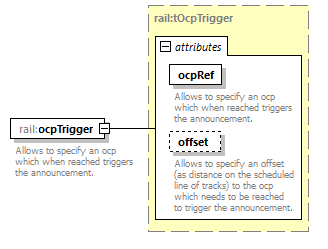 | ||||||||||||||||||||||
| namespace | https://www.railml.org/schemas/2021 | ||||||||||||||||||||||
| type | rail:tOcpTrigger | ||||||||||||||||||||||
| properties |
| ||||||||||||||||||||||
| attributes |
| ||||||||||||||||||||||
| annotation |
| ||||||||||||||||||||||
| source | <xs:element name="ocpTrigger" type="rail:tOcpTrigger"> <xs:annotation> <xs:documentation>Allows to specify an ocp which when reached triggers the announcement.</xs:documentation> <xs:documentation>See https://wiki2.railml.org/wiki/TT:ocpTrigger</xs:documentation> </xs:annotation> </xs:element> |
element tAnnouncementTrigger/timingTrigger
| diagram | 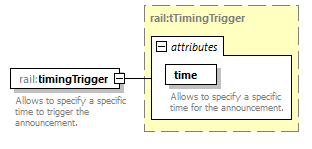 | ||||||||||||||
| namespace | https://www.railml.org/schemas/2021 | ||||||||||||||
| type | rail:tTimingTrigger | ||||||||||||||
| properties |
| ||||||||||||||
| attributes |
| ||||||||||||||
| annotation |
| ||||||||||||||
| source | <xs:element name="timingTrigger" type="rail:tTimingTrigger"> <xs:annotation> <xs:documentation>Allows to specify a specific time to trigger the announcement.</xs:documentation> <xs:documentation>See https://wiki2.railml.org/wiki/TT:timingTrigger</xs:documentation> </xs:annotation> </xs:element> |
element tAnnouncementTrigger/geoTrigger
| diagram | 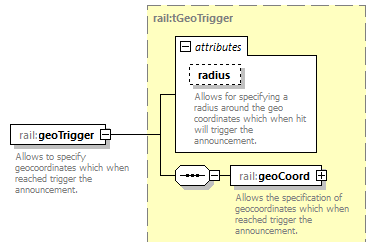 | ||||||||||||||
| namespace | https://www.railml.org/schemas/2021 | ||||||||||||||
| type | rail:tGeoTrigger | ||||||||||||||
| properties |
| ||||||||||||||
| children | rail:geoCoord | ||||||||||||||
| attributes |
| ||||||||||||||
| annotation |
| ||||||||||||||
| source | <xs:element name="geoTrigger" type="rail:tGeoTrigger"> <xs:annotation> <xs:documentation>Allows to specify geocoordinates which when reached trigger the announcement.</xs:documentation> <xs:documentation>See https://wiki2.railml.org/wiki/TT:geoTrigger</xs:documentation> </xs:annotation> </xs:element> |
element tAnnouncementTrigger/informationAreaTrigger
| diagram |  | ||||||||||||||||||||||
| namespace | https://www.railml.org/schemas/2021 | ||||||||||||||||||||||
| type | rail:tInformationAreaTrigger | ||||||||||||||||||||||
| properties |
| ||||||||||||||||||||||
| attributes |
| ||||||||||||||||||||||
| annotation |
| ||||||||||||||||||||||
| source | <xs:element name="informationAreaTrigger" type="rail:tInformationAreaTrigger"> <xs:annotation> <xs:documentation>Allows to specify an information area defined in the infrastructure which when reached triggers the announcement.</xs:documentation> <xs:documentation>See https://wiki2.railml.org/wiki/TT:informationAreaTrigger</xs:documentation> </xs:annotation> </xs:element> |
element tAnnouncementTrigger/manualTrigger
| diagram |  | ||
| namespace | https://www.railml.org/schemas/2021 | ||
| properties |
| ||
| annotation |
| ||
| source | <xs:element name="manualTrigger"> <xs:annotation> <xs:documentation>See https://wiki2.railml.org/wiki/TT:manualTrigger</xs:documentation> </xs:annotation> <xs:complexType/> </xs:element> |
complexType tAnnouncementTriggerPeriodic
| diagram |  | ||
| namespace | https://www.railml.org/schemas/2021 | ||
| children | rail:eventTrigger rail:ocpTrigger rail:timingTrigger rail:geoTrigger rail:informationAreaTrigger | ||
| used by |
| ||
| source | <xs:complexType name="tAnnouncementTriggerPeriodic"> <xs:choice> <xs:element name="eventTrigger" type="rail:tEventTrigger"> <xs:annotation> <xs:documentation>Allows to specify that the referenced announcement is to be played delayed by some duration after the specified event occured.</xs:documentation> <xs:documentation>See https://wiki2.railml.org/wiki/TT:eventTrigger</xs:documentation> </xs:annotation> </xs:element> <xs:element name="ocpTrigger" type="rail:tOcpTrigger"> <xs:annotation> <xs:documentation>Allows to specify an ocp which when reached triggers the announcement.</xs:documentation> <xs:documentation>See https://wiki2.railml.org/wiki/TT:ocpTrigger</xs:documentation> </xs:annotation> </xs:element> <xs:element name="timingTrigger" type="rail:tTimingTrigger"> <xs:annotation> <xs:documentation>Allows to specify a specific time to trigger the announcement.</xs:documentation> <xs:documentation>See https://wiki2.railml.org/wiki/TT:timingTrigger</xs:documentation> </xs:annotation> </xs:element> <xs:element name="geoTrigger" type="rail:tGeoTrigger"> <xs:annotation> <xs:documentation>Allows to specify geocoordinates which when reached trigger the announcement.</xs:documentation> <xs:documentation>See https://wiki2.railml.org/wiki/TT:geoTrigger</xs:documentation> </xs:annotation> </xs:element> <xs:element name="informationAreaTrigger" type="rail:tInformationAreaTrigger"> <xs:annotation> <xs:documentation>Allows to specify an information area defined in the infrastructure which when reached triggers the announcement.</xs:documentation> <xs:documentation>See https://wiki2.railml.org/wiki/TT:informationAreaTrigger</xs:documentation> </xs:annotation> </xs:element> </xs:choice> </xs:complexType> |
element tAnnouncementTriggerPeriodic/eventTrigger
| diagram |  | ||||||||||||||||||||||
| namespace | https://www.railml.org/schemas/2021 | ||||||||||||||||||||||
| type | rail:tEventTrigger | ||||||||||||||||||||||
| properties |
| ||||||||||||||||||||||
| attributes |
| ||||||||||||||||||||||
| annotation |
| ||||||||||||||||||||||
| source | <xs:element name="eventTrigger" type="rail:tEventTrigger"> <xs:annotation> <xs:documentation>Allows to specify that the referenced announcement is to be played delayed by some duration after the specified event occured.</xs:documentation> <xs:documentation>See https://wiki2.railml.org/wiki/TT:eventTrigger</xs:documentation> </xs:annotation> </xs:element> |
element tAnnouncementTriggerPeriodic/ocpTrigger
| diagram |  | ||||||||||||||||||||||
| namespace | https://www.railml.org/schemas/2021 | ||||||||||||||||||||||
| type | rail:tOcpTrigger | ||||||||||||||||||||||
| properties |
| ||||||||||||||||||||||
| attributes |
| ||||||||||||||||||||||
| annotation |
| ||||||||||||||||||||||
| source | <xs:element name="ocpTrigger" type="rail:tOcpTrigger"> <xs:annotation> <xs:documentation>Allows to specify an ocp which when reached triggers the announcement.</xs:documentation> <xs:documentation>See https://wiki2.railml.org/wiki/TT:ocpTrigger</xs:documentation> </xs:annotation> </xs:element> |
element tAnnouncementTriggerPeriodic/timingTrigger
| diagram |  | ||||||||||||||
| namespace | https://www.railml.org/schemas/2021 | ||||||||||||||
| type | rail:tTimingTrigger | ||||||||||||||
| properties |
| ||||||||||||||
| attributes |
| ||||||||||||||
| annotation |
| ||||||||||||||
| source | <xs:element name="timingTrigger" type="rail:tTimingTrigger"> <xs:annotation> <xs:documentation>Allows to specify a specific time to trigger the announcement.</xs:documentation> <xs:documentation>See https://wiki2.railml.org/wiki/TT:timingTrigger</xs:documentation> </xs:annotation> </xs:element> |
element tAnnouncementTriggerPeriodic/geoTrigger
| diagram |  | ||||||||||||||
| namespace | https://www.railml.org/schemas/2021 | ||||||||||||||
| type | rail:tGeoTrigger | ||||||||||||||
| properties |
| ||||||||||||||
| children | rail:geoCoord | ||||||||||||||
| attributes |
| ||||||||||||||
| annotation |
| ||||||||||||||
| source | <xs:element name="geoTrigger" type="rail:tGeoTrigger"> <xs:annotation> <xs:documentation>Allows to specify geocoordinates which when reached trigger the announcement.</xs:documentation> <xs:documentation>See https://wiki2.railml.org/wiki/TT:geoTrigger</xs:documentation> </xs:annotation> </xs:element> |
element tAnnouncementTriggerPeriodic/informationAreaTrigger
| diagram |  | ||||||||||||||||||||||
| namespace | https://www.railml.org/schemas/2021 | ||||||||||||||||||||||
| type | rail:tInformationAreaTrigger | ||||||||||||||||||||||
| properties |
| ||||||||||||||||||||||
| attributes |
| ||||||||||||||||||||||
| annotation |
| ||||||||||||||||||||||
| source | <xs:element name="informationAreaTrigger" type="rail:tInformationAreaTrigger"> <xs:annotation> <xs:documentation>Allows to specify an information area defined in the infrastructure which when reached triggers the announcement.</xs:documentation> <xs:documentation>See https://wiki2.railml.org/wiki/TT:informationAreaTrigger</xs:documentation> </xs:annotation> </xs:element> |
complexType tArrivalDepartureTimes
| diagram |  | ||||||||||||||||||||||||||||||||||||||||||||||||||||||
| namespace | https://www.railml.org/schemas/2021 | ||||||||||||||||||||||||||||||||||||||||||||||||||||||
| type | extension of rail:tBaseArrivalDepartureTimes | ||||||||||||||||||||||||||||||||||||||||||||||||||||||
| properties |
| ||||||||||||||||||||||||||||||||||||||||||||||||||||||
| used by |
| ||||||||||||||||||||||||||||||||||||||||||||||||||||||
| attributes |
| ||||||||||||||||||||||||||||||||||||||||||||||||||||||
| source | <xs:complexType name="tArrivalDepartureTimes"> <xs:complexContent> <xs:extension base="rail:tBaseArrivalDepartureTimes"> <xs:attributeGroup ref="rail:aTimesScope"/> </xs:extension> </xs:complexContent> </xs:complexType> |
complexType tBaseArrivalDepartureTimes
| diagram | 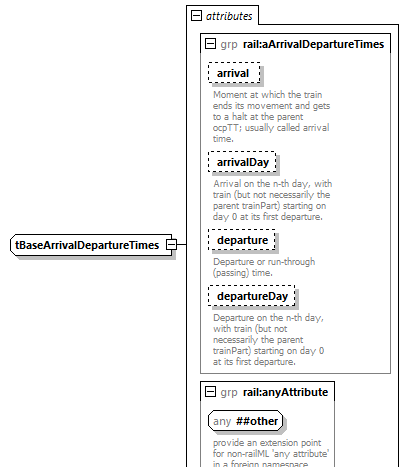 | ||||||||||||||||||||||||||||||||||||||||||||||
| namespace | https://www.railml.org/schemas/2021 | ||||||||||||||||||||||||||||||||||||||||||||||
| used by |
| ||||||||||||||||||||||||||||||||||||||||||||||
| attributes |
| ||||||||||||||||||||||||||||||||||||||||||||||
| source | <xs:complexType name="tBaseArrivalDepartureTimes"> <xs:attributeGroup ref="rail:aArrivalDepartureTimes"/> <xs:attributeGroup ref="rail:anyAttribute"/> </xs:complexType> |
complexType tBaseFormationTT
| diagram |  | ||||||||||||||
| namespace | https://www.railml.org/schemas/2021 | ||||||||||||||
| used by |
| ||||||||||||||
| attributes |
| ||||||||||||||
| source | <xs:complexType name="tBaseFormationTT"> <xs:sequence> <xs:any namespace="##other" processContents="strict" minOccurs="0" maxOccurs="unbounded"> <xs:annotation> <xs:documentation>Provides an extension point for non-railML elements in foreign namespace.</xs:documentation> </xs:annotation> </xs:any> </xs:sequence> <xs:attributeGroup ref="rail:aBaseFormationTT"/> <xs:attributeGroup ref="rail:anyAttribute"/> </xs:complexType> |
complexType tBaseOcpTT
| diagram | 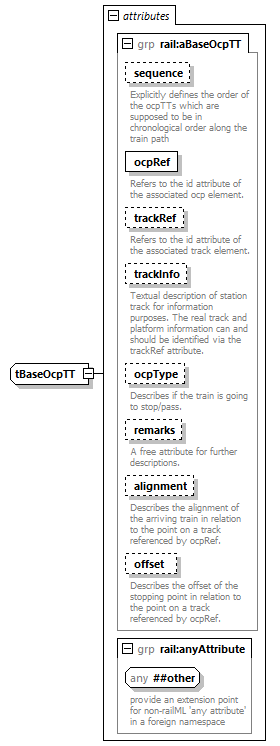 | ||||||||||||||||||||||||||||||||||||||||||||||||||||||||||||||||||||||
| namespace | https://www.railml.org/schemas/2021 | ||||||||||||||||||||||||||||||||||||||||||||||||||||||||||||||||||||||
| used by |
| ||||||||||||||||||||||||||||||||||||||||||||||||||||||||||||||||||||||
| attributes |
| ||||||||||||||||||||||||||||||||||||||||||||||||||||||||||||||||||||||
| source | <xs:complexType name="tBaseOcpTT"> <xs:attributeGroup ref="rail:aBaseOcpTT"/> <xs:attributeGroup ref="rail:anyAttribute"/> </xs:complexType> |
complexType tBaseStopDescription
| diagram | 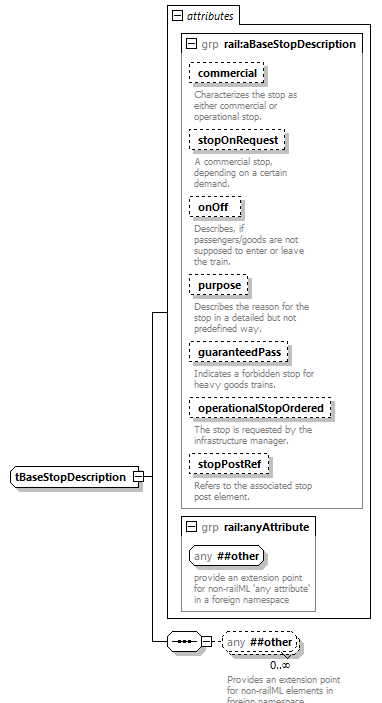 | ||||||||||||||||||||||||||||||||||||||||||||||||||||||||||||||
| namespace | https://www.railml.org/schemas/2021 | ||||||||||||||||||||||||||||||||||||||||||||||||||||||||||||||
| used by |
| ||||||||||||||||||||||||||||||||||||||||||||||||||||||||||||||
| attributes |
| ||||||||||||||||||||||||||||||||||||||||||||||||||||||||||||||
| source | <xs:complexType name="tBaseStopDescription"> <xs:sequence> <xs:any namespace="##other" processContents="strict" minOccurs="0" maxOccurs="unbounded"> <xs:annotation> <xs:documentation>Provides an extension point for non-railML elements in foreign namespace.</xs:documentation> </xs:annotation> </xs:any> </xs:sequence> <xs:attributeGroup ref="rail:aBaseStopDescription"/> <xs:attributeGroup ref="rail:anyAttribute"/> </xs:complexType> |
complexType tBaseTrackInfo
| diagram | 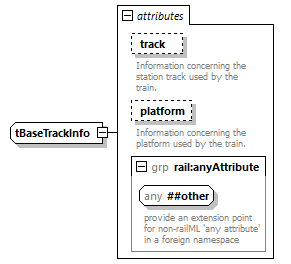 | ||||||||||||||||||||||
| namespace | https://www.railml.org/schemas/2021 | ||||||||||||||||||||||
| used by |
| ||||||||||||||||||||||
| attributes |
| ||||||||||||||||||||||
| source | <xs:complexType name="tBaseTrackInfo"> <xs:attribute name="track" type="xs:string"> <xs:annotation> <xs:documentation>Information concerning the station track used by the train.</xs:documentation> </xs:annotation> </xs:attribute> <xs:attribute name="platform" type="xs:string"> <xs:annotation> <xs:documentation>Information concerning the platform used by the train.</xs:documentation> </xs:annotation> </xs:attribute> <xs:attributeGroup ref="rail:anyAttribute"/> </xs:complexType> |
attribute tBaseTrackInfo/@track
| type | xs:string | ||
| annotation |
| ||
| source | <xs:attribute name="track" type="xs:string"> <xs:annotation> <xs:documentation>Information concerning the station track used by the train.</xs:documentation> </xs:annotation> </xs:attribute> |
attribute tBaseTrackInfo/@platform
| type | xs:string | ||
| annotation |
| ||
| source | <xs:attribute name="platform" type="xs:string"> <xs:annotation> <xs:documentation>Information concerning the platform used by the train.</xs:documentation> </xs:annotation> </xs:attribute> |
complexType tBaseTrain
| diagram |  | ||||||||||||||||||||||||||||||||||||||||||||||||||||||
| namespace | https://www.railml.org/schemas/2021 | ||||||||||||||||||||||||||||||||||||||||||||||||||||||
| type | extension of rail:tElementWithIDAndName | ||||||||||||||||||||||||||||||||||||||||||||||||||||||
| properties |
| ||||||||||||||||||||||||||||||||||||||||||||||||||||||
| children | rail:additionalName | ||||||||||||||||||||||||||||||||||||||||||||||||||||||
| used by |
| ||||||||||||||||||||||||||||||||||||||||||||||||||||||
| attributes |
| ||||||||||||||||||||||||||||||||||||||||||||||||||||||
| source | <xs:complexType name="tBaseTrain"> <xs:complexContent> <xs:extension base="rail:tElementWithIDAndName"> <xs:attributeGroup ref="rail:aBaseTrain"/> </xs:extension> </xs:complexContent> </xs:complexType> |
complexType tBaseTrainPart
| diagram |  | ||||||||||||||||||||||||||||||||||||||||||||||||||||||||||||||||||||||||||||||||||||||||||||||
| namespace | https://www.railml.org/schemas/2021 | ||||||||||||||||||||||||||||||||||||||||||||||||||||||||||||||||||||||||||||||||||||||||||||||
| type | extension of rail:tElementWithIDAndName | ||||||||||||||||||||||||||||||||||||||||||||||||||||||||||||||||||||||||||||||||||||||||||||||
| properties |
| ||||||||||||||||||||||||||||||||||||||||||||||||||||||||||||||||||||||||||||||||||||||||||||||
| children | rail:additionalName | ||||||||||||||||||||||||||||||||||||||||||||||||||||||||||||||||||||||||||||||||||||||||||||||
| used by |
| ||||||||||||||||||||||||||||||||||||||||||||||||||||||||||||||||||||||||||||||||||||||||||||||
| attributes |
| ||||||||||||||||||||||||||||||||||||||||||||||||||||||||||||||||||||||||||||||||||||||||||||||
| source | <xs:complexType name="tBaseTrainPart"> <xs:complexContent> <xs:extension base="rail:tElementWithIDAndName"> <xs:attributeGroup ref="rail:aBaseTrainPart"/> </xs:extension> </xs:complexContent> </xs:complexType> |
complexType tBaseTrainPartSequence
| diagram | 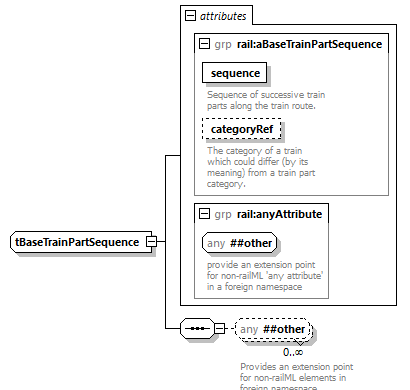 | ||||||||||||||||||||||
| namespace | https://www.railml.org/schemas/2021 | ||||||||||||||||||||||
| used by |
| ||||||||||||||||||||||
| attributes |
| ||||||||||||||||||||||
| source | <xs:complexType name="tBaseTrainPartSequence"> <xs:sequence> <xs:any namespace="##other" processContents="strict" minOccurs="0" maxOccurs="unbounded"> <xs:annotation> <xs:documentation>Provides an extension point for non-railML elements in foreign namespace.</xs:documentation> </xs:annotation> </xs:any> </xs:sequence> <xs:attributeGroup ref="rail:aBaseTrainPartSequence"/> <xs:attributeGroup ref="rail:anyAttribute"/> </xs:complexType> |
complexType tBlock
| diagram | 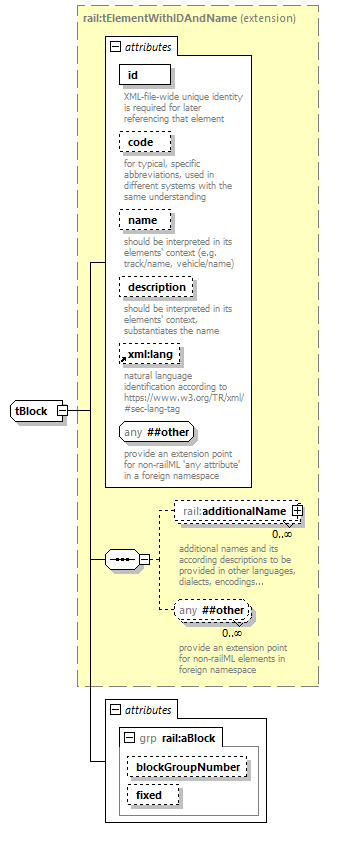 | ||||||||||||||||||||||||||||||||||||||||||||||||||||||||||
| namespace | https://www.railml.org/schemas/2021 | ||||||||||||||||||||||||||||||||||||||||||||||||||||||||||
| type | extension of rail:tElementWithIDAndName | ||||||||||||||||||||||||||||||||||||||||||||||||||||||||||
| properties |
| ||||||||||||||||||||||||||||||||||||||||||||||||||||||||||
| children | rail:additionalName | ||||||||||||||||||||||||||||||||||||||||||||||||||||||||||
| used by |
| ||||||||||||||||||||||||||||||||||||||||||||||||||||||||||
| attributes |
| ||||||||||||||||||||||||||||||||||||||||||||||||||||||||||
| source | <xs:complexType name="tBlock"> <xs:complexContent> <xs:extension base="rail:tElementWithIDAndName"> <xs:attributeGroup ref="rail:aBlock"/> </xs:extension> </xs:complexContent> </xs:complexType> |
complexType tBlockPart
| diagram |  | ||||||||||||||||||||||||||||||||||||||||||||||||||||||||||||||||||||||||||||||||||||||||||||||||||||||||||||||||||||||||||||||||||||||||||||||||||||||
| namespace | https://www.railml.org/schemas/2021 | ||||||||||||||||||||||||||||||||||||||||||||||||||||||||||||||||||||||||||||||||||||||||||||||||||||||||||||||||||||||||||||||||||||||||||||||||||||||
| type | extension of rail:tElementWithIDAndName | ||||||||||||||||||||||||||||||||||||||||||||||||||||||||||||||||||||||||||||||||||||||||||||||||||||||||||||||||||||||||||||||||||||||||||||||||||||||
| properties |
| ||||||||||||||||||||||||||||||||||||||||||||||||||||||||||||||||||||||||||||||||||||||||||||||||||||||||||||||||||||||||||||||||||||||||||||||||||||||
| children | rail:additionalName | ||||||||||||||||||||||||||||||||||||||||||||||||||||||||||||||||||||||||||||||||||||||||||||||||||||||||||||||||||||||||||||||||||||||||||||||||||||||
| used by |
| ||||||||||||||||||||||||||||||||||||||||||||||||||||||||||||||||||||||||||||||||||||||||||||||||||||||||||||||||||||||||||||||||||||||||||||||||||||||
| attributes |
| ||||||||||||||||||||||||||||||||||||||||||||||||||||||||||||||||||||||||||||||||||||||||||||||||||||||||||||||||||||||||||||||||||||||||||||||||||||||
| source | <xs:complexType name="tBlockPart"> <xs:complexContent> <xs:extension base="rail:tElementWithIDAndName"> <xs:attributeGroup ref="rail:aBlockPart"/> </xs:extension> </xs:complexContent> </xs:complexType> |
complexType tBlockPartRef
| diagram |  | ||||||||||||||
| namespace | https://www.railml.org/schemas/2021 | ||||||||||||||
| type | extension of rail:tElementWithReference | ||||||||||||||
| properties |
| ||||||||||||||
| used by |
| ||||||||||||||
| attributes |
| ||||||||||||||
| source | <xs:complexType name="tBlockPartRef"> <xs:complexContent> <xs:extension base="rail:tElementWithReference"/> </xs:complexContent> </xs:complexType> |
complexType tBlockPartSequence
| diagram |  | ||||||||||||||||||||||||||||||||||||||||||||||
| namespace | https://www.railml.org/schemas/2021 | ||||||||||||||||||||||||||||||||||||||||||||||
| used by |
| ||||||||||||||||||||||||||||||||||||||||||||||
| attributes |
| ||||||||||||||||||||||||||||||||||||||||||||||
| source | <xs:complexType name="tBlockPartSequence"> <xs:sequence> <xs:any namespace="##other" processContents="strict" minOccurs="0" maxOccurs="unbounded"> <xs:annotation> <xs:documentation>Provides an extension point for non-railML elements in foreign namespace.</xs:documentation> </xs:annotation> </xs:any> </xs:sequence> <xs:attributeGroup ref="rail:aBlockPartSequence"/> <xs:attributeGroup ref="rail:anyAttribute"/> </xs:complexType> |
complexType tBooking
| diagram |  | ||||||||||||||||||||||||||||||
| namespace | https://www.railml.org/schemas/2021 | ||||||||||||||||||||||||||||||
| used by |
| ||||||||||||||||||||||||||||||
| attributes |
| ||||||||||||||||||||||||||||||
| source | <xs:complexType name="tBooking"> <xs:attributeGroup ref="rail:aBooking"/> <xs:attributeGroup ref="rail:anyAttribute"/> </xs:complexType> |
complexType tCategory
| diagram |  | ||||||||||||||||||||||||||||||||||||||||||||||||||||||||||||||||||||||||||||||||||||||||
| namespace | https://www.railml.org/schemas/2021 | ||||||||||||||||||||||||||||||||||||||||||||||||||||||||||||||||||||||||||||||||||||||||
| type | extension of rail:tElementWithIDAndName | ||||||||||||||||||||||||||||||||||||||||||||||||||||||||||||||||||||||||||||||||||||||||
| properties |
| ||||||||||||||||||||||||||||||||||||||||||||||||||||||||||||||||||||||||||||||||||||||||
| children | rail:additionalName | ||||||||||||||||||||||||||||||||||||||||||||||||||||||||||||||||||||||||||||||||||||||||
| used by |
| ||||||||||||||||||||||||||||||||||||||||||||||||||||||||||||||||||||||||||||||||||||||||
| attributes |
| ||||||||||||||||||||||||||||||||||||||||||||||||||||||||||||||||||||||||||||||||||||||||
| source | <xs:complexType name="tCategory"> <xs:complexContent> <xs:extension base="rail:tElementWithIDAndName"> <xs:attributeGroup ref="rail:aCategory"/> </xs:extension> </xs:complexContent> </xs:complexType> |
complexType tCirculation
| diagram |  | ||||||||||||||||||||||||||||||||||||||||||||||||||||||||||||||||||||||||||||||
| namespace | https://www.railml.org/schemas/2021 | ||||||||||||||||||||||||||||||||||||||||||||||||||||||||||||||||||||||||||||||
| used by |
| ||||||||||||||||||||||||||||||||||||||||||||||||||||||||||||||||||||||||||||||
| attributes |
| ||||||||||||||||||||||||||||||||||||||||||||||||||||||||||||||||||||||||||||||
| source | <xs:complexType name="tCirculation"> <xs:attributeGroup ref="rail:aCirculation"/> <xs:attributeGroup ref="rail:anyAttribute"/> </xs:complexType> |
complexType tConnectionTT
| diagram |  | ||||||||||||||||||||||||||||||||||||||||||||||||||||||||||||||||||||||||||||||||||||||||||||||||||
| namespace | https://www.railml.org/schemas/2021 | ||||||||||||||||||||||||||||||||||||||||||||||||||||||||||||||||||||||||||||||||||||||||||||||||||
| used by |
| ||||||||||||||||||||||||||||||||||||||||||||||||||||||||||||||||||||||||||||||||||||||||||||||||||
| attributes |
| ||||||||||||||||||||||||||||||||||||||||||||||||||||||||||||||||||||||||||||||||||||||||||||||||||
| source | <xs:complexType name="tConnectionTT"> <xs:sequence> <xs:any namespace="##other" processContents="strict" minOccurs="0" maxOccurs="unbounded"> <xs:annotation> <xs:documentation>Provides an extension point for non-railML elements in foreign namespace.</xs:documentation> </xs:annotation> </xs:any> </xs:sequence> <xs:attributeGroup ref="rail:aConnectionTT"/> <xs:attributeGroup ref="rail:anyAttribute"/> </xs:complexType> |
complexType tEquipment
| diagram |  | ||||||||||||||||||||||||||||||
| namespace | https://www.railml.org/schemas/2021 | ||||||||||||||||||||||||||||||
| used by |
| ||||||||||||||||||||||||||||||
| attributes |
| ||||||||||||||||||||||||||||||
| source | <xs:complexType name="tEquipment"> <xs:sequence> <xs:any namespace="##other" processContents="strict" minOccurs="0" maxOccurs="unbounded"> <xs:annotation> <xs:documentation>Provides an extension point for non-railML elements in foreign namespace.</xs:documentation> </xs:annotation> </xs:any> </xs:sequence> <xs:attributeGroup ref="rail:aEquipment"/> <xs:attributeGroup ref="rail:anyAttribute"/> </xs:complexType> |
complexType tEtcsTT
| diagram | 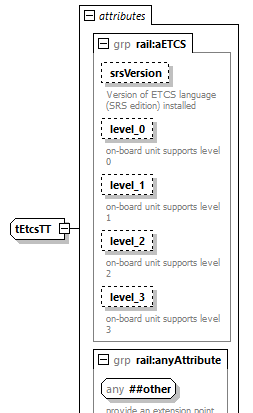 | ||||||||||||||||||||||||||||||||||||||||||||||
| namespace | https://www.railml.org/schemas/2021 | ||||||||||||||||||||||||||||||||||||||||||||||
| used by |
| ||||||||||||||||||||||||||||||||||||||||||||||
| attributes |
| ||||||||||||||||||||||||||||||||||||||||||||||
| source | <xs:complexType name="tEtcsTT"> <xs:attributeGroup ref="rail:aETCS"/> <xs:attributeGroup ref="rail:anyAttribute"/> </xs:complexType> |
complexType tEventTrigger
| diagram |  | ||||||||||||||||||||||
| namespace | https://www.railml.org/schemas/2021 | ||||||||||||||||||||||
| used by |
| ||||||||||||||||||||||
| attributes |
| ||||||||||||||||||||||
| source | <xs:complexType name="tEventTrigger"> <xs:attributeGroup ref="rail:aEventTrigger"/> </xs:complexType> |
complexType tFormationTT
| diagram | 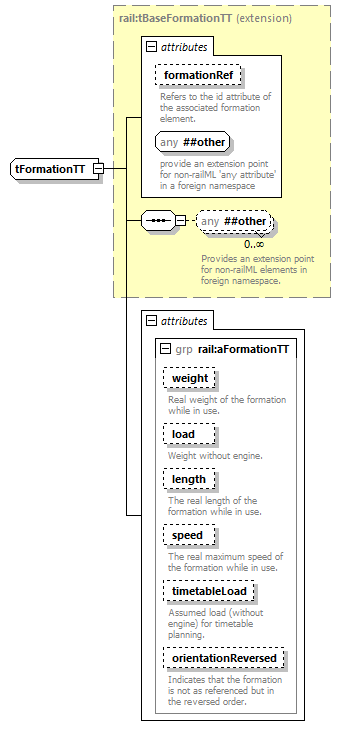 | ||||||||||||||||||||||||||||||||||||||||||||||||||||||||||||||
| namespace | https://www.railml.org/schemas/2021 | ||||||||||||||||||||||||||||||||||||||||||||||||||||||||||||||
| type | extension of rail:tBaseFormationTT | ||||||||||||||||||||||||||||||||||||||||||||||||||||||||||||||
| properties |
| ||||||||||||||||||||||||||||||||||||||||||||||||||||||||||||||
| used by |
| ||||||||||||||||||||||||||||||||||||||||||||||||||||||||||||||
| attributes |
| ||||||||||||||||||||||||||||||||||||||||||||||||||||||||||||||
| source | <xs:complexType name="tFormationTT"> <xs:complexContent> <xs:extension base="rail:tBaseFormationTT"> <xs:attributeGroup ref="rail:aFormationTT"/> </xs:extension> </xs:complexContent> </xs:complexType> |
complexType tGeoTrigger
| diagram |  | ||||||||||||||
| namespace | https://www.railml.org/schemas/2021 | ||||||||||||||
| children | rail:geoCoord | ||||||||||||||
| used by |
| ||||||||||||||
| attributes |
| ||||||||||||||
| source | <xs:complexType name="tGeoTrigger"> <xs:sequence> <xs:element name="geoCoord" type="rail:tGeoCoord"> <xs:annotation> <xs:documentation>Allows the specification of geocoordinates which when reached trigger the announcement.</xs:documentation> <xs:documentation>See https://wiki2.railml.org/wiki/TT:geoCoord</xs:documentation> </xs:annotation> </xs:element> </xs:sequence> <xs:attributeGroup ref="rail:aGeoTrigger"/> </xs:complexType> |
element tGeoTrigger/geoCoord
| diagram |  | ||||||||||||||||||||||||||||||
| namespace | https://www.railml.org/schemas/2021 | ||||||||||||||||||||||||||||||
| type | rail:tGeoCoord | ||||||||||||||||||||||||||||||
| properties |
| ||||||||||||||||||||||||||||||
| attributes |
| ||||||||||||||||||||||||||||||
| annotation |
| ||||||||||||||||||||||||||||||
| source | <xs:element name="geoCoord" type="rail:tGeoCoord"> <xs:annotation> <xs:documentation>Allows the specification of geocoordinates which when reached trigger the announcement.</xs:documentation> <xs:documentation>See https://wiki2.railml.org/wiki/TT:geoCoord</xs:documentation> </xs:annotation> </xs:element> |
complexType tHoliday
| diagram |  | ||||||||||||||||||||||
| namespace | https://www.railml.org/schemas/2021 | ||||||||||||||||||||||
| used by |
| ||||||||||||||||||||||
| attributes |
| ||||||||||||||||||||||
| source | <xs:complexType name="tHoliday"> <xs:attributeGroup ref="rail:aHoliday"/> <xs:attributeGroup ref="rail:anyAttribute"/> </xs:complexType> |
complexType tInformationAreaTrigger
| diagram |  | ||||||||||||||||||||||
| namespace | https://www.railml.org/schemas/2021 | ||||||||||||||||||||||
| used by |
| ||||||||||||||||||||||
| attributes |
| ||||||||||||||||||||||
| source | <xs:complexType name="tInformationAreaTrigger"> <xs:attributeGroup ref="rail:aInformationAreaTrigger"/> </xs:complexType> |
complexType tLineTT
| diagram | 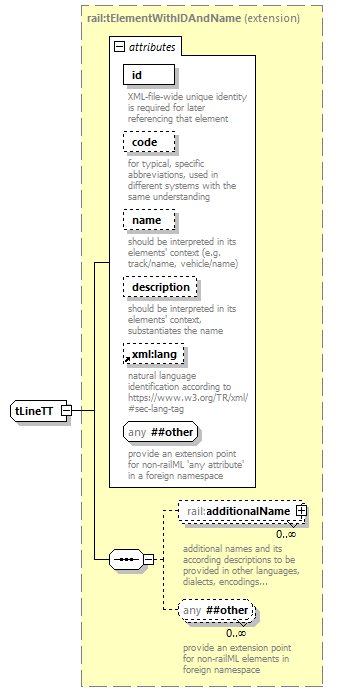 | ||||||||||||||||||||||||||||||||||||||||||||||
| namespace | https://www.railml.org/schemas/2021 | ||||||||||||||||||||||||||||||||||||||||||||||
| type | extension of rail:tElementWithIDAndName | ||||||||||||||||||||||||||||||||||||||||||||||
| properties |
| ||||||||||||||||||||||||||||||||||||||||||||||
| children | rail:additionalName | ||||||||||||||||||||||||||||||||||||||||||||||
| used by |
| ||||||||||||||||||||||||||||||||||||||||||||||
| attributes |
| ||||||||||||||||||||||||||||||||||||||||||||||
| source | <xs:complexType name="tLineTT"> <xs:complexContent> <xs:extension base="rail:tElementWithIDAndName"/> </xs:complexContent> </xs:complexType> |
complexType tOcpTrigger
| diagram | 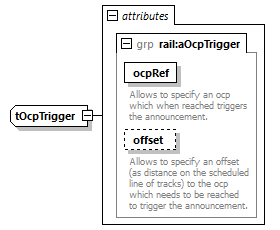 | ||||||||||||||||||||||
| namespace | https://www.railml.org/schemas/2021 | ||||||||||||||||||||||
| used by |
| ||||||||||||||||||||||
| attributes |
| ||||||||||||||||||||||
| source | <xs:complexType name="tOcpTrigger"> <xs:attributeGroup ref="rail:aOcpTrigger"/> </xs:complexType> |
complexType tOcpTT
| diagram |  | ||||||||||||||||||||||||||||||||||||||||||||||||||||||||||||||||||||||||||||||||||||||
| namespace | https://www.railml.org/schemas/2021 | ||||||||||||||||||||||||||||||||||||||||||||||||||||||||||||||||||||||||||||||||||||||
| type | extension of rail:tBaseOcpTT | ||||||||||||||||||||||||||||||||||||||||||||||||||||||||||||||||||||||||||||||||||||||
| properties |
| ||||||||||||||||||||||||||||||||||||||||||||||||||||||||||||||||||||||||||||||||||||||
| used by |
| ||||||||||||||||||||||||||||||||||||||||||||||||||||||||||||||||||||||||||||||||||||||
| attributes |
| ||||||||||||||||||||||||||||||||||||||||||||||||||||||||||||||||||||||||||||||||||||||
| source | <xs:complexType name="tOcpTT"> <xs:complexContent> <xs:extension base="rail:tBaseOcpTT"> <xs:attributeGroup ref="rail:aOcpTT"/> </xs:extension> </xs:complexContent> </xs:complexType> |
complexType tOperatingDay
| diagram |  | ||||||||||||||||||||||||||||||||
| namespace | https://www.railml.org/schemas/2021 | ||||||||||||||||||||||||||||||||
| used by |
| ||||||||||||||||||||||||||||||||
| attributes |
| ||||||||||||||||||||||||||||||||
| source | <xs:complexType name="tOperatingDay"> <xs:sequence> <xs:any namespace="##other" processContents="strict" minOccurs="0" maxOccurs="unbounded"> <xs:annotation> <xs:documentation>Provides an extension point for non-railML elements in foreign namespace.</xs:documentation> </xs:annotation> </xs:any> </xs:sequence> <xs:attributeGroup ref="rail:aOperatingCode"/> <xs:attributeGroup ref="rail:aTimePeriod"/> <xs:attributeGroup ref="rail:anyAttribute"/> </xs:complexType> |
complexType tOperatingDayDeviance
| diagram |  | ||||||||||||||||||||||||||||||||||||
| namespace | https://www.railml.org/schemas/2021 | ||||||||||||||||||||||||||||||||||||
| used by |
| ||||||||||||||||||||||||||||||||||||
| attributes |
| ||||||||||||||||||||||||||||||||||||
| source | <xs:complexType name="tOperatingDayDeviance"> <xs:attributeGroup ref="rail:aOperatingCode"/> <xs:attributeGroup ref="rail:aOperatingDayDeviance"/> <xs:attributeGroup ref="rail:anyAttribute"/> </xs:complexType> |
complexType tOperatingPeriod
| diagram | 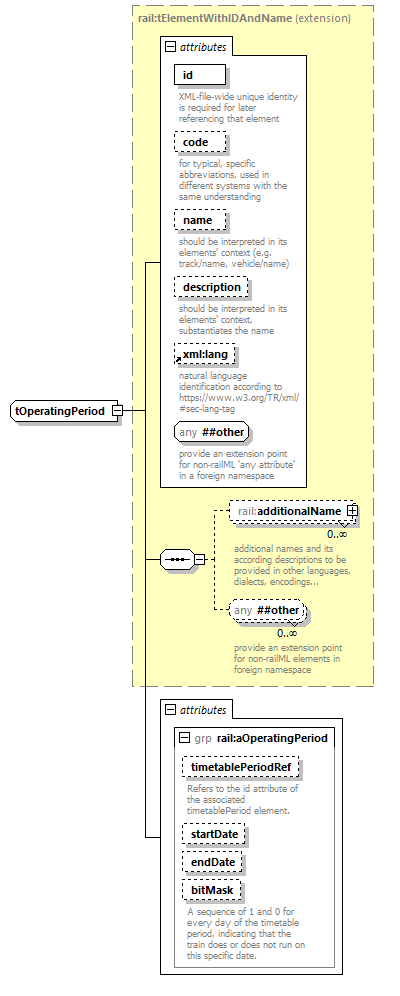 | ||||||||||||||||||||||||||||||||||||||||||||||||||||||||||||||||||||||||||
| namespace | https://www.railml.org/schemas/2021 | ||||||||||||||||||||||||||||||||||||||||||||||||||||||||||||||||||||||||||
| type | extension of rail:tElementWithIDAndName | ||||||||||||||||||||||||||||||||||||||||||||||||||||||||||||||||||||||||||
| properties |
| ||||||||||||||||||||||||||||||||||||||||||||||||||||||||||||||||||||||||||
| children | rail:additionalName | ||||||||||||||||||||||||||||||||||||||||||||||||||||||||||||||||||||||||||
| used by |
| ||||||||||||||||||||||||||||||||||||||||||||||||||||||||||||||||||||||||||
| attributes |
| ||||||||||||||||||||||||||||||||||||||||||||||||||||||||||||||||||||||||||
| source | <xs:complexType name="tOperatingPeriod"> <xs:complexContent> <xs:extension base="rail:tElementWithIDAndName"> <xs:attributeGroup ref="rail:aOperatingPeriod"/> </xs:extension> </xs:complexContent> </xs:complexType> |
complexType tOperatingPeriodRef
| diagram | 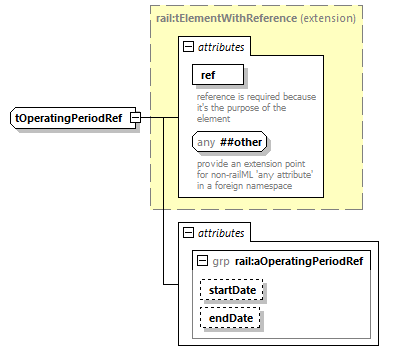 | ||||||||||||||||||||||||||
| namespace | https://www.railml.org/schemas/2021 | ||||||||||||||||||||||||||
| type | extension of rail:tElementWithReference | ||||||||||||||||||||||||||
| properties |
| ||||||||||||||||||||||||||
| used by |
| ||||||||||||||||||||||||||
| attributes |
| ||||||||||||||||||||||||||
| source | <xs:complexType name="tOperatingPeriodRef"> <xs:complexContent> <xs:extension base="rail:tElementWithReference"> <xs:attributeGroup ref="rail:aOperatingPeriodRef"/> </xs:extension> </xs:complexContent> </xs:complexType> |
complexType tOriginalTrackInfo
| diagram |  | ||||||||||||||||||||||
| namespace | https://www.railml.org/schemas/2021 | ||||||||||||||||||||||
| used by |
| ||||||||||||||||||||||
| attributes |
| ||||||||||||||||||||||
| source | <xs:complexType name="tOriginalTrackInfo"> <xs:attribute name="trackRef" type="rail:tGenericRef"> <xs:annotation> <xs:documentation>Refers to the id attribute of the associated track element.</xs:documentation> </xs:annotation> </xs:attribute> <xs:attribute name="trackInfo" type="xs:string"> <xs:annotation> <xs:documentation>This is a description of the station track, often used for the platform number.</xs:documentation> </xs:annotation> </xs:attribute> <xs:attributeGroup ref="rail:anyAttribute"/> </xs:complexType> |
attribute tOriginalTrackInfo/@trackRef
| type | rail:tGenericRef | ||
| annotation |
| ||
| source | <xs:attribute name="trackRef" type="rail:tGenericRef"> <xs:annotation> <xs:documentation>Refers to the id attribute of the associated track element.</xs:documentation> </xs:annotation> </xs:attribute> |
attribute tOriginalTrackInfo/@trackInfo
| type | xs:string | ||
| annotation |
| ||
| source | <xs:attribute name="trackInfo" type="xs:string"> <xs:annotation> <xs:documentation>This is a description of the station track, often used for the platform number.</xs:documentation> </xs:annotation> </xs:attribute> |
complexType tOriginDestinationInfo
| diagram | 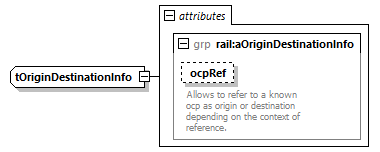 | ||||||||||||||
| namespace | https://www.railml.org/schemas/2021 | ||||||||||||||
| used by |
| ||||||||||||||
| attributes |
| ||||||||||||||
| source | <xs:complexType name="tOriginDestinationInfo"> <xs:attributeGroup ref="rail:aOriginDestinationInfo"/> </xs:complexType> |
complexType tOutputLanguage
| diagram | 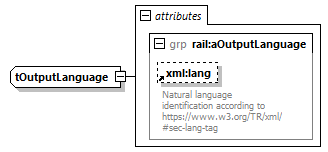 | ||||||||||||||
| namespace | https://www.railml.org/schemas/2021 | ||||||||||||||
| used by |
| ||||||||||||||
| attributes |
| ||||||||||||||
| source | <xs:complexType name="tOutputLanguage"> <xs:attributeGroup ref="rail:aOutputLanguage"/> </xs:complexType> |
complexType tOutputLanguages
| diagram |  | ||
| namespace | https://www.railml.org/schemas/2021 | ||
| children | rail:language | ||
| used by |
| ||
| source | <xs:complexType name="tOutputLanguages"> <xs:sequence> <xs:element name="language" type="rail:tOutputLanguage"> <xs:annotation> <xs:documentation>Natural language identification according to https://www.w3.org/TR/xml/#sec-lang-tag</xs:documentation> <xs:documentation>See https://wiki2.railml.org/wiki/TT:language</xs:documentation> </xs:annotation> </xs:element> </xs:sequence> </xs:complexType> |
element tOutputLanguages/language
| diagram | 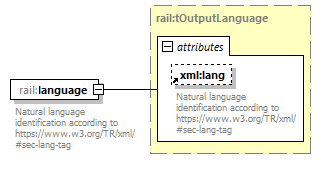 | ||||||||||||||
| namespace | https://www.railml.org/schemas/2021 | ||||||||||||||
| type | rail:tOutputLanguage | ||||||||||||||
| properties |
| ||||||||||||||
| attributes |
| ||||||||||||||
| annotation |
| ||||||||||||||
| source | <xs:element name="language" type="rail:tOutputLanguage"> <xs:annotation> <xs:documentation>Natural language identification according to https://www.w3.org/TR/xml/#sec-lang-tag</xs:documentation> <xs:documentation>See https://wiki2.railml.org/wiki/TT:language</xs:documentation> </xs:annotation> </xs:element> |
complexType tPassengerInfoActivationTimeSpec
| diagram |  | ||||
| namespace | https://www.railml.org/schemas/2021 | ||||
| children | rail:startTime rail:endTime | ||||
| used by |
| ||||
| source | <xs:complexType name="tPassengerInfoActivationTimeSpec"> <xs:sequence> <xs:element name="startTime" type="rail:tAnnouncementTriggerPeriodic"> <xs:annotation> <xs:documentation>Specifies the starting time of a periodically repeated announcement.</xs:documentation> <xs:documentation>See https://wiki2.railml.org/wiki/TT:startTime</xs:documentation> </xs:annotation> </xs:element> <xs:element name="endTime" type="rail:tAnnouncementTriggerPeriodic"> <xs:annotation> <xs:documentation>Specifies the ending time of a periodically repeated announcement.</xs:documentation> <xs:documentation>See https://wiki2.railml.org/wiki/TT:endTime</xs:documentation> </xs:annotation> </xs:element> </xs:sequence> </xs:complexType> |
element tPassengerInfoActivationTimeSpec/startTime
| diagram |  | ||||
| namespace | https://www.railml.org/schemas/2021 | ||||
| type | rail:tAnnouncementTriggerPeriodic | ||||
| properties |
| ||||
| children | rail:eventTrigger rail:ocpTrigger rail:timingTrigger rail:geoTrigger rail:informationAreaTrigger | ||||
| annotation |
| ||||
| source | <xs:element name="startTime" type="rail:tAnnouncementTriggerPeriodic"> <xs:annotation> <xs:documentation>Specifies the starting time of a periodically repeated announcement.</xs:documentation> <xs:documentation>See https://wiki2.railml.org/wiki/TT:startTime</xs:documentation> </xs:annotation> </xs:element> |
element tPassengerInfoActivationTimeSpec/endTime
| diagram |  | ||||
| namespace | https://www.railml.org/schemas/2021 | ||||
| type | rail:tAnnouncementTriggerPeriodic | ||||
| properties |
| ||||
| children | rail:eventTrigger rail:ocpTrigger rail:timingTrigger rail:geoTrigger rail:informationAreaTrigger | ||||
| annotation |
| ||||
| source | <xs:element name="endTime" type="rail:tAnnouncementTriggerPeriodic"> <xs:annotation> <xs:documentation>Specifies the ending time of a periodically repeated announcement.</xs:documentation> <xs:documentation>See https://wiki2.railml.org/wiki/TT:endTime</xs:documentation> </xs:annotation> </xs:element> |
complexType tPassengerInformationReference
| diagram | 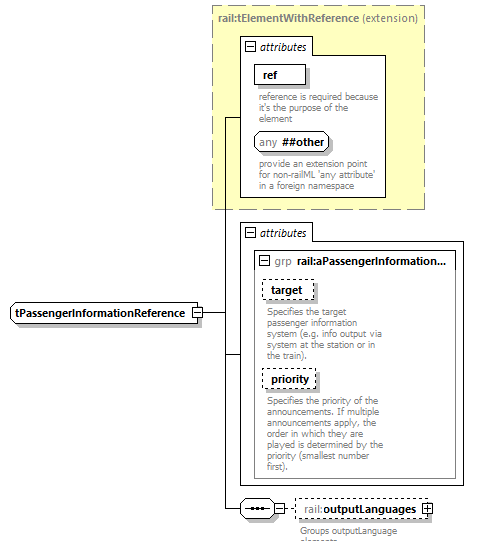 | ||||||||||||||||||||||||||||||
| namespace | https://www.railml.org/schemas/2021 | ||||||||||||||||||||||||||||||
| type | extension of rail:tElementWithReference | ||||||||||||||||||||||||||||||
| properties |
| ||||||||||||||||||||||||||||||
| children | rail:outputLanguages | ||||||||||||||||||||||||||||||
| used by |
| ||||||||||||||||||||||||||||||
| attributes |
| ||||||||||||||||||||||||||||||
| source | <xs:complexType name="tPassengerInformationReference"> <xs:complexContent> <xs:extension base="rail:tElementWithReference"> <xs:sequence> <xs:element name="outputLanguages" type="rail:tOutputLanguages" minOccurs="0"> <xs:annotation> <xs:documentation>Groups outputLanguage elements.</xs:documentation> <xs:documentation>See https://wiki2.railml.org/wiki/TT:outputLanguages</xs:documentation> </xs:annotation> </xs:element> </xs:sequence> <xs:attributeGroup ref="rail:aPassengerInformationReference"/> </xs:extension> </xs:complexContent> </xs:complexType> |
element tPassengerInformationReference/outputLanguages
| diagram |  | ||||||
| namespace | https://www.railml.org/schemas/2021 | ||||||
| type | rail:tOutputLanguages | ||||||
| properties |
| ||||||
| children | rail:language | ||||||
| annotation |
| ||||||
| source | <xs:element name="outputLanguages" type="rail:tOutputLanguages" minOccurs="0"> <xs:annotation> <xs:documentation>Groups outputLanguage elements.</xs:documentation> <xs:documentation>See https://wiki2.railml.org/wiki/TT:outputLanguages</xs:documentation> </xs:annotation> </xs:element> |
complexType tPatternTrain
| diagram |  | ||||||||||||||||||||||||||||||||||||||||||||||||||||||||||||||
| namespace | https://www.railml.org/schemas/2021 | ||||||||||||||||||||||||||||||||||||||||||||||||||||||||||||||
| type | extension of rail:tBaseTrain | ||||||||||||||||||||||||||||||||||||||||||||||||||||||||||||||
| properties |
| ||||||||||||||||||||||||||||||||||||||||||||||||||||||||||||||
| children | rail:additionalName | ||||||||||||||||||||||||||||||||||||||||||||||||||||||||||||||
| used by |
| ||||||||||||||||||||||||||||||||||||||||||||||||||||||||||||||
| attributes |
| ||||||||||||||||||||||||||||||||||||||||||||||||||||||||||||||
| source | <xs:complexType name="tPatternTrain"> <xs:complexContent> <xs:extension base="rail:tBaseTrain"> <xs:attributeGroup ref="rail:aPatternTrain"/> </xs:extension> </xs:complexContent> </xs:complexType> |
complexType tPatternTrainArrivalDepartureTimes
| diagram |  | ||||||||||||||||||||||||||||||||||||||||||||||||||||||
| namespace | https://www.railml.org/schemas/2021 | ||||||||||||||||||||||||||||||||||||||||||||||||||||||
| type | extension of rail:tBaseArrivalDepartureTimes | ||||||||||||||||||||||||||||||||||||||||||||||||||||||
| properties |
| ||||||||||||||||||||||||||||||||||||||||||||||||||||||
| used by |
| ||||||||||||||||||||||||||||||||||||||||||||||||||||||
| attributes |
| ||||||||||||||||||||||||||||||||||||||||||||||||||||||
| source | <xs:complexType name="tPatternTrainArrivalDepartureTimes"> <xs:complexContent> <xs:extension base="rail:tBaseArrivalDepartureTimes"> <xs:attributeGroup ref="rail:aFutureTimesScope"/> </xs:extension> </xs:complexContent> </xs:complexType> |
complexType tPeriodicAnnouncementSpec
| diagram |  | ||||||||||||||
| namespace | https://www.railml.org/schemas/2021 | ||||||||||||||
| type | extension of rail:tPassengerInfoActivationTimeSpec | ||||||||||||||
| properties |
| ||||||||||||||
| children | rail:startTime rail:endTime | ||||||||||||||
| used by |
| ||||||||||||||
| attributes |
| ||||||||||||||
| source | <xs:complexType name="tPeriodicAnnouncementSpec"> <xs:complexContent> <xs:extension base="rail:tPassengerInfoActivationTimeSpec"> <xs:attributeGroup ref="rail:aPeriodicAnnouncementSpec"/> </xs:extension> </xs:complexContent> </xs:complexType> |
complexType tPlacesTT
| diagram |  | ||||||||||||||||||||||||||||||||||||||||||||||
| namespace | https://www.railml.org/schemas/2021 | ||||||||||||||||||||||||||||||||||||||||||||||
| used by |
| ||||||||||||||||||||||||||||||||||||||||||||||
| attributes |
| ||||||||||||||||||||||||||||||||||||||||||||||
| annotation |
| ||||||||||||||||||||||||||||||||||||||||||||||
| source | <xs:complexType name="tPlacesTT"> <xs:annotation> <xs:documentation>Description of places/seats of the passenger car(part).</xs:documentation> </xs:annotation> <xs:attributeGroup ref="rail:aPlaces"/> <xs:attribute name="reservation" type="rail:tPlaceReservation"> <xs:annotation> <xs:documentation>Specifies the applicability of seat or place reservations.</xs:documentation> </xs:annotation> </xs:attribute> <xs:attributeGroup ref="rail:anyAttribute"/> </xs:complexType> |
attribute tPlacesTT/@reservation
| type | rail:tPlaceReservation | ||
| annotation |
| ||
| source | <xs:attribute name="reservation" type="rail:tPlaceReservation"> <xs:annotation> <xs:documentation>Specifies the applicability of seat or place reservations.</xs:documentation> </xs:annotation> </xs:attribute> |
complexType tPlatformEdgeRef
| diagram |  | ||||||||||||||
| namespace | https://www.railml.org/schemas/2021 | ||||||||||||||
| type | extension of rail:tElementWithReference | ||||||||||||||
| properties |
| ||||||||||||||
| used by |
| ||||||||||||||
| attributes |
| ||||||||||||||
| source | <xs:complexType name="tPlatformEdgeRef"> <xs:complexContent> <xs:extension base="rail:tElementWithReference"/> </xs:complexContent> </xs:complexType> |
complexType tReferenceOcp
| diagram |  | ||||||||||||||||||||||
| namespace | https://www.railml.org/schemas/2021 | ||||||||||||||||||||||
| used by |
| ||||||||||||||||||||||
| attributes |
| ||||||||||||||||||||||
| source | <xs:complexType name="tReferenceOcp"> <xs:sequence> <xs:any namespace="##other" processContents="strict" minOccurs="0" maxOccurs="unbounded"> <xs:annotation> <xs:documentation>Provides an extension point for non-railML elements in foreign namespace.</xs:documentation> </xs:annotation> </xs:any> </xs:sequence> <xs:attributeGroup ref="rail:aReferenceOcp"/> <xs:attributeGroup ref="rail:anyAttribute"/> </xs:complexType> |
complexType tRostering
| diagram |  | ||||||||||||||||||||||||||||||||||||||||||||||||||||||||||||||||||||||||||||||||||||||||||||||
| namespace | https://www.railml.org/schemas/2021 | ||||||||||||||||||||||||||||||||||||||||||||||||||||||||||||||||||||||||||||||||||||||||||||||
| type | extension of rail:tElementWithIDAndName | ||||||||||||||||||||||||||||||||||||||||||||||||||||||||||||||||||||||||||||||||||||||||||||||
| properties |
| ||||||||||||||||||||||||||||||||||||||||||||||||||||||||||||||||||||||||||||||||||||||||||||||
| children | rail:additionalName | ||||||||||||||||||||||||||||||||||||||||||||||||||||||||||||||||||||||||||||||||||||||||||||||
| used by |
| ||||||||||||||||||||||||||||||||||||||||||||||||||||||||||||||||||||||||||||||||||||||||||||||
| attributes |
| ||||||||||||||||||||||||||||||||||||||||||||||||||||||||||||||||||||||||||||||||||||||||||||||
| source | <xs:complexType name="tRostering"> <xs:complexContent> <xs:extension base="rail:tElementWithIDAndName"> <xs:attributeGroup ref="rail:aRostering"/> </xs:extension> </xs:complexContent> </xs:complexType> |
complexType tRunTimes
| diagram |  | ||||||||||||||||||||||||||||||
| namespace | https://www.railml.org/schemas/2021 | ||||||||||||||||||||||||||||||
| used by |
| ||||||||||||||||||||||||||||||
| attributes |
| ||||||||||||||||||||||||||||||
| source | <xs:complexType name="tRunTimes"> <xs:attributeGroup ref="rail:aRunTimes"/> <xs:attributeGroup ref="rail:anyAttribute"/> </xs:complexType> |
complexType tSectionTT
| diagram | 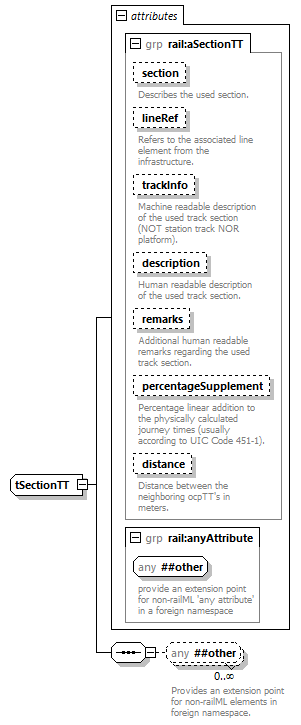 | ||||||||||||||||||||||||||||||||||||||||||||||||||||||||||||||
| namespace | https://www.railml.org/schemas/2021 | ||||||||||||||||||||||||||||||||||||||||||||||||||||||||||||||
| used by |
| ||||||||||||||||||||||||||||||||||||||||||||||||||||||||||||||
| attributes |
| ||||||||||||||||||||||||||||||||||||||||||||||||||||||||||||||
| source | <xs:complexType name="tSectionTT"> <xs:sequence> <xs:any namespace="##other" processContents="strict" minOccurs="0" maxOccurs="unbounded"> <xs:annotation> <xs:documentation>Provides an extension point for non-railML elements in foreign namespace.</xs:documentation> </xs:annotation> </xs:any> </xs:sequence> <xs:attributeGroup ref="rail:aSectionTT"/> <xs:attributeGroup ref="rail:anyAttribute"/> </xs:complexType> |
complexType tServiceSectionRef
| diagram | 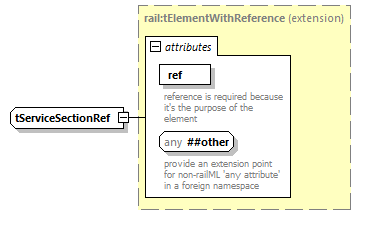 | ||||||||||||||
| namespace | https://www.railml.org/schemas/2021 | ||||||||||||||
| type | extension of rail:tElementWithReference | ||||||||||||||
| properties |
| ||||||||||||||
| used by |
| ||||||||||||||
| attributes |
| ||||||||||||||
| source | <xs:complexType name="tServiceSectionRef"> <xs:complexContent> <xs:extension base="rail:tElementWithReference"/> </xs:complexContent> </xs:complexType> |
complexType tSlot
| diagram |  | ||||||||||||||||||||||||||||||||||||||
| namespace | https://www.railml.org/schemas/2021 | ||||||||||||||||||||||||||||||||||||||
| used by |
| ||||||||||||||||||||||||||||||||||||||
| attributes |
| ||||||||||||||||||||||||||||||||||||||
| source | <xs:complexType name="tSlot"> <xs:sequence> <xs:any namespace="##other" processContents="strict" minOccurs="0" maxOccurs="unbounded"> <xs:annotation> <xs:documentation>Provides an extension point for non-railML elements in foreign namespace.</xs:documentation> </xs:annotation> </xs:any> </xs:sequence> <xs:attributeGroup ref="rail:aSlot"/> <xs:attributeGroup ref="rail:anyAttribute"/> </xs:complexType> |
complexType tSpecialService
| diagram |  | ||||||||||||||||||||||||||||||||||||||||||||||
| namespace | https://www.railml.org/schemas/2021 | ||||||||||||||||||||||||||||||||||||||||||||||
| used by |
| ||||||||||||||||||||||||||||||||||||||||||||||
| attributes |
| ||||||||||||||||||||||||||||||||||||||||||||||
| source | <xs:complexType name="tSpecialService"> <xs:attributeGroup ref="rail:aSpecialService"/> <xs:attributeGroup ref="rail:anyAttribute"/> </xs:complexType> |
complexType tSpeedProfileRef
| diagram |  | ||||||||||||||
| namespace | https://www.railml.org/schemas/2021 | ||||||||||||||
| type | extension of rail:tElementWithReference | ||||||||||||||
| properties |
| ||||||||||||||
| used by |
| ||||||||||||||
| attributes |
| ||||||||||||||
| annotation |
| ||||||||||||||
| source | <xs:complexType name="tSpeedProfileRef"> <xs:annotation> <xs:documentation>A reference to one of several speed profiles.</xs:documentation> </xs:annotation> <xs:complexContent> <xs:extension base="rail:tElementWithReference"/> </xs:complexContent> </xs:complexType> |
complexType tStandardDeviationTimes
| diagram | 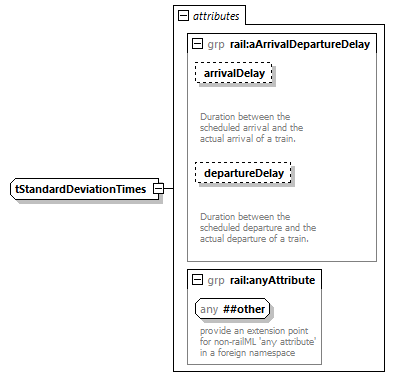 | ||||||||||||||||||||||
| namespace | https://www.railml.org/schemas/2021 | ||||||||||||||||||||||
| used by |
| ||||||||||||||||||||||
| attributes |
| ||||||||||||||||||||||
| source | <xs:complexType name="tStandardDeviationTimes"> <xs:attributeGroup ref="rail:aArrivalDepartureDelay"/> <xs:attributeGroup ref="rail:anyAttribute"/> </xs:complexType> |
complexType tStationTrackInfo
| diagram | 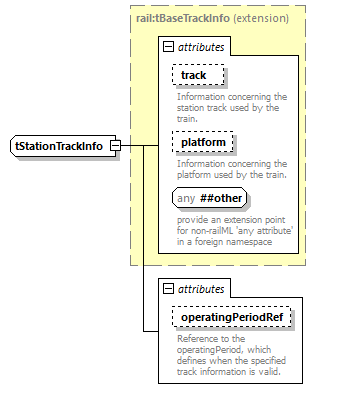 | ||||||||||||||||||||||||||||||
| namespace | https://www.railml.org/schemas/2021 | ||||||||||||||||||||||||||||||
| type | extension of rail:tBaseTrackInfo | ||||||||||||||||||||||||||||||
| properties |
| ||||||||||||||||||||||||||||||
| used by |
| ||||||||||||||||||||||||||||||
| attributes |
| ||||||||||||||||||||||||||||||
| source | <xs:complexType name="tStationTrackInfo"> <xs:complexContent> <xs:extension base="rail:tBaseTrackInfo"> <xs:attribute name="operatingPeriodRef" type="rail:tGenericRef"> <xs:annotation> <xs:documentation>Reference to the operatingPeriod, which defines when the specified track information is valid.</xs:documentation> </xs:annotation> </xs:attribute> </xs:extension> </xs:complexContent> </xs:complexType> |
attribute tStationTrackInfo/@operatingPeriodRef
| type | rail:tGenericRef | ||
| annotation |
| ||
| source | <xs:attribute name="operatingPeriodRef" type="rail:tGenericRef"> <xs:annotation> <xs:documentation>Reference to the operatingPeriod, which defines when the specified track information is valid.</xs:documentation> </xs:annotation> </xs:attribute> |
complexType tStatistic
| diagram |  | ||||||
| namespace | https://www.railml.org/schemas/2021 | ||||||
| used by |
| ||||||
| attributes |
| ||||||
| source | <xs:complexType name="tStatistic"> <xs:sequence> <xs:any namespace="##other" processContents="strict" minOccurs="0" maxOccurs="unbounded"> <xs:annotation> <xs:documentation>Provides an extension point for non-railML elements in foreign namespace.</xs:documentation> </xs:annotation> </xs:any> </xs:sequence> <xs:attributeGroup ref="rail:anyAttribute"/> </xs:complexType> |
complexType tStatisticAnalyses
| diagram | 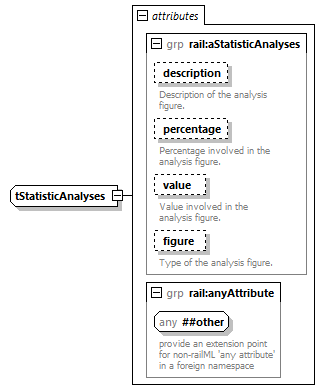 | ||||||||||||||||||||||||||||||||||||||||||||||
| namespace | https://www.railml.org/schemas/2021 | ||||||||||||||||||||||||||||||||||||||||||||||
| used by |
| ||||||||||||||||||||||||||||||||||||||||||||||
| attributes |
| ||||||||||||||||||||||||||||||||||||||||||||||
| source | <xs:complexType name="tStatisticAnalyses"> <xs:attributeGroup ref="rail:aStatisticAnalyses"/> <xs:attributeGroup ref="rail:anyAttribute"/> </xs:complexType> |
complexType tStatisticTimes
| diagram | 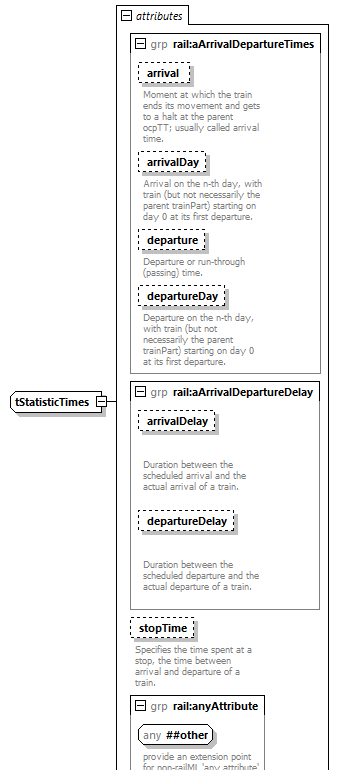 | ||||||||||||||||||||||||||||||||||||||||||||||||||||||||||||||||||||||
| namespace | https://www.railml.org/schemas/2021 | ||||||||||||||||||||||||||||||||||||||||||||||||||||||||||||||||||||||
| used by |
| ||||||||||||||||||||||||||||||||||||||||||||||||||||||||||||||||||||||
| attributes |
| ||||||||||||||||||||||||||||||||||||||||||||||||||||||||||||||||||||||
| source | <xs:complexType name="tStatisticTimes"> <xs:attributeGroup ref="rail:aArrivalDepartureTimes"/> <xs:attributeGroup ref="rail:aArrivalDepartureDelay"/> <xs:attribute name="stopTime" type="xs:duration"> <xs:annotation> <xs:documentation>Specifies the time spent at a stop, the time between arrival and departure of a train.</xs:documentation> </xs:annotation> </xs:attribute> <xs:attributeGroup ref="rail:anyAttribute"/> </xs:complexType> |
attribute tStatisticTimes/@stopTime
| type | xs:duration | ||
| annotation |
| ||
| source | <xs:attribute name="stopTime" type="xs:duration"> <xs:annotation> <xs:documentation>Specifies the time spent at a stop, the time between arrival and departure of a train.</xs:documentation> </xs:annotation> </xs:attribute> |
complexType tStopActivity
| diagram | 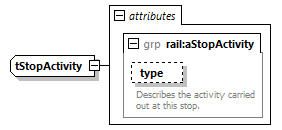 | ||||||||||||||
| namespace | https://www.railml.org/schemas/2021 | ||||||||||||||
| used by |
| ||||||||||||||
| attributes |
| ||||||||||||||
| source | <xs:complexType name="tStopActivity"> <xs:attributeGroup ref="rail:aStopActivity"/> </xs:complexType> |
complexType tStopDescription
| diagram |  | ||||||||||||||||||||||||||||||||||||||||||||||||||||||||||||||||||||||
| namespace | https://www.railml.org/schemas/2021 | ||||||||||||||||||||||||||||||||||||||||||||||||||||||||||||||||||||||
| type | extension of rail:tBaseStopDescription | ||||||||||||||||||||||||||||||||||||||||||||||||||||||||||||||||||||||
| properties |
| ||||||||||||||||||||||||||||||||||||||||||||||||||||||||||||||||||||||
| used by |
| ||||||||||||||||||||||||||||||||||||||||||||||||||||||||||||||||||||||
| attributes |
| ||||||||||||||||||||||||||||||||||||||||||||||||||||||||||||||||||||||
| source | <xs:complexType name="tStopDescription"> <xs:complexContent> <xs:extension base="rail:tBaseStopDescription"> <xs:attributeGroup ref="rail:aStopDescription"/> </xs:extension> </xs:complexContent> </xs:complexType> |
complexType tStopTimes
| diagram |  | ||||||||||||||||||||||||||||||||||||||||||||||
| namespace | https://www.railml.org/schemas/2021 | ||||||||||||||||||||||||||||||||||||||||||||||
| used by |
| ||||||||||||||||||||||||||||||||||||||||||||||
| attributes |
| ||||||||||||||||||||||||||||||||||||||||||||||
| source | <xs:complexType name="tStopTimes"> <xs:attributeGroup ref="rail:aStopTimes"/> <xs:attributeGroup ref="rail:anyAttribute"/> </xs:complexType> |
complexType tTapTsiCompositIdentifierOperationalType
| diagram | 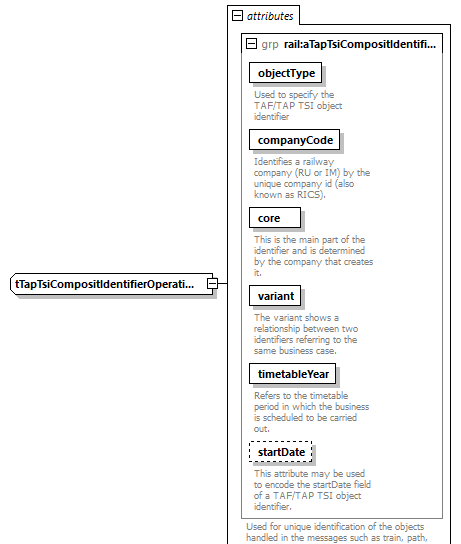 | ||||||||||||||||||||||||||||||||||||||||||||||||||||||
| namespace | https://www.railml.org/schemas/2021 | ||||||||||||||||||||||||||||||||||||||||||||||||||||||
| used by |
| ||||||||||||||||||||||||||||||||||||||||||||||||||||||
| attributes |
| ||||||||||||||||||||||||||||||||||||||||||||||||||||||
| source | <xs:complexType name="tTapTsiCompositIdentifierOperationalType"> <xs:attributeGroup ref="rail:aTapTsiCompositIdentifierOperationalType"/> </xs:complexType> |
complexType tTimetable
| diagram |  | ||||||||||||||||||||||||||||||||||||||||||||||||||||||||||||||||||||||||||||||
| namespace | https://www.railml.org/schemas/2021 | ||||||||||||||||||||||||||||||||||||||||||||||||||||||||||||||||||||||||||||||
| type | extension of rail:tGlobalElementWithMetadata | ||||||||||||||||||||||||||||||||||||||||||||||||||||||||||||||||||||||||||||||
| properties |
| ||||||||||||||||||||||||||||||||||||||||||||||||||||||||||||||||||||||||||||||
| children | rail:additionalName rail:metadata | ||||||||||||||||||||||||||||||||||||||||||||||||||||||||||||||||||||||||||||||
| used by |
| ||||||||||||||||||||||||||||||||||||||||||||||||||||||||||||||||||||||||||||||
| attributes |
| ||||||||||||||||||||||||||||||||||||||||||||||||||||||||||||||||||||||||||||||
| source | <xs:complexType name="tTimetable"> <xs:complexContent> <xs:extension base="rail:tGlobalElementWithMetadata"> <xs:attributeGroup ref="rail:aTimetable"/> </xs:extension> </xs:complexContent> </xs:complexType> |
complexType tTimetablePeriod
| diagram |  | ||||||||||||||||||||||||||||||||||||||||||||||||||||||||||||||||||||||
| namespace | https://www.railml.org/schemas/2021 | ||||||||||||||||||||||||||||||||||||||||||||||||||||||||||||||||||||||
| type | extension of rail:tElementWithIDAndName | ||||||||||||||||||||||||||||||||||||||||||||||||||||||||||||||||||||||
| properties |
| ||||||||||||||||||||||||||||||||||||||||||||||||||||||||||||||||||||||
| children | rail:additionalName | ||||||||||||||||||||||||||||||||||||||||||||||||||||||||||||||||||||||
| used by |
| ||||||||||||||||||||||||||||||||||||||||||||||||||||||||||||||||||||||
| attributes |
| ||||||||||||||||||||||||||||||||||||||||||||||||||||||||||||||||||||||
| source | <xs:complexType name="tTimetablePeriod"> <xs:complexContent> <xs:extension base="rail:tElementWithIDAndName"> <xs:attributeGroup ref="rail:aTimetablePeriod"/> </xs:extension> </xs:complexContent> </xs:complexType> |
complexType tTimingTrigger
| diagram |  | ||||||||||||||
| namespace | https://www.railml.org/schemas/2021 | ||||||||||||||
| used by |
| ||||||||||||||
| attributes |
| ||||||||||||||
| source | <xs:complexType name="tTimingTrigger"> <xs:attributeGroup ref="rail:aTimingTrigger"/> </xs:complexType> |
complexType tTopologyReference
| diagram |  | ||||||||||||||||||||||||||||||||||
| namespace | https://www.railml.org/schemas/2021 | ||||||||||||||||||||||||||||||||||
| used by |
| ||||||||||||||||||||||||||||||||||
| attributes |
| ||||||||||||||||||||||||||||||||||
| source | <xs:complexType name="tTopologyReference"> <xs:attribute name="register" type="xs:string" use="required"> <xs:annotation> <xs:documentation>Name of the referenced topology register, e.g. UNO.</xs:documentation> </xs:annotation> </xs:attribute> <xs:attribute name="entry" type="xs:string" use="required"> <xs:annotation> <xs:documentation>The reference in the specified topology register. The entry may be a version, name, date or any other string identifying a specific topology within the topology register.</xs:documentation> </xs:annotation> </xs:attribute> <xs:attributeGroup ref="rail:aTimePeriod"> <xs:annotation> <xs:documentation>The time period for which this topology reference applies</xs:documentation> </xs:annotation> </xs:attributeGroup> <xs:attributeGroup ref="rail:anyAttribute"> <xs:annotation> <xs:documentation>Provide an extension point for non-railML attributes in foreign namespace.</xs:documentation> </xs:annotation> </xs:attributeGroup> </xs:complexType> |
attribute tTopologyReference/@register
| type | xs:string | ||
| properties |
| ||
| annotation |
| ||
| source | <xs:attribute name="register" type="xs:string" use="required"> <xs:annotation> <xs:documentation>Name of the referenced topology register, e.g. UNO.</xs:documentation> </xs:annotation> </xs:attribute> |
attribute tTopologyReference/@entry
| type | xs:string | ||
| properties |
| ||
| annotation |
| ||
| source | <xs:attribute name="entry" type="xs:string" use="required"> <xs:annotation> <xs:documentation>The reference in the specified topology register. The entry may be a version, name, date or any other string identifying a specific topology within the topology register.</xs:documentation> </xs:annotation> </xs:attribute> |
complexType tTrackRef
| diagram |  | ||||||||||||||||||||||
| namespace | https://www.railml.org/schemas/2021 | ||||||||||||||||||||||
| type | extension of rail:tElementWithReference | ||||||||||||||||||||||
| properties |
| ||||||||||||||||||||||
| used by |
| ||||||||||||||||||||||
| attributes |
| ||||||||||||||||||||||
| source | <xs:complexType name="tTrackRef"> <xs:complexContent> <xs:extension base="rail:tElementWithReference"> <xs:attribute name="dir" type="rail:tStrictDirection"> <xs:annotation> <xs:documentation>Driving direction in relation to track definition direction.</xs:documentation> </xs:annotation> </xs:attribute> </xs:extension> </xs:complexContent> </xs:complexType> |
attribute tTrackRef/@dir
| type | rail:tStrictDirection | |||||||||
| facets |
| |||||||||
| annotation |
| |||||||||
| source | <xs:attribute name="dir" type="rail:tStrictDirection"> <xs:annotation> <xs:documentation>Driving direction in relation to track definition direction.</xs:documentation> </xs:annotation> </xs:attribute> |
complexType tTrain
| diagram |  | ||||||||||||||||||||||||||||||||||||||||||||||||||||||||||||||||||||||||||||||||||||||||||||||||||||||||||||||
| namespace | https://www.railml.org/schemas/2021 | ||||||||||||||||||||||||||||||||||||||||||||||||||||||||||||||||||||||||||||||||||||||||||||||||||||||||||||||
| type | extension of rail:tBaseTrain | ||||||||||||||||||||||||||||||||||||||||||||||||||||||||||||||||||||||||||||||||||||||||||||||||||||||||||||||
| properties |
| ||||||||||||||||||||||||||||||||||||||||||||||||||||||||||||||||||||||||||||||||||||||||||||||||||||||||||||||
| children | rail:additionalName | ||||||||||||||||||||||||||||||||||||||||||||||||||||||||||||||||||||||||||||||||||||||||||||||||||||||||||||||
| used by |
| ||||||||||||||||||||||||||||||||||||||||||||||||||||||||||||||||||||||||||||||||||||||||||||||||||||||||||||||
| attributes |
| ||||||||||||||||||||||||||||||||||||||||||||||||||||||||||||||||||||||||||||||||||||||||||||||||||||||||||||||
| source | <xs:complexType name="tTrain"> <xs:complexContent> <xs:extension base="rail:tBaseTrain"> <xs:attributeGroup ref="rail:aTrain"/> </xs:extension> </xs:complexContent> </xs:complexType> |
complexType tTrainGroup
| diagram |  | ||||||||||||||||||||||||||||||||||||||||||||||||||||||||||||||||||||||||||||||||||||
| namespace | https://www.railml.org/schemas/2021 | ||||||||||||||||||||||||||||||||||||||||||||||||||||||||||||||||||||||||||||||||||||
| type | extension of rail:tElementWithIDAndName | ||||||||||||||||||||||||||||||||||||||||||||||||||||||||||||||||||||||||||||||||||||
| properties |
| ||||||||||||||||||||||||||||||||||||||||||||||||||||||||||||||||||||||||||||||||||||
| children | rail:additionalName | ||||||||||||||||||||||||||||||||||||||||||||||||||||||||||||||||||||||||||||||||||||
| used by |
| ||||||||||||||||||||||||||||||||||||||||||||||||||||||||||||||||||||||||||||||||||||
| attributes |
| ||||||||||||||||||||||||||||||||||||||||||||||||||||||||||||||||||||||||||||||||||||
| source | <xs:complexType name="tTrainGroup"> <xs:complexContent> <xs:extension base="rail:tElementWithIDAndName"> <xs:attributeGroup ref="rail:aTrainGroup"/> </xs:extension> </xs:complexContent> </xs:complexType> |
complexType tTrainPart
| diagram |  | ||||||||||||||||||||||||||||||||||||||||||||||||||||||||||||||||||||||||||||||||||||||||||||||||||||||||||||||||||||||||||||||||||||||||||||||||||||||||||||||||||
| namespace | https://www.railml.org/schemas/2021 | ||||||||||||||||||||||||||||||||||||||||||||||||||||||||||||||||||||||||||||||||||||||||||||||||||||||||||||||||||||||||||||||||||||||||||||||||||||||||||||||||||
| type | extension of rail:tBaseTrainPart | ||||||||||||||||||||||||||||||||||||||||||||||||||||||||||||||||||||||||||||||||||||||||||||||||||||||||||||||||||||||||||||||||||||||||||||||||||||||||||||||||||
| properties |
| ||||||||||||||||||||||||||||||||||||||||||||||||||||||||||||||||||||||||||||||||||||||||||||||||||||||||||||||||||||||||||||||||||||||||||||||||||||||||||||||||||
| children | rail:additionalName | ||||||||||||||||||||||||||||||||||||||||||||||||||||||||||||||||||||||||||||||||||||||||||||||||||||||||||||||||||||||||||||||||||||||||||||||||||||||||||||||||||
| used by |
| ||||||||||||||||||||||||||||||||||||||||||||||||||||||||||||||||||||||||||||||||||||||||||||||||||||||||||||||||||||||||||||||||||||||||||||||||||||||||||||||||||
| attributes |
| ||||||||||||||||||||||||||||||||||||||||||||||||||||||||||||||||||||||||||||||||||||||||||||||||||||||||||||||||||||||||||||||||||||||||||||||||||||||||||||||||||
| source | <xs:complexType name="tTrainPart"> <xs:complexContent> <xs:extension base="rail:tBaseTrainPart"> <xs:attributeGroup ref="rail:aTrainPart"/> </xs:extension> </xs:complexContent> </xs:complexType> |
complexType tTrainPartRef
| diagram |  | ||||||||||||||||||||||||
| namespace | https://www.railml.org/schemas/2021 | ||||||||||||||||||||||||
| type | extension of rail:tElementWithReference | ||||||||||||||||||||||||
| properties |
| ||||||||||||||||||||||||
| used by |
| ||||||||||||||||||||||||
| attributes |
| ||||||||||||||||||||||||
| source | <xs:complexType name="tTrainPartRef"> <xs:complexContent> <xs:extension base="rail:tElementWithReference"> <xs:attributeGroup ref="rail:aTrainPartRef"/> </xs:extension> </xs:complexContent> </xs:complexType> |
complexType tTrainPartSequence
| diagram |  | ||||||||||||||||||||||||||||||||
| namespace | https://www.railml.org/schemas/2021 | ||||||||||||||||||||||||||||||||
| type | extension of rail:tBaseTrainPartSequence | ||||||||||||||||||||||||||||||||
| properties |
| ||||||||||||||||||||||||||||||||
| used by |
| ||||||||||||||||||||||||||||||||
| attributes |
| ||||||||||||||||||||||||||||||||
| source | <xs:complexType name="tTrainPartSequence"> <xs:complexContent> <xs:extension base="rail:tBaseTrainPartSequence"> <xs:attributeGroup ref="rail:aTrainPartSequence"/> </xs:extension> </xs:complexContent> </xs:complexType> |
complexType tUniqueTrainKey
| diagram |  | ||||||||||||||||||||||||||||||
| namespace | https://www.railml.org/schemas/2021 | ||||||||||||||||||||||||||||||
| used by |
| ||||||||||||||||||||||||||||||
| attributes |
| ||||||||||||||||||||||||||||||
| source | <xs:complexType name="tUniqueTrainKey"> <xs:attributeGroup ref="rail:aUniqueTrainKey"/> </xs:complexType> |
simpleType tAnnotationType
| namespace | https://www.railml.org/schemas/2021 | ||
| type | union of (restriction of xs:string, rail:tOtherEnumerationValue) | ||
| used by |
| ||
| source | <xs:simpleType name="tAnnotationType"> <xs:union> <xs:simpleType> <xs:restriction base="xs:string"> <xs:enumeration value="text"> <xs:annotation> <xs:documentation>Annotation encodes textual information.</xs:documentation> </xs:annotation> </xs:enumeration> <xs:enumeration value="symbol"> <xs:annotation> <xs:documentation>Annotation encodes a symbol, e.g. bicycle symbol for trains allowing transport of bicycles.</xs:documentation> </xs:annotation> </xs:enumeration> <xs:enumeration value="image"> <xs:annotation> <xs:documentation>Annotation encodes an image, e.g. a logo for the train of some kind</xs:documentation> </xs:annotation> </xs:enumeration> </xs:restriction> </xs:simpleType> <xs:simpleType> <xs:restriction base="rail:tOtherEnumerationValue"/> </xs:simpleType> </xs:union> </xs:simpleType> |
simpleType tBitMask
| namespace | https://www.railml.org/schemas/2021 | ||||||
| type | restriction of xs:string | ||||||
| properties |
| ||||||
| used by |
| ||||||
| facets |
| ||||||
| source | <xs:simpleType name="tBitMask"> <xs:restriction base="xs:string"> <xs:pattern value="[0-1]*"/> </xs:restriction> </xs:simpleType> |
simpleType tCompanyCode
| namespace | https://www.railml.org/schemas/2021 | |||||||||
| type | restriction of xs:integer | |||||||||
| properties |
| |||||||||
| used by |
| |||||||||
| facets |
| |||||||||
| annotation |
| |||||||||
| source | <xs:simpleType name="tCompanyCode"> <xs:annotation> <xs:documentation>Company code according TAP TSI B.8 and UIC IRS/leaflet 920-1:2006.</xs:documentation> </xs:annotation> <xs:restriction base="xs:integer"> <xs:minInclusive value="0001"/> <xs:maxInclusive value="9999"/> </xs:restriction> </xs:simpleType> |
simpleType tConnOperation
| namespace | https://www.railml.org/schemas/2021 | ||
| type | union of (restriction of xs:string, rail:tOtherEnumerationValue) | ||
| used by |
| ||
| source | <xs:simpleType name="tConnOperation"> <xs:union> <xs:simpleType> <xs:restriction base="xs:string"> <xs:enumeration value="none"> <xs:annotation> <xs:documentation>There is an unspecific connection to another train.</xs:documentation> </xs:annotation> </xs:enumeration> <xs:enumeration value="join"> <xs:annotation> <xs:documentation>Train will be coupled together with an other train.</xs:documentation> <xs:documentation>DEPRECATED with 2.1: use commercial trains instead.</xs:documentation> </xs:annotation> </xs:enumeration> <xs:enumeration value="split"> <xs:annotation> <xs:documentation>part of the train will go on as an other train.</xs:documentation> <xs:documentation>DEPRECATED with 2.1: use commercial trains instead.</xs:documentation> </xs:annotation> </xs:enumeration> <xs:enumeration value="meet"> <xs:annotation> <xs:documentation>The train meets another train. Passengers/goods may change trains in both directions.</xs:documentation> </xs:annotation> </xs:enumeration> <xs:enumeration value="turnaround"> <xs:annotation> <xs:documentation>The train will go on as an other train.</xs:documentation> <xs:documentation>DEPRECATED with 2.1: use rosterings instead.</xs:documentation> </xs:annotation> </xs:enumeration> <xs:enumeration value="IsWaitingFor"> <xs:annotation> <xs:documentation>The train is waiting for another train. The considered train may be receiving passengers/goods from the referenced connection train.</xs:documentation> </xs:annotation> </xs:enumeration> <xs:enumeration value="IsExpectedBy"> <xs:annotation> <xs:documentation>The train is expected by another train. The referenced connection train may be receiving passengers/goods from the considered train.</xs:documentation> </xs:annotation> </xs:enumeration> </xs:restriction> </xs:simpleType> <xs:simpleType> <xs:restriction base="rail:tOtherEnumerationValue"/> </xs:simpleType> </xs:union> </xs:simpleType> |
simpleType tConnType
| namespace | https://www.railml.org/schemas/2021 | ||
| type | union of (restriction of xs:string, rail:tOtherEnumerationValue) | ||
| used by |
| ||
| source | <xs:simpleType name="tConnType"> <xs:union> <xs:simpleType> <xs:restriction base="xs:string"> <xs:enumeration value="commercial"> <xs:annotation> <xs:documentation> Indicates that the purpose of the enclosing connection is the transfer of passengers or goods between the enclosing trainPart and another. </xs:documentation> </xs:annotation> </xs:enumeration> <xs:enumeration value="operational"> <xs:annotation> <xs:documentation> Indicates that the purpose of the enclosing connection is of an operational nature. This could for example be the transfer of staff between the enclosing trainPart and another. </xs:documentation> </xs:annotation> </xs:enumeration> </xs:restriction> </xs:simpleType> <xs:simpleType> <xs:restriction base="rail:tOtherEnumerationValue"/> </xs:simpleType> </xs:union> </xs:simpleType> |
simpleType tFutureTimeScope
| namespace | https://www.railml.org/schemas/2021 | ||
| type | union of (restriction of rail:tTimeScopeAll, rail:tOtherEnumerationValue) | ||
| used by |
| ||
| source | <xs:simpleType name="tFutureTimeScope"> <xs:union> <xs:simpleType> <xs:restriction base="rail:tTimeScopeAll"> <xs:enumeration value="actual"> <xs:annotation> <xs:documentation>Recorded arrival and departure times.</xs:documentation> </xs:annotation> </xs:enumeration> <xs:enumeration value="calculated"> <xs:annotation> <xs:documentation>Times from a simulation tool.</xs:documentation> </xs:annotation> </xs:enumeration> <xs:enumeration value="published"> <xs:annotation> <xs:documentation>Times that the passengers get on written sheets or online.</xs:documentation> </xs:annotation> </xs:enumeration> <xs:enumeration value="scheduled"> <xs:annotation> <xs:documentation>Times for operational purposes.</xs:documentation> </xs:annotation> </xs:enumeration> <xs:enumeration value="earliest"> <xs:annotation> <xs:documentation>Acceptable arrival and/or departure time (used to express a wish of a customer at a very early planning stage of a new timetable).</xs:documentation> </xs:annotation> </xs:enumeration> <xs:enumeration value="latest"> <xs:annotation> <xs:documentation>Acceptable arrival and/or departure time (used to express a wish of a customer at a very early planning stage of a new timetable).</xs:documentation> </xs:annotation> </xs:enumeration> <xs:enumeration value="expected"> <xs:annotation> <xs:documentation>Forecasted times based on actual operation data.</xs:documentation> </xs:annotation> </xs:enumeration> </xs:restriction> </xs:simpleType> <xs:simpleType> <xs:restriction base="rail:tOtherEnumerationValue"/> </xs:simpleType> </xs:union> </xs:simpleType> |
simpleType tInformationAreaEvent
| namespace | https://www.railml.org/schemas/2021 | ||
| type | union of (restriction of xs:string, rail:tOtherEnumerationValue) | ||
| used by |
| ||
| source | <xs:simpleType name="tInformationAreaEvent"> <xs:union> <xs:simpleType> <xs:restriction base="xs:string"> <xs:enumeration value="entering"> <xs:annotation> <xs:documentation>Event is triggered upon entrance of train into the information area referenced by the enclosing element.</xs:documentation> </xs:annotation> </xs:enumeration> <xs:enumeration value="leaving"> <xs:annotation> <xs:documentation>Event is triggered upon leaving of train from the information area referenced by the enclosing element.</xs:documentation> </xs:annotation> </xs:enumeration> </xs:restriction> </xs:simpleType> <xs:simpleType> <xs:restriction base="rail:tOtherEnumerationValue"/> </xs:simpleType> </xs:union> </xs:simpleType> |
simpleType tMission
| namespace | https://www.railml.org/schemas/2021 | ||
| type | union of (restriction of xs:string, rail:tOtherEnumerationValue) | ||
| used by |
| ||
| source | <xs:simpleType name="tMission"> <xs:union> <xs:simpleType> <xs:restriction base="xs:string"> <xs:enumeration value="timetable"> <xs:annotation> <xs:documentation>Represents a scheduled train movement that is encoded in detail in the referenced <trainPartRef>.</xs:documentation> </xs:annotation> </xs:enumeration> <xs:enumeration value="fullRun"> <xs:annotation> <xs:documentation>Represents a train movement that is not further described within the railML document. However it is known that the train is not moving empty.</xs:documentation> </xs:annotation> </xs:enumeration> <xs:enumeration value="emptyRun"> <xs:annotation> <xs:documentation>Represents a train movement that is not further described within the railML document. However it is known that the train is moving empty.</xs:documentation> </xs:annotation> </xs:enumeration> <xs:enumeration value="outOfOrder"> <xs:annotation> <xs:documentation>Specifies that it is a defective vehicle. For example, after an accident.</xs:documentation> </xs:annotation> </xs:enumeration> <xs:enumeration value="fillIn"> <xs:annotation> <xs:documentation>Represents a placeholder for an indefinite vehicle working within a rostering.</xs:documentation> </xs:annotation> </xs:enumeration> <xs:enumeration value="preheating"> <xs:annotation> <xs:documentation>Represents the preheating of the train</xs:documentation> </xs:annotation> </xs:enumeration> <xs:enumeration value="refuel"> <xs:annotation> <xs:documentation>Represents a duty where the train is refueled/recharged</xs:documentation> </xs:annotation> </xs:enumeration> <xs:enumeration value="shunting"> <xs:annotation> <xs:documentation>Represents a shunting duty</xs:documentation> </xs:annotation> </xs:enumeration> <xs:enumeration value="depotrun"> <xs:annotation> <xs:documentation>describes a journey from or to the stabling point (usually within a node (ocp))</xs:documentation> </xs:annotation> </xs:enumeration> <xs:enumeration value="standBy"> <xs:annotation> <xs:documentation>Represents a stand by duty</xs:documentation> </xs:annotation> </xs:enumeration> <xs:enumeration value="cleaning"> <xs:annotation> <xs:documentation>Specifies that the train is cleaned in this <blockPart></xs:documentation> </xs:annotation> </xs:enumeration> <xs:enumeration value="maintenance"> <xs:annotation> <xs:documentation>Specifies that the <blockPart> represents a maintenance timeframe</xs:documentation> </xs:annotation> </xs:enumeration> <xs:enumeration value="inspection"> <xs:annotation> <xs:documentation>Encodes a scheduled inspection of the train</xs:documentation> </xs:annotation> </xs:enumeration> </xs:restriction> </xs:simpleType> <xs:simpleType> <xs:restriction base="rail:tOtherEnumerationValue"/> </xs:simpleType> </xs:union> </xs:simpleType> |
simpleType tOcpEvent
| namespace | https://www.railml.org/schemas/2021 | ||
| type | union of (restriction of xs:string, rail:tOtherEnumerationValue) | ||
| used by |
| ||
| source | <xs:simpleType name="tOcpEvent"> <xs:union> <xs:simpleType> <xs:restriction base="xs:string"> <xs:enumeration value="scheduledArrival"/> <xs:enumeration value="expectedArrival"/> <xs:enumeration value="scheduledDeparture"/> <xs:enumeration value="expectedDeparture"/> </xs:restriction> </xs:simpleType> <xs:simpleType> <xs:restriction base="rail:tOtherEnumerationValue"/> </xs:simpleType> </xs:union> </xs:simpleType> |
simpleType tOcpTTType
| namespace | https://www.railml.org/schemas/2021 | |||||||||||||||||||||||
| type | restriction of xs:string | |||||||||||||||||||||||
| properties |
| |||||||||||||||||||||||
| used by |
| |||||||||||||||||||||||
| facets |
| |||||||||||||||||||||||
| source | <xs:simpleType name="tOcpTTType"> <xs:restriction base="xs:string"> <xs:enumeration value="stop"> <xs:annotation> <xs:documentation>Indicates that the train is going to stop at this ocp.</xs:documentation> </xs:annotation> </xs:enumeration> <xs:enumeration value="pass"> <xs:annotation> <xs:documentation>Indicates that the train is NOT going to stop at this ocp.</xs:documentation> </xs:annotation> </xs:enumeration> <xs:enumeration value="begin"> <xs:annotation> <xs:documentation>DEPRECATED: possible for the first ocp, if train part begins at this ocp and is not part of a longer train path.</xs:documentation> </xs:annotation> </xs:enumeration> <xs:enumeration value="end"> <xs:annotation> <xs:documentation>DEPRECATED: possible for the last ocp, if train part ends at this ocp and is not part of a longer train path.</xs:documentation> </xs:annotation> </xs:enumeration> </xs:restriction> </xs:simpleType> |
simpleType tOnOff
| namespace | https://www.railml.org/schemas/2021 | ||||||||||||||||||
| type | restriction of xs:string | ||||||||||||||||||
| properties |
| ||||||||||||||||||
| used by |
| ||||||||||||||||||
| facets |
| ||||||||||||||||||
| source | <xs:simpleType name="tOnOff"> <xs:restriction base="xs:string"> <xs:enumeration value="both"> <xs:annotation> <xs:documentation>Train stops to alight as well as to be entered. This is the normal case for most of the commercial stops and therefore the default value.</xs:documentation> </xs:annotation> </xs:enumeration> <xs:enumeration value="on"> <xs:annotation> <xs:documentation>Train stops to be entered only or to receive goods only but not to alight/unload.</xs:documentation> </xs:annotation> </xs:enumeration> <xs:enumeration value="off"> <xs:annotation> <xs:documentation>Train stops to alight from the train only or to unload goods but not to be entered/receive.</xs:documentation> </xs:annotation> </xs:enumeration> </xs:restriction> </xs:simpleType> |
simpleType tOperatingCode
| namespace | https://www.railml.org/schemas/2021 | |||||||||
| type | restriction of xs:string | |||||||||
| properties |
| |||||||||
| used by |
| |||||||||
| facets |
| |||||||||
| source | <xs:simpleType name="tOperatingCode"> <xs:restriction base="xs:string"> <xs:length value="7"/> <xs:pattern value="[0-1]{7}"/> </xs:restriction> </xs:simpleType> |
simpleType tPassengerInfoTarget
| namespace | https://www.railml.org/schemas/2021 | ||
| type | union of (restriction of xs:string, rail:tOtherEnumerationValue) | ||
| used by |
| ||
| source | <xs:simpleType name="tPassengerInfoTarget"> <xs:union> <xs:simpleType> <xs:restriction base="xs:string"> <xs:enumeration value="station"> <xs:annotation> <xs:documentation>Indicates that passenger info is to be output via the stationary info system at the platform/station.</xs:documentation> </xs:annotation> </xs:enumeration> <xs:enumeration value="train"> <xs:annotation> <xs:documentation>Indicates that passenger info is to be output via the onboard info system in the train.</xs:documentation> </xs:annotation> </xs:enumeration> </xs:restriction> </xs:simpleType> <xs:simpleType> <xs:restriction base="rail:tOtherEnumerationValue"/> </xs:simpleType> </xs:union> </xs:simpleType> |
simpleType tPathStatus
| namespace | https://www.railml.org/schemas/2021 | ||
| type | union of (restriction of xs:string, rail:tOtherEnumerationValue) | ||
| used by |
| ||
| source | <xs:simpleType name="tPathStatus"> <xs:union> <xs:simpleType> <xs:restriction base="xs:string"> <xs:enumeration value="conceptual"> <xs:annotation> <xs:documentation>Train is only a preliminary consideration by the RU which has not been confirmed for planning yet.</xs:documentation> </xs:annotation> </xs:enumeration> <xs:enumeration value="planned"> <xs:annotation> <xs:documentation>Train is planned by the RU for ordering at the IM, but no order has yet been sent by the RU.</xs:documentation> </xs:annotation> </xs:enumeration> <xs:enumeration value="ordered"> <xs:annotation> <xs:documentation>Train has been ordered by the RU at the IM.</xs:documentation> </xs:annotation> </xs:enumeration> <xs:enumeration value="offered"> <xs:annotation> <xs:documentation>Path has been offered by the IM in response to an ordered train path request submitted by the RU.</xs:documentation> </xs:annotation> </xs:enumeration> <xs:enumeration value="confirmed"> <xs:annotation> <xs:documentation>IM has submitted an offer for a train path to the RU and the RU has accepted this offer.</xs:documentation> </xs:annotation> </xs:enumeration> <xs:enumeration value="detailsRefused"> <xs:annotation> <xs:documentation>IM has received the order from the RU, but cannot fulfill all requirements and changed some details in order to offer the RU some train path related to the order.</xs:documentation> </xs:annotation> </xs:enumeration> <xs:enumeration value="cancelled"> <xs:annotation> <xs:documentation>RU has rejected or cancelled the slot at the IM.</xs:documentation> </xs:annotation> </xs:enumeration> <xs:enumeration value="notAvailable"> <xs:annotation> <xs:documentation>IM has rejected or cancelled the slot at the RU.</xs:documentation> </xs:annotation> </xs:enumeration> </xs:restriction> </xs:simpleType> <xs:simpleType> <xs:restriction base="rail:tOtherEnumerationValue"/> </xs:simpleType> </xs:union> </xs:simpleType> |
simpleType tPlaceReservation
| namespace | https://www.railml.org/schemas/2021 | ||
| type | union of (restriction of xs:string, rail:tOtherEnumerationValue) | ||
| used by |
| ||
| source | <xs:simpleType name="tPlaceReservation"> <xs:union> <xs:simpleType> <xs:restriction base="xs:string"> <xs:enumeration value="notPossible"> <xs:annotation> <xs:documentation>A reservation for places of the enclosing category is not possible.</xs:documentation> </xs:annotation> </xs:enumeration> <xs:enumeration value="possible"> <xs:annotation> <xs:documentation>A reservation for places of the enclosing category is possible</xs:documentation> </xs:annotation> </xs:enumeration> <xs:enumeration value="recommended"> <xs:annotation> <xs:documentation>A reservation for places of the enclosing category is recommended as there is only limited capacity</xs:documentation> </xs:annotation> </xs:enumeration> <xs:enumeration value="compulsory"> <xs:annotation> <xs:documentation>A reservation for places of the enclosing category is required</xs:documentation> </xs:annotation> </xs:enumeration> </xs:restriction> </xs:simpleType> <xs:simpleType> <xs:restriction base="rail:tOtherEnumerationValue"/> </xs:simpleType> </xs:union> </xs:simpleType> |
simpleType tProcessStatus
| namespace | https://www.railml.org/schemas/2021 | ||
| type | union of (restriction of xs:string, rail:tOtherEnumerationValue) | ||
| used by |
| ||
| source | <xs:simpleType name="tProcessStatus"> <xs:union> <xs:simpleType> <xs:restriction base="xs:string"> <xs:enumeration value="planned"/> <xs:enumeration value="actual"/> <xs:enumeration value="calculated"/> <xs:enumeration value="toBeChecked"/> <xs:enumeration value="changed"/> <xs:enumeration value="imported"/> </xs:restriction> </xs:simpleType> <xs:simpleType> <xs:restriction base="rail:tOtherEnumerationValue"/> </xs:simpleType> </xs:union> </xs:simpleType> |
simpleType tRosteringScope
| namespace | https://www.railml.org/schemas/2021 | ||
| type | union of (restriction of xs:string, rail:tOtherEnumerationValue) | ||
| used by |
| ||
| source | <xs:simpleType name="tRosteringScope"> <xs:union> <xs:simpleType> <xs:restriction base="xs:string"> <xs:enumeration value="conceptional"/> <xs:enumeration value="operational"/> <xs:enumeration value="timetable"/> </xs:restriction> </xs:simpleType> <xs:simpleType> <xs:restriction base="rail:tOtherEnumerationValue"/> </xs:simpleType> </xs:union> </xs:simpleType> |
simpleType tSimpleOcpEvent
| namespace | https://www.railml.org/schemas/2021 | ||
| type | union of (restriction of xs:string, rail:tOtherEnumerationValue) | ||
| used by |
| ||
| source | <xs:simpleType name="tSimpleOcpEvent"> <xs:union> <xs:simpleType> <xs:restriction base="xs:string"> <xs:enumeration value="arrival"> <xs:annotation> <xs:documentation>Use arrival time for referencing to an ocp.</xs:documentation> </xs:annotation> </xs:enumeration> <xs:enumeration value="departure"> <xs:annotation> <xs:documentation>Use departure time for referencing to an ocp.</xs:documentation> </xs:annotation> </xs:enumeration> </xs:restriction> </xs:simpleType> <xs:simpleType> <xs:restriction base="rail:tOtherEnumerationValue"/> </xs:simpleType> </xs:union> </xs:simpleType> |
simpleType tSpecialServiceType
| namespace | https://www.railml.org/schemas/2021 | |||||||||||||
| type | restriction of xs:string | |||||||||||||
| properties |
| |||||||||||||
| used by |
| |||||||||||||
| facets |
| |||||||||||||
| source | <xs:simpleType name="tSpecialServiceType"> <xs:restriction base="xs:string"> <xs:enumeration value="include"> <xs:annotation> <xs:documentation>Defines this special service as an inclusive modifier.</xs:documentation> </xs:annotation> </xs:enumeration> <xs:enumeration value="exclude"> <xs:annotation> <xs:documentation>Defines this special service as an exclusive modifier.</xs:documentation> </xs:annotation> </xs:enumeration> </xs:restriction> </xs:simpleType> |
simpleType tStatisticFigure
| namespace | https://www.railml.org/schemas/2021 | ||
| type | union of (restriction of xs:string, rail:tOtherEnumerationValue) | ||
| used by |
| ||
| source | <xs:simpleType name="tStatisticFigure"> <xs:union> <xs:simpleType> <xs:restriction base="xs:string"> <xs:enumeration value="maxDelayArrival"> <xs:annotation> <xs:documentation>The enclosing element encodes information about the maximum delay of this train's arrivals.</xs:documentation> </xs:annotation> </xs:enumeration> <xs:enumeration value="maxDelayDeparture"> <xs:annotation> <xs:documentation>The enclosing element encodes information about the maximum delay of this train's departures.</xs:documentation> </xs:annotation> </xs:enumeration> <xs:enumeration value="meanDelayArrival"> <xs:annotation> <xs:documentation>The enclosing element encodes information about the mean delay of this train's arrivals.</xs:documentation> </xs:annotation> </xs:enumeration> <xs:enumeration value="meanDelayDeparture"> <xs:annotation> <xs:documentation>The enclosing element encodes information about the mean delay of this train's departures.</xs:documentation> </xs:annotation> </xs:enumeration> <xs:enumeration value="medianDelayArrival"> <xs:annotation> <xs:documentation>The enclosing element encodes information about the median delay of this train's arrivals.</xs:documentation> </xs:annotation> </xs:enumeration> <xs:enumeration value="medianDelayDeparture"> <xs:annotation> <xs:documentation>The enclosing element encodes information about the median delay of this train's departures.</xs:documentation> </xs:annotation> </xs:enumeration> </xs:restriction> </xs:simpleType> <xs:simpleType> <xs:restriction base="rail:tOtherEnumerationValue"/> </xs:simpleType> </xs:union> </xs:simpleType> |
simpleType tStopActivityTypes
| namespace | https://www.railml.org/schemas/2021 | ||
| type | union of (restriction of xs:string, rail:tOtherEnumerationValue) | ||
| used by |
| ||
| source | <xs:simpleType name="tStopActivityTypes"> <xs:union> <xs:simpleType> <xs:restriction base="xs:string"> <xs:enumeration value="collect"> <xs:annotation> <xs:documentation>Couple vehicles / train parts - intended for non-self-propelling train parts. Please consider relation to formations (as far as used).</xs:documentation> </xs:annotation> </xs:enumeration> <xs:enumeration value="drop"> <xs:annotation> <xs:documentation>Uncouple vehicles / train parts - intended for non-self-propelling train parts. Please consider relation to formations (as far as used).</xs:documentation> </xs:annotation> </xs:enumeration> <xs:enumeration value="split"> <xs:annotation> <xs:documentation>Uncouple vehicles / train parts - intended for self-propelling train parts. Please consider relation to formations (as far as used).</xs:documentation> </xs:annotation> </xs:enumeration> <xs:enumeration value="join"> <xs:annotation> <xs:documentation>Couple vehicles / train parts - intended for self-propelling train parts. Please consider relation to formations (as far as used).</xs:documentation> </xs:annotation> </xs:enumeration> <xs:enumeration value="shunting"> <xs:annotation> <xs:documentation>Shunting movements are planned during stop (may also be used additionally to collect/drop/split/join/staple on demand).</xs:documentation> </xs:annotation> </xs:enumeration> <xs:enumeration value="crewChange"> <xs:annotation> <xs:documentation>Stop to change engine crew and/or change train crew.</xs:documentation> </xs:annotation> </xs:enumeration> <xs:enumeration value="crewBreak"> <xs:annotation> <xs:documentation>Stop for engine crew and/or train crew to pause.</xs:documentation> </xs:annotation> </xs:enumeration> <xs:enumeration value="reverse"> <xs:annotation> <xs:documentation>Stop to change driving direction of train. Consider relation to @formationReversed.</xs:documentation> </xs:annotation> </xs:enumeration> <xs:enumeration value="runAround"> <xs:annotation> <xs:documentation>Shunting of the engine to the other end of train (normally during change of driving direction). Normally combined with reverse.</xs:documentation> </xs:annotation> </xs:enumeration> <xs:enumeration value="engineAttach"> <xs:annotation> <xs:documentation>Receiving of pilot/pushing/double-heading engines - no train coupling.</xs:documentation> </xs:annotation> </xs:enumeration> <xs:enumeration value="engineDetach"> <xs:annotation> <xs:documentation>Dropping of pilot/pushing/double-heading engines - no train splitting.</xs:documentation> </xs:annotation> </xs:enumeration> <xs:enumeration value="engineChange"> <xs:annotation> <xs:documentation>Change of engine (no train coupling and sharing / splitting).</xs:documentation> </xs:annotation> </xs:enumeration> <xs:enumeration value="staple"> <xs:annotation> <xs:documentation>Notes the necessity of staple track(s) during the stop time.</xs:documentation> </xs:annotation> </xs:enumeration> <xs:enumeration value="occupation"> <xs:annotation> <xs:documentation>Stop caused by occupation of lines, tracks, blocks incl. crossing without further specification.</xs:documentation> </xs:annotation> </xs:enumeration> <xs:enumeration value="occupationBlock"> <xs:annotation> <xs:documentation>Stop caused by occupation of route by another train running ahead.</xs:documentation> </xs:annotation> </xs:enumeration> <xs:enumeration value="occupationCrossing"> <xs:annotation> <xs:documentation>Stop caused by occupation of route by an oncoming train.</xs:documentation> </xs:annotation> </xs:enumeration> <xs:enumeration value="occupationStation"> <xs:annotation> <xs:documentation>Stop caused by occupation of station track(s).</xs:documentation> </xs:annotation> </xs:enumeration> <xs:enumeration value="powerSystemChange"> <xs:annotation> <xs:documentation>Stop caused by a change of power supply (e.g. to change pantograph).</xs:documentation> </xs:annotation> </xs:enumeration> <xs:enumeration value="vehicleInspection"> <xs:annotation> <xs:documentation>Stop for technical / technological vehicle inspections.</xs:documentation> </xs:annotation> </xs:enumeration> <xs:enumeration value="gaugeChange"> <xs:annotation> <xs:documentation>Stop caused by a change of gauge (e.g. to change or convert axles).</xs:documentation> </xs:annotation> </xs:enumeration> <xs:enumeration value="authorityCheck"> <xs:annotation> <xs:documentation>Stop for purposes of passport or customs check or other authorities.</xs:documentation> </xs:annotation> </xs:enumeration> <xs:enumeration value="photo"> <xs:annotation> <xs:documentation>Stop to let the passengers take photos, e.g. of tourist attractions.</xs:documentation> </xs:annotation> </xs:enumeration> <xs:enumeration value="catering"> <xs:annotation> <xs:documentation>Supply or disposal of passengers or payload, e. g. catering.</xs:documentation> </xs:annotation> </xs:enumeration> <xs:enumeration value="supplyOrDisposal"> <xs:annotation> <xs:documentation>Supply of vehicles with operating supplies or materials or disposal of waste, including taking water for steam traction or steam heating.</xs:documentation> </xs:annotation> </xs:enumeration> <xs:enumeration value="movementAuthority"> <xs:annotation> <xs:documentation>Stop to receive the permission to proceed into the next route section.</xs:documentation> </xs:annotation> </xs:enumeration> <xs:enumeration value="releaseLine"> <xs:annotation> <xs:documentation>Stop to release the permission to proceed from the previous route section.</xs:documentation> </xs:annotation> </xs:enumeration> <xs:enumeration value="shuntingPermission"> <xs:annotation> <xs:documentation>Receive and/or release the permission to shunt inside ocp during stop time.</xs:documentation> </xs:annotation> </xs:enumeration> <xs:enumeration value="misc"> <xs:annotation> <xs:documentation>Specification possible by using @purpose.</xs:documentation> </xs:annotation> </xs:enumeration> </xs:restriction> </xs:simpleType> <xs:simpleType> <xs:restriction base="rail:tOtherEnumerationValue"/> </xs:simpleType> </xs:union> </xs:simpleType> |
simpleType tTapTsiCore
| namespace | https://www.railml.org/schemas/2021 | ||||||
| type | restriction of xs:string | ||||||
| properties |
| ||||||
| used by |
| ||||||
| facets |
| ||||||
| annotation |
| ||||||
| source | <xs:simpleType name="tTapTsiCore"> <xs:annotation> <xs:documentation>It is the main part of the identifier and is determined by the company that creates it.</xs:documentation> </xs:annotation> <xs:restriction base="xs:string"> <xs:pattern value="[\-\*0-9A-Z]{12}"/> </xs:restriction> </xs:simpleType> |
simpleType tTapTsiObjectType
| namespace | https://www.railml.org/schemas/2021 | |||||||||||||||||||||||
| type | restriction of xs:string | |||||||||||||||||||||||
| properties |
| |||||||||||||||||||||||
| used by |
| |||||||||||||||||||||||
| facets |
| |||||||||||||||||||||||
| annotation |
| |||||||||||||||||||||||
| source | <xs:simpleType name="tTapTsiObjectType"> <xs:annotation> <xs:documentation>Provides a possibility for differentiantion between the objects: Train, Path, Case Reference and Path Request</xs:documentation> </xs:annotation> <xs:restriction base="xs:string"> <xs:enumeration value="TR"> <xs:annotation> <xs:documentation>Train</xs:documentation> </xs:annotation> </xs:enumeration> <xs:enumeration value="PA"> <xs:annotation> <xs:documentation>Path</xs:documentation> </xs:annotation> </xs:enumeration> <xs:enumeration value="CR"> <xs:annotation> <xs:documentation>Case Reference</xs:documentation> </xs:annotation> </xs:enumeration> <xs:enumeration value="PR"> <xs:annotation> <xs:documentation>Path Request</xs:documentation> </xs:annotation> </xs:enumeration> </xs:restriction> </xs:simpleType> |
simpleType tTapTsiStartDate
| namespace | https://www.railml.org/schemas/2021 | |||||||||
| type | restriction of xs:date | |||||||||
| properties |
| |||||||||
| used by |
| |||||||||
| facets |
| |||||||||
| annotation |
| |||||||||
| source | <xs:simpleType name="tTapTsiStartDate"> <xs:annotation> <xs:documentation>The start of the date/time in effect</xs:documentation> </xs:annotation> <xs:restriction base="xs:date"> <xs:minInclusive value="2012-01-01"/> <xs:maxInclusive value="2097-12-31"/> </xs:restriction> </xs:simpleType> |
simpleType tTapTsiTimetableYear
| namespace | https://www.railml.org/schemas/2021 | |||||||||
| type | restriction of xs:integer | |||||||||
| properties |
| |||||||||
| used by |
| |||||||||
| facets |
| |||||||||
| annotation |
| |||||||||
| source | <xs:simpleType name="tTapTsiTimetableYear"> <xs:annotation> <xs:documentation>Refers to the timetable period in which the business will be carried out</xs:documentation> </xs:annotation> <xs:restriction base="xs:integer"> <xs:minInclusive value="2012"/> <xs:maxInclusive value="2097"/> </xs:restriction> </xs:simpleType> |
simpleType tTapTsiVariant
| namespace | https://www.railml.org/schemas/2021 | ||||||
| type | restriction of xs:string | ||||||
| properties |
| ||||||
| used by |
| ||||||
| facets |
| ||||||
| annotation |
| ||||||
| source | <xs:simpleType name="tTapTsiVariant"> <xs:annotation> <xs:documentation>The variant shows a relationship between two identifiers referring to the same business case</xs:documentation> </xs:annotation> <xs:restriction base="xs:string"> <xs:pattern value="[0-9A-Z]{2}"/> </xs:restriction> </xs:simpleType> |
simpleType tTimeScope
| namespace | https://www.railml.org/schemas/2021 | ||
| type | union of (rail:tTimeScopeAll, rail:tOtherEnumerationValue) | ||
| used by |
| ||
| source | <xs:simpleType name="tTimeScope"> <xs:union memberTypes="rail:tTimeScopeAll rail:tOtherEnumerationValue"/> </xs:simpleType> |
simpleType tTimeScopeAll
| namespace | https://www.railml.org/schemas/2021 | ||||||||||||||||||||||||||||||||||||||
| type | restriction of xs:string | ||||||||||||||||||||||||||||||||||||||
| properties |
| ||||||||||||||||||||||||||||||||||||||
| used by |
| ||||||||||||||||||||||||||||||||||||||
| facets |
| ||||||||||||||||||||||||||||||||||||||
| source | <xs:simpleType name="tTimeScopeAll"> <xs:restriction base="xs:string"> <xs:enumeration value="actual"> <xs:annotation> <xs:documentation>Recorded arrival and departure times.</xs:documentation> </xs:annotation> </xs:enumeration> <xs:enumeration value="calculated"> <xs:annotation> <xs:documentation>Times from a simulation tool.</xs:documentation> </xs:annotation> </xs:enumeration> <xs:enumeration value="published"> <xs:annotation> <xs:documentation>Times that the passengers get on written sheets or online.</xs:documentation> </xs:annotation> </xs:enumeration> <xs:enumeration value="scheduled"> <xs:annotation> <xs:documentation>Times for operational purposes.</xs:documentation> </xs:annotation> </xs:enumeration> <xs:enumeration value="earliest"> <xs:annotation> <xs:documentation>Acceptable arrival and/or departure time (used to express a wish of a customer at a very early planning stage of a new timetable).</xs:documentation> </xs:annotation> </xs:enumeration> <xs:enumeration value="latest"> <xs:annotation> <xs:documentation>Acceptable arrival and/or departure time (used to express a wish of a customer at a very early planning stage of a new timetable).</xs:documentation> </xs:annotation> </xs:enumeration> <xs:enumeration value="expected"> <xs:annotation> <xs:documentation>Forecasted times based on actual operation data.</xs:documentation> </xs:annotation> </xs:enumeration> </xs:restriction> </xs:simpleType> |
simpleType tTrainGroupType
| namespace | https://www.railml.org/schemas/2021 | ||
| type | union of (restriction of xs:string, rail:tOtherEnumerationValue) | ||
| used by |
| ||
| source | <xs:simpleType name="tTrainGroupType"> <xs:union> <xs:simpleType> <xs:restriction base="xs:string"> <xs:enumeration value="interval"> <xs:annotation> <xs:documentation>The trains run in a periodic interval; i.e. all trains are scheduled with the same or similar times on the stations, different operating days or lengths of the running routes are permissible.</xs:documentation> </xs:annotation> </xs:enumeration> </xs:restriction> </xs:simpleType> <xs:simpleType> <xs:restriction base="rail:tOtherEnumerationValue"/> </xs:simpleType> </xs:union> </xs:simpleType> |
simpleType tTrainScope
| namespace | https://www.railml.org/schemas/2021 | ||||||||||||||||||||||||||||
| type | restriction of xs:string | ||||||||||||||||||||||||||||
| properties |
| ||||||||||||||||||||||||||||
| used by |
| ||||||||||||||||||||||||||||
| facets |
| ||||||||||||||||||||||||||||
| source | <xs:simpleType name="tTrainScope"> <xs:restriction base="xs:string"> <xs:enumeration value="primary"> <xs:annotation> <xs:documentation>Main path or route of the train.</xs:documentation> </xs:annotation> </xs:enumeration> <xs:enumeration value="secondary"> <xs:annotation> <xs:documentation>Alternative path or route of the train.</xs:documentation> </xs:annotation> </xs:enumeration> <xs:enumeration value="secondaryStart"> <xs:annotation> <xs:documentation>A sub-path of the train at the beginning of its route (which joins the main path at an intermediate station).</xs:documentation> </xs:annotation> </xs:enumeration> <xs:enumeration value="secondaryEnd"> <xs:annotation> <xs:documentation>A sub-path of the train at the end of its route (which splits from the main path at an intermediate station).</xs:documentation> </xs:annotation> </xs:enumeration> <xs:enumeration value="secondaryInner"> <xs:annotation> <xs:documentation>A sub-path of the train at an intermediate section (which splits from the main path at an intermediate station and joins it again at another station).</xs:documentation> </xs:annotation> </xs:enumeration> </xs:restriction> </xs:simpleType> |
simpleType tTrainType
| namespace | https://www.railml.org/schemas/2021 | |||||||||||||
| type | restriction of xs:string | |||||||||||||
| properties |
| |||||||||||||
| used by |
| |||||||||||||
| facets |
| |||||||||||||
| source | <xs:simpleType name="tTrainType"> <xs:restriction base="xs:string"> <xs:enumeration value="operational"> <xs:annotation> <xs:documentation>The timetable of this train is seen from the railway operational point of view (by the IM or RU).</xs:documentation> </xs:annotation> </xs:enumeration> <xs:enumeration value="commercial"> <xs:annotation> <xs:documentation>The timetable of this train is seen from the customers point (passenger or cargo forwarder) of view.</xs:documentation> </xs:annotation> </xs:enumeration> </xs:restriction> </xs:simpleType> |
attributeGroup aAnnotation
| namespace | https://www.railml.org/schemas/2021 | ||||||||||||||
| used by |
| ||||||||||||||
| attributes |
| ||||||||||||||
| source | <xs:attributeGroup name="aAnnotation"> <xs:attribute name="type" type="rail:tAnnotationType" default="text"> <xs:annotation> <xs:documentation>Allows to describe what kind of annotation follows.</xs:documentation> </xs:annotation> </xs:attribute> </xs:attributeGroup> |
attribute aAnnotation/@type
| type | rail:tAnnotationType | ||
| properties |
| ||
| annotation |
| ||
| source | <xs:attribute name="type" type="rail:tAnnotationType" default="text"> <xs:annotation> <xs:documentation>Allows to describe what kind of annotation follows.</xs:documentation> </xs:annotation> </xs:attribute> |
attributeGroup aArrivalDepartureDelay
| namespace | https://www.railml.org/schemas/2021 | ||||||||||||||||||||||
| used by |
| ||||||||||||||||||||||
| attributes |
| ||||||||||||||||||||||
| source | <xs:attributeGroup name="aArrivalDepartureDelay"> <xs:attribute name="arrivalDelay" type="xs:duration"> <xs:annotation> <xs:documentation> Duration between the scheduled arrival and the actual arrival of a train. </xs:documentation> </xs:annotation> </xs:attribute> <xs:attribute name="departureDelay" type="xs:duration"> <xs:annotation> <xs:documentation> Duration between the scheduled departure and the actual departure of a train. </xs:documentation> </xs:annotation> </xs:attribute> </xs:attributeGroup> |
attribute aArrivalDepartureDelay/@arrivalDelay
| type | xs:duration | ||
| annotation |
| ||
| source | <xs:attribute name="arrivalDelay" type="xs:duration"> <xs:annotation> <xs:documentation> Duration between the scheduled arrival and the actual arrival of a train. </xs:documentation> </xs:annotation> </xs:attribute> |
attribute aArrivalDepartureDelay/@departureDelay
| type | xs:duration | ||
| annotation |
| ||
| source | <xs:attribute name="departureDelay" type="xs:duration"> <xs:annotation> <xs:documentation> Duration between the scheduled departure and the actual departure of a train. </xs:documentation> </xs:annotation> </xs:attribute> |
attributeGroup aArrivalDepartureTimes
| namespace | https://www.railml.org/schemas/2021 | ||||||||||||||||||||||||||||||||||||||||||||||
| used by |
| ||||||||||||||||||||||||||||||||||||||||||||||
| attributes |
| ||||||||||||||||||||||||||||||||||||||||||||||
| source | <xs:attributeGroup name="aArrivalDepartureTimes"> <xs:attribute name="arrival" type="xs:time"> <xs:annotation> <xs:documentation>Moment at which the train ends its movement and gets to a halt at the parent ocpTT; usually called arrival time.</xs:documentation> <xs:documentation>See https://wiki2.railml.org/wiki/TT:times</xs:documentation> </xs:annotation> </xs:attribute> <xs:attribute name="arrivalDay" type="xs:integer" default="0"> <xs:annotation> <xs:documentation>Arrival on the n-th day, with train (but not necessarily the parent trainPart) starting on day 0 at its first departure.</xs:documentation> <xs:documentation>To learn, how to handle values =/= 0, see https://wiki2.railml.org/wiki/TT:Midnight_overrun</xs:documentation> </xs:annotation> </xs:attribute> <xs:attribute name="departure" type="xs:time"> <xs:annotation> <xs:documentation>Departure or run-through (passing) time.</xs:documentation> <xs:documentation>See https://wiki2.railml.org/wiki/TT:times</xs:documentation> </xs:annotation> </xs:attribute> <xs:attribute name="departureDay" type="xs:integer" default="0"> <xs:annotation> <xs:documentation>Departure on the n-th day, with train (but not necessarily the parent trainPart) starting on day 0 at its first departure.</xs:documentation> <xs:documentation>To learn, how to handle values =/= 0, see https://wiki2.railml.org/wiki/TT:Midnight_overrun</xs:documentation> </xs:annotation> </xs:attribute> </xs:attributeGroup> |
attribute aArrivalDepartureTimes/@arrival
| type | xs:time | ||||
| annotation |
| ||||
| source | <xs:attribute name="arrival" type="xs:time"> <xs:annotation> <xs:documentation>Moment at which the train ends its movement and gets to a halt at the parent ocpTT; usually called arrival time.</xs:documentation> <xs:documentation>See https://wiki2.railml.org/wiki/TT:times</xs:documentation> </xs:annotation> </xs:attribute> |
attribute aArrivalDepartureTimes/@arrivalDay
| type | xs:integer | ||||
| properties |
| ||||
| annotation |
| ||||
| source | <xs:attribute name="arrivalDay" type="xs:integer" default="0"> <xs:annotation> <xs:documentation>Arrival on the n-th day, with train (but not necessarily the parent trainPart) starting on day 0 at its first departure.</xs:documentation> <xs:documentation>To learn, how to handle values =/= 0, see https://wiki2.railml.org/wiki/TT:Midnight_overrun</xs:documentation> </xs:annotation> </xs:attribute> |
attribute aArrivalDepartureTimes/@departure
| type | xs:time | ||||
| annotation |
| ||||
| source | <xs:attribute name="departure" type="xs:time"> <xs:annotation> <xs:documentation>Departure or run-through (passing) time.</xs:documentation> <xs:documentation>See https://wiki2.railml.org/wiki/TT:times</xs:documentation> </xs:annotation> </xs:attribute> |
attribute aArrivalDepartureTimes/@departureDay
| type | xs:integer | ||||
| properties |
| ||||
| annotation |
| ||||
| source | <xs:attribute name="departureDay" type="xs:integer" default="0"> <xs:annotation> <xs:documentation>Departure on the n-th day, with train (but not necessarily the parent trainPart) starting on day 0 at its first departure.</xs:documentation> <xs:documentation>To learn, how to handle values =/= 0, see https://wiki2.railml.org/wiki/TT:Midnight_overrun</xs:documentation> </xs:annotation> </xs:attribute> |
attributeGroup aBaseFormationTT
| namespace | https://www.railml.org/schemas/2021 | ||||||||||||||
| used by |
| ||||||||||||||
| attributes |
| ||||||||||||||
| source | <xs:attributeGroup name="aBaseFormationTT"> <xs:attribute name="formationRef" type="rail:tGenericRef"> <xs:annotation> <xs:documentation>Refers to the id attribute of the associated formation element.</xs:documentation> </xs:annotation> </xs:attribute> </xs:attributeGroup> |
attribute aBaseFormationTT/@formationRef
| type | rail:tGenericRef | ||
| annotation |
| ||
| source | <xs:attribute name="formationRef" type="rail:tGenericRef"> <xs:annotation> <xs:documentation>Refers to the id attribute of the associated formation element.</xs:documentation> </xs:annotation> </xs:attribute> |
attributeGroup aBaseOcpTT
| namespace | https://www.railml.org/schemas/2021 | ||||||||||||||||||||||||||||||||||||||||||||||||||||||||||||||||||||||
| used by |
| ||||||||||||||||||||||||||||||||||||||||||||||||||||||||||||||||||||||
| attributes |
| ||||||||||||||||||||||||||||||||||||||||||||||||||||||||||||||||||||||
| source | <xs:attributeGroup name="aBaseOcpTT"> <xs:attribute name="sequence" type="rail:tPositiveCounter"> <xs:annotation> <xs:documentation>Explicitly defines the order of the ocpTTs which are supposed to be in chronological order along the train path</xs:documentation> </xs:annotation> </xs:attribute> <xs:attribute name="ocpRef" type="rail:tGenericRef" use="required"> <xs:annotation> <xs:documentation>Refers to the id attribute of the associated ocp element.</xs:documentation> </xs:annotation> </xs:attribute> <xs:attribute name="trackRef" type="rail:tGenericRef"> <xs:annotation> <xs:documentation>Refers to the id attribute of the associated track element.</xs:documentation> </xs:annotation> </xs:attribute> <xs:attribute name="trackInfo" type="xs:string"> <xs:annotation> <xs:documentation>Textual description of station track for information purposes. The real track and platform information can and should be identified via the trackRef attribute.</xs:documentation> </xs:annotation> </xs:attribute> <xs:attribute name="ocpType" type="rail:tOcpTTType"> <xs:annotation> <xs:documentation>Describes if the train is going to stop/pass.</xs:documentation> </xs:annotation> </xs:attribute> <xs:attribute name="remarks" type="xs:string"> <xs:annotation> <xs:documentation>A free attribute for further descriptions.</xs:documentation> </xs:annotation> </xs:attribute> <xs:attribute name="alignment" type="rail:tTrainAlignment"> <xs:annotation> <xs:documentation>Describes the alignment of the arriving train in relation to the point on a track referenced by ocpRef.</xs:documentation> </xs:annotation> </xs:attribute> <xs:attribute name="offset" type="rail:tLengthM"> <xs:annotation> <xs:documentation>Describes the offset of the stopping point in relation to the point on a track referenced by ocpRef.</xs:documentation> </xs:annotation> </xs:attribute> </xs:attributeGroup> |
attribute aBaseOcpTT/@sequence
| type | rail:tPositiveCounter | ||
| annotation |
| ||
| source | <xs:attribute name="sequence" type="rail:tPositiveCounter"> <xs:annotation> <xs:documentation>Explicitly defines the order of the ocpTTs which are supposed to be in chronological order along the train path</xs:documentation> </xs:annotation> </xs:attribute> |
attribute aBaseOcpTT/@ocpRef
| type | rail:tGenericRef | ||
| properties |
| ||
| annotation |
| ||
| source | <xs:attribute name="ocpRef" type="rail:tGenericRef" use="required"> <xs:annotation> <xs:documentation>Refers to the id attribute of the associated ocp element.</xs:documentation> </xs:annotation> </xs:attribute> |
attribute aBaseOcpTT/@trackRef
| type | rail:tGenericRef | ||
| annotation |
| ||
| source | <xs:attribute name="trackRef" type="rail:tGenericRef"> <xs:annotation> <xs:documentation>Refers to the id attribute of the associated track element.</xs:documentation> </xs:annotation> </xs:attribute> |
attribute aBaseOcpTT/@trackInfo
| type | xs:string | ||
| annotation |
| ||
| source | <xs:attribute name="trackInfo" type="xs:string"> <xs:annotation> <xs:documentation>Textual description of station track for information purposes. The real track and platform information can and should be identified via the trackRef attribute.</xs:documentation> </xs:annotation> </xs:attribute> |
attribute aBaseOcpTT/@ocpType
| type | rail:tOcpTTType | |||||||||||||||||||||||
| facets |
| |||||||||||||||||||||||
| annotation |
| |||||||||||||||||||||||
| source | <xs:attribute name="ocpType" type="rail:tOcpTTType"> <xs:annotation> <xs:documentation>Describes if the train is going to stop/pass.</xs:documentation> </xs:annotation> </xs:attribute> |
attribute aBaseOcpTT/@remarks
| type | xs:string | ||
| annotation |
| ||
| source | <xs:attribute name="remarks" type="xs:string"> <xs:annotation> <xs:documentation>A free attribute for further descriptions.</xs:documentation> </xs:annotation> </xs:attribute> |
attribute aBaseOcpTT/@alignment
| type | rail:tTrainAlignment | ||||||||||||
| facets |
| ||||||||||||
| annotation |
| ||||||||||||
| source | <xs:attribute name="alignment" type="rail:tTrainAlignment"> <xs:annotation> <xs:documentation>Describes the alignment of the arriving train in relation to the point on a track referenced by ocpRef.</xs:documentation> </xs:annotation> </xs:attribute> |
attribute aBaseOcpTT/@offset
| type | rail:tLengthM | ||||||
| facets |
| ||||||
| annotation |
| ||||||
| source | <xs:attribute name="offset" type="rail:tLengthM"> <xs:annotation> <xs:documentation>Describes the offset of the stopping point in relation to the point on a track referenced by ocpRef.</xs:documentation> </xs:annotation> </xs:attribute> |
attributeGroup aBaseStopDescription
| namespace | https://www.railml.org/schemas/2021 | ||||||||||||||||||||||||||||||||||||||||||||||||||||||||||||||
| used by |
| ||||||||||||||||||||||||||||||||||||||||||||||||||||||||||||||
| attributes |
| ||||||||||||||||||||||||||||||||||||||||||||||||||||||||||||||
| source | <xs:attributeGroup name="aBaseStopDescription"> <xs:attribute name="commercial" type="xs:boolean"> <xs:annotation> <xs:documentation>Characterizes the stop as either commercial or operational stop.</xs:documentation> </xs:annotation> </xs:attribute> <xs:attribute name="stopOnRequest" type="xs:boolean"> <xs:annotation> <xs:documentation>A commercial stop, depending on a certain demand.</xs:documentation> </xs:annotation> </xs:attribute> <xs:attribute name="onOff" type="rail:tOnOff"> <xs:annotation> <xs:documentation>Describes, if passengers/goods are not supposed to enter or leave the train.</xs:documentation> </xs:annotation> </xs:attribute> <xs:attribute name="purpose" type="xs:string"> <xs:annotation> <xs:documentation>Describes the reason for the stop in a detailed but not predefined way.</xs:documentation> </xs:annotation> </xs:attribute> <xs:attribute name="guaranteedPass" type="xs:boolean"> <xs:annotation> <xs:documentation>Indicates a forbidden stop for heavy goods trains.</xs:documentation> </xs:annotation> </xs:attribute> <xs:attribute name="operationalStopOrdered" type="xs:boolean"> <xs:annotation> <xs:documentation>The stop is requested by the infrastructure manager.</xs:documentation> </xs:annotation> </xs:attribute> <xs:attribute name="stopPostRef" type="rail:tGenericRef"> <xs:annotation> <xs:documentation>Refers to the associated stop post element.</xs:documentation> </xs:annotation> </xs:attribute> </xs:attributeGroup> |
attribute aBaseStopDescription/@commercial
| type | xs:boolean | ||
| annotation |
| ||
| source | <xs:attribute name="commercial" type="xs:boolean"> <xs:annotation> <xs:documentation>Characterizes the stop as either commercial or operational stop.</xs:documentation> </xs:annotation> </xs:attribute> |
attribute aBaseStopDescription/@stopOnRequest
| type | xs:boolean | ||
| annotation |
| ||
| source | <xs:attribute name="stopOnRequest" type="xs:boolean"> <xs:annotation> <xs:documentation>A commercial stop, depending on a certain demand.</xs:documentation> </xs:annotation> </xs:attribute> |
attribute aBaseStopDescription/@onOff
| type | rail:tOnOff | ||||||||||||||||||
| facets |
| ||||||||||||||||||
| annotation |
| ||||||||||||||||||
| source | <xs:attribute name="onOff" type="rail:tOnOff"> <xs:annotation> <xs:documentation>Describes, if passengers/goods are not supposed to enter or leave the train.</xs:documentation> </xs:annotation> </xs:attribute> |
attribute aBaseStopDescription/@purpose
| type | xs:string | ||
| annotation |
| ||
| source | <xs:attribute name="purpose" type="xs:string"> <xs:annotation> <xs:documentation>Describes the reason for the stop in a detailed but not predefined way.</xs:documentation> </xs:annotation> </xs:attribute> |
attribute aBaseStopDescription/@guaranteedPass
| type | xs:boolean | ||
| annotation |
| ||
| source | <xs:attribute name="guaranteedPass" type="xs:boolean"> <xs:annotation> <xs:documentation>Indicates a forbidden stop for heavy goods trains.</xs:documentation> </xs:annotation> </xs:attribute> |
attribute aBaseStopDescription/@operationalStopOrdered
| type | xs:boolean | ||
| annotation |
| ||
| source | <xs:attribute name="operationalStopOrdered" type="xs:boolean"> <xs:annotation> <xs:documentation>The stop is requested by the infrastructure manager.</xs:documentation> </xs:annotation> </xs:attribute> |
attribute aBaseStopDescription/@stopPostRef
| type | rail:tGenericRef | ||
| annotation |
| ||
| source | <xs:attribute name="stopPostRef" type="rail:tGenericRef"> <xs:annotation> <xs:documentation>Refers to the associated stop post element.</xs:documentation> </xs:annotation> </xs:attribute> |
attributeGroup aBaseTrain
| namespace | https://www.railml.org/schemas/2021 | ||||||||||||||
| used by |
| ||||||||||||||
| attributes |
| ||||||||||||||
| source | <xs:attributeGroup name="aBaseTrain"> <xs:attribute name="remarks" type="xs:string"> <xs:annotation> <xs:documentation>A free attribute for further descriptions.</xs:documentation> </xs:annotation> </xs:attribute> </xs:attributeGroup> |
attribute aBaseTrain/@remarks
| type | xs:string | ||
| annotation |
| ||
| source | <xs:attribute name="remarks" type="xs:string"> <xs:annotation> <xs:documentation>A free attribute for further descriptions.</xs:documentation> </xs:annotation> </xs:attribute> |
attributeGroup aBaseTrainPart
| namespace | https://www.railml.org/schemas/2021 | ||||||||||||||||||||||||||||||||||||||||||||||||||||||
| used by |
| ||||||||||||||||||||||||||||||||||||||||||||||||||||||
| attributes |
| ||||||||||||||||||||||||||||||||||||||||||||||||||||||
| source | <xs:attributeGroup name="aBaseTrainPart"> <xs:attribute name="line" type="xs:string"> <xs:annotation> <xs:documentation>This is the code or number of the train service that this train part belongs to.</xs:documentation> </xs:annotation> </xs:attribute> <xs:attribute name="lineTTRef" type="rail:tGenericRef"> <xs:annotation> <xs:documentation>Reference to a lineTT element describing how this train part is presented to the passengers.</xs:documentation> </xs:annotation> </xs:attribute> <xs:attribute name="remarks" type="xs:string"> <xs:annotation> <xs:documentation>Contains free remarks for further description.</xs:documentation> </xs:annotation> </xs:attribute> <xs:attribute name="timetablePeriodRef" type="rail:tGenericRef"> <xs:annotation> <xs:documentation>Refers to the id attribute of the associated timetablePeriod element.</xs:documentation> </xs:annotation> </xs:attribute> <xs:attribute name="categoryRef" type="rail:tGenericRef"> <xs:annotation> <xs:documentation>Refers to the id attribute of the associated category element.</xs:documentation> </xs:annotation> </xs:attribute> <xs:attribute name="lastModified" type="xs:dateTime"> <xs:annotation> <xs:documentation>Allows to specify when the last change to this trainPart was done.</xs:documentation> </xs:annotation> </xs:attribute> </xs:attributeGroup> |
attribute aBaseTrainPart/@line
| type | xs:string | ||
| annotation |
| ||
| source | <xs:attribute name="line" type="xs:string"> <xs:annotation> <xs:documentation>This is the code or number of the train service that this train part belongs to.</xs:documentation> </xs:annotation> </xs:attribute> |
attribute aBaseTrainPart/@lineTTRef
| type | rail:tGenericRef | ||
| annotation |
| ||
| source | <xs:attribute name="lineTTRef" type="rail:tGenericRef"> <xs:annotation> <xs:documentation>Reference to a lineTT element describing how this train part is presented to the passengers.</xs:documentation> </xs:annotation> </xs:attribute> |
attribute aBaseTrainPart/@remarks
| type | xs:string | ||
| annotation |
| ||
| source | <xs:attribute name="remarks" type="xs:string"> <xs:annotation> <xs:documentation>Contains free remarks for further description.</xs:documentation> </xs:annotation> </xs:attribute> |
attribute aBaseTrainPart/@timetablePeriodRef
| type | rail:tGenericRef | ||
| annotation |
| ||
| source | <xs:attribute name="timetablePeriodRef" type="rail:tGenericRef"> <xs:annotation> <xs:documentation>Refers to the id attribute of the associated timetablePeriod element.</xs:documentation> </xs:annotation> </xs:attribute> |
attribute aBaseTrainPart/@categoryRef
| type | rail:tGenericRef | ||
| annotation |
| ||
| source | <xs:attribute name="categoryRef" type="rail:tGenericRef"> <xs:annotation> <xs:documentation>Refers to the id attribute of the associated category element.</xs:documentation> </xs:annotation> </xs:attribute> |
attribute aBaseTrainPart/@lastModified
| type | xs:dateTime | ||
| annotation |
| ||
| source | <xs:attribute name="lastModified" type="xs:dateTime"> <xs:annotation> <xs:documentation>Allows to specify when the last change to this trainPart was done.</xs:documentation> </xs:annotation> </xs:attribute> |
attributeGroup aBaseTrainPartSequence
| namespace | https://www.railml.org/schemas/2021 | ||||||||||||||||||||||
| used by |
| ||||||||||||||||||||||
| attributes |
| ||||||||||||||||||||||
| source | <xs:attributeGroup name="aBaseTrainPartSequence"> <xs:attribute name="sequence" type="rail:tPositiveCounter" use="required"> <xs:annotation> <xs:documentation>Sequence of successive train parts along the train route.</xs:documentation> </xs:annotation> </xs:attribute> <xs:attribute name="categoryRef" type="rail:tGenericRef"> <xs:annotation> <xs:documentation>The category of a train which could differ (by its meaning) from a train part category.</xs:documentation> </xs:annotation> </xs:attribute> </xs:attributeGroup> |
attribute aBaseTrainPartSequence/@sequence
| type | rail:tPositiveCounter | ||
| properties |
| ||
| annotation |
| ||
| source | <xs:attribute name="sequence" type="rail:tPositiveCounter" use="required"> <xs:annotation> <xs:documentation>Sequence of successive train parts along the train route.</xs:documentation> </xs:annotation> </xs:attribute> |
attribute aBaseTrainPartSequence/@categoryRef
| type | rail:tGenericRef | ||
| annotation |
| ||
| source | <xs:attribute name="categoryRef" type="rail:tGenericRef"> <xs:annotation> <xs:documentation>The category of a train which could differ (by its meaning) from a train part category.</xs:documentation> </xs:annotation> </xs:attribute> |
attributeGroup aBlock
| namespace | https://www.railml.org/schemas/2021 | ||||||||||||||||||
| used by |
| ||||||||||||||||||
| attributes |
| ||||||||||||||||||
| source | <xs:attributeGroup name="aBlock"> <xs:attribute name="blockGroupNumber" type="xs:string"/> <xs:attribute name="fixed" type="xs:boolean"/> </xs:attributeGroup> |
attribute aBlock/@blockGroupNumber
| type | xs:string |
| source | <xs:attribute name="blockGroupNumber" type="xs:string"/> |
attribute aBlock/@fixed
| type | xs:boolean |
| source | <xs:attribute name="fixed" type="xs:boolean"/> |
attributeGroup aBlockPart
| namespace | https://www.railml.org/schemas/2021 | ||||||||||||||||||||||||||||||||||||||||||||||||||||||||||||||||||||||||||||||||||||||||||||||||||||||||||||||
| used by |
| ||||||||||||||||||||||||||||||||||||||||||||||||||||||||||||||||||||||||||||||||||||||||||||||||||||||||||||||
| attributes |
| ||||||||||||||||||||||||||||||||||||||||||||||||||||||||||||||||||||||||||||||||||||||||||||||||||||||||||||||
| source | <xs:attributeGroup name="aBlockPart"> <xs:attribute name="begin" type="xs:time"> <xs:annotation> <xs:documentation>Defines the time when the vehicle should start the current task.</xs:documentation> </xs:annotation> </xs:attribute> <xs:attribute name="beginDay" type="xs:integer" default="0"> <xs:annotation> <xs:documentation>Defines the day when the vehicle should start the current task.</xs:documentation> </xs:annotation> </xs:attribute> <xs:attribute name="end" type="xs:time"> <xs:annotation> <xs:documentation>Defines the time when the vehicle should end the current task.</xs:documentation> </xs:annotation> </xs:attribute> <xs:attribute name="endDay" type="xs:integer" default="0"> <xs:annotation> <xs:documentation>Defines the day when the vehicle should end the current task.</xs:documentation> </xs:annotation> </xs:attribute> <xs:attribute name="startOcpRef" type="rail:tGenericRef"> <xs:annotation> <xs:documentation>Refers to the id attribute of the associated ocp element, where the vehicle should start the current task.</xs:documentation> </xs:annotation> </xs:attribute> <xs:attribute name="endOcpRef" type="rail:tGenericRef"> <xs:annotation> <xs:documentation>Refers to the id attribute of the associated ocp element, where the vehicle should terminate the current task.</xs:documentation> </xs:annotation> </xs:attribute> <xs:attribute name="trainPartRef" type="rail:tGenericRef"> <xs:annotation> <xs:documentation>Refers to the id attribute of the associated trainPart element.</xs:documentation> </xs:annotation> </xs:attribute> <xs:attribute name="operatingPeriodRef" type="rail:tGenericRef"> <xs:annotation> <xs:documentation>Refers to the id attribute of the associated operatingPeriod element constraining the dates the current task is to be fulfilled in.</xs:documentation> </xs:annotation> </xs:attribute> <xs:attribute name="mission" type="rail:tMission"> <xs:annotation> <xs:documentation>Defines the type of task for the vehicle, e.g. "fullRun" or "cleaning".</xs:documentation> </xs:annotation> </xs:attribute> <xs:attribute name="fixed" type="xs:boolean"> <xs:annotation> <xs:documentation>Indicates that the blockPart is fixed in its sequence of blockParts by the dispatcher/planner and shall not be object to optimization procedures.</xs:documentation> </xs:annotation> </xs:attribute> <xs:attribute name="runLength" type="rail:tLengthKM"> <xs:annotation> <xs:documentation>Defines the distance in km to be travelled by the train for this blockPart.</xs:documentation> </xs:annotation> </xs:attribute> <xs:attribute name="vehicleRef" type="rail:tGenericRef"> <xs:annotation> <xs:documentation>Refers to the associated vehicle element which should fulfill the current task. It may supersede the referenced vehicle in rostering.</xs:documentation> </xs:annotation> </xs:attribute> <xs:attribute name="formationRef" type="rail:tGenericRef"> <xs:annotation> <xs:documentation>Refers to the associated formation element which should fulfill the current task. It may supersede the referenced formation in rostering.</xs:documentation> </xs:annotation> </xs:attribute> </xs:attributeGroup> |
attribute aBlockPart/@begin
| type | xs:time | ||
| annotation |
| ||
| source | <xs:attribute name="begin" type="xs:time"> <xs:annotation> <xs:documentation>Defines the time when the vehicle should start the current task.</xs:documentation> </xs:annotation> </xs:attribute> |
attribute aBlockPart/@beginDay
| type | xs:integer | ||
| properties |
| ||
| annotation |
| ||
| source | <xs:attribute name="beginDay" type="xs:integer" default="0"> <xs:annotation> <xs:documentation>Defines the day when the vehicle should start the current task.</xs:documentation> </xs:annotation> </xs:attribute> |
attribute aBlockPart/@end
| type | xs:time | ||
| annotation |
| ||
| source | <xs:attribute name="end" type="xs:time"> <xs:annotation> <xs:documentation>Defines the time when the vehicle should end the current task.</xs:documentation> </xs:annotation> </xs:attribute> |
attribute aBlockPart/@endDay
| type | xs:integer | ||
| properties |
| ||
| annotation |
| ||
| source | <xs:attribute name="endDay" type="xs:integer" default="0"> <xs:annotation> <xs:documentation>Defines the day when the vehicle should end the current task.</xs:documentation> </xs:annotation> </xs:attribute> |
attribute aBlockPart/@startOcpRef
| type | rail:tGenericRef | ||
| annotation |
| ||
| source | <xs:attribute name="startOcpRef" type="rail:tGenericRef"> <xs:annotation> <xs:documentation>Refers to the id attribute of the associated ocp element, where the vehicle should start the current task.</xs:documentation> </xs:annotation> </xs:attribute> |
attribute aBlockPart/@endOcpRef
| type | rail:tGenericRef | ||
| annotation |
| ||
| source | <xs:attribute name="endOcpRef" type="rail:tGenericRef"> <xs:annotation> <xs:documentation>Refers to the id attribute of the associated ocp element, where the vehicle should terminate the current task.</xs:documentation> </xs:annotation> </xs:attribute> |
attribute aBlockPart/@trainPartRef
| type | rail:tGenericRef | ||
| annotation |
| ||
| source | <xs:attribute name="trainPartRef" type="rail:tGenericRef"> <xs:annotation> <xs:documentation>Refers to the id attribute of the associated trainPart element.</xs:documentation> </xs:annotation> </xs:attribute> |
attribute aBlockPart/@operatingPeriodRef
| type | rail:tGenericRef | ||
| annotation |
| ||
| source | <xs:attribute name="operatingPeriodRef" type="rail:tGenericRef"> <xs:annotation> <xs:documentation>Refers to the id attribute of the associated operatingPeriod element constraining the dates the current task is to be fulfilled in.</xs:documentation> </xs:annotation> </xs:attribute> |
attribute aBlockPart/@mission
| type | rail:tMission | ||
| annotation |
| ||
| source | <xs:attribute name="mission" type="rail:tMission"> <xs:annotation> <xs:documentation>Defines the type of task for the vehicle, e.g. "fullRun" or "cleaning".</xs:documentation> </xs:annotation> </xs:attribute> |
attribute aBlockPart/@fixed
| type | xs:boolean | ||
| annotation |
| ||
| source | <xs:attribute name="fixed" type="xs:boolean"> <xs:annotation> <xs:documentation>Indicates that the blockPart is fixed in its sequence of blockParts by the dispatcher/planner and shall not be object to optimization procedures.</xs:documentation> </xs:annotation> </xs:attribute> |
attribute aBlockPart/@runLength
| type | rail:tLengthKM | ||||||
| facets |
| ||||||
| annotation |
| ||||||
| source | <xs:attribute name="runLength" type="rail:tLengthKM"> <xs:annotation> <xs:documentation>Defines the distance in km to be travelled by the train for this blockPart.</xs:documentation> </xs:annotation> </xs:attribute> |
attribute aBlockPart/@vehicleRef
| type | rail:tGenericRef | ||
| annotation |
| ||
| source | <xs:attribute name="vehicleRef" type="rail:tGenericRef"> <xs:annotation> <xs:documentation>Refers to the associated vehicle element which should fulfill the current task. It may supersede the referenced vehicle in rostering.</xs:documentation> </xs:annotation> </xs:attribute> |
attribute aBlockPart/@formationRef
| type | rail:tGenericRef | ||
| annotation |
| ||
| source | <xs:attribute name="formationRef" type="rail:tGenericRef"> <xs:annotation> <xs:documentation>Refers to the associated formation element which should fulfill the current task. It may supersede the referenced formation in rostering.</xs:documentation> </xs:annotation> </xs:attribute> |
attributeGroup aBlockPartSequence
| namespace | https://www.railml.org/schemas/2021 | ||||||||||||||||||||||||||||||||||||||||||||||
| used by |
| ||||||||||||||||||||||||||||||||||||||||||||||
| attributes |
| ||||||||||||||||||||||||||||||||||||||||||||||
| source | <xs:attributeGroup name="aBlockPartSequence"> <xs:attribute name="sequence" type="rail:tPositiveCounter" use="required"> <xs:annotation> <xs:documentation>Defines the order of the referenced blockParts within blockPartRef.</xs:documentation> </xs:annotation> </xs:attribute> <xs:attribute name="dayOffset" type="rail:tCounter" default="0"> <xs:annotation> <xs:documentation>Defines the day the blockPart starts if the block runs over midnight (even if it is not longer than 24 hours); first day and default value is 0.</xs:documentation> </xs:annotation> </xs:attribute> <xs:attribute name="preProcessingTime" type="xs:duration"> <xs:annotation> <xs:documentation>Duration from the beginning of blocking of the resource until start of blockPart.</xs:documentation> </xs:annotation> </xs:attribute> <xs:attribute name="postProcessingTime" type="xs:duration"> <xs:annotation> <xs:documentation>Duration from the end of blockPart until the end of blocking of the resource.</xs:documentation> </xs:annotation> </xs:attribute> <xs:attribute name="basicBlockRef" type="rail:tGenericRef"> <xs:annotation> <xs:documentation>Refers to the id attribute of the associated block element.</xs:documentation> </xs:annotation> </xs:attribute> </xs:attributeGroup> |
attribute aBlockPartSequence/@sequence
| type | rail:tPositiveCounter | ||
| properties |
| ||
| annotation |
| ||
| source | <xs:attribute name="sequence" type="rail:tPositiveCounter" use="required"> <xs:annotation> <xs:documentation>Defines the order of the referenced blockParts within blockPartRef.</xs:documentation> </xs:annotation> </xs:attribute> |
attribute aBlockPartSequence/@dayOffset
| type | rail:tCounter | ||
| properties |
| ||
| annotation |
| ||
| source | <xs:attribute name="dayOffset" type="rail:tCounter" default="0"> <xs:annotation> <xs:documentation>Defines the day the blockPart starts if the block runs over midnight (even if it is not longer than 24 hours); first day and default value is 0.</xs:documentation> </xs:annotation> </xs:attribute> |
attribute aBlockPartSequence/@preProcessingTime
| type | xs:duration | ||
| annotation |
| ||
| source | <xs:attribute name="preProcessingTime" type="xs:duration"> <xs:annotation> <xs:documentation>Duration from the beginning of blocking of the resource until start of blockPart.</xs:documentation> </xs:annotation> </xs:attribute> |
attribute aBlockPartSequence/@postProcessingTime
| type | xs:duration | ||
| annotation |
| ||
| source | <xs:attribute name="postProcessingTime" type="xs:duration"> <xs:annotation> <xs:documentation>Duration from the end of blockPart until the end of blocking of the resource.</xs:documentation> </xs:annotation> </xs:attribute> |
attribute aBlockPartSequence/@basicBlockRef
| type | rail:tGenericRef | ||
| annotation |
| ||
| source | <xs:attribute name="basicBlockRef" type="rail:tGenericRef"> <xs:annotation> <xs:documentation>Refers to the id attribute of the associated block element.</xs:documentation> </xs:annotation> </xs:attribute> |
attributeGroup aBooking
| namespace | https://www.railml.org/schemas/2021 | ||||||||||||||||||||||||||||||
| used by |
| ||||||||||||||||||||||||||||||
| attributes |
| ||||||||||||||||||||||||||||||
| source | <xs:attributeGroup name="aBooking"> <xs:attribute name="bookingNumber" type="rail:tGenericName" use="required"> <xs:annotation> <xs:documentation>Is the booking number that could be transferred to a booking system. Represents an identifier for this booking.</xs:documentation> </xs:annotation> </xs:attribute> <xs:attribute name="posInFormation" type="rail:tPositiveCounter"> <xs:annotation> <xs:documentation>Needed as reference, if the same vehicle is referenced several times inside a formation.</xs:documentation> </xs:annotation> </xs:attribute> <xs:attribute name="vehicleRef" type="rail:tGenericRef"> <xs:annotation> <xs:documentation>Refers to the id attribute of the associated vehicle element.</xs:documentation> </xs:annotation> </xs:attribute> </xs:attributeGroup> |
attribute aBooking/@bookingNumber
| type | rail:tGenericName | ||
| properties |
| ||
| annotation |
| ||
| source | <xs:attribute name="bookingNumber" type="rail:tGenericName" use="required"> <xs:annotation> <xs:documentation>Is the booking number that could be transferred to a booking system. Represents an identifier for this booking.</xs:documentation> </xs:annotation> </xs:attribute> |
attribute aBooking/@posInFormation
| type | rail:tPositiveCounter | ||
| annotation |
| ||
| source | <xs:attribute name="posInFormation" type="rail:tPositiveCounter"> <xs:annotation> <xs:documentation>Needed as reference, if the same vehicle is referenced several times inside a formation.</xs:documentation> </xs:annotation> </xs:attribute> |
attribute aBooking/@vehicleRef
| type | rail:tGenericRef | ||
| annotation |
| ||
| source | <xs:attribute name="vehicleRef" type="rail:tGenericRef"> <xs:annotation> <xs:documentation>Refers to the id attribute of the associated vehicle element.</xs:documentation> </xs:annotation> </xs:attribute> |
attributeGroup aBrakeUsage
| namespace | https://www.railml.org/schemas/2021 | ||||||||||||||
| used by |
| ||||||||||||||
| attributes |
| ||||||||||||||
| source | <xs:attributeGroup name="aBrakeUsage"> <xs:attribute name="brakePercentage" type="rail:tBrakePercentage"> <xs:annotation> <xs:documentation>DEPRECATED: so far used uncertain value, specific values should now be used instead"</xs:documentation> </xs:annotation> </xs:attribute> <xs:attributeGroup ref="rail:anyAttribute"/> </xs:attributeGroup> |
attribute aBrakeUsage/@brakePercentage
| type | rail:tBrakePercentage | |||||||||
| facets |
| |||||||||
| annotation |
| |||||||||
| source | <xs:attribute name="brakePercentage" type="rail:tBrakePercentage"> <xs:annotation> <xs:documentation>DEPRECATED: so far used uncertain value, specific values should now be used instead"</xs:documentation> </xs:annotation> </xs:attribute> |
attributeGroup aCategory
| namespace | https://www.railml.org/schemas/2021 | ||||||||||||||||||||||||||||||||||||||||||||||||
| used by |
| ||||||||||||||||||||||||||||||||||||||||||||||||
| attributes |
| ||||||||||||||||||||||||||||||||||||||||||||||||
| source | <xs:attributeGroup name="aCategory"> <xs:attribute name="trainUsage" type="rail:tUsageType"> <xs:annotation> <xs:documentation>Defines the purpose of the train journey for service, representation and information applications.</xs:documentation> <xs:documentation>See https://wiki2.railml.org/wiki/TT:category</xs:documentation> </xs:annotation> </xs:attribute> <xs:attribute name="deadrun" type="xs:boolean"> <xs:annotation> <xs:documentation>True if a train with this category runs empty, for operational purposes only.</xs:documentation> </xs:annotation> </xs:attribute> <xs:attribute name="categoryPriority" type="xs:string"> <xs:annotation> <xs:documentation>Describes the importance of a category in relationship to other categories (e.g. passengers higher than goods, or privileged long distance trains).</xs:documentation> </xs:annotation> </xs:attribute> <xs:attribute name="parentRef" type="rail:tGenericRef"> <xs:annotation> <xs:documentation>Allows organizing categories in hierarchies. Together with the attribute organizationalUnitRef this allows to exchange company specific categories that can be aggregated to a generic top level category.</xs:documentation> </xs:annotation> </xs:attribute> <xs:attribute name="organizationalUnitRef" type="rail:tGenericRef"> <xs:annotation> <xs:documentation>Reference to any organization below organizationalUnits.</xs:documentation> </xs:annotation> </xs:attribute> </xs:attributeGroup> |
attribute aCategory/@trainUsage
| type | rail:tUsageType | ||||
| annotation |
| ||||
| source | <xs:attribute name="trainUsage" type="rail:tUsageType"> <xs:annotation> <xs:documentation>Defines the purpose of the train journey for service, representation and information applications.</xs:documentation> <xs:documentation>See https://wiki2.railml.org/wiki/TT:category</xs:documentation> </xs:annotation> </xs:attribute> |
attribute aCategory/@deadrun
| type | xs:boolean | ||
| annotation |
| ||
| source | <xs:attribute name="deadrun" type="xs:boolean"> <xs:annotation> <xs:documentation>True if a train with this category runs empty, for operational purposes only.</xs:documentation> </xs:annotation> </xs:attribute> |
attribute aCategory/@categoryPriority
| type | xs:string | ||
| annotation |
| ||
| source | <xs:attribute name="categoryPriority" type="xs:string"> <xs:annotation> <xs:documentation>Describes the importance of a category in relationship to other categories (e.g. passengers higher than goods, or privileged long distance trains).</xs:documentation> </xs:annotation> </xs:attribute> |
attribute aCategory/@parentRef
| type | rail:tGenericRef | ||
| annotation |
| ||
| source | <xs:attribute name="parentRef" type="rail:tGenericRef"> <xs:annotation> <xs:documentation>Allows organizing categories in hierarchies. Together with the attribute organizationalUnitRef this allows to exchange company specific categories that can be aggregated to a generic top level category.</xs:documentation> </xs:annotation> </xs:attribute> |
attribute aCategory/@organizationalUnitRef
| type | rail:tGenericRef | ||
| annotation |
| ||
| source | <xs:attribute name="organizationalUnitRef" type="rail:tGenericRef"> <xs:annotation> <xs:documentation>Reference to any organization below organizationalUnits.</xs:documentation> </xs:annotation> </xs:attribute> |
attributeGroup aCirculation
| namespace | https://www.railml.org/schemas/2021 | ||||||||||||||||||||||||||||||||||||||||||||||||||||||||||||||||||||||||||||||
| used by |
| ||||||||||||||||||||||||||||||||||||||||||||||||||||||||||||||||||||||||||||||
| attributes |
| ||||||||||||||||||||||||||||||||||||||||||||||||||||||||||||||||||||||||||||||
| source | <xs:attributeGroup name="aCirculation"> <xs:attribute name="blockRef" type="rail:tGenericRef" use="required"> <xs:annotation> <xs:documentation>Refers to the id attribute of the associated block element.</xs:documentation> </xs:annotation> </xs:attribute> <xs:attribute name="startDate" type="xs:date"> <xs:annotation> <xs:documentation>Defines the date when the circulation is set to begin. If not defined: operatingPeriodRef must be defined.</xs:documentation> </xs:annotation> </xs:attribute> <xs:attribute name="endDate" type="xs:date"> <xs:annotation> <xs:documentation>Defines the date when the circulation is set to end. If not defined: operatingPeriod may be defined or set as "open end".</xs:documentation> </xs:annotation> </xs:attribute> <xs:attribute name="operatingPeriodRef" type="rail:tGenericRef"> <xs:annotation> <xs:documentation>Refers to the associated operatingPeriod element. If not defined: daily from startDate to endDate.</xs:documentation> </xs:annotation> </xs:attribute> <xs:attribute name="repeatCount" type="rail:tCounter"> <xs:annotation> <xs:documentation>For abstract circulations without start/endDate.</xs:documentation> </xs:annotation> </xs:attribute> <xs:attribute name="vehicleCounter" type="rail:tCounter"> <xs:annotation> <xs:documentation>Indicating the right vehicle number (de: Fahrzeugnummer) within the circulations.</xs:documentation> </xs:annotation> </xs:attribute> <xs:attribute name="vehicleGroupCounter" type="rail:tCounter"> <xs:annotation> <xs:documentation>Indicating the right vehicle group number (de: Gruppennummer) within the circulations.</xs:documentation> </xs:annotation> </xs:attribute> <xs:attribute name="nextBlockRef" type="rail:tGenericRef"> <xs:annotation> <xs:documentation>Refers to the associated block element which should follow the currently referenced block.</xs:documentation> </xs:annotation> </xs:attribute> <xs:attribute name="nextOperatingPeriodRef" type="rail:tGenericRef"> <xs:annotation> <xs:documentation>There has to be an information to which operation day of the next block the current block should be linked to. A vehicle can make a standstill for several days but the defined next block inside of the circulation may run every day.</xs:documentation> </xs:annotation> </xs:attribute> </xs:attributeGroup> |
attribute aCirculation/@blockRef
| type | rail:tGenericRef | ||
| properties |
| ||
| annotation |
| ||
| source | <xs:attribute name="blockRef" type="rail:tGenericRef" use="required"> <xs:annotation> <xs:documentation>Refers to the id attribute of the associated block element.</xs:documentation> </xs:annotation> </xs:attribute> |
attribute aCirculation/@startDate
| type | xs:date | ||
| annotation |
| ||
| source | <xs:attribute name="startDate" type="xs:date"> <xs:annotation> <xs:documentation>Defines the date when the circulation is set to begin. If not defined: operatingPeriodRef must be defined.</xs:documentation> </xs:annotation> </xs:attribute> |
attribute aCirculation/@endDate
| type | xs:date | ||
| annotation |
| ||
| source | <xs:attribute name="endDate" type="xs:date"> <xs:annotation> <xs:documentation>Defines the date when the circulation is set to end. If not defined: operatingPeriod may be defined or set as "open end".</xs:documentation> </xs:annotation> </xs:attribute> |
attribute aCirculation/@operatingPeriodRef
| type | rail:tGenericRef | ||
| annotation |
| ||
| source | <xs:attribute name="operatingPeriodRef" type="rail:tGenericRef"> <xs:annotation> <xs:documentation>Refers to the associated operatingPeriod element. If not defined: daily from startDate to endDate.</xs:documentation> </xs:annotation> </xs:attribute> |
attribute aCirculation/@repeatCount
| type | rail:tCounter | ||
| annotation |
| ||
| source | <xs:attribute name="repeatCount" type="rail:tCounter"> <xs:annotation> <xs:documentation>For abstract circulations without start/endDate.</xs:documentation> </xs:annotation> </xs:attribute> |
attribute aCirculation/@vehicleCounter
| type | rail:tCounter | ||
| annotation |
| ||
| source | <xs:attribute name="vehicleCounter" type="rail:tCounter"> <xs:annotation> <xs:documentation>Indicating the right vehicle number (de: Fahrzeugnummer) within the circulations.</xs:documentation> </xs:annotation> </xs:attribute> |
attribute aCirculation/@vehicleGroupCounter
| type | rail:tCounter | ||
| annotation |
| ||
| source | <xs:attribute name="vehicleGroupCounter" type="rail:tCounter"> <xs:annotation> <xs:documentation>Indicating the right vehicle group number (de: Gruppennummer) within the circulations.</xs:documentation> </xs:annotation> </xs:attribute> |
attribute aCirculation/@nextBlockRef
| type | rail:tGenericRef | ||
| annotation |
| ||
| source | <xs:attribute name="nextBlockRef" type="rail:tGenericRef"> <xs:annotation> <xs:documentation>Refers to the associated block element which should follow the currently referenced block.</xs:documentation> </xs:annotation> </xs:attribute> |
attribute aCirculation/@nextOperatingPeriodRef
| type | rail:tGenericRef | ||
| annotation |
| ||
| source | <xs:attribute name="nextOperatingPeriodRef" type="rail:tGenericRef"> <xs:annotation> <xs:documentation>There has to be an information to which operation day of the next block the current block should be linked to. A vehicle can make a standstill for several days but the defined next block inside of the circulation may run every day.</xs:documentation> </xs:annotation> </xs:attribute> |
attributeGroup aConnectionTT
| namespace | https://www.railml.org/schemas/2021 | ||||||||||||||||||||||||||||||||||||||||||||||||||||||||||||||||||||||||||||||||||||||||||||||||||
| used by |
| ||||||||||||||||||||||||||||||||||||||||||||||||||||||||||||||||||||||||||||||||||||||||||||||||||
| attributes |
| ||||||||||||||||||||||||||||||||||||||||||||||||||||||||||||||||||||||||||||||||||||||||||||||||||
| source | <xs:attributeGroup name="aConnectionTT"> <xs:attribute name="trainRef" type="rail:tGenericRef"> <xs:annotation> <xs:documentation>Refers to the id attribute of the associated train element.</xs:documentation> </xs:annotation> </xs:attribute> <xs:attribute name="minConnTime" type="xs:duration"> <xs:annotation> <xs:documentation>Specifies the minimum time required for this connection. Depending on the use case the exact meaning of this attribute may differ. Further information is available in the wiki.</xs:documentation> <xs:documentation>Please also see https://wiki2.railml.org/wiki/TT:connection#Best_practice_.26_Examples_.2F_Empfohlene_Anwendung_.26_Beispiele</xs:documentation> </xs:annotation> </xs:attribute> <xs:attribute name="maxConnTime" type="xs:duration"> <xs:annotation> <xs:documentation>Specifies maximal connection duration planned for this connection operation.</xs:documentation> </xs:annotation> </xs:attribute> <xs:attribute name="connOperation" type="rail:tConnOperation"> <xs:annotation> <xs:documentation>Specifies the connection operation.</xs:documentation> <xs:documentation>See https://wiki2.railml.org/wiki/TT:connection</xs:documentation> </xs:annotation> </xs:attribute> <xs:attribute name="connType" type="rail:tConnType"> <xs:annotation> <xs:documentation>Specifies the reason for the connection (de: fahrplantechnische Bindung).</xs:documentation> </xs:annotation> </xs:attribute> <xs:attribute name="ocpRef" type="rail:tGenericRef"> <xs:annotation> <xs:documentation>Refers to an ocp element, in case the connection is realized with a train stopping at a different ocp.</xs:documentation> </xs:annotation> </xs:attribute> <xs:attribute name="trainPartRef" type="rail:tGenericRef"> <xs:annotation> <xs:documentation>Refers to a trainPart element, which is more specific than the trainRef.</xs:documentation> </xs:annotation> </xs:attribute> <xs:attribute name="operatingPeriodRef" type="rail:tGenericRef"> <xs:annotation> <xs:documentation>References a reduction of the operating days of the connection compared to the operating days of the train part.</xs:documentation> </xs:annotation> </xs:attribute> <xs:attribute name="notGuaranteed" type="xs:boolean"> <xs:annotation> <xs:documentation>Indicates that this connection will not be maintained in case of delays or other disruptions.</xs:documentation> </xs:annotation> </xs:attribute> <xs:attribute name="nonConnection" type="xs:boolean"> <xs:annotation> <xs:documentation>Indicates that no such connection should be generated or communicated, in order to lead passengers to the appropriate connection.</xs:documentation> </xs:annotation> </xs:attribute> <xs:attribute name="samePlatform" type="xs:boolean"> <xs:annotation> <xs:documentation>Indicates if the connection is on the same platform.</xs:documentation> </xs:annotation> </xs:attribute> </xs:attributeGroup> |
attribute aConnectionTT/@trainRef
| type | rail:tGenericRef | ||
| annotation |
| ||
| source | <xs:attribute name="trainRef" type="rail:tGenericRef"> <xs:annotation> <xs:documentation>Refers to the id attribute of the associated train element.</xs:documentation> </xs:annotation> </xs:attribute> |
attribute aConnectionTT/@minConnTime
| type | xs:duration | ||||
| annotation |
| ||||
| source | <xs:attribute name="minConnTime" type="xs:duration"> <xs:annotation> <xs:documentation>Specifies the minimum time required for this connection. Depending on the use case the exact meaning of this attribute may differ. Further information is available in the wiki.</xs:documentation> <xs:documentation>Please also see https://wiki2.railml.org/wiki/TT:connection#Best_practice_.26_Examples_.2F_Empfohlene_Anwendung_.26_Beispiele</xs:documentation> </xs:annotation> </xs:attribute> |
attribute aConnectionTT/@maxConnTime
| type | xs:duration | ||
| annotation |
| ||
| source | <xs:attribute name="maxConnTime" type="xs:duration"> <xs:annotation> <xs:documentation>Specifies maximal connection duration planned for this connection operation.</xs:documentation> </xs:annotation> </xs:attribute> |
attribute aConnectionTT/@connOperation
| type | rail:tConnOperation | ||||
| annotation |
| ||||
| source | <xs:attribute name="connOperation" type="rail:tConnOperation"> <xs:annotation> <xs:documentation>Specifies the connection operation.</xs:documentation> <xs:documentation>See https://wiki2.railml.org/wiki/TT:connection</xs:documentation> </xs:annotation> </xs:attribute> |
attribute aConnectionTT/@connType
| type | rail:tConnType | ||
| annotation |
| ||
| source | <xs:attribute name="connType" type="rail:tConnType"> <xs:annotation> <xs:documentation>Specifies the reason for the connection (de: fahrplantechnische Bindung).</xs:documentation> </xs:annotation> </xs:attribute> |
attribute aConnectionTT/@ocpRef
| type | rail:tGenericRef | ||
| annotation |
| ||
| source | <xs:attribute name="ocpRef" type="rail:tGenericRef"> <xs:annotation> <xs:documentation>Refers to an ocp element, in case the connection is realized with a train stopping at a different ocp.</xs:documentation> </xs:annotation> </xs:attribute> |
attribute aConnectionTT/@trainPartRef
| type | rail:tGenericRef | ||
| annotation |
| ||
| source | <xs:attribute name="trainPartRef" type="rail:tGenericRef"> <xs:annotation> <xs:documentation>Refers to a trainPart element, which is more specific than the trainRef.</xs:documentation> </xs:annotation> </xs:attribute> |
attribute aConnectionTT/@operatingPeriodRef
| type | rail:tGenericRef | ||
| annotation |
| ||
| source | <xs:attribute name="operatingPeriodRef" type="rail:tGenericRef"> <xs:annotation> <xs:documentation>References a reduction of the operating days of the connection compared to the operating days of the train part.</xs:documentation> </xs:annotation> </xs:attribute> |
attribute aConnectionTT/@notGuaranteed
| type | xs:boolean | ||
| annotation |
| ||
| source | <xs:attribute name="notGuaranteed" type="xs:boolean"> <xs:annotation> <xs:documentation>Indicates that this connection will not be maintained in case of delays or other disruptions.</xs:documentation> </xs:annotation> </xs:attribute> |
attribute aConnectionTT/@nonConnection
| type | xs:boolean | ||
| annotation |
| ||
| source | <xs:attribute name="nonConnection" type="xs:boolean"> <xs:annotation> <xs:documentation>Indicates that no such connection should be generated or communicated, in order to lead passengers to the appropriate connection.</xs:documentation> </xs:annotation> </xs:attribute> |
attribute aConnectionTT/@samePlatform
| type | xs:boolean | ||
| annotation |
| ||
| source | <xs:attribute name="samePlatform" type="xs:boolean"> <xs:annotation> <xs:documentation>Indicates if the connection is on the same platform.</xs:documentation> </xs:annotation> </xs:attribute> |
attributeGroup aEquipment
| namespace | https://www.railml.org/schemas/2021 | ||||||||||||||||||||||||||||||
| used by |
| ||||||||||||||||||||||||||||||
| attributes |
| ||||||||||||||||||||||||||||||
| source | <xs:attributeGroup name="aEquipment"> <xs:attribute name="type" type="xs:string"> <xs:annotation> <xs:documentation>Specifies train protection system equipment. Please use value from the separate code definition file 'TrainProtectionSystems.xml'/trainProtectionSystemsOnVehicle</xs:documentation> </xs:annotation> </xs:attribute> <xs:attribute name="uses" type="xs:boolean"> <xs:annotation> <xs:documentation>Defines if the equipment is in use or just present.</xs:documentation> </xs:annotation> </xs:attribute> <xs:attribute name="description" type="xs:string"> <xs:annotation> <xs:documentation>Adds human readable additional info on the equipment.</xs:documentation> </xs:annotation> </xs:attribute> </xs:attributeGroup> |
attribute aEquipment/@type
| type | xs:string | ||
| annotation |
| ||
| source | <xs:attribute name="type" type="xs:string"> <xs:annotation> <xs:documentation>Specifies train protection system equipment. Please use value from the separate code definition file 'TrainProtectionSystems.xml'/trainProtectionSystemsOnVehicle</xs:documentation> </xs:annotation> </xs:attribute> |
attribute aEquipment/@uses
| type | xs:boolean | ||
| annotation |
| ||
| source | <xs:attribute name="uses" type="xs:boolean"> <xs:annotation> <xs:documentation>Defines if the equipment is in use or just present.</xs:documentation> </xs:annotation> </xs:attribute> |
attribute aEquipment/@description
| type | xs:string | ||
| annotation |
| ||
| source | <xs:attribute name="description" type="xs:string"> <xs:annotation> <xs:documentation>Adds human readable additional info on the equipment.</xs:documentation> </xs:annotation> </xs:attribute> |
attributeGroup aEventTrigger
| namespace | https://www.railml.org/schemas/2021 | ||||||||||||||||||||||
| used by |
| ||||||||||||||||||||||
| attributes |
| ||||||||||||||||||||||
| source | <xs:attributeGroup name="aEventTrigger"> <xs:attribute name="offset" type="xs:duration"> <xs:annotation> <xs:documentation>Specifies the delay from the triggering event to the triggered event.</xs:documentation> </xs:annotation> </xs:attribute> <xs:attribute name="event" type="rail:tOcpEvent" use="required"> <xs:annotation> <xs:documentation>Allows to specify the event triggering the announcement.</xs:documentation> </xs:annotation> </xs:attribute> </xs:attributeGroup> |
attribute aEventTrigger/@offset
| type | xs:duration | ||
| annotation |
| ||
| source | <xs:attribute name="offset" type="xs:duration"> <xs:annotation> <xs:documentation>Specifies the delay from the triggering event to the triggered event.</xs:documentation> </xs:annotation> </xs:attribute> |
attribute aEventTrigger/@event
| type | rail:tOcpEvent | ||
| properties |
| ||
| annotation |
| ||
| source | <xs:attribute name="event" type="rail:tOcpEvent" use="required"> <xs:annotation> <xs:documentation>Allows to specify the event triggering the announcement.</xs:documentation> </xs:annotation> </xs:attribute> |
attributeGroup aFormationTT
| namespace | https://www.railml.org/schemas/2021 | ||||||||||||||||||||||||||||||||||||||||||||||||||||||
| used by |
| ||||||||||||||||||||||||||||||||||||||||||||||||||||||
| attributes |
| ||||||||||||||||||||||||||||||||||||||||||||||||||||||
| source | <xs:attributeGroup name="aFormationTT"> <xs:attribute name="weight" type="rail:tWeightTons"> <xs:annotation> <xs:documentation>Real weight of the formation while in use.</xs:documentation> </xs:annotation> </xs:attribute> <xs:attribute name="load" type="rail:tWeightTons"> <xs:annotation> <xs:documentation>Weight without engine.</xs:documentation> </xs:annotation> </xs:attribute> <xs:attribute name="length" type="rail:tLengthM"> <xs:annotation> <xs:documentation>The real length of the formation while in use.</xs:documentation> </xs:annotation> </xs:attribute> <xs:attribute name="speed" type="rail:tSpeedKmPerHour"> <xs:annotation> <xs:documentation>The real maximum speed of the formation while in use.</xs:documentation> </xs:annotation> </xs:attribute> <xs:attribute name="timetableLoad" type="rail:tWeightTons"> <xs:annotation> <xs:documentation>Assumed load (without engine) for timetable planning.</xs:documentation> </xs:annotation> </xs:attribute> <xs:attribute name="orientationReversed" type="xs:boolean"> <xs:annotation> <xs:documentation>Indicates that the formation is not as referenced but in the reversed order.</xs:documentation> </xs:annotation> </xs:attribute> </xs:attributeGroup> |
attribute aFormationTT/@weight
| type | rail:tWeightTons | ||||||
| facets |
| ||||||
| annotation |
| ||||||
| source | <xs:attribute name="weight" type="rail:tWeightTons"> <xs:annotation> <xs:documentation>Real weight of the formation while in use.</xs:documentation> </xs:annotation> </xs:attribute> |
attribute aFormationTT/@load
| type | rail:tWeightTons | ||||||
| facets |
| ||||||
| annotation |
| ||||||
| source | <xs:attribute name="load" type="rail:tWeightTons"> <xs:annotation> <xs:documentation>Weight without engine.</xs:documentation> </xs:annotation> </xs:attribute> |
attribute aFormationTT/@length
| type | rail:tLengthM | ||||||
| facets |
| ||||||
| annotation |
| ||||||
| source | <xs:attribute name="length" type="rail:tLengthM"> <xs:annotation> <xs:documentation>The real length of the formation while in use.</xs:documentation> </xs:annotation> </xs:attribute> |
attribute aFormationTT/@speed
| type | rail:tSpeedKmPerHour | ||||||||||||
| facets |
| ||||||||||||
| annotation |
| ||||||||||||
| source | <xs:attribute name="speed" type="rail:tSpeedKmPerHour"> <xs:annotation> <xs:documentation>The real maximum speed of the formation while in use.</xs:documentation> </xs:annotation> </xs:attribute> |
attribute aFormationTT/@timetableLoad
| type | rail:tWeightTons | ||||||
| facets |
| ||||||
| annotation |
| ||||||
| source | <xs:attribute name="timetableLoad" type="rail:tWeightTons"> <xs:annotation> <xs:documentation>Assumed load (without engine) for timetable planning.</xs:documentation> </xs:annotation> </xs:attribute> |
attribute aFormationTT/@orientationReversed
| type | xs:boolean | ||
| annotation |
| ||
| source | <xs:attribute name="orientationReversed" type="xs:boolean"> <xs:annotation> <xs:documentation>Indicates that the formation is not as referenced but in the reversed order.</xs:documentation> </xs:annotation> </xs:attribute> |
attributeGroup aFutureTimesScope
| namespace | https://www.railml.org/schemas/2021 | ||||||||||||||
| used by |
| ||||||||||||||
| attributes |
| ||||||||||||||
| source | <xs:attributeGroup name="aFutureTimesScope"> <xs:attribute name="scope" type="rail:tFutureTimeScope" use="required"> <xs:annotation> <xs:documentation>Used to distinguish different "times" elements at the same parent "ocpTT".</xs:documentation> </xs:annotation> </xs:attribute> </xs:attributeGroup> |
attribute aFutureTimesScope/@scope
| type | rail:tFutureTimeScope | ||
| properties |
| ||
| annotation |
| ||
| source | <xs:attribute name="scope" type="rail:tFutureTimeScope" use="required"> <xs:annotation> <xs:documentation>Used to distinguish different "times" elements at the same parent "ocpTT".</xs:documentation> </xs:annotation> </xs:attribute> |
attributeGroup aGeoTrigger
| namespace | https://www.railml.org/schemas/2021 | ||||||||||||||
| used by |
| ||||||||||||||
| attributes |
| ||||||||||||||
| source | <xs:attributeGroup name="aGeoTrigger"> <xs:attribute name="radius" type="rail:tLengthM"> <xs:annotation> <xs:documentation>Allows for specifying a radius around the geo coordinates which when hit will trigger the announcement.</xs:documentation> </xs:annotation> </xs:attribute> </xs:attributeGroup> |
attribute aGeoTrigger/@radius
| type | rail:tLengthM | ||||||
| facets |
| ||||||
| annotation |
| ||||||
| source | <xs:attribute name="radius" type="rail:tLengthM"> <xs:annotation> <xs:documentation>Allows for specifying a radius around the geo coordinates which when hit will trigger the announcement.</xs:documentation> </xs:annotation> </xs:attribute> |
attributeGroup aHoliday
| namespace | https://www.railml.org/schemas/2021 | ||||||||||||||||||||||
| used by |
| ||||||||||||||||||||||
| attributes |
| ||||||||||||||||||||||
| source | <xs:attributeGroup name="aHoliday"> <xs:attribute name="holidayDate" type="xs:date" use="required"> <xs:annotation> <xs:documentation>Specifies the day of the holiday.</xs:documentation> </xs:annotation> </xs:attribute> <xs:attribute name="description" type="rail:tElementDescription"> <xs:annotation> <xs:documentation>Adds human readable additional info on a holiday.</xs:documentation> </xs:annotation> </xs:attribute> </xs:attributeGroup> |
attribute aHoliday/@holidayDate
| type | xs:date | ||
| properties |
| ||
| annotation |
| ||
| source | <xs:attribute name="holidayDate" type="xs:date" use="required"> <xs:annotation> <xs:documentation>Specifies the day of the holiday.</xs:documentation> </xs:annotation> </xs:attribute> |
attribute aHoliday/@description
| type | rail:tElementDescription | ||
| annotation |
| ||
| source | <xs:attribute name="description" type="rail:tElementDescription"> <xs:annotation> <xs:documentation>Adds human readable additional info on a holiday.</xs:documentation> </xs:annotation> </xs:attribute> |
attributeGroup aInformationAreaTrigger
| namespace | https://www.railml.org/schemas/2021 | ||||||||||||||||||||||
| used by |
| ||||||||||||||||||||||
| attributes |
| ||||||||||||||||||||||
| source | <xs:attributeGroup name="aInformationAreaTrigger"> <xs:attribute name="informationAreaRef" type="rail:tGenericRef" use="required"> <xs:annotation> <xs:documentation>Allows to specify the information area defined in the infrastructure.</xs:documentation> </xs:annotation> </xs:attribute> <xs:attribute name="event" type="rail:tInformationAreaEvent" use="required"> <xs:annotation> <xs:documentation>Defines which event triggers something (entering or leaving the area).</xs:documentation> </xs:annotation> </xs:attribute> </xs:attributeGroup> |
attribute aInformationAreaTrigger/@informationAreaRef
| type | rail:tGenericRef | ||
| properties |
| ||
| annotation |
| ||
| source | <xs:attribute name="informationAreaRef" type="rail:tGenericRef" use="required"> <xs:annotation> <xs:documentation>Allows to specify the information area defined in the infrastructure.</xs:documentation> </xs:annotation> </xs:attribute> |
attribute aInformationAreaTrigger/@event
| type | rail:tInformationAreaEvent | ||
| properties |
| ||
| annotation |
| ||
| source | <xs:attribute name="event" type="rail:tInformationAreaEvent" use="required"> <xs:annotation> <xs:documentation>Defines which event triggers something (entering or leaving the area).</xs:documentation> </xs:annotation> </xs:attribute> |
attributeGroup aOcpTrigger
| namespace | https://www.railml.org/schemas/2021 | ||||||||||||||||||||||
| used by |
| ||||||||||||||||||||||
| attributes |
| ||||||||||||||||||||||
| source | <xs:attributeGroup name="aOcpTrigger"> <xs:attribute name="ocpRef" type="rail:tGenericRef" use="required"> <xs:annotation> <xs:documentation>Allows to specify an ocp which when reached triggers the announcement.</xs:documentation> </xs:annotation> </xs:attribute> <xs:attribute name="offset" type="rail:tLengthM"> <xs:annotation> <xs:documentation>Allows to specify an offset (as distance on the scheduled line of tracks) to the ocp which needs to be reached to trigger the announcement.</xs:documentation> </xs:annotation> </xs:attribute> </xs:attributeGroup> |
attribute aOcpTrigger/@ocpRef
| type | rail:tGenericRef | ||
| properties |
| ||
| annotation |
| ||
| source | <xs:attribute name="ocpRef" type="rail:tGenericRef" use="required"> <xs:annotation> <xs:documentation>Allows to specify an ocp which when reached triggers the announcement.</xs:documentation> </xs:annotation> </xs:attribute> |
attribute aOcpTrigger/@offset
| type | rail:tLengthM | ||||||
| facets |
| ||||||
| annotation |
| ||||||
| source | <xs:attribute name="offset" type="rail:tLengthM"> <xs:annotation> <xs:documentation>Allows to specify an offset (as distance on the scheduled line of tracks) to the ocp which needs to be reached to trigger the announcement.</xs:documentation> </xs:annotation> </xs:attribute> |
attributeGroup aOcpTT
| namespace | https://www.railml.org/schemas/2021 | ||||||||||||||||||||||
| used by |
| ||||||||||||||||||||||
| attributes |
| ||||||||||||||||||||||
| source | <xs:attributeGroup name="aOcpTT"> <xs:attribute name="trainReverse" type="xs:boolean"> <xs:annotation> <xs:documentation>This is true if the train changes its direction of travel at this station. After this station the rollingstock which is referenced in formationTT changes its order</xs:documentation> </xs:annotation> </xs:attribute> <xs:attribute name="shuntingTime" type="xs:duration"> <xs:annotation> <xs:documentation>This is the driving time used inside a station. DEPRECATED: instead please use //stopDescription/stopTimes/@shuntingTime.</xs:documentation> </xs:annotation> </xs:attribute> </xs:attributeGroup> |
attribute aOcpTT/@trainReverse
| type | xs:boolean | ||
| annotation |
| ||
| source | <xs:attribute name="trainReverse" type="xs:boolean"> <xs:annotation> <xs:documentation>This is true if the train changes its direction of travel at this station. After this station the rollingstock which is referenced in formationTT changes its order</xs:documentation> </xs:annotation> </xs:attribute> |
attribute aOcpTT/@shuntingTime
| type | xs:duration | ||
| annotation |
| ||
| source | <xs:attribute name="shuntingTime" type="xs:duration"> <xs:annotation> <xs:documentation>This is the driving time used inside a station. DEPRECATED: instead please use //stopDescription/stopTimes/@shuntingTime.</xs:documentation> </xs:annotation> </xs:attribute> |
attributeGroup aOperatingCode
| namespace | https://www.railml.org/schemas/2021 | ||||||||||||||||||||
| used by |
| ||||||||||||||||||||
| attributes |
| ||||||||||||||||||||
| source | <xs:attributeGroup name="aOperatingCode"> <xs:attribute name="operatingCode" type="rail:tOperatingCode" use="required"/> <xs:attribute name="onRequest" type="xs:boolean"> <xs:annotation> <xs:documentation>Deprecated. Use //trainPart/onRequest instead."</xs:documentation> </xs:annotation> </xs:attribute> </xs:attributeGroup> |
attribute aOperatingCode/@operatingCode
| type | rail:tOperatingCode | |||||||||
| properties |
| |||||||||
| facets |
| |||||||||
| source | <xs:attribute name="operatingCode" type="rail:tOperatingCode" use="required"/> |
attribute aOperatingCode/@onRequest
| type | xs:boolean | ||
| annotation |
| ||
| source | <xs:attribute name="onRequest" type="xs:boolean"> <xs:annotation> <xs:documentation>Deprecated. Use //trainPart/onRequest instead."</xs:documentation> </xs:annotation> </xs:attribute> |
attributeGroup aOperatingDayDeviance
| namespace | https://www.railml.org/schemas/2021 | ||||||||||||||||||||||
| used by |
| ||||||||||||||||||||||
| attributes |
| ||||||||||||||||||||||
| source | <xs:attributeGroup name="aOperatingDayDeviance"> <xs:attribute name="holidayOffset" type="xs:integer" use="required"> <xs:annotation> <xs:documentation>Specifies the relation of the day indicated with a 0 or 1 in the operatingDayDeviane's operatingCode to a public holiday, e.g. 0 means the day in the operaing code represents the holiday, 1 means its the day after a holiday, 2 means 2 days after a holiday, a.s.o.</xs:documentation> </xs:annotation> </xs:attribute> <xs:attribute name="ranking" type="rail:tPositiveCounter"> <xs:annotation> <xs:documentation> Each <operatingDayDeviance> is to be considered as an instruction on how to overlap the provided bitmasks. The attribute ranking specifies the order in which to perform this overlay.</xs:documentation> </xs:annotation> </xs:attribute> </xs:attributeGroup> |
attribute aOperatingDayDeviance/@holidayOffset
| type | xs:integer | ||
| properties |
| ||
| annotation |
| ||
| source | <xs:attribute name="holidayOffset" type="xs:integer" use="required"> <xs:annotation> <xs:documentation>Specifies the relation of the day indicated with a 0 or 1 in the operatingDayDeviane's operatingCode to a public holiday, e.g. 0 means the day in the operaing code represents the holiday, 1 means its the day after a holiday, 2 means 2 days after a holiday, a.s.o.</xs:documentation> </xs:annotation> </xs:attribute> |
attribute aOperatingDayDeviance/@ranking
| type | rail:tPositiveCounter | ||
| annotation |
| ||
| source | <xs:attribute name="ranking" type="rail:tPositiveCounter"> <xs:annotation> <xs:documentation> Each <operatingDayDeviance> is to be considered as an instruction on how to overlap the provided bitmasks. The attribute ranking specifies the order in which to perform this overlay.</xs:documentation> </xs:annotation> </xs:attribute> |
attributeGroup aOperatingPeriod
| namespace | https://www.railml.org/schemas/2021 | ||||||||||||||||||||||||||||||||||
| used by |
| ||||||||||||||||||||||||||||||||||
| attributes |
| ||||||||||||||||||||||||||||||||||
| source | <xs:attributeGroup name="aOperatingPeriod"> <xs:attribute name="timetablePeriodRef" type="rail:tGenericRef"> <xs:annotation> <xs:documentation>Refers to the id attribute of the associated timetablePeriod element.</xs:documentation> </xs:annotation> </xs:attribute> <xs:attributeGroup ref="rail:aServicePeriod"/> </xs:attributeGroup> |
attribute aOperatingPeriod/@timetablePeriodRef
| type | rail:tGenericRef | ||
| annotation |
| ||
| source | <xs:attribute name="timetablePeriodRef" type="rail:tGenericRef"> <xs:annotation> <xs:documentation>Refers to the id attribute of the associated timetablePeriod element.</xs:documentation> </xs:annotation> </xs:attribute> |
attributeGroup aOperatingPeriodRef
| namespace | https://www.railml.org/schemas/2021 | ||||||||||||||||||
| used by |
| ||||||||||||||||||
| attributes |
| ||||||||||||||||||
| source | <xs:attributeGroup name="aOperatingPeriodRef"> <xs:attributeGroup ref="rail:aTimePeriod"> <xs:annotation> <xs:documentation>DEPRECATED: use restricted operating period instead.</xs:documentation> </xs:annotation> </xs:attributeGroup> </xs:attributeGroup> |
attributeGroup aOriginDestinationInfo
| namespace | https://www.railml.org/schemas/2021 | ||||||||||||||
| used by |
| ||||||||||||||
| attributes |
| ||||||||||||||
| source | <xs:attributeGroup name="aOriginDestinationInfo"> <xs:attribute name="ocpRef" type="rail:tGenericRef"> <xs:annotation> <xs:documentation>Allows to refer to a known ocp as origin or destination depending on the context of reference.</xs:documentation> </xs:annotation> </xs:attribute> </xs:attributeGroup> |
attribute aOriginDestinationInfo/@ocpRef
| type | rail:tGenericRef | ||
| annotation |
| ||
| source | <xs:attribute name="ocpRef" type="rail:tGenericRef"> <xs:annotation> <xs:documentation>Allows to refer to a known ocp as origin or destination depending on the context of reference.</xs:documentation> </xs:annotation> </xs:attribute> |
attributeGroup aOutputLanguage
| namespace | https://www.railml.org/schemas/2021 | ||||||||||||||
| used by |
| ||||||||||||||
| attributes |
| ||||||||||||||
| source | <xs:attributeGroup name="aOutputLanguage"> <xs:attribute ref="xml:lang"> <xs:annotation> <xs:documentation>Natural language identification according to https://www.w3.org/TR/xml/#sec-lang-tag</xs:documentation> </xs:annotation> </xs:attribute> </xs:attributeGroup> |
attributeGroup aPassengerInformationReference
| namespace | https://www.railml.org/schemas/2021 | ||||||||||||||||||||||
| used by |
| ||||||||||||||||||||||
| attributes |
| ||||||||||||||||||||||
| source | <xs:attributeGroup name="aPassengerInformationReference"> <xs:attribute name="target" type="rail:tPassengerInfoTarget"> <xs:annotation> <xs:documentation>Specifies the target passenger information system (e.g. info output via system at the station or in the train).</xs:documentation> </xs:annotation> </xs:attribute> <xs:attribute name="priority" type="xs:integer"> <xs:annotation> <xs:documentation>Specifies the priority of the announcements. If multiple announcements apply, the order in which they are played is determined by the priority (smallest number first).</xs:documentation> </xs:annotation> </xs:attribute> </xs:attributeGroup> |
attribute aPassengerInformationReference/@target
| type | rail:tPassengerInfoTarget | ||
| annotation |
| ||
| source | <xs:attribute name="target" type="rail:tPassengerInfoTarget"> <xs:annotation> <xs:documentation>Specifies the target passenger information system (e.g. info output via system at the station or in the train).</xs:documentation> </xs:annotation> </xs:attribute> |
attribute aPassengerInformationReference/@priority
| type | xs:integer | ||
| annotation |
| ||
| source | <xs:attribute name="priority" type="xs:integer"> <xs:annotation> <xs:documentation>Specifies the priority of the announcements. If multiple announcements apply, the order in which they are played is determined by the priority (smallest number first).</xs:documentation> </xs:annotation> </xs:attribute> |
attributeGroup aPatternTrain
| namespace | https://www.railml.org/schemas/2021 | ||||||||||||||
| used by |
| ||||||||||||||
| attributes |
| ||||||||||||||
| source | <xs:attributeGroup name="aPatternTrain"> <xs:attribute name="distributionRef" type="rail:tGenericRef"> <xs:annotation> <xs:documentation>Reference to a (more detailed) distribution</xs:documentation> </xs:annotation> </xs:attribute> </xs:attributeGroup> |
attribute aPatternTrain/@distributionRef
| type | rail:tGenericRef | ||
| annotation |
| ||
| source | <xs:attribute name="distributionRef" type="rail:tGenericRef"> <xs:annotation> <xs:documentation>Reference to a (more detailed) distribution</xs:documentation> </xs:annotation> </xs:attribute> |
attributeGroup aPeriodicAnnouncementSpec
| namespace | https://www.railml.org/schemas/2021 | ||||||||||||||
| used by |
| ||||||||||||||
| attributes |
| ||||||||||||||
| source | <xs:attributeGroup name="aPeriodicAnnouncementSpec"> <xs:attribute name="interval" type="xs:duration" use="required"> <xs:annotation> <xs:documentation>Specifies the interval in which the passenger information will be active.</xs:documentation> </xs:annotation> </xs:attribute> </xs:attributeGroup> |
attribute aPeriodicAnnouncementSpec/@interval
| type | xs:duration | ||
| properties |
| ||
| annotation |
| ||
| source | <xs:attribute name="interval" type="xs:duration" use="required"> <xs:annotation> <xs:documentation>Specifies the interval in which the passenger information will be active.</xs:documentation> </xs:annotation> </xs:attribute> |
attributeGroup aReferenceOcp
| namespace | https://www.railml.org/schemas/2021 | ||||||||||||||||||||||
| used by |
| ||||||||||||||||||||||
| attributes |
| ||||||||||||||||||||||
| source | <xs:attributeGroup name="aReferenceOcp"> <xs:attribute name="event" type="rail:tSimpleOcpEvent"> <xs:annotation> <xs:documentation>Specifies whether to use arrival or departure times.</xs:documentation> </xs:annotation> </xs:attribute> <xs:attribute name="ocpRef" type="rail:tGenericRef" use="required"> <xs:annotation> <xs:documentation>Reference to an OCP in the infrastructure.</xs:documentation> </xs:annotation> </xs:attribute> </xs:attributeGroup> |
attribute aReferenceOcp/@event
| type | rail:tSimpleOcpEvent | ||
| annotation |
| ||
| source | <xs:attribute name="event" type="rail:tSimpleOcpEvent"> <xs:annotation> <xs:documentation>Specifies whether to use arrival or departure times.</xs:documentation> </xs:annotation> </xs:attribute> |
attribute aReferenceOcp/@ocpRef
| type | rail:tGenericRef | ||
| properties |
| ||
| annotation |
| ||
| source | <xs:attribute name="ocpRef" type="rail:tGenericRef" use="required"> <xs:annotation> <xs:documentation>Reference to an OCP in the infrastructure.</xs:documentation> </xs:annotation> </xs:attribute> |
attributeGroup aRostering
| namespace | https://www.railml.org/schemas/2021 | ||||||||||||||||||||||||||||||||||||||||||||||||||||||
| used by |
| ||||||||||||||||||||||||||||||||||||||||||||||||||||||
| attributes |
| ||||||||||||||||||||||||||||||||||||||||||||||||||||||
| source | <xs:attributeGroup name="aRostering"> <xs:attribute name="vehicleRef" type="rail:tGenericRef"> <xs:annotation> <xs:documentation>Default vehicle, normally identical for all blockParts; can be superset by a certain blockPart.</xs:documentation> </xs:annotation> </xs:attribute> <xs:attribute name="formationRef" type="rail:tGenericRef"> <xs:annotation> <xs:documentation>Default formation, normally identical for all blockParts; can be superseded by a certain blockPart.</xs:documentation> </xs:annotation> </xs:attribute> <xs:attribute name="depot" type="xs:string"> <xs:annotation> <xs:documentation>Depot or location this rostering belongs to.</xs:documentation> </xs:annotation> </xs:attribute> <xs:attribute name="defaultPreProcessingTime" type="xs:duration"> <xs:annotation> <xs:documentation>Default duration from the beginning of blocking of the resource until start of blockPart.</xs:documentation> </xs:annotation> </xs:attribute> <xs:attribute name="defaultPostProcessingTime" type="xs:duration"> <xs:annotation> <xs:documentation>Default duration from the end of blockPart until the end of blocking of the resource.</xs:documentation> </xs:annotation> </xs:attribute> <xs:attribute name="scope" type="rail:tRosteringScope"> <xs:annotation> <xs:documentation>Could be "conceptional" or "operational", or in case of timetable constraints for trainParts also "timetable".</xs:documentation> </xs:annotation> </xs:attribute> </xs:attributeGroup> |
attribute aRostering/@vehicleRef
| type | rail:tGenericRef | ||
| annotation |
| ||
| source | <xs:attribute name="vehicleRef" type="rail:tGenericRef"> <xs:annotation> <xs:documentation>Default vehicle, normally identical for all blockParts; can be superset by a certain blockPart.</xs:documentation> </xs:annotation> </xs:attribute> |
attribute aRostering/@formationRef
| type | rail:tGenericRef | ||
| annotation |
| ||
| source | <xs:attribute name="formationRef" type="rail:tGenericRef"> <xs:annotation> <xs:documentation>Default formation, normally identical for all blockParts; can be superseded by a certain blockPart.</xs:documentation> </xs:annotation> </xs:attribute> |
attribute aRostering/@depot
| type | xs:string | ||
| annotation |
| ||
| source | <xs:attribute name="depot" type="xs:string"> <xs:annotation> <xs:documentation>Depot or location this rostering belongs to.</xs:documentation> </xs:annotation> </xs:attribute> |
attribute aRostering/@defaultPreProcessingTime
| type | xs:duration | ||
| annotation |
| ||
| source | <xs:attribute name="defaultPreProcessingTime" type="xs:duration"> <xs:annotation> <xs:documentation>Default duration from the beginning of blocking of the resource until start of blockPart.</xs:documentation> </xs:annotation> </xs:attribute> |
attribute aRostering/@defaultPostProcessingTime
| type | xs:duration | ||
| annotation |
| ||
| source | <xs:attribute name="defaultPostProcessingTime" type="xs:duration"> <xs:annotation> <xs:documentation>Default duration from the end of blockPart until the end of blocking of the resource.</xs:documentation> </xs:annotation> </xs:attribute> |
attribute aRostering/@scope
| type | rail:tRosteringScope | ||
| annotation |
| ||
| source | <xs:attribute name="scope" type="rail:tRosteringScope"> <xs:annotation> <xs:documentation>Could be "conceptional" or "operational", or in case of timetable constraints for trainParts also "timetable".</xs:documentation> </xs:annotation> </xs:attribute> |
attributeGroup aRunTimes
| namespace | https://www.railml.org/schemas/2021 | ||||||||||||||||||||||||||||||
| used by |
| ||||||||||||||||||||||||||||||
| attributes |
| ||||||||||||||||||||||||||||||
| source | <xs:attributeGroup name="aRunTimes"> <xs:attribute name="minimalTime" type="xs:duration"> <xs:annotation> <xs:documentation>Minimal technical run time with no supplements.</xs:documentation> </xs:annotation> </xs:attribute> <xs:attribute name="operationalReserve" type="xs:duration"> <xs:annotation> <xs:documentation>Additional run time for operational purposes.</xs:documentation> </xs:annotation> </xs:attribute> <xs:attribute name="additionalReserve" type="xs:duration"> <xs:annotation> <xs:documentation>Additional run time, e.g. supplement due to construction.</xs:documentation> </xs:annotation> </xs:attribute> </xs:attributeGroup> |
attribute aRunTimes/@minimalTime
| type | xs:duration | ||
| annotation |
| ||
| source | <xs:attribute name="minimalTime" type="xs:duration"> <xs:annotation> <xs:documentation>Minimal technical run time with no supplements.</xs:documentation> </xs:annotation> </xs:attribute> |
attribute aRunTimes/@operationalReserve
| type | xs:duration | ||
| annotation |
| ||
| source | <xs:attribute name="operationalReserve" type="xs:duration"> <xs:annotation> <xs:documentation>Additional run time for operational purposes.</xs:documentation> </xs:annotation> </xs:attribute> |
attribute aRunTimes/@additionalReserve
| type | xs:duration | ||
| annotation |
| ||
| source | <xs:attribute name="additionalReserve" type="xs:duration"> <xs:annotation> <xs:documentation>Additional run time, e.g. supplement due to construction.</xs:documentation> </xs:annotation> </xs:attribute> |
attributeGroup aSectionTT
| namespace | https://www.railml.org/schemas/2021 | ||||||||||||||||||||||||||||||||||||||||||||||||||||||||||||||
| used by |
| ||||||||||||||||||||||||||||||||||||||||||||||||||||||||||||||
| attributes |
| ||||||||||||||||||||||||||||||||||||||||||||||||||||||||||||||
| source | <xs:attributeGroup name="aSectionTT"> <xs:attribute name="section" type="xs:string"> <xs:annotation> <xs:documentation>Describes the used section.</xs:documentation> </xs:annotation> </xs:attribute> <xs:attribute name="lineRef" type="rail:tGenericRef"> <xs:annotation> <xs:documentation>Refers to the associated line element from the infrastructure.</xs:documentation> </xs:annotation> </xs:attribute> <xs:attribute name="trackInfo" type="xs:string"> <xs:annotation> <xs:documentation>Machine readable description of the used track section (NOT station track NOR platform).</xs:documentation> </xs:annotation> </xs:attribute> <xs:attribute name="description" type="rail:tElementDescription"> <xs:annotation> <xs:documentation>Human readable description of the used track section.</xs:documentation> </xs:annotation> </xs:attribute> <xs:attribute name="remarks" type="xs:string"> <xs:annotation> <xs:documentation>Additional human readable remarks regarding the used track section.</xs:documentation> </xs:annotation> </xs:attribute> <xs:attribute name="percentageSupplement" type="xs:decimal"> <xs:annotation> <xs:documentation>Percentage linear addition to the physically calculated journey times (usually according to UIC Code 451-1).</xs:documentation> </xs:annotation> </xs:attribute> <xs:attribute name="distance" type="rail:tLengthM"> <xs:annotation> <xs:documentation>Distance between the neighboring ocpTT's in meters.</xs:documentation> </xs:annotation> </xs:attribute> </xs:attributeGroup> |
attribute aSectionTT/@section
| type | xs:string | ||
| annotation |
| ||
| source | <xs:attribute name="section" type="xs:string"> <xs:annotation> <xs:documentation>Describes the used section.</xs:documentation> </xs:annotation> </xs:attribute> |
attribute aSectionTT/@lineRef
| type | rail:tGenericRef | ||
| annotation |
| ||
| source | <xs:attribute name="lineRef" type="rail:tGenericRef"> <xs:annotation> <xs:documentation>Refers to the associated line element from the infrastructure.</xs:documentation> </xs:annotation> </xs:attribute> |
attribute aSectionTT/@trackInfo
| type | xs:string | ||
| annotation |
| ||
| source | <xs:attribute name="trackInfo" type="xs:string"> <xs:annotation> <xs:documentation>Machine readable description of the used track section (NOT station track NOR platform).</xs:documentation> </xs:annotation> </xs:attribute> |
attribute aSectionTT/@description
| type | rail:tElementDescription | ||
| annotation |
| ||
| source | <xs:attribute name="description" type="rail:tElementDescription"> <xs:annotation> <xs:documentation>Human readable description of the used track section.</xs:documentation> </xs:annotation> </xs:attribute> |
attribute aSectionTT/@remarks
| type | xs:string | ||
| annotation |
| ||
| source | <xs:attribute name="remarks" type="xs:string"> <xs:annotation> <xs:documentation>Additional human readable remarks regarding the used track section.</xs:documentation> </xs:annotation> </xs:attribute> |
attribute aSectionTT/@percentageSupplement
| type | xs:decimal | ||
| annotation |
| ||
| source | <xs:attribute name="percentageSupplement" type="xs:decimal"> <xs:annotation> <xs:documentation>Percentage linear addition to the physically calculated journey times (usually according to UIC Code 451-1).</xs:documentation> </xs:annotation> </xs:attribute> |
attribute aSectionTT/@distance
| type | rail:tLengthM | ||||||
| facets |
| ||||||
| annotation |
| ||||||
| source | <xs:attribute name="distance" type="rail:tLengthM"> <xs:annotation> <xs:documentation>Distance between the neighboring ocpTT's in meters.</xs:documentation> </xs:annotation> </xs:attribute> |
attributeGroup aServicePeriod
| namespace | https://www.railml.org/schemas/2021 | ||||||||||||||||||||||||||
| used by |
| ||||||||||||||||||||||||||
| attributes |
| ||||||||||||||||||||||||||
| source | <xs:attributeGroup name="aServicePeriod"> <xs:attributeGroup ref="rail:aTimePeriod"/> <xs:attribute name="bitMask" type="rail:tBitMask"> <xs:annotation> <xs:documentation>A sequence of 1 and 0 for every day of the timetable period, indicating that the train does or does not run on this specific date.</xs:documentation> </xs:annotation> </xs:attribute> </xs:attributeGroup> |
attribute aServicePeriod/@bitMask
| type | rail:tBitMask | ||||||
| facets |
| ||||||
| annotation |
| ||||||
| source | <xs:attribute name="bitMask" type="rail:tBitMask"> <xs:annotation> <xs:documentation>A sequence of 1 and 0 for every day of the timetable period, indicating that the train does or does not run on this specific date.</xs:documentation> </xs:annotation> </xs:attribute> |
attributeGroup aSlot
| namespace | https://www.railml.org/schemas/2021 | ||||||||||||||||||||||||||||||||||||||
| used by |
| ||||||||||||||||||||||||||||||||||||||
| attributes |
| ||||||||||||||||||||||||||||||||||||||
| source | <xs:attributeGroup name="aSlot"> <xs:attribute name="startTime" type="xs:time"> <xs:annotation> <xs:documentation>Time of day for the start of the slot. Skip if generally referring to all intervals with a length equal to @duration, such as every week, day or hour.</xs:documentation> </xs:annotation> </xs:attribute> <xs:attribute name="duration" type="xs:duration" use="required"> <xs:annotation> <xs:documentation>Duration of the time slot. Can exceed one day.</xs:documentation> </xs:annotation> </xs:attribute> <xs:attribute name="numberOfTrains" type="rail:tCounter" use="required"> <xs:annotation> <xs:documentation>Number of trains in the slot, including @startTime and excluding @startTime + @duration. So if @startTime is "04:30:00" and @duration is "PT2H" and there are trains at 04:30, 05:30 and 06:30, @numberOfTrains will be 2, not 3.</xs:documentation> </xs:annotation> </xs:attribute> <xs:attribute name="interval" type="rail:tDurationList"> <xs:annotation> <xs:documentation>Interval between instances of this train, as a space-separated list of XML durations.</xs:documentation> </xs:annotation> </xs:attribute> </xs:attributeGroup> |
attribute aSlot/@startTime
| type | xs:time | ||
| annotation |
| ||
| source | <xs:attribute name="startTime" type="xs:time"> <xs:annotation> <xs:documentation>Time of day for the start of the slot. Skip if generally referring to all intervals with a length equal to @duration, such as every week, day or hour.</xs:documentation> </xs:annotation> </xs:attribute> |
attribute aSlot/@duration
| type | xs:duration | ||
| properties |
| ||
| annotation |
| ||
| source | <xs:attribute name="duration" type="xs:duration" use="required"> <xs:annotation> <xs:documentation>Duration of the time slot. Can exceed one day.</xs:documentation> </xs:annotation> </xs:attribute> |
attribute aSlot/@numberOfTrains
| type | rail:tCounter | ||
| properties |
| ||
| annotation |
| ||
| source | <xs:attribute name="numberOfTrains" type="rail:tCounter" use="required"> <xs:annotation> <xs:documentation>Number of trains in the slot, including @startTime and excluding @startTime + @duration. So if @startTime is "04:30:00" and @duration is "PT2H" and there are trains at 04:30, 05:30 and 06:30, @numberOfTrains will be 2, not 3.</xs:documentation> </xs:annotation> </xs:attribute> |
attribute aSlot/@interval
| type | rail:tDurationList | ||
| annotation |
| ||
| source | <xs:attribute name="interval" type="rail:tDurationList"> <xs:annotation> <xs:documentation>Interval between instances of this train, as a space-separated list of XML durations.</xs:documentation> </xs:annotation> </xs:attribute> |
attributeGroup aSpecialService
| namespace | https://www.railml.org/schemas/2021 | ||||||||||||||||||||||||||||||||||||||||||||||
| used by |
| ||||||||||||||||||||||||||||||||||||||||||||||
| attributes |
| ||||||||||||||||||||||||||||||||||||||||||||||
| source | <xs:attributeGroup name="aSpecialService"> <xs:attribute name="type" type="rail:tSpecialServiceType" use="required"/> <xs:attribute name="singleDate" type="xs:date"/> <xs:attribute name="startDate" type="xs:date"> <xs:annotation> <xs:documentation>DEPRECATED</xs:documentation> </xs:annotation> </xs:attribute> <xs:attribute name="endDate" type="xs:date"> <xs:annotation> <xs:documentation>DEPRECATED</xs:documentation> </xs:annotation> </xs:attribute> <xs:attributeGroup ref="rail:aPeriodTimeSpan"> <xs:annotation> <xs:documentation>DEPRECATED, not needed, not used</xs:documentation> </xs:annotation> </xs:attributeGroup> </xs:attributeGroup> |
attribute aSpecialService/@type
| type | rail:tSpecialServiceType | |||||||||||||
| properties |
| |||||||||||||
| facets |
| |||||||||||||
| source | <xs:attribute name="type" type="rail:tSpecialServiceType" use="required"/> |
attribute aSpecialService/@singleDate
| type | xs:date |
| source | <xs:attribute name="singleDate" type="xs:date"/> |
attribute aSpecialService/@startDate
| type | xs:date | ||
| annotation |
| ||
| source | <xs:attribute name="startDate" type="xs:date"> <xs:annotation> <xs:documentation>DEPRECATED</xs:documentation> </xs:annotation> </xs:attribute> |
attribute aSpecialService/@endDate
| type | xs:date | ||
| annotation |
| ||
| source | <xs:attribute name="endDate" type="xs:date"> <xs:annotation> <xs:documentation>DEPRECATED</xs:documentation> </xs:annotation> </xs:attribute> |
attributeGroup aStatisticAnalyses
| namespace | https://www.railml.org/schemas/2021 | ||||||||||||||||||||||||||||||||||||||||||||||
| used by |
| ||||||||||||||||||||||||||||||||||||||||||||||
| attributes |
| ||||||||||||||||||||||||||||||||||||||||||||||
| source | <xs:attributeGroup name="aStatisticAnalyses"> <xs:attribute name="description" type="xs:string"> <xs:annotation> <xs:documentation>Description of the analysis figure.</xs:documentation> <xs:documentation>See wiki2.railml.org/index.php?title=TT:statisticAnalyses</xs:documentation> </xs:annotation> </xs:attribute> <xs:attribute name="percentage" type="xs:decimal"> <xs:annotation> <xs:documentation>Percentage involved in the analysis figure.</xs:documentation> <xs:documentation>See wiki2.railml.org/index.php?title=TT:statisticAnalyses</xs:documentation> </xs:annotation> </xs:attribute> <xs:attribute name="value" type="xs:duration"> <xs:annotation> <xs:documentation>Value involved in the analysis figure.</xs:documentation> <xs:documentation>See wiki2.railml.org/index.php?title=TT:statisticAnalyses</xs:documentation> </xs:annotation> </xs:attribute> <xs:attribute name="figure" type="rail:tStatisticFigure"> <xs:annotation> <xs:documentation>Type of the analysis figure.</xs:documentation> <xs:documentation>See wiki2.railml.org/index.php?title=TT:statisticAnalyses</xs:documentation> </xs:annotation> </xs:attribute> </xs:attributeGroup> |
attribute aStatisticAnalyses/@description
| type | xs:string | ||||
| annotation |
| ||||
| source | <xs:attribute name="description" type="xs:string"> <xs:annotation> <xs:documentation>Description of the analysis figure.</xs:documentation> <xs:documentation>See wiki2.railml.org/index.php?title=TT:statisticAnalyses</xs:documentation> </xs:annotation> </xs:attribute> |
attribute aStatisticAnalyses/@percentage
| type | xs:decimal | ||||
| annotation |
| ||||
| source | <xs:attribute name="percentage" type="xs:decimal"> <xs:annotation> <xs:documentation>Percentage involved in the analysis figure.</xs:documentation> <xs:documentation>See wiki2.railml.org/index.php?title=TT:statisticAnalyses</xs:documentation> </xs:annotation> </xs:attribute> |
attribute aStatisticAnalyses/@value
| type | xs:duration | ||||
| annotation |
| ||||
| source | <xs:attribute name="value" type="xs:duration"> <xs:annotation> <xs:documentation>Value involved in the analysis figure.</xs:documentation> <xs:documentation>See wiki2.railml.org/index.php?title=TT:statisticAnalyses</xs:documentation> </xs:annotation> </xs:attribute> |
attribute aStatisticAnalyses/@figure
| type | rail:tStatisticFigure | ||||
| annotation |
| ||||
| source | <xs:attribute name="figure" type="rail:tStatisticFigure"> <xs:annotation> <xs:documentation>Type of the analysis figure.</xs:documentation> <xs:documentation>See wiki2.railml.org/index.php?title=TT:statisticAnalyses</xs:documentation> </xs:annotation> </xs:attribute> |
attributeGroup aStopActivity
| namespace | https://www.railml.org/schemas/2021 | ||||||||||||||
| used by |
| ||||||||||||||
| attributes |
| ||||||||||||||
| source | <xs:attributeGroup name="aStopActivity"> <xs:attribute name="type" type="rail:tStopActivityTypes"> <xs:annotation> <xs:documentation>Describes the activity carried out at this stop.</xs:documentation> </xs:annotation> </xs:attribute> </xs:attributeGroup> |
attribute aStopActivity/@type
| type | rail:tStopActivityTypes | ||
| annotation |
| ||
| source | <xs:attribute name="type" type="rail:tStopActivityTypes"> <xs:annotation> <xs:documentation>Describes the activity carried out at this stop.</xs:documentation> </xs:annotation> </xs:attribute> |
attributeGroup aStopDescription
| namespace | https://www.railml.org/schemas/2021 | ||||||||||||||
| used by |
| ||||||||||||||
| attributes |
| ||||||||||||||
| source | <xs:attributeGroup name="aStopDescription"> <xs:attribute name="operatingPeriodRef" type="rail:tGenericRef"> <xs:annotation> <xs:documentation>References a reduction of the operating days of the stop compared to the operating days of the train part.</xs:documentation> </xs:annotation> </xs:attribute> </xs:attributeGroup> |
attribute aStopDescription/@operatingPeriodRef
| type | rail:tGenericRef | ||
| annotation |
| ||
| source | <xs:attribute name="operatingPeriodRef" type="rail:tGenericRef"> <xs:annotation> <xs:documentation>References a reduction of the operating days of the stop compared to the operating days of the train part.</xs:documentation> </xs:annotation> </xs:attribute> |
attributeGroup aStopTimes
| namespace | https://www.railml.org/schemas/2021 | ||||||||||||||||||||||||||||||||||||||||||||||
| used by |
| ||||||||||||||||||||||||||||||||||||||||||||||
| attributes |
| ||||||||||||||||||||||||||||||||||||||||||||||
| source | <xs:attributeGroup name="aStopTimes"> <xs:attribute name="minimalTime" type="xs:duration"> <xs:annotation> <xs:documentation>Specifies the minimal stop time (min dwell time).</xs:documentation> </xs:annotation> </xs:attribute> <xs:attribute name="operationalReserve" type="xs:duration"> <xs:annotation> <xs:documentation>Specifies additional stop time for operational purposes.</xs:documentation> </xs:annotation> </xs:attribute> <xs:attribute name="additionalReserve" type="xs:duration"> <xs:annotation> <xs:documentation>Specifies additional unspecified stop time, e.g. waiting for a connection.</xs:documentation> </xs:annotation> </xs:attribute> <xs:attribute name="shuntingTime" type="xs:duration"> <xs:annotation> <xs:documentation>This is the driving time used inside a station. See https://wiki2.railml.org/wiki/TT:stopTimes</xs:documentation> </xs:annotation> </xs:attribute> <xs:attribute name="clearanceTime" type="xs:duration"> <xs:annotation> <xs:documentation>Specifies time spent for closing the doors etc. This is sometimes considered as part of the running time.</xs:documentation> </xs:annotation> </xs:attribute> </xs:attributeGroup> |
attribute aStopTimes/@minimalTime
| type | xs:duration | ||
| annotation |
| ||
| source | <xs:attribute name="minimalTime" type="xs:duration"> <xs:annotation> <xs:documentation>Specifies the minimal stop time (min dwell time).</xs:documentation> </xs:annotation> </xs:attribute> |
attribute aStopTimes/@operationalReserve
| type | xs:duration | ||
| annotation |
| ||
| source | <xs:attribute name="operationalReserve" type="xs:duration"> <xs:annotation> <xs:documentation>Specifies additional stop time for operational purposes.</xs:documentation> </xs:annotation> </xs:attribute> |
attribute aStopTimes/@additionalReserve
| type | xs:duration | ||
| annotation |
| ||
| source | <xs:attribute name="additionalReserve" type="xs:duration"> <xs:annotation> <xs:documentation>Specifies additional unspecified stop time, e.g. waiting for a connection.</xs:documentation> </xs:annotation> </xs:attribute> |
attribute aStopTimes/@shuntingTime
| type | xs:duration | ||
| annotation |
| ||
| source | <xs:attribute name="shuntingTime" type="xs:duration"> <xs:annotation> <xs:documentation>This is the driving time used inside a station. See https://wiki2.railml.org/wiki/TT:stopTimes</xs:documentation> </xs:annotation> </xs:attribute> |
attribute aStopTimes/@clearanceTime
| type | xs:duration | ||
| annotation |
| ||
| source | <xs:attribute name="clearanceTime" type="xs:duration"> <xs:annotation> <xs:documentation>Specifies time spent for closing the doors etc. This is sometimes considered as part of the running time.</xs:documentation> </xs:annotation> </xs:attribute> |
attributeGroup aTapTsiCompositIdentifierOperationalType
| namespace | https://www.railml.org/schemas/2021 | ||||||||||||||||||||||||||||||||||||||||||||||||||||||
| used by |
| ||||||||||||||||||||||||||||||||||||||||||||||||||||||
| attributes |
| ||||||||||||||||||||||||||||||||||||||||||||||||||||||
| annotation |
| ||||||||||||||||||||||||||||||||||||||||||||||||||||||
| source | <xs:attributeGroup name="aTapTsiCompositIdentifierOperationalType"> <xs:annotation> <xs:documentation>Used for unique identification of the objects handled in the messages such as train, path, path request or case reference.</xs:documentation> </xs:annotation> <xs:attribute name="objectType" type="rail:tTapTsiObjectType" use="required"> <xs:annotation> <xs:documentation>Used to specify the TAF/TAP TSI object identifier</xs:documentation> </xs:annotation> </xs:attribute> <xs:attribute name="companyCode" type="rail:tCompanyCode" use="required"> <xs:annotation> <xs:documentation>Identifies a railway company (RU or IM) by the unique company id (also known as RICS).</xs:documentation> </xs:annotation> </xs:attribute> <xs:attribute name="core" type="rail:tTapTsiCore" use="required"> <xs:annotation> <xs:documentation>This is the main part of the identifier and is determined by the company that creates it.</xs:documentation> </xs:annotation> </xs:attribute> <xs:attribute name="variant" type="rail:tTapTsiVariant" use="required"> <xs:annotation> <xs:documentation>The variant shows a relationship between two identifiers referring to the same business case.</xs:documentation> </xs:annotation> </xs:attribute> <xs:attribute name="timetableYear" type="rail:tTapTsiTimetableYear" use="required"> <xs:annotation> <xs:documentation>Refers to the timetable period in which the business is scheduled to be carried out.</xs:documentation> </xs:annotation> </xs:attribute> <xs:attribute name="startDate" type="rail:tTapTsiStartDate"> <xs:annotation> <xs:documentation>This attribute may be used to encode the startDate field of a TAF/TAP TSI object identifier.</xs:documentation> </xs:annotation> </xs:attribute> </xs:attributeGroup> |
attribute aTapTsiCompositIdentifierOperationalType/@objectType
| type | rail:tTapTsiObjectType | |||||||||||||||||||||||
| properties |
| |||||||||||||||||||||||
| facets |
| |||||||||||||||||||||||
| annotation |
| |||||||||||||||||||||||
| source | <xs:attribute name="objectType" type="rail:tTapTsiObjectType" use="required"> <xs:annotation> <xs:documentation>Used to specify the TAF/TAP TSI object identifier</xs:documentation> </xs:annotation> </xs:attribute> |
attribute aTapTsiCompositIdentifierOperationalType/@companyCode
| type | rail:tCompanyCode | |||||||||
| properties |
| |||||||||
| facets |
| |||||||||
| annotation |
| |||||||||
| source | <xs:attribute name="companyCode" type="rail:tCompanyCode" use="required"> <xs:annotation> <xs:documentation>Identifies a railway company (RU or IM) by the unique company id (also known as RICS).</xs:documentation> </xs:annotation> </xs:attribute> |
attribute aTapTsiCompositIdentifierOperationalType/@core
| type | rail:tTapTsiCore | ||||||
| properties |
| ||||||
| facets |
| ||||||
| annotation |
| ||||||
| source | <xs:attribute name="core" type="rail:tTapTsiCore" use="required"> <xs:annotation> <xs:documentation>This is the main part of the identifier and is determined by the company that creates it.</xs:documentation> </xs:annotation> </xs:attribute> |
attribute aTapTsiCompositIdentifierOperationalType/@variant
| type | rail:tTapTsiVariant | ||||||
| properties |
| ||||||
| facets |
| ||||||
| annotation |
| ||||||
| source | <xs:attribute name="variant" type="rail:tTapTsiVariant" use="required"> <xs:annotation> <xs:documentation>The variant shows a relationship between two identifiers referring to the same business case.</xs:documentation> </xs:annotation> </xs:attribute> |
attribute aTapTsiCompositIdentifierOperationalType/@timetableYear
| type | rail:tTapTsiTimetableYear | |||||||||
| properties |
| |||||||||
| facets |
| |||||||||
| annotation |
| |||||||||
| source | <xs:attribute name="timetableYear" type="rail:tTapTsiTimetableYear" use="required"> <xs:annotation> <xs:documentation>Refers to the timetable period in which the business is scheduled to be carried out.</xs:documentation> </xs:annotation> </xs:attribute> |
attribute aTapTsiCompositIdentifierOperationalType/@startDate
| type | rail:tTapTsiStartDate | |||||||||
| facets |
| |||||||||
| annotation |
| |||||||||
| source | <xs:attribute name="startDate" type="rail:tTapTsiStartDate"> <xs:annotation> <xs:documentation>This attribute may be used to encode the startDate field of a TAF/TAP TSI object identifier.</xs:documentation> </xs:annotation> </xs:attribute> |
attributeGroup aTimesScope
| namespace | https://www.railml.org/schemas/2021 | ||||||||||||||
| used by |
| ||||||||||||||
| attributes |
| ||||||||||||||
| source | <xs:attributeGroup name="aTimesScope"> <xs:attribute name="scope" type="rail:tTimeScope" use="required"> <xs:annotation> <xs:documentation>Used to distinguish different "times" elements at the same parent "ocpTT".</xs:documentation> </xs:annotation> </xs:attribute> </xs:attributeGroup> |
attribute aTimesScope/@scope
| type | rail:tTimeScope | ||
| properties |
| ||
| annotation |
| ||
| source | <xs:attribute name="scope" type="rail:tTimeScope" use="required"> <xs:annotation> <xs:documentation>Used to distinguish different "times" elements at the same parent "ocpTT".</xs:documentation> </xs:annotation> </xs:attribute> |
attributeGroup aTimetable
| namespace | https://www.railml.org/schemas/2021 | ||||||||||||||||||||||
| used by |
| ||||||||||||||||||||||
| attributes |
| ||||||||||||||||||||||
| source | <xs:attributeGroup name="aTimetable"> <xs:attribute name="infrastructureRef" type="rail:tGenericRef"> <xs:annotation> <xs:documentation>Refers to the id attribute of the associated infrastructure element.</xs:documentation> </xs:annotation> </xs:attribute> <xs:attribute name="rollingstockRef" type="rail:tGenericRef"> <xs:annotation> <xs:documentation>Refers to the id attribute of the associated rollingstock element.</xs:documentation> </xs:annotation> </xs:attribute> </xs:attributeGroup> |
attribute aTimetable/@infrastructureRef
| type | rail:tGenericRef | ||
| annotation |
| ||
| source | <xs:attribute name="infrastructureRef" type="rail:tGenericRef"> <xs:annotation> <xs:documentation>Refers to the id attribute of the associated infrastructure element.</xs:documentation> </xs:annotation> </xs:attribute> |
attribute aTimetable/@rollingstockRef
| type | rail:tGenericRef | ||
| annotation |
| ||
| source | <xs:attribute name="rollingstockRef" type="rail:tGenericRef"> <xs:annotation> <xs:documentation>Refers to the id attribute of the associated rollingstock element.</xs:documentation> </xs:annotation> </xs:attribute> |
attributeGroup aTimetablePeriod
| namespace | https://www.railml.org/schemas/2021 | ||||||||||||||||||||||||||||||
| used by |
| ||||||||||||||||||||||||||||||
| attributes |
| ||||||||||||||||||||||||||||||
| source | <xs:attributeGroup name="aTimetablePeriod"> <xs:attributeGroup ref="rail:aTimePeriod"/> <xs:attributeGroup ref="rail:aPeriodTimeSpan"/> </xs:attributeGroup> |
attributeGroup aTimingTrigger
| namespace | https://www.railml.org/schemas/2021 | ||||||||||||||
| used by |
| ||||||||||||||
| attributes |
| ||||||||||||||
| source | <xs:attributeGroup name="aTimingTrigger"> <xs:attribute name="time" type="xs:time" use="required"> <xs:annotation> <xs:documentation>Allows to specify a specific time for the announcement.</xs:documentation> </xs:annotation> </xs:attribute> </xs:attributeGroup> |
attribute aTimingTrigger/@time
| type | xs:time | ||
| properties |
| ||
| annotation |
| ||
| source | <xs:attribute name="time" type="xs:time" use="required"> <xs:annotation> <xs:documentation>Allows to specify a specific time for the announcement.</xs:documentation> </xs:annotation> </xs:attribute> |
attributeGroup aTrain
| namespace | https://www.railml.org/schemas/2021 | ||||||||||||||||||||||||||||||||||||||||||||||||||||||||||||||
| used by |
| ||||||||||||||||||||||||||||||||||||||||||||||||||||||||||||||
| attributes |
| ||||||||||||||||||||||||||||||||||||||||||||||||||||||||||||||
| source | <xs:attributeGroup name="aTrain"> <xs:attribute name="type" type="rail:tTrainType" use="required"> <xs:annotation> <xs:documentation>Type of train — it is recommended that exporting programs write operational and commercial trains, because the combination of both is needed to model some aspects like coupled trains.</xs:documentation> <xs:documentation>See https://wiki2.railml.org/wiki/TT:train</xs:documentation> </xs:annotation> </xs:attribute> <xs:attribute name="trainNumber" type="xs:string"> <xs:annotation> <xs:documentation>Train number used to identify the train (depending on whether it is a commercial or operational train, to identify it in the signal box or e. g. in public media).</xs:documentation> <xs:documentation>See https://wiki2.railml.org/wiki/TT:train</xs:documentation> </xs:annotation> </xs:attribute> <xs:attribute name="additionalTrainNumber" type="xs:string"> <xs:annotation> <xs:documentation>Precise semantics of not fixed in the standard. The general idea is to allow for specifying an attribute that distinguishes between alternative variants of a train running with the same train number.</xs:documentation> <xs:documentation>See https://wiki2.railml.org/wiki/TT:train</xs:documentation> </xs:annotation> </xs:attribute> <xs:attribute name="scope" type="rail:tTrainScope"> <xs:annotation> <xs:documentation>Can be used to define the different versions of the "supplementary timetables" as used by the German infrastructure manager DB Netz.</xs:documentation> <xs:documentation>See https://wiki2.railml.org/wiki/TT:train</xs:documentation> </xs:annotation> </xs:attribute> <xs:attribute name="processStatus" type="rail:tProcessStatus"> <xs:annotation> <xs:documentation>DEPRECATED: no standardized semantics defined.</xs:documentation> </xs:annotation> </xs:attribute> <xs:attribute name="cancellation" type="xs:boolean"> <xs:annotation> <xs:documentation>Indicates, that this train is no longer valid and should be canceled out of a possibly previously delivered set,</xs:documentation> </xs:annotation> </xs:attribute> </xs:attributeGroup> |
attribute aTrain/@type
| type | rail:tTrainType | |||||||||||||
| properties |
| |||||||||||||
| facets |
| |||||||||||||
| annotation |
| |||||||||||||
| source | <xs:attribute name="type" type="rail:tTrainType" use="required"> <xs:annotation> <xs:documentation>Type of train — it is recommended that exporting programs write operational and commercial trains, because the combination of both is needed to model some aspects like coupled trains.</xs:documentation> <xs:documentation>See https://wiki2.railml.org/wiki/TT:train</xs:documentation> </xs:annotation> </xs:attribute> |
attribute aTrain/@trainNumber
| type | xs:string | ||||
| annotation |
| ||||
| source | <xs:attribute name="trainNumber" type="xs:string"> <xs:annotation> <xs:documentation>Train number used to identify the train (depending on whether it is a commercial or operational train, to identify it in the signal box or e. g. in public media).</xs:documentation> <xs:documentation>See https://wiki2.railml.org/wiki/TT:train</xs:documentation> </xs:annotation> </xs:attribute> |
attribute aTrain/@additionalTrainNumber
| type | xs:string | ||||
| annotation |
| ||||
| source | <xs:attribute name="additionalTrainNumber" type="xs:string"> <xs:annotation> <xs:documentation>Precise semantics of not fixed in the standard. The general idea is to allow for specifying an attribute that distinguishes between alternative variants of a train running with the same train number.</xs:documentation> <xs:documentation>See https://wiki2.railml.org/wiki/TT:train</xs:documentation> </xs:annotation> </xs:attribute> |
attribute aTrain/@scope
| type | rail:tTrainScope | ||||||||||||||||||||||||||||
| facets |
| ||||||||||||||||||||||||||||
| annotation |
| ||||||||||||||||||||||||||||
| source | <xs:attribute name="scope" type="rail:tTrainScope"> <xs:annotation> <xs:documentation>Can be used to define the different versions of the "supplementary timetables" as used by the German infrastructure manager DB Netz.</xs:documentation> <xs:documentation>See https://wiki2.railml.org/wiki/TT:train</xs:documentation> </xs:annotation> </xs:attribute> |
attribute aTrain/@processStatus
| type | rail:tProcessStatus | ||
| annotation |
| ||
| source | <xs:attribute name="processStatus" type="rail:tProcessStatus"> <xs:annotation> <xs:documentation>DEPRECATED: no standardized semantics defined.</xs:documentation> </xs:annotation> </xs:attribute> |
attribute aTrain/@cancellation
| type | xs:boolean | ||
| annotation |
| ||
| source | <xs:attribute name="cancellation" type="xs:boolean"> <xs:annotation> <xs:documentation>Indicates, that this train is no longer valid and should be canceled out of a possibly previously delivered set,</xs:documentation> </xs:annotation> </xs:attribute> |
attributeGroup aTrainGroup
| namespace | https://www.railml.org/schemas/2021 | ||||||||||||||||||||||||||||||||||||||||||||
| used by |
| ||||||||||||||||||||||||||||||||||||||||||||
| attributes |
| ||||||||||||||||||||||||||||||||||||||||||||
| source | <xs:attributeGroup name="aTrainGroup"> <xs:attribute name="type" type="rail:tTrainGroupType"> <xs:annotation> <xs:documentation> This attribute can be used to specify the reason why the trains were combined into a train group. </xs:documentation> <xs:documentation> See https://wiki2.railml.org/wiki/TT:trainGroup </xs:documentation> </xs:annotation> </xs:attribute> <xs:attribute name="trainNumber" type="xs:string"> <xs:annotation> <xs:documentation>This attribute is used to specify a number identifying the <trainGroup>.</xs:documentation> <xs:documentation>See https://wiki2.railml.org/wiki/TT:trainGroup</xs:documentation> </xs:annotation> </xs:attribute> <xs:attribute name="processStatus" type="rail:tProcessStatus"> <xs:annotation> <xs:documentation>DEPRECATED: no standardized semantics defined. Do not use.</xs:documentation> </xs:annotation> </xs:attribute> <xs:attribute name="patternTrainRef" type="rail:tGenericRef"> <xs:annotation> <xs:documentation>Reference to a pattern train that is the basis for the trains in the train group</xs:documentation> <xs:documentation>See https://wiki2.railml.org/wiki/TT:trainGroup</xs:documentation> </xs:annotation> </xs:attribute> </xs:attributeGroup> |
attribute aTrainGroup/@type
| type | rail:tTrainGroupType | ||||
| annotation |
| ||||
| source | <xs:attribute name="type" type="rail:tTrainGroupType"> <xs:annotation> <xs:documentation> This attribute can be used to specify the reason why the trains were combined into a train group. </xs:documentation> <xs:documentation> See https://wiki2.railml.org/wiki/TT:trainGroup </xs:documentation> </xs:annotation> </xs:attribute> |
attribute aTrainGroup/@trainNumber
| type | xs:string | ||||
| annotation |
| ||||
| source | <xs:attribute name="trainNumber" type="xs:string"> <xs:annotation> <xs:documentation>This attribute is used to specify a number identifying the <trainGroup>.</xs:documentation> <xs:documentation>See https://wiki2.railml.org/wiki/TT:trainGroup</xs:documentation> </xs:annotation> </xs:attribute> |
attribute aTrainGroup/@processStatus
| type | rail:tProcessStatus | ||
| annotation |
| ||
| source | <xs:attribute name="processStatus" type="rail:tProcessStatus"> <xs:annotation> <xs:documentation>DEPRECATED: no standardized semantics defined. Do not use.</xs:documentation> </xs:annotation> </xs:attribute> |
attribute aTrainGroup/@patternTrainRef
| type | rail:tGenericRef | ||||
| annotation |
| ||||
| source | <xs:attribute name="patternTrainRef" type="rail:tGenericRef"> <xs:annotation> <xs:documentation>Reference to a pattern train that is the basis for the trains in the train group</xs:documentation> <xs:documentation>See https://wiki2.railml.org/wiki/TT:trainGroup</xs:documentation> </xs:annotation> </xs:attribute> |
attributeGroup aTrainPart
| namespace | https://www.railml.org/schemas/2021 | ||||||||||||||||||||||||||||||||||||||||||||||||||||||||||||||||||||||||||
| used by |
| ||||||||||||||||||||||||||||||||||||||||||||||||||||||||||||||||||||||||||
| attributes |
| ||||||||||||||||||||||||||||||||||||||||||||||||||||||||||||||||||||||||||
| source | <xs:attributeGroup name="aTrainPart"> <xs:attribute name="trainLine" type="xs:string"> <xs:annotation> <xs:documentation>DEPRECATED: the "train line" is located at the train and not to be mixed with a "train part line"</xs:documentation> </xs:annotation> </xs:attribute> <xs:attribute name="trainNumber" type="xs:string"> <xs:annotation> <xs:documentation>May contain the number of the train part or the number of the corresponding train (as the name may suggest).</xs:documentation> <xs:documentation>See https://wiki2.railml.org/wiki/TT:trainPart#Usage_of_.40trainNumber</xs:documentation> </xs:annotation> </xs:attribute> <xs:attribute name="additionalTrainNumber" type="xs:string"> <xs:annotation> <xs:documentation>Precise semantics of not fixed in the standard. The general idea is to allow for specifying an attribute that distinguishes between alternative variants of a train running with the same train number.</xs:documentation> <xs:documentation>See https://wiki2.railml.org/wiki/TT:trainPart</xs:documentation> </xs:annotation> </xs:attribute> <xs:attribute name="processStatus" type="rail:tProcessStatus"> <xs:annotation> <xs:documentation>DEPRECATED: no standardized semantics defined.</xs:documentation> </xs:annotation> </xs:attribute> <xs:attribute name="debitcode" type="xs:integer"> <xs:annotation> <xs:documentation>Debitor code for financial considerations.</xs:documentation> </xs:annotation> </xs:attribute> <xs:attribute name="operator" type="xs:string"> <xs:annotation> <xs:documentation>DEPRECATED: the "organizationalUnitBinding" should be used instead</xs:documentation> </xs:annotation> </xs:attribute> <xs:attribute name="cancellation" type="xs:boolean"> <xs:annotation> <xs:documentation>Indicates that this trainPart is no longer valid and should be canceled out of a possibly previously delivered set.</xs:documentation> </xs:annotation> </xs:attribute> <xs:attribute name="onRequest" type="xs:boolean"> <xs:annotation> <xs:documentation>Indicates that this trainPart is considered on request if this flag is set to true. If a `trainPart` has `onRequest=true`, it is considered for planning, but it is not actually running, unless requested otherwise. The default value is `onRequest=false`, meaning that the train is planned and running as specified.</xs:documentation> </xs:annotation> </xs:attribute> </xs:attributeGroup> |
attribute aTrainPart/@trainLine
| type | xs:string | ||
| annotation |
| ||
| source | <xs:attribute name="trainLine" type="xs:string"> <xs:annotation> <xs:documentation>DEPRECATED: the "train line" is located at the train and not to be mixed with a "train part line"</xs:documentation> </xs:annotation> </xs:attribute> |
attribute aTrainPart/@trainNumber
| type | xs:string | ||||
| annotation |
| ||||
| source | <xs:attribute name="trainNumber" type="xs:string"> <xs:annotation> <xs:documentation>May contain the number of the train part or the number of the corresponding train (as the name may suggest).</xs:documentation> <xs:documentation>See https://wiki2.railml.org/wiki/TT:trainPart#Usage_of_.40trainNumber</xs:documentation> </xs:annotation> </xs:attribute> |
attribute aTrainPart/@additionalTrainNumber
| type | xs:string | ||||
| annotation |
| ||||
| source | <xs:attribute name="additionalTrainNumber" type="xs:string"> <xs:annotation> <xs:documentation>Precise semantics of not fixed in the standard. The general idea is to allow for specifying an attribute that distinguishes between alternative variants of a train running with the same train number.</xs:documentation> <xs:documentation>See https://wiki2.railml.org/wiki/TT:trainPart</xs:documentation> </xs:annotation> </xs:attribute> |
attribute aTrainPart/@processStatus
| type | rail:tProcessStatus | ||
| annotation |
| ||
| source | <xs:attribute name="processStatus" type="rail:tProcessStatus"> <xs:annotation> <xs:documentation>DEPRECATED: no standardized semantics defined.</xs:documentation> </xs:annotation> </xs:attribute> |
attribute aTrainPart/@debitcode
| type | xs:integer | ||
| annotation |
| ||
| source | <xs:attribute name="debitcode" type="xs:integer"> <xs:annotation> <xs:documentation>Debitor code for financial considerations.</xs:documentation> </xs:annotation> </xs:attribute> |
attribute aTrainPart/@operator
| type | xs:string | ||
| annotation |
| ||
| source | <xs:attribute name="operator" type="xs:string"> <xs:annotation> <xs:documentation>DEPRECATED: the "organizationalUnitBinding" should be used instead</xs:documentation> </xs:annotation> </xs:attribute> |
attribute aTrainPart/@cancellation
| type | xs:boolean | ||
| annotation |
| ||
| source | <xs:attribute name="cancellation" type="xs:boolean"> <xs:annotation> <xs:documentation>Indicates that this trainPart is no longer valid and should be canceled out of a possibly previously delivered set.</xs:documentation> </xs:annotation> </xs:attribute> |
attribute aTrainPart/@onRequest
| type | xs:boolean | ||
| annotation |
| ||
| source | <xs:attribute name="onRequest" type="xs:boolean"> <xs:annotation> <xs:documentation>Indicates that this trainPart is considered on request if this flag is set to true. If a `trainPart` has `onRequest=true`, it is considered for planning, but it is not actually running, unless requested otherwise. The default value is `onRequest=false`, meaning that the train is planned and running as specified.</xs:documentation> </xs:annotation> </xs:attribute> |
attributeGroup aTrainPartRef
| namespace | https://www.railml.org/schemas/2021 | ||||||||||||||||
| used by |
| ||||||||||||||||
| attributes |
| ||||||||||||||||
| source | <xs:attributeGroup name="aTrainPartRef"> <xs:attribute name="position" type="rail:tPositiveCounter"> <xs:annotation> <xs:documentation>Describes position of train part in a train composition. Value of position not necessarily actual position in the train. There may be some train parts “missing” due to different operating days.</xs:documentation> <xs:documentation>See https://wiki2.railml.org/wiki/TT:trainPartRef</xs:documentation> </xs:annotation> </xs:attribute> </xs:attributeGroup> |
attribute aTrainPartRef/@position
| type | rail:tPositiveCounter | ||||
| annotation |
| ||||
| source | <xs:attribute name="position" type="rail:tPositiveCounter"> <xs:annotation> <xs:documentation>Describes position of train part in a train composition. Value of position not necessarily actual position in the train. There may be some train parts “missing” due to different operating days.</xs:documentation> <xs:documentation>See https://wiki2.railml.org/wiki/TT:trainPartRef</xs:documentation> </xs:annotation> </xs:attribute> |
attributeGroup aTrainPartSequence
| namespace | https://www.railml.org/schemas/2021 | ||||||||||||||||
| used by |
| ||||||||||||||||
| attributes |
| ||||||||||||||||
| source | <xs:attributeGroup name="aTrainPartSequence"> <xs:attribute name="pathStatus" type="rail:tPathStatus"> <xs:annotation> <xs:documentation>Encodes information relevant for the slot ordering process between a railway undertaking (RU) and infrastructre manager (IM).</xs:documentation> <xs:documentation>See https://wiki2.railml.org/wiki/TT:trainPartSequence</xs:documentation> </xs:annotation> </xs:attribute> </xs:attributeGroup> |
attribute aTrainPartSequence/@pathStatus
| type | rail:tPathStatus | ||||
| annotation |
| ||||
| source | <xs:attribute name="pathStatus" type="rail:tPathStatus"> <xs:annotation> <xs:documentation>Encodes information relevant for the slot ordering process between a railway undertaking (RU) and infrastructre manager (IM).</xs:documentation> <xs:documentation>See https://wiki2.railml.org/wiki/TT:trainPartSequence</xs:documentation> </xs:annotation> </xs:attribute> |
attributeGroup aUniqueTrainKey
| namespace | https://www.railml.org/schemas/2021 | ||||||||||||||||||||||||||||||
| used by |
| ||||||||||||||||||||||||||||||
| attributes |
| ||||||||||||||||||||||||||||||
| source | <xs:attributeGroup name="aUniqueTrainKey"> <xs:attribute name="trainNumber" type="xs:string"> <xs:annotation> <xs:documentation>This is used to identify the train (depending on whether it is a commercial or operational train, to identify it in the signal box or e. g. in public media). Does not have to be unique.</xs:documentation> </xs:annotation> </xs:attribute> <xs:attribute name="additionalTrainNumber" type="xs:string"> <xs:annotation> <xs:documentation>Precise semantics not fixed in the standard. The general idea for this is to allow for specifying an attribute that distinguishes between trains with the same train number.</xs:documentation> </xs:annotation> </xs:attribute> <xs:attribute name="scope" type="rail:tTrainScope"> <xs:annotation> <xs:documentation>Defines the different versions of the "supplementary timetables" as used by the German infrastructure manager DB Netz.</xs:documentation> </xs:annotation> </xs:attribute> </xs:attributeGroup> |
attribute aUniqueTrainKey/@trainNumber
| type | xs:string | ||
| annotation |
| ||
| source | <xs:attribute name="trainNumber" type="xs:string"> <xs:annotation> <xs:documentation>This is used to identify the train (depending on whether it is a commercial or operational train, to identify it in the signal box or e. g. in public media). Does not have to be unique.</xs:documentation> </xs:annotation> </xs:attribute> |
attribute aUniqueTrainKey/@additionalTrainNumber
| type | xs:string | ||
| annotation |
| ||
| source | <xs:attribute name="additionalTrainNumber" type="xs:string"> <xs:annotation> <xs:documentation>Precise semantics not fixed in the standard. The general idea for this is to allow for specifying an attribute that distinguishes between trains with the same train number.</xs:documentation> </xs:annotation> </xs:attribute> |
attribute aUniqueTrainKey/@scope
| type | rail:tTrainScope | ||||||||||||||||||||||||||||
| facets |
| ||||||||||||||||||||||||||||
| annotation |
| ||||||||||||||||||||||||||||
| source | <xs:attribute name="scope" type="rail:tTrainScope"> <xs:annotation> <xs:documentation>Defines the different versions of the "supplementary timetables" as used by the German infrastructure manager DB Netz.</xs:documentation> </xs:annotation> </xs:attribute> |
simpleType tDelimitedDirection
| namespace | https://www.railml.org/schemas/2021 | ||||||||||||
| type | restriction of rail:tLaxDirection | ||||||||||||
| properties |
| ||||||||||||
| used by |
| ||||||||||||
| facets |
| ||||||||||||
| annotation |
| ||||||||||||
| source | <xs:simpleType name="tDelimitedDirection"> <xs:annotation> <xs:documentation>generic type for more constrained direction statements</xs:documentation> </xs:annotation> <xs:restriction base="rail:tLaxDirection"> <xs:enumeration value="up"/> <xs:enumeration value="down"/> <xs:enumeration value="unknown"/> </xs:restriction> </xs:simpleType> |
simpleType tEffortNewton
| namespace | https://www.railml.org/schemas/2021 | ||||||
| type | rail:tForceNewton | ||||||
| properties |
| ||||||
| facets |
| ||||||
| annotation |
| ||||||
| source | <xs:simpleType name="tEffortNewton"> <xs:annotation> <xs:documentation>DEPRECATED: Use physical unit data type tForceNewton instead.</xs:documentation> </xs:annotation> <xs:restriction base="rail:tForceNewton"/> </xs:simpleType> |
simpleType tEtcsTrainCategory
| namespace | https://www.railml.org/schemas/2021 | |||||||||
| type | restriction of xs:integer | |||||||||
| properties |
| |||||||||
| used by |
| |||||||||
| facets |
| |||||||||
| annotation |
| |||||||||
| source | <xs:simpleType name="tEtcsTrainCategory"> <xs:annotation> <xs:documentation>the international train category number as specified on page 38 in ERA_ERTMS_040001 "Assignment of values to ETCS variables" v1.9 from 10/07/12</xs:documentation> </xs:annotation> <xs:restriction base="xs:integer"> <xs:minInclusive value="0"/> <xs:maxInclusive value="15"/> </xs:restriction> </xs:simpleType> |
simpleType tExtendedDirection
| namespace | https://www.railml.org/schemas/2021 | ||||||||||||
| type | restriction of rail:tLaxDirection | ||||||||||||
| properties |
| ||||||||||||
| used by |
| ||||||||||||
| facets |
| ||||||||||||
| annotation |
| ||||||||||||
| source | <xs:simpleType name="tExtendedDirection"> <xs:annotation> <xs:documentation>generic type for more constrained direction statements</xs:documentation> </xs:annotation> <xs:restriction base="rail:tLaxDirection"> <xs:enumeration value="up"/> <xs:enumeration value="down"/> <xs:enumeration value="none"/> </xs:restriction> </xs:simpleType> |
simpleType tFlowDirection
| namespace | https://www.railml.org/schemas/2021 | ||
| type | union of (restriction of xs:string, rail:tOtherEnumerationValue) | ||
| used by |
| ||
| annotation |
| ||
| source | <xs:simpleType name="tFlowDirection"> <xs:annotation> <xs:documentation>extensible generic type for flow statements</xs:documentation> </xs:annotation> <xs:union> <xs:simpleType> <xs:restriction base="xs:string"> <xs:enumeration value="in"/> <xs:enumeration value="out"/> <xs:enumeration value="both"/> <xs:enumeration value="unknown"/> </xs:restriction> </xs:simpleType> <xs:simpleType> <xs:restriction base="rail:tOtherEnumerationValue"/> </xs:simpleType> </xs:union> </xs:simpleType> |
simpleType tLaxDirection
| namespace | https://www.railml.org/schemas/2021 | ||||||||||||||||||
| type | restriction of xs:string | ||||||||||||||||||
| properties |
| ||||||||||||||||||
| used by |
| ||||||||||||||||||
| facets |
| ||||||||||||||||||
| annotation |
| ||||||||||||||||||
| source | <xs:simpleType name="tLaxDirection"> <xs:annotation> <xs:documentation>generic type for direction statements</xs:documentation> </xs:annotation> <xs:restriction base="xs:string"> <xs:enumeration value="up"/> <xs:enumeration value="down"/> <xs:enumeration value="unknown"/> <xs:enumeration value="none"/> <xs:enumeration value="both"/> </xs:restriction> </xs:simpleType> |
simpleType tMeterload
| namespace | https://www.railml.org/schemas/2021 | ||||||
| type | restriction of xs:decimal | ||||||
| properties |
| ||||||
| used by |
| ||||||
| facets |
| ||||||
| annotation |
| ||||||
| source | <xs:simpleType name="tMeterload"> <xs:annotation> <xs:documentation>applies as basic type for inheritance, should not be used directly because of missing unit of measure</xs:documentation> </xs:annotation> <xs:restriction base="xs:decimal"> <xs:fractionDigits value="3" fixed="true"/> </xs:restriction> </xs:simpleType> |
simpleType tMeterloadTonsPerMeter
| namespace | https://www.railml.org/schemas/2021 | ||||||
| type | rail:tMeterload | ||||||
| properties |
| ||||||
| used by |
| ||||||
| facets |
| ||||||
| annotation |
| ||||||
| source | <xs:simpleType name="tMeterloadTonsPerMeter"> <xs:annotation> <xs:documentation>generic type for load per meter values measured in ton per meter</xs:documentation> </xs:annotation> <xs:restriction base="rail:tMeterload"/> </xs:simpleType> |
simpleType tMileageDirection
| namespace | https://www.railml.org/schemas/2021 | |||||||||
| type | restriction of xs:string | |||||||||
| properties |
| |||||||||
| used by |
| |||||||||
| facets |
| |||||||||
| annotation |
| |||||||||
| source | <xs:simpleType name="tMileageDirection"> <xs:annotation> <xs:documentation>generic type for mileage direction statements</xs:documentation> </xs:annotation> <xs:restriction base="xs:string"> <xs:enumeration value="raising"/> <xs:enumeration value="falling"/> </xs:restriction> </xs:simpleType> |
simpleType tStrictDirection
| namespace | https://www.railml.org/schemas/2021 | |||||||||
| type | restriction of rail:tLaxDirection | |||||||||
| properties |
| |||||||||
| used by |
| |||||||||
| facets |
| |||||||||
| annotation |
| |||||||||
| source | <xs:simpleType name="tStrictDirection"> <xs:annotation> <xs:documentation>generic type for even more constrained direction statements as optional attributes</xs:documentation> </xs:annotation> <xs:restriction base="rail:tLaxDirection"> <xs:enumeration value="up"/> <xs:enumeration value="down"/> </xs:restriction> </xs:simpleType> |
simpleType tTrainAlignment
| namespace | https://www.railml.org/schemas/2021 | ||||||||||||
| type | restriction of xs:string | ||||||||||||
| properties |
| ||||||||||||
| used by |
| ||||||||||||
| facets |
| ||||||||||||
| annotation |
| ||||||||||||
| source | <xs:simpleType name="tTrainAlignment"> <xs:annotation> <xs:documentation>generic type for the alignment of a train relative to some objective in the used context</xs:documentation> </xs:annotation> <xs:restriction base="xs:string"> <xs:enumeration value="head"/> <xs:enumeration value="center"/> <xs:enumeration value="rear"/> </xs:restriction> </xs:simpleType> |
simpleType tTrainCategory
| namespace | https://www.railml.org/schemas/2021 | ||
| type | xs:string | ||
| properties |
| ||
| used by |
| ||
| annotation |
| ||
| source | <xs:simpleType name="tTrainCategory"> <xs:annotation> <xs:documentation>generic type for category names of trains; allowing digits, letters and white spaces; length not limited</xs:documentation> </xs:annotation> <xs:restriction base="xs:string"/> </xs:simpleType> |
complexType ePassengerFacility
| diagram | 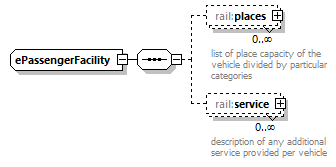 | ||
| namespace | https://www.railml.org/schemas/2021 | ||
| children | rail:places rail:service | ||
| used by |
| ||
| source | <xs:complexType name="ePassengerFacility"> <xs:sequence> <xs:element name="places" type="rail:tPlaces" minOccurs="0" maxOccurs="unbounded"> <xs:annotation> <xs:documentation>list of place capacity of the vehicle divided by particular categories</xs:documentation> <xs:documentation>See https://wiki2.railml.org/wiki/RS:places</xs:documentation> </xs:annotation> </xs:element> <xs:element name="service" type="rail:tService" minOccurs="0" maxOccurs="unbounded"> <xs:annotation> <xs:documentation>description of any additional service provided per vehicle</xs:documentation> <xs:documentation>See https://wiki2.railml.org/wiki/RS:service_passenger</xs:documentation> </xs:annotation> </xs:element> </xs:sequence> </xs:complexType> |
element ePassengerFacility/places
| diagram |  | ||||||||||||||||||||||||||||||||||||||
| namespace | https://www.railml.org/schemas/2021 | ||||||||||||||||||||||||||||||||||||||
| type | rail:tPlaces | ||||||||||||||||||||||||||||||||||||||
| properties |
| ||||||||||||||||||||||||||||||||||||||
| attributes |
| ||||||||||||||||||||||||||||||||||||||
| annotation |
| ||||||||||||||||||||||||||||||||||||||
| source | <xs:element name="places" type="rail:tPlaces" minOccurs="0" maxOccurs="unbounded"> <xs:annotation> <xs:documentation>list of place capacity of the vehicle divided by particular categories</xs:documentation> <xs:documentation>See https://wiki2.railml.org/wiki/RS:places</xs:documentation> </xs:annotation> </xs:element> |
element ePassengerFacility/service
| diagram |  | ||||||||||||||||||||||||||||||||||||||||||||||||||||
| namespace | https://www.railml.org/schemas/2021 | ||||||||||||||||||||||||||||||||||||||||||||||||||||
| type | rail:tService | ||||||||||||||||||||||||||||||||||||||||||||||||||||
| properties |
| ||||||||||||||||||||||||||||||||||||||||||||||||||||
| attributes |
| ||||||||||||||||||||||||||||||||||||||||||||||||||||
| annotation |
| ||||||||||||||||||||||||||||||||||||||||||||||||||||
| source | <xs:element name="service" type="rail:tService" minOccurs="0" maxOccurs="unbounded"> <xs:annotation> <xs:documentation>description of any additional service provided per vehicle</xs:documentation> <xs:documentation>See https://wiki2.railml.org/wiki/RS:service_passenger</xs:documentation> </xs:annotation> </xs:element> |
complexType tBasicBrakeType
| diagram |  | ||||||||||||||||||||||||||||||||||||||||||||||||||||||||||||||||||||||
| namespace | https://www.railml.org/schemas/2021 | ||||||||||||||||||||||||||||||||||||||||||||||||||||||||||||||||||||||
| children | rail:auxiliaryBrakes | ||||||||||||||||||||||||||||||||||||||||||||||||||||||||||||||||||||||
| used by |
| ||||||||||||||||||||||||||||||||||||||||||||||||||||||||||||||||||||||
| attributes |
| ||||||||||||||||||||||||||||||||||||||||||||||||||||||||||||||||||||||
| annotation |
| ||||||||||||||||||||||||||||||||||||||||||||||||||||||||||||||||||||||
| source | <xs:complexType name="tBasicBrakeType"> <xs:annotation> <xs:documentation>settings and characteristic of a particular brake type or brake application position</xs:documentation> <xs:documentation>See https://wiki2.railml.org/wiki/RS:vehicleBrake</xs:documentation> </xs:annotation> <xs:sequence> <xs:element name="auxiliaryBrakes" minOccurs="0" maxOccurs="unbounded"> <xs:annotation> <xs:documentation>provides access to the list of possible auxiliary brake systems</xs:documentation> <xs:documentation>See https://wiki2.railml.org/wiki/RS:auxiliaryBrakes_vehicleBrake and https://wiki2.railml.org/wiki/RS:auxiliaryBrakes_trainBrakes</xs:documentation> <xs:documentation>See https://wiki2.railml.org/wiki/TT:auxiliaryBrakes</xs:documentation> </xs:annotation> <xs:complexType> <xs:attributeGroup ref="rail:aAuxiliaryBrakes"/> <xs:attributeGroup ref="rail:anyAttribute"/> </xs:complexType> </xs:element> </xs:sequence> <xs:attributeGroup ref="rail:aBasicBrakeAttributes"/> </xs:complexType> |
element tBasicBrakeType/auxiliaryBrakes
| diagram |  | ||||||||||||||||||||||||||||||||||||||||||||||||||||
| namespace | https://www.railml.org/schemas/2021 | ||||||||||||||||||||||||||||||||||||||||||||||||||||
| properties |
| ||||||||||||||||||||||||||||||||||||||||||||||||||||
| attributes |
| ||||||||||||||||||||||||||||||||||||||||||||||||||||
| annotation |
| ||||||||||||||||||||||||||||||||||||||||||||||||||||
| source | <xs:element name="auxiliaryBrakes" minOccurs="0" maxOccurs="unbounded"> <xs:annotation> <xs:documentation>provides access to the list of possible auxiliary brake systems</xs:documentation> <xs:documentation>See https://wiki2.railml.org/wiki/RS:auxiliaryBrakes_vehicleBrake and https://wiki2.railml.org/wiki/RS:auxiliaryBrakes_trainBrakes</xs:documentation> <xs:documentation>See https://wiki2.railml.org/wiki/TT:auxiliaryBrakes</xs:documentation> </xs:annotation> <xs:complexType> <xs:attributeGroup ref="rail:aAuxiliaryBrakes"/> <xs:attributeGroup ref="rail:anyAttribute"/> </xs:complexType> </xs:element> |
complexType tClearanceGaugeType
| diagram |  | ||||||||||||||||
| namespace | https://www.railml.org/schemas/2021 | ||||||||||||||||
| used by |
| ||||||||||||||||
| attributes |
| ||||||||||||||||
| annotation |
| ||||||||||||||||
| source | <xs:complexType name="tClearanceGaugeType"> <xs:annotation> <xs:documentation>data about all compatible clearance gauges of the vehicle</xs:documentation> </xs:annotation> <xs:attributeGroup ref="rail:aClearanceGauge"/> </xs:complexType> |
complexType tConcessionaire
| diagram |  | ||||||||||||||||||||||||||||||||||||||||||||||
| namespace | https://www.railml.org/schemas/2021 | ||||||||||||||||||||||||||||||||||||||||||||||
| type | extension of rail:tOrganizationalUnit | ||||||||||||||||||||||||||||||||||||||||||||||
| properties |
| ||||||||||||||||||||||||||||||||||||||||||||||
| children | rail:additionalName rail:designator | ||||||||||||||||||||||||||||||||||||||||||||||
| used by |
| ||||||||||||||||||||||||||||||||||||||||||||||
| attributes |
| ||||||||||||||||||||||||||||||||||||||||||||||
| source | <xs:complexType name="tConcessionaire"> <xs:complexContent> <xs:extension base="rail:tOrganizationalUnit"/> </xs:complexContent> </xs:complexType> |
complexType tContractor
| diagram |  | ||||||||||||||||||||||||||||||||||||||||||||||||||||||||||||||
| namespace | https://www.railml.org/schemas/2021 | ||||||||||||||||||||||||||||||||||||||||||||||||||||||||||||||
| type | extension of rail:tOrganizationalUnit | ||||||||||||||||||||||||||||||||||||||||||||||||||||||||||||||
| properties |
| ||||||||||||||||||||||||||||||||||||||||||||||||||||||||||||||
| children | rail:additionalName rail:designator | ||||||||||||||||||||||||||||||||||||||||||||||||||||||||||||||
| used by |
| ||||||||||||||||||||||||||||||||||||||||||||||||||||||||||||||
| attributes |
| ||||||||||||||||||||||||||||||||||||||||||||||||||||||||||||||
| source | <xs:complexType name="tContractor"> <xs:complexContent> <xs:extension base="rail:tOrganizationalUnit"> <xs:attribute name="role" type="rail:tGenericName"> <xs:annotation> <xs:documentation>characterizes the kind of work that has to be fulfilled with the contract, e.g. catering, cleaning</xs:documentation> </xs:annotation> </xs:attribute> <xs:attribute name="subLevel" type="rail:tCounter"> <xs:annotation> <xs:documentation>the level of sub-contract, if appropriate, starting with zero for direct contracts</xs:documentation> </xs:annotation> </xs:attribute> </xs:extension> </xs:complexContent> </xs:complexType> |
attribute tContractor/@role
| type | rail:tGenericName | ||
| annotation |
| ||
| source | <xs:attribute name="role" type="rail:tGenericName"> <xs:annotation> <xs:documentation>characterizes the kind of work that has to be fulfilled with the contract, e.g. catering, cleaning</xs:documentation> </xs:annotation> </xs:attribute> |
attribute tContractor/@subLevel
| type | rail:tCounter | ||
| annotation |
| ||
| source | <xs:attribute name="subLevel" type="rail:tCounter"> <xs:annotation> <xs:documentation>the level of sub-contract, if appropriate, starting with zero for direct contracts</xs:documentation> </xs:annotation> </xs:attribute> |
complexType tCustomer
| diagram | 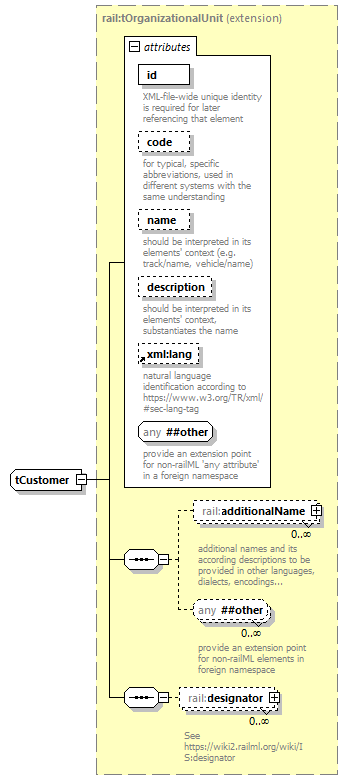 | ||||||||||||||||||||||||||||||||||||||||||||||
| namespace | https://www.railml.org/schemas/2021 | ||||||||||||||||||||||||||||||||||||||||||||||
| type | extension of rail:tOrganizationalUnit | ||||||||||||||||||||||||||||||||||||||||||||||
| properties |
| ||||||||||||||||||||||||||||||||||||||||||||||
| children | rail:additionalName rail:designator | ||||||||||||||||||||||||||||||||||||||||||||||
| used by |
| ||||||||||||||||||||||||||||||||||||||||||||||
| attributes |
| ||||||||||||||||||||||||||||||||||||||||||||||
| source | <xs:complexType name="tCustomer"> <xs:complexContent> <xs:extension base="rail:tOrganizationalUnit"/> </xs:complexContent> </xs:complexType> |
complexType tDesignator
| diagram |  | ||||||||||||||||||||||||||||||||||||
| namespace | https://www.railml.org/schemas/2021 | ||||||||||||||||||||||||||||||||||||
| used by |
| ||||||||||||||||||||||||||||||||||||
| attributes |
| ||||||||||||||||||||||||||||||||||||
| source | <xs:complexType name="tDesignator"> <xs:attribute name="register" type="xs:string" use="required"> <xs:annotation> <xs:documentation>name of the register, e.g. registers for OCPs: IBNR, DB640, RL100 or DIDOK</xs:documentation> <xs:documentation>choose a value from the railML codelist Registers.xml or name your own register starting with an underscore</xs:documentation> </xs:annotation> </xs:attribute> <xs:attribute name="entry" type="xs:string" use="required"> <xs:annotation> <xs:documentation>an entity's code in the specified register</xs:documentation> </xs:annotation> </xs:attribute> <xs:attributeGroup ref="rail:aTimePeriod"> <xs:annotation> <xs:documentation>the time period when the register is valid</xs:documentation> </xs:annotation> </xs:attributeGroup> <xs:attributeGroup ref="rail:anyAttribute"> <xs:annotation> <xs:documentation>provide an extension point for non-railML attributes in foreign namespace</xs:documentation> </xs:annotation> </xs:attributeGroup> </xs:complexType> |
attribute tDesignator/@register
| type | xs:string | ||||
| properties |
| ||||
| annotation |
| ||||
| source | <xs:attribute name="register" type="xs:string" use="required"> <xs:annotation> <xs:documentation>name of the register, e.g. registers for OCPs: IBNR, DB640, RL100 or DIDOK</xs:documentation> <xs:documentation>choose a value from the railML codelist Registers.xml or name your own register starting with an underscore</xs:documentation> </xs:annotation> </xs:attribute> |
attribute tDesignator/@entry
| type | xs:string | ||
| properties |
| ||
| annotation |
| ||
| source | <xs:attribute name="entry" type="xs:string" use="required"> <xs:annotation> <xs:documentation>an entity's code in the specified register</xs:documentation> </xs:annotation> </xs:attribute> |
complexType tDoneBy
| diagram |  | ||||||||||||||||||||||||||||||||||||||||||||||||||||||
| namespace | https://www.railml.org/schemas/2021 | ||||||||||||||||||||||||||||||||||||||||||||||||||||||
| type | extension of rail:tElementWithIDAndName | ||||||||||||||||||||||||||||||||||||||||||||||||||||||
| properties |
| ||||||||||||||||||||||||||||||||||||||||||||||||||||||
| children | rail:additionalName | ||||||||||||||||||||||||||||||||||||||||||||||||||||||
| used by |
| ||||||||||||||||||||||||||||||||||||||||||||||||||||||
| attributes |
| ||||||||||||||||||||||||||||||||||||||||||||||||||||||
| source | <xs:complexType name="tDoneBy"> <xs:complexContent> <xs:extension base="rail:tElementWithIDAndName"> <xs:attribute name="date" type="xs:date"> <xs:annotation> <xs:documentation>The date of a revision</xs:documentation> </xs:annotation> </xs:attribute> </xs:extension> </xs:complexContent> </xs:complexType> |
attribute tDoneBy/@date
| type | xs:date | ||
| annotation |
| ||
| source | <xs:attribute name="date" type="xs:date"> <xs:annotation> <xs:documentation>The date of a revision</xs:documentation> </xs:annotation> </xs:attribute> |
complexType tInfrastructureManager
| diagram |  | ||||||||||||||||||||||||||||||||||||||||||||||
| namespace | https://www.railml.org/schemas/2021 | ||||||||||||||||||||||||||||||||||||||||||||||
| type | extension of rail:tOrganizationalUnit | ||||||||||||||||||||||||||||||||||||||||||||||
| properties |
| ||||||||||||||||||||||||||||||||||||||||||||||
| children | rail:additionalName rail:designator | ||||||||||||||||||||||||||||||||||||||||||||||
| used by |
| ||||||||||||||||||||||||||||||||||||||||||||||
| attributes |
| ||||||||||||||||||||||||||||||||||||||||||||||
| source | <xs:complexType name="tInfrastructureManager"> <xs:complexContent> <xs:extension base="rail:tOrganizationalUnit"> <xs:annotation> <xs:documentation>use the separated infrastructureManagerCode list for the 'code' attribute</xs:documentation> </xs:annotation> </xs:extension> </xs:complexContent> </xs:complexType> |
complexType tMetadata
| diagram |  | ||
| namespace | https://www.railml.org/schemas/2021 | ||
| type | extension of elementContainer | ||
| properties |
| ||
| children | any rail:organizationalUnits rail:projects | ||
| used by |
| ||
| source | <xs:complexType name="tMetadata"> <xs:complexContent> <xs:extension base="dc:elementContainer"> <xs:annotation> <xs:documentation>flexible collection of Dublin Core metadata based on xs:any according to https://dublincore.org/</xs:documentation> </xs:annotation> <xs:sequence> <xs:element name="organizationalUnits" type="rail:tOrganizationalUnits" minOccurs="0"> <xs:annotation> <xs:documentation>Container element for various company definitions regarding the railway service of this file</xs:documentation> <xs:documentation>See https://wiki2.railml.org/wiki/CO:organizationalUnits</xs:documentation> </xs:annotation> </xs:element> <xs:element name="projects" type="rail:tProjects" minOccurs="0"> <xs:annotation> <xs:documentation>Container element for project desriptions</xs:documentation> <xs:documentation>See https://wiki2.railml.org/wiki/CO:projects</xs:documentation> </xs:annotation> </xs:element> </xs:sequence> </xs:extension> </xs:complexContent> </xs:complexType> |
element tMetadata/organizationalUnits
| diagram |  | ||||||
| namespace | https://www.railml.org/schemas/2021 | ||||||
| type | rail:tOrganizationalUnits | ||||||
| properties |
| ||||||
| children | rail:infrastructureManager rail:vehicleManufacturer rail:vehicleOwner rail:vehicleOperator rail:customer rail:railwayUndertaking rail:operationalUndertaking rail:concessionaire rail:contractor | ||||||
| annotation |
| ||||||
| source | <xs:element name="organizationalUnits" type="rail:tOrganizationalUnits" minOccurs="0"> <xs:annotation> <xs:documentation>Container element for various company definitions regarding the railway service of this file</xs:documentation> <xs:documentation>See https://wiki2.railml.org/wiki/CO:organizationalUnits</xs:documentation> </xs:annotation> </xs:element> |
element tMetadata/projects
| diagram |  | ||||||
| namespace | https://www.railml.org/schemas/2021 | ||||||
| type | rail:tProjects | ||||||
| properties |
| ||||||
| children | rail:project | ||||||
| annotation |
| ||||||
| source | <xs:element name="projects" type="rail:tProjects" minOccurs="0"> <xs:annotation> <xs:documentation>Container element for project desriptions</xs:documentation> <xs:documentation>See https://wiki2.railml.org/wiki/CO:projects</xs:documentation> </xs:annotation> </xs:element> |
complexType tObjectsRevised
| diagram |  | ||
| namespace | https://www.railml.org/schemas/2021 | ||
| children | rail:objectRevised | ||
| used by |
| ||
| source | <xs:complexType name="tObjectsRevised"> <xs:sequence> <xs:element name="objectRevised" type="rail:tElementWithReference" maxOccurs="unbounded"> <xs:annotation> <xs:documentation>Reference to an object that was changed in this revision.</xs:documentation> <xs:documentation>See https://wiki2.railml.org/wiki/CO:objectRevised</xs:documentation> </xs:annotation> </xs:element> </xs:sequence> </xs:complexType> |
element tObjectsRevised/objectRevised
| diagram |  | ||||||||||||||
| namespace | https://www.railml.org/schemas/2021 | ||||||||||||||
| type | rail:tElementWithReference | ||||||||||||||
| properties |
| ||||||||||||||
| attributes |
| ||||||||||||||
| annotation |
| ||||||||||||||
| source | <xs:element name="objectRevised" type="rail:tElementWithReference" maxOccurs="unbounded"> <xs:annotation> <xs:documentation>Reference to an object that was changed in this revision.</xs:documentation> <xs:documentation>See https://wiki2.railml.org/wiki/CO:objectRevised</xs:documentation> </xs:annotation> </xs:element> |
complexType tOperationalUndertaking
| diagram |  | ||||||||||||||||||||||||||||||||||||||||||||||
| namespace | https://www.railml.org/schemas/2021 | ||||||||||||||||||||||||||||||||||||||||||||||
| type | extension of rail:tOrganizationalUnit | ||||||||||||||||||||||||||||||||||||||||||||||
| properties |
| ||||||||||||||||||||||||||||||||||||||||||||||
| children | rail:additionalName rail:designator | ||||||||||||||||||||||||||||||||||||||||||||||
| used by |
| ||||||||||||||||||||||||||||||||||||||||||||||
| attributes |
| ||||||||||||||||||||||||||||||||||||||||||||||
| source | <xs:complexType name="tOperationalUndertaking"> <xs:complexContent> <xs:extension base="rail:tOrganizationalUnit"/> </xs:complexContent> </xs:complexType> |
complexType tOrganizationalUnit
| diagram |  | ||||||||||||||||||||||||||||||||||||||||||||||
| namespace | https://www.railml.org/schemas/2021 | ||||||||||||||||||||||||||||||||||||||||||||||
| type | extension of rail:tElementWithIDAndName | ||||||||||||||||||||||||||||||||||||||||||||||
| properties |
| ||||||||||||||||||||||||||||||||||||||||||||||
| children | rail:additionalName rail:designator | ||||||||||||||||||||||||||||||||||||||||||||||
| used by |
| ||||||||||||||||||||||||||||||||||||||||||||||
| attributes |
| ||||||||||||||||||||||||||||||||||||||||||||||
| source | <xs:complexType name="tOrganizationalUnit"> <xs:complexContent> <xs:extension base="rail:tElementWithIDAndName"> <xs:annotation> <xs:documentation>Base type for child elements of organizationalUnits</xs:documentation> </xs:annotation> <xs:sequence> <xs:element name="designator" type="rail:tDesignator" minOccurs="0" maxOccurs="unbounded"> <xs:annotation> <xs:documentation>See https://wiki2.railml.org/wiki/IS:designator</xs:documentation> </xs:annotation> </xs:element> </xs:sequence> </xs:extension> </xs:complexContent> </xs:complexType> |
element tOrganizationalUnit/designator
| diagram |  | ||||||||||||||||||||||||||||||||||||
| namespace | https://www.railml.org/schemas/2021 | ||||||||||||||||||||||||||||||||||||
| type | rail:tDesignator | ||||||||||||||||||||||||||||||||||||
| properties |
| ||||||||||||||||||||||||||||||||||||
| attributes |
| ||||||||||||||||||||||||||||||||||||
| annotation |
| ||||||||||||||||||||||||||||||||||||
| source | <xs:element name="designator" type="rail:tDesignator" minOccurs="0" maxOccurs="unbounded"> <xs:annotation> <xs:documentation>See https://wiki2.railml.org/wiki/IS:designator</xs:documentation> </xs:annotation> </xs:element> |
complexType tOrganizationalUnits
| diagram |  | ||
| namespace | https://www.railml.org/schemas/2021 | ||
| children | rail:infrastructureManager rail:vehicleManufacturer rail:vehicleOwner rail:vehicleOperator rail:customer rail:railwayUndertaking rail:operationalUndertaking rail:concessionaire rail:contractor | ||
| used by |
| ||
| source | <xs:complexType name="tOrganizationalUnits"> <xs:sequence> <xs:element name="infrastructureManager" type="rail:tInfrastructureManager" minOccurs="0" maxOccurs="unbounded"> <xs:annotation> <xs:documentation>Allows defining infrastructure managers (de: Infrastrukturbetreiber) to be referenced throughout the document. Via the attribute code it can be linked with the infrastructure manager codelist (infrastructureManagers.xml) that is published by railML.org and contains many international IMs.</xs:documentation> <xs:documentation>See https://wiki2.railml.org/wiki/CO:infrastructureManager</xs:documentation> </xs:annotation> </xs:element> <xs:element name="vehicleManufacturer" type="rail:tVehicleManufacturer" minOccurs="0" maxOccurs="unbounded"> <xs:annotation> <xs:documentation>Allows defining a vehicle manufacturer (de: Fahrzeughersteller) as an organizational unit to be referenced throughout the document.</xs:documentation> <xs:documentation>See https://wiki2.railml.org/wiki/CO:vehicleManufacturer</xs:documentation> </xs:annotation> </xs:element> <xs:element name="vehicleOwner" type="rail:tVehicleOwner" minOccurs="0" maxOccurs="unbounded"> <xs:annotation> <xs:documentation>Allows specifying vehicle owners as organizational units to be referenced throughout the document. A vehicle owner is an organisation that has the purpose of making railway vehicles available for railway undertakings</xs:documentation> <xs:documentation>See https://wiki2.railml.org/wiki/CO:vehicleOwner</xs:documentation> </xs:annotation> </xs:element> <xs:element name="vehicleOperator" type="rail:tVehicleOperator" minOccurs="0" maxOccurs="unbounded"> <xs:annotation> <xs:documentation>Allows specifying vehicle operators as organizational units to be referenced throughout the document. A vehicle operator is usually considered to be some kind of subcontractor (railway undertaking) that operates the vehicle, if different from the one that is responsible for the commercial service.</xs:documentation> <xs:documentation>See https://wiki2.railml.org/wiki/CO:vehicleOperator</xs:documentation> </xs:annotation> </xs:element> <xs:element name="customer" type="rail:tCustomer" minOccurs="0" maxOccurs="unbounded"> <xs:annotation> <xs:documentation>Allows specifying a customer as organizational unit to be referenced throughout the document. A customer is understood as the authority or enterprise that ordered the transportation service, i.e., an integrated transit system.</xs:documentation> <xs:documentation>See https://wiki2.railml.org/wiki/CO:customer</xs:documentation> </xs:annotation> </xs:element> <xs:element name="railwayUndertaking" type="rail:tRailwayUndertaking" minOccurs="0" maxOccurs="unbounded"> <xs:annotation> <xs:documentation>Allows specifying railway undertakings as organizational units that may be referenced throughout the document. The undertaking that is commercially responsible for the planned service. </xs:documentation> <xs:documentation>See https://wiki2.railml.org/wiki/CO:railwayUndertaking</xs:documentation> </xs:annotation> </xs:element> <xs:element name="operationalUndertaking" type="rail:tOperationalUndertaking" minOccurs="0" maxOccurs="unbounded"> <xs:annotation> <xs:documentation>Allows specifying an operational undertaking as an organizational unit to be referenced throughout the document. The operational undertaking is an entity the is responsible for operating a planned service on behalf of a railway undertaking.</xs:documentation> <xs:documentation>See https://wiki2.railml.org/wiki/CO:operationalUndertaking</xs:documentation> </xs:annotation> </xs:element> <xs:element name="concessionaire" type="rail:tConcessionaire" minOccurs="0" maxOccurs="unbounded"> <xs:annotation> <xs:documentation>Allows specifying a concessionaire (de: Konzessionsinhaber) as an organizational unti to be referenced thoughout the document.</xs:documentation> <xs:documentation>See https://wiki2.railml.org/wiki/CO:concessionaire</xs:documentation> </xs:annotation> </xs:element> <xs:element name="contractor" type="rail:tContractor" minOccurs="0" maxOccurs="unbounded"> <xs:annotation> <xs:documentation>Any unit or undertaking that has a binding not defined in a neighbouring element</xs:documentation> <xs:documentation>See https://wiki2.railml.org/wiki/CO:contractor</xs:documentation> </xs:annotation> </xs:element> </xs:sequence> </xs:complexType> |
element tOrganizationalUnits/infrastructureManager
| diagram |  | ||||||||||||||||||||||||||||||||||||||||||||||
| namespace | https://www.railml.org/schemas/2021 | ||||||||||||||||||||||||||||||||||||||||||||||
| type | rail:tInfrastructureManager | ||||||||||||||||||||||||||||||||||||||||||||||
| properties |
| ||||||||||||||||||||||||||||||||||||||||||||||
| children | rail:additionalName rail:designator | ||||||||||||||||||||||||||||||||||||||||||||||
| attributes |
| ||||||||||||||||||||||||||||||||||||||||||||||
| annotation |
| ||||||||||||||||||||||||||||||||||||||||||||||
| source | <xs:element name="infrastructureManager" type="rail:tInfrastructureManager" minOccurs="0" maxOccurs="unbounded"> <xs:annotation> <xs:documentation>Allows defining infrastructure managers (de: Infrastrukturbetreiber) to be referenced throughout the document. Via the attribute code it can be linked with the infrastructure manager codelist (infrastructureManagers.xml) that is published by railML.org and contains many international IMs.</xs:documentation> <xs:documentation>See https://wiki2.railml.org/wiki/CO:infrastructureManager</xs:documentation> </xs:annotation> </xs:element> |
element tOrganizationalUnits/vehicleManufacturer
| diagram |  | ||||||||||||||||||||||||||||||||||||||||||||||
| namespace | https://www.railml.org/schemas/2021 | ||||||||||||||||||||||||||||||||||||||||||||||
| type | rail:tVehicleManufacturer | ||||||||||||||||||||||||||||||||||||||||||||||
| properties |
| ||||||||||||||||||||||||||||||||||||||||||||||
| children | rail:additionalName rail:designator | ||||||||||||||||||||||||||||||||||||||||||||||
| attributes |
| ||||||||||||||||||||||||||||||||||||||||||||||
| annotation |
| ||||||||||||||||||||||||||||||||||||||||||||||
| source | <xs:element name="vehicleManufacturer" type="rail:tVehicleManufacturer" minOccurs="0" maxOccurs="unbounded"> <xs:annotation> <xs:documentation>Allows defining a vehicle manufacturer (de: Fahrzeughersteller) as an organizational unit to be referenced throughout the document.</xs:documentation> <xs:documentation>See https://wiki2.railml.org/wiki/CO:vehicleManufacturer</xs:documentation> </xs:annotation> </xs:element> |
element tOrganizationalUnits/vehicleOwner
| diagram |  | ||||||||||||||||||||||||||||||||||||||||||||||
| namespace | https://www.railml.org/schemas/2021 | ||||||||||||||||||||||||||||||||||||||||||||||
| type | rail:tVehicleOwner | ||||||||||||||||||||||||||||||||||||||||||||||
| properties |
| ||||||||||||||||||||||||||||||||||||||||||||||
| children | rail:additionalName rail:designator | ||||||||||||||||||||||||||||||||||||||||||||||
| attributes |
| ||||||||||||||||||||||||||||||||||||||||||||||
| annotation |
| ||||||||||||||||||||||||||||||||||||||||||||||
| source | <xs:element name="vehicleOwner" type="rail:tVehicleOwner" minOccurs="0" maxOccurs="unbounded"> <xs:annotation> <xs:documentation>Allows specifying vehicle owners as organizational units to be referenced throughout the document. A vehicle owner is an organisation that has the purpose of making railway vehicles available for railway undertakings</xs:documentation> <xs:documentation>See https://wiki2.railml.org/wiki/CO:vehicleOwner</xs:documentation> </xs:annotation> </xs:element> |
element tOrganizationalUnits/vehicleOperator
| diagram |  | ||||||||||||||||||||||||||||||||||||||||||||||
| namespace | https://www.railml.org/schemas/2021 | ||||||||||||||||||||||||||||||||||||||||||||||
| type | rail:tVehicleOperator | ||||||||||||||||||||||||||||||||||||||||||||||
| properties |
| ||||||||||||||||||||||||||||||||||||||||||||||
| children | rail:additionalName rail:designator | ||||||||||||||||||||||||||||||||||||||||||||||
| attributes |
| ||||||||||||||||||||||||||||||||||||||||||||||
| annotation |
| ||||||||||||||||||||||||||||||||||||||||||||||
| source | <xs:element name="vehicleOperator" type="rail:tVehicleOperator" minOccurs="0" maxOccurs="unbounded"> <xs:annotation> <xs:documentation>Allows specifying vehicle operators as organizational units to be referenced throughout the document. A vehicle operator is usually considered to be some kind of subcontractor (railway undertaking) that operates the vehicle, if different from the one that is responsible for the commercial service.</xs:documentation> <xs:documentation>See https://wiki2.railml.org/wiki/CO:vehicleOperator</xs:documentation> </xs:annotation> </xs:element> |
element tOrganizationalUnits/customer
| diagram | 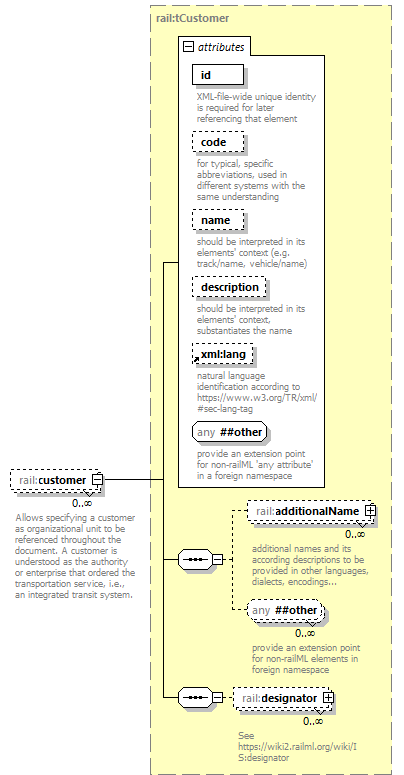 | ||||||||||||||||||||||||||||||||||||||||||||||
| namespace | https://www.railml.org/schemas/2021 | ||||||||||||||||||||||||||||||||||||||||||||||
| type | rail:tCustomer | ||||||||||||||||||||||||||||||||||||||||||||||
| properties |
| ||||||||||||||||||||||||||||||||||||||||||||||
| children | rail:additionalName rail:designator | ||||||||||||||||||||||||||||||||||||||||||||||
| attributes |
| ||||||||||||||||||||||||||||||||||||||||||||||
| annotation |
| ||||||||||||||||||||||||||||||||||||||||||||||
| source | <xs:element name="customer" type="rail:tCustomer" minOccurs="0" maxOccurs="unbounded"> <xs:annotation> <xs:documentation>Allows specifying a customer as organizational unit to be referenced throughout the document. A customer is understood as the authority or enterprise that ordered the transportation service, i.e., an integrated transit system.</xs:documentation> <xs:documentation>See https://wiki2.railml.org/wiki/CO:customer</xs:documentation> </xs:annotation> </xs:element> |
element tOrganizationalUnits/railwayUndertaking
| diagram | 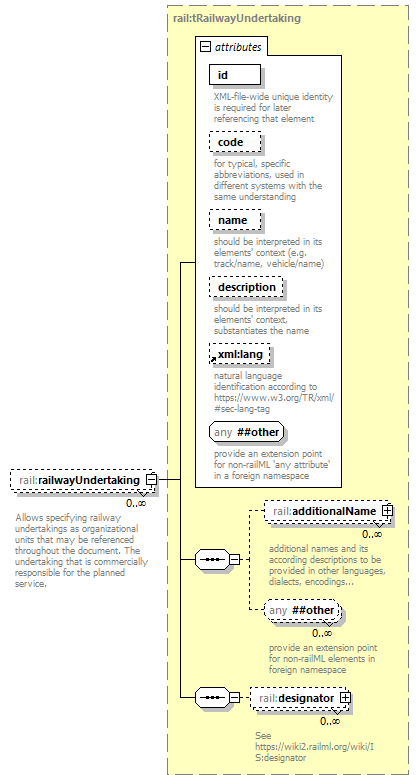 | ||||||||||||||||||||||||||||||||||||||||||||||
| namespace | https://www.railml.org/schemas/2021 | ||||||||||||||||||||||||||||||||||||||||||||||
| type | rail:tRailwayUndertaking | ||||||||||||||||||||||||||||||||||||||||||||||
| properties |
| ||||||||||||||||||||||||||||||||||||||||||||||
| children | rail:additionalName rail:designator | ||||||||||||||||||||||||||||||||||||||||||||||
| attributes |
| ||||||||||||||||||||||||||||||||||||||||||||||
| annotation |
| ||||||||||||||||||||||||||||||||||||||||||||||
| source | <xs:element name="railwayUndertaking" type="rail:tRailwayUndertaking" minOccurs="0" maxOccurs="unbounded"> <xs:annotation> <xs:documentation>Allows specifying railway undertakings as organizational units that may be referenced throughout the document. The undertaking that is commercially responsible for the planned service. </xs:documentation> <xs:documentation>See https://wiki2.railml.org/wiki/CO:railwayUndertaking</xs:documentation> </xs:annotation> </xs:element> |
element tOrganizationalUnits/operationalUndertaking
| diagram |  | ||||||||||||||||||||||||||||||||||||||||||||||
| namespace | https://www.railml.org/schemas/2021 | ||||||||||||||||||||||||||||||||||||||||||||||
| type | rail:tOperationalUndertaking | ||||||||||||||||||||||||||||||||||||||||||||||
| properties |
| ||||||||||||||||||||||||||||||||||||||||||||||
| children | rail:additionalName rail:designator | ||||||||||||||||||||||||||||||||||||||||||||||
| attributes |
| ||||||||||||||||||||||||||||||||||||||||||||||
| annotation |
| ||||||||||||||||||||||||||||||||||||||||||||||
| source | <xs:element name="operationalUndertaking" type="rail:tOperationalUndertaking" minOccurs="0" maxOccurs="unbounded"> <xs:annotation> <xs:documentation>Allows specifying an operational undertaking as an organizational unit to be referenced throughout the document. The operational undertaking is an entity the is responsible for operating a planned service on behalf of a railway undertaking.</xs:documentation> <xs:documentation>See https://wiki2.railml.org/wiki/CO:operationalUndertaking</xs:documentation> </xs:annotation> </xs:element> |
element tOrganizationalUnits/concessionaire
| diagram | 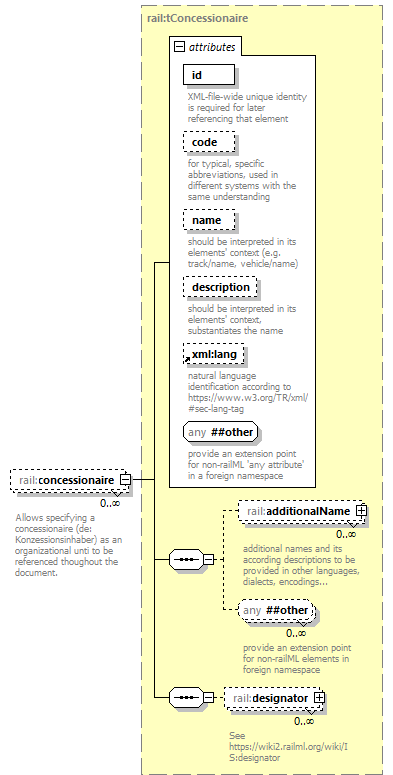 | ||||||||||||||||||||||||||||||||||||||||||||||
| namespace | https://www.railml.org/schemas/2021 | ||||||||||||||||||||||||||||||||||||||||||||||
| type | rail:tConcessionaire | ||||||||||||||||||||||||||||||||||||||||||||||
| properties |
| ||||||||||||||||||||||||||||||||||||||||||||||
| children | rail:additionalName rail:designator | ||||||||||||||||||||||||||||||||||||||||||||||
| attributes |
| ||||||||||||||||||||||||||||||||||||||||||||||
| annotation |
| ||||||||||||||||||||||||||||||||||||||||||||||
| source | <xs:element name="concessionaire" type="rail:tConcessionaire" minOccurs="0" maxOccurs="unbounded"> <xs:annotation> <xs:documentation>Allows specifying a concessionaire (de: Konzessionsinhaber) as an organizational unti to be referenced thoughout the document.</xs:documentation> <xs:documentation>See https://wiki2.railml.org/wiki/CO:concessionaire</xs:documentation> </xs:annotation> </xs:element> |
element tOrganizationalUnits/contractor
| diagram | 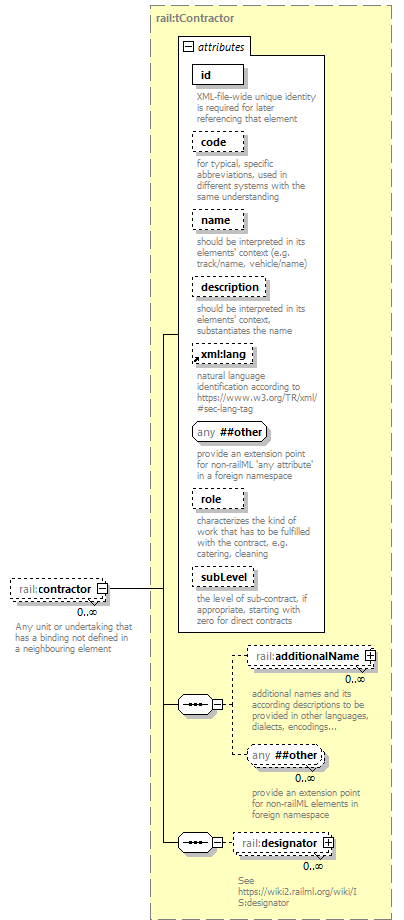 | ||||||||||||||||||||||||||||||||||||||||||||||||||||||||||||||
| namespace | https://www.railml.org/schemas/2021 | ||||||||||||||||||||||||||||||||||||||||||||||||||||||||||||||
| type | rail:tContractor | ||||||||||||||||||||||||||||||||||||||||||||||||||||||||||||||
| properties |
| ||||||||||||||||||||||||||||||||||||||||||||||||||||||||||||||
| children | rail:additionalName rail:designator | ||||||||||||||||||||||||||||||||||||||||||||||||||||||||||||||
| attributes |
| ||||||||||||||||||||||||||||||||||||||||||||||||||||||||||||||
| annotation |
| ||||||||||||||||||||||||||||||||||||||||||||||||||||||||||||||
| source | <xs:element name="contractor" type="rail:tContractor" minOccurs="0" maxOccurs="unbounded"> <xs:annotation> <xs:documentation>Any unit or undertaking that has a binding not defined in a neighbouring element</xs:documentation> <xs:documentation>See https://wiki2.railml.org/wiki/CO:contractor</xs:documentation> </xs:annotation> </xs:element> |
complexType tPhase
| diagram | 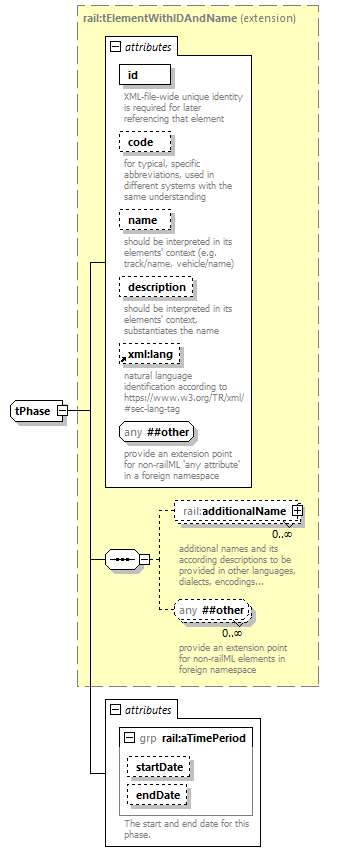 | ||||||||||||||||||||||||||||||||||||||||||||||||||||||||||
| namespace | https://www.railml.org/schemas/2021 | ||||||||||||||||||||||||||||||||||||||||||||||||||||||||||
| type | extension of rail:tElementWithIDAndName | ||||||||||||||||||||||||||||||||||||||||||||||||||||||||||
| properties |
| ||||||||||||||||||||||||||||||||||||||||||||||||||||||||||
| children | rail:additionalName | ||||||||||||||||||||||||||||||||||||||||||||||||||||||||||
| used by |
| ||||||||||||||||||||||||||||||||||||||||||||||||||||||||||
| attributes |
| ||||||||||||||||||||||||||||||||||||||||||||||||||||||||||
| source | <xs:complexType name="tPhase"> <xs:complexContent> <xs:extension base="rail:tElementWithIDAndName"> <xs:attributeGroup ref="rail:aTimePeriod"> <xs:annotation> <xs:documentation>The start and end date for this phase.</xs:documentation> </xs:annotation> </xs:attributeGroup> </xs:extension> </xs:complexContent> </xs:complexType> |
complexType tPlaces
| diagram | 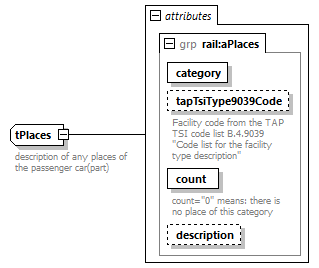 | ||||||||||||||||||||||||||||||||||||||
| namespace | https://www.railml.org/schemas/2021 | ||||||||||||||||||||||||||||||||||||||
| used by |
| ||||||||||||||||||||||||||||||||||||||
| attributes |
| ||||||||||||||||||||||||||||||||||||||
| annotation |
| ||||||||||||||||||||||||||||||||||||||
| source | <xs:complexType name="tPlaces"> <xs:annotation> <xs:documentation>description of any places of the passenger car(part)</xs:documentation> <xs:documentation>See https://wiki2.railml.org/wiki/RS:places</xs:documentation> </xs:annotation> <xs:attributeGroup ref="rail:aPlaces"/> </xs:complexType> |
complexType tProject
| diagram |  | ||||||||||||||||||||||||||||||||||||||||||||||
| namespace | https://www.railml.org/schemas/2021 | ||||||||||||||||||||||||||||||||||||||||||||||
| type | extension of rail:tElementWithIDAndName | ||||||||||||||||||||||||||||||||||||||||||||||
| properties |
| ||||||||||||||||||||||||||||||||||||||||||||||
| children | rail:additionalName rail:designator rail:alternative rail:phase rail:revision rail:projectArea | ||||||||||||||||||||||||||||||||||||||||||||||
| used by |
| ||||||||||||||||||||||||||||||||||||||||||||||
| attributes |
| ||||||||||||||||||||||||||||||||||||||||||||||
| source | <xs:complexType name="tProject"> <xs:complexContent> <xs:extension base="rail:tElementWithIDAndName"> <xs:sequence> <xs:element name="designator" type="rail:tDesignator" minOccurs="0"> <xs:annotation> <xs:documentation>External identifier of the project.</xs:documentation> <xs:documentation>See https://wiki2.railml.org/wiki/IS:designator</xs:documentation> </xs:annotation> </xs:element> <xs:element name="alternative" type="rail:tElementWithIDAndName" minOccurs="0"> <xs:annotation> <xs:documentation>If a project has multiple alternative solutions, this elements is used to specify which alternative is presented in this railML file.</xs:documentation> <xs:documentation>See https://wiki2.railml.org/wiki/CO:alternative</xs:documentation> </xs:annotation> </xs:element> <xs:element name="phase" type="rail:tPhase" minOccurs="0"> <xs:annotation> <xs:documentation>Describes which phase of the project this file represents.</xs:documentation> <xs:documentation>See https://wiki2.railml.org/wiki/CO:phase</xs:documentation> </xs:annotation> </xs:element> <xs:element name="revision" type="rail:tRevision" minOccurs="0"> <xs:annotation> <xs:documentation>Describes changes from a previous revision and the authors and auditors of these changes.</xs:documentation> <xs:documentation>See https://wiki2.railml.org/wiki/CO:revision</xs:documentation> </xs:annotation> </xs:element> <xs:element name="projectArea" type="rail:tElementWithReference" minOccurs="0" maxOccurs="unbounded"> <xs:annotation> <xs:documentation>Reference to a project area.</xs:documentation> <xs:documentation>See https://wiki2.railml.org/wiki/CO:projectArea</xs:documentation> </xs:annotation> </xs:element> </xs:sequence> </xs:extension> </xs:complexContent> </xs:complexType> |
element tProject/designator
| diagram |  | ||||||||||||||||||||||||||||||||||||
| namespace | https://www.railml.org/schemas/2021 | ||||||||||||||||||||||||||||||||||||
| type | rail:tDesignator | ||||||||||||||||||||||||||||||||||||
| properties |
| ||||||||||||||||||||||||||||||||||||
| attributes |
| ||||||||||||||||||||||||||||||||||||
| annotation |
| ||||||||||||||||||||||||||||||||||||
| source | <xs:element name="designator" type="rail:tDesignator" minOccurs="0"> <xs:annotation> <xs:documentation>External identifier of the project.</xs:documentation> <xs:documentation>See https://wiki2.railml.org/wiki/IS:designator</xs:documentation> </xs:annotation> </xs:element> |
element tProject/alternative
| diagram |  | ||||||||||||||||||||||||||||||||||||||||||||||
| namespace | https://www.railml.org/schemas/2021 | ||||||||||||||||||||||||||||||||||||||||||||||
| type | rail:tElementWithIDAndName | ||||||||||||||||||||||||||||||||||||||||||||||
| properties |
| ||||||||||||||||||||||||||||||||||||||||||||||
| children | rail:additionalName | ||||||||||||||||||||||||||||||||||||||||||||||
| attributes |
| ||||||||||||||||||||||||||||||||||||||||||||||
| annotation |
| ||||||||||||||||||||||||||||||||||||||||||||||
| source | <xs:element name="alternative" type="rail:tElementWithIDAndName" minOccurs="0"> <xs:annotation> <xs:documentation>If a project has multiple alternative solutions, this elements is used to specify which alternative is presented in this railML file.</xs:documentation> <xs:documentation>See https://wiki2.railml.org/wiki/CO:alternative</xs:documentation> </xs:annotation> </xs:element> |
element tProject/phase
| diagram |  | ||||||||||||||||||||||||||||||||||||||||||||||||||||||||||
| namespace | https://www.railml.org/schemas/2021 | ||||||||||||||||||||||||||||||||||||||||||||||||||||||||||
| type | rail:tPhase | ||||||||||||||||||||||||||||||||||||||||||||||||||||||||||
| properties |
| ||||||||||||||||||||||||||||||||||||||||||||||||||||||||||
| children | rail:additionalName | ||||||||||||||||||||||||||||||||||||||||||||||||||||||||||
| attributes |
| ||||||||||||||||||||||||||||||||||||||||||||||||||||||||||
| annotation |
| ||||||||||||||||||||||||||||||||||||||||||||||||||||||||||
| source | <xs:element name="phase" type="rail:tPhase" minOccurs="0"> <xs:annotation> <xs:documentation>Describes which phase of the project this file represents.</xs:documentation> <xs:documentation>See https://wiki2.railml.org/wiki/CO:phase</xs:documentation> </xs:annotation> </xs:element> |
element tProject/revision
| diagram |  | ||||||||||||||||||||||||||||||||||||||||||||||||||||||
| namespace | https://www.railml.org/schemas/2021 | ||||||||||||||||||||||||||||||||||||||||||||||||||||||
| type | rail:tRevision | ||||||||||||||||||||||||||||||||||||||||||||||||||||||
| properties |
| ||||||||||||||||||||||||||||||||||||||||||||||||||||||
| children | rail:additionalName rail:objectsRevised rail:revisedBy rail:checkedBy rail:approvedBy | ||||||||||||||||||||||||||||||||||||||||||||||||||||||
| attributes |
| ||||||||||||||||||||||||||||||||||||||||||||||||||||||
| annotation |
| ||||||||||||||||||||||||||||||||||||||||||||||||||||||
| source | <xs:element name="revision" type="rail:tRevision" minOccurs="0"> <xs:annotation> <xs:documentation>Describes changes from a previous revision and the authors and auditors of these changes.</xs:documentation> <xs:documentation>See https://wiki2.railml.org/wiki/CO:revision</xs:documentation> </xs:annotation> </xs:element> |
element tProject/projectArea
| diagram | 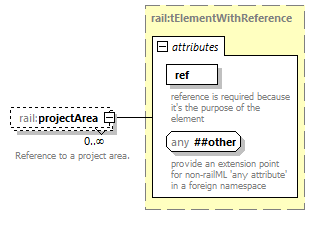 | ||||||||||||||
| namespace | https://www.railml.org/schemas/2021 | ||||||||||||||
| type | rail:tElementWithReference | ||||||||||||||
| properties |
| ||||||||||||||
| attributes |
| ||||||||||||||
| annotation |
| ||||||||||||||
| source | <xs:element name="projectArea" type="rail:tElementWithReference" minOccurs="0" maxOccurs="unbounded"> <xs:annotation> <xs:documentation>Reference to a project area.</xs:documentation> <xs:documentation>See https://wiki2.railml.org/wiki/CO:projectArea</xs:documentation> </xs:annotation> </xs:element> |
complexType tProjects
| diagram |  | ||
| namespace | https://www.railml.org/schemas/2021 | ||
| children | rail:project | ||
| used by |
| ||
| source | <xs:complexType name="tProjects"> <xs:sequence> <xs:element name="project" type="rail:tProject" maxOccurs="unbounded"> <xs:annotation> <xs:documentation>Describes one or more projects this railML model belongs to.</xs:documentation> <xs:documentation>See https://wiki2.railml.org/wiki/CO:project</xs:documentation> </xs:annotation> </xs:element> </xs:sequence> </xs:complexType> |
element tProjects/project
| diagram |  | ||||||||||||||||||||||||||||||||||||||||||||||
| namespace | https://www.railml.org/schemas/2021 | ||||||||||||||||||||||||||||||||||||||||||||||
| type | rail:tProject | ||||||||||||||||||||||||||||||||||||||||||||||
| properties |
| ||||||||||||||||||||||||||||||||||||||||||||||
| children | rail:additionalName rail:designator rail:alternative rail:phase rail:revision rail:projectArea | ||||||||||||||||||||||||||||||||||||||||||||||
| attributes |
| ||||||||||||||||||||||||||||||||||||||||||||||
| annotation |
| ||||||||||||||||||||||||||||||||||||||||||||||
| source | <xs:element name="project" type="rail:tProject" maxOccurs="unbounded"> <xs:annotation> <xs:documentation>Describes one or more projects this railML model belongs to.</xs:documentation> <xs:documentation>See https://wiki2.railml.org/wiki/CO:project</xs:documentation> </xs:annotation> </xs:element> |
complexType tRailwayUndertaking
| diagram |  | ||||||||||||||||||||||||||||||||||||||||||||||
| namespace | https://www.railml.org/schemas/2021 | ||||||||||||||||||||||||||||||||||||||||||||||
| type | extension of rail:tOrganizationalUnit | ||||||||||||||||||||||||||||||||||||||||||||||
| properties |
| ||||||||||||||||||||||||||||||||||||||||||||||
| children | rail:additionalName rail:designator | ||||||||||||||||||||||||||||||||||||||||||||||
| used by |
| ||||||||||||||||||||||||||||||||||||||||||||||
| attributes |
| ||||||||||||||||||||||||||||||||||||||||||||||
| source | <xs:complexType name="tRailwayUndertaking"> <xs:complexContent> <xs:extension base="rail:tOrganizationalUnit"/> </xs:complexContent> </xs:complexType> |
complexType tRevision
| diagram |  | ||||||||||||||||||||||||||||||||||||||||||||||||||||||
| namespace | https://www.railml.org/schemas/2021 | ||||||||||||||||||||||||||||||||||||||||||||||||||||||
| type | extension of rail:tElementWithIDAndName | ||||||||||||||||||||||||||||||||||||||||||||||||||||||
| properties |
| ||||||||||||||||||||||||||||||||||||||||||||||||||||||
| children | rail:additionalName rail:objectsRevised rail:revisedBy rail:checkedBy rail:approvedBy | ||||||||||||||||||||||||||||||||||||||||||||||||||||||
| used by |
| ||||||||||||||||||||||||||||||||||||||||||||||||||||||
| attributes |
| ||||||||||||||||||||||||||||||||||||||||||||||||||||||
| source | <xs:complexType name="tRevision"> <xs:complexContent> <xs:extension base="rail:tElementWithIDAndName"> <xs:sequence> <xs:element name="objectsRevised" type="rail:tObjectsRevised" minOccurs="0"> <xs:annotation> <xs:documentation>Container for references to objects changed in this revision.</xs:documentation> <xs:documentation>See https://wiki2.railml.org/wiki/CO:objectsRevised</xs:documentation> </xs:annotation> </xs:element> <xs:element name="revisedBy" type="rail:tDoneBy" minOccurs="0" maxOccurs="unbounded"> <xs:annotation> <xs:documentation>The author(s) of this revision</xs:documentation> <xs:documentation>See https://wiki2.railml.org/wiki/CO:revisedBy</xs:documentation> </xs:annotation> </xs:element> <xs:element name="checkedBy" type="rail:tDoneBy" minOccurs="0" maxOccurs="unbounded"> <xs:annotation> <xs:documentation>The peer-reviewer(s) of this revision</xs:documentation> <xs:documentation>See https://wiki2.railml.org/wiki/CO:checkedBy</xs:documentation> </xs:annotation> </xs:element> <xs:element name="approvedBy" type="rail:tDoneBy" minOccurs="0" maxOccurs="unbounded"> <xs:annotation> <xs:documentation>The person(s) who approved this revision</xs:documentation> <xs:documentation>See https://wiki2.railml.org/wiki/CO:approvedBy</xs:documentation> </xs:annotation> </xs:element> </xs:sequence> <xs:attribute name="initialProjectRef" type="rail:tGenericRef"> <xs:annotation> <xs:documentation>Reference to a project element describing the previous revision. This may be the same project with another alternative or revision, or another project that was the base for this one.</xs:documentation> </xs:annotation> </xs:attribute> </xs:extension> </xs:complexContent> </xs:complexType> |
attribute tRevision/@initialProjectRef
| type | rail:tGenericRef | ||
| annotation |
| ||
| source | <xs:attribute name="initialProjectRef" type="rail:tGenericRef"> <xs:annotation> <xs:documentation>Reference to a project element describing the previous revision. This may be the same project with another alternative or revision, or another project that was the base for this one.</xs:documentation> </xs:annotation> </xs:attribute> |
element tRevision/objectsRevised
| diagram | 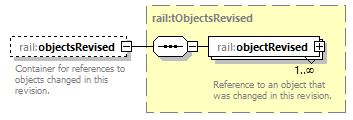 | ||||||
| namespace | https://www.railml.org/schemas/2021 | ||||||
| type | rail:tObjectsRevised | ||||||
| properties |
| ||||||
| children | rail:objectRevised | ||||||
| annotation |
| ||||||
| source | <xs:element name="objectsRevised" type="rail:tObjectsRevised" minOccurs="0"> <xs:annotation> <xs:documentation>Container for references to objects changed in this revision.</xs:documentation> <xs:documentation>See https://wiki2.railml.org/wiki/CO:objectsRevised</xs:documentation> </xs:annotation> </xs:element> |
element tRevision/revisedBy
| diagram |  | ||||||||||||||||||||||||||||||||||||||||||||||||||||||
| namespace | https://www.railml.org/schemas/2021 | ||||||||||||||||||||||||||||||||||||||||||||||||||||||
| type | rail:tDoneBy | ||||||||||||||||||||||||||||||||||||||||||||||||||||||
| properties |
| ||||||||||||||||||||||||||||||||||||||||||||||||||||||
| children | rail:additionalName | ||||||||||||||||||||||||||||||||||||||||||||||||||||||
| attributes |
| ||||||||||||||||||||||||||||||||||||||||||||||||||||||
| annotation |
| ||||||||||||||||||||||||||||||||||||||||||||||||||||||
| source | <xs:element name="revisedBy" type="rail:tDoneBy" minOccurs="0" maxOccurs="unbounded"> <xs:annotation> <xs:documentation>The author(s) of this revision</xs:documentation> <xs:documentation>See https://wiki2.railml.org/wiki/CO:revisedBy</xs:documentation> </xs:annotation> </xs:element> |
element tRevision/checkedBy
| diagram | 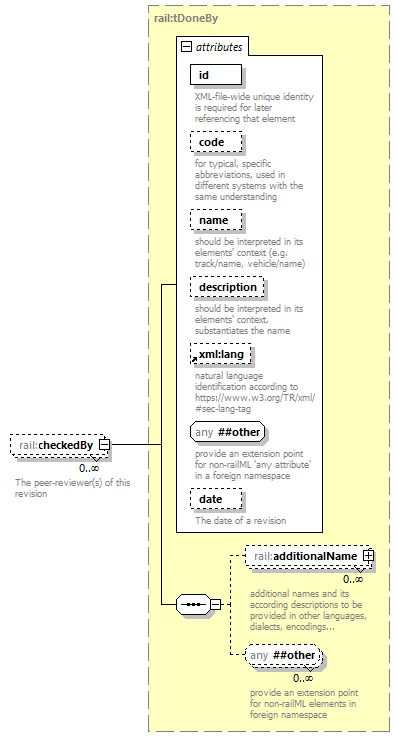 | ||||||||||||||||||||||||||||||||||||||||||||||||||||||
| namespace | https://www.railml.org/schemas/2021 | ||||||||||||||||||||||||||||||||||||||||||||||||||||||
| type | rail:tDoneBy | ||||||||||||||||||||||||||||||||||||||||||||||||||||||
| properties |
| ||||||||||||||||||||||||||||||||||||||||||||||||||||||
| children | rail:additionalName | ||||||||||||||||||||||||||||||||||||||||||||||||||||||
| attributes |
| ||||||||||||||||||||||||||||||||||||||||||||||||||||||
| annotation |
| ||||||||||||||||||||||||||||||||||||||||||||||||||||||
| source | <xs:element name="checkedBy" type="rail:tDoneBy" minOccurs="0" maxOccurs="unbounded"> <xs:annotation> <xs:documentation>The peer-reviewer(s) of this revision</xs:documentation> <xs:documentation>See https://wiki2.railml.org/wiki/CO:checkedBy</xs:documentation> </xs:annotation> </xs:element> |
element tRevision/approvedBy
| diagram |  | ||||||||||||||||||||||||||||||||||||||||||||||||||||||
| namespace | https://www.railml.org/schemas/2021 | ||||||||||||||||||||||||||||||||||||||||||||||||||||||
| type | rail:tDoneBy | ||||||||||||||||||||||||||||||||||||||||||||||||||||||
| properties |
| ||||||||||||||||||||||||||||||||||||||||||||||||||||||
| children | rail:additionalName | ||||||||||||||||||||||||||||||||||||||||||||||||||||||
| attributes |
| ||||||||||||||||||||||||||||||||||||||||||||||||||||||
| annotation |
| ||||||||||||||||||||||||||||||||||||||||||||||||||||||
| source | <xs:element name="approvedBy" type="rail:tDoneBy" minOccurs="0" maxOccurs="unbounded"> <xs:annotation> <xs:documentation>The person(s) who approved this revision</xs:documentation> <xs:documentation>See https://wiki2.railml.org/wiki/CO:approvedBy</xs:documentation> </xs:annotation> </xs:element> |
complexType tService
| diagram | 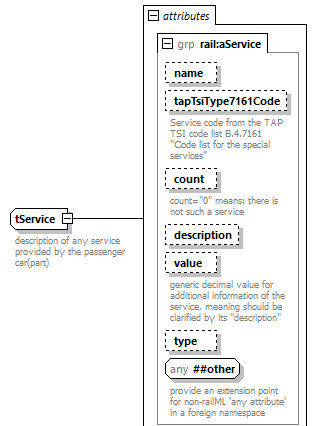 | ||||||||||||||||||||||||||||||||||||||||||||||||||||
| namespace | https://www.railml.org/schemas/2021 | ||||||||||||||||||||||||||||||||||||||||||||||||||||
| used by |
| ||||||||||||||||||||||||||||||||||||||||||||||||||||
| attributes |
| ||||||||||||||||||||||||||||||||||||||||||||||||||||
| annotation |
| ||||||||||||||||||||||||||||||||||||||||||||||||||||
| source | <xs:complexType name="tService"> <xs:annotation> <xs:documentation>description of any service provided by the passenger car(part)</xs:documentation> <xs:documentation>See https://wiki2.railml.org/wiki/RS:service_passenger</xs:documentation> </xs:annotation> <xs:attributeGroup ref="rail:aService"/> </xs:complexType> |
complexType tState
| diagram |  | ||||||||||||||||||||||||||||||||||||||||||||||||||||||||||||||||||||||||||||||
| namespace | https://www.railml.org/schemas/2021 | ||||||||||||||||||||||||||||||||||||||||||||||||||||||||||||||||||||||||||||||
| type | extension of rail:tElementWithID | ||||||||||||||||||||||||||||||||||||||||||||||||||||||||||||||||||||||||||||||
| properties |
| ||||||||||||||||||||||||||||||||||||||||||||||||||||||||||||||||||||||||||||||
| children | rail:designator | ||||||||||||||||||||||||||||||||||||||||||||||||||||||||||||||||||||||||||||||
| used by |
| ||||||||||||||||||||||||||||||||||||||||||||||||||||||||||||||||||||||||||||||
| attributes |
| ||||||||||||||||||||||||||||||||||||||||||||||||||||||||||||||||||||||||||||||
| source | <xs:complexType name="tState"> <xs:complexContent> <xs:extension base="rail:tElementWithID"> <xs:sequence> <xs:element name="designator" type="rail:tDesignator" minOccurs="0" maxOccurs="unbounded"> <xs:annotation> <xs:documentation>See https://wiki2.railml.org/wiki/IS:designator</xs:documentation> </xs:annotation> </xs:element> <xs:any namespace="##other" processContents="strict" minOccurs="0" maxOccurs="unbounded"> <xs:annotation> <xs:documentation>provide an extension point for non-railML elements in foreign namespace</xs:documentation> </xs:annotation> </xs:any> </xs:sequence> <xs:attribute name="disabled" type="xs:boolean" use="required"> <xs:annotation> <xs:documentation>This attribute is 'true' if the object is somehow disabled.</xs:documentation> </xs:annotation> </xs:attribute> <xs:attribute name="status" type="rail:tInfrastructureStatus"> <xs:annotation> <xs:documentation>defines the status of the object from perspective of its availability</xs:documentation> </xs:annotation> </xs:attribute> <xs:attribute name="operatingPeriodRef" type="rail:tGenericRef"> <xs:annotation> <xs:documentation>The temporal frame of the 'state' should be defined in the 'timetable' part of the railML file, using the 'operatingPeriod' element.</xs:documentation> </xs:annotation> </xs:attribute> <xs:attributeGroup ref="rail:aPeriodTimeSpan"> <xs:annotation> <xs:documentation>Start and/or end time of this state if linked with an operating period.</xs:documentation> </xs:annotation> </xs:attributeGroup> <xs:attributeGroup ref="rail:aExactTimeSpan"> <xs:annotation> <xs:documentation>start and/or end time of this state if not linked with an operating period.</xs:documentation> </xs:annotation> </xs:attributeGroup> <xs:attribute name="endDayOffset" type="xs:nonNegativeInteger"> <xs:annotation> <xs:documentation>The number of midnight overruns over which this state persists, when linked with an operating period.</xs:documentation> </xs:annotation> </xs:attribute> <xs:attribute name="remarks" type="rail:tElementDescription"> <xs:annotation> <xs:documentation>This is to further explain the 'state' definition.</xs:documentation> </xs:annotation> </xs:attribute> <xs:attributeGroup ref="rail:anyAttribute"/> </xs:extension> </xs:complexContent> </xs:complexType> |
attribute tState/@disabled
| type | xs:boolean | ||
| properties |
| ||
| annotation |
| ||
| source | <xs:attribute name="disabled" type="xs:boolean" use="required"> <xs:annotation> <xs:documentation>This attribute is 'true' if the object is somehow disabled.</xs:documentation> </xs:annotation> </xs:attribute> |
attribute tState/@status
| type | rail:tInfrastructureStatus | ||
| annotation |
| ||
| source | <xs:attribute name="status" type="rail:tInfrastructureStatus"> <xs:annotation> <xs:documentation>defines the status of the object from perspective of its availability</xs:documentation> </xs:annotation> </xs:attribute> |
attribute tState/@operatingPeriodRef
| type | rail:tGenericRef | ||
| annotation |
| ||
| source | <xs:attribute name="operatingPeriodRef" type="rail:tGenericRef"> <xs:annotation> <xs:documentation>The temporal frame of the 'state' should be defined in the 'timetable' part of the railML file, using the 'operatingPeriod' element.</xs:documentation> </xs:annotation> </xs:attribute> |
attribute tState/@endDayOffset
| type | xs:nonNegativeInteger | ||
| annotation |
| ||
| source | <xs:attribute name="endDayOffset" type="xs:nonNegativeInteger"> <xs:annotation> <xs:documentation>The number of midnight overruns over which this state persists, when linked with an operating period.</xs:documentation> </xs:annotation> </xs:attribute> |
attribute tState/@remarks
| type | rail:tElementDescription | ||
| annotation |
| ||
| source | <xs:attribute name="remarks" type="rail:tElementDescription"> <xs:annotation> <xs:documentation>This is to further explain the 'state' definition.</xs:documentation> </xs:annotation> </xs:attribute> |
element tState/designator
| diagram |  | ||||||||||||||||||||||||||||||||||||
| namespace | https://www.railml.org/schemas/2021 | ||||||||||||||||||||||||||||||||||||
| type | rail:tDesignator | ||||||||||||||||||||||||||||||||||||
| properties |
| ||||||||||||||||||||||||||||||||||||
| attributes |
| ||||||||||||||||||||||||||||||||||||
| annotation |
| ||||||||||||||||||||||||||||||||||||
| source | <xs:element name="designator" type="rail:tDesignator" minOccurs="0" maxOccurs="unbounded"> <xs:annotation> <xs:documentation>See https://wiki2.railml.org/wiki/IS:designator</xs:documentation> </xs:annotation> </xs:element> |
complexType tStates
| diagram |  | ||
| namespace | https://www.railml.org/schemas/2021 | ||
| children | rail:state | ||
| used by |
| ||
| source | <xs:complexType name="tStates"> <xs:sequence> <xs:element name="state" type="rail:tState" maxOccurs="unbounded"> <xs:annotation> <xs:documentation>This is to define disabled/enabled objects with a given time frame.</xs:documentation> <xs:documentation>See https://wiki2.railml.org/wiki/IS:state</xs:documentation> <xs:documentation>See https://wiki2.railml.org/wiki/RS:state</xs:documentation> </xs:annotation> </xs:element> </xs:sequence> </xs:complexType> |
element tStates/state
| diagram | 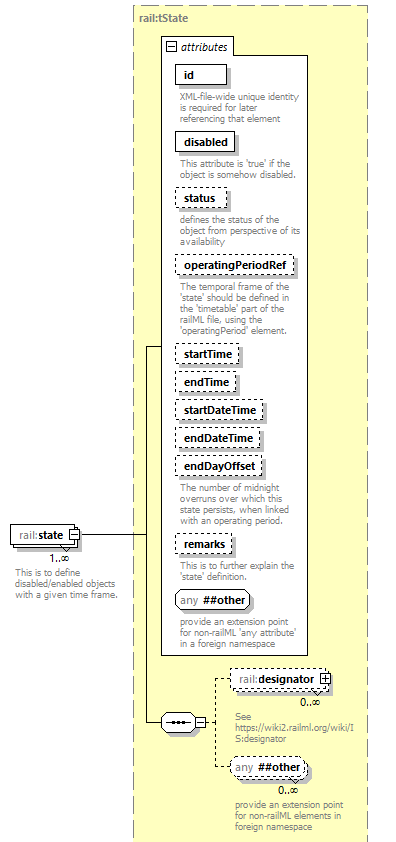 | ||||||||||||||||||||||||||||||||||||||||||||||||||||||||||||||||||||||||||||||
| namespace | https://www.railml.org/schemas/2021 | ||||||||||||||||||||||||||||||||||||||||||||||||||||||||||||||||||||||||||||||
| type | rail:tState | ||||||||||||||||||||||||||||||||||||||||||||||||||||||||||||||||||||||||||||||
| properties |
| ||||||||||||||||||||||||||||||||||||||||||||||||||||||||||||||||||||||||||||||
| children | rail:designator | ||||||||||||||||||||||||||||||||||||||||||||||||||||||||||||||||||||||||||||||
| attributes |
| ||||||||||||||||||||||||||||||||||||||||||||||||||||||||||||||||||||||||||||||
| annotation |
| ||||||||||||||||||||||||||||||||||||||||||||||||||||||||||||||||||||||||||||||
| source | <xs:element name="state" type="rail:tState" maxOccurs="unbounded"> <xs:annotation> <xs:documentation>This is to define disabled/enabled objects with a given time frame.</xs:documentation> <xs:documentation>See https://wiki2.railml.org/wiki/IS:state</xs:documentation> <xs:documentation>See https://wiki2.railml.org/wiki/RS:state</xs:documentation> </xs:annotation> </xs:element> |
complexType tTilting
| diagram |  | ||||||||||||||||||||||||||||||
| namespace | https://www.railml.org/schemas/2021 | ||||||||||||||||||||||||||||||
| used by |
| ||||||||||||||||||||||||||||||
| attributes |
| ||||||||||||||||||||||||||||||
| annotation |
| ||||||||||||||||||||||||||||||
| source | <xs:complexType name="tTilting"> <xs:annotation> <xs:documentation>data for tilting mechanism of passenger cars</xs:documentation> </xs:annotation> <xs:attributeGroup ref="rail:aTilting"/> </xs:complexType> |
complexType tTimeSpan
| diagram |  | ||||||||||||||||||||||
| namespace | https://www.railml.org/schemas/2021 | ||||||||||||||||||||||
| used by |
| ||||||||||||||||||||||
| attributes |
| ||||||||||||||||||||||
| annotation |
| ||||||||||||||||||||||
| source | <xs:complexType name="tTimeSpan"> <xs:annotation> <xs:documentation>generic type for time spans/periods in required context</xs:documentation> </xs:annotation> <xs:attribute name="from" type="xs:time" use="required"> <xs:annotation> <xs:documentation>The start time for the given mode. When referring to midnight at the beginning of the day, please use "00:00:00".</xs:documentation> </xs:annotation> </xs:attribute> <xs:attribute name="until" type="xs:time" use="required"> <xs:annotation> <xs:documentation>The end time for the given mode. When referring to midnight at the end of the day, please use "24:00:00".</xs:documentation> </xs:annotation> </xs:attribute> </xs:complexType> |
attribute tTimeSpan/@from
| type | xs:time | ||
| properties |
| ||
| annotation |
| ||
| source | <xs:attribute name="from" type="xs:time" use="required"> <xs:annotation> <xs:documentation>The start time for the given mode. When referring to midnight at the beginning of the day, please use "00:00:00".</xs:documentation> </xs:annotation> </xs:attribute> |
attribute tTimeSpan/@until
| type | xs:time | ||
| properties |
| ||
| annotation |
| ||
| source | <xs:attribute name="until" type="xs:time" use="required"> <xs:annotation> <xs:documentation>The end time for the given mode. When referring to midnight at the end of the day, please use "24:00:00".</xs:documentation> </xs:annotation> </xs:attribute> |
complexType tVehicleManufacturer
| diagram |  | ||||||||||||||||||||||||||||||||||||||||||||||
| namespace | https://www.railml.org/schemas/2021 | ||||||||||||||||||||||||||||||||||||||||||||||
| type | extension of rail:tOrganizationalUnit | ||||||||||||||||||||||||||||||||||||||||||||||
| properties |
| ||||||||||||||||||||||||||||||||||||||||||||||
| children | rail:additionalName rail:designator | ||||||||||||||||||||||||||||||||||||||||||||||
| used by |
| ||||||||||||||||||||||||||||||||||||||||||||||
| attributes |
| ||||||||||||||||||||||||||||||||||||||||||||||
| source | <xs:complexType name="tVehicleManufacturer"> <xs:complexContent> <xs:extension base="rail:tOrganizationalUnit"/> </xs:complexContent> </xs:complexType> |
complexType tVehicleOperator
| diagram |  | ||||||||||||||||||||||||||||||||||||||||||||||
| namespace | https://www.railml.org/schemas/2021 | ||||||||||||||||||||||||||||||||||||||||||||||
| type | extension of rail:tOrganizationalUnit | ||||||||||||||||||||||||||||||||||||||||||||||
| properties |
| ||||||||||||||||||||||||||||||||||||||||||||||
| children | rail:additionalName rail:designator | ||||||||||||||||||||||||||||||||||||||||||||||
| used by |
| ||||||||||||||||||||||||||||||||||||||||||||||
| attributes |
| ||||||||||||||||||||||||||||||||||||||||||||||
| source | <xs:complexType name="tVehicleOperator"> <xs:complexContent> <xs:extension base="rail:tOrganizationalUnit"/> </xs:complexContent> </xs:complexType> |
complexType tVehicleOwner
| diagram | 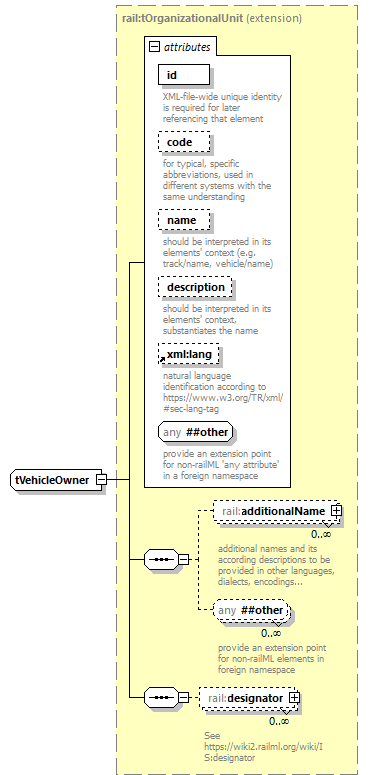 | ||||||||||||||||||||||||||||||||||||||||||||||
| namespace | https://www.railml.org/schemas/2021 | ||||||||||||||||||||||||||||||||||||||||||||||
| type | extension of rail:tOrganizationalUnit | ||||||||||||||||||||||||||||||||||||||||||||||
| properties |
| ||||||||||||||||||||||||||||||||||||||||||||||
| children | rail:additionalName rail:designator | ||||||||||||||||||||||||||||||||||||||||||||||
| used by |
| ||||||||||||||||||||||||||||||||||||||||||||||
| attributes |
| ||||||||||||||||||||||||||||||||||||||||||||||
| source | <xs:complexType name="tVehicleOwner"> <xs:complexContent> <xs:extension base="rail:tOrganizationalUnit"/> </xs:complexContent> </xs:complexType> |
simpleType tAirBrakeApplicationPosition
| namespace | https://www.railml.org/schemas/2021 | |||||||||||||||||||||
| type | restriction of xs:string | |||||||||||||||||||||
| properties |
| |||||||||||||||||||||
| used by |
| |||||||||||||||||||||
| facets |
| |||||||||||||||||||||
| source | <xs:simpleType name="tAirBrakeApplicationPosition"> <xs:restriction base="xs:string"> <xs:enumeration value="N/A"/> <xs:enumeration value="G"> <xs:annotation> <xs:documentation>Goods</xs:documentation> </xs:annotation> </xs:enumeration> <xs:enumeration value="P"> <xs:annotation> <xs:documentation>Passenger</xs:documentation> </xs:annotation> </xs:enumeration> <xs:enumeration value="R"> <xs:annotation> <xs:documentation>Rapid</xs:documentation> </xs:annotation> </xs:enumeration> </xs:restriction> </xs:simpleType> |
simpleType tBrakePercentage
| namespace | https://www.railml.org/schemas/2021 | |||||||||
| type | restriction of xs:integer | |||||||||
| properties |
| |||||||||
| used by | ||||||||||
| facets |
| |||||||||
| annotation |
| |||||||||
| source | <xs:simpleType name="tBrakePercentage"> <xs:annotation> <xs:documentation>Brake percentage as value of braking performance in relation to vehicle weight</xs:documentation> </xs:annotation> <xs:restriction base="xs:integer"> <xs:maxInclusive value="225"/> <xs:minInclusive value="6"/> </xs:restriction> </xs:simpleType> |
simpleType tBrakeType
| namespace | https://www.railml.org/schemas/2021 | ||
| type | union of (restriction of xs:string, rail:tOtherEnumerationValue) | ||
| used by |
| ||
| source | <xs:simpleType name="tBrakeType"> <xs:union> <xs:simpleType> <xs:restriction base="xs:string"> <xs:enumeration value="none"/> <xs:enumeration value="compressedAir"> <xs:annotation> <xs:documentation>de: Druckluftbremse</xs:documentation> </xs:annotation> </xs:enumeration> <xs:enumeration value="vacuum"> <xs:annotation> <xs:documentation>de: Saugluftbremse</xs:documentation> </xs:annotation> </xs:enumeration> <xs:enumeration value="handBrake"/> <xs:enumeration value="parkingBrake"/> <xs:enumeration value="cableBrake"> <xs:annotation> <xs:documentation>de: Seilzugbremse</xs:documentation> </xs:annotation> </xs:enumeration> </xs:restriction> </xs:simpleType> <xs:simpleType> <xs:restriction base="rail:tOtherEnumerationValue"/> </xs:simpleType> </xs:union> </xs:simpleType> |
simpleType tBrakeUse
| namespace | https://www.railml.org/schemas/2021 | |||||||||||||||
| type | restriction of xs:string | |||||||||||||||
| properties |
| |||||||||||||||
| used by |
| |||||||||||||||
| facets |
| |||||||||||||||
| annotation |
| |||||||||||||||
| source | <xs:simpleType name="tBrakeUse"> <xs:annotation> <xs:documentation>planned/calculated usage of specified brakes</xs:documentation> </xs:annotation> <xs:restriction base="xs:string"> <xs:enumeration value="unknown"/> <xs:enumeration value="normal"/> <xs:enumeration value="emergency"/> <xs:enumeration value="both"/> </xs:restriction> </xs:simpleType> |
simpleType tHexString
| namespace | https://www.railml.org/schemas/2021 | ||||||
| type | restriction of xs:string | ||||||
| properties |
| ||||||
| used by |
| ||||||
| facets |
| ||||||
| annotation |
| ||||||
| source | <xs:simpleType name="tHexString"> <xs:annotation> <xs:documentation>an arbitrary string consisting of hex digits from 0 to 9, a to f; not allowing white space, letters; no length restriction</xs:documentation> </xs:annotation> <xs:restriction base="xs:string"> <xs:pattern value="[0-9a-fA-F]*"/> </xs:restriction> </xs:simpleType> |
simpleType tInfrastructureStatus
| namespace | https://www.railml.org/schemas/2021 | ||
| type | union of (restriction of xs:string, rail:tOtherEnumerationValue) | ||
| used by |
| ||
| source | <xs:simpleType name="tInfrastructureStatus"> <xs:union> <xs:simpleType> <xs:restriction base="xs:string"> <xs:enumeration value="conceptual"> <xs:annotation> <xs:documentation>The construction or commissioning of the element is planned for the medium or long term. However, there are still no concrete (planning) activities for the construction of the element beyond the preliminary planning and cost estimation.</xs:documentation> </xs:annotation> </xs:enumeration> <xs:enumeration value="planned"> <xs:annotation> <xs:documentation>The construction or commissioning of the element is planned concretely and at short notice or concrete planning activities for the construction take place, e.g. design, approval or implementation planning, cost calculation, award of contracts. It is not normally possible to use the element.</xs:documentation> </xs:annotation> </xs:enumeration> <xs:enumeration value="operational"> <xs:annotation> <xs:documentation>The element is operational and can be used regularly.</xs:documentation> </xs:annotation> </xs:enumeration> <xs:enumeration value="disabled"> <xs:annotation> <xs:documentation>The element is currently not usable, switched off or deactivated and therefore cannot be used regularly. However, it can be put back into operation at short notice without further construction, acceptance or approval activities.</xs:documentation> </xs:annotation> </xs:enumeration> <xs:enumeration value="closed"> <xs:annotation> <xs:documentation>The element is no longer available, removed, dismantled, or no longer exists. Planning, construction or commissioning activities are absolutely necessary for recommissioning.</xs:documentation> </xs:annotation> </xs:enumeration> <xs:enumeration value="unknown"> <xs:annotation> <xs:documentation>The state of this infrastructure element is explicitly unknown.</xs:documentation> </xs:annotation> </xs:enumeration> </xs:restriction> </xs:simpleType> <xs:simpleType> <xs:restriction base="rail:tOtherEnumerationValue"/> </xs:simpleType> </xs:union> </xs:simpleType> |
simpleType tInterlockingTypes
| namespace | https://www.railml.org/schemas/2021 | ||||||||||||||||||||||
| type | restriction of xs:string | ||||||||||||||||||||||
| properties |
| ||||||||||||||||||||||
| used by |
| ||||||||||||||||||||||
| facets |
| ||||||||||||||||||||||
| annotation |
| ||||||||||||||||||||||
| source | <xs:simpleType name="tInterlockingTypes"> <xs:annotation> <xs:documentation>classification of an interlocking system by kind of implementation</xs:documentation> </xs:annotation> <xs:restriction base="xs:string"> <xs:enumeration value="none"/> <xs:enumeration value="mechanical"/> <xs:enumeration value="electro-mechanical"/> <xs:enumeration value="electrical"> <xs:annotation> <xs:documentation>de: Gleisbildstellwerk, Spurplanstellwerk ...</xs:documentation> </xs:annotation> </xs:enumeration> <xs:enumeration value="electronical"> <xs:annotation> <xs:documentation>de: ESTW</xs:documentation> </xs:annotation> </xs:enumeration> </xs:restriction> </xs:simpleType> |
simpleType tLineClassificationType
| namespace | https://www.railml.org/schemas/2021 | ||
| type | union of (restriction of xs:string, rail:tOtherEnumerationValue) | ||
| used by |
| ||
| annotation |
| ||
| source | <xs:simpleType name="tLineClassificationType"> <xs:annotation> <xs:documentation>according EN 15528 (other national values also possible)</xs:documentation> </xs:annotation> <xs:union> <xs:simpleType> <xs:restriction base="xs:string"> <xs:enumeration value="A"> <xs:annotation> <xs:documentation>axle load: 16.0 t, meter load: 5.0 t/m</xs:documentation> </xs:annotation> </xs:enumeration> <xs:enumeration value="B1"> <xs:annotation> <xs:documentation>axle load: 18.0 t, meter load: 5.0 t/m</xs:documentation> </xs:annotation> </xs:enumeration> <xs:enumeration value="B2"> <xs:annotation> <xs:documentation>axle load: 18.0 t, meter load: 6.4 t/m</xs:documentation> </xs:annotation> </xs:enumeration> <xs:enumeration value="C2"> <xs:annotation> <xs:documentation>axle load: 20.0 t, meter load: 6.4 t/m</xs:documentation> </xs:annotation> </xs:enumeration> <xs:enumeration value="C3"> <xs:annotation> <xs:documentation>axle load: 20.0 t, meter load: 7.2 t/m</xs:documentation> </xs:annotation> </xs:enumeration> <xs:enumeration value="C4"> <xs:annotation> <xs:documentation>axle load: 20.0 t, meter load: 8.0 t/m</xs:documentation> </xs:annotation> </xs:enumeration> <xs:enumeration value="D2"> <xs:annotation> <xs:documentation>axle load: 22.5 t, meter load: 6.4 t/m</xs:documentation> </xs:annotation> </xs:enumeration> <xs:enumeration value="D3"> <xs:annotation> <xs:documentation>axle load: 22.5 t, meter load: 7.2 t/m</xs:documentation> </xs:annotation> </xs:enumeration> <xs:enumeration value="D4"> <xs:annotation> <xs:documentation>axle load: 22.5 t, meter load: 8.0 t/m</xs:documentation> </xs:annotation> </xs:enumeration> <xs:enumeration value="D4xL"> <xs:annotation> <xs:documentation>only valid for locomotives</xs:documentation> </xs:annotation> </xs:enumeration> <xs:enumeration value="E4"> <xs:annotation> <xs:documentation>axle load: 25.0 t, meter load: 8.0 t/m</xs:documentation> <xs:documentation>only valid for freight cars</xs:documentation> </xs:annotation> </xs:enumeration> <xs:enumeration value="E5"> <xs:annotation> <xs:documentation>axle load: 25.0 t, meter load: 8.8 t/m</xs:documentation> <xs:documentation>only valid for freight cars</xs:documentation> </xs:annotation> </xs:enumeration> </xs:restriction> </xs:simpleType> <xs:simpleType> <xs:restriction base="rail:tOtherEnumerationValue"/> </xs:simpleType> </xs:union> </xs:simpleType> |
simpleType tPassengersPerSecond
| namespace | https://www.railml.org/schemas/2021 | |||||||||
| type | restriction of xs:decimal | |||||||||
| properties |
| |||||||||
| used by |
| |||||||||
| facets |
| |||||||||
| annotation |
| |||||||||
| source | <xs:simpleType name="tPassengersPerSecond"> <xs:annotation> <xs:documentation>number of passengers per second used for flow description</xs:documentation> </xs:annotation> <xs:restriction base="xs:decimal"> <xs:fractionDigits value="3"/> <xs:minInclusive value="0"/> </xs:restriction> </xs:simpleType> |
simpleType tPlaceCategory
| namespace | https://www.railml.org/schemas/2021 | ||
| type | union of (restriction of xs:string, rail:tOtherEnumerationValue) | ||
| used by |
| ||
| source | <xs:simpleType name="tPlaceCategory"> <xs:union> <xs:simpleType> <xs:restriction base="xs:string"> <xs:enumeration value="class1"/> <xs:enumeration value="class2"/> <xs:enumeration value="class3"/> <xs:enumeration value="standing"/> <xs:enumeration value="standingArea"/> <xs:enumeration value="wheelchair"/> <xs:enumeration value="bicycle"/> <xs:enumeration value="couchette"/> <xs:enumeration value="bed"/> <xs:enumeration value="chair"/> <xs:enumeration value="bistro"/> <xs:enumeration value="restaurant"/> <xs:enumeration value="foldingSeat"/> <xs:enumeration value="impairedToilet"/> <xs:enumeration value="toilet"/> <xs:enumeration value="business"/> <xs:enumeration value="businessCompartment"/> <xs:enumeration value="family"/> <xs:enumeration value="familyCompartment"/> <xs:enumeration value="stroller"/> <xs:enumeration value="toddler"/> <xs:enumeration value="toddlerCompartment"/> <xs:enumeration value="sleepingCompartment"/> </xs:restriction> </xs:simpleType> <xs:simpleType> <xs:restriction base="rail:tOtherEnumerationValue"/> </xs:simpleType> </xs:union> </xs:simpleType> |
simpleType tServiceType
| namespace | https://www.railml.org/schemas/2021 | ||
| type | union of (restriction of xs:string, rail:tOtherEnumerationValue) | ||
| used by |
| ||
| annotation |
| ||
| source | <xs:simpleType name="tServiceType"> <xs:annotation> <xs:documentation>list of common service types</xs:documentation> </xs:annotation> <xs:union> <xs:simpleType> <xs:restriction base="xs:string"> <xs:enumeration value="mobileCatering"/> <xs:enumeration value="WLAN"/> <xs:enumeration value="wheelchairLift"/> <xs:enumeration value="toiletClosed"/> <xs:enumeration value="toiletOpen"/> <xs:enumeration value="toiletHc"/> <xs:enumeration value="Snack"/> <xs:enumeration value="SelfService"/> <xs:enumeration value="PIS"/> <xs:enumeration value="HVAC"/> <xs:enumeration value="APC"/> <xs:enumeration value="SecurityCamera"/> </xs:restriction> </xs:simpleType> <xs:simpleType> <xs:restriction base="rail:tOtherEnumerationValue"/> </xs:simpleType> </xs:union> </xs:simpleType> |
simpleType tTiltingActuationType
| namespace | https://www.railml.org/schemas/2021 | |||||||||||||||
| type | restriction of xs:string | |||||||||||||||
| properties |
| |||||||||||||||
| used by |
| |||||||||||||||
| facets |
| |||||||||||||||
| source | <xs:simpleType name="tTiltingActuationType"> <xs:restriction base="xs:string"> <xs:enumeration value="none"/> <xs:enumeration value="active"/> <xs:enumeration value="passive"/> <xs:enumeration value="rollCompensation"/> </xs:restriction> </xs:simpleType> |
simpleType tTimeZone
| namespace | https://www.railml.org/schemas/2021 | ||
| type | xs:string | ||
| properties |
| ||
| used by |
| ||
| annotation |
| ||
| source | <xs:simpleType name="tTimeZone"> <xs:annotation> <xs:documentation>timezone as defined in the tz database, e.g. "America/New_York"</xs:documentation> </xs:annotation> <xs:restriction base="xs:string"/> </xs:simpleType> |
simpleType tTrainProtectionMedium
| namespace | https://www.railml.org/schemas/2021 | ||||||||||||||||||||||||||||||
| type | restriction of xs:string | ||||||||||||||||||||||||||||||
| properties |
| ||||||||||||||||||||||||||||||
| used by |
| ||||||||||||||||||||||||||||||
| facets |
| ||||||||||||||||||||||||||||||
| annotation |
| ||||||||||||||||||||||||||||||
| source | <xs:simpleType name="tTrainProtectionMedium"> <xs:annotation> <xs:documentation>classification of a train protection system by physical medium</xs:documentation> </xs:annotation> <xs:restriction base="xs:string"> <xs:enumeration value="none"/> <xs:enumeration value="mechanical"/> <xs:enumeration value="electric"/> <xs:enumeration value="inductive"/> <xs:enumeration value="magnetic"/> <xs:enumeration value="optical"/> <xs:enumeration value="radio"/> <xs:enumeration value="rail"/> <xs:enumeration value="cable"/> </xs:restriction> </xs:simpleType> |
simpleType tTrainProtectionMonitoring
| namespace | https://www.railml.org/schemas/2021 | ||||||||||||
| type | restriction of xs:string | ||||||||||||
| properties |
| ||||||||||||
| used by |
| ||||||||||||
| facets |
| ||||||||||||
| annotation |
| ||||||||||||
| source | <xs:simpleType name="tTrainProtectionMonitoring"> <xs:annotation> <xs:documentation>classification of a train protection system by coverage</xs:documentation> </xs:annotation> <xs:restriction base="xs:string"> <xs:enumeration value="none"/> <xs:enumeration value="intermittent"/> <xs:enumeration value="continuous"/> </xs:restriction> </xs:simpleType> |
simpleType tUsageType
| namespace | https://www.railml.org/schemas/2021 | ||
| type | union of (restriction of xs:string, rail:tOtherEnumerationValue) | ||
| used by |
| ||
| source | <xs:simpleType name="tUsageType"> <xs:union> <xs:simpleType> <xs:restriction base="xs:string"> <xs:enumeration value="passenger"/> <xs:enumeration value="goods"/> <xs:enumeration value="mixed"/> </xs:restriction> </xs:simpleType> <xs:simpleType> <xs:restriction base="rail:tOtherEnumerationValue"/> </xs:simpleType> </xs:union> </xs:simpleType> |
attributeGroup aAuxiliaryBrakes
| namespace | https://www.railml.org/schemas/2021 | ||||||||||||||||||||||||||||||||||||||||||||||||||||
| used by |
| ||||||||||||||||||||||||||||||||||||||||||||||||||||
| attributes |
| ||||||||||||||||||||||||||||||||||||||||||||||||||||
| annotation |
| ||||||||||||||||||||||||||||||||||||||||||||||||||||
| source | <xs:attributeGroup name="aAuxiliaryBrakes"> <xs:annotation> <xs:documentation>de: Zusatz-/Hilfsbremsen</xs:documentation> </xs:annotation> <xs:attribute name="brakeUse" type="rail:tBrakeUse"/> <xs:attribute name="H" type="xs:boolean"> <xs:annotation> <xs:documentation>de: hydro-dynamisch</xs:documentation> </xs:annotation> </xs:attribute> <xs:attribute name="E" type="xs:boolean"> <xs:annotation> <xs:documentation>de: elektro-motorisch</xs:documentation> </xs:annotation> </xs:attribute> <xs:attribute name="Mg" type="xs:boolean"> <xs:annotation> <xs:documentation>de: Magnetschienenbremse</xs:documentation> </xs:annotation> </xs:attribute> <xs:attribute name="Wb" type="xs:boolean"> <xs:annotation> <xs:documentation>de: Wirbelstrombremse</xs:documentation> </xs:annotation> </xs:attribute> <xs:attribute name="ep" type="xs:boolean"> <xs:annotation> <xs:documentation>de: elektro-pneumatisch</xs:documentation> </xs:annotation> </xs:attribute> </xs:attributeGroup> |
attribute aAuxiliaryBrakes/@brakeUse
| type | rail:tBrakeUse | |||||||||||||||
| facets |
| |||||||||||||||
| source | <xs:attribute name="brakeUse" type="rail:tBrakeUse"/> |
attribute aAuxiliaryBrakes/@H
| type | xs:boolean | ||
| annotation |
| ||
| source | <xs:attribute name="H" type="xs:boolean"> <xs:annotation> <xs:documentation>de: hydro-dynamisch</xs:documentation> </xs:annotation> </xs:attribute> |
attribute aAuxiliaryBrakes/@E
| type | xs:boolean | ||
| annotation |
| ||
| source | <xs:attribute name="E" type="xs:boolean"> <xs:annotation> <xs:documentation>de: elektro-motorisch</xs:documentation> </xs:annotation> </xs:attribute> |
attribute aAuxiliaryBrakes/@Mg
| type | xs:boolean | ||
| annotation |
| ||
| source | <xs:attribute name="Mg" type="xs:boolean"> <xs:annotation> <xs:documentation>de: Magnetschienenbremse</xs:documentation> </xs:annotation> </xs:attribute> |
attribute aAuxiliaryBrakes/@Wb
| type | xs:boolean | ||
| annotation |
| ||
| source | <xs:attribute name="Wb" type="xs:boolean"> <xs:annotation> <xs:documentation>de: Wirbelstrombremse</xs:documentation> </xs:annotation> </xs:attribute> |
attribute aAuxiliaryBrakes/@ep
| type | xs:boolean | ||
| annotation |
| ||
| source | <xs:attribute name="ep" type="xs:boolean"> <xs:annotation> <xs:documentation>de: elektro-pneumatisch</xs:documentation> </xs:annotation> </xs:attribute> |
attributeGroup aBasicBrakeAttributes
| namespace | https://www.railml.org/schemas/2021 | ||||||||||||||||||||||||||||||||||||||||||||||||||||||||||||||||||||||
| used by |
| ||||||||||||||||||||||||||||||||||||||||||||||||||||||||||||||||||||||
| attributes |
| ||||||||||||||||||||||||||||||||||||||||||||||||||||||||||||||||||||||
| source | <xs:attributeGroup name="aBasicBrakeAttributes"> <xs:attributeGroup ref="rail:aMinBasicBrakeAttributes"/> <xs:attribute name="regularBrakeMass" type="rail:tWeightTons"> <xs:annotation> <xs:documentation>brake mass for normal brake operations of none-automatic brakes</xs:documentation> </xs:annotation> </xs:attribute> <xs:attribute name="regularBrakePercentage" type="rail:tBrakePercentage"> <xs:annotation> <xs:documentation>brake percentage related to brake mass for normal brake operations of none-automatic brakes</xs:documentation> </xs:annotation> </xs:attribute> <xs:attribute name="emergencyBrakeMass" type="rail:tWeightTons"> <xs:annotation> <xs:documentation>brake mass for emergency brake operations, differs from regular brake mass depending on auxiliary brakes</xs:documentation> </xs:annotation> </xs:attribute> <xs:attribute name="emergencyBrakePercentage" type="rail:tBrakePercentage"> <xs:annotation> <xs:documentation>brake percentage related to brake mass for emergency brake operations, differs from regular brake percentage depending on auxiliary brakes</xs:documentation> </xs:annotation> </xs:attribute> <xs:attribute name="maxDeceleration" type="rail:tAccelerationMeterPerSquareSec"> <xs:annotation> <xs:documentation>alternative specification of maximum possible momentary deceleration</xs:documentation> </xs:annotation> </xs:attribute> <xs:attribute name="meanDeceleration" type="rail:tAccelerationMeterPerSquareSec"> <xs:annotation> <xs:documentation>alternative specification of effective mean deceleration of a whole brake operation</xs:documentation> </xs:annotation> </xs:attribute> </xs:attributeGroup> |
attribute aBasicBrakeAttributes/@regularBrakeMass
| type | rail:tWeightTons | ||||||
| facets |
| ||||||
| annotation |
| ||||||
| source | <xs:attribute name="regularBrakeMass" type="rail:tWeightTons"> <xs:annotation> <xs:documentation>brake mass for normal brake operations of none-automatic brakes</xs:documentation> </xs:annotation> </xs:attribute> |
attribute aBasicBrakeAttributes/@regularBrakePercentage
| type | rail:tBrakePercentage | |||||||||
| facets |
| |||||||||
| annotation |
| |||||||||
| source | <xs:attribute name="regularBrakePercentage" type="rail:tBrakePercentage"> <xs:annotation> <xs:documentation>brake percentage related to brake mass for normal brake operations of none-automatic brakes</xs:documentation> </xs:annotation> </xs:attribute> |
attribute aBasicBrakeAttributes/@emergencyBrakeMass
| type | rail:tWeightTons | ||||||
| facets |
| ||||||
| annotation |
| ||||||
| source | <xs:attribute name="emergencyBrakeMass" type="rail:tWeightTons"> <xs:annotation> <xs:documentation>brake mass for emergency brake operations, differs from regular brake mass depending on auxiliary brakes</xs:documentation> </xs:annotation> </xs:attribute> |
attribute aBasicBrakeAttributes/@emergencyBrakePercentage
| type | rail:tBrakePercentage | |||||||||
| facets |
| |||||||||
| annotation |
| |||||||||
| source | <xs:attribute name="emergencyBrakePercentage" type="rail:tBrakePercentage"> <xs:annotation> <xs:documentation>brake percentage related to brake mass for emergency brake operations, differs from regular brake percentage depending on auxiliary brakes</xs:documentation> </xs:annotation> </xs:attribute> |
attribute aBasicBrakeAttributes/@maxDeceleration
| type | rail:tAccelerationMeterPerSquareSec | ||||||
| facets |
| ||||||
| annotation |
| ||||||
| source | <xs:attribute name="maxDeceleration" type="rail:tAccelerationMeterPerSquareSec"> <xs:annotation> <xs:documentation>alternative specification of maximum possible momentary deceleration</xs:documentation> </xs:annotation> </xs:attribute> |
attribute aBasicBrakeAttributes/@meanDeceleration
| type | rail:tAccelerationMeterPerSquareSec | ||||||
| facets |
| ||||||
| annotation |
| ||||||
| source | <xs:attribute name="meanDeceleration" type="rail:tAccelerationMeterPerSquareSec"> <xs:annotation> <xs:documentation>alternative specification of effective mean deceleration of a whole brake operation</xs:documentation> </xs:annotation> </xs:attribute> |
attributeGroup aClearanceGauge
| namespace | https://www.railml.org/schemas/2021 | ||||||||||||||||
| used by |
| ||||||||||||||||
| attributes |
| ||||||||||||||||
| source | <xs:attributeGroup name="aClearanceGauge"> <xs:attribute name="code" type="xs:string" use="required"> <xs:annotation> <xs:documentation>code name of the train clearance gauge</xs:documentation> <xs:documentation>use value from the separate code definition file 'TrainClearanceGauges.xml'/trainClearanceGauge</xs:documentation> </xs:annotation> </xs:attribute> </xs:attributeGroup> |
attribute aClearanceGauge/@code
| type | xs:string | ||||
| properties |
| ||||
| annotation |
| ||||
| source | <xs:attribute name="code" type="xs:string" use="required"> <xs:annotation> <xs:documentation>code name of the train clearance gauge</xs:documentation> <xs:documentation>use value from the separate code definition file 'TrainClearanceGauges.xml'/trainClearanceGauge</xs:documentation> </xs:annotation> </xs:attribute> |
attributeGroup aETCS
| namespace | https://www.railml.org/schemas/2021 | ||||||||||||||||||||||||||||||||||||||||||||||
| used by |
| ||||||||||||||||||||||||||||||||||||||||||||||
| attributes |
| ||||||||||||||||||||||||||||||||||||||||||||||
| source | <xs:attributeGroup name="aETCS"> <xs:attribute name="srsVersion" type="rail:tVersionNumber"> <xs:annotation> <xs:documentation>Version of ETCS language (SRS edition) installed</xs:documentation> </xs:annotation> </xs:attribute> <xs:attribute name="level_0" type="xs:boolean"> <xs:annotation> <xs:documentation>on-board unit supports level 0</xs:documentation> </xs:annotation> </xs:attribute> <xs:attribute name="level_1" type="xs:boolean"> <xs:annotation> <xs:documentation>on-board unit supports level 1</xs:documentation> </xs:annotation> </xs:attribute> <xs:attribute name="level_2" type="xs:boolean"> <xs:annotation> <xs:documentation>on-board unit supports level 2</xs:documentation> </xs:annotation> </xs:attribute> <xs:attribute name="level_3" type="xs:boolean"> <xs:annotation> <xs:documentation>on-board unit supports level 3</xs:documentation> </xs:annotation> </xs:attribute> </xs:attributeGroup> |
attribute aETCS/@srsVersion
| type | rail:tVersionNumber | ||
| annotation |
| ||
| source | <xs:attribute name="srsVersion" type="rail:tVersionNumber"> <xs:annotation> <xs:documentation>Version of ETCS language (SRS edition) installed</xs:documentation> </xs:annotation> </xs:attribute> |
attribute aETCS/@level_0
| type | xs:boolean | ||
| annotation |
| ||
| source | <xs:attribute name="level_0" type="xs:boolean"> <xs:annotation> <xs:documentation>on-board unit supports level 0</xs:documentation> </xs:annotation> </xs:attribute> |
attribute aETCS/@level_1
| type | xs:boolean | ||
| annotation |
| ||
| source | <xs:attribute name="level_1" type="xs:boolean"> <xs:annotation> <xs:documentation>on-board unit supports level 1</xs:documentation> </xs:annotation> </xs:attribute> |
attribute aETCS/@level_2
| type | xs:boolean | ||
| annotation |
| ||
| source | <xs:attribute name="level_2" type="xs:boolean"> <xs:annotation> <xs:documentation>on-board unit supports level 2</xs:documentation> </xs:annotation> </xs:attribute> |
attribute aETCS/@level_3
| type | xs:boolean | ||
| annotation |
| ||
| source | <xs:attribute name="level_3" type="xs:boolean"> <xs:annotation> <xs:documentation>on-board unit supports level 3</xs:documentation> </xs:annotation> </xs:attribute> |
attributeGroup aExactTimeSpan
| namespace | https://www.railml.org/schemas/2021 | ||||||||||||||||||
| used by |
| ||||||||||||||||||
| attributes |
| ||||||||||||||||||
| annotation |
| ||||||||||||||||||
| source | <xs:attributeGroup name="aExactTimeSpan"> <xs:annotation> <xs:documentation>generic type for exact time spans/periods in various context</xs:documentation> </xs:annotation> <xs:attribute name="startDateTime" type="xs:dateTime"/> <xs:attribute name="endDateTime" type="xs:dateTime"/> </xs:attributeGroup> |
attribute aExactTimeSpan/@startDateTime
| type | xs:dateTime |
| source | <xs:attribute name="startDateTime" type="xs:dateTime"/> |
attribute aExactTimeSpan/@endDateTime
| type | xs:dateTime |
| source | <xs:attribute name="endDateTime" type="xs:dateTime"/> |
attributeGroup aMinBasicBrakeAttributes
| namespace | https://www.railml.org/schemas/2021 | ||||||||||||||||||||||
| used by |
| ||||||||||||||||||||||
| attributes |
| ||||||||||||||||||||||
| source | <xs:attributeGroup name="aMinBasicBrakeAttributes"> <xs:attribute name="brakeType" type="rail:tBrakeType" use="required"> <xs:annotation> <xs:documentation>vacuum or compressed air brake, hand brake, parking brake, cable brake</xs:documentation> </xs:annotation> </xs:attribute> <xs:attribute name="airBrakeApplicationPosition" type="rail:tAirBrakeApplicationPosition"> <xs:annotation> <xs:documentation>base brake switch, one of G, P or R</xs:documentation> </xs:annotation> </xs:attribute> </xs:attributeGroup> |
attribute aMinBasicBrakeAttributes/@brakeType
| type | rail:tBrakeType | ||
| properties |
| ||
| annotation |
| ||
| source | <xs:attribute name="brakeType" type="rail:tBrakeType" use="required"> <xs:annotation> <xs:documentation>vacuum or compressed air brake, hand brake, parking brake, cable brake</xs:documentation> </xs:annotation> </xs:attribute> |
attribute aMinBasicBrakeAttributes/@airBrakeApplicationPosition
| type | rail:tAirBrakeApplicationPosition | |||||||||||||||||||||
| facets |
| |||||||||||||||||||||
| annotation |
| |||||||||||||||||||||
| source | <xs:attribute name="airBrakeApplicationPosition" type="rail:tAirBrakeApplicationPosition"> <xs:annotation> <xs:documentation>base brake switch, one of G, P or R</xs:documentation> </xs:annotation> </xs:attribute> |
attributeGroup aPeriodTimeSpan
| namespace | https://www.railml.org/schemas/2021 | ||||||||||||||||||
| used by |
| ||||||||||||||||||
| attributes |
| ||||||||||||||||||
| annotation |
| ||||||||||||||||||
| source | <xs:attributeGroup name="aPeriodTimeSpan"> <xs:annotation> <xs:documentation>generic type for time spans/periods in optional context</xs:documentation> </xs:annotation> <xs:attribute name="startTime" type="xs:time"/> <xs:attribute name="endTime" type="xs:time"/> </xs:attributeGroup> |
attribute aPeriodTimeSpan/@startTime
| type | xs:time |
| source | <xs:attribute name="startTime" type="xs:time"/> |
attribute aPeriodTimeSpan/@endTime
| type | xs:time |
| source | <xs:attribute name="endTime" type="xs:time"/> |
attributeGroup aPlaces
| namespace | https://www.railml.org/schemas/2021 | ||||||||||||||||||||||||||||||||||||||
| used by |
| ||||||||||||||||||||||||||||||||||||||
| attributes |
| ||||||||||||||||||||||||||||||||||||||
| source | <xs:attributeGroup name="aPlaces"> <xs:attribute name="category" type="rail:tPlaceCategory" use="required"/> <xs:attribute name="tapTsiType9039Code"> <xs:annotation> <xs:documentation>Facility code from the TAP TSI code list B.4.9039 "Code list for the facility type description"</xs:documentation> <xs:documentation>The code list is maintained by ERA and can be found in the Directory of Passenger Code Lists for the ERA Technical Documents used in TAP TSI, which can be downloaded from https://www.era.europa.eu/content/tap .</xs:documentation> <xs:documentation>See https://www.era.europa.eu/activities/technical-specifications-interoperability_en#meeting10</xs:documentation> </xs:annotation> <xs:simpleType> <xs:restriction base="rail:tDigitString"> <xs:maxLength value="3"/> </xs:restriction> </xs:simpleType> </xs:attribute> <xs:attribute name="count" type="rail:tCounter" use="required"> <xs:annotation> <xs:documentation>count="0" means: there is no place of this category</xs:documentation> </xs:annotation> </xs:attribute> <xs:attribute name="description" type="rail:tElementDescription"/> </xs:attributeGroup> |
attribute aPlaces/@category
| type | rail:tPlaceCategory | ||
| properties |
| ||
| source | <xs:attribute name="category" type="rail:tPlaceCategory" use="required"/> |
attribute aPlaces/@tapTsiType9039Code
| type | restriction of rail:tDigitString | |||||||||
| facets |
| |||||||||
| annotation |
| |||||||||
| source | <xs:attribute name="tapTsiType9039Code"> <xs:annotation> <xs:documentation>Facility code from the TAP TSI code list B.4.9039 "Code list for the facility type description"</xs:documentation> <xs:documentation>The code list is maintained by ERA and can be found in the Directory of Passenger Code Lists for the ERA Technical Documents used in TAP TSI, which can be downloaded from https://www.era.europa.eu/content/tap .</xs:documentation> <xs:documentation>See https://www.era.europa.eu/activities/technical-specifications-interoperability_en#meeting10</xs:documentation> </xs:annotation> <xs:simpleType> <xs:restriction base="rail:tDigitString"> <xs:maxLength value="3"/> </xs:restriction> </xs:simpleType> </xs:attribute> |
attribute aPlaces/@count
| type | rail:tCounter | ||
| properties |
| ||
| annotation |
| ||
| source | <xs:attribute name="count" type="rail:tCounter" use="required"> <xs:annotation> <xs:documentation>count="0" means: there is no place of this category</xs:documentation> </xs:annotation> </xs:attribute> |
attribute aPlaces/@description
| type | rail:tElementDescription |
| source | <xs:attribute name="description" type="rail:tElementDescription"/> |
attributeGroup aService
| namespace | https://www.railml.org/schemas/2021 | ||||||||||||||||||||||||||||||||||||||||||||||||||||
| used by |
| ||||||||||||||||||||||||||||||||||||||||||||||||||||
| attributes |
| ||||||||||||||||||||||||||||||||||||||||||||||||||||
| source | <xs:attributeGroup name="aService"> <xs:attribute name="name" type="rail:tGenericName"/> <xs:attribute name="tapTsiType7161Code"> <xs:annotation> <xs:documentation>Service code from the TAP TSI code list B.4.7161 "Code list for the special services"</xs:documentation> <xs:documentation>The code list is maintained by ERA and can be found in the Directory of Passenger Code Lists for the ERA Technical Documents used in TAP TSI, which can be downloaded from https://www.era.europa.eu/content/tap .</xs:documentation> <xs:documentation>See https://www.era.europa.eu/activities/technical-specifications-interoperability_en#meeting10</xs:documentation> </xs:annotation> <xs:simpleType> <xs:restriction base="rail:tDigitString"> <xs:maxLength value="3"/> </xs:restriction> </xs:simpleType> </xs:attribute> <xs:attribute name="count" type="rail:tCounter"> <xs:annotation> <xs:documentation>count="0" means: there is not such a service</xs:documentation> </xs:annotation> </xs:attribute> <xs:attribute name="description" type="rail:tElementDescription"/> <xs:attribute name="value" type="xs:decimal"> <xs:annotation> <xs:documentation>generic decimal value for additional information of the service, meaning should be clarified by its "description"</xs:documentation> </xs:annotation> </xs:attribute> <xs:attribute name="type" type="rail:tServiceType"/> <xs:attributeGroup ref="rail:anyAttribute"/> </xs:attributeGroup> |
attribute aService/@name
| type | rail:tGenericName |
| source | <xs:attribute name="name" type="rail:tGenericName"/> |
attribute aService/@tapTsiType7161Code
| type | restriction of rail:tDigitString | |||||||||
| facets |
| |||||||||
| annotation |
| |||||||||
| source | <xs:attribute name="tapTsiType7161Code"> <xs:annotation> <xs:documentation>Service code from the TAP TSI code list B.4.7161 "Code list for the special services"</xs:documentation> <xs:documentation>The code list is maintained by ERA and can be found in the Directory of Passenger Code Lists for the ERA Technical Documents used in TAP TSI, which can be downloaded from https://www.era.europa.eu/content/tap .</xs:documentation> <xs:documentation>See https://www.era.europa.eu/activities/technical-specifications-interoperability_en#meeting10</xs:documentation> </xs:annotation> <xs:simpleType> <xs:restriction base="rail:tDigitString"> <xs:maxLength value="3"/> </xs:restriction> </xs:simpleType> </xs:attribute> |
attribute aService/@count
| type | rail:tCounter | ||
| annotation |
| ||
| source | <xs:attribute name="count" type="rail:tCounter"> <xs:annotation> <xs:documentation>count="0" means: there is not such a service</xs:documentation> </xs:annotation> </xs:attribute> |
attribute aService/@description
| type | rail:tElementDescription |
| source | <xs:attribute name="description" type="rail:tElementDescription"/> |
attribute aService/@value
| type | xs:decimal | ||
| annotation |
| ||
| source | <xs:attribute name="value" type="xs:decimal"> <xs:annotation> <xs:documentation>generic decimal value for additional information of the service, meaning should be clarified by its "description"</xs:documentation> </xs:annotation> </xs:attribute> |
attribute aService/@type
| type | rail:tServiceType |
| source | <xs:attribute name="type" type="rail:tServiceType"/> |
attributeGroup aTilting
| namespace | https://www.railml.org/schemas/2021 | ||||||||||||||||||||||||||||||
| used by |
| ||||||||||||||||||||||||||||||
| attributes |
| ||||||||||||||||||||||||||||||
| source | <xs:attributeGroup name="aTilting"> <xs:attribute name="maxTiltingAngle" type="rail:tAngleDegQuadrant"> <xs:annotation> <xs:documentation>maximum tilting angle in degrees</xs:documentation> </xs:annotation> </xs:attribute> <xs:attribute name="actuation" type="rail:tTiltingActuationType"> <xs:annotation> <xs:documentation>way of actuating the car body tilting (active/passive)</xs:documentation> </xs:annotation> </xs:attribute> <xs:attribute name="tiltingSpeed" type="rail:tSpeedDegreesPerSecond"> <xs:annotation> <xs:documentation>speed of changing the tilting angle in degrees per second</xs:documentation> </xs:annotation> </xs:attribute> </xs:attributeGroup> |
attribute aTilting/@maxTiltingAngle
| type | rail:tAngleDegQuadrant | ||||||||||||||||||
| facets |
| ||||||||||||||||||
| annotation |
| ||||||||||||||||||
| source | <xs:attribute name="maxTiltingAngle" type="rail:tAngleDegQuadrant"> <xs:annotation> <xs:documentation>maximum tilting angle in degrees</xs:documentation> </xs:annotation> </xs:attribute> |
attribute aTilting/@actuation
| type | rail:tTiltingActuationType | |||||||||||||||
| facets |
| |||||||||||||||
| annotation |
| |||||||||||||||
| source | <xs:attribute name="actuation" type="rail:tTiltingActuationType"> <xs:annotation> <xs:documentation>way of actuating the car body tilting (active/passive)</xs:documentation> </xs:annotation> </xs:attribute> |
attribute aTilting/@tiltingSpeed
| type | rail:tSpeedDegreesPerSecond | |||||||||
| facets |
| |||||||||
| annotation |
| |||||||||
| source | <xs:attribute name="tiltingSpeed" type="rail:tSpeedDegreesPerSecond"> <xs:annotation> <xs:documentation>speed of changing the tilting angle in degrees per second</xs:documentation> </xs:annotation> </xs:attribute> |
attributeGroup aTimePeriod
| namespace | https://www.railml.org/schemas/2021 | ||||||||||||||||||
| used by |
| ||||||||||||||||||
| attributes |
| ||||||||||||||||||
| annotation |
| ||||||||||||||||||
| source | <xs:attributeGroup name="aTimePeriod"> <xs:annotation> <xs:documentation>generic type for time spans/periods regarding its dates</xs:documentation> </xs:annotation> <xs:attribute name="startDate" type="xs:date"/> <xs:attribute name="endDate" type="xs:date"/> </xs:attributeGroup> |
attribute aTimePeriod/@startDate
| type | xs:date |
| source | <xs:attribute name="startDate" type="xs:date"/> |
attribute aTimePeriod/@endDate
| type | xs:date |
| source | <xs:attribute name="endDate" type="xs:date"/> |
simpleType tAcceleration
| namespace | https://www.railml.org/schemas/2021 | ||||||
| type | restriction of xs:decimal | ||||||
| properties |
| ||||||
| used by |
| ||||||
| facets |
| ||||||
| annotation |
| ||||||
| source | <xs:simpleType name="tAcceleration"> <xs:annotation> <xs:documentation>applies as basic type for inheritance, should not be used directly because of missing unit of measure</xs:documentation> </xs:annotation> <xs:restriction base="xs:decimal"> <xs:fractionDigits value="3"/> </xs:restriction> </xs:simpleType> |
simpleType tAccelerationMeterPerSquareSec
| namespace | https://www.railml.org/schemas/2021 | ||||||
| type | rail:tAcceleration | ||||||
| properties |
| ||||||
| used by |
| ||||||
| facets |
| ||||||
| annotation |
| ||||||
| source | <xs:simpleType name="tAccelerationMeterPerSquareSec"> <xs:annotation> <xs:documentation>generic type for acceleration values measured in meter per square second</xs:documentation> </xs:annotation> <xs:restriction base="rail:tAcceleration"/> </xs:simpleType> |
simpleType tAngleDeg
| namespace | https://www.railml.org/schemas/2021 | |||||||||||||||
| type | restriction of xs:decimal | |||||||||||||||
| properties |
| |||||||||||||||
| used by |
| |||||||||||||||
| facets |
| |||||||||||||||
| annotation |
| |||||||||||||||
| source | <xs:simpleType name="tAngleDeg"> <xs:annotation> <xs:documentation>applies as basic type for inheritance, should not be used directly because of missing unit of measure</xs:documentation> </xs:annotation> <xs:restriction base="xs:decimal"> <xs:fractionDigits value="3"/> <xs:totalDigits value="6"/> <xs:minInclusive value="-360"/> <xs:maxInclusive value="360"/> </xs:restriction> </xs:simpleType> |
simpleType tAngleDegFullCircle
| namespace | https://www.railml.org/schemas/2021 | |||||||||||||||
| type | restriction of rail:tAngleDeg | |||||||||||||||
| properties |
| |||||||||||||||
| used by |
| |||||||||||||||
| facets |
| |||||||||||||||
| annotation |
| |||||||||||||||
| source | <xs:simpleType name="tAngleDegFullCircle"> <xs:annotation> <xs:documentation>generic type for angle values measured in degree, allowing -180 ... +180</xs:documentation> </xs:annotation> <xs:restriction base="rail:tAngleDeg"> <xs:minInclusive value="-180"/> <xs:maxInclusive value="180"/> </xs:restriction> </xs:simpleType> |
simpleType tAngleDegQuadrant
| namespace | https://www.railml.org/schemas/2021 | ||||||||||||||||||
| type | restriction of rail:tAngleDeg | ||||||||||||||||||
| properties |
| ||||||||||||||||||
| used by |
| ||||||||||||||||||
| facets |
| ||||||||||||||||||
| annotation |
| ||||||||||||||||||
| source | <xs:simpleType name="tAngleDegQuadrant"> <xs:annotation> <xs:documentation>generic type for angle values measured in degree, allowing 0 ... +90</xs:documentation> </xs:annotation> <xs:restriction base="rail:tAngleDeg"> <xs:minExclusive value="0"/> <xs:maxInclusive value="90"/> </xs:restriction> </xs:simpleType> |
simpleType tArea
| namespace | https://www.railml.org/schemas/2021 | |||||||||
| type | restriction of xs:decimal | |||||||||
| properties |
| |||||||||
| used by |
| |||||||||
| facets |
| |||||||||
| annotation |
| |||||||||
| source | <xs:simpleType name="tArea"> <xs:annotation> <xs:documentation>applies as basic type for inheritance, should not be used directly because of missing unit of measure</xs:documentation> </xs:annotation> <xs:restriction base="xs:decimal"> <xs:fractionDigits value="3"/> <xs:minInclusive value="0"/> </xs:restriction> </xs:simpleType> |
simpleType tAreaSquareMeter
| namespace | https://www.railml.org/schemas/2021 | |||||||||
| type | rail:tArea | |||||||||
| properties |
| |||||||||
| used by |
| |||||||||
| facets |
| |||||||||
| annotation |
| |||||||||
| source | <xs:simpleType name="tAreaSquareMeter"> <xs:annotation> <xs:documentation>generic type for area values measured in square meter</xs:documentation> </xs:annotation> <xs:restriction base="rail:tArea"/> </xs:simpleType> |
simpleType tCurrent
| namespace | https://www.railml.org/schemas/2021 | ||||||
| type | restriction of xs:decimal | ||||||
| properties |
| ||||||
| used by |
| ||||||
| facets |
| ||||||
| annotation |
| ||||||
| source | <xs:simpleType name="tCurrent"> <xs:annotation> <xs:documentation>applies as basic type for inheritance, should not be used directly because of missing unit of measure</xs:documentation> </xs:annotation> <xs:restriction base="xs:decimal"> <xs:fractionDigits value="1"/> </xs:restriction> </xs:simpleType> |
simpleType tCurrentAmpere
| namespace | https://www.railml.org/schemas/2021 | ||||||
| type | rail:tCurrent | ||||||
| properties |
| ||||||
| used by | |||||||
| facets |
| ||||||
| annotation |
| ||||||
| source | <xs:simpleType name="tCurrentAmpere"> <xs:annotation> <xs:documentation>generic type for electric current values measured in ampere</xs:documentation> </xs:annotation> <xs:restriction base="rail:tCurrent"/> </xs:simpleType> |
simpleType tEnergy
| namespace | https://www.railml.org/schemas/2021 | ||||||
| type | restriction of xs:decimal | ||||||
| properties |
| ||||||
| used by |
| ||||||
| facets |
| ||||||
| annotation |
| ||||||
| source | <xs:simpleType name="tEnergy"> <xs:annotation> <xs:documentation>applies as basic type for inheritance, should not be used directly because of missing unit of measure</xs:documentation> </xs:annotation> <xs:restriction base="xs:decimal"> <xs:fractionDigits value="3"/> </xs:restriction> </xs:simpleType> |
simpleType tEnergyKiloWattHours
| namespace | https://www.railml.org/schemas/2021 | ||||||
| type | rail:tEnergy | ||||||
| properties |
| ||||||
| used by |
| ||||||
| facets |
| ||||||
| annotation |
| ||||||
| source | <xs:simpleType name="tEnergyKiloWattHours"> <xs:annotation> <xs:documentation>generic type for energy values measured in kilowatt*hour</xs:documentation> </xs:annotation> <xs:restriction base="rail:tEnergy"/> </xs:simpleType> |
simpleType tFlux
| namespace | https://www.railml.org/schemas/2021 | ||||||
| type | restriction of xs:decimal | ||||||
| properties |
| ||||||
| used by |
| ||||||
| facets |
| ||||||
| annotation |
| ||||||
| source | <xs:simpleType name="tFlux"> <xs:annotation> <xs:documentation>applies as basic type for inheritance, should not be used directly because of missing unit of measure</xs:documentation> </xs:annotation> <xs:restriction base="xs:decimal"> <xs:fractionDigits value="6"/> </xs:restriction> </xs:simpleType> |
simpleType tFluxVoltSecond
| namespace | https://www.railml.org/schemas/2021 | ||||||
| type | rail:tFlux | ||||||
| properties |
| ||||||
| used by |
| ||||||
| facets |
| ||||||
| annotation |
| ||||||
| source | <xs:simpleType name="tFluxVoltSecond"> <xs:annotation> <xs:documentation>generic type for electric flux values measured in volt*second</xs:documentation> </xs:annotation> <xs:restriction base="rail:tFlux"/> </xs:simpleType> |
simpleType tForce
| namespace | https://www.railml.org/schemas/2021 | ||||||
| type | restriction of xs:decimal | ||||||
| properties |
| ||||||
| used by |
| ||||||
| facets |
| ||||||
| annotation |
| ||||||
| source | <xs:simpleType name="tForce"> <xs:annotation> <xs:documentation>applies as basic type for inheritance, should not be used directly because of missing unit of measure</xs:documentation> </xs:annotation> <xs:restriction base="xs:decimal"> <xs:fractionDigits value="0"/> </xs:restriction> </xs:simpleType> |
simpleType tForceCoefficentNewton
| namespace | https://www.railml.org/schemas/2021 | ||||||
| type | restriction of xs:decimal | ||||||
| properties |
| ||||||
| used by |
| ||||||
| facets |
| ||||||
| annotation |
| ||||||
| source | <xs:simpleType name="tForceCoefficentNewton"> <xs:annotation> <xs:documentation>generic type for coefficent values measured in newton</xs:documentation> </xs:annotation> <xs:restriction base="xs:decimal"> <xs:fractionDigits value="6"/> </xs:restriction> </xs:simpleType> |
simpleType tForceNewton
| namespace | https://www.railml.org/schemas/2021 | ||||||
| type | rail:tForce | ||||||
| properties |
| ||||||
| used by |
| ||||||
| facets |
| ||||||
| annotation |
| ||||||
| source | <xs:simpleType name="tForceNewton"> <xs:annotation> <xs:documentation>generic type for force values measured in newton</xs:documentation> </xs:annotation> <xs:restriction base="rail:tForce"/> </xs:simpleType> |
simpleType tFrequency
| namespace | https://www.railml.org/schemas/2021 | |||||||||
| type | restriction of xs:decimal | |||||||||
| properties |
| |||||||||
| used by |
| |||||||||
| facets |
| |||||||||
| annotation |
| |||||||||
| source | <xs:simpleType name="tFrequency"> <xs:annotation> <xs:documentation>applies as basic type for inheritance, should not be used directly because of missing unit of measure</xs:documentation> </xs:annotation> <xs:restriction base="xs:decimal"> <xs:fractionDigits value="3"/> <xs:minInclusive value="0"/> </xs:restriction> </xs:simpleType> |
simpleType tFrequencyHertz
| namespace | https://www.railml.org/schemas/2021 | |||||||||
| type | rail:tFrequency | |||||||||
| properties |
| |||||||||
| used by |
| |||||||||
| facets |
| |||||||||
| annotation |
| |||||||||
| source | <xs:simpleType name="tFrequencyHertz"> <xs:annotation> <xs:documentation>generic type for frequency values measured in hertz</xs:documentation> </xs:annotation> <xs:restriction base="rail:tFrequency"/> </xs:simpleType> |
simpleType tGradient
| namespace | https://www.railml.org/schemas/2021 | ||||||
| type | restriction of xs:decimal | ||||||
| properties |
| ||||||
| used by |
| ||||||
| facets |
| ||||||
| annotation |
| ||||||
| source | <xs:simpleType name="tGradient"> <xs:annotation> <xs:documentation>applies as basic type for inheritance, should not be used directly because of missing unit of measure</xs:documentation> </xs:annotation> <xs:restriction base="xs:decimal"> <xs:fractionDigits value="3"/> </xs:restriction> </xs:simpleType> |
simpleType tGradientPromille
| namespace | https://www.railml.org/schemas/2021 | ||||||
| type | rail:tGradient | ||||||
| properties |
| ||||||
| used by |
| ||||||
| facets |
| ||||||
| annotation |
| ||||||
| source | <xs:simpleType name="tGradientPromille"> <xs:annotation> <xs:documentation>generic type for gradient values measured in per thousand/mill</xs:documentation> </xs:annotation> <xs:restriction base="rail:tGradient"/> </xs:simpleType> |
simpleType tInductance
| namespace | https://www.railml.org/schemas/2021 | ||||||
| type | restriction of xs:decimal | ||||||
| properties |
| ||||||
| used by |
| ||||||
| facets |
| ||||||
| annotation |
| ||||||
| source | <xs:simpleType name="tInductance"> <xs:annotation> <xs:documentation>applies as basic type for inheritance, should not be used directly because of missing unit of measure</xs:documentation> </xs:annotation> <xs:restriction base="xs:decimal"> <xs:fractionDigits value="6"/> </xs:restriction> </xs:simpleType> |
simpleType tInductanceHenry
| namespace | https://www.railml.org/schemas/2021 | ||||||
| type | rail:tInductance | ||||||
| properties |
| ||||||
| used by | |||||||
| facets |
| ||||||
| annotation |
| ||||||
| source | <xs:simpleType name="tInductanceHenry"> <xs:annotation> <xs:documentation>generic type for inductance values measured in henry</xs:documentation> </xs:annotation> <xs:restriction base="rail:tInductance"/> </xs:simpleType> |
simpleType tLength
| namespace | https://www.railml.org/schemas/2021 | ||||||
| type | restriction of xs:decimal | ||||||
| properties |
| ||||||
| used by |
| ||||||
| facets |
| ||||||
| annotation |
| ||||||
| source | <xs:simpleType name="tLength"> <xs:annotation> <xs:documentation>applies as basic type for inheritance, should not be used directly because of missing unit of measure</xs:documentation> </xs:annotation> <xs:restriction base="xs:decimal"> <xs:fractionDigits value="6"/> </xs:restriction> </xs:simpleType> |
simpleType tLengthKM
| namespace | https://www.railml.org/schemas/2021 | ||||||
| type | rail:tLength | ||||||
| properties |
| ||||||
| used by |
| ||||||
| facets |
| ||||||
| annotation |
| ||||||
| source | <xs:simpleType name="tLengthKM"> <xs:annotation> <xs:documentation>generic type for length values measured in kilometer</xs:documentation> </xs:annotation> <xs:restriction base="rail:tLength"/> </xs:simpleType> |
simpleType tLengthM
simpleType tLengthMM
| namespace | https://www.railml.org/schemas/2021 | ||||||
| type | rail:tLength | ||||||
| properties |
| ||||||
| used by |
| ||||||
| facets |
| ||||||
| annotation |
| ||||||
| source | <xs:simpleType name="tLengthMM"> <xs:annotation> <xs:documentation>generic type for length values measured in millimeter</xs:documentation> </xs:annotation> <xs:restriction base="rail:tLength"/> </xs:simpleType> |
simpleType tPower
| namespace | https://www.railml.org/schemas/2021 | ||||||
| type | restriction of xs:decimal | ||||||
| properties |
| ||||||
| used by |
| ||||||
| facets |
| ||||||
| annotation |
| ||||||
| source | <xs:simpleType name="tPower"> <xs:annotation> <xs:documentation>applies as basic type for inheritance, should not be used directly because of missing unit of measure</xs:documentation> </xs:annotation> <xs:restriction base="xs:decimal"> <xs:fractionDigits value="0"/> </xs:restriction> </xs:simpleType> |
simpleType tPowerWatt
| namespace | https://www.railml.org/schemas/2021 | ||||||
| type | rail:tPower | ||||||
| properties |
| ||||||
| used by |
| ||||||
| facets |
| ||||||
| annotation |
| ||||||
| source | <xs:simpleType name="tPowerWatt"> <xs:annotation> <xs:documentation>generic type for power values measured in watt</xs:documentation> </xs:annotation> <xs:restriction base="rail:tPower"/> </xs:simpleType> |
simpleType tRadiusM
| namespace | https://www.railml.org/schemas/2021 | ||||||
| type | rail:tLengthM | ||||||
| properties |
| ||||||
| used by |
| ||||||
| facets |
| ||||||
| annotation |
| ||||||
| source | <xs:simpleType name="tRadiusM"> <xs:annotation> <xs:documentation>generic type for radius values measured in meter</xs:documentation> </xs:annotation> <xs:restriction base="rail:tLengthM"/> </xs:simpleType> |
simpleType tResistance
| namespace | https://www.railml.org/schemas/2021 | ||||||
| type | restriction of xs:decimal | ||||||
| properties |
| ||||||
| used by |
| ||||||
| facets |
| ||||||
| annotation |
| ||||||
| source | <xs:simpleType name="tResistance"> <xs:annotation> <xs:documentation>applies as basic type for inheritance, should not be used directly because of missing unit of measure</xs:documentation> </xs:annotation> <xs:restriction base="xs:decimal"> <xs:fractionDigits value="4"/> </xs:restriction> </xs:simpleType> |
simpleType tResistanceOhm
| namespace | https://www.railml.org/schemas/2021 | ||||||
| type | rail:tResistance | ||||||
| properties |
| ||||||
| used by |
| ||||||
| facets |
| ||||||
| annotation |
| ||||||
| source | <xs:simpleType name="tResistanceOhm"> <xs:annotation> <xs:documentation>generic type for electric resistance values measured in ohm</xs:documentation> </xs:annotation> <xs:restriction base="rail:tResistance"/> </xs:simpleType> |
simpleType tRotationalFrequency
| namespace | https://www.railml.org/schemas/2021 | ||
| type | xs:positiveInteger | ||
| properties |
| ||
| used by |
| ||
| annotation |
| ||
| source | <xs:simpleType name="tRotationalFrequency"> <xs:annotation> <xs:documentation>applies as basic type for inheritance, should not be used directly because of missing unit of measure</xs:documentation> </xs:annotation> <xs:restriction base="xs:positiveInteger"/> </xs:simpleType> |
simpleType tRotationalFrequencyRevolutionsPerMinute
| namespace | https://www.railml.org/schemas/2021 | ||
| type | rail:tRotationalFrequency | ||
| properties |
| ||
| used by |
| ||
| annotation |
| ||
| source | <xs:simpleType name="tRotationalFrequencyRevolutionsPerMinute"> <xs:annotation> <xs:documentation>generic type for rotational frequency values measured in revolutions per minute</xs:documentation> </xs:annotation> <xs:restriction base="rail:tRotationalFrequency"/> </xs:simpleType> |
simpleType tSpeed
| namespace | https://www.railml.org/schemas/2021 | ||||||||||||
| type | restriction of xs:decimal | ||||||||||||
| properties |
| ||||||||||||
| used by |
| ||||||||||||
| facets |
| ||||||||||||
| annotation |
| ||||||||||||
| source | <xs:simpleType name="tSpeed"> <xs:annotation> <xs:documentation>applies as basic type for inheritance, should not be used directly because of missing unit of measure</xs:documentation> </xs:annotation> <xs:restriction base="xs:decimal"> <xs:fractionDigits value="1"/> <xs:minInclusive value="0"/> <xs:totalDigits value="5"/> </xs:restriction> </xs:simpleType> |
simpleType tSpeedDegreesPerSecond
| namespace | https://www.railml.org/schemas/2021 | |||||||||
| type | restriction of xs:decimal | |||||||||
| properties |
| |||||||||
| used by |
| |||||||||
| facets |
| |||||||||
| annotation |
| |||||||||
| source | <xs:simpleType name="tSpeedDegreesPerSecond"> <xs:annotation> <xs:documentation>generic type for angular speed/velocity values measured in degree per second</xs:documentation> </xs:annotation> <xs:restriction base="xs:decimal"> <xs:fractionDigits value="3"/> <xs:minInclusive value="0"/> </xs:restriction> </xs:simpleType> |
simpleType tSpeedKmPerHour
| namespace | https://www.railml.org/schemas/2021 | ||||||||||||
| type | rail:tSpeed | ||||||||||||
| properties |
| ||||||||||||
| used by |
| ||||||||||||
| facets |
| ||||||||||||
| annotation |
| ||||||||||||
| source | <xs:simpleType name="tSpeedKmPerHour"> <xs:annotation> <xs:documentation>generic type for speed/velocity values measured in kilometer per hour</xs:documentation> </xs:annotation> <xs:restriction base="rail:tSpeed"/> </xs:simpleType> |
simpleType tSpeedMPerSec
| namespace | https://www.railml.org/schemas/2021 | ||||||||||||
| type | rail:tSpeed | ||||||||||||
| properties |
| ||||||||||||
| facets |
| ||||||||||||
| annotation |
| ||||||||||||
| source | <xs:simpleType name="tSpeedMPerSec"> <xs:annotation> <xs:documentation>generic type for speed/velocity values measured in meter per second</xs:documentation> </xs:annotation> <xs:restriction base="rail:tSpeed"/> </xs:simpleType> |
simpleType tUnitName
| namespace | https://www.railml.org/schemas/2021 | ||
| type | union of (restriction of xs:string, rail:tOtherEnumerationValue) | ||
| used by |
| ||
| annotation |
| ||
| source | <xs:simpleType name="tUnitName"> <xs:annotation> <xs:documentation>enumeration of physical units</xs:documentation> </xs:annotation> <xs:union> <xs:simpleType> <xs:restriction base="xs:string"> <xs:enumeration value="m/s"/> <xs:enumeration value="km/h"/> <xs:enumeration value="A"/> <xs:enumeration value="N"/> <xs:enumeration value="Hz"/> <xs:enumeration value="%"/> <xs:enumeration value="V"/> <xs:enumeration value="W"/> <xs:enumeration value="VA"/> <xs:enumeration value="Vs"/> <xs:enumeration value="1"/> </xs:restriction> </xs:simpleType> <xs:simpleType> <xs:restriction base="rail:tOtherEnumerationValue"/> </xs:simpleType> </xs:union> </xs:simpleType> |
simpleType tVoltage
| namespace | https://www.railml.org/schemas/2021 | ||||||
| type | restriction of xs:decimal | ||||||
| properties |
| ||||||
| used by |
| ||||||
| facets |
| ||||||
| annotation |
| ||||||
| source | <xs:simpleType name="tVoltage"> <xs:annotation> <xs:documentation>applies as basic type for inheritance, should not be used directly because of missing unit of measure</xs:documentation> </xs:annotation> <xs:restriction base="xs:decimal"> <xs:fractionDigits value="1"/> </xs:restriction> </xs:simpleType> |
simpleType tVoltageVolt
| namespace | https://www.railml.org/schemas/2021 | ||||||
| type | rail:tVoltage | ||||||
| properties |
| ||||||
| used by |
| ||||||
| facets |
| ||||||
| annotation |
| ||||||
| source | <xs:simpleType name="tVoltageVolt"> <xs:annotation> <xs:documentation>generic type for voltage values measured in volt</xs:documentation> </xs:annotation> <xs:restriction base="rail:tVoltage"/> </xs:simpleType> |
simpleType tVolume
| namespace | https://www.railml.org/schemas/2021 | |||||||||
| type | restriction of xs:decimal | |||||||||
| properties |
| |||||||||
| used by |
| |||||||||
| facets |
| |||||||||
| annotation |
| |||||||||
| source | <xs:simpleType name="tVolume"> <xs:annotation> <xs:documentation>applies as basic type for inheritance, should not be used directly because of missing unit of measure</xs:documentation> </xs:annotation> <xs:restriction base="xs:decimal"> <xs:fractionDigits value="3"/> <xs:minInclusive value="0"/> </xs:restriction> </xs:simpleType> |
simpleType tVolumeCubicMeter
| namespace | https://www.railml.org/schemas/2021 | |||||||||
| type | rail:tVolume | |||||||||
| properties |
| |||||||||
| used by |
| |||||||||
| facets |
| |||||||||
| annotation |
| |||||||||
| source | <xs:simpleType name="tVolumeCubicMeter"> <xs:annotation> <xs:documentation>generic type for volume values measured in cubic meter</xs:documentation> </xs:annotation> <xs:restriction base="rail:tVolume"/> </xs:simpleType> |
simpleType tVolumeLitre
| namespace | https://www.railml.org/schemas/2021 | |||||||||
| type | rail:tVolume | |||||||||
| properties |
| |||||||||
| used by |
| |||||||||
| facets |
| |||||||||
| annotation |
| |||||||||
| source | <xs:simpleType name="tVolumeLitre"> <xs:annotation> <xs:documentation>generic type for volume values measured in litre</xs:documentation> </xs:annotation> <xs:restriction base="rail:tVolume"/> </xs:simpleType> |
simpleType tWeight
| namespace | https://www.railml.org/schemas/2021 | ||||||
| type | restriction of xs:decimal | ||||||
| properties |
| ||||||
| used by |
| ||||||
| facets |
| ||||||
| annotation |
| ||||||
| source | <xs:simpleType name="tWeight"> <xs:annotation> <xs:documentation>applies as basic type for inheritance, should not be used directly because of missing unit of measure</xs:documentation> </xs:annotation> <xs:restriction base="xs:decimal"> <xs:fractionDigits value="3"/> </xs:restriction> </xs:simpleType> |
simpleType tWeightKG
| namespace | https://www.railml.org/schemas/2021 | ||||||
| type | rail:tWeight | ||||||
| properties |
| ||||||
| facets |
| ||||||
| annotation |
| ||||||
| source | <xs:simpleType name="tWeightKG"> <xs:annotation> <xs:documentation>generic type for weight/load values measured in kilogram</xs:documentation> </xs:annotation> <xs:restriction base="rail:tWeight"/> </xs:simpleType> |
simpleType tWeightTons
| namespace | https://www.railml.org/schemas/2021 | ||||||
| type | rail:tWeight | ||||||
| properties |
| ||||||
| used by |
| ||||||
| facets |
| ||||||
| annotation |
| ||||||
| source | <xs:simpleType name="tWeightTons"> <xs:annotation> <xs:documentation>generic type for weight/load values measured in ton</xs:documentation> </xs:annotation> <xs:restriction base="rail:tWeight"/> </xs:simpleType> |
complexType tAdditionalName
| diagram | 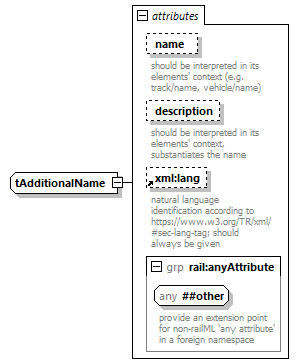 | ||||||||||||||||||||||||||||||
| namespace | https://www.railml.org/schemas/2021 | ||||||||||||||||||||||||||||||
| used by |
| ||||||||||||||||||||||||||||||
| attributes |
| ||||||||||||||||||||||||||||||
| source | <xs:complexType name="tAdditionalName"> <xs:attribute name="name" type="rail:tGenericName"> <xs:annotation> <xs:documentation>should be interpreted in its elements' context (e.g. track/name, vehicle/name)</xs:documentation> </xs:annotation> </xs:attribute> <xs:attribute name="description" type="rail:tElementDescription"> <xs:annotation> <xs:documentation>should be interpreted in its elements' context, substantiates the name</xs:documentation> </xs:annotation> </xs:attribute> <xs:attribute ref="xml:lang"> <xs:annotation> <xs:documentation>natural language identification according to https://www.w3.org/TR/xml/#sec-lang-tag; should always be given</xs:documentation> </xs:annotation> </xs:attribute> <xs:attributeGroup ref="rail:anyAttribute"/> </xs:complexType> |
attribute tAdditionalName/@name
| type | rail:tGenericName | ||
| annotation |
| ||
| source | <xs:attribute name="name" type="rail:tGenericName"> <xs:annotation> <xs:documentation>should be interpreted in its elements' context (e.g. track/name, vehicle/name)</xs:documentation> </xs:annotation> </xs:attribute> |
attribute tAdditionalName/@description
| type | rail:tElementDescription | ||
| annotation |
| ||
| source | <xs:attribute name="description" type="rail:tElementDescription"> <xs:annotation> <xs:documentation>should be interpreted in its elements' context, substantiates the name</xs:documentation> </xs:annotation> </xs:attribute> |
complexType tElementRefInGroup
| diagram |  | ||||||||||||||||||||
| namespace | https://www.railml.org/schemas/2021 | ||||||||||||||||||||
| type | extension of rail:tElementWithReference | ||||||||||||||||||||
| properties |
| ||||||||||||||||||||
| used by |
| ||||||||||||||||||||
| attributes |
| ||||||||||||||||||||
| annotation |
| ||||||||||||||||||||
| source | <xs:complexType name="tElementRefInGroup"> <xs:annotation> <xs:documentation>generic type for inheritance in serialized reference elements</xs:documentation> </xs:annotation> <xs:complexContent> <xs:extension base="rail:tElementWithReference"> <xs:attribute name="sequence" type="rail:tPositiveCounter"/> </xs:extension> </xs:complexContent> </xs:complexType> |
attribute tElementRefInGroup/@sequence
| type | rail:tPositiveCounter |
| source | <xs:attribute name="sequence" type="rail:tPositiveCounter"/> |
complexType tElementWithID
| diagram |  | ||||||||||||||
| namespace | https://www.railml.org/schemas/2021 | ||||||||||||||
| used by |
| ||||||||||||||
| attributes |
| ||||||||||||||
| annotation |
| ||||||||||||||
| source | <xs:complexType name="tElementWithID"> <xs:annotation> <xs:documentation>base type for all elements with IDs</xs:documentation> </xs:annotation> <xs:attribute name="id" type="rail:tGenericID" use="required"> <xs:annotation> <xs:documentation>XML-file-wide unique identity is required for later referencing that element</xs:documentation> </xs:annotation> </xs:attribute> </xs:complexType> |
attribute tElementWithID/@id
| type | rail:tGenericID | ||
| properties |
| ||
| annotation |
| ||
| source | <xs:attribute name="id" type="rail:tGenericID" use="required"> <xs:annotation> <xs:documentation>XML-file-wide unique identity is required for later referencing that element</xs:documentation> </xs:annotation> </xs:attribute> |
complexType tElementWithIDAndName
| diagram |  | ||||||||||||||||||||||||||||||||||||||||||||||
| namespace | https://www.railml.org/schemas/2021 | ||||||||||||||||||||||||||||||||||||||||||||||
| type | extension of rail:tElementWithID | ||||||||||||||||||||||||||||||||||||||||||||||
| properties |
| ||||||||||||||||||||||||||||||||||||||||||||||
| children | rail:additionalName | ||||||||||||||||||||||||||||||||||||||||||||||
| used by |
| ||||||||||||||||||||||||||||||||||||||||||||||
| attributes |
| ||||||||||||||||||||||||||||||||||||||||||||||
| annotation |
| ||||||||||||||||||||||||||||||||||||||||||||||
| source | <xs:complexType name="tElementWithIDAndName"> <xs:annotation> <xs:documentation>generic base type, used for inheritance of many railML types</xs:documentation> </xs:annotation> <xs:complexContent> <xs:extension base="rail:tElementWithID"> <xs:sequence> <xs:element name="additionalName" type="rail:tAdditionalName" minOccurs="0" maxOccurs="unbounded"> <xs:annotation> <xs:documentation>additional names and its according descriptions to be provided in other languages, dialects, encodings...</xs:documentation> <xs:documentation>See https://wiki2.railml.org/wiki/IS:additionalName, https://wiki2.railml.org/wiki/RS:additionalName and https://wiki2.railml.org/wiki/TT:additionalName</xs:documentation> </xs:annotation> </xs:element> <xs:any namespace="##other" processContents="strict" minOccurs="0" maxOccurs="unbounded"> <xs:annotation> <xs:documentation>provide an extension point for non-railML elements in foreign namespace</xs:documentation> </xs:annotation> </xs:any> </xs:sequence> <xs:attribute name="code" type="rail:tGenericName"> <xs:annotation> <xs:documentation>for typical, specific abbreviations, used in different systems with the same understanding</xs:documentation> </xs:annotation> </xs:attribute> <xs:attribute name="name" type="rail:tGenericName"> <xs:annotation> <xs:documentation>should be interpreted in its elements' context (e.g. track/name, vehicle/name)</xs:documentation> </xs:annotation> </xs:attribute> <xs:attribute name="description" type="rail:tElementDescription"> <xs:annotation> <xs:documentation>should be interpreted in its elements' context, substantiates the name </xs:documentation> </xs:annotation> </xs:attribute> <xs:attribute ref="xml:lang"> <xs:annotation> <xs:documentation>natural language identification according to https://www.w3.org/TR/xml/#sec-lang-tag</xs:documentation> </xs:annotation> </xs:attribute> <xs:attributeGroup ref="rail:anyAttribute"/> </xs:extension> </xs:complexContent> </xs:complexType> |
attribute tElementWithIDAndName/@code
| type | rail:tGenericName | ||
| annotation |
| ||
| source | <xs:attribute name="code" type="rail:tGenericName"> <xs:annotation> <xs:documentation>for typical, specific abbreviations, used in different systems with the same understanding</xs:documentation> </xs:annotation> </xs:attribute> |
attribute tElementWithIDAndName/@name
| type | rail:tGenericName | ||
| annotation |
| ||
| source | <xs:attribute name="name" type="rail:tGenericName"> <xs:annotation> <xs:documentation>should be interpreted in its elements' context (e.g. track/name, vehicle/name)</xs:documentation> </xs:annotation> </xs:attribute> |
attribute tElementWithIDAndName/@description
| type | rail:tElementDescription | ||
| annotation |
| ||
| source | <xs:attribute name="description" type="rail:tElementDescription"> <xs:annotation> <xs:documentation>should be interpreted in its elements' context, substantiates the name </xs:documentation> </xs:annotation> </xs:attribute> |
element tElementWithIDAndName/additionalName
| diagram |  | ||||||||||||||||||||||||||||||
| namespace | https://www.railml.org/schemas/2021 | ||||||||||||||||||||||||||||||
| type | rail:tAdditionalName | ||||||||||||||||||||||||||||||
| properties |
| ||||||||||||||||||||||||||||||
| attributes |
| ||||||||||||||||||||||||||||||
| annotation |
| ||||||||||||||||||||||||||||||
| source | <xs:element name="additionalName" type="rail:tAdditionalName" minOccurs="0" maxOccurs="unbounded"> <xs:annotation> <xs:documentation>additional names and its according descriptions to be provided in other languages, dialects, encodings...</xs:documentation> <xs:documentation>See https://wiki2.railml.org/wiki/IS:additionalName, https://wiki2.railml.org/wiki/RS:additionalName and https://wiki2.railml.org/wiki/TT:additionalName</xs:documentation> </xs:annotation> </xs:element> |
complexType tElementWithIDAndNameWithoutAny
| diagram |  | ||||||||||||||||||||||||||||||||||||||||||||||
| namespace | https://www.railml.org/schemas/2021 | ||||||||||||||||||||||||||||||||||||||||||||||
| type | extension of rail:tAdditionalName | ||||||||||||||||||||||||||||||||||||||||||||||
| properties |
| ||||||||||||||||||||||||||||||||||||||||||||||
| used by |
| ||||||||||||||||||||||||||||||||||||||||||||||
| attributes |
| ||||||||||||||||||||||||||||||||||||||||||||||
| annotation |
| ||||||||||||||||||||||||||||||||||||||||||||||
| source | <xs:complexType name="tElementWithIDAndNameWithoutAny"> <xs:annotation> <xs:documentation>Special derived type without 'any' element sequence but 'anyAttribute' for inheritance with 'xs:all' model group.</xs:documentation> </xs:annotation> <xs:complexContent> <xs:extension base="rail:tAdditionalName"> <xs:attribute name="id" type="rail:tGenericID" use="required"> <xs:annotation> <xs:documentation>XML-file-wide unique identity is required for later referencing that element</xs:documentation> </xs:annotation> </xs:attribute> <xs:attribute name="code" type="rail:tGenericName"> <xs:annotation> <xs:documentation>for typical, specific abbreviations, used in different systems with the same understanding</xs:documentation> </xs:annotation> </xs:attribute> </xs:extension> </xs:complexContent> </xs:complexType> |
attribute tElementWithIDAndNameWithoutAny/@id
| type | rail:tGenericID | ||
| properties |
| ||
| annotation |
| ||
| source | <xs:attribute name="id" type="rail:tGenericID" use="required"> <xs:annotation> <xs:documentation>XML-file-wide unique identity is required for later referencing that element</xs:documentation> </xs:annotation> </xs:attribute> |
attribute tElementWithIDAndNameWithoutAny/@code
| type | rail:tGenericName | ||
| annotation |
| ||
| source | <xs:attribute name="code" type="rail:tGenericName"> <xs:annotation> <xs:documentation>for typical, specific abbreviations, used in different systems with the same understanding</xs:documentation> </xs:annotation> </xs:attribute> |
complexType tElementWithReference
| diagram |  | ||||||||||||||
| namespace | https://www.railml.org/schemas/2021 | ||||||||||||||
| used by |
| ||||||||||||||
| attributes |
| ||||||||||||||
| annotation |
| ||||||||||||||
| source | <xs:complexType name="tElementWithReference"> <xs:annotation> <xs:documentation>generic base type, used for inheritance of railML types deploying references</xs:documentation> </xs:annotation> <xs:attribute name="ref" type="rail:tGenericRef" use="required"> <xs:annotation> <xs:documentation>reference is required because it's the purpose of the element</xs:documentation> </xs:annotation> </xs:attribute> <xs:attributeGroup ref="rail:anyAttribute"/> </xs:complexType> |
attribute tElementWithReference/@ref
| type | rail:tGenericRef | ||
| properties |
| ||
| annotation |
| ||
| source | <xs:attribute name="ref" type="rail:tGenericRef" use="required"> <xs:annotation> <xs:documentation>reference is required because it's the purpose of the element</xs:documentation> </xs:annotation> </xs:attribute> |
complexType tGlobalElementWithMetadata
| diagram |  | ||||||||||||||||||||||||||||||||||||||||||||||||||||||||||||||
| namespace | https://www.railml.org/schemas/2021 | ||||||||||||||||||||||||||||||||||||||||||||||||||||||||||||||
| type | extension of rail:tElementWithIDAndName | ||||||||||||||||||||||||||||||||||||||||||||||||||||||||||||||
| properties |
| ||||||||||||||||||||||||||||||||||||||||||||||||||||||||||||||
| children | rail:additionalName rail:metadata | ||||||||||||||||||||||||||||||||||||||||||||||||||||||||||||||
| used by |
| ||||||||||||||||||||||||||||||||||||||||||||||||||||||||||||||
| attributes |
| ||||||||||||||||||||||||||||||||||||||||||||||||||||||||||||||
| annotation |
| ||||||||||||||||||||||||||||||||||||||||||||||||||||||||||||||
| source | <xs:complexType name="tGlobalElementWithMetadata"> <xs:annotation> <xs:documentation>generic base type, used for inheritance of railML subschema elements</xs:documentation> </xs:annotation> <xs:complexContent> <xs:extension base="rail:tElementWithIDAndName"> <xs:sequence> <xs:element name="metadata" type="dc:elementContainer" minOccurs="0"> <xs:annotation> <xs:documentation>subschema-wide flexible collection of Dublin Core metadata based on xs:any according to https://dublincore.org/</xs:documentation> <xs:documentation>See https://wiki2.railml.org/wiki/IS:metadata, https://wiki2.railml.org/wiki/RS:metadata and https://wiki2.railml.org/wiki/TT:metadata</xs:documentation> </xs:annotation> </xs:element> </xs:sequence> <xs:attribute name="version" type="rail:tRailMLVersion"> <xs:annotation> <xs:documentation>only used, if subschema element is outsourced, else use 'version' attribute in root element ('railml')</xs:documentation> </xs:annotation> </xs:attribute> <xs:attribute ref="xml:base"> <xs:annotation> <xs:documentation>provide outsourcing of subschema element with xi:include mechanism</xs:documentation> </xs:annotation> </xs:attribute> </xs:extension> </xs:complexContent> </xs:complexType> |
attribute tGlobalElementWithMetadata/@version
| type | rail:tRailMLVersion | ||||||
| facets |
| ||||||
| annotation |
| ||||||
| source | <xs:attribute name="version" type="rail:tRailMLVersion"> <xs:annotation> <xs:documentation>only used, if subschema element is outsourced, else use 'version' attribute in root element ('railml')</xs:documentation> </xs:annotation> </xs:attribute> |
element tGlobalElementWithMetadata/metadata
| diagram |  | ||||||
| namespace | https://www.railml.org/schemas/2021 | ||||||
| type | elementContainer | ||||||
| properties |
| ||||||
| children | any | ||||||
| annotation |
| ||||||
| source | <xs:element name="metadata" type="dc:elementContainer" minOccurs="0"> <xs:annotation> <xs:documentation>subschema-wide flexible collection of Dublin Core metadata based on xs:any according to https://dublincore.org/</xs:documentation> <xs:documentation>See https://wiki2.railml.org/wiki/IS:metadata, https://wiki2.railml.org/wiki/RS:metadata and https://wiki2.railml.org/wiki/TT:metadata</xs:documentation> </xs:annotation> </xs:element> |
complexType tInfoText
| diagram |  | ||||||||||||||||||||||
| namespace | https://www.railml.org/schemas/2021 | ||||||||||||||||||||||
| type | extension of rail:tInfoTextBase | ||||||||||||||||||||||
| properties |
| ||||||||||||||||||||||
| used by |
| ||||||||||||||||||||||
| attributes |
| ||||||||||||||||||||||
| source | <xs:complexType name="tInfoText"> <xs:simpleContent> <xs:extension base="rail:tInfoTextBase"> <xs:attribute ref="xml:lang"> <xs:annotation> <xs:documentation>natural language identification according to https://www.w3.org/TR/xml/#sec-lang-tag</xs:documentation> </xs:annotation> </xs:attribute> <xs:attribute name="verboseness" type="rail:tVerbosenessClass"> <xs:annotation> <xs:documentation>allows to categorize the text along its verboseness</xs:documentation> </xs:annotation> </xs:attribute> </xs:extension> </xs:simpleContent> </xs:complexType> |
attribute tInfoText/@verboseness
| type | rail:tVerbosenessClass | ||
| annotation |
| ||
| source | <xs:attribute name="verboseness" type="rail:tVerbosenessClass"> <xs:annotation> <xs:documentation>allows to categorize the text along its verboseness</xs:documentation> </xs:annotation> </xs:attribute> |
complexType tInfoTextBase
| diagram | 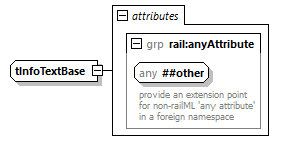 | ||||||
| namespace | https://www.railml.org/schemas/2021 | ||||||
| type | extension of xs:string | ||||||
| properties |
| ||||||
| used by |
| ||||||
| attributes |
| ||||||
| source | <xs:complexType name="tInfoTextBase"> <xs:simpleContent> <xs:extension base="xs:string"> <xs:attributeGroup ref="rail:anyAttribute"/> </xs:extension> </xs:simpleContent> </xs:complexType> |
simpleType tCoordinateList
| namespace | https://www.railml.org/schemas/2021 | |||||||||
| type | restriction of rail:tDoubleList | |||||||||
| properties |
| |||||||||
| used by |
| |||||||||
| facets |
| |||||||||
| annotation |
| |||||||||
| source | <xs:simpleType name="tCoordinateList"> <xs:annotation> <xs:documentation>an coordinate list consisting of two or three coordinates</xs:documentation> </xs:annotation> <xs:restriction base="rail:tDoubleList"> <xs:minLength value="2"/> <xs:maxLength value="3"/> </xs:restriction> </xs:simpleType> |
simpleType tCounter
| namespace | https://www.railml.org/schemas/2021 | ||
| type | xs:nonNegativeInteger | ||
| properties |
| ||
| used by |
| ||
| annotation |
| ||
| source | <xs:simpleType name="tCounter"> <xs:annotation> <xs:documentation>generic type for counters (e.g. number of equipment), allowing zero</xs:documentation> </xs:annotation> <xs:restriction base="xs:nonNegativeInteger"/> </xs:simpleType> |
simpleType tDigitString
| namespace | https://www.railml.org/schemas/2021 | ||||||
| type | restriction of xs:string | ||||||
| properties |
| ||||||
| used by |
| ||||||
| facets |
| ||||||
| annotation |
| ||||||
| source | <xs:simpleType name="tDigitString"> <xs:annotation> <xs:documentation>an arbitrary string consisting of digits from 0 to 9; not allowing white space, letters; no length restriction</xs:documentation> </xs:annotation> <xs:restriction base="xs:string"> <xs:pattern value="[0-9]*"/> </xs:restriction> </xs:simpleType> |
simpleType tDoubleList
| namespace | https://www.railml.org/schemas/2021 | ||
| type | list of xs:double | ||
| properties |
| ||
| used by |
| ||
| annotation |
| ||
| source | <xs:simpleType name="tDoubleList"> <xs:annotation> <xs:documentation>an arbitrary list consisting of xs:double values separated by white space; no length restriction</xs:documentation> </xs:annotation> <xs:list itemType="xs:double"/> </xs:simpleType> |
simpleType tDurationList
| namespace | https://www.railml.org/schemas/2021 | ||
| type | list of xs:duration | ||
| properties |
| ||
| used by |
| ||
| annotation |
| ||
| source | <xs:simpleType name="tDurationList"> <xs:annotation> <xs:documentation>a list of time intervals, each given as an xs:duration, separated by white space</xs:documentation> </xs:annotation> <xs:list itemType="xs:duration"/> </xs:simpleType> |
simpleType tElementDescription
| namespace | https://www.railml.org/schemas/2021 | ||
| type | xs:string | ||
| properties |
| ||
| used by |
| ||
| annotation |
| ||
| source | <xs:simpleType name="tElementDescription"> <xs:annotation> <xs:documentation>an detailed description of an railway facility (e.g. station, timetable period or vehicle), allowing digits, letters and white space</xs:documentation> </xs:annotation> <xs:restriction base="xs:string"/> </xs:simpleType> |
simpleType tFiveDigits
| namespace | https://www.railml.org/schemas/2021 | |||||||||
| type | restriction of rail:tDigitString | |||||||||
| properties |
| |||||||||
| used by |
| |||||||||
| facets |
| |||||||||
| annotation |
| |||||||||
| source | <xs:simpleType name="tFiveDigits"> <xs:annotation> <xs:documentation>an identification string consisting of exactly five digits</xs:documentation> </xs:annotation> <xs:restriction base="rail:tDigitString"> <xs:length value="5"/> </xs:restriction> </xs:simpleType> |
simpleType tFiveLetterString
| namespace | https://www.railml.org/schemas/2021 | ||||||
| type | restriction of xs:string | ||||||
| properties |
| ||||||
| used by |
| ||||||
| facets |
| ||||||
| source | <xs:simpleType name="tFiveLetterString"> <xs:restriction base="xs:string"> <xs:pattern value="\w{1,5}"/> </xs:restriction> </xs:simpleType> |
simpleType tFourDigits
| namespace | https://www.railml.org/schemas/2021 | |||||||||
| type | restriction of rail:tDigitString | |||||||||
| properties |
| |||||||||
| facets |
| |||||||||
| annotation |
| |||||||||
| source | <xs:simpleType name="tFourDigits"> <xs:annotation> <xs:documentation>an identification string consisting of exactly four digits</xs:documentation> </xs:annotation> <xs:restriction base="rail:tDigitString"> <xs:length value="4"/> </xs:restriction> </xs:simpleType> |
simpleType tGenericID
| namespace | https://www.railml.org/schemas/2021 | ||
| type | xs:ID | ||
| properties |
| ||
| used by |
| ||
| annotation |
| ||
| source | <xs:simpleType name="tGenericID"> <xs:annotation> <xs:documentation>an XML-side constrained bi-unique identity; unique across an XML file including its outsourced components (xi:include mechanism); white spaces not allowed</xs:documentation> </xs:annotation> <xs:restriction base="xs:ID"/> </xs:simpleType> |
simpleType tGenericName
| namespace | https://www.railml.org/schemas/2021 | ||||
| type | xs:string | ||||
| properties |
| ||||
| used by |
| ||||
| annotation |
| ||||
| source | <xs:simpleType name="tGenericName"> <xs:annotation> <xs:documentation>system-wide known name of an railway facility (e.g. station, timetable period or vehicle), allowing digits, letters and white space</xs:documentation> </xs:annotation> <xs:restriction base="xs:string"/> </xs:simpleType> |
simpleType tGenericRef
| namespace | https://www.railml.org/schemas/2021 | ||
| type | xs:IDREF | ||
| properties |
| ||
| used by |
| ||
| annotation |
| ||
| source | <xs:simpleType name="tGenericRef"> <xs:annotation> <xs:documentation>an XML-side constrained reference to one xs:ID value, acts across an XML file including its outsourced components (xi:include mechanism)</xs:documentation> </xs:annotation> <xs:restriction base="xs:IDREF"/> </xs:simpleType> |
simpleType tOneDigit
| namespace | https://www.railml.org/schemas/2021 | |||||||||
| type | restriction of rail:tDigitString | |||||||||
| properties |
| |||||||||
| used by |
| |||||||||
| facets |
| |||||||||
| annotation |
| |||||||||
| source | <xs:simpleType name="tOneDigit"> <xs:annotation> <xs:documentation>an identification string consisting of exactly one digit</xs:documentation> </xs:annotation> <xs:restriction base="rail:tDigitString"> <xs:length value="1"/> </xs:restriction> </xs:simpleType> |
simpleType tOneToZero
| namespace | https://www.railml.org/schemas/2021 | ||||||||||||
| type | restriction of xs:decimal | ||||||||||||
| properties |
| ||||||||||||
| used by |
| ||||||||||||
| facets |
| ||||||||||||
| annotation |
| ||||||||||||
| source | <xs:simpleType name="tOneToZero"> <xs:annotation> <xs:documentation>generic type for values only between 0 and 1, as efficiency or cosine phi.</xs:documentation> </xs:annotation> <xs:restriction base="xs:decimal"> <xs:minInclusive value="0"/> <xs:maxInclusive value="1"/> <xs:fractionDigits value="6"/> </xs:restriction> </xs:simpleType> |
simpleType tOtherEnumerationValue
| namespace | https://www.railml.org/schemas/2021 | ||||||
| type | restriction of xs:string | ||||||
| properties |
| ||||||
| used by |
| ||||||
| facets |
| ||||||
| annotation |
| ||||||
| source | <xs:simpleType name="tOtherEnumerationValue"> <xs:annotation> <xs:documentation>an arbitrary string starting with 'other:' followed by at minimum two characters, white space not allowed for extending railML enumeration lists</xs:documentation> </xs:annotation> <xs:restriction base="xs:string"> <xs:pattern value="other:\w{2,}"/> </xs:restriction> </xs:simpleType> |
simpleType tPositiveCounter
| namespace | https://www.railml.org/schemas/2021 | ||
| type | xs:positiveInteger | ||
| properties |
| ||
| used by |
| ||
| annotation |
| ||
| source | <xs:simpleType name="tPositiveCounter"> <xs:annotation> <xs:documentation>generic type for counters (e.g. order number of a vehicle in an formation), starting with '1'</xs:documentation> </xs:annotation> <xs:restriction base="xs:positiveInteger"/> </xs:simpleType> |
simpleType tRailMLVersion
| namespace | https://www.railml.org/schemas/2021 | ||||||
| type | restriction of xs:string | ||||||
| properties |
| ||||||
| used by |
| ||||||
| facets |
| ||||||
| annotation |
| ||||||
| source | <xs:simpleType name="tRailMLVersion"> <xs:annotation> <xs:documentation>Version Number is some official release number, rather than any internal numbering from an version control system</xs:documentation> <xs:documentation>Allows two part or three part version numbers, 1.0 up to 99.99, or 1.0.1 up to 99.99.99</xs:documentation> <xs:documentation>Allows additional SVN release numbers for testing unofficial releases: 1.1r4 or 2.0r271</xs:documentation> </xs:annotation> <xs:restriction base="xs:string"> <xs:pattern value="[1-9][0-9]?\.([0-9]|[1-9][0-9])(\.[1-9][0-9]?)?(r[1-9][0-9]?[0-9]?)?"/> </xs:restriction> </xs:simpleType> |
simpleType tThreeDigits
| namespace | https://www.railml.org/schemas/2021 | |||||||||
| type | restriction of rail:tDigitString | |||||||||
| properties |
| |||||||||
| facets |
| |||||||||
| annotation |
| |||||||||
| source | <xs:simpleType name="tThreeDigits"> <xs:annotation> <xs:documentation>an identification string consisting of exactly three digits</xs:documentation> </xs:annotation> <xs:restriction base="rail:tDigitString"> <xs:length value="3"/> </xs:restriction> </xs:simpleType> |
simpleType tThreeLetterString
| namespace | https://www.railml.org/schemas/2021 | ||||||
| type | restriction of xs:string | ||||||
| properties |
| ||||||
| used by |
| ||||||
| facets |
| ||||||
| source | <xs:simpleType name="tThreeLetterString"> <xs:restriction base="xs:string"> <xs:pattern value="\w{1,3}"/> </xs:restriction> </xs:simpleType> |
simpleType tTwelveDigits
| namespace | https://www.railml.org/schemas/2021 | |||||||||
| type | restriction of rail:tDigitString | |||||||||
| properties |
| |||||||||
| used by |
| |||||||||
| facets |
| |||||||||
| annotation |
| |||||||||
| source | <xs:simpleType name="tTwelveDigits"> <xs:annotation> <xs:documentation>an identification string consisting of exactly twelve digits, e.g. UIC ident numbers</xs:documentation> </xs:annotation> <xs:restriction base="rail:tDigitString"> <xs:length value="12"/> </xs:restriction> </xs:simpleType> |
simpleType tTwoDigits
| namespace | https://www.railml.org/schemas/2021 | |||||||||
| type | restriction of rail:tDigitString | |||||||||
| properties |
| |||||||||
| used by |
| |||||||||
| facets |
| |||||||||
| annotation |
| |||||||||
| source | <xs:simpleType name="tTwoDigits"> <xs:annotation> <xs:documentation>an identification string consisting of exactly two digits</xs:documentation> </xs:annotation> <xs:restriction base="rail:tDigitString"> <xs:length value="2"/> </xs:restriction> </xs:simpleType> |
simpleType tVerbalCounter
| namespace | https://www.railml.org/schemas/2021 | ||||||||||||
| type | restriction of xs:string | ||||||||||||
| properties |
| ||||||||||||
| used by |
| ||||||||||||
| facets |
| ||||||||||||
| annotation |
| ||||||||||||
| source | <xs:simpleType name="tVerbalCounter"> <xs:annotation> <xs:documentation>generic enumeration, where digits are not common</xs:documentation> </xs:annotation> <xs:restriction base="xs:string"> <xs:enumeration value="single"/> <xs:enumeration value="double"/> <xs:enumeration value="triple"/> </xs:restriction> </xs:simpleType> |
simpleType tVerbosenessClass
| namespace | https://www.railml.org/schemas/2021 | ||
| type | union of (restriction of xs:string, rail:tOtherEnumerationValue) | ||
| used by |
| ||
| source | <xs:simpleType name="tVerbosenessClass"> <xs:union> <xs:simpleType> <xs:restriction base="xs:string"> <xs:enumeration value="reduced"/> <xs:enumeration value="normal"/> <xs:enumeration value="verbose"/> </xs:restriction> </xs:simpleType> <xs:simpleType> <xs:restriction base="rail:tOtherEnumerationValue"/> </xs:simpleType> </xs:union> </xs:simpleType> |
simpleType tVersionNumber
| namespace | https://www.railml.org/schemas/2021 | ||
| type | xs:string | ||
| properties |
| ||
| used by |
| ||
| annotation |
| ||
| source | <xs:simpleType name="tVersionNumber"> <xs:annotation> <xs:documentation>an arbitrary version number for any system; allowing digits, letters and white space</xs:documentation> </xs:annotation> <xs:restriction base="xs:string"/> </xs:simpleType> |
attributeGroup anyAttribute
| namespace | https://www.railml.org/schemas/2021 | ||||||
| used by |
| ||||||
| attributes |
| ||||||
| source | <xs:attributeGroup name="anyAttribute"> <xs:anyAttribute namespace="##other"> <xs:annotation> <xs:documentation>provide an extension point for non-railML 'any attribute' in a foreign namespace</xs:documentation> </xs:annotation> </xs:anyAttribute> </xs:attributeGroup> |
element any
| diagram |  | ||||||||||||||
| namespace | http://purl.org/dc/elements/1.1/ | ||||||||||||||
| type | SimpleLiteral | ||||||||||||||
| properties |
| ||||||||||||||
| used by |
| ||||||||||||||
| attributes |
| ||||||||||||||
| source | <xs:element name="any" type="SimpleLiteral" abstract="true"/> |
element contributor
| diagram |  |
| namespace | http://purl.org/dc/elements/1.1/ |
| substitution group | any |
| source | <xs:element name="contributor" substitutionGroup="any"/> |
element coverage
| diagram |  |
| namespace | http://purl.org/dc/elements/1.1/ |
| substitution group | any |
| source | <xs:element name="coverage" substitutionGroup="any"/> |
element creator
| diagram |  |
| namespace | http://purl.org/dc/elements/1.1/ |
| substitution group | any |
| source | <xs:element name="creator" substitutionGroup="any"/> |
element date
| diagram |  |
| namespace | http://purl.org/dc/elements/1.1/ |
| substitution group | any |
| source | <xs:element name="date" substitutionGroup="any"/> |
element description
| diagram |  |
| namespace | http://purl.org/dc/elements/1.1/ |
| substitution group | any |
| source | <xs:element name="description" substitutionGroup="any"/> |
element format
| diagram |  |
| namespace | http://purl.org/dc/elements/1.1/ |
| substitution group | any |
| source | <xs:element name="format" substitutionGroup="any"/> |
element identifier
| diagram |  |
| namespace | http://purl.org/dc/elements/1.1/ |
| substitution group | any |
| source | <xs:element name="identifier" substitutionGroup="any"/> |
element language
| diagram |  |
| namespace | http://purl.org/dc/elements/1.1/ |
| substitution group | any |
| source | <xs:element name="language" substitutionGroup="any"/> |
element publisher
| diagram |  |
| namespace | http://purl.org/dc/elements/1.1/ |
| substitution group | any |
| source | <xs:element name="publisher" substitutionGroup="any"/> |
element relation
| diagram |  |
| namespace | http://purl.org/dc/elements/1.1/ |
| substitution group | any |
| source | <xs:element name="relation" substitutionGroup="any"/> |
element rights
| diagram |  |
| namespace | http://purl.org/dc/elements/1.1/ |
| substitution group | any |
| source | <xs:element name="rights" substitutionGroup="any"/> |
element source
| diagram |  |
| namespace | http://purl.org/dc/elements/1.1/ |
| substitution group | any |
| source | <xs:element name="source" substitutionGroup="any"/> |
element subject
| diagram |  |
| namespace | http://purl.org/dc/elements/1.1/ |
| substitution group | any |
| source | <xs:element name="subject" substitutionGroup="any"/> |
element title
| diagram |  |
| namespace | http://purl.org/dc/elements/1.1/ |
| substitution group | any |
| source | <xs:element name="title" substitutionGroup="any"/> |
element type
| diagram |  |
| namespace | http://purl.org/dc/elements/1.1/ |
| substitution group | any |
| source | <xs:element name="type" substitutionGroup="any"/> |
group elementsGroup
| diagram | 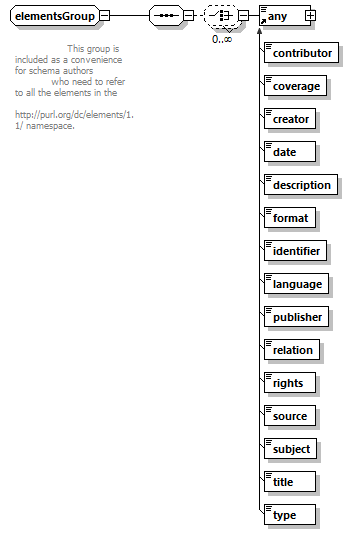 | ||
| namespace | http://purl.org/dc/elements/1.1/ | ||
| children | any | ||
| used by |
| ||
| annotation |
| ||
| source | <xs:group name="elementsGroup"> <xs:annotation> <xs:documentation xml:lang="en"> This group is included as a convenience for schema authors who need to refer to all the elements in the http://purl.org/dc/elements/1.1/ namespace. </xs:documentation> </xs:annotation> <xs:sequence> <xs:choice minOccurs="0" maxOccurs="unbounded"> <xs:element ref="any"/> </xs:choice> </xs:sequence> </xs:group> |
complexType elementContainer
| diagram |  | ||||
| namespace | http://purl.org/dc/elements/1.1/ | ||||
| children | any | ||||
| used by |
| ||||
| annotation |
| ||||
| source | <xs:complexType name="elementContainer"> <xs:annotation> <xs:documentation xml:lang="en"> This complexType is included as a convenience for schema authors who need to define a root or container element for all of the DC elements. </xs:documentation> </xs:annotation> <xs:choice> <xs:group ref="elementsGroup"/> </xs:choice> </xs:complexType> |
complexType SimpleLiteral
| diagram | 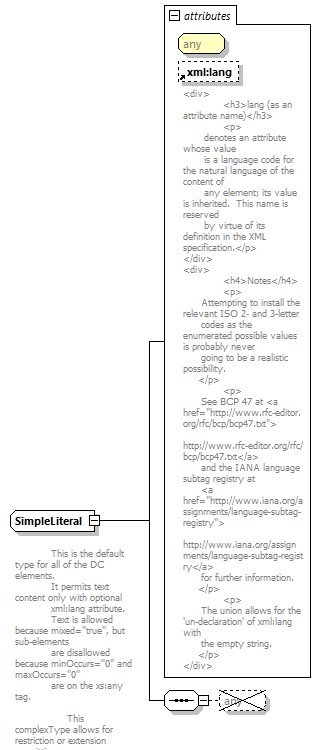 | ||||||||||||||
| namespace | http://purl.org/dc/elements/1.1/ | ||||||||||||||
| type | restriction of xs:anyType | ||||||||||||||
| properties |
| ||||||||||||||
| used by |
| ||||||||||||||
| attributes |
| ||||||||||||||
| annotation |
| ||||||||||||||
| source | <xs:complexType name="SimpleLiteral" mixed="true"> <xs:annotation> <xs:documentation xml:lang="en"> This is the default type for all of the DC elements. It permits text content only with optional xml:lang attribute. Text is allowed because mixed="true", but sub-elements are disallowed because minOccurs="0" and maxOccurs="0" are on the xs:any tag. This complexType allows for restriction or extension permitting child elements. </xs:documentation> </xs:annotation> <xs:complexContent> <xs:restriction base="xs:anyType"> <xs:sequence> <xs:any processContents="lax" minOccurs="0" maxOccurs="0"/> </xs:sequence> <xs:attribute ref="xml:lang" use="optional"/> </xs:restriction> </xs:complexContent> </xs:complexType> |
XML Schema documentation generated by XMLSpy Schema Editor http://www.altova.com/xmlspy